Back
Route from Jordan to Ethiopia

June 30, 2007 It had been a hectic two weeks leading up to our departure: preparing the house for the renters, finishing off at work, finalising the motorcycle preparations and of course figuring out what to pack for a "round the world" trip. Little did we know that our hectic pace would catch up with us. The Lunatic Fringe BMW motorcycle rally had been pushed ahead to the July 1 long weekend so we could attend but we didn't make it for the Friday evening kick-off. We didn't make it for Saturday morning either. Or Saturday afternoon. We finally finished off cleaning and putting the final items in the basement about an hour before the renters arrived at 10:30 AM on Sunday morning. After dropping the Jetta off in Airdrie and then picking Audrey's bike up at a neighbour's house back in Redwood Meadows (strange seeing other people's cars in our driveway!) we finally managed to get to the rally in High River at about Noon. We missed putting on the “field events” but it was a lot of fun catching up with people and making new friends. We helped clean up on Monday and then rode up to Airdrie to stay with my parents for a couple of days.
Some final, final preparations were done on the bikes on Monday evening and Tuesday morning. As per the instructions from Motorcycle Express we gave the bikes a good cleaning, making sure to remove any dead bugs. The locking oil cap on Audrey's F650 wouldn't unlock so we spent quite a bit of time trying to open it so that it could be inspected if necessary. Then we noticed in the fine print of the shipping contract that we should bring along a spare set of keys for the bikes. We couldn't find the spare for the F650 (perhaps it was safely tucked away in our basement in Redwood Meadows) so we debated whether to pop by a BMW shop to get a blank and then have it cut. Since the oil filler cap had taken so much time we decided to forego the spare keys and head straight to the airport. Having rebuilt the R100GS starting last October it sure felt good to have the bike run so well on the way to the airport. It had never been smoother or more responsive! At the Aero Ground cargo facility we drained the excess fuel from the bikes and then disconnected the batteries. By the time we returned to Airdrie a lot of tension from the last couple of weeks seemed to drain from us and we relaxed a little. Wednesday we tried to whittle down our items to pack into something that would actually fit on the bikes and also clean up some of the paperwork. That evening we went to Carstairs to say goodbye to Audrey's parents over dinner and then came back to Airdrie for a small Bon Voyage party held in the back yard. Thursday the Jetta was put into storage and we made our final preparations for departure that evening. We arrived at the Air Transat check-in counter a few minutes after it opened and there was no line so we were hopeful that we could get seats with a bit of legroom. No luck; stuck in row 24 on top of the wing. After a tearful goodbye at the security gate we went to the departure gate to see if we could get a glimpse of the bikes being loaded aboard our plane. No luck there either. We really hoped that they were on board!
A good cleaning before taking the bikes to cargo
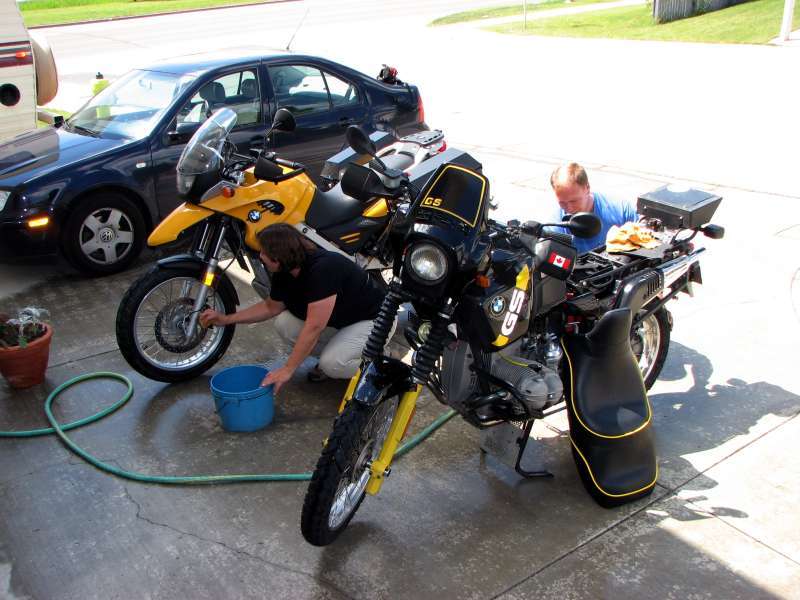
Off to the cargo terminal!
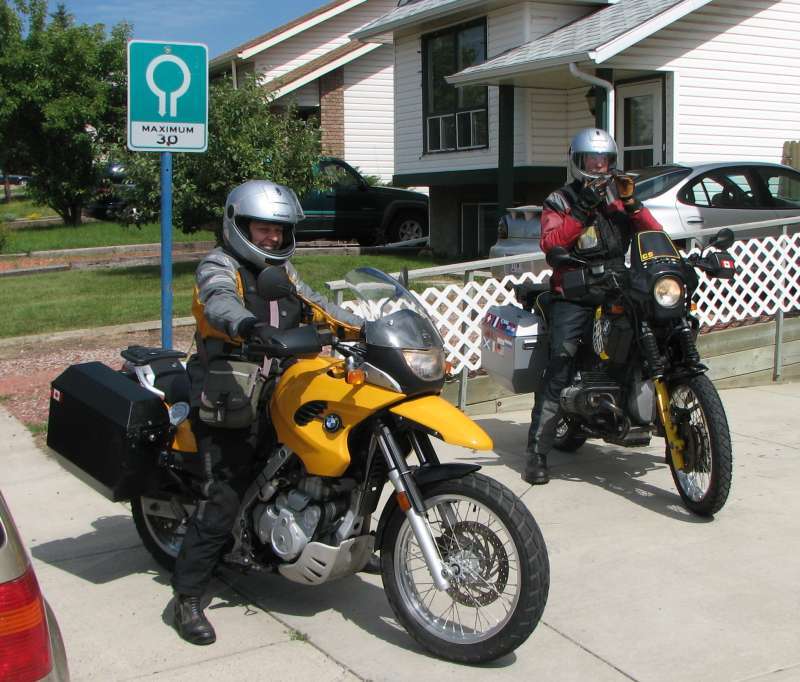
Disconnecting the batteries
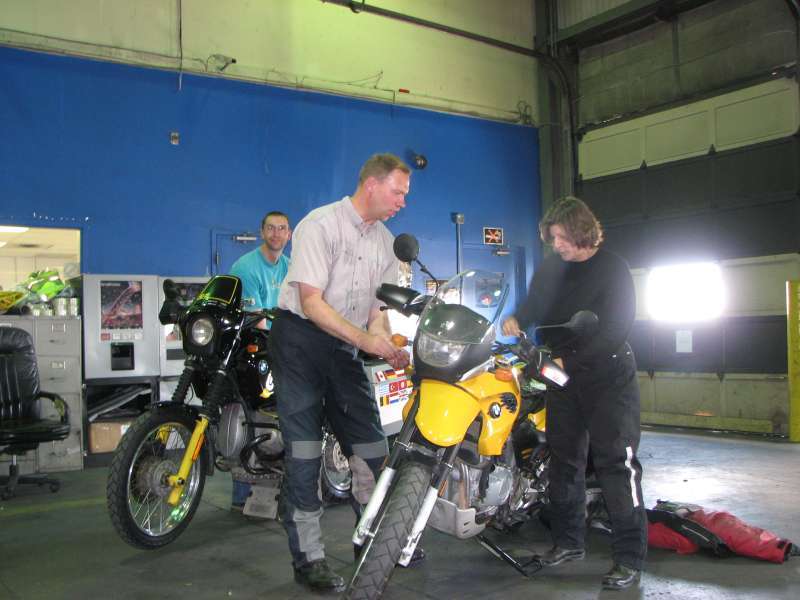
While I was in a terribly awkward position with my knees jammed into the seat in front and my head too high for the headrest I at least had brought ear plugs (one of the advantages of motorcycle travel is that you usually have ear plugs along!), unfortunately Audrey had kept her ear plugs in her motorcycle jacket, safely stowed in the checked baggage. A few young people a couple of rows back kept up a loud conversation for the first 8.5 hours of the 9.5 hour flight so Audrey didn't get a wink of sleep until the final hour and even that was fitful as we hit some bad turbulence at about that time. We were pretty exhausted when we landed on Friday afternoon at 1:30 PM local time. Fortunately, Munich must have one of the most efficient airports in the world. It was a short walk to the baggage carousel with only a short line at the passport control to slow us down. While the luggage was coming down I went to the luggage tracing to ask where our motorcycles could be picked up. The first thing the nice young gentleman said was that we could pick them up at the large luggage pickup over by the skis and golf clubs! A little more explanation was obviously in order. We eventually got vague directions to the Swissport cargo facility on the other side of the airport and then went out to meet Audrey's sister, Helena, who had come to pick us up. Helena lives a few minutes drive from the airport so it was very handy to come over and give us a ride to the cargo facility. It was also nice that she spoke excellent German and even a bit of Bayerische (the local dialect). It took a while to find the Swissport offices but they said they would phone us back in an hour or two when we could come and pick up the bikes. When they didn't call Helena's house we called them and they told us the bikes were ready so off we went. After paying a nominal fee of 17.50 euro for each bike we were then able to take a form down to customs for them to stamp. With the stamped form we then walked to the Swissport cargo gate where a hundred fork lifts all seemed to be whizzing around at 100 km/h and all of them intent on running us over. We looked the bikes over and could find no damage but we also didn't find our keys. Back and forth upstairs to the office didn't turn up the keys but since I had my spare keys we decided it was best to take my bike out since storage charges would be applied if we didn't remove the bikes before Sunday. If the key didn't turn up we would have to call a locksmith to get a key made for the F650. As I rolled the bike to the ramp a woman from the Swissport office came back to say that they were tracing the keys. Since Audrey's keys were in a unique little pouch I thought it would be a good idea to show the woman what exactly they were looking for. Balancing my bike with one hand I reached for my keys, which were in a pouch matching Audrey's, with my right hand. At that moment the bike started to tip over towards me. I tried to catch it but the bike kept coming over and then the gas tank hit my left knee. I could only watch in horror as my knee bent over at a bizarre angle accompanied by a sharp, wrenching pain before I was pinned under the bike. I scooted free with my good leg but it was obvious from the bulbous protrusions that my left knee was ruined. I started swearing a blue streak; not from the pain but because I could see our trip vanishing, the trip around the world that we had planned and saved for for four years. Vanishing because of a stupid mistake made while fatigued by the long flight, which itself was the culmination of two and half hectic weeks.
That knee isn't supposed to look like that
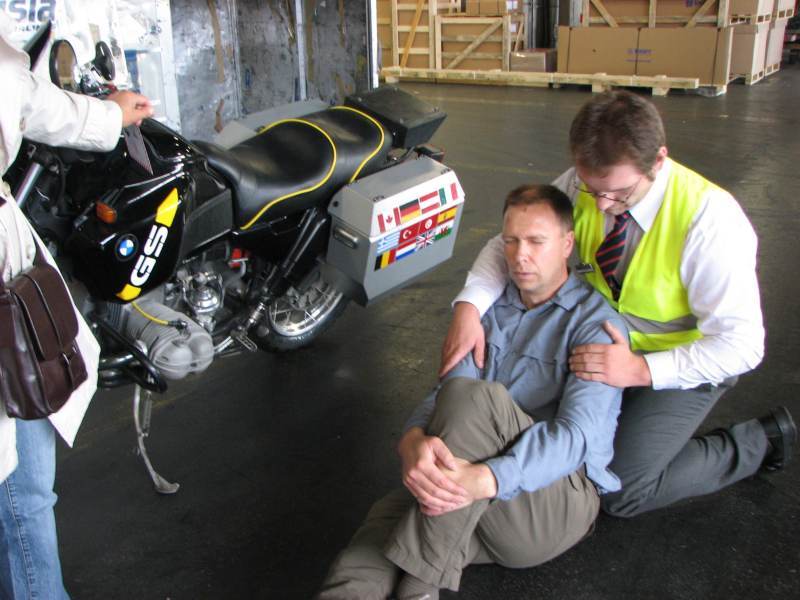
A First Aider, two paramedics and a whole truckload of firefighters got the situation stabilised until an ambulance arrived. There wasn't too much pain after the initial wrench but having dislocated my shoulder a few times I knew that there would be a lot of pain when the knee was popped back into place. At the hospital in Freising an X-Ray was performed to ensure that there weren't any broken bones before straightening out the leg. I gritted my teeth as the doctor and paramedic slowly moved the patella back into position while simultaneously straightening my leg. They and I were both amazed that I had not a hint of pain. I guess no nerves were trapped. The patella was floating free because the ligament towards the lower portion of the leg had been completely severed so it was decided to put my left leg in a cast from hip to ankle until it could be operated on. The doctor said it would be 6 to 8 weeks after the surgery with a brace and then another month to build up the strength before I could ride a motorcycle again. In the meantime an MRI was scheduled for Monday to determine if there was any further tissue damage that needed to be repaired. When I awoke on Saturday morning I couldn't believe my eyes. A bulletin board at the foot of my bed had a Touratech poster advertising their latest trip from Canada to Mexico (Touratech is a company specialising in making equipment for motorcycle travellers and both of our bikes are graced by a few of their baubles) and a second poster of a perfect gravel road switchbacking up the side of mountain. These two posters certainly reinforced my will to continue with the trip and staring at them over the next week would prove to be quite motivational.
An army of firefighters, the paramedics and ambulance attendants on the scene
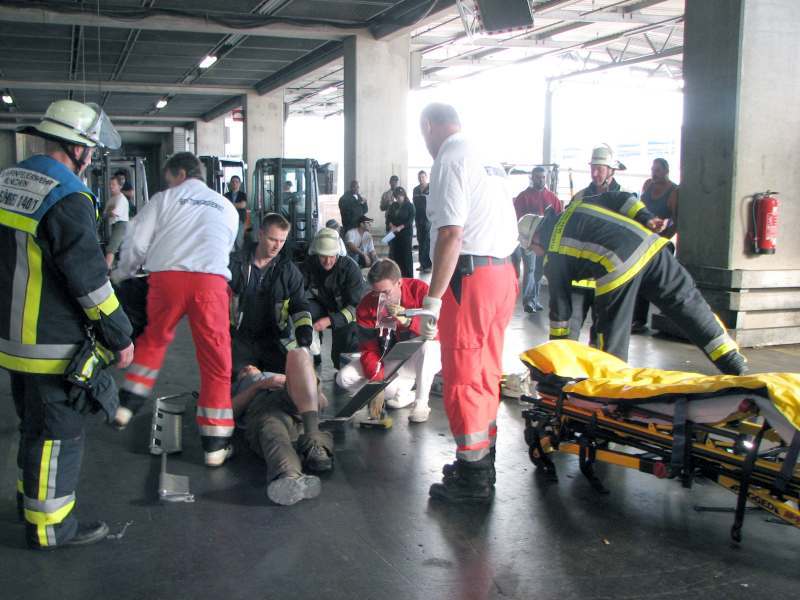
Nice cast!

The motorcycle posters gracing the foot of Ekke's bed
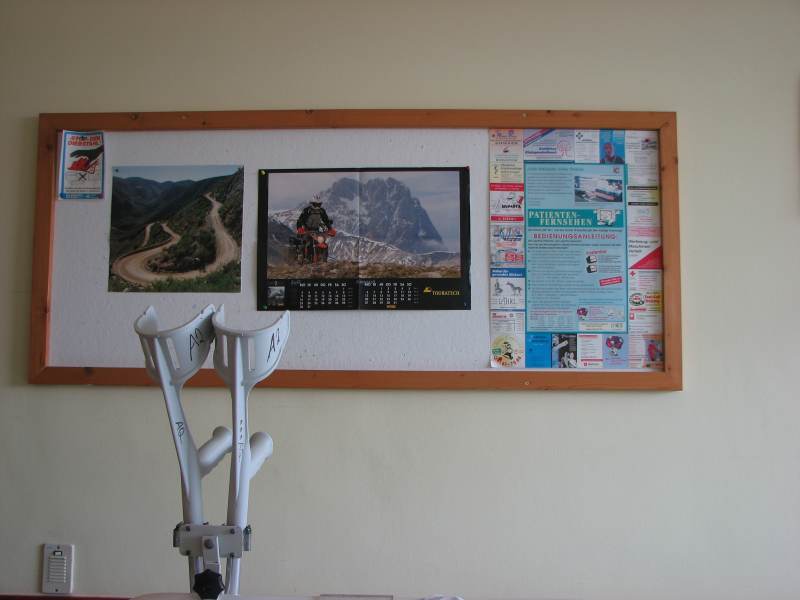
Now the real work began for Audrey. Despite suffering from the same fatigue that caused the accident she now needed to deal with all the issues arising from the mishap. The first order of business was to call our medical insurance provider and make sure that we were covered and to tell them about the accident. She then had to figure out how to get the bikes out of cargo. Swissport called to say that they had found the keys in the crate (right where Audrey had told them to check in the first place!) so at least Audrey could ride her bike. She only needed to have the battery reconnected. The German automobile club has a reciprocal relationship with the CAA so a call to ADAC confirmed that they could come and reconnect the battery as well as tow the R100GS to Helena's house. On Saturday the R100GS was put onto a flat bed truck and then Audrey rode behind them to the apartment in Erding. The tow truck driver untied the bike and then asked Audrey and Helena to hold it up while he tilted the bed down. Since this bike had just put me in the hospital when it came unbalanced, they were understandably a bit leery! Somehow they managed to do it and then the tow truck driver rolled it down into the parkade. Now Audrey had her own transportation and she could visit me in the hospital whenever she wanted to; the ride from Erding to Freising being about 35 minutes.
The results of the MRI were given on Tuesday and it was good news. Only the patellar ligament was ruptured, no other damage was evident so the surgery was scheduled for Wednesday. The anaesthetist recommended a local anaesthetic saying that if it didn't work then they would simply go to a light general, this way I wouldn't suffer from the side effects of a general anaesthetic unless necessary. Even though the operation was scheduled for Noon I got a call at 9:30 saying they were ready to go. The local anaesthetic was injected using a long metal tube so that the knee could get the maximum effect. After 15 minutes I was wheeled to the operating prep room and cleaned up and a short while later I was wheeled into the operating theatre itself. I was quite alert as the operation was started but I soon felt some pain in my patella and that was the last thing I remember. I assume I went under a general anaesthetic immediately after showing some signs of pain. I woke up a little while later to find my leg wrapped in a full cast again. The rest of the day is a bit of a blur but there were almost none of the debilitating side effects of a general anaesthetic. I didn't eat much of supper (especially considering I missed breakfast and lunch) so I asked the nurse to give me a double portion of breakfast the next day!
The pain in my knee was almost unbearable on Thursday morning and taking the pills didn't help. Eventually it was decided that the cast was putting undue pressure on my swelling knee so the cast was cut off. Fortunately I recovered from the light-headedness of the pain enough to eat my double portion of breakfast. Later that day the doctor came by and said I would be wearing a brace that had no mobility for four weeks followed by a week of 30 degrees of movement, a week of 60 degrees and two weeks of full movement (90 degrees). He also suggested that a bit of physiotherapy after the brace came off might not be a bad idea before getting back on the bike. Since we now knew that we would be confined for a minimum of two months we started looking at renting a small apartment. The insurance company said that they would fly us home on business class with an accompanying nurse. This sounded nice but if we could find an apartment (without too many steps!) for not too much money we would rather spend the time in Bavaria.
Audrey came to visit on Friday, riding her bike as she had done every day since Tuesday but to add insult to injury, when she got back to the bike in the hospital parking lot someone had stolen her licence plate! They were nice enough to return the bolts back to the holes so she knew for sure that it hadn't just fallen off somewhere. We could almost understand if this had occurred outside of a nightclub in the middle of the night but this was in broad daylight in a hospital parking lot. What unbelievable luck we were having! Not only was Audrey now without wheels again until a new licence plate could be obtained from Alberta but all of our other paperwork, most importantly the carnet de passages, would need to be done over. Fortunately, Audrey had left an authorisation form with my parents so that she could get her registration renewed while we were on the road (it expires in January of 2008) and the same form could be used to authorise my mother to get a replacement licence plate. Of course there was only one authorisation form so the new plate would have to wait until August which is the earliest a person with a last name starting with “A” can get a motorcycle plate that expires the next year. Automobiles can be registered for two years at a stretch in Alberta but not motorcycles and they can also be renewed on-line whereas motorcycles not. Not that we're bitter about a system that seems so blatantly discriminatory against motorcyclists but it sure makes our lives as travellers more difficult. In any case, at least Audrey didn't have to go back to Canada to get a new plate. When we get the new plate number we can contact the CAA to get them to issue another carnet de passages and courier it out to us in Germany.
With Helena's help Audrey found a nice gasthaus for us to stay in during my recuperation. It is located in Schwaig and has good bus access to both the Munich Airport train station as well as Erding. The brochure sure makes it look like a nice place to spend a relaxing month or two. The ground floor unit has no steps, comes with a kitchenette and a nice concrete patio to sit on, all for only 30 euros per day.
Gasthaus Huber brochure photo

July 30 Update, Ekke writes:
It was great to be out of the hospital on Tuesday, July 17 and we celebrated by going for a walk in to beautiful altstadt Erding on Wednesday. How wonderful to be sitting at an outdoor café in a small square of an old town in Bavaria! On the way back, I stumbled on some cobblestones and automatically used my bad left leg to catch myself. This was accompanied by a sharp pain and an audible (to me anyway) pop. Needless to say we were worried I had buggered up the surgery. There was no more pain after the initial jolt so we hobbled home. I took it easy the rest of the day but later that evening it looked like the normally swollen left knee was swollen to a more significant degree. I took a couple of Advil and used ice to reduce the swelling and in the morning it looked better.
Around lunchtime on Thursday I was hobbling back to the sofa from the washroom and my knee just felt really odd. When I put tension on my thigh muscles to lift the leg it felt like the patella was trying to come up too. I just froze on the spot. I couldn't move for fear of damaging my knee. I eventually forced myself to the sofa (two steps away) and plopped down. We both thought that I should go back to the hospital to get this checked out but I couldn't see myself getting down the stairs to catch a cab. So we called the emergency number (112). Audrey talked to the call centre operator at first but they didn't speak a word of English (doesn't that seem odd?). Audrey gave me the phone and I was able to let them know I needed an ambulance. They transferred me to another line where not a word of English was spoken either but it was apparently the ambulance dispatch. I told her of my predicament and she said she would send an ambulance. (When I told her my name she said, "we transported you last week!") Fortunately Andrew (Helena's son) and a couple of friends came home just before the ambulance arrived. The paramedics couldn't possibly have carried me down the stairs without assistance so they drafted the three strong boys. As it was, there was a person on each corner of a special wheel chair and a fifth person (one of the paramedics) holding up my leg. What a ride! All seven of us were rather amazed when we made it down without mishap.
Four flights of stairs. 108 kilograms. Five porters. One bad knee.
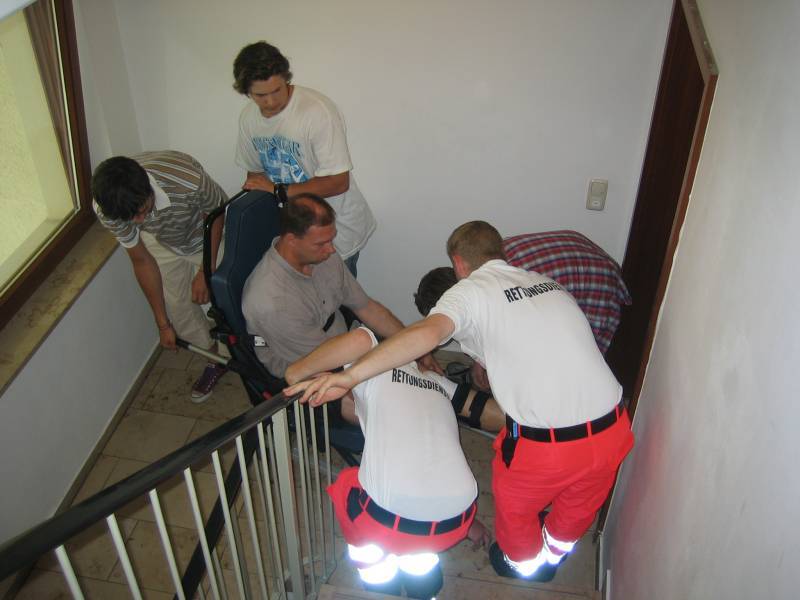
Ekke looks happy to be back at the hospital
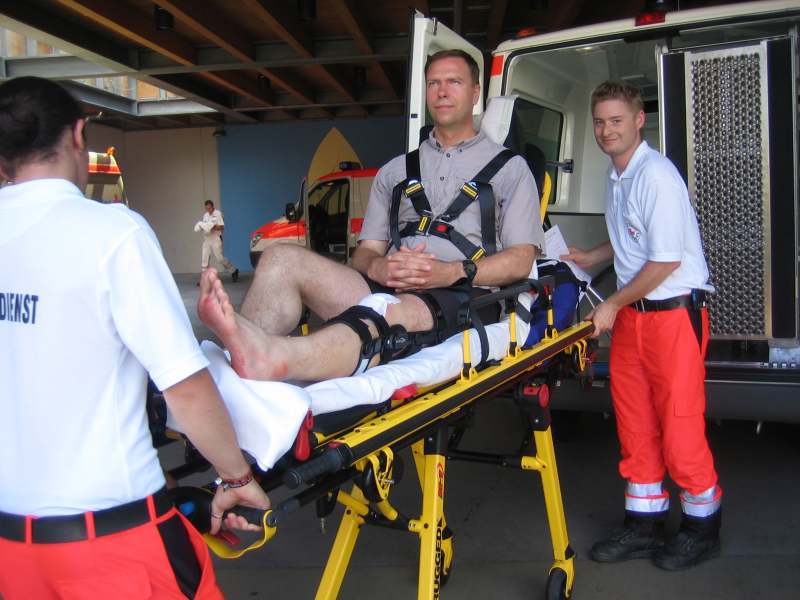
On the ambulance ride back to Freising I sat upright watching the scenery and wishing I could be riding these nice German roads on my bike. Emergency was much busier this time and I had to wait an hour and a half before I could even get into an examining room. Audrey got to ride in the ambulance too so she spent the whole time in the waiting room. Eventually I got a room and a little while later a doctor came by. He read up on my case and was very impressed with the surgery. He said that they had made an especially strong repair using special dissolving thread (3 to 4 months) that was very unlikely to be broken. Nevertheless he thought an X-Ray and ultrasound would be a good check. He then took my brace off and played with the knee a little bit. All of a sudden there was another "popping" sound and he looked up at me expecting to see me in pain. I just gave him a beatific smile. I said that that sounded like the popping sound I had heard when I stumbled. So maybe my knee had dislocated a small amount when I stumbled and now he had popped it back in. The X-Ray showed no problem but it was quite a wait to get in to ultrasound. When I finally got in the technician was very thorough. He must have spent close to an hour with me and I got to see the cord used for the repair. He couldn't see a portion directly under the patella so he asked if it was OK to bend my knee. I said, "No!" since I was rather paranoid of hurting it. He went out and got a doctor (whom I had met a couple of times last week when he was doing rounds) and he again said it was OK to bend my knee up to 30 degrees. When they lifted my knee up my muscles were so tight that it didn't bend! I eventually relaxed them enough to bend the knee and the technician could see a bit more. He was still missing a small spot but overall he thought that no damage had been done. Back in the examining room the doctor consulted with his colleagues and a sports medicine doctor and they all determined that everything was OK and I could go home. When I hobbled out to the waiting room three and a half hours after entering the emergency room Audrey was very relieved and happy to see me coming out under my own power. Helena (who works three days a week at a place near Stuttgart) drove straight from her work to the hospital and she was there a little after 8:00, about half an hour after I got out. Amazingly I managed to fit in the tiny Opel Corsa so we headed back to Erding (via a Burger King drive-through at the airport!). So, long story short (too late!), I was OK and not in the hospital again.
Friday we moved to Gästehaus Huber in Schwaig, about seven kilometres from Erding. This would be our home for a while. A reporter for the Freising Tagblatt had seen the police report on the stolen licence plate and when one of Helena's friends contacted the paper to tell them our story the reporter wanted to interview us. The reporter and photographer came by the Gästehaus at about 5:00 PM on Monday, July 23. The photographer took a few shots of us with Audrey's bike, pointing at the missing licence plate and then took off. The reporter spent about a half hour getting the information from us about our trip, the accident and of course the missing licence plate. Afterwards he said the article would probably be published in a couple of days.
Audrey goes for long walks in the country around Schwaig
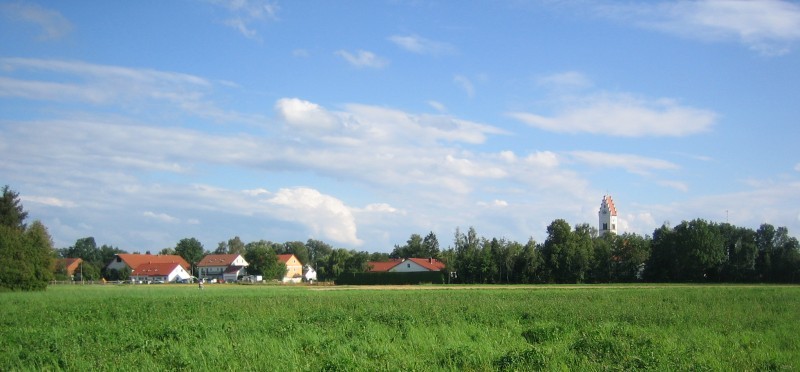
Maypole in Schwaig
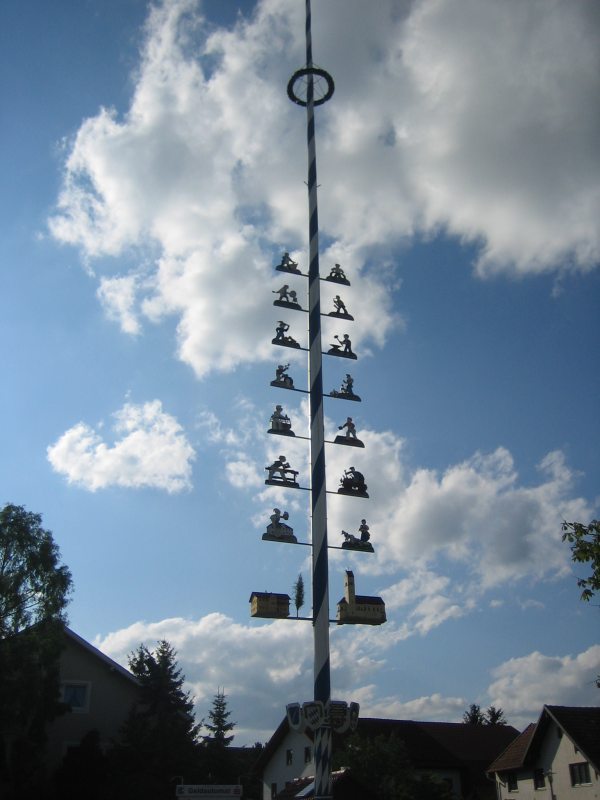
Thursday I had a check-up at the hospital in Freising so we caught the direct bus there from Schwaig. Too bad that the bus didn't have a handicapped seating area where I could stretch out my leg so I was forced to stand for the 20 minute ride. Since we were early for the appointment we popped in to the hospital café to kill a little time. The Freising Tagblatt was for sale there and we decided to buy it but before we could do that the cashier asked Audrey if her licence plate had been recovered yet. Apparently she recognised us from the newspaper article! We saw a few of the nurses from my ward and every one of them asked how we were doing and if the licence plate had been recovered. Maybe this paper had a higher circulation than we thought. When we opened up the paper we were greeted by our own smiling faces on the front page of the regional news section with the headline: "Knie Kaputt bei km Null". (Click here to read the article) The check-up went well, with the doctors indicating that swelling and heat were perfectly normal at this stage and that the knee was healing just fine. We walked down to the train station via the old city centre after the appointment (down was a different challenge on the crutches) stopping off at a café for a break before catching the bus back to Schwaig, via the airport. On the way to the train station we got passed by an older couple. As they went by, she turned around and started speaking German very quickly. I went into my usual spiel that I didn't speak German very well when she interrupted and said (more slowly) that we were the Canadians from the paper. She seemed pretty excited to see us and asked if the licence plate had been returned. So this is what it's like to be a celebrity!
Hospital café and Thursday's paper
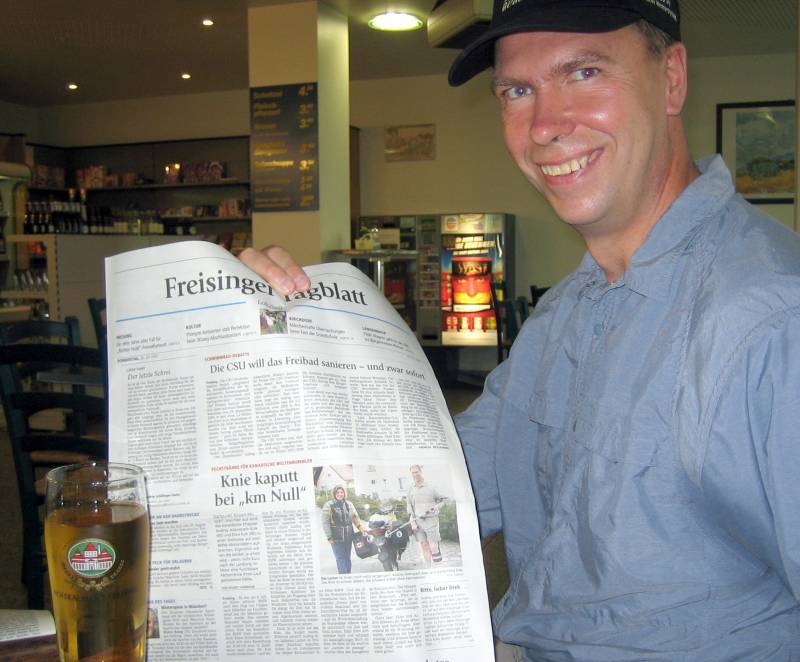
The original newspaper article

A Banana Split in Freising (for medicinal purposes of course!)

Hobbling around the old part of Freising
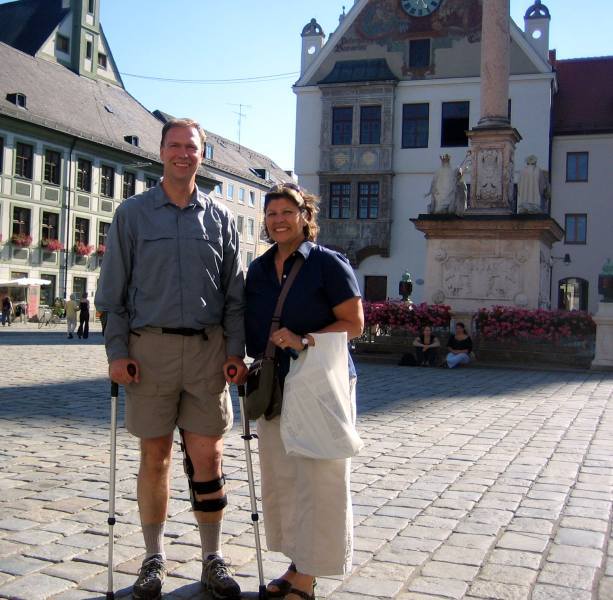
September 2nd update, Audrey writes:
Ekke's doing fine but still hobbling around on crutches. He went to the doctor on Tuesday, August 14, and the brace now has 60 degrees of movement, meaning a lot more range of motion in his leg. My new licence plate arrived from Canada, sent out by Ekke's parents (thanks, Ekke and Magda!) and it's nice to have wheels again. I use the bike to go to Erding for groceries or to the Munich airport for some English reading material at the international news shop. The airport's only a few minutes away and resembles a shopping mall with lots of stores and services, and of course, its own beer garden. Ekke gets physiotherapy every couple of days either at Therme Erding or the Gesundheitspark, while I do some shopping or go into the hot pools. Life here is very good and the leisure time is a gift that, hopefully, we're putting to good use with extensive reading, trip planning, sightseeing and mastering Sudoku puzzles from the London Sunday Times. Helena's invited us to movies, festivals and dinner at her friends Melanie and Steve's beautiful home in Niederding for some fantastic English fare complete with Royal Dalton china.
Audrey tries out her new licence plate
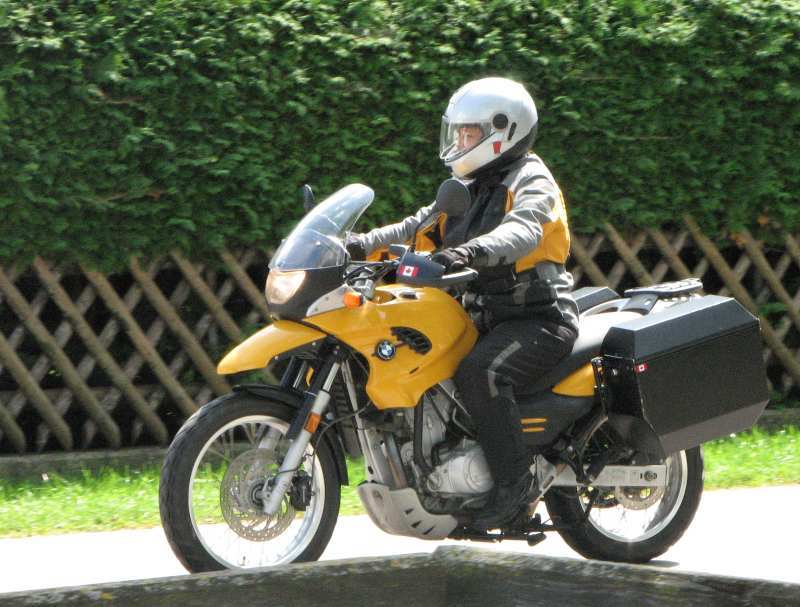
Ekke walks for fresh buns every morning

And then enjoying the fresh buns sitting on our patio
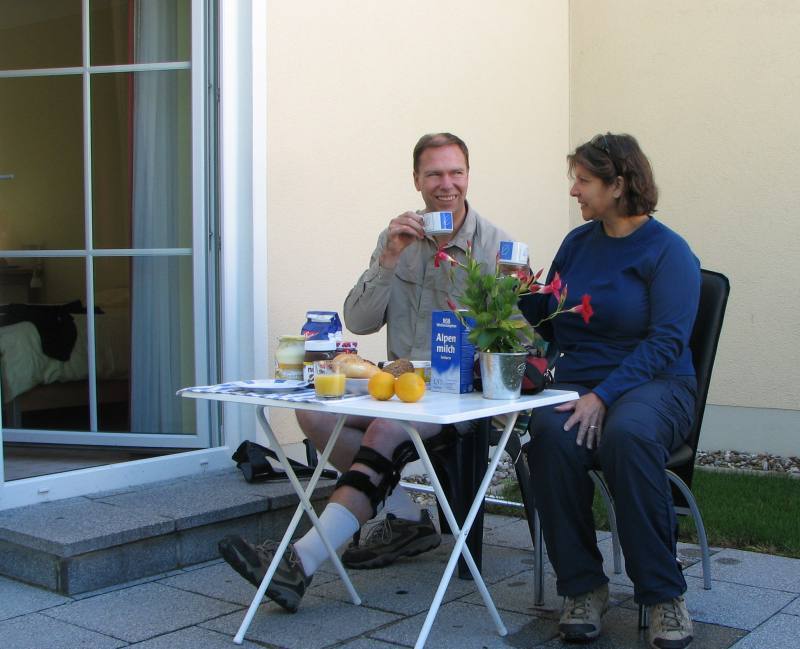
Maybe this is why Schwaig feels like home?
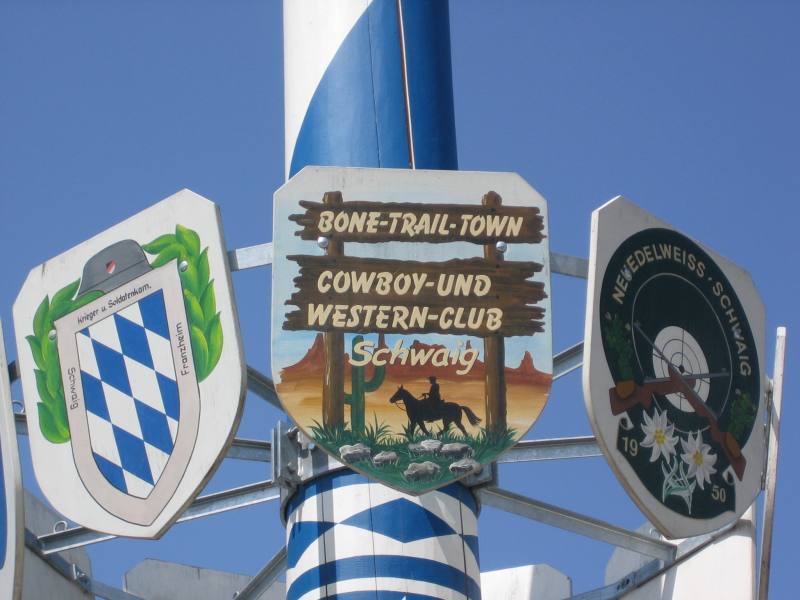
We are able to watch DVD's on our laptop, and are currently watching Ewan McGregor and Charlie Boorman's trip, Long Way Round, about their motorcycle adventure around the world. We're itching to go to begin our own motorcycle adventure, but know we have to be patient and just let the healing of Ekke's leg run its course. So, we're trying to see a few places around here, and visiting the BMW Museum in Munich was first on our list. We caught the S-Bahn, a regional train, at the airport and it took us to Marienplatz and then Olympiazentrum station which is near the museum. It was disappointing to find that the museum was closed for renovations, but then we discovered that a temporary museum was set up with most of the important exhibits from the original. One hour of looking at cars and motorcycles was just fine with me. The temporary museum did not have Helge Pederson's bike, however, so I knew I would have to come back to see that. Helge, a Norwegian who spent ten years on two wheels, inspired us to get planning our own motorcycle adventures. They did have Michael Martin's bike on display, and he is well known in Germany for travelling to interesting locations on his bike, taking beautiful photographs, and giving slideshows back home in and around Munich. We had heard of him from friends of ours from Bielefeld, and from Ekke's cousin, Paul-Jürgen, who had sent us a signed print of one of his photos, so it was great to see his somewhat battered BMW R1150 GS. After a lunch of Bavarian sausage and kartoffelsalad (watery potato salad with no mayo, but surprisingly tasty), we wandered around the site of the 1972 summer Olympics. We gave the Olympic tower a miss as it was an overcast day and we wouldn't be able to see the Alps. The stadium and other buildings were covered by various tent-like structures with plexiglass inserts, and looked very modern, considering they were 35 years old. It was all a very festive atmosphere as it was summer funfair time.
The new BMW delivery centre and museum should be open this Winter

Michael Martin's bike in the temporary BMW museum
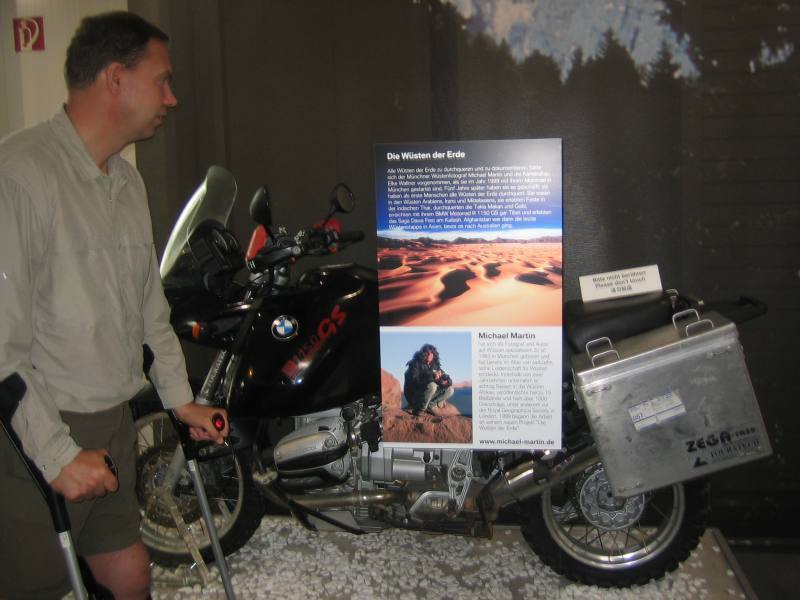
Audrey in the early years...
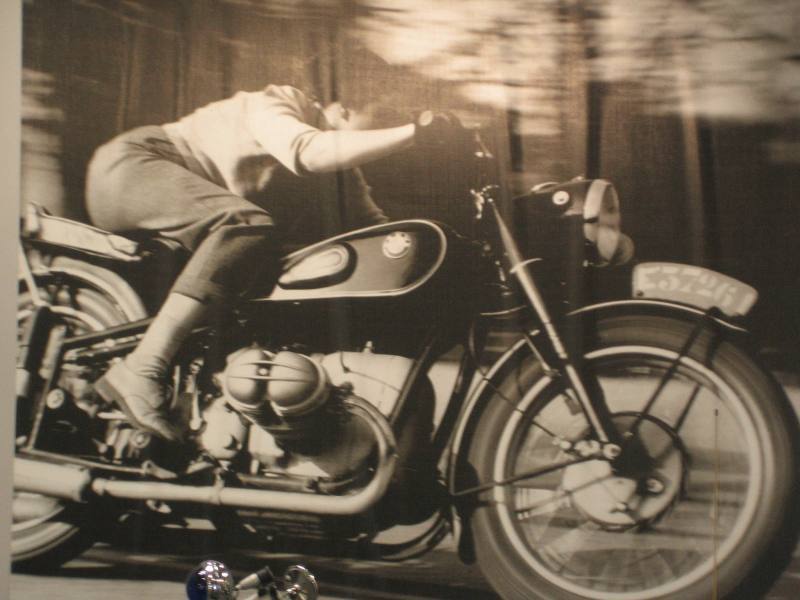
Amazing plexiglass structures at the Olympia Zentrum
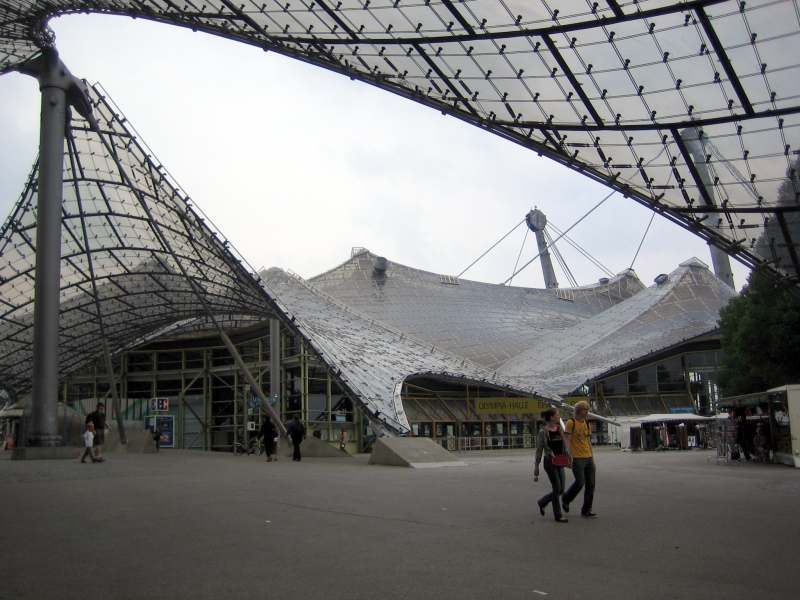
Helena invited us over for a fabulous home cooked Middle Eastern feast, and while there, we got a chance to use the internet and check if Michael Martin was giving a slideshow any time soon. Ekke discovered that he was currently doing a presentation in Tokyo, and wouldn't be giving a show here until sometime in February. Our hopes for meeting him were pretty much dashed.
Ekke's dad is a member of the Blue Knights, a motorcycle/police organization, and he had emailed the German chapter, telling them of our misadventures. We soon received a phone call from Tom and Andrea, two police officers from Munich, asking if they could come and visit us as part of their Sunday bicycle trip. So, we met here, walked over to the Schwaiger Hof Bier Garten, and had a nice chat about motorcycles and travelling. Andrea ordered a Kaiserschmarn and since Ekke's mom had mentioned that she loves them we each ordered one too. When a little bowl of what looked like applesauce arrived Ekke and I looked at each other and said, "It looks just like applesauce but what the heck, it must be special." When we dove into the sauce with the supplied spoons, Tom stopped us and said, "That is the applesauce that goes on the Kaiserschmarn!" Oops, almost a major faux pas! A moment or two later, a big plate with what appeared to be a cut up pancake, sprinkled with icing sugar and cinnamon came out. With the applesauce on top it was delicious. During the conversation, we happened to mention that we went to the BMW museum and saw Michael Martin's bike. Of course they knew who he was and were familiar with his photos. We said goodbye, with plans to attend a Blue Knights club meeting on Thursday. Later that night we received a phone call from Tom and he was very excited. Apparently they were putting their bicycles on the train near Neufahrn, and who should be sitting in their train car but the photographer, Michael Martin! He was coming home from his trip to Japan and was taking the train from the airport to Munich. They chatted with him for a while, and he mentioned that he was trying to get a show together in Herrsching, about 40 km south of Munich, and was only awaiting approval from the town. We were quite flabbergasted with the amazing coincidence and, of course, a chance to see his show.
Tom and Andrea after riding 50 kilometres from their house
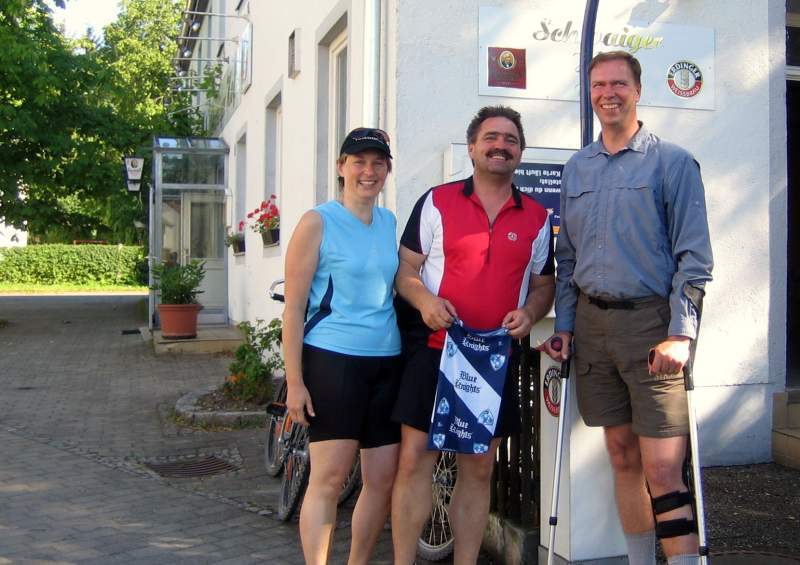
Tom and Andrea picked us up for the Blue Knights meeting on Thursday, which was at an active military base in the north part of Munich. Tom advised us to carry our passports with us and then hope that the guard at the gate would know that Canada was part of NATO! As we passed through the gate, Tom flashed his and Andrea's police i.d. cards, and the guard just waved us through. Tom said, "He may know that Canada is in NATO but he apparently can't count to four!" I checked with Andrea to make sure I wouldn't get arrested before taking a picture of a German tank outside the barracks, and she said it should be okay. About 25 people showed up at the meeting, apparently a great turnout for the middle of summer holidays, and we enjoyed some local cuisine and Weissbier (wheat beer, a local specialty). Most of the proceedings were in Bayerische, but it was just so special to be invited, it didn't matter. Ekke gave a quick speech in English, which most people understood, explaining our trip plans and how quickly they changed. We were given club patches and a pin and were able to chat with a few people. On Sunday, Andrea and Tom picked us up and gave us a great driving tour of Munich. The Asan church was quite spectacular; we didn't realize that Munich had so many grand avenues with even grander arches and monuments. Nymphenburg Palace had pleasant grounds for walking and after that we drove to Lacky and Judith's house for a fantastic barbeque. Lacky greeted us in lederhosen, and showed us his garage with a rebuilt Yamaha SR500 and a BMW R1100 GS. The pork garlic sauce and Bavarian Schnapps made for a very special evening.
The Assamkirch set on an ordinary Munich street
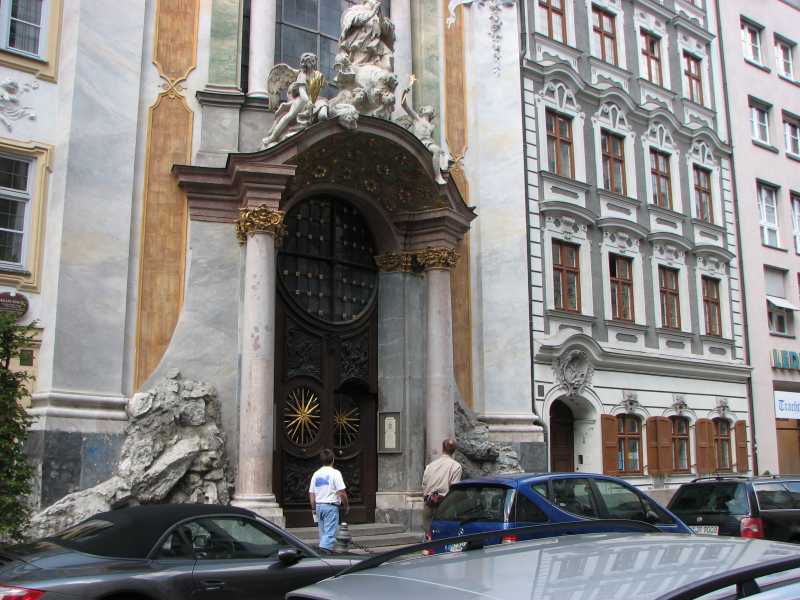
The extraordinary interior of the Assamkirch

Swans in front of Nymphenburg Castle

Audrey enjoys Lacky's hospitality at the BBQ at their house

Lacky came out for a visit to Gastehaus Huber (and to see if the Hubers were the same ones he knew from years ago. They were; yet another coincidence.)
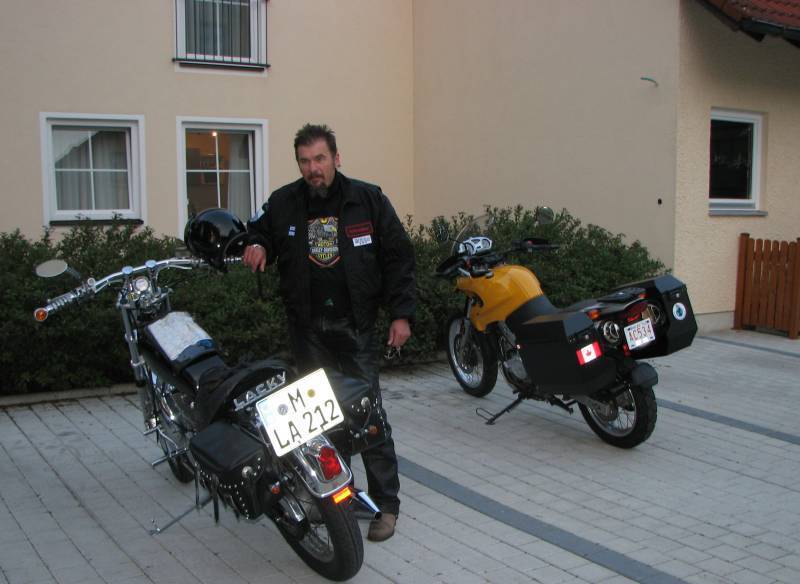
Everyone had been telling us to visit the Deutsches Museum (science and technology) in Munich, so off we went. The line up to get in was huge, but the 30 minute wait was definitely worth it. The museum covered at least 6 floors, and our strategy was to start at the top and work our way down. There were great views of the city from the rooftop lookout, along with a selection of 22 sundials on display outside. We took our time wandering through the astronomy exhibits, which were accompanied by plenty of English information, and really enjoyed the displays showing the development of the computer. The food technology area was quite interesting, complete with ploughs and milking machines throughout the ages. And what Bavarian museum would be complete without the beer making exhibit, which was quite well done. After spending hours wandering, viewing and reading, we realized we had only covered 3 floors, all of them quite a bit smaller than the 3 floors and basement below. So, with one hour remaining before the museum closed, I decided to just do a quick walk-through of the rest of the floors, leaving Ekke to meander through the aerospace technology and environmental exhibits. After a quick journey through cell structure, oil and gas, marine science, tunnel building and flight, I found a spiral staircase that led to my favourite part of the museum, a labyrinth of mines and mining history. A sign at the beginning warned that it would take at least an hour to go through but with a bit of a push, I completed the route in 15 minutes. There were no exit points at all as I elbowed my way past slow-moving tourists, through darkened tunnels, past dioramas of salt and coalminers, and eventually out. Ekke was having his own adventure as he walked through the environment exhibits. All of a sudden at about quarter to five a loud clang reverberated throughout the room which all of a sudden seemed to be devoid of human life. A moment later the lights were switched off and only a pale light came through the windows. He hobbled to the sound of the clang to find the doors locked and a man standing by the light switch. Ekke asked to be let out and then for the elevator down. Apparently the access to the regular lift was locked off now and the man with an air of exasperation opened a special cargo/handicapped elevator. There the man curtly pressed the ground floor button and stepped out whereupon he heaved the doors shut leaving Ekke to descend by himself in the pre-programmed lift.
Entrance to the museum
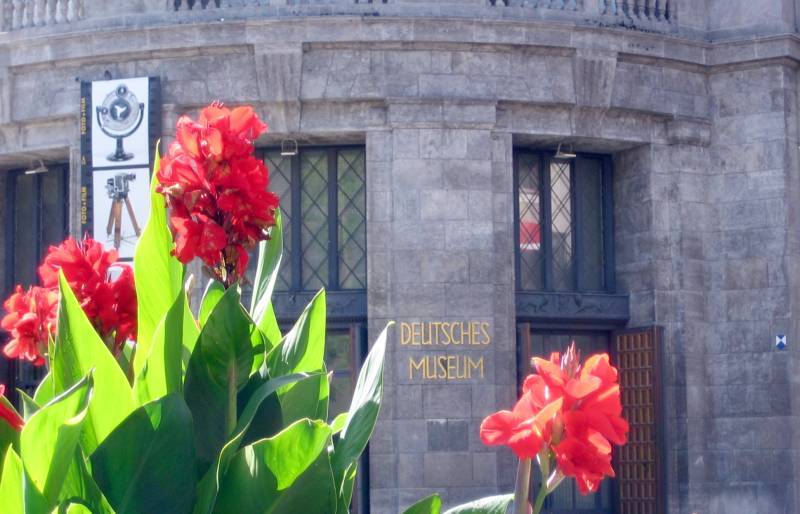
From the rooftop of the museum (yes it is more humid here than in Calgary!)

An early computer using vacuum tubes

Milling wheel

Early experiments in flight
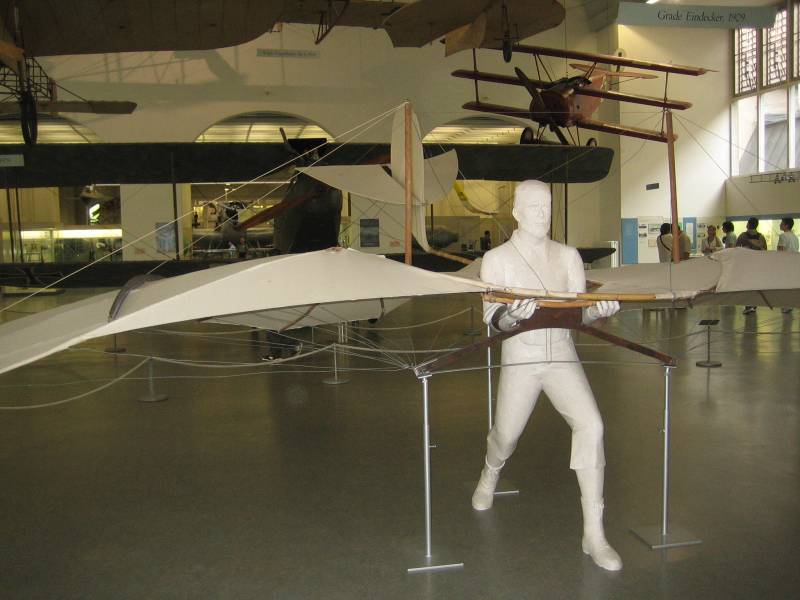
Cross-section of a modern jet-liner shows where our motorcycles would have been stowed
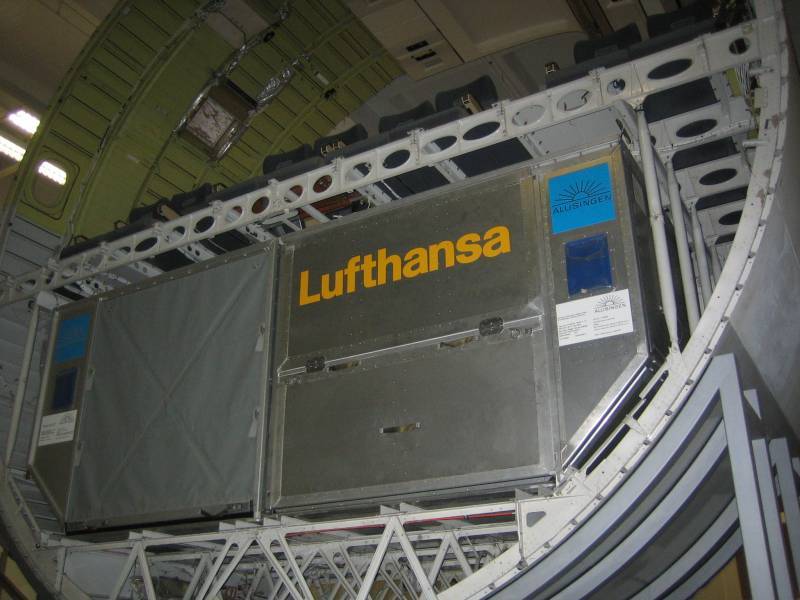
Working in the salt mines
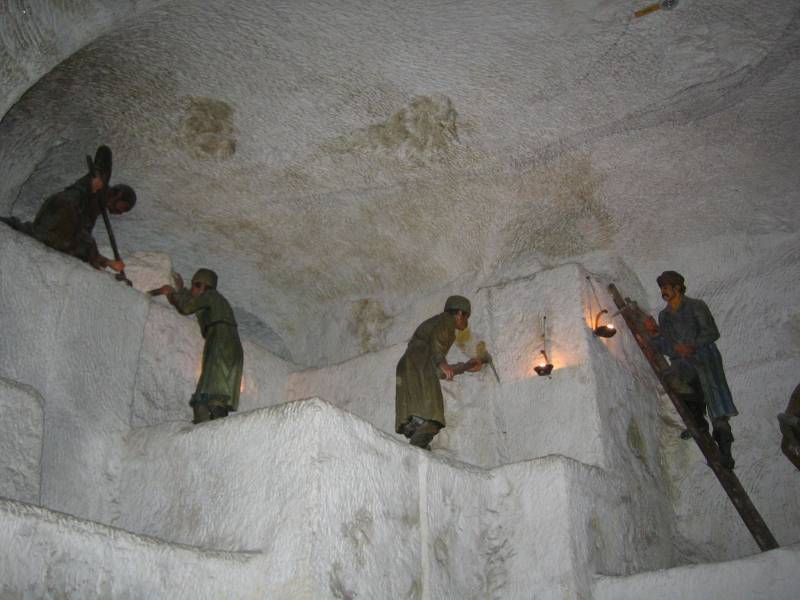
On Friday, the 24th of August, Ekke and I took the S-bahn into Munich after his physiotherapy appointment in Erding, walked around a bit and visited the Frauenkirch, a huge gothic church near Marienplatz. We then caught the S-Bahn to Herrsching, on the Ammersee (lake) in a beautiful forested area with rolling hills. After a dinner of what I'm sure is the local Bavarian specialty, Hawaiian pizza, we met Andrea, Tom, Judith and Lacky for the Michael Martin slideshow. As soon as we walked through the gate, Michael Martin came right up to us and said, "So you must the Kanadechen (Canadians). I read your website and the newspaper article about your accident". Apparently Tom had emailed him saying we were coming and had included our website address. Wow! Michael Martin knew about us? We chatted for a while, and he really wanted to stress to us the importance of getting a new carnet de passage. Since my licence plate had been stolen, I had to get a rectifie stamp and my new plate number written in on all 50 places on the carnet by an official at ADAC (the German CAA). Michael said that it would definitely be a problem, especially in Egypt, if every number on the carnet didn't match what was on my bike, this from somebody who had crossed over 300 African borders. We crossed his path twice more in the evening, and again he said that we should get a new carnet. I guess we'll get a new carnet! We bought one of his books of photos, which he kindly signed, and Tom took our picture with him. The slideshow itself was absolutely astonishing. He and a friend, Christine, had travelled the world's deserts for 900 days, 2-up and very fully overloaded with camera equipment. He gave the commentary in German, of course, and was an excellent speaker, judging by the reaction of the audience. But the pictures really spoke for themselves, about the people and landscapes they encountered, as well as the joys and hardships of motorcycle travel.
Poster in Herrsching

We get to meet Michael Martin
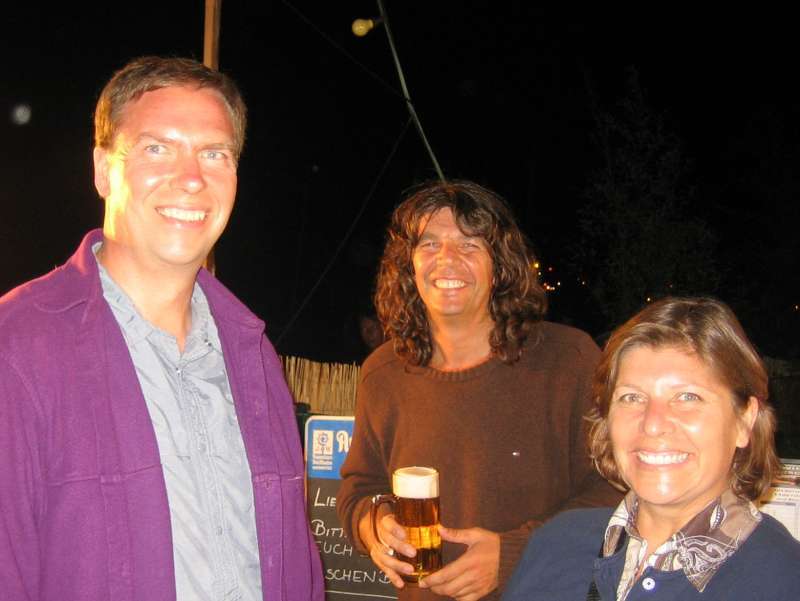
Tom and Andrea invited us to an IPA (International Police Association) barbeque in Halbergmoos, which is about 7 kilometres from Schwaig. As they got off their motorbikes here at the Gastehaus, we noticed Tom had his hand over his neck. He revealed a huge bump, apparently from a wasp sting while travelling on the highway. He is quite allergic to stings, but luckily carries cortisone in his keychain. After a drink of water, we were on our way, Tom, Andrea and I on bikes and Ekke with Christian, our landlady's son, in a big, black BMW. Ekke wasn't on a bike but at least he had air conditioning. After a very quick ride, we arrived at a farm where the courtyard had been converted to a bier garten and country bar. We felt quite at home, as the bar was decorated with North American memorabilia, including some Canadian licence plates. We thought it would have been hilarious if we had seen my plate nailed to the wall what with all the police officers around, but no such luck. The food was great with four types of meat and a selection of salads, bread and pretzels. The Erding organizer, Hubert, made a welcoming speech and mentioned us and our trip. Later on, a huge glass boot, filled to the top with two litres of beer, was passed around, apparently a local tradition. Sometimes an air bubble would form in the 'toe' and a drinker would get a big splash in the face, as Andrea found out. Lacky and Judith, who arrived later after picking up their daughter at circus camp, gave Ekke a ride home, and I followed behind on the bike. The cool night air was great to ride through and hitting the occasional warm pocket felt even better.
Andrea avoids the backsplash this time while Tom looks on
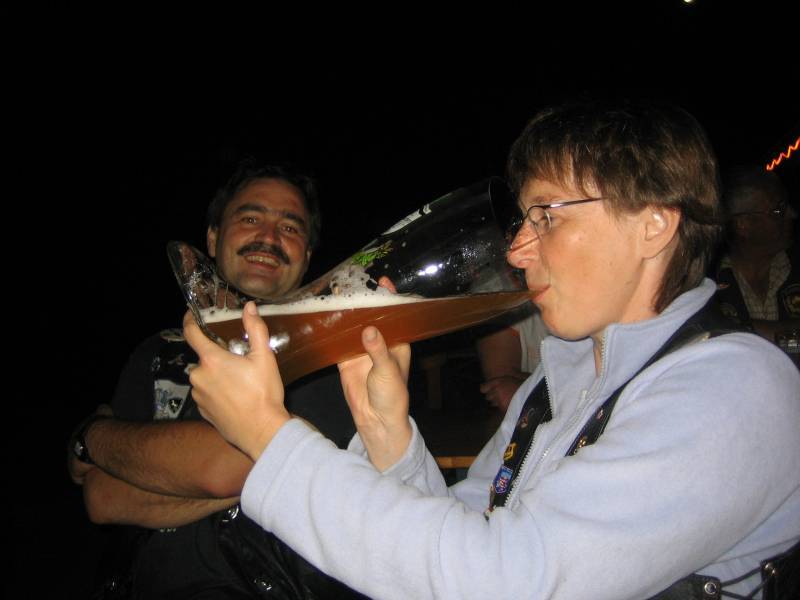
One of our day tours with Helena included a trip to Landshut, a gorgeous medieval town, with a castle on the hill. Of course, we headed straight to a café in search of kuchen (cake), as we're on a mission to determine which of these Bavarian specialties is #1. In the running so far was a chocolate and egg cream delight from a café near Ekke's physio clinic - how convenient, and an orange cream cake made by Frau Huber. Ekke ordered a layered egg cream cake in Landshut, and immediately declared it #1. It was a gorgeous day, and the castle afforded fantastic views of the step-gabled architecture of the town, church towers and surrounding countryside. We stopped by the airport on the way home for some convenient Sunday shopping and fish and chips from Nordsee.
Incredibly wide street in Landshut with the tallest brick church steeple in Germany
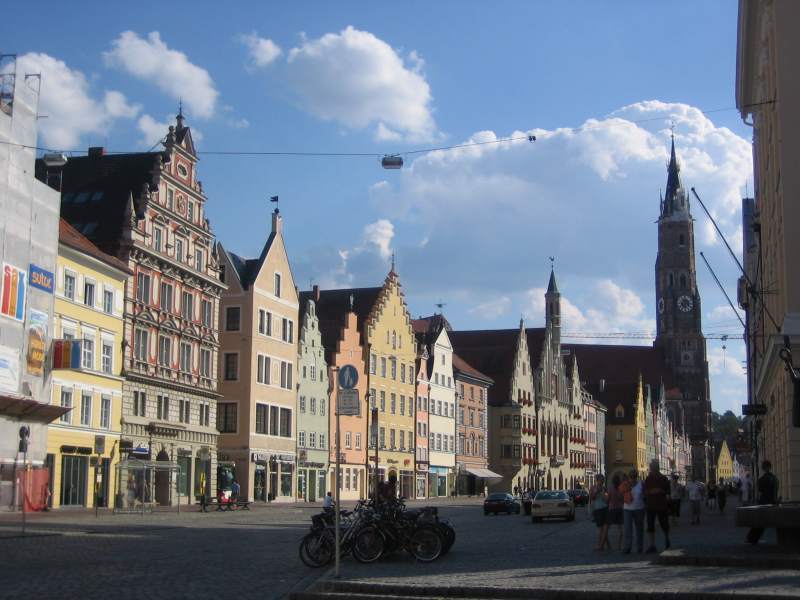
A hike up to the castle in Landshut with Helena (OK, she drove us to the top!)

After one of Ekke's physio sessions, we decided to go for kaffe and kuchen, and I believe I unseated his #1 cake with a banana chocolate cream concoction. Ekke did not agree, however, so we figure all we can do is try them all again. So many kuchen, so little time!
Ekke wanted to check out a a BMW motorcycle shop, Karl Maier BMW, in Neufinising, about 15 kilometres from Schwaig. It was a place we had visited in 2002 for tires and service, and he wanted to get some parts that would help improve the fuel economy of his bike. The trip took us most of the day, as we had to catch a bus from Schwaig to Erding, the S-Bahn from Erding to Markt Schwaben, and a bus to Neufinising. It ended up taking us about 2 hours to get to that BMW shop. Karl Maier is a world champion dirt track racer turned BMW shop owner. The store was great, with excellent clothing selection and beautiful new BMW bikes. Karl Maier saw Ekke's knee brace and crutches, and then, with some excitement said, "Hey you're the guy from the newspaper article, the Canadian!" Sheesh, that article was published a month ago and we're still being recognised! We couldn't stick around to chat because we had a 14:45 bus to catch so off we went. The bus didn't show up on time, which we thought was kind of odd considering their usual punctuality. Finally, looking at the schedule we noticed that the 14:45 only runs on school days and the next bus wouldn't arrive for another hour and a half. A bakery with a small seating area across the street from Karl Maier allowed us to while away the time with a pleasant view of the comings and goings at the dealership.
As you know, Ekke rebuilt his motorcycle last winter. During the rebuilding process, he found an eloquently machined part, available only in Germany, to replace the exhaust nut on his bike. These parts were made by Walter Price who lives about 140 kilometres northwest of Munich. Friday evening we received a phone call from Walter. He had read our website and found out we were staying near Munich and asked if we could meet up some time. We told him that we were going shopping with Helena on Saturday and were planning on going to a motorcycle accessory store in Munich so we decided to meet there at 13:00 on the first day of September (has it been almost two months already?). Helena picked us up and we drove to the Halbergmoos S-bahn station, where we took the train to Marienplatz in the centre of Munich on Saturday morning. She knew of a great café with a view over the Marienplatz from the second floor. We girls had a delicious breakfast while Ekke stayed true to café form and had a Schwartzwelderkirschtorte. (Apparently delicious but not unseating his #1 cake in Landshut). Back on the train we rode to Pasing and then walked a few blocks to Louis, the motorcycle accessory store. At some locations Louis has a wind tunnel set up so that you can try on a helmet or jacket before buying it but not at the Munich store, too bad, that would have been cool to try. Walter and his wife Monica met us at the shop and after buying a few accessories we went to a café for lunch and cake. Helena and I split a cheesecake while Ekke had tortellini with cheese sauce. Nope, the banana cake at the Gusendheits Park was still Number One in my books. After saying goodbye to Walter and Monica, we went downtown to a very elegant and flashy Bogner store where Helena's son Andrew works. He gave us the grand tour of the exclusive Bogner clothing, replete with fur, sequins and embroidery. We made a tough decision and did not buy the €7999.00 coat, instead saving our money to ride through Africa!
While looking at the physiotherapy sessions we realised that there was a gap of a few days between sessions on Thursday, September 20 and Monday afternoon. We decided that if I could push the Monday session back a day we could have a really nice long weekend to rent a car and go for a drive somewhere. The cheapest automatic transmission car (we weren't sure if my knee could do a clutch yet) was at Hertz. The weekend rate was reasonable but the extra day caused the price to double. Apparently we would be paying for an entire week to get the extra day. So let's go for an entire week!
After physio on Thursday we took the bus to the airport to pick up our little A-class Mercedes (or equivalent). At the Hertz counter I was asked if I could drive a manual transmission. I replied that I didn't think so and that I had reserved an automatic because of my bad knee. The clerk went into the back and after a few minutes came back with the keys to a Mercedes (judging by the key fob). Audrey had stepped away from the counter for a minute so she didn't see that the forms I was filling out now were for an SLK convertible sports car. As we walked out to the garage I clicked the remote to open the doors for a sleek black sports car. Audrey simply couldn't believe it when I climbed in! The touch of a button brought the hard top down into the trunk (taking up a fair bit of trunk space as we found out later) and we blasted off into the evening sunset.
That evening we packed our stuff up and the Hubers kindly let us use a storage room downstairs in the Gästehaus for anything that didn't fit in the car (which was quite a bit!). Friday morning we stopped off at the store where I've been buying fresh buns every morning for the last two months, showed off the car, picked up a coffee to go and then drove south towards Garmish-Partenkirchen. The small roads around Munich were fun to drive and then we were on the autobahn. Zoom up to 150 kph with the top down! Zing went my hat! Under the wheels of a BMW behind us. Drat. Hmmm, the wind is awfully brisk at 150. After my head had been beaten into submission by the wind I put on a second hat with a little string under my chin. Not so cool but at least my Tilley wasn't flying off. We stopped for lunch in Garmish-Partenkirchen, eating our sandwiches on a bench in the centre of town. After that it, was all small roads through green mountain meadows for the rest of the afternoon. Belatedly we realised that we couldn't possibly make it to Martha's house in Wettingen (near Zurich) by our appointed 4:00 PM so we gave her a phone call. After driving for a while more through Austria we realised that wouldn't be able to make our rearranged time either. So as soon as we crossed the border into Switzerland we stopped at a gas station and bought an autobahn vignette. The top went up and we cruised to Wettingen in comfort. Amazingly without the use of a map or GPS we found our way to Martha's house just from our memory of being here in 2002. She welcomed us with open arms and invited us in for dinner. Later she continued her tradition of incredible hospitality when she offered her own bedroom (with chocolates on the pillows!) for us to sleep in.
South of Garmisch-Partenkirchen
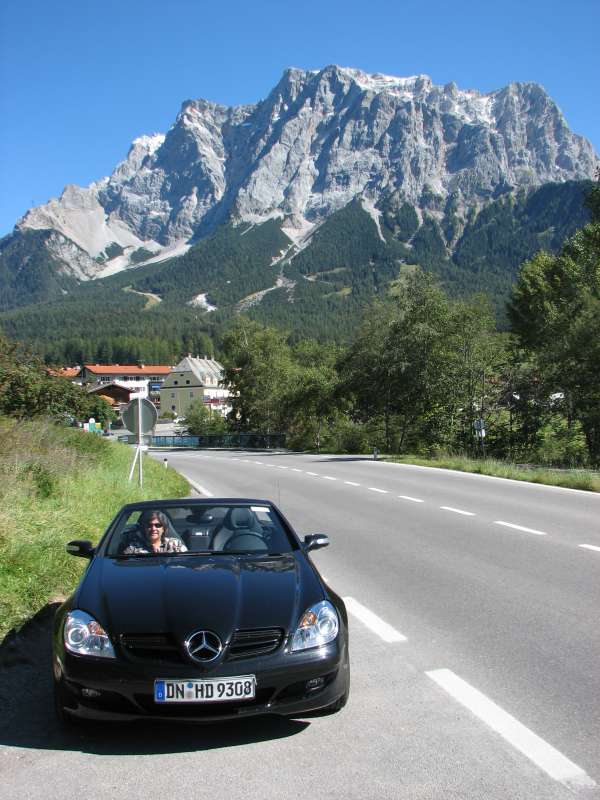
Saturday Martha helped me with my physiotherapy session by counting my repetitions before serving breakfast. Later one of Martha's sons, Stephan came over while the other son, Martin, couldn't make it because he was moving to a new flat. After lunch we piled into Stephan's Citroen C1 and drove a few kilometres to a nicely wooded area. There we went for a good walk and ended up at a restaurant over the autobahn. In fact it was a whole shopping centre located above the autobahn. We had a refreshing beverage and then walked back to the car through the woods. On the way home we stopped off at a couple of car dealerships where I found that I actually could have worked the clutch on an A-class Mercedes. Too late now! At the VW dealership they had a couple of camper vans set up. It's a shame we don't get these in North America anymore. With the diesel motor for fuel economy (and torque) and an all-wheel drive system they could very well be the ideal camping vehicle. And there is of course the fact that a camper van isn't likely to fall on one's knee! When we got back to Martha's house Stephan and I figured out how to work the navigation system built into the SLK and we programmed Susanne's house in Geneva into it.
Mövenpick restaurant and shopping centre over the autobahn

Sunday morning we packed up the Merc and before heading west gave Martha a ride around Wettingen with the top down. She had never ridden in a convertible before and was delighted with her short ride. The navigation system (which we gave a good German name: Porsche!) guided us out onto the autobahn and then we abandoned it. We turned off onto some nice small roads towards Lucern, shut Porsche down and then let Mercedes enjoy the ride. After seeing the Kapell Brucke in downtown Lucern we drove to Interlaken and up the Lauterbrunnen valley. We had crossed this valley in 2002 when we did a five day hike across the Alps (See Chapter 5 of the 2002 trip) so it was interesting to go all the way up the valley. The walls of the valley are sheer cliffs and the resulting waterfalls are spectacular. Paragliding is also popular here and the beautiful sunny day seemed to encourage them all out. As we were driving up the valley we suddenly heard a ripping sound and glanced up the cliff to our left. A body was plummeting to the ground! The unfurled parachute trailing behind was making the ripping sound. The 'chute opened up at the last moment and the base-jumper wafted down the rest of the way in safety. If that wasn't a shot of adrenalin for the jumper it sure was for us. On the return trip down the valley we stopped off at the Trümmelbach Falls where glacial meltwater has carved a corkscrew deep inside the mountain. A fair bit of stairs were a challenge but probably good physiotherapy. We turned Porsche back on and followed her directions to Geneva. The Sunday afternoon traffic (the last best weekend of the summer!) made for slow going towards Bern and once again closer to Geneva but we found Susanne's apartment without any trouble. We settled into the guest room and then headed off for supper. A local restaurant provided the Malakovs (cheese pillows) for Audrey and Susanne while I indulged in a cheese fondue.
Martha goes for a ride
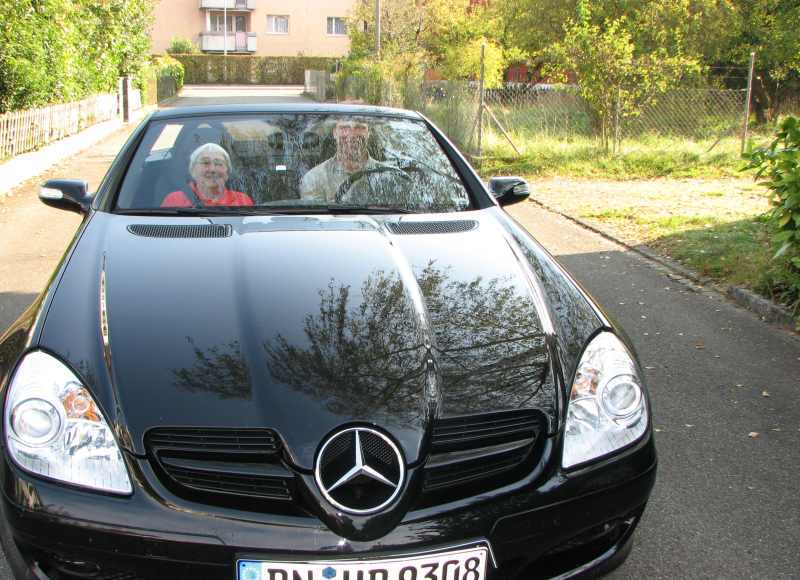
Driving up the Lauterbrunnen valley
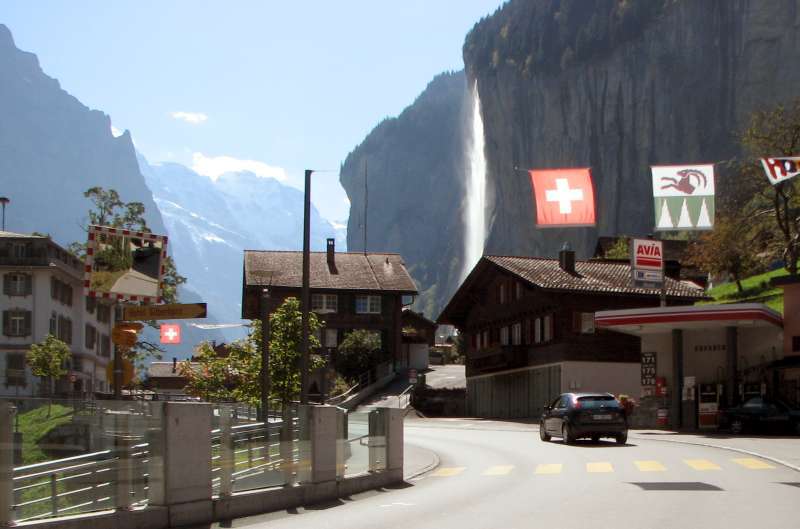
Oh happy day when the parachute opens!

A little stroll at the top of the Lauterbrunnen valley
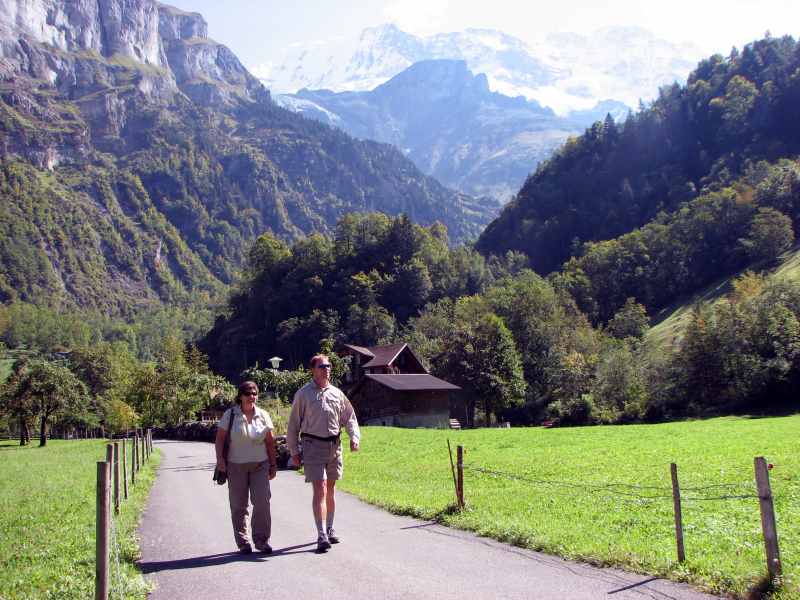
A small portion of the Trümmelbach Falls
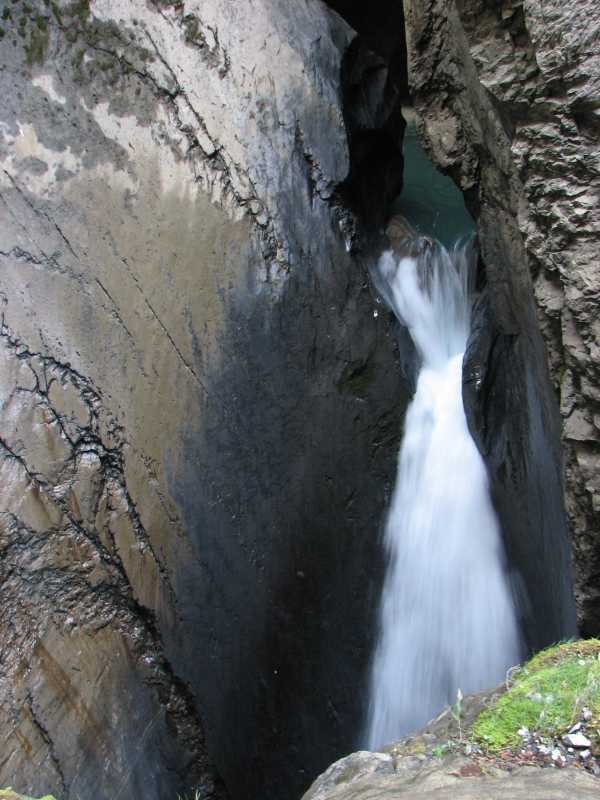
A lot of stairs and steep trails took us inside the cliff

The next morning we (and Porsche) set our sights on Zermatt. A fairly uneventful drive led us to Täsch from where a train departed for the remainder of the journey to the car-free town of Zermatt. There are a lot of parking lots and garages in Täsch and we were looking for an inexpensive one when we saw a sign for a campground right beside the train station. We drove in but registration was closed so we parked the car in what we hoped would be our camping spot and walked to the train. A short train ride brought us to a town that was at least one hundred times more touristy than Banff. Maybe more. It was jammed with people on a weekday in September. What must it be like in the peak of summer or during winter ski season? Hotels were everywhere, with more being built and gondolas, lifts and cable cars seemed to go up every visible mountain. We walked through the village hoping to catch our first glimpse of the Matterhorn. We found a place to see the mountain by the church in the centre of town but the peak, the actual horn, was shrouded in clouds. A trail led up the valley in the direction of the Matterhorn and we walked up for a ways until I got tired. It still caught me by surprise how easily my heart rate went up and it was real exertion for a simple stroll in the mountains. The views of the mountain improved and we saw a little more of the top but never the classic shot. Back in town we had a bite to eat at the cheapest place in town and then we took the shuttle train back down to camp in Täsch. There still wasn't anyone at registration and there wasn't a big honking parking ticket on the car so we just threw up the tent and planned to pay in the morning. This was the first time I had tried to get into a tent since the accident so I was a bit anxious. The original plan had been to have the A-class Mercedes as a back up so that we could fold down the rear seats and I could sleep there if the tent didn't work. The SLK meant that option was no longer open and I had to get into that tent. Fortunately I could do it without too much pain and only a little contortion. I could even get out!
OK, the little string doesn't look so cool, but at least Ekke still has his hat!

Goats along the road to Täsch
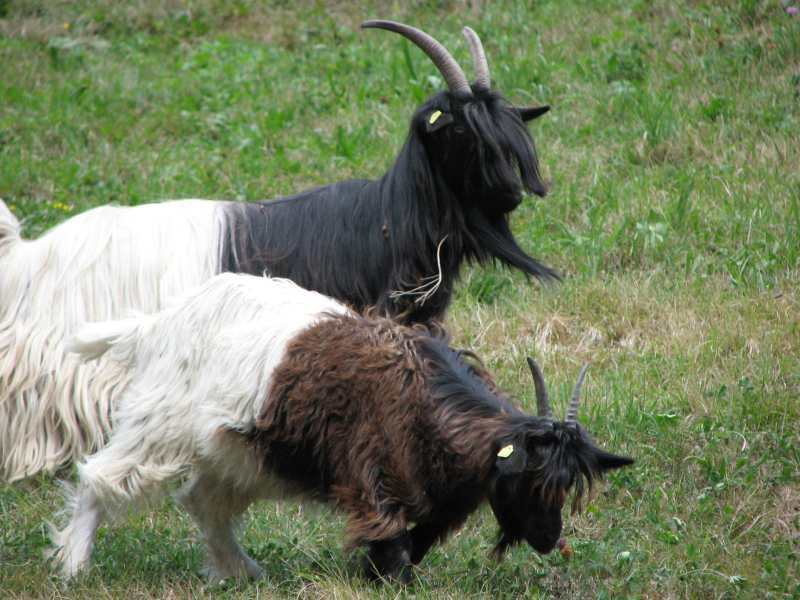
The SLK in the campground as we are whisked up to Zermatt on the shuttle train
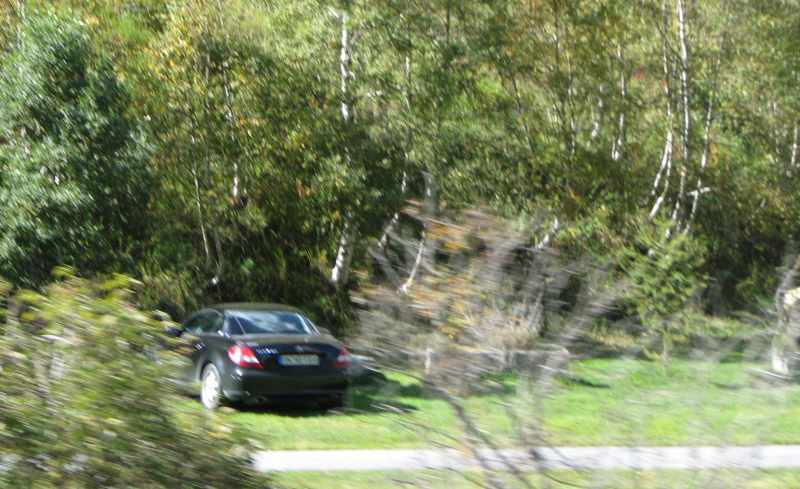
Our first view of the Matterhorn

Enjoying a quiet moment in Zermatt
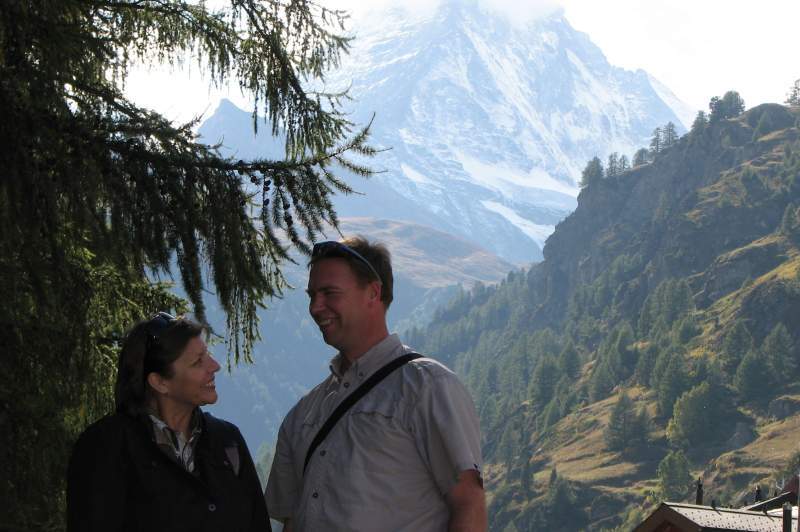
A chocolate bar shows us what the Matterhorn looks like without the clouds

Zermatt is growing every day
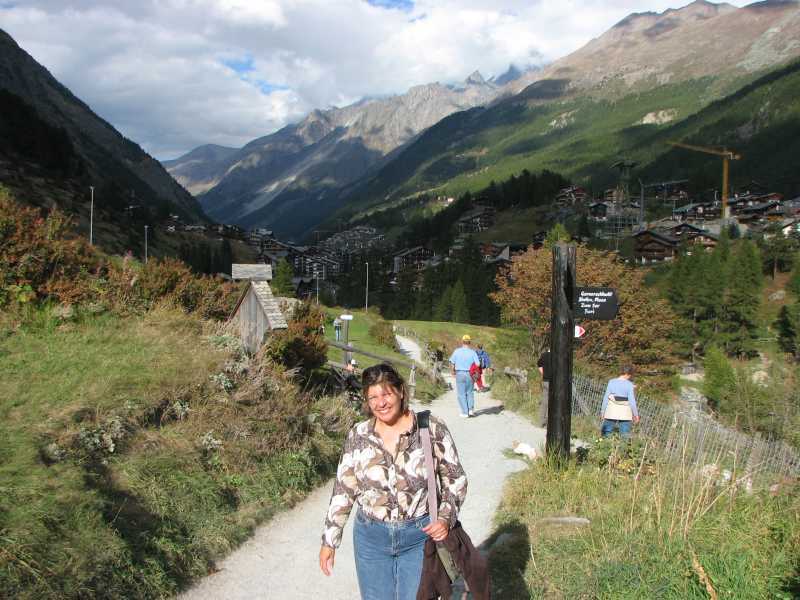
A last glimpse of the Matterhorn
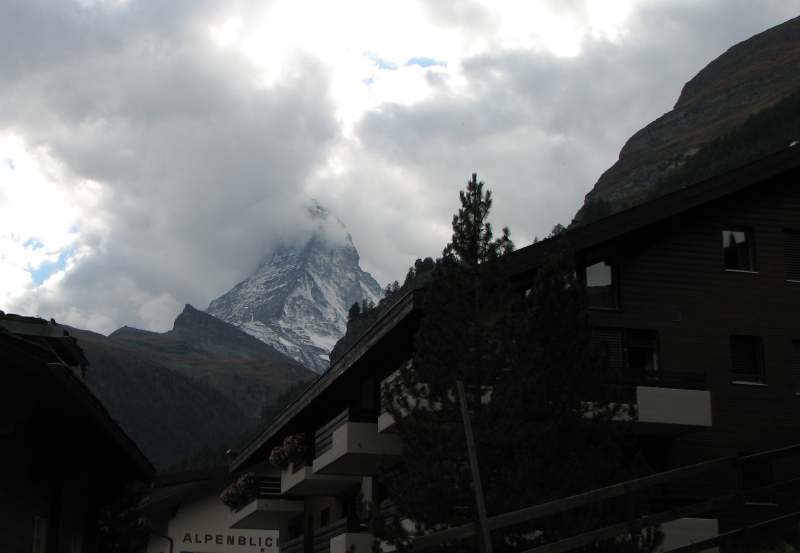
The next morning the campground registration was open so we paid up and got on the road to Locarno in the Italian section of Switzerland. The drive over the Simplon Pass was foggy and damp but not enough for us to put the top up. The Mercedes has a neat feature for cool weather, top down driving that we really appreciated; an air vent situated just below the headrest in the seat blows warm air at your neck (or in my case between my shoulder blades). Along with the heated seats it was pretty cozy in there. On the descent we stopped at a building that must have been an old toll house. Inside was an exhibition about the pass and how Napoleon had used it. Across the road was a section of the old "road" as Napoleon would have known it so we walked in the footsteps of Napoleon, if only for a short distance. In Locarno we found Camping Delta on the edge of the lake. It must be the kind of place that is absolutely hopping during high season but it was fairly quiet now. After setting up the tent we walked in to town along the waterfront. It started to rain, at first a little and then harder. Naturally umbrellas and raincoats were left back at camp. Since my walking speed wasn't fast enough to sprint to shelter we huddled under some trees and waited for the rain to let up a little. Eventually the rain soaked through the trees and we were getting wet even in our haven. We walked/hobbled a few more blocks to downtown where covered shopping arcades provided some shelter. Again, since the budget was getting rather stretched, we opted for the cheapest place in town for dinner and hoped that the rain would ease off before it got too dark. When we spied a break we headed off for the four kilometres or so back to camp. We didn't get too wet but it was getting kind of dark, especially in the more desolate parts of the walk by the time we got back. It rained all night and was still raining in the morning.
Construction on this bridge on the Simplon Pass allowed us to take the twisty old road

Napoleon crossing the Simplon
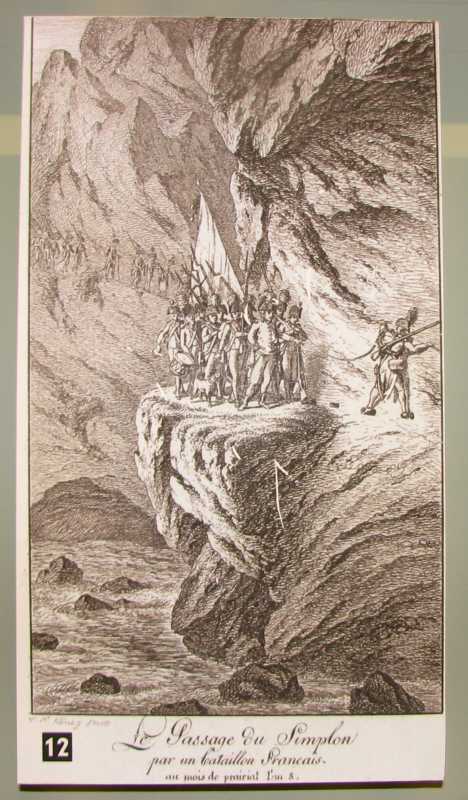
Everyone's favourite past time is certainly packing up a wet tent (dry on the inside though!) in the rain. At least it must make for good video because one of our camping neighbours was sitting inside his nice dry trailer holding up a cell phone and shooting our well choreographed tent packing! Perhaps it was a bit unusual to see people camping out of an SLK. At least we didn't have to put on our motorcycle clothes and then ride in the rain. We drove to the shower changing rooms and changed into dry clothes and then headed south to Lugano with the top firmly in place. The last time we drove through small Italian villages, like those along Lake Como, we were on motorcycles. While an SLK is a fairly small car it is still a lot wider than a motorcycle. There were a few times when I found myself holding my breath, only breathing once we got past the obstruction in the road (usually a house). Lugano was filled with very expensive shops and fashionably dressed people. So naturally here is where we decided to have a little local cuisine at a cafe in the centre of town. The price really was quite reasonable and the food was delicious. In fact the Tiramisu was the best non-homemade Tiramisu I've ever had. We really needed to get back on the road if we wanted to make the Stelvio pass before nightfall. We thought we had plenty of time since it was still early afternoon and it didn't look all that far on the map. Unfortunately our rather vague map didn't show all of the small Italian towns along the way. By the time we got to the base of the pass it was getting on 5 P.M. As we approached the summit it started to snow and the snow on the sides of the road started creeping out onto the rather narrow travelled surface. Driving on snow on one of the highest passes in Europe, in the dark, in an expensive German sports car with all season tires certainly didn't sound like a lot of fun so we decided to press on over the summit and hope for a town below the snow line to appear before it became too dark. Down the far side of the pass is a famous section consisting of forty some odd switchbacks and I didn't relish the thought of driving them in the dark and snow so you can imagine our delight when the village of Trafoi appeared out of the gloom and a hotel endorsed by a couple of German motorcycle magazines was open and had vacancies.
A break from the mirror scraping driving in Italy
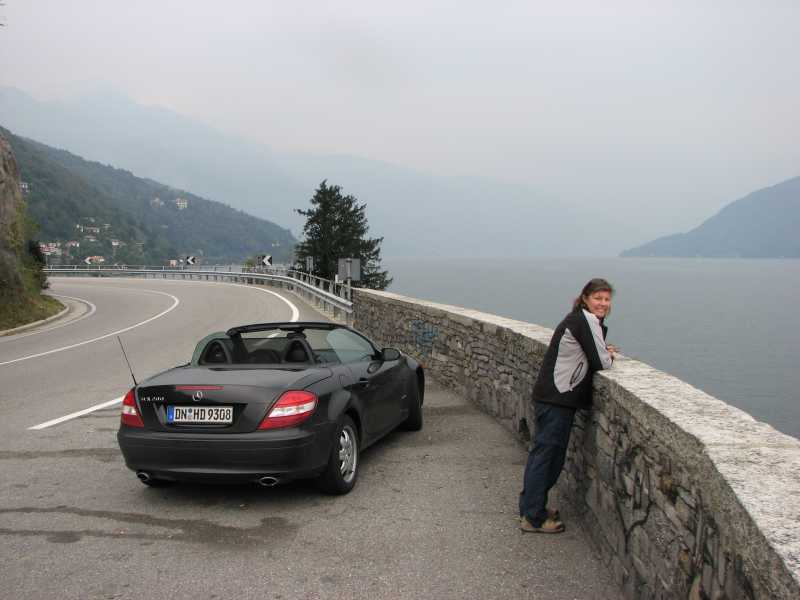
A little snow going up the Stelvio Pass

Getting dark...
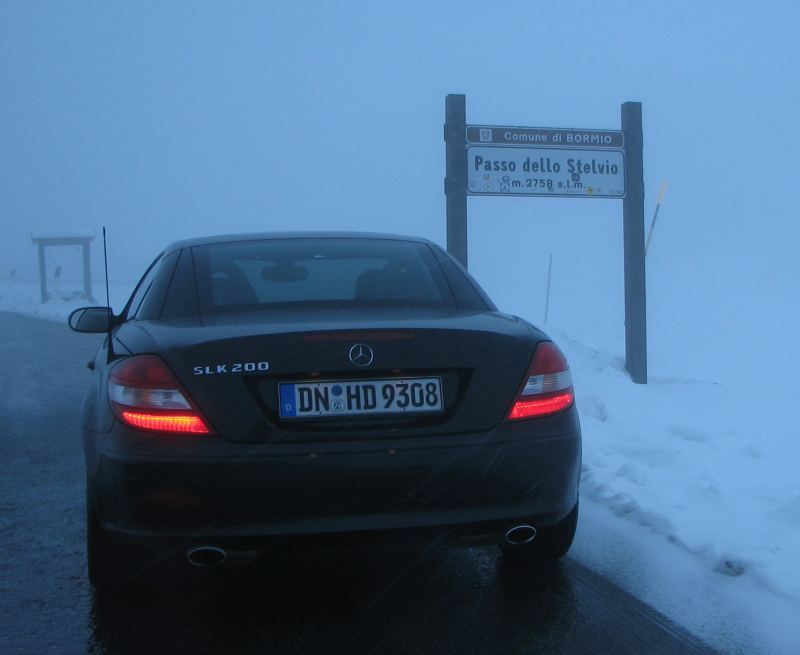
Hotel Tannenheim in Trafio
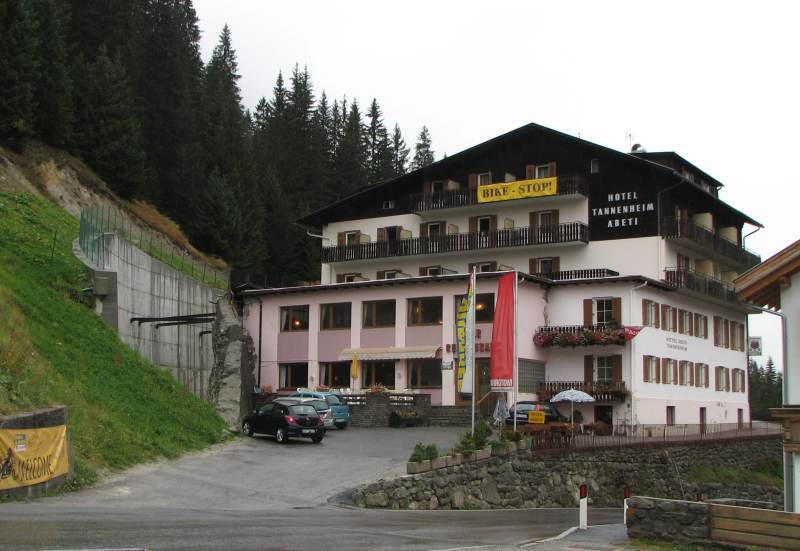
The car had to be returned to Hertz before 6 P.M. Thursday so we got on the road right after a hearty breakfast in the hotel. Amazingly we had not finished all of the switchbacks coming down from the Stelvio the night before but once we polished those off we headed north towards Austria. Lunch was had across the street from the Fernstein Castle on the way up the Fern Pass. I'm really beginning to like Curry Wurst, having had it a number of times, though I suspect it is not original Bavarian or Austrian fare. After driving through Garmish-Partenkirchen we turned up the road a little ways to Oberammergau, site of the Passion Play, which is performed once every ten years, and buildings with beautiful murals, where we walked around for a few minutes. Back on the autobahn we put the top up and blasted north to Munich. The car did an easy 220 kph before encountering traffic but it was still surprising to be bopping along at 190 and have an Audi station wagon come up behind you flashing the lights indicating he wanted to pass. At one point we came up behind a police van and I instinctively slowed down (to 160!) before passing him. I love Germany! We got to southern Munich just in time for peak period traffic and Schwaig is on the north side so we had the opportunity to sit in traffic and enjoy the Mercedes a few extra minutes before returning it. We were sad to see the car go, especially since we now had to get back on the bus for the ride home. A check on Hertz's website the next day showed that the SLK cost twice as much for the week as the A-class. While we were glad we didn't have to pay that much, knowing how much fun it was we probably would have.
The last switchback coming down from Stelvio taken the next morning
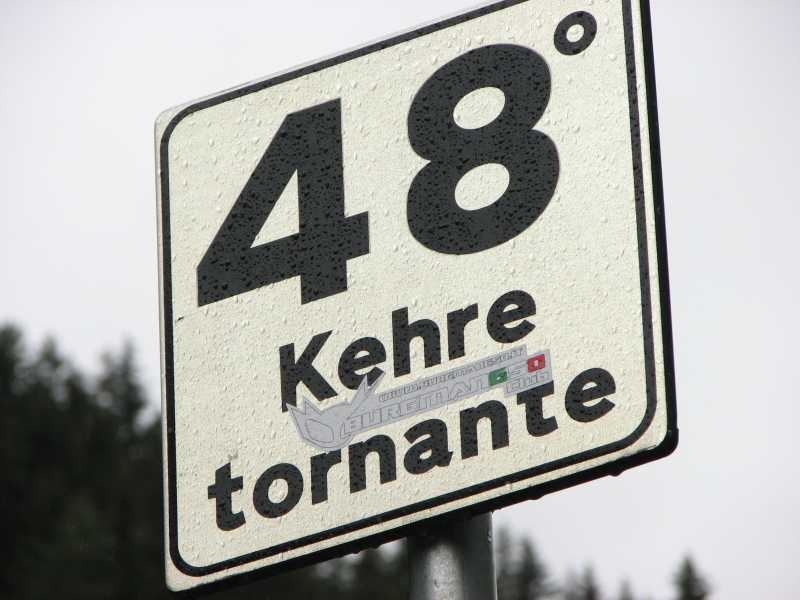
Strolling around Oberammergau
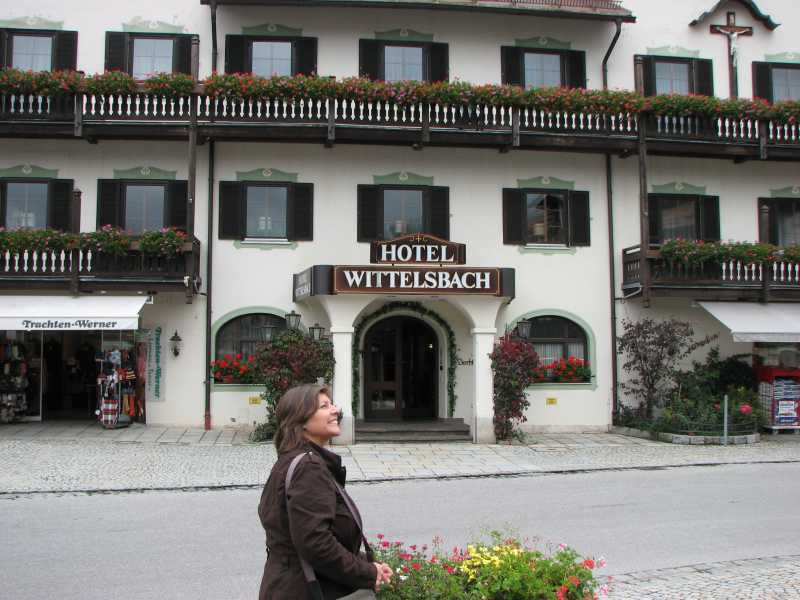
Oberammergau
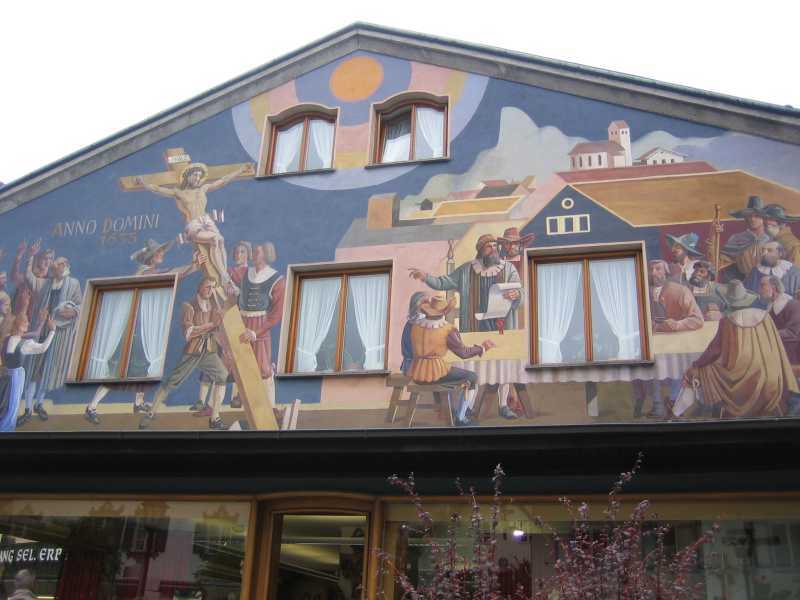
Oberammergau

The GPS says we're home

And the Bone Trail Town fort confirms it!

Audrey gives us a demonstration of putting the top down
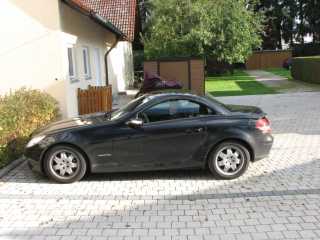
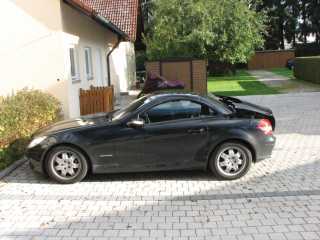
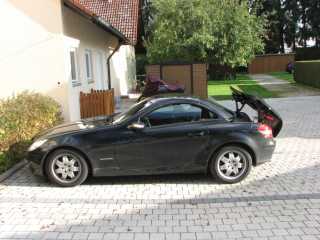
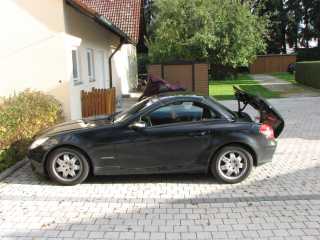
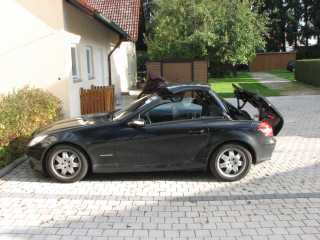
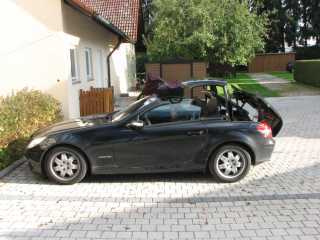

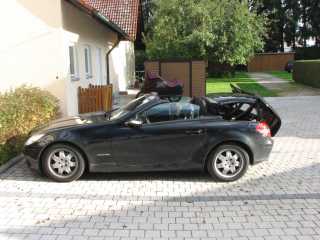
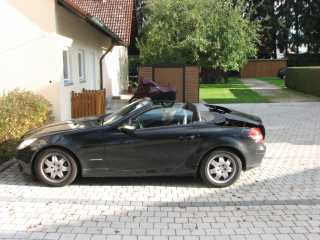
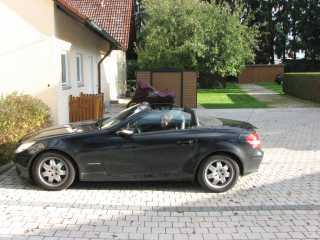
We had been in Schwaig long enough that we needed to register at the local government office as official residents. Official residents of Bavaria! It was a fairly straight-forward process in Oberding (thanks to Frau Huber for driving us there!) but the process for getting a visa to extend our stay in Germany was not so easy. A person is only allowed to stay in the Schengen countries (the EU basically) for 90 days and on October 6 our three months were up. Tom came to the rescue (again) and talked with the person in charge of the Foreign Affairs office in Erding. He pre-arranged everything and then took us there. This worked well since the clerk's English wasn't terribly good and my German/Bavarian wasn't much better. She went to talk with the Chief and he must have explained to her about our special situation (I had brought the physiotherapy schedule showing that I needed to be here past October 6) because our request for the visa was approved. We could pick them up next week. We realised something when we picked up our passports. Since the visa took up two whole pages of our passport, our passport would run out of pages before our trip was even half over. A call to the Canadian Consulate in Munich didn't help us: in order to get a new passport (preferably the 48 page version) the old passport must be close to expiring or close to full. Since ours were almost brand new and we still had 15 pages left they would not consider giving us a new one. There are 15 countries between Germany and South Africa so we should be able to make it to there as long as no one else uses two pages. The other condition with the visa was that it was only valid in Germany and that we had to transit through the other Schengen countries in five days. Of course, with no border controls between the various Schengen countries there would be no way to check how long it took to get from Germany to the first border control (Turkey or Hungary).
A stampede in Bone Trail Town while we are out for a walk

Our friends, Peter and Inge from Bielefeld (north-western Germany) hiked across Switzerland in September. This is the same couple that we tried to hike the Skyline Trail near Jasper with last year but we got snowed out (see here). Well, the bad luck with the weather must be theirs because their hike across Switzerland got snowed on too. After the hike they rode their motorcycles in the Alps for another week and then swung by Gästehaus Huber on their way home. We went to the Alte Post in Schwaig for a traditional Bavarian dinner and they stayed the night at the Gästehaus.
Peter and Inge stop by for a visit on the way home
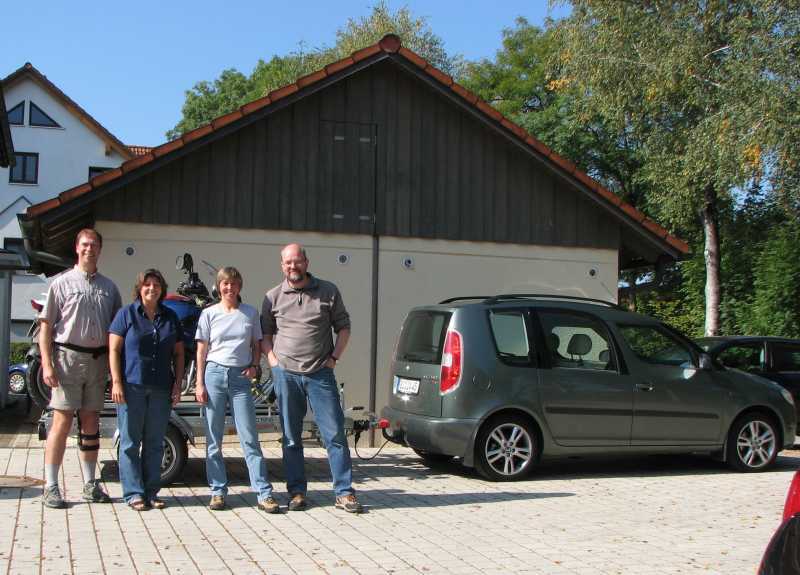
Acquaintances Mike and Ruby from Calgary (www.2canadiansonbikes.com) dropped by in September as well. They had put their motorbikes in storage in Germany after their last trip from Dubai to Germany and had now picked them up for their next trip; a lap of Africa. Friends of theirs, Michelle and Randy picked up a rented motorcycle in Heidelberg and then they rode together on a very wet day to Schwaig. Just when Audrey's bike was looking especially lonesome sitting by itself in the rain it suddenly had the company of two other bikes with Alberta licence plates! As they had a big travel day they couldn't stay for long so we just served them some sandwiches and hot chocolate/coffee before they headed for Austria. Depending on how my leg recuperates we might be able to hook up again in Africa to do some of the more difficult sections.
Ruby and Mike stop by for a visit on the way to Africa

At the September Blue Knights meeting we gave a slideshow of our trip last year to Inuvik and it was mentioned that five tables had been booked at Oktoberfest. Would we like to come? Of course we would! We had gone to Oktoberfest in 2002 but we didn't have a table reserved so just wandered around the grounds and did a few of the rides at the fun fair. On Tuesday, October 2nd, Tom picked us up in Schwaig and took us to the Foreign Office in Erding to apply for the extended visa. He then drove us to his house (and a quick stop at the Touratech store) before we took the S-bahn to the Wiessen (the grounds for the Oktoberfest.) Lots and lots of people were heading to Oktoberfest and we just flowed with the crowd. At the Fischer Vroni tent Lacky, Judith and Pia were waiting outside along with Manfred. Manfred is a Blue Knight from near Hamburg who has been coming down to Oktoberfest for the last three years. Inside the tent we found a few more friendly faces at the reserved table. Great food (Audrey even trying a herring dish), some table dancing and Lacky playing the spoons made for a memorable evening! This was a lot more fun with friends than as a typical tourist.
Lacky waits for us at the beer tent
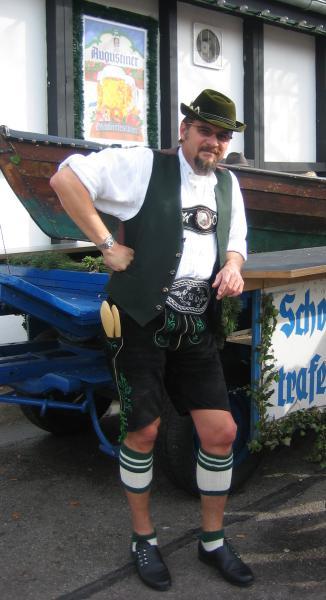
Tom dives into a Steckel Fish
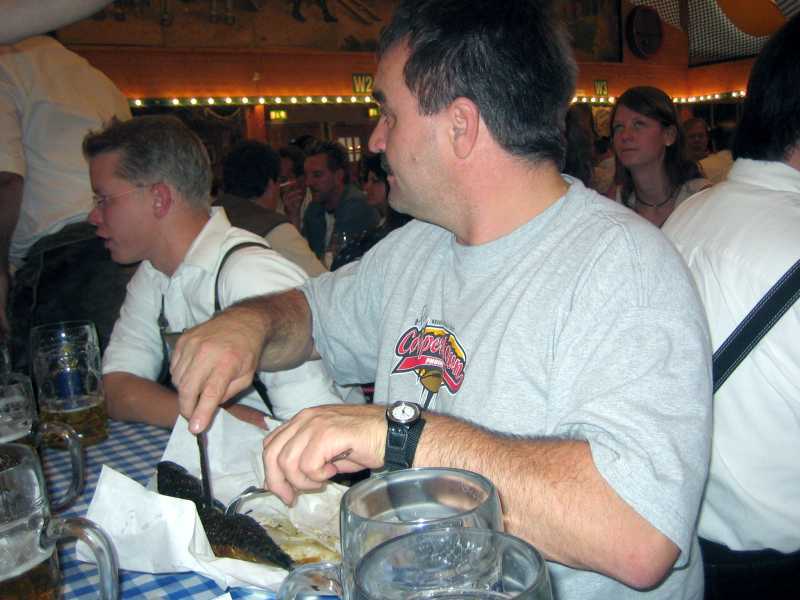
Audrey's herring dinner
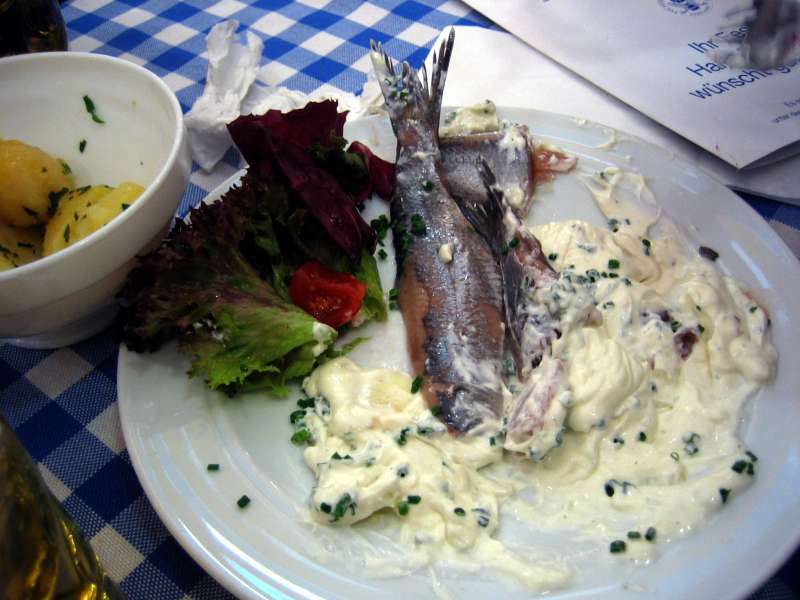
Ekke, Gerhard and Tom

Lacky on the spoons
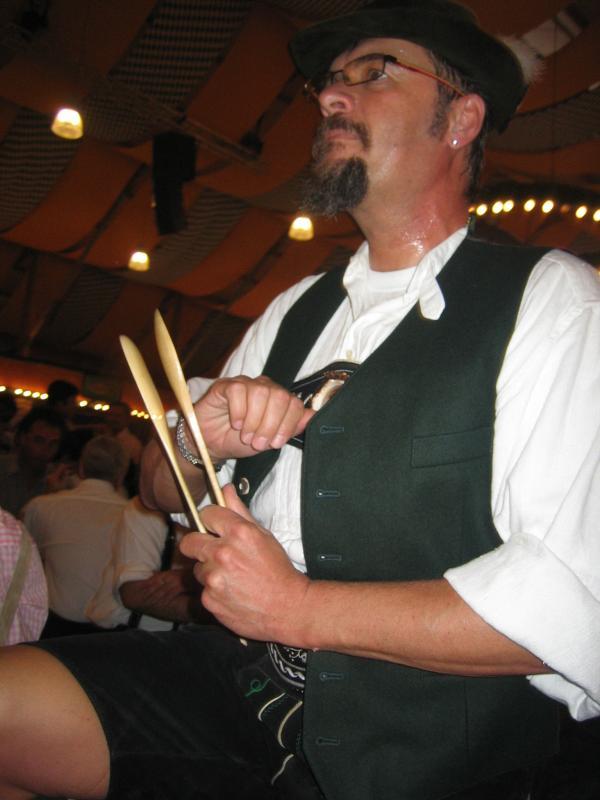
The view while dancing on the table
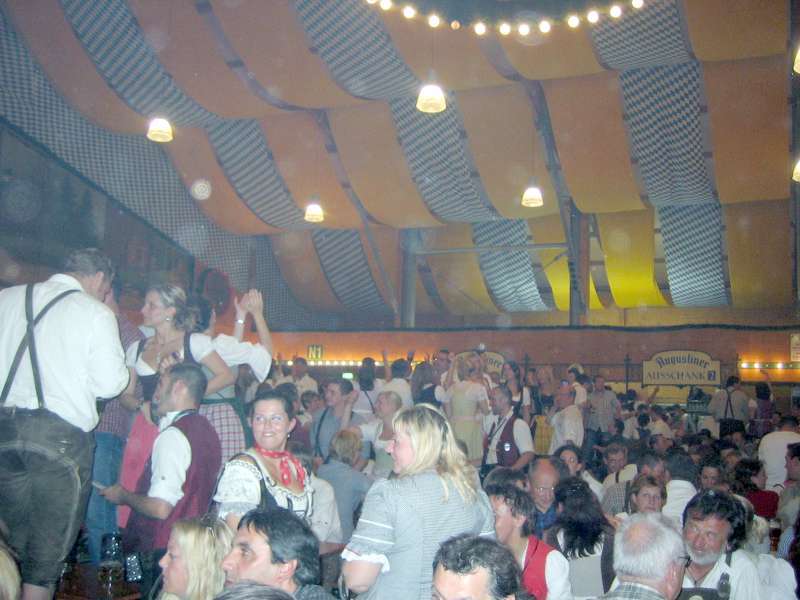
President of the Blue Knights chapter, Werner
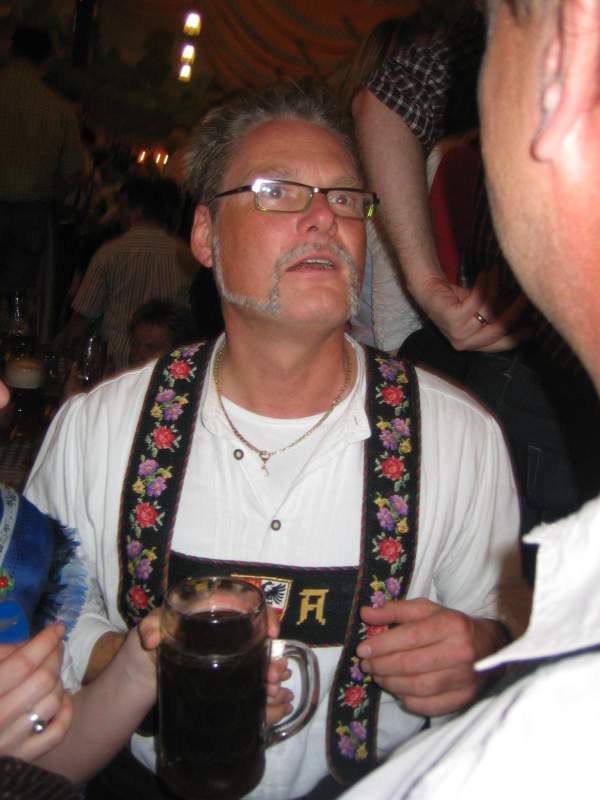
At the October 11th Blue Knights meeting (one of us is going to have to become a police officer so that we can join this great group formally!) it was mentioned that the Jail Riders were having a ride and barbeque on Saturday, October 13th. It sounded like it would be a lot of fun but I hadn't been on a motorcycle yet. I had no idea if I could even ride so we tentatively said we would come along. Friday the 12th I rode Helena's bicycle to Karl Maier BMW in Neufinsing (www.motorrad-Kmaier.de) to see if BMW had agreed to replace Audrey's pants which were no longer waterproof (they had) and then in the afternoon I took the bus in to Erding. At Helena's apartment garage I reconnected the battery on my bike (disconnected July 3 for the plane ride to Munich) and fired the bike up. Only a bit of blue smoke showed that the bike had been sitting for three months. I pulled on all my bike gear, rocked the bike off the centre stand and hopped on. I could actually operate the shift lever with my left foot! Riding home to Schwaig I was so happy that tears of joy were flowing down my cheeks and I was laughing inside my helmet. This ride was better than any first ride of spring I had ever had.
Ekke tries out Helena's bicycle (best physiotherapy possible!)
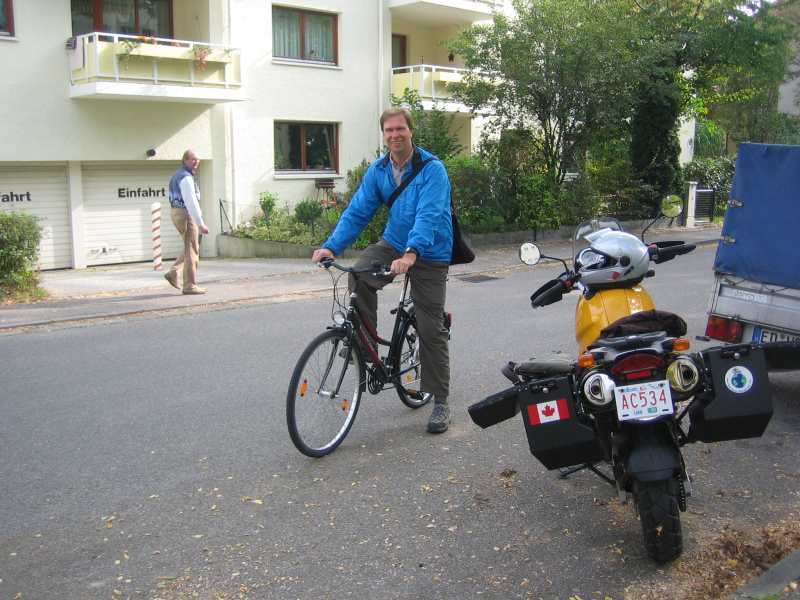
Does he look happy or what?
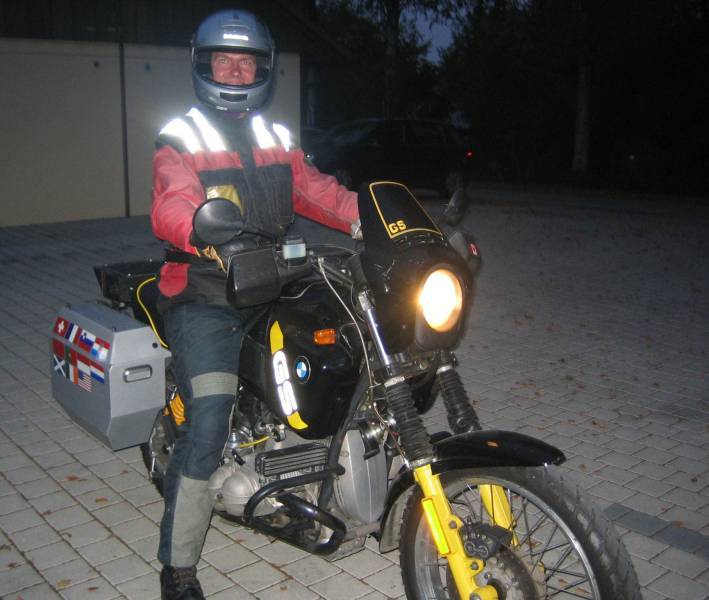
Saturday morning Tom came by on his bike to take us to the Jail Riders meeting point at a Yamaha shop east of Munich. When we pulled up the people there broke into applause as they saw that I was able to ride. There was still a bit of breakfast left over (weisswurst and brezen) which we tackled before jumping on the bikes for a short ride to a "biker mass" at St. Michael in Egmating. We had never been to anything like this before but apparently it is fairly common here to have a special mass at the beginning and end of the riding season. After the mass little schutzengels (guardian angels) were handed out and I mentioned that that would have been nice to have about three months ago! The 50 kilometre ride back to Motopoint Yamaha was done over some terrific, curvy back roads and when we got back a barbeque had been set up so we could have some bratwurst for lunch. Tom offered to take us on a nice ride south of Munich into Austria but my leg was a bit sore being cramped up on the footpeg so we declined. Instead we took a slightly circuitous route home, stopping off at a wild animal park that we might want to visit later. What a great first ride!
Tom picks us up for a ride

Talking with a few of the Blue Knights at the Jail Riders barbeque
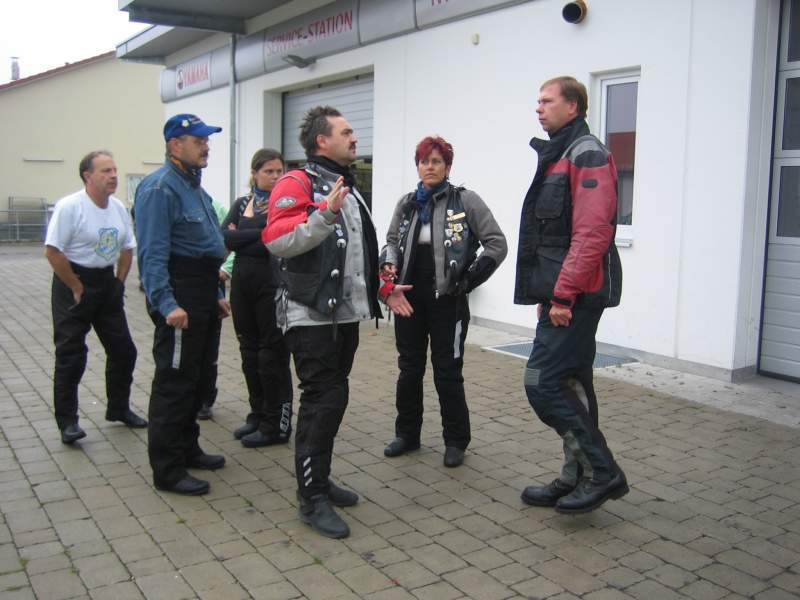
Outside of St. Michael's prior to the biker mass
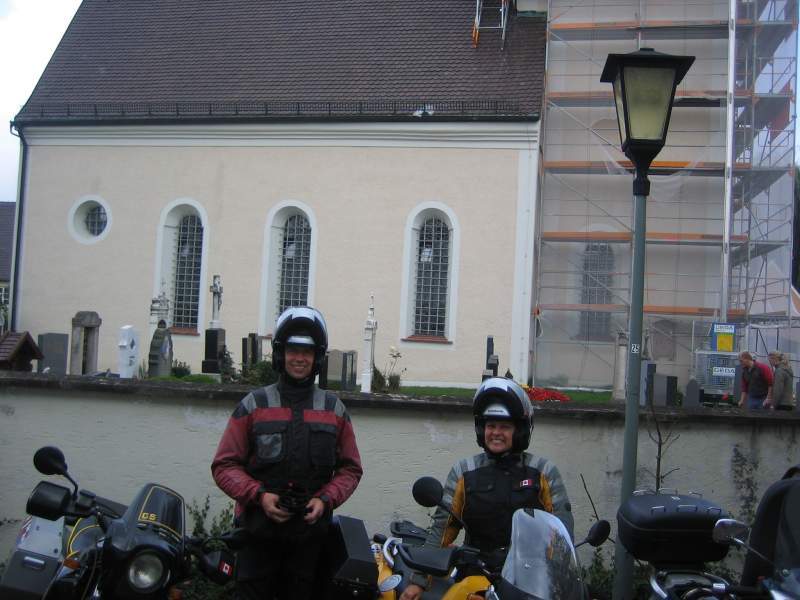
Our new guardian angel
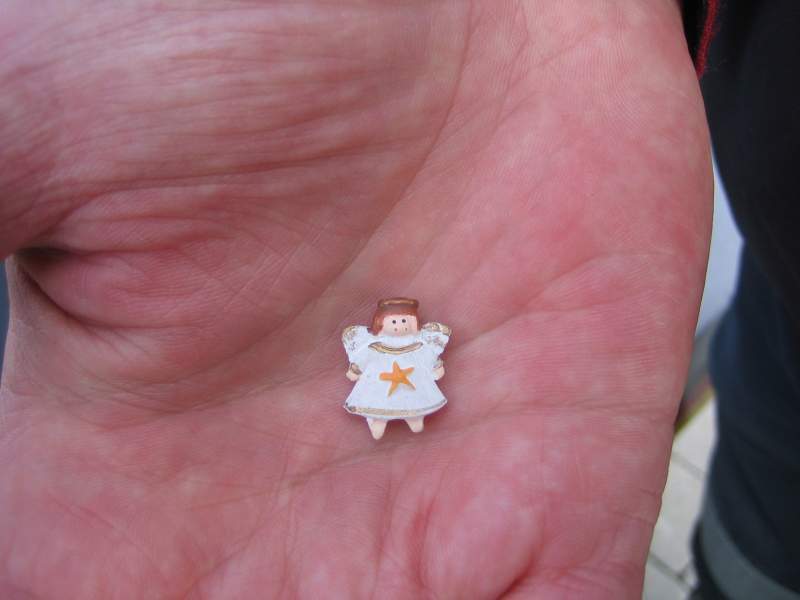
Tom talks to the president of the Jail Riders chapter
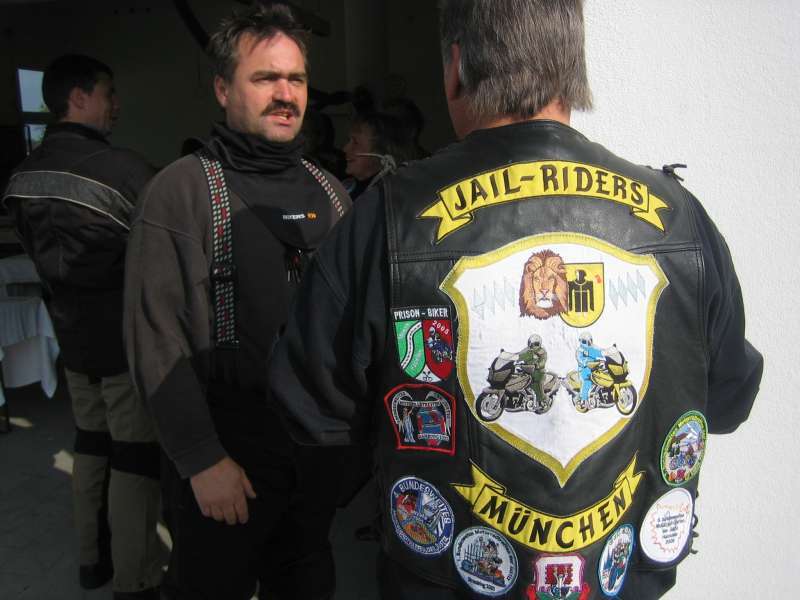
Sunday, October 21 was quite the day. First thing in the morning the MotoGP race was on television out of Malaysia. During breakfast we noticed that it was snowing outside! Definitely time to get out of here. First a few more things had to be done though. One of them was to attend the grand opening of BMW Welt (BMW World), the new automobile delivery centre. We took the S-bahn in to Munich and got out at the stop near the new building. What a crowd of people on a cold, snowy day were lined up outside. A live stage show was going on and BMW people were handing out umbrellas to everyone standing out in the rain and snow. We thought that the "BMW Welt" umbrellas would make great souvenirs but were disappointed to find out that they wanted the umbrellas back upon entering the building. Early estimates were that 100,000 people would show up for this weekend and we thought that they were all there at the same time as us. The new building is an amazing piece of architecture and it was really interesting to see how the cars would be brought up on a lift onto a display floor for delivery to the customer. Too bad BMW has cut their European Delivery Program for motorcycles. I guess we'll have to buy one of their cars. The end of the tour brought us back outside so we headed back to the train station. We took the U-Bahn to the Residence Museum (described by Audrey below) and spent the afternoon there. At 5:00 PM we had arranged to meet Tom and Andrea at a train station so that we could take them out to dinner for being so incredibly helpful and friendly over the last few months. We let them choose the restaurant so when we hopped in their car and drove a ways we didn't think too much of it. Eventually we turned into a residential area and Tom said, "I hope you don't mind that this is a very small restaurant." We pulled up outside a house and Tom rang the bell. In the back yard of the house was a little holiday cottage and when we pulled in a number of Blue Knights came out. It was a surprise going away party! The cottage belonged to Gerhard and Suzi and was built in Suzi's parent's back yard. Their daughter, Karin, was there as well as Frans and Gerhard. Judith and Pia came along but Lacky was feeling under the weather and couldn't make it. Tom had spent the afternoon cooking up his secret recipe pasta with whisky cream sauce. Wow, simply delicious. There were a couple of Formula 1 fans there so we turned on the TV and watched the season finale out of Brazil. Afterwards we watched a video of a Blue Knights motorcycle gathering and plugged in a CD with pictures from our 2002/2003 trip to Europe. What a great evening! With the snow possibly hampering our journey south, both Frans and Gerhard offered to take our bikes over the Brenner Pass on a trailer or truck. How can these people be so incredibly welcoming and generous? As they left, Judith and Pia gave us each a little guardian angel; a cute little teddy bear in a leopard suit with wings. The card on the schutzengel said, "Don't drive faster than I can fly!" When Tom and Andrea dropped us off in Schwaig we knew it would be our final goodbye and we were all a bit speechless at first. How can you thank someone for so much kindness? All we can do is hope that they come to visit us in Canada sometime. I feel that they gave us the opportunity to really appreciate Bavaria and hopefully we can do the same for them in our part of Canada.
Snow!
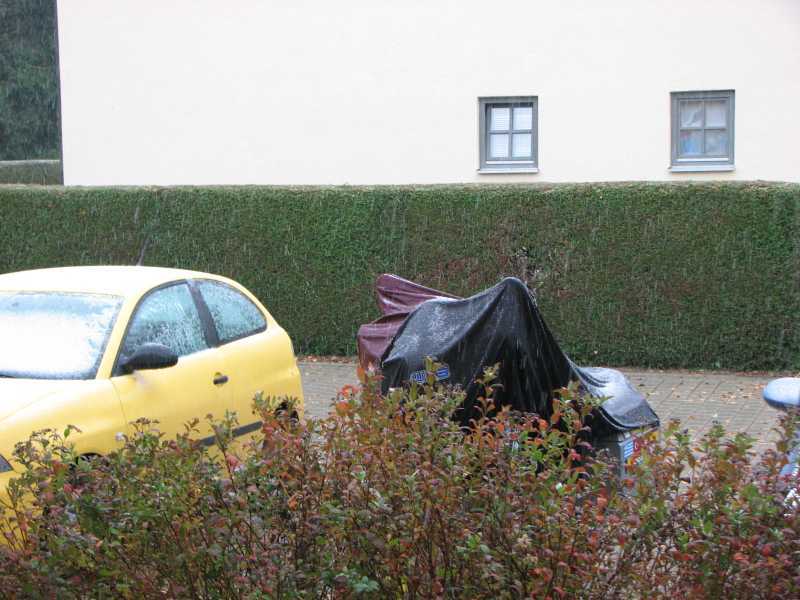
Free umbrella!
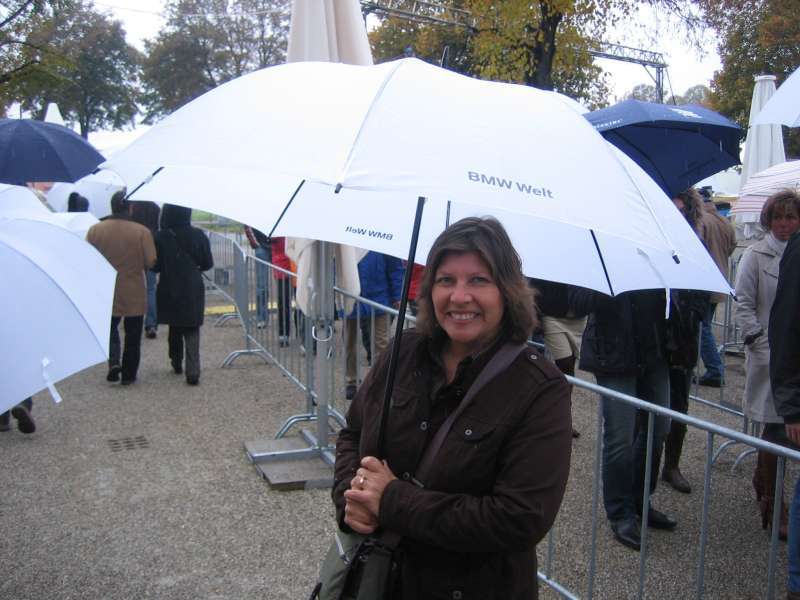
Wild architecture of BMW Welt
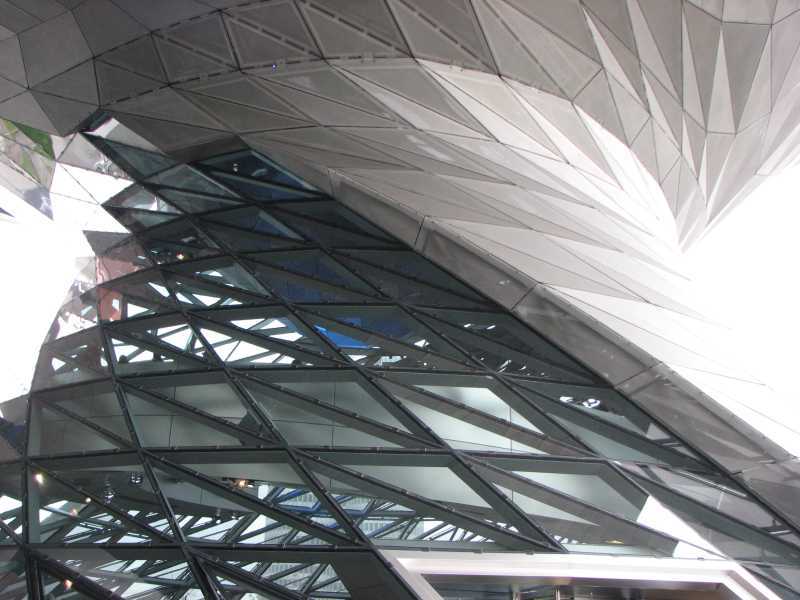
The lift for delivering your new BMW
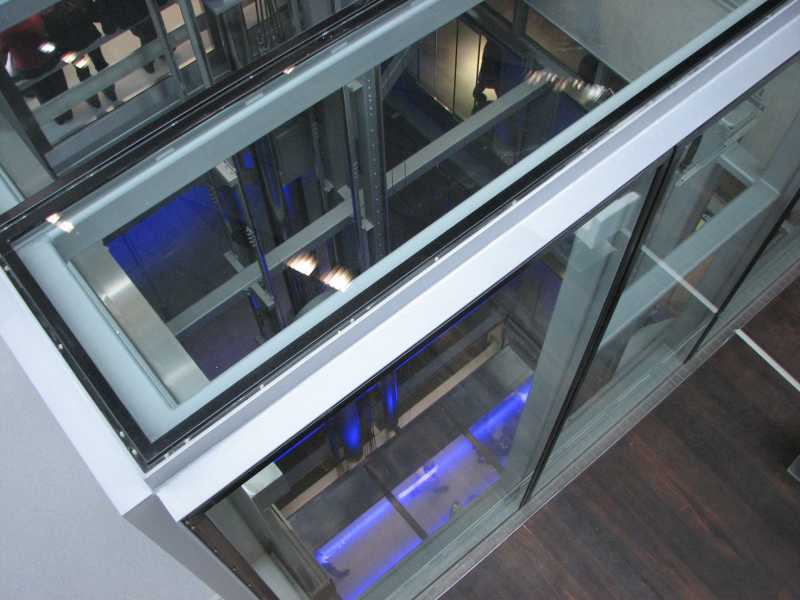
Gerhard, Gerhard and Frans at the vacation cottage
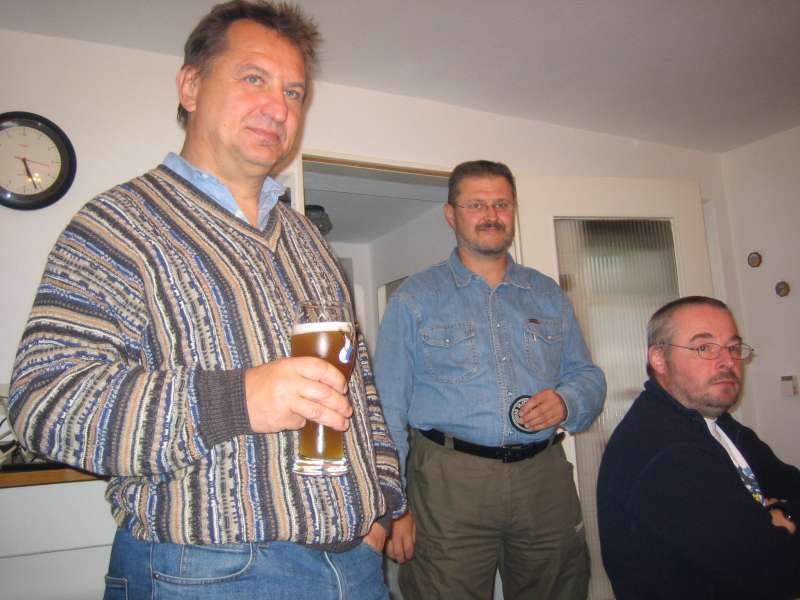
Tom and Andrea

We need all the guardian angels we can get

The final physiotherapy session on Monday had Nicole showing me some manoeuvres I could do myself while travelling. The final doctor's appointment on Wednesday gave me the go ahead to get on the road (and even climb Mt. Kilimanjaro if I was up to it!). So, with winter fast approaching we were almost ready to leave. We just needed to pack up for a world motorcycle trip and send unwanted stuff back home. Friday evening had another going away party, this time at the Alte Post in Schwaig with Helena, Melanie and Steve and Phillipa and Robert. A delicious Bavarian dinner gave us the last opportunity to speak English with these ex-pats from Britain. Next time will likely be the U.S. in July of next year.
I would be remiss if I didn't mention the hospitality and the absolutely perfect accommodation of Gästehaus Huber. We could not have stayed this long in Bavaria without having our own kitchenette to cook; it would have been far too expensive to eat out every day. Not only was the place kept spotlessly clean all the time but the whole family was always ready to help with anything. They invited us to dinner with them and even to Maximillian's birthday party. In short, if you are ever in need of accommodation near the Munich airport please look them up. www.gaestehaus-huber.com I think we have the bus 512 schedule memorised so just drop us a line if you need to know which bus to catch! A very special thanks to Helena, et al, for finding the place and for generous hospitality and company as well.
Gusendheits Park where Ekke went for physiotherapy (best cake in Erding in the cafe!)
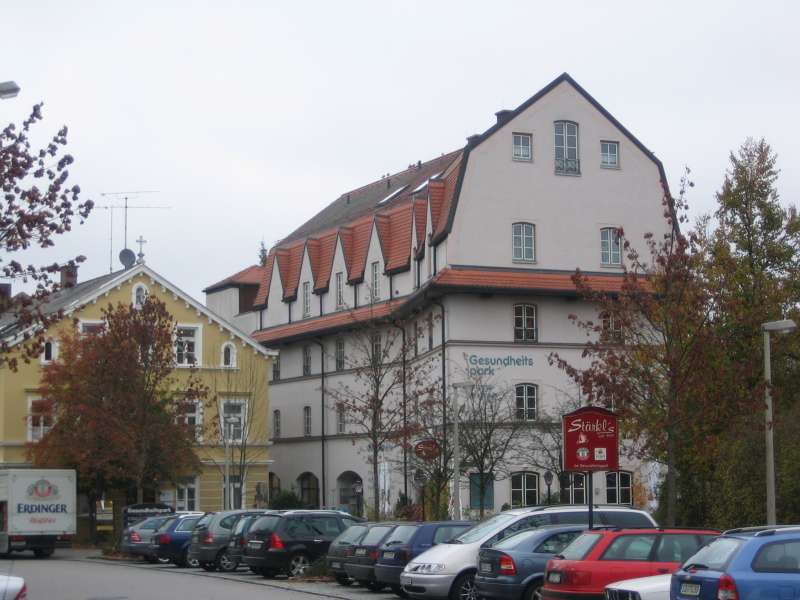
The store where Ekke bought fresh buns every morning for three and a half months
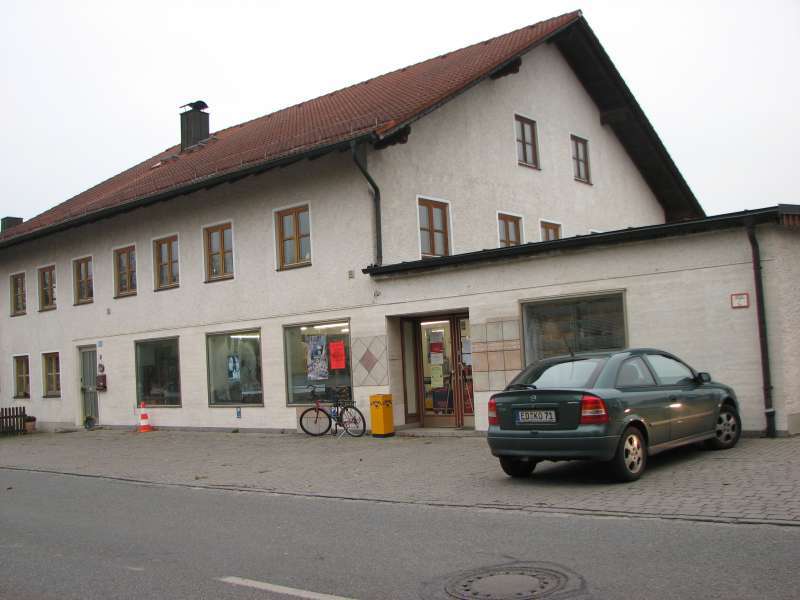
Audrey writes:
I knew we would be in Schwaig for a while so I decided to take advantage of the time to see some Munich places of interest. First visit, the Alte Pinakotek art gallery. It housed works from several countries painted between the 14th and 18th centuries including Rubens, Durer, Leonardo, Raphael and Titian. It was breathtaking to see Ruben's Last Judgment, a floor to ceiling work that had a room built especially for it. This baroque masterpiece was chock-a-block with the good, the bad, and the in-between, either being led up to heaven by chubby angels, or down the other way by scary creatures. Durer's self portrait was very striking and so realistic. He supposedly painted himself to look like Jesus Christ. It was easy to spend hours there, especially because a free audio guide, in English, brought the paintings to life.
Rubens' Last Judgement
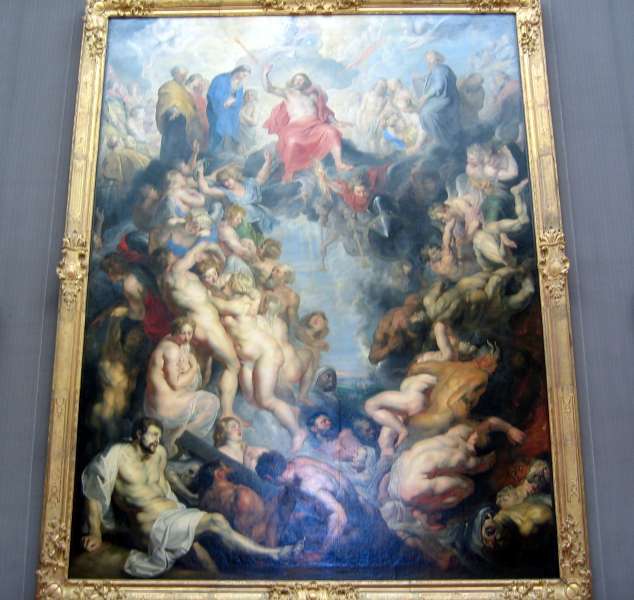
Durer, a German artist
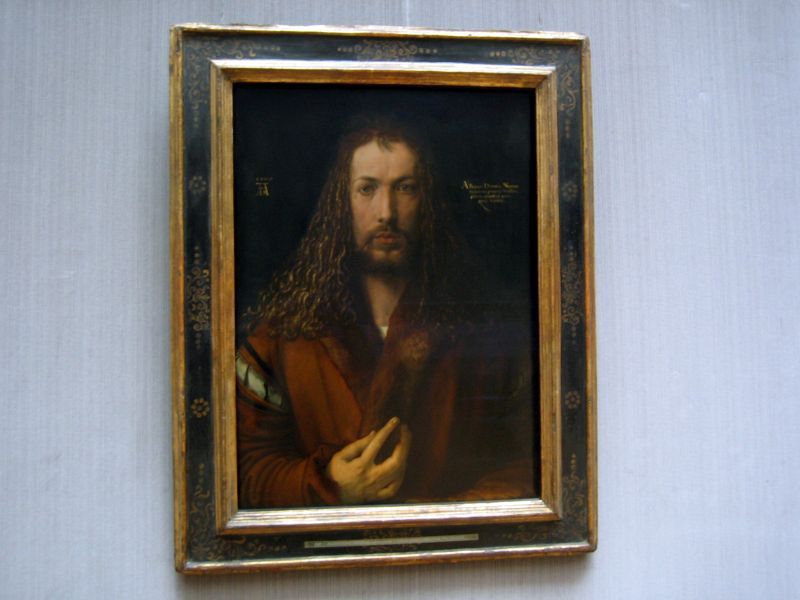
Being a real Jane Austen fan, I was keen to see the newly released movie, 'Becoming Jane', so Helena picked us up and we drove to Munich for the Sunday 10:30 am show. English showings tended to be at strange times, but I was happy to be able to see the movie. It was a beautiful day, so Ekke and I decided to go to Nymphenburg, the Bavarian summer palace. The great hall was very grand with ceiling frescoes and guilded everything. One room had about 20 portraits of beautiful women of the time, and we saw the bedroom where King Ludwig II, of Neuschwanstein fame, was born. The gardens are the real draw of the palace, and we wandered to a gazebo, stone bridges, and hunting lodge. But the huge garden area was surrounded by a stone gate or sometimes a moat, so it took us about an hour to find our way out.
Portraits of lovely women
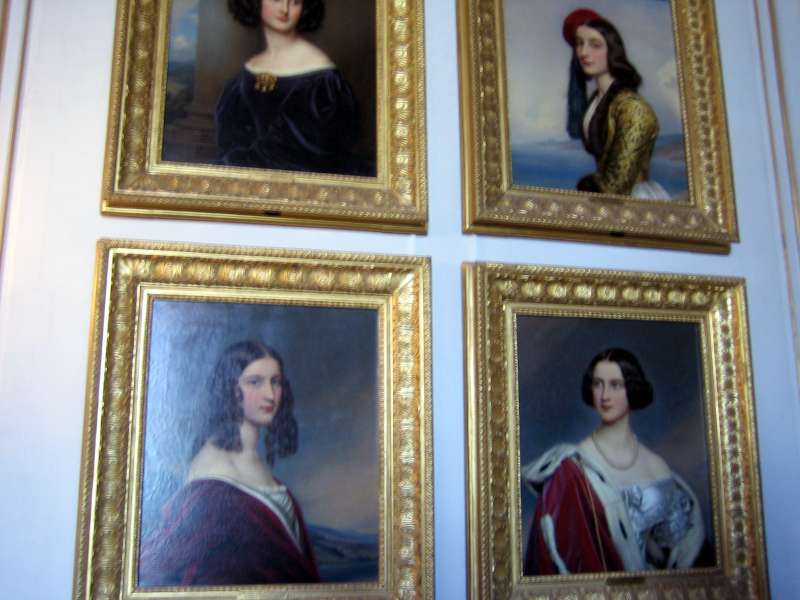
Ekke enjoys Nymphenburg
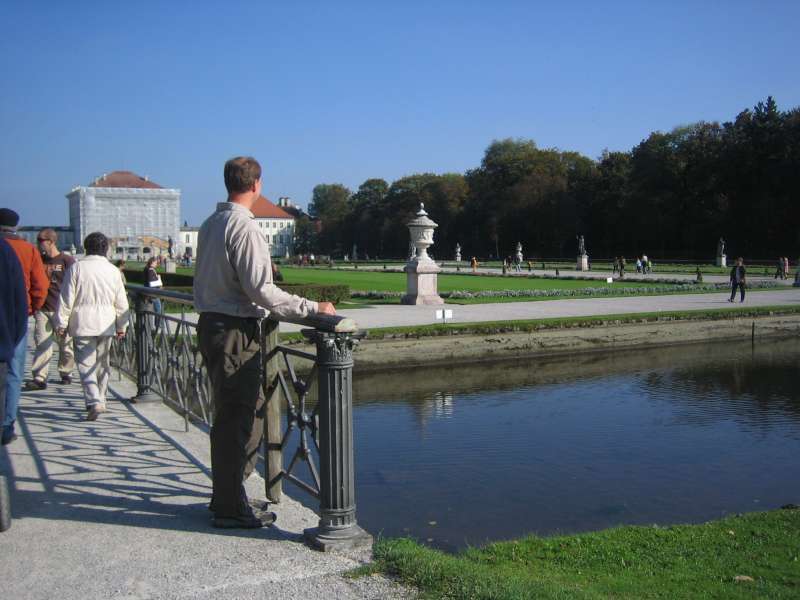
Friends of Helena's, Ule, Irmi, and Frederick, invited us to their beautiful house in Munich. We had met them in the late nineties in Vermont, where Ule worked for Bogner. After some very delicious cake and coffee, we had a great tour of the area. How marvellous it is to just wander around the neighbourhood and see a beer garden, brewery, and then a castle. I love Europe! We drove to a nearby Greek restaurant, but parking was a real challenge. So Helena just drove the car up onto the sidewalk and there we were. The food and company made for a terrific evening.
Bavaria is known for its decadent 'kuchen' (cake)
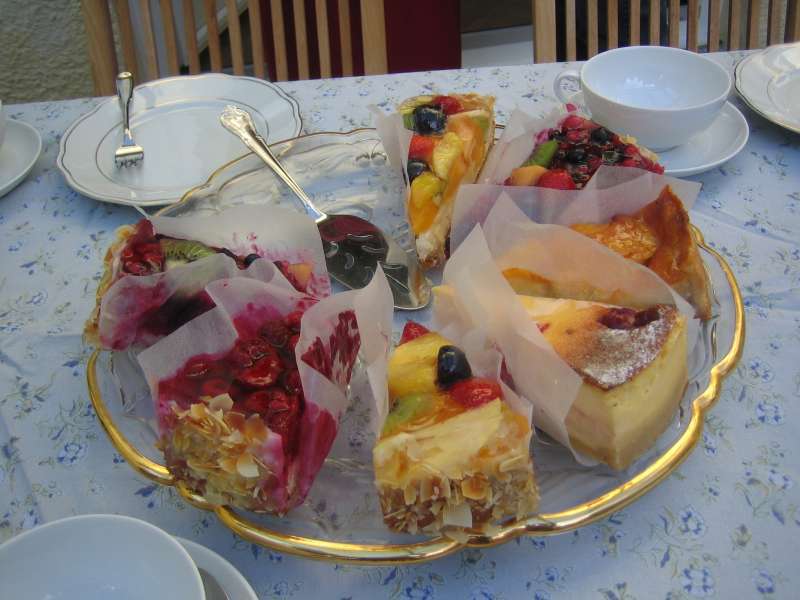
Helena and I took advantage of a very sunny, hot fall day and visited Schloss Schleissheim. The palace is about a 20 minute drive from Schwaig, and I was amazed at how huge and extravagant it was. The yellow and white main palace was built by Max Emanuel, with hopes that he would rule Bavaria some day. He never did, but still had a beautiful dwelling with extensive grounds, manicured gardens, pools and statues. The palace was an art gallery, with some works by Rubens being the highlight. We walked up to the hunting lodge where Max would entertain guests and hold balls. The money that these rulers had! The gardens still had lots of flowers even though it was late season, and locals were out in droves walking the park pathways. Of course, there's always a beer garden to be found nearby, with tasty leberkase (pork meatloaf) and semmeln (buns).
A beautiful fall day at Schloss Schleissheim
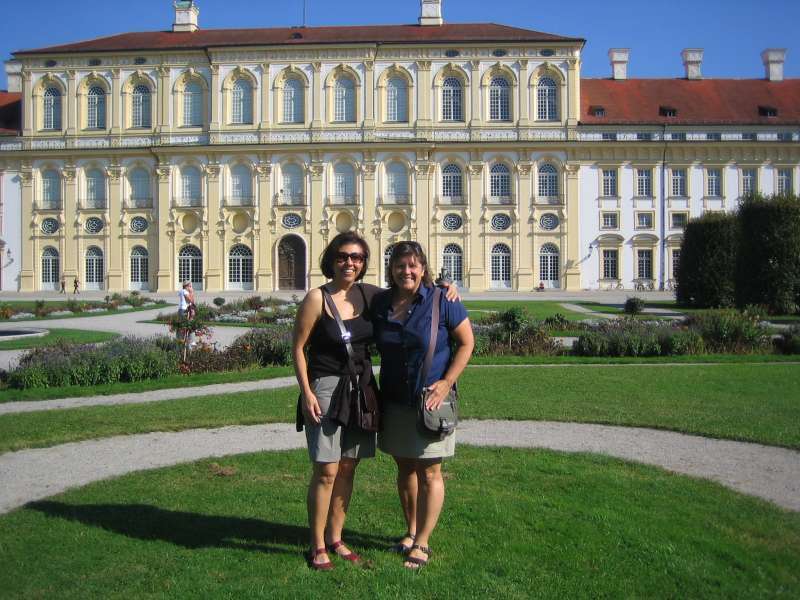
Manicured gardens
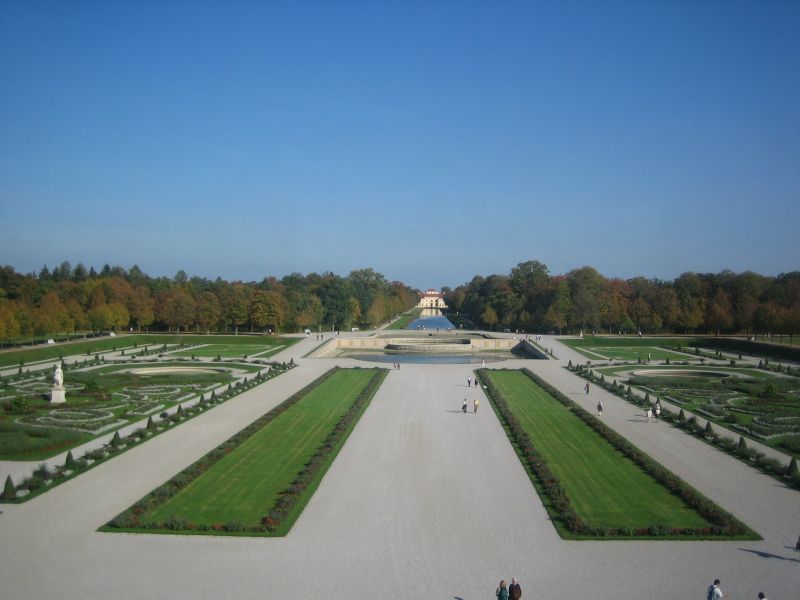
I took the S-Bahn in to Munich one day to see the Neue Pinakotek. This art gallery was a collection of King Ludwig I which included works from the 17th to 19th centuries. I had not seen so many German artists of that time period such as Schinkel and Hess, and there were some fantastic landscapes of the Alps and German countryside. The audio guide was quite well done, with music, and quotes from the artists. Highlights included some Rodin sculpture, Matisse, Monet and three Van Gogh works. This included one 'Sunflowers' painting, originally created to brighten up the guest room for his friend Gaugin, who was coming to visit. Amazing that the work is now worth millions! After a couple of hours in the gallery, I caught the tram back to Karlsplatz, located St. Michaels Cathedral, and paid two euros to see 'mad' King Ludwig II's tomb. I went down the stairs into the dimly lit tomb area and saw the fresh flowers that are still left at the site of his iron coffin. Many other coffins sat in the tomb from as far back as the seventh century, all very interesting, if slightly macabre. Later I walked up the pedestrian mall and noticed a headline on a newspaper box announcing a bank robbery. Tom, our police officer friend had told us about the incident the day before, where the robber ran into a U-Bahn station and was shot because he wouldn't stop running. He sustained non life-threatening injuries. It's great to get the inside scoop before the news hits the papers.
Van Gogh's 'Sunflowers' are always a big hit
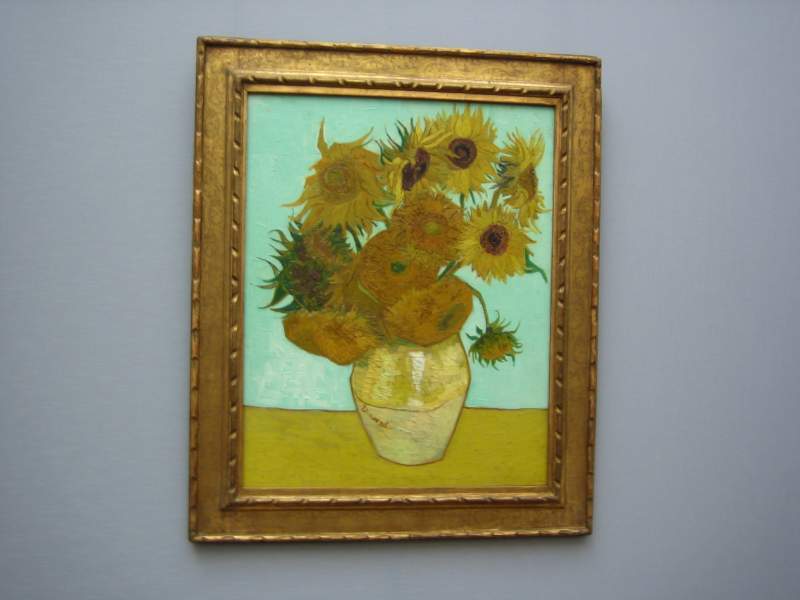
The Alps

Ludwig IIs tomb
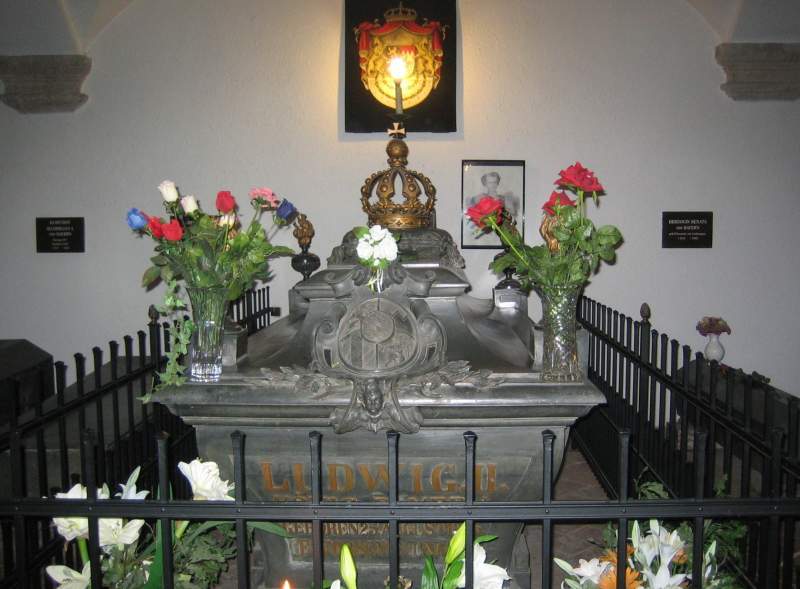
Bank robber headlines
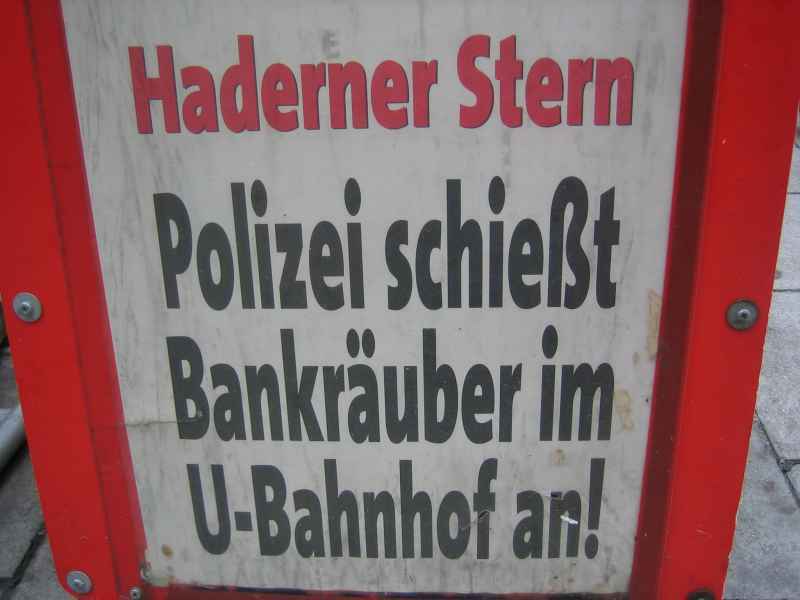
On one of our last Sundays in Bavaria, Ekke and I rode to Halbergmoos where we met up with Helena, Robert and Philippa for a fall fair. The place was located at the same farm where the Police Association had met for a barbeque, but this time there were hundreds of people enjoying the sunshine, buying squash, tasting wines, watching folkdance, and looking at handicrafts. The performer in the Western bar was singing 'The Battle of New Orleans' so Helena and I sang along. I don't know if Philippa and Robert (British) were too impressed when we sang, "We fired our guns and the British kept a'comin", so that didn't last very long. Ekke discovered a new pastry, similar to the Dutch olie bolle, with raisins and icing sugar, so he was very happy.
Helena and Philippa admiring the cabbage

On Sunday October 21, Ekke and I took the underground to the Hofgarten which included the royal palace structures, the centre of power in Bavaria for 500 years. The Residence's hundreds of rooms took a while to wander through, but it was interesting to see the apartments of great Bavarian rulers, frescoed with characters from an ancient Bavarian tale. The rooms where the king granted an audience were sufficiently grand and the ancestral hall of portraits included rulers from centuries past. The Antiquarium hall was from Renaissance times and had replicas of Roman statues.
Antiquarian Hall
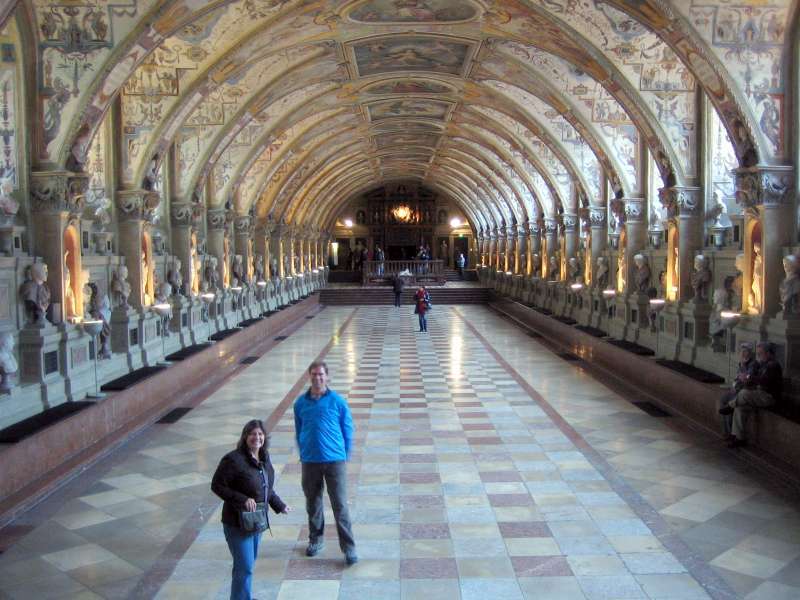
A room fit for a king
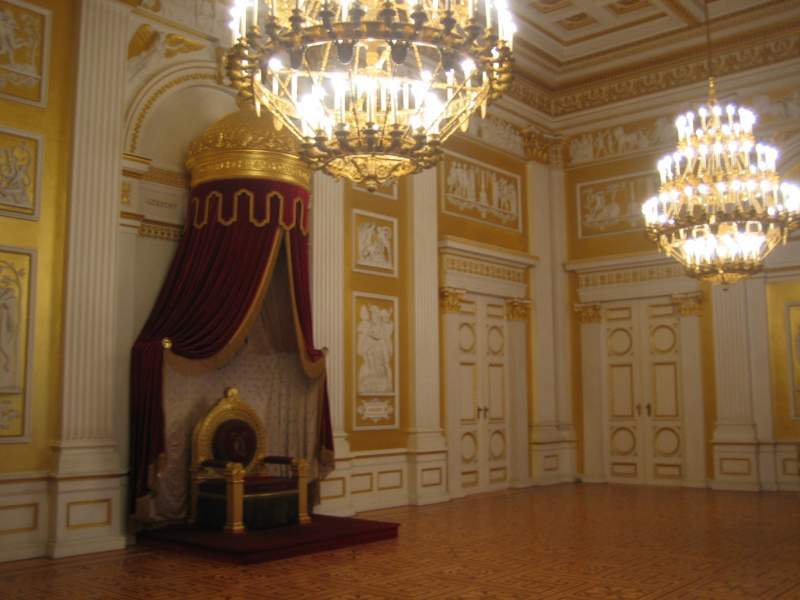
Our time in Schwaig had finally come to and end but we look back on it fondly as time well spent. We saw many parts of Bavaria that the average visitor would miss, met some fantastic people, and spent more time with my sister, Helena and nephew Andrew. We got very comfortable with our Bavarian lifestyle, fresh semmeln every day and long walks between towns, but the time for moving on was upon us.
Schwaig to Budapest
Our 'leave' day, October 27, had finally arrived and emotions ran the gamut from joyful excitement to a little trepidation. After three and a half months of the comfort and predictability of Gästehaus Huber, Ekke and I were finally beginning the 'real' adventure. But what a hectic rush to get ready on Saturday morning. It's amazing how three and a half months wasn't enough time to prepare for this moment. We gathered items like extra clothes, souvenirs and magazines that had accumulated over the past few months, packed them into boxes and took them to the post office. How much could it be to ship three boxes by boat? Ekke filled out the paperwork, and with great German efficiency the boxes were taped, weighed, stamped and sent to the back. This kind of made it too late to reconsider sending all that stuff when he found out the cost was 127 euros ($176!) for the three boxes. Nothing for it but to pay up and go.
Bundled up for a chilly departure
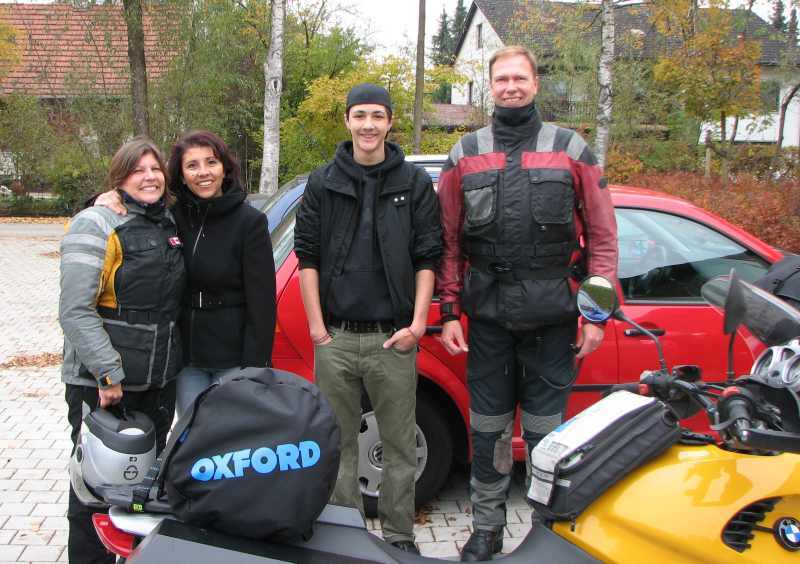
The same photographer who had taken our picture months earlier for the Münchener Merkur newspapers came by in the morning. We suited up, strapped the Oxford bags to the back, and did a 'mock' leave, so that he could get the photos of us leaving Gästehaus Huber. Helena and Andrew dropped by to see us off after they had searched everywhere in Erding for a Bayern sticker for our bikes, with no luck. The Hubers came out for the big send-off, and after some difficult goodbyes, we were off. Riding fully loaded bikes was a bit of a shock. Hadn't we just spent a bundle to send stuff home? We knew right away that we would have to pare it down even further in the near future. Riding through the German countryside is usually a pleasure, but it seemed especially slow on the small roads, in the direction of Dorfen. Eventually we hooked up with the A8 autobahn, which costs money in Austria but we had purchased a vignette for highway driving privileges at the ADAC (German CAA) office a few days earlier, so that part of the journey went quite quickly. It drizzled a bit and was cold, but our electric vests kept us so toasty that it was chilly whenever we stopped and had to unplug. When gassing up, Ekke noticed that he got some great fuel economy, 17.22 km/L due to the installation of new needle jets back in Schwaig. This was a relief because he had put a lot of time and effort into those improvements. After a leberkase semmel and hot chocolate, we endured more rain. Our first glimpse of the magnificent Danube River near Melk was quite exciting and up on the hill stood the Benedictine Monastery, which we got a really good look at while going 120 kph. It's always exciting on the autobahn in the best conditions, but the rain and cold made things a little more interesting, Every now and again we would come up behind some slow moving vehicle, forcing us into the fast lane where crazy Austrians were going hundreds of kilometres per hour in their Mercedes' and BMW's. Thankfully, we arrived in Vienna just as it was getting dark, at 5:50 pm. Just then it occurred to us that since we were travelling east, it would get darker sooner. Great! I was quite impressed with how easily Ekke found Vienna Camping West, using the GPS to point us in the right direction. What a disappointment to find that reception had closed at 2:00 pm, though. There was a sign in the window telling late arrivals to just set up their tent but we had a booked a cabin, and after I had a bit of a 'They could have told us that they closed at 2:00!!' rant, Ekke noticed a big sign on the window that said, "Mr. Kok Ekke, your camping cabin key is in cabin #5. Please register tomorrow". Ah ha! Upon opening the door to #5 the cigarette smell hit us immediately. Opening the windows was a must, and made things very chilly. But the cabin included a heater, bunkbeds, all the bedding, closets with a safe, table and chairs. What a great choice of accommodation as it looked like the rain was not going to let up anytime soon. It was fairly dark all around the campground, but Ekke spied a little light up the street which turned out to be a Chinese buffet. I thought things were going to be fairly pricey in Vienna, but our bill for the fantastic selection of foods was only 11 euros ($16).
Newspaper photo
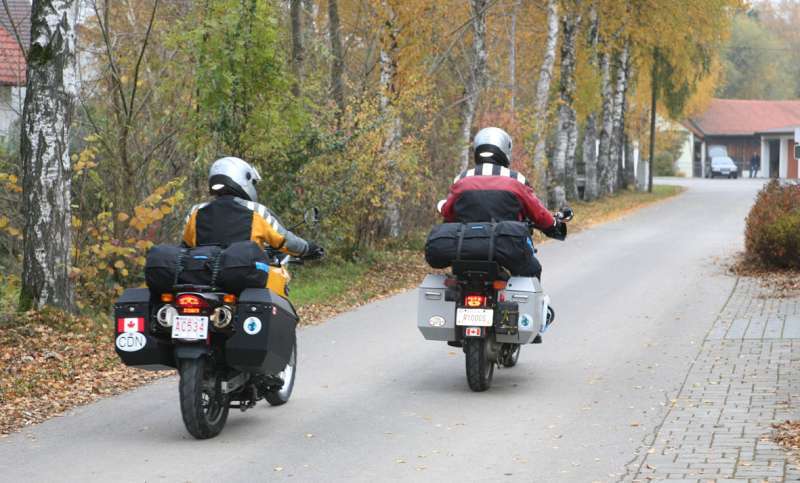
Vienna is a beautiful city with grand avenues and architecture and we were really looking forward to it. We actually woke up early, mostly due to the fall time change, which meant it would get darker earlier and cut into our travelling time even more. We tried to register but no one was there at 8:00 am, so we waited for 15 minutes. A British woman complained that she'd been waiting one hour and fifteen minutes for them. She'd obviously forgotten about the time change. The office staff soon arrived, but we just handed them a quick note so that we could catch our bus and train downtown. We had a date with the Vienna Boys Choir who were singing at the Burgkapelle during Sunday morning mass at 9:15 am. We managed to stand at the door with hundreds of other tourists, and listen to the exquisite music. A T.V. was set up so that visitors could get a look at the choir, but nothing could be seen of them from inside. After a while, we walked back into the rain and although we usually try to avoid American restaurants when travelling, Starbucks was a welcome sight. It gave us a chance to have some breakfast and check out our guidebook to plan our visit. I really wanted to see the Sissi Museum in the Hofburg, the palace complex of the Habsburg Dynasty. The palace also housed the silver and porcelain collection. We spent an unusually long amount of time looking at and listening to information on our audio guides about dishware until it dawned on us that we weren't really interested in silver and porcelain. So we found the Sissi part of the museum, which told the story of the life and death of the young Empress Elizabeth (Sissi). Much more interesting stuff! She was originally from Munich, and married the emperor at age 16. It wasn't until after her assassination that she became popular as a tragic and beloved royal, kind of like the Princess Di story. The displays included her death mask, many personal items, newspaper clippings, portraits, and clothing. But the free audio guides made it so that the hundreds of tourists would linger for quite some time in each of the rooms. Sometimes it was elbow room only, especially when a tour group pushed through. The apartments were suitably grandiose and included one of the first in-room water closets (bathrooms). Sissi also had some exercise equipment from the 1900s, including a climbing area and cross bars. No Stairmaster, though, but I'm sure she got her exercise on the many grand staircases throughout the palace. After a walk around the palace area, taking photos of the ostentatious architecture, we found Café Central where we enjoyed a light, yet surprisingly expensive meal of pumpkin soup, ham and cheese sandwich, and mushroom goulash. The classy café was where Trotzky, Freud and Beethoven used to hang out, but presumably not all at the same time. It had lots of marble, portraits of royals, and palm trees, which we were really looking forward to seeing in their natural setting some day soon.
Vienna Boys Choir
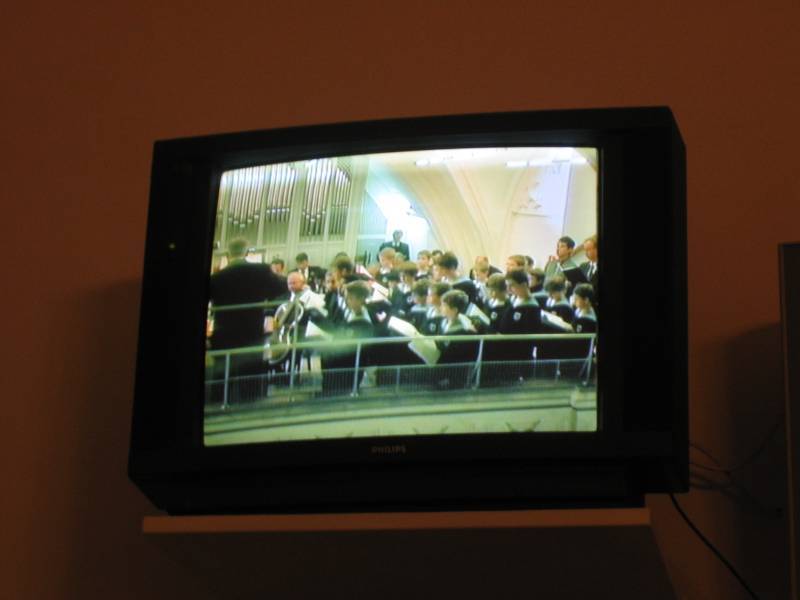
Ekke learns fun and interesting facts about dishware
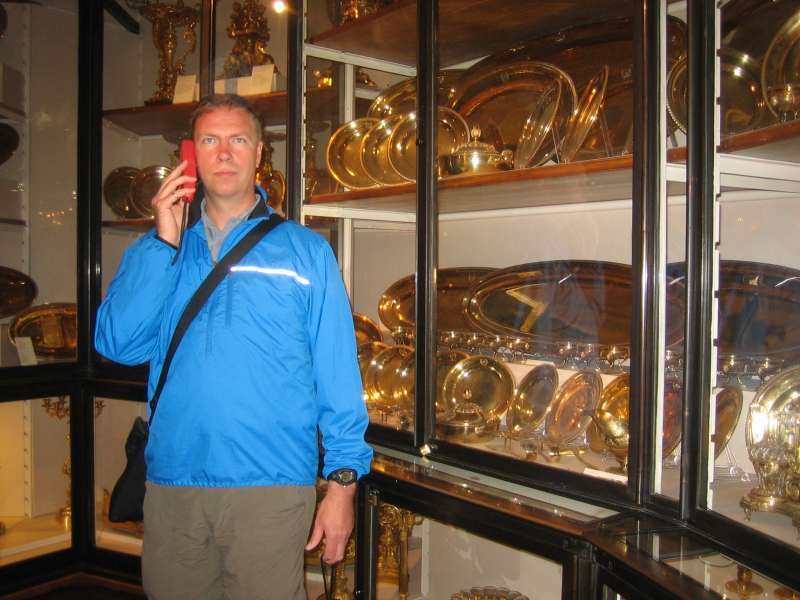
Famous Lunch Spot (That's Trotsky on the right, or is he on the left?)
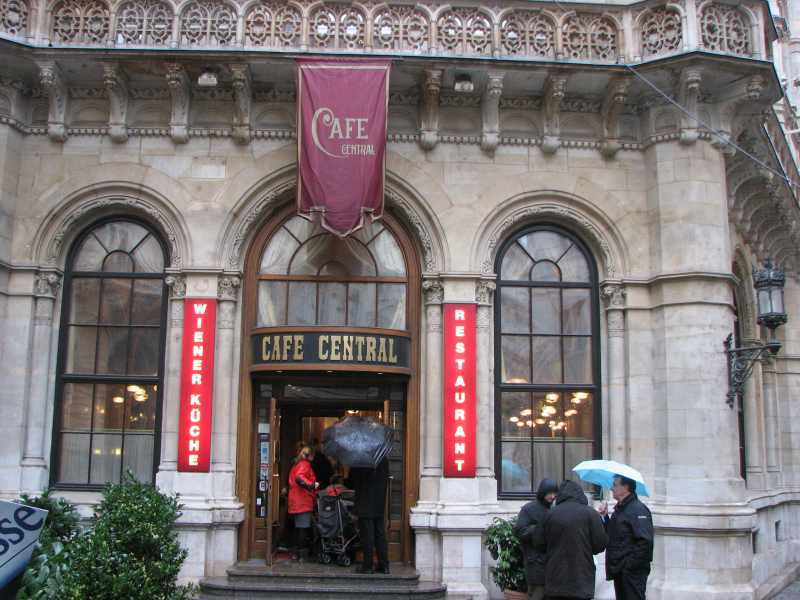
A cold, rainy walk took us to tram #2 for a ride around the centre, but it was so warm and dry in the tram that we couldn't resist going around twice. We did get out once to look at Parliament and had just enough time to snap a photo before the next warm, dry tram came along. The route passed by the Rathaus, Karlskirche and the opera house, all stunning buildings I'm sure but we wouldn't really know as we didn't want to get off the tram. No visit to Vienna is complete (according to Lonely Planet) without a trip to the Sacher Hotel for the famous Sacher Torte. We didn't want to pay a zillion euros for another coffee stop so we took some of the chocolate cake to go. Still very expensive, but I think we found the smallest cake, a mere mouthful, at a cost of five euros. On a walk up the pedestrian mall we gawked at exclusive shops and well-dressed, fashionable folk who all looked like they had just bought their clothes that morning. St. Stephenskirche loomed up before us, but we were too cold to consider doing anything but taking the train and bus back to the cabin. Quite unfortunate to miss so many fantastic sights, but the rain and cold were getting to us. We would have to visit Vienna another time in nicer weather. Our Chinese restaurant was closed so we walked a few blocks to Mamma's Pizzeria for artichoke, ham, corn and pepper pizza. The fireplace was blazing which was fine with us, and we decided then and there that we needed to head south as soon as possible.
Austrian Parliament Buildings
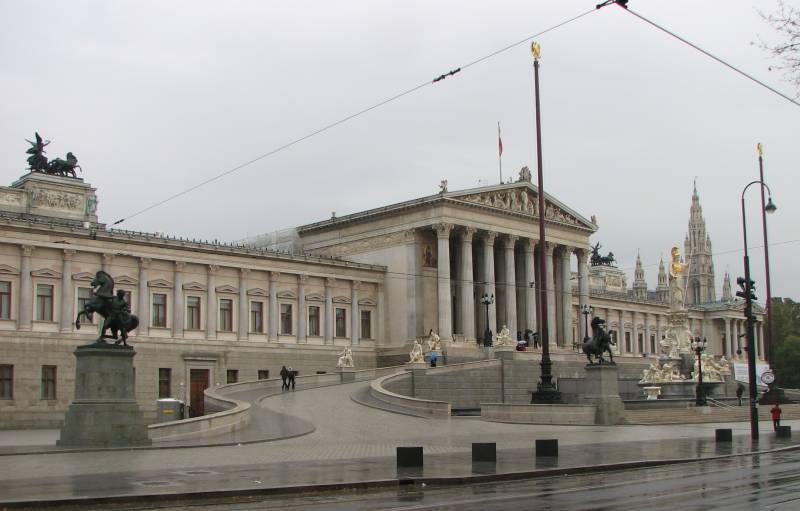
Ostentatious architecture
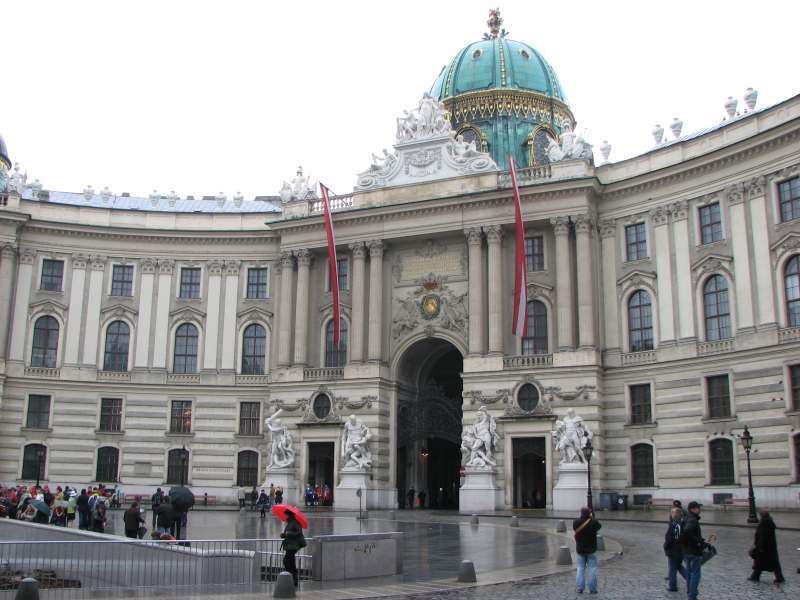
The trip from Vienna to Budapest went quite quickly as we had again decided to travel on the autobahn to save time. Of course, it's a much better experience to take the small roads, but we really wanted to get to someplace warmer. At the Hungarian border, our passports were stamped on a new page as we had forgotten to ask to have them stamped on a used one in order to save pages for Africa. When we crossed the border, it was like we had entered another world. Gone were the slick German and Austrian Beemers and Mercs. Taking their place were Trabants, Ladas and Yugos , all quite old and well used. Many were being towed, and we saw at least two being push started.
It was still early afternoon when we rode into Budapest. We crossed the Danube on Margaret Bridge and there, laid out before us, were spectacular views of the many World Heritage sights. But those would have to wait as our first priority was finding accommodation. Ekke's GPS really helped in leading us through some fairly chaotic traffic to the coordinates of Biker Camp, located just outside of downtown. But, when we got to where the GPS took us, there was no camp in sight. After riding around a bit, we eventually took out the laptop and looked up the address. I went to the corner to check the names of the streets, which was quite a feat in itself because they were all written in Cyrillic and they turned out to be the ones that we needed. Half a block up we found the camp and the owners, a friendly couple, were out raking leaves. They opened a gate which took us into the yard which had a tent area and camping facilities. There were many biker club stickers from all over Europe and it looked like a great place to meet other riders but we were the only ones there. We stayed in their pension for 20 euros ($30) per night and it had wireless which made it nice for emailing and research. The temperature in Budapest was already warmer than in Vienna or Munich, so we walked around before going to Hotel Gloria for supper. The prices seemed quite good for such a posh place. The magnificent meal was called Szapary, a platter of breaded meats, fried cheese, rice and fries. Ekke's fruit dessert with ice cream and amaretto was fairly scrumptious. This area of town was kind of strange to us as it was mostly residential, with a few businesses tucked in between and not lit very well. Even open stores were not noticeably lit from the outside. It made walking around a little scary, but at least there were other people around.
Hungarian Parliament Buildings
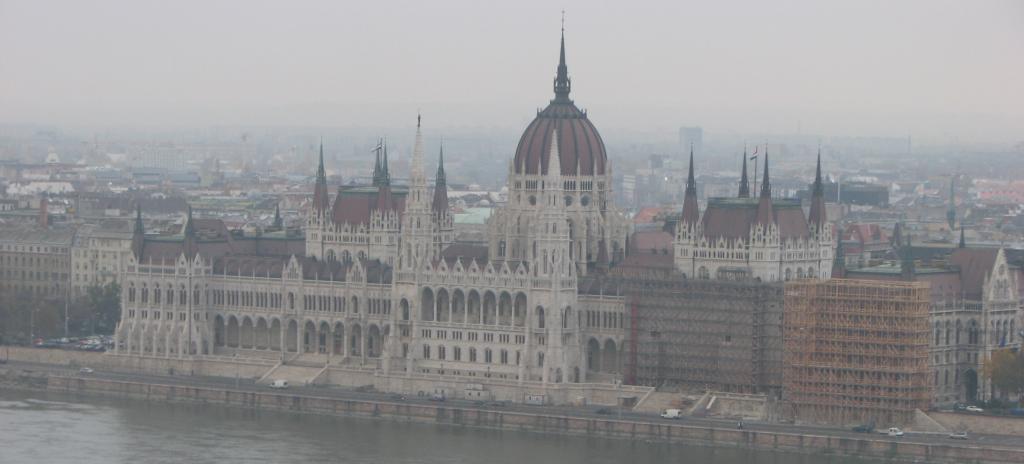
Having heard so much about Budapest from Mel and Steve in Schwaig, and having taken so much time just getting there, we decided to stay a day and visit the sights. Okay, it felt warm here, so that helped. What an absolutely full day in a very historic and lively city. Ekke and I had seen many European cities, but Budapest stood out as very unique. The views across the wide Danube River from either side were quite astonishing, and the variety of bridges really added appeal. After a pension breakfast of buns, cheese and coldcuts we walked a few blocks to the metro to downtown. Castle Hill was beckoning, so we walked across Chain Bridge and took stairs, a lot of stairs, up the hill beside the funicular train. From there we could see views of Pest and the Parliament buildings, modelled after Westminster in London, over the Danube River. After walking past quaint buildings along cobble stoned streets, we came to Fisherman's Bastion with its fairytale spires and wall walks, an arcade which had been built over an ancient fish market area. Nearby was Matthias Church with its colourful tiled roof and the award winning Hilton Hotel which incorporated ancient ruins into its design. After lunch at a small cafe we then walked to the castle area which housed many museums. Then, after a long walk to Pest, we strolled up Andrassy Street and stopped by Perte Cafe for chocolate and marzipan cakes. Okay, the real story is that we needed to use the washroom, but you can't do that unless you're a customer. The underground train in this area was 130 years old and the wood and tile stations were indicative of the time period. I believe it was the first underground train track built in Europe. Heroes Square stood at the end of Andrassy, and had statues of Hungarian heroes since the 10th century. Walking back along Andrassy, we stared in awe at huge mansions on the wide boulevard, many of them crumbling and in need of a little TLC. The street design and all its buildings are a UNESCO World Heritage Site, and it was all quite striking. We made it back to the Danube, where the trams travelled right along the river and took one to Central Market, a bustling fruit, vegetable and handicraft market in an historic building. Ekke's knee was really aching at this point, but he was a trooper as I dragged him across Elizabeth Bridge to the St. Gellert hotel and spa baths. Budapest is known for natural hot springs and has many such baths, but I'm sure they were not all as spectacular as this one. Nearby, up a hill (poor Ekke) was a giant cave housing a grotto and cave cathedral. Back over the wide Danube, we wanted to take the tram up to the other end of the city and we got out at Margaret Bridge. It looked like a short walk over to the island, so Ekke agreed to walk, yes walk, some more. It was dark by then and views of the Danube embankment, with reflections of lights from Parliament, Chain Bridge and Castle Hill were nothing short of breathtaking. After a quick look at the Gresham Hotel, done in the Art Nouveau style, we had a bite to eat, took the metro back to the pension and finally called it a day - one big loooong day, in Budapest.
Fisherman's Bastion

130 year old underground station

Heroes Square
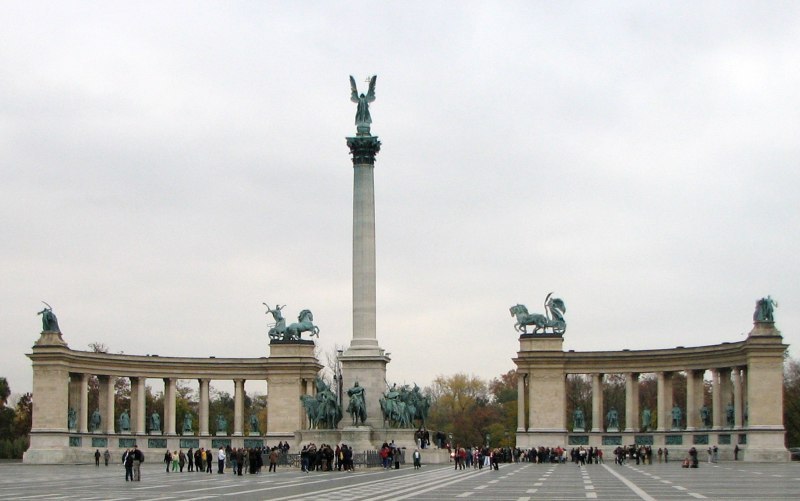
Central Market
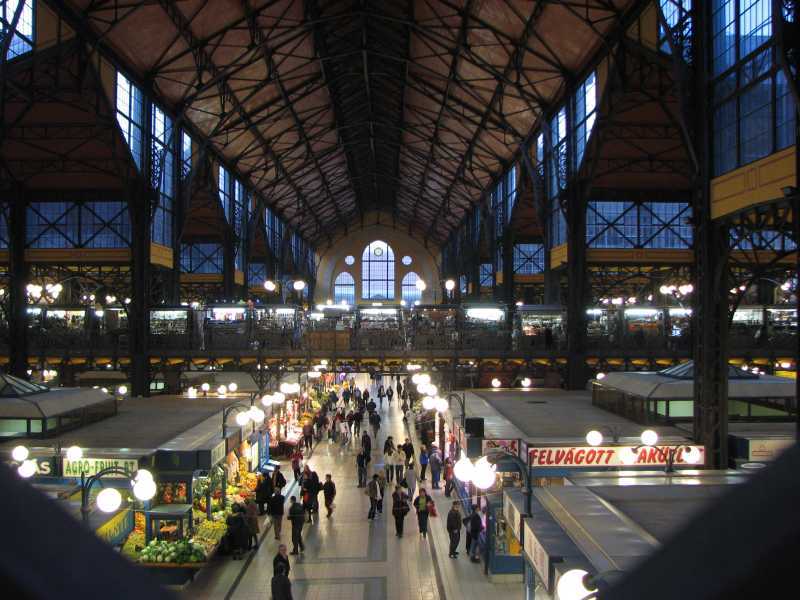
Castle Hill

Walking up the hill from the St. Gellert spa

Parliament by night
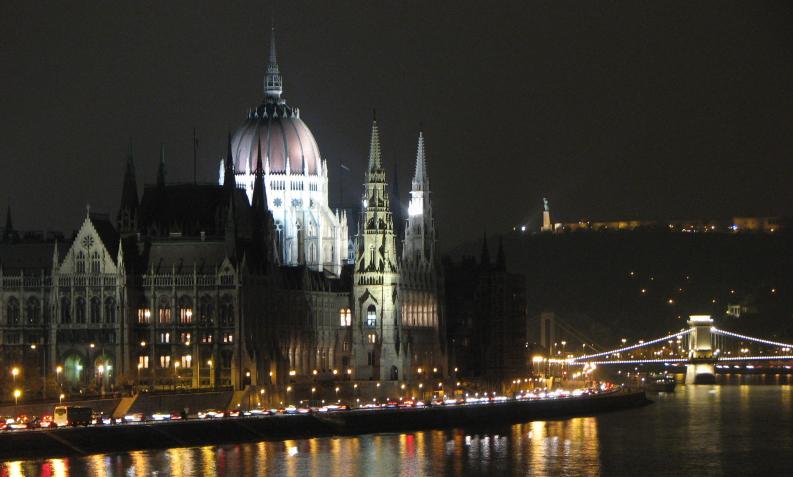
Ekke writes:
Budapest to Istanbul
October 31 we packed up at Biker Camp after a good breakfast and got going about 9:45. First, to save others the same trouble we had when we arrived; I gave our hostess the correct GPS coordinates for their location. It was fairly easy to get out of town following the A5 autobahn. We gassed up in Hungary at a Tesco (a British supermarket chain) and spent our last Hungarian change on chocolate bars, oil and a second jerry can for extra fuel. We thought it would be a good idea to keep 10,000 Forints for exchange at the border with Serbia. When I fired up my bike the charge light did not come on like it should so we pulled over to a shopping cart garage out of the rain to repair it. I pulled off the headlight cowl to fiddle with the light bulb and that fixed it. It seems kind of a crazy system to have the charging system depend on the condition of your light bulb but those are the joys of riding a motorbike that's almost twenty years old! As we approached the border with Serbia, Audrey's bike had the ABS light come on and the speedometer started to flicker. Drat, that meant she couldn't use the electric vest in this cold rain! We got the border guards to use just one page to stamp out of Hungary and in to Serbia, saving precious pages for Africa. At the currency exchange just across the border they wouldn't take the Hungarian money! The exchange clerk said, "We don't change foreign currency, just euros, Swiss francs and American dollars." And those aren't foreign? At a gas station a kilometre down the road was another currency exchange so we tried again but no luck. They did have a bank machine though so we pulled out 5,000 Serbian dinar. (Fast forward to Istanbul where we are researching exchange rates and Audrey reminds me that the Hungarian currency is called a Forint. This sounds a lot like "foreign". As we realise that that is what the exchange clerk had said we just can't stop laughing at our own misunderstanding.) We headed south on a two-lane "autobahn" where people were driving just like in Greece; on the shoulder and then passing whenever they wanted to, oncoming traffic or not. There were a few poorly signed construction areas for some extra challenges too. All of a sudden we came to a pay station. They had the nerve to charge us for driving on this?!? They took Visa but I haven't got a clue how much the charge was since the receipts were wet by the time they hit my pocket. There was something about a "tourist charge" though. With sunset happening at 4:30 it looked like we would be entering Belgrade at dark. The rain continued. When we entered Belgrade (in the dark) we hit a massive traffic jam and sat parked for an hour. In the rain. There were no signs of the Best Western hotel we had looked up on the internet or any other hotel for that matter. We rode up and out the other side of Belgrade (in the rain) and stopped at a gas station to ask if they knew of a hotel or could we do a U-turn somewhere back to Belgrade. "Don't do a U-turn" they said, 5 km down the road past the toll station is a hotel. So, back out into the rain and darkness with the faceshields fogged up we ploughed on. Unlike the previous toll plazas this one only spit out tickets rather than paying so I got my wallet wet for nothing. Five kilometres down the road there was only a gas station. No hotel. We had passed a sign advertising a hotel 33 km down the road though so we thought that we might as well press on. Into the dark rain again. With almost zero visibility (either faceshield down covered with droplets on the inside and fogged up or faceshield up and eyes pelted by rain) 70 kph was about as fast as we dared travel. We sure hoped that our new little Guardian Angels were up to the task of keeping us safe. We passed a couple more signs for the hotel, both lit up and looking for all the world like official road signs when all of a sudden a small, unlit sign at an exit for a parking area said "Motel"! I overshot it and Audrey stopped at first and then decided to join me. We rode back the wrong way on the exit ramp for the parking lot (in the darkness and rain) and then through a dark maze of unsigned roads and enormous puddles to find a hotel. Amazingly it was open. The clerk (who with his black shirt, black suit and black hair seemed like he just stepped out of the Munsters TV show) looked rather stunned to see two sopping wet motorcyclists standing in his lobby. 30 euros seemed reasonable enough and what choice did we have? Dripping wet we took stuff off the bikes and dragged it upstairs. Everything in the "waterproof" Oxford bags was wet. All of our motorcycle gear was simply sopping. It didn't take us long to make a mess of the room by hanging up and spreading out as much of our stuff as possible. When we went down for supper we found that we were the only people here. The other guy (not the desk clerk guy) gave us three choices and we both chose the grilled chicken, which was a bit greasy but tasty. At 23 euros it was certainly way too expensive but we were a captive audience. Back at the room we spread out more stuff in the hopes that it would dry. This may have been one of the most miserable and dangerous rides we have ever done. We thanked our Guardian Angels for a job well done!
A minor electrical problem is solved

What a mess of wet stuff! The main thing was that our motorcycle gear had pretty much dried overnight with the help of the space heater. At least it was not raining this morning; just grey and misting. We skipped breakfast at the hotel and headed out onto the road. Instead, we had breakfast of a cheese pastry and hot chocolate/coffee at a nice gas station/café. The autobahn ended at Nis so we had to pay the toll: 13 euros each from Belgrade! We'll have to check the Visa statement to see how much the toll-way cost from Hungary to Belgrade but maybe since it was only a two-lane road it was cheaper. At Nis we turned east into the mountains where we climbed from 100 metres elevation to 700 metres at the Bulgarian border. We had to go through four stations to enter Bulgaria but the last one was my favourite. It was for purchasing autobahn vignettes. Motorbikes are free! I liked Bulgaria already. We arrived in Sofia at sunset, which according to the GPS happened at 16:22, and drove straight to the city centre. When we saw a nice looking hotel we pulled over and Audrey walked back to check it out while I stayed with the bikes. 50 euros for a double was OK so we rode around and parked on the sidewalk in front of the Renaissance Hotel. After spreading our wet clothes out and taking a shower we walked around for a little while before coming to a small eatery a block away from the hotel. Audrey had a doner and I had some kind of beef and fries in gravy along with a giant salad. Back at the hotel we found out that we had changed times zones! We had lost an hour coming from Serbia so sunset was really at 17:22.
Beautiful Serbia, east of Nis
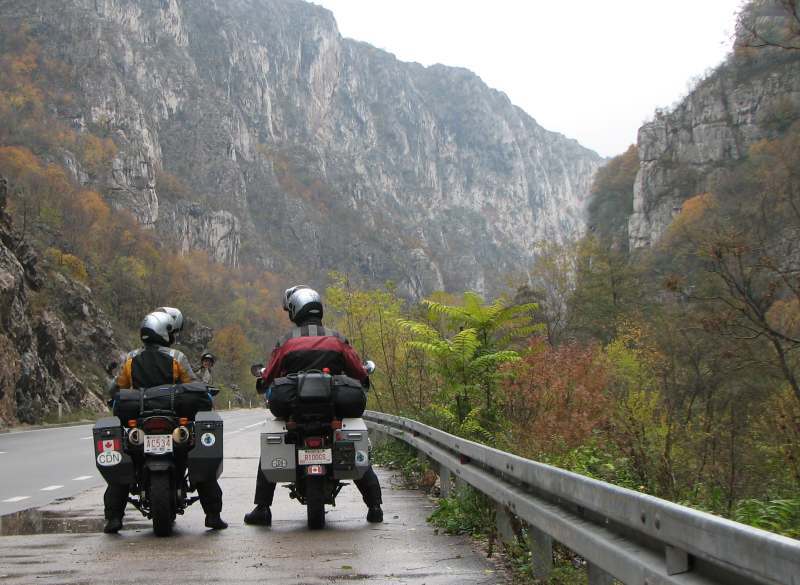
Entering Bulgaria
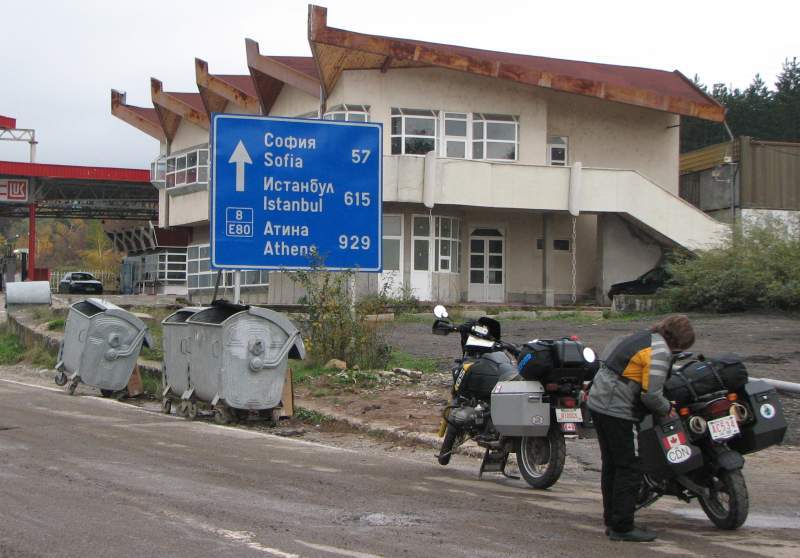
After breakfast at the hotel we walked around downtown Sofia, saw the Aleksander Nevski church at the centre of the city and followed the yellow brick road around it. Stalls were set up along the road selling mostly old junk purported to be Soviet Era souvenirs. The St. Nikolai Russian church with its gold domes was spectacular. A neat "Milka" building was great but the Flirty Vodka posters are the best! I think I'll take up drinking vodka. Checked out of the hotel at about Noon and then rode out of town. Sort of. Got a little turned around (hey, the signs are in Cyrillic!) but at least we got a picture of Audrey in her yellow jacket on her yellow motorbike on the yellow brick road. Thinking that the airport would be out of town we followed signs there but that wasn't any help as the airport was in the city. We eventually found the autobahn heading toward Istanbul but it took a while. Got into Plovdiv at about 2:30 and spent an hour trying to find the hotel mentioned in Lonely Planet. What a job! But find it we did, right off a traffic circle near the train station. Hotel Trakia (well it looks a little different in the Cyrillic alphabet) was tucked in a bit. We got the bikes up onto the sidewalk then into the courtyard of the restaurant for the hotel. After unpacking we went for a walk to find the centre of the old town. Since I had broken a shoe lace on my motorcycle boots this morning I took the good lace along to see if we could find something to fit. We seem to have landed in the shoe store centre of the universe. Every second shop was a shoe store and only steps from our hotel. There must have been 100 shoe stores. Not a single one sold laces. Just shoes. Crazy. Found a big square and then walked down the pedestrian mall. Shoe stores aplenty! No luck. Lots of fashion stores though. We found a window selling pizzas by the slice (1.40 Bulgarian Leva or about 70 euro cents). Too bad it was lukewarm-cold. Sitting there we started looking at people's footwear. Sure enough, every pair of shoes was a fashion statement. Perhaps Bulgarians or Plovdovians just get a new pair of shoes when they break a lace? We never did find the Old Town.
I feel like having a chocolate bar...

Bikes parked outside the Renaissance Hotel in Sofia
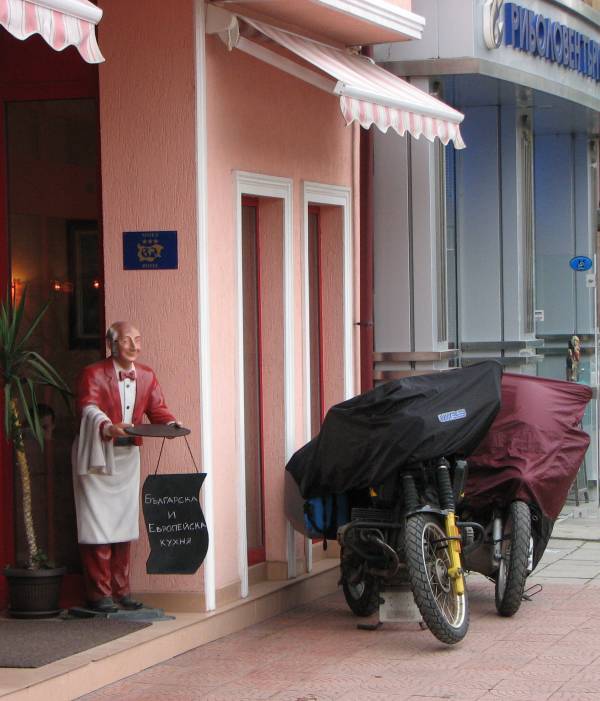
The yellow brick road to Aleksander Nevski church (yellow bricks don't show up so well in the photo)
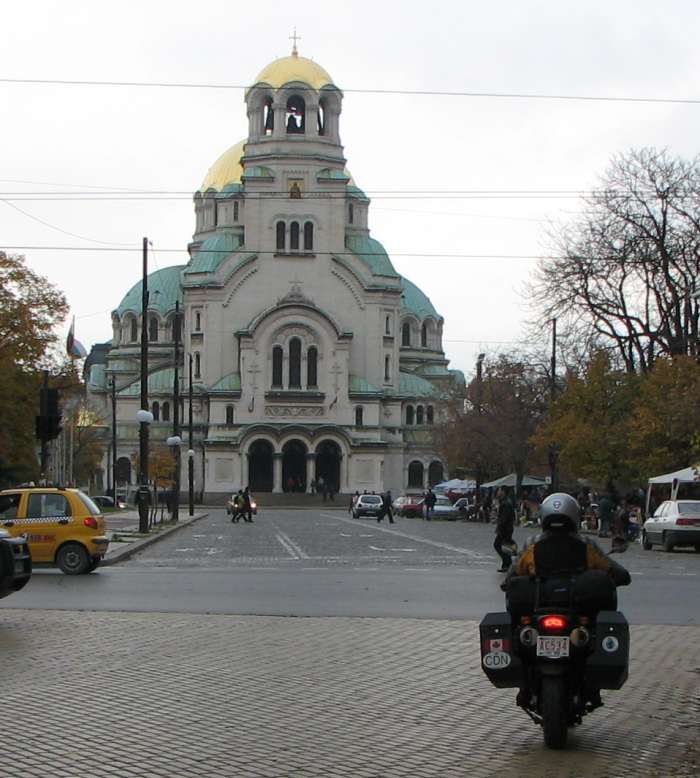
After Audrey tried to find Old Town Plovdiv in the morning (unsuccessful again) we got on the road at about 9:30. Not too much difficulty finding our way out (compared to coming in!) but a sign along the highway pointing to Istanbul led us down a minor road for a few kilometres before we decided to turn around back to the autobahn. After riding for a while and then fuelling the bikes, we passed another sign to Istanbul (on the divider at an exit ramp) pointing off the autobahn. A few kilometres later we passed a town on our right that, according to the map, should have been on our left. OK, that really was the Istanbul turn off! A U-turn? No possibility for 50 kilometres! Not even a break in the centre median of the brand new highway (the best in Bulgaria) to sneak a motorcycle through. Finally turned right on Highway 5 and rode 40 or 50 km south back to the main road. That detour did nothing for our travel time but we did get to see a bit more of the Bulgarian countryside and people. At one point we rode through a small village and in the square in front of the church a group of people were greasing up a pig. That looked interesting.
Gas station before the wrong turn (They were playing a Randy Bachman tune!)
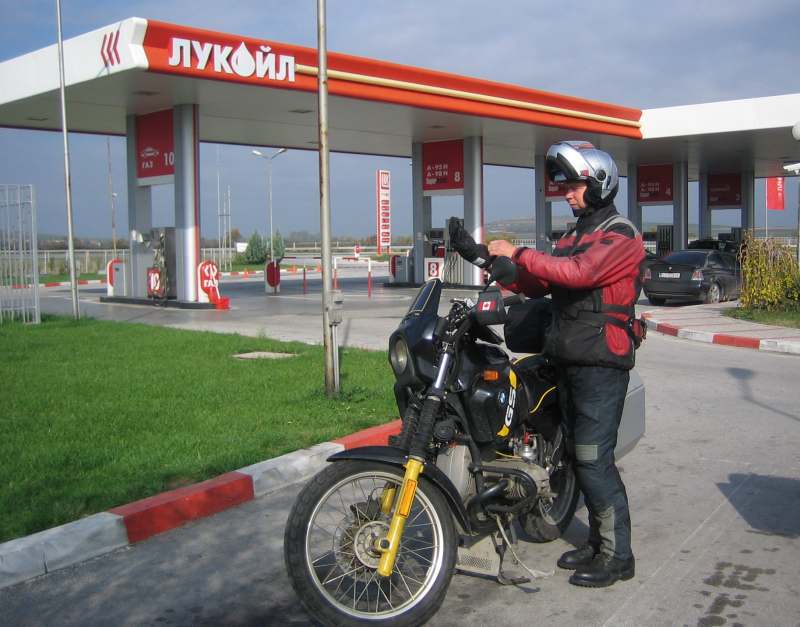
At a Bulgarian customs booth a fellow came over to chat with us. He was a motorcycle traveller and had done a number of interesting trips from his home in Bulgaria. He had met another Canadian couple on a trip in Turkey last year but he couldn't remember their names. We said, "Is it Mike and Ruby?" whereupon he replied that it was! This is the same Mike and Ruby we know from Calgary and who visited us in Schwaig a couple of months ago. This world is just way too small. The border at Turkey took about 1.5 hours with lots of stamps in the passport, buying really expensive visas and inexpensive insurance. We had lunch at the gas station/café before getting back on the road. We should have gassed up too… But we didn't think of it. Gas stations aren't a dime a dozen on the Turkish toll highways. Finally a gas station showed up when we had about 250 km on the odometer so I thought we'll make it to the next one which according to the pattern should be 50 or 60 kilometres further. The next one was a bit late (328 km on the odo and Audrey had been on reserve for about 20 kilometres already) but despite the sign on the highway it was only a café, no gas! So we took the next available exit, paying 3.75 lira for the toll highway; way cheaper than in Serbia. A gas station was located just 600 metres down the road and the gas station attendant said there was a hotel 5 km further in the direction of Çorlu. 15 km later we entered a small town (in the dark with a light rain falling) but it looked like a real dive. Pulled over to the side of the road in the dark I saw a donkey cart coming from the other direction so I shouted back to Audrey to watch out for donkey carts as they didn't have headlights. Then just as we pulled out the cart veered right in front of Audrey and she had to swerve around it (expletive deleted). I guess she didn't hear me because she had her earplugs in. Further up we stopped some people and asked for a hotel and were directed to the Bormali Otel. 80 lira wasn't too bad and it was nice, including Wi-Fi and parking for the bikes right out front. The walk for supper revealed a lively, happening town! Quite the opposite of what we were expecting. At a small shoe store we asked for laces and the proprietor held up a whole bag of them! After we found what looked to be the right length we asked how much and he responded with 75 cents. When we handed over a 10 lira note he shook his head but we didn't have anything smaller and he ended up giving them to us for free. Dinner was only 17 Lira and served by the most attentive waiter ever, certainly deserving of the 3 lira tip. It's good to be back in Turkey. The people here are so friendly.
Donkey carts in Çorlu
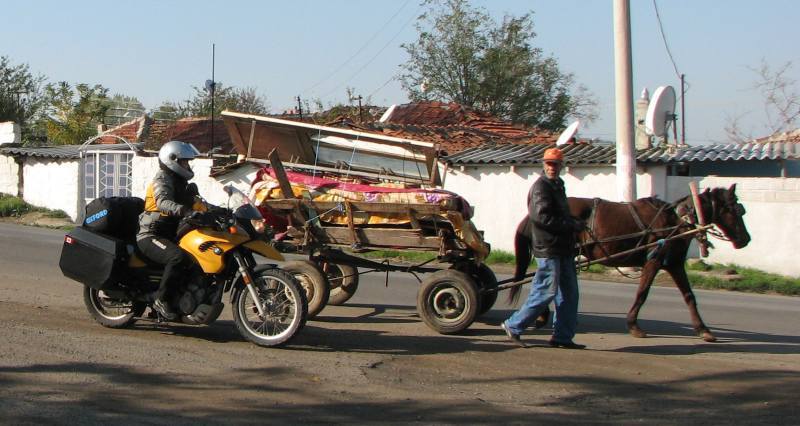
Breakfast at the hotel consisted of a typical Turkish breakfast: bread and a selection of cheeses with olives, cucumber and tomatoes. Fortunately a bit of jam and honey was provided too. OK, maybe I don't like everything about Turkey! We got on the road to Istanbul by about 9:30 after taking a picture of Audrey riding alongside a donkey cart. We decided to take the free road along the coast rather than the inland, toll autobahn because we thought the traffic would be OK on a Sunday morning. It was worth it just to see the Sea of Marmara glinting in the sun and feel the temperature going up to 20 degrees. Closer to Istanbul the drivers got more aggressive, one even managed to slalom between us and considering that Audrey was pretty much tailgating me that was really amazing and a bit unnerving. The best thing to do seems to be to pretend you are a pylon and hope that they're good drivers. We turned off the highway and in the direction of the sea about 4 km out from the centre of Istanbul. Looks really familiar! This is the way we came in last time, five years ago, from Ankara. After taking a picture by the sea we rode towards Sultanahmet. When we turned left off Kennedy Cadassy there was the Mavi Onur Hotel that Audrey wanted to stay at. How's that for navigating? OK, pure dumb luck. 50 Lira wasn't a bad price but the room wasn't ready yet. We walked around the block to the Hotel Albatros where we had stayed last time, in 2002. It was 49 euros per night, almost twice as much as the Mavi Onur, so we gave it a miss. Checked another place (40 euros) and then went back to look at the room at the Mavi. It seemed clean enough so we took it. Lunch across the street at the Ottoman Kitchen was tasty (and recommended by the Korean tourist coming out and talking to Audrey).
Yummy breakfast!
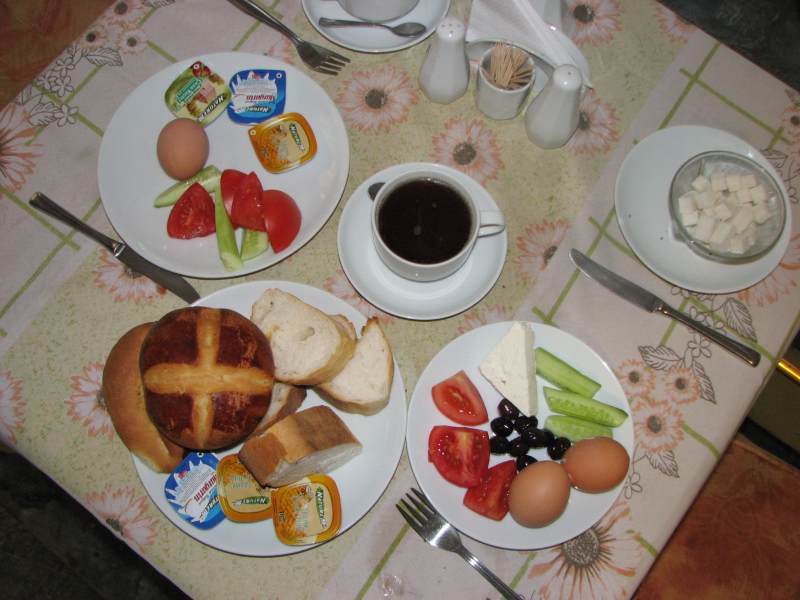
Sun glinting off the Sea of Marmara

Istanbul police use the BMW R1200GS for riding two-up

November 5 we visited places in Istanbul we had not had an opportunity to visit last time. We started with Aya Sofia, which has been used as a church and a mosque but is now open to tourists. It is amazing to be inside a 1,700 year old building. When the building was converted to a mosque the Christian mosaics had been plastered and painted over. Now restoration work was in progress to reveal some of them. We also didn't get a chance to see the Basilica Cistern last time so we took the time to visit this engineering marvel built in 532 AD. There are over three hundred columns decorated in Doric, Ionic and Corinthian styles. There are also two columns which on the bottom had heads of Medusa carved in, apparently to ward off evil. That evening we did the true tourist thing and took in a dance show highlighting various dances of Turkey. Audrey liked the Whirling Dervish the best but my favourite had a man's face painted on one dancer's belly and a woman's face painted on another dancer's belly. They then did a rather comical love dance. Maybe you had to be there…
Aya Sofia Christian fresco
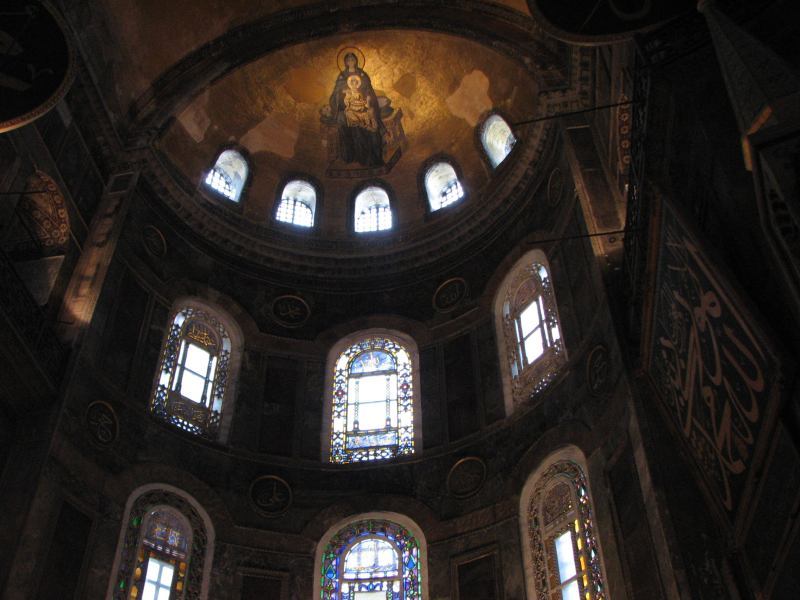
Christian fresco uncovered from the plaster and paint

The Sultan's guards stand ready

Basilica Cistern
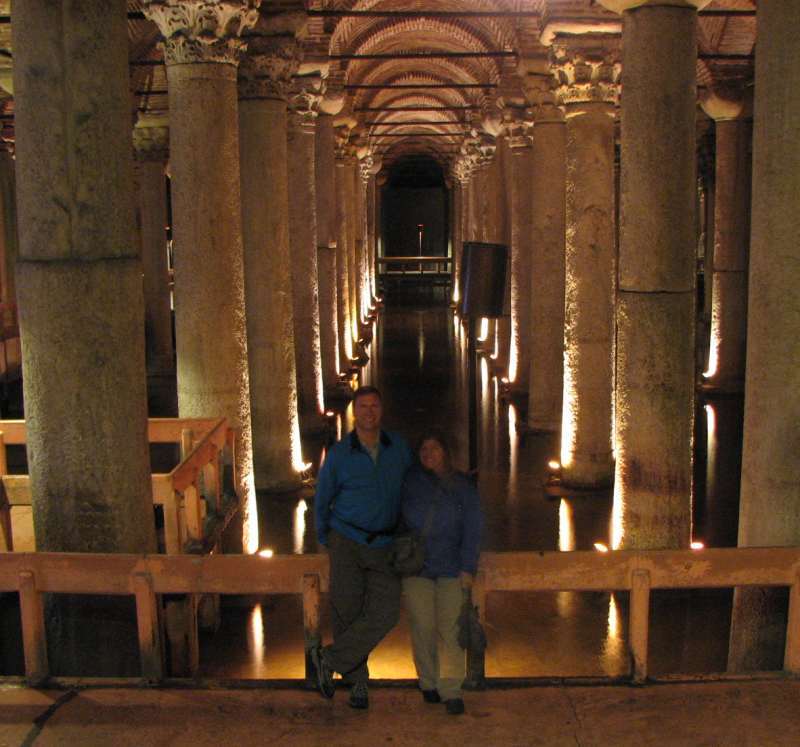
Head of Medusa wards off evil

Audrey at the Blue Mosque
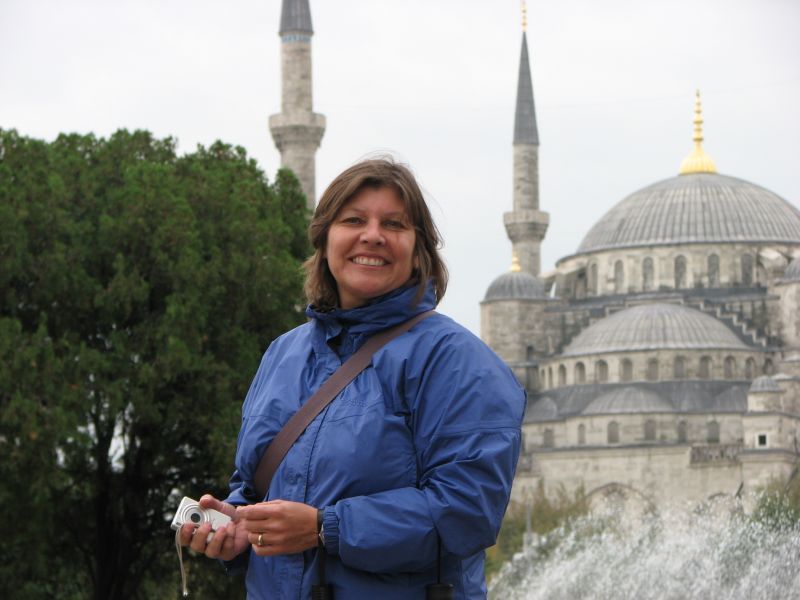
Whirling Dervish dance performance
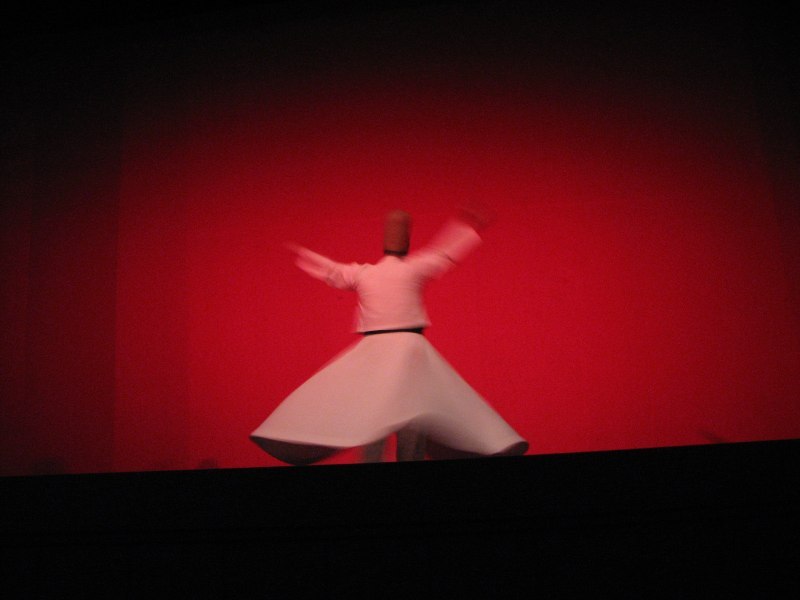
Turkish belly dancing

Real Turkish belly dancing!
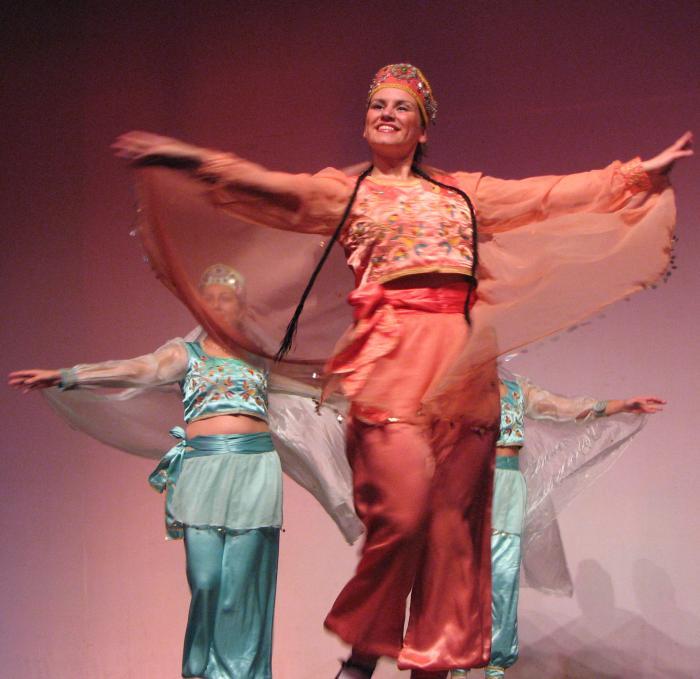
With Audrey's bike still misbehaving I contacted the Horizons Unlimited community to see if they could help. True to Turkish kindness and generosity David Maden took the afternoon off work and came by at 13:30 in his CRV to guide us to the BMW dealer. There he helped to explain to the service advisor what the problem with the ABS and speedometer was. They took the bike in and examined it right away. It took a couple of hours but the BMW dealership is gorgeous and has the Boxer Café so we sat and talked with David for a while. He is a part owner of a number of Domino's Pizza restaurants so he recommended one near our hotel. Eventually the diagnosis came in: no problem! There were no fault codes on the computer so the only thing could be that the sensor was wet and dirty and now that it was dry and reasonably clean it was working OK. I guess we'll try to keep that sensor clean and dry from now on by not riding in the rain on dirty roads. They had ordered Metzeler Tourance tires for another customer but gave them to us and ordered another set for the other customer. We left the F650 there to get them mounted and rode home two-up on my bike.
David Maden helps out
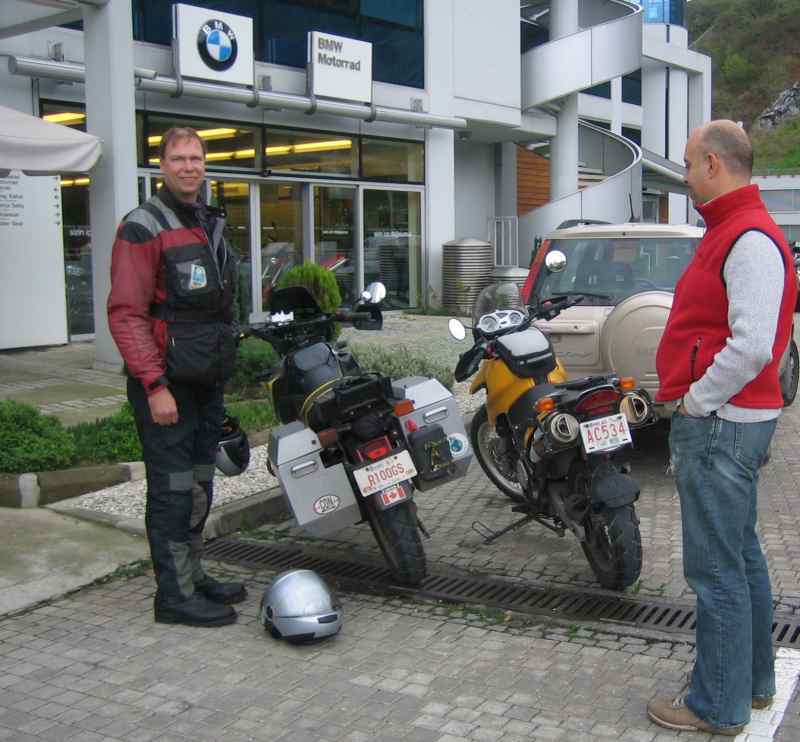
Riding home two-up
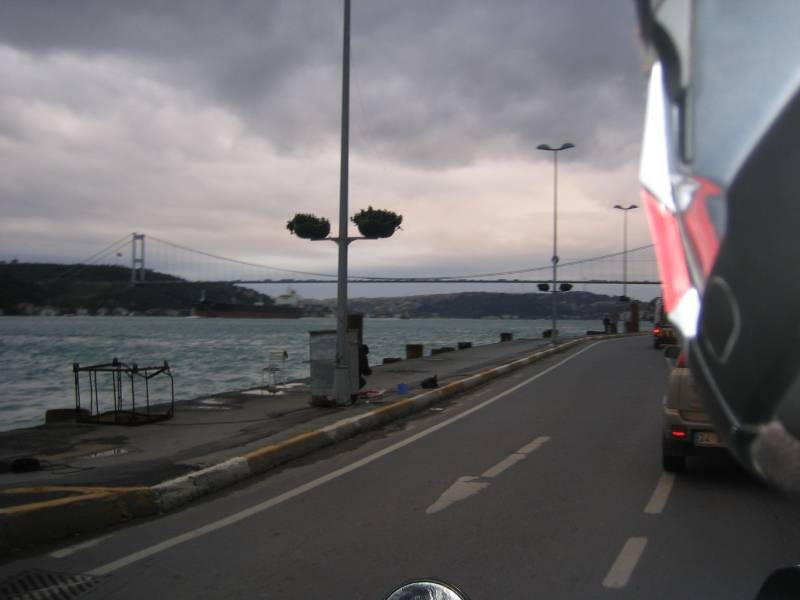
The next morning we went to our favourite restaurant in the mall where the dance show was held (never crowded, great food, local people, good prices and free wireless internet) and wrote for the website in the morning. After lunch we doubled up on my bike to the BMW dealer. The F650 was ready but it still took an hour and a cup of tea before things were settled with the paperwork. They had tried to contact us because the brake pads were worn and they wanted to know if they should replace them. They couldn't get a hold of us so they just replaced them anyway. Good idea! While we were there we picked up a spare clutch cable each since for some reason I had forgotten to buy some back home.
Audrey on the Pocket PC and fold-up keyboard, Ekke on the laptop

For our last day in Istanbul we did some general maintenance on the bikes and worked on Chapter 4 of the website. After lunch we headed to the Grand Bazaar for a little shopping. Carrying souvenirs on the bike can be tricky but a small painting can usually be accommodated. We found some nice foil on old book paper pictures and entered the negotiation process. While it was all very interesting with the shopkeeper trying to sell us more than we wanted and us trying to pay less than our "budget" it was also very wearying. Maybe if you had to haggle every day it would get easier but right now we weren't used to it. That evening we used the computer at the Mavi hotel to upload Chapter 4 of the website and prepared to depart for Ankara in the morning. While we hadn't spread our stuff out as much as in Schwaig it was nevertheless amazing how much we were carrying on our bikes. Maybe we should consider sending even more things home to get the bikes as light as possible for the difficult roads ahead in Africa.
A view of the bikes from Mavi Onur Hotel terrace

Route maps
Schwaig to Budapest
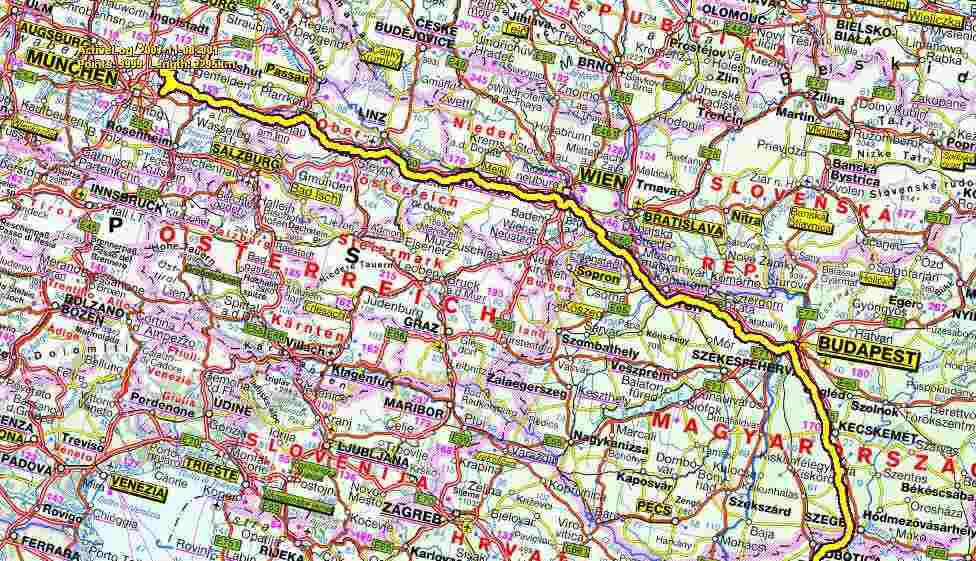
Budapest to Belgrade

Belgrade to Plovdiv
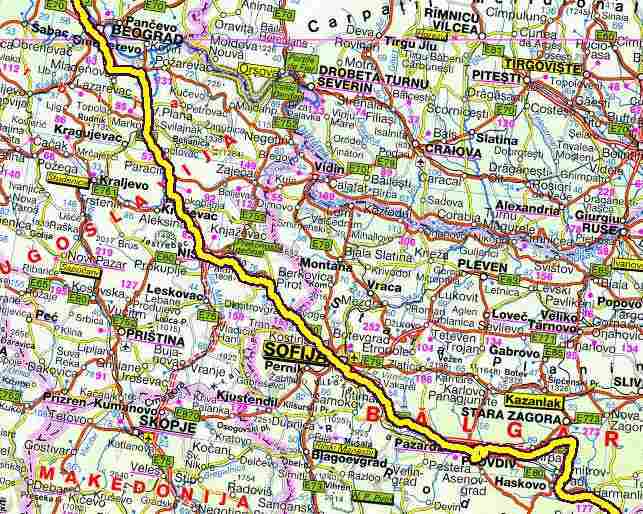
Plovdiv to Istanbul

Friday, November 9, we got up nice and early at about 7:15 but it took a while to pack. And then we had to put it on the bikes. It was about 10:00 when we finally pulled out into Istanbul's traffic. We took Kennedy Cadassy back the way we had come in, then a major road north and when we saw some signs for Ankara we were on our way. Crossing the bridge over the Bosporus to Asia was fabulous and the views were great on this clear day. Too bad we couldn't do a photo. On the other side there were only two types of toll booths: one type for transponders and another for card holders. Of course we had neither. We pulled up, waited for a car to pull up behind us and then rode through with the car when the gate arm went up. We then pulled over and I walked back to a building. Everything was in Turkish and it was a take a number system with five or six people in line. As near as I could figure out, you could buy monthly passes here. So I walked back to where Audrey was waiting and we took off. Maybe we'll get a ticket in the mail as a souvenir! Autobahn cruising became easier the further we got from Istanbul with the traffic not being quite as dense or aggressive. We gassed up and then rode another 100 km where we gassed up again, had lunch and put on some warmer clothes. There was a point where we could see the old road twisting up a mountain but now there is a new tunnel underneath the mountain. We had taken the old road in 2002 and it was really interesting with the slow moving trucks.
Toll plaza after the Bosporus Bridge
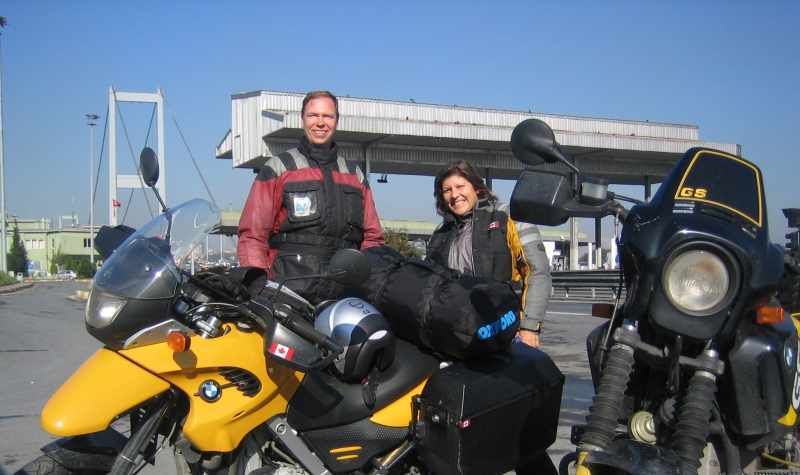
Climbing into the hills it got colder and colder. We stopped again for a hot tea and so Audrey could put on her electric vest. It was about 9 degrees. Then we climbed higher to a pass at 1580 metres and there was snow along the road and evidence of salting. +1 was pretty chilly! Down to Ankara, we paid the 11.50 lira toll and then took the ring road around to the southwest. Not seeing any hotels along the highway but lots and lots of new apartment blocks we eventually turned in towards the centre. Yep, the same zoo, though the drivers weren't perhaps quite as crazed as in Istanbul. At one point the four lane divided highway funnelled off into a residential area (and of course it was getting dark) because of construction. No detour signing was in evidence so we just sort of followed the flow. Finally, close to the centre of the city according to the GPS, I saw a hotel sign on top of a building so we pulled onto the sidewalk. There were at least half a dozen hotels right there! I walked to a few of them and got the prices, which ranged from 90 to 45 lira. The Hotel Duman was 60 lira and we could park the bikes in the garage. I went back to get Audrey and she was talking to a Swedish missionary who said you could find a hotel for about 25 lira. We thanked him and said we wanted a safe place for the bikes and then rode up to the front of the Duman. The bell hop ran out to greet us and showed us the garage. It was a very small garage with a huge lip to negotiate under the garage door. The floor was kind of wobbly and made of metal. The bellhop then slammed the door shut and ran down a small set of stairs at the back of the room. All of a sudden the whole platform started going down! Two floors down. In the basement we were told to just leave the bikes on the freight elevator. We unpacked and jammed into a tiny lift up to the lobby.
+1 Celsius
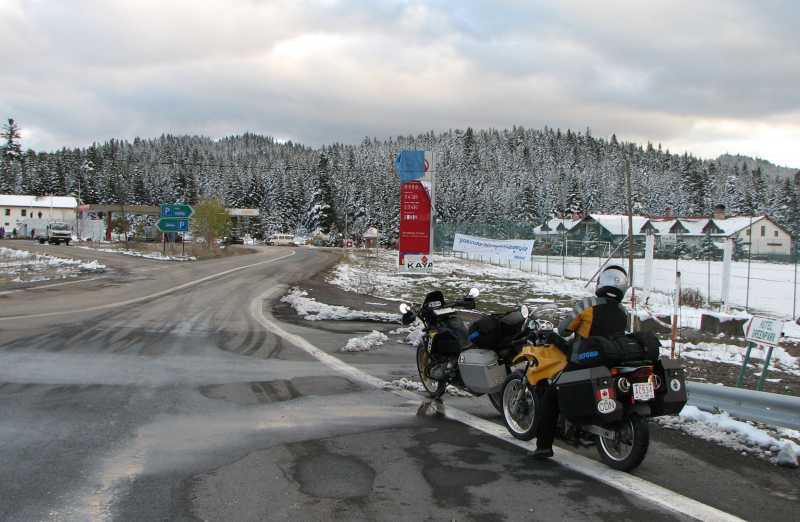
Brand new apartment blocks ring Ankara
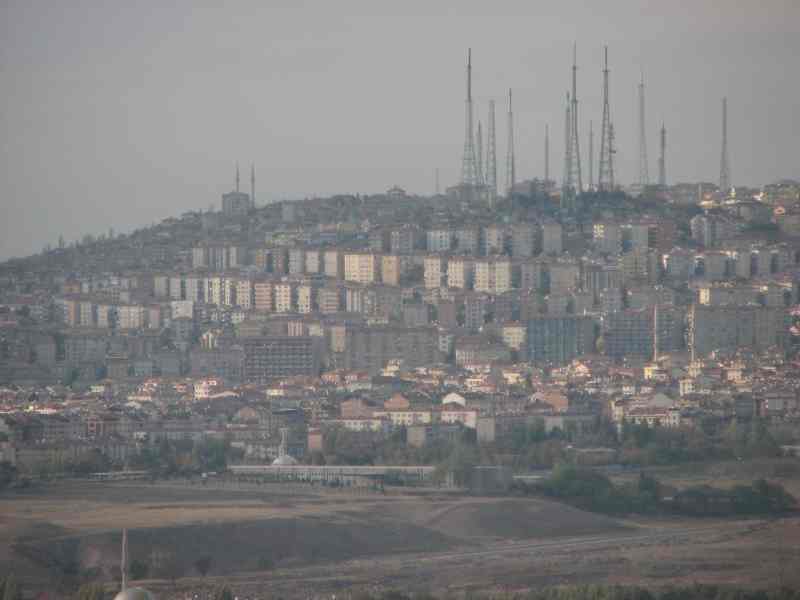
Small garage
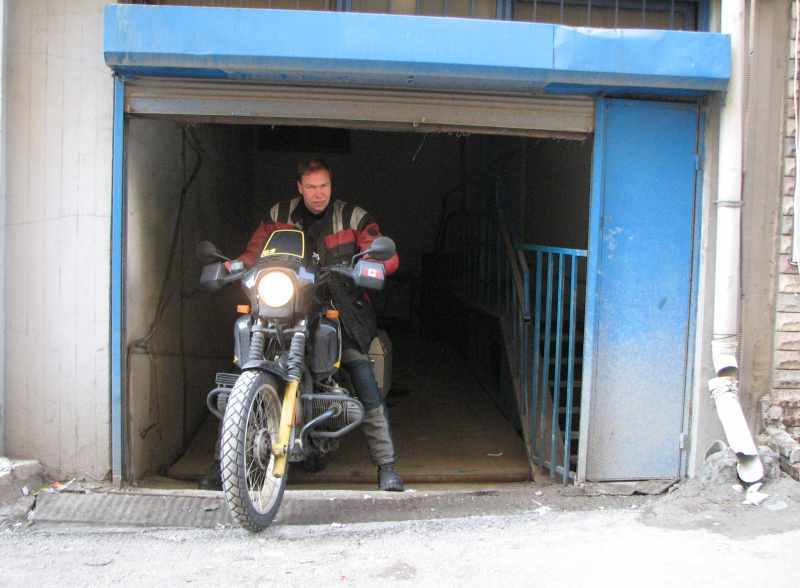
We got up the next morning and packed up quickly. This would be a long day if we were going to make it to Antakya, so we tried to have a quick breakfast and get the bikes out of the underground garage as quickly as possible. By 8:30 the bikes were out front ready to be loaded up. When I started my bike though, the valves on the right side seemed awfully loud. So I wheeled the bike back into the garage and took the lift down where I did a valve adjustment. As soon as I took the valve cover off I realised what the problem was. The upper right head stud nut was completely loose! I also discovered that I didn't have a 15 millimetre wrench but the hotel had one that I could borrow so I tightened it up. Upon thinking a little I wasn't sure if the nut had loosened because I hadn't tightened it enough back in Airdrie (4 months but only 2,000 km ago) or had the head stud loosened up. Audrey and I discussed the best alternative and came to the conclusion that even though this could be fixed on the road it was probably best to have it done properly right away. So we called David Maden again who gave us Kaan's phone number who might be able to help us. When I got through to him he said his master technician was off for the weekend but he could send over a junior technician if we were in a real hurry. We decided that since we were heading off to Africa it would be best to wait for the master technician. So we had some time to visit Ankara!
A torn seam on Ekke's expensive motorcycle gloves
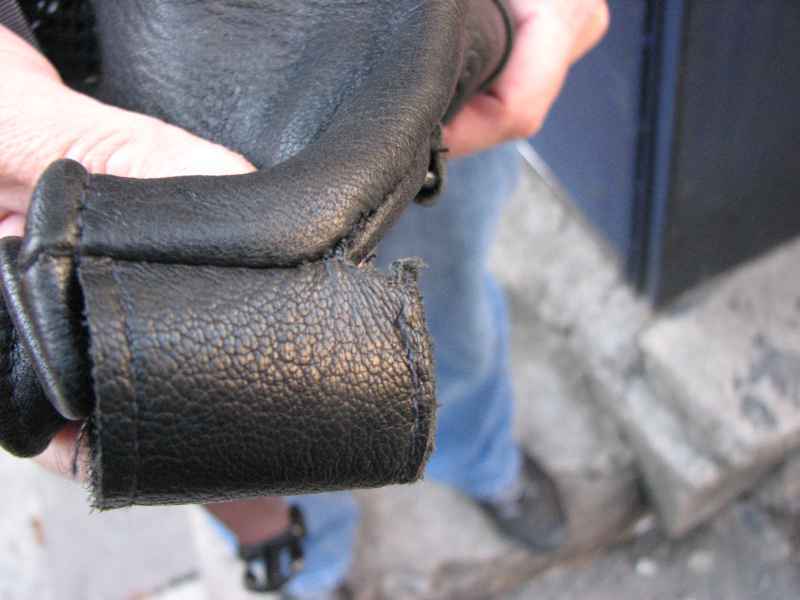
3 Lira and the glove is repaired
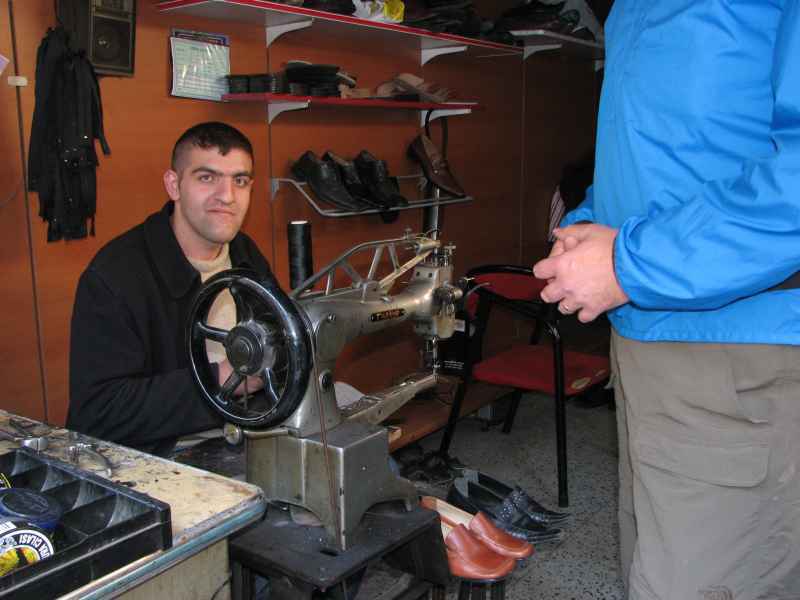
Audrey gets "mugged" by four girls demanding to have their picture taken

While I was preparing to check the valves on the bike a siren went off and the two hotel employees, who were down in the garage with me, stopped what they were doing and stood motionless so I did the same thing. After the siren stopped I asked what that was about and was told that this was the exact time that Atatürk, the father of modern Turkey, had passed away on November 10, so a minute of silence was observed all across Turkey. When we went out sightseeing there were huge banners of Atatürk everywhere, hawkers were selling flags and pins and there were wreaths laid at the Equestrian Monument, a statue of Atatürk riding a horse. We had seen the citadel on the hill from the Equestrian Monument so we started the hike up. There were lots of steps. At the top, past the fortified walls it was crowded with houses and narrow streets. A pack of rambunctious boys were lighting off firecrackers so we thought that before someone blows off a hand and we have to administer first aid we should get out of the neighbourhood. Walking down we came upon the Anatolian Museum and decided to pay a visit. They had a remarkable collection of artefacts gathered from around Turkey from the earliest stone implements and arrow heads to Hittite bowls to Roman statues. A circuitous route back to Hotel Duman got us home a bit after dark but the local streets are so busy that we weren't too concerned for our safety. It is difficult to avoid the dark when sunset happens at 16:40.
Giant poster on the building behind the Equestrian Monument
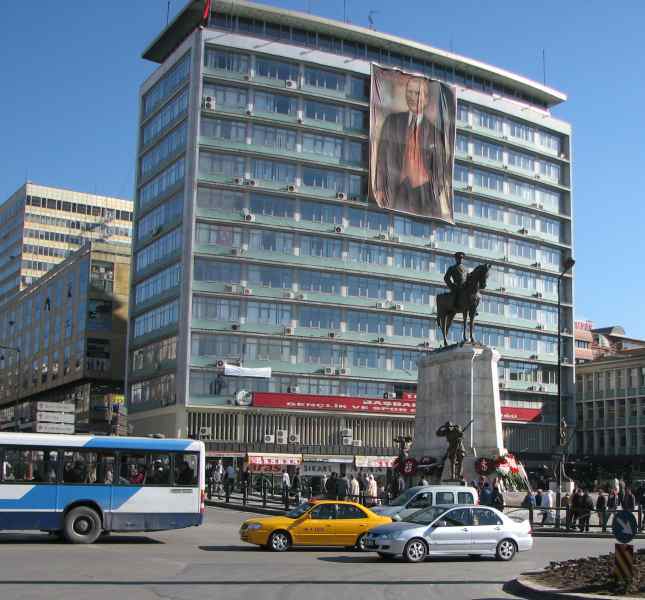
Houses built on the citadel

Fertility godess in the Anatolia Museum
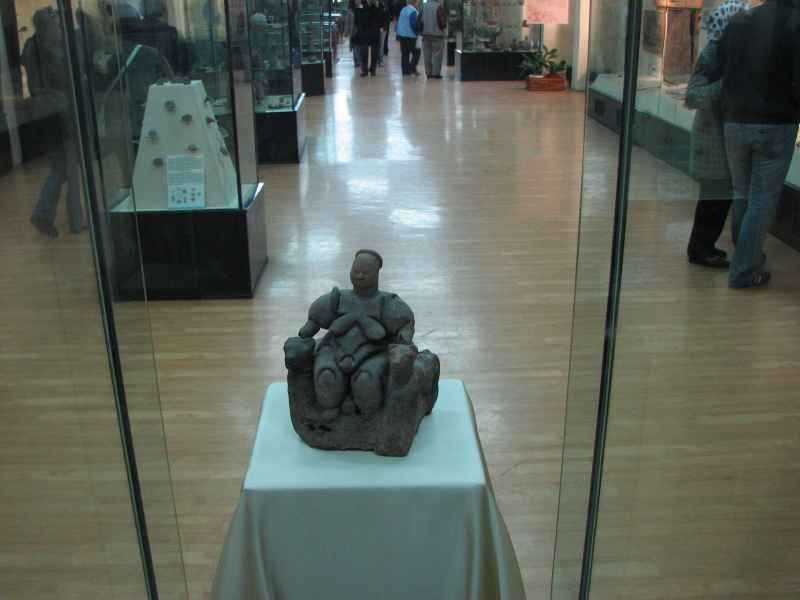
Figurine plated with "electrum", an alloy of gold and silver

My knee was really hurting after Saturday's walk up to the citadel so we stayed around the hotel, working on the website and doing minor maintenance on the bikes. Monday morning we tried calling Kaan all morning but with no luck. Finally at about 11:30 a local motorcycle mechanic came by (he was contacted by Ismail of the hotel) and asked if I would like to bring the bike to his shop. With some hesitation I agreed. I rode the bike (sans helmet!) for 300 metres down the busy street following the mechanic and his English speaking friend. The people at the shop were not terribly confidence inspiring and I had some trouble explaining that I didn't need a valve adjustment but I just wanted them to check the torque on the loose head nut. After about an hour (maybe two) we located a torque wrench and tried it. The head mechanic came by at about the same time. He tested the torque wrench on the three good nuts and the wrench clicked properly but the bad nut just spun round. That meant that the cylinder head stud or case was stripped and the repair done by Anderwerks in the spring had failed. It would be a big job to repair. I thought about taking it to BMW for repair but the head mechanic seemed to inspire a little more confidence in me, so I told them to go for it. He had the whole cylinder off in moments. We confirmed that the case was indeed stripped. I spent the rest of the day at the shop while they got to work on crafting a threaded insert. I hoped the bike would be ready tomorrow morning.
Working on the computer and PocketPC at the Grand Duman Hotel

Hole in the wall shop is through the hole without the garage door

Bike apart

When I showed up at 10:30 Tuesday morning the bike was all buttoned up looking like it was ready to go. I took the valve cover off and found the punch marks on the valve train pointing in and I thought they should be pointing out. So my confidence was a bit shaken. The rest of the day was consumed with doing an oil change, getting a new battery and trying to explain to the mechanic that he has assembled the bike incorrectly. Turning over the motor with the valve cover off showed that oil was flowing through valve train so I was a little more confident. Finally at about 6:30 I told them that was going for supper and could they please let me know how much to take out of the bank machine? 790 lira seemed awfully high, almost Canadian rates. When I went to leave they said I should take their scooter since it wasn't safe to walk in this neighbourhood after dark. I rode the scooter to the hotel and parked the scooter in front of the door. Audrey and I then went down the block for supper. At supper Audrey suggested getting an itemised list of work done on the bike so that I could verify the 790 lira charge. When we got back to the hotel from supper the scooter was gone! How much will a new scooter cost? Seeing our concern, the bell hop came out and indicated that he had moved it into the garage for safe keeping. Whew. Back at the shop they had made up the list but there weren't any prices on it. I mentioned that even 750 lira seemed awfully high but it didn't get me anywhere. Feeling very ripped off and not at all confident that these butchers have done a decent job on the bike, I didn't get too much sleep that night, tossing and turning. Can I trust the bike to take me through Africa?
Ekke on the loaner scooter in front of the hotel

Early on Wednesday morning (OK, 10:30 is not really early but it was for them) I went to the shop and found the torque wrench they had used to over tighten the head studs (double the value mentioned in the owner's manual). I then pulled the valve cover and re-torqued the heads to a more correct value, put it back together and was out of there in 20 minutes, before the mechanics even knew I was there. After lunch I adjusted the valves and went over the bike in detail to make sure it was all OK. In the meantime Audrey used this opportunity to visit a little more of Ankara and was surprised by the pedestrian street and some interesting artwork.
Audrey found some art that seemed to express Ekke's feelings of frustration

Interesting artwork around Ankara
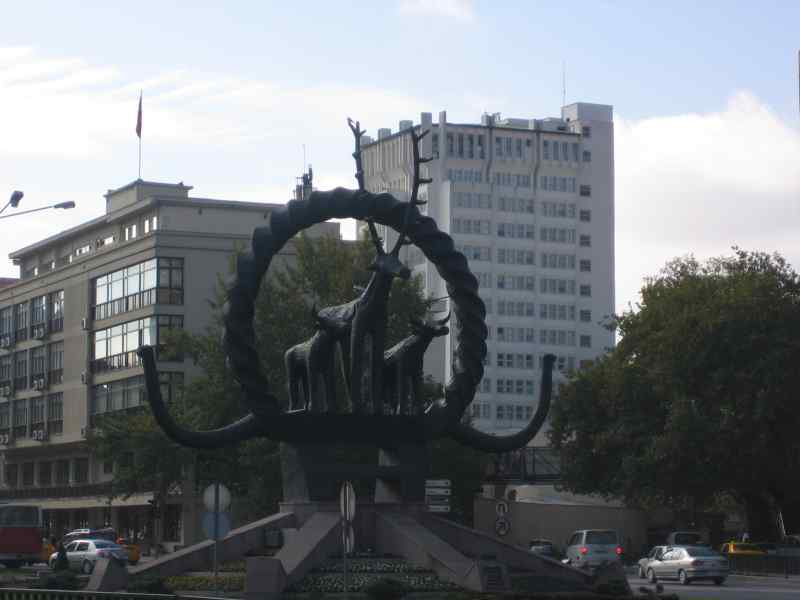
Ismail wished us well on our journey and we left the Grand Hotel Duman at 9:30 on Thursday morning. It was actually a lot easier getting out of Ankara than it was getting in. Riding south the bike was running great and the weather finally warmed up to a reasonable 20 degrees. Past the salt lake of Tuz Gölü we arrived at Aksaray and after a discussion over lunch we decided to turn left to go to Göreme rather than continue straight south to Adana. We had enjoyed our time there before and the scenery is so amazing that the small extra distance was well worth it. When we got into town Audrey walked around to a number of hotels (I had done the walking in Ankara) and she found the cheapest place at 20 lira. The Sarahan Hotel where we stayed in 2002 was 40 lira and we recall paying 25 million lira back then (Turkey has dropped the million as of this year) so prices have risen in Turkey. When we checked the exchange rate we found that the price of fuel is a bit over $2.40 CDN. Turkey is getting more expensive. When we went to the Backpacker's Cave Hostel I thought it would be worth the extra 10 lira to have a toilet and shower in the room, still a pretty reasonable price. There is a great coffee shop in Göreme that makes excellent hot chocolate (or at least they did five years ago) so we walked around town for a bit and then went there. Our memories hadn't failed us and the hot chocolates were terrific. We should have brought the hot chocolates to the room though. It was almost freezing cold at nine degrees Celsius. Audrey suggested getting our down filled sleeping bags from the bikes and I'm glad she did. Now we understood why some of the hotels Audrey checked out mentioned that they had heat! We also discovered that the shower was ice cold and that the toilet didn't flush so we had to use the one in the hall anyway. Maybe the extra 10 lira wasn't worth it after all.
Ismail sees us off

Except for the minaret we seem to have been transported back to southern Alberta
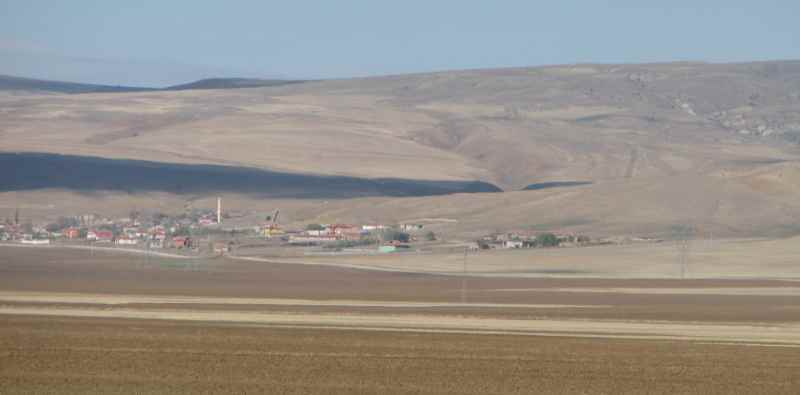
Turkish mosque
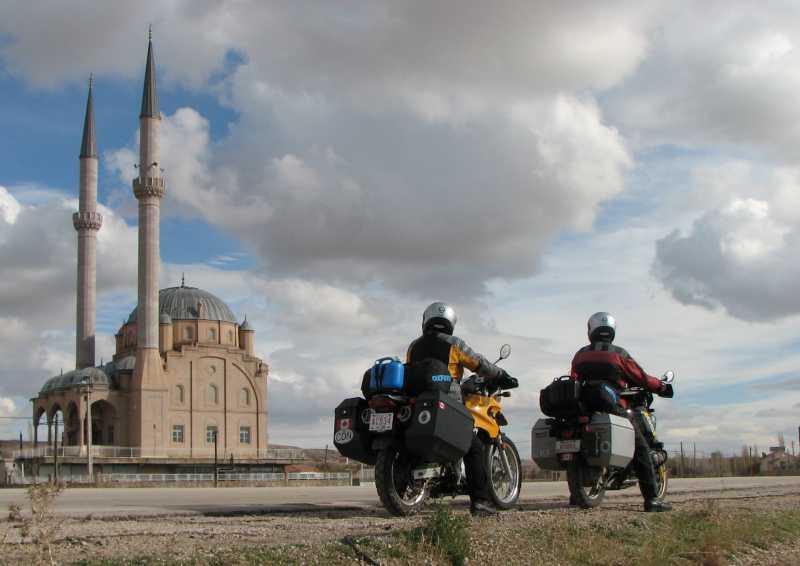
Arriving in Göreme
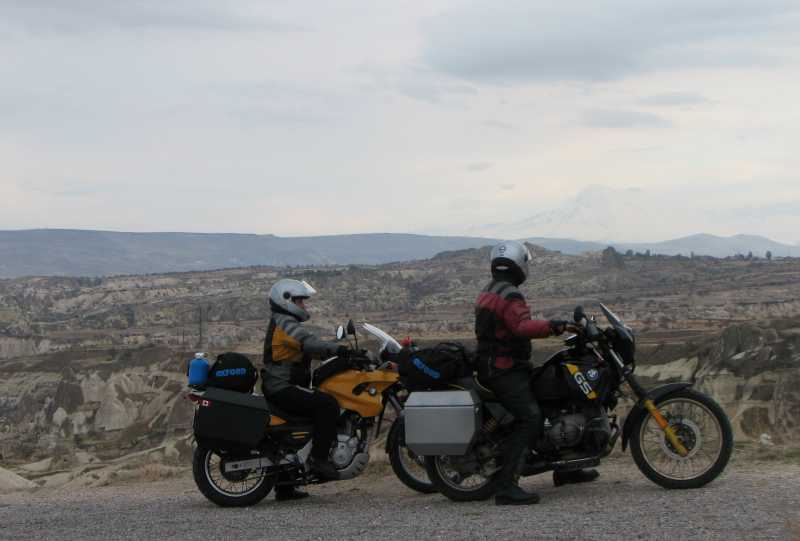
Another in the series of "Ekke and the short doors". This one in the 30 Lira hotel room
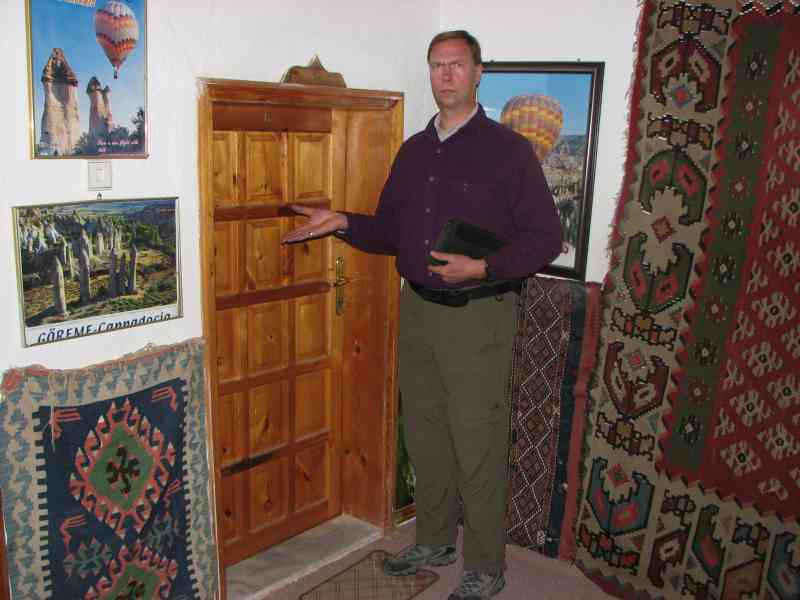
As the 30 lira room also didn't include breakfast we found a market that served Nescafé and tea along with a couple of buns and oranges. Once on the road and heading south the riding was gorgeous, with clear blue skies and snowy mountains. The bikes were running great and the old R100 even got over 18 km/L. It didn't last. Just past Tarsus I felt a vibration, the same vibration I had felt on the way to Ankara. After a toll plaza we pulled over and when I took my earplugs out the valves on the right seemed really loud. I thought that I should open up the valve cover after the bike cooled down a bit. While we were waiting for the bike to cool, a truck driver pulled up and started making himself a cup of coffee. From under his trailer! He offers us two Nescafés and he himself had a strong, boiled Arabic coffee. He then gave us his phone number in case we had any trouble in Antakya and a couple of chocolates. How incredibly nice. When I pulled the valve cover off it all looked OK but the upper right nut might have been a little loose so I tightened it as much as I dared but the cheap 15 mm wrench from the Grand Hotel Duman started to bend when I applied any real pressure. So I put it back together and we rode in the slow lane to Adana. Once there we pulled into a Ford dealership to ask where to buy a 15 mm socket and instead the service manager called the BMW shop! When we rode to Borusan BMW we discovered that they were taking appointments for next Monday. A mechanic suggested a friend of his who works on old BMWs and then called him up. We agreed to meet him near the Metro store and after we spotted his brown Fiat we followed him in to Old Adana to his shop. There were a number of old BMWs parked out front and my confidence and spirits soared, this was the antithesis of the butchers in Ankara. Inside they had a look at my bike and it seemed OK but they would like to look at it tomorrow. My confidence went even higher when I saw that Enver's shop was featured in the BMW Owners of America magazine. Enver then invited us over to his house for the night so we piled our stuff into the old Fiat to go for a ride to the suburbs. There we came to a beautiful, new house. After we got freshened up we had a tour of the house. There were lots of old BMWs and at least three BMW R80GS Kalahari models in the basement and Enver's brother says that they have another 16 of these rare bikes in storage elsewhere. Enver even has a 1945 Douglas which is basically a copy of the BMW design. Supper consisted of a couple of salads and the most delicious little fish. Even with Enver's English speaking daughter, Shegül, to help we couldn't figure out the name of them though. Apparently these fish are available only one month out of the year so we were lucky to be here at this time. A pleasant evening passed with Enver's brother and his wife and daughter over to visit. Enver's other daughter told Audrey's fortune (court and money figure in) and her credibility as a fortune teller was pretty good since she had predicted that two people with two bags would come today. They could tell we were tired and ushered us to bed at 10:00. Lying in bed we reflected on what incredibly good fortune we had today. We would never have met these wonderful people if I would have taken the newer, more reliable motorcycle.
Breakfast in Göreme
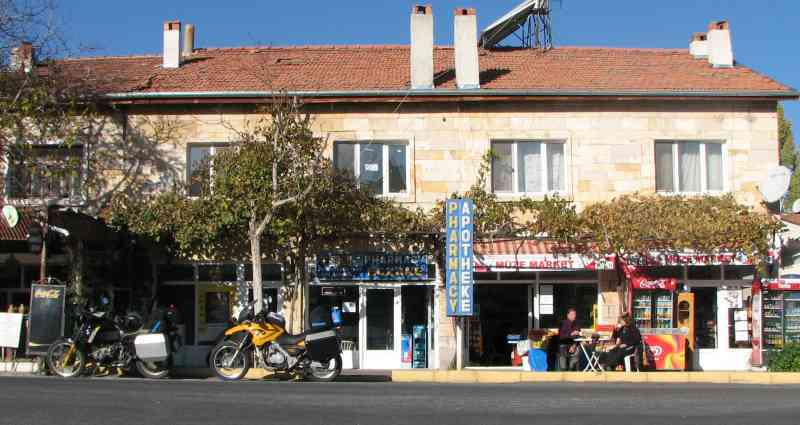
Leaving Göreme
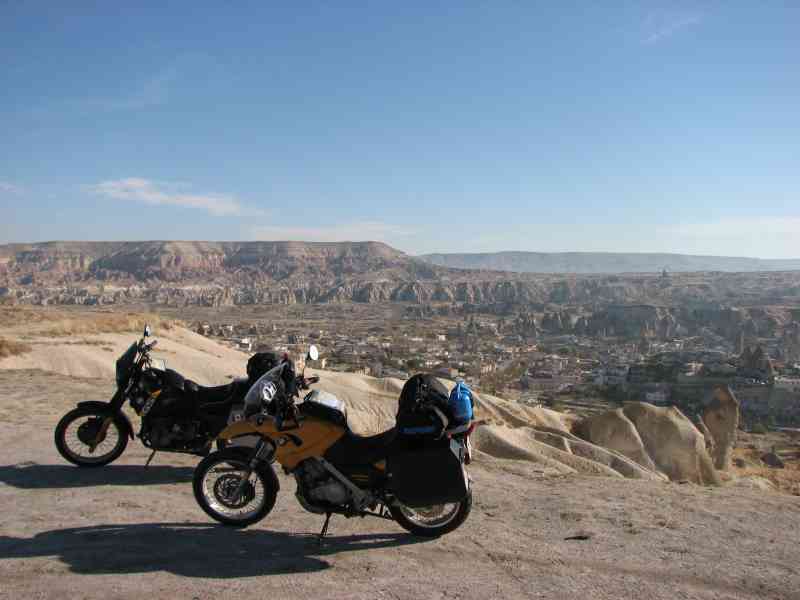
The Fairy Chimneys of Göreme
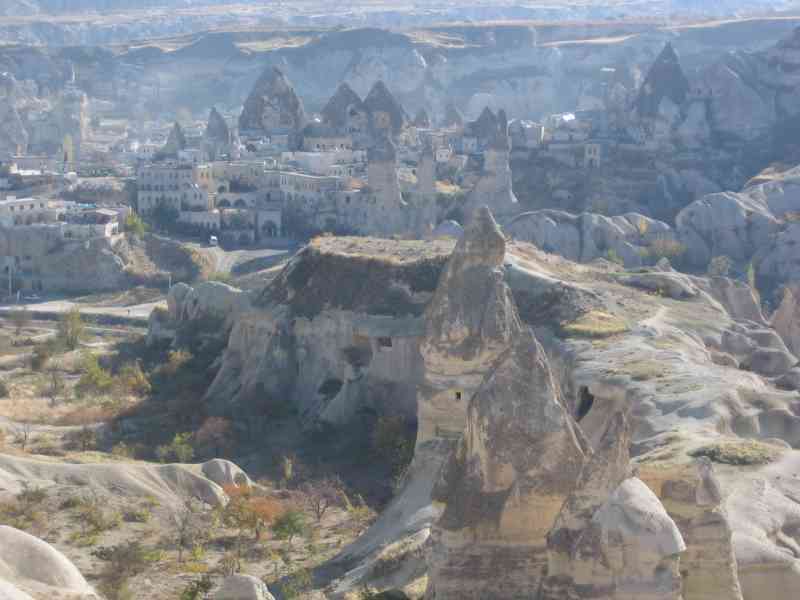
At least this pass wasn't cold and snowy
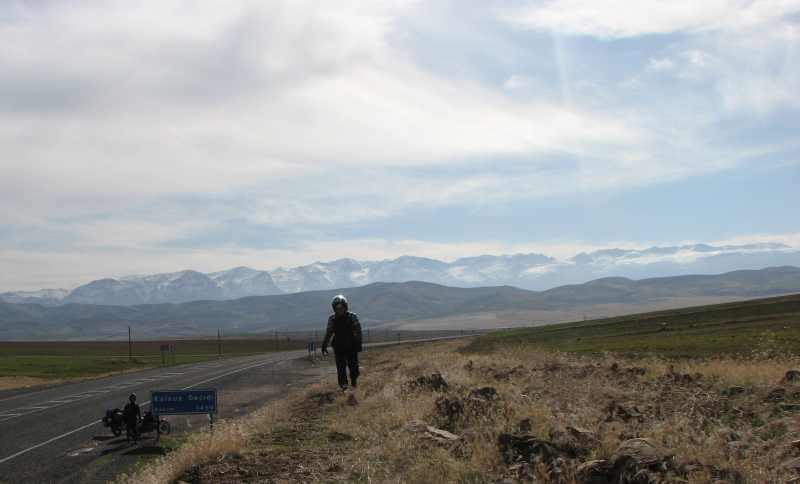
Great Turkish highway

Zeki makes some coffee while we wait for the R100GS's engine to cool
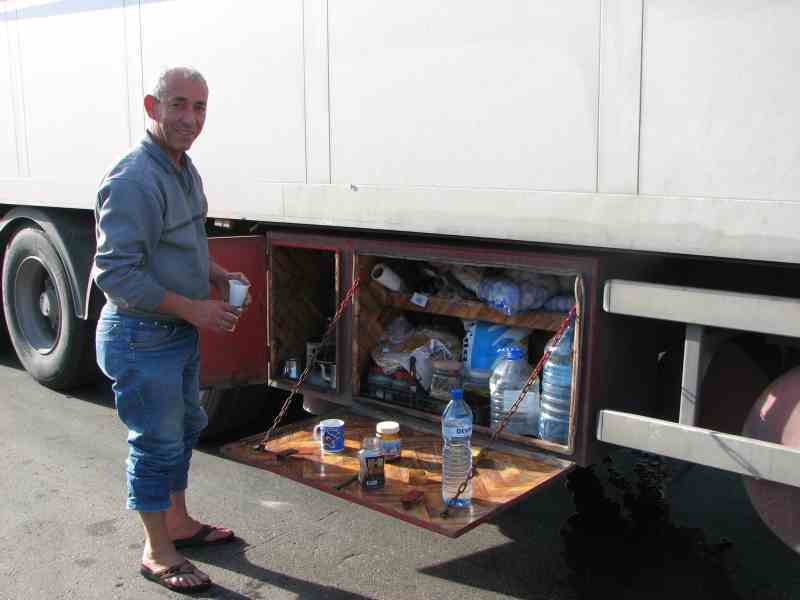
Article that appeared in March of 2003 BMW ON
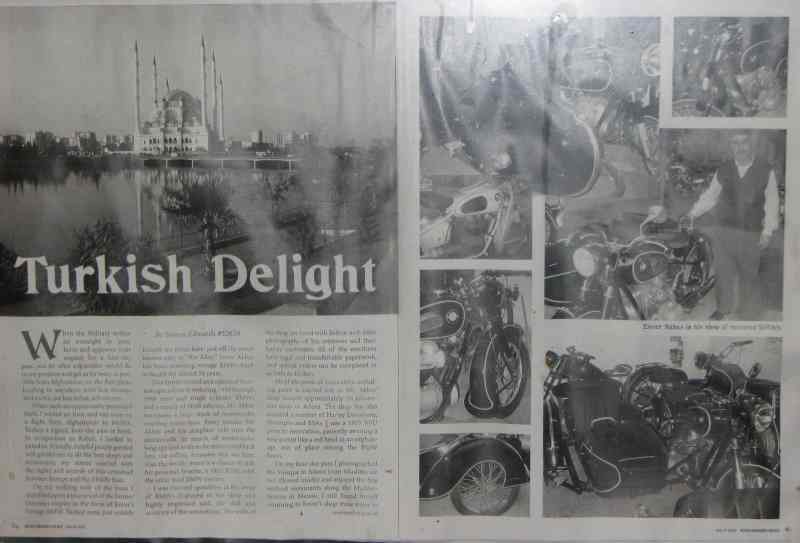
Wow, what a great sleep we had! After we had breakfast of scrambled eggs and sausage in addition to the usual Turkish breakfast ingredients we got in the Fiat for the ride back to Enver's Vintage Motorcycle shop. After Enver checked the valves and torqued the heads we fired the bike up and it was still too noisy. It was time to tear it apart and go much deeper. It turned out that the connecting rod bearings were scored so Enver replaced them. When the bike was reassembled (with much greater care and attention than was evident in Ankara) the engine sounded much better but we found that a muffler mount had broken. So that was removed and taken to a welding shop for repair. With the bike back together and another oil change performed, the total bill came to 1,000 lira, or about $800 CDN. Just before we left there was one additional item the bikes needed, their own guardian angels. Shegül added an Evil Eye to ward off bad mechanical gremlins to each bike. So now that we have our own guardian angels and the bikes are protected we should be covered for the rest of the trip. At about 3:00 PM the apprentice mechanic hopped on his motorcycle and guided us out of Adana to the highway. We knew we would have to ride in the dark for a short distance in order to get to Antakya but we thought that it wouldn't be too bad. And then the four-lane divided highway ended just as the road started curving up into the mountains. Playing tag in the dark with trucks going 20 kph uphill and 110 down was rather frightening. So we decided to try and find someplace to stay. We were almost ready to give up and put the tent up in a gas station parking lot when a roadside hotel showed up on the other side of the highway. We had to ride a few hundred metres in order to find a place to do a U-turn but it felt good to be off the road.
Beautiful new house in the suburbs of Adana
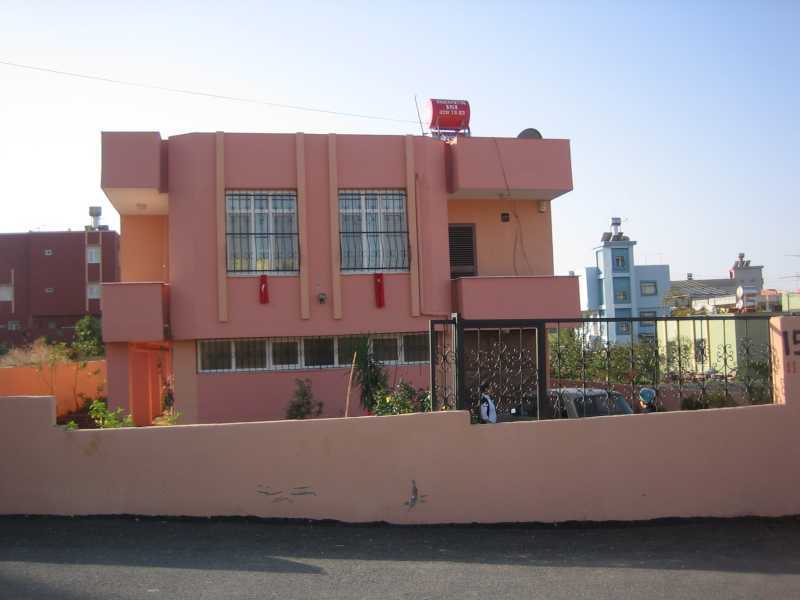
Lots of old BMWs like this one are scattered throughout the house

When in Adana, Turkey look up Enver's shop
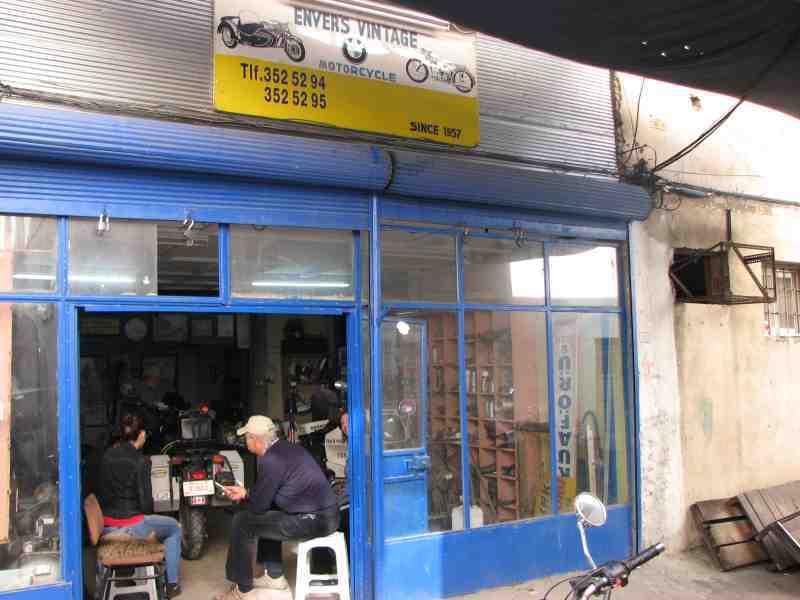
Enver re-assembles the right side cylinder
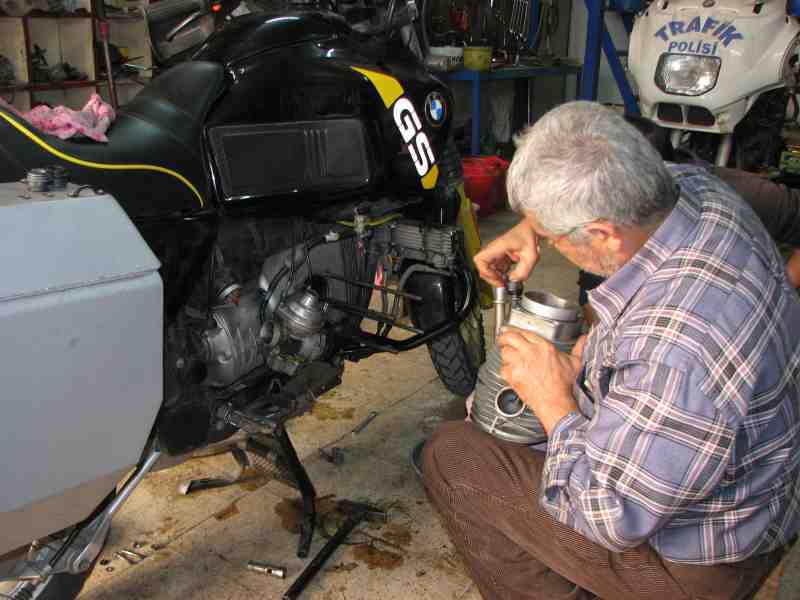
Taking a backgammon break while the exhaust pipe is being welded

An Evil Eye for each bike will ward off any more mechanical ailments
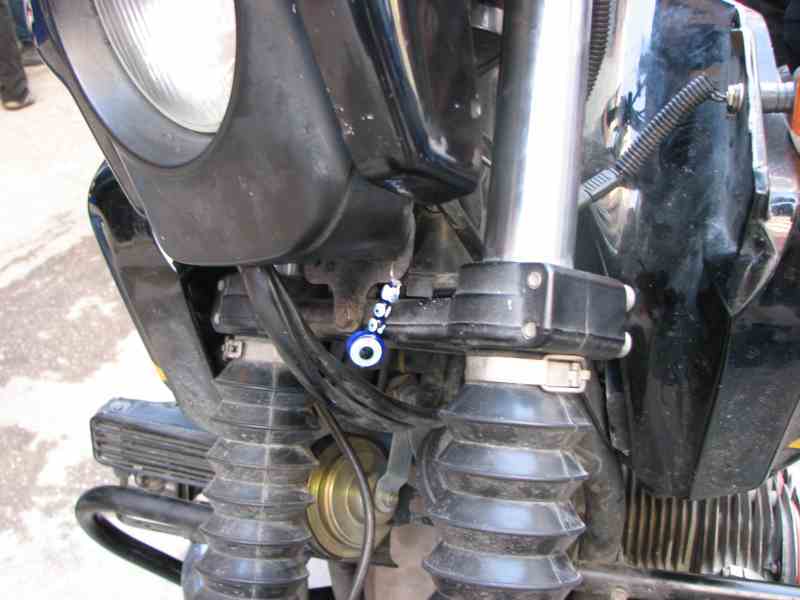
In the morning we had to find another U-turn spot before turning in the direction of Antakya. We rode into the centre of town and put the bikes up on the sidewalk. Audrey then went to find a bank machine and currency exchange, if possible, while I stayed with the bikes. In a few minutes about ten young men surrounded me, all eager to see the giant astronaut who had magically landed in their town. They took photos, using their cell phones, of themselves standing with me or with the bike until Audrey's return and then we took off. Before heading to the Syrian border we stopped off at St. Peter's Grotto. This is the oldest church in the world, where St. Peter preached and Christianity got its name. What an amazing feeling to be in a place with so much history. From Antakya it was a short ride to the east and the border crossing. There were four stations to pass through for exiting Turkey but the one where a stamp was to be issued for taking the motorcycles out of Turkey was temporarily closed. We waited for half an hour before the customs official returned from his tea break. In the meantime five or six backpackers walked through the border. They were from Canada with some from Edmonton! What a small world. When we were finally free of Turkish customs we thought we would just ride a hundred metres to the Syrian side. It was more like three kilometres, with armed guards and watch towers flanking the road before we could even see the Syrian side.
St Peter's Grotto
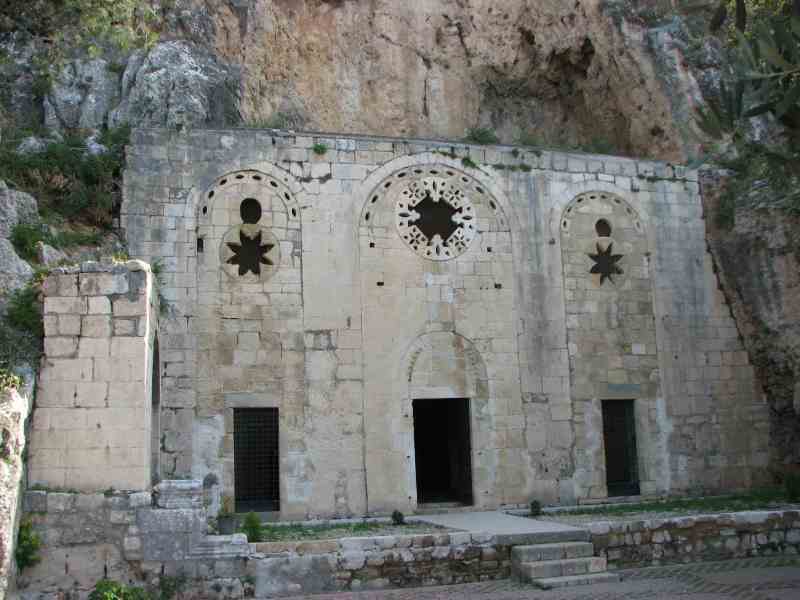
Changing Turkish Lira to Syrian Pounds

We had spent two weeks in Turkey when we had originally planned to spend one. The effect of the additional week will be felt right through the trip as we'll arrive in South Africa a week later and as a result have to wait an additional week for new passports before we can fly to Buenos Aries. This may make the trip down to Ushuaia too cold and snowy with the approach of winter in the southern hemisphere. Maybe our luck will change for the better and we'll save a week in Africa somewhere!
Maps of our route through Turkey
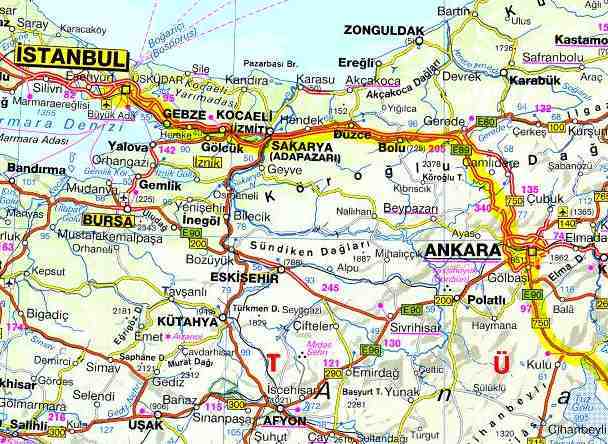

It was really tough travelling in Syria, but the incredible sights made it worthwhile. The fun began with the border crossing where we needed to get visas. Most tourists would have gotten their visa in Canada, and that's what the official asked of Ekke. Of course, our visa would have expired by the time we reached Syria anyway so they seemed okay with that. Jeremy Kroeker (www.jeremykroeker.com) had tried to get into Syria at a smaller border crossing a couple weeks before, and could not get a visa, so he tried at a bigger border crossing, with success. Ekke brought us a couple of forms to fill out then stood at the counter while others pushed in around him and tried to shove their passports on the counter ahead of him. The officials behind the counter kept helping Ekke in spite of all the hubbub. He paid some US dollars ($56 each) and within an hour, we had our visas. I attempted the next part, the insurance. A 'fixer' guided me to the insurance place. I told him I could read the sign 'insurance' and didn't need his help. But, he kept showing me where to go, and spoke Arabic with the guy behind the counter. I thought things were going more smoothly than if I had attempted it myself, so I stopped trying to shake him off. We went back to the bike to get the carnets the 'passports' for the bikes to ensure we won't sell them and not pay duty. After several stamps and paying $80 US, I thought we were finished. Then, the insurance guy said $4 more, which I paid, but all I had was a 20 dollar bill. He gave me change, a few American dollars and a stack of Syrian pounds. Good thing I had learned the exchange rate, because this added up to about five bucks. It wasn't until I got somewhat agitated that they gave me the rest of the change. I gave the 'fixer' a couple of bucks, but I'm sure he was in on the scam too. After a few more checkpoints and more showing of passports and carnets, we were in Syria.
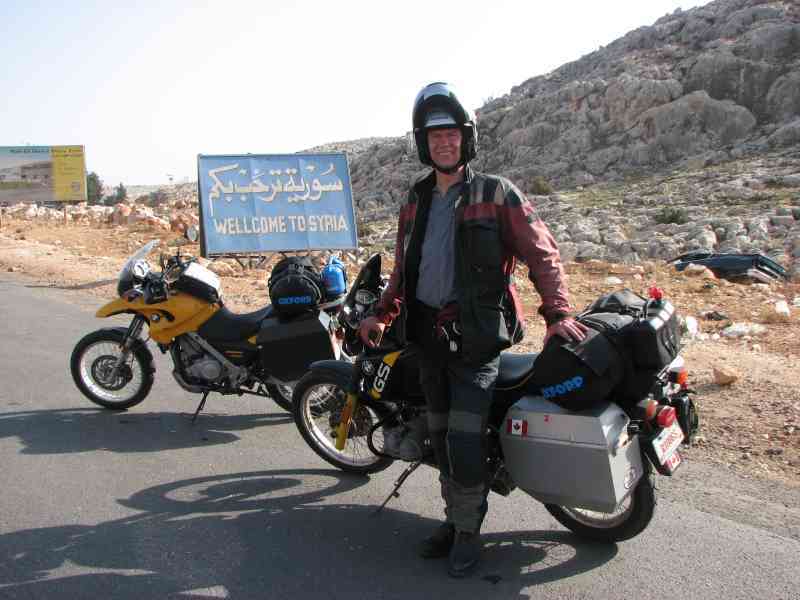
Aleppo was usually the first stop of most tourists, but it's a huge city and we wanted to head in the direction of the coast. By this time, it was 3:30 and it would be dark in an hour, so we headed to Idlib, the next closest dot on the map. No accommodations for Idlib were listed in our guidebook, so we rode into town not knowing what to expect. There was a lot of traffic, dust, stone buildings, and a few horses and carts. Ekke asked a traffic cop if he could point us in the direction of a hotel, and he waved us over to a side street. We didn't see any hotels, and just pulled over and asked another cop about hotels. Two off-duty officers jumped on a small motorbike, and got ready to lead us there. Meanwhile, some guy just walked up and handed me a white bag. Inside was about a metre of coiled honey-soaked pastry that was still warm. I was trying to ask him, "How much", and Ekke was saying "La, la" (no), but the guy was indicating that it was a gift. So, I just put the bag over my mirror, said "Shukran", and rode away. How friendly was that!. The mini-bike cops led us to a kind of divey-looking hotel, but it was full. Next came kind of a mid-range place, but after looking at a room we decided it was definitely not worth $35. So, after a few photos with our new friends (they wanted their pictures taken with us on their cellphones), another couple of guys who had just shown up on a bike took us to the Carlton Hotel, which looked a little too swanky for our budget. But, they didn't know of any other hotels, and they also tried to bargain the manager down from $95, but no luck. So, I went in with a sob story about us travelling around the world, how we had to watch the money, and gave him our card. He gave us the room for $88. It had a beautiful lobby with a solarium, and the rooms were nice enough. Supper in the hotel banquet hall was a bit strange as we were the only ones in there. But, we had a huge meal that we couldn't finish, and the bill came to 600 SP ($12) - unbelievable.
Free sweet treat

Off duty police help us find a hotel

Our first clue that we would be woken up at 4:40 am was the gigantic mosque just outside our window. Ekke heard the first "Allah Akbar" (god is great)), and it wasn't too loud. But it turned out to be a mosque further away, and soon he heard the sound of someone blowing into a microphone, as if they were just standing across the room. I was shaken out of my sleep by the loudest call to prayer I've ever heard. I'm sure the floor was rumbling, and I had to cover my ears. It was also the longest call to prayer, and we couldn't get back to sleep. The town started coming to life, too, so maybe others were shaken from their sleep, but I couldn't imagine going through this every day.
Mosque speakers at the same level as our room
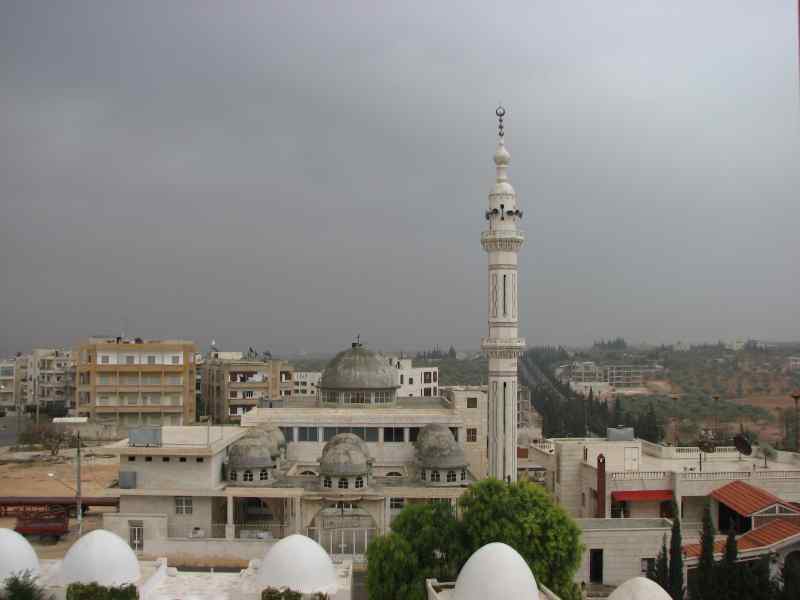
4:40 AM Wakeup Call
The route to Tartus took us up some winding little hilly roads, which were quite quaint at first, but then became somewhat dangerous as we had to pass other vehicles and they had to pass us. I'm pretty sure they were expecting us to be riding on the side of the road, as they would honk and try to squeeze us gently to the side. It was our job to avoid head-on collisions as oncoming vehicles just passed as if we weren't even there. Then, the heavy rain and hail started, and the roads were running with water and mud. Ekke found us refuge under a tin roof, which, when the lightning started, was only slightly scarier than the roads. We just sat and watched the deluge, across the road from a pleasant orange orchard. Down the coast past Lattakia we had to ride on a bit of 'autobahn'. Sometimes there were six lanes, which occasionally turned into four, with no warning, as the road went under a bridge. The speed limit said 110kph, and many people were going much faster than that. The shoulder was a hive of activity: Buses stopped to pick people up, vendors had stands set up, kids were walking and playing, and the funnest one of all was the assortment of vehicles heading straight toward us, driving the wrong way! Ekke finally spied a gas station, a run down place with wires and insulation hanging out of the pumps. One of the attendants jumped up on Ekke's bike as it sat on the centre stand so that his friend could take his picture from a cell phone. The concept of personal space is slightly different here. Tartus was a welcome sight, and someone came over to help us as soon as we stopped. He pointed us in the direction of the hotels, and we found the Blue Beach right away (1100SP, $22). Views of the Mediterranean were incredible. The promenade, much nicer from a distance, had metre deep holes every now and again. Someone must have stolen the grates, so we were careful where we stepped. We walked up to the Crusader cathedral which now housed a museum, and behind it was a lovely park with statues and walkways. Amazing to see flowers growing in November. But garbage everywhere in the old town made for some unpleasant walking, and after having a full pizza meal for two for six dollars (290SP), we called it a night. Most places were closed in the morning, their metal doors pulled down, as we went in search of breakfast, so, we ended up on the 14th floor of the Shahin Hotel, a good buffet for only $4 each.
Just one type of "interesting" vehicle in Syria
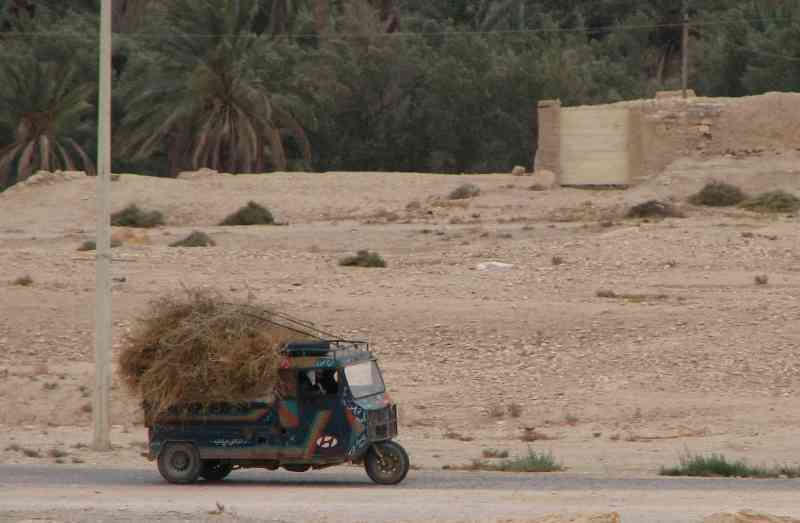
Promonade in Tartus
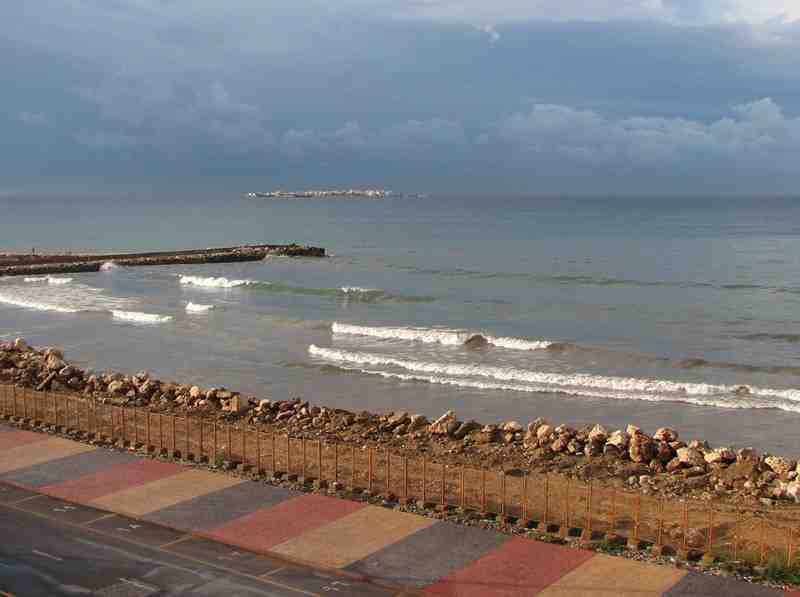
Windmill on the corniche has been hit by lightning

Syria has a garbage problem

The ride to Crac Des Chevaliers took us along winding roads through small towns. Signs often had both English and Arabic, but occasionally just Arabic, getting us royally lost in Safi. After riding through pouring rain, we eventually made it out, ending up on the autobahn instead of the smaller roads. We got off the autobahn a stop too early and the road led us through a small town. A motorcyclist jumped on his bike and led us through some very small streets, pointing us in the right direction. The road climbed higher and higher, the fog rolled in, and we actually quite enjoyed the narrow, twisty road. Crac Des Chevaliers, a Crusader castle built in 1110, came into view as we rounded a corner, and it was spectacular. The huge stone structure was held by Crusaders for 161 years, and they used it to control the Homs Gap, the only route between this area and the sea. Unless we wanted to ride to the next city, the only accommodation was a hotel perched on a hill, up a steep road, under construction, that looked like it was flowing with sand in the rain. I walked up the hill to check it out, still in full motorcycle gear, leaving my helmet on because of the pouring rain. The room was not great, but it was dry, so we rode our bikes up after I discovered the road was just gravel. The last, steepest section was deep gravel with a bit of mud underneath. Ekke just gunned it and fish-tailed a bit going up. I gunned it as well, but ran out of courage partway up. I shook my head, no, that it wasn't going to happen and that I would need a rescue. But, it's amazing how one's courage rises when there's an audience (a few guys in the restaurant). I just hit the gas and swerved my way up through the gravel, all to the entertainment and applause of the onlookers.
Audrey buys a snack for on the road
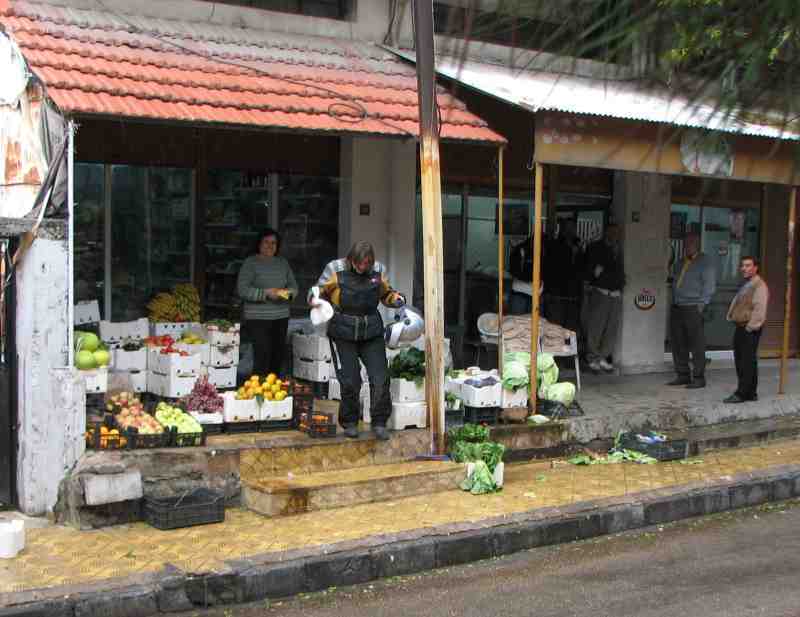
The road up to the hotel alongside Crac des Chevaliers
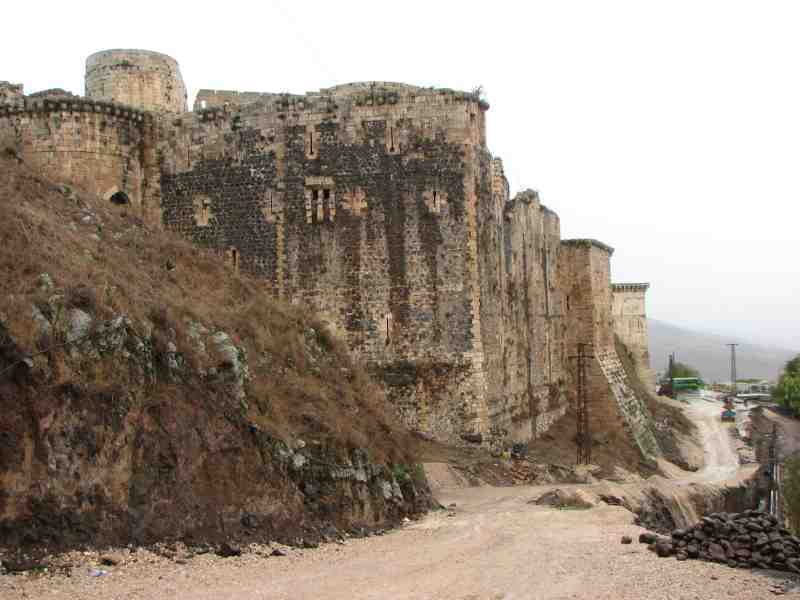
We were greeted at the door of Crac Des Chevaliers by kids begging for money, postcard sellers, a one-legged man, and guides. After paying 150SP each ($3), we walked up the stone ramp, imagining knights in shining armour riding their noble steeds up the cobbled path. The moat had a lot of garbage in it, so it took away some of the romance, but the rest of the castle was great. The ramp switchbacked up past guardrooms and stables, and took us to the main courtyard. A seven-arched facade still had original designs intact, and it sat in front of the assembly rooms, where the knights would receive visiting Crusader kings. The cathedral, which was converted to a mosque in 1271, had a Muslim minbar (pulpit) in it. The guard towers overlooked the beautiful Syrian countryside, and we could see the Mediterranean and the mountains of Lebanon. Safety was definitely not a priority here as there were drop-offs everywhere, windows without any coverings, and rooftops with no railings. The castle had endured an earthquake, so we walked under those stone arches with a little unease. Our headlamps allowed us to explore dark corners and unlit rooms, and we spent a couple of hours doing so. A cafe was located in the Princess Tower, and a group of German tourists were enjoying lunch. We had some hummus and pita, but our main goal was to get out of the rain and drafts for awhile.
Facade in front of the Assembly Rooms
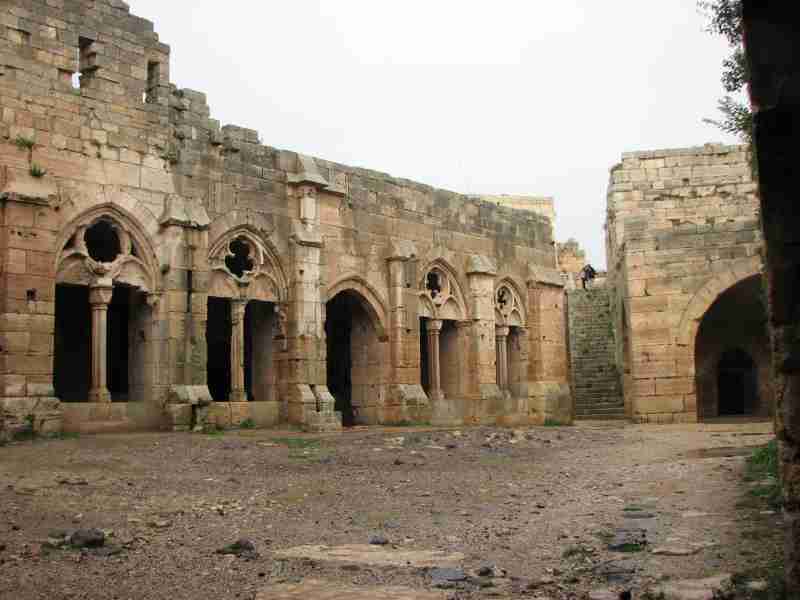
Vaulted ceiling
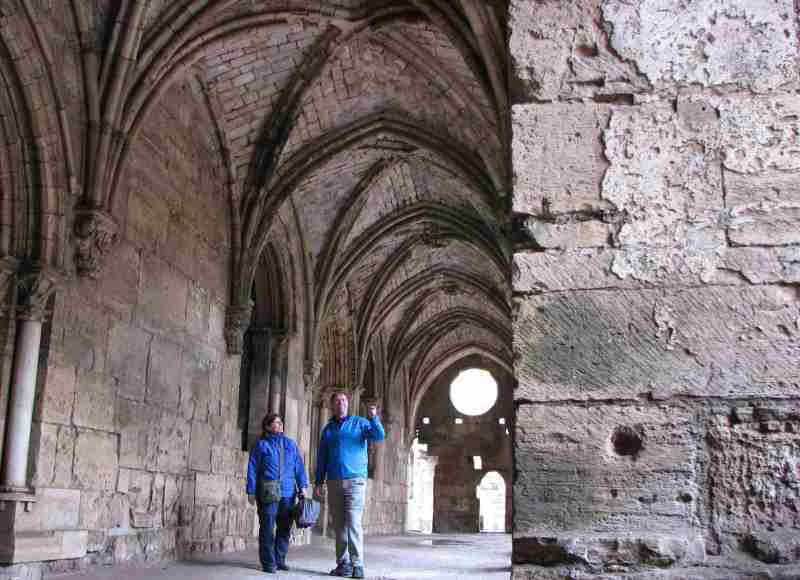
Audrey takes a break from the rain

The rain continued right into the next day as we left. Since my restaurant audience was not there, I let Ekke ride my bike down the steep part of the hill. The road took us down into the valley and eventually across the desert, where it was finally dry. The landscape had a lot of scrub, kind of like the area around the Okanagan. The sunny ride to Palmyra was an absolute joy, with very little traffic, and just the odd shepherd with his flock of sheep crossing the road. After about 160 kilometres, we rounded a corner, and there was our first glimpse of the archaeological site and oasis. A colonnaded street still stood, and we could see several structures fairly intact. Palmyra was a stopping place for caravans passing from the Persian Gulf to the Mediterranean. The Romans came in 129 A.D., but Queen Zenobia, the wife of an assassinated king, started rebelling and had a lot of control in the area. The Romans didn't like that she was minting coins with her own image on them, and came and shut her down. The Muslims conquered in the 7th century and built their castle. While I went to check out a hotel, Ekke stayed with the bikes and was immediately swarmed by ten or more local kids. I looked out the window and could see their hands on everything, one sitting on my bike playing with all the switches. It was quite comical to see Ekke in the midst of the swarm, trying to get the kids away from the bikes. He was having secret fantasies that a kid would touch the hot engine but it didn't happen. I came out and gave them my best teacher 'look', and the crowd soon dispersed. Our room in the Citadel Hotel had a view of the ruins, oasis and the Arab Castle on the hill (750SP, $15). While checking in, a guy approached us to buy postcards, and I said I'd look later if he was still there in an hour. Later, he found us at the ruins, and asked why I didn't buy postcards from him. I told him that I didn't see him so bought postcards from someone else. This started the worst hassling I've ever received from a tout as he followed us around, wouldn't leave, kept saying, "Madam, madam, you say you buy postcards". Eventually, we just ignored him, and then his friend started bugging us to buy necklaces. They jumped on their minibike and would turn up wherever we seemed to be. Later, we made an amazing discovery in town... a Pancake House! But when we went in, guess who was inside: Postcard Boy. I was ready to just leave, as he looked like he was friends with the owners, but he went out of sight and Ekke was dying for a pancake. They were savoury or sweet, with flavours like 'banana split' and 'lemon and sugar'. Fantastic.
Audrey rides down from Table Ronde hotel
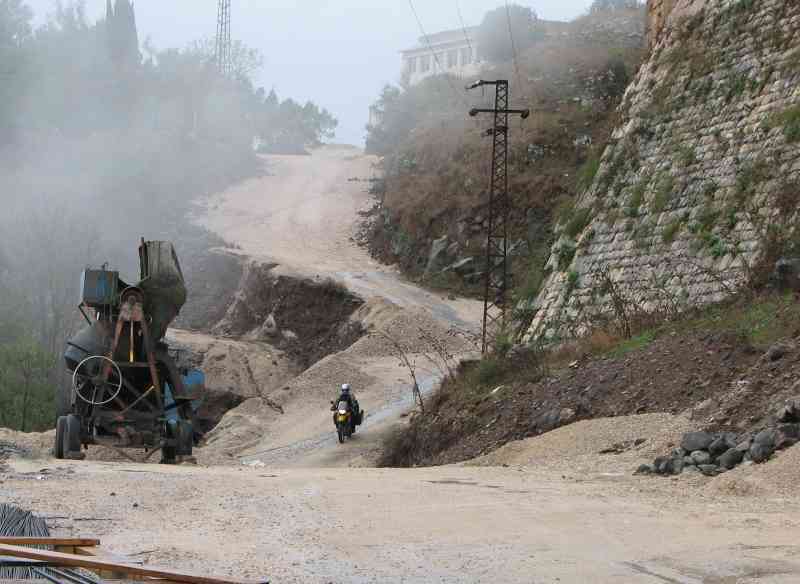
Out of the rain and into the desert

Enjoying being dry (150 kilometres from Iraq!)
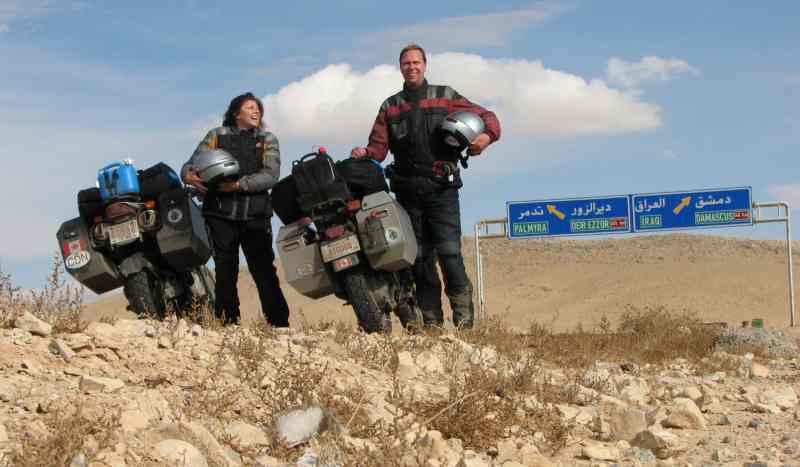
There was no entrance fee to the ruins, but it cost 150SP ($3) to get into the Temple of Bel (Zeus). Guides asked us if we wanted to be guided, but we were able to enjoy the visit by just using our guidebook and exploring on our own. So much detail was still visible on much of the marble, especially the pineapples and grapes on a couple of slabs outside the cella (shrine). The theatre also cost (75SP, $1.50) but had been renovated and was very complete. Postcard Boy came around a few more times, and ignoring him just didn't shake him. "Madam, where you from, Madam, you say you buy, Madam...." When he turned up as we were changing some US dollars to Syrian pounds, I'd had enough and told him that we knew he had friends at the Pancake House and would not go there any more if he kept bugging us. That seemed to do it, and later we enjoyed some fantastic savoury chicken pancakes, followed by peach and warm apple and cinnamon. We saw Postcard Boy one more time at the Arab Castle, but he was too winded from the climb to the top to bother us. The castle was apparently 'the' place to be at sunset, which was at 4:19 PM. The beautiful setting sun was perfectly lined up with a tall microwave tower on an adjacent hill, and you could just see the gorgeous colours peaking out from behind the metal latticework. So much for the beautiful sunset. The ruins were lit up, so we went down to take some pictures. Our motorcycles, just like all the touts' minibikes, were able to squeeze between a couple of big rocks and we soon found ourselves riding down an ancient Roman street between huge colonnades. How fantastic! Trying this anywhere else in the world would probably have landed us in jail, but the minibikes had set a precedent. Unfortunately, we got in big trouble with a British woman who was trying to take photos of the colonnades without a couple of motorcycles in the shot. Not wanting to miss our opportunity, we quickly took our pictures and rode out. We thought her pictures would be more interesting with a couple of Canadian bikes in them, but apparently she didn't agree. As the next morning was bright and sunny, we went to the ruins for a few more pictures, and this time a Japanese photographer actually wanted us in her shots!
Arab castle on the hill above Palmyra
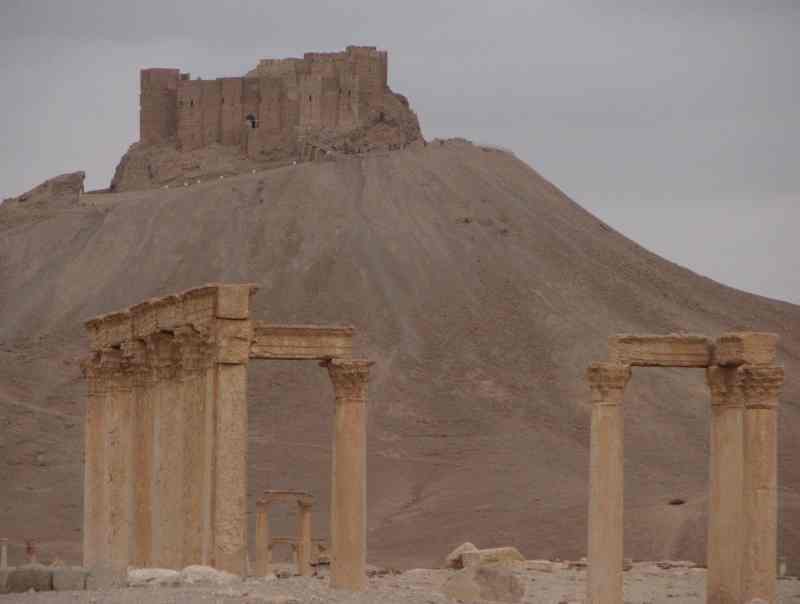
Temple of Bel
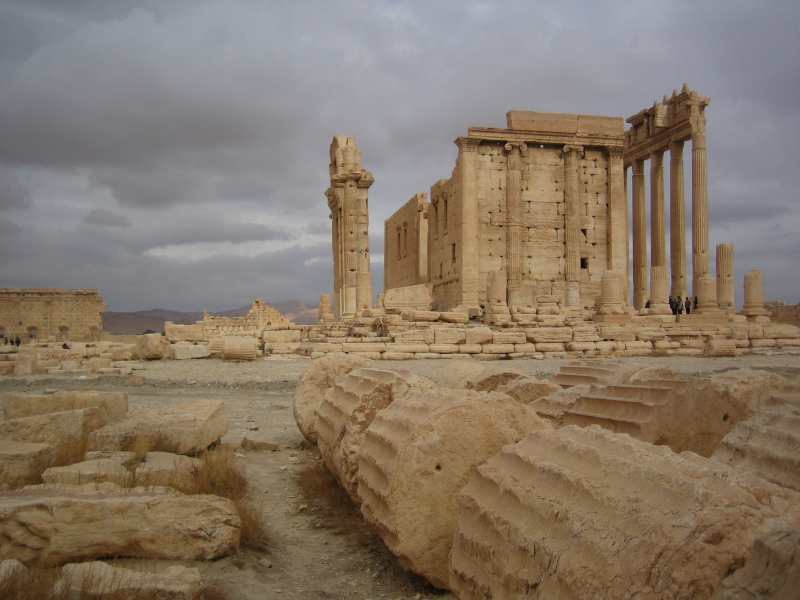
Some of the incredible detail remains

The performance should be down on the stage not in the stands
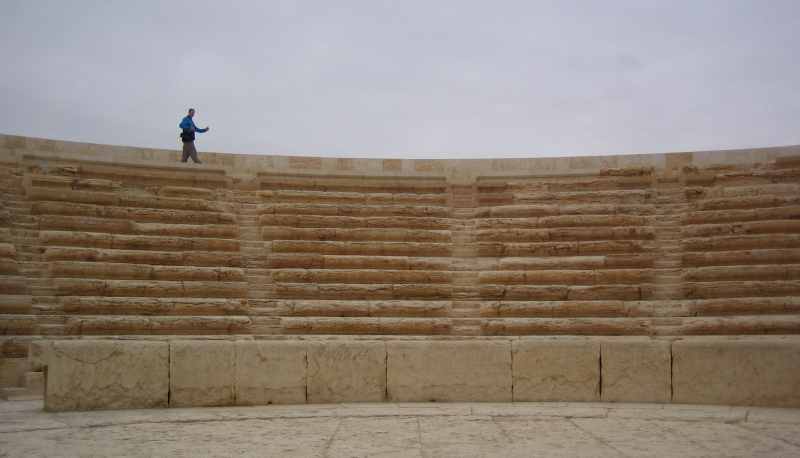
Clambering in the ruins
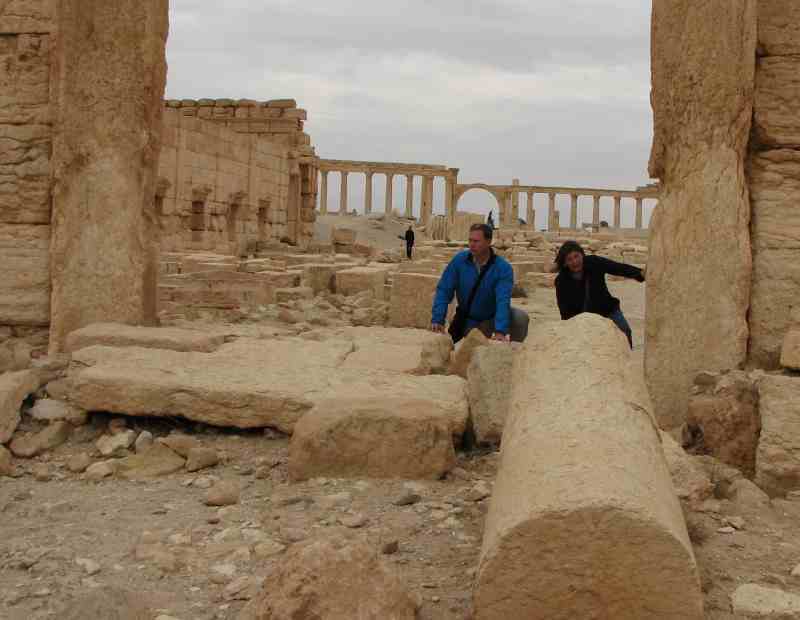
Clambering can work up an appetite for pancakes

Riding near the colonnaded street
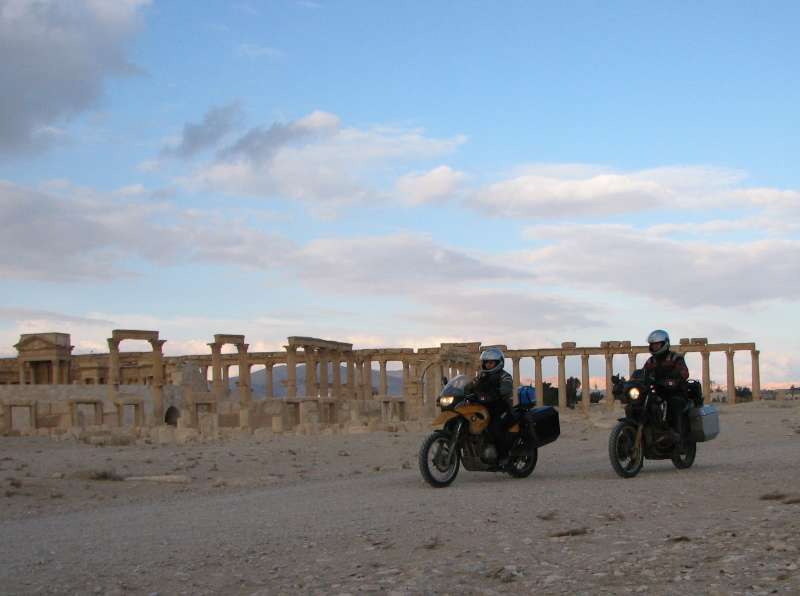
Arab castle at moonrise

Ruins of Palmyra from the castle
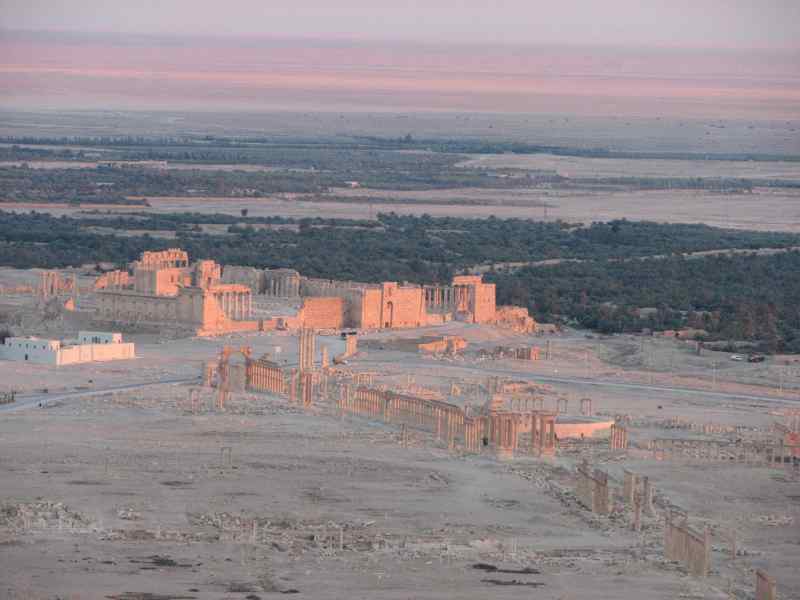
The perfect place for a radio tower

Monumental Arch is the entrance to the colonnaded street

Just goofing around!
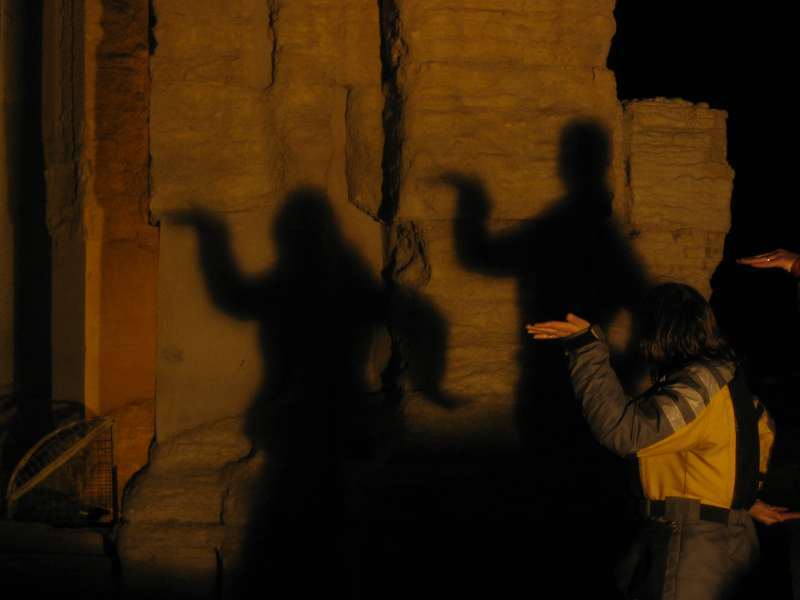
Audrey rides amongst the ruins
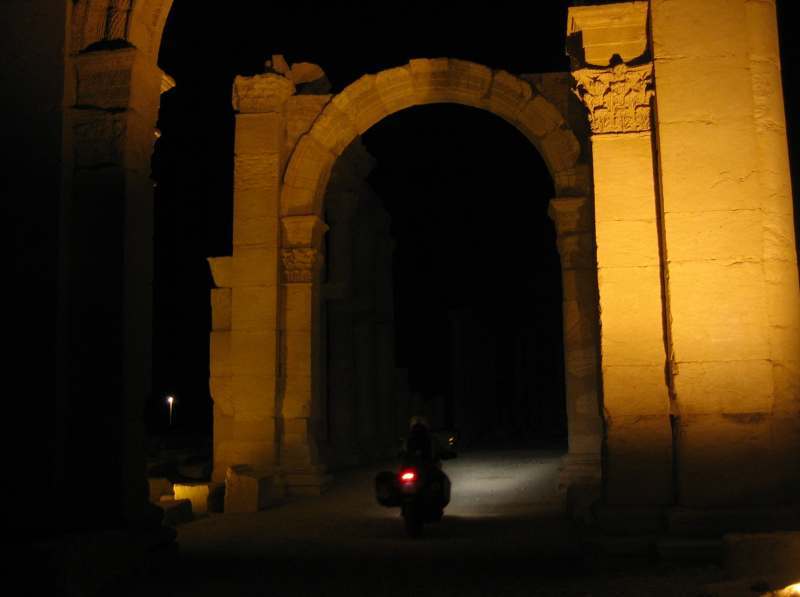
Ekke Writes
We woke up to a fairly crisp morning and since the restaurant downstairs wasn't open we went down the street for pancakes instead. For some reason there were no apple-cinnamon pancakes available today so I had a lemon-sugar pancake and Audrey had her usual banana split pancake. While this wasn't what we were hoping for it was still delicious. After checking out of the Citadel we rode past the Great Colonnade and took a few photos before heading into the desert. Eighty kilometres down the road at a major intersection was the famous Bagdad Café so we had to stop in for a cup of tea and coffee. Just as we were leaving, the owner started feeding a hooded falcon. Just like in Tunisia, Audrey immediately got volunteered to have the bird sitting on her arm. As we rode south across the desert it really didn't warm up very much despite the bright sunshine.
Some fun at the Bagdad Cafe
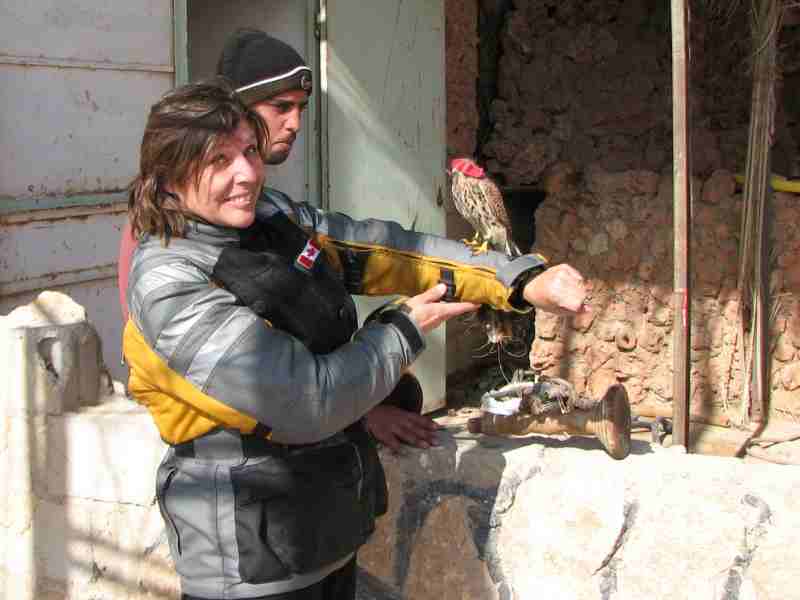
Buying lunch

About 50 kilometres out of Damascus we turned west into the barren mountains, finding our way to Ma' Lula. This town is the home of the Convent of St. Takla and it is in these mountain villages that the Aramaic language is still spoken. Aramaic is the language that Jesus spoke and it is the language that the Lord's Prayer was originally authored in. We rode through town to the monastery, locked up the bikes and then walked up the St. Takla Gap, a narrow gorge in the mountainside. After the climb up to the top of the cliff it was getting on 3:00 PM and we knew that sunset would happen in the next hour and a half so we walked over to a hotel we had seen at the top of the cliff. It looked like an expensive hotel and it had a lovely view of Ma' Lula as well as the monastery. It was an expensive hotel with a rate of $111 U.S. per night. Cough. Even his best offer of $88 was still above our budget so we walked back to the bikes thinking that we would look for something else in town and if there wasn't anything we would just have to spend the big bucks. At the bikes we met some Damascenes out for a drive in their new Hyundai SUV. They suggested that it was possible to stay at the monastery for a small donation so they accompanied us up and asked if it was possible for us to stay. No problem! They then gave us their phone numbers and told us to call them when we got to Damascus and we could come by for a visit. What nice people. One of the nuns said we could park the bikes inside so we pulled them up over the sidewalk into the stairwell. We hoped there wouldn't be a need to use the fire exit... Since we only had pop and chips for lunch (I hope our moms aren't reading this) at a gas station in the desert we opted for an early dinner at a restaurant near the convent. Delicious skewered chicken with pita bread and a yoghurt dressing plus a tomato and onion salad made up for the decidedly unhealthy lunch.
Walking the St. Takla Gap

Secure motorcycle parking

Convent of St. Takla
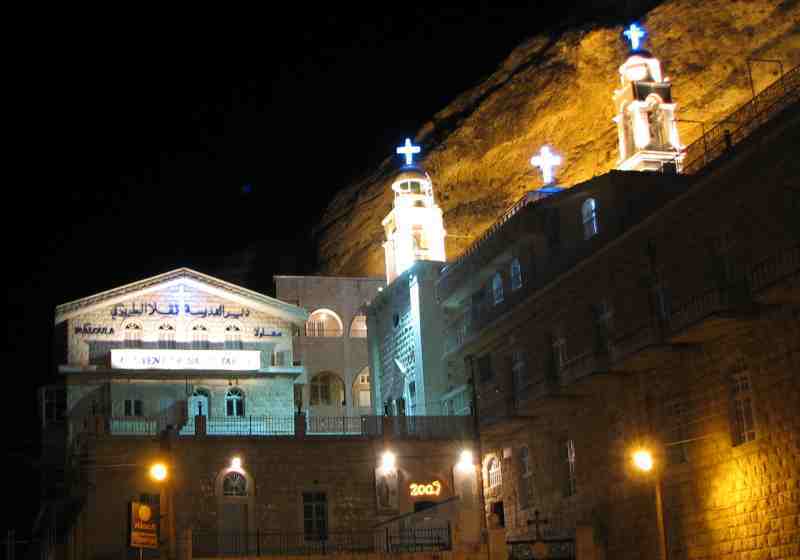
What a restful sleep we had in the convent. Until 4:30 AM anyway. Even though Ma'Lula is predominantly a Christian town there are still enough mosques around to give a call to prayer first thing in the morning. After we took the bikes out of the stairwell and gave a donation of $10 to the convent we went across the square to the restaurant where we had supper the previous evening as we had asked the proprietor if he was open for breakfast. He said he was and would open his restaurant at 8:30 for us. When he didn't show up by 9:00 we grabbed a couple of fresh pitas from the bakery next door and then rode up the hill to the chapel of Mar Sarkis to enjoy them with Nutella on the panorama deck. A tour group from the Netherlands was there and I had the opportunity to speak a bit of Dutch.
Now that is fresh bread!

After "breakfast" we rode to the New Kaboun campground located at the edge of Damascus and set up camp. The first time since our Switzerland trip! It was good to see our home away from home but it is going to take a while to get used to organising ourselves for camping. After setting up we hailed a cab and for $4 got a ride to the old town. It was rather pleasant not driving into the middle of a big city and looking for a hotel amidst the usual chaos. The souq was fun to wander around and the Umayyad mosque was simply spectacular. To enter the mosque Audrey had to wear an elegant brown, hooded robe but she didn't appear to be too happy doing it. Still, it was worth it to see one of the most beautiful mosques in the world. After spending the afternoon simply wandering, absorbing the atmosphere, we called the family we had met the day before and Rasha and Housam came to pick us up. Back at Abdullah and Faten's home we enjoyed watching Faten and Eptisam preparing Kubeh for a party on Thursday. We even got to try some of this delicious treat. I think it was a bulgur dough stuffed with meat. After a pleasant evening chatting, Rasha and Housam gave us a ride back to our cold tent. Perhaps we were still a bit too far north for pleasant camping?
The covered souq in Damascus

Audrey does her best impression of a Jawa from Star Wars
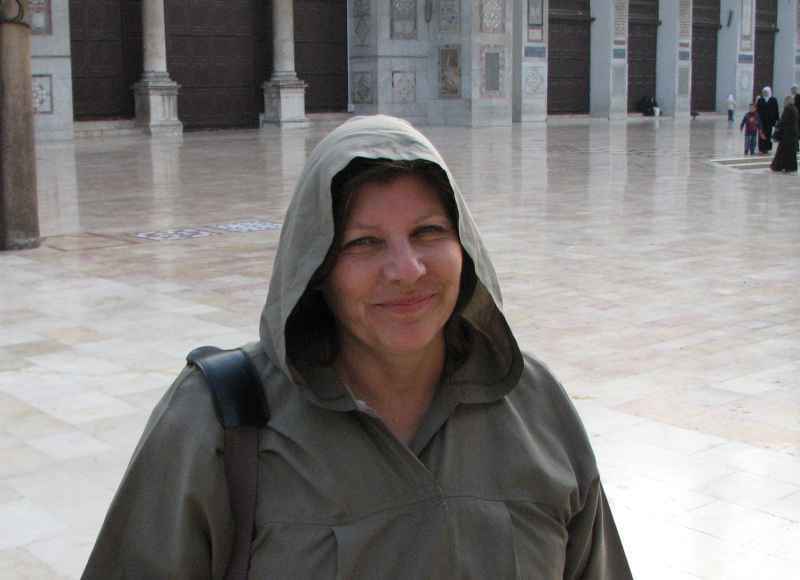
Umayyad Mosque

When we awakened to a crisp morning we found that we had company. Last night a motorhome with French licence plates had arrived. Pascal and Sophie and their two young children were taking a year to travel around the Mediterranean. After we gave the bikes a wash we had a chat with them about their trip while we slowly packed up our tent. By about noon we were finally ready to leave. Since we spent a little while standing on a street corner watching the insane traffic in central Damascus last night we were not terribly keen on riding through the centre of the city even though that was the way south to Jordan. Instead we backtracked north and with the help of the GPS worked our way around Damascus on some small roads. It was very interesting to ride through the smaller towns and see people's reaction to us. Most were stunned by our presence and simply stared. Taking these small roads with the inevitable confusion in the towns probably took a lot longer than riding through Damascus and taking the big highway south. We ended up in Bosra, a distance of only 120 kilometres, at about sunset; 4:30. When we pulled up in front of the Roman ruins we were promptly accosted by a couple of hustlers asking if we were looking for a place to stay. The Bosra Cham Palace was the only real hotel in town and these touts were trying to sell a night in a Bedouin tent. It all sounded a bit fishy since this "Bedouin" tent was located in a restaurant courtyard. We had a look at the place and it seemed OK but there was some confusion as to whether it was possible for us to stay. According to the restaurant manager the Cham Palace had some kind of arrangement that forbade people sleeping in Bedouin tents so that they would have a corner on the marketplace. So the manager called the tourist police and asked them if we could put our tent up in the garden. In the meantime Audrey hopped on her bike and rode over to the Cham where she found that they were charging $145 U.S. per night for a double. Way above our budget. The police were still considering whether to let us stay (all this via the restaurant manager) so we got a copy of our passports for them. The manager explained to them that we couldn't possibly afford the Cham and it would be dangerous to ride in the dark to Da'ra for a less expensive hotel. That did the trick and we were allowed to stay. After a delicious grilled chicken supper (which at 750 Syrian Pounds or $15 Cdn was overpriced) we chatted with Zacharia the restaurant manager for a while. He was a trained archaeologist and normally led tours of the old city. The "Bedouin" tent was occupied by someone who had a small section partitioned off for himself and the main area was used as a smoking and tea room. We decided that our own nomadic tent was much nicer so we set it up in the garden rather than roll out our sleeping bags in the smoky tent with the dirty carpets for a bed. Camping two nights in a row!
Trying to find our way around Damascus was easier with the GPS than road signs

After packing up the tent and locking everything onto the motorcycles we walked across the plaza from our "Bedouin" tent/restaurant/campground to the citadel. What makes this particular citadel unique is that it used to be a theatre capable of holding 6,000 people. The Roman theatre was converted to a citadel by the Arabs by building a perimeter wall with a moat. Back at the restaurant we enjoyed an omelette for breakfast and then rode to the Jordanian border, about 40 kilometres away. The stamping out of Syria portion of the border crossing went quickly without too much fuss and on the Jordanian side there was only a little running around to get it all straightened out. The whole process took less than two hours, including a lunch break on the Jordanian side. The initial impression of Jordan was that the standard of living appeared to be a bit higher. As usual, we had to adapt to a new style of driving, this time for the better. It seemed that the Jordanian drivers were less aggressive and generally a bit more relaxed. We had found that riding in Syria you always had to pay 100% attention. You had to watch for the other drivers, coming from every possible direction and you had to watch the road as the conditions changed dramatically in the blink of an eye. The first 100 kilometres in Jordan were very relaxing indeed.
Theatre/Citadel in Bosra

Leaving Bosra with a last look at the citadel
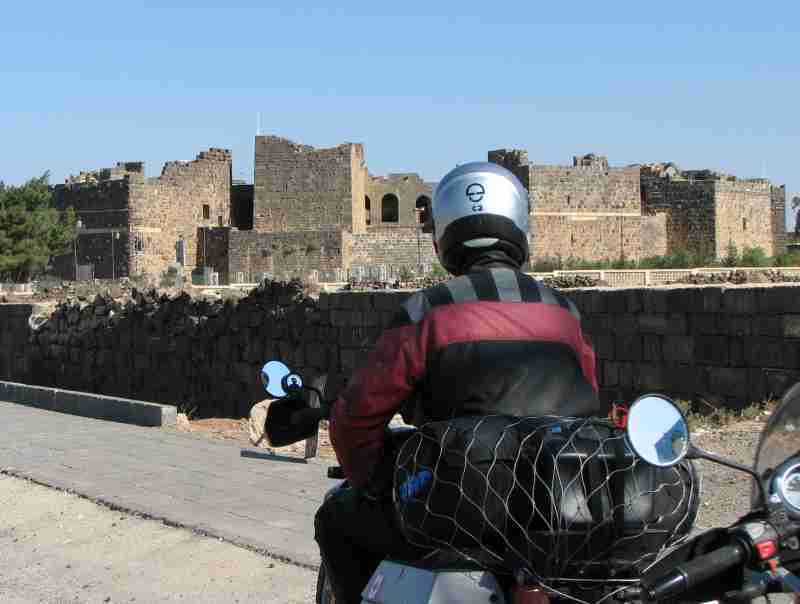
Our route through Syria
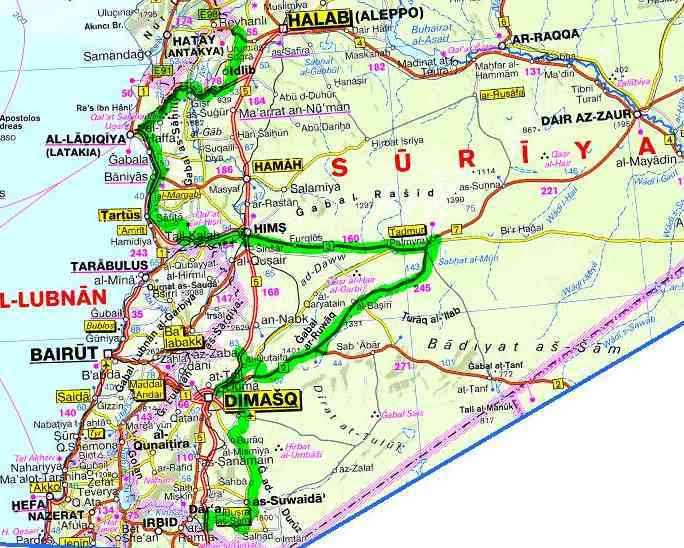
After crossing into Jordan we made it to the Roman ruins at Jerash in about an hour, at 3:00 PM, November 26, giving us an hour to see the site before they closed the park. Fortunately we had everything prepared to lock onto the bikes and put under a cover so we were inside in a few minutes. These ruins easily matched those in Palmyra for grandeur and scale. The colonnaded street was very impressive with its original paving blocks and the monumental arch commemorating the visit of Emperor Hadrian. The late afternoon sunlight gave everything a beautiful colour. Our guidebook suggested the Olive Branch hotel located 5 kilometres out of town could provide camping as well as fairly expensive rooms. One of the park police officers gave us directions to the hotel and we arrived just before dark. I don't think we would have seen the two small, rusty signs in the dark and we could have been riding around for hours. We decided to take a hotel room as it was 40 Dinar ($53 CDN) and camping was 16.50 Dinar. Too bad that supper at the restaurant was glacially slow and their internet service was down.
On to the next checkpoint after a break at the resthouse
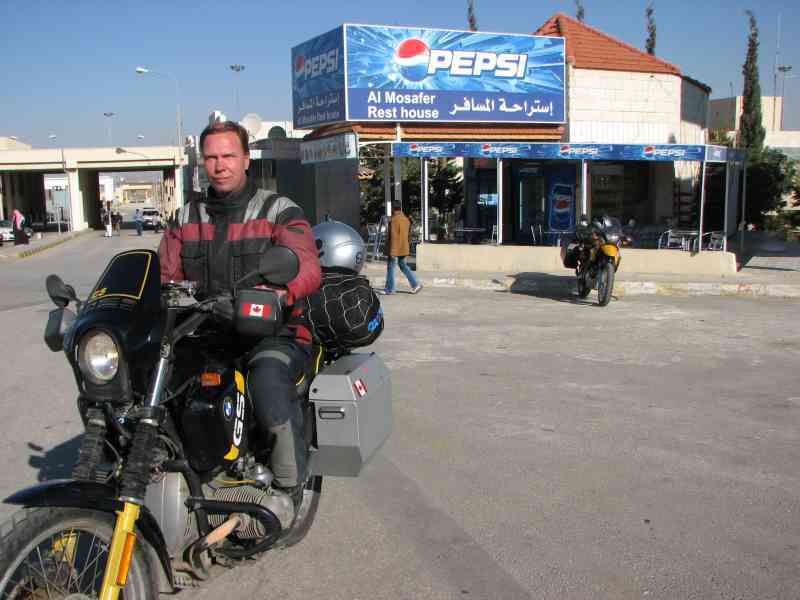
Colonnaded street of Jerash
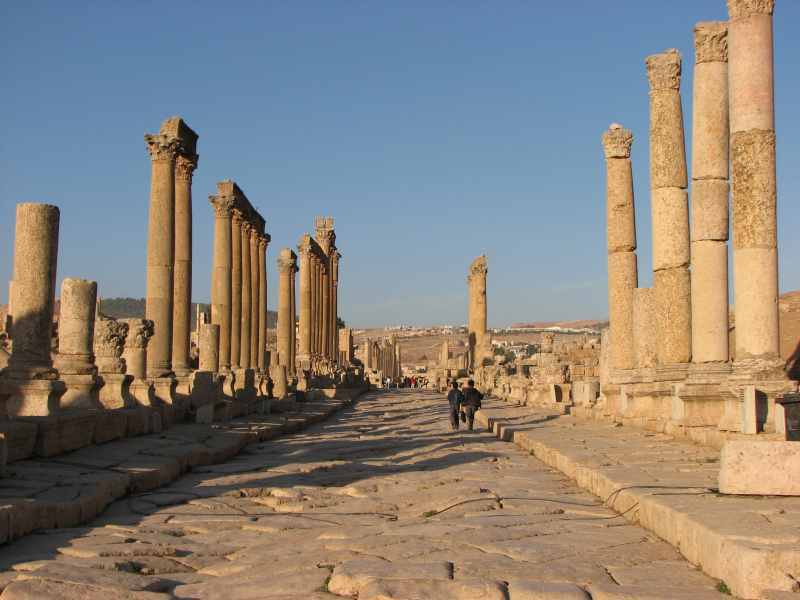
Audrey reads the book while walking amongst the ruins
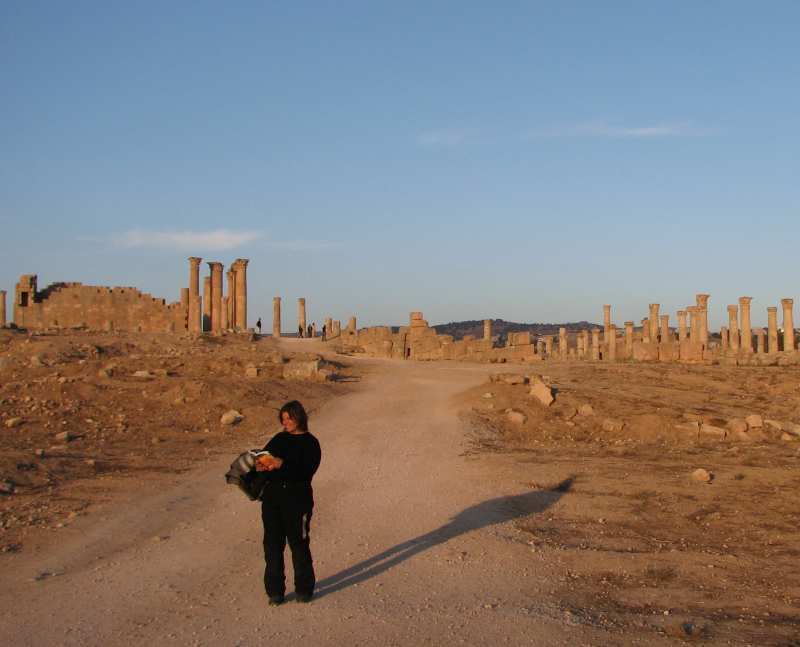
Oval Plaza

The stress of travelling had worn us out a little so we slept in that morning even though we knew we had a fairly big day ahead of us. We descended from the Olive Branch in the mountains down to the Jordan River. At one point we had a beautiful view across the valley to Israel and the West Bank while the GPS indicated that we were at sea level. The ride south to the Dead Sea was done in perfect conditions with a temperature of about 20 degrees and a light tail wind. All the while we could just look to the right and see Israel a few hundred metres away. Just before the Dead Sea we passed the site where St. John the Baptist baptised Jesus in the Jordan River. We rode down the Dead Sea 15 or 20 kilometres and back trying to find a public beach to have a swim but we didn't have any luck so we pulled into a spa. We had to pay 10 Jordanian Dinars each to get in but at least we had change rooms and showers. The water of the sea was cool but not the ice cold that we are familiar with from the Rocky Mountains. Once in the water we had a great time floating and trying to avoid splashing. The salt water stung anything remotely sensitive such as eyes, inside of the nose and in my case my freshly shaven chin. We had a bit of lunch while sitting on the beach and watching the water dry up on our skins leaving us covered in white salt. In order to beat the sunset we left the Dead Sea at about 3:30 for the 40 kilometre ride to Madaba. The straight line distance according to the GPS was only 25 kilometres, indicating that the road was very twisty. Sure enough, the climb up from the Dead Sea switched back and forth up the side of the mountain and we gained a kilometre in elevation. The best part was that the road was brand new with fresh asphalt and no traffic. Still, despite our efforts at going quickly we arrived in Madaba after sunset. We had no luck finding a hotel right off the bat so we started asking directions to the Mariam Hotel which we remembered Mike and Ruby (www.2canadiansonbikes.com) had stayed at last year. At the third stop for directions someone in a parked car overheard our query and offered to show us the way. We followed his car for a few blocks and turns and there was the Mariam Hotel sign, lit up and enormous. How did we miss this? The price was only 27 Dinars ($36 CDN) so we had no qualms about taking a room. A good, hot shower helped to wash away some of the salt.
Only a kilometre from the site of Jesus' baptism

Dead Seaside
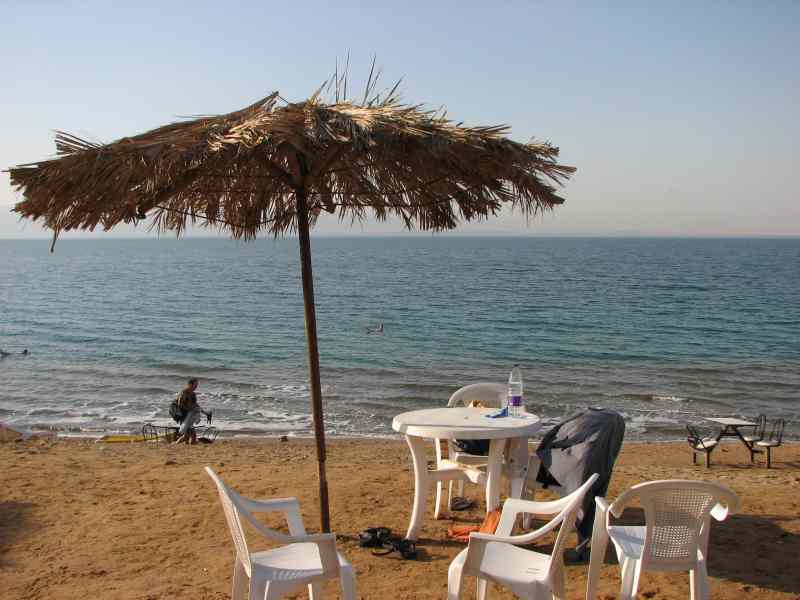
Old Salty

The lowest that we have ever been
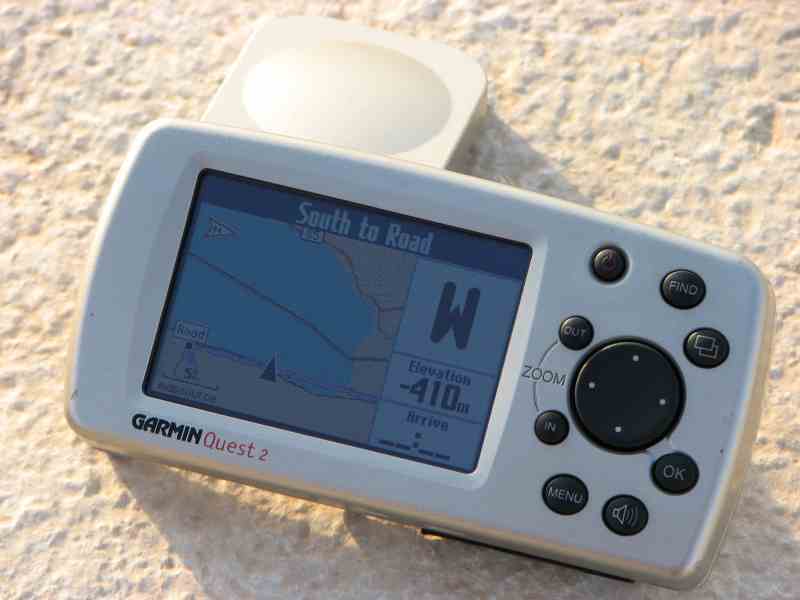
Looking down to the Dead Sea on the way to Madaba
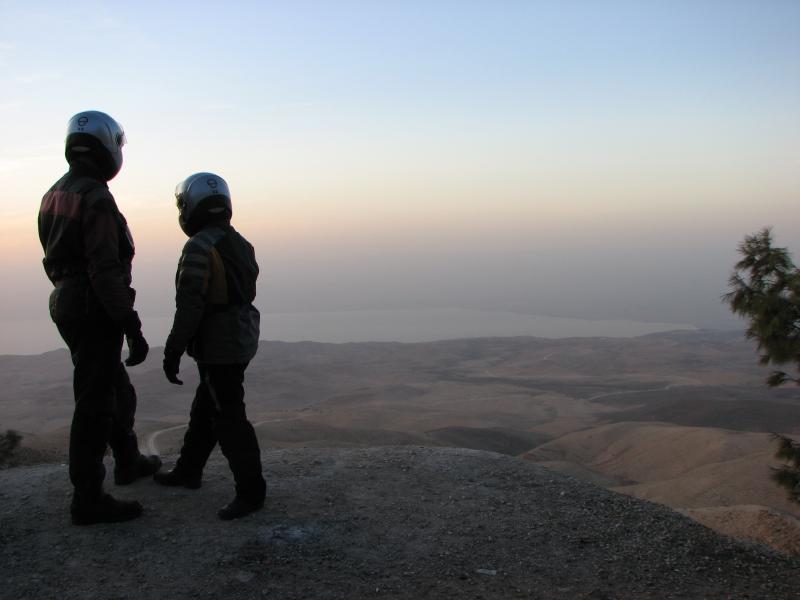
I woke up at quarter to four in the morning with a bit of a cold and vague misgivings about our trip. For some reason I wasn't looking forward to today's ride. I was almost dreading it. This should have been a dream come true; riding the King's Highway in Jordan in late November on a bright sunny day with 20 degree temperatures. Perhaps the stress of continual travelling for a month was catching up with me.
Breakfast at the hotel was a buffet and had on it crepes and "stroop", a Dutch syrup. Yummy! We walked to the Greek Orthodox Church in the centre of Madaba to view the remnants of an ancient map. The map was a tile mosaic on the floor of the church and showed the Jordan River, Dead Sea and Jerusalem. We were riding the King's Highway by about 10:00 AM. The highway, which is one of three major highways in Jordan, runs high up in the mountains between the Dead Sea to the west and the desert to the east. The highway has to cross a couple of really deep wadis, or valleys, and the views were simply spectacular. The twisty curvy road was a lot of fun on the bikes too. At Al Karak stands an enormous crusader castle. Since it was lunch time when we arrived, we parked the bikes in front of the King's Restaurant, had lunch, and then went to explore the castle ruins. If it wouldn't have been so hazy we should have been able to see the Dead Sea in the distance, as it was we had to contend ourselves with breath taking views down the sheer drop into the valley below. We left Karak at 2:00 PM, hoping to make it to Petra before nightfall. Another giant valley and numerous towns slowed our progress so that we didn't arrive until 5:00 PM. As Wadi Musa, outside of Petra, exists mostly for the tourist trade we had no trouble finding a hotel. The Petra Palace was within easy walking distance of the entrance to Petra, though judging by the tired, dusty people walking back from Petra it might not be so easy after a day of exploring. The hotel was a bit above our budget but we thought it would be nice to have a bit of a treat.
The sun beam points to Jerusalem on the 6th century map

The road down to Wadi Mugib
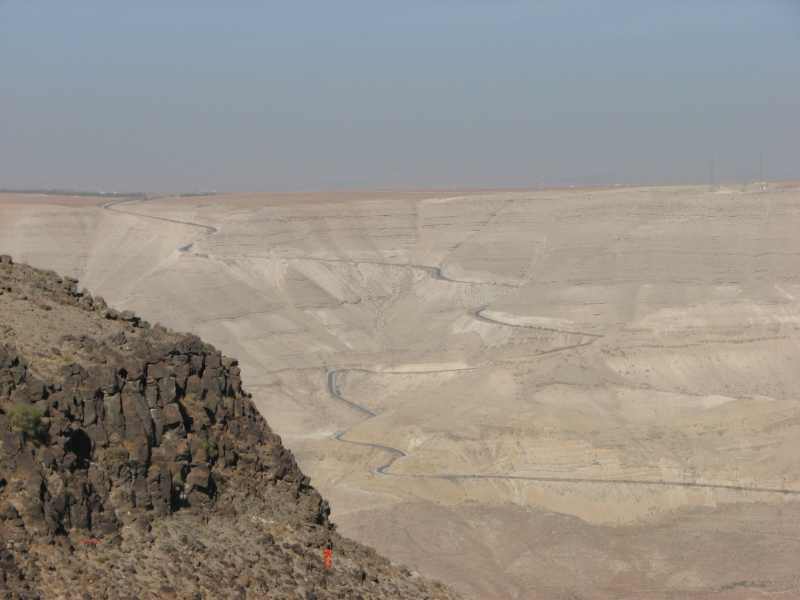
Riding back up the other side

Al Karak, Crusader Castle

The haze means we don't see the Dead Sea in the distance
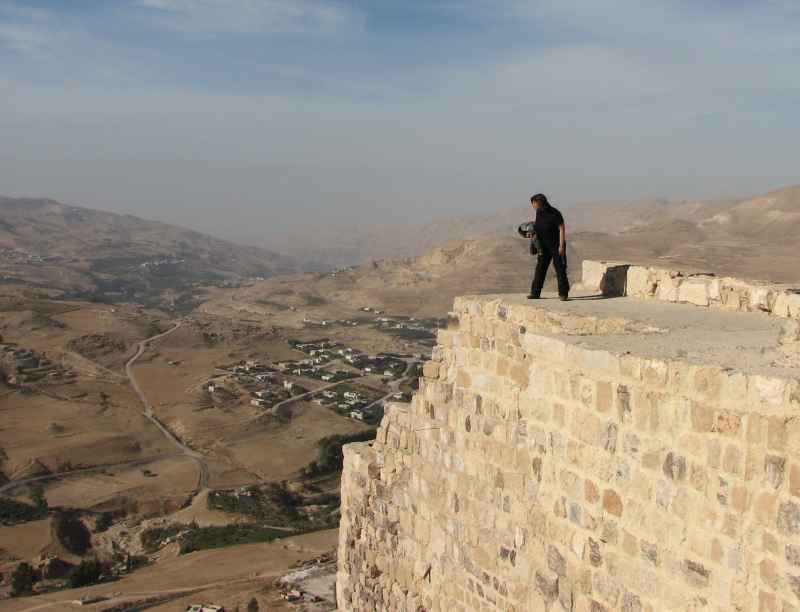
Sun sets as we ride to Petra
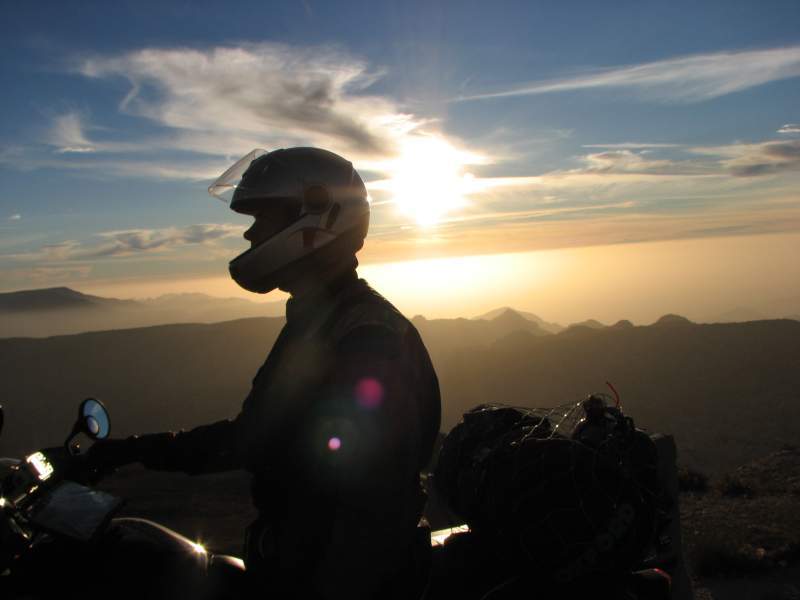
If it wasn't for the towns along the route, today's ride would indeed have been a dream come true. It was warm and sunny, traffic was fairly light and the road was mostly in good condition. In the towns though children pelted us with rocks and even threw sticks at us. They were always jeering us with a sarcastic shout of "Hello!" and generally taunting us. Other drivers on the road frequently flashed their headlights at us, though I have no idea why, and honked their horns. We couldn't tell if these acts were done in anger or if they were simply happy to see us but it was irritating nevertheless. Combined with tricky navigating (it doesn't help when most of the directional road signs are plastered with posters) in the towns, I just started to wonder if I was really cut out for this riding around the world business. Maybe I should stick to the first world and leave third world travel to the more adventurous types. Jordan should have been one of the "easy" countries. What will Egypt be like? Hopefully this funk was the result of the cold and a month of continuous travel, because it certainly didn't seem like my usual upbeat self. I hope that by the time we get to the more difficult countries I'll be able to keep Audrey's spirits up as she has kept mine up.
Audrey writes:
It was with great anticipation that we approached the gates to Petra, a five minute walk from our hotel, the 'Petra Palace', a splurge at $80 per night. After brushing off touts trying to sell us horse/camel/donkey/carriage rides, we wandered into the Siq, a canyon with pinkish sheer cliff rock walls. We could just imagine Indiana Jones galloping his horse through here in "Last Crusade", but more importantly, the 1.2 km canyon hid the ancient city until sometime in the 19th century. If the Bedouins were unhappy about their secret being discovered, then it was certainly atoned for by them now collecting high entrance fees (20JD, ($26)) and a chance to sell souvenirs to tourists. A Nabatean aqueduct lined the wall of the Siq, and the water flowed all the way to the Nymphaeum fountain in the middle of the city. Apparently a dam had broken here in the 1960's, and there was no escape for 35 tourists. The pathway was fairly flat because the Romans had built a cobblestone road on it after they conquered the Nabateans.
Souvenir shops at the entrance to Petra
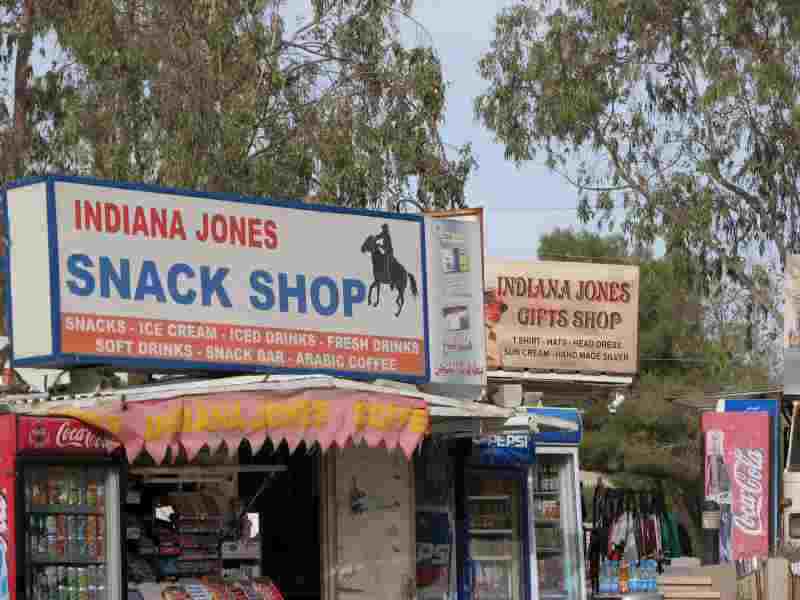
The Siq

Aqueduct carved into the side of the cliff
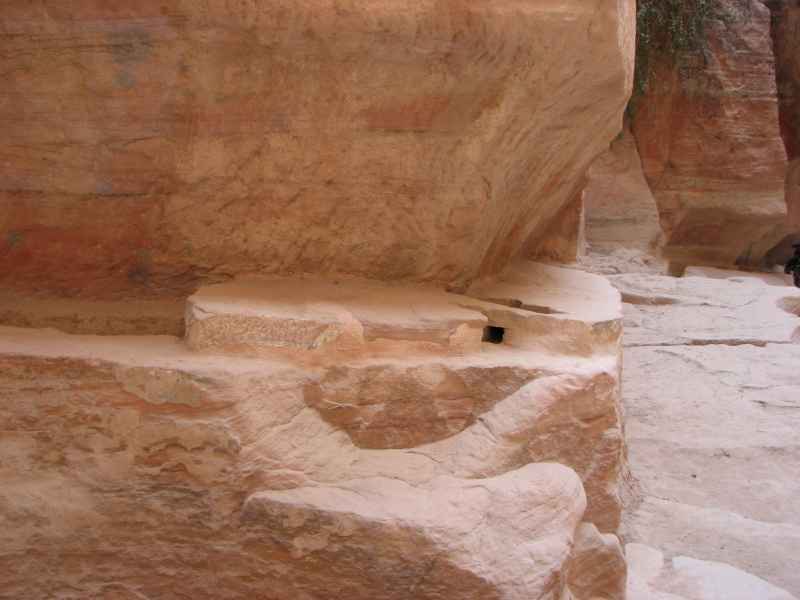
Having seen pictures of Petra before, we knew the Treasury would be the first thing we would see as we came around the end of the canyon. With every corner, we looked around tentatively, wondering if this would be the big moment. Finally, a mere sliver of the gorgeous pink structure appeared through the canyon. We just looked at each other, speechless and breathless, knowing it was one of those, "Ah, so this is what it's all about" moments. Enduring rock-throwing kids, dodgy food, questionable accommodations, suicidal, reckless drivers and pestering touts did not seem to matter so much at this moment. As the Treasury came into full view, we just stopped in our tracks and took it all in. The pink coloured stone was perfectly highlighted in the morning sun. This 'building' and all the details, from the thick pillars to the eagle statues on top, had been carved out of the side of the cliff. Nabateans used Syrian, Greek, Roman and Egyptian designs, and we recognized Corinthian and elephant head columns from other empires. Somehow the hubbub of crowds of tourists, camels, and jewellery sellers took nothing away from the feeling of awe at being in the vicinity of this wonder. Pictures cannot do it justice.
Our first glimpse

A little more
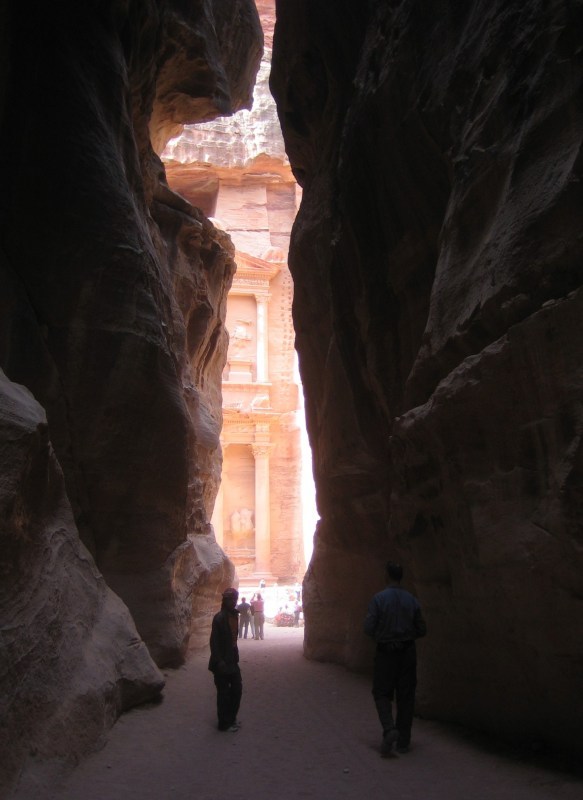
Finally, the Treasury

Unbelievable to be here

Unbelievably there is a lot more to Petra than just the amazing Treasury. Tombs line the high canyon walls, there's a Roman theatre and colonnaded street, Byzantine Church, temples, Crusader forts and tonnes of rubble. A person could spend days wandering and still not see it all. We made one very full day of it, and endured near cardiac-arrest while we climbed up hundreds of stairs to the high point of sacrifice. We're hoping it was just animals sacrificed here, but the blood-collecting basins were quite huge, so you never know. After enjoying a bottle of water in the company of some British tourists, we headed down, past the Lion monument, Garden and Soldiers' tombs, to the other side of the city. As we were walking down, we heard a cell phone ring, and a tourist riding a donkey answered it. Quite a funny sight, a cell phone and donkey, but then we heard him say, "Oh, nothing", and we both broke out laughing, wondering if the question asked of him had been, "What are you doing?" He was riding a donkey up the side of the cliff at Petra, for goodness sakes!
Climbing to the High Place of Sacrifice

At the top (safety guard rails seem to be missing in Jordan)

A lot of steep steps

"So what are you up to?" "Oh, nothing."
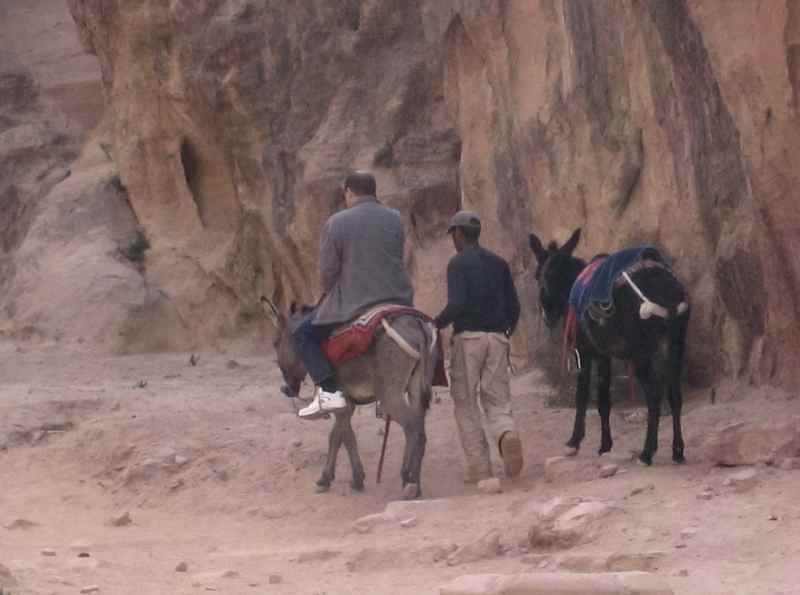
It was a beautiful sunny day, quite ideal really, and made for some pleasant exploring. After a buffet lunch, set up for tour groups but letting us join in for 6JD, we wandered through the museum, seeing a few artifacts of the Nabateans. We recognized a lot of statuary that we had seen in Calgary, when the Petra exhibit was at the Glenbow, so that was interesting.
Spectacular colours in some of the tombs
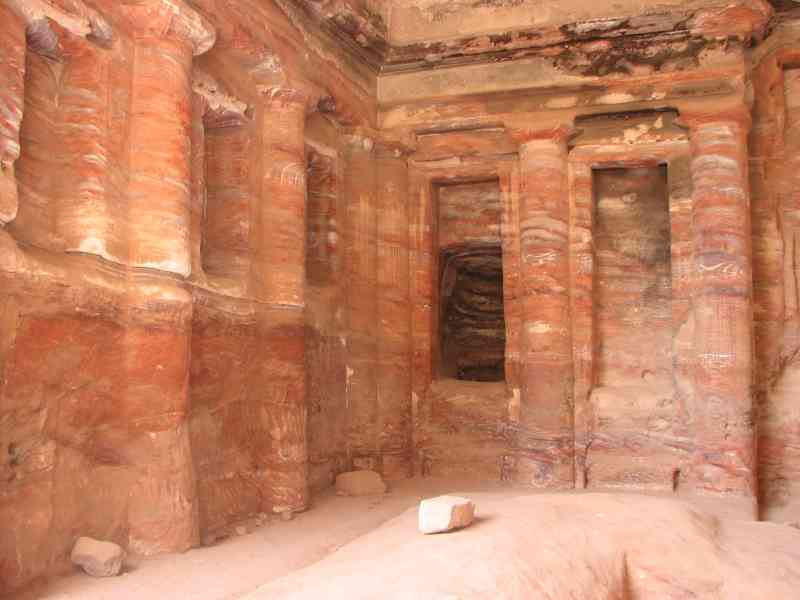
The Great Temple of Petra
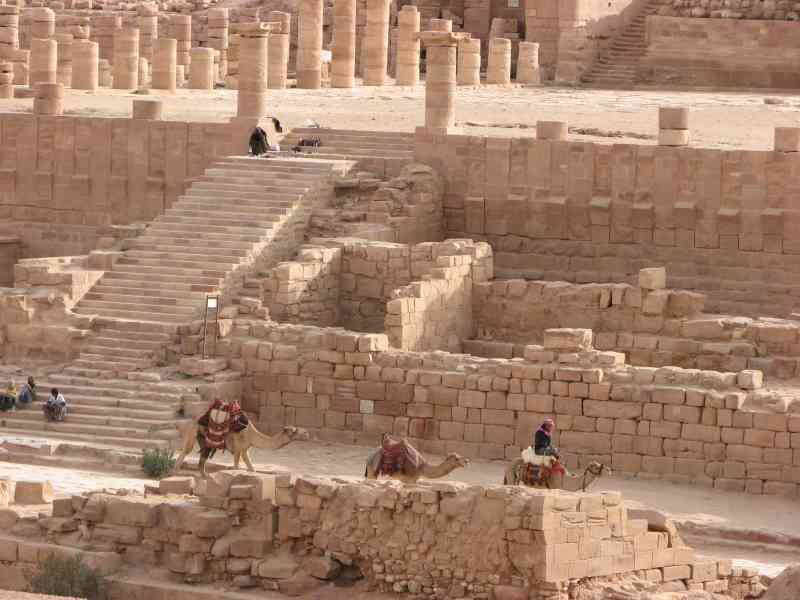
We had to have a souvenir of Petra, so we honed our haggling skills and approached a trinket stand of a senior Bedouin citizen, hoping to make her happy by separating us from some of our money. In these situations, you cannot act too interested in the items and not look at any one item for too long. After picking out about four things, and doing our secret nods or head-shakes to each other, we got the initial price. After a little back and forth, she was standing firm at 23 JD for a teapot, bronze statue, stone carving, and oil lamp, so I just threw another statue onto the pile and offered 20 JD. She was very emphatic with her "La" (no). We knew the time had come for the pretend 'walk away', and we did so. She immediately called us back, gave us all the stuff and took our 20 JD. But you still always have that niggling feeling that you've paid too much. We tried our skills at other stands, buying a few Christmas presents for family at home, and always it came down to us giving a final offer, being rejected, walking away, and then being called back again to pay our final offer. What fun!
Royal tombs on the other side of the valley from the blue columns
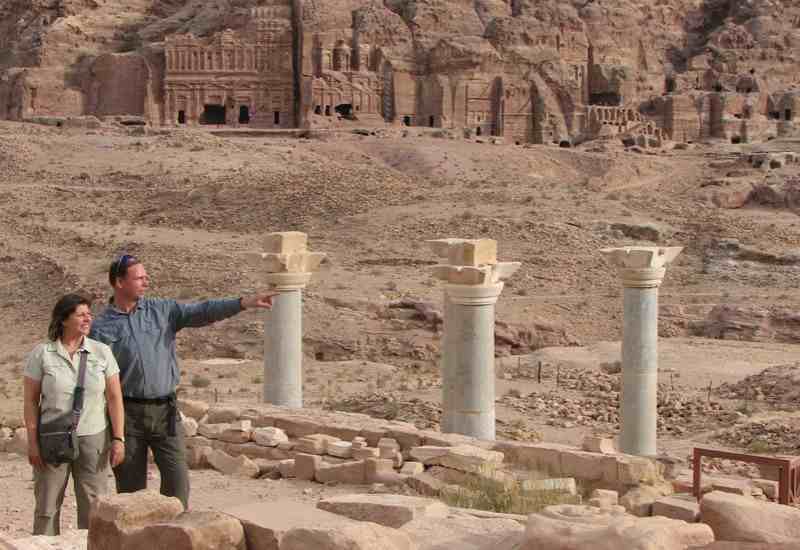
Any civilization that puts ice cream sundaes into a mosiac is OK by me
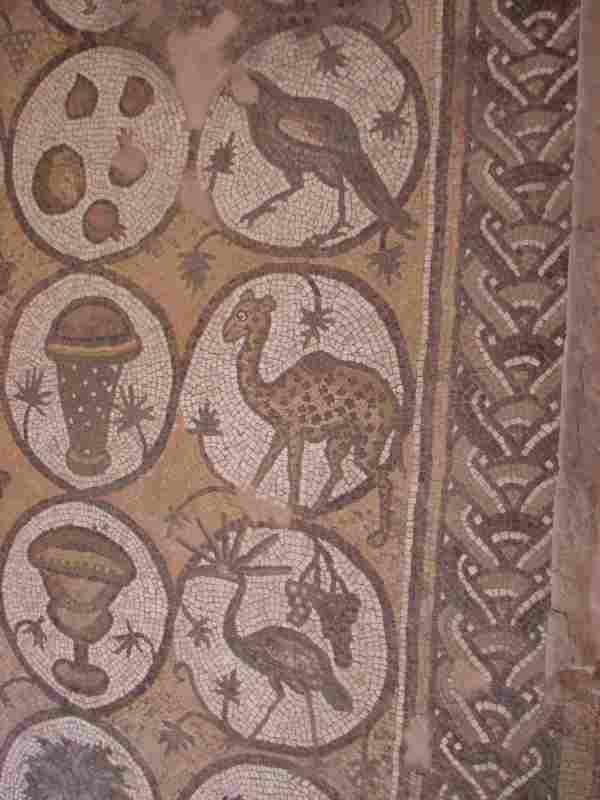
Hours of wandering took its toll on us, but it was a happy fatigue. After watching the sun set on the Royal Tombs, we walked back through the Siq just as it was becoming dark. We were two very tired and dusty travellers, trudging up the hill to the Petra Palace hotel. Thankfully Ekke summoned up some energy to go get a take-out pizza. What an incredible day.
One tired donkey
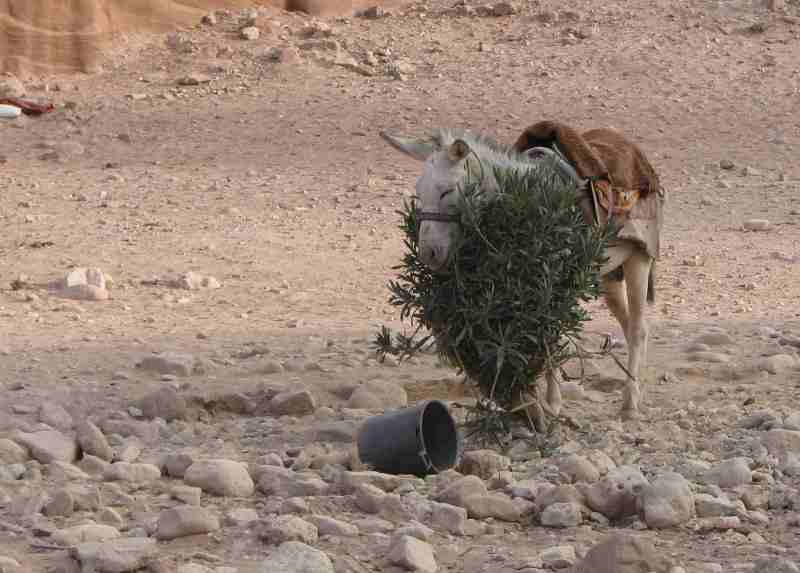
We enjoyed the excellent buffet breakfast at the Petra Palace and, wondering what adventures awaited us, rode off toward Wadi Rum. After the rock and stick throwing episodes on the ride down, I was thinking that it would be great to have a picture of one of these kids launching something at Ekke's bike, so I had my camera at the ready, on a string around my neck. But, alas, it was Friday, the holy day, and there wasn't a single gang of school children in sight. After a very uneventful but pleasant ride in the desert, we came to Wadi Rum, an area famous for pink desert sands, sheer cliff structures, and plenty of climbers and off-roaders. They've really got this tourist thing down as we couldn't get near the townsite without paying a fee to get through the gates. Wadi Rum is just a dusty little town with small boys leading camels around for tourists to ride and other children just hanging out and asking for dinars (money). A 'Resthouse' offered little brown tents to sleep in for 3 JD per person, but after realizing the zipper didn't open or close from the inside, we happily set up our own tent. We dined on grilled chicken and salads at the restaurant with some French and German climbers, and then called it a night.
Caution ahead
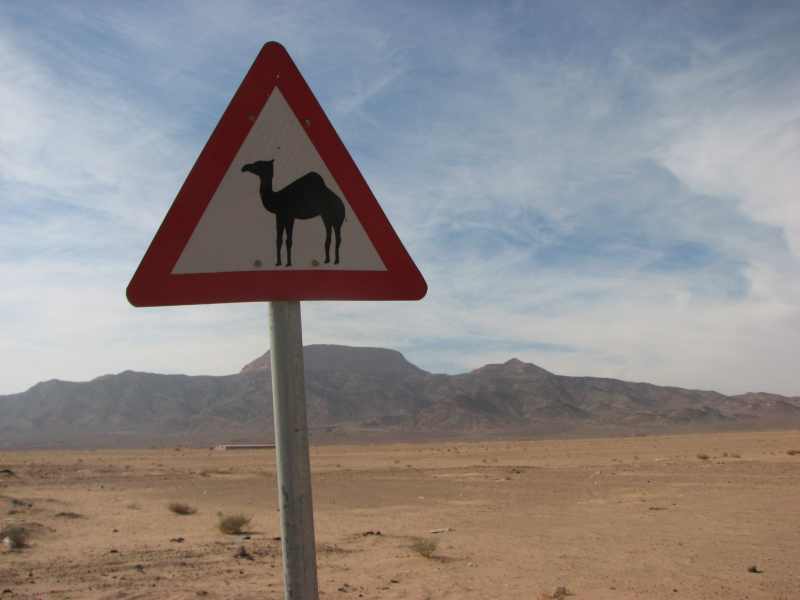
Yep, wild camels (and they were exactly where the warning sign said they should be!)
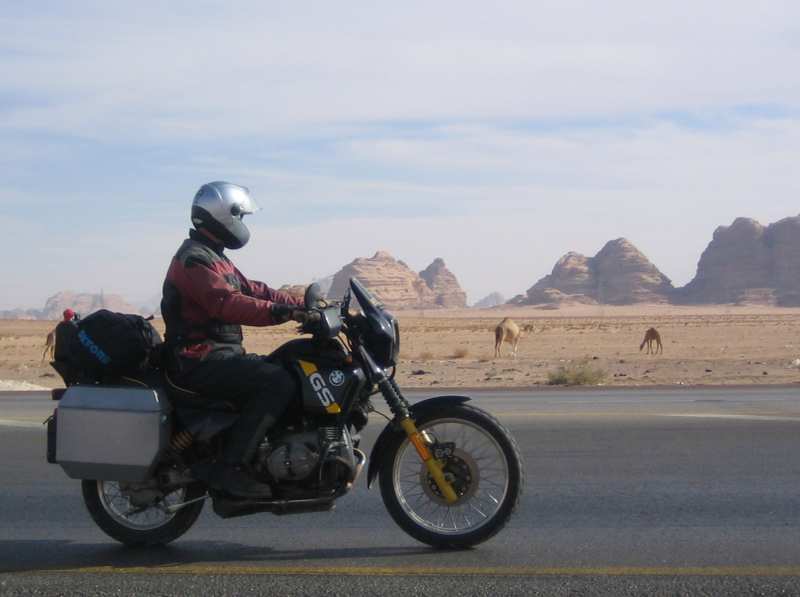
Getting closer to Wadi Rum
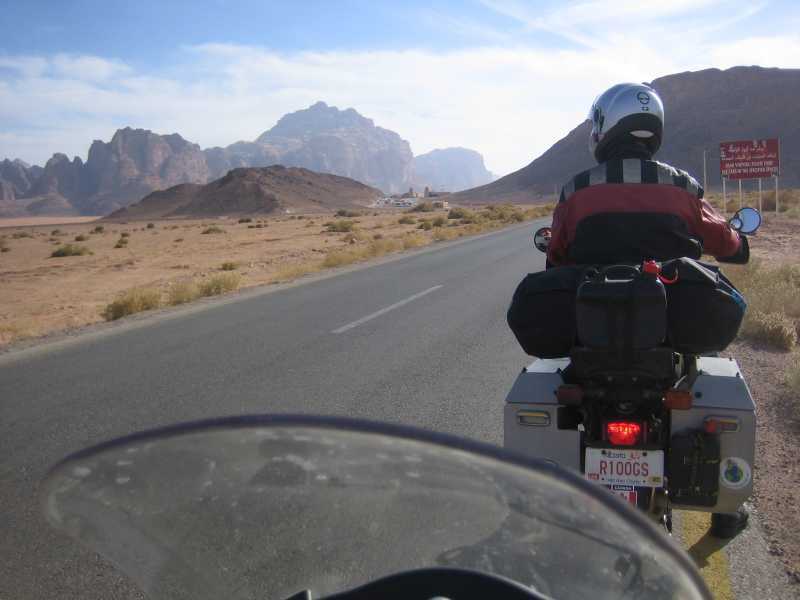
The Seven Pillars of Wisdom mountain named after T.E. Lawrence's book
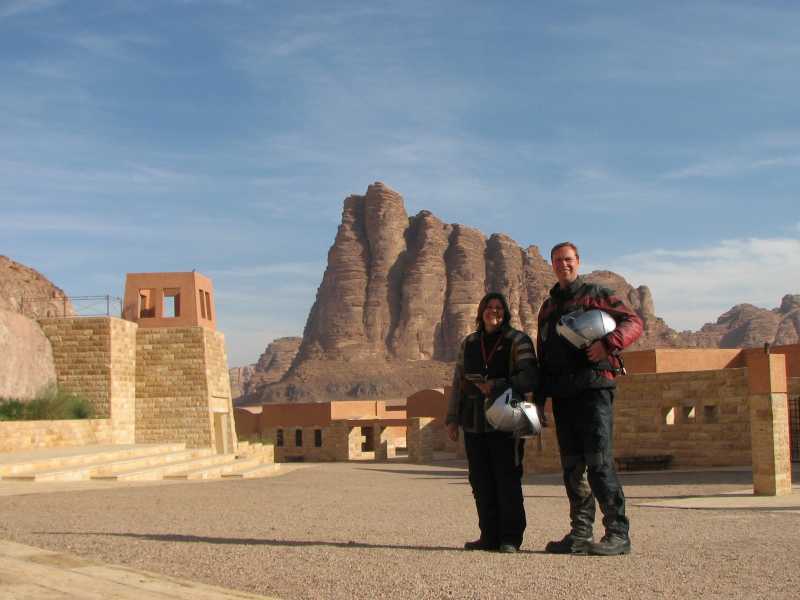
Good paved road

Road ends at Wadi Rum village
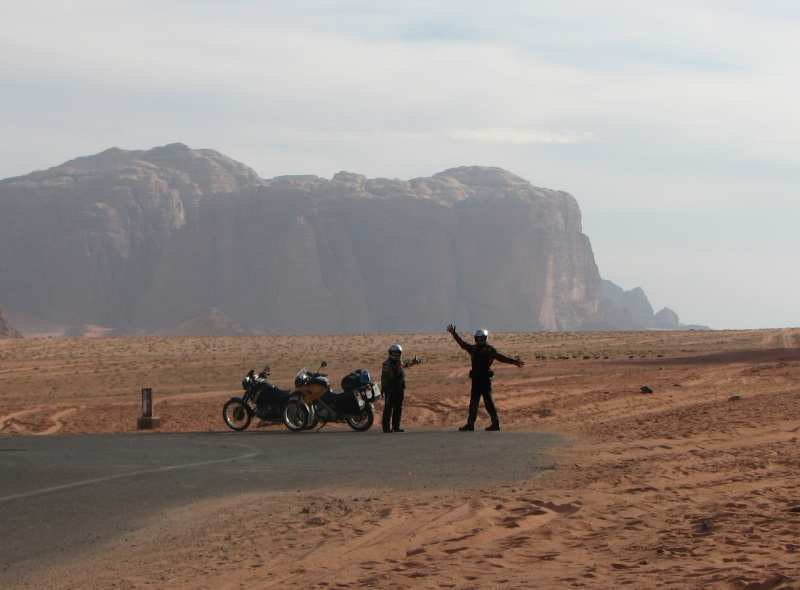
A hike to Lawrence's (of Arabia's) Spring was just what we needed after sitting on a motorcycle for so long the previous couple of weeks. As legend has it, Lawrence stopped here to refresh himself and have a nap. Sand walking was slow going and I could have used a bit of a nap myself, but we were surprised at how far we were able to get and what fantastic rock structures lay just around the next corner. A British hiker had gotten lost the previous day and had luckily been picked up by a Bedouin in a jeep, 20 km from where he thought he should be. An unprepared night in the desert would not have been fun as temperatures dropped to 12 C. Distances were so deceiving here, and you could walk toward a rock mountain for ages and it wouldn't get any closer. After a few hours of hiking, we packed up the tent and headed for Aqaba, the port where we would catch a ferry to Egypt. Ekke had some GPS points for the Bedouin Garden Resort, which offered camping, and he found it without any problems. It was easier just to take the hotel room (16 JD), then enjoy some time sitting by the pool, watching the boats on the Gulf of Aqaba.
A morning walk in the desert
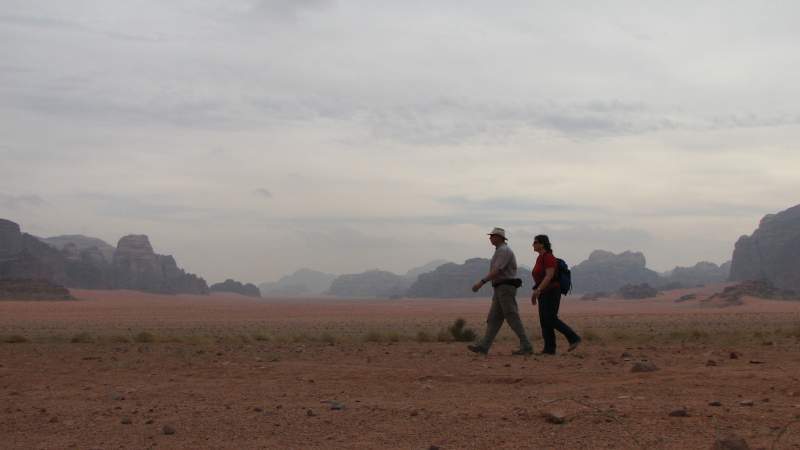
Poolside at the hotel (10 km from Aqaba and only 7 km from Saudi Arabia)

Views of the Gulf were spectacular the next day, the sun glistening on the blue waters and golden sands. A pleasant ride took us to the ferry station where we wanted to check ticket prices and times for next day's ferry. Big mistake. The guards let us in throught the gates after checking our passports, and this should have been our first clue that we were essentially out of Jordan. We got very little information from anyone in an official capacity, but a British traveller said the boat was $60 and left around noonish. So, we then headed out a different gate, a little worried because we didn't know if our Jordan visas expired that day and whether they would let us back in or not. The officials checked our passports, visas, driving paperwork, and carnets. They didn't seem very nice about things as we tried to explain that we were just visiting the ferry station for 10 minutes and had not just come on a boat from Egypt. What a hassle, but they eventually let us ride away. The GPS led us to the Egyptian Consulate in Aqaba where we filled out a form, gave a photo and $15 each, waited an hour, and had our Egyptian visa - easy. We had heard stories from Mike and Ruby about inefficient Egyptian border crossings, so we were pleasantly surprised with the whole procedure. After dropping off our laundry at a dry-cleaner's (the first non-handwash since Istanbul), we wandered to the Intercontinental Hotel to do a bit of shopping and have a $5 cup of tea. Every now and again it's good to have some 'Western' culture for a bit of normalcy. Laundry wouldn't be ready until 7PM, so we wandered around Aqaba, visiting Ayla's Castle ruins, checking out some shops, and watching the sunset from a beachside cafe.
Sunset at a beachside cafe

A gingerbread house being built at the MövenpickHotel
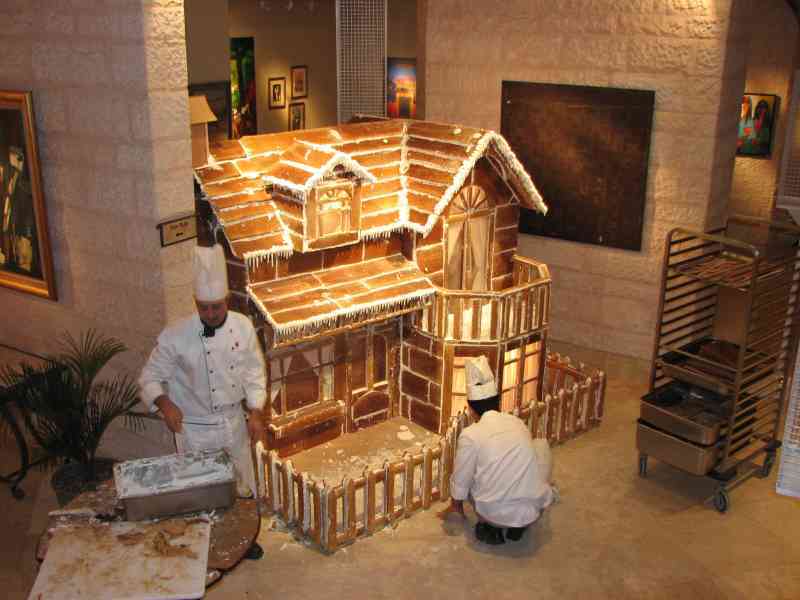
A beautiful blue-sky day awaited us as we headed to the ferry station. We met a few Canadians on their way to Egypt, and a couple of Swiss cyclists who were on their way to Yemen. We were just about to drive onto the ferry, but a last check revealed that we didn't have all the correct paperwork. An official had lost one of my bike papers, redid it, then accidentally did Ekke's paper instead. So Ekke had to jump on his bike, ride back to the office, and get the new sheet, with a little bit of concern that the ferry would take off without us. Trevor, a backpacker from Calgary, also found he had to go back to get his passport exit stamp, so we were in good company. The ferry was packed and as we looked around for a seat, a waiter came over, and led us to some preferential seating at the front, with plenty of legroom for Ekke, and close to the other Westerners. Very strange. We realized that we were on the fast ferry, and it was all a very civilized experience, with a hot lunch served to us for less than 4 JD ($6). As we sailed out of Jordan, with Israel on the right, and Saudi Arabia on the left, we couldn't help wondering about the potentially difficult, frustrating, time consuming and expensive border crossing that awaited us in Egypt.
This could be a challenge at the Egyptian border

Map of our route through Jordan
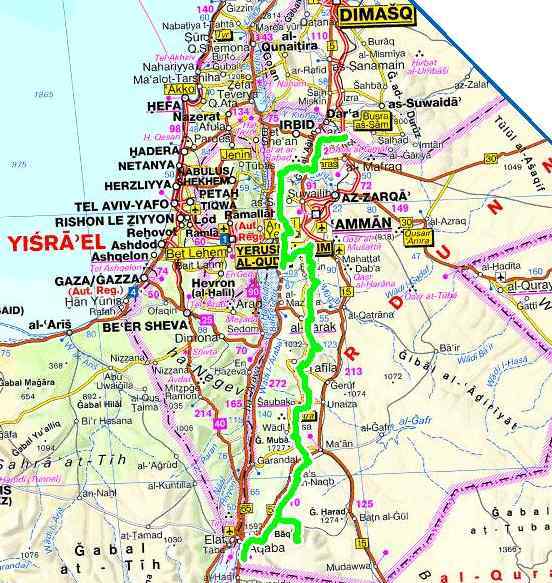
The third of December we took the high speed ferry from Aqaba in Jordan to Nuweiba in Egypt. We had expected to take the slow boat since we thought the high speed boat was for passengers only but cars were allowed on it. We arrived in our eleventh country at about 3:00 PM and then waited about half an hour at the docks before everyone could get off. Once off the boat the bikes were subject to an X-ray and then we rode towards customs. A Tourist Police officer flagged us down and much to our surprise he had some forms that we had filled out on board the boat. We had been dreading the Egyptian border crossing ever since Audrey's licence plate was stolen and we had to have the Carnet de Passage changed. Even Michael Martin had said we should get a new carnet before going to Egypt. In addition to that hurdle, everyone we had spoken to or had read about said that the Egyptian border crossing is one of the most difficult. Imagine our surprise then when the Tourist Police officer guided us along every step of the way. It may have been one of the easier border crossings on the trip. At other border crossings you were expected to know which person to see at every step but now the Tourist Police took us everywhere we needed to go and in the correct order to boot. After paying a total of 1,800 Egyptian Pounds (about $350 CDN) for customs fees, insurance, photocopying and licence plates we finally got out at about quarter after five. Since it was dark we looked for a place to stay fairly close to the docks. The first decent place was a Hilton Resort. We didn't even bother going in to check the price, it looked that expensive. Further up the coast we came to the Habiba, which had small huts and a sea food restaurant. $35 U.S. was fairly steep but we were a captive audience if we didn't want to ride in the dark.
Audrey at the photocopier
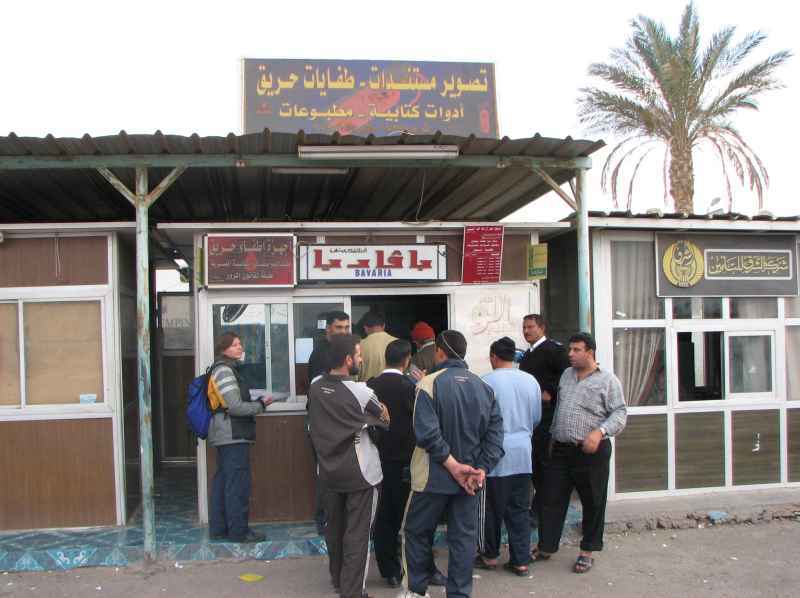
The next day we stopped at a bank machine before gassing up the bikes. We didn't fuel up in Jordan before we left and had over 400 kilometres on the tanks. Despite Audrey's bike being on reserve the total for fuelling up both bikes was 52 £E or about $10. At 22 cents per litre Egypt was in our good books for costs! The ride across the Sinai desert was terrific and we arrived at St. Katherine at about Noon. After setting up the tent at Fox Desert Camp we walked to the base of the hike for Mt. Sinai. Starting up at 2:30 gave us a couple of hours to gain almost a kilometre of elevation and catch the sunset atop the mountain. A camel driver joined us for the walk up and tried to convince us to take a camel. He was quite persistent so we asked for a ride down the mountain since it would be dark after sunset. He agreed to that and plodded along behind us. Eventually he convinced us that there was no way for us to make the summit prior to sunset and since he started work at 3:00 AM to ferry people to the top for sunrise he needed to get back down to catch some sleep. So for £100 he took both of us up the trail (at a clip that was much faster than we could have managed for any length of time) to the base of the final 750 steps. We had 40 minutes to climb to the top and we did it in 30, catching about 10 minutes of good light. Since it was cloudy, the sunset wasn't really all that spectacular except for a few minutes when the sun broke through. It was simply amazing enough to be on the same mountain that Moses is said to have received the 10 Commandments. The first half hour of the hike down the mountain wasn't too bad as there was still some light but after that it was pitch dark and we had to use our headlamps. After getting back to camp we were both exhausted and crawled into our sleeping bags very early. Because of the 1500 metre elevation it was cold at night; 10 degrees.
Riding across the Sinai Peninsula

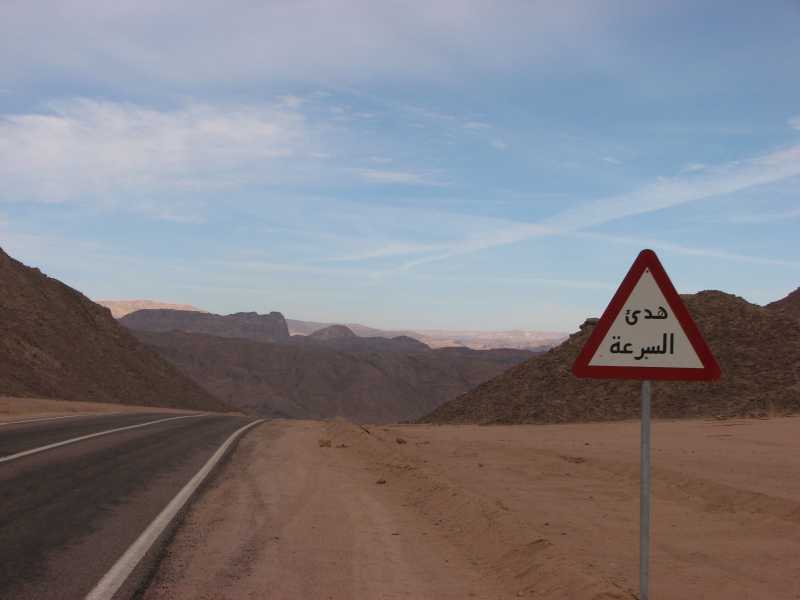
Hiking up Mt. Sinai
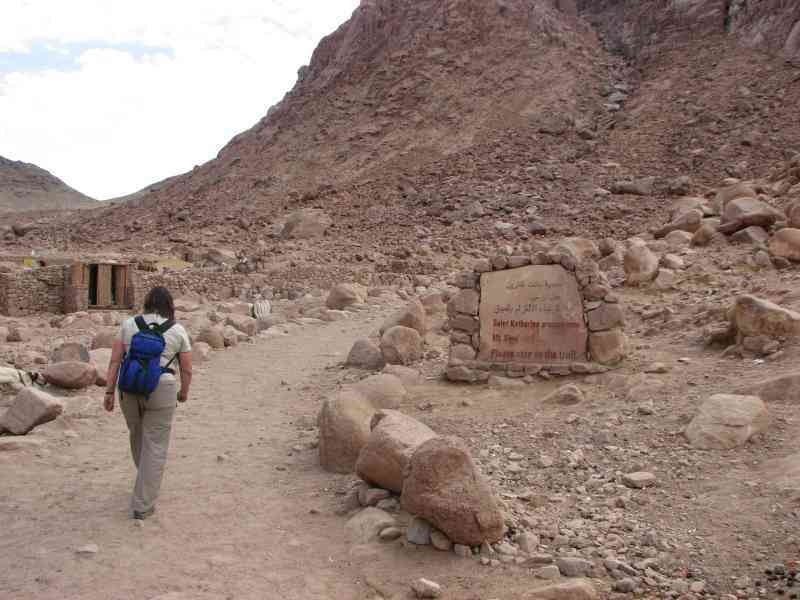
But camels were faster
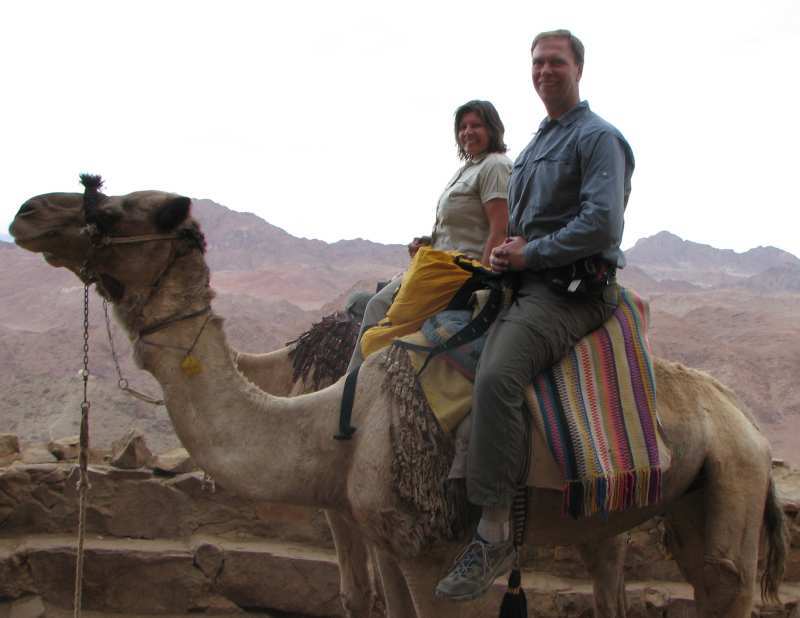
Chapel at the summit
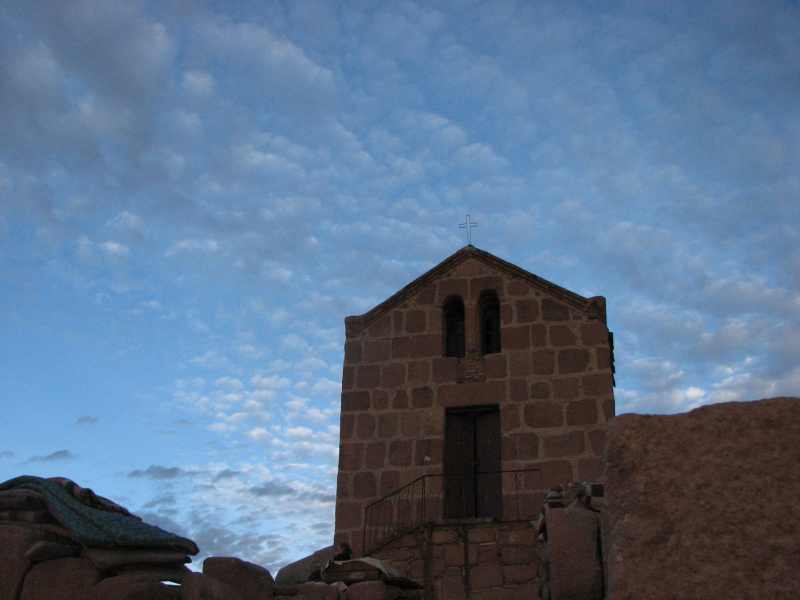
Shadow of Mt. Sinai
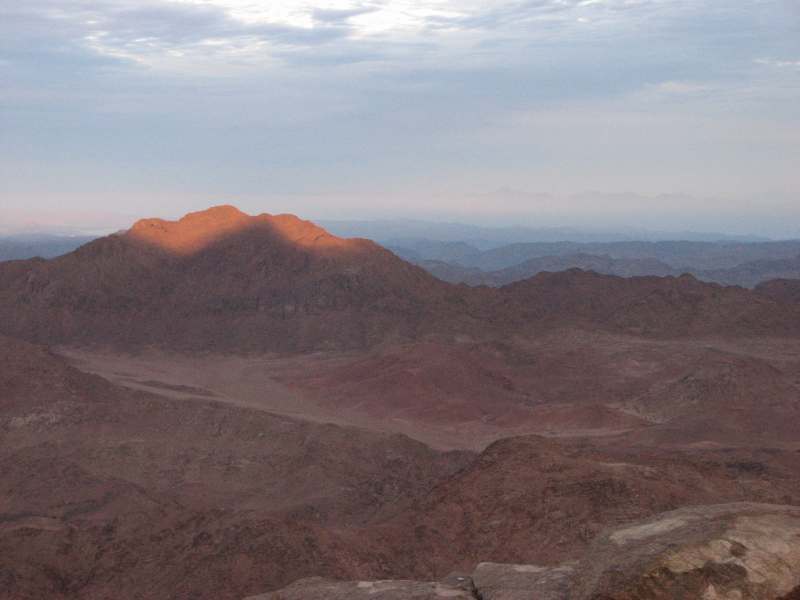
A quick breakfast of pita with jam had us packed up and on the road by 9:00 AM. Again the ride across the desert was simply wonderful (except for a construction zone) and a lush oasis before reaching the Gulf of Suez only added to the fun. Along the Gulf the traffic picked up a bit and the riding wasn't quite as enjoyable. The tunnel under the Suez Canal didn't allow us to see the engineering marvel that connects the Mediterranean with the Red Sea. We had talked about stopping in the city of Suez rather than riding straight into Cairo but it was still early in the day so after a break we decided to forge on and miss seeing the famous canal. Forty kilometres from Cairo the aggressiveness quotient of the drivers seemed to increase. All of a sudden lane markings meant nothing and drivers started to use every available road space. This behaviour was especially unnerving at highway speeds where drivers would just bull their way through with a honk of the horn. Cairo itself was even more insane but had the advantage of low speeds. There weren't too many automobiles that didn't have any scratches or dents! Thanks to our guardian angels we arrived at the Sun Hotel without gaining any scratches or dents ourselves. £120 was fairly expensive but the Sun was only a few minutes walk from the Sudanese embassy, the Canadian embassy and the Egyptian Museum. Mr. Ali of the hotel hopped on the back of my bike and then guided us to a secure parking garage a few blocks away. December 5 being Sinterklaas Avond I phoned my folks back home and was immediately very homesick and on the verge of tears. I started to feel anxious and dreaded doing the trip. This all seemed so strange. I had never had such strong feelings of misgivings before. Except for the week before in Jordan. That's when we put two and two together and noticed that my weird moods were happening on Wednesdays, the same day I took the Mefloquin anti-malarial drug. We did a little research and sure enough some side effects of the Mefloquin were panic attacks and feeling anxious. Time to quit taking that stuff!
Spectacular scenery
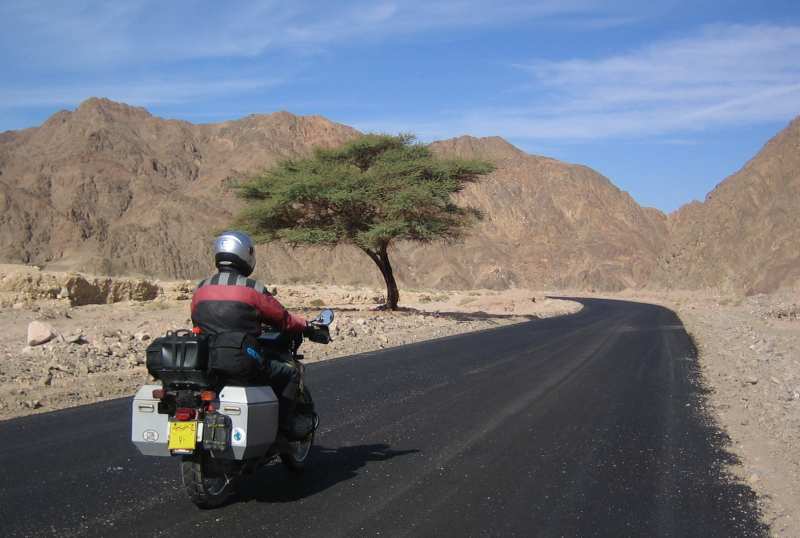
We arrive in Cairo and then it gets dark...
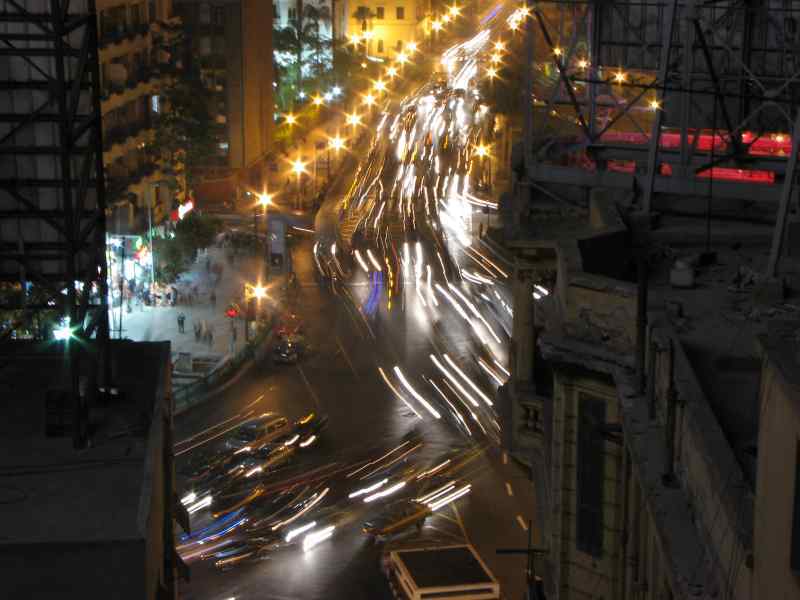
Audrey writes:
The Sun Hotel, which I had nicknamed the 'bomb shelter' due to the presence of rubble in many places, was a ten minute walk to the Sudan embassy. Tahrir Square had Metro tunnels underneath, so we could avoid the `Frogger' (70's video game) type experience of crossing streets above ground. At 9:00 AM sharp, we walked into the embassy, hoping to find Dr.Yassir Muhammed Ali, who was supposed to have our visa information from the ambassador in Ottawa. It was 9:30 AM before anyone actually came into the public office area, and after asking if Dr.Y was in, were told to come back at 10:00. We were also told that we had better complete some new application forms, so we took them with us as we went in search of a coffee shop. There was no Tim Horton's right around the corner, but we did eventually discover the Semiramis Intercontinental Hotel. Security was very tight as we had to open our bags at the door and then go through a metal detector. We had no qualms about paying 60 E£ ($11) for coffee, tea and pastries and just looked at each other, smiling in contentment. The difference between the 'bomb shelter' and this struck us immediately. Here we were in beautiful surroundings, insulated from the sounds, sights and smells of the streets of Cairo. Maybe we needed something familiar every now and again to keep us sane. Anyway, back we went to the Sudan embassy, and still no Dr.Y. Eventually, they got him on the phone, and I explained that Assim Muhktar, Sudan ambassador in Canada, had given us his name and could he help us. He said he had no information about the situation, and we would just have to start the whole process from scratch. This was very disappointing, as we had started this process in Canada, in June when we sent the Sudan embassy $200 and our application forms. Now we would have to go to the Canadian embassy here and get a letter of introduction. We had been hoping to avoid this step, not only because of the cost (E£290, $50), but because it was time consuming. Lucky for us, the Canadian embassy was a two minute walk away. The standard government 'CANADA' sign and flag greeted us, and we just looked at it, a touch sentimentally. It felt a little less like Canada inside as we had to give up our cameras and cell phones at the door and go through the metal detector. As we sat and waited, someone came over and said, "You must be Audrey and Ekke!". It turned out to be Tom from Vancouver, the Suzuki V-Strom rider who had contacted Ekke via email in Turkey. He recognized us from our website, and had just gotten into Cairo the evening before. He also told us that he had just picked up his letter of introduction, because he had applied for it earlier that morning, and was on his way to apply for his Sudanese visa. But we weren't so lucky. The official in charge of introduction letters told us there was no chance of getting it until Sunday morning, as it was now too late in the day. We were crushed. Sunday was three days away, and we couldn't even apply for the Sudanese visa until we had our letter. Our best pouts did little to move the woman behind the counter, so we walked over to the Sudan embassy. Tom was handing in his application form with his friend George, a Yamaha TT600 rider from Sark Island in the UK. George had just applied that morning, and they told him to come back at 2 PM to pick up his visa. Not fair! After a pasta lunch with George, we agreed to meet up at 6:00 and go for supper. We got the laptop and took it to the Intercontinental, hoping to find some wireless internet. The minimum we could pay was $20 for twenty-four hours, so we went for it. It was great to have time to do banking, check www.HorizonsUnlimited.com, do some emails, and check other travellers' websites. Later, we met Tom and George and went to the Greek Club Restaurant where Tom discovered that Heinekens were only E£8 each ($1.60), so we had a fun evening. An Italian rider on a rebuilt R100GS, just like Ekke's, joined us later and had just spent four hours sitting in Cairo traffic. I understood his name to be Lava (as in 'lamp'), but Ekke found out later it was Lapo. He was also on his way to Sudan. It was reassuring to know we were in good company at this point, going off into the unknowns of Sudan.
Tom!
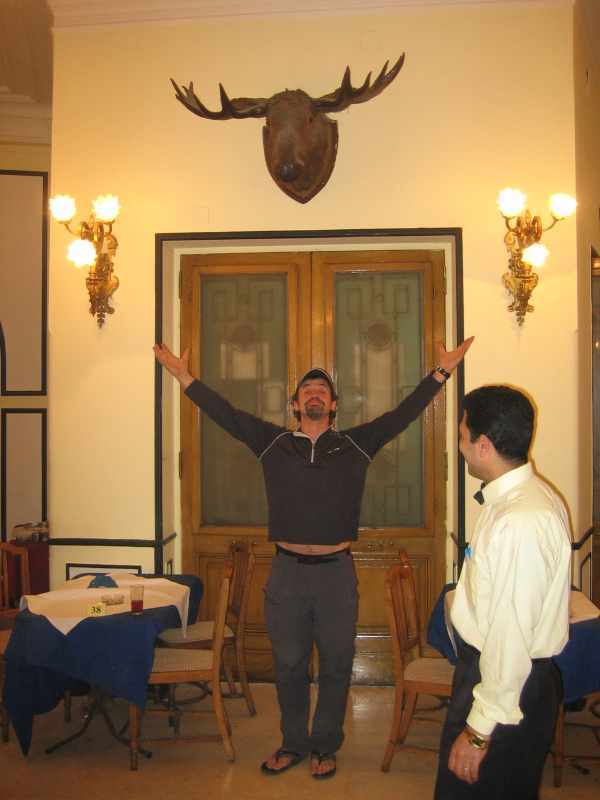
Friday, the holy day was the beginning of the weekend here, and many stores were closed. Internet was our first priority as we had a lot of hours left to use up, so off we went to the Intercontinental. In the afternoon, we visited the Egyptian Museum (E£50, $10) which really looked more like a warehouse full of dusty sarcophagi and statues. But how exciting to see the gold mask of Tutankhamen, something we've only seen in pictures up until now. It positively glowed, and was surrounded by hundreds of jewels, bracelets, pins, and statues. Apparently, the more stuff you had in your tomb, the greater the chance of having a smooth journey into the afterlife. King Tut must have had no problems because there were roomfuls of special beds, chariots, gold tomb boxes, sarcophagi, gold sandals, organ jars, and so on. It's a shame that these beautiful treasures were displayed so clumsily, often with just a small typewritten description on a crooked piece of paper. When I saw the "Whiteout" on one, I just about had a fit. I give this museum a D- for presentation. Sometimes it was just a padlock between a priceless treasure and the general public and the number of statues that were being touched was sad. We finally did see some appropriate displays, and realized that some German and Polish archaeological teams had set them up. The 'extra' fee to get in to see the mummies was E£100 or $20... each! Based on our guidebook, this price has way more than doubled in just a few years. We are held hostage to these prices because who could leave Egypt without having seen the mummies? Sure, you can buy a complete Koshary meal here for less than $2, but it's the entrance fees that will get you. Anyway, could they please take a fraction of my entrance fee and pay someone to dust the place?
No photos allowed inside the Egyptian Museum
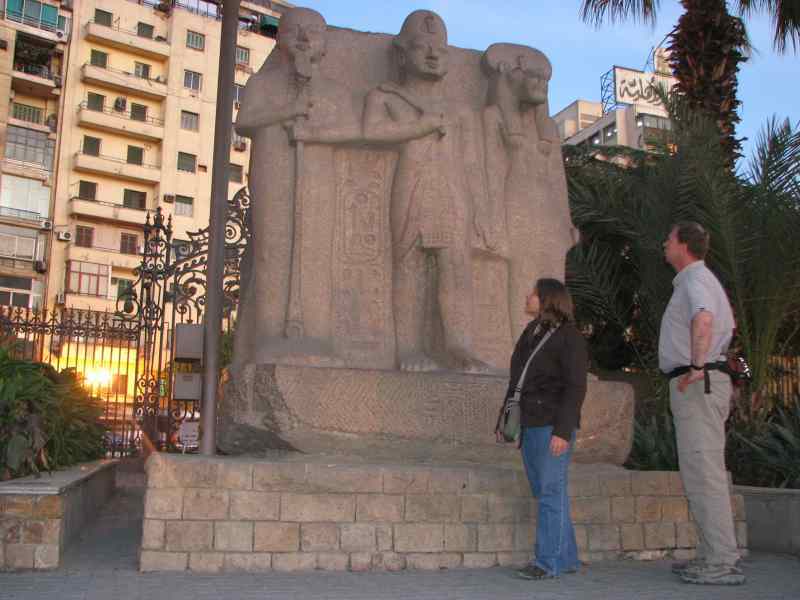
On Saturday, we caught a bus to Giza, site of the great pyramids. Good thing we had finally learned our Arabic numbers so that we could flag down the proper bus, which would have just blown by us without stopping. The road leading to the pyramids was lined with beautiful palm trees, so the half-hour bus trip was not unpleasant. We saw our first pyramid through the bus window, and it was absolutely magnificent. Another dream come true! We brushed off about ten touts on our way to the ticket office, a bit of foreshadowing of our day to come. A guy who said he was 'control' took Ekke's tickets, but it turns out he wanted to 'guide' us through the pyramids, so we promptly took them back and gave them to the real ticket-takers. The Great Pyramid of Cheops stood right before us, and we stared in awe at the gigantic blocks used to build this 4600 year old structure. The pyramid of Cheops' son, Chephren, was smaller but built on a plateau, so it looked quite impressive. It also had a bit of the original limestone covering at the top. The smallest pyramid was that of the grandson, Mycerinus. He fell in love with his daughter, so she took her own life in her distress. Her only request was that she be buried inside a golden cow and be taken out into the sunshine once per year. Fair enough, I say.
The Great Pyramids of Giza
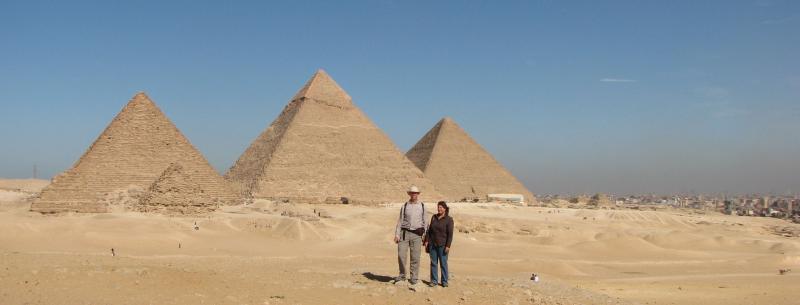
After trying to take a few pictures while brushing off camelride-sellers, we walked up to a desert plateau where things were fairly peaceful and got a great view of the pyramids. The city of Giza was right on the edge of the piece of desert that surrounded the pyramids. I'm sure someone was making sure that developments would not get any closer. We walked down toward the Sphinx, accosted by groups of school children saying, "Hello, hello" in mocking tones. Ignoring seemed the best strategy here. We bargained for postcards and papyrus bookmarks, always paying just a fraction of their initial offer. We checked out one of the tombs, and found we could crawl right into a small opening into the rocks to have a look. The sarcophagus casing was still there, and it sent a shiver down my spine just imagining a mummy lying in this place. The sunshine outside was a welcoming sight, and we had a close look at the pyramid blocks, realizing how huge they were. Someone who knows about these things estimated that it took 10 000 workers 11 years to build one pyramid. But, Pharaohs were considered gods, so they could get a lot accomplished with thousands of workers, in relatively little time, at very reasonable prices.
The shot no-one ever takes: Sphinx butt

A more classic photograph
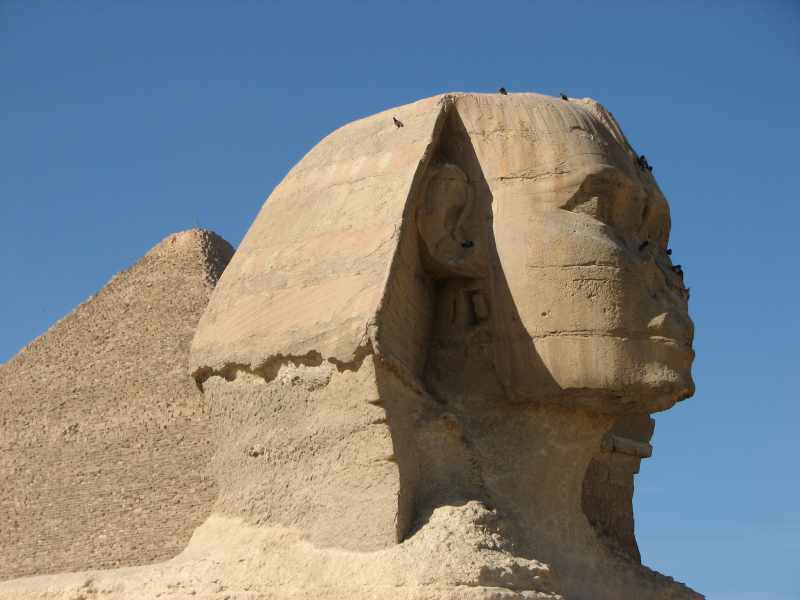
Our front row seats on the bus home were very entertaining as we watched the driver juggling fares, change, crumpled bills, tickets, and his steering wheel, all while watching for riders trying to flag him down. Bus drivers usually stopped when a passenger wanted to get off, but occasionally people had to take their chances and leap off the moving bus. We didn't get to try it, however, as the bus was stationary when we got off.
Bus driver didn't hit anyone

After picking up our letter of introduction at the Canadian embassy, we submitted our application form at the Sudan embassy. Tom, the other Canadian had still not received his visa, and was there waiting. I decided to mention our contact, Dr. Y., but the official got a touch defensive, saying he could get us a visa right away. Asserting his power, I think. After paying, we were told to come back at 2:00, and sure enough, our visa was there. We also got word that the cheque we had sent the Sudanese embassy in Canada had been mailed back to our address in Canada. What a day! Have I mentioned that $750 was missing from my bank account? I had tried to take E£4000 out at a bank machine, which said insufficient funds and money didn't come out. But we were stunned to learn that the money had been debited from my account anyway. We thought that we would never see that money again. But, luckily I had a contact at the Bank of Montreal in Calgary, and Diane was able to look into it. What a relief to see that the money had been returned to the account.
Surf and Turf Cairo style (McDonald's had free Wi-Fi!)
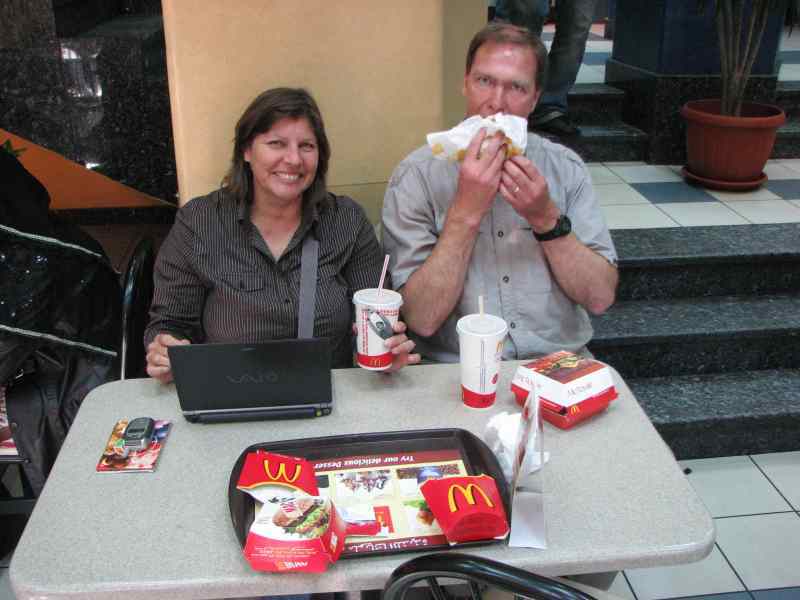
Monday, December 10th was spent packing up cold-weather clothing, and mailing it back to Canada, along with a few souvenirs. We had attempted to do it the day before, but it's impossible to get tasks like this done in a short amount of time. Finding boxes, tape, the post office, and the parcel office took most of the day, which meant that we had to stay another day in Cairo.
The bikes had been left in a parking garage, and after having the usual arguments about the price (they were trying to charge us for an extra day), we rode off in the direction of Giza. It was worth paying the $10 entrance fee to the pyramids, just so we could take some pictures with the bikes. A guy was even selling sheik headware, so we bought a couple for $.50 each, and looked really silly and touristy while we posed for photos.
Looking very "sheik"



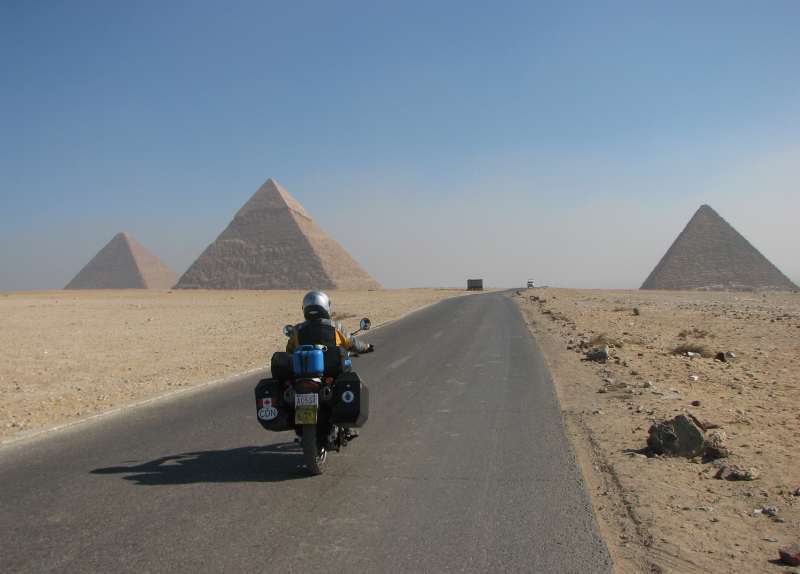
Ekke and the GPS led us easily out of town, and we were immediately in another world of donkey carts, fresh meat hanging from small shops, camels carrying huge loads of reeds, and women doing the wash in the Nile canal. It was slow-going, riding through every small town, so we went over to a bigger road and made better time. The Nile valley was so picturesque, lush with palm trees and emerald-green fields. But the garbage being thrown into the canal was sad to see, and we were wishing that some of the tourist dollars could support a better waste disposal system. The fast road continued through small town after small town. The Nile valley apparently accounts for 98% of Egypt's population, and I think everyone was out on the streets that day. We slalomed through pedestrians and vehicles of every type, wondering how the big tourist buses to Luxor got through there in good time. It was a `2-lane' road, but oncoming traffic passed other vehicles at any time, forcing us onto the shoulder constantly to avoid the head-on collision. Sometimes we got passed by one vehicle, which was then getting passed by another vehicle, and occasionally another vehicle would try to pass all of us. The mini-buses, vans carrying about 12 passengers, were notorious for forcing everyone to the side of the road, and we wondered that there weren't more accidents. But, alas, we finally did come upon a mini-bus, lying in a deep ditch on its side, belching steam and smoke, with passengers just scrambling out the front passenger door. It was the first of three accidents we would see between Cairo and Aswan.
Garbage pile along the canal

Doing the dishes has a different meaning here

Happy riding along the Nile valley in December
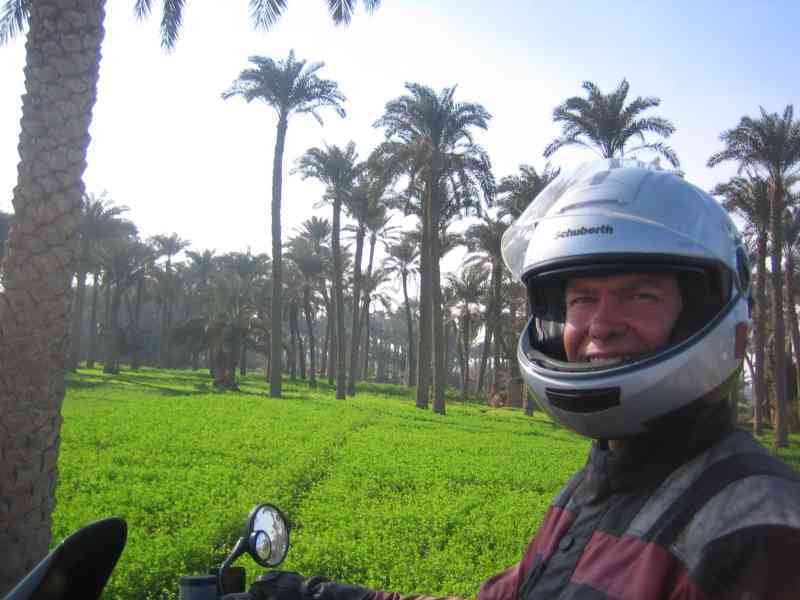
As it was getting dark, and we knew that headlights were optional with many vehicles at night, we decided to stop at El Minya and look for a hotel. It was just a small university town, so tour groups did not stop there. The only hotel available cost $4 per night for the room, and as all the clientele were men, it wasn't exactly a pleasant experience for me sharing a washroom with them. We took a long walk down to the Nile, along a beautifully landscaped walkway, and this was some compensation for our bad hotel situation. A couple of nursing students from the local university chatted with us for a while, just practicing their English and wanting our opinions of Egypt. These were the real Egyptian people, the ones who had little contact with tourists, and who were not trying to sell us anything. We felt so comfortable walking the streets of El Minya, with many people asking where we were from, and saying, “Welcome”. As we tried to leave the next day, the hotel staff told us that we needed a police escort, and a couple of officers just showed up on a Jawa 350, ready to roll. They rode us 70 km, and then handed us over to the next shift. How comical that must have looked, being escorted by a couple of Peugeot 406's, one in front, one behind, and four officers in each car. Talk about over-doing it. This went on for at least seven more shift changes, some escorts in small trucks with a gun-toting officer sitting in the back. Some went really fast, some very slowly. Ekke motioned that we needed gas, so they took us to a gas station. Ekke mentioned that we were hungry, so they took us to a restaurant. Ekke said that we needed a hotel when it was getting dark, so they found us a hotel in Qena. Occasionally an escort just left us, but there was always another one up ahead that knew we were coming. Overall, the escort had probably slowed us down, so we didn't make it to Luxor as planned. E£100 ($20) for the El Hamd Hotel was too much, but we were in no position to bargain. As they brought tea to our room they also provided us with a menu for their restaurant, Crepaway. The whole menu was crepes - crepe hotdogs, crepe chicken, crepe burger, and our favourite, crepe super crepaway. Hilarious. So, we went down for the crepes, had a couple of chocolate ones for dessert and were quite happy. We asked for the bill, and the waiter said E£50 ($10). This sounded a bit high, so we knew he was just picking a number from the air, and we asked to see the menu again. Instead, he brought us a hand-written itemized list of what we had ordered, with prices, and it all added up. We couldn't seem to get a menu from him and were too tired to pursue it. As we were downloading pictures later that night, we made an exciting discovery: Thinking that all the crepe stuff on the menu was so funny, Ekke had actually taken a picture of the menu! There it was, in English and Arabic writing, but prices only in Arabic. The guy had basically charged us double for everything. With renewed energy, we marched downstairs, showed him the real prices, and asked for our money back. He tried to explain that these were `Egyptian' numbers and that an Arabic `6' was really a `12'. He was somewhat disconcerted when he found out that we knew our Arabic numbers, and he eventually coughed up the money. After all the number crunching, combined with our state of fatigue, it seemed easy for him to take advantage of us. The next morning we realized that he had still double charged us for the drinks, so with a little more arguing, we got more money back. Unbelievable.
Practice your Arabic numbers before coming to Egypt!
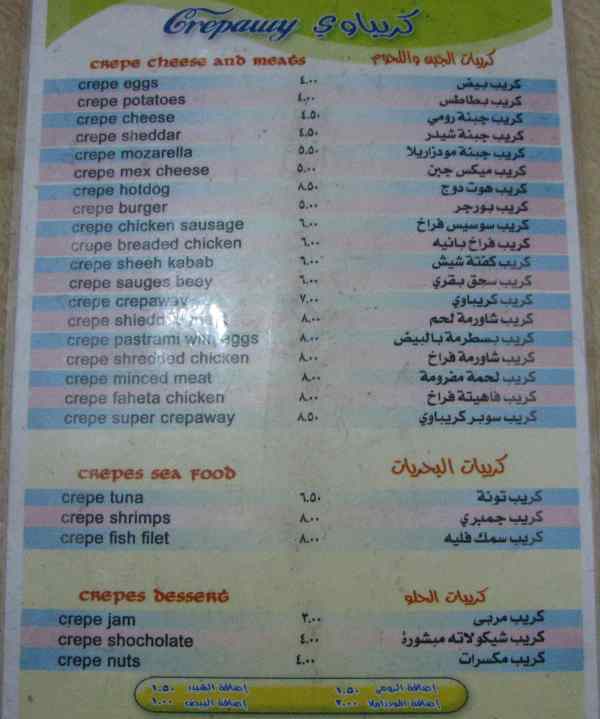
Luxor was only 60 km away, and I think it was too early for the police to find us an escort, so we were able to ride the whole way by ourselves. There were a couple of checkstops, but we just showed our passports and Egyptian driver cards, and were quickly on our way. Ekke found Reizeiky Camp and we took a room in their hotel. It was within walking distance of Karnak, the impressive pharaonic temples. Along with hundreds of other tourists, we wandered among huge statues and the hypostyle, a grand hall with huge columns, all with intricate carvings.The Sacred Lake glistened in the sunshine, and I could just picture the holy men coming down for their daily cleansing, 4000 years ago.
Yummy breakfast for $0.40 for two

Temples of Karnak
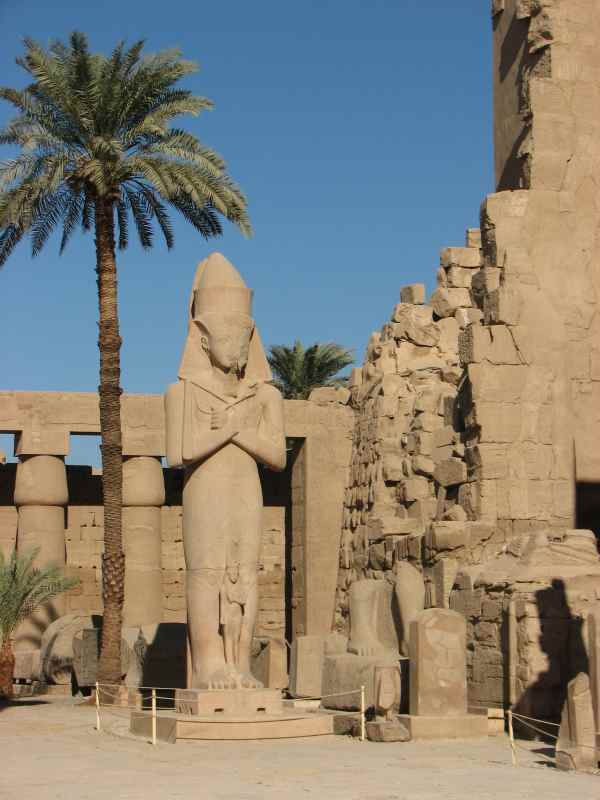
Hypostyle

Obelisks
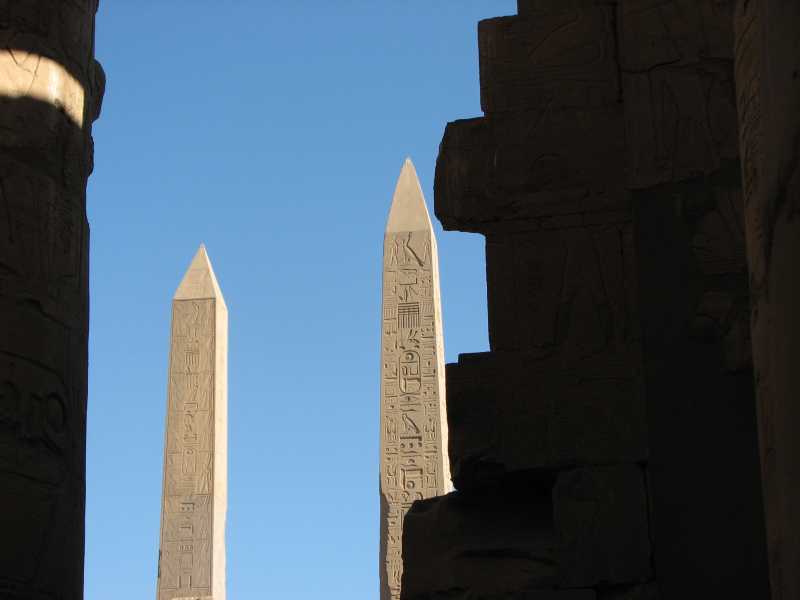
Polychromatic paintings preserved underneath the lintels
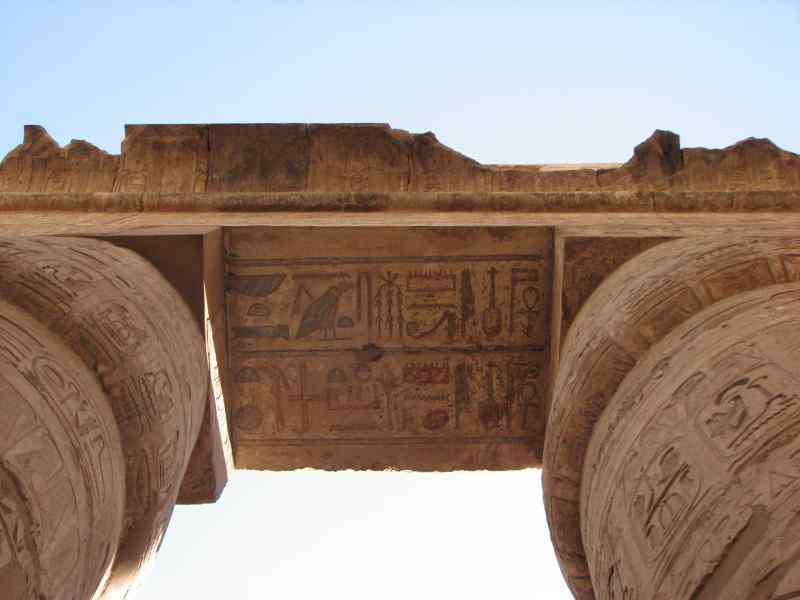
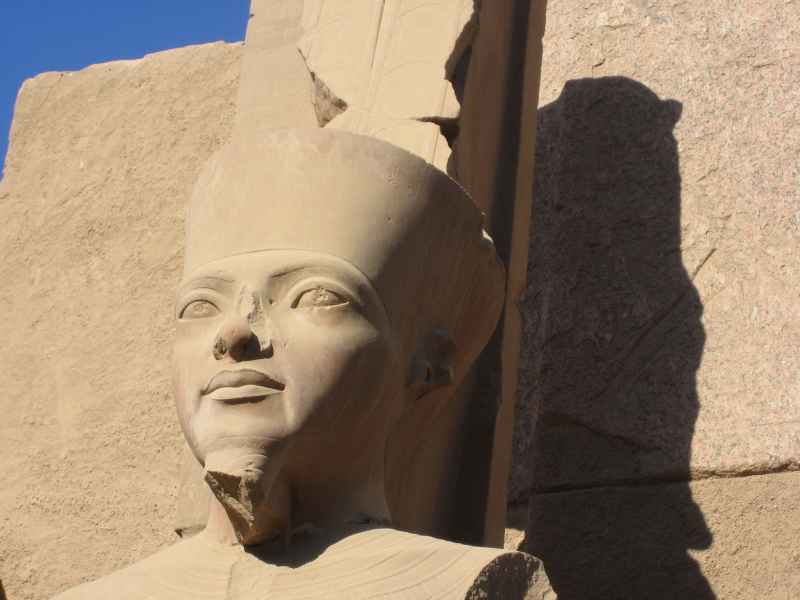
Blue Man group
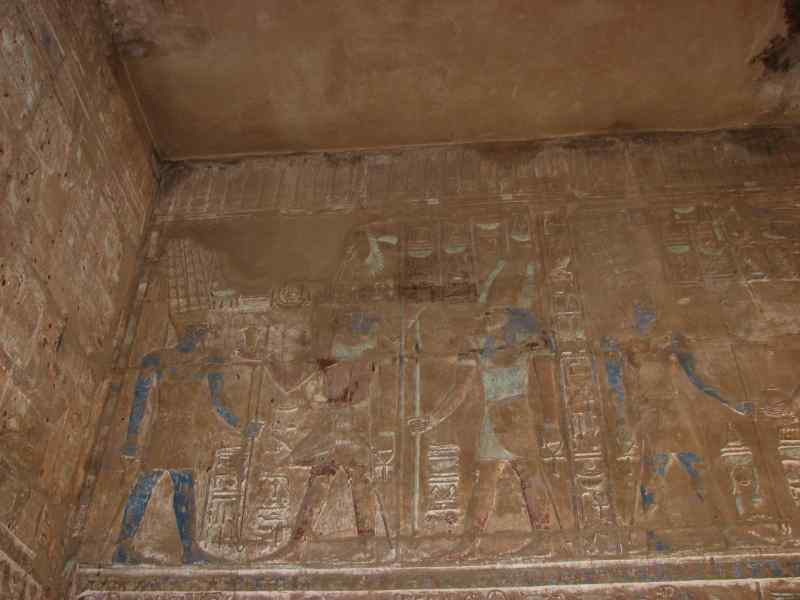
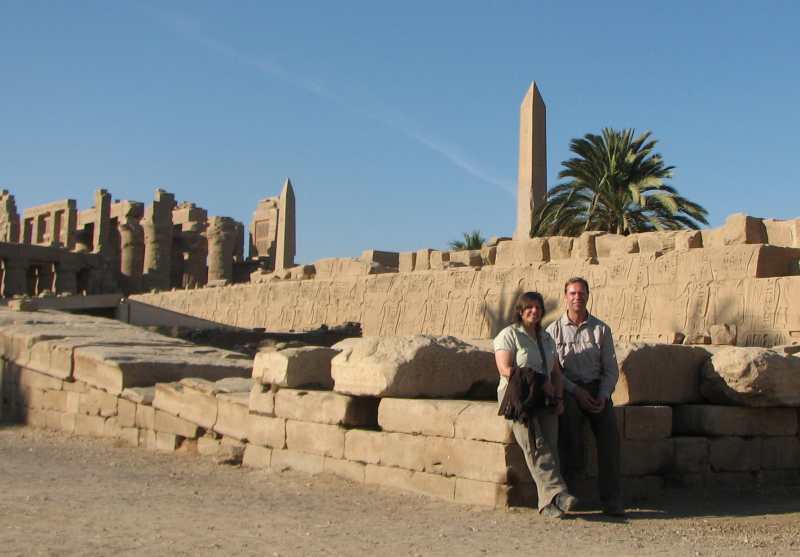
A two kilometre walk took us to Luxor Temple, built by Pharaoh Amenophis III, and added onto by Kings Tut and Ramses II. There was also an ancient mosque in the courtyard, and we watched as Roman frescoes were being restored by some experts from Rome. The faces on many of the huge statues were extremely well-preserved, and the fading sunlight lit them perfectly. The temple was illuminated by floodlights after the sun went down, and it really added to the magic and mystery of the ancient temple.
Gratuitous Police Motorcycle photo

Temple of Luxor
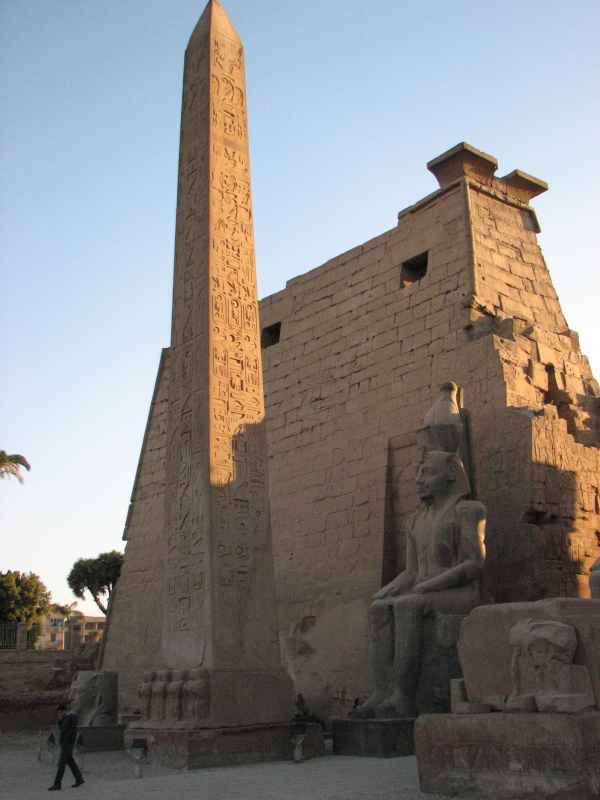
Avenue of Sphinxes


Papyrus reed columns


As we wandered out to a poolside breakfast, we noticed that Tom's V-Strom was parked beside ours. He heard us talking from his hotel room and came out to join us. He had ridden from Cairo in one day arriving at Reizeky Camp at 2 AM, and he looked a little exhausted. But, amazingly he had enough energy to find some bicycles for us to rent for 25 pounds ($5) for the day. We rode to the ferry, crossed the Nile, and cycled up in the direction of the Valley of the Kings. Riding seven kilometres uphill with the one-gear bikes didn't appeal to any of us, so a taxi driver threw our bikes onto the top of his cab and drove us up for 25 pounds.
Cycling by the Collosi of Memnon

My priority was to see the tomb of King Tutankhamun, found in 1922 by Howard Carter. There was an extra 80 pound fee to see this famous tomb, which we happily forked out. We had seen a news program on CNN a month earlier that showed King Tut's mummified body, finally open to public viewing after all these decades. We weren't exactly sure where the body was, and some locals even thought that it had been taken to Cairo. As we descended the stairs of the tomb, we looked around the corner, and there it was: The mummy of the famous boy king! I had predicted there would be long line-ups and possibly no chance to see the tomb. But there we were, just the three of us, standing in King Tut's tomb with the guard upstairs doing who knows what. We had the entire tomb to ourselves for at least ten minutes, and it was awe-inspiring. Millions of people around the world have viewed King Tut's treasures, but here we were, just us three, staring at his tiny mummified body. Incredible. A gold sarcophagus still lay in its stone casing in the burial chamber and the walls of the tomb were colourfully painted and fully intact. It was a touching experience, but all I could think of was Steve Martin's 1970's song, 'King Tut' ("had a condo made of stona"), unable to get the song out of my head for days.
King Tut was brought out of his sarcophagus only the month before
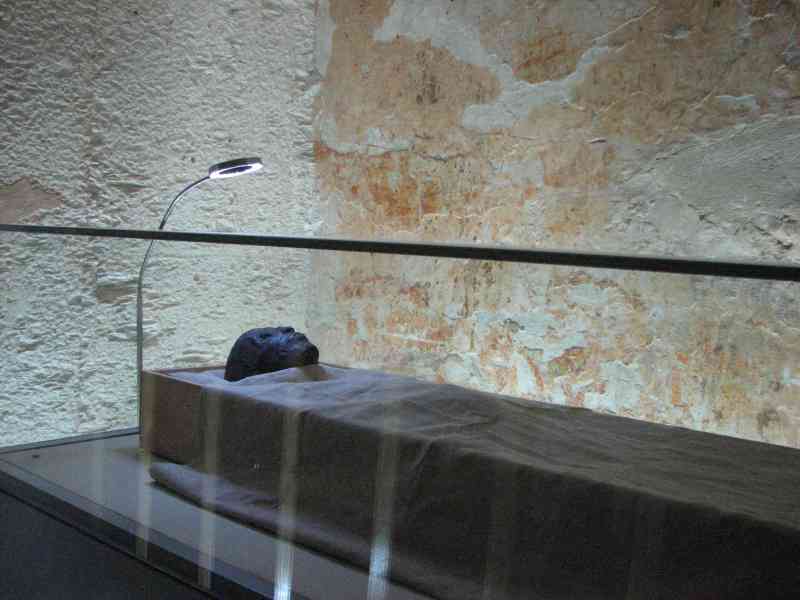
Simple wall decorations for a boy-king, what would a real king's have been like?
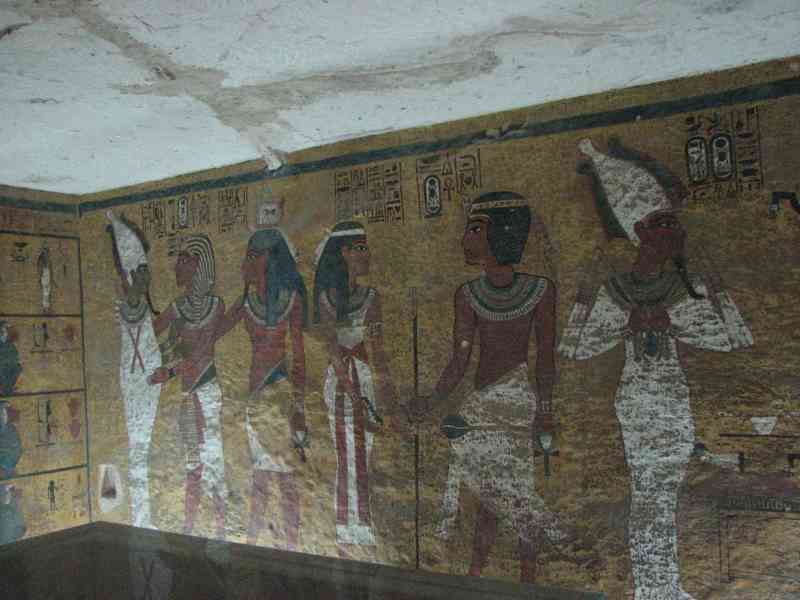
No one had a guidebook with them, so we just winged it in the valley, our ticket allowing us to visit three more tombs. Tausert's tomb, later usurped by Setnakht, had very long rock-hewn corridors decorated with carvings and paintings. Tutmes III's was neat because we climbed stairs up a cliff, and then descended deep into the burial chamber. Ramses III's tomb was very colourfully decorated to resemble the underworld. After a bit of lunch with Tom at a French restaurant, we rode back to Luxor. A group of South Africans in a Land Rover had pulled into camp. They had been stuck at Port Said for two weeks and were trying to get the ferry to Wadi Halfa on Monday, just like us.
Tom found out that a convoy left at 7:00 AM, and as it was uncertain as to whether we could get a police escort from here, we decided to get up early and try to make it. We rode to the main street of Luxor, and there were buses rushing down the street - the convoy. These convoys are set up so that Westerners travel with police protection. A terrorist bomb would devastate the tourist industry as has happened in the past. The convoy sped through towns, sometimes at 120 kph, so we really made good time. After about an hour, it grinded to a halt, apparently for a break. I suspect that the drivers all needed a cigarette as everyone here seems to smoke. At one point, Tom just started passing the vans and buses, and we joined him. This didn't make the police officer in the front bus very happy, as we found out when they caught up with us at the next checkpoint. But we made the 220 km to Aswan in no time and headed straight to the ferry station office. There were plenty of overlanders there ahead of us, so I thought our chances of getting on the ferry to Sudan were slim to none. But since we had motorbikes, it was no problem getting us and the bikes on the boat. Usually this isn't the case, but as Tuesday was the beginning of Eid el Atah, a Muslim holiday, they weren't taking cars as there wouldn't be staff to unload. It was hard to contain our excitement, but we needed to do so as there were a lot of long-faced overlanders among us. They could possibly band together and rent a private barge for their cars, but the holiday lasted for a week, so it didn't look good. Lapo, the Italian we had met in Cairo, had been in Aswan for a week, having just missed last Monday's ferry. Apparently it had left a few hours early. He arranged for us to follow a taxi driver to the police offices for our paperwork to show that we had not "killed" anyone in Egypt. The driver, Michael, was able to jump queues and offer a little 'baksheesh', or tip money to various officials to speed up the process. We had just enough time to bring the paperwork back to the ferry office and get our tickets. Lapo also got us rooms at the hotel he was staying in, the Keylany, with the cleanest rooms this side of Bavaria ($20). After a walk along the corniche and a beer or two on a park bench, we had dinner at a floating restaurant on the Nile, which was very special. Beside us was a Swiss couple, travelling in a Land Rover, who were both pilots. She had flown a small plane around the world.
Ekke and Lapo outside the Keylany Hotel (note sheep in the background for Eid)

On Sunday, we had a full day to prepare for the ferry and Sudan. Lucky for us, Lapo had done the desert travel thing before, and could offer some suggestions. Michael, the cab driver from the day before, took us to a local lunch spot. We had falafel, pitas, fried aubergine, and tajina - fantastic. Michael paid the 'locals' price for the meal, and then we paid him a fraction of what we would have paid on our own. Tom had been getting his knobby tires put on his bike and had noticed a couple of Ducatis parked on the street. It turned out to be Matais and Robin, two Italians that he had met in Wadi Rum, Jordan. He showed them how they could get ferry tickets, and hopefully convinced the official that their bikes could fit on the ferry. If their paperwork comes through, then they could be joining us as we head off into the deserts of Sudan. Apparently communications such as email and phone service are very sparse. Mike and Ruby went to Sudan five weeks ago and we haven't heard from them. I'm trying to stock up on a few essentials such as crackers, tuna and milk powder, but Pringles are 20 pounds ($4), so we'll probably have a potato chip-free journey. We can't even find peanut butter. Christmas will probably be in Khartoum, about a week from now.
Last Dinner in Egypt with Tom, Lapo, Matais, Ekke, Audrey and Robin
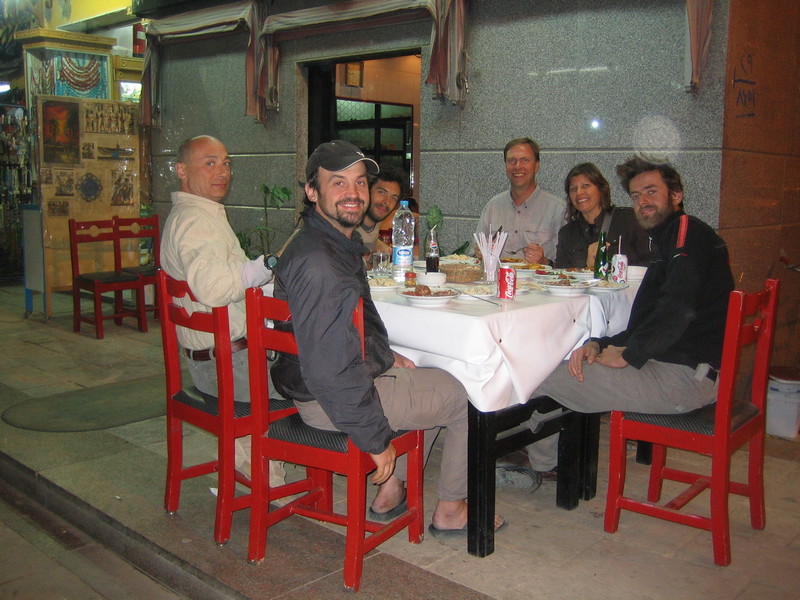
Merry Christmas, everyone!
Map of Nuweiba to El-Minya
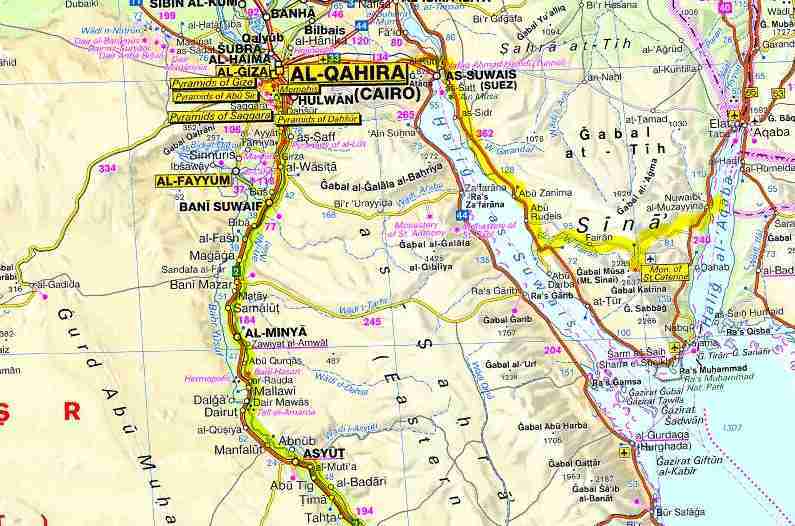
Map to Aswan
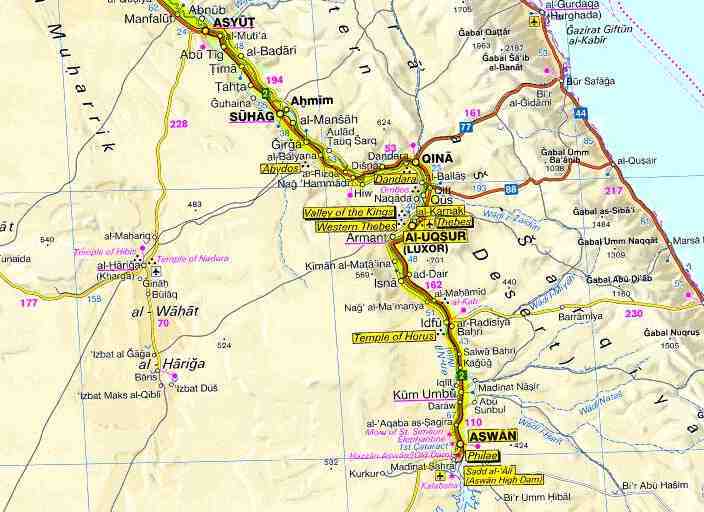
Back to top of page
The only border crossing from Egypt to Sudan is on the ferry across Lake Nasser, the huge body of water created by the Aswan High Dam. After paperwork, a little 'baksheesh' (tipping), and passport stamps, we were heading to the ferry. Loading was slightly chaotic, as the regular barge was not making the trip because of Eid holiday. This is where each family buys a sheep and slaughters it on the first day of the festivities. Tom wanted our group to purchase one, but it would not have been practical, being on a ferry and all. With no barge being pulled behind the boat, cargo filled every bit of space, including the decks. It was unbelievable how much these guys were carrying onto the ferry. If I hadn't seen a guy with a refrigerator on his back, I wouldn't have believed it possible. Talk about the ultimate carry-on luggage. The bikes went on last so we had to wait a few hours until Captain Jihad gave us the go ahead. The boat was not quite flush with the ramp, and the bikes had to be lifted down. Each of the thirty people milling about tried to help and yell instructions, which added to the confusion. Eventually all six bikes were squeezed into the hallway and the ferry was off. We were very fortunate to have first class cabins, which gave us a place to sleep and leave our stuff. But, alas, our door had no lock, just a gaping hole where the door handle should be, so we locked our bags in our Packsafe (wire mesh cover), and stuffed tissue into the door hole. The sunset on Lake Nasser was really special, and stars came out almost immediately. Prayer carpets also appeared as if by magic and all the Muslims turned towards Mecca, 900 km straight east. Ekke and I stood on some deckspace reserved for cabin passengers and listened to the gentle chug chug of the ferry in the night. He found Abu Simbel and the Sudanese border on his GPS, both of which we would be passing by while we were sleeping. Supper of a boiled egg, salad and fuul (mashed fava beans) was included, and we knew this was what the cuisine would be like for a while. The ferry docked at 11 am the next morning. Unloading was just as chaotic as loading, with security trying to keep non-passengers from getting near the doorway of the boat. There was a lot of yelling, and a bit of pushing as a fight nearly broke out. When people started to lift their goods over Robin's bike, often hitting it in the process, we knew we'd better get the bikes off as quickly as possible. They had to be lifted up to the ramp and through crowds of people all pushing to get their refrigerators and chip boxes off first. Robin's bike sustained a bit of damage with a mirror being bent off. In the customs hall Matteo met some other Italian travellers just leaving Wadi Halfa. One guy had spent two days in a Sudanese jail, apparently for taking a picture of the Blue and White Niles meeting from a bridge in Khartoum. Mental note: no pictures from bridges. Carnets cost 56 Sudanese Pounds ($28) to get stamped, 16 SP for the carnets and the rest into the pocket of the official for doing the paperwork. He wouldn't give us our papers until we paid this fee. Customs cost us 20 SP. Wadi Halfa was just a dusty little town with mud brick houses, a few small shops and a market. After eating some fuul and felafel, we stocked up on water, fruit and aish (pita bread), and headed off into the desert. My first experience with sand was upon me, and it kind of took me by surprise. The sand seemed to have a mind of its own, putting the front wheel wherever it felt like. The tendency is to brake when the bike starts fishtailing, but this just makes it worse. It's a careful balance, trying to keep going straight while not overcorrecting or doing a quick manoeuvre. I had a lot to learn. So, I called upon my experiences in Canada, driving through a half metre of snow, and maybe that helped a bit. Tom found us a great spot by the Nile, and Matteo and Robin built us a fire. Lapo had elected to stay in Wadi Halfa in a 'hotel', but the sand floors and grungy beds did not appeal to the rest of us, and it was easy to choose camping.
The last supper before the real adventure: Tom, Lapo, Matteo, Ekke, Audrey and Robin
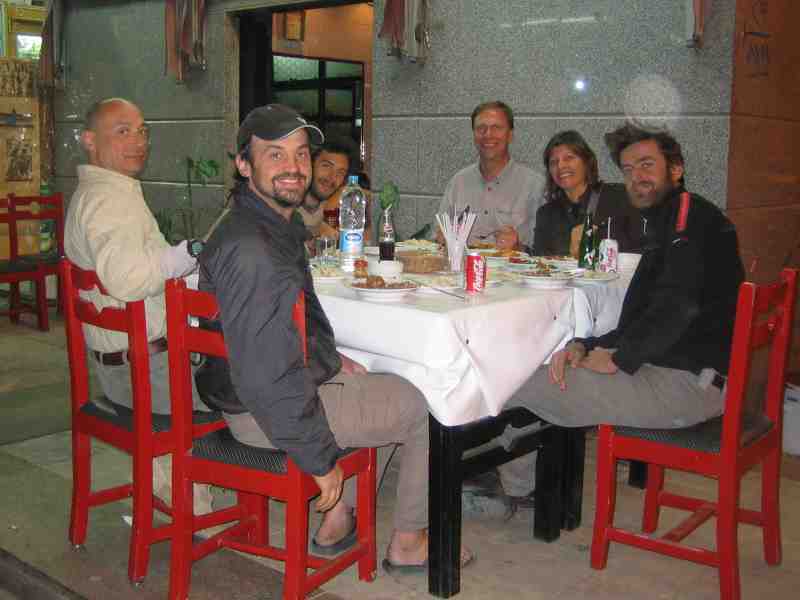
A fridge is carry on luggage?
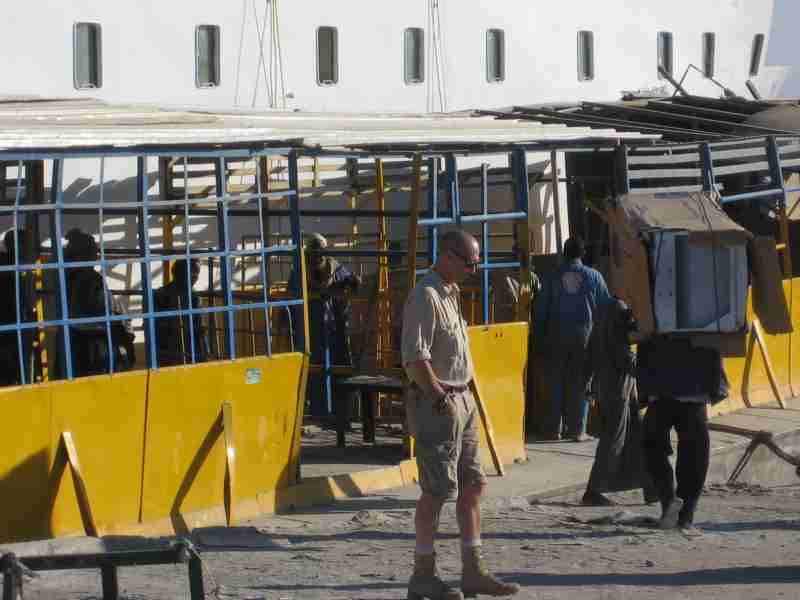
That is quite a drop into the boat
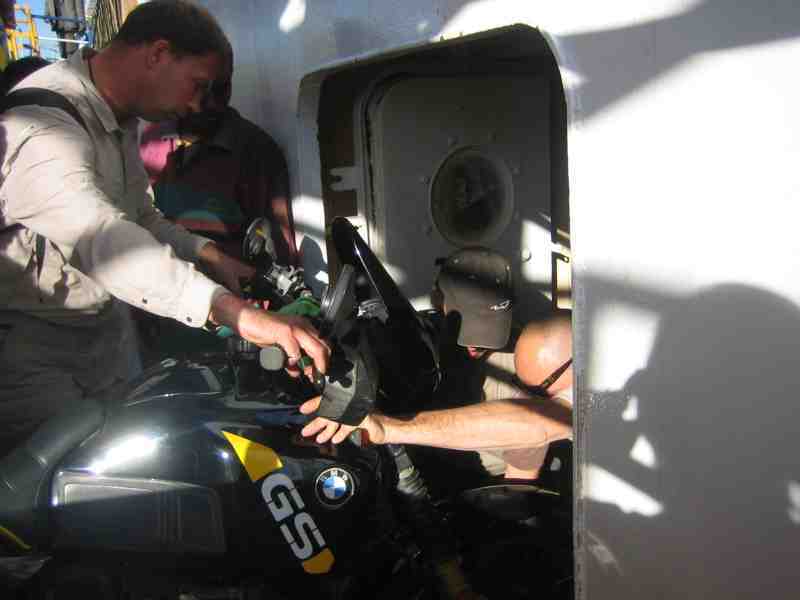
Matteo is a bit apprehensive
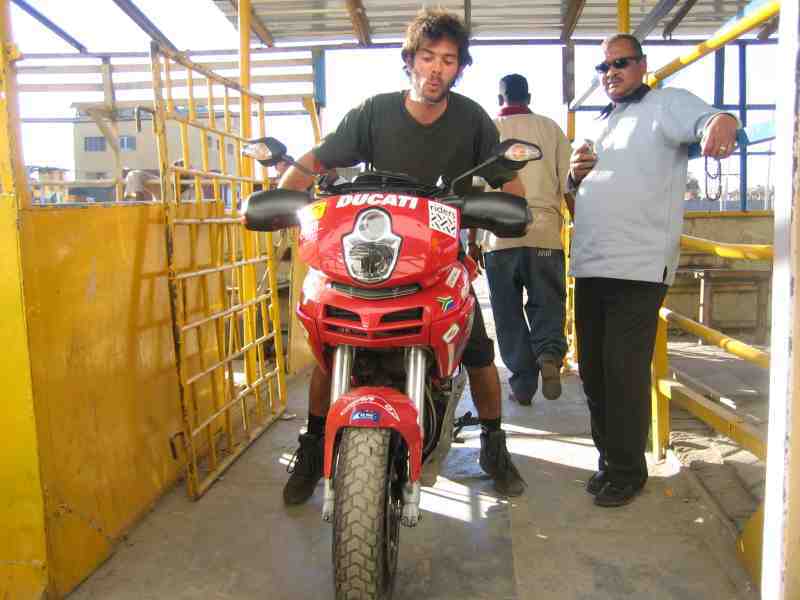
Cruising on Lake Nasser into the sunset
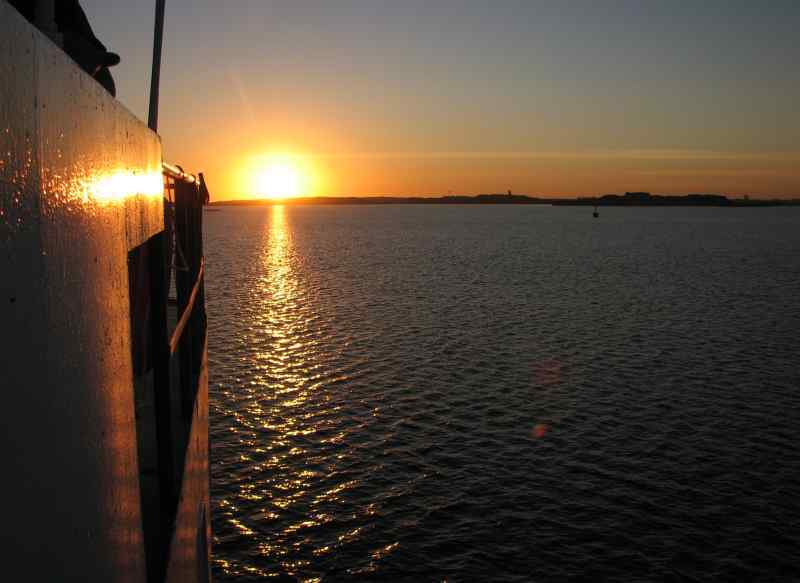
The desert at the edge of the lake seems so incongruous
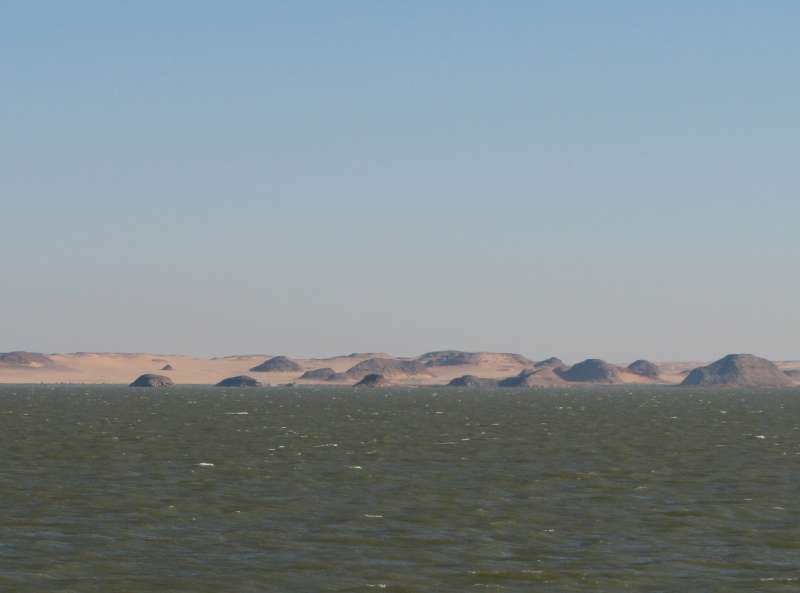
Dusty Wadi Halfa

Desert camping
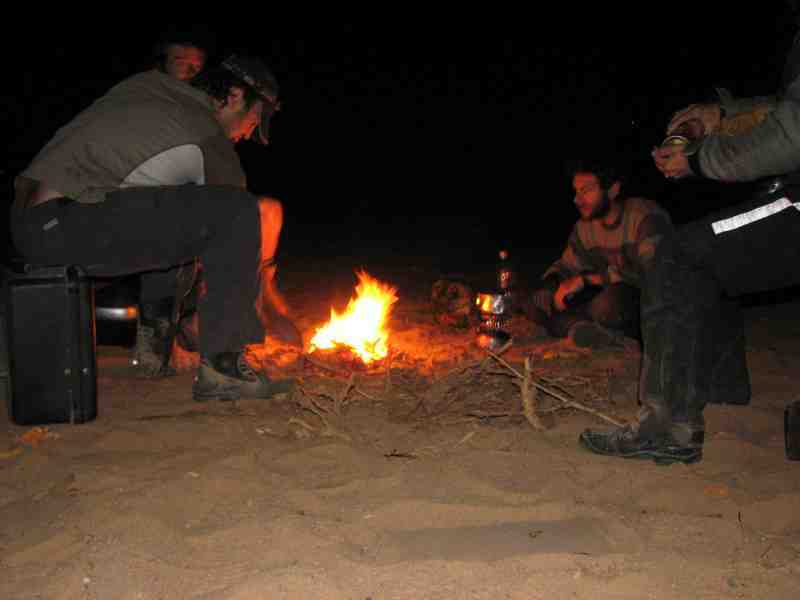
It had been our first camping in a long time, so everyone was a bit disorganized and we got a late start. The first 130 km were very isolated, with no sign of civilization except for the odd roadcrew workcamp (all shut down for the holiday). The road, famous for being rough and challenging, was being paved. We travelled on a few kilometres of new tarmac, which would appear out of nowhere in the middle of the rocky desert. It wouldn't be long before the whole road was paved, so we considered ourselves fortunate to be some of the last to ride the legendary route. It was extremely rocky, with some roller-coaster corrugations thrown in for kilometres at a time. The bikes were shaken so hard that you could just feel the shocks being tested to the max. Stand-up riding was the order of the day, which stabilized the bikes in the rougher sections by lowering the centre of gravity. It also allowed us to steer with our feet, weighting the outside footpeg when turning. Very similar to alpine skiing. I was really getting used to this type of riding, which was often similar to our ride up the Dempster highway to Inuvik last summer. But unlike the Dempster, we were suddenly surprised by a large patch of sand that we couldn't avoid. I saw Tom fishtailing, then Ekke fishtailing, and then it was my turn. Everything I did was textbook 'wrong', as I hit the brakes and put my feet down to stop myself from falling over. No such luck as I felt the bike get away from me. I overcorrected one way, then the other, and next thing I knew I was tumbling into the sand. The bad thing about having hard saddle bags is that they really hurt when they land on your leg. By putting my foot down, it allowed it to get caught under the bag as I fell to the side, also twisting my ankle. I hit the kill switch on the bike, and Ekke and Tom rushed to see if I was okay. A huge bruise on my calf and ankle was the only injury, thank goodness. As I sat there, I wondered what the next step would be if I had needed medical attention in this isolated area. Being in a group at least increased our chances of someone being able to go for help if need be, but people have often ridden this isolated road by themselves.
Robin is enthusiastic about the ride
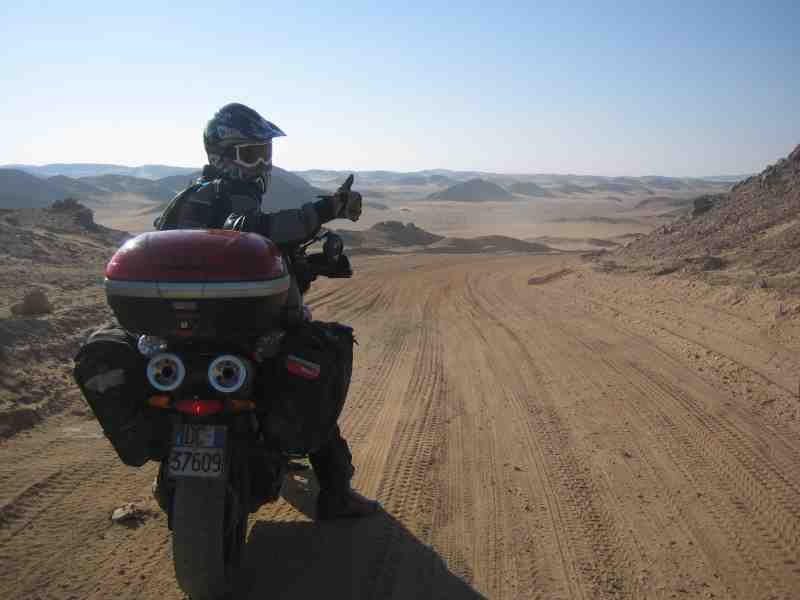
Ekke isn't so sure
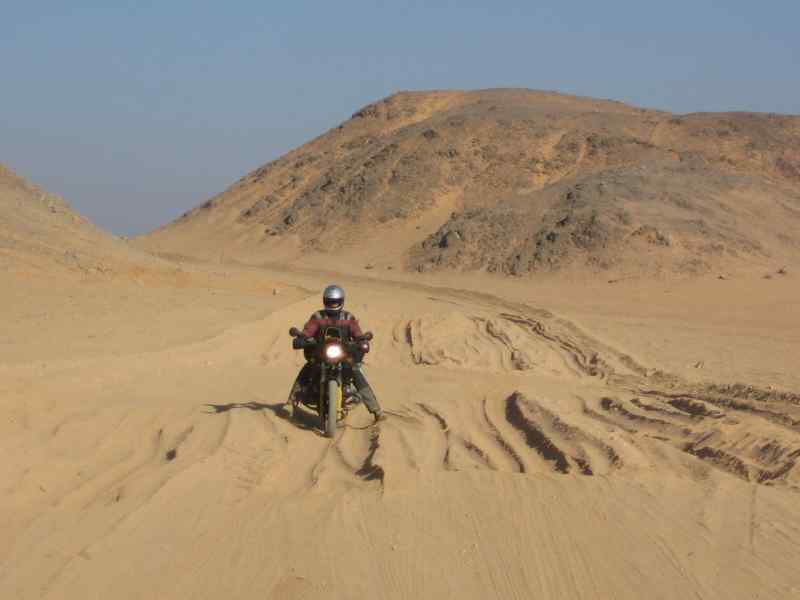
But Robin is really enjoying it
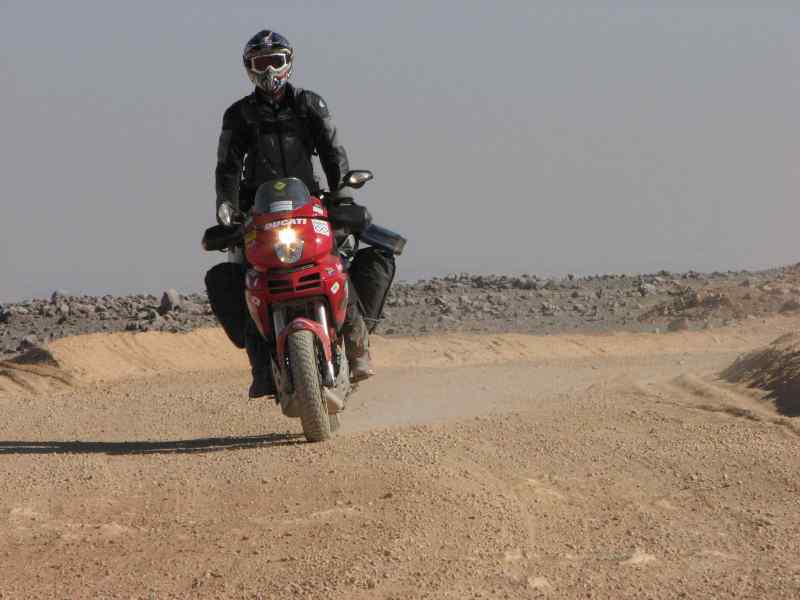
Go on the adventure before the whole thing is paved!
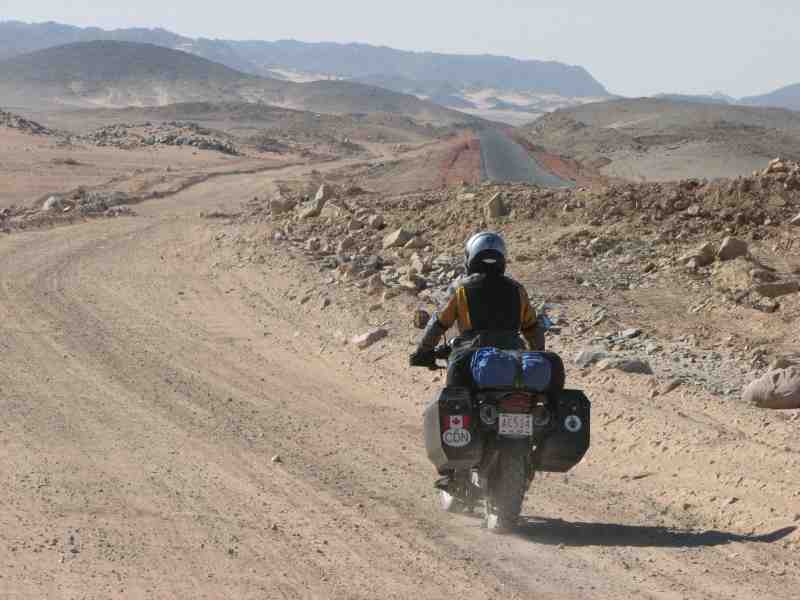
Tom and Audrey making dusty tracks

Lapo had gone ahead by himself earlier that morning, and we thought he was long gone. But then we came upon him sitting behind his bike for shade. The regulator or electrical system on his BMW R80GS had overheated, and he had called for help on his satellite phone. A truck came from Wadi Halfa a couple of hours after his call. But the bike had cooled enough so that Lapo could keep riding with us, and just stop every now and again to cool it down, so the truck returned to Wadi. A new regulator would then just be sent to Khartoum. Lapo wasn't the only one to experience bike problems. With the corrugation and rocks shaking the life out of the bikes, could we really have been surprised at what happened later that day? Ekke was just riding along, minding his own business, and happened to look down at the space between his map case and handlebars. There, on his steering head, was a gaping hole. The steering head nut was missing! Now I don't know much about the mechanics of bikes but I was pretty sure that this nut held the handlebars on. Here we were in the middle of nowhere, and things were looking grim indeed. Perhaps we could have a part sent out, but Lapo insisted that a shop could machine something out of an existing nut, probably in Khartoum. I made a rather futile attempt at riding back a few kilometres to look for the nut, while the guys fashioned a covering for the hole using a bottle cap and duct tape. Red Green would have been very impressed (Red Green: Canadian comedian who does fabulous repair jobs with duct tape). There was nothing for it but to keep riding, hoping that the pinch bolts on the forks held the front end together. Ekke would also have to ride 30 kph or so, because the bike felt like it was shaking apart. This would be fortunate for me because I would no longer hit the sandy patches at high speeds.
Lapo's bike breaks down in the middle of nowhere

Riding the corrugations
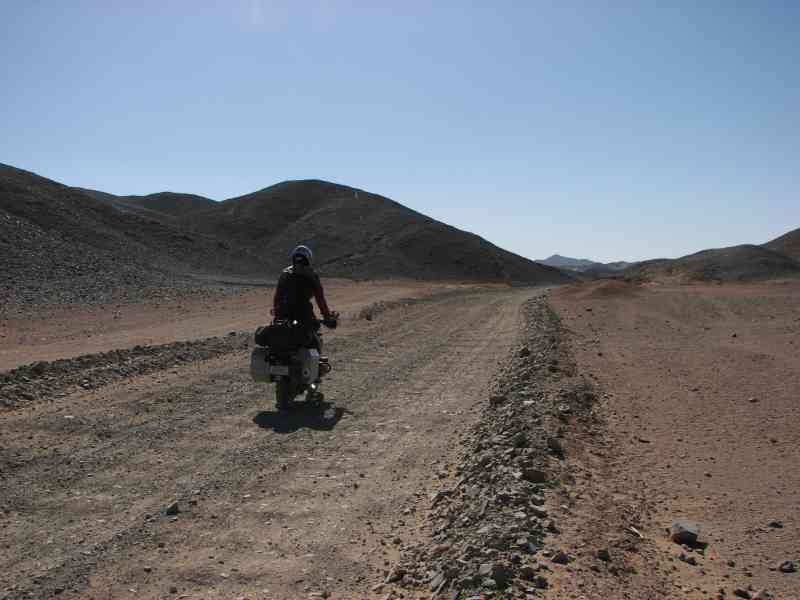
That doesn't look right (missing the steering head nut!)
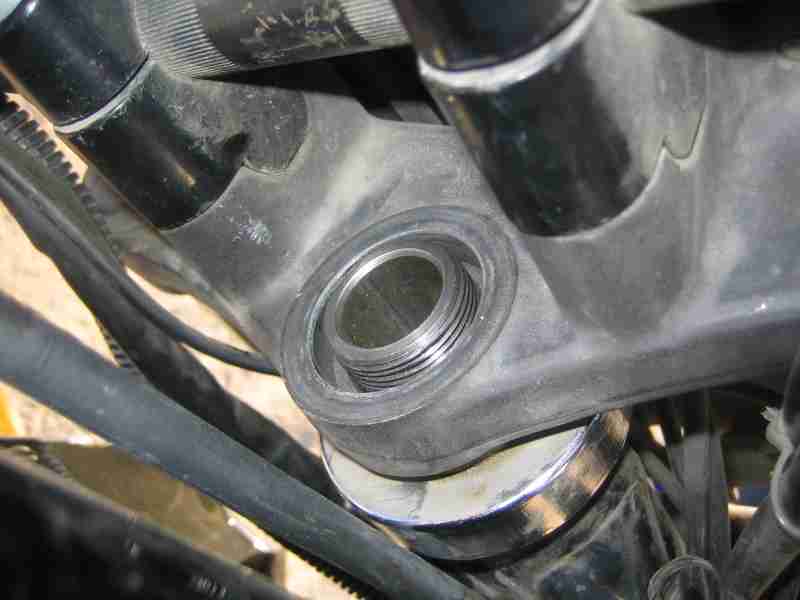
First view of the Nile in a long time

Tom found us a great campsite, again by the Nile, but this time near a small town. Almost immediately the family in a nearby mud brick house came out to greet us. They were so excited by our presence and insisted that we come for tea after we set up camp. Their house was basically a courtyard with sand that looked like it had been swept to a smooth, hard surface. It was surrounded by various rooms with open arched doors, each containing a couple of beds. We were invited to sit on plastic chairs, or on the beds, which had immaculately clean and pressed sheets on them. The concrete floor did not show a speck of sand and they insisted that we keep our boots on in a carpeted area. The walls were painted a deep blue, and a china cabinet stood at one end, full of beautiful dishes. The women served tea, and the men sat and drank it. The women did not join us in the same room and we didn't see much of them except when they offered us popcorn or cookies. Surely we were back in Victorian times where the men retired to their smoking room for a cigar and brandy and the women went to their own salon. Supper appeared as if by magic, a huge bowl of fetta (a puree of meat and bread), rice, and chunks of lamb. Fantastic! Matteo gave our hosts some Torino (Turin, Italy) stickers from his hometown, and we gave them some Canadian flag pins and stickers. The women were quite curious to speak with me, so they stuck their heads in the doorway, and we chatted, with one of the sons translating. The first question is always, "Where are your babies" and it's difficult for them to understand my answer (chose not to have any). I must have seemed like someone from outer space in my dusty motorcycle gear, quite a contradiction to their flowing topes (robes).
Camping in someone's back yard

The next morning we were invited to the Imam's (holy man) home for a quick tea and some delicious homemade cookies. After a few photos, we were once again on the road. What a pleasure to ride by the Nile, going from town to town, seeing an ancient temple perched on an island, avoiding the sand. Every person that we saw, young, old or in between had a huge smile on their face and gave an enthusiastic wave. The road continued to be very rough and corrugated, with big pointy rocks and sand thrown into the mix. Every moment required 100% concentration, and we were exhausted with the mental and physical challenges. I had to peel my hands off the grips when we took a break as I had been grasping so hard without realizing it. We also had to force a few snacks down every now and again to keep up our energy levels, even though eating was the last thing we wanted to do. Water intake was easy as we'd just take a few sips whenever we stopped. Matteo, Robin and Lapo had Camelbacks (waterbag backpacks with drinking hoses) but I think they had to stop to take a sip anyway in the rough riding conditions The temperature was about 25 C, perfect riding weather and we couldn't imagine doing this route in a warmer season. We easily drank a few litres of water each, per day. Water was available in small towns, in terracotta jugs, so we knew it came straight from the Nile. Eventually we resorted to using it, but it was dark in colour and we had to purify it with our Miox system (salt and water, with a zap of electricity makes a mixture of oxidants that kills viruses and bacteria).
The Imam between Matteo and Lapo and our genial host between Tom and Audrey

Gasoline was another challenge. We stopped at a small town to search for 'benzine', and found a woman who sold some black market gas from a barrel. I took four litres, thinking I could make it to the next known gas station without a problem (should have taken more). The woman was hilarious, talking non-stop from the moment we arrived, always in angry tones, demanding the money, reminding us of how much gas we had taken, asking for correct change, arguing with Tom about the price, yelling in his face. Meanwhile, her minions ran around as if they were about to get a good whipping, doing her bidding, hustling whenever she barked out an order. We nicknamed her the 'Gas Nazi' (for you Seinfeld aficionados), imagining her saying 'No gas for you, one year!" because she didn't like the look of us. Robin duly paid homage to her greatness, getting down on his knees to make his offering of payment, and this seemed to appease the prima donna.
Robin begging for gas
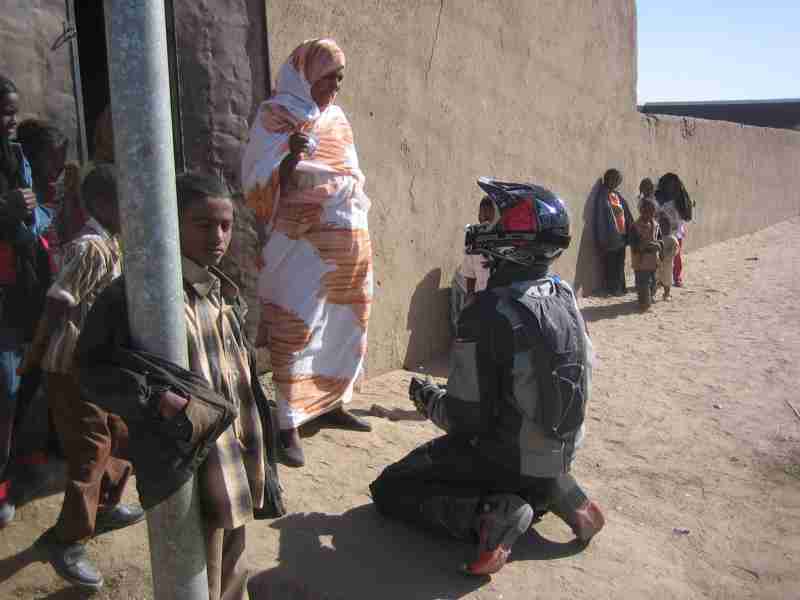
Lapo considers alternate transport after his bike breaks down
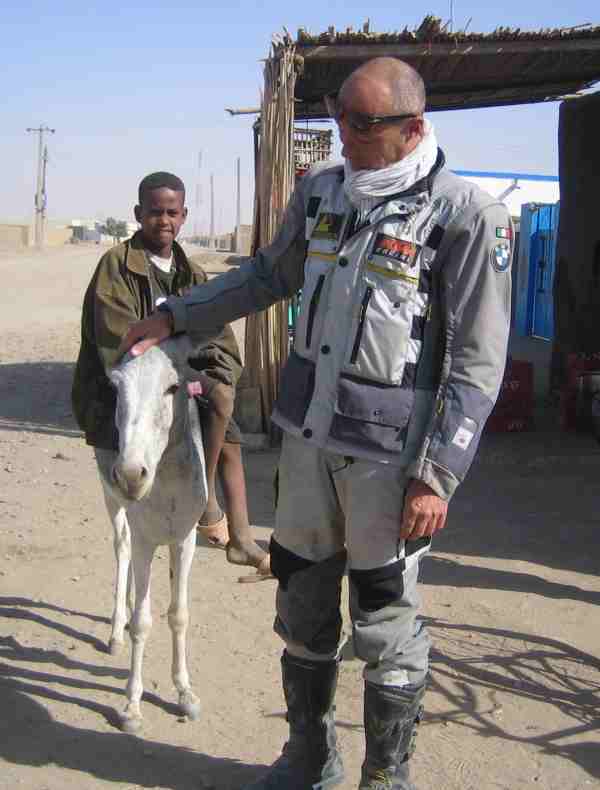
Just as we were leaving town, the winds suddenly picked up, and before we knew it, a full-blown sandstorm was upon us. There was a lot of conversation as to whether we should continue or stop. The general consensus was to stop, as the bike filters could never keep up with all that blowing sand. Apparently, sand in a bike's engine is a bad thing. There was a risk of the engine eventually seizing up, which could mean having to get a new engine. Robin found us some huts to take cover behind, building us a sand bridge to ride over a deep gully. There was talk of sandstorms sometimes lasting three days, so we settled in and waited it out. This one seemed to calm down within an hour, and after lunch we were on our way.
Sandstorm!
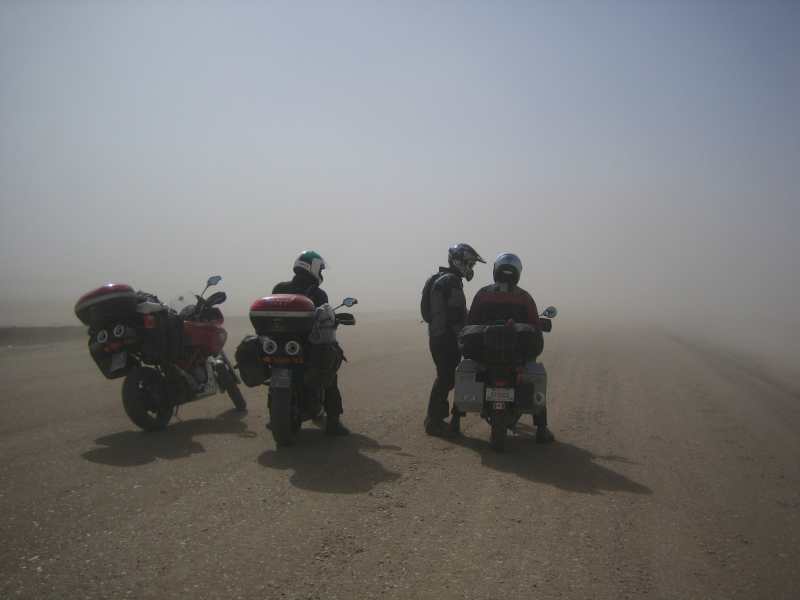
Ekke and I brought up the rear of the pack, which was a little unfortunate in one situation. Out in the middle of nowhere, Ekke's bike just died. It just stopped. That was that. We didn't quite go into panic mode, but started talking about the possibility of serious electrical problems, getting a truck to take the bike to Dongola, and how that would happen. I volunteered to ride ahead to get the others, who were probably waiting at the next town. I rode and rode, with no sign of them, stopping for a bit of a dust storm, not wanting to get stranded by myself out there. I was just sitting by the side of the road, taking a break, wishing I had some purified water with me, when I heard the happy sound of a BMW behind me. It was Ekke! Apparently the bike had overheated and restarted again 15 minutes later. Phew! We caught up to the others who were taking a yogurt break beside a small store. Such a luxury in the middle of the desert.
Tom once again found us a fabulous campsite by the Nile, in a grove of palm trees, surrounded by rocky hills. The ride in was through calf-deep sand, and I only needed to be pushed out once. Tom invited us to climb up the hill before the sun set, and we were rewarded with beautiful colours over the swaying palm trees beside the river, all laid out before us. The site was then nicknamed 'Amphitheatre of the Gods' because of our perfect seating area to view the sunset. Our pasta and tomato sauce with cheese tasted delectable that night, the first use of our Dragonfly campstove on the entire trip.
Audrey rides into the Amphitheatre

The perfect camp spot
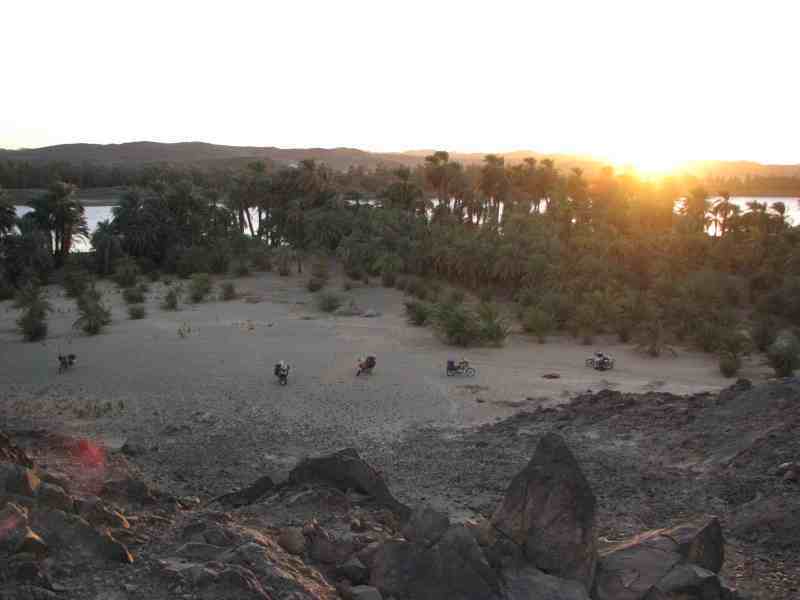
Looking a little rough but happy

Riding through the deep sand first thing in the morning was a real wake-up call. Immediately the serious concentration began as another nine-hour riding day was underway. Ekke and I, with great relief, rode out of the sand patch without getting stuck. I was still searching for that fine balance of riding the sand: Too fast and I was fishtailing. Too slow and I was stuck. I think I now have sand figured out: Don't ride in it! Lapo left the campsite with us, but soon took off way ahead. The route took us through some remote rocky desert areas. The group was now split up as we had to maintain such a slow speed. Usually at such low speeds a bike gets great fuel economy, and we had been riding in first gear, occasionally in second, for most of the time. It turns out that this really eats up the fuel because the RPM's are so high for long periods of time. We were shocked to find that I had gone on reserve about a hundred kilometres away from the nearest known gas station. I would definitely be on empty way before that. With the Eid holiday, many little stores and markets in the towns were closed. Ekke finally just asked some guys in a town if there was benzine. They jumped into action, finding a small boy to run to someone's house, presumably to get a key. A man came walking over, opened the door to his shop, and siphoned some gas into old 4 litre oil containers. What helpful folk in this remote area. With no more worries about gas, we just carefully rode along, with the others ahead of us. The corrugation, rocks and sand continued. Ekke's bike died again, and not conveniently near any small town. We hoped once again that it was just overheating, and we waited it out together. It started ten minutes later, and we caught up with the group who were sitting behind a house to get out of the wind. As we rode up, we couldn't believe what we saw: bicycles! A couple from South Africa had been riding since February and were now heading up to Wadi Halfa. They had also encountered other Calgarians in Ethiopia, Mike and Ruby. This was the first we had heard of them since they had entered Sudan, so we were glad to hear they were having a successful journey. They also encountered Rene Cormier, a motorcycle traveller who had given a slideshow at one of our Horizons Unlimited meetings (group of motorcycle travellers). Small world.
Yummy oatmeal for breakfast

Blackmarket gasoline

Lapo had been waiting at this spot for a couple of hours and was anxious to be on his way. He said he had tried three different routes, and all were calf-deep in talcum-powder sand. We decided to stick together for this part, so that we could help each other out if necessary. What fantastic people we were riding with! The sand was very deep, and I thought I was doing okay until I came to a small hill. I lost courage just as I was going up, felt the bike slow, and eventually got stuck in the deep sand. As I couldn't paddle my way out, Ekke gave me a push. After getting stuck one more time, we were finally through the sand field, and the road got better after that. The cyclists, going the opposite direction than us, had given us a rough idea of their route, saying they veered off into trackless desert for 30 km. Tom, Ekke and I thought the Nile route would be more interesting, so we went that way. What fun we had riding curvy roads through towns, the rutted sand roads smooth from traffic. The sides were banked so that it felt like we were on a roller-coaster, slaloming our way between houses and rock formations. It was more fun than Disneyland. We found the cyclists' tracks in a small desert off-shoot, so we had taken the same route after all. We arrived in Kerma, a bigger town, just before sunset. It actually had a real gas station. The guys there told us that three bikes had passed through and were going ahead to Argo. Ekke and I wanted to stop riding at dark, and Tom wanted to go ahead, so we told him we might make the 14 km to Argo, but possibly not. As we were so exhausted and every little patch of sand was getting to us we pulled into an area of palm trees, near a water tower to set up camp. Immediately the farmer came out, waved us over, and offered us shelter for the night. It took a lot to convince him that we just wanted to set up our tent in his field. Hassan insisted that we set up in the yard, and he and his family helped set up the tent. We showed him our down sleeping bags and thermarests, and eventually he was convinced that we wouldn't freeze to death overnight. He invited us in for tea, which we accepted. Eight children made for a very lively household. On the bed lay a woman, who had given birth a few days earlier. The baby was not quite as cute as my niece, Maggie, but came a close second. We had our tea in the same room that mom was lying in. Her mother from Khartoum was there to help out. Two other women were also living in the house, and some of the children were theirs. I'm guessing that it was a polygamous relationship, but we weren't quite sure. One of the women, Sellawa, spoke some English, as did Hassan, so we were able to have a bit of conversation. The tea, popcorn, and peanut squares were very welcome after such a long day on the road. We promised to stop by for tea in the morning, and slept peacefully in the cold desert air.
Temple on the other side of the Nile
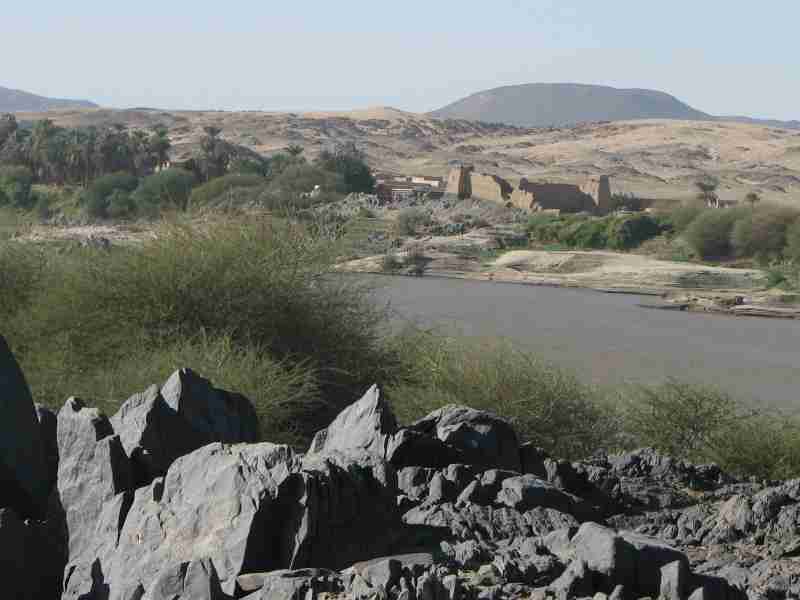
A typical home along the Nile

Tom on his V-Strom in the sand
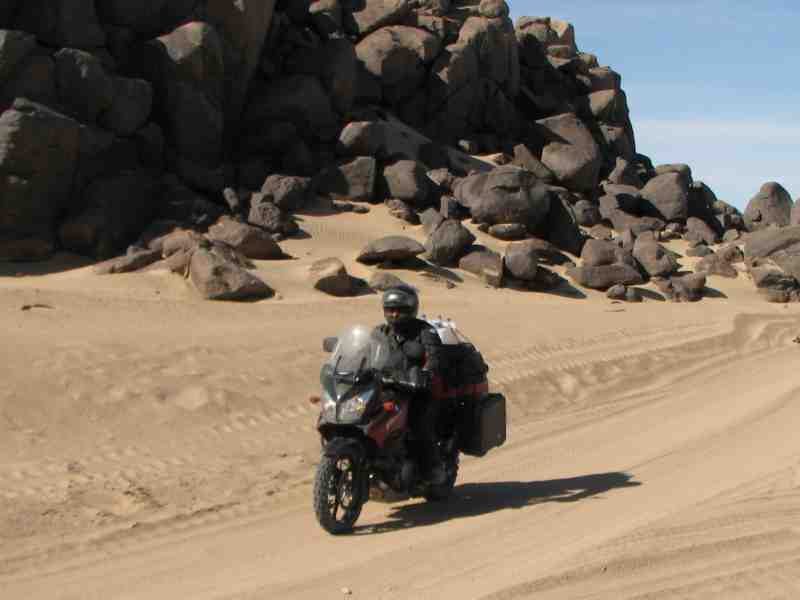
Audrey at the Giant's Marbles
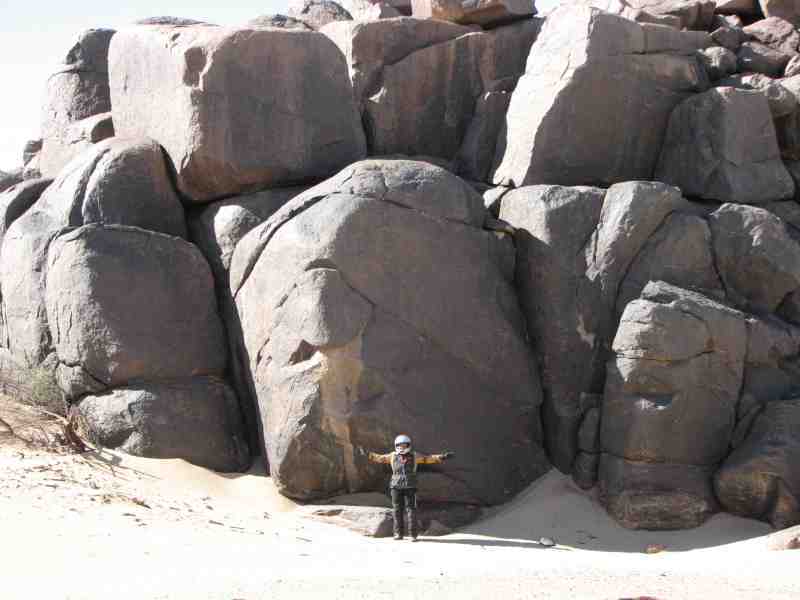
Riding across the desert
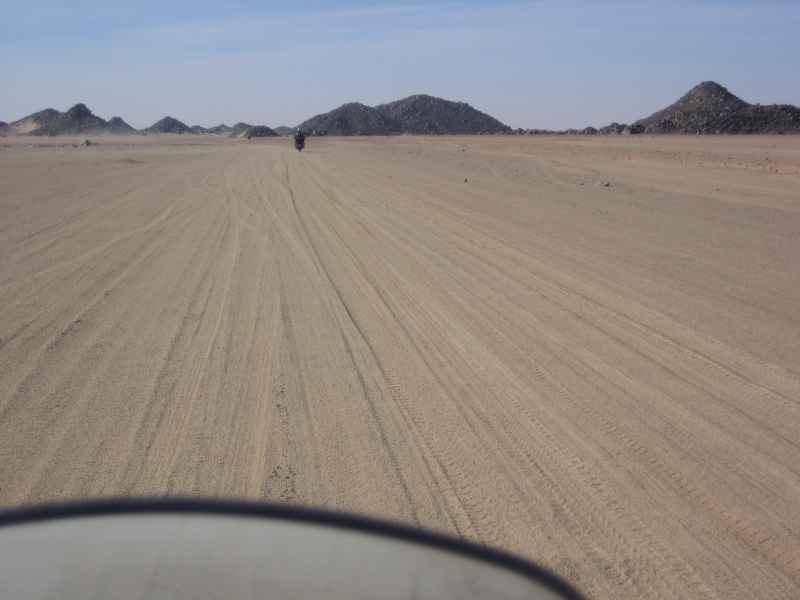

Ekke writes:
Our host of the previous evening had insisted that we must come for tea in the morning so after we packed up the tent and the bikes we went to the door of the home. There was no activity so we left a note apologising that we really had to get going. By 8:30 we were at the ferry dock at Agro. We found Tom's tire tracks so we asked some of the people gathered for the ferry if they had seen him. No-one could confirm that Tom had crossed that morning but they did say that three motorcyclists had crossed the previous evening. We let the 9:00 AM ferry go and checked around town for Tom to no avail so we caught the 10:15 boat across the Nile and hoped he was on the other side. No tracks were evident at the other side though so we rode to Dongola. About 10 kilometres out of town we hit pavement, which was pure heaven after the sand and corrugations of the last few days. At a tire shop we found Tom getting his rear knobby switched over to a street tire. He had missed the ferry last night so had ridden on the other side of the Nile where the road was really terrible to the ferry at Dongola, arriving at midnight. At lunch we found that our three Italian friends were still in town so we kept our eyes open and found Lapo wandering down a street. They had arrived the previous day and were staying at a real dive of a hotel. Audrey and I debated whether to stay with them, go camping or find a better hotel. In the end a better hotel won out and we found the Air Port (sic) Hotel on the edge of town.
And more sand
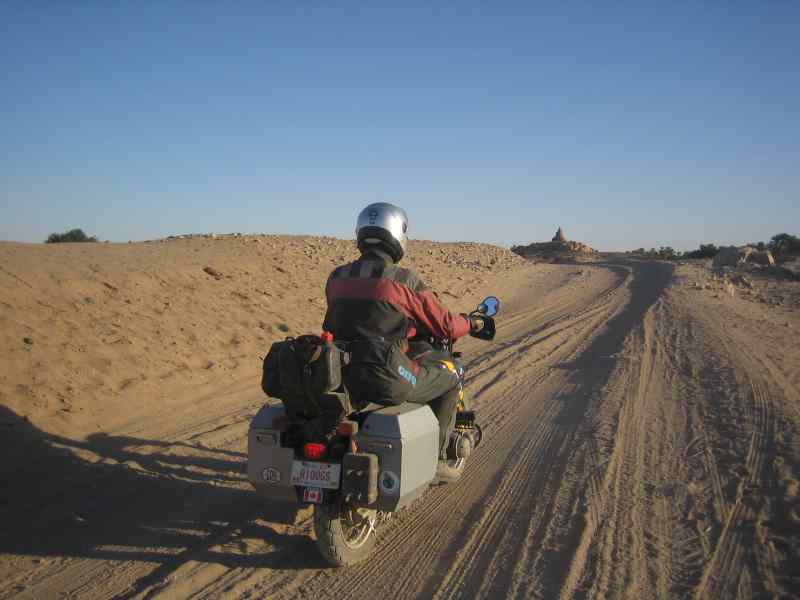
Finally, pavement!

Sunday, we left the hotel just after sunrise and rode south out of Dongola. A few kilometres later the pavement ended and we were back in our favourites, sand and corrugated gravel. After a few kilometres of that fun we decided that the paved road must be further out from the Nile so we rode in that direction until we found perfect tarmac. 300 kilometres went by very quickly and then we stopped in the filthy little town of Marawi for fuel and lunch supplies. From here it was another 300 kilometres of desert riding on brand new pavement to Atbara. Or almost to Atbara anyway. The fabulous new highway simply ended at the Nile with a bridge still under construction. A local told us that the ferry was just a little way down the Nile so we cut through a village on tiny little pathways until we found the boat docked at a dirt embankment. By the time the boat was loaded and had crossed the river it was getting on 5:30 PM. Meroe, the site of the ancient Cush pyramids, was our planned destination but with the sun setting at 6:15 it would be a bit of a push to make it before dark. We didn't make it. About ten minutes before sunset we pulled off the desert highway and set up camp in the wild. With the full moon it was incredibly bright and we hardly needed our headlamps to cook supper and set up the tent. At one point we noticed a set of car headlamps that looked like they were coming in our direction. Not wanting to attract any attention we tried to stay in the shadows of a thorn bush but the headlights didn't seem to be approaching any closer. It seemed very odd for them to just be sitting in the desert. After a while we decided that they weren't coming to investigate us so we continued with our usual business and in the meantime kept an eye on the headlights.
Marawi

Brand new highway
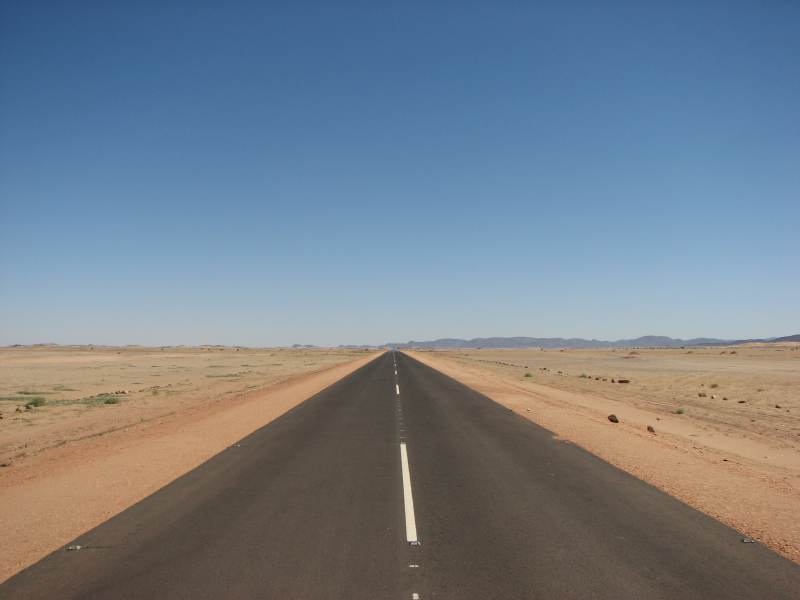
Leads to a dirt path
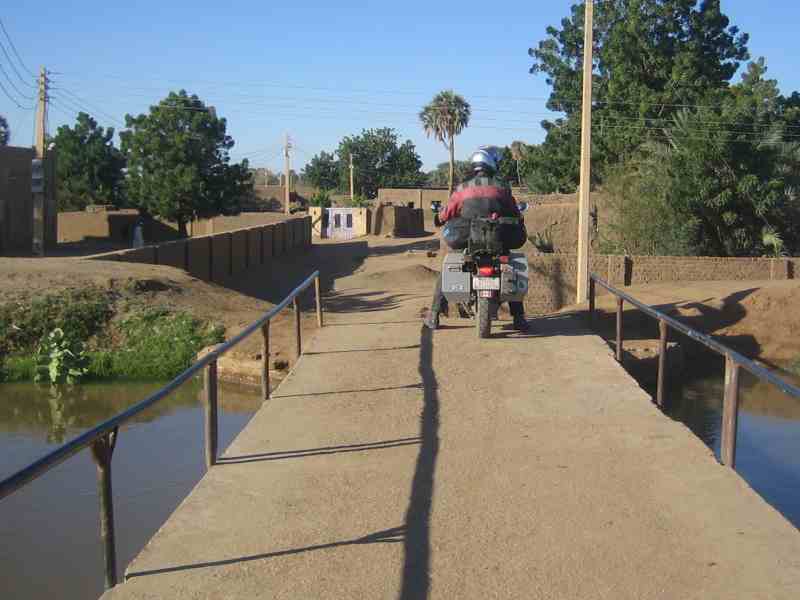
Making supper under the full moon

Monday morning dawned with the usual cloudless blue sky. With daytime highs of about 25 degrees and morning lows of about 10 degrees it was perfect riding and camping weather. Not bad for the 24th of December! When we looked over to where the headlights had been last night we were surprised to discover two minarets poking over the horizon. The lights must have been just at the level of the horizon and appeared to move with the air currents! Now that our UFO mystery had been solved we were ready to ride to the pyramids. They were only 40 kilometres south and it was an easy ride on the pavement before we turned off and rode half a kilometre or so of sand and gravel. These pyramids, much steeper than their Egyptian cousins, were built between 700 and 300 BC and were absolutely stunning in their desert setting. Since we wanted to get to Khartoum in the early afternoon we decided to enjoy the pyramids from outside the gate and save paying 20 Sudanese Pounds each for the entry fee. While the other drivers became a bit more aggressive when we got to within 30 kilometres of Khartoum (especially the minibus drivers) it was nothing compared to Egypt so we enjoyed riding around a little. I saw the back of a couple of Ducatis at one point so we followed them to the Blue Nile Yacht Club and Campground. It was Robin and Matteo. Tom was also set up there and Lapo had gone to the Acropole Hotel. It was nice to meet up with everyone again and we arranged to go for Christmas dinner that evening at the Acropole. In the meantime we decided to splurge for Christmas and went to the Khartoum Hilton using a bit of Christmas cash from my folks. Wow. It was like entering a different world. We were back in Western Civilisation, with hot and cold running water, a big comfortable bed and impeccable service. It was hard tearing ourselves away from it to go to the Acropole but Christmas Dinner was a great way to celebrate our accomplishment of riding to Khartoum from Wadi Halfa. Robin and Mateo even surprised us with unique Sudanese Christmas gifts.
Another beautiful morning in Sudan
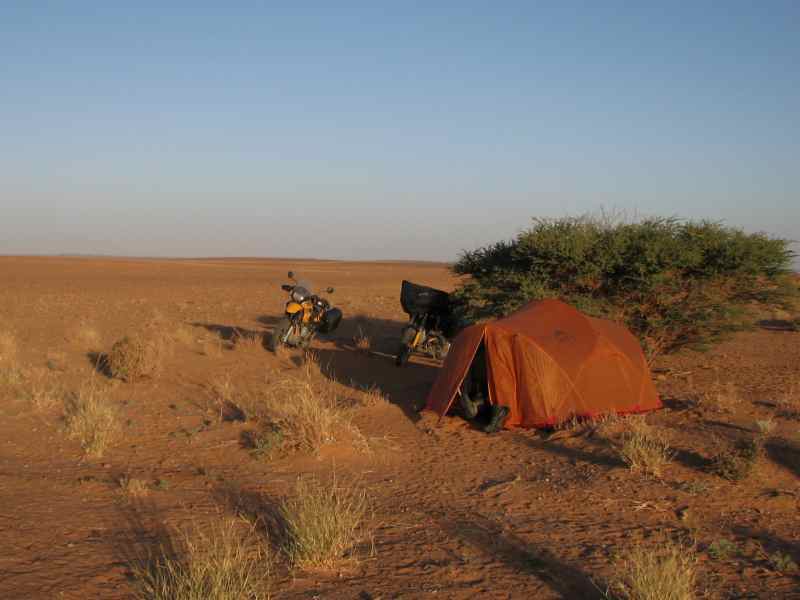
Pyramids of Meroe

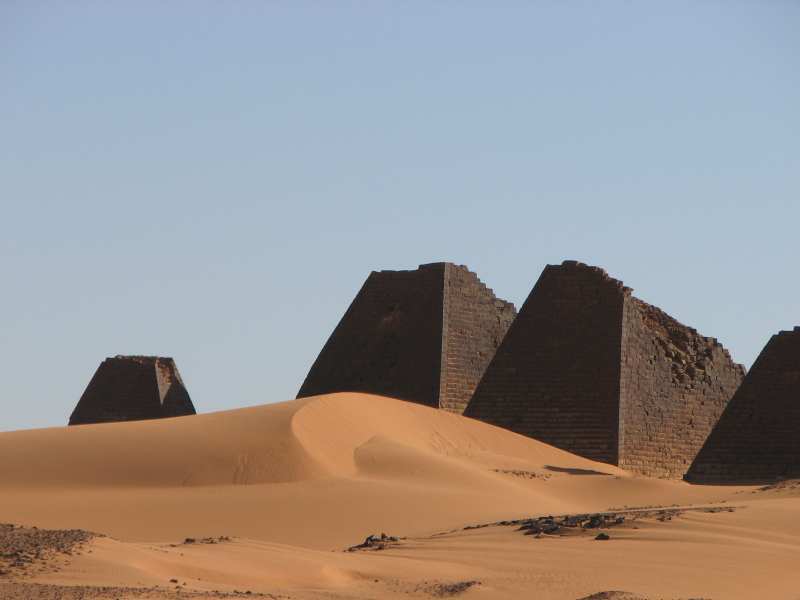
Just a little sand for Audrey's entertainment
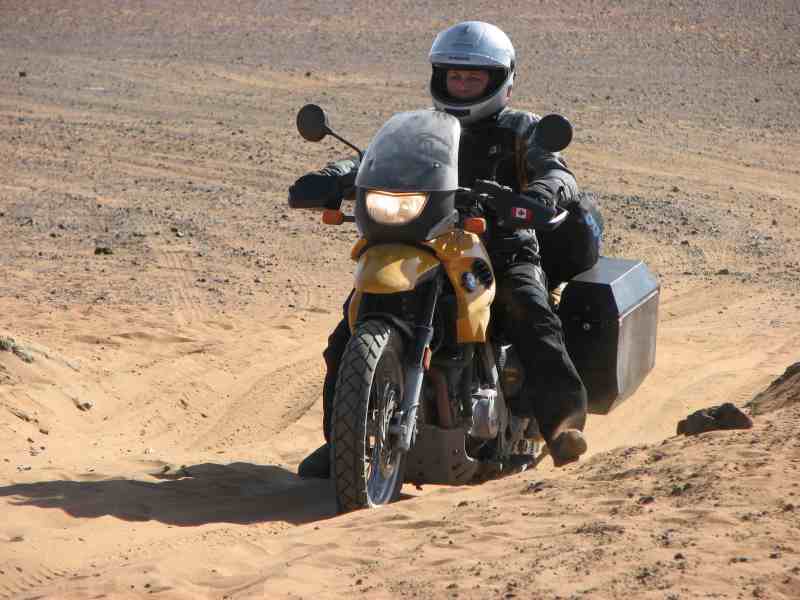
Can you believe they let the rif raf stay here?
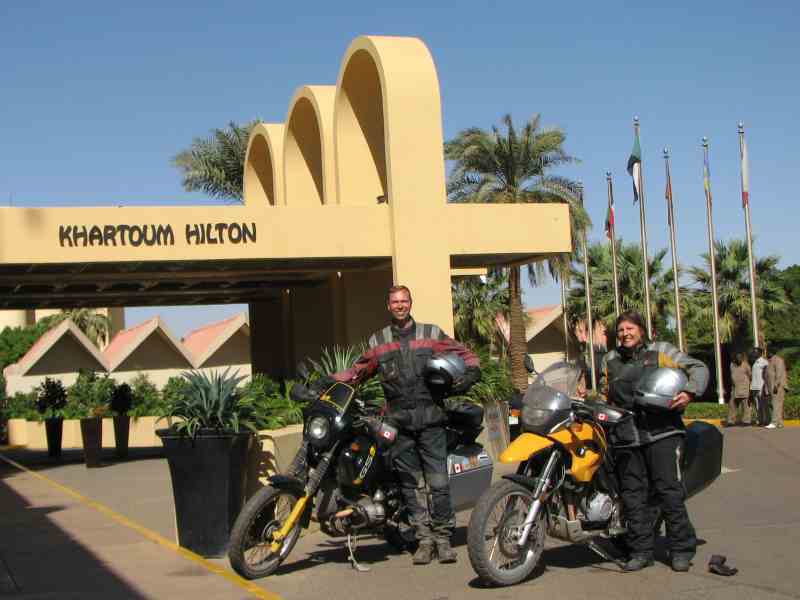
Tom and Matteo are touched by Bing Crosby singing White Christmas
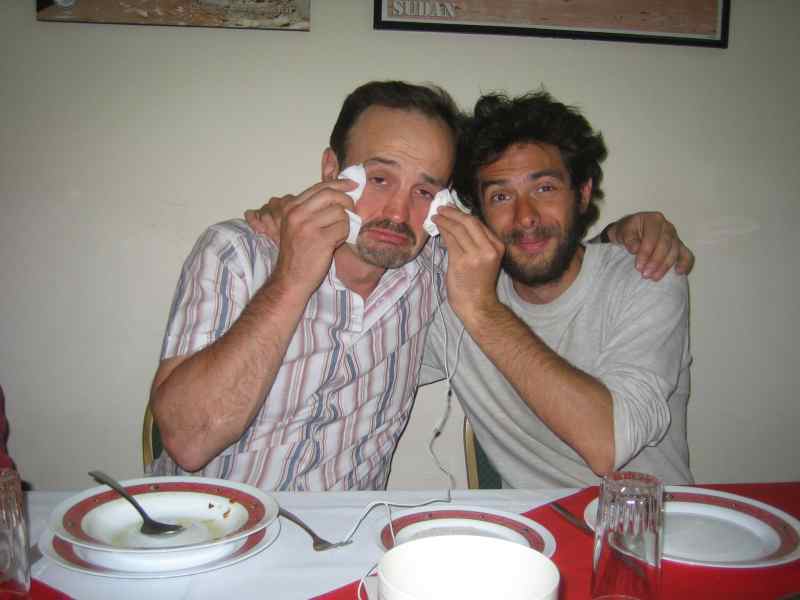
Wearing our new Christmas hats

Christmas day was a holiday in Sudan (not necessarily to celebrate Christmas but for some other reason) so we could not obtain our Ethiopian or Kenyan visas. We looked for a steering head nut at a small motorcycle repair shop but they had nothing that even came close. A Yamaha motorcycle shop might have something but they were closed as was the BMW car dealership. All I really want for Christmas is a steering head nut! The others came over to the Hilton for a fabulous Christmas Brunch. At 70 Pounds (about $35) it was hideously expensive but the buffet was great and we didn't need to eat any other meals for the day. The afternoon was spent lounging by the pool working to update the website and then we had a rousing game of ping pong in the recreation room, reminding us of the last time we played ping pong at a Christmas party at Bonnie and Dana's house.
Christmas day brunch cake

Our guardian angels lounge by the pool for a well deserved rest
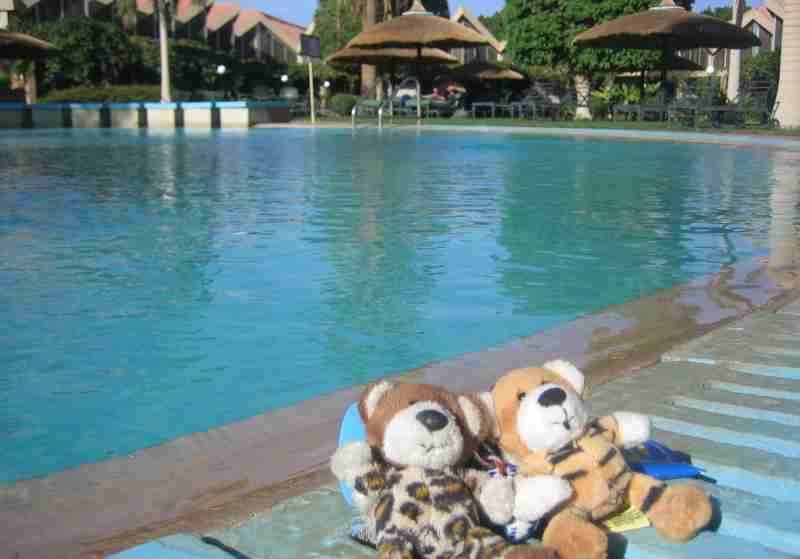
So far Sudan has been absolutely amazing with stunning scenery and the friendliest, most hospitable people we have ever met. Once we get the Ethiopian visa and the steering head nut sorted out we will ride to Ethiopia, hopefully meeting Tom to travel the tough roads of northern Kenya together. Robin and Matteo are on a different schedule, planning to take four weeks to explore Ethiopia while Lapo plans to blast down to South Africa as quickly as possible. If we allow a week per country it will take us six weeks to reach South Africa, giving us just enough time to get new passports and still reach the southern tip of South America before the risk of snow in March (Fall in the Southern Hemisphere).
Updated 16 January, 2008
Audrey writes:
Khartoum is a big city with some wide boulevards lined with palm trees and flowers, along the Nile. The Blue Nile, from Ethiopia, meets the White Nile, just across from the Hilton Hotel and it was a beautiful area. There were also different parts of the city where people live in cardboard shacks on dirt roads, quite a contradiction. Whenever you stay in a hotel you have to register with the tourist police. The Hilton offered the service of doing the registering for their guests so we tagged along with the fellow so that we could go to the Ethiopian embassy right afterwards. The registration took an hour and a half and our taxi to the Ethiopian embassy took a bit of a circuitous route, so we ended up missing the 11AM submission deadline. What a disappointment as this would put us behind another day. Maybe this is what is referred to as 'African Time', because it seemed to take so long to get things done. Back at the Hilton we asked for a late checkout (maximising our time there!) and Ekke went in search of the steering head nut for his bike while I was able to go on the internet. We packed up and said goodbye to the Hilton when Ekke returned at about 2 PM, and headed over to Blue Nile Marina, It was really a beautiful spot, with a decent lawn for camping and right on the Nile. What a surprise to see Lapo's tent sitting there. Apparently he had ridden towards Al-Qadarif with Tom, and his bike started having electrical problems again. He came back to the big city for a new battery and rotor. Lapo's bad luck was our good luck as he was able to direct Ekke to a motorcycle mechanic where he could get the steering head nut that he needed, and then have it sized on a lathe. Since there were no BMW parts available here, we had to go for the African solution.
Getting ready to make a new steering head nut
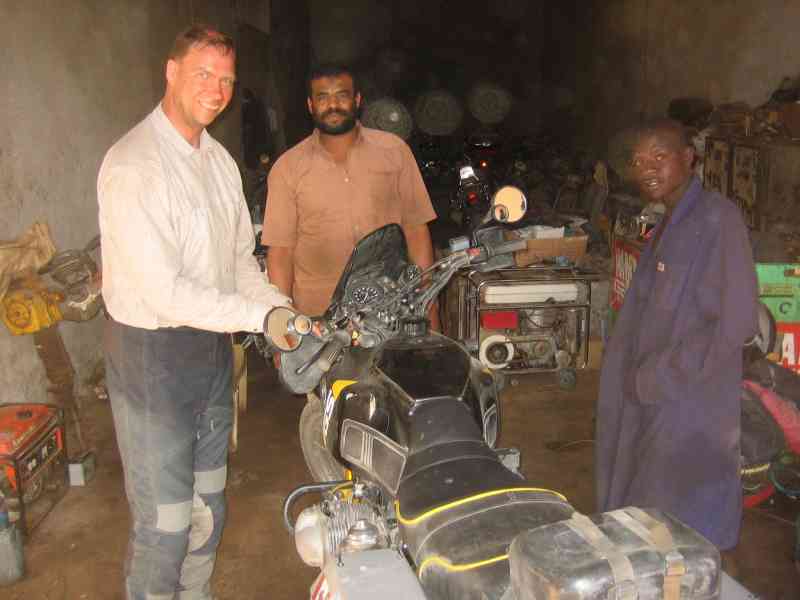
On Thursday the 27th Lapo and the Ducati boys, Robin and Matteo, left for Ethiopia. We had no trouble applying for our Ethiopian visa first thing in the morning and then Ekke went to Lapo's motorcycle mechanic. Using the GPS we wound our way through a maze of dirt streets and found it easily. People were always so friendly, offering us some mint tea and moving another bike out of the way to immediately work on Ekke's. I rode back to the marina and took advantage of the sunny 35 C day to get some handwash done. I heard the happy sound of a couple of motorcycles, and two KTM riders from South Africa rode in. Rocco and Steven were riding from Cape Town to London, supposedly in 50 days. And we thought we were on the fast track through Africa. They had lost a few days in Addis Ababa getting their Sudanese visas, and were on a mission to get to the Wednesday ferry to Egypt, which ran once per week. They told some hilarious stories about their adventures so far, such as when they followed the wrong 4x4 to a camping spot and no one knew who they were once they got there. We exchanged tips on interesting sights, roads and border crossings.
Ekke had not returned to the campground by the time we could pick up the Ethiopian visas so I decided to ride over on my own, and got royally lost on the way. At one point I was so excited to be on the correct road, but then it came to a bridge over the Nile. I didn't remember having to cross the river, and when I looked down, I saw the marina campground, with our orange tent sitting there. I was going exactly the wrong direction on the right road. Maybe it's time to ask for a GPS for my birthday. My next plan was to get in the general vicinity of the embassy and hire a taxi to follow to get me right there. After a 15 minute U-turn, who should pull up beside me but my hero, Ekke. He had gotten the bike fixed, picked up the visas, and then saw me riding down the street in the opposite direction. Thank goodness! He had to do a U-turn, ride a block on the sidewalk and then cross an intersection diagonally against the light to catch up to me.
On December 28th, we could finally leave Khartoum in the direction of Ethiopia. The road was paved, with a few potholes and plenty of buses and trucks. So, we got to use the power of the BMW's to constantly pass convoys of vehicles. At one point the temperature reached 39 C, but was a cool 36 C for most of the day. African mud huts were silhouetted by rocky hills as we rode further east, and it was still very desert-like. In a friendly restaurant in a small town, we decided to try the local cuisine. Usually before we order any food we like to know the price, but we couldn't seem to get it out of the server. This sets off the alarm bells, but finally, he just held up his fingers in the shape of an 'O", which meant five Sudanese pounds in Arabic numbers. But, it turns out that the cost of the meal really was zero. Another customer had paid for our food! This gentleman was so excited to see some Canadians trying the local cuisine that it was his pleasure paying for it. The dura, lamb and dumplings with spongy cornbread and fuul were delicious, and we were overwhelmed by the generosity. He was really excited to receive a Canadian flag pin in return.
One more example of Sudanese hospitality

Housing architecture changes as we move east but the ever-present mosque is still there
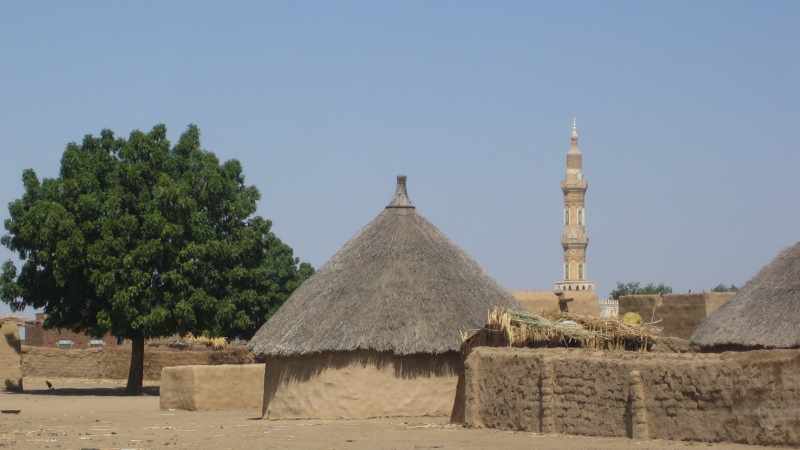
Al-Qadarif was our destination for the day and we made it easily before sunset. The KTM guys had told us that there were two hotels in town, one not recommended, and one very expensive at $90 US per night. They couldn't get the hotel manager to budge on the price. We tried the cheaper one, which didn't look like such a bad place until we saw the pile of dead cockroaches in a neat pile by the front door. Another one scurried out the door as Ekke checked out the room. A little bug spray probably would have done the trick, but we couldn't get the clerk to budge from $86 US per night. Hating to be held hostage by high prices, we rode east of town to free-camp. Ekke had downloaded some GPS waypoints from a Dutch couple in a 4x4 who had marked where they stayed, ate, or where the police station was. The waypoint was located down a little dirt road, in a field behind a small hill. Perfect. Not wanting to draw too much attention to ourselves, we waited until dark to even attempt to put the tent up. There were these little holes in the dirt that were kind of puzzling, and we wondered what kind of creature lived in there. We soon found out as we cooked a bit of supper. A swarm of yellow jackets descended upon us and it was a hilarious sight as we grabbed our plates of pasta and ran into the nearby field. Later as we were tidying up, we saw a herd of cattle in the distance. They kept getting closer and closer, and it eventually dawned on us that we were sitting right on their pathway. The herders parted the herd and took it around us, but it was a little disconcerting to be in the middle of a group of 100 cows, many of them with very pointy horns. The herders seemed to have a good sense of humour about it, and after a few photos and handshakes, they went on their way. Crazy Canadians!
A dinner interrupted
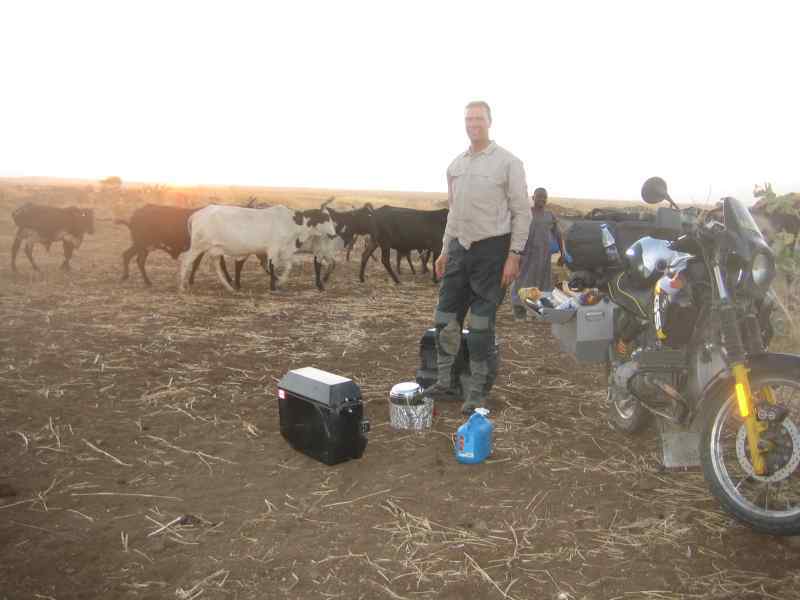
Smoke was rising up from behind a nearby hill, and we surmised that someone was burning garbage or cooking. But as it started getting dark, we noticed flames and smoke in another field, and then another. Not wanting to be caught in these wildfires, we went to investigate the smoke over the hill and see how close it was. On the way, we spotted another little wildfire burning, about a metre in diameter, and it was burning the surrounding dry grass. We honed our firefighting skills, and threw dirt on it, which seemed to work. Making sure we stamped out the bigger coals, we assessed the situation and decided to move our camp to the middle of a black field, one that had obviously succumbed to a previous fire, and had very little left for fuel. Feeling very safe in the complete darkness, not seen by anyone, we set up the tent without the fly, which is mostly mesh. Lying in the tent and staring at the millions of stars was just unforgettable. Especially when Ekke heard footsteps. We can't be sure what walked by our tent, but we think it was some sort of hoofed animal like a cow or donkey. Slightly scary, though. The wind picked up and the air cooled down, so we put the fly on the tent in the middle of the night and had a fairly restless night dreaming of wild animals.
The middle of a blackened field
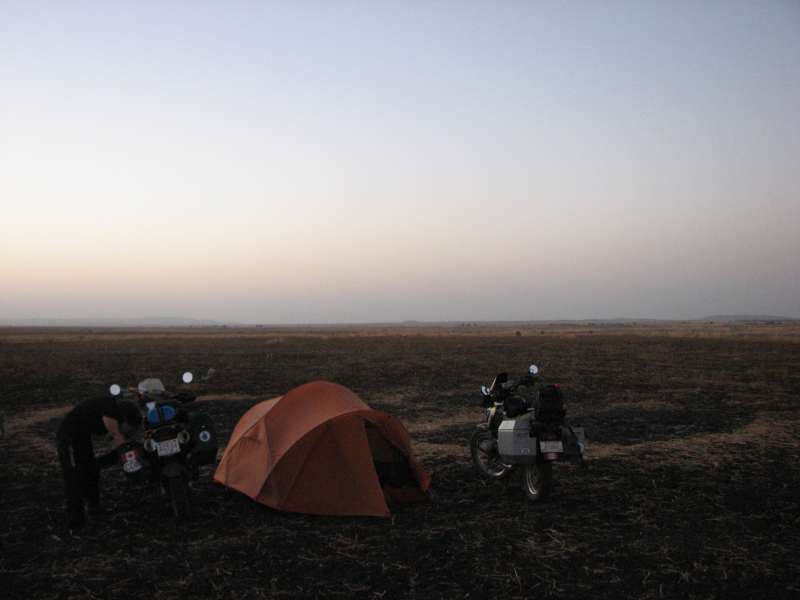
We woke to the sound of a bunch of cows being herded into the fields, and packed up quickly, destination: Ethiopian border. The road was virtually new (apparently the Chinese are investing huge sums in Africa) and it was a breeze to ride the 160 kilometres. Depending on how long the border formalities took, we had high hopes of making it to Gonder in Ethiopia that night. Little did we know what was in store for us in Ethiopia…
Maps of our route through Sudan

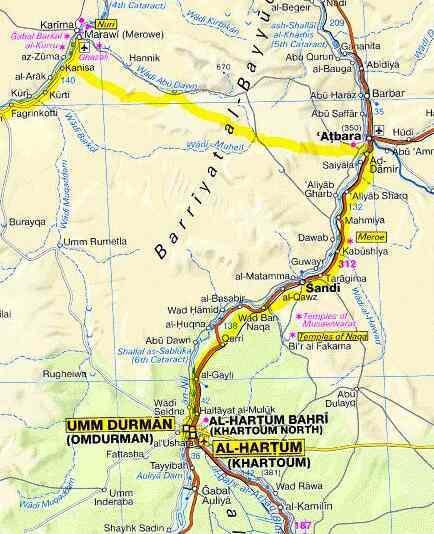

Leaving Sudan was relatively easy; only having to go to a couple of different offices. We spent a few pounds on sodas and snacks and then used the black market to change the remaining pounds to Ethiopian birr. At first the black marketer was only going to offer us half of what we knew to be the bank exchange rate but we eventually got him to a more reasonable number under the curious eyes of a customs official.
What a difference 50 metres makes! The Ethiopian passport control office across the bridge from the Sudanese border post was nothing but a mud and stick hut. Inside, the office was decorated with beer advertising posters and calendars. We entered Syria on November 18 and now, January 29, we exited our last Muslim country to come to Ethiopia. It was quite a shock to see advertising for alcoholic beverages with provocatively dressed women. It was also rather shocking to see the filth on the dirt streets of the town of Metema. Sudan had never been this dirty. To complete the entry into Ethiopia we needed to proceed another 30 kilometres down the road in order to get the Carnet de Passages stamped. What a rough road it was too. Not only was the road under construction, adding lots of detours, but the road was comprised of large rocks which really shook the bikes. It must have taken an hour to go the 30 kilometres. When we found the customs office we discovered that the officials were on a nice lunch break, lasting from 12:00 to 3:00. We eventually persuaded the young gentlemen to do the work for us as we still had to ride 130 kilometres on the rough road. Riding along we found that there were quite a few villages but they all appeared rather poor compared to the Sudanese villages. Almost all the houses were constructed of mud and sticks and while the people were friendly enough, they were simply dressed. A big departure from Sudan was how we would get instantly mobbed every time we stopped. Personal space was simply not valued to the same extent as in Canada or any other place we had been. Slowly the light started to fail as we climbed up a spectacular valley onto the high Ethiopian plateau. We knew that the rough, dusty road would not allow us to reach Gonder before dark. Saturday must have been a market day for a number of villages along our route. As we rode along we would pass a steady stream of people and animals for kilometres out of town. Being later in the afternoon we usually passed people walking home from the market town. Approaching the town from almost ten kilometres away we would encounter people walking towards us and then after passing through the market town we would come up on long lines of people walking down the road. With the road being confined by the valley and cliffs there were very few opportunities for camping out of public view. Eventually we found a flat spot a few dozen metres from the road. We pulled up and instantly a crowd formed asking us questions such as, "Where you go?" We said that we were just going to have a bite to eat and then move along so as not to attract their attention. After dark we pitched the tent and made ourselves as inconspicuous as possible. People kept streaming past on the road, sometimes with flashlights, but mostly not. They kept coming until about 8:00 PM and fortunately no-one noticed us.
Riding into Ethiopia

Rough construction zones

Better get used to riding with animals and people on the road
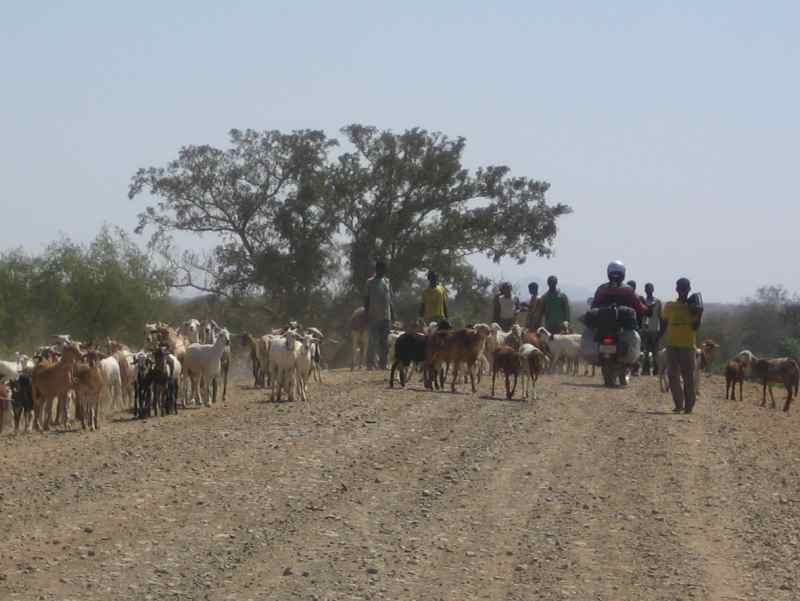
It is market day!

Riding through an Ethiopian village
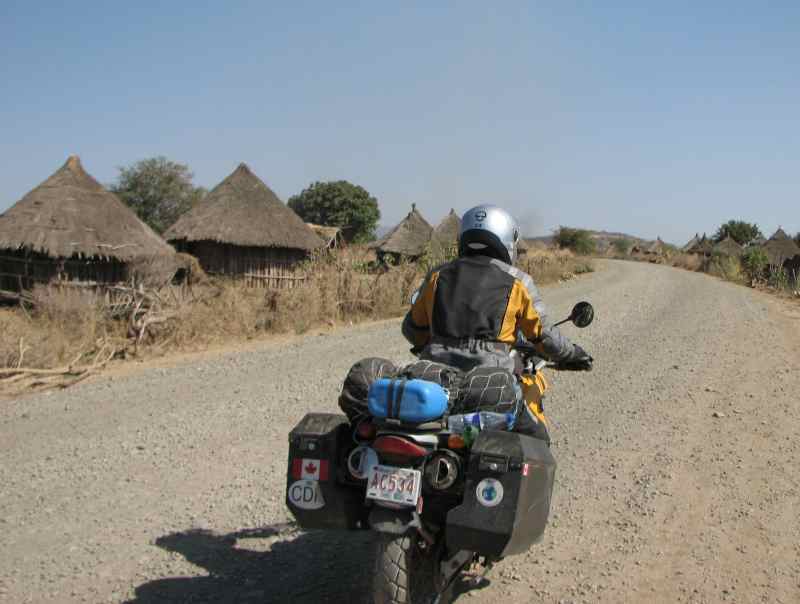
The early morning light revealed the spectacular valley spread out around us as the road switchbacked up the mountainside. A young girl was watching us as she would have watched a couple of Martians loading up their spaceship; respectfully from a distance but with intense curiosity. After taking some photos of the sun rising over the valley we started back up the switchbacks on the dusty, rough road. Fuel had not been available in Sudan and not along the way in Ethiopia so we were getting a little concerned about running out of gas. At the next major town we asked about fuel and a college educated person with excellent English came over to help. He showed us a small mud hut where barrels of gasoline were stockpiled. We each filled up with ten litres at a cost of 9 birr per litre (about $1/L) and the crowd that we drew was very impressive. Most people were just incredibly curious but not saying anything. They would however, come closer and closer and no-one ever left the group with their curiosity sated so a crowd would only grow larger, never smaller. Where the road met up with the road from Addis Ababa it became perfect pavement for a short ride north to Gonder. Once in town a "guide" ran up to us and said the Italians were staying at the Belegez Hotel. He ran ahead to show us the way as the main road was closed for a bicycle race. At the Belegez we were informed that the Italians were not there and they didn't have any double rooms so our guide suggested we try the Queen Tetsyu Hotel. Opening the gate to the courtyard we were happily surprised to see two Ducatis and a Suzuki V-Strom parked inside! Re-united with Robin, Matteo and Tom we swapped stories of our adventures since we parted ways in Khartoum.
Morning cup of coffee

A watchful girl
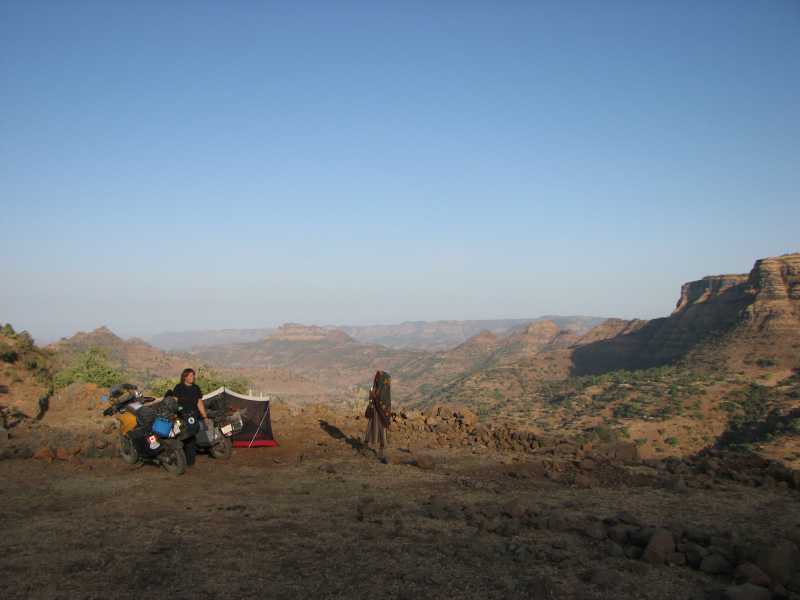
Audrey attracts a crowd while fueling up
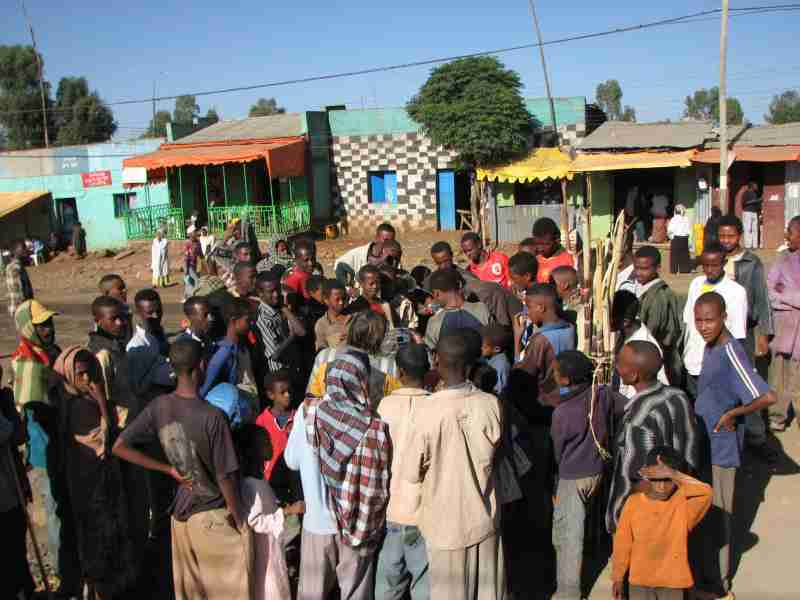
Walking with a stack of hay was not unusual
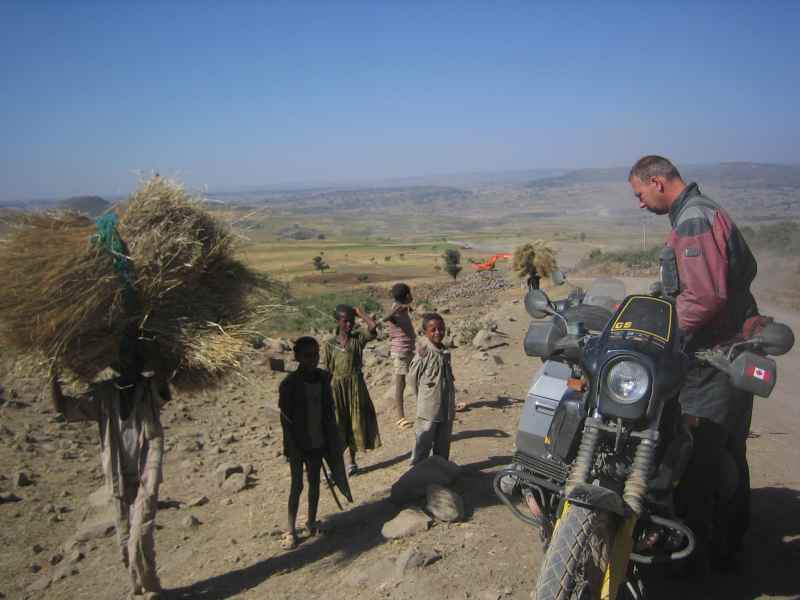
Re-united in Gonder

The rough road from the Sudanese border highlighted the fact that the newly manufactured steering head nut was too loose so I went on a search for a machine shop. Having found one I then spent the morning getting the nut made to the correct size. As a backup I asked Peter in Germany to order the proper part from BMW and have it delivered to Addis Ababa. Early in the afternoon all of us went to see Kate's Empress Mentewab School. Kate had set up a school for disadvantaged children from poor families as well as employing two blind women to make carpets and a diabetic young man to make fabric school bags. Not to mention the animal sanctuary where she nursed animals back to health. It was all very inspirational and we made a bit of a donation. Check out her website at www.kateferedayeshete.net. As the laundry service had lost Audrey's favourite shirt we went on a bit of a hunt to find it. We had no success and met a group of people (including James and Claire who were volunteering at Kate's school) to go for drinks at the Goha Hotel, perched on top of a hill overlooking Gonder. Later we had supper at a local restaurant in town and then we went to a bar to celebrate New Year's Eve. Our timing for this trip was absolutely perfect. We spent Christmas in a Muslim country where Christmas isn't celebrated and now we were spending New Year's in a country that doesn't use the same calendar so Ethiopians weren't celebrating anything. The bar was very quiet with only a few locals in attendance on this ordinary Monday evening. As we approached midnight the bar became emptier and emptier until by 11:30 it was only the four of us and the staff. At midnight, Shania Twain was singing "Man I Feel Like a Woman" and the four of us let out a big cheer to the amazement of the staff and the manager who brought over some heavy-duty sparklers. There probably aren't many safety regulations in Ethiopia concerning fireworks but I don't think these sparklers were meant to be used indoors and certainly not to be held in a bare hand. To the relief of the bar workers we trudged out at 12:15 so that they could clean up and go home.
Empress Mentewab School
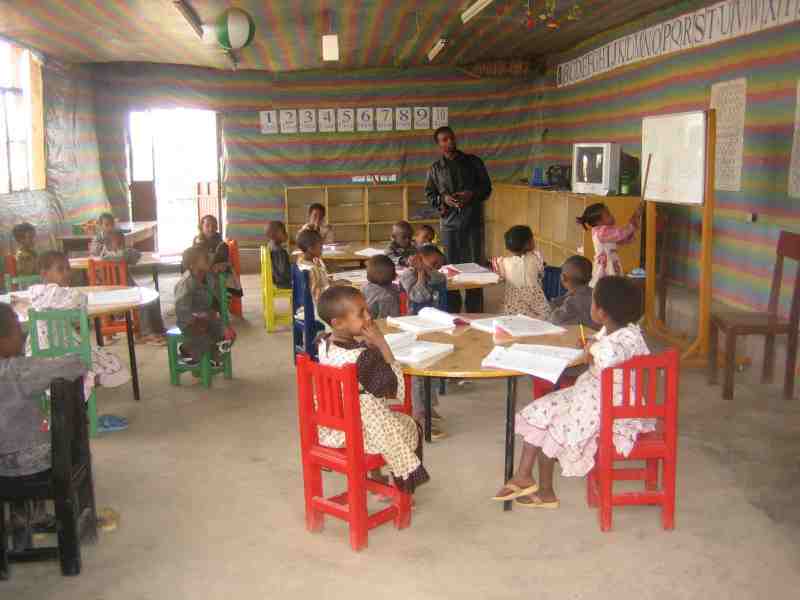
Fasilidas Palace in Gonder

Robin, James, Claire, Tom, Matteo, Audrey and Ekke at the Goha Hotel
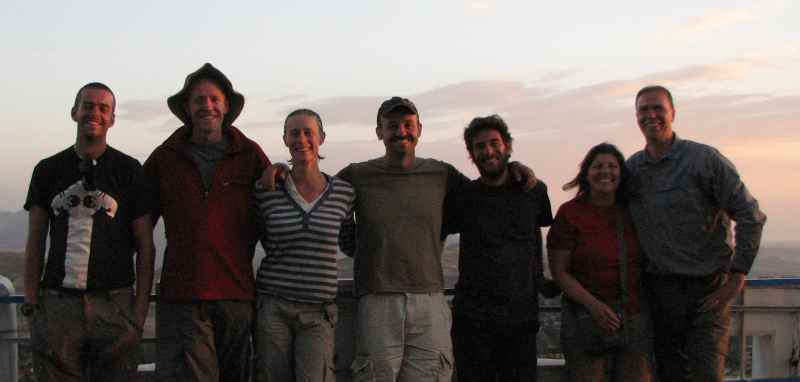
The first day of the New Year we enjoyed a beautiful ride from Gonder to Bahir Dar. The start of the ride was delayed a bit so that we could enjoy a delicious fruit smoothie while waiting for the power to the gas pumps to be turned back on. Perfect pavement was a welcome relief after the ride from Sudan. The Ghion Hotel in Bahir Dar was situated right on Lake Tana with a terrace restaurant overlooking the lake and a spectacular garden in the courtyard. It was a little too late to take the ride out to the Blue Nile Falls (the Blue Nile starts at Lake Tana) so we took the afternoon off.
Beautiful gardens in the courtyard of the Ghion Hotel
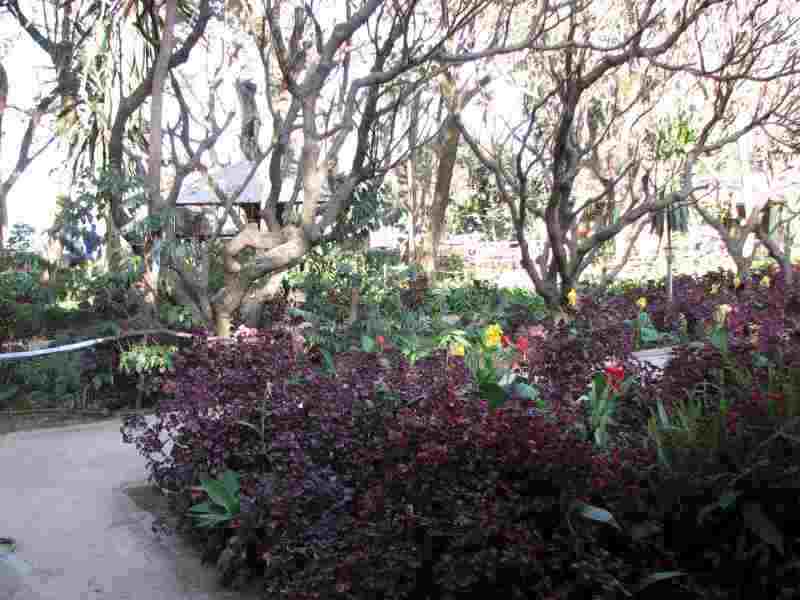
The next day decided to take a boat tour of Lake Tana to some of the monasteries on the islands. John and June in a Toyota Landcruiser from New Zealand and Tom (who had arrived the previous evening from Gonder) joined us on the three hour tour. For 100 birr each we got to visit 5 monasteries. When we got to the first monastery we were surprised to learn that they wanted an additional 30 birr fee to see the monastery. The five of us thought that the 100 birr price included the monasteries. After a bit of animated discussion we all trooped back down to the boat and told the boat driver that we had no intention of seeing 5 monasteries and paying 30 birr each, so he should just take us to the best one. He honoured our request and we cruised over to the Azwa Mariam Monastery on an island a short hop away. Our 30 birr fee got us in to a beautiful round building made of made of mud and sticks. Very colourful paintings on cotton decorated the entire outer circumference of the building. On the way back to the hotel we stopped off at the mouth of the Blue Nile in the hopes of seeing hippopotamus lazing in the sun but apparently it was too late in the day.
John, June, Ekke and Tom have breakfast before the boat tour

Audrey and June board the ship

An illuminated manuscript at the first monastery

Azwa Mariam Monastery
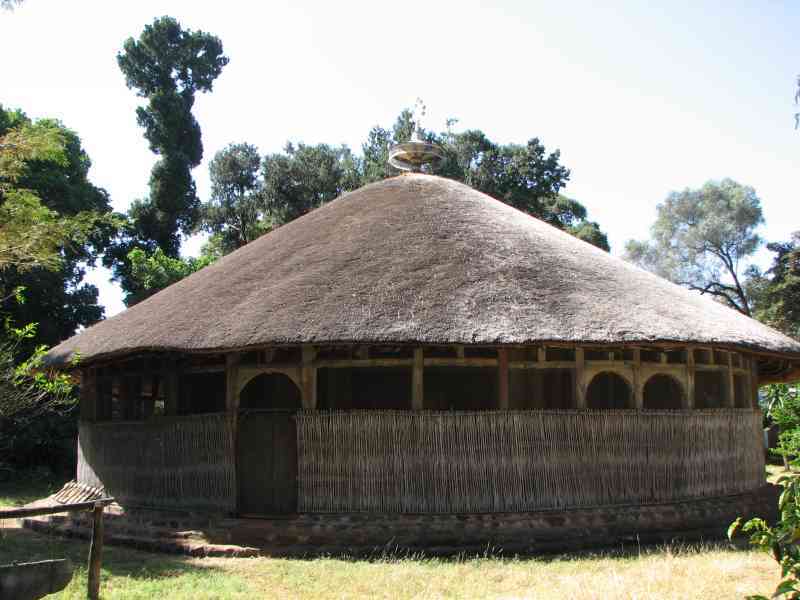
St. George was a fairly common theme throughout Ethiopia

Reed boat used to deliver wood to the mainland
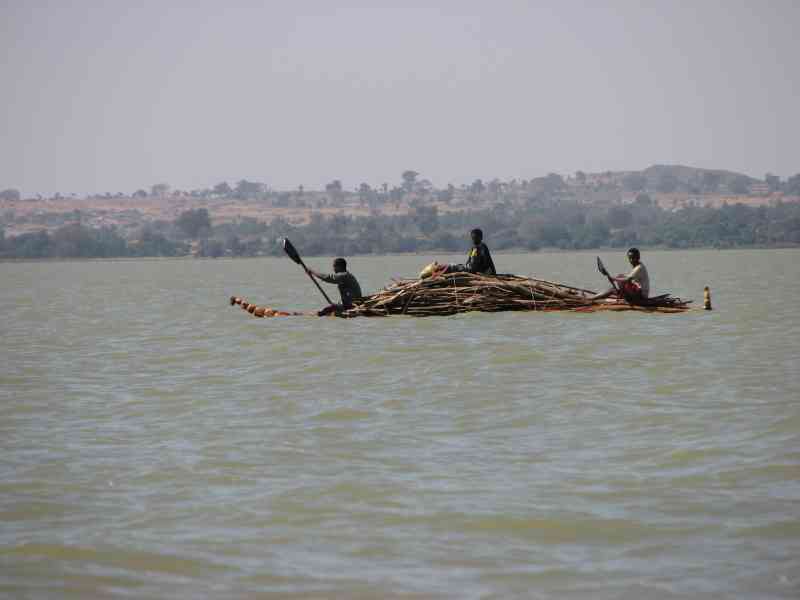
Headwaters of the Blue Nile
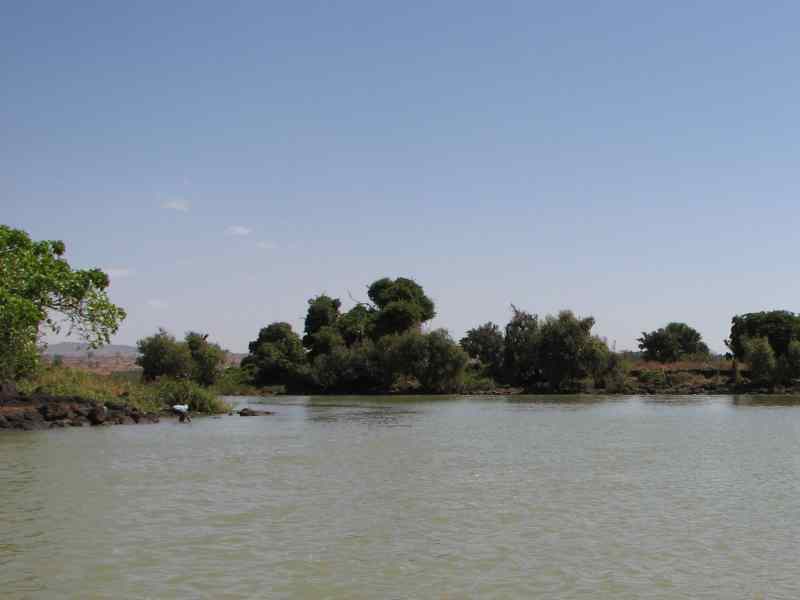
Audrey writes:
We were really interested in seeing the rock-hewn churches of Lalibela, but we weren't interested in spending four days riding there and back again. Ethiopian Airlines offered a return flight for $147 each, so Ekke, Tom and I took advantage of the cheap flight and saved the wear and tear on the bikes and flew out on Thursday, January 3. From the air, we had some spectacular views of very dry land, and up till now Ethiopia had been fairly green. The rivers were running dry or low, and fields were a patchwork of brown and black. Flat plateaus suddenly dropped off to sheer cliffs all around. Perched on top were small towns, the houses made of mud and straw capped with tin roofs. The canyons were very rugged, and some were actually terraced for farming. Occasionally a piece of green would appear, a clump of trees with a huge round hut in the middle, a Christian Orthodox monastery. We saw the road winding up through the canyons, across plateaus, and down the other side again. Later, we talked with some Serbians who had taken the bus on this route and had plenty of scares. Their bus had actually done an unplanned 180 degree turn and in another incident almost went off a cliff. It was great to have some feedback on the road, knowing we'd made the right decision to keep the bikes in Bahir Dar. After about 45 minutes, we landed at the airport and buses were waiting to take us the 25 kilometres to Lalibela. The town was originally called Roha but was changed in honour of King Lalibela, the first king of the Zagwe dynasty and the one to build the rock-hewn churches. His seven kilogram gold cross was stolen a few years ago, bought by a Belgian collector, and finally returned to Ethiopia for a price. We did have an opportunity to see it, but when we went into the Bet Medhane Alem church, the priest wouldn't take it out for us.
Village perched on top of a plateau

Ekke arrives in Lalibela a lot less dusty than if he would have taken the bike
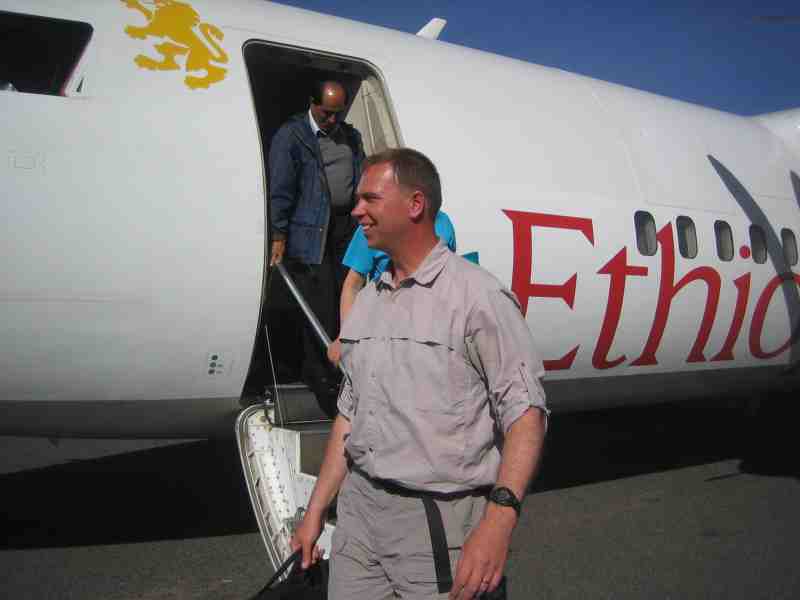
Rich and Michael from Calgary and Judith and Nina from the Netherlands joined us for a guided tour of the churches. It was great to have a guide, not only for the information, but to help keep the beggars away, which was a real problem in this town. Our Lonely Planet guidebook had advised us to put some flea powder on our socks before entering the churches, so it was quite hilarious to watch everyone sprinkling the white powder (with a picture of a dog on the label) into their shoes. We walked up a steep hill, paid the entrance fee, and went into our first church. Our shoes had to come off, and we walked on some fairly well-used carpets. I don't think anyone encountered any fleas, though.
Tom, Nina, Rich, Judith, Mike, Audrey and Ekke
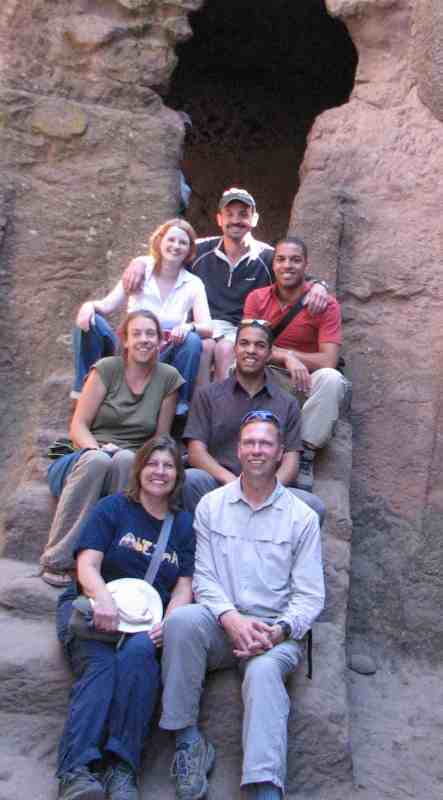
I didn't realize how many pilgrims had come to Lalibela until we tried to get into the churches. It felt like there were hundreds of them pushing us out as we were pushing them back in. Many of these pilgrims had walked hundreds of kilometres, from all over Ethiopia, and just lived among the trees and churches during their stay. Their white robes distinguished them from the locals, and apparently thousands more were to come for the Orthodox Christmas, January 7th on the Ethiopian (Coptic) calendar. The town was already full to bursting with pilgrims and the view from the hilltop was a sea of white as they attended a prayer meeting or market.
Pilgrims crowding the small pathways around a rock-hewn church
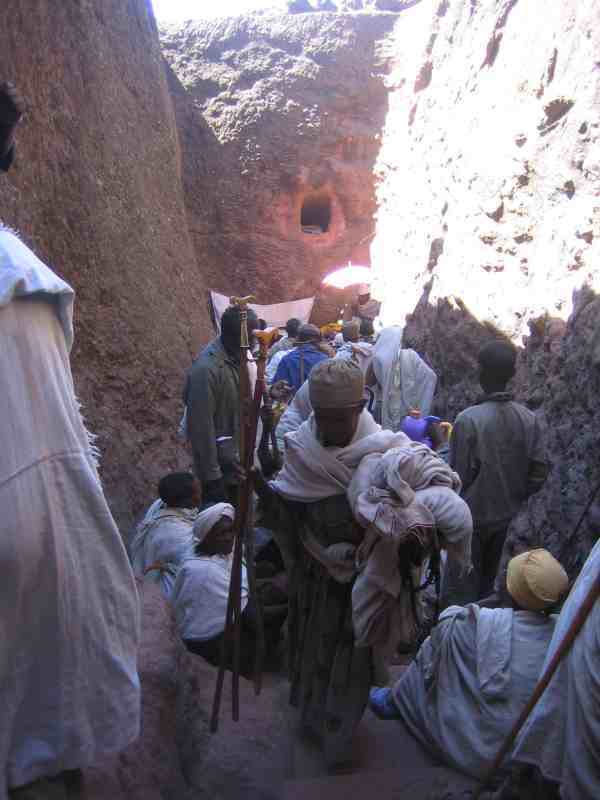
Audrey leads a parade of pilgrims

One of the churches actually resembled a Texaco gas station. UNESCO had graciously donated covers for most of the churches, and they weren't as aesthetically pleasing as they could be. But, they served a purpose in protecting the tops of the churches from the elements. The 11 churches were hewn from the solid bedrock, so the roofs were actually at ground level, and the doorways far below, reached by either a tunnel system, ramp or stairs. They were usually arched inside, sometimes with carvings of the kings or saints. Saint George was always recognizable by the dragon he was slaying (but I'll always remember him for his namesake beer, an Ethiopian brew). A priest would occasionally make a big show of bringing out a cloth-wrapped gold cross or staff, and then put on sunglasses before the big unveiling. We were a bit puzzled as to why he put on the sunglasses, but after all the flash photography started, we soon knew the reason for it. In one church, us women weren't allowed to enter into one of the chapels so the guys got an extra special tour. Not fair!
There were times when we dreamed of seeing a Texaco gas station
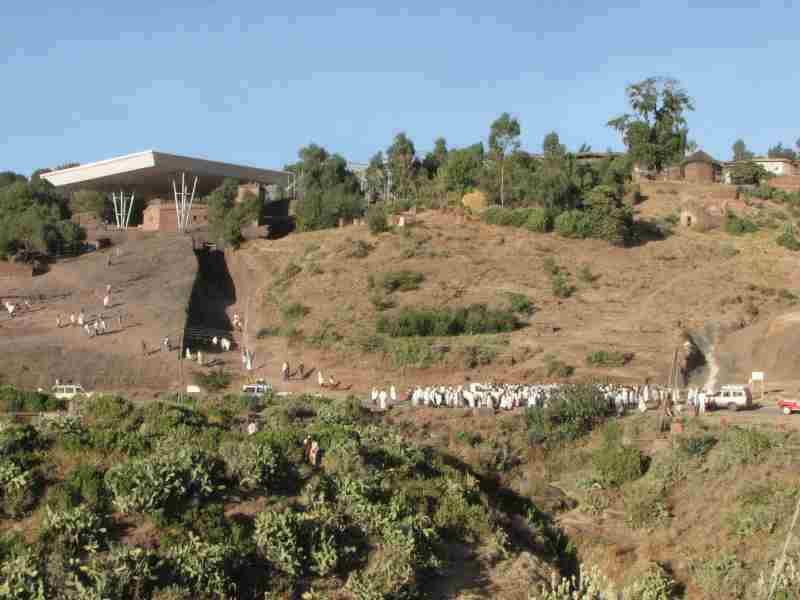
Displaying the church's cross and prepared for flash photography
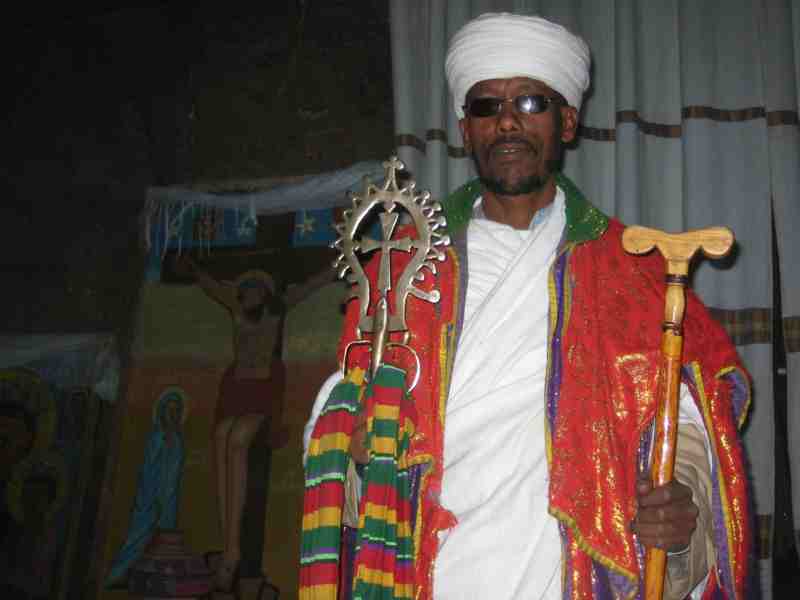
The whole morning was spent trying to elbow our way through pilgrims in small, confined spaces. The sensory experience made it a bit claustrophobic for me so I would often just have a quick look inside and then spend my time outside in the fresh air. I think my sense of smell had been heightened by having a dodgy stomach, so I could only take a few minutes in a church. The afternoon was a lot better, as the pilgrims were off at prayer meetings, and the churches only had tourists. St. George Church was not yet graced by a UNESCO cover, and it was just stunning seeing it from above. It was built as a cross shape and was hewn deep into the ground. It's probably the most recognizable of all the Lalibela churches.
St. George Church

A pilgrim

We were not only lucky to be in Lalibela when so many pilgrims were there, but we also caught a market day. Pushing into the churches with pilgrims was crowded enough, but this was worse. There was one narrow opening into the market area, and we were elbow to elbow with hundreds of others. Blankets were spread everywhere and were covered with grains and seeds, many of which we didn't recognize. One of them was tef, a grain used to make injera bread which had a remarkable resemblance to sour foam-rubber. I hadn't yet acquired a taste for it. Makeshift booths sold clothes, vegetables, or Lalibela crosses. Donkeys and cows wandered freely, trying to find their way to the animal market. A walk up the hill which was always swarming with pilgrims and locals, took us to the Seven Olives Hotel, a great refuge from all the excitement outside. It was also a great place to get Western food such as pasta or french fries, and enjoy a beautiful sunset from the patio.
Yes, the market was crowded
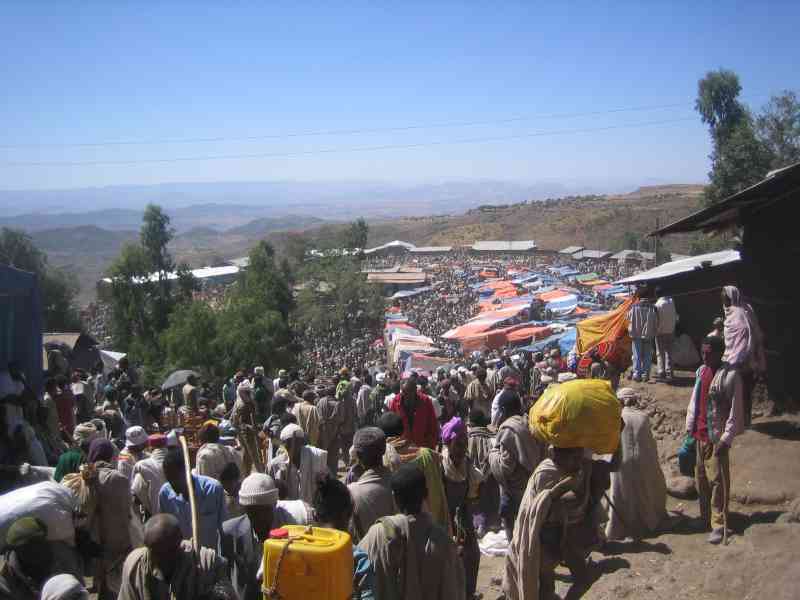
Need any grain?
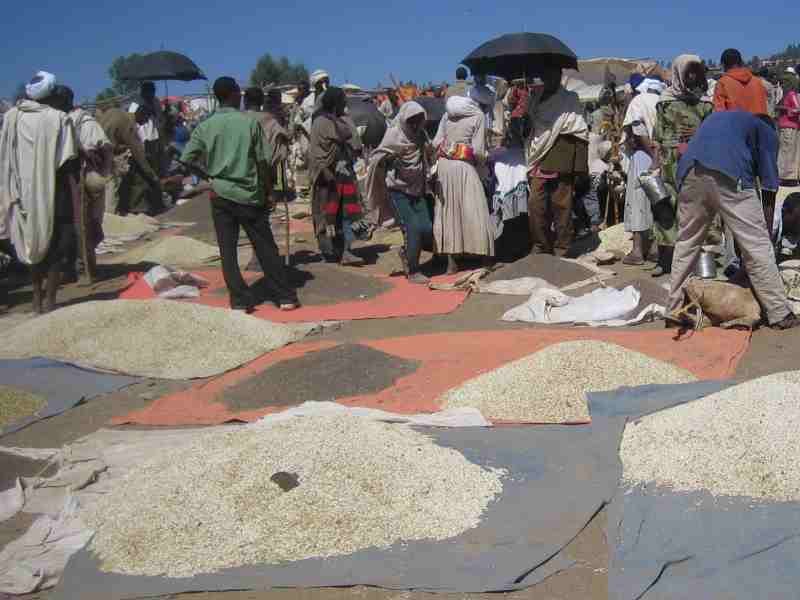
Ethiopian Airlines had wanted us at the airport two hours ahead of time, but Tom, Ekke and I all agreed that it would be more pleasant to spend our time at the Seven Olives instead. When we finally did check in, a very surly clerk asked us in a nasty tone why we were late. As we just shuffled our feet like school children getting reprimanded for coming in late for recess, 'Mr. Surly' informed us that the plane was full and our seats had been given away to stand-by travellers. It was slightly disconcerting, wondering if we were going to get on the flight or not. Anyway, he went away, and a while later another guy came and cheerfully checked us in, no problem at all. Needless to say, we were all a little miffed at the first guy. Upon arrival in Bahir Dar, Tom went to collect his bag from the luggage carousel, and it wasn't there. Staff looked through all the bags on the plane, and still no luck. Apparently the bag had gone on another plane to Addis Ababa and he'd have to check back the next day. Could the mix-up have been due to 'Mr. Surly' at the check-in, I wondered.
Relaxing at the Ghion Hotel by Lake Tana seemed to be just what we needed after our little trip. Our room faced the garden courtyard, and it was quite pleasant to just roll out of bed, walk a few steps to the gazebo, and enjoy fresh papaya and pineapple juices with breakfast. The weather was perfect and we knew it would be difficult to leave this beautiful location. The situation in Kenya was also a concern. After the mid-December elections, rioting had broken out in many of the major centres, and there were some food, water and fuel shortages. We heard of some motorcyclists being stuck in Marsabit for six days because they couldn't get gas. So, we rationalized that if we had to be stuck in Ethiopia for a while, the Ghion Hotel would be a great place to spend more time, as opposed to Addis Ababa.
A day trip out to the Blue Nile Falls from the Ghion Hotel
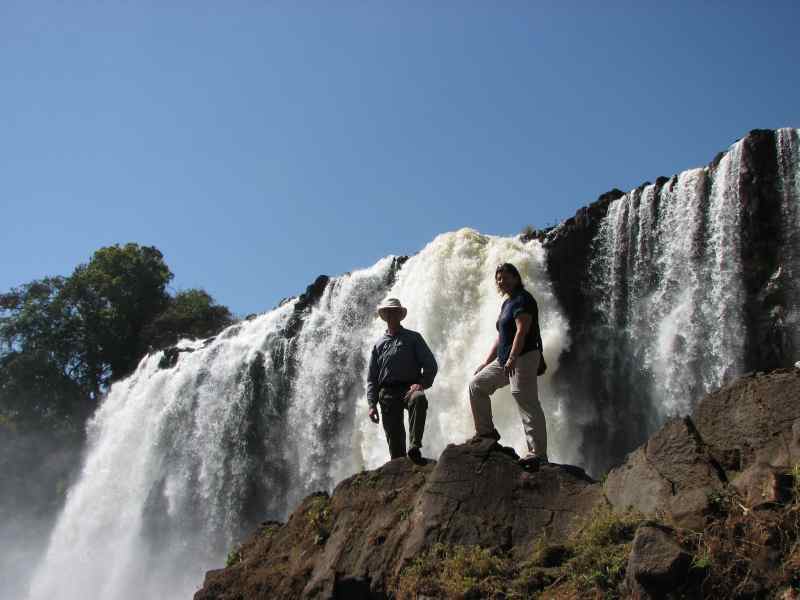
A fun array of characters always appeared at the Ghion outdoor cafe. Jeremy, a history professor from Victoria B.C., had come out of retirement and was teaching at the Bahir Dar University. He regaled us with tales about his years in Portugal as a Macleans correspondent, his adventures in north Africa in his army days, and of his great grandfathers' time in the Manitoba Parliament. We also met Norman, a French Canadian teaching English in Addis, who was very helpful in showing us a great nightclub to spend Christmas Eve (January 6th). Josee-Anne, a Canadian teacher who had taught in Iqaluit was now working out of Cairo and went to see the Blue Nile Falls with us. Dominic, an American who taught in Addis, told us how he would visit the local hospital and play with the kids, at one point contracting ringworm from them. Jennifer, an American who taught law at the local college, looked like Jennifer Lopez. She said that she made it clear to any of her students that if they called her J-Lo, they would fail the course!
After a few days, we eventually decided it was time to go to Addis Ababa in hopes of getting more of a sense of the Kenya situation. Tom was the first to leave as he seemed to enjoy leaving at 4:00 PM and riding at night. His luggage had never turned up, by the way. Robin and Matteo had made it down from Gonder, and we decided to ride to Addis together. But, at the gas station, Ekke noticed that gas was leaking from a quick-disconnect hose. So, we stayed to get it fixed while Robin and Matteo went on ahead. Ekke easily found a short length of rubber tubing and a guy even installed it. But for 29 cents worth of hose, and three minutes of work, the guy wanted 350 birr, about $37! We eventually got the price down to 50 birr ($6) after threatening to just take the hose off and forgetting the whole thing. We had literally been 'hosed'!
The paved road was a joy to ride, and we would have made good time if it weren't for all the pedestrians walking up and down the road. People walking donkeys loaded up with sacks or sticks. People herding goats, cattle, or sheep. People carrying huge loads of hay on their heads. School children in uniforms walking to school. We didn't ride for five minutes without seeing a person. As I usually rode behind Ekke (he had the GPS on his bike) I was the one who was the target for rock-throwing kids. By the time Ekke passed by, it was too late for them to get him, but they always had time to get the second bike, me. I would just generally ignore it, or give a head-shake, because they would be long gone by the time I got off the bike. But I knew if there was any injury or damage we'd stop and deal with it. Sometimes a kid would just pretend to pick up a rock and throw it, and sometimes just leap out in front of the bikes and try to scare us. One time, we were about 500 metres from a group of younger boys in a field. They must have seen the headlights of the bikes from that distance, and recognized us as 'Westerners' (Africans don't drive with daytime lights). The ten or so boys sprinted from the middle of the field, waving sticks, came out to the centre of the road, raised the sticks high above their heads, and started banging them on the road. I can laugh at it now, but it was scary at the time. They reminded me of those apes in the first scene from 2001: A Space Odyssey, banging the bones when they see the monolith. Anyway, I just sped up so I was riding beside Ekke, and as we passed them, they raised their sticks up in a threatening way. I scrunched my head down in preparation for the attack. They must have been afraid of the fast-moving bikes, because they stepped back a bit and, thank goodness, didn't hit us. I'm still meaning to write the Ethiopian government about the behaviour of some of its younger citizens towards tourists.
Only in Ethiopia would they have a warning sign including donkey carts
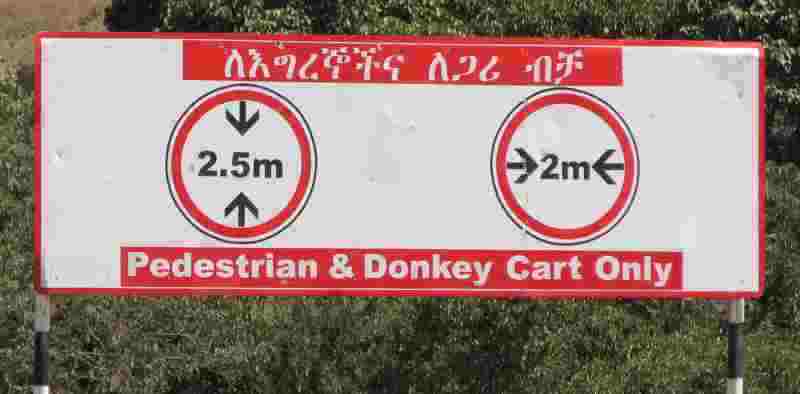
We should have stopped for gas in Debre Marcos, but we didn't feel like stopping anywhere after our previous misadventures. Our destination was not too much further, so we thought we would just fill up there. But, at Dejen, all they had to offer was black market gas (from a barrel)) for 12 birr per litre. Usually gas was 7.80 birr per litre. We showed them how appalled we were, but they didn't lower the price much, so we didn't get any gas. We should have lived with 'appalled' and paid for the gas.
The perfect tarmac road wound its way through the Blue Nile Gorge, a beautiful canyon with depths of 1,500 metres. But the nice road was not to last. On the steepest switchbacks, there were several construction zones. The gravel was thick, heavy and uneven, with big rocks and sand, and it was some of our worst riding conditions yet. Riding uphill, one had to maintain a certain speed, which meant bouncing over soft piles of gravel, avoiding sharp rocks. Passing slow-moving vehicles was another adventure, as there was a concern that we would bounce the bikes right into the deeper gravel and dirt. I remember saying "Oh God, oh God," over and over as big rocks tried to tip my bike off-balance. The only thing for it was to go faster and hope I didn't hit anything bigger. What a relief to come to the pavement again after ten kilometres of sheer terror. I officially labelled it my 'worst riding experience ever'.
What is Ekke wondering about?
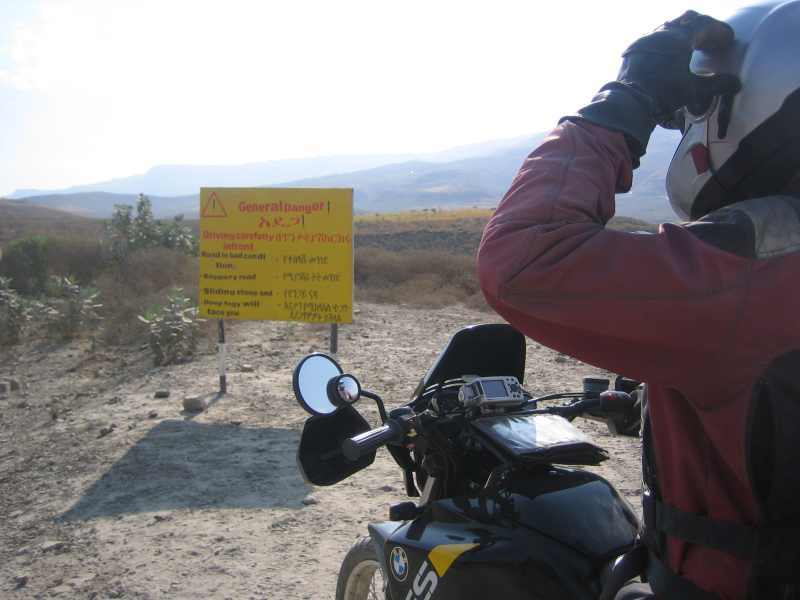
Entering the Blue Nile Gorge was this warning sign
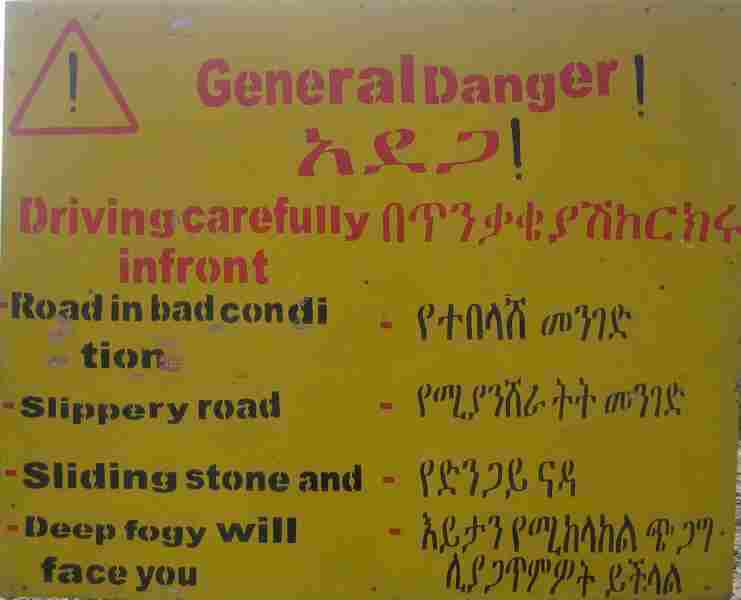
A tanker truck creates a deep fogy making it really challenging to pass

We stopped in every town for the next 100 kilometres - no gas. There were plenty of Total gas stations, and they had plenty of diesel, kerosene, and gasoil, but none of them had gasoline. I was on reserve, so knew I would be running out soon, and every Total gas station owner just said, "Fifteen more kilometres up the road". Finally we found someone who said they'd have gas, but for 20 birr per litre. We were happily willing to pay, spent an eternity waiting for someone to bring us some gas, but then they couldn't find any. We rode quite slowly, trying to conserve fuel. I was riding on fumes when we saw it - the beautiful, yes, I could even say 'glowing' yellow sign of a Shell gas station. And yes, they had gasoline. At 7.80 birr per litre! What a relief.
Addis Ababa was a fairly modern looking city at first glance, with some taller office buildings and modern hotels. But the streets were in really rough shape, and a lot were lined with small shops, many with only makeshift coverings. There were sidewalks on some major streets, but more often pedestrians had to walk on rocky pathways. We joined Tom, Robin and Matteo at the Taitu Hotel, built early in the 20th century by Queen Taitu. It was a great building with hardwood floors and huge rooms. The furniture looked original (antique and falling apart). What a great surprise to see Michael and Werner's bikes parked in the lot. We had met them in Cairo, and they were on the Wadi Halfa ferry to Sudan a week after us. They were on their way to Djibouti to try to get a boat to Yemen (Werner realized later that he didn't have enough time to go to Yemen so rode back to join us). The Taitu had an outdoor cafe, so we spent a lot of time just chatting, catching up on everyone else's adventures. George (from the U.K., we had met him in Cairo) and Vesehl (from Turkey) rode up a couple of days later. Herbie and Jens (whom we had met in Gonder) on KTMs showed up as well. It made for a lot of motorcycles in the lot. Paula, from Edmonton, was on holiday from a job in Kenya, but her employer wouldn't let her go back there. She eventually just flew home. Norman, the teacher we had met in Bahir Dar, also joined us. Tom had some good news. He had gone over to Ethiopian Airlines Cargo, and asked where the lost luggage area was. They pointed to a room, staffed by one person, that held a small mountain of lost bags. Tom said he just started searching through all the mess, and eventually found his backpack. He said that no one checked his claim ticket, and that he could have walked away with anyone's bag. So if you need something when in Addis Ababa just head up to the airport!
The Queen Taitu with a line of bikes

Enjoying a great breakfast with fresh juice (with avocado!)
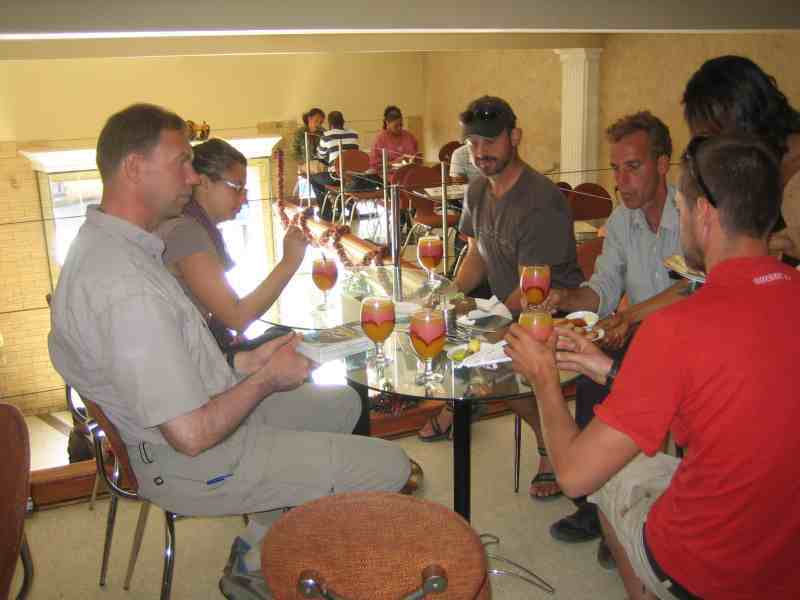
Our first order of business in Addis Ababa was to visit Andreas, a friend of a friend from Germany. His boss was to bring the part Ekke needed to hold his handlebars on properly, the steering-head nut. Andreas lived in a bungalow-style house, and the garden was gorgeous, complete with banana trees. He graciously offered to let us stay there, but we thought it would just be easier for us to stay at the Taitu. The part had not yet arrived at the dealership in Germany, so there was a bit of a concern that it wouldn't make it to Addis. But, the next day we found out that all was well, and Ekke finally had the part that had fallen off on the rough road in Sudan, fifteen-hundred kilometres ago.
CNN, Aljazeira and BBC World were available on TV in the lobby area of the hotel, so we got some news about Kenya. But, of course, all they showed was the 'sensational' stuff such as the rioting, looting, tribal raids and refugees. After talking to many other people who had just come overland through Kenya, we discovered that the tensions were fairly localized in the West and in the slums of Nairobi. We kind of went back and forth about whether to attempt riding through the country or not. A flight to Dar Es Salam, Tanzania would be possible, but Ethiopian Cargo told us that the bikes would have to fit into an 87 cm high crate to make it through the door of a 737. Another choice would be to fly to Johannesburg, which would be a lot more expensive, and put us well away from our route. We decided to go to the Canadian Embassy for information. Jean-Pierre, an ambassador at the embassy, was really helpful about giving us facts, but in the end, it was our decision.
Our wait in Addis Ababa was mostly quite pleasant. Ekke and I went to the Ethnological Museum housed in Haile Salassi's former palace at the University. It featured artefacts from many different Ethiopian tribes starting with childhood games, courtship rituals, adult ceremonies and dress, and death rituals. The National Museum housed the bones of 'Lucy', a 3.2 million year old Africanus Afarensis hominid found in eastern Ethiopia. Actually, the bones were on tour in Texas, so we just got to see the replica bones. The one metre high skeleton was once thought to be the 'missing link' between apes and humans but some older finds in Kenya and Chad had put Lucy in a different line from ours.
Ekke finds Lucy, the person all those low doors were made for!
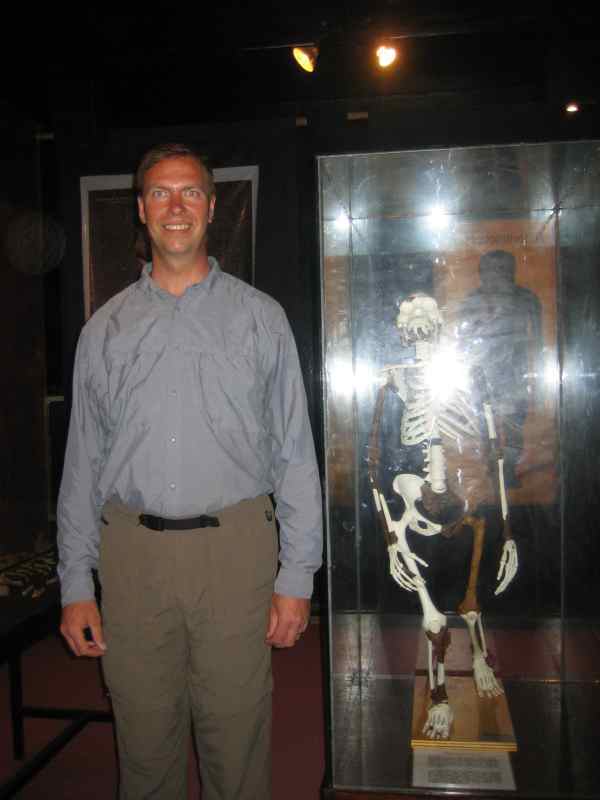
The biggest celebration of the year, Timkat, was happening on January 19th. This was a celebration of the baptism of Christ and apparently people came from all over the world to see this. The signature event was where the priests would take out ceremonial tablets from the replica 'Ark of the Covenants' in their cathedrals and parade them around town. The tablets only made an appearance once per year, at Timkat. We tried to have a look at the procession of priests, but we couldn't get near them with the hoards of people. It was so crowded that Werner didn't notice his camera being stolen from his pocket, and Norman didn't realize that 300 birr had been taken from his pocket. The priests had big, decorated umbrellas held over their heads for sun protection, and they were the only part of the ceremony that we saw.
Timkat celebrations, carrying the tablets to a central park

Ekke and I spent a lot of time riding around Addis looking for bank machines. Our bank cards didn't work, not even at the Sheraton or Hilton. Our only option was to get a cash-advance on VISA. Another problem was that we were running out of our stash of American dollars. Having been in Ethiopia so long, our one-month tourist visa was running out. To renew it, the Ethiopian government wanted U.S. dollars and wouldn't accept Ethiopian birr. We were a little flabbergasted. When we tried to get U.S. dollars from a bank, they couldn't give us any without producing a passport and a flight ticket. Our passports were at the Ethiopian immigration office, and, as you recall, we were on motorcycles and didn't have a flight ticket. So, no U.S. dollars. Ekke had to convince the immigration office to accept some older $10 U.S. bills that the bank wouldn't even accept. Sheesh! What a crazy country.
Our decision to ride through Kenya came after we met some overlanders who had just come north from there. They said that most of the country was business-as-usual, and that they encountered no shortages of fuel, food or water. The route south didn't go near any tribal conflict areas. Tom, Robin, Matteo, George and Vesehl really wanted to do the Lake Turkana road. We were torn about whether to go with them, or go the more popular Moyale route by ourselves. We'd heard Turkana was mostly a track, and not a road. The track consisted of sand, huge rocks, thorn bushes to fall into, and dirt trails that would turn into a cement-like consistency if it rained. My mind was made up at the word 'sand'. They chose Turkana and we chose Moyale.
A few days of public protests were scheduled by the opposition party in Kenya, so, again, we wanted to wait awhile before heading down. We rode in the direction of Arba Minch in hopes of getting a 4x4 to take us in to see some remote Ethiopian tribes. Our overnight stay in Awasa at the Adenium campground was a real pleasure. The place was run, with great caring and attention to detail, by a German woman, Jana, who served up some excellent vegetarian meals. The fried pineapple and homemade muffins were fantastic and we looked forward to returning on the ride back up.
Audrey enjoys muffins and bananas at the Adenium
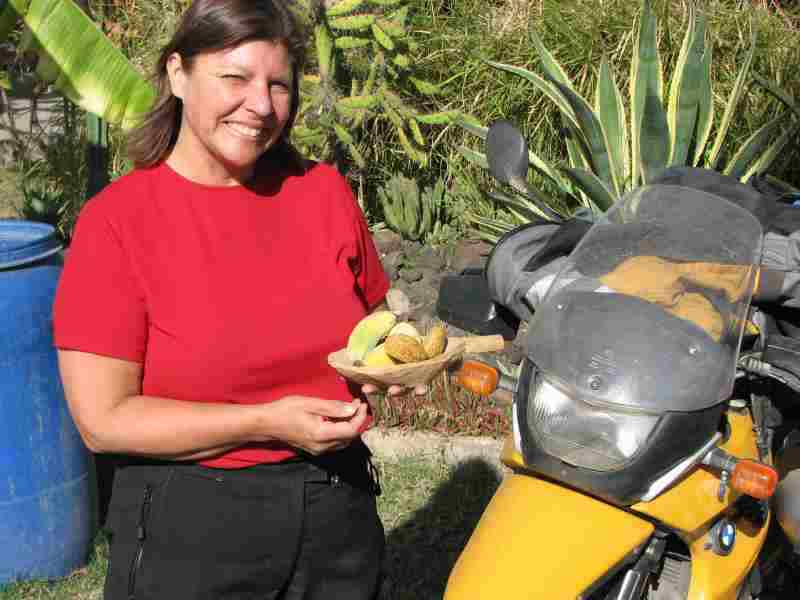
The ride to Arba Minch was on 'pavement', but was heavily potholed. Sometimes there were more potholes than road, so it was very slow going. But it was really pleasant riding past fields of banana trees and thatched mud huts. Several kids threatened to throw rocks but none of them followed through. It was almost a relief to ride through one very remote area and be able to stop for a drink of water without getting swarmed by hundreds of locals.
The balcony cafe of the Bekele Mola hotel in Arba Minch overlooked two lakes. In between, there was a sea of green, a small forest, and mountains could be seen in the distance. The price of the hotel (367 birr, $38) included breakfast and supper. We noticed our money was running a little low, but when we went to the bank in town, they couldn't give us any cash, not even an advance on VISA. Luckily, Greenland Tours, the 4x4 rental company, took U.S. dollars, and we had a few older bills that the banks had rejected. When Greenland took the bills to the bank, the bank rejected about $40 worth, saying they were too old. How fortunate that they accepted $380 worth, though, a real surprise. Perhaps because a local brought the bills in, and not us 'Ferengi' (foreigners). We covered the difference with some birr, but this would leave us very short of money to get us to the Kenyan border. Also, a three day tour of the Omo Valley was all we could afford.
As Ekke and I ate breakfast on the deck of the hotel, waiting for the 4x4 to pick us up, we saw some movement over by the fence. Up leapt a female baboon, her baby in her arms. Our first baboon sighting was very exciting. As we walked to our hotel complex, one baboon after another started climbing over the wall. There must have been thirty of them, from babies to grandparents, some getting very close to us and our open door. Quite a novelty for us, but I'm sure the locals were as tired of baboons here as we are of elk in Banff National Park in Canada.
Company at breakfast on the terrace
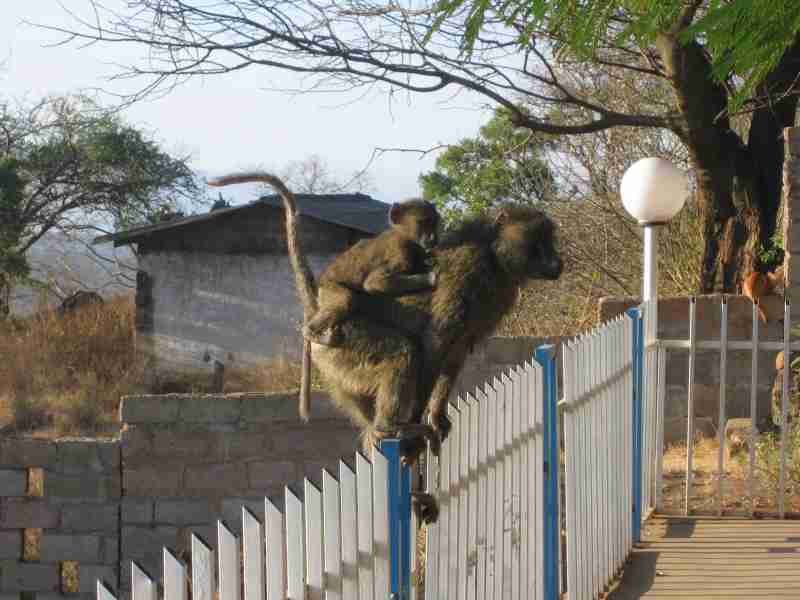
A troop of baboons moves through the hotel
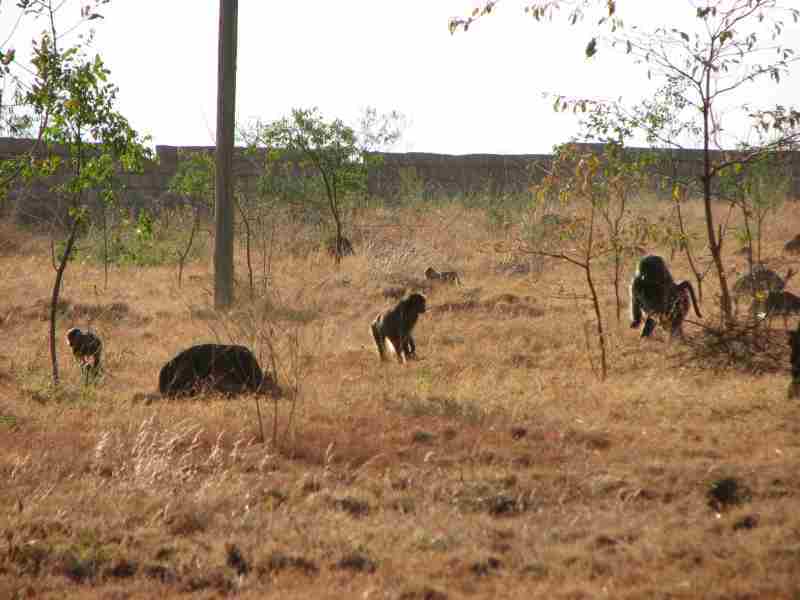
The hotel let us keep our bikes in their lot, so we just locked them up and put the bike covers over top. Our driver, Tamisagen, finally arrived with the only vehicle that Greenland tours had available; its' backup 4x4, an old Toyota Landcruiser with bald tires. We drove the 4x4 over a really rough road to Konso, where we had an Ambo (mineral water) under the shade of a huge tree. The truck passed by small huts perched on hillsides that were terraced for farming. There was a lot of evidence of bridges being washed away by last years' rains. An engineer, Chris, whom we had met earlier in the day, said that he had looked at some of the new bridges that were a work in progress. He said that based on the jetsam and flotsam levels from the flooding, these new bridges would likely be swept away as well. So, we had a few little water crossings, but apparently the roads were impassable in the wet season. As we were riding to Jinka, we saw the headlight of a motorcycle coming toward us - it was Tom! He had just left Jinka and was riding to Turmi to join Robin, Matteo, Werner, Vesehl and George. They were then going to ride the Lake Turkana route to Kenya together (except for Werner). Tom told us about his visit to the Mursi tribe. As he was riding back to Jinka after his visit, he said that a tall man, dressed in traditional tribal clothing, started running beside his motorbike. Tom thought that he was just being friendly, but before he knew it, the guy reached out and tried to grab Tom's tankbag! Good thing the bag was securely strapped to the gas tank or it would have been gone. We had heard that some of the tribes just lived by this code - whatever you can take from someone else is yours.
Beehives
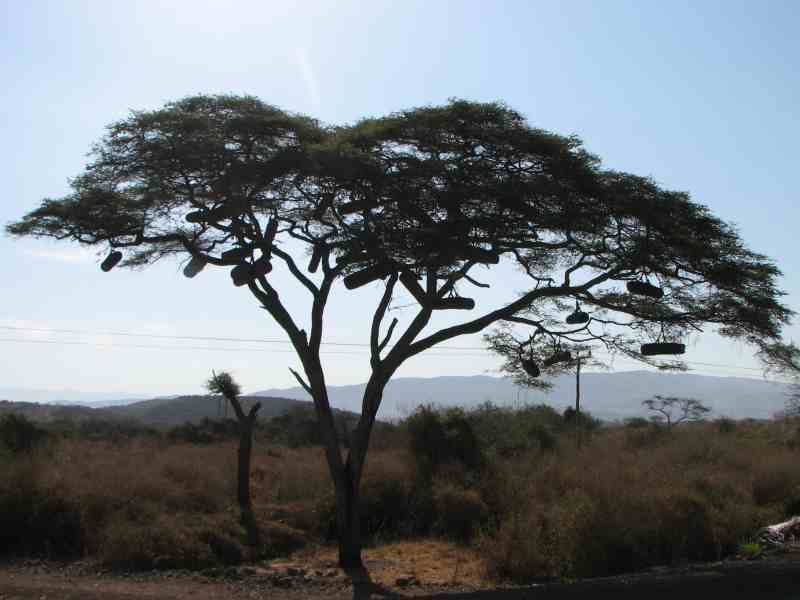
Our first view of the Omo Valley

Hey! It's Tom!

By the time we got to Jinka we were covered in dust, more so than if we had been on motorbikes. Dust poured in from the rear hatch and our luggage was covered as well. But before we went to a hotel to clean up, we stopped at the local market before it closed. The place was bustling with people from the surrounding tribes, buying and selling any kind of goods. Nina, whom we had met in Lalibela, described the local market very well: She said it reminded her of that scene in the first Star Wars movie, in the Mos Eisley Cantina, where different creatures from planets all over the universe came together, each staring at others' unique characteristics. It was the same with the tribes, with their unique hair styles, clothing and body decorations, all staring at each other. A woman stepped out in front of us, and we were shocked to see her lower lip hanging down about 10 centimetres. She was okay with us taking a picture of her for two birr (20 ¢) per picture, but it felt a bit uncomfortable for us. We didn't take photos of anyone without asking them first, and most people seemed okay with it. All expected a small tip.
Ekke wasn't feeling well again, having coughed almost non-stop all day, so we headed to the hotel. The water for the shower wouldn't be turned on until later that night. It turned out that there wasn't any water at all as the town was experiencing some water difficulties, so we stayed dusty for the next day as well. The ride out to the Mago National Park was sufficiently bumpy, enough to make us glad that we'd left the bikes in Arba Minch. On the other hand, being without the bikes was kind of like losing a bit of our identity, something that defined us on this trip. But we justified it by saying that we were saving the bikes for the rough roads in Kenya. We got to the park 'gate', a tree branch across the road, and thought it odd that we didn't have to pay anything. The scenery was beautiful, all hills and greenery, and we discovered a troop of Colobus monkeys just hanging out in a tree. They scrambled away when they heard the 4x4 so it was pretty tough to get a good picture. Besides a few birds and more baboons, it was the only wildlife we saw in the park. But the main purpose of the National Park was to protect the lands of the Mursi tribes.
A Colobus Monkey on the road before scattering into the trees
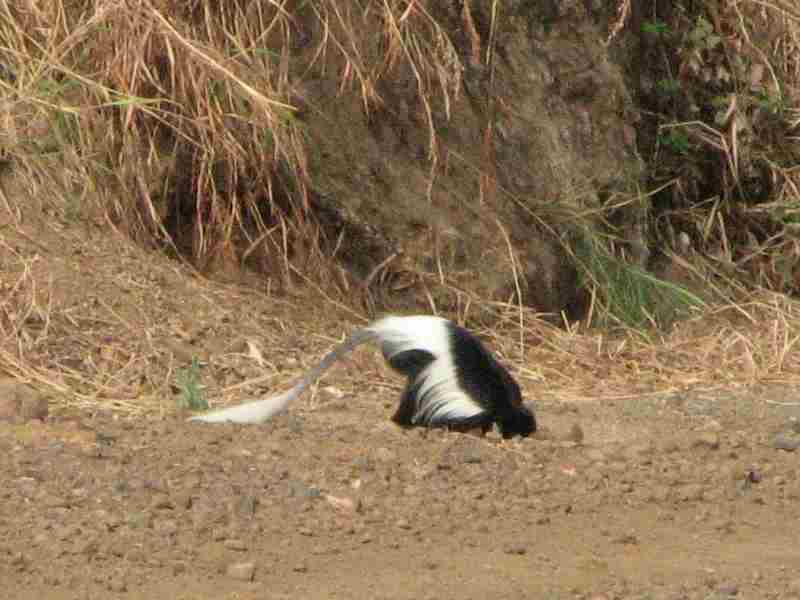
At another gate, we paid 100 birr to get to a Mursi village, and 60 birr for a 'scout', a guy with a gun that would escort us to the village ($17). As we drove nearer we could see that the Mursi village was very small, consisting of about 10 huts. Another 4x4 with Chris, and friends Jude and Amelie drove up just then. The Mursi people came out to greet us, standing side by side in one long line. We got out of the 4x4's, walked over to meet them and then took a tour of the straw huts. There were women working, grinding corn for flour, making fires or stirring the soup. Most had lip plates on their lower lip, apparently for decoration, and some had bumps all over their backs and sides where circles had been cut into the skin, also for decoration. After the tour, we asked if we could take a few photos. At first, they just happily posed for pictures, but after a while, it got a little competitive for our birr. They started doing things to get our attention, like tapping us on the back or pinching our arms. It was somewhat disconcerting to be surrounded by a group of thirty indigenous people, all in traditional dress, vying for our attention. One girl put her arm around my shoulder and wouldn't let go. She held on to me very tightly, and I tried to gently peel her arm from around me. I didn't know what would have happened if I had tried to firmly shake her off to get away. She really wanted her picture taken but we were out of birr notes by that time. A very long while later, I was rescued by our scout who came and got her away. We felt very privileged to have been able to visit the village, but were almost a little relieved to be back in the truck and heading out.
A Mursi village
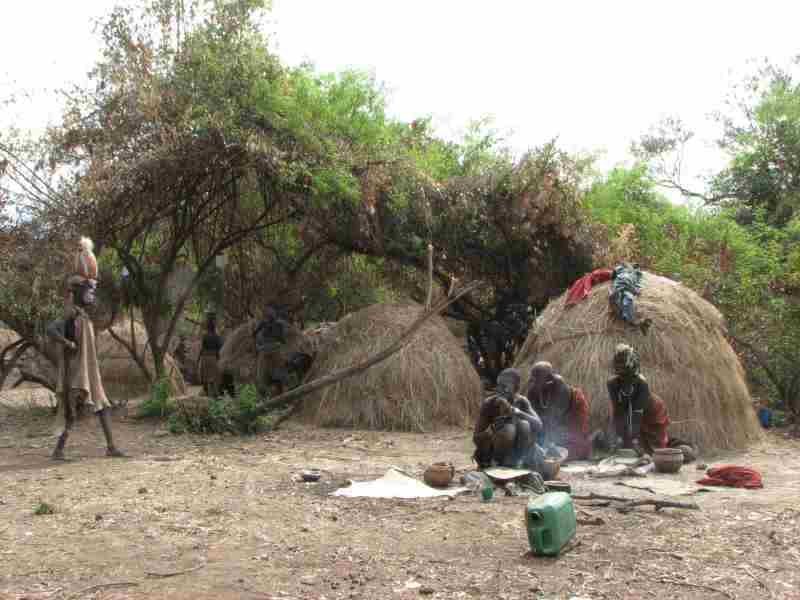
I wouldn't want to meet him in a dark alley...

A Mursi girl with a lip plate

That woman has a grip of steel...
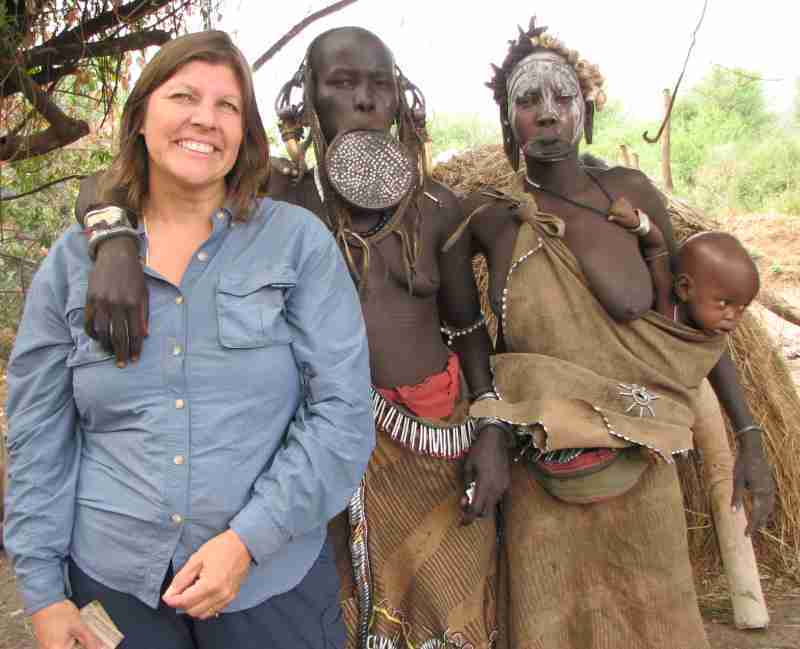
We were ready to leave the park, but Tamisagen took us to the park headquarters, about 20 kilometres out of our way. Our Amharic wasn't good enough to explain that we were finished for the day and didn't really want to go, and his English wasn't good enough to understand what we were trying to say. But when we got to the headquarters, we realized why he had to take us there. We had to pay the park fees. It was a little shocking to find out that we had to pay 200 birr ($22) more. So, we had to dig into the stash of birr that we were saving to get us to the border. Then, they said they needed 80 more birr for the vehicle! Ekke and I both turned a little ballistic, saying we refused to pay it, pretending we were out of birr. We knew this money went straight into the government coffers, and not back into the park or to the Mursi. But, they wouldn't let us leave unless we coughed up the money, so we eventually gave them $9 U.S. This gave us no end of satisfaction when we realized that we had given them the old U.S. bills that the bank would not likely accept!
Desert rose

Tamisagen found us a cheaper hotel to stay in, and this one had water - in a bucket! No running water, so the dust was really piling up. On the trip back to Arba Minch, after a stop for some lunch, I heard a noise in the back of the truck. Two chickens were flapping wildly! When I informed Tamisagen that there were chickens in the back, he said he had just bought them and was bringing them home to the family. Poor things were probably choking on the dust all the way back. After a couple of more market stops, we were finally back in our hotel in Arba Minch.
Interesting hair...

We bought some mangos and bananas at a roadside stop

This guy really liked the banana
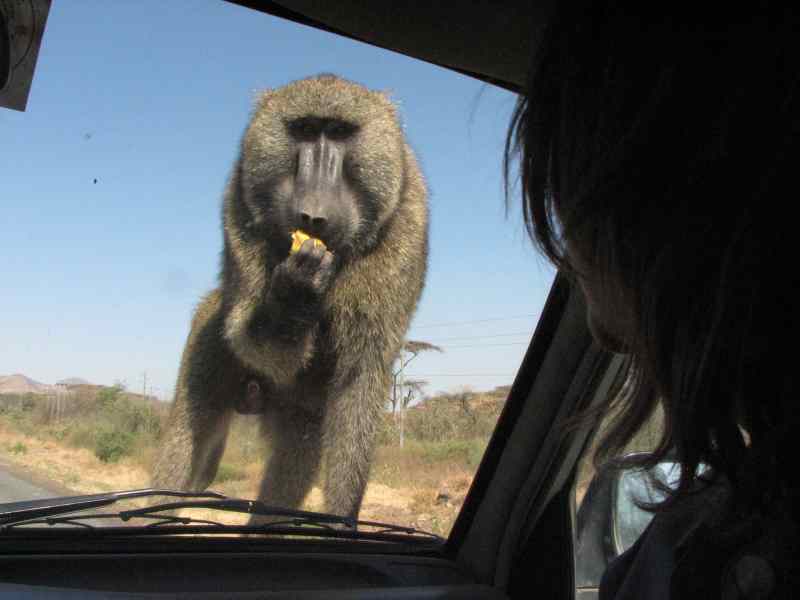
There were two routes one could take to get to Moyale, at the Kenyan / Ethiopian border. Since we had really enjoyed the campground and cuisine in Awasa, we opted to go back there, and ride down a nice tarmac road the whole way. What a disappointment to find that Jana, the owner of the campground, had gone to Addis for three days and there would be no delicious food. Our own cooking had to do for that evening. As we were packing up the next day, Ekke noticed that Werner's bike and tent were there. He was on his way to Addis to get a flight back to Germany, and regaled us with tales about the bull jumping (a teenage ritual where boys run over the backs of bulls) and goat roast in Turmi with the other motorcyclists. There were times we wished we were travelling with them, but then the thought of riding sand in Lake Turkana quickly put away those thoughts.
The ride down to Moyale was quite lovely, through very lush valleys, carpeted with banana trees and dotted with red mud huts. As we approached Moyale, and the Kenyan border, a bit of apprehension about the whole Kenya situation set in. Tensions were rising again as there were more tribal raids and deaths from retaliations. There were more protests in Nairobi and other bigger centres. The Moyale / Marsabit route had a reputation for bandits. The road was rough, challenging and isolated, and we had heard that we had to cover 250 kilometres in one day so that we wouldn't get stuck out alone after dark. We wondered what we were getting ourselves into this time…
A camel herder carrying a spear seems perfectly normal to us now
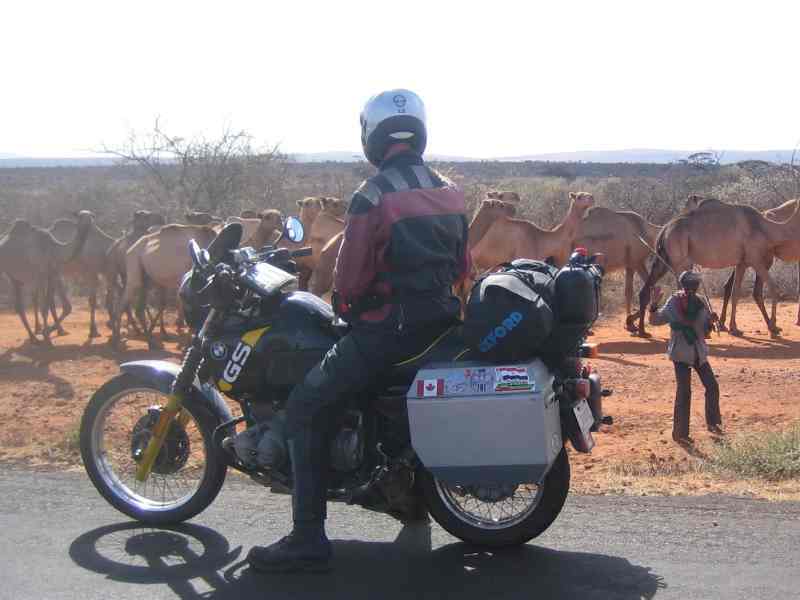
An abandoned Italian fortress
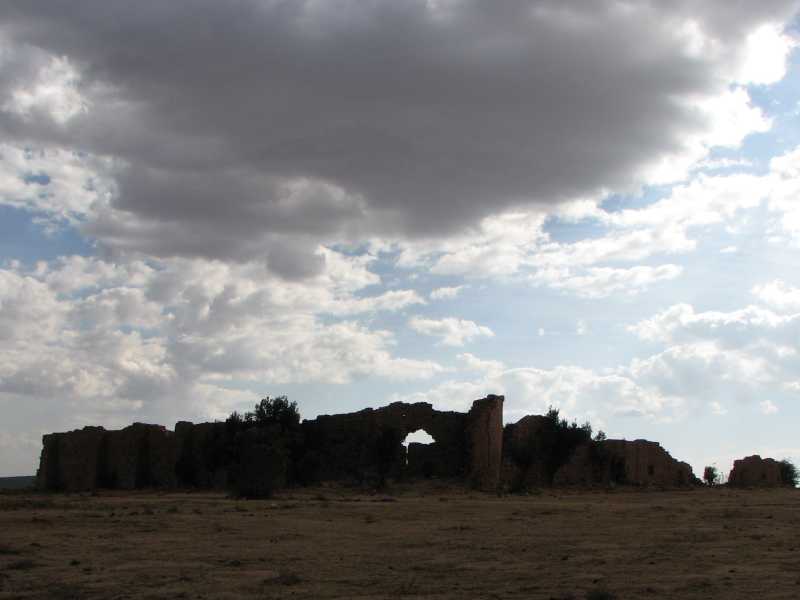
The hut styles are changing as we head south

This termite mound is "Number One"
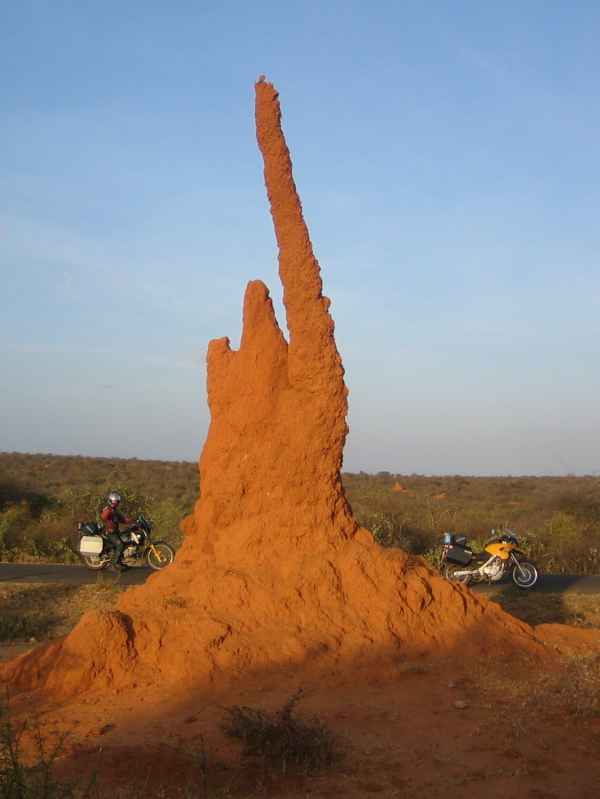
Maps of our route through Ethiopia (note that the GPS wasn't downloaded for the ride from Bahir Dar to Addis Ababa)
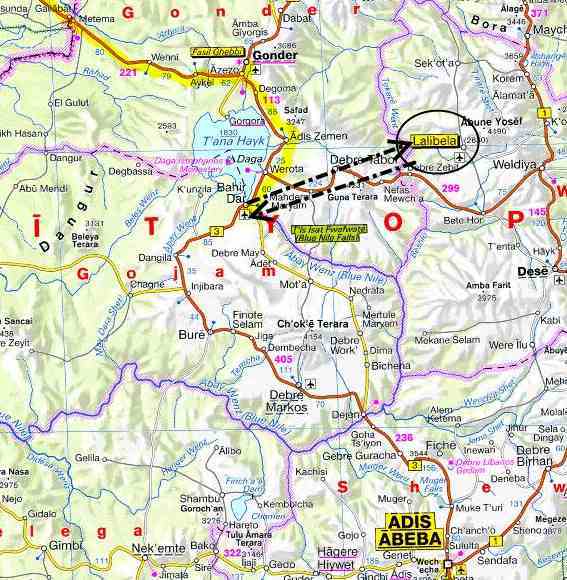
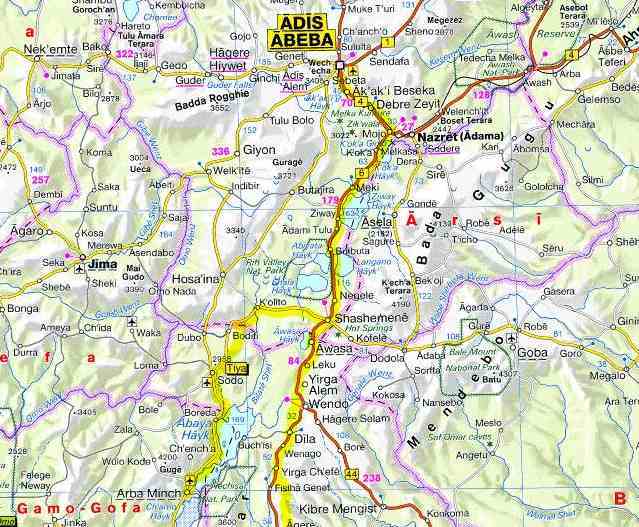

The decision to travel through Kenya was a difficult one for us. In Addis Ababa, we had spent a lot of time humming and hawing, listening to the news (bad idea) and listening to other travellers (good idea). But, on Wednesday, January 30, we finally made it to the border. The guys at the hotel in Moyale, on the Ethiopian side of the border, let us put our tent up in their courtyard. Some cool-looking striped deer seemed very at home there, noshing on the plants in the garden. Someone's pet monkey climbed up and down the building and occasionally did some very entertaining rolling around in the parking lot. The next day breakfast took forever as the power seemed to go on and off, and we were late getting to the border to check out of Ethiopia. The process of getting our passports and carnets stamped took a while, making us later and later. We had some Ethiopian birr left over, but the only black market guy available to change it offered 60 shillings to 10 birr, much lower than the bank rate. But, it was our only option, and we finally had a bit of Kenyan money. As soon as we crossed the border into Kenya, we knew we were somewhere quite different from Ethiopia. The ease of the border crossing was the first clue. Signs in English and Swahili graced the top of each door, the doors were ordered logically and you just went from one to the other: Passport. Carnet. Customs. At other border crossings, fixers usually came up to us immediately to offer assistance, for a fee. This was illegal here, so we weren't bothered at all with anyone's 'help'. Except for waiting a few minutes for one official to return from coffee break, the process went very smoothly, without costing a cent. Flashback to the Egyptian border, where we had paid at least $300 in various 'fees', which now seemed quite ridiculous. The bank was easy to find, mostly because it had its very own crazy person standing outside, yelling at us and everyone else as we walked inside. Something had sent this guy over the edge, and we sat in the bank listening to his rants. The bank didn't have an ATM, but we could see that one was being installed. It seemed like an easy process to just get a VISA cash advance, until the power went out. Then there was about a 45 minute wait to get the money, and we had a late start, 10:30 a.m. This was not the early start we had wanted to ride one of the toughest roads of our journey so far. Buses and big trucks with passengers loaded on top were lined up, waiting to clear the police roadblock. It was the morning convoy and still hadn't left. I guess the idea of the convoy was 'safety in numbers', and some of the vehicles had armed guards with them. A tribal massacre of about 50 people a few years ago had really caused the security in the region to be heightened with police roadblocks and a military presence. The convoy was a great idea, but of course, the motorcycles could not keep up with the truck drivers who just ploughed full-speed ahead, oblivious to potholes and corrugations. The trucks travelled through the night and passengers just bounced up and down the whole way, with no chance of getting a wink of sleep.
The first country of the trip where we need to keep left
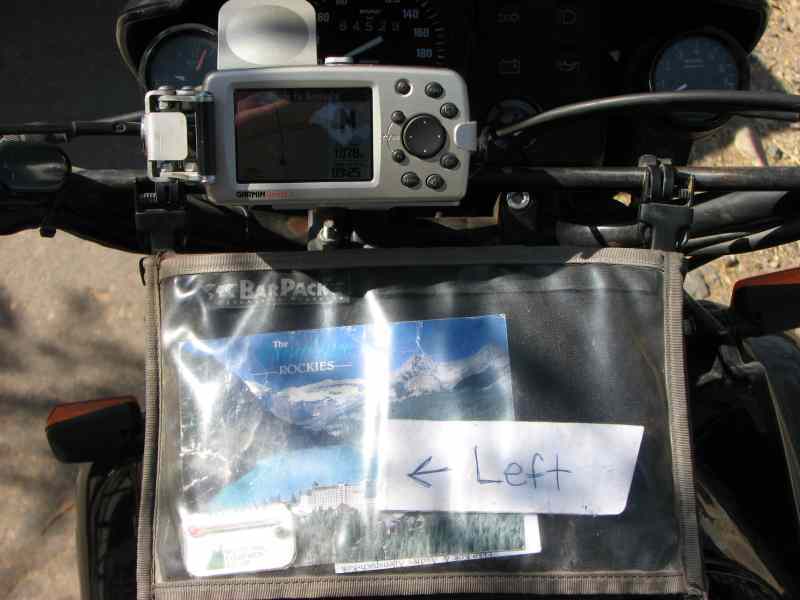
The road seemed promising at first, a red dirt track with a little bit of sand in the potholes to keep things interesting. It quickly deteriorated into deep ruts and gravel, but at first we could steer around most of the bigger stuff and keep up a speed of about 50 kph. Every now and again some sand would grab the front wheel causing the bike to shimmy, a real wake-up call. The hot sun beat down and really made us tired, but we passed by a lot of bush, which made for some welcome shade when we stopped for a water break. Our bottled water was warm by about noon, making it taste absolutely terrible, but it was all we had. It was about 250 kilometres to Marsabit, and we had figured that if we made Turbi, a small town at the midpoint, by 2:00 p.m. we would then be able to make it to Marsabit no problem.
Good gravel road

Or keep right if the road is better over there!
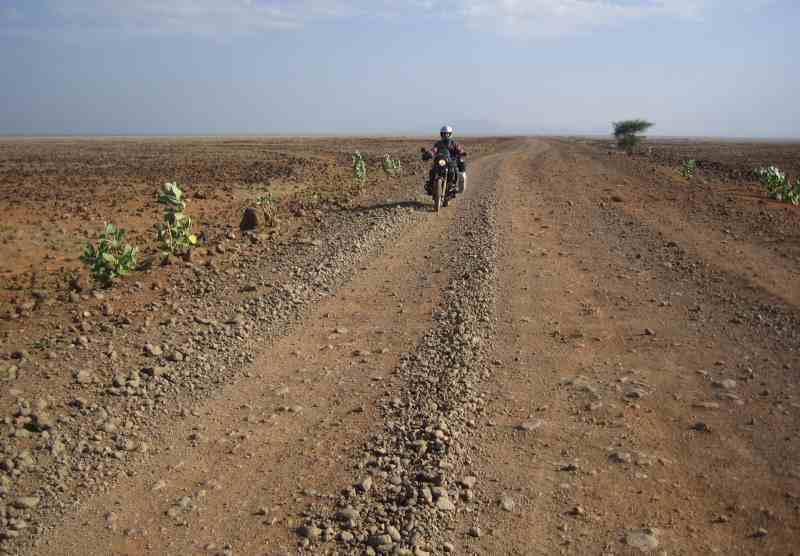
Hot water to drink
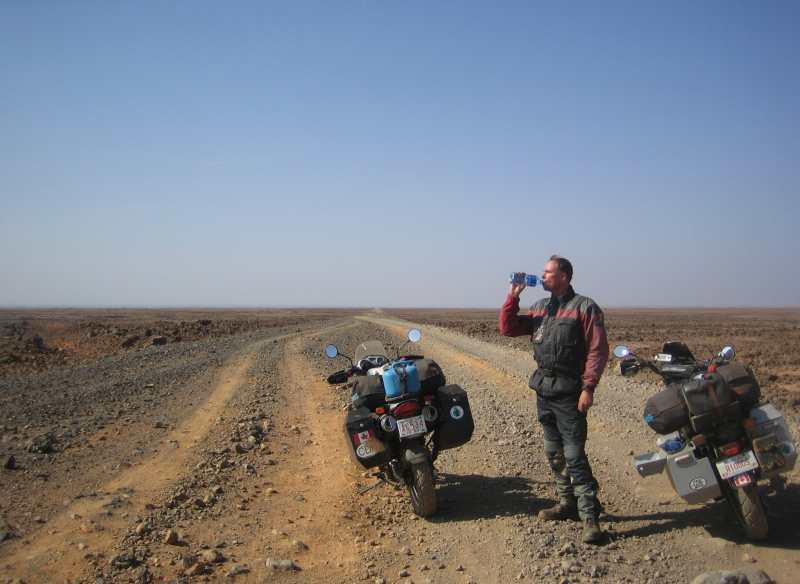
One time, Ekke stopped unexpectedly and looked towards the bush. A dik-dik, a very small deer, had just run across the road! The adult dik-diks never grew more than about 50 centimetres high, and they were quite cute. Back in Calgary some of my grade 4 students had studied dik-diks at Zoo School and one of the boys had discovered a really interesting fact: It took two dik-diks to make a pair of leather gloves. All I could think of as I looked at the small deer was that they'd have to be a pretty small set of gloves. Other wildlife that we spotted on the route was a troop of baboons, and we could see them climbing out of their tree and heading further inland as they heard the bikes approach. The family was quite large, at least 20 baboons. The little ones scrambled away quickly, but the older ones didn't seem too concerned about us as they ambled slowly away.
With the 36° C heat and rough road, I was exhausted when we arrived in Turbi at about 2:15 p.m. At the military roadblock, the officer looked at our passports, and then we asked him about the road ahead. He said that the route from Turbi to Marsabit was extremely rough, more so than the road we had just ridden. He also said that vehicles usually took four hours to get there from here. Ekke and I sat down at a small café, had a luke-warm pop, and assessed our situation. I suggested that since we were going slower than other vehicles, it would take us much longer than four hours to get to Marsabit. The road was rougher, and we were already exhausted, so why not just stay in Turbi for the night and have a fresh start in the morning. One concern with this plan was our overall schedule. With our passports running out of pages we had hoped to ride to Dar Es Salaam, Tanzania to apply for new ones before riding to Arusha to climb Mt. Kilimanjaro in mid February. Staying in Turbi, a small town of about 20 shacks, would put us one more day behind. As we sat in the shade of the café, really, really enjoying the escape from the heat, we realized that we weren't going to ride any further that day. An NGO worker from France, Greg, just happened to be in town, and he suggested that we could pitch our tent in the courtyard of a woman's camp. The thought of just lying in the tent for a while was quite appealing, so we headed down the road to the courtyard. The camp had a few hotel-type rooms where women in need could have a bit of an escape. The caretaker let us pitch our tent, for 200 Kenyan Shillings ($3) per person, which we readily agreed to. When Ekke went to pay, the lady said she wanted 1000 shillings per person ($14). Maybe she thought that we had agreed too quickly to the first price, and that there was really nowhere else to go for the night. Ekke very patiently explained that we had agreed to a price, but I could see that he was steaming inside and ready to take the tent down and camp in the desert with the bandits. The lady eventually relented.
The road becomes a bit more rutted

Because of the heat, Ekke and I hadn't felt like eating anything all day, and neither of us wished to have anything for supper. Those who know us must realize how totally out of character this is, and that it could only ever happen under very extreme conditions. But, we forced ourselves to go over to a café. What a relief to find that the fridge had been turned on, being powered by a generator. Cold Fantas revived us somewhat. A TV was also powered by the generator, and there were about forty men glued to the set, watching the Kenyan news. It was in English and Swahili, but I couldn't understand a word of either. There was a story on the devastation to tourism in Kenya, with pictures of empty hotels and staff being laid off. Later, for supper, Ekke tried some meat and rice and I just went for the rice. It tasted as if it had been sitting there for a few days, so I couldn't get down more than a few spoonfuls. Ekke said the same about his 'meat', and he just sucked the flavour off the chewy gristle, which was either mutton or goat. Greg ordered some chai, the local tea, so Ekke gave it a try. It was poured from a thermos, and already had sugar and milk in it. Apparently this stuff sat around for a few hours until it was 'just right'. But Ekke really liked the nutty taste, a unique flavour that could only be obtained by cooking it over a dung fire, I think.
The next morning, after a healing sleep, we headed off on a very rough road. This one even had the construction-zone switchbacks in Ethiopia beat for roughness. Corrugations, made by fast-moving, heavy vehicles, made it feel as if the bikes were going to shake apart. Avoiding them was impossible as they were in deep ruts that were straddled by 40 cm high piles of soft dirt mixed with rocks. When another vehicle approached or when we had to get to the side of the road, we had to stop the bikes, point them in the direction of the pile of dirt, put our feet down, and try to duck-walk out of the rut. Usually my feet dangled in the air as I tried to clear the pile, and I had to hit the throttle so that I wouldn't fall over, causing other problems. Fortunately, there were a grand total of four vehicles that day, a very isolated section of road, so our rut-jumping was kept to a minimum.
Only the fourth vehicle that day...
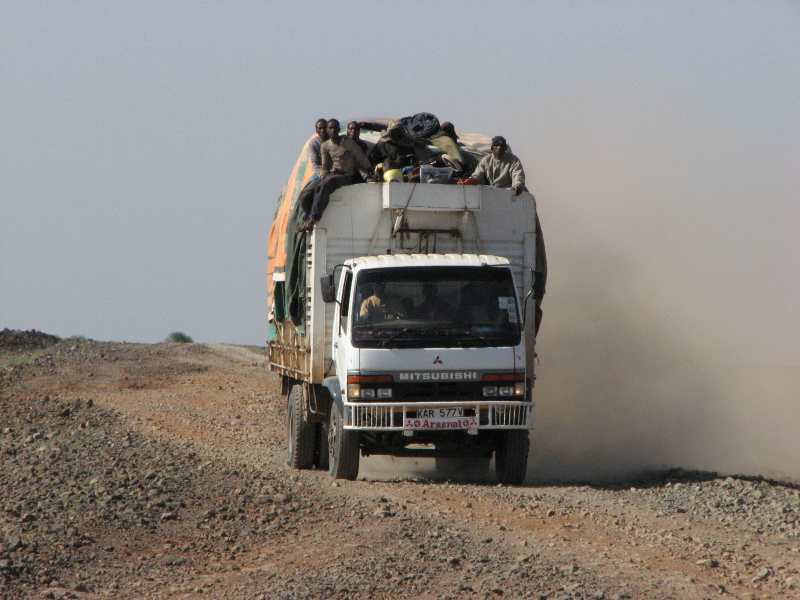
Kids had thrown rocks at us throughout the Middle East and Northern Africa, and it was mostly harmless 'fun' for them and annoying for us. But when adults threatened us with rocks, it was a totally different thing. As we were riding we saw a group of people off in the distance, and wondered if it was a roadblock or bandits. As we got closer, we were quite relieved to see that it was some nomads leading a group of camels. Some of the camels had special covered seats on top with people riding in them. We rode slowly by the group, and they were so colourful and interesting that I wanted to stop to take a picture. Just as we were stopped, I saw an older man running toward us from about 200 metres away. In his hand was a huge rock, and before we knew it, he winged it at us. It didn't hit anything, but Ekke and I just looked at each other in surprise when he picked up another one. I just stuffed my gloves in my tank bag instead of taking the time to put them on, and Ekke and I hit the gas and got out of there. A woman who was a lot closer than the guy also had a big rock in her hand, but I didn't look back to see if she had thrown it. We still had three groups of the nomads to pass by. One fellow waved us down and asked us for water, but we weren't going to make the mistake of stopping again. Others had rocks in their hands, and we just smiled and waved, hoping to show them that we weren't a threat. One final rock was launched toward us by a young boy, and we finally passed by the last group and got out of there. We were puzzled by this behaviour and will probably never know the reason behind their threatening manner. Loud motorcycles? Didn't want their picture taken? Hated Westerners? Who knows?
Unfriendly nomads

The next part of the road was less like riding than picking our way through obstacles at low speeds. Baseball-sized rocks were the order of the day, and weaving in and out and over them was physically and mentally exhausting. Sometimes we had to speed up so that the rocks didn't throw the bikes off-balance, and it was only a matter of time before this higher speed got me and the bike into trouble. I had seen Ekke riding through a particularly deep section of rocks, fighting to keep his bike upright. I should have slowed right down, but opted to try to plough through the rutted path that felt like riding in a dry river bed of sharp, volcanic rock. I gripped the handlebars tightly as I felt the front wheel getting away from me, first left, then right, then left, then right again. Before I knew it, there was that terrible realization that the bike was out of control and that I was going down. I didn't have time to put a foot down or take my hands off the handlebars. Suddenly I was on my side, sliding through the sharp rocks, listening to the sound of grinding metal, and I felt my helmeted head hit hard.
Loose volcanic rocks in a deep rut
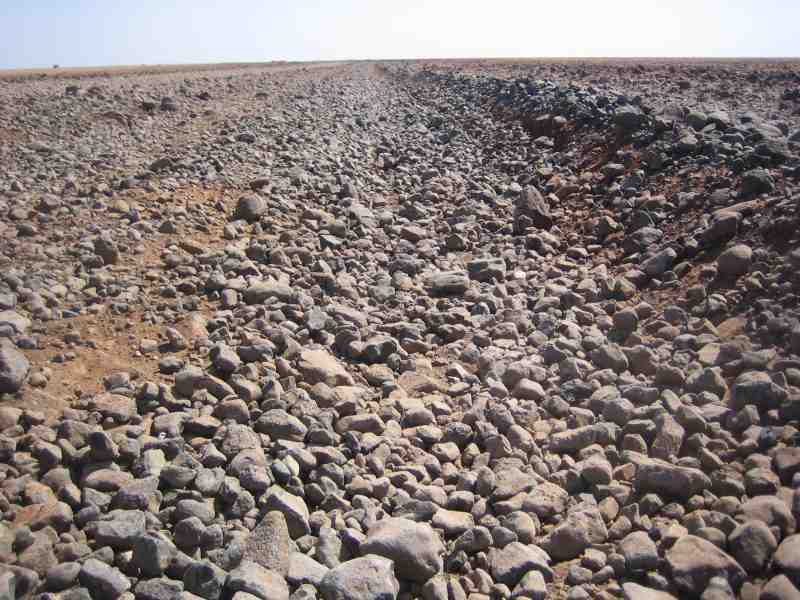
I was able to sit up, hit the 'kill' switch on the bike to turn off the engine, and quickly assess the situation. I heard the crunch of boots as Ekke came running back through the deep gravel, saying, "Are you okay?" several times. I had a sharp pain in my right chest area, which would later turn into a bruise in technicolour, but other than that, most of the damage was to the bike. My saddlebag was sitting about two metres behind me, having been ripped right off the mount. The front and rear brake levers were both bent into weird angles. It took about an hour for us to get everything to a state where I could ride again, but with a mushy front brake. I could have used a lot more time than that to get mentally prepared to get back on that bike. When it was time to leave, I fought back tears as I lifted my leg over the bike. I looked ahead at the rocky pathway in front of me, took a few deep breaths, and reminded myself that I had signed up for this. I pulled away too slowly for the conditions, and my feet were down immediately. It took a few minutes of duck-walking before I was convinced that it would take a lot less effort to go faster, and slowly I got back into it. But I was super careful for the rest of the afternoon, and it was really slow going. The relief of getting to the town of Marsabit was unlike anything I've experienced. Going from the really low lows of crashing to the euphoria of finishing that road was stressful on so many levels.
Ekke writes:
When I heard the sickening sound of metal and plastic crashing into the gravel I looked in my mirror and saw the F650 on its side and Audrey sitting beside the bike. With a sense of horror I skidded to a stop and ran back to the crash. We had been riding on a really rough road for 20 or 30 kilometres consisting of baseball sized rocks and deep ruts. I had just ridden through an especially loose section where I had to put my foot down to keep my balance. I knew it was easy to lose control in the gravel. When I got to Audrey she was a bit shook up and had a few new bruises to add to her collection. The bike was a different story, with the right side saddlebag laying a few paces away and the brake levers bent out of shape.
The F650 gets up close and personal with the road

After ensuring that Audrey had no injuries we put the bike back up on its wheels. It took about an hour to mount the saddlebag back to the bike because a mounting bolt had sheared off and the mounting frame was bent. Bending the brake levers back was no problem but because the bike had been tipped over so far, air had entered into the brake line and the front brake was almost useless. Just as we were putting everything back together a car pulled up, an ordinary passenger car. The deep ruts and huge bumps were a real challenge for them and we had to move the bike out of the way so that they could pass by because they couldn't cross the ruts. If Audrey would have been seriously injured in this isolated area we would have been in real trouble.
Desolation
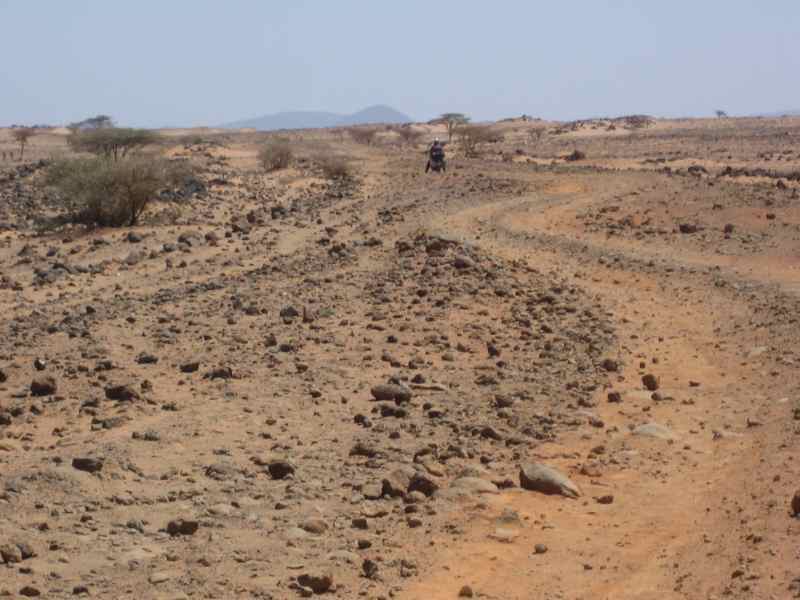
After the crash Audrey was especially careful whenever there was even a hint of deep gravel. We moved her duffle bag to my bike and emptied the spare fuel cans into the bikes so that the F650 was as light as possible but it was still slow going. The afternoon heat started to take its toll and I started to feel weaker and weaker. We fought the bikes every metre of the way. It required muscle to handle the bikes over the big rocks which threw them off balance and it required constant mental attention to pick a route through the veritable mine field. At one point I wanted to take a break but we had only gone a couple of kilometres since the last break. We had to ride farther than that! At the breaks we had to force down the awful tasting hot water and the dry crackers with nothing but delicious Nutella to make them bearable. Who ever had trouble getting down Nutella? We dragged ourselves into Marsabit in the late afternoon, hot and tired, and after fuelling up and getting some cash from an ATM we rode to Henry's camp, just out of town. We had been worried about the fuel situation in Marsabit since we knew of a couple of motorcyclists who had been stuck there for almost a week without fuel so we were very happy indeed. Henry's camp was like an oasis in the African desert. Where Marsabit town was nothing but dirt roads and shacks with garbage strewn about, Henry had brought a bit of Swiss orderliness with him. The bakery on site was just the icing on the cake. The campground felt almost European, only the African flora and fauna giving away that we were on a different continent.
Henry's Camp
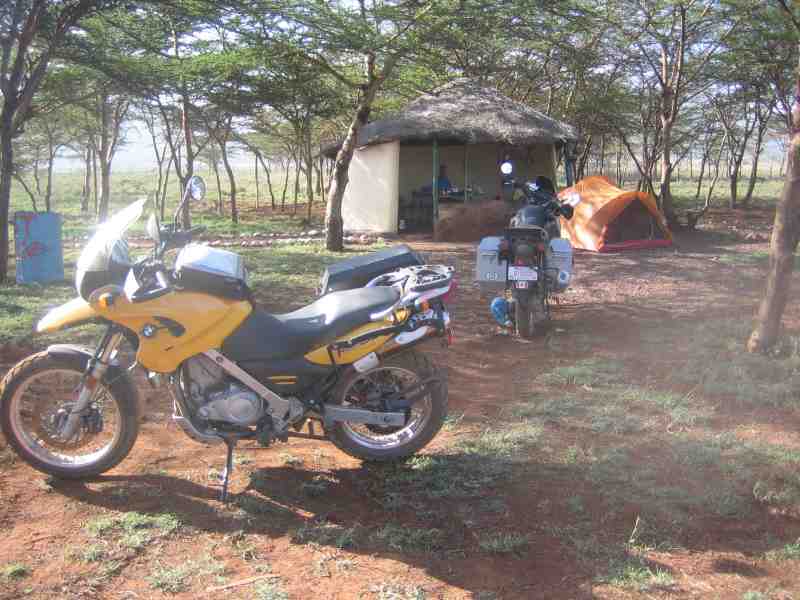
We picked up some twine in Marsabit for the repair
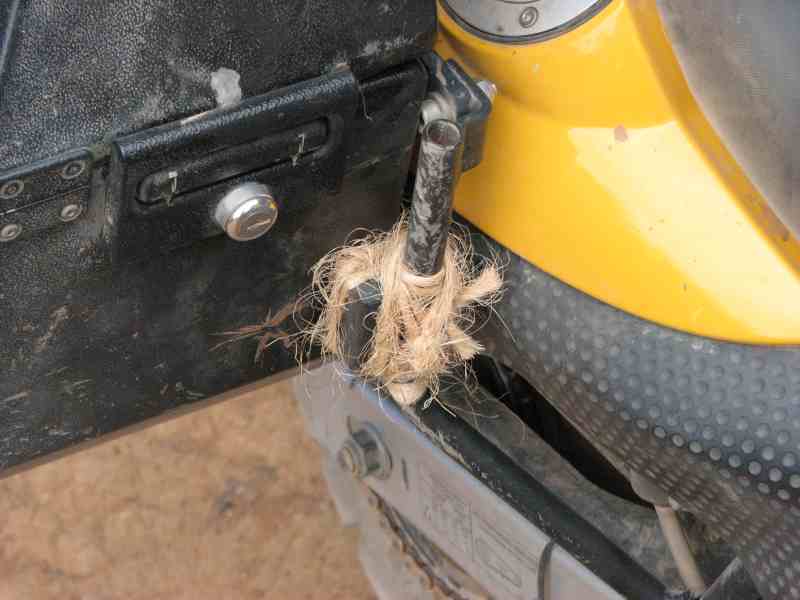
Superb Starling

7 centimetres of African Fauna

That evening I was a bit nauseous and the next morning I didn't feel much better so we decided to spend a day at Henry's. Sunday morning I felt quite good but we thought that we would spend another day in Marsabit. A small hill a few hundred metres from Henry's had been tempting us for the last couple of days so we decided to climb it. Good practice for Kilimanjaro! The climb was not too difficult, the view was terrific and two hours of walking felt good. Unfortunately after the hike I started to feel tired and rundown again. Having seen Marsabit, I wasn't too keen on seeing a doctor there but it was time. Audrey got a taxi to take us in to town where a really nice doctor listened to my story of woe. I had caught a cold in Bahir Dar, the flu in Addis Ababa, a persistent cough since Arba Minch and now it felt like heat exhaustion after the ride from Turbi. She ordered a blood test done which confirmed that I did not have malaria (whew!) and then prescribed an antibiotic and cough medicine.
Top of the hill!

Would you want to go to a doctor here?

Monday morning dawned with me feeling well again so I did a bit of work on Audrey's bike, repairing the rear brake. By the afternoon I was once again feeling a bit tired though. Still, we decided that we really should get going on Tuesday. The neighbouring hilltops were obscured with fog and it was a bit breezy when we left but it was pretty good riding. The baseball sized rocks were hopefully a thing of the past. Just to confirm that we really were on a different continent we passed a couple of dung droppings that looked like they had been dropped from a wheelbarrow. Only elephants could have dropped something that big! Too bad we didn't see any. At Soro Adi we stopped to talk to a beautiful girl and then visited the local cultural centre. They weren't quite finished with the museum yet but they did have a traditional hut set up for us to look at. The road was quite rough but at least not technically challenging to ride. At Laisamis we stopped for a break and were promptly swarmed by people selling local handicrafts. It was almost like they were starved for tourists. With the post-election troubles in Kenya, tourism had really dropped off. We ended up buying a fair number of souvenirs including beadwork and a wooden Turkana headrest. The landscape had changed from the rock desert north of Marsabit to scrub thorn bushes. At one point out of the bush came an ostrich! Wow, we couldn't believe it. It ran from the bush on the left onto the road and then in the same direction as we were riding. It was really tall, easily taller than me. We just sat there grinning at each other thinking how incredibly lucky we were to be riding our motorbikes through Africa. The further we rode the rougher the road seemed to get. I was just thinking that it was a miracle that the bikes weren't getting pounded to pieces when I noticed oil on the right side of the bike. Pulling over immediately, I suspected that the oil cooler had been punctured and was almost relieved to find that it was the right side fork seal. I wiped up the mess as much as possible with a tissue and then we rode onward, albeit a little more slowly. The slow riding in the heat was hard work and we stopped for plenty of breaks. Our water bottles, which started out the day fairly cool, were warm enough in the afternoon to have a nice cup of tea if one were so inclined. On one of our stops I noticed that my right side saddlebag was loose. It turned out that the mounting frame had cracked in two places. This rough road was easier to ride than the baseball sized volcanic rocks but it was much harder on the bikes. We unloaded the saddlebag by strapping the tent to Audrey's bike and I slung the laptop case over my shoulder. It was a slow ride for the remaining ten kilometres to Archer's Post and the Samburu Women's Camp.
Leaving Marsabit, this good road won't last
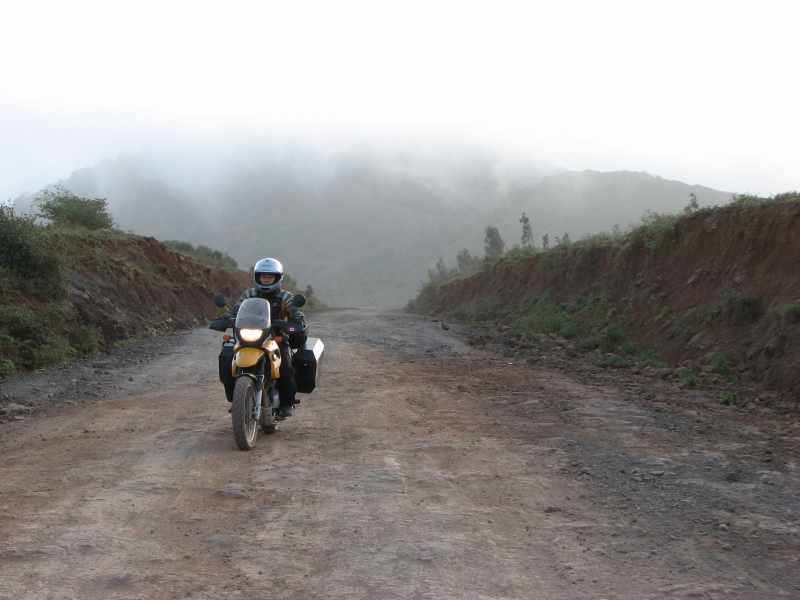
A Samburu woman
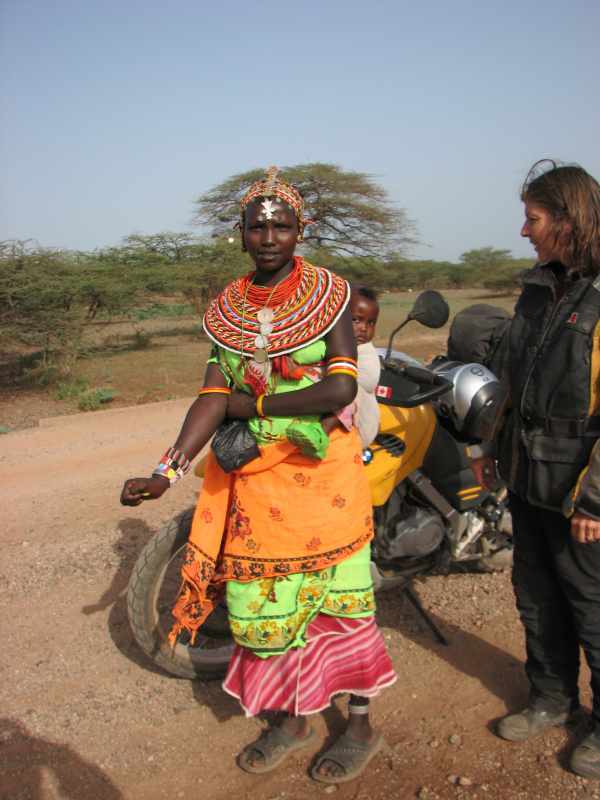
Visiting the Samburu cultural centre
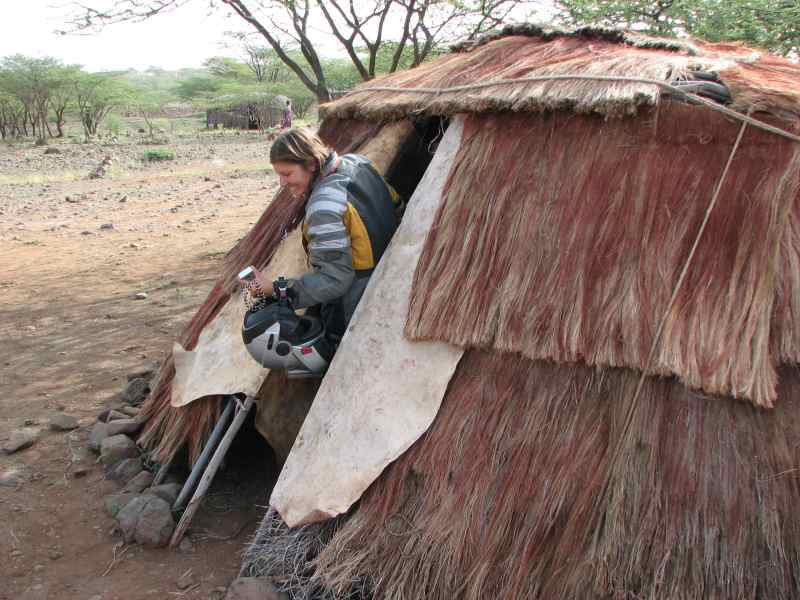
Audrey gets swarmed by tourist-starved sales personnel
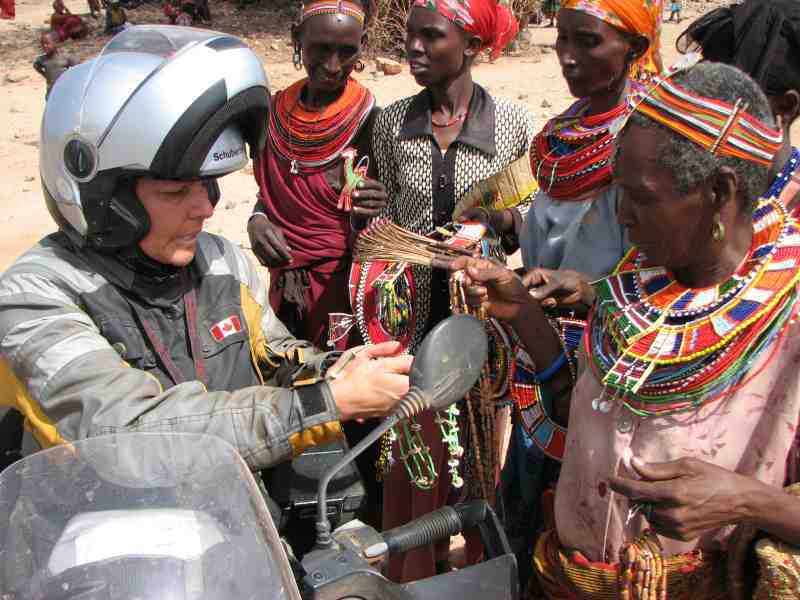
Wow! Our first ostrich
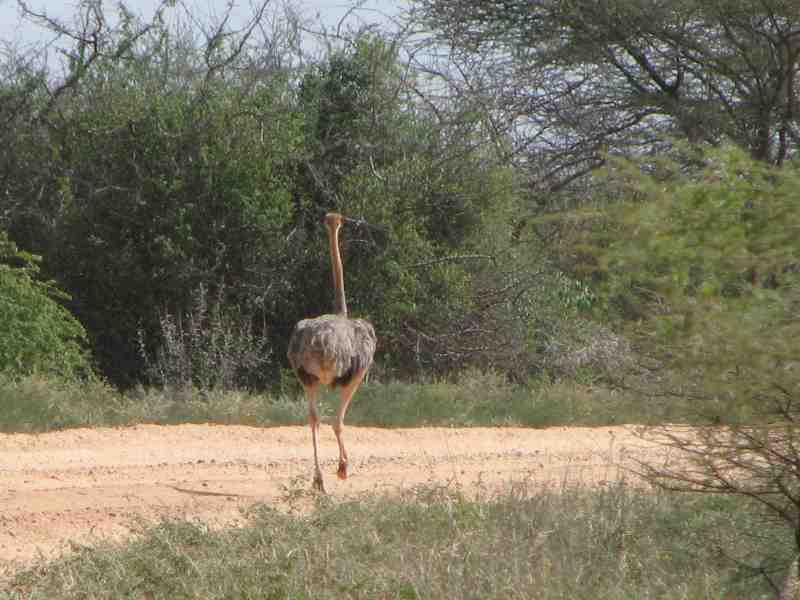
A blown fork seal is better than a blown oil cooler
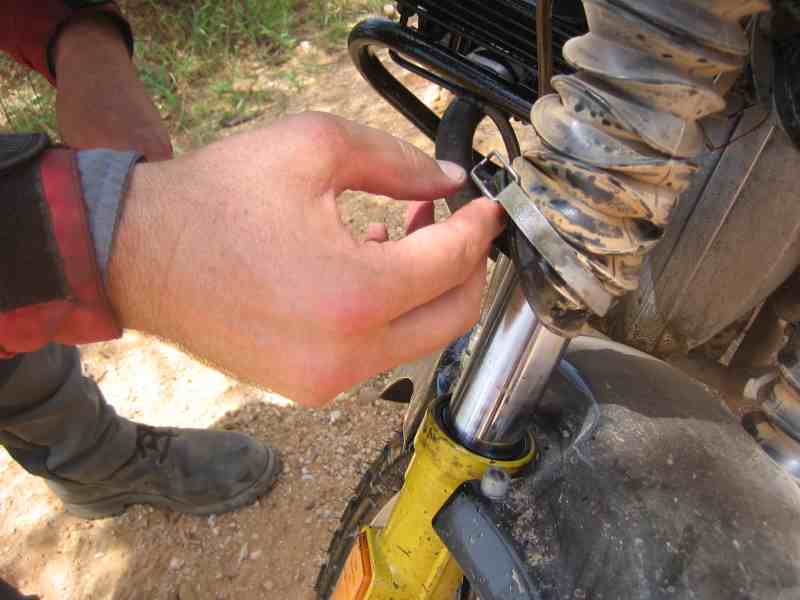
Three boys (some brandishing spears) welcome Audrey
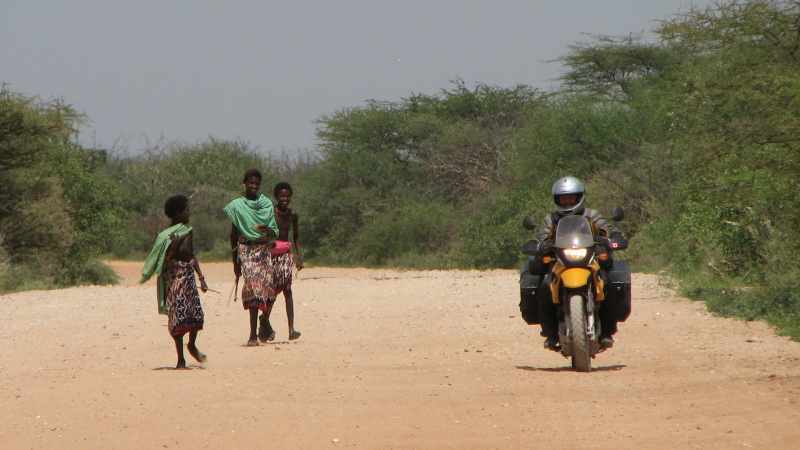
Wednesday morning I tried using JB Weld to repair the saddlebag mount but it was not successful, breaking loose the moment I tightened the bolts. I resorted to using zip ties and twine (leftover from what was holding Audrey's saddlebag together) to try and stabilise the mount a little until we could get it properly repaired at Jungle Junction in Nairobi. We then conducted a little science experiment, punching a hole in bottom of a water bottle and seeing which direction the water turned as it drained. North of the equator should have been clockwise but due to experimental error ours turned counter-clockwise. We planned to try it again closer to the equator. From Archer's Post to Isiolo was, if anything, rougher than the previous part of the road. We were riding so slowly that there was very little cooling on the engine and just like on the road down from Wadi Halfa, Sudan, my bike quit. Sometimes I could coast towards a patch of shade but sometimes we were stuck out in the hot, equatorial sun waiting for the bike to cool down sufficiently to ride further. After 2 hours we finally completed the 40 kilometres and hit pavement. What a joy! At Isiolo we fuelled up and had lunch (fried fish actually contained fish whereas in Ethiopia it was mostly batter) then rode further south, planning to camp near the equator. The scenery changed dramatically south of Isiolo as we climbed higher up the slopes of Mt. Kenya. Wheat fields like in Canada! We checked out the Timau River Lodge and it looked like the African lodges we were expecting to see, so we treated ourselves to a little luxury and took the half-board option in a log cabin. That afternoon we walked into the town of Timau and saw a motorcycle riding down the highway. It was George! He stopped at the police checkpoint so we ran up to say hello. He had had a bit of an accident on the Turkana route, coming off the bike at about 80 kph when he hit a sheep and he looked like he was in pain. We invited him to stay in our log cabin so that he could rest up properly. That evening, over T-Bone steaks (!), George shared stories of the group's adventures on the Lake Turkana route. Near the border with Ethiopia they had been informed that about 150 armed cattle-rustlers were a few kilometres down the road. Robin and George decided to take an alternate route to avoid them but were forced to retreat after encountering an insurmountable hill full of rocks. The going was so tough that Robin was dropping his bike every few metres. At one point Matteo was so overcome with heat exhaustion that he told the group to just go on without him while he laid down for a while. George had become separated from the group when he had his 80 kph encounter with a sheep so was forced to put everything back together himself, all the while in tremendous pain. To be honest, those amazing stories reinforced our original decision to come down via Marsabit but kudos to them for making it through!
Breakfast at the Samburu Women's Camp
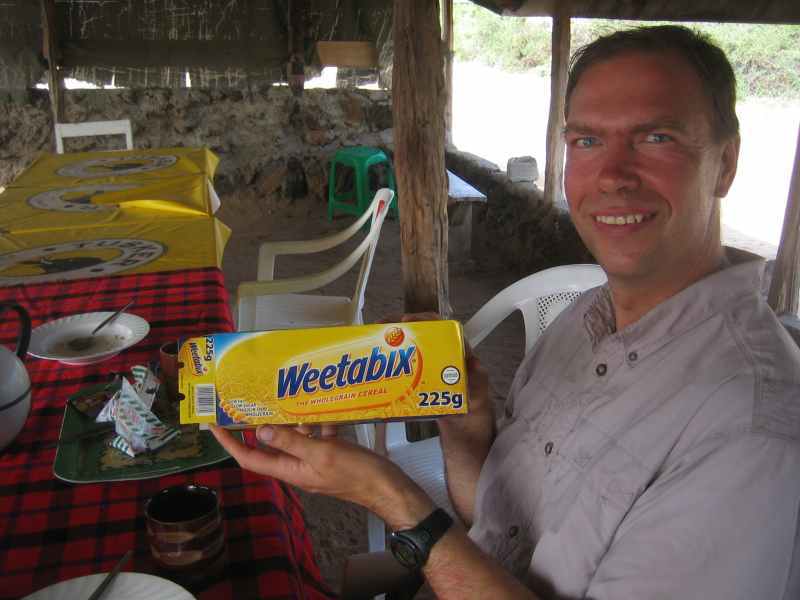
Ekke does the "Pavement Jig"
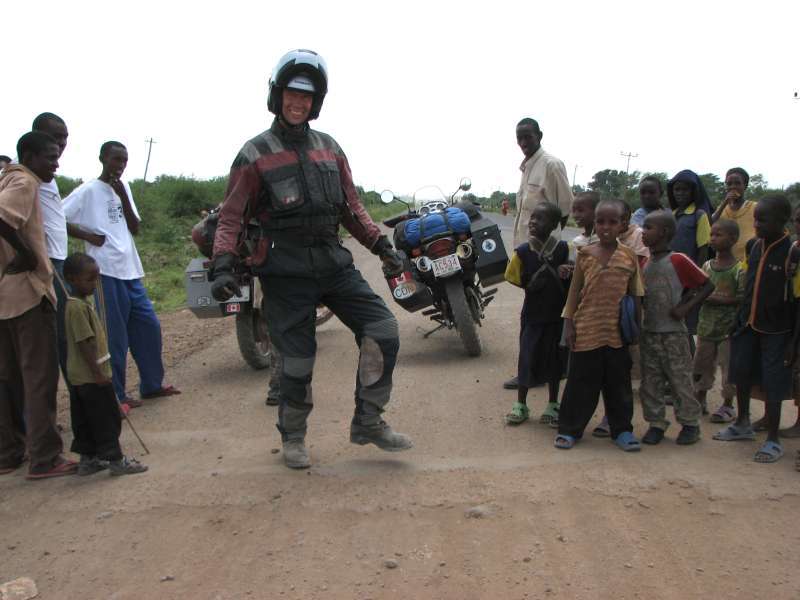
Southern Alberta? Middle Kenya?
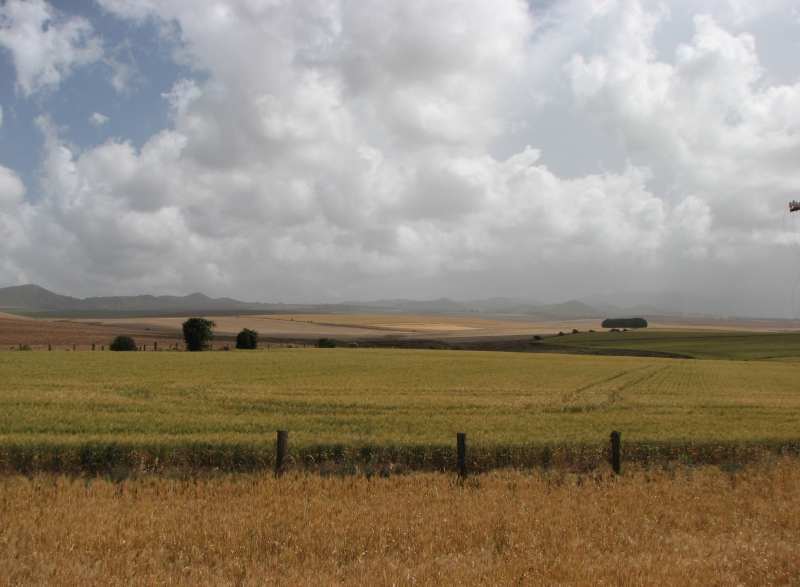
Timau River Lodge, near Mt. Kenya
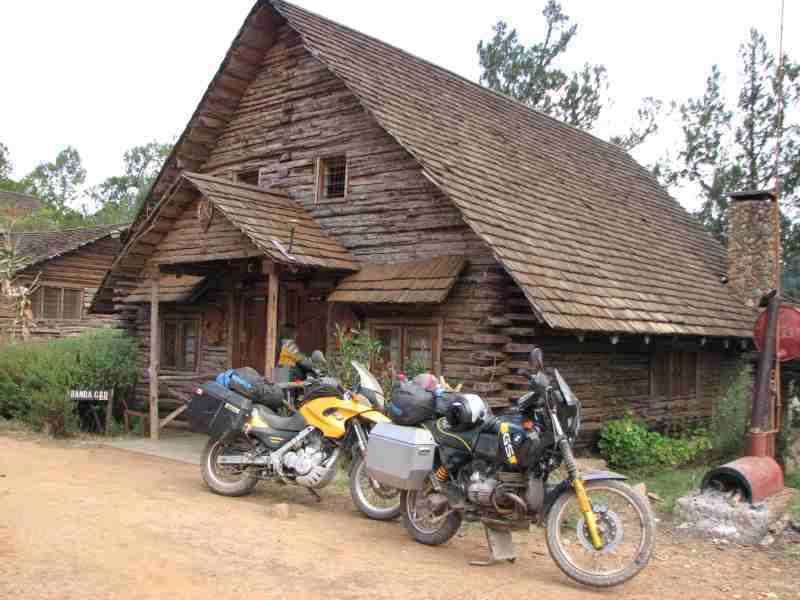
We rode with George to the equator, only 30 kilometres down the road, and this time we got a trained professional to do our water draining experiment. They had a bowl with a hole punched in the bottom and a jug of water already standing by so they must do the experiment several times a day. This time the water really did spin clockwise 30 metres north of the equator and counter-clockwise 30 metres south of the equator. Right on the equator it didn't spin at all and just drained straight down. After picking up a little souvenir of our equatorial visit from the rather desperate sales personnel we continued in the direction of Nairobi. The road was in great condition except for a few kilometres of potholes in a construction zone. After stopping for fresh pineapple at a roadside stand we were in Nairobi in short order. The GPS came in handy again to find Jungle Junction and lead us around the centre of the city where we had heard that a lot of the post-election protests had taken place. Once again we were re-united with our travelling companions, Tom, Matteo, Robin and Vesehl so we swapped adventure stories.
Ekke straddles the equator: one foot in winter and one in summer

At the equator with George
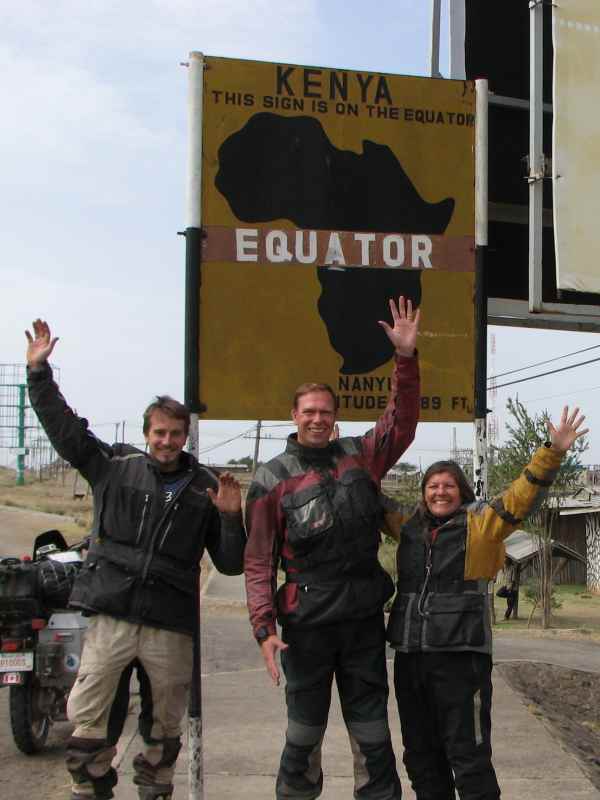
A professional water spinner guy does the experiment
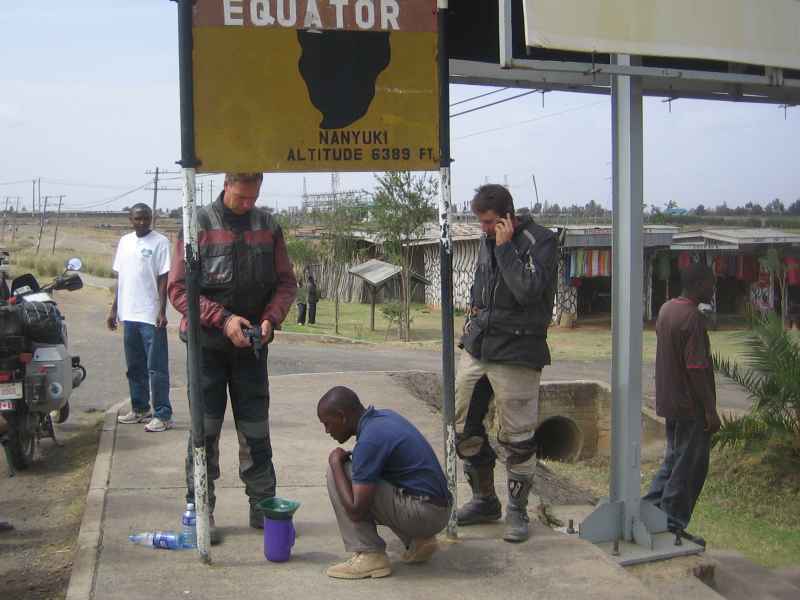
Yummy, fresh pineapple
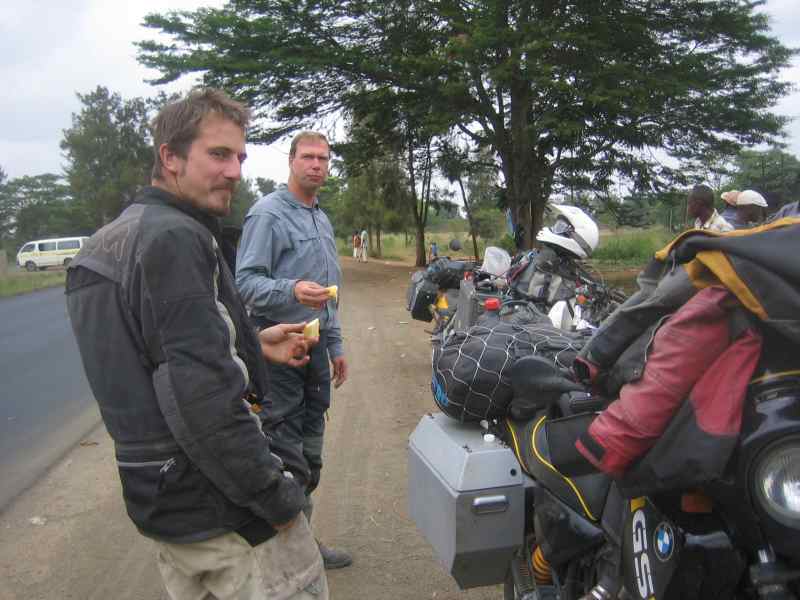
Jungle Junction
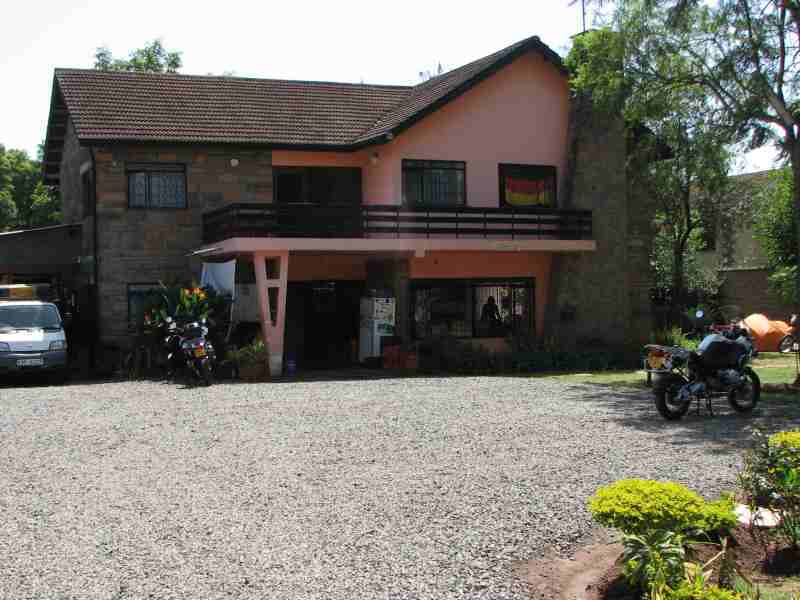
Friday, Chris the BMW mechanic/campground owner was busy so we couldn't do the necessary repairs on the bikes. We gave them a wash and I did a valve adjustment on my bike. The Ya-Ya Shopping Centre provided us with some real western style shopping opportunities and western style food too. Vehicle insurance is mandatory in Kenya and a few other countries further south so we bought four months worth to get us through to South Africa. Back at the campground Friday night was barbeque night where I had another T-Bone steak and Audrey enjoyed the chicken. We didn't realise how much we missed true western food.
Saturday we got started on the repair work on my bike; replacing the fork seals and welding the saddlebag mount. When disassembling the forks we found a couple of other problems so it took longer than expected and our plans for a Monday departure were dashed. In the meantime Audrey worked to finish the Ethiopia chapter of the website since we finally had access to reasonable internet.
Chris at work, repairing Ekke's saddlebag mount
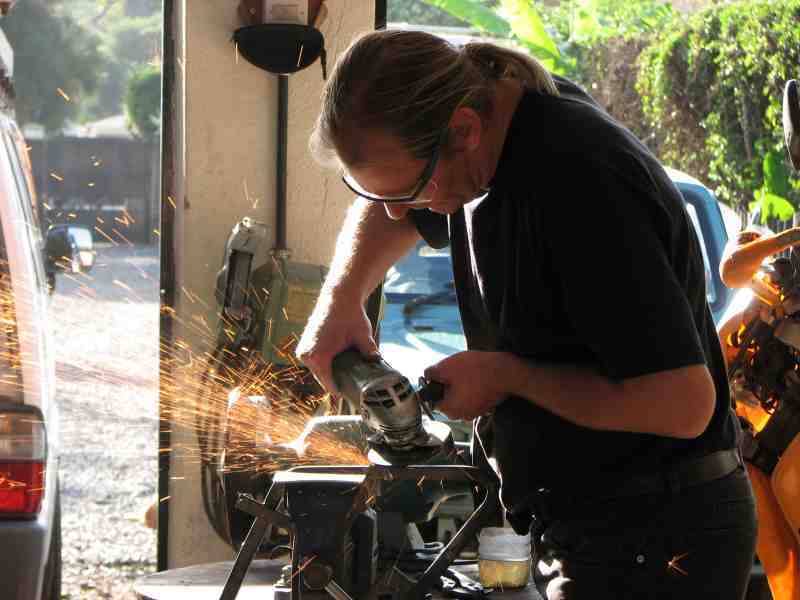
Sunday the garage was closed so we took a bus downtown and walked around Nairobi for a bit. It was a lovely Sunday morning and lots of people were about. Uhuru and Central Parks were cordoned off and had a significant police and military presence. The parks were empty and everyone was strolling around the perimeter. Other than the military presence there was absolutely no indication that rioting and protests had happened here and could happen again.
Uhuru Park

Monday, when we started work on Audrey's bike I took my bike out for a test ride. Immediately I could feel that with the tightened up forks and steering head my steering head bearings were destroyed. Riding with the missing steering head nut had hammered the bearings and put a big notch in them. The bike was almost unrideable. Since Chris was busy on Tuesday it would have to wait until Wednesday to get repaired.
Audrey writes:
Our stay at Jungle Junction was a lot of fun. The place is well known among 4-wheel drive overlanders, and we met other motorcyclists as well. Steven from the Netherlands had cracked the rim of his KTM and was waiting for parts. He had ridden up from the south and told us that from here down to South Africa, stamps in the passports would take up very little room, so we might just be able to make it with our current passports. Herbie, from Switzerland was also waiting for KTM repairs. Get a BMW, I say. We discovered that other Canadians, Mike and Ruby from Calgary, and Rene Cormier from Edmonton, had passed through recently. Small world! The campsite was located in the suburbs of Nairobi and was a converted house and grounds. We had full use of the place, complete with kitchen, dining room and sitting room and we felt human again in such pleasant surroundings. The bedrooms were also available for rent, and there were plenty of people around to do our laundry or cook our meals for a small fee. Outside the gate, vendors sold little sausages, roasted maize (corn on the cob) and mangoes, so lunch was always just around the corner. Robin, the South African Ducati rider, had been invited to stay with some family friends and one evening us motorcycle travellers were invited over to their home for a barbeque. The house was located on the grounds of Karen Blixen's (author of Out of Africa) former estate, and was beautiful. The food was fantastic, but more importantly, we got a real local's perspective on the Kenya situation. Tribal tensions were localized to a very small area of the country between the towns of Kisumu and Eldoret, and yet the media had made it look like the whole of Kenya was in an uproar. Tourism had dropped off considerably, and the economy had lost billions of dollars. Most of the country was safe and 'business as usual', and from our perspective, we were definitely in agreement.
Ekke writes:
With Chris being busy on Tuesday, taking his niece to a boarding school in Thika, we couldn't get the steering head bearing replaced before my Mom arrived on Wednesday morning. We gave her a call and broke the bad news that we wouldn't be able to pick her up at the Kilimanjaro airport. Wednesday morning, Chris replaced the steering head bearings (noting that the frame itself had been damaged by the pounding!) and then bled Audrey's front brakes again as they were still too mushy. By about 2:00 PM we were about ready to depart when it was decided to have a large group photo of all the motorcycle travellers. By the time everyone had submitted their own camera it was getting on three o'clock. Chris had explained a route that would avoid the Nairobi traffic so we took that way through the Karen Blixen neighbourhood. An hour or so later, as we were getting close to the main road to the border, a serious rain storm loomed over the horizon. When we came over a rise we suddenly encountered huge drops of rain. Rather than inserting the Gore-Tex liners while standing in the rain we did a U-turn and went to a side road a kilometre back. As soon as we stopped I noticed that Audrey's rear tire was going flat. It had picked up a screw, our first puncture. Before the big trip I had thought I would take an old tire and pound a nail in it to practice with repairing a puncture. I had never done that so this was the first time, at the side of the road in Kenya with an approaching lightning storm. Just as we were about to take the wheel off Audrey said, "What are those white horses with black stripes over there?" Cool, our first zebras! We patched the tube with a bicycle patch kit we had picked up in Erding at a bicycle store and were on our way in an hour or so. The rain and lightning seemed to be confined to a valley a few kilometres away so we never did get soaked during the repair. A quick look at the GPS confirmed that the border was still a hundred kilometres away and it was going to get dark in 45 minutes or so. At the junction with the main road we asked the officers at a police check point for directions to the nearest hotel or campground and were told that the only thing in the neighbourhood was 7 to 10 kilometres back up the main road towards Nairobi. We were loath to go back but it seemed like the only option. At the 7 kilometre mark we started looking for the Maasai Ostrich Farm and Resort and started to get concerned when we still didn't see anything at 10 kilometres. Finally at 17 kilometres (ah ha, she meant 7 AND 10 kilometres) a sign pointed west saying it was a further 7 kilometres to the resort. After two kilometres the road turned to gravel and we ploughed on, knowing that we didn't have much in the way of choices. The resort turned out to be quite luxurious but also quite empty of tourists. Kenya was sure hit hard by the post-election riots. We took a huge room and had a quick look at the ostriches (you could get a ride for a few hundred schillings) before taking a seat in the empty dining room to enjoy ostrich steaks.
Robin, Audrey, Ekke, Chris, Matteo, Tom, George and seated, Steven and Vesehl
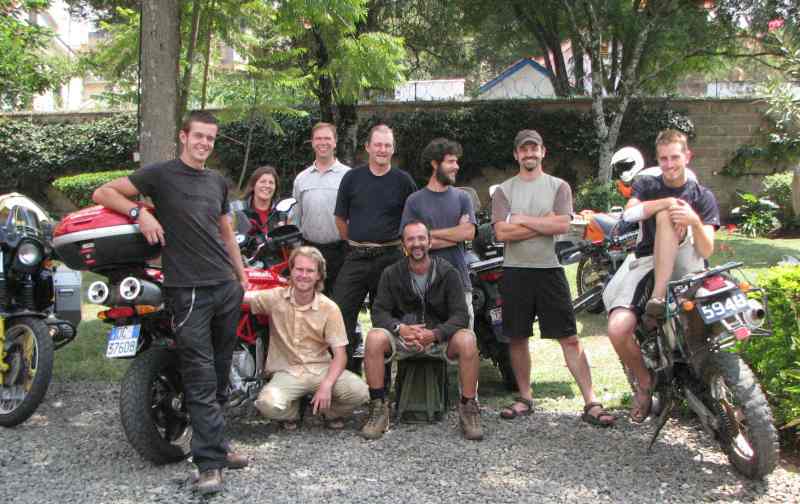
Pulling out a screw
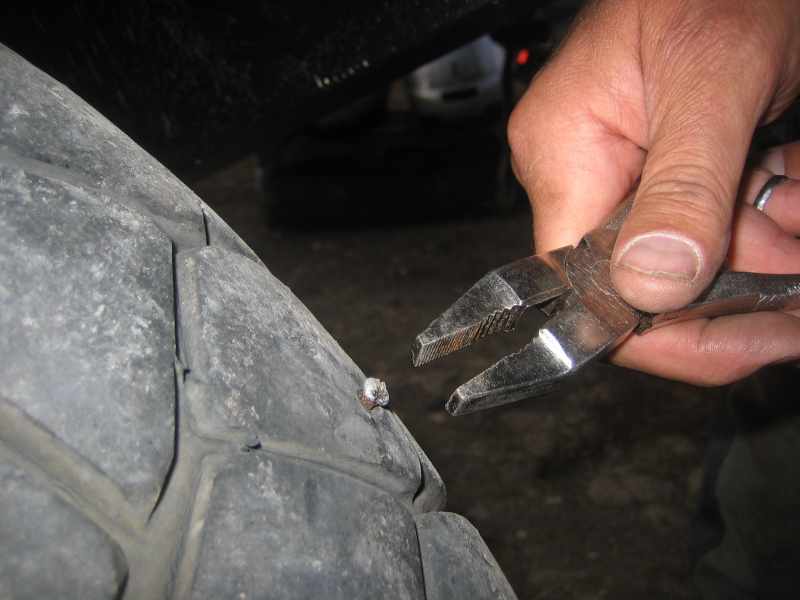
A Kenyan watches as Ekke pulls out the tube
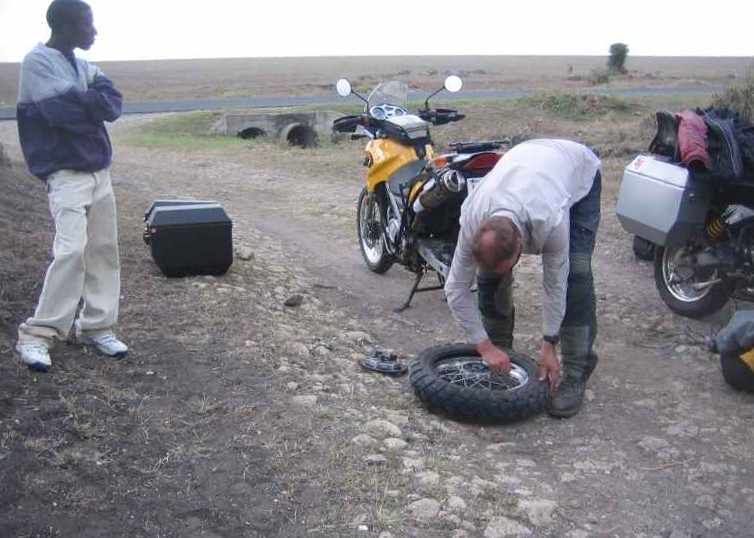
Audrey applies the patch

White "horses" on the horizon with an approaching rain storm
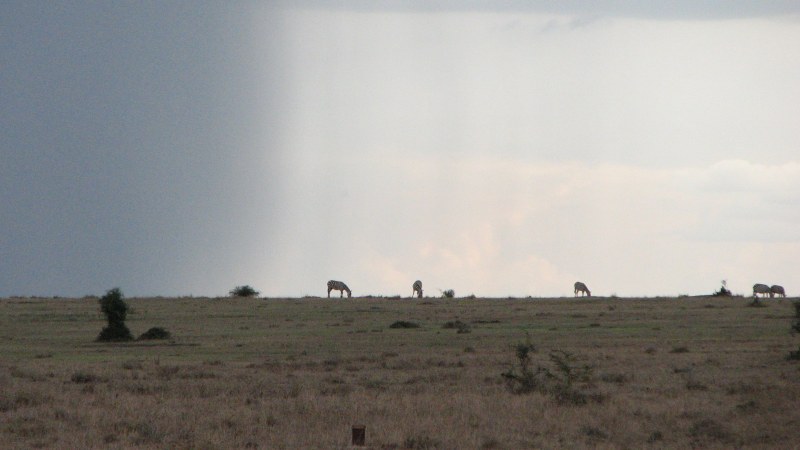
Luxury resort was our only choice
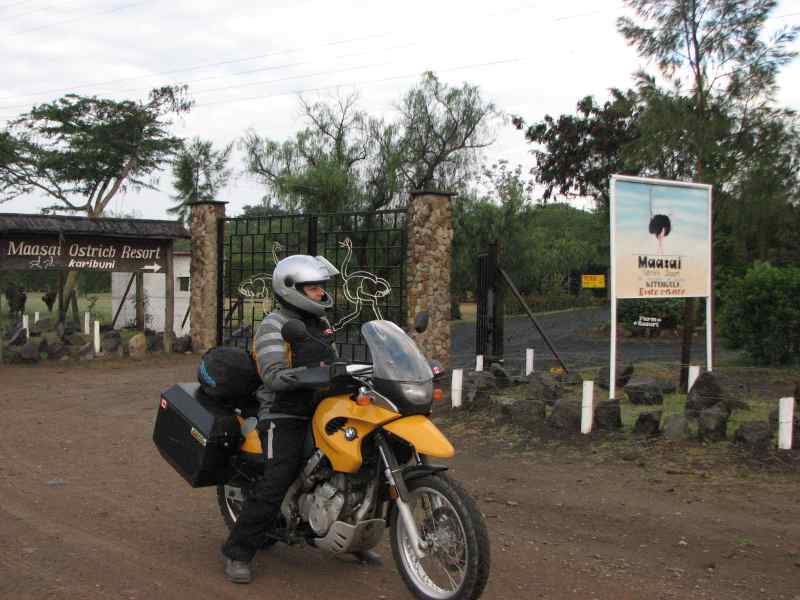
Sure enough, it had rained overnight and the gravel road had turned to mud for the first couple of kilometres, making for a slow slog back to the main road. It must have taken 45 minutes to get back to the police checkpoint. Fortunately, we didn't see a hotel until we were almost at the border so we had made the right decision last night. Checking out of Kenya was almost as straight-forward as entering and before we knew it we entered Tanzania. Overall Kenya had been a wonderful place to visit. It was too bad that so many factors contributed to making Kenya a "transit country" for us. We did not have the time to enjoy the game parks, mountains, Rift Valley lakes and lodges. Aside from the military presence in the parks in Nairobi we didn't see a single sign of anything untoward happening in Kenya. We will definitely have to come back.
Muddy ride out to the main road

A colourful departure from Kenya
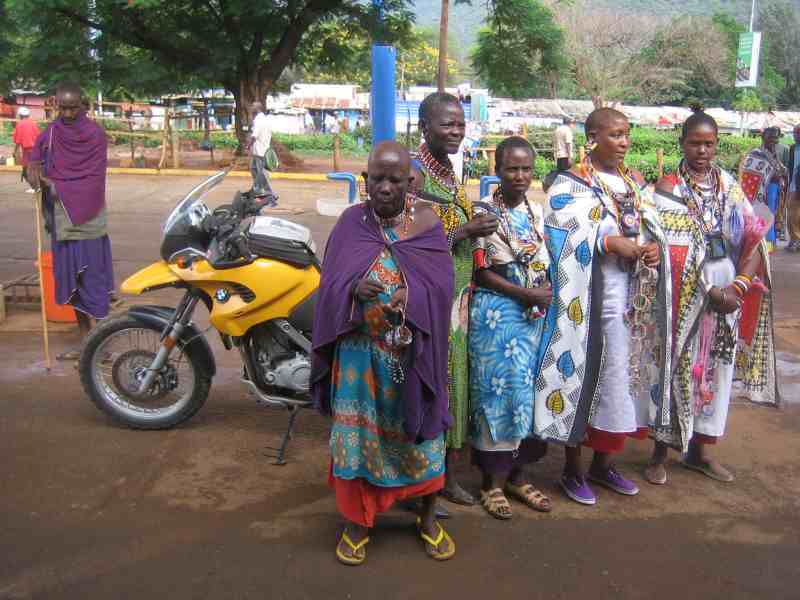
Maps of our route through Kenya


Our welcome to Tanzania was provided by a visiting Kenyan in a Toyota Land Cruiser. We had just cleared the Tanzanian customs (15 minutes to buy the visa) and were just leaving when the Toyota backed into Audrey's bike, with Audrey still on it. She managed to keep the bike upright but the idiot didn't even come over to apologise. At least he has a nice black stripe across his left rear quarter panel, matching the paint on Audrey's saddlebag.
Riding south from the border the land remained dry with low scrubby trees. Looking to our left we caught a glimpse of the cloud covered Mount Kilimanjaro but straight ahead was Mount Meru. We skirted around Mount Meru and rode into Arusha, situated at the base of the mountain. Seeing no sign for the Ilboru lodge we stopped at a gas station and phoned Stanley. My mom had climbed Kilimanjaro with Stanley as her guide in 2003. In the meantime Stanley had set up his own trekking company, Tanzanian Trekking Adventures (www.tanzaniatrekking.com). Mom had arrived on February 13th and we had originally planned to meet her at the airport but due to unforeseen circumstances we weren't able to meet that goal. Instead we arrived on the afternoon of the 14th. Stanley met us at the gas station and hopped on the back of my bike to show us the way. When we pulled into the lodge parking lot my mom ran out to greet us and we hugged the daylights out of each other. It had been a long time since we had seen each other and it had been quite an adventure for us, while quite a worrying session for them what with my injury and then riding through Sudan and Kenya. After getting caught up and settled into a room we met with Stanley to determine what we needed for our trek up the mountain. Apparently size 47 (13) hiking boots would be impossible to rent so I had to go with runners and my Viberg motorcycle boots. After our little chat we went for supper at the hotel restaurant. This turned out to be a bit of a disaster. Not because the food was bad but because the service was incredibly slow. Over two hours to have dinner on the evening we were supposed to be preparing for a trek up to Africa's highest point was just a bit stressful.
Stanley hops on the back of Ekke's bike to give directions to the Ilboru Lodge
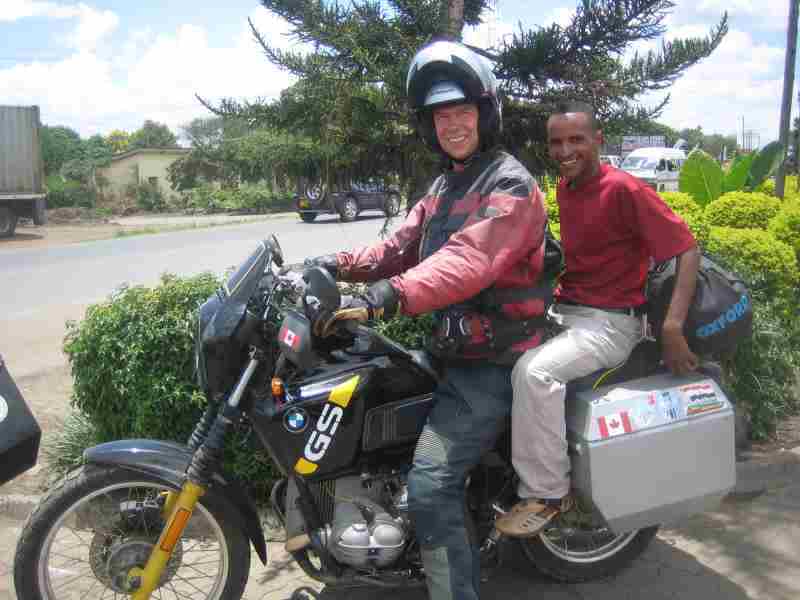
On Friday, the 15th, Boniface pulled up in a minibus ready to transport us to the Marangu gate. Along with a few of the porters (two for each trekker) we piled into the van and took the two hour drive from Arusha through Moshi and then up the slopes of Kilimanjaro. At the registration area we met two more of our porters for a total team of six porters, a cook and of course our guide, Stanley. While Stanley was registering and getting the porters to weigh their packs we started walking up the mountain with one of the porters, Masheka, leading the way. Masheka set a nice slow pace. Pole pole (pronounced "polay polay") as they say in Swahili. At the trail head Stanley had given us each a box containing a lunch. When we stopped to have a bite to eat we discovered that the boxes were packed with all kinds of treats. A samosa, a sandwich, a crepe, a bag of chips, a doughnut and an apple juice were all crammed in there. After lunch, hiking through the rainforest, we stopped for a photograph when Audrey just couldn't stand still. She started jumping about saying that she was being bitten by something. Red ants! Without hesitation, she dropped her pants and we all jumped in to help pick them off. This scene of pandemonium is what Stanley saw as he caught up with us. I'm sure he must have had second thoughts about Masheka's potential as a guide but we could only be thankful for his prompt action. After Stanley caught up with us, Masheka was free to go at his much faster pace (carrying a large backpack as well as a heavy sack on top of his head) up ahead. We discovered the reason why everything was so lush in the rainforest when it started to pour down with rain. Audrey was well set up for the combination of rain and heat with her umbrella. Fortunately the downpour didn't last too long as further up the trail, Stanley came to a stop under a tree; there perched overhead was a small group of blue monkeys. They didn't sit still long enough to get a good photo though. At about 5:00 PM we arrived at the Mandara huts where we were lucky to get a cabin for four just for the three of us. As the crew was way ahead of us they had prepared a tea break (coffee, tea, hot chocolate) with popcorn and cookies. Supper, an hour later, consisted of an enormous plate of roasted potatoes, cooked fresh vegetables and battered fish. We couldn't finish it all despite our best attempts and Stanley gave us a real dressing down. We needed to eat as much as possible since we would need the energy to climb to the summit. Stuffed to the gills we turned in early.
Registering at Marangu gate

The porters get their backpacks weighed
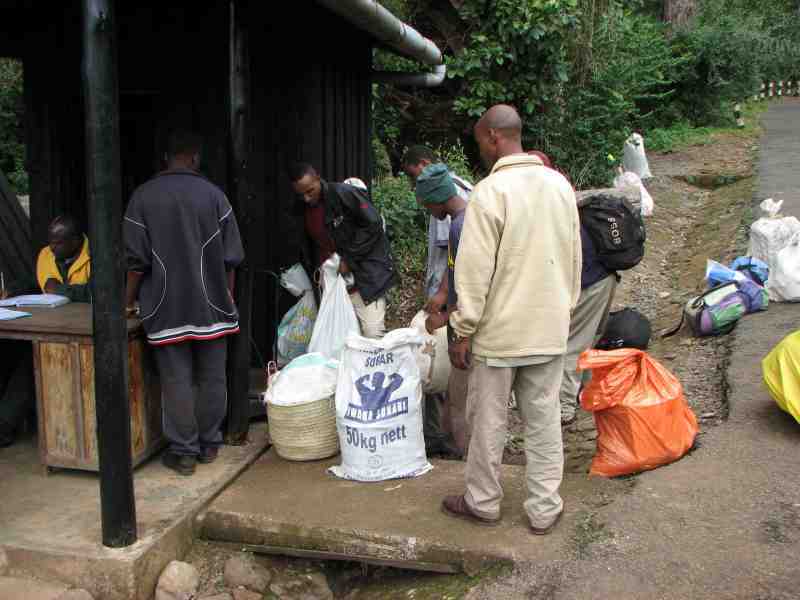
Audrey's umbrella comes in handy
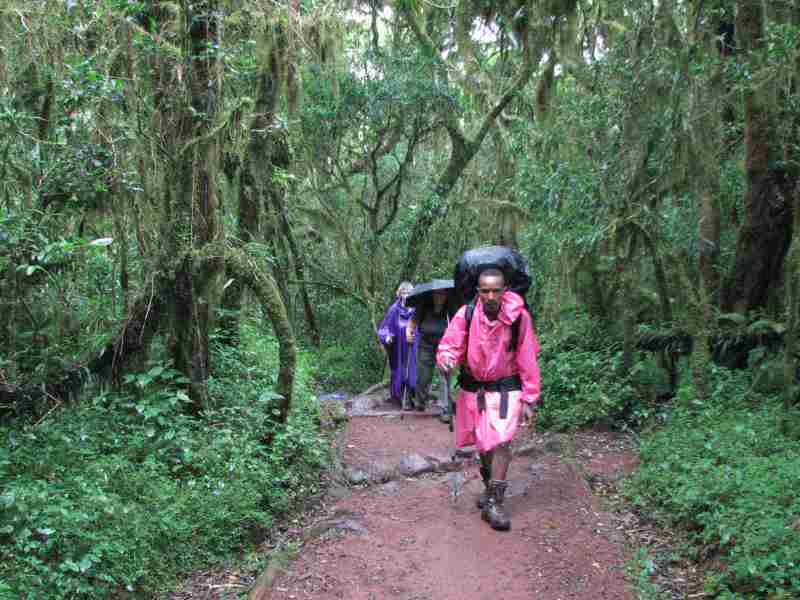
A blue monkey in the forest
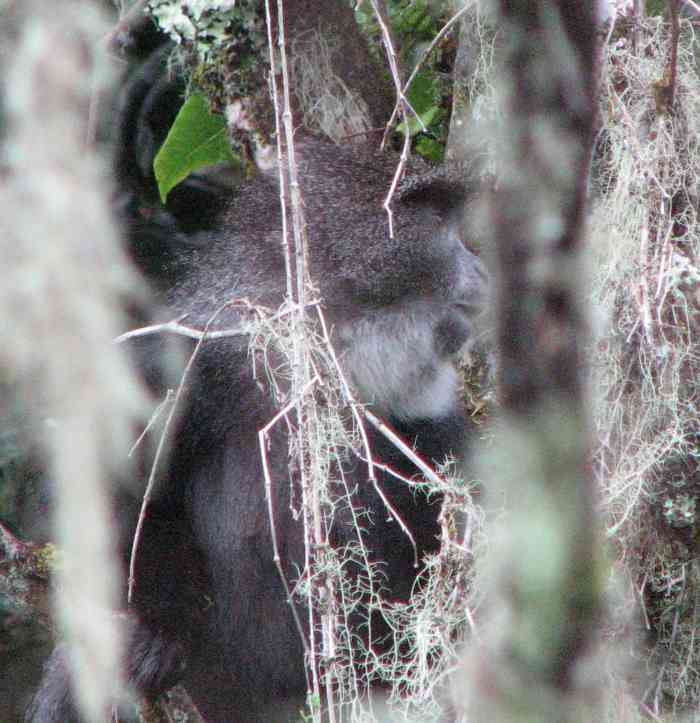
Audrey enjoys popcorn for tea time (we always recognised our Christmas table cloth at the dining huts)

In the morning we had a knock on the door of our hut and discovered that three large basins of warm water had been placed on the steps for us to wash up. After a great hot breakfast of porridge, eggs, sausage, toast and fresh fruit (backpacking has never been like this!) we started the walk to Horombo huts. Almost immediately we ran into a troop of colobus monkeys. Their long, fluffy tails helped them to balance as they leapt from branch to branch, what a sight to see! The rainforest changed slowly (remember pole pole!) to heather as we climbed. We had gained about 1,000 metres the day before and we were scheduled to climb another 1,000 today. Then another 1,000 metres to Kibo huts and 1,300 metres to the summit at Uhuru peak. Maybe Stanley had a point about building up some energy. With the slow pace that Stanley kept us to we never ran out of breath or had our heart rates climb, he really was setting us up to make the summit, but could we deliver? The heather got shorter, giving way to moorland, as we climbed higher but the fog never really seemed to lift. We had occasional views of Mawenzi peak, a sister to the Kibo peak we hoped to summit, through the fog. At about four o'clock we arrived at the Horombo huts to find lots and lots of people. Not only did everyone going up the Marangu route stop here on the way up the mountain but a lot of the other routes came down this way. Trekkers on a six day hike, such as ourselves, had an acclimatisation day here as well so the end result was that we had to eat in shifts in the dining hut. We didn't get in until about 7:00 PM.
Ekke spies a colobus monkey in the trees

Colobus monkey
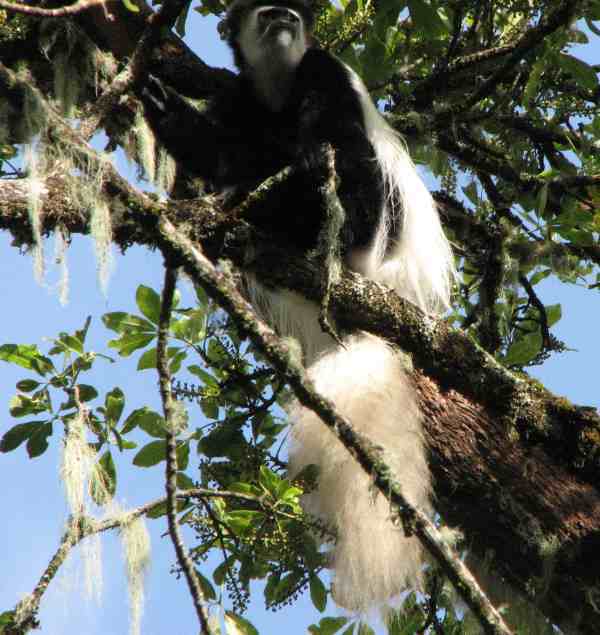
Emmanuel, Masheka and Thomas carry our gear up the mountain
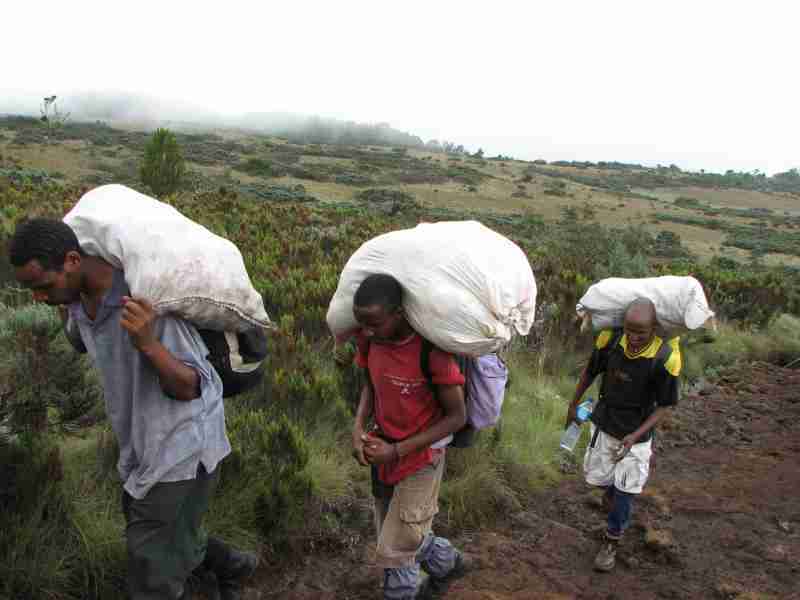
A foggy day of hiking
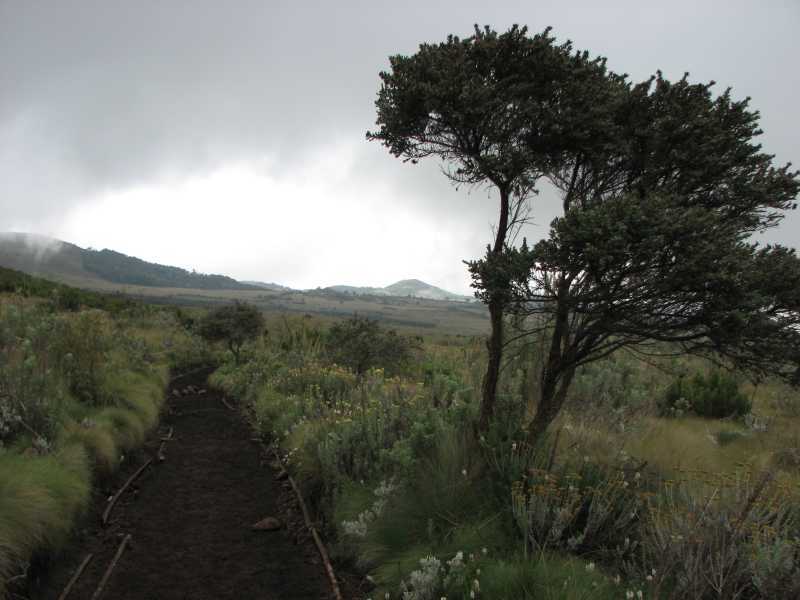
Lunch time!
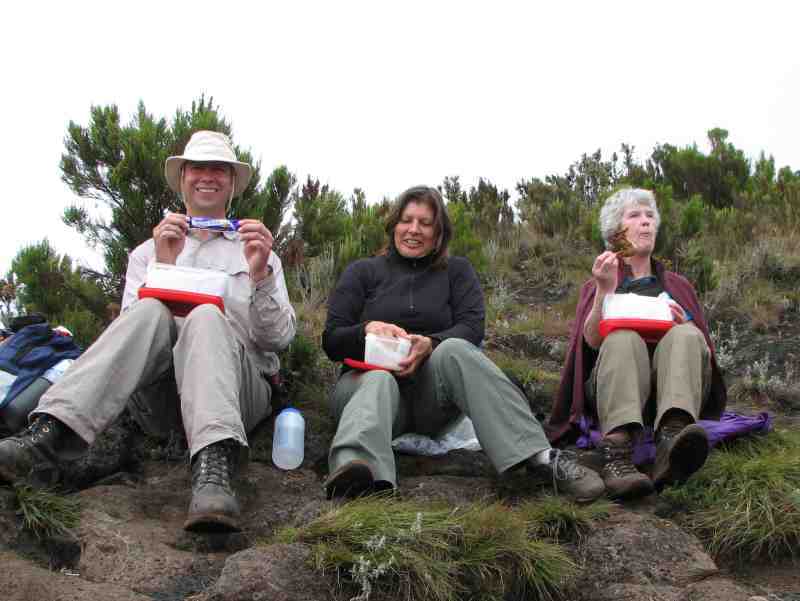
An easy climb
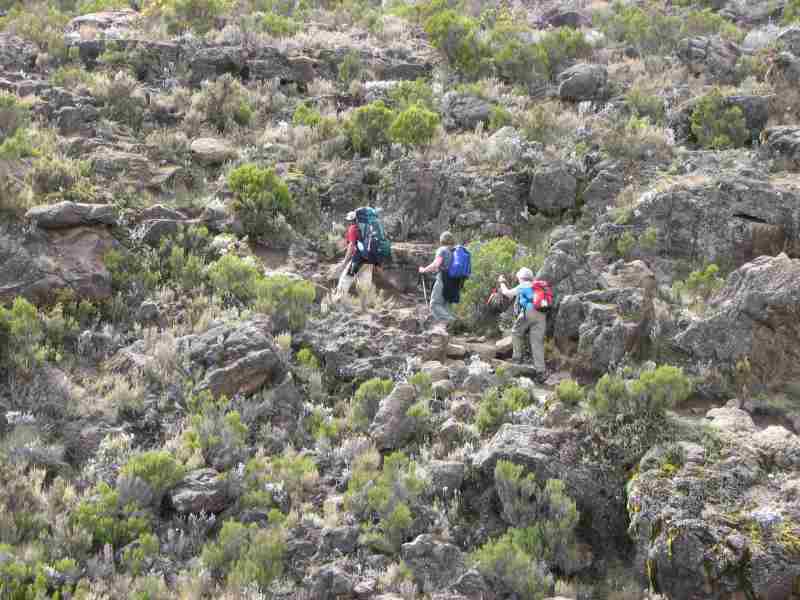
Arriving at Horombo huts
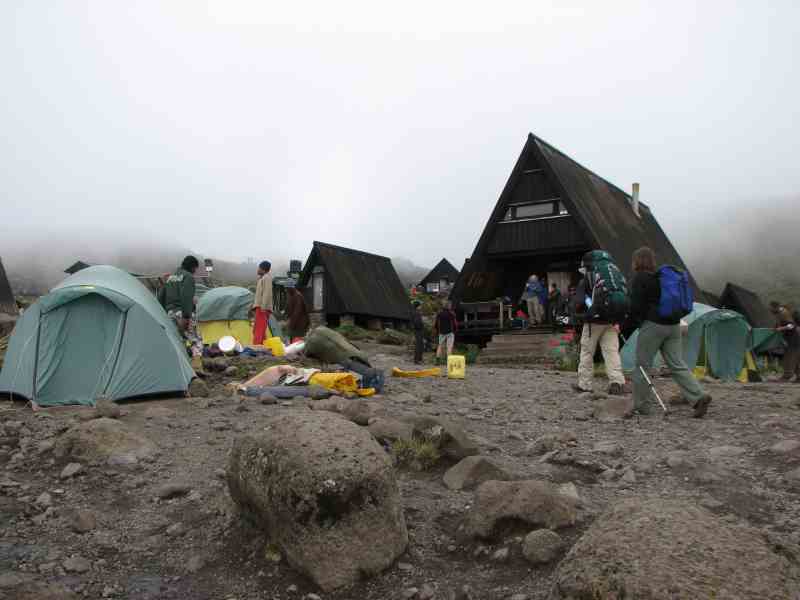
Masheka hands Stanley some of our luggage
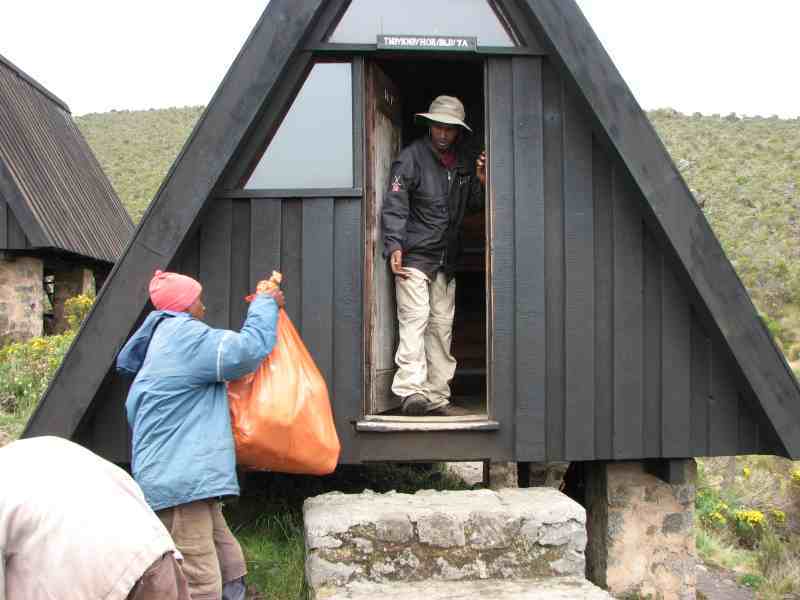
Sunset above the clouds
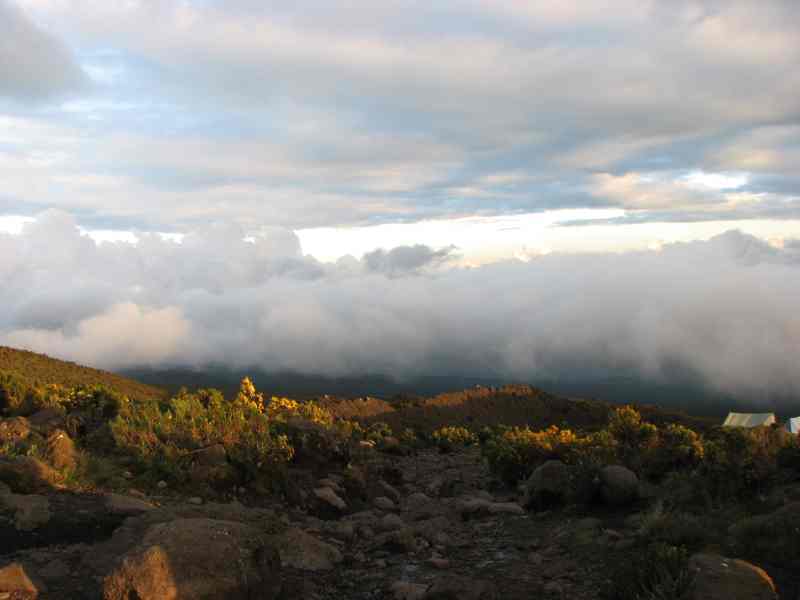
The dining hut is full
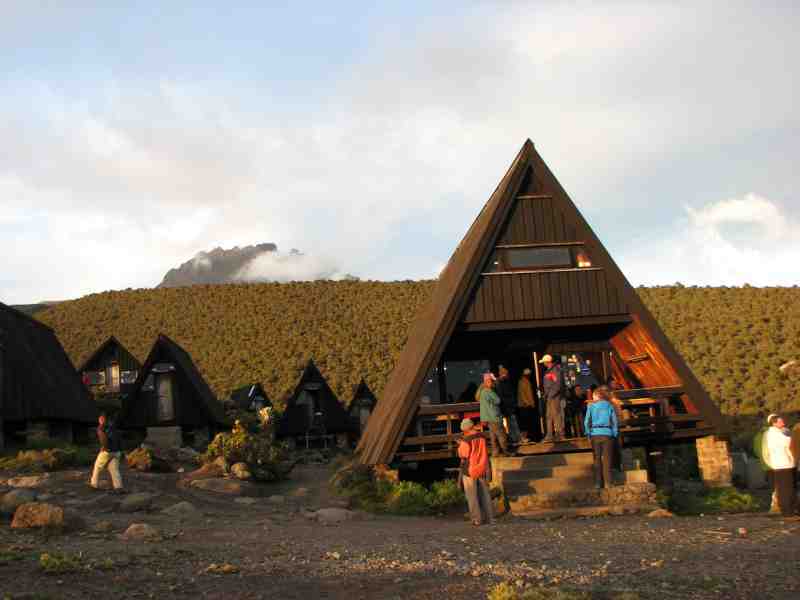
It really cooled off during the night and it was nice to wake up again to the tubs of warm water. Letting those who had a significant hike (either up to Kibo or down to the gate) have breakfast first we had the dining hut almost to ourselves. We hiked up to Zebra Rock for an elevation gain of only a few hundred metres and came back down to Horombo for lunch. A free afternoon gave us a chance to catch up on the reading materials mom had brought from home.
Turning off to Zebra Rocks with Kibo Peak in the background

Climbing out of Horombo huts

Zebra Rocks

Taking a break before the next day's hike to Kibo huts

Audrey foregoes the break and takes up rock climbing

Reading "Long Way Down" during our free afternoon
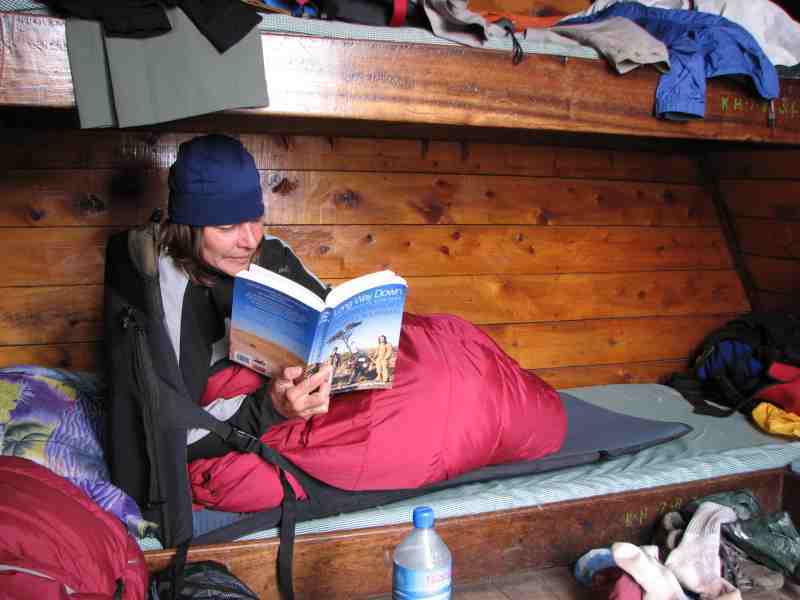
Monday morning dawned clear and cold for our trek up to Kibo huts. We retraced a kilometre or two of yesterday's walk and then ascended to Mawenzi Ridge before descending onto the high alpine desert of the Saddle. The trail was wide and smooth, with just a gradual incline, which made for easy walking. Stanley always made sure to keep the pace slow enough that we weren't out of breath at these altitudes. By now we were over 4,000 metres up and the air was getting thinner. Fortunately none of us was suffering even a little bit from altitude sickness. Again we got extremely lucky when we arrived at Kibo huts and were assigned a room. The room could accommodate 12 trekkers but only we three were in the room. We knew that tonight was going to be an early wake up call (10:30 PM) so while other climbers were chatting and having fun we put in our earplugs and put on our eye shades to get an hour or two of shuteye before supper. A knock on the door was followed by Masheka coming in to set the table for supper at about five. What was especially surprising was that Masheka was going to accompany us to the summit and here he was still working like everyone else. Stanley came in for a final pep talk and to encourage us to eat everything put in front of us. Apparently at higher altitudes one's appetite wanes and food doesn't taste as good so that was why Stanley made sure we ate now.
Our porters packing up before the hike to Kibo huts

Secacia Kilimanjaris

Don't bother coming to Kilimanjaro for the peace and solitude
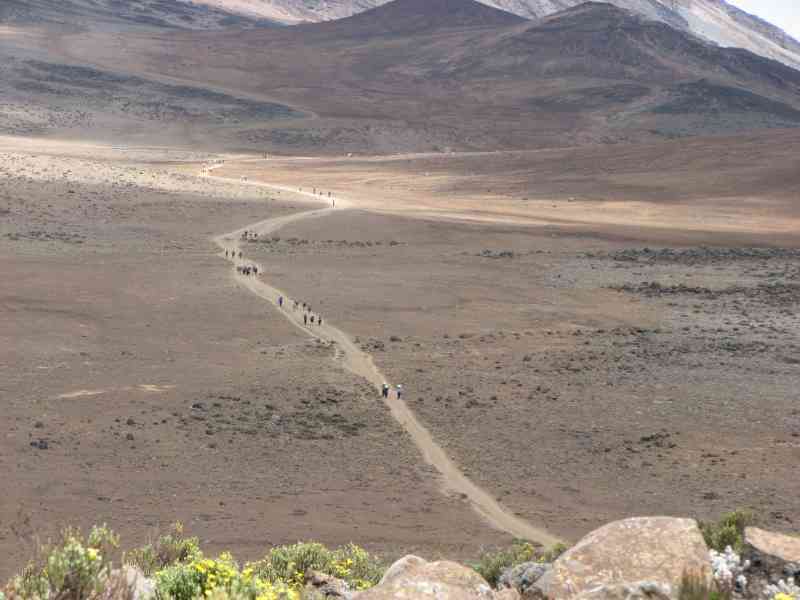
The last supper (with Masheka's trademark folded napkins)
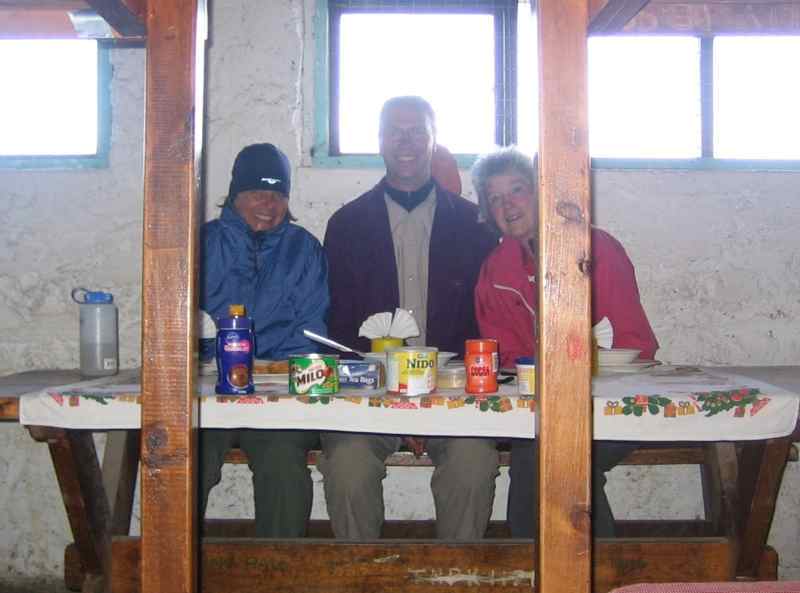
Sunset on Mawenzi Peak

10:20 PM. A knock on the door. Insane. Who signed me up for this? Yet, with nervous energy we made sure our packs had everything we needed though we were already wearing most of our cold weather clothing. After refreshing tea and cookies we were on the trail a little after 11. We were first on the trail, there were no headlights rising up the mountain ahead of us. We knew that wouldn't last because Stanley, as always, made sure to set a pace that would not tire us out and at the same time hopefully get us to the top in time. If we arrived at Gilman's Point, on the crater rim, too late then we couldn't make the trek to Uhuru Peak and back before the snow became soft and slippery in the sunshine. Pole pole we went zigzagging up the scree slope in the darkness. With the moon being only a couple of days from full we had the option of using our headlamps or not. One foot in front of the other. Plodding. Onward. Finally my size 13 feet were useful for something. Even placing one foot in front of the other I could still make good progress. Every now and again we would hit a softer patch of scree that took extra energy to plough through. Looking back down the mountain we could see a string of headlamps in the darkness, the lights of those who had started after us.
Stanley gave us short breaks, making sure to get us moving again as quickly as possible, no rest. We started to feel mild effects from the altitude; a bit of a headache, slight nausea and even a bit of dizziness. It wasn't anything serious but it did make you want to stop and take a little nap or something. A trekker coming down had told us to listen to whatever your guide says because you become infantile up there. This was really brought into focus when at one break Stanley brought each of us a small chocolate bar, unwrapped it for us and then virtually put it into our mouths. At another break, out of Masheka's pack came a giant thermos of piping hot tea. Everyone was given a steaming hot mug of the delicious beverage and Audrey, who needed to change socks, had her cold feet rubbed.
After working our way up the scree the trail became yet steeper and simultaneously we were confronted with large boulders to climb over. This was undoubtedly the most difficult portion of the entire trek but finally at a little after five we made it to Gilman's Point. Only a very short break was allowed here as the common trap was to lollygag about and squander away the time needed to go to Uhuru and back. Onward in the darkness. We encountered our first snow fields and while they were hard they were still a bit slippery. Here we had thought we could go an entire year without hearing the crunch of boots on snow and now we had climbed to the top of Africa to hear it. Slowly, the dawn broke on a hazy morning with the sun cresting Mawenzi Peak at about 6:30. Another 45 minutes of bitter cold (-10 C but with a vicious wind) got us to Uhuru Peak at 5,895 metres. The feeling of reaching the summit was indescribable. Euphoric. Tired. Proud. Cold. We stayed there, snapping photos, for 10 or 15 minutes before Stanley started to usher us down. The day was still young and we had to descend more than 2,000 metres back to Horombo huts. Walking back along the rim of the caldera towards Gilman's Point we were floating on air we were so happy. The snow was still good and firm so the walking was fairly easy. With the sun shining on us it was warming up so that we could take a bit longer for a break at Gilman's before descending the steep, boulder-strewn slope. Then the fun of scree skiing down the slope had us back at Kibo huts at about noon. Just before sitting down to eat lunch I got bowled over with a flying tackle! Tom, Matteo and Vesehl had arrived! They had started two days after us and were on the five day tour. We quickly got caught up on adventures since Nairobi, gave them our excess Power Bars (Stanley was feeding us so well we didn't need them), polished off lunch and started our trek down to Horombo huts.
We made it to Gilman's Point!
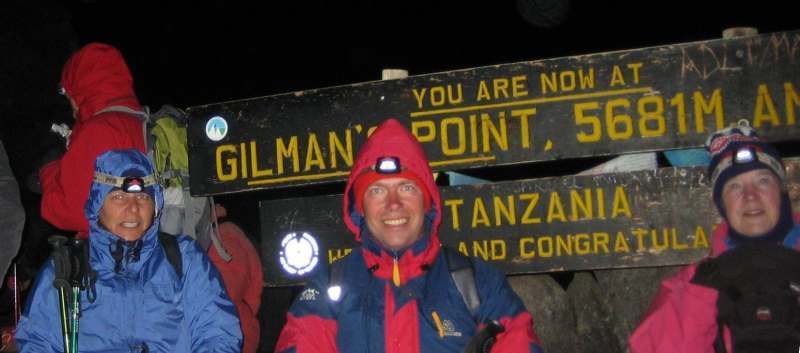
Headlamps in the darkness below

Pre-dawn light on the way to Uhuru Peak

Way above the clouds

The sun rises over Mawenzi Peak
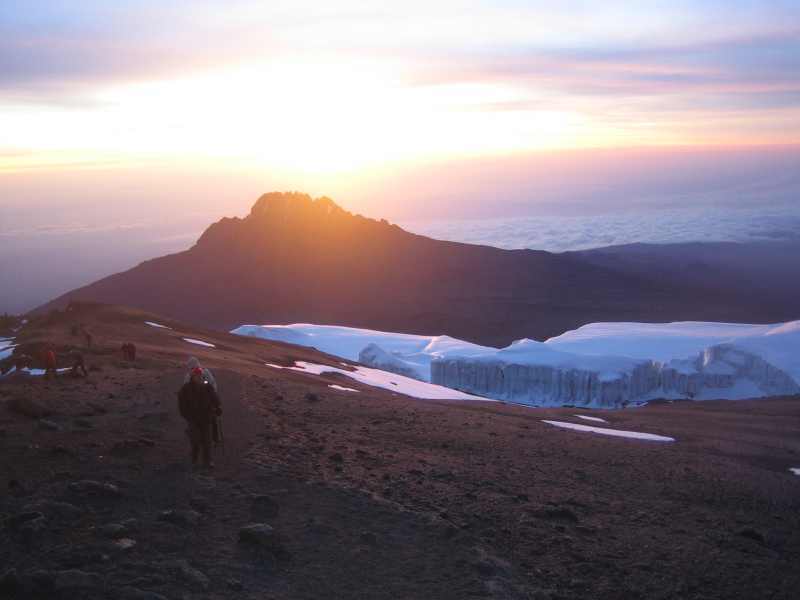
Yes, it is cold up there
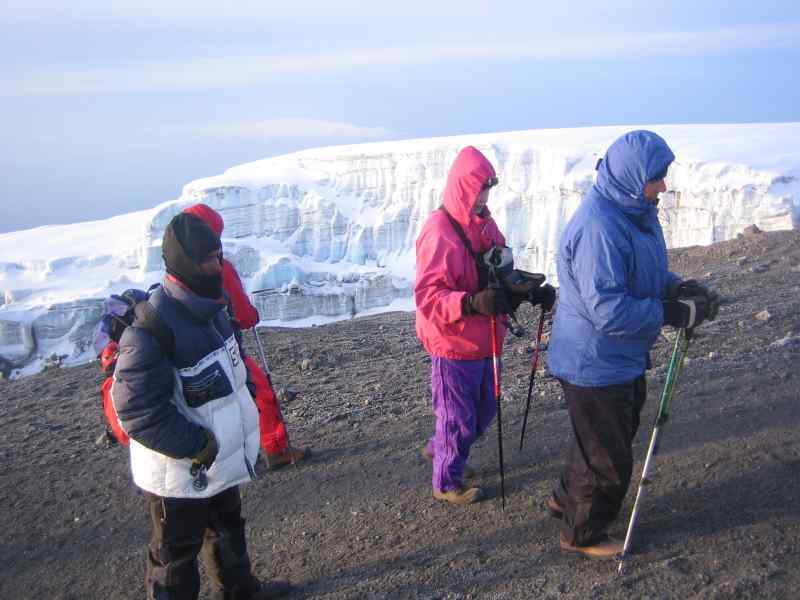
Mount Meru below
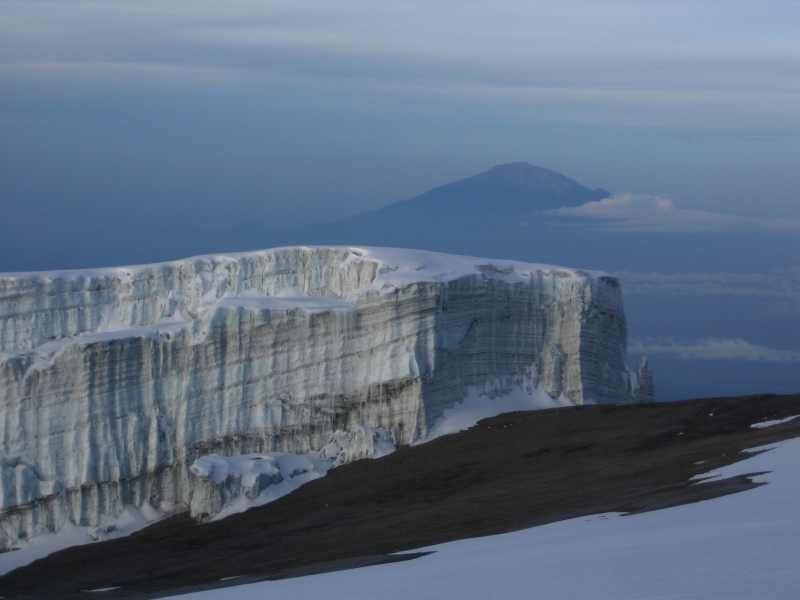
WE DID IT!
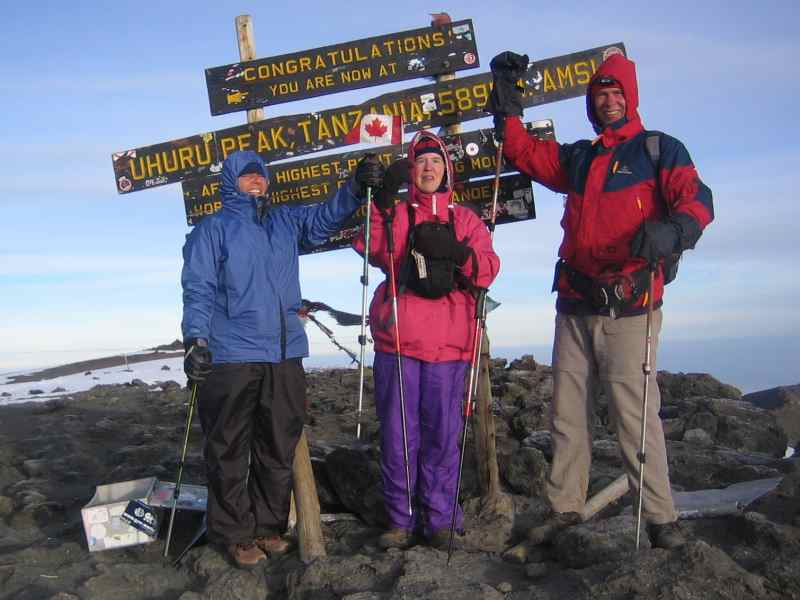
Magda and Ekke looking mighty happy

Firm snow pack

Thank goodness the water hasn't frozen
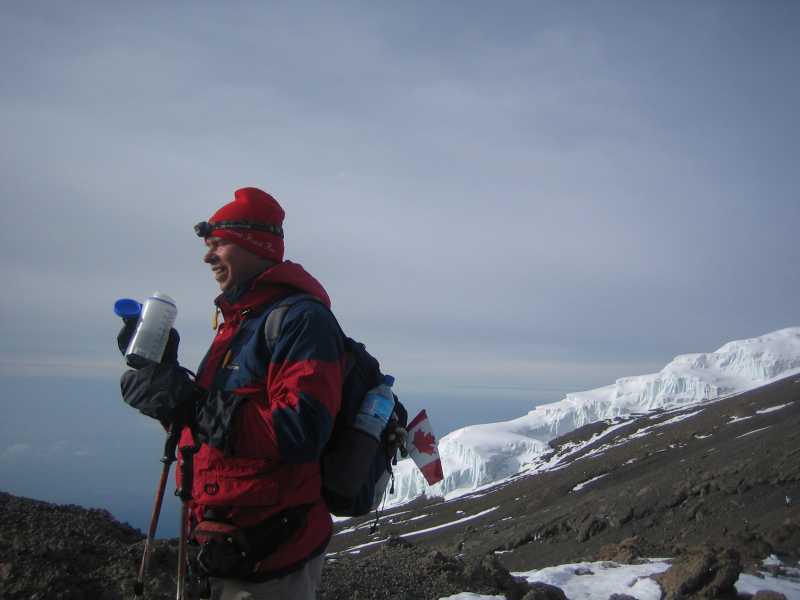
Down the steepest part of the trail

Scree skiing

It was almost unbelievably easy walking. The wide, smooth trail at a gentle downward gradient had us flying down. Perhaps we were still on the air cushion of euphoria. When we registered at Horombo we went to our assigned hut and found a sleeping bag already set up on one of the four beds. This would be our first shared hut. Unfortunately (or perhaps fortunately) we couldn't make it work. I was the only person who could climb up onto the top bunk but because of the steep pitch of the A-frame hut the upper bed was too short for me. Audrey went to the registration office, told them our story and came back with the keys to another cabin. We had our privacy again.
An easy walk back to Mawenzi Ridge
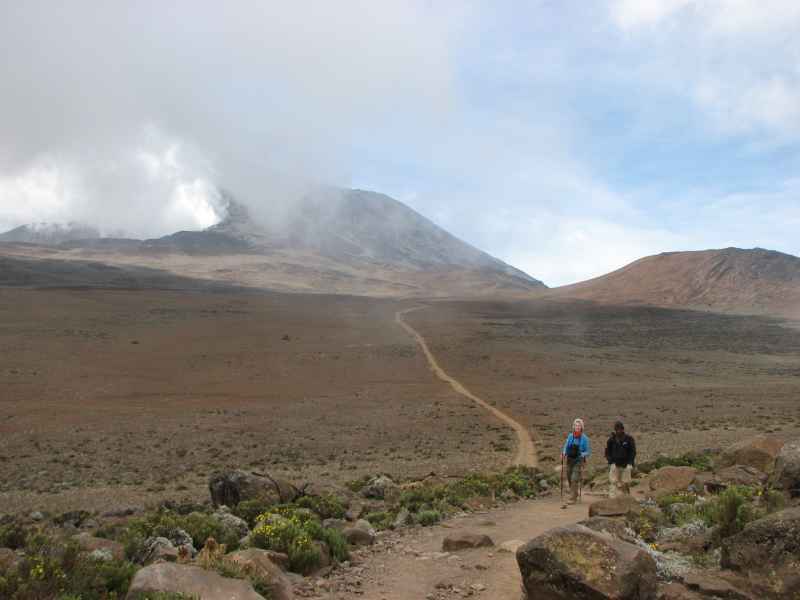
Despite having ascended about 1,300 metres and descended about 2,300 metres yesterday we were looking forward to descending 2,000 metres in about 20 kilometres today, all the way back to the entrance gate. Just before Mandara huts we saw the same troop of colobus monkeys, took some pictures and then proceeded down for a nice hot lunch. As we finished our lunch, someone we had seen on the trail a few times came over and commented on how wonderful our lunch looked. It seemed that other trekking companies provided a very simple cold lunch, if anything, on the last day while we got a plate of spaghetti with cheese, vegetable sauce and french fries. As we were preparing for the final leg, a stretcher with a hiker on board came down from Horombo. Stanley told us that he had seen five people evacuated the same way during the afternoon at Kibo hut. Typically they suffer from acute altitude sickness and need to be transported down as quickly as possible. Then by the time they get down to Mandara huts they are feeling well enough to walk the rest of the way. It wasn't the same for us. Mom was having some trouble with her knees and downhill was really painful. As a result she was going quite slowly. Stanley suggested that she walk down a couple of kilometres to the start of the road and he would call for a car to bring her down the remaining five kilometres. This would save quite a bit of time and more importantly, mom's knees. Audrey and I took off, setting a quick pace as soon as we dropped mom off and we reached the gate in a bit less than an hour. We had done it. We had climbed Kilimanjaro!
Chili on the mountain
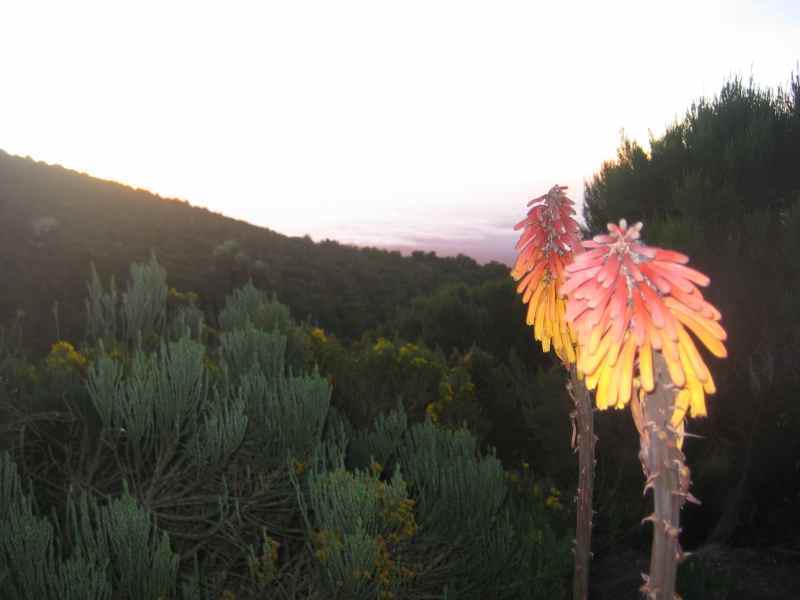
All the porters at Horombo getting ready

The regular troop of colobus monkeys near Mandara huts
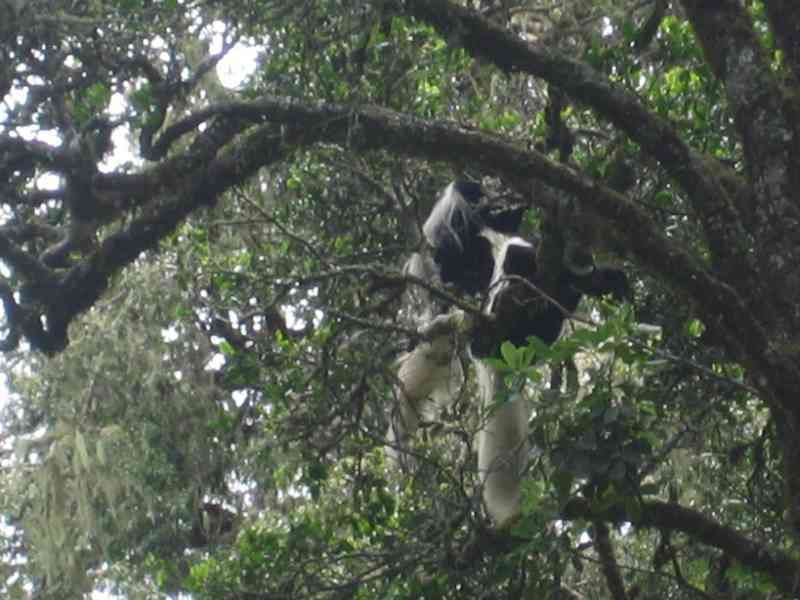
This guy got off the stretcher and actually passed us later down the trail

As you can tell from our trek, the guide and trekking company really make the difference between a fun, successful trip and one where you don't meet your goals and don't have any fun doing it either. We were really lucky to have Stanley as our guide. He made sure that we would achieve our goal of going to the summit right from the very start of the hike. Stanley's company, Tanzanian Trekking Adventures, gave us the support we needed to be successful but also by giving us those warm bowls of washing water and great food made the trip fun and as comfortable as possible. We can't recommend Tanzanian Trekking Adventures enough.
The day after we returned to the Ilboru Lodge Audrey and mom recuperated from the hike by reading and writing while I repaired Audrey's flat tire. The tire had gone flat again so it needed a new tube. Stanley showed me to a couple of motorcycle parts shops and we eventually found a tube that would fit. On the 22nd of February we went for a ride. Mom had brought her motorcycle helmet all the way from Canada with the intention that she could go for a bike ride in Africa. So that's what we did! We rode north, back towards the Kenyan border to a Maasai village that we didn't have time to stop at on the way down. At Longido we had a traditional lunch of ugali (corn flour paste, which kind of looks and feels like instant mashed potatoes and is eaten with the hands) and barbequed meat at a local restaurant. A Maasai Jewellery Market at the edge of town looked like it was starved for tourists so we livened up their day. What a lot of fun it was bargaining for some cool souvenirs. All in all we really enjoyed this little day trip. Up until now our riding had been to get somewhere but today we rode just for the sheer pleasure of riding. What a nice change of pace.
Riding north to Longido

Happy to be riding in Africa
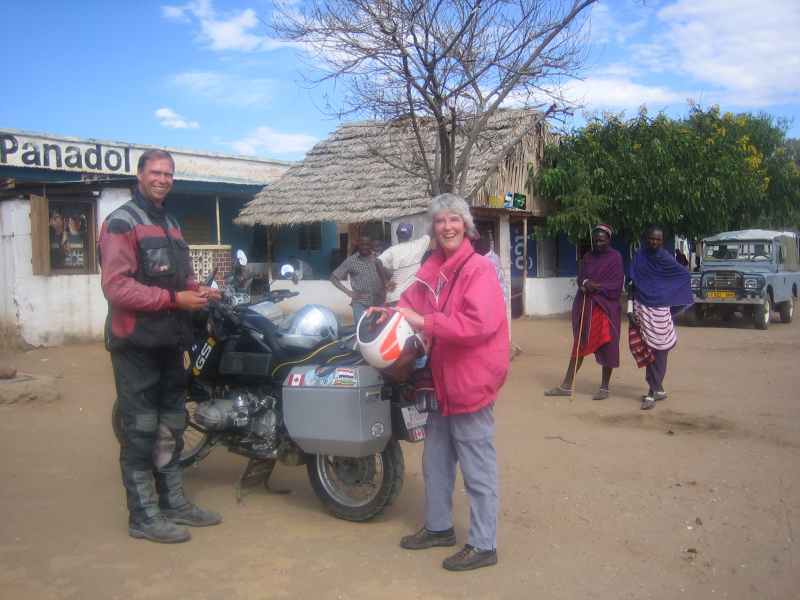
Maasai Jewellery Market was empty a few minutes earlier
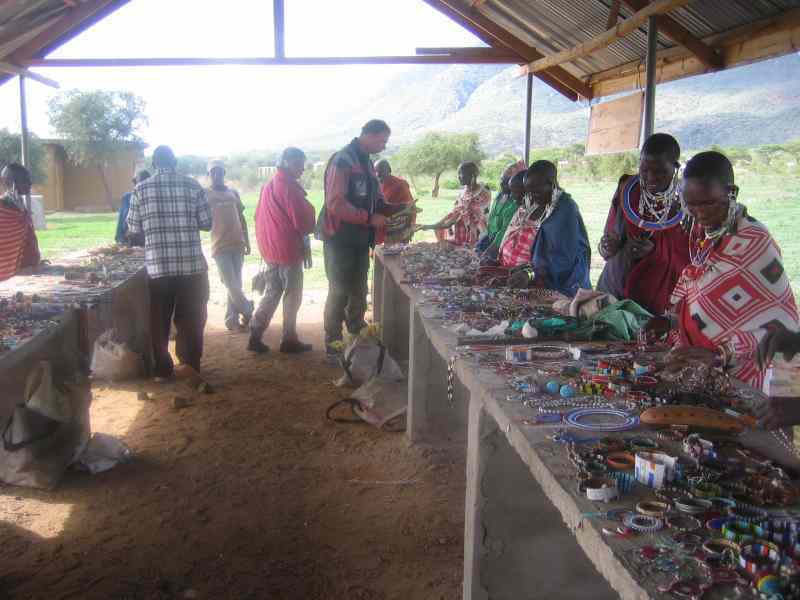
Magda and Ekke point towards Kilimanjaro
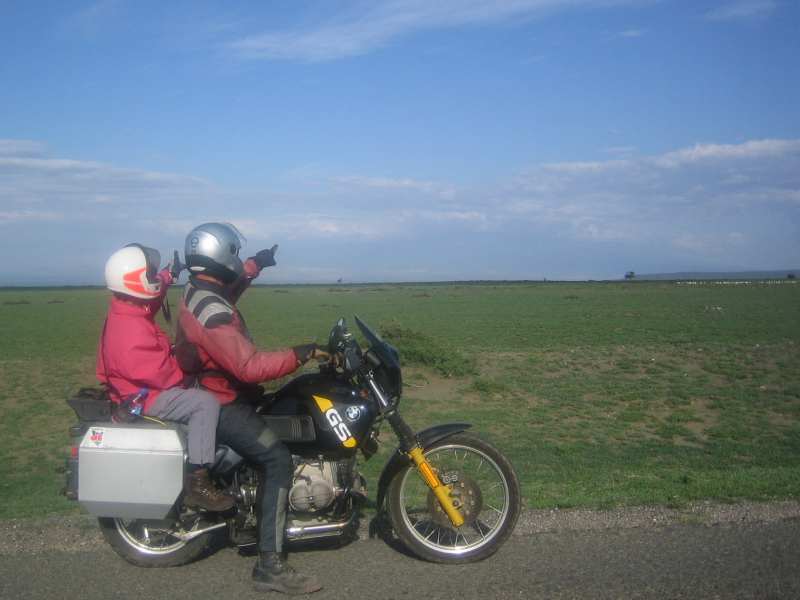
Mount Meru
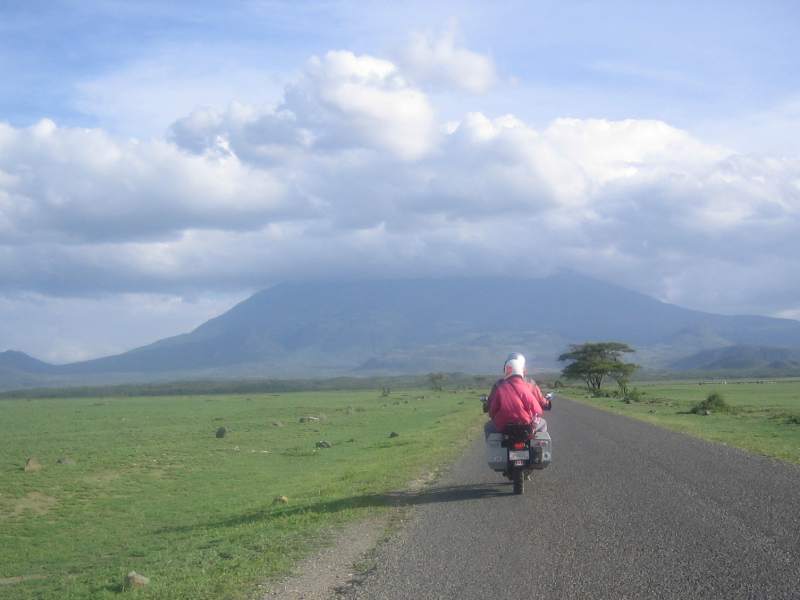
Map of our ride to Arusha
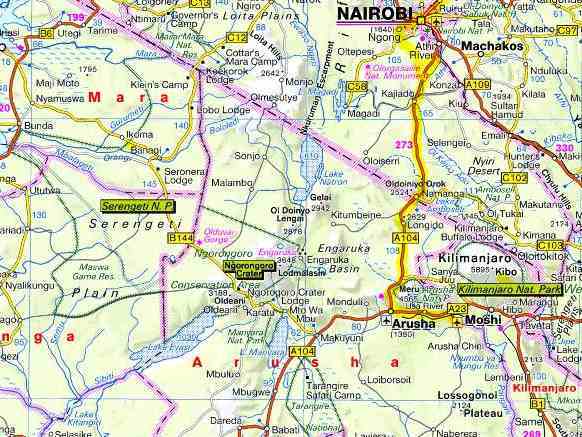
Stanley (www.tanzaniatrekking.com) gave us a couple of choices for a Safari. The first was to have a vehicle to ourselves and camp, staying in a tent in a fairly primitive campground. The second was to share the vehicle with two other people and stay in luxury accommodations. Hmm. Of course we went for the luxury option and it worked out really well. Our guide, Boniface (our shuttle bus driver for the Kilimanjaro trek), was fantastic and was very knowledgeable about plants, animals, and where to find animals eating other animals. Newlyweds Christine and Will from Boulder, Colorado were our travelling companions in the Land Rover. (Does this sound like an episode of 'Amazing Race' or what?). They were great at spotting wildlife, as they had already visited Kruger National Park in South Africa and knew the difference between an eland and a dik-dik. But alas, they had not yet seen the elusive leopard, the last of the 'Big 5' to check off their list. The 'Big 5' are, according to legend, the five most dangerous animals to hunt, and include elephants, buffaloes, lions, rhinos and leopards. We were really hoping to see any of these animals, let alone all of them. Magda joined us in the Land Rover for the first day, and then went back to Arusha for shopping and a cultural tour. She is now the proud owner of a two metre tall wooden giraffe. We'll have to see if that one makes it on the plane as carry-on. Lake Manyara was our first stop, a National Park known for birdlife. Hundreds of storks circled high above us, and we noticed that they spiralled counter-clockwise if you needed more proof of the coriolous effect south of the equator. We didn't notice too many more birds because something absolutely huge came stomping out of the bush, an African Elephant! Seeing our first elephant in Africa was a momentous occasion. We had seen the dung before, also a momentous occasion, but this was really something else. Elephants in zoos are amazing. Elephants in the wild are really amazing. The huge, lumbering beasts got quite close to the Land Rover, and could have reached right in and snatched any of us away with their trunks. Fortunately, that didn't happen, and we made a graceful escape in the direction of the zebras, buffaloes and giraffes. Herds of impalas dotted the landscape, recognizable for the big, black 'M' on their backsides. Nearby was always a bachelor group, the young males not yet strong enough to get a harem of their own. The hippo pool actually had hippos and they were fun to watch with all that yawning and lollygagging about in the shallow water. Apparently these roly-poly creatures are the most dangerous animal in Africa, and you wouldn't want to get between a hippo and its water source. So, nobody was getting out of the truck for a bush-bathroom break right then.
Our first African elephants up close! Number 1 on the Big 5 checklist
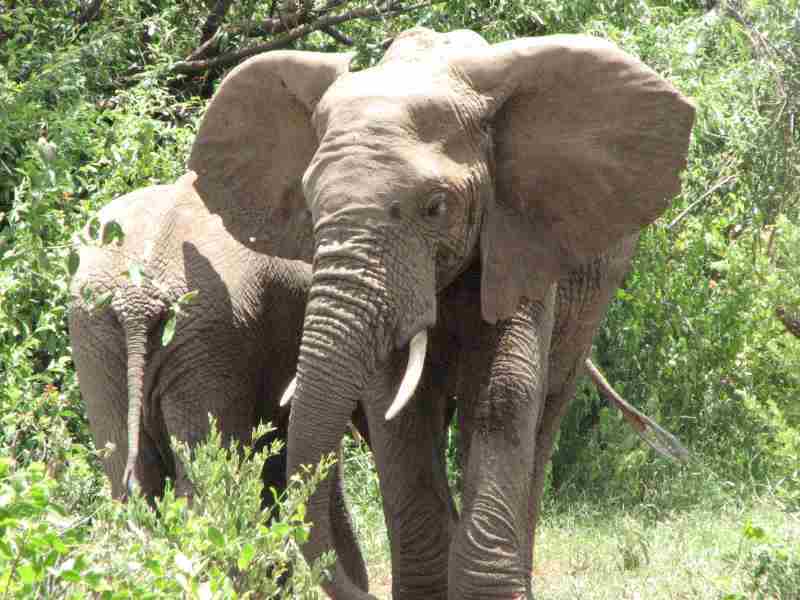
Vervet monkeys playing in the wild

A happy family of baboons
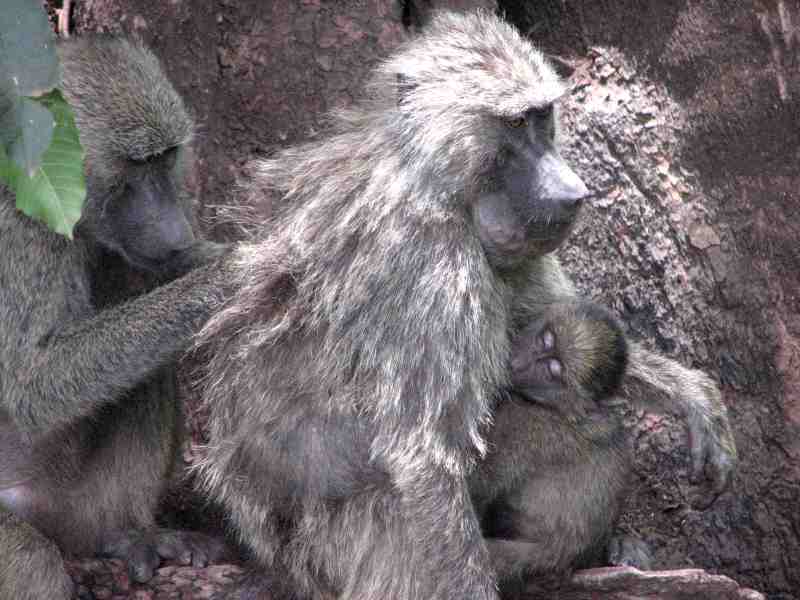
Manyara National Park was jam packed with elephants

Number 2 in our Big 5 sightings, the buffalo
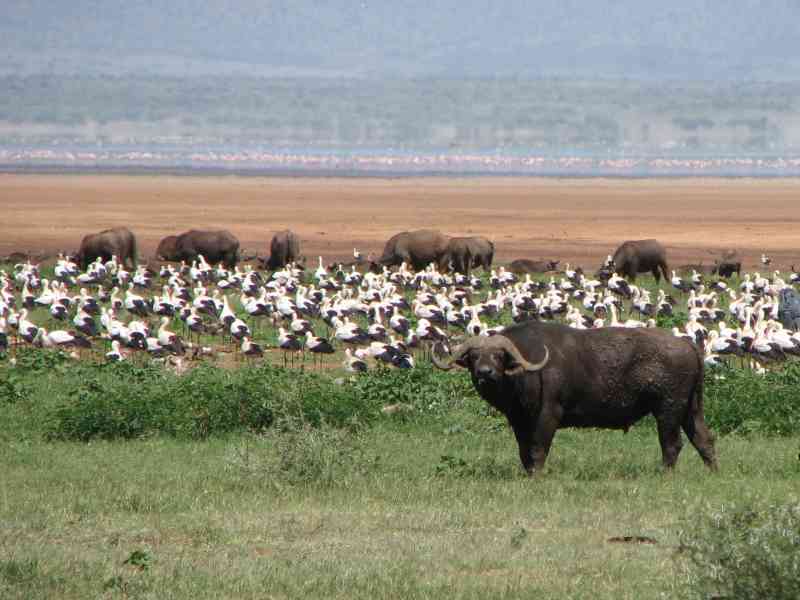
This could have been a statue as it didn't move the whole time we were in the area
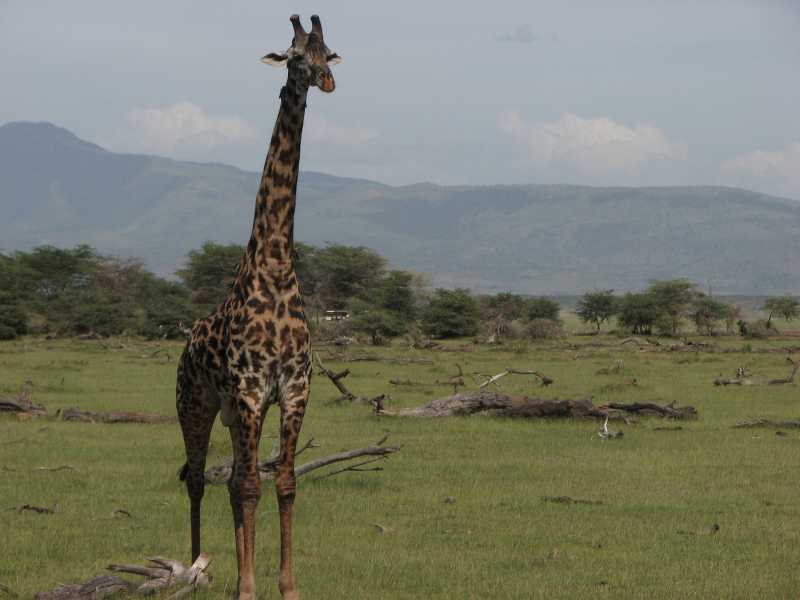
The Bougainvillea Lodge was a real treat after a dusty day in the truck. Flowers lined the pathways to our private bungalow, one of the nicest rooms we've stayed in on this trip. A few local students gave a great acrobatics presentation in the courtyard, but the fire-eating may have been a little over the top. Meals were delicious, just what we needed for the stressful job of 'safariing'. Breakfasts in Africa always included fresh fruits such as mango, papaya, pineapple, passion- fruit and watermelon. What a treat!
Karibu to luxury accommodations! (Karibu means "welcome" in Swahili)
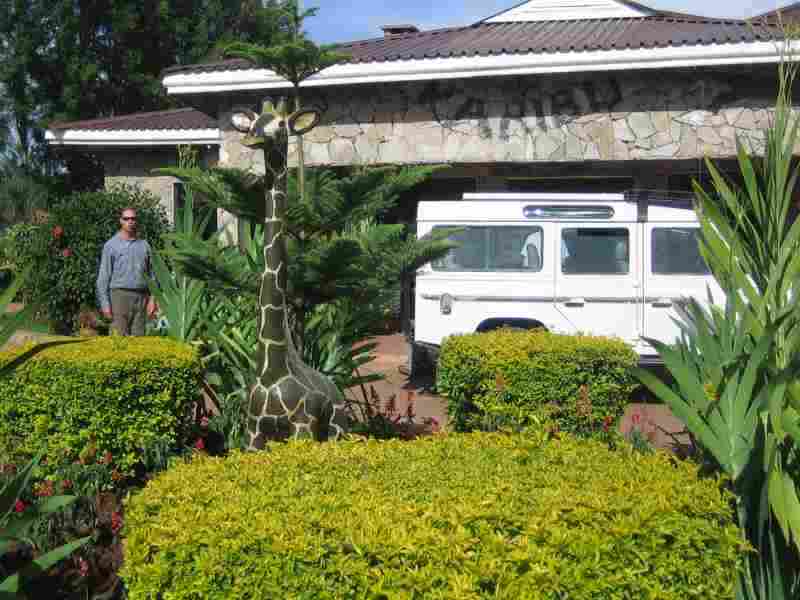
Next stop: Ngorongoro Crater. The crater is really a volcanic caldera, the sixth largest in the world covering an area of 330 square kilometres. From up on the crater rim, it looked like a vast, round green and blue plain enclosed within the sheer, vertical hillside. We'd heard that it was a veritable sea of animals because they had everything they needed down there and didn't need to migrate to greener pastures. As we looked down into the crater, we were a little disappointed at not seeing any animals. Then we realized that the crater was so deep, 600 metres deep, that any animals would look like little ants to us. If you squinted, you could kind of see a herd of something down there, and we were anxious to have a closer look. Maasai villages of mud and thatch huts lined our route, quite a contrast to an exclusive hotel situated on the edge of the crater rim. The Maasai, all traditionally dressed in red shookas, were still allowed to pasture their cattle in the area. A steep, bumpy road took us down, down, down, and then, suddenly, it was like that scene in Jurassic Park where a plethora of dinosaurs of all shapes and sizes could be seen in every direction. Welcome to Jurassic Park. I mean, Ngorongoro Crater. Herds of buffalo grazed and wildebeests wandered with their new calves by their sides. Warthogs big and small trotted around the plain as young zebras cavorted about. Pairs of ostriches stepped carefully through the long grasses, and impalas leapt gracefully along. Pink flamingos strutted, brown-crested cranes strolled, and dik-diks skittered. And then we saw a rhino. Thank goodness he was just lying in the grass because I was running out of animal verbs. The truck got very close, about 20 metres away, and the black rhino just ignored us and got on with his napping. Off in the distance, a more rambunctious rhino wandered about but at that point, Will saw something else moving in the grass...a lion! It was a large male, with a huge mane, and we were sorry that we weren't closer so that we could see what he was up to.
Maasai huts

Ekke looks for herds of wild animals inside the caldera

A sea of wild animals: Welcome to Ngorongoro Crater!

Motorcycle travellers Ekke andAudrey join newlyweds Christine and Will on the Amazing Race

Not one of the Big 5 but awfully cute
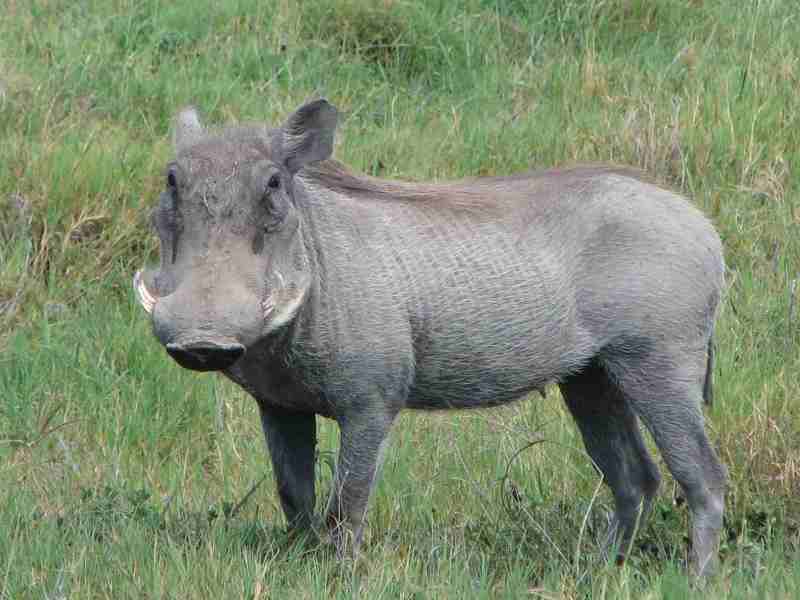
Brown crested cranes; sporting the original mohawk hairdo

Pink flamingos, zebra, wildebeest, jackals, oh my
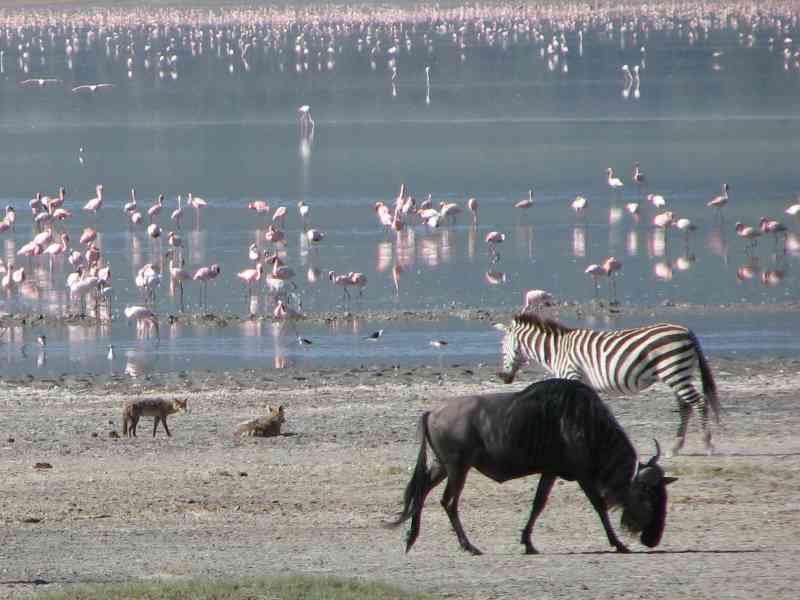
Hartebeest
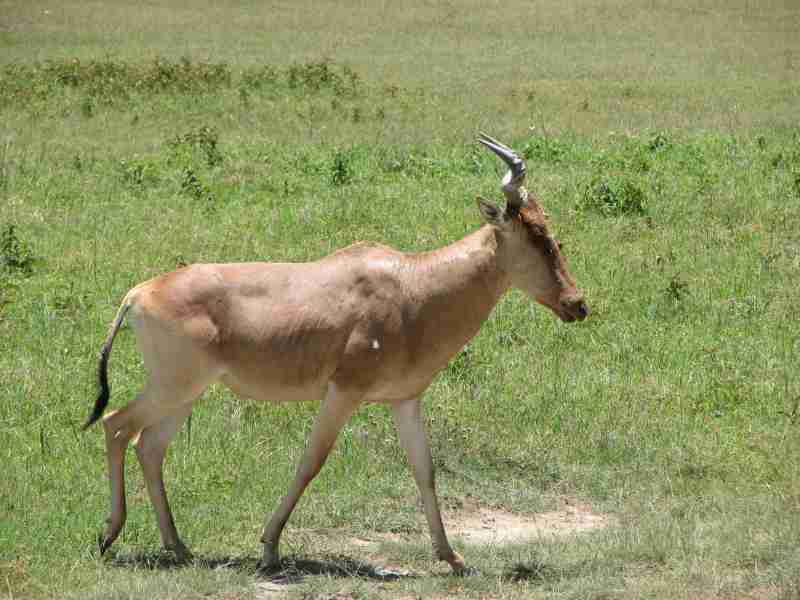
Giraffes were everywhere
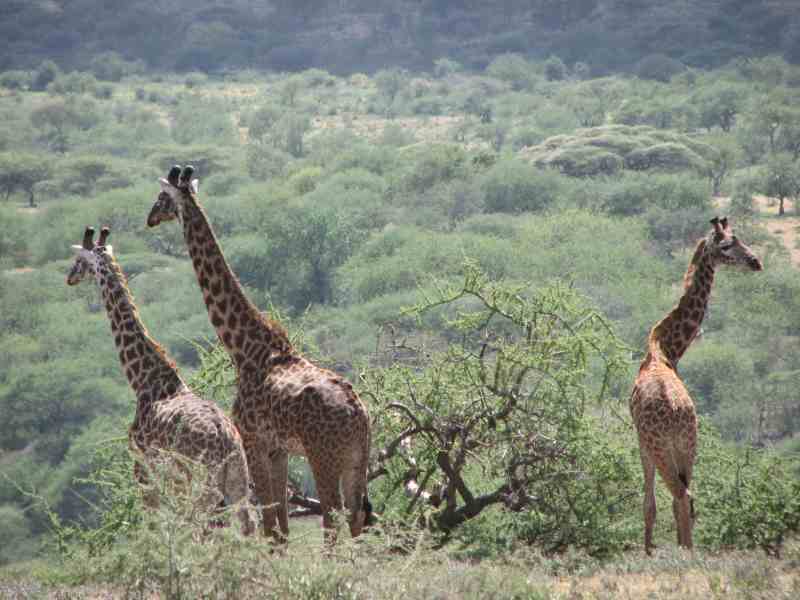
A hippopotamus on land during the day, don't get between it and the water!
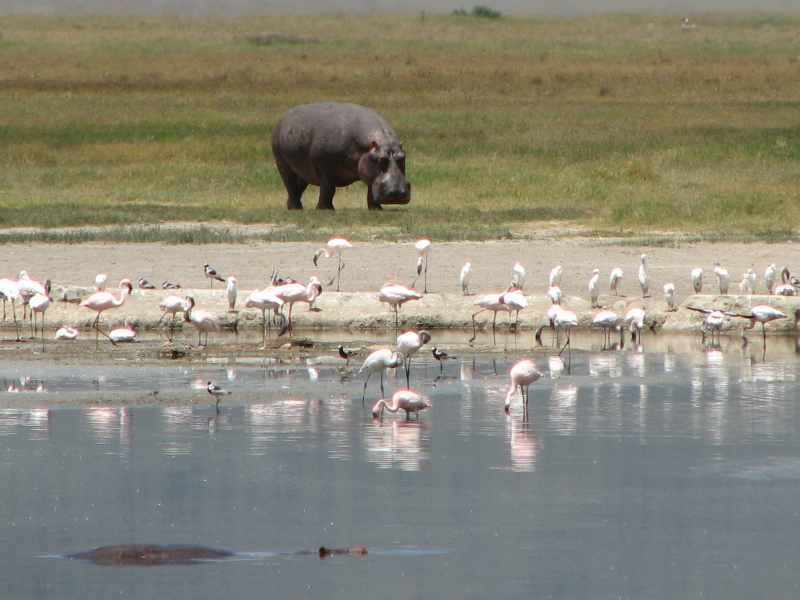
A male ostrich strutting about
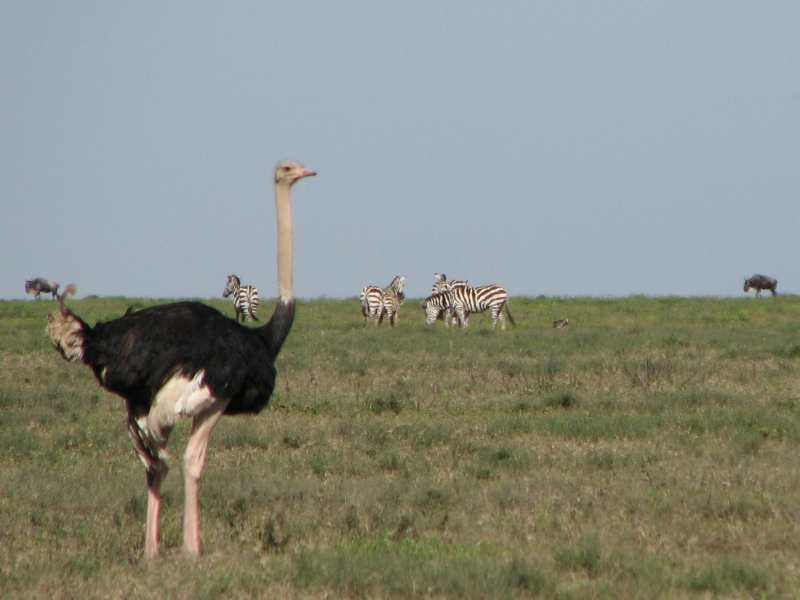
Zebra foals were feisty on the crater floor

Snoozing rhinoceros (Number 3 on our list of the Big 5)
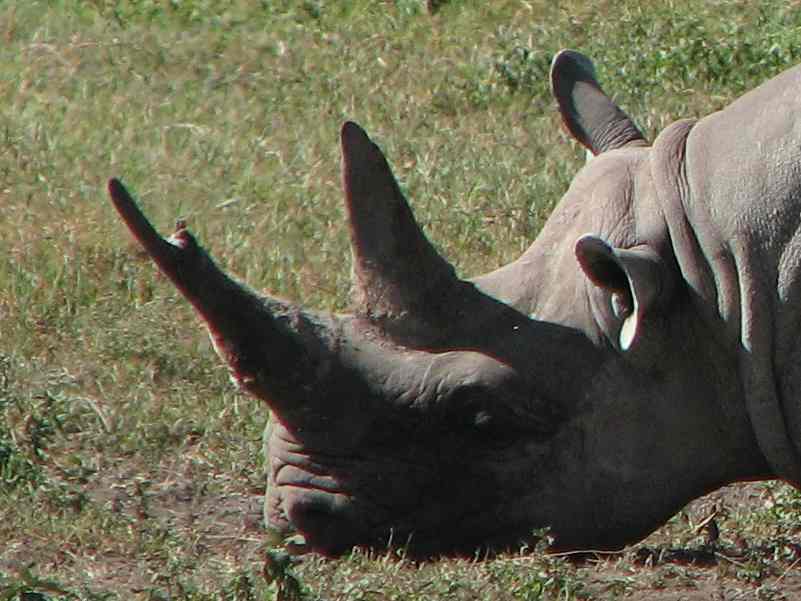
Another truck drove up. Three faces peeked out from the pop-up roof: Tom, Matteo and Vesehl! We had actually met them at the Ngorongoro gate earlier in the day. They said that they had all successfully climbed Kili, and we were quite happy for them. Anyway, our truck was just pulling away and I pointed towards the grass and called out, "Lion!". Matteo pointed towards the plain and called out, "Cheetah!" so we took photos of each others' trucks and off we went. Further along, lying in the grass, looking for some lunch, was a cheetah! The binoculars were quite useful here, as it was a few hundred metres away, and not moving much. An unlucky gazelle looked to be a likely target, but the cheetah just bided his time, sitting patiently in the grass as we drove away. Later we saw a lion just lying in the grass, and then a pair of them, and then three of them. I think it was afternoon snooze time.
The real wildlife
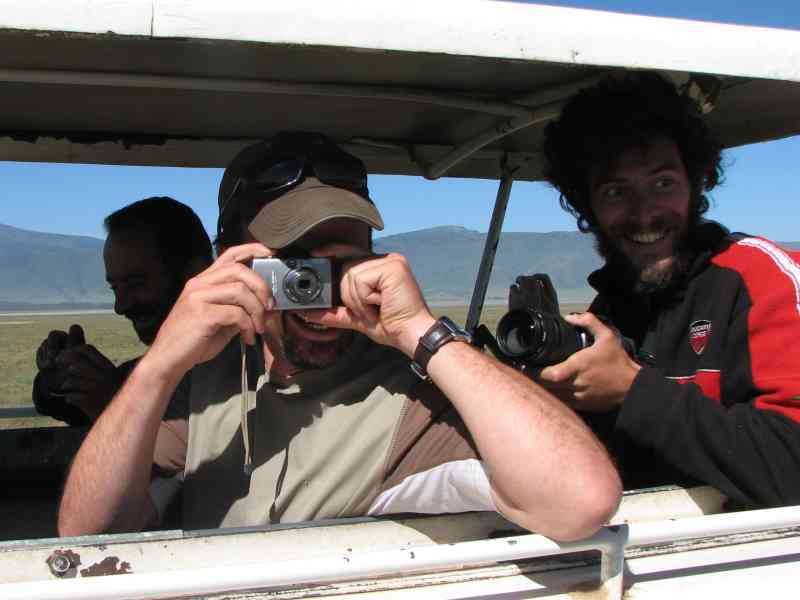
I didn't know how I'd feel if I had the opportunity to see a 'kill', but I did know that I wouldn't want to actively search one out. However, we did just happen upon an unfortunate zebra who was the recent victim of a successful lion hunt. We knew the hunters were lions because we saw two of them lying in the trees nearby, exhausted. There were about fifteen safari vehicles surrounding the poor zebra. I won't get too graphic as this is a family website, but let's just say that we now know what the inside of a zebra looks like. As we stared in a sort of morbid fascination, we were quite stunned to see a lioness step out of the trees and walk tentatively over to the zebra. She sniffed around the zebra a bit. I don't think she appreciated her audience, us, so she actually grabbed the zebra by the neck, shook it a bit, and tried to drag the beast away. She managed to move it about half a metre but the weight of the zebra was too much for her, and she eventually wandered off possibly looking for reinforcements to help out. Vultures and spotted hyenas both circled the site, but we drove away at that point, having had enough drama for one day.
The vultures are circling

The tourists arrive
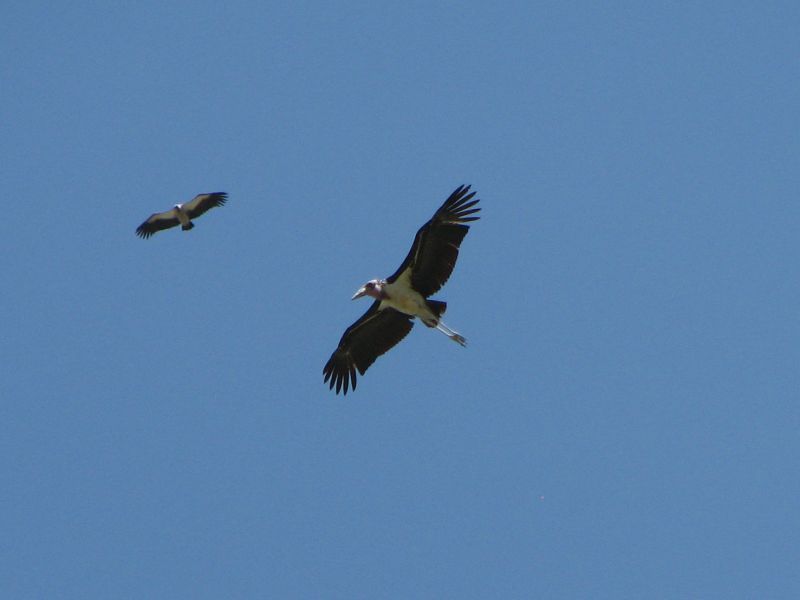
A hyena looking for a free lunch

The lioness tries to drag away her kill (The lion is number 4 of the Big 5)
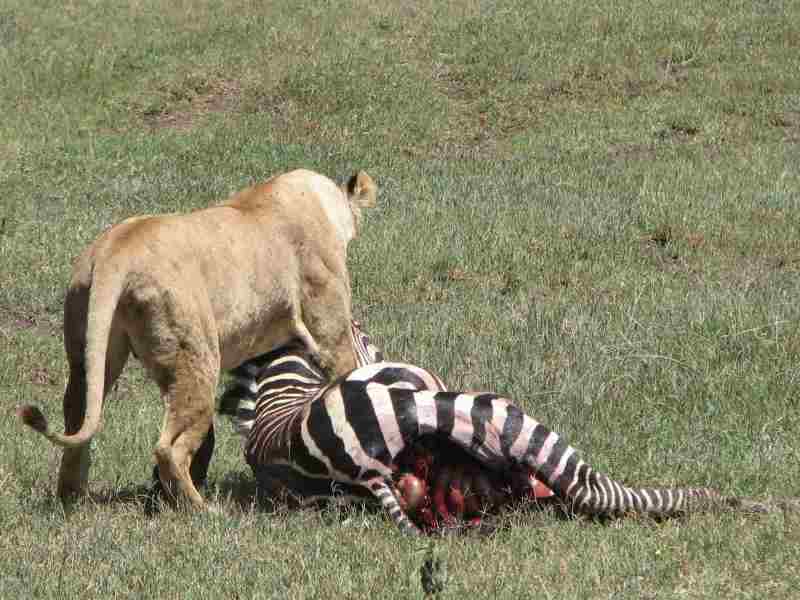
But the drama just went on and on all day long. At our lunch spot on the rim, both Ekke and Christine had accidentally stepped into the long grass and came out with their legs burning. The sting of the stinging nettles didn't last very long but from their expressions, it looked quite painful. Later, we bounced along in the Land Rover on a very rough road in the direction of Serengeti National Park. Finally we reached the edge of the Serengeti. Boniface didn't take the main road, but a side one that led us to thousands of wildebeest migrating from the Serengeti to Masai Mara in Kenya. These beasts seemed to be in quite a hurry, running the whole time. Maybe the grass was greener over in Kenya. In season, it would be millions migrating and I'll bet that would be quite a sight. As it was, February was birthing time, and most females had a little tan-coloured baby wildebeest struggling to keep up with them during the migration.
Run baby, run!

Boniface spied something in the grass as we drove along the Serengeti plain, and next thing we knew we were face to face with a pair of young male lions, sitting beside a wildebeest carcass. They looked quite contented and barely moved, even as the truck got within a few metres of them. Just when we thought we'd seen everything, Boniface spotted something else in the grass... Cheetahs! Three of them, just sitting in the sun, their faces pink from whatever they were just eating. Again, we could get quite close, and they didn't seem to care that a truck was sitting just a few metres away. We could have just sat there and watched for ages but eventually, we had to move on. What an amazing day. The only thing missing was Christine's leopard. So, you have probably already guessed what happened next. We saw a leopard! And not just any leopard, but a leopard in a tree! So, that was that. We saw the 'Big 5', all in one day.
Serengeti means "endless spaces" in Swahili. Sounds like Saskatchewan doesn't it?

Agama basking on a kopje
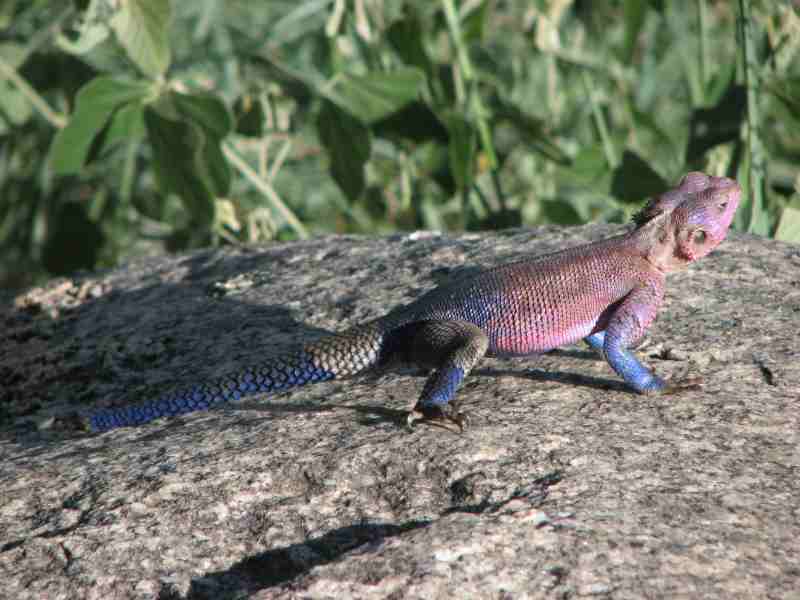
Two brothers resting beside their wildebeest while vultures wait patiently

Cheetahs resting in the heat of the day
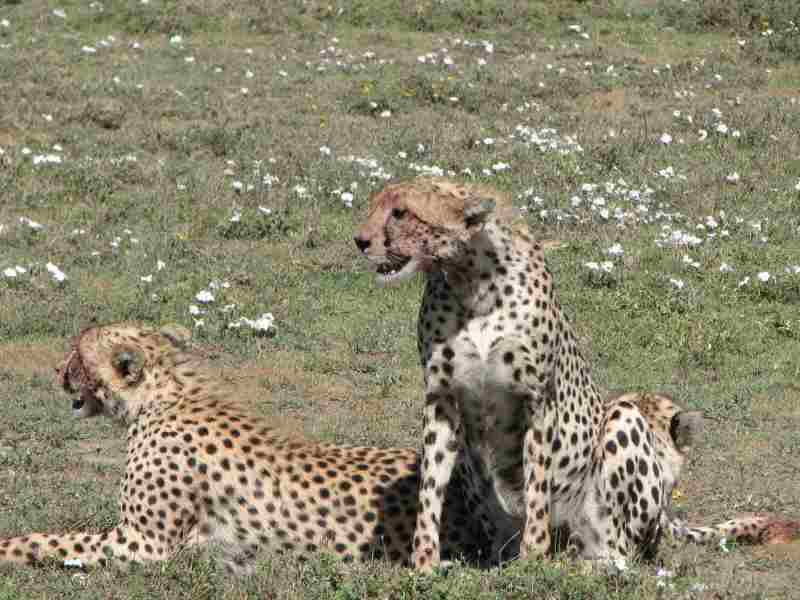

Our Big 5 list is completed in one day: a leopard resting in a tree
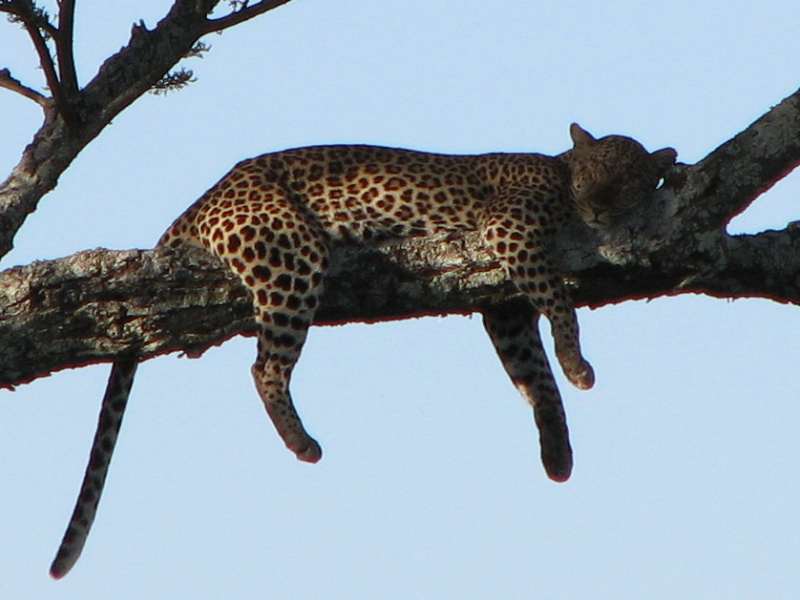
Park regulations required us to stop safariing by the time darkness fell, about 6:30 p.m. We still had a bit of a drive ahead of us to get to Ikoma Tented Lodge when Boniface turned around in his seat and said, "Do you still want to stop at the balloon place?" Being dusty, hot, tired and overwhelmed with wildlife, I just wanted to get to a warm shower, so I piped up, "No, let's not stop". But Ekke overruled me, saying "Yes, could we please stop." And I kind of clued in that someone was going to get a surprise balloon safari. Since the next day was my birthday, I not-so-quickly put two and two together, and realized what was going on. I was going on a balloon safari over the Serengeti!
We were woken by lodge staff at 3:53 a.m. This wasn't as bad as being woken at 3:52 a.m., as were Will and Christine when someone thought they were going on a balloon safari, which they weren't. Anyway, we had to be up quite early because apparently the sunrise looks nice from a balloon over the Serengeti. At 3:53 it didn't really seem to matter, but we got out of bed anyway. Boniface was ready to drive us to the launch site, but first we had to pay off a park warden so that we could drive through the park in the dark. The $20 was supposed to be paid so that the warden could ride with us and make sure that we didn't run over any wildlife in the dark. Since the park was short-staffed they let us drive without the warden, but we still had to pay him the 20 bucks. There was no receipt because it was not an official park fee. So, we paid up, the warden opened the gate for us, and we just shook our heads. Africa!
One of our favourite animal sightings happened on that drive. The headlights caught three shapes moving on the road in front of us. Bat-eared foxes! They were the cutest little foxes, but what we loved was their behaviour. They skittered across the road, their paths criss-crossing each other as if creating a diversion for predators. Every now and again one would stop, look back at us, and continue criss-crossing. This happened several times and they just wouldn't get off the road until Boniface turned the headlights off. Two of them leapt into the bushes, and it took a second or two before the last one realized he was on his own before he took off as well.
The balloon launch site was out on a beautiful grassy plain. The sun was just coming up, and a column of volcanic ash rose from the Oldolroingi Volcano off in the distance. Two balloons were to go that morning, and ours contained a film crew shooting a commercial for Celtel (a phone company). That left just six of us regular clients, a nice small group as usually the balloon basket could hold 22, one of the biggest in the world. Well, I was about to get a balloon ride over the Serengeti and I thought that would be about the best thing that would happen to me all day. But it turns out that meeting our pilot, Nigel, was definitely a highlight, with his stories, jokes, and travel adventures. His instructions for getting into the basket, all related in his distinct English accent, were as funny as a Monty Python sketch. Instructions were necessary because the huge basket lay on its side for loading and then tilted up as the balloon filled with hot air. There were eight little compartments, and on the signal, we had to climb in and lie flat on our backs on a sort of bench seat. If you've ever dreamed of being an astronaut, you should probably try this first before you commit. We lay there on our backs, listening to and watching the burners fire. I'm sure I heard a NASA style countdown, but maybe it was just my imagination as the balloon started to lift. I could feel the heat from the burner on the top of my head and wished I would have brought my teflon hat. A gust of wind suddenly came up and pulled the balloon in different directions. The basket was attached to a Land Rover by a rope to hold it stable while it was being filled, and the wind was so strong that it was pulling the Land Rover! I think it was at this point that Nigel decided to abort the mission, stop the 'burn', and wait for the wind to go down. Safety first. We like that.
Early morning launch
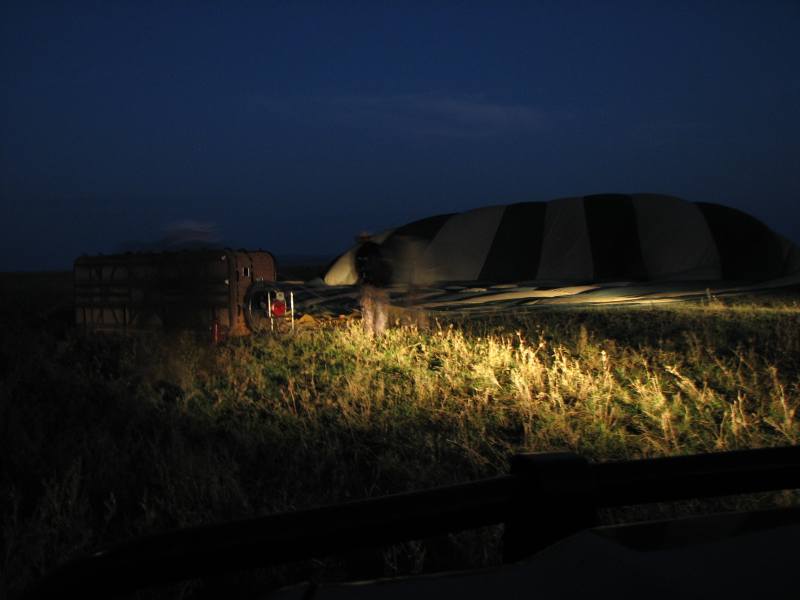
Inflating the balloon while Captain Nigel gives Audrey a pep talk
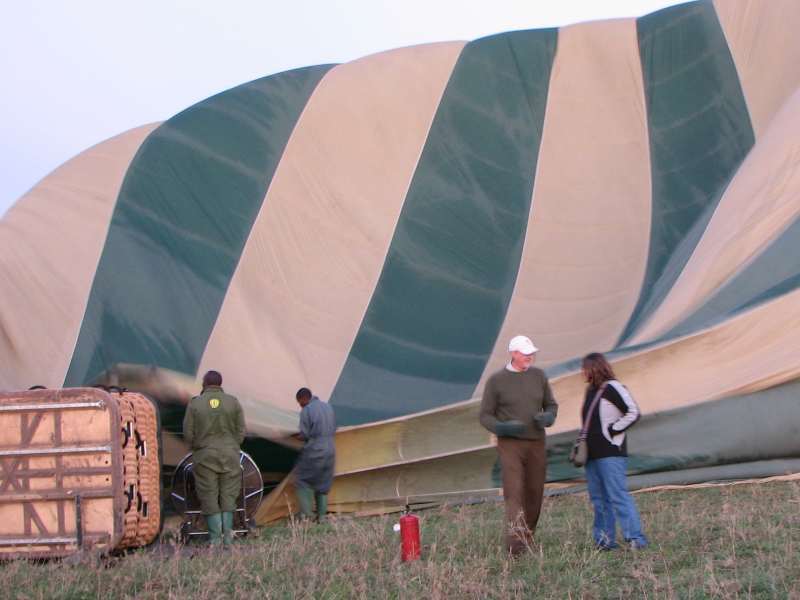
The other balloon had managed to take off just before the gusting, but soon the wind died down and Nigel gave it another try. The balloon filled easily with hot air, tugged at the basket and gently lifted it upright and off the ground. Soon, we were gliding a few metres above the Serengeti plain! It was magical. Nigel kept it low at first because the winds were much faster higher up. We climbed a bit higher, and Ekke said he felt none of the vertigo that he usually felt in tall buildings. The only sounds were the gentle breeze, the squeak of the ropes, the flap of the balloon fabric, and Nigel telling funny tales in between the hisses of the burner. Oh, and one of the cameramen kept spotting lions. We'd look through the binoculars to where he was pointing. Nope, that's a warthog. Then, he saw another lion, this one stalking a warthog. No, another warthog, following a warthog. He did spot an elephant that was really an elephant, though. Animals looked different from up there, and we could more or less sneak up on them and watch them, with only an occasional burner hiss to warn them. A mother giraffe and baby wandered through the tall grasses so gracefully that they looked like they were in slow motion. A small herd of gazelles just went on with their grazing, oblivious to the audience high above them. A jackal sniffed around, looking for breakfast. After about an hour of floating seamlessly above the earth, it was time to come down to get some breakfast of our own. Nigel had a bit of excitement planned for us on the descent. The basket skimmed the tops of a couple of tall thorn trees. Nigel explained, "That's the way we clean the bottom of the basket". He also said that when landing, the termite mounds had a nasty habit of jumping out in front of the basket at the last moment. Well for us it was a small tree. Just as the basket tilted on its side, the landing position, he said that a tree was on our left side, and that we were going to hit it. Three, two, one, and sure enough a tree jumped in front of our path. We heard the scraping on the basket, no harm done, as far as we know. Maybe landing safely called for champagne, because before we knew it, a glass full of the bubbly stuff was in our hands, all before 9:00 in the morning. Nigel kept saying that he loved coming to work each day, and I was beginning to believe him. The breakfast confirmed it. We drove to some nearby kopjes, small rocky hills, where tables were set with linen, china and silver. Nigel sat down with us to a lovely full English breakfast. He managed to convince us that he was envious of our motorcycle adventures, being a fellow motorcycle enthusiast himself. He related a few tales of his exciting life, and all the places he'd travelled to and ballooned in: Kathmandu, Australia, Calgary - no, really, Calgary! He then handed out our official balloon certificates, saying that we were now qualified to fly balloons anywhere in the world, except Tanzania. After a quick, and surprisingly embarrassing, round of "Happy Birthday" from the staff, we were driven back to the Serenera Hotel where Boniface was waiting to take us on a game drive. And then we saw a leopard. In a tree. Eating a gazelle. Will the fun just never end?!
Up, up and away!
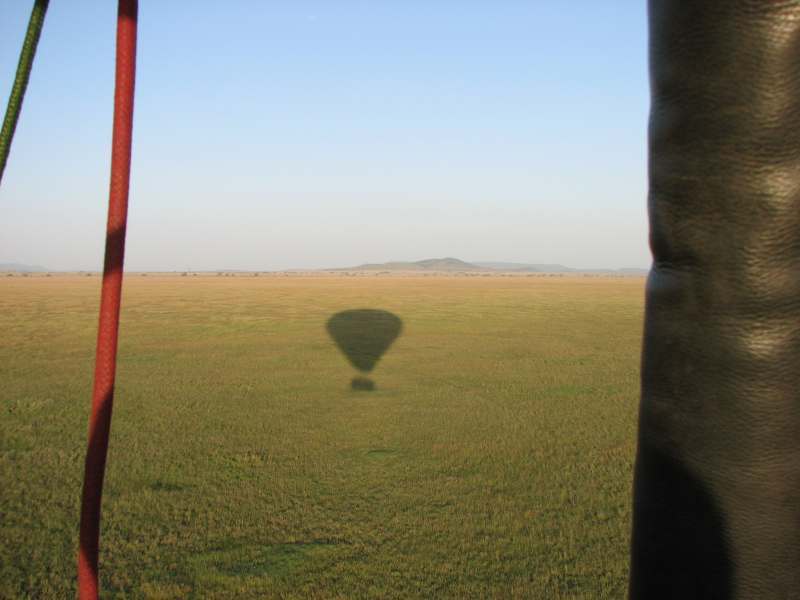
Happy balloon-o-nauts

The first balloon preparing for a landing
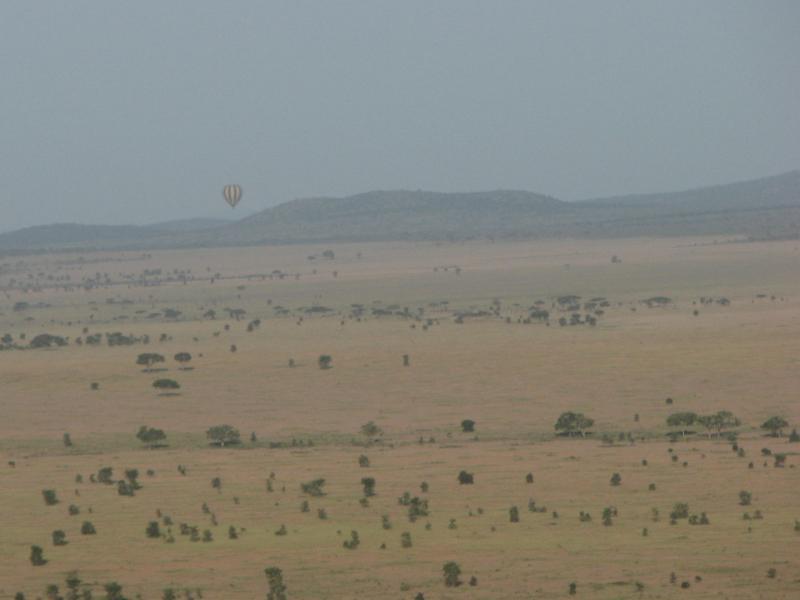
Way up above the giraffes

Audrey waits for Nigel to pop the cork on the breakfast champagne

Fine dining on the savannah
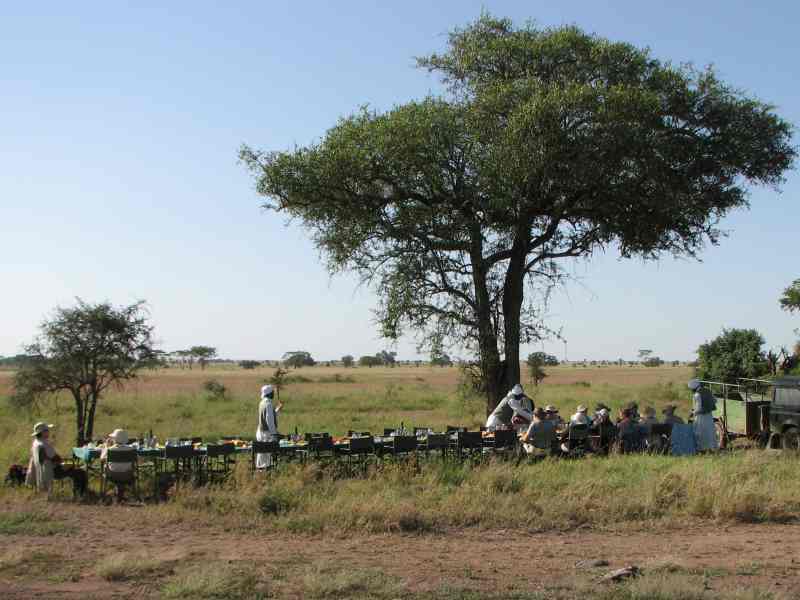
We haven't eaten like this since the Cotswolds (See the England chapter)
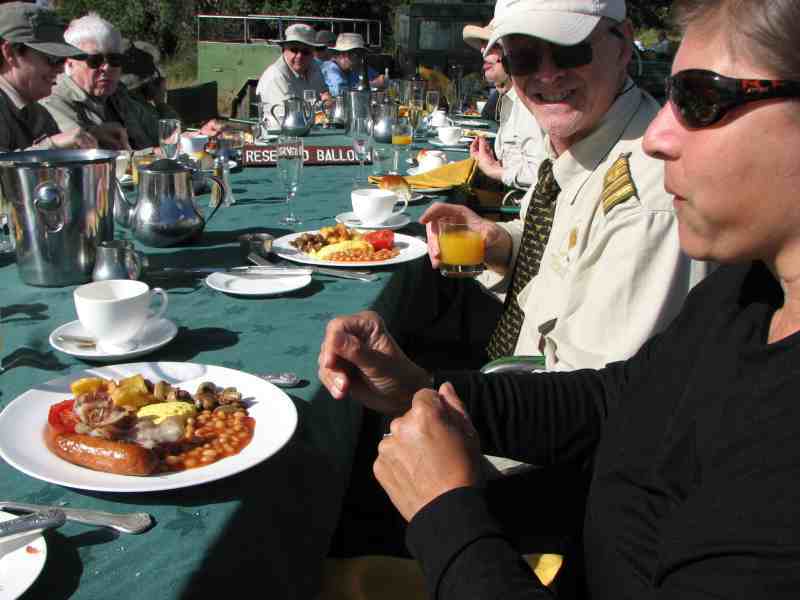
The yellow footed Topi in the wild
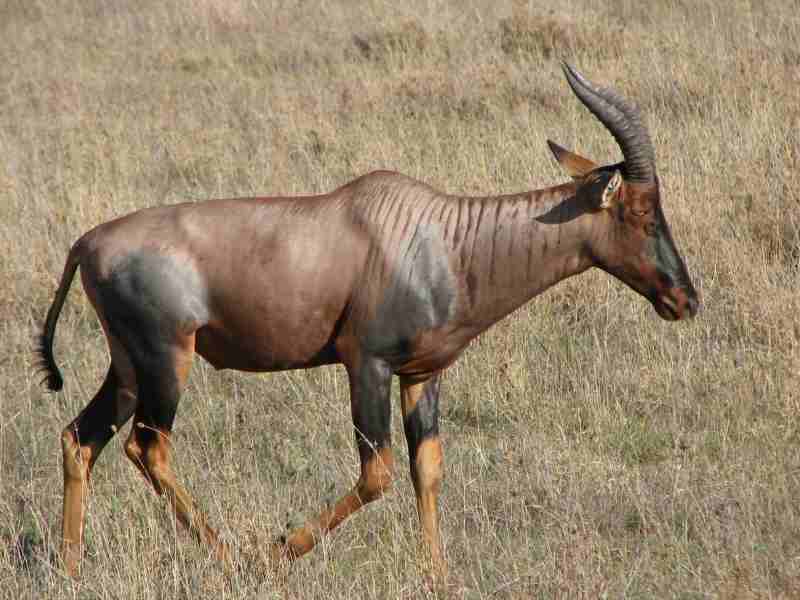
A huge hippo pool (5 points for spotting the crocodile!)
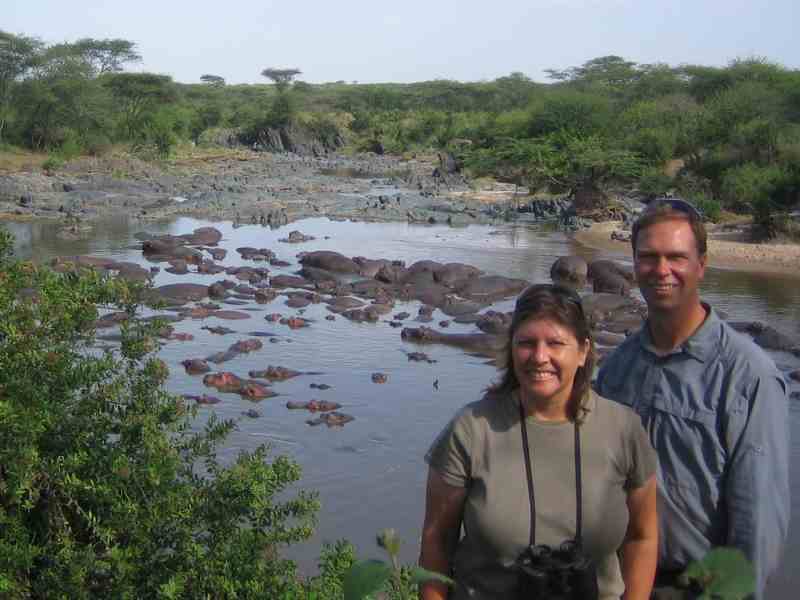
What a cute little baby

A classic Serengeti scene
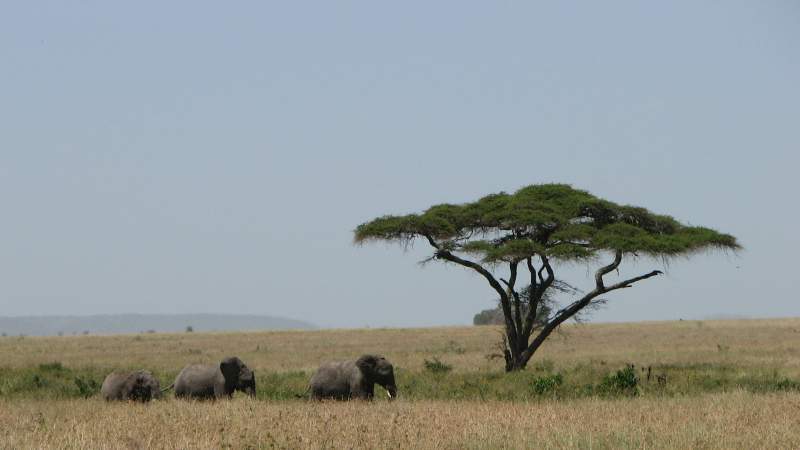
After our private game drive, we made it back to Ikoma Tented Lodge. The huge tents were like hotel rooms, with a private bathroom all done in concrete a la Flintstones. A young, local tribesman, armed with a bow and arrow, escorted us around the place - to the restaurant, to the reception building, and on our guided game hike with Will and Christine. The hike produced little in the way of game, but we did see some local flora, such as aloe vera, prickly pear cactus with fruit and flowers, and acacia trees. The hike up the hill provided views of the Ikoma tribal pastoral lands where they grazed cattle. Our tribal security guard shot an arrow for us, which easily flew 200 metres. He wouldn't let any of us try it, though. Supper was a buffet, and Stanley had arranged cake and champagne for my big day. How thoughtful! It wasn't the Black Forest cake of my younger days, but it wasn't half bad, out there on the Serengeti.
Civilised camping at the Ikoma Tented Lodge
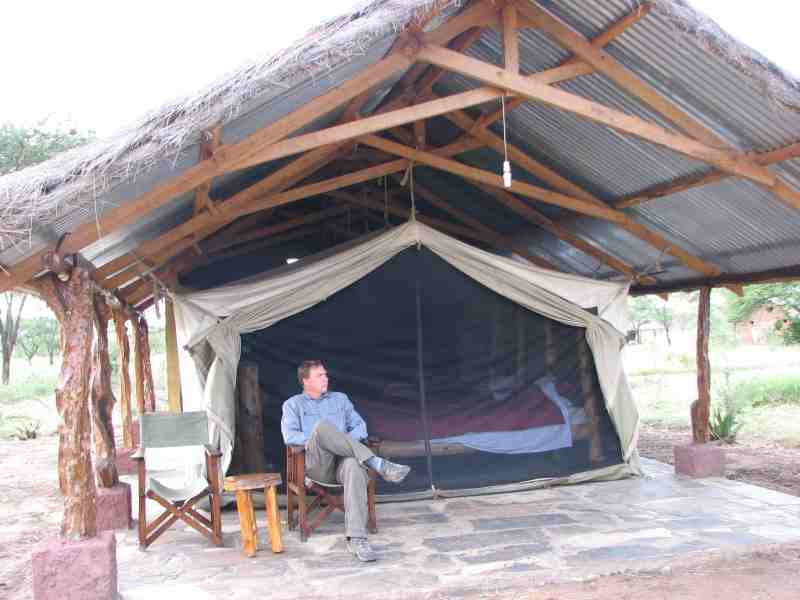
Our third type of safari in one day, first ballooning then driving and now walking
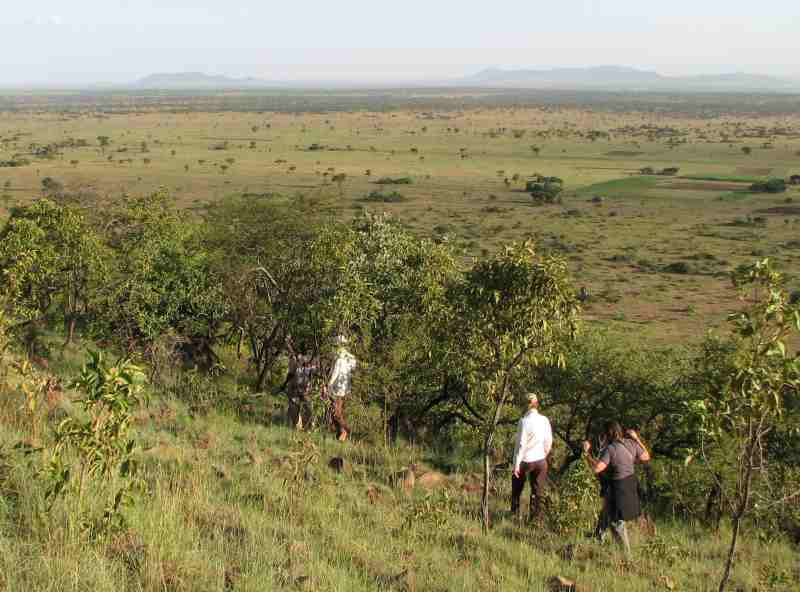
Prickly pear cactus
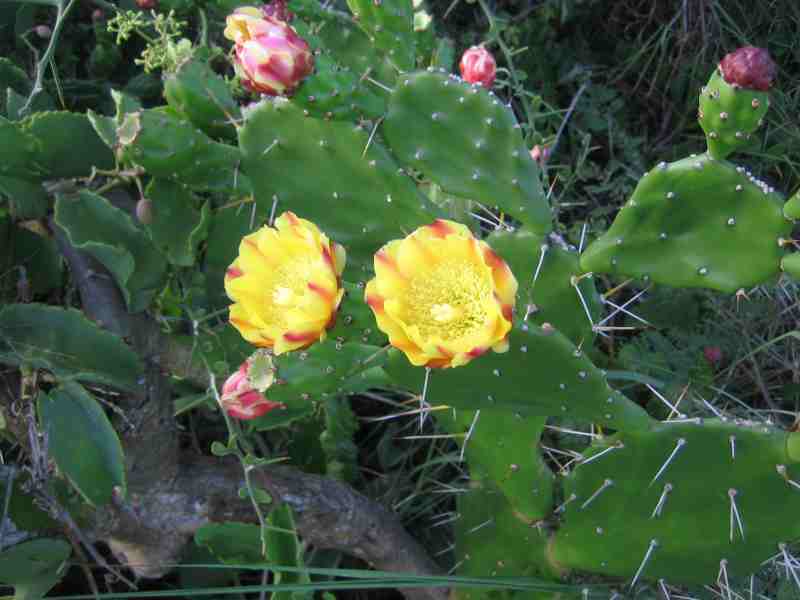
Sunset over the Serengeti
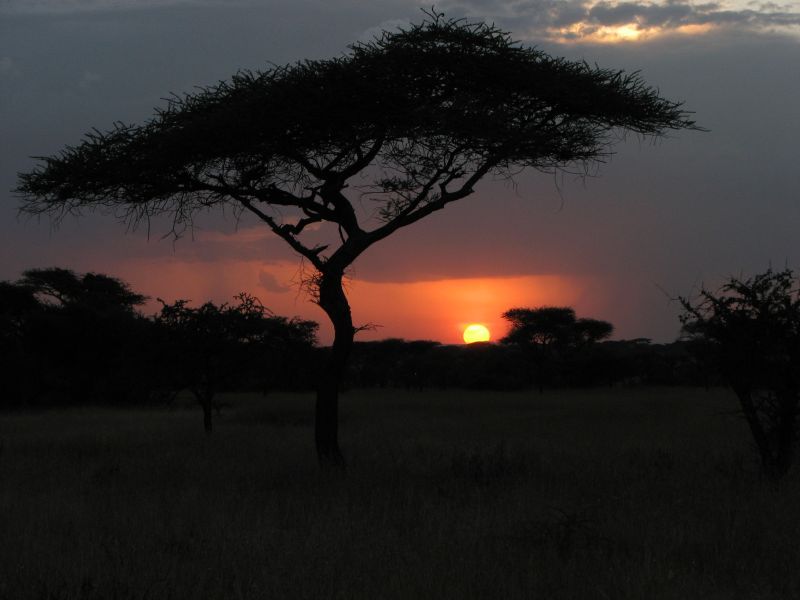
Happy birthday!

Just one more stop on the way back to Arusha, at Olduvai Gorge. This is where the Leakey's found the oldest (at the time) skull fragments of hominids, and is what many still refer to as the 'cradle of humanity'. While eating our delicious boxed-lunch, we looked out over the gorge as a local guide gave a talk about the site. This was a good place to look for fossils because the lake attracted animals from far and wide and layers of volcanic deposits preserved them. One layer revealed Australopithecus Boisei, 1.8 million years old, known as 'Nutcracker Man' because of the large molars. The upper layers revealed Homo Sapiens, or modern humans, 100 000 years old. Hominid footprints that were 3.7 million years old were found further up the gorge. It was quite interesting to look down into that gorge, wondering what else the layers would reveal. A museum housed some of the hominid bones and a replica of the footprints. It made me think of the French anthropologist and team I had met in southern Ethiopia. They were heading to the Lake Turkana area for a few weeks to excavate Australopithecus Afarensis. Hominid bone fragments over four million years old had been found there! Maybe we'll see their finds in the next issue of National Geographic.
Flying warthogs!

Oldupai Gorge (misnamed Olduvai by a European explorer)

A flat tire on the way back was almost inevitable considering the rough roads with sharp, volcanic rock. Boniface changed it quickly, and we were on our way. More ash blew out of the volcano, now a hundred kiliometres in the distance, and gave the whole area a dusty appearance. Mt. Meru was beautiful in the late-day sun as we neared Arusha, and the end of our safari. Ekke gave Magda one last ride on the bike, to the airport the next day. She didn't have her wooden giraffe, however, thinking it more practical to mail it. I think it would have made a great picture, however, sitting on the back of a BMW.
Changing a flat tire while a volcano erupts. No pressure Boniface!
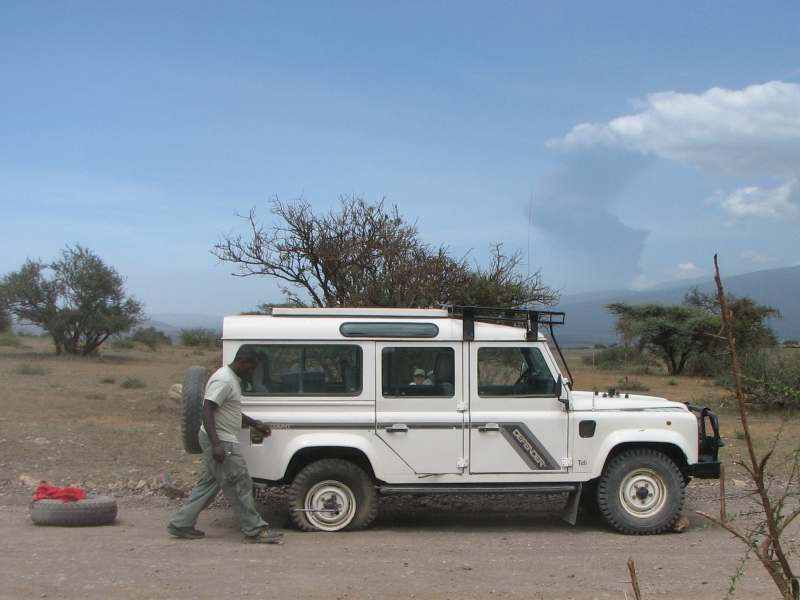
Mom gets a ride to the airport
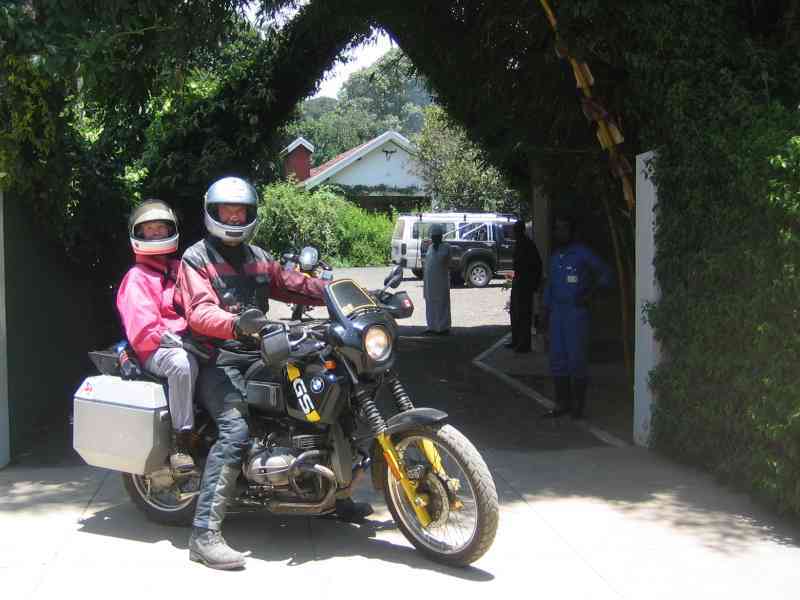
Safari route
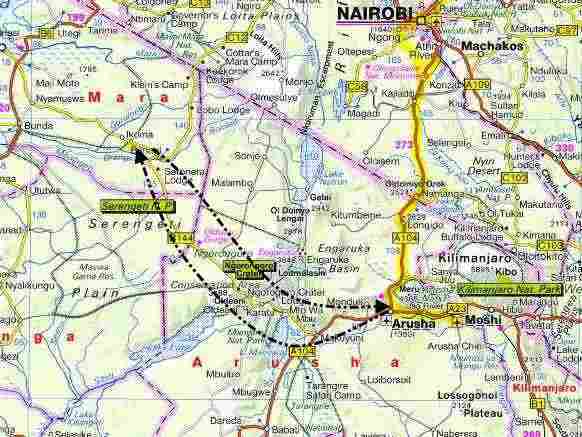
The motorcycles were calling once again. Hiking Kilimanjaro and safariing had taken a couple of weeks, and it was time to continue our ride down Africa. Ekke and I had just read 'Long Way Down' by Ewan McGregor and Charley Boorman. If you've not yet read it or seen the mini-series, it's a great story describing their ride on BMW motorcycles from John O'Groats, Scotland to Capetown. The fun part for us was that they often took a very similar route to ours so we had a lot to relate to as we read it. They took the same ferry down from Egypt into Sudan, and even described the cabin they stayed in - across from the washroom, the one with no lock on the door. Our cabin was across from the washroom, the one with no lock on the door! They broke shocks on roads in Sudan and Kenya, so we were quite lucky that Ekke lost his steering head nut, forcing us to go quite slowly and therefore breaking no shocks. They have some great descriptions of the landscape, people and cultures that we could just, in terms of our trip, say "ditto" to. And yes, even Ewan McGregor got rocks thrown at him in Ethiopia.
After a final night at the Ilboru Safari Lodge, we thought we'd just upload the Kenya chapter of the website in the morning and then be on our way. No such luck. The wireless internet at the hotel kept cutting in and out. It would show some promise for a while, just enough to keep us trying again and four hours later, the task was finally complete. Being all packed up, we didn't want to stay there another night, but we really wanted to see Kilimanjaro in the morning light, so we didn't want to leave right then either. So, after running a few errands in Arusha, we went to Maasai Camp, just out of town. Big mistake. Unless you like listening to the campground bar going until 4:00 a.m. It was mostly locals enjoying their Friday night, at the expense of a few campers trying to get some sleep. Never again!
Doing a morning ride past Mt. Kilimanjaro really paid off. Clouds did not yet cover the entire top, but as we got closer and into better photo-taking position, the clouds rolled in. But it was great to see Uhuru Peak one last time and relive the fond memories of the hike. The tarmac was good as we rode past small towns consisting mostly of mud-brick or wooden shacks, in the direction of Dar es Salaam. The straight roads soon turned into twisties as we approached the Usumburu Mountains further east. We could have been riding through Chilliwack in southern British Columbia, Canada, with the wide agricultural valley and mountains gently rising up beside it. It was quite hot, as well, and we decided to stop riding in the early afternoon. On the GPS 'Tracks for Africa' program, Ekke located a lodge that had the camping symbol. The place looked promising with its nicely landscaped grounds of palm trees and flowers. There was a face peeking out the door of the restaurant, so we went up and asked about the camping. A couple of girls in the restaurant just looked at us as if we had just walked off a spaceship (we get that a lot), and mouthed a single word..."No". We asked if there were rooms available in the lodge, and again, they just stared and said, "No". The restaurant, food?" No". I started making hand gestures in the shape of a tent, but in the end we just gave up and rode away, past the sign that said "Camping". By now it was getting really hot, especially in the full motorcycle gear. My BMW outfit is probably perfect in its home environment, Germany, but does not really cut it in the heat of Tanzania. Thank goodness we found camping, and you might wonder that we didn't notice there was a bar next door. Great.
One last look at the top of Kilimanjaro

Nice riding south
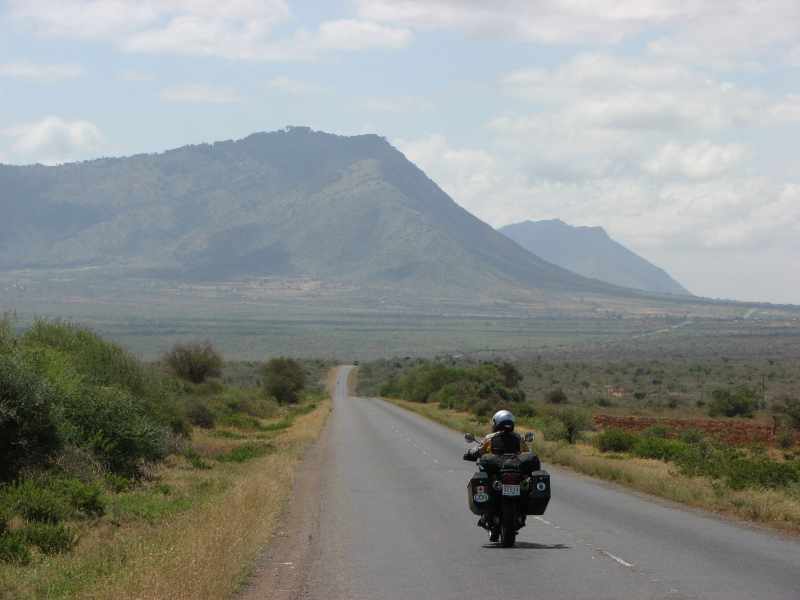
Ekke checking "Tracks for Africa" on the GPS
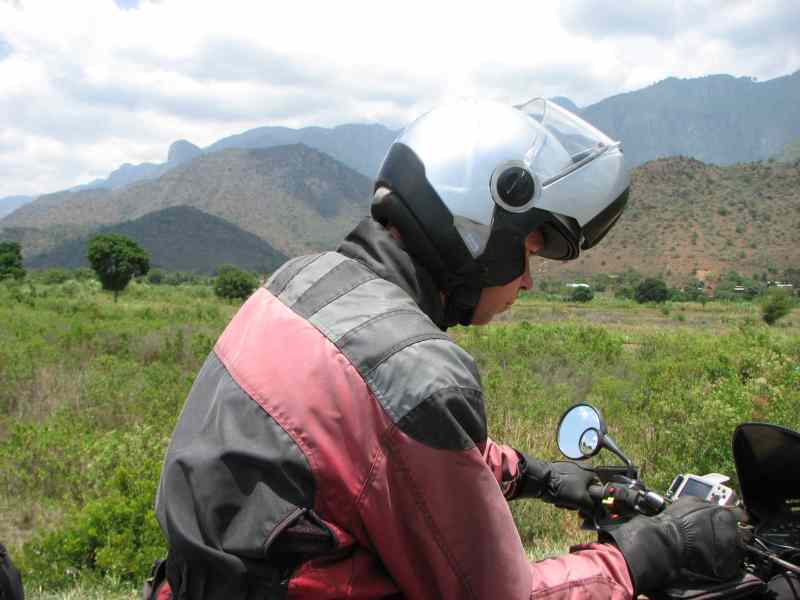
Interesting sculpture at the White Parrot lodge didn't make for a restful sleep

After some intermittent sleep due to the music and some people chatting near our tent, we rode off in the direction of Dar. In every small town, police officers were dressed in white from head to toe and all I could think of was how they'd keep those outfits white, wearing them every day. Later, we saw a few officers in some very fast-moving trucks waving at us. Thinking there was some danger or an accident up ahead, we slowed down a bit. A truck ahead of us had pulled over, so we really wondered what was going on. Further up an officer by the side of the road frantically waved us over. Uh oh. Soon afterwards a convoy of about ten black vehicles roared by, travelling right on the centre line at high speed. The officer looked like he was going to blow a gasket and immediately tore into us. Apparently we were supposed to have stopped when the officers waved at us. We needed to be more 'observant'. We should take a look around us. We should have more respect when the president is driving by. We could sense a big honking ticket was coming our way. And the guy just went on and on, obviously on some sort of power trip. This got both Ekke and I a little hot under the collar, and we explained that the people in trucks were waving at us as a warning or something, not signalling us to stop. Again we were told that we weren't observant and should know that they wanted us to pull over and stop. We said that the signal for 'stop' was to put a hand up in the air, like this. Luckily, at that moment a huge truck drove up, giving me the opportunity to step in front of it and demonstrate the 'stop' signal with my hand. Luckily, the truck stopped, and I had made my point. "See? That's the signal for stop". After a bit more back and forth, Ekke was required to show our carnets and had to unpack half his bike to get at our paperwork. We decided that enough was enough. I took down the officer's badge number and suggested that I was going to write a letter to someone. Suddenly it was as if a 'niceness' switch had been flicked on. Immediately his demeanour changed and he became 'Mister Congeniality'. He started asking Ekke how many cc's his bike had, where we were from, and generally trying to atone for his previous rudeness. As we left, he was all smiles, and, "Enjoy your trip". I'm sure he was worried about losing his job and nice white uniform because of the way he was treating us tourists.
Dar es Salaam was not so busy on a Sunday afternoon, so it was a fairly easy ride into the ferry port. Ever since Cairo, we were amazed at how easy every other city seemed to be to ride in. Wooden shacks with small shops lined the streets, but further along the city became more modern, with some taller buildings and more 'western' looking shops. Daladalas, or mini-buses, kept things interesting by stopping suddenly and pulling out without any warning. The heat in the city hit us like a brick wall. Dar will always be remembered for its intense heat and humidity. Lonely Planet said that a vehicle ferry left for Zanzibar at noon so we were hoping we could escape the city and just get over there right away. It was 12:15 when we rode into that furnace of a parking lot, helpers of all shapes and sizes running after us. They were there to lead us to a ticket booth and the competition for our attention was fierce as they crowded around the bikes. The booths lined the parking lot, so it was a bit of a shmoz, and someone told us the ferry left at 12:30. Elated, we knew had to move quickly if we were to make it. Ekke found a company that sold tickets for the boat, rode to the nearest ATM for some Tanzanian shillings, paid for a couple of motorcycle tickets, and we were on our way. Okay, it was a bit strange when they sent us through a passenger fence and up onto a sidewalk through a narrow passageway, accompanied by about eight porters. Strange, but we thought that maybe the vehicle ferry entrance had already closed or something. As we rode closer to the waiting ferry, we could see no vehicle ramp, no vehicles of any sort, no vehicle ferry. It was a passenger ferry. All we had to do to get on was ride up the steps, ride down the corrugated ramp, lift the bikes onto a gangplank, and fit them into a little hallway. The captain came out, saying, "Come on, hurry, the boat's leaving". The passengers on the poop deck were calling to us "Hurry, hurry!" Uh... no. Ekke's bike had already fallen over on the sidewalk when his sidestand failed to engage, and I just had visions of him wrecking his other knee and ending up in a Tanzanian hospital. So, we just said it was impossible to get the bikes on, therefore we wouldn't go, and could we please just get our money back. Someone said, "No, no money back". What? We had paid 240 000 shillings ($200) for the tickets, and we wouldn't get it back? To say I went a little ballistic was an understatement. We call this having a 'malarone moment' where we believe our malaria pills cause erratic emotional behaviour. Combined with the effects of the severe heat, those ticket guys just didn't stand a chance. I was going to call the police, sue them, call the tourist board, not come back, tell my friends not to come here, etc, etc. A little extreme, yes, but don't tell me I'm not getting my money back and expect me to walk away. We got the money back. Well, except for the $25 harbour fees, of course, but we had the receipt and would still be able to use it on the vehicle ferry. But, as it turns out, there was no vehicle ferry. So how do vehicles get over to Zanzibar? They attach them to a crane and then hoist them onto a cargo boat. With visions of one or more BMW's dropping into the Indian Ocean, we opted not to try this. So, no motorbikes on Zanzibar for us.
Um, I don't think so...

Feeling tired and defeated, we took a short ferry to the other side of the bay and essentially escaped the hubbub of Dar es Salaam at the Mikadi Beach campground. It was such a welcoming place with a fabulous white-sand beach and palm trees. The bandas, small thatch huts, were right on the beach, so we forked out $20 to stay in one. Our first swim in the Indian Ocean was a delight, the turquoise waters feeling surprisingly warm. The open-air restaurant served up fresh fish and jumbo prawns, and we were so content, we decided to stay an extra day. Young Maasai men, in traditional dress, acted as security guards for the campground. It was fun trying to speak Swahili to Paulo, one of the guards, as he tried out his few English words with us. He laughed at our attempts, especially when we used hand gestures to explain something like 'airplane', 'mountain' or 'Wankel rotary engine'. The first night, Ekke had heard some scratching sounds while we were laying in bed in the banda. The next night, as I went into bed, I noticed there was something lying on the bed. It looked like a crab, but no. It was worse. It was half a crab! Ewwwww! After tossing it out, Ekke and I conjectured as to why it was there, imagining that some small animal had dragged it in. We heard the scratching noises again that night, somewhere in the thatch, and tucked the mosquito net in firmly around the bed. I asked Joe, the owner about it the next day, and, without hesitation, she said, "Rats". I thought I would faint right then and there! Us Albertans don't have much experience with rats, and the word just conjures up images of medieval Europe and the black plague. We didn't actually see the rat so it helped to imagine that it was something else like a fluffy little groundhog. Punxatawney Phil maybe. Needless to say, we fumigated everything that had been near that banda bed.
On the ferry across the bay

Banda Number 2 at Mikadi Beach

Life is good
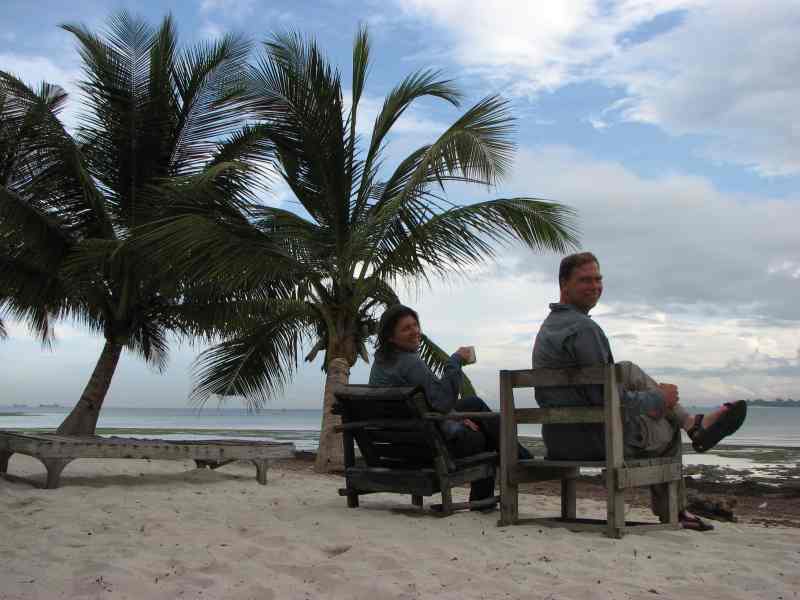
Luco and Joe let us store the bikes at the campground while we took a passenger ferry to Zanzibar. Our tickets turned out to be in the first class section, which I imagine we'd paid more for. The sofas and air conditioning were great for the four hour journey, though. Zanzibar was quite picturesque as we chugged towards the ferry port. Colonial structures lined the sandy coast and we could see the towers of St. Joseph's Cathedral somewhere in the middle of Stone Town. The guidebook had warned us that touts would be there to greet us, and there they were, trying to sell us everything from spice tours to diving trips to hotels. After quite a few, "Habana, asantes" (no thanks), we beelined for a taxi. As we ate lunch in a lovely little courtyard, Will and Christine, newlyweds from Boulder, Colorado, appeared. It was fun to see them again, and to hear about their visit to the Zanzibar beaches. Later, we found the Garden Lodge hotel, a little steep at $40, but nice, with Zanzibari beds. It was just outside of the maze of alleyways that was Stone Town, and close to restaurants and the ocean.
Zanzibari bed
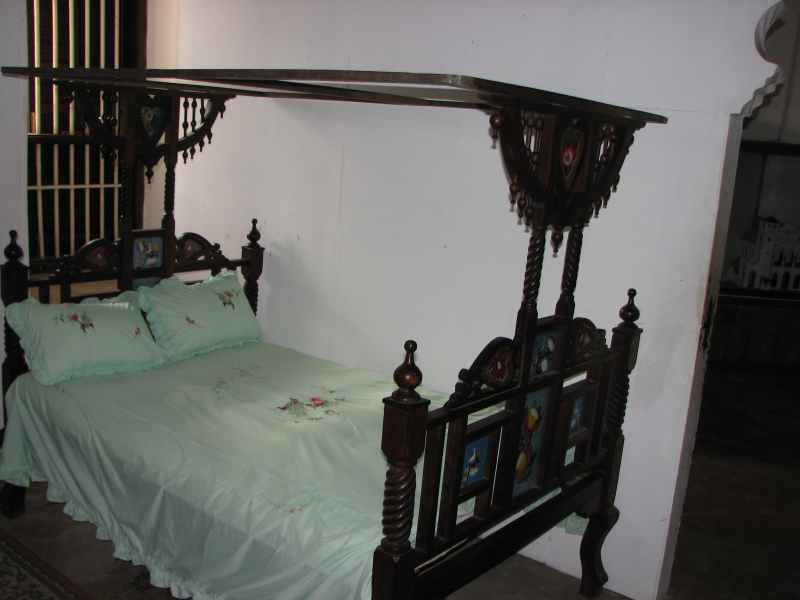
A gorgeous sunny day greeted us, and after breakfast we checked out a couple of museums that were once palaces of the Sultans. Beit El Ajaib showcased artefacts from Zanzibari culture and history. The centrepiece was a life-sized mtepe ship, a Swahili sailing vessel, made only of wood and coconut fibers. My favourite display was called 'Behind the Veil' which documented the life of Princess Salme, daughter of a Sultan. In her book, 'Memoirs of an Arabian Princess', she tells of her life in the palace, and of how she eloped to Europe with a German merchant, where she lived out her life. It was very hot by 10 a.m., so we took a break at Mercury's, a restaurant on the beach named after Freddie Mercury, the singer of Queen. Mercury was born in Zanzibar, and the restaurant had a few photos of the famous singer as a tribute. They didn't play Bohemian Rhapsody, though, a little disappointing, but I was still able to conjure it up in my head and hum it all day long.
Princess Salme of Zanzibar
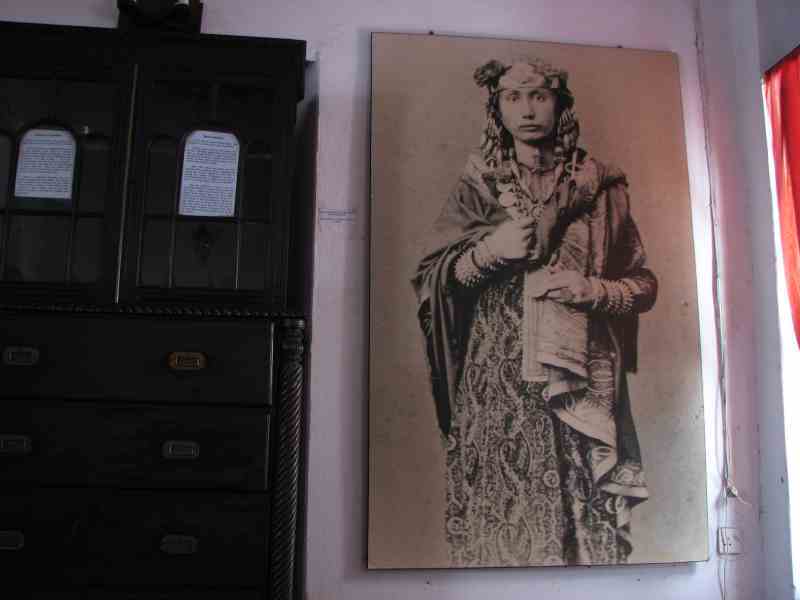
Beautiful colonial architecture, renovated by the Aga Kahn Foundation
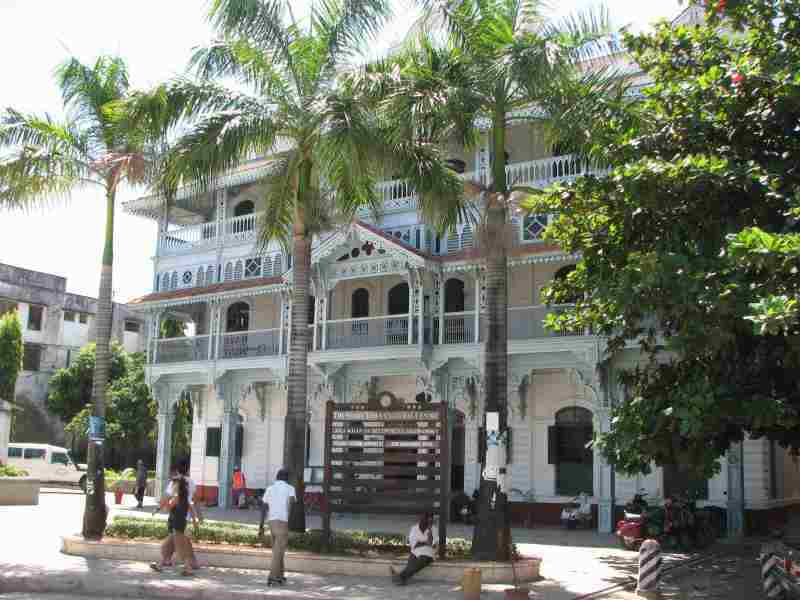
The second museum was Beit El Sahel, and showed the palace as it would have looked when the last Sultan, lived there. I'm sure that at one time the place was properly opulent but was in bad need of repair, and I know I heard rats scurrying in the attics up above. Later we walked down the street towards the restaurants, brushing off nut sellers and necklace hawkers, when we saw two familiar faces: Matteo and Herbie! They were just heading to the ferry to Dar where they would catch a plane to Uganda to go see the mountain gorillas. We were so jealous! They gave us a quick update on the others. Vehsel was somewhere on the island, exploring the beaches, Tom was last seen trying to get his bike to Zanzibar, and Robin and George were riding to Dar from Uganda.
Dhows in the bay as seen from the Beit El Sahel palace

Matteo and Herbie
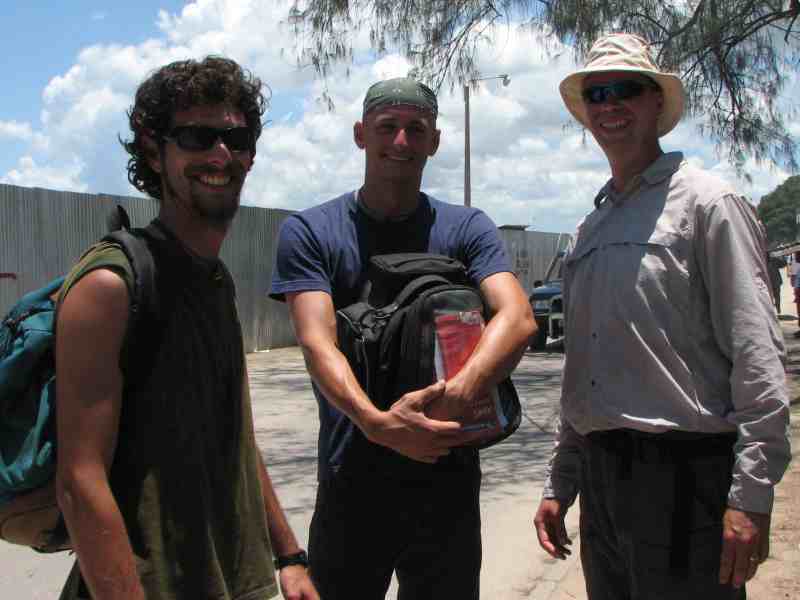
Our tour of Stone Town continued with a visit to the Anglican Cathedral. It was built on the site of the former slave market as a memorial to those who suffered so much. The altar was set up at the same spot as the old whipping post. In the nearby hostel, downstairs, glowing candles led us to caves where slaves had been kept before being sent away on ships.
A visit to the market took us through the winding streets and little alleyways that were Stone Town. People just went about their daily business, each shop specializing in sandals or carvings or spices. The place was made for wandering and taking in the sights and smells, some more pleasant than others. We were on the hunt for sharkies, small fruits that grew only on Zanzibar. Nicki, mother of Joe from Mikadi Beach, had asked us to bring some back for her. No luck, but it was fun hunting for them in the small corners of Stone Town. Saying, "Habana, asante" (no thanks) over and over again got a little old as people came by with baskets full of nuts or trinkets. The worst were the CD sellers. And this relates back to our Kilimanjaro hike. As we climbed the mountain, Stanley, our guide, taught us a song:
Jambo, Jambo Bwana
Habari Gani, Zuri Sana...
Kilimanjaro
Hakuna Matata
A bunch of Polish hikers who often spontaneously broke into song (I think they did the whole Polish version of '99 Bottles of Beer on the Wall'), learned the tune and sang it during supper one evening. We had heard them practising, over and over again, from out hut, and needless to say were a little tired of 'Jambo, Jambo Bwana'. So, back to the CD sellers in Zanzibar. A guy approached us, thrust a CD in our face, and started singing (you guessed it), 'Jambo Bwana'! He was hoping that we would recognize the tune and would immediately fork out lots of money to have it for ourselves. And then came another one, singing 'Jambo Bwana'. And then another. The first 20 or so CD sellers were somewhat annoying, but by number 83, we were ready to grab their CD and launch it into the Indian Ocean. Sheesh!
Hard work in 30 degree heat with almost 100% humidity

Another spectacular sunset
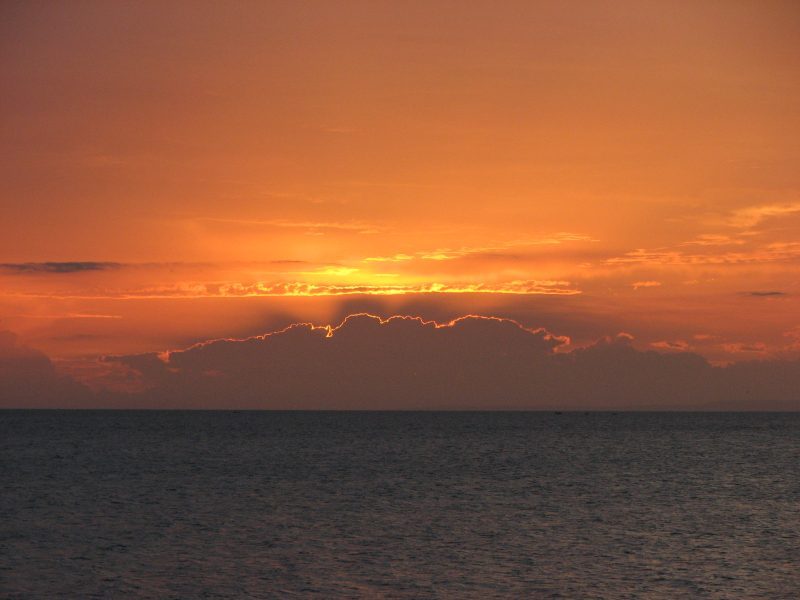
Zanzibar is famous for its beautiful, white-sand coral talcum powder beaches lined with palm trees, perfect for just hanging out and relaxing. So what do two motorcyclists who have just ridden 15 000 kilometres (ie, us) do? Rent motorbikes of course! Well, we couldn't just sit there doing nothing. So Ekke rented a Honda Baja 250 dirt bike, and I ended up with a 'Vespa Wannabe' scooter, made in India. I thought I looked pretty cool, cruising around Zanzibar on that thing, until I saw the pictures. Quite ridiculous, but I had a good time. The dirt bikes were too tall for me - I don't do well with both feet dangling, so a scooter was my only choice. Before I was let loose on my own in Stone Town, I had to show that I could shift and brake, so I practised in a football field. The shifter was located on the left grip, under the clutch, and I had to pull in the clutch and turn the grip to change gears. I found myself wishing that I had my own bike, that I should have shown a bit more effort in getting it up the stairs and onto the ferry in Dar. I did get used to it after a while, however, and we sent locals running for cover as we raced by at 50 kph, my top speed. The rain started soon after we left Stone Town. It's never just a few drops when you don't have any raingear, is it? This was a complete deluge, as if someone was pouring buckets of water right over our heads. I was soaked in three seconds flat, not having Ekke's foresight to bring a Gore-Tex liner. But, it was a warm rain, and after it stopped, we could ride standing up and dry out a bit. The road out to the east coast was paved, and we rode past small towns with red mud-brick houses and people selling mangoes and bananas out front. It was fun having the time to look at a few resorts, and then decide where we would stay. The Tamarind Beach Hotel was our first choice. Magda had recommended it, and it was lovely, with a gorgeous long crescent beach lined with palm trees. They even had Bob Marley's 'Redemption Song' playing in the bar, so I was sold. More reggae music entertained us at dinner, that is, until someone put in a different CD. "Jambo, Jambo Bwana…" Arghhhhhhh!
Audrey on the football pitch
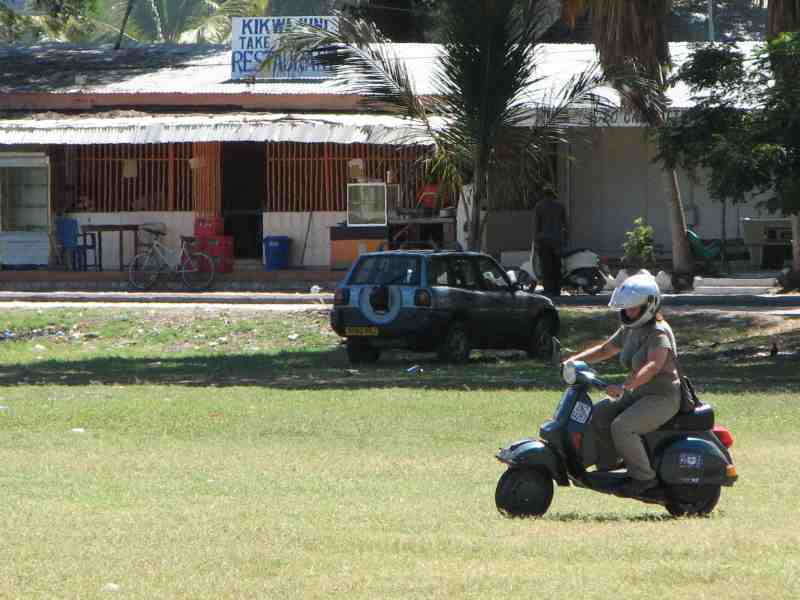
Tamarind beach
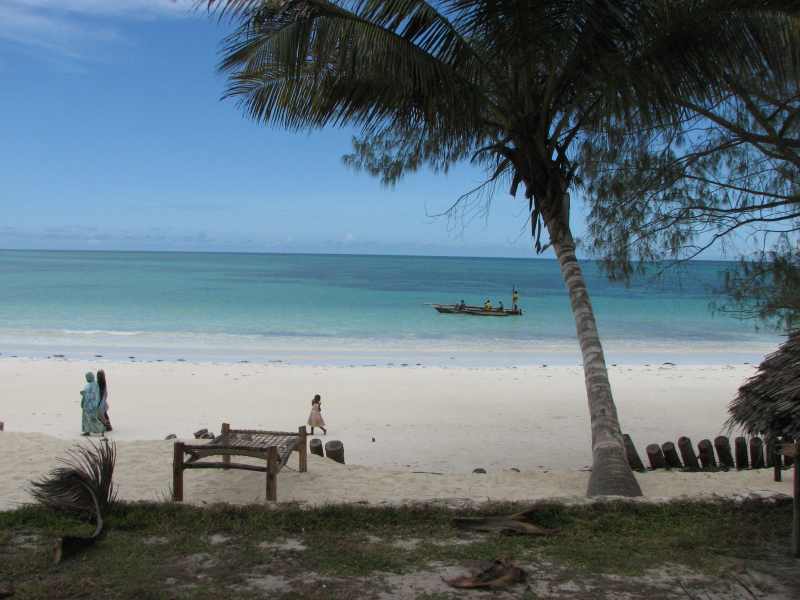
A morning beach walk with the tide way out was an absolute delight. The sun beat down with intense heat, and it was only 7:30 a.m. After breakfast, we packed up and rode north. Again the deluge of rain. This time there was so much deluge that we missed our turnoff. The sign that said 'Zanzibar Town 20 km' was our first clue that we were heading south instead of north. But, it wasn't a huge island, thank goodness, so we just looped around and were soon on our way to Nungwi. We had a beachside lunch at one of the resorts there, but decided it was more of a party place, and searched for something quieter. Further down the beach we found the Sunset Hotel, a lovely spot on the west side, making for a beautiful sunset over the Indian Ocean. I even got to do a little scooter offroading on the terrible approach to the resort, riding over big rocks and avoiding big holes. Ekke and his dirt bike just bounced effortlessly over the rough terrain, as if he'd done this kind of thing before.
Breakfast time
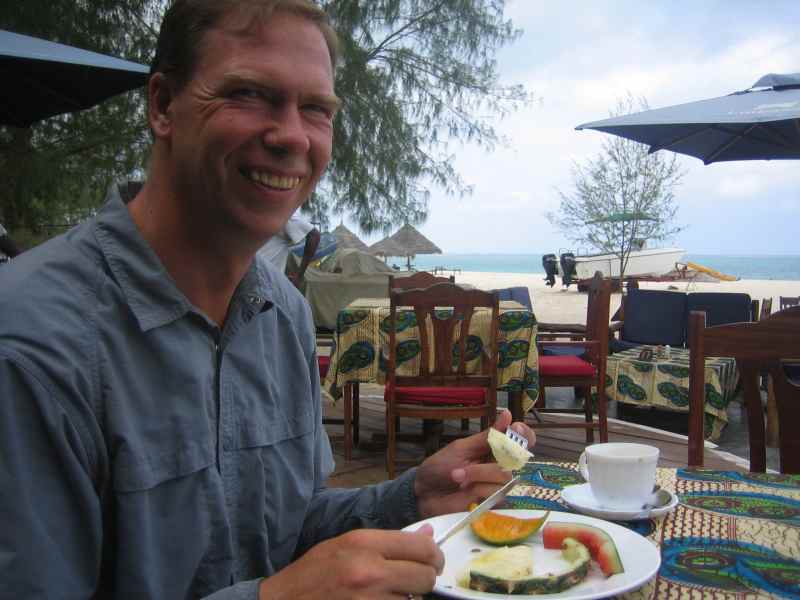
Saddle up and ride!

At the appropriately named Sunset Hotel
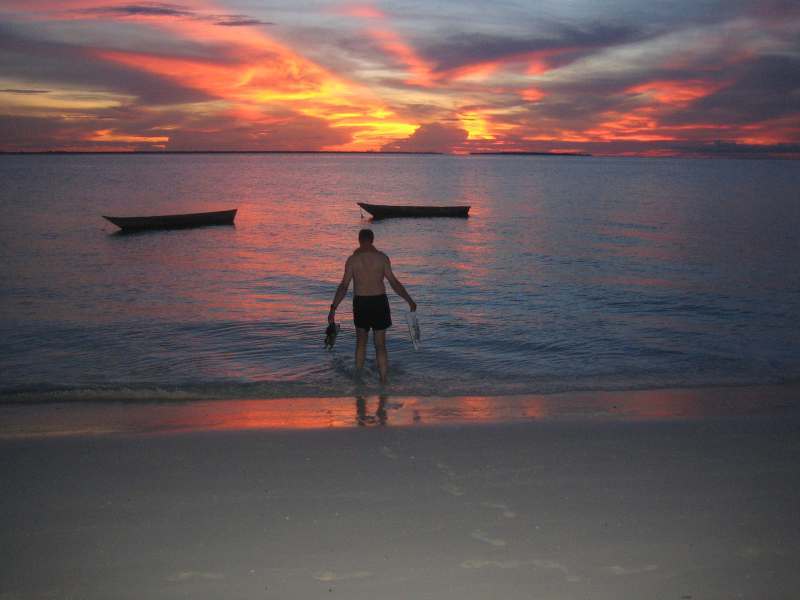
After a beachside breakfast we rode to the south part of the island, past spice farms and lush banana trees. The route took us by Jozani Forest, famous for its rare red colobus monkeys. We did see something in a tree, a monkey, but not a red colobus. Off we rode, and then, unexpectedly, a red colobus just crossed the road right in front of us. Too late to get the camera, but it was a beautiful sight to see.
Riding under a canopy of trees

A wild monkey

The southeast corner of Zanzibar also had beautiful beaches, and we rode down a sandy pathway to Robinson's Place near Page. Ekke and I grabbed our books, found a wicker and rope bench by the ocean, and finally did some relaxing. Electricity was nonexistent here and when it got dark we were given an oil lantern for our room and to take to supper. The meal, fresh fish, was presented in an open air gazebo, with a huge cloth spread on the floor, everyone sitting around the outside. It was easy to chat with the staff and other guests in this environment, and we enjoyed a pleasant evening.
Woo hoo!
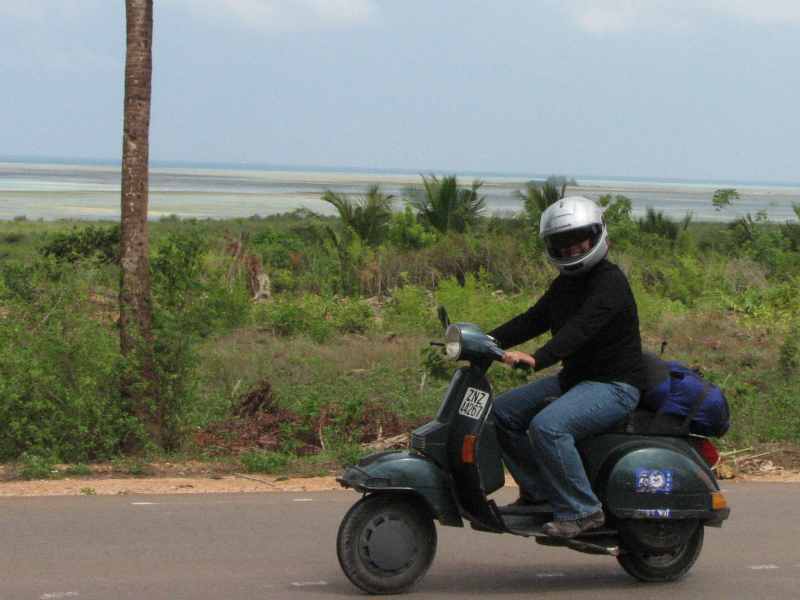
Everyday life on Zanzibar
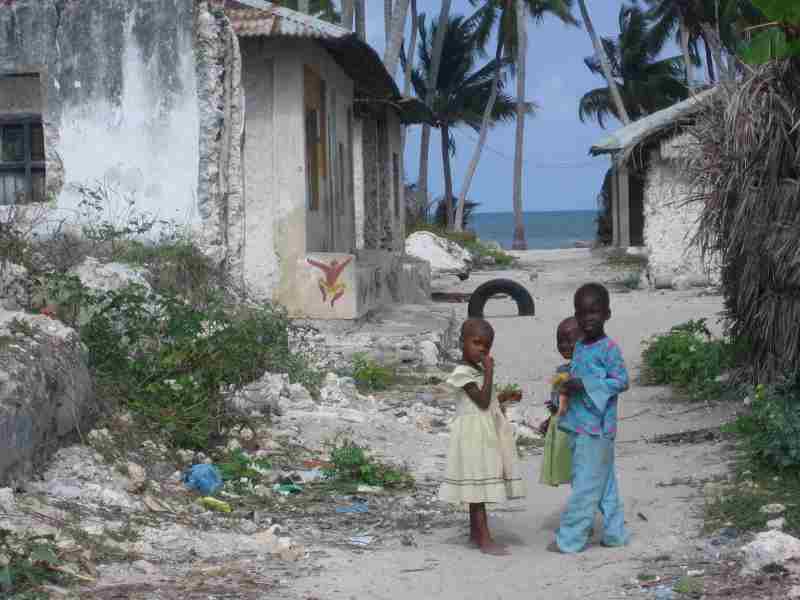
The bikes had to be back in Stone Town by noon. The name Stone Town conjured up images of those old Spaghetti Westerns, where a gunfight was always scheduled at noon. So Ekke made a good joke of it, and in his deep, low Clint Eastwood voice, would say, "High noon... Stone Town. Riding a scooter into Stone Town, " making it sound really cool to be on a scooter. So, we went ridin' into Stone Town at high noon, finding our way through the maze of streets by instinct and gut feeling. We got thoroughly lost. But by keeping the ocean on our left, we knew that we'd eventually make it to the Garden Lodge.
Livingstone's, a beachfront restaurant was a former British Consulate building, and was a great place for hanging out for a few hours. The salty breezes from the ocean wafted in as we sipped fruit shakes and cold tangawizi, a type of ginger beer. They had wireless internet, so we had brought the laptop and what a treat to have unlimited access to the net. Will and Christine had told us about Skype, where we could phone from our computer using a microphone and headset. For mere pennies a minute, I was able to call Helena in Germany, and then Ekke called his folks in Canada. If wireless were more readily available, we could probably make good use of it. Eventually we decided to leave, and moved over to Amore Mio for a change of pace, brushing off 'Jambo Bwana' singing CD sellers on the way. Along with their delicious gelato, they had wireless, so we finished the Kilimanjaro part of the website and within minutes we had it uploaded to the net. Technology's amazing when it works!
Enjoying a fruit shake at the Livingstone Restaurant
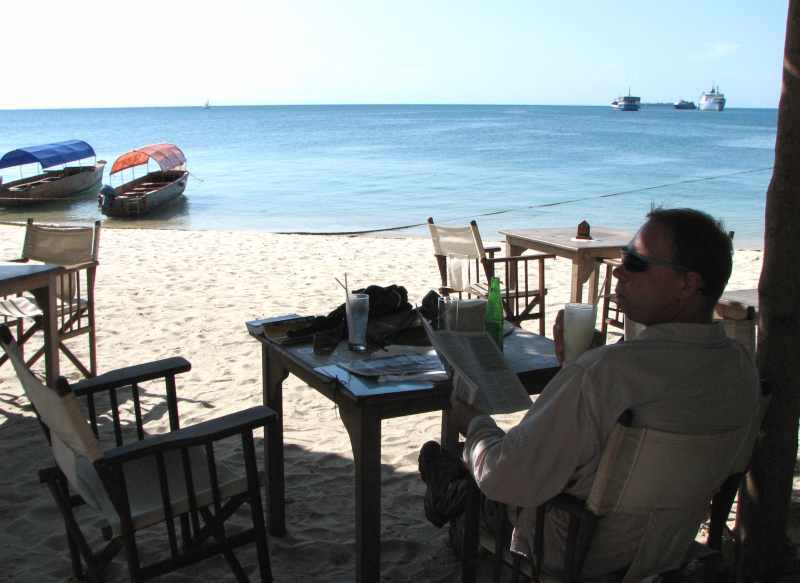
Our time on the island came to an end or we were running out of money or something. In any case it was time to get on the road again. We downloaded the Safari chapter of the website the next day at Amore Mio, and had some lunch, consisting mostly of gelato. A fast ferry left at 4:00 p.m. and it was easy to find tickets. We sat outside on the packed ferry, lucky to get a seat. Zanzibar was lovely in the hot afternoon sun as we departed the dhow-filled bay, watching for our favourite places as the ferry chugged away from port. And beyond the whistle of the breeze and the gentle lapping of the waves I'm sure I heard a single voice singing, " Jambo, Jambo Bwana.. ."
Spaghetti ice cream, a tangawizi and motorcycle magazines. Heaven.
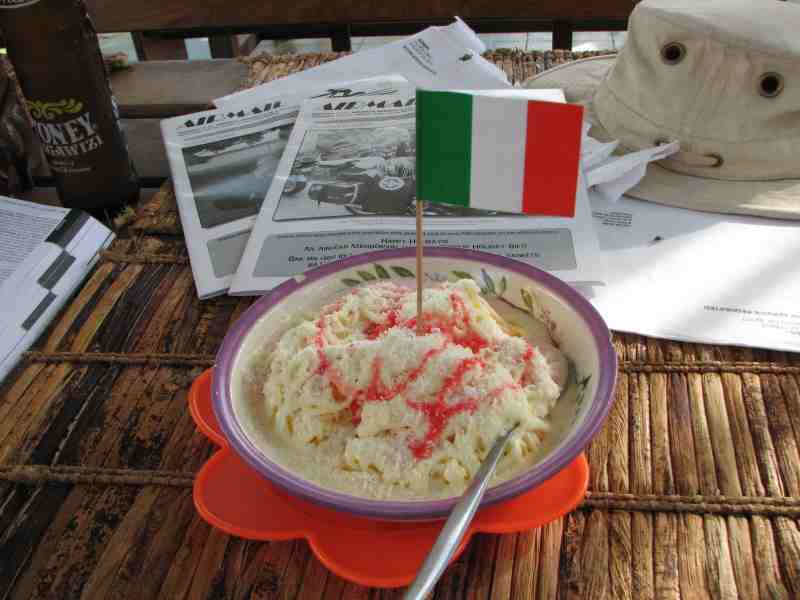
Goodbye to Stone Town
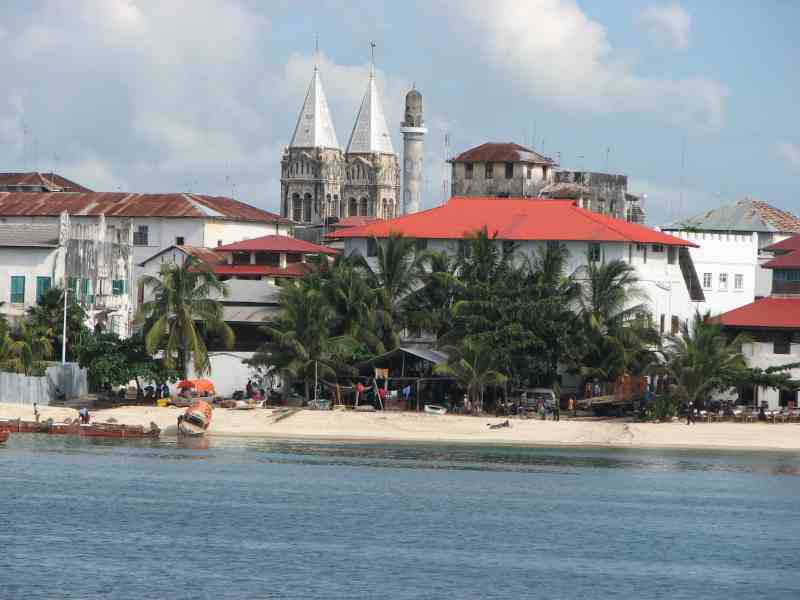
Ekke writes:
We arrived back in Dar es Salaam at 7:30, about an hour and a half late and well into darkness with the sun having set at 7:00. Since we didn't have supper we caught a cab to Steers, just a few blocks away. This burger joint provided some air conditioned relief from Dar's oppressive humidity and heat. The burgers weren't half bad either. Another taxi to the Kigamboni ferry across the bay and then our third cab finally took us to the Mikadi Beach Club. We set up the tent next to the bikes and then marvelled at the work the new owners of the club had done in the renovation process, piles of rubbish were everywhere. Technically they were closed but they allowed us to stay for a couple of nights at half the normal rate.
The front brake on Audrey's bike was still very mushy, which made braking an adventure. The repair that Chris had done at Jungle Junction had only lasted a few days before becoming soft again. I had popped onto the internet before going to Zanzibar so the day after we got back I tried a couple of the tips I got from the Adventure Rider (www.advrider.com) and Horizons Unlimited (www.horizonsunlimited.com) websites. The official BMW method was to use their proprietary computer to disengage the ABS, something neither I nor Chris in Nairobi had. The next best method seemed to be to apply the front brake hard enough to engage the ABS and then to bleed the brakes. That was pretty exciting, zooming up the sandy driveway and then slamming on the front brake as hard as possible. I bled the brakes and then did the full ABS braking again. After doing that four times it seemed that the front brake was quite a bit better. Audrey confirmed that it was indeed much better. We were ready to ride in the direction of Malawi.
Packing up on Thursday was a challenge, not only because of the disarray from our Zanzibar trip but also because of the amazing heat and humidity. We were sweating like crazy at 8:00 AM. When we finally rode away we only got to the far side of Dar es Salaam before needing to stop for a cold water break. In the afternoon we entered Mikumi National Park. This was an especially interesting park for us because, unlike other national parks, motorcycles are allowed to ride through. Yes, they have lions in the park! We didn't really know what to expect, but assumed that the game was fairly scarce since we were allowed to ride in the park. Imagine our delight when we saw a couple of elephants grazing in a meadow. Our safari was a wonderful trip to the Ngorongoro Crater and the Serengeti but in a 4X4 it seemed like a Disney ride, or as Audrey has described it, Jurassic Park. Coming across wild elephants while on our motorcycles was so much more special. They were part of our motorcycle trip now. We also saw giraffes, buffaloes, monkeys, yellow baboons and even a couple of warthogs, all made more real because we were riding our motorcycles as opposed to being confined in a car. We couldn't wipe the huge grins off our faces for hours afterwards. Just inside the park was a lodge, but as we were about to turn into the driveway a sign caught our eye: No motorcycles, bicycles or pedestrians allowed. Maybe it wasn't so safe being on the bikes after all. A few kilometres further down the road, and outside the park, was the TanSwiss hotel. They allowed motorcycles and we could camp on the grass in front of the motel block. We also liked the look of the fence and the dogs to protect us from the wildlife that didn't know we were outside the park.
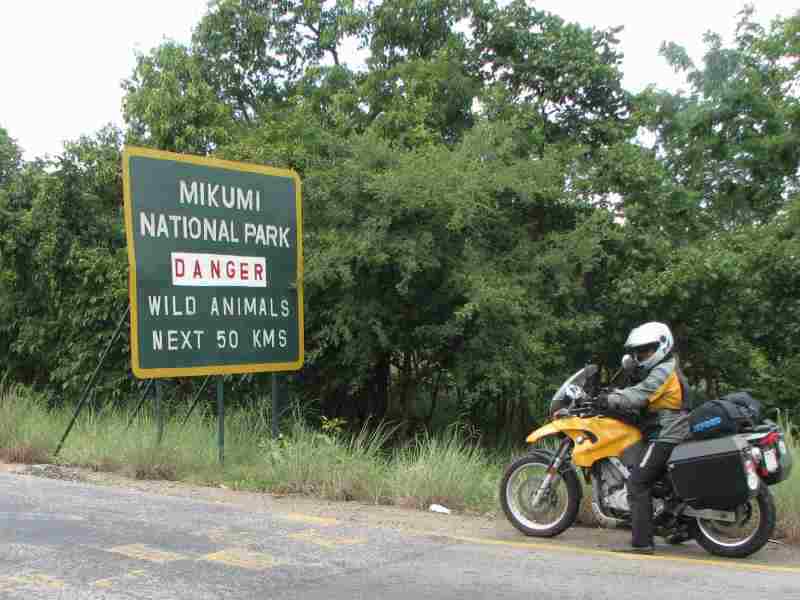
Riding with the elephants
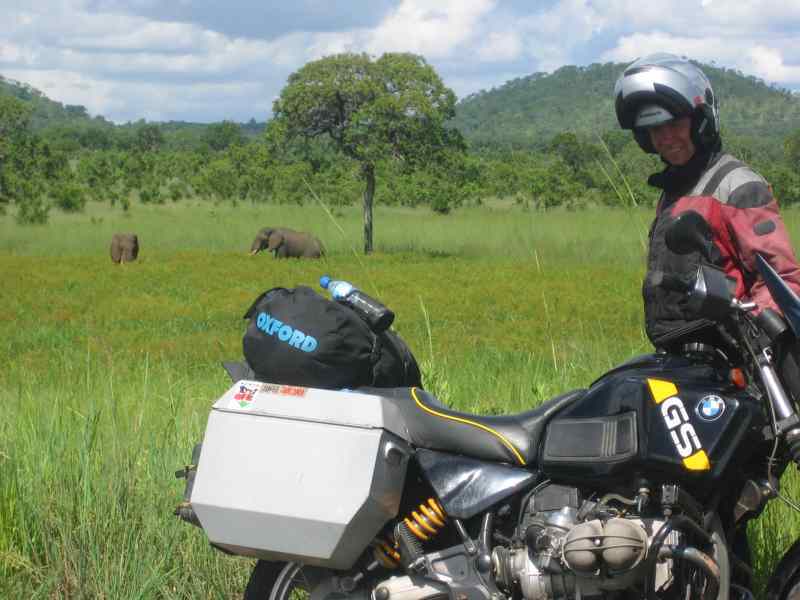
Wow
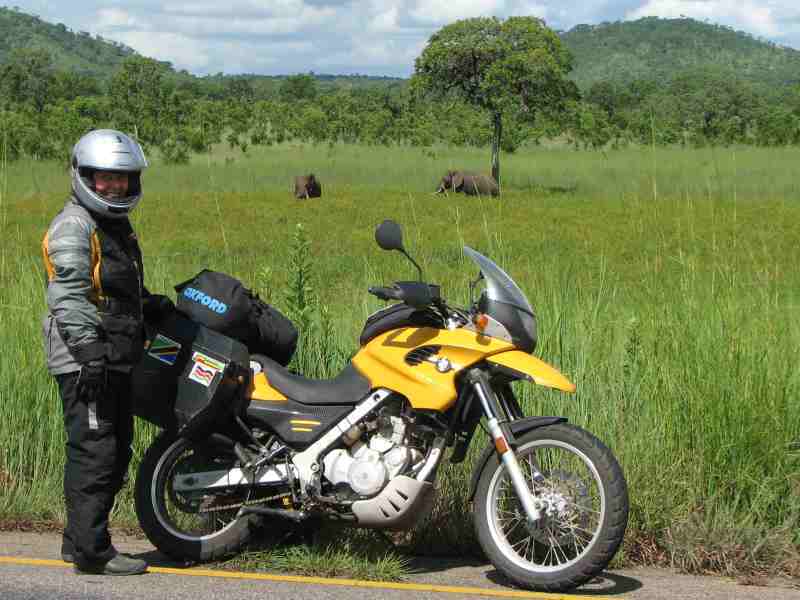
A forest of giraffes
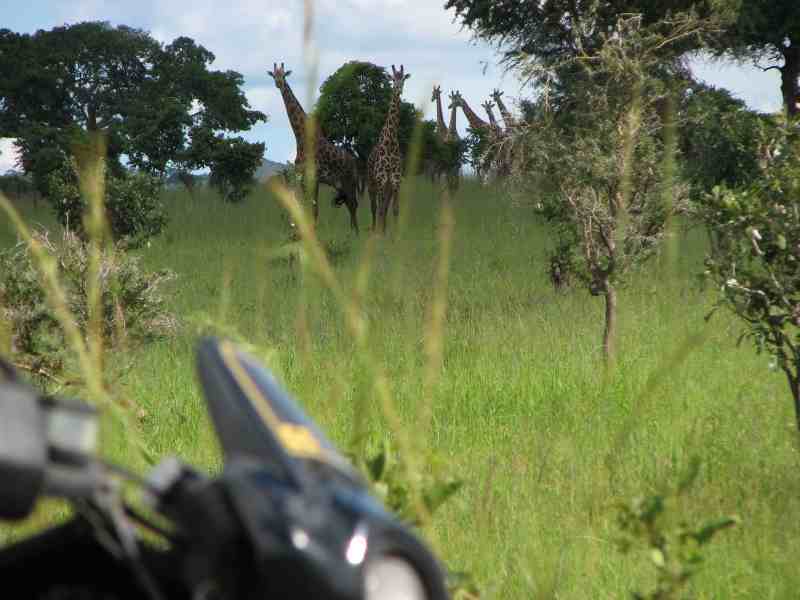
Friday morning we chatted with a couple from the Czech Republic in a Land Rover Discovery. Bogdan and Katerina had come down through Ethiopia and Kenya and we had met them briefly in Marsabit at Henry's Camp (another Swiss operation, coincidence?) while I was sick. The day they left Henry's they rolled their truck. Luckily they were wearing their seatbelts or they might have suffered greater injuries than a cut little finger. After getting the Land Rover upright they kicked out the shattered windshield and drove to Nairobi. There the truck underwent major repairs for a month (the only panel that didn't need repair was the hood) while they went to Kilimanjaro, the Serengeti and Zanzibar. After the truck was fixed they drove west to Uganda since the post-election troubles in Kenya were over. There they saw the mountain gorillas. It sounded absolutely amazing. Audrey and I looked at each other and we could see the wheels turning in each other's heads; could we get up there somehow? Originally we would have liked to come down to Nairobi and then go to Uganda and Rwanda but the rioting in the west of Kenya had abolished that plan. Now we were trying to figure a way to get there. The round trip from Mikumi would have been about 4,000 kilometres, taken roughly two weeks and cost on the order of $2,000, including the $500 per person viewing fee. By now Audrey's front brake was mushy again and my tires were starting to wear down, so we decided that we would not do the ride but rather check the internet for cheap flights to Uganda from Cape Town or elsewhere further south.
The truck doesn't look too bad

Leaving the TanSwiss hotel we entered some curvy roads running beside the Ruaha River in the Udzungwa Mountains. Even while keeping an eye open for potholes and troops of baboons the road was great fun. Coming around a bend we could see that the sky was not just threatening rain but it looked like it was raining pretty hard up ahead. We hadn't used our rain gear in ages so it took a while to dig it out and put it all on. The disadvantage of the Gore-Tex liners was that the jacket and (perhaps more importantly) the pants must be removed to insert them. Audrey's pants had a permanent Gore-Tex liner built in, which was not so nice in the heat, but at least she didn't have to do a little dance at the side of the road to strip off the pants and zip in the liner while balancing on her boots in her underwear hoping no-one was walking, bicycling or driving by. Finally all suited up we found that the waterproof liners had done their job. The rain had moved off, leaving only a wet road. Just after lunch in Iringa we stopped at the Isimila Stone Age site. In our motorcycle gear we weren't too keen on exploring the valley so we just looked at some of the artefacts that had been unearthed. Good thing that Audrey and I weren't anthropologists as we wouldn't have recognised the rocks on display as being tools if they weren't labelled. From Isimila it was only a short distance to The Old Farm House, a lodge and campground famous for its restaurant. Naturally we set the tent up during a ten minute rainstorm so everything got a little wet. The afternoon showers seemed to be of short duration so we decided that in the future we would wait a little while before setting up the tent in the rain. At 7:00 PM we were called to dinner at a mud house with a thatched roof. No electricity meant that everything was lit up using oil lanterns so it was a very interesting atmosphere. Tomato soup started our meal and then the main course came out on large serving plates. The plates needed to be large as the T-Bone steaks were absolutely enormous. (I'm beginning to think that I've had more T-Bone steaks in the last couple of months than I would in an entire year at home). They were done to perfection and even though we didn't think we could finish a chunk of meat that large, we did. Perhaps even more astonishing were the vegetables; they were crisp and full of flavour and easily the best vegetables since Bavaria. Apple pie tarts and tea rounded off a spectacular meal. If the staff would have offered to wheel us back to the tent in a wheel barrow I think we would have taken them up on it. We were stuffed.
Taking a water break under a baobob tree
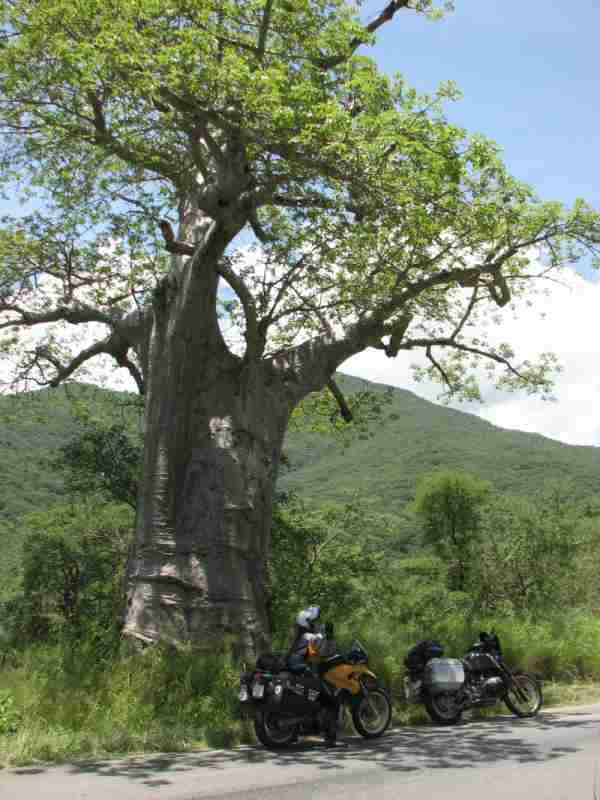
Get the rain gear on
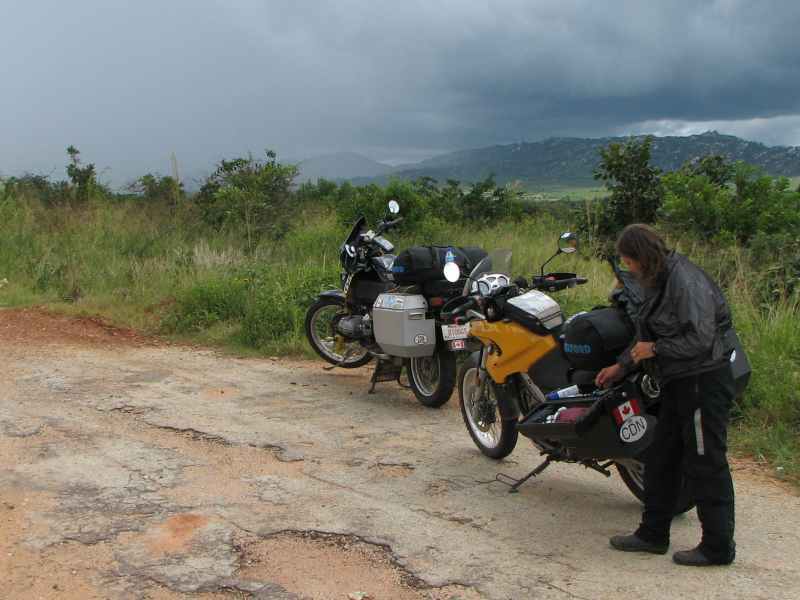
Stone age tools
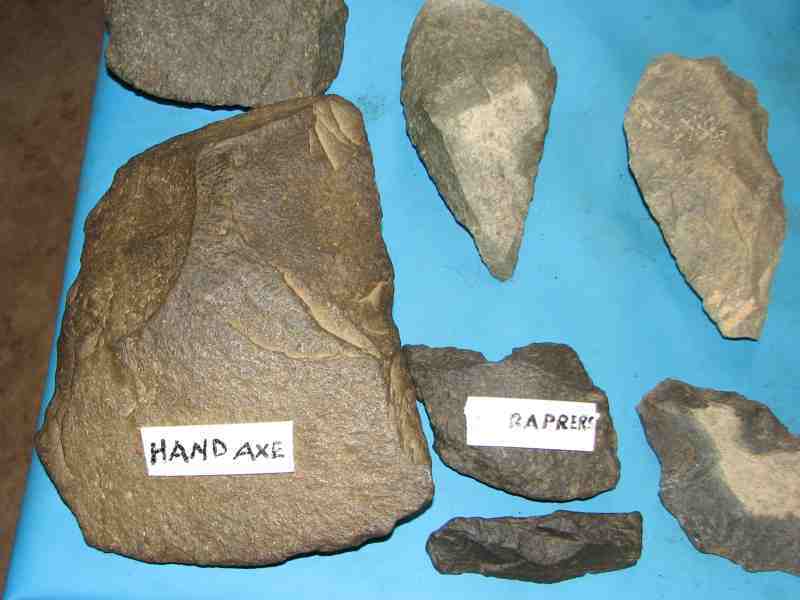
Daily life in Tanzania at the water pump as Audrey rides by
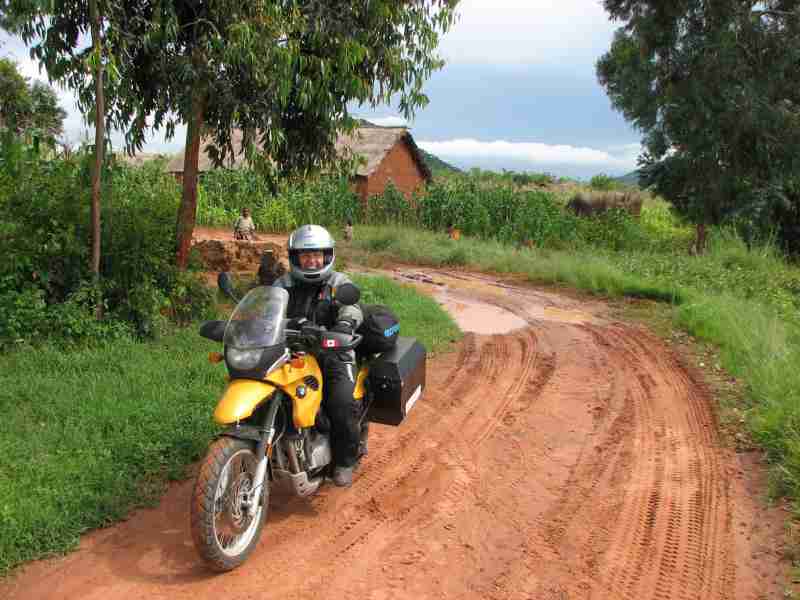
After a scrumptious breakfast on the veranda of the dining hut we rode to Mbeya. Again our raingear did its job; as soon as we struggled into it (skipping the pants liner this time) the rain passed by and we had a dry ride. While at the ATM we saw the Mbeya Hotel and wandered over for lunch. The camping looked pretty dismal and they wanted $55 for a room so after lunch we went in search of more reasonable accommodation. We found it at the Karibuni Centre where a double room, including breakfast was 15,000 Tsh, or about $13. In the corner was the frame of a Yamaha XT500 and nearby was a young man working on an engine. Robert was from South Africa, riding north. Somehow the threads in the sparkplug hole had become stripped and now he was disassembling the bike. He was planning to take the cylinder head with him on the bus and get it repaired in Dar es Salaam, then come back by train to Mbeya. That evening we walked with Robert to a nearby restaurant and had a great time exchanging travel stories and tips.
Elegant breakfast at the Old Farm House
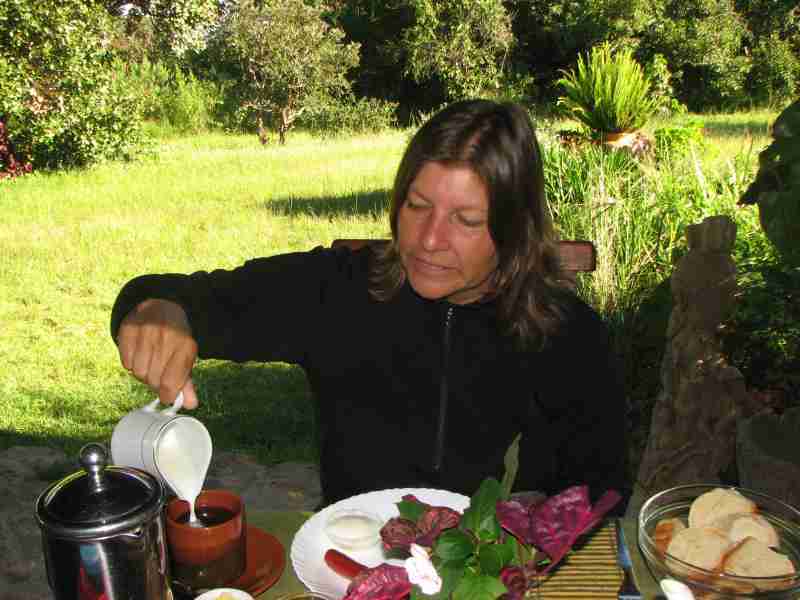
On Sunday, the 16th, we doubled back about 10 kilometres from Mbeya to the intersection with the road south to Malawi and then started climbing on yet another fun, twisty road. Soon we were over 2,200 metres and riding amongst banana trees and tea plantations. Just when I pulled over to take a photo, a motorcyclist coming from the other direction pulled over too. Andrew was from Denmark and had shipped his BMW G650 to Cape Town. He was planning to do some work on his Master's thesis in Arusha and his girlfriend was flying there to meet him. As we were talking, Andrew's cell phone rang and it was his girlfriend. She was in the Amsterdam airport and would be in Arusha in a little while. Andrew was disappointed when we told him that the shortest road to Arusha, via Dodoma, was quite rough as that is where Steven, whom we had met in Nairobi, had cracked his front wheel. After exchanging e-mail addresses we let Andrew blast north while we trundled south to Malawi. Tanzania had been a spectacular country to visit on our ride through Africa. From the balloon over the endless spaces of the Serengeti, to trekking to the peak of Africa, to exploring the island of Zanzibar and riding everywhere in between, Tanzania had been a real highlight on our journey.
Meeting Andrew

Audrey ready to leap off and get a fresh banana

Maps of our route
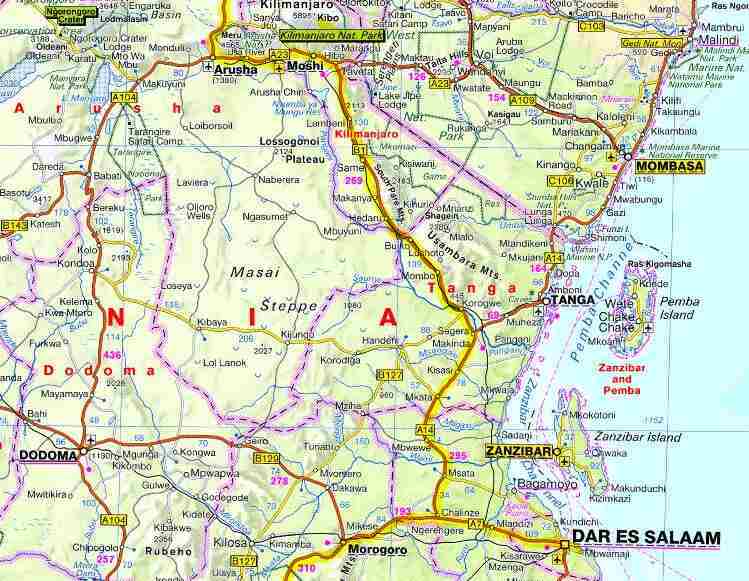
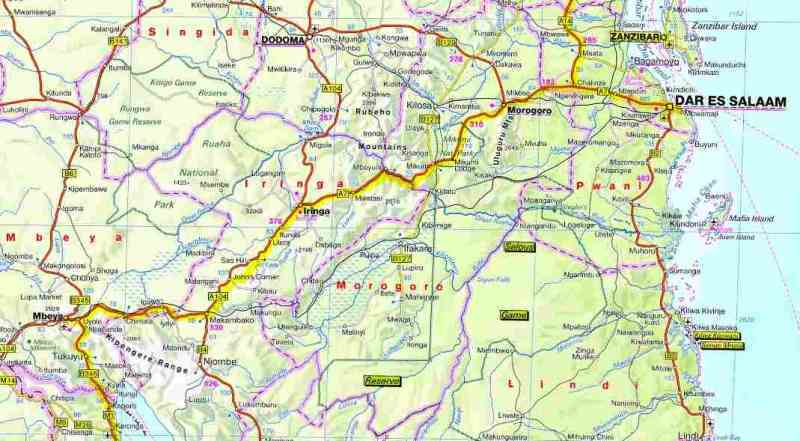
Riding into Malawi we were immediately struck by the number of people walking on the road and the number of animals. It really reminded us of Ethiopia, though perhaps not to the same degree. Even though the road had a good surface, the number of people on the road and the narrowness of the surface dictated a rather slow pace. We rarely exceeded 80 kph. When we got to Karonga we went straight to an ATM and were overjoyed to get cash dispensed. The machine only allowed a maximum withdrawal of 20,000 kwachas or about $140 so hopefully Malawi wouldn't be too expensive. A meal in town at a local restaurant consisting of rice and a nice, plump chicken along with a couple of sodas was 580 kwachas ($4). (OK, I like saying kwachas!). Karonga had an excellent museum so we paid a visit to learn of the cultural history of Malawi as well as about the malawisaurus. Further south we wanted to camp near Livingstonia but the steep road up on loose rock looked a little daunting on our fully loaded bikes so we decided to camp on the beach at Chitimba Beach Lodge. This had a challenging sand section (always one of Audrey's favourite surfaces) but it was surmountable.
Lunch time in Malawi
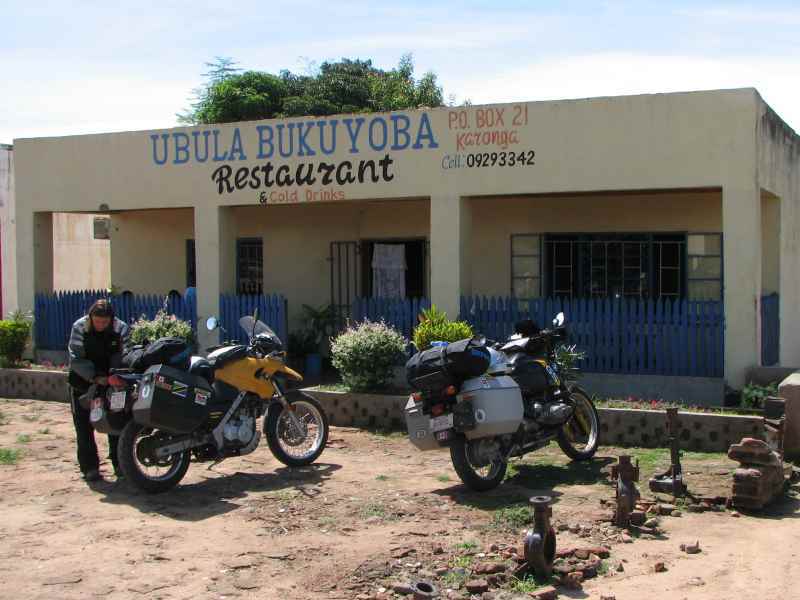
Malawisaurus reconstruction

St. Patrick's Day was spent getting caught up on chores and then in the afternoon I rode up to Livingstonia. With the F650's mushy front brake Audrey wasn't too keen on tackling the steep descent so she sat at the open-air bar reading a book. I had taken the luggage off the bike so that it was as light as possible going up the loose switchbacks. I was glad I did that as it made the ride a lot more fun. The famous Stone House built by Dr. Robert Laws in 1903 looked like any of the other houses and certainly wasn't anything special. I didn't take the opportunity to visit the museum, opting to go riding instead. Beautiful views of Lake Malawi were to be had from the top of the escarpment. On the way down I stopped off at Lukwe Camp, an eco lodge, for a cool beverage. We had thought of staying here but I was glad we hadn't tackled the road on the fully loaded bikes. The cook told me of a set of falls that were only a few minutes ride away so I backtracked up the road after finishing my Coke. I could see why I had missed the sign for the falls. It was a small, hand painted sign set at the side of the road. The short walk was worth it as Manchewe Falls cascaded over the escarpment into a deep valley.
Doing some laundry

Livingstonia Mission built in 1894
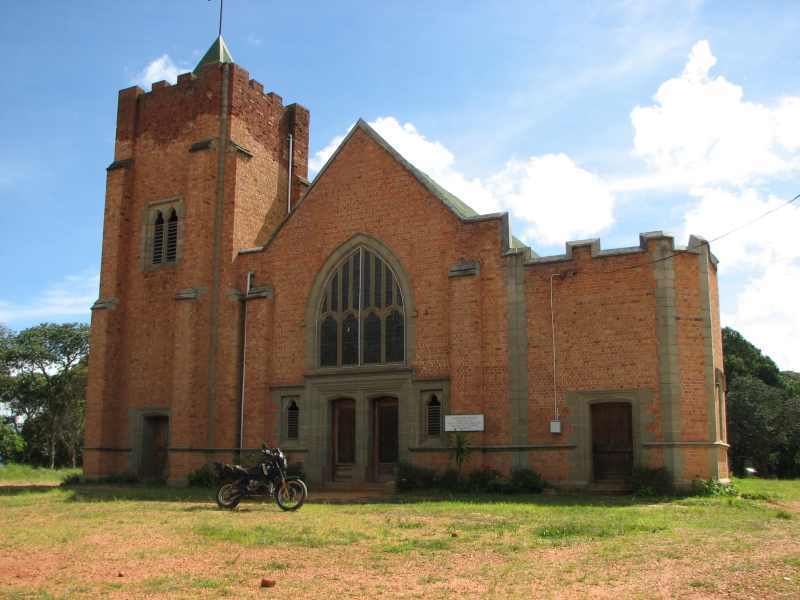
The Stone House

Beautiful views of Lake Malawi from Livingstonia
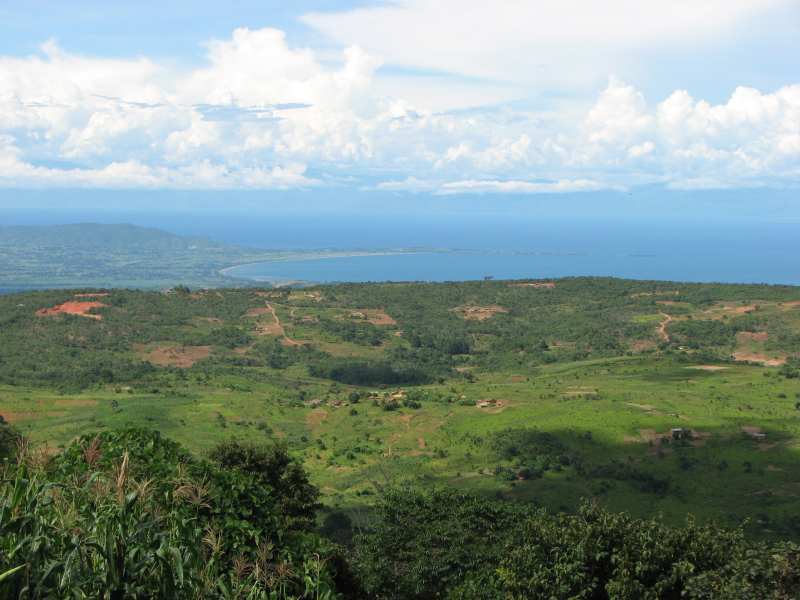
Small sign is easy to miss

Manchewe Falls
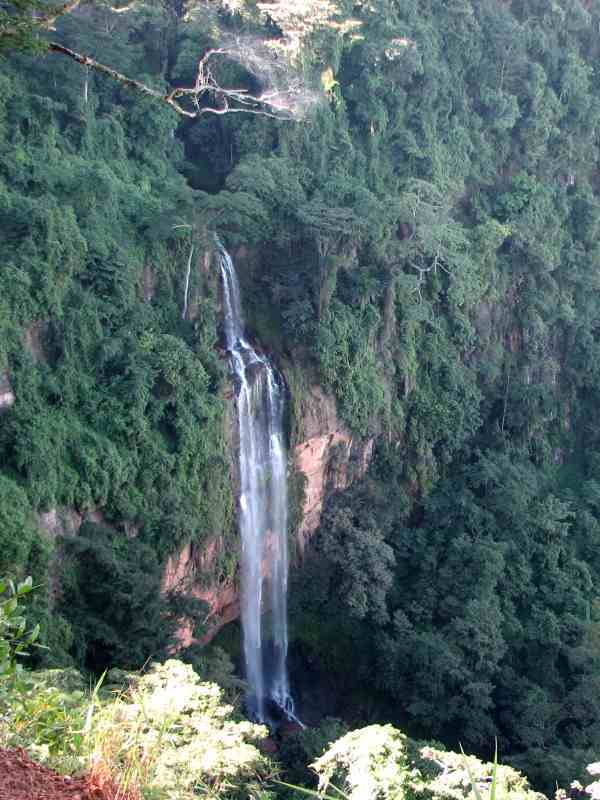
A good road in Malawi
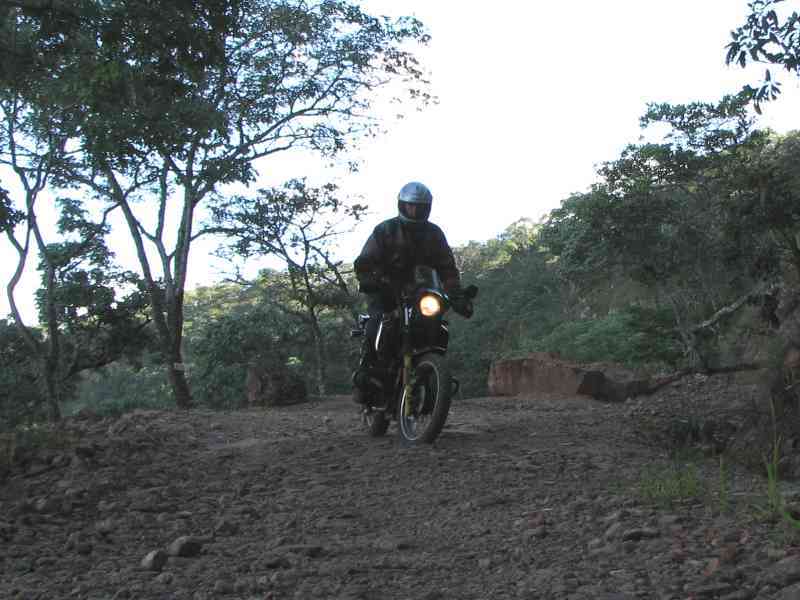
Small village at the bottom of the cliff
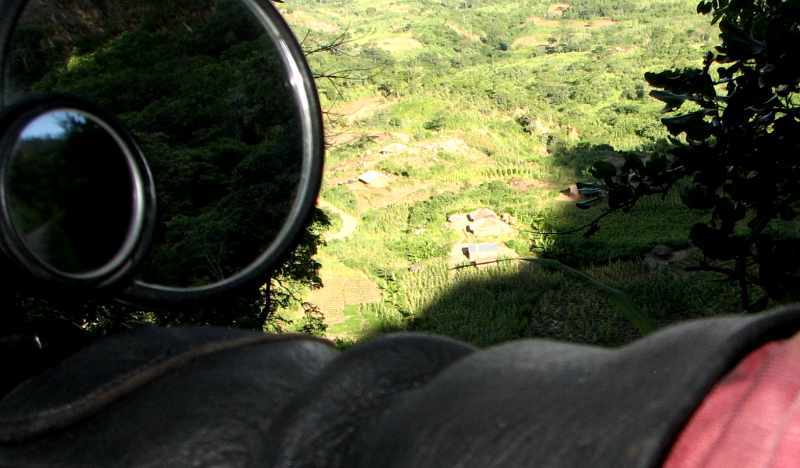
Coming back down to the lake

During the night it really poured down with rain. It just seemed to go on and on. Eventually we got a bit of a break and went to the camp restaurant for breakfast. By now we were getting used to Africa Time but an hour to prepare poached eggs on toast seemed a bit extreme. We really could have used that hour later in the day. We fuelled the bikes in Mzuzu, 140 kilometres from Chitimba Beach, with Audrey going on reserve just before the town with 400 kilometres showing on the odometer. It was also a good spot to have lunch so we pulled into the Graceland restaurant, hoping to have fried banana and peanut butter sandwiches just like Elvis. No luck with that so we ordered a quarter chicken with nsima (like ugali in Tanzania, it was a maize paste that resembled instant mashed potatoes) and a Coke. The chicken and nsima came almost immediately but the Coke took 20 minutes. Africa. Next door to the restaurant was a "supermarket" and while Audrey popped in for some supplies I watched the bikes. Outside the store women were selling bananas. At one point a woman with a large tray of bananas balanced on her head came by with a baby in a sling (papoose?) on her back. The baby was kind of on the side/front of her where it was being breastfed. No-one seemed to notice or pay any attention so maybe this was all perfectly normal. Africa.
Wet season means lots of beautiful waterfalls

We rode into Nkhata Bay and found an internet café. This gave us an opportunity to investigate the Zambian visa situation. At Chitimba Beach an overland truck driver had told us that the visas had gone up to $150 each. Since our U.S. cash reserves were getting rather low it would present us with a bit of a problem. The internet indicated that up until January 28, 2008 it was possible to have the place where you were staying in Zambia apply for a visa waiver so that you didn't have to pay anything at all but that program had been scrapped by the government. Fortunately for us the visa costs for U.S. and U.K. citizens had risen dramatically to $150 but for Canadians it had only been increased from $30 to $50. Still, compared with "free" it was quite an increase and we determined to let the Zambian government know of our displeasure. Too bad we had to go to Zambia to see Victoria Falls because Zimbabwe was in such a shambles. It really seemed as if the Zambian government was taking advantage of Zimbabwe's woes.
Entertaining bridges were the order of the day

Now all the little things that took time during the day started to catch up with us; the hour for breakfast, the 20 minute wait for a Coke and the 45 minutes we had just spent on the internet. We had 45 minutes of daylight left and with the Malawian road conditions we certainly had no desire to ride in the dark. Sunset found us at the turn off to Nkhwazi Lodge, looking at about four kilometres of rough road. In the trees it got darker and darker. The road had a few steeper descents as we got closer to the lodge and the F650 was especially challenging for Audrey with the mushy front brake. Sometimes the lever would just come right back to the handlebar. Yikes! Eventually we heard a dog barking and soon enough three dogs came running out to greet us. We had arrived. Not only was today's ride here long but it had been a while since we started to come here. Back in Tanzania I had read the Long Way Down and near the beginning of Charley and Ewan's trip they had met Francine and Walther who had given them GPS coordinates for a good place to stay in Malawi. When I read that section, I was sitting in the tent and promptly reached for the GPS in the side pocket. I entered the coordinates and from then on we knew we were headed to Nkhwazi Lodge. It was difficult to tell how nice the place was in the gathering gloom but the owner seemed very nice and suggested that because of the likely rain we should set our tent up in the restaurant. While we were setting up the tent, the cook came out and asked us what we would like for supper. The pizzas sounded good and when we were fully set up we enjoyed some interesting flavours on the pizzas. Audrey had asked for pineapple to be added to the bacon pizza, hoping for a Hawaiian but the sauce had a few additional ingredients. Peas were not usually added to a Hawaiian pizza at home. My veggie pizza came with green beans which technically are classified as a vegetable I suppose.
Tent set up in the restaurant
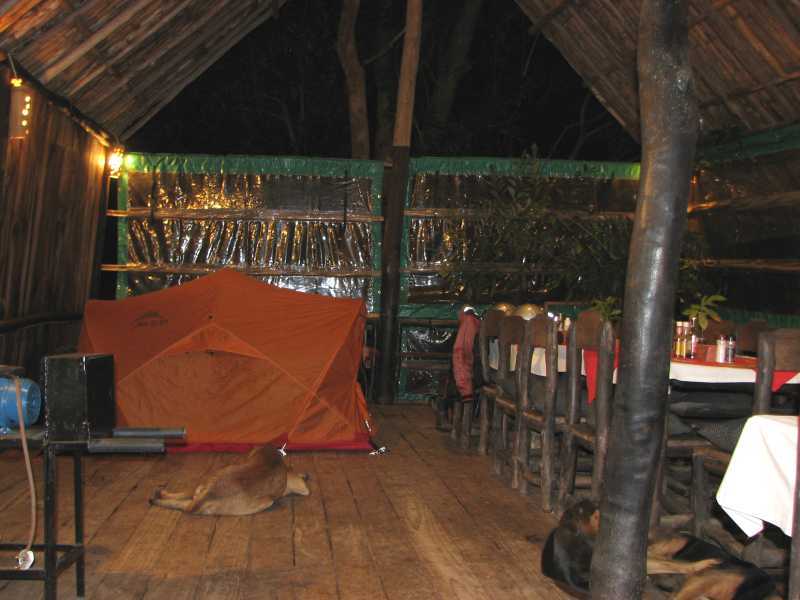
We had gone to sleep in the open-air restaurant listening to an absolute deluge going on outside. It seemed to be of biblical proportions. The three dogs that had greeted us had also spent the night with us. Unfortunately they smelled like wet dogs (odd that) and they were constantly making noise while moving around, scratching and panting. We didn't sleep well. The rain continued into the morning so we decided to stay an additional day at the lodge rather than riding up that road in the rain. The rain lightened up in the afternoon so that we could at least go for a bit of a walk. We first walked up and down the very short beach and then as we walked up the road the three dogs accompanied us. This was all well and good and for the first little while we had fun with our "rent-a-dogs". Then we came upon a local person and the three dogs charged towards him, barking like crazy. He was obviously terrified and started swinging a stick at the dogs. We were completely stunned and started calling the dogs back. They came back, thank goodness, and we apologised profusely to the poor fellow. Obviously we couldn't continue our walk so we turned around back towards the lodge. A little while later the dogs spied another person and promptly gave chase. The guy turned tail and sprinted off. Fortunately the dogs gave up and came back to us. We returned to the lodge and sat in the restaurant with a sick feeling in our stomachs. We certainly hadn't come to Africa to terrorise people.
A walk along the small beach in front of the Nkhwazi Lodge
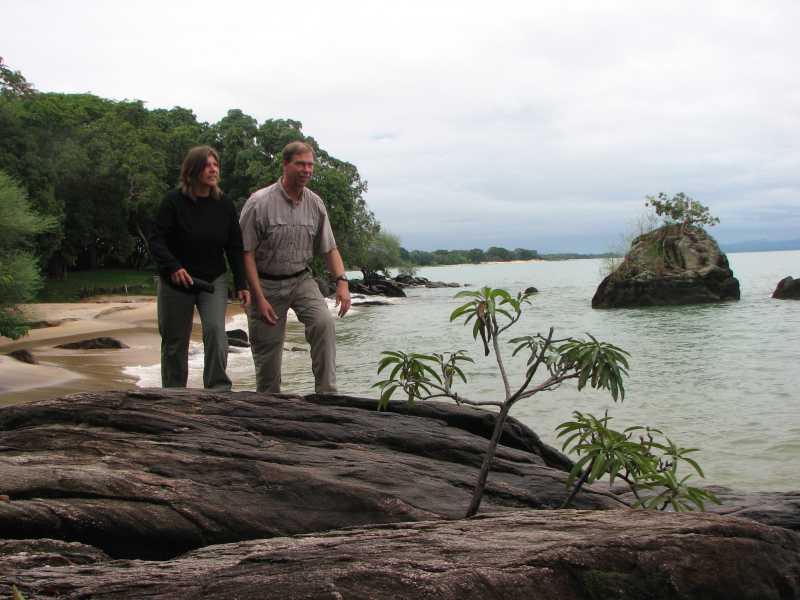
Our noisy "rent-a-dogs"

In the morning we talked with Daryl and Meg, from South Africa in a new Toyota Fortuner, and gave them some help with using their computer and GPS. As part of their homework I asked them to put a waypoint for their house on to our GPS so that we could invite ourselves over for a braai (barbeque). The rain eased off by 11 AM so we checked the road. The heavy rain had made the road even more challenging but it looked do-able. We packed up after lunch and jumped on the bikes, ready for the challenge. That's when Audrey discovered that her rear tire was flat. Hoping that it was just a slow leak we pumped it up and decided to get up out of the lodge while we still could. On the main road we stopped and checked the tire pressure every few kilometres but it seemed to be holding air. In Nkhotakota we searched for the Livingstone Tree. Under this tree David Livingstone put an end to slavery after making a treaty with Jumbe and other Chewa chiefs. Once again the GPS proved useful as there were no signs to the tree, rather signs to another tree where something else happened. The GPS (using the Tracks for Africa map) persistently pointed the other direction and said it was only 100 metres away. We rode into what seemed like a church or hospital compound and sure enough there was the tree with a big sign beside it. Back on the road south we stopped off in a major town to find an ATM. Our cards weren't accepted in one bank and the other bank's machine was temporarily out of order. "Please excuse the inconvenience." The inconvenience for us meant that after paying for camping at Sani Camp we had to bargain the price of dinner down from 950 kwachas to 700 kwachas. (Did I mention I like saying kwachas?)
Daryl and Meg's Toyota

Climbing the road out from Nkhwazi Lodge

The hard to find Livingstone Tree

The next morning, breakfast was a bit of a rip-off at 700 kwachas but we had almost enough money to pay for it. It looked like someone was going to be washing dishes in Malawi to cover the remainder until we found a couple of U.S. one dollar bills. Whew. We finally made it to Salima where we found an ATM that worked so that we could gas up again. The 20,000 kwacha limit really didn't get us very far so we needed to find a bank every couple of days which of course meant we were racking up those service charges. Lunch at a local restaurant wasn't terribly good and then the waiter tried to rip us off by saying that the cost of the meal was a nice round 1,000 kwachas. Our calculations said it should only be 580 kwachas. A bit of a discussion ensued and we eventually threw 700 kwachas on the table and left. Throughout Africa we've experienced the slight of hand tricks to take our money. This particular example was fairly common but the most common seemed to be the "hold back" ploy. Sometimes after we had paid for something the change wouldn't be forthcoming. We would have to wait and wait and sometimes even ask rather pointedly where our change was. We certainly expected to pay tourist prices but to have people try to rip us off even beyond that was a bit much. While we were filling up with fuel an Easter parade came by. Audrey got her camera out and waved at the people, asking if it was OK to take their photo. She got a thumbs up in response and promptly took the photo. You won't see the photo in our gallery though as a traffic cop on a power trip marched over right away and started tearing a strip off Audrey. Even though she had asked permission of the crowd she wasn't allowed to take a photo of the cop without her direct permission. After Audrey deleted the photo from her camera we were on our way to Senga Bay to camp at the Livingstonia Lodge. The 1,000 kwachas per person per day was almost twice as much as anywhere else in Malawi but it was a beautiful location with a spectacular beach.
Our host at Sani Camp shows us the torpinto fruit we had for breakfast
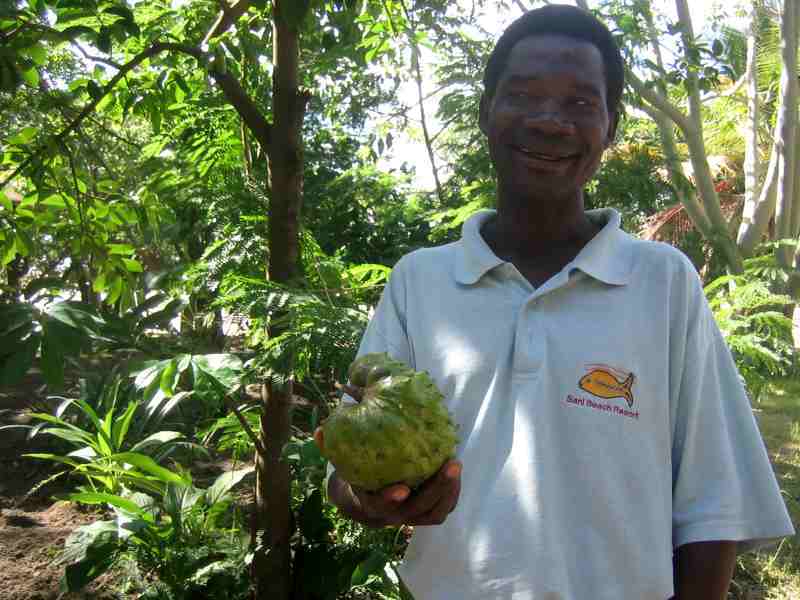
You don't see that kind of road kill in Canada

Ekke plays around with the camera and a flashlight

Saturday morning we went out of the lodge to a local restaurant, the Tophill, for their famous banana pancakes. The door wasn't open but one of the souvenir sellers went in and got them to open up. It took a while to get the pancakes but they were quite tasty. I think it must be some kind of tradition to have pancakes on the Saturday of Easter, isn't it? Like Shrove Tuesday there is Pancake Saturday. Anyway, back at the campground we watched people unloading huge speakers from the back of a truck and then at around noon they fired them up for an Easter Beach Party. Since the campground had nice clothes washing tubs we had a great time doing laundry to the dance rhythms pumping out of those speakers. Between laundry shifts, Lodie de Jager pulled into camp on his clean Kawasaki KLR650. He was from Naboom, South Africa and was heading to Germany on essentially the same route through Africa as we had just completed. (www.naboom2germany.co.za) He was very eager to pick our brains and we were looking for tips on touring Southern Africa. With the loud music it was difficult to hold much of a conversation so we decided to have a good discussion on Sunday.
Baboon on the beach
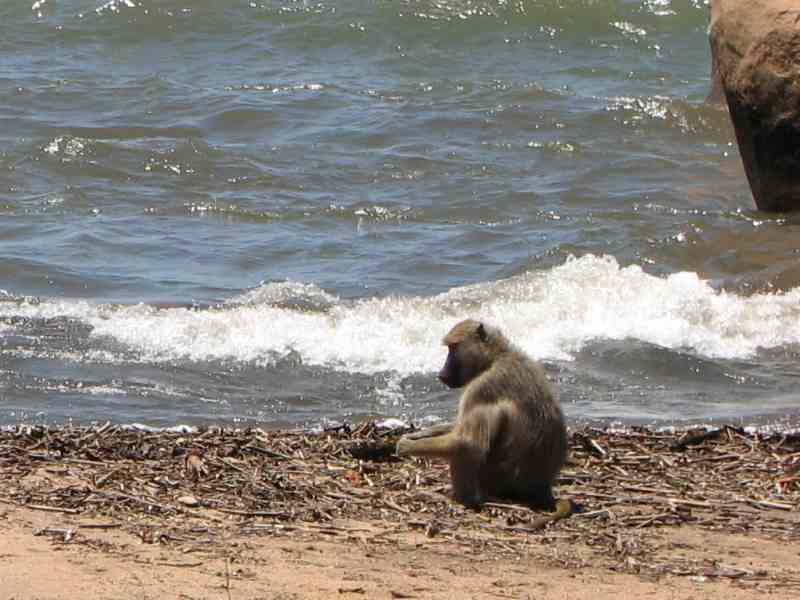
Easter Beach Party
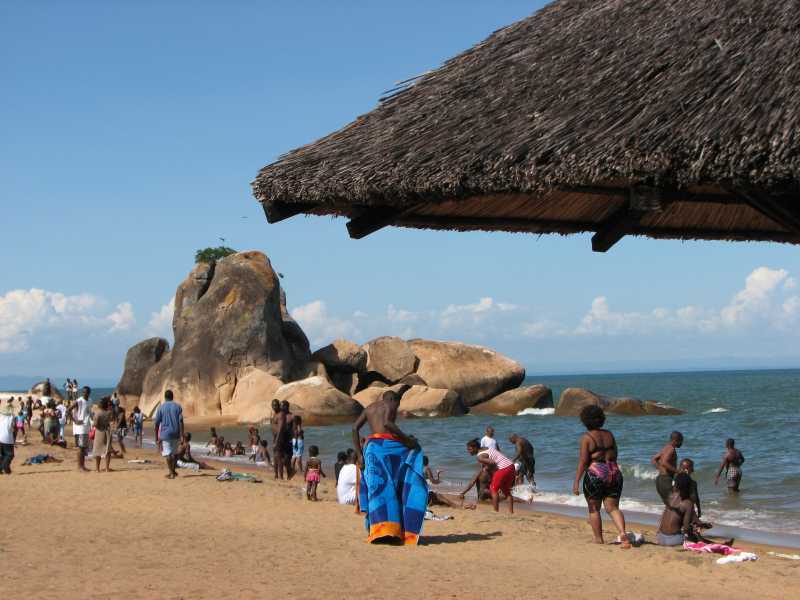
The lively beach party continued well into the night so it was quite late by the time we got over to the Livingstonia Hotel for their Easter Sunday breakfast buffet. Afterwards I did a minor tune-up on the R100GS as it had been running a little rough. I adjusted the valves, cleaned the carburettor float bowls and then synchronised the carbs by feel. We had a lot of fun sitting in the pounding surf of Lake Malawi in the afternoon, getting tossed around by the waves. The scraping of the sand was painful but a bad sunburn for me was the only real casualty. Over supper at the concession stand, we gave Lodie some suggestions for his northbound trek, even giving him the GPS co-ordinates for Audrey's crash site in northern Kenya as well as some good camping spots. Lodie offered to let us stay at his house if we needed to even though he will still be on the road when we get to that part of South Africa. Wow, how nice!
Easter Sunday Breakfast

During breakfast on Easter Monday we had to keep the baboons at bay so that they wouldn't mess with our stuff. They went rampaging around the now deserted campground overturning garbage cans until the staff started using a slingshot to pelt them with rocks. We said goodbye to Lodie and wished him a safe journey, knowing that he would be in for a grand adventure. For us the travelling was much easier now, more touring than adventure riding. To prove the point the ride to Lilongwe was wonderful with a good road twisting up into the hills. First we decided to pick up a souvenir. Malawi is known for its wood carvers so we stopped off at a little market to select something of interest. A beautiful rhinoceros carved out of ebony really caught our eye. As was becoming usual in Malawi we were short of funds so when the sellers asked for 3,500 kwachas we said, in all honesty, we don't have that much. With some serious bargaining, even firing up the bikes and almost riding away, we (I should say Audrey) managed to get them down to 1,700 kwachas ($12). With the rhino carefully packed into Audrey's tankbag we rode to Lilongwe, arriving in time to have lunch at a Steers hamburger place. What was most surprising was that the restaurant was in a strip mall that looked for all the world like the Avenida Shopping Centre in Calgary. Yep, it's getting more Western as we go south. We found the Lilongwe Golf Club and as per the GPS they did indeed have a campground. Nicely tucked into the back we were the only ones there so it was very quiet. As we had climbed to 1,100 metres it was rather cool in the evening and we broke out the sleeping bags for the first time in a long while.
Having a cup of coffee with Lodie
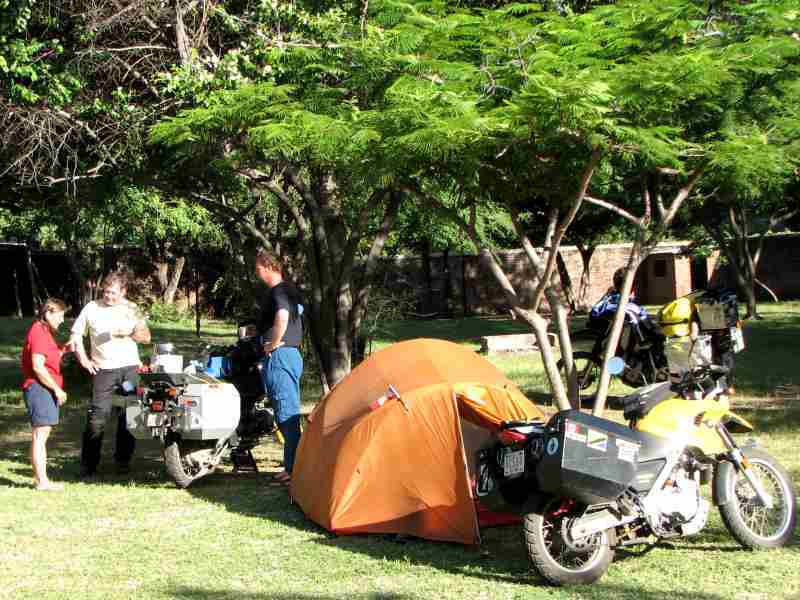
Our big tip for Lodie: Pack lighter!
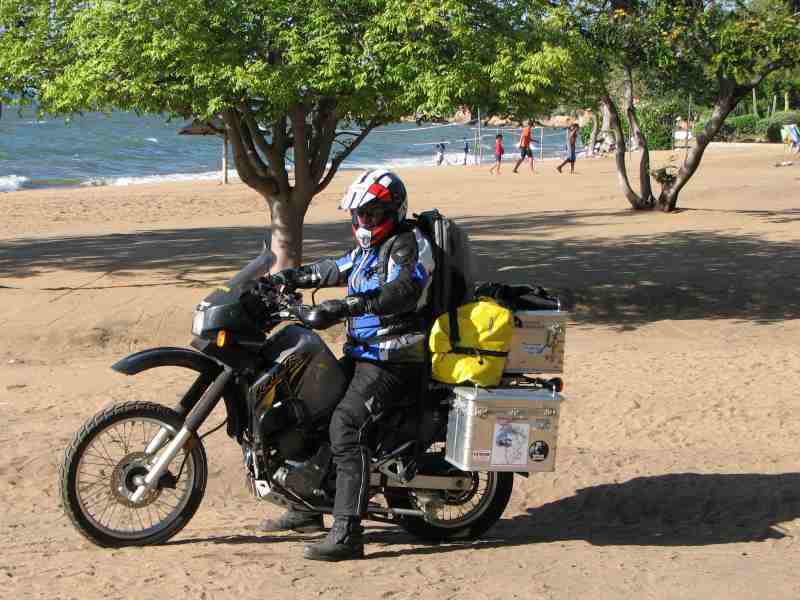
Rampaging baboons at breakfast

OK, what the heck does that mean?
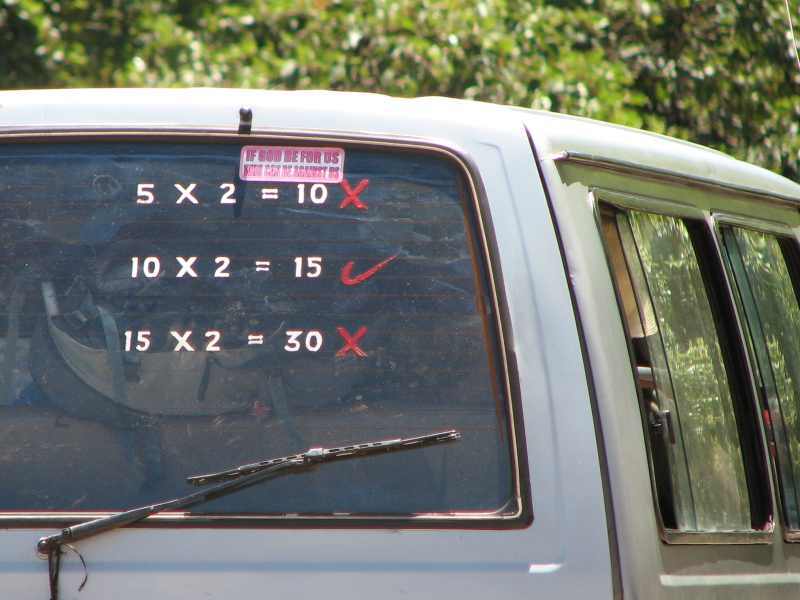
Enjoying some fine riding in Malawi
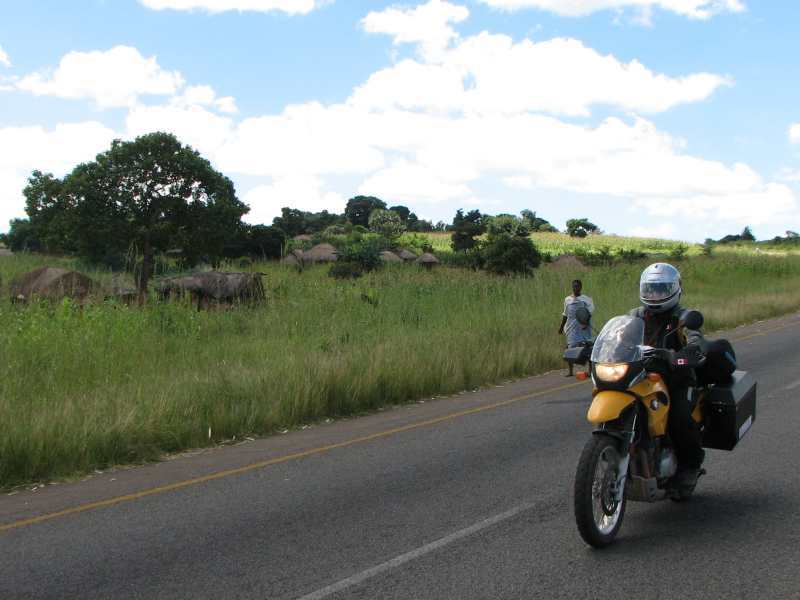
A Malawian village along the road to Lilongwe
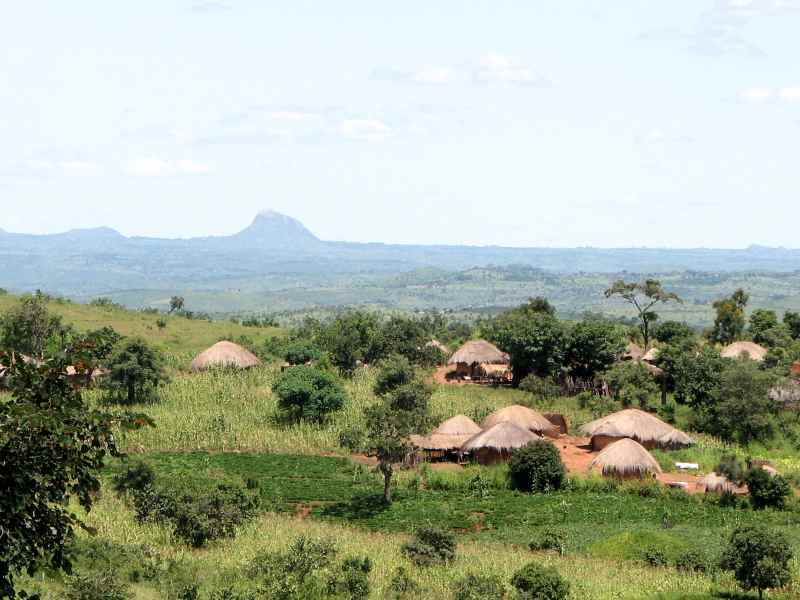
Time for a burger

Tuesday morning the golf course staff found us a box to put our rhino in and then we went to the post office to mail it. By noon we were ready to depart and headed off in the direction of Zambia. Lilongwe was a remarkably easy city to ride in, probably because its population was only about 250,000, so we were on the highway very quickly. A beautiful ride in perfect weather, sunny and about 25 degrees, had us arriving at the border in a couple of hours where it was easy to get stamped out of Malawi. We had really enjoyed our time in Malawi, happy that we could get some beach time in on the famous lake despite the rain in the north. The riding had been fun with nice paved roads and challenging dirt sections thrown in. Even the name of the currency was fun! Kwacha!
Maps of our route through Malawi
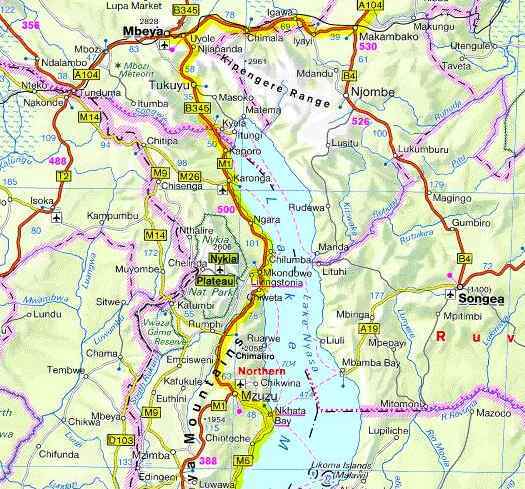
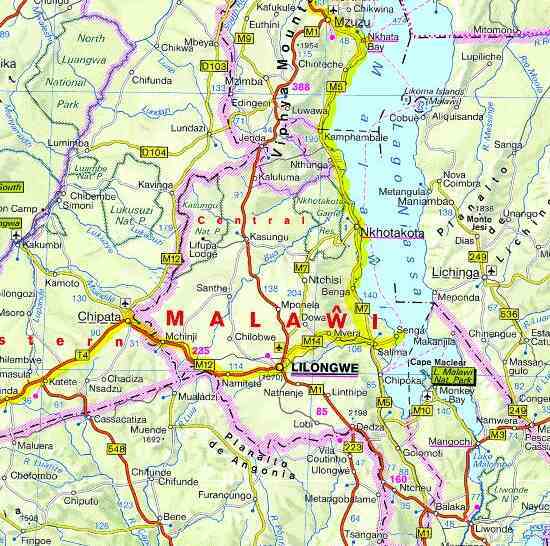
The border crossing into Zambia was straightforward, and we only had to wait for one official to get back from a lunch break. The black market guys hovered around like vultures, with fistfuls of kwachas, trying to get us to trade our Malawi kwachas for Zambian kwachas at a bad rate. As you know Ekke loves to say 'kwachas' so he was delighted to discover that the currency in Zambia was also kwachas. Lucky for us we knew the exchange rate, as we would have gotten totally ripped off by the black market guys. The border officials wanted $50 US for a tourist visa, and wouldn't accept Zambian kwachas. The carbon tax was a bit of a surprise, 50 000 kwachas ($15) for each bike. Judging by the black smoke belching from a lot of vehicles, we could see that the money was being put to good use.
Entering Zambia
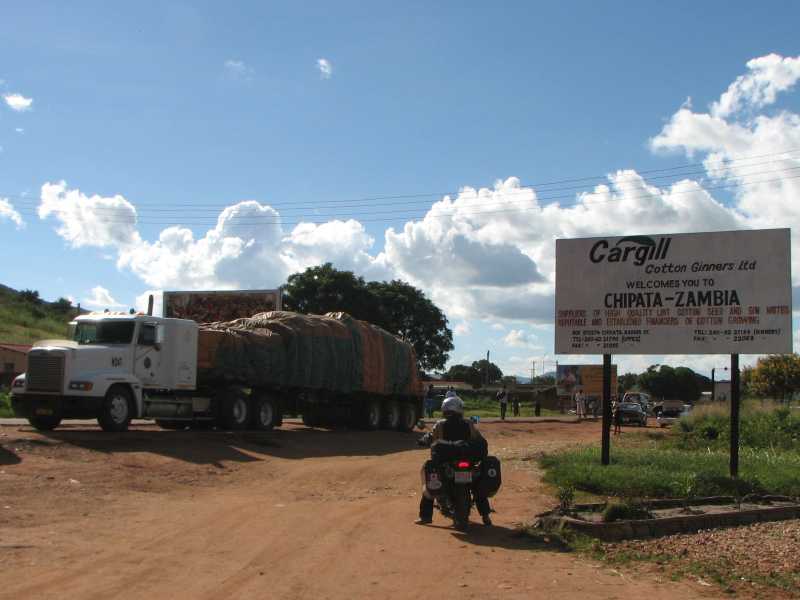
Not like the Safeway stores at home...

Mama Rulas Campground was quite a nice place, with great facilities. Ekke had another encounter with the 'hold-back' and had to ask for change after buying a couple of ginger-ales. Just as we were enjoying our own cooking, we heard the familiar roar of a truck - a group of overlanders was pulling in. These 15 seat vehicles usually carry a raucous group of youngish people across Africa, and this one was no exception. They pulled up right close to our tent, the only one in a four-acre field, and then they started putting their tents up all around ours. As we weren't that interested in partying with 19 year olds from the UK, we took our tent down and moved to escape the noise and music. Maybe us 40-somethings just appreciate a good night's sleep.
Roads in Zambia were fairly good in some parts and terrible in others. Sometimes a paved, narrow two-lane road had a speed limit of 80 kph, and at other times a paved, narrow two-lane road had a speed limit of 120 kph. Tarmac roads went from perfect blacktop to potholed messes. But, at least the weather here was perfect, with every day offering sunshine and blue skies. Riding was often effortless as we wound our way through small forests and past fields of maize and sugar cane. Roads were dotted with small towns with tiny wooden or brick shops, but occasionally a bigger place would have a Shop-Rite, a real grocery store. We could feel ourselves slowly getting into a more 'civilized', if you will, Africa. Still lots of thatched huts, though but some with a modern touch.
120 kph speed limit seems unrealistic (mowing roadside grass is done by guys with machettes)
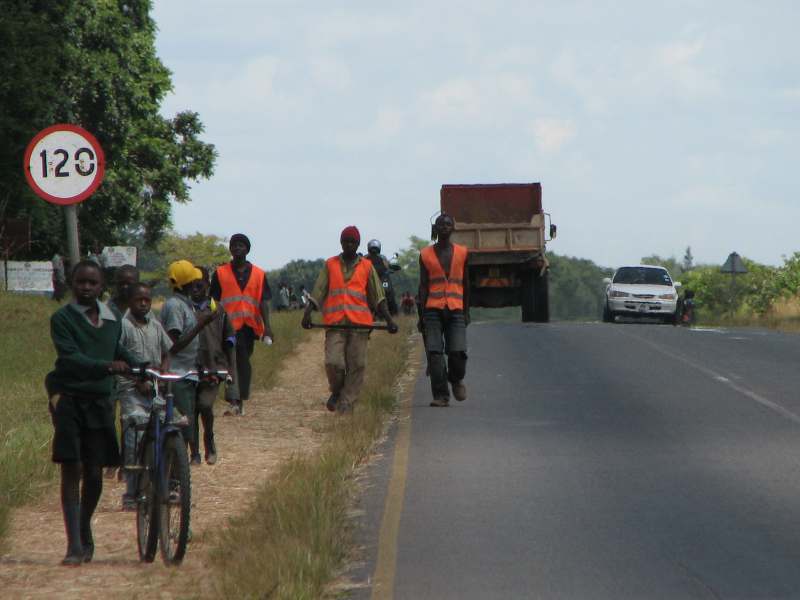
They're probably watching 'Desperate Housewives'
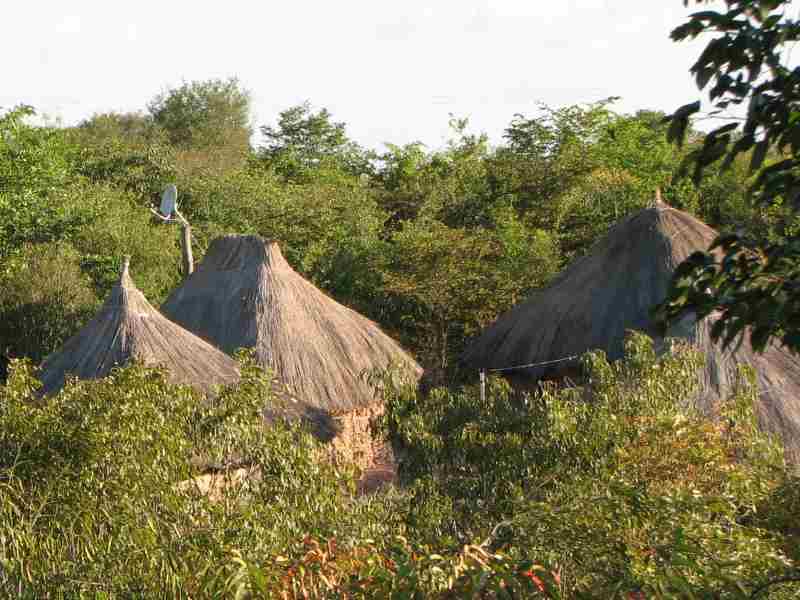
Ekke and I approached the Luangwa Suspension Bridge, an impressive structure over the Luangwa River. A car ahead of us had his flashers on, but we didn't know why. About halfway across, we could just see the other side of the bridge, and standing there were two men with guns. When we got closer we could see that it was another military checkpoint. One of the soldiers told us in no uncertain terms that we should have come across the bridge one at a time. He was a bit angry. Ekke was asked where we were from, and if Canada was a beautiful country, and was it more beautiful than this. I think the guy was trying to get us going a bit but Ekke didn't fall for it. In these situations I just say I have earplugs in and can't hear them, and usually they stop talking to me. Ekke just maintained a positive attitude and they eventually let us go. Later, when talking to the campground owners up the road, they said there was no sign indicating that one must cross one at a time. They also said that if people got angry about it, then the soldiers asked them for money.
Bridge over the Luangwa River
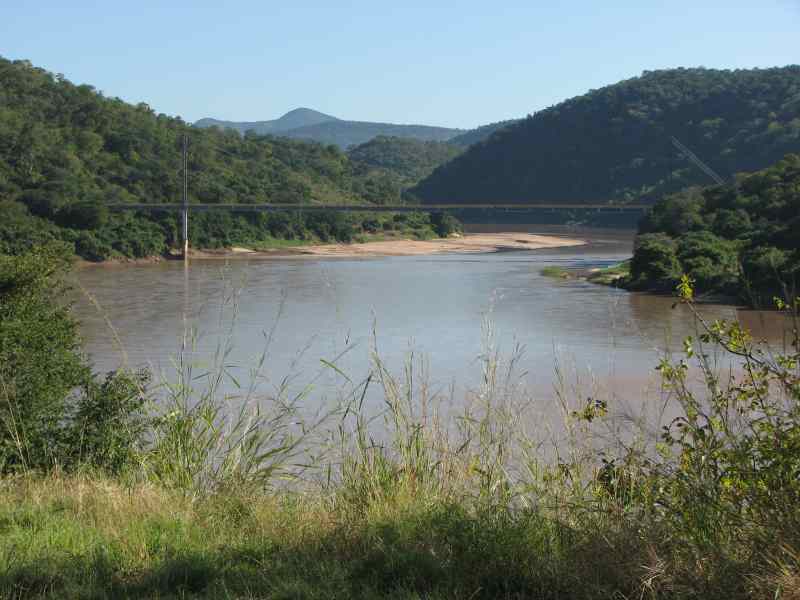
Fine riding in Zambia

Ekke throws rocks at Mozambique (across the Luangwa River)

The capital of Zambia, Lusaka, was a pleasant place. We immediately sniffed out a shopping mall with a Super-Spar, a huge grocery store. Prices for food were similar to those in Canada but occasionally an item had a ridiculous price on it. A certain deodorant that I really wanted, and hadn't seen for months, was 43 000 kwachas, or $14.00! I actually considered buying it but then quickly came to my senses. We spent some time at a fast and reliable internet cafe, such a difference from the slow ones we'd been living with for so long. It still took a couple of hours just to take care of emails (sorry if we didn't reply to yours yet - we still love to get your feedback about the website). Super-Spar had a fabulous bakery, and we eyed a couple of Bavarians, a type of creampuff. We couldn't wait, and ate them out by the bikes. A woman came by and asked about our trip, saying she was really impressed. I'm sure she noticed us just quaffing the cream puffs, so I explained to her that we hadn't had them since Germany. "I can tell," she laughed. After cleaning cream off our faces, we rode to Eureka Lodge and Camping, just south of the city and surrounded by a game park. Many lodges here have excellent camping facilities, and always a convenient restaurant. Great for us as the days of $15 hotels are over.
A shopping centre by the side of the road
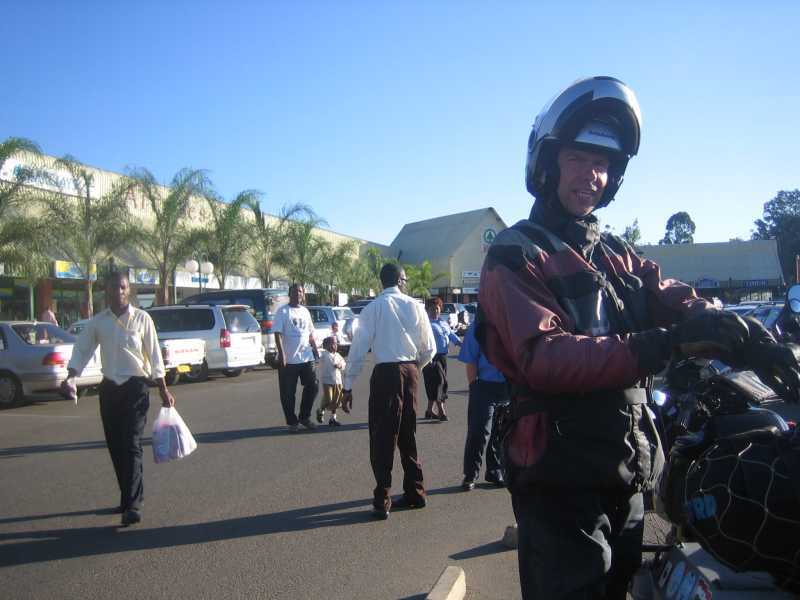
Another shopping centre by the side of the road
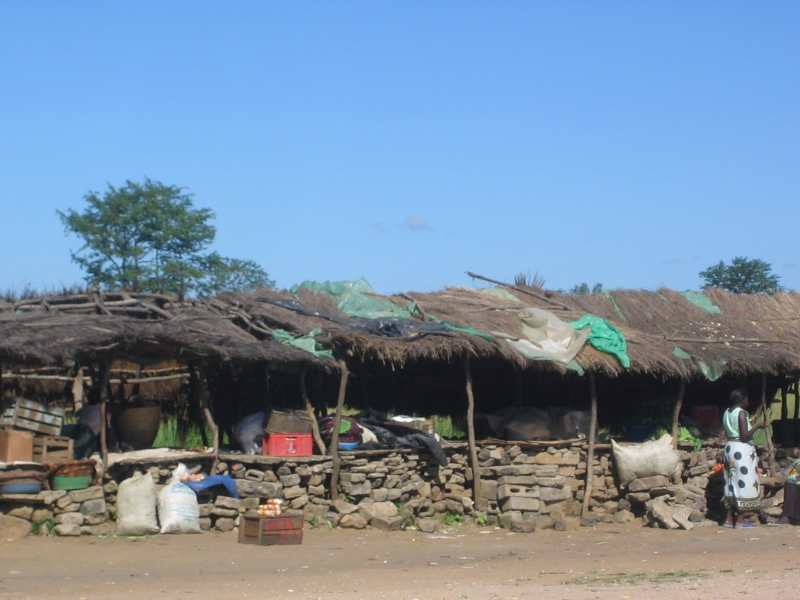
Beautiful main building for the Eureka Lodge

The ride in the direction of Livingstone was pleasant, with bushy trees, tall grasses and palm trees lining the paved road. There were a few police checkpoints, some with a gate, but most with a police officer just waving us on. At one such checkpoint, two officers came from under the shade of their tree and held up a hand to stop us. One guy started asking me questions but I gave him my earplug spiel and he went away. The other guy asked Ekke the usual questions, and then he said something strange. He said that he had read in the newspaper that white people don't drink Coca-Cola. Then he asked Ekke why white people don't drink Coca-Cola. Ekke gave his head a shake and said, "What? What kind of question is that?", and the guy repeated in a loud, annoyed voice, "Why don't white people drink Coca-Cola?" pointing to a can of Coke under the tree. Ekke said, "I drink Coca-Cola". The guy said, "Is that your wife?" Ekke said, "Yes. And she drinks Coca-Cola, too!" We just waved and tentatively rode away, hoping they wouldn't call us back, wondering what would have happened if we had said we drank Pepsi…
Lots of people use the road in Zambia

Good to know that charcoal is available when you need it

The first 300 kilometres of the road from Lusaka to Livingstone were on excellent tarmac with only a few pedestrians and cyclists to watch out for. We made such good time that we thought this ride would be a breeze. After that, a few potholes started appearing, but were easy and even fun to avoid on the motorbikes. It was almost like a game, swerving for one, swerving for another, slaloming down the road as if we were skiing the Grizzly Bowl at Lake Louise. Road conditions went quickly 'downhill' after that. Potholes increased in size and number until at one point there was more pothole than pavement. Big trucks had just chewed up the tarmac, and were also doing the slaloming thing, though a little less gracefully than us. More like snowplowing down the bunny hill. We knew that if we saw dust up ahead that we would be in for a new set of potholes. But at one point we saw a tower of dust in the distance and it just didn't get any closer, even as we rode toward it. Wait a minute. That wasn't dust. That was mist. Mist from Victoria Falls, still 30 kilometres away! We knew the falls were putting out a lot of water this time of year, but this was amazing.
A minefield of potholes, tough to avoid when they lurk in the shadows
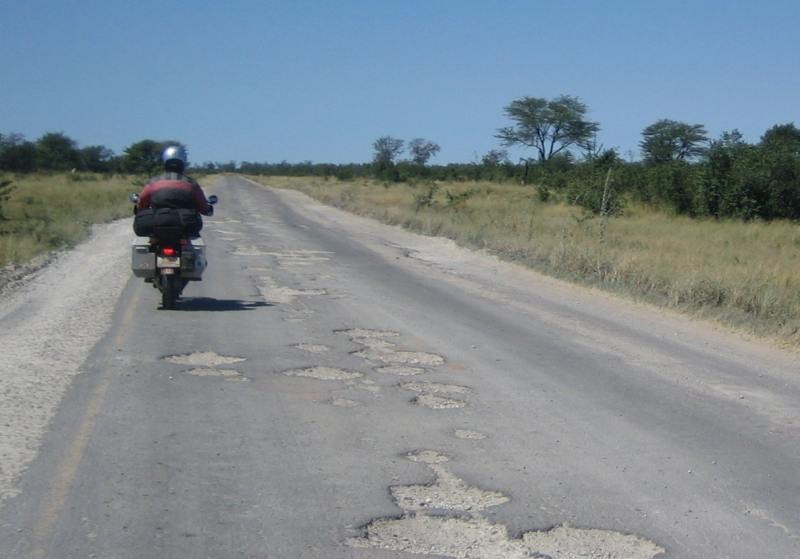
Still ten kilometres from Victoria Falls (the smoke that thunders) in the town of Livingstone
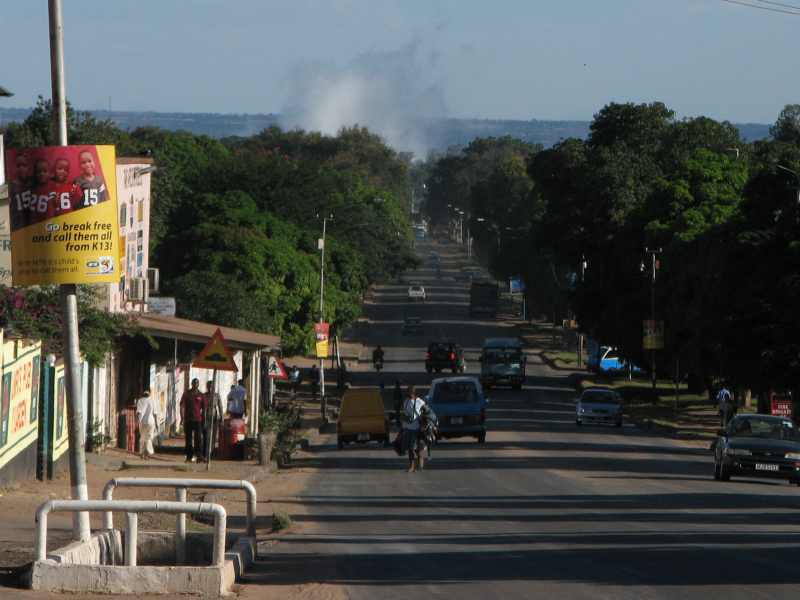
Someone did something right when they labeled Victoria Falls one of the Seven Natural Wonders of the World. From a lookout point we could see the mist rising from the falls, locally known as Mosi-oa-Tunya, the 'Smoke That Thunders', in the Kololo language. Being here at the end of the wet season did have its advantages, such as watching the billowing towers of mist and listening to the thundering roar of the falling water. The problem with the huge volume of water was that we couldn't see the falls very well because of all the mist. This left us with a bit of a dilemma. Should we go over to the Zimbabwe side of the falls or not, pay for visas, and risk just seeing more mist? Also, it was Election Day in Zimbabwe, and apparently things could get volatile over there, since the country was crumbling, politically and economically. Our campground host at the Livingstone Safari Lodge told us that the best views of the falls would be from a helicopter. He also confirmed that with the current high levels of mist, you couldn't see much from the Zim side anyway. We rode the few kilometres to the Zambian side of the falls and started with a hike upriver. It was great seeing the waters of the wide Zambezi River, just flowing along, until suddenly, the cliff edge appears, the water falling 108 metres to the bottom. We walked around to the ridge across from the falls. The guy renting raincoats was our first clue that it was going to be wet. The drenched hikers coming up the path was the second clue. The stone pathway took us along a high ridge, right across from the 1.7 km wide falls. The noise was deafening as one million litres of water per second dropped over the edge. And then we felt the mist. But it wasn't so much mist as torrential sheets of water bombarding us from all sides. There was no escape as we got pelted from above, behind, beside, and even from underneath. What luck to have a beautiful, sunny day so that in the end, being wet didn't really matter that much. What worried us a little bit was all the Zambezi river water we ingested. It felt like getting dunked in the swimming pool just one too many times. All we carried were our cameras, Ekke's in a trusty Ziplock, and mine in a MEC waterproof sack. A change in the breeze meant that occasionally there was respite from the rush of water, and we could take a picture. When the mist cleared from the falls, it was an awesome sight. We fought our way through a deluge of water across a footbridge that was really high up. It took us over to another ridge with a sheer drop, called the Knife Edge. The rocky footpath was often covered in green slime and was a little slippery. Someone had thoughtfully put in a few short, rocky pillars and attached a knee-high length of chain to them along the edge. More reassuring than having nothing there I suppose, but I don't think it would stop anyone from going over the edge. It was all there was between us and the drop-off into the Zambezi. But over on the Victoria Falls Bridge to Zimbabwe we could see people voluntarily jumping off. The bungee jump is the third highest in the world. Not for me, but hey - I'm riding a motorcycle through Africa. How much more excitement do I need?
Just upstream from the falls
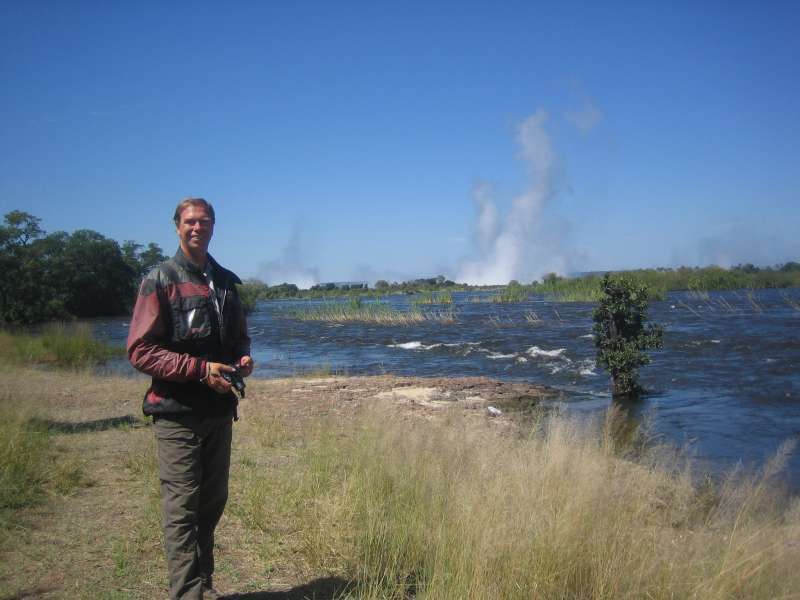
Big dropoff just a few metres away
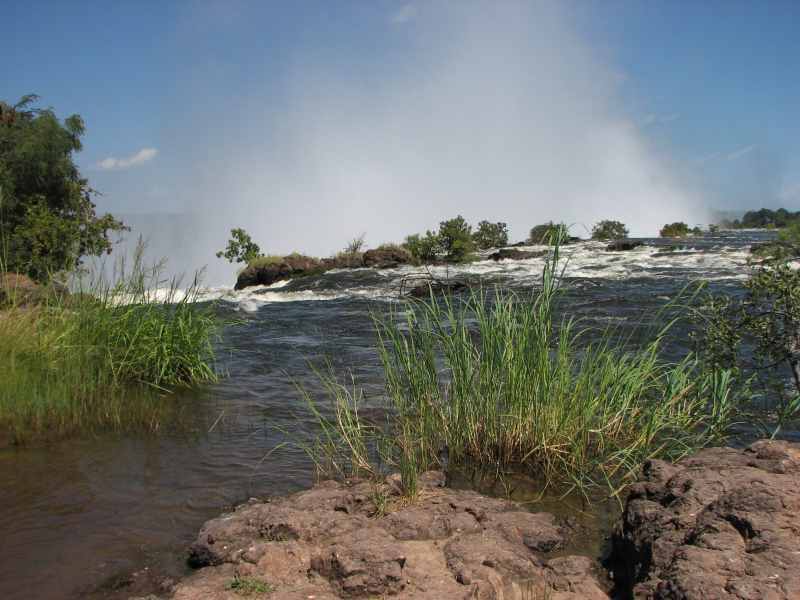
A first glimpse of Victoria Falls
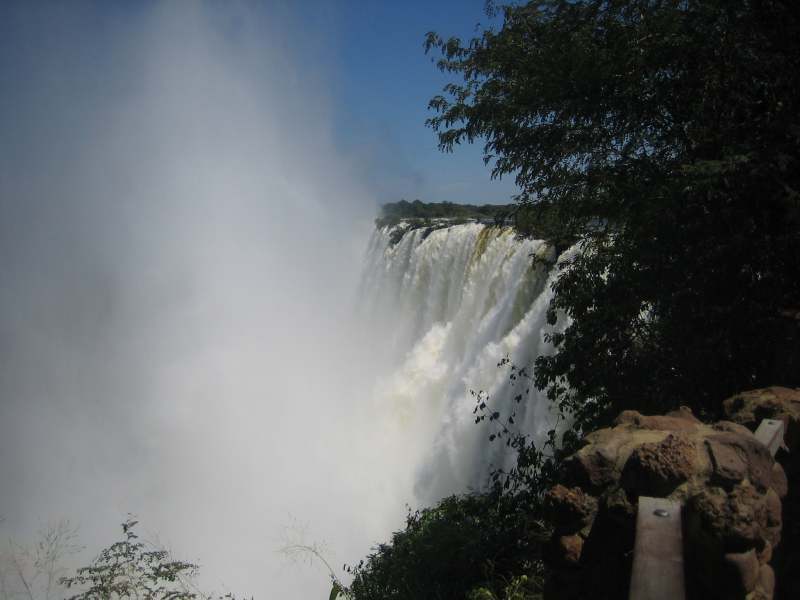
So much mist
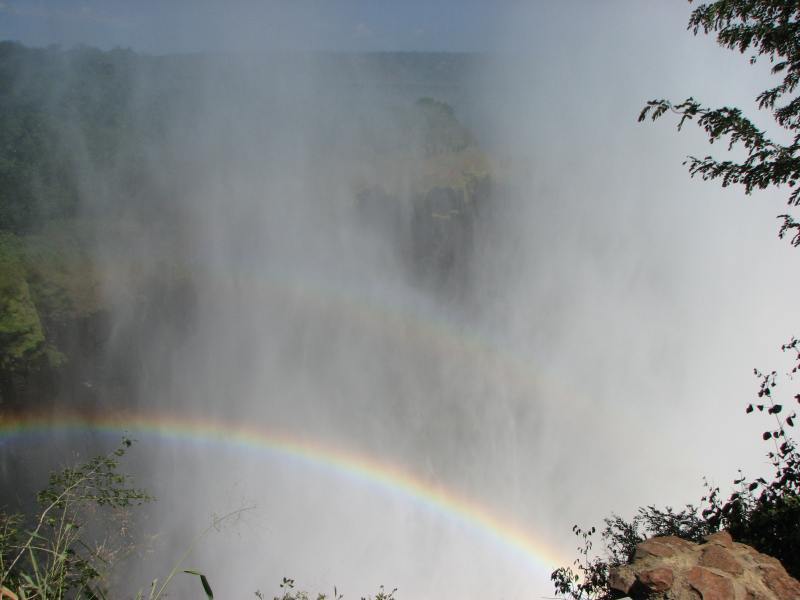
Completely soaked within 3.62 seconds!

People wearing raincoats weren't having nearly as much fun
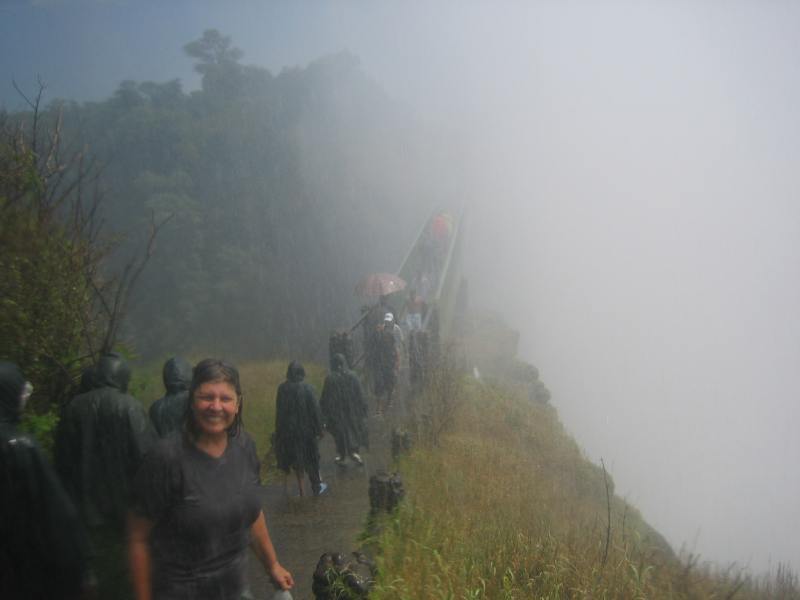
Where people bungee off the bridge to Zimbabwe

Don't slip on the slimey walkway

The mist lifts for a while
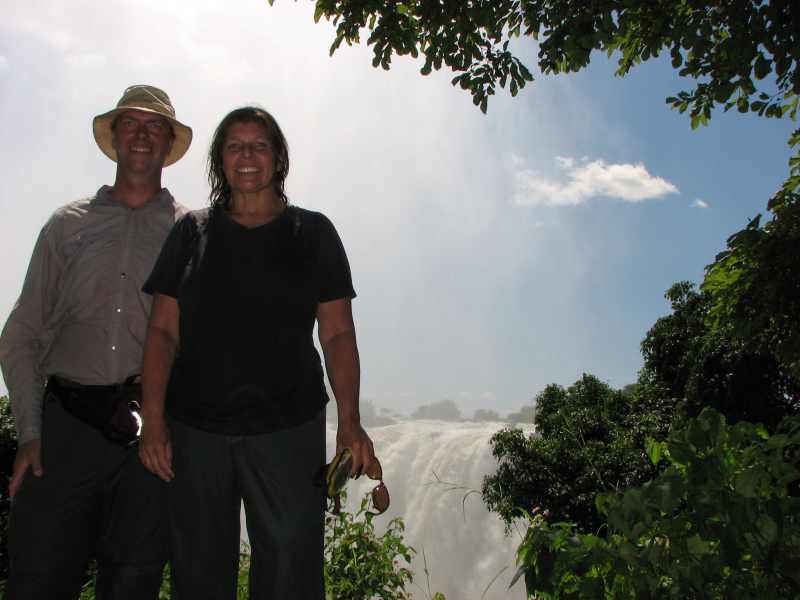
All kinds of creatures enjoy the falls
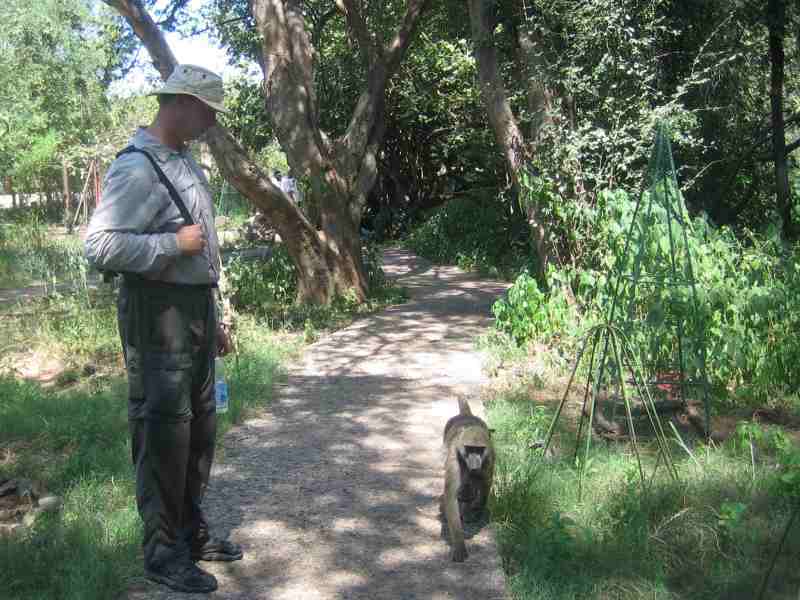
Footbridge to Knife Edge
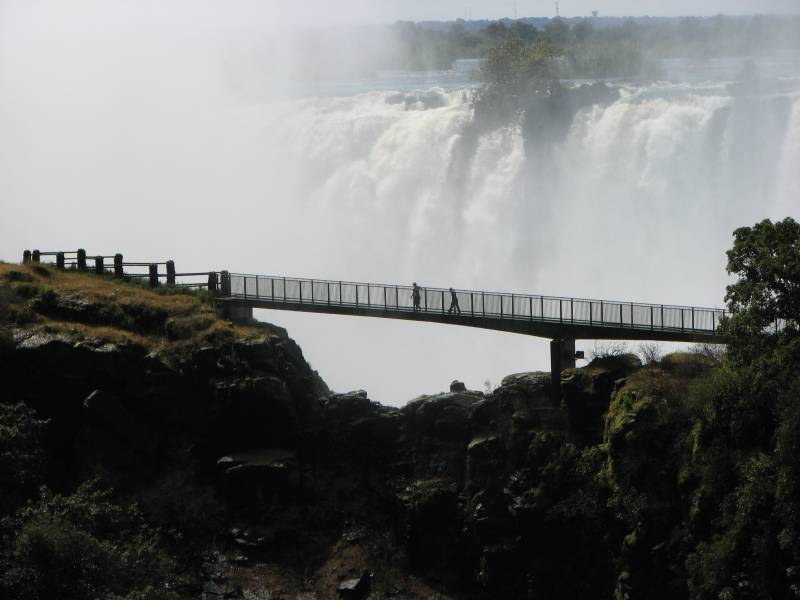
The falls could only be seen a little at a time because of the mist
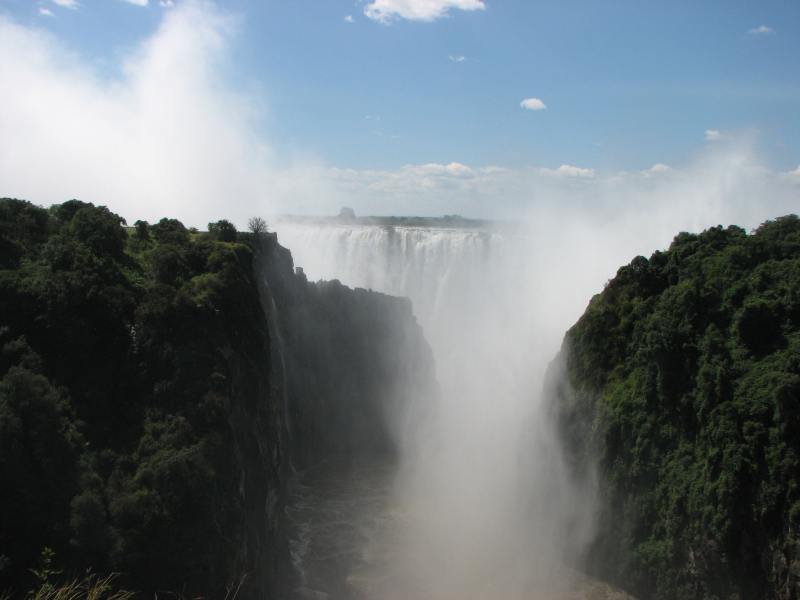
So we didn't go to the Zimbabwe side of the falls, but put the visa money toward a helicopter ride, which came out cheaper in the end. I had been in a few helicopters before, in my Alberta Forest Service summer job, but this was Ekke's first. Any apprehension that he had about riding in a helicopter was soon dispelled when he saw the beautiful looking machine. The professionalism of the pilot also did a lot to raise his confidence that all would be well. After she gave us some safety tips, we were on our way. The lift off was smooth, and before we knew it we were cruising over fields and hotels, heading toward the mist. The chopper flew along the Zambezi River and we followed it from our perch in the front seats, looking straight down. We approached the edge of the cliff, closer and closer. And then the river was gone, having dropped off the edge in a turmoil of water and spray. The chopper circled around and we got a complete view of the whole length of the cliff, all 1.7 kilometres of falling water. What a great perspective. The falls were gorgeous from all angles as we did more circling and figure eights. I could have stayed up there all day, but we had only paid for 15 minutes of chopper time ($100 each). On the way back, our pilot pointed out an elephant lumbering along beside the river. Does this qualify as another type of safari, the 'Helicopter Safari'?
Getting ready for a great chopper ride
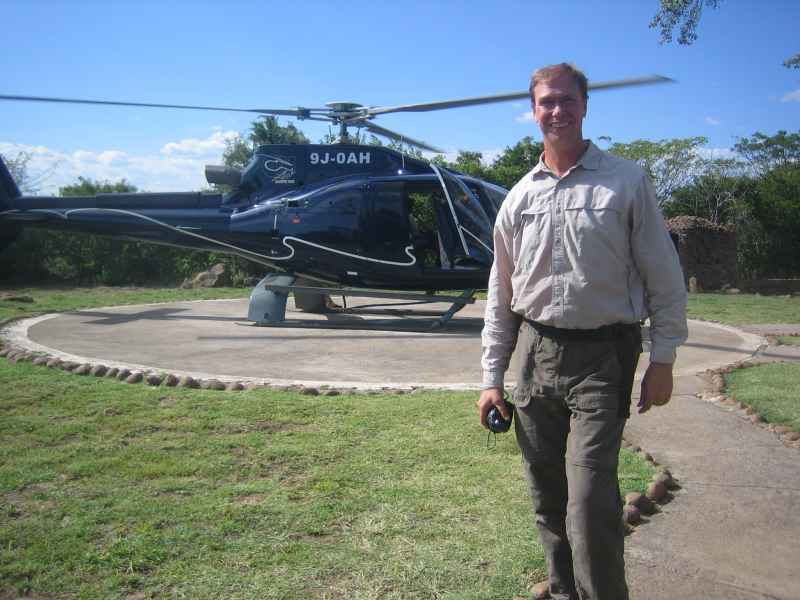
Audrey sits in the training seat and is instructed not to touch any buttons or levers
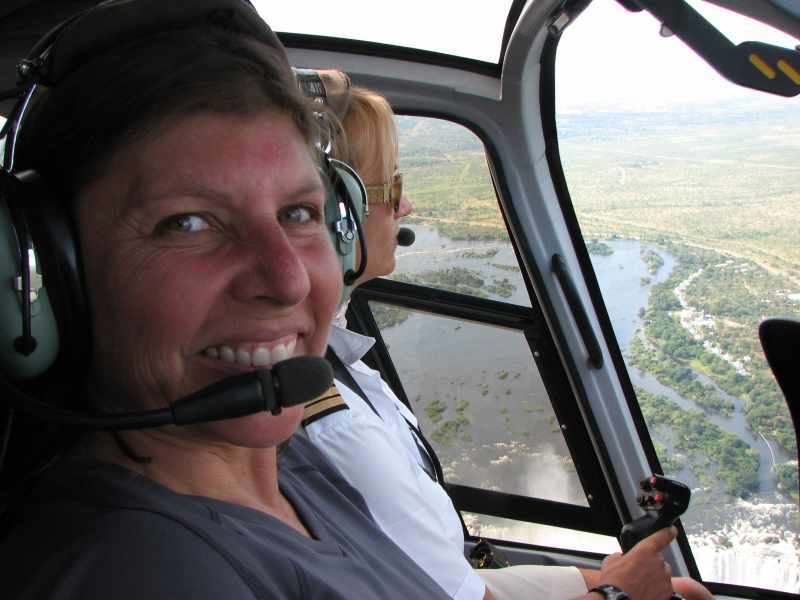
Flying toward the falls

Approaching the edge
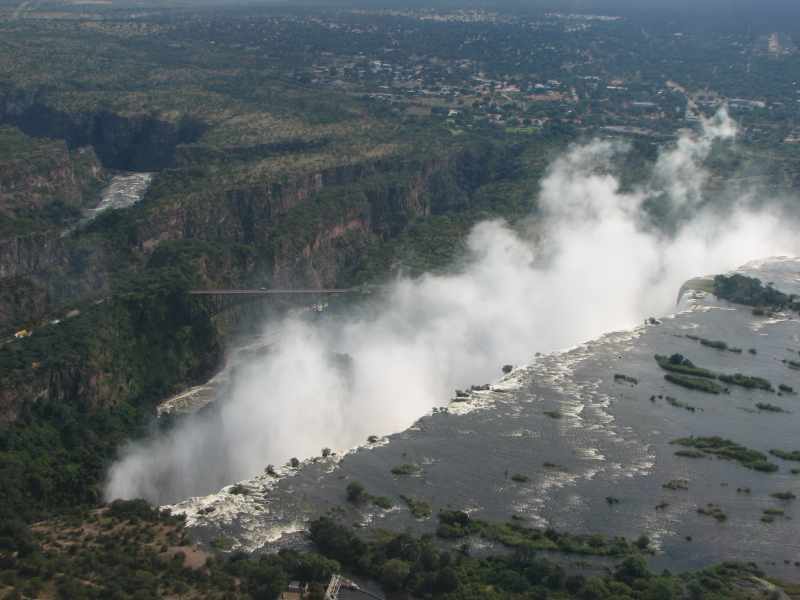
Bridge to Zimbabwe
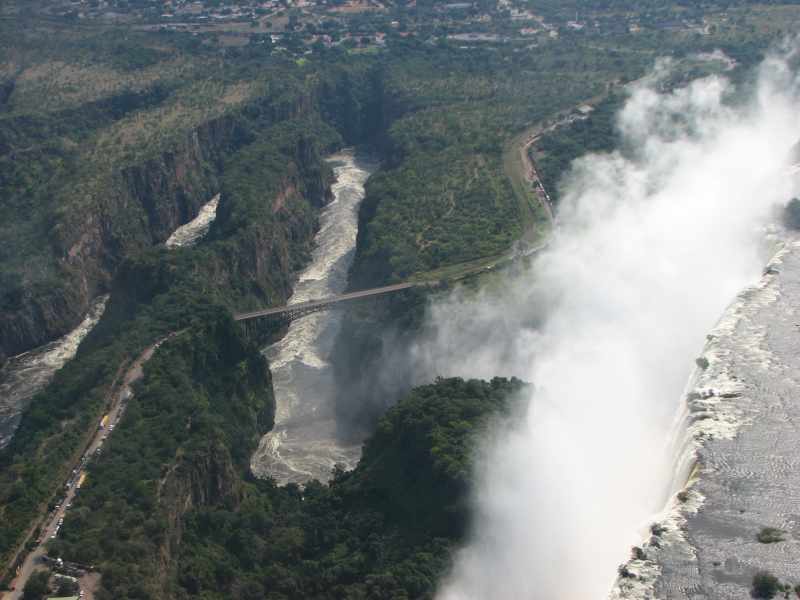
A great perspective
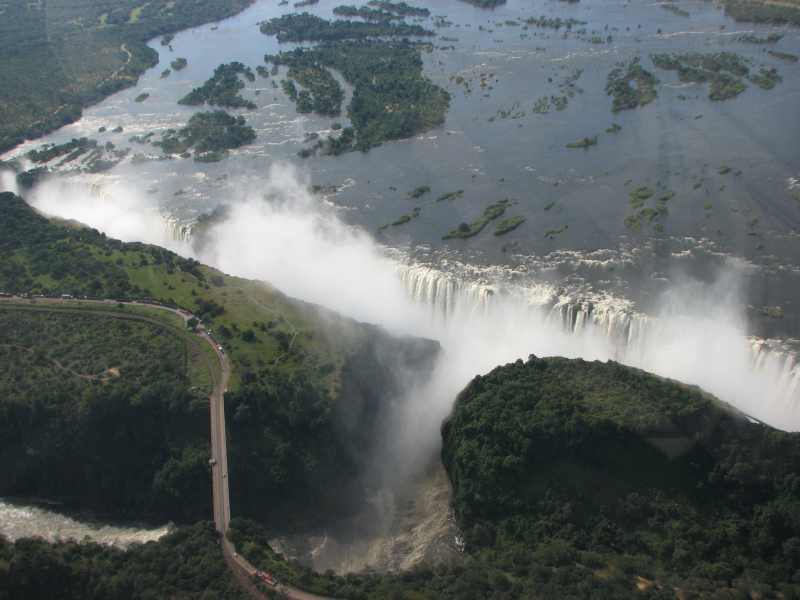
Livingstone Island on the left is where David Livingstone first saw the falls

Sometimes the mist clears for better views
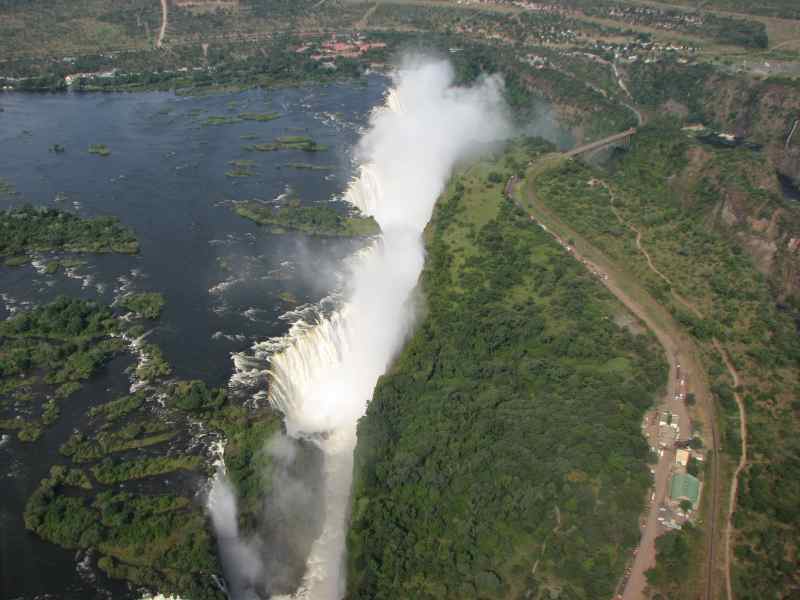

A long way down

Ekke enjoys the flight
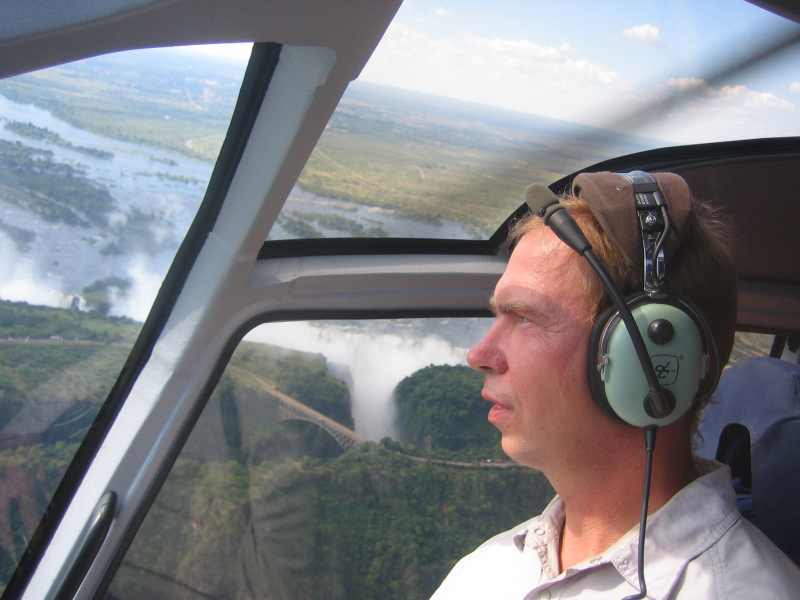
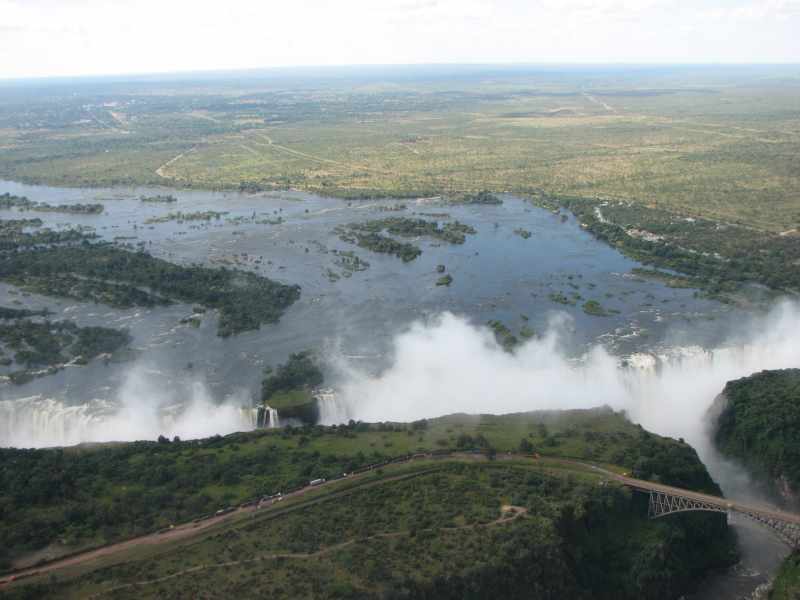
A birds' eye view
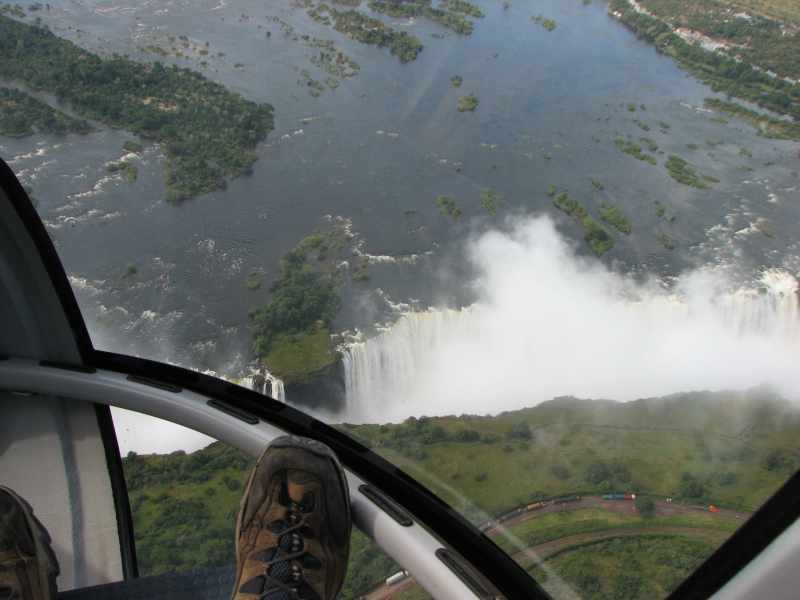
Helicopter safari
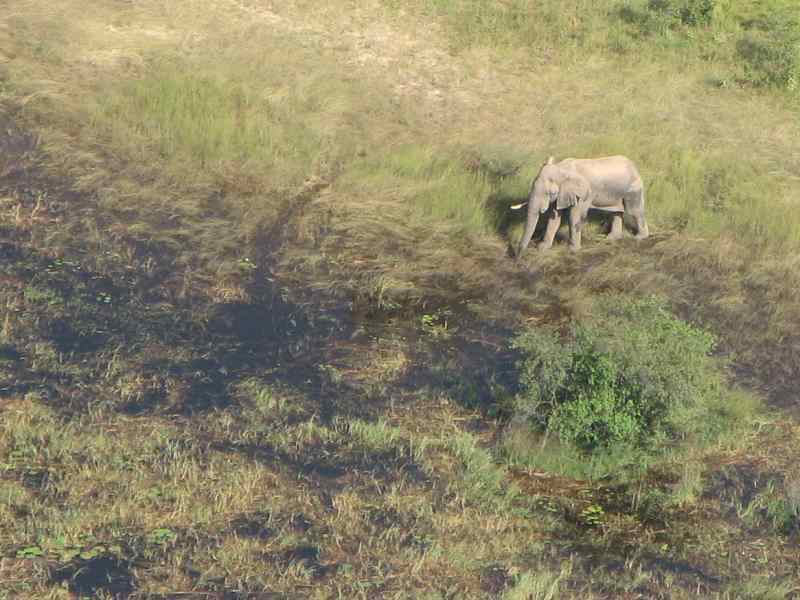
One last look before landing
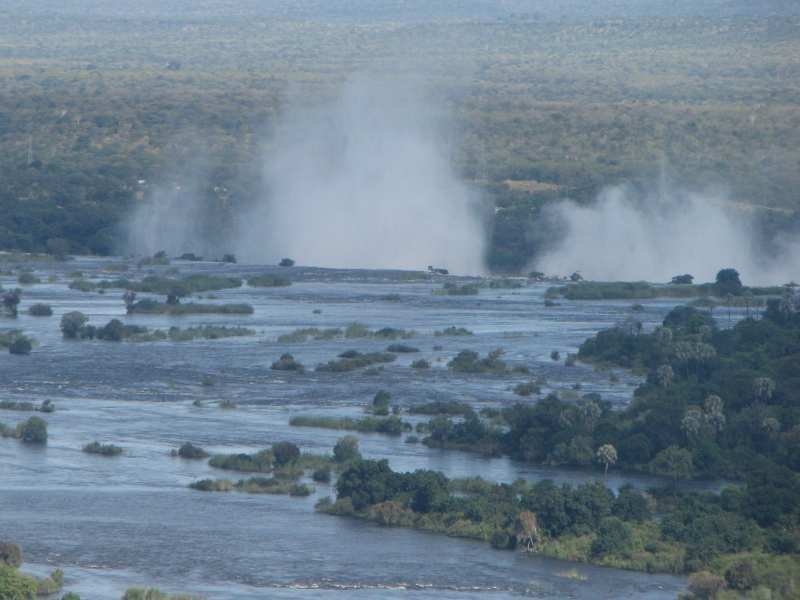
Just as we were packing up to leave for Botswana, Ekke noticed that my rear tire was really low again. We decided that we could try to get it fixed in Livingstone, and then see if we had enough time to ride. Not being able to find a tube in my tire size, we opted to just get a patch. Ekke took the wheel off the bike, and a guy at a gas station 'tyre' repair shop fixed it for us, for 12 000 kwachas ($4). We decided to stay another day, found Rhapsody's Cafe with its long, cool drinks, and worked on the website. What a life!
Breaking the bead
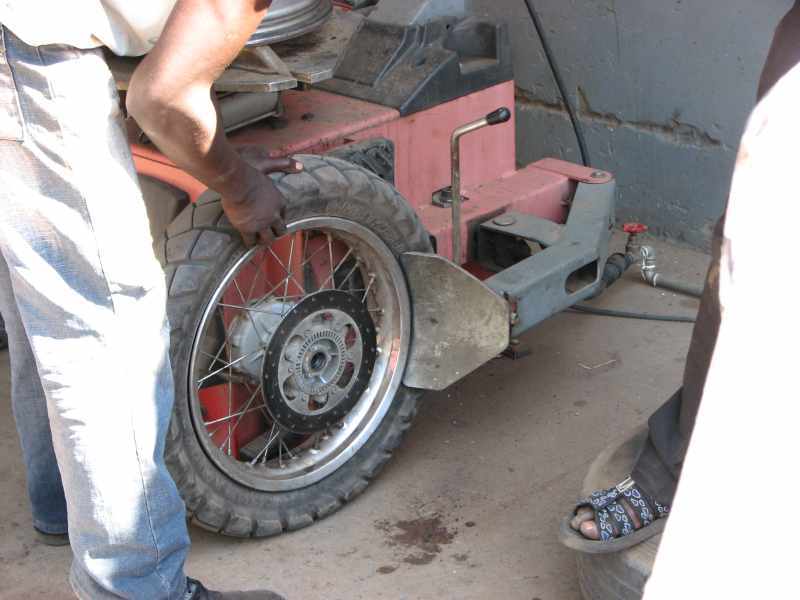
By staying another night we had the pleasure of meeting Andy and Suzanne from Germany. They were riding around Southern Africa on a Honda Africa Twin and a dirt bike. We were chatting about where we were from, when Andy said, "Do you know...?" We immediately thought of those times where as soon as we said we were from Canada, someone would say, "Oh, I have a cousin in Montreal," or "Do you know my aunt in Toronto?" This time, when Andy said, "Do you know Dave Anderson?" we were a little flabbergasted. We did know Dave Anderson. He's the owner of Anderwerks, a BMW shop in Calgary and had helped Ekke do some work on the bike before we left. Andy had met Dave at Intermot in Köln, through Wolfgang, a motorcyclist who shares his time between Canada and Germany. Small world. But I guess when it's the motorcycling community, the world is small. Andy and Suzanne were just off to the police station in Livingstone. They had been caught riding without helmets, and had to prove to the police that they actually had safety gear with them. Ekke and I left Livingstone Safari Camp the same morning in the direction of the Botswana border. We had saved up some kwachas because we didn't know what the exit fees would be. It turned out we only had to pay 10 000 kwachas ($3) to pay for using the roads in the county so we had a lot of kwachas left to change at a bank in Botswana. The ferry over the Zambezi River was just arriving. Loading was a bit exciting, riding through the river to get to the ferry ramp. We knew we were upstream from the falls, and really hoped that the ferry wouldn't run out of gas halfway across.
Andy and Suzanne head off to the police station
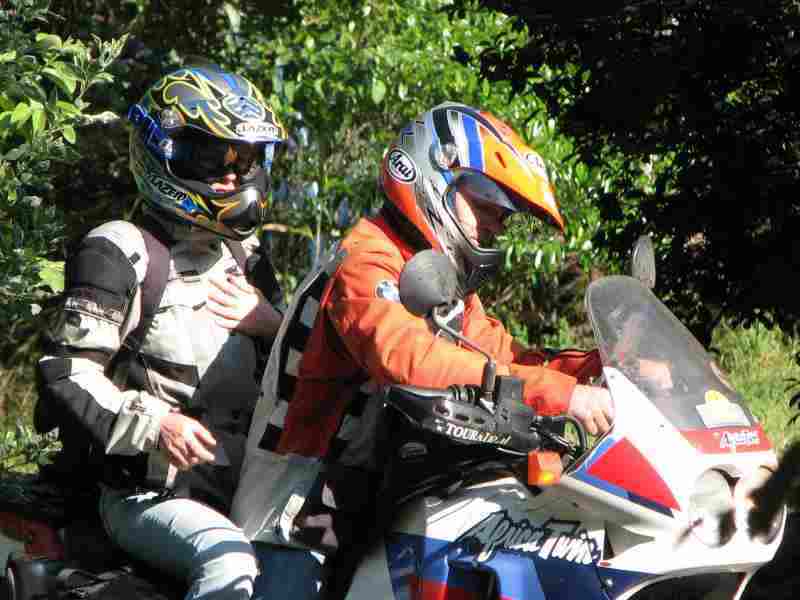
A little dip in the Zambezi on the way to Botswana

Maps of our route through Zambia

If you look closely you'll see the GPS track of the helicopter flight! (Get out the magnifying glass)
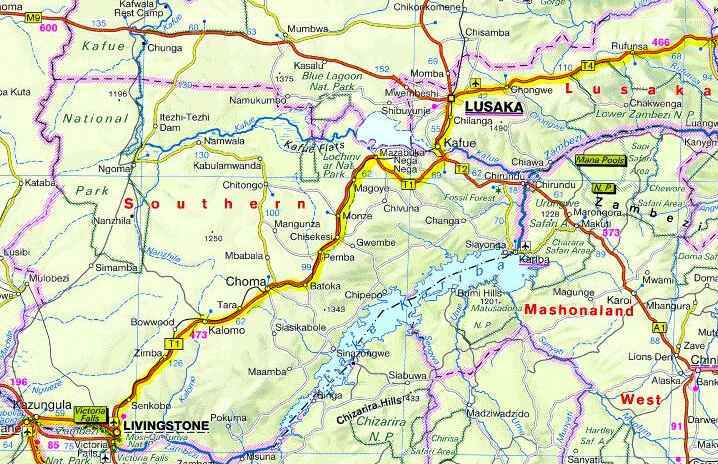
We didn't know it at the time but our little dip in the Zambezi was a perfect introduction to Botswana. As the ferry crossed the river we came to a point midstream where four countries, Zambia, Botswana, Zimbabwe and Namibia, came together. This was the shortest border in the world; Zambia and Botswana only touched at this one point. The Botswana side of the river didn't have any black market guys approaching us to change money as they had on the Zambian side. We didn't think much of it though and continued a few hundred metres to the border post. Wow, this was our easiest entry ever. It took only a few minutes to get the passports and carnets stamped and we were out of the office. We got on the bikes and rode away. Just past the office was a dipping pool where it was necessary to drive your vehicle through to stop the spread of foot and mouth disease. As I was taking a picture of Audrey riding through the puddle a fellow approached me and asked if I had paid the road permit. Since there had been no sign and no one had told us to buy a road permit we hadn't. Calling Audrey back from the other side of the pool we went back into the customs office to an unmarked wicket where a man was sitting behind a plate glass window. He told us the road permit would cost 70 pulas each. The only other currency he would accept was South African rand so our U.S. dollars and Zambian kwachas were no good. We asked if there was a foreign currency exchange office at the border and he said, "No, the nearest exchange office and bank is 10 kilometres down the road in the town of Kasane." Uh oh. He agreed to let us ride to town to get some Botswana pulas and then we could come back to buy the permit. When we got to the bank in Kasane Audrey went inside with our Zambian kwachas (I knew I could get that word in a few more times!) and I lined up behind about ten other people for the ATM. After half an hour Audrey came back outside and said that the bank wouldn't exchange kwachas. She had even talked to the bank manager and he basically told her that she would have to go to the black market to exchange them. This wasn't terribly good news since the ATM was broken so we had no way of getting pulas to pay our way into Botswana. For a moment we thought of making a break for it but we didn't know if Botswana would have a lot of police checkpoints where they would ask for the road permit. Just about then the ATM started working! Whew.
The "Four Corners" in the middle of the Zambezi
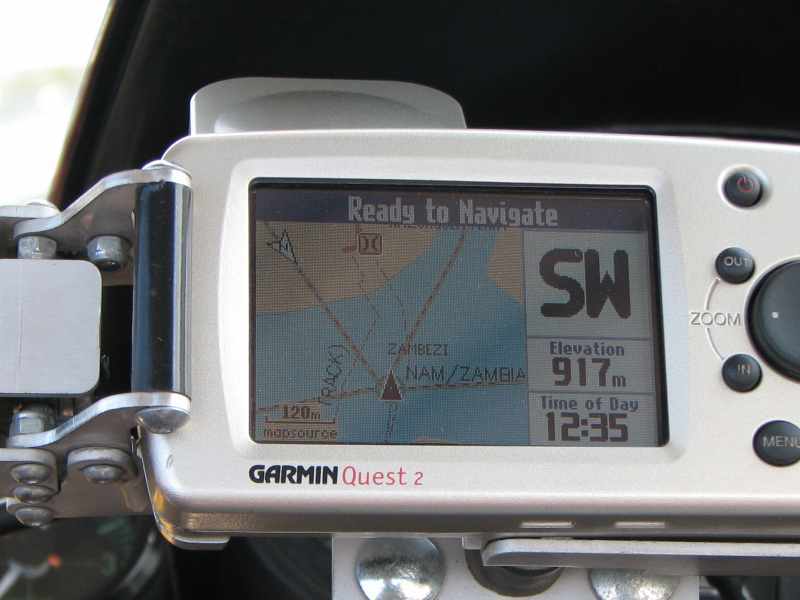
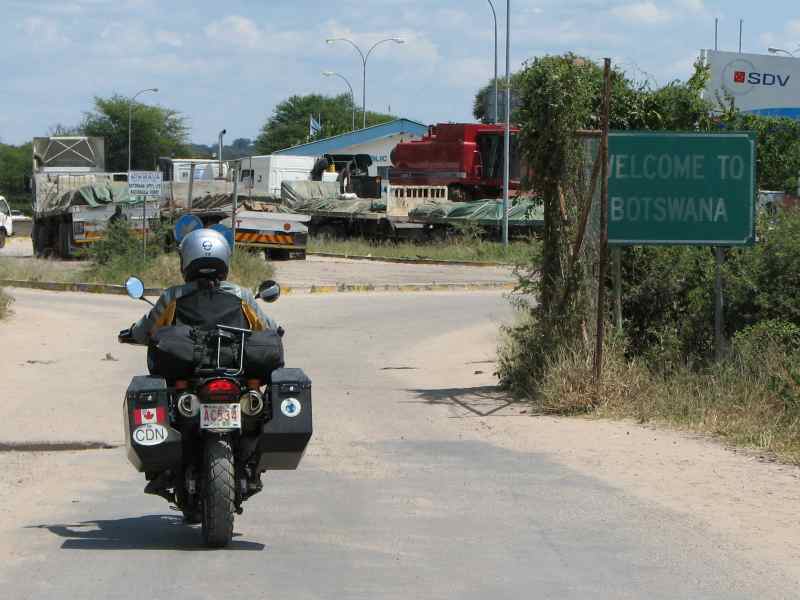
Just before being called back for the road permit

With our wad of pulas (I kind of like saying that too) we went back to the border post to pay for the road permits. Then we went on a search for black market money changers back at the ferry terminal. We found a couple of guys but because our only alternative to them was to take the boat back to Zambia we had no bargaining power and got hosed with a terrible exchange rate. We rode back past the customs office for the last time and through the dipping pool to end what turned out to be one of our longest border crossings. All told it took three hours and twenty minutes from arriving at the Zambian side to departure from the Botswana side.
After fuelling the bikes (we had specifically tried to stretch the fuel to Botswana since it was much cheaper compared to Zambia) we rode 100 kilometres to Panda Rest Camp, near Pandamatenga. Greeting us there was Massey, the owner's father, who was really into motorcycling. At 60 years old (looking more like 35) he regularly made the ride to here from his own campground in Tanzania in three days on a KTM 640 Adventure. A distance of over 3,000 kilometres! It was a lot of fun talking with Massey and we decided to enjoy dinner in their restaurant. The burgers were absolutely delicious and as a bonus they had my favourite drink, Stoney ginger beer.
The first sign of mechanised farming since Europe
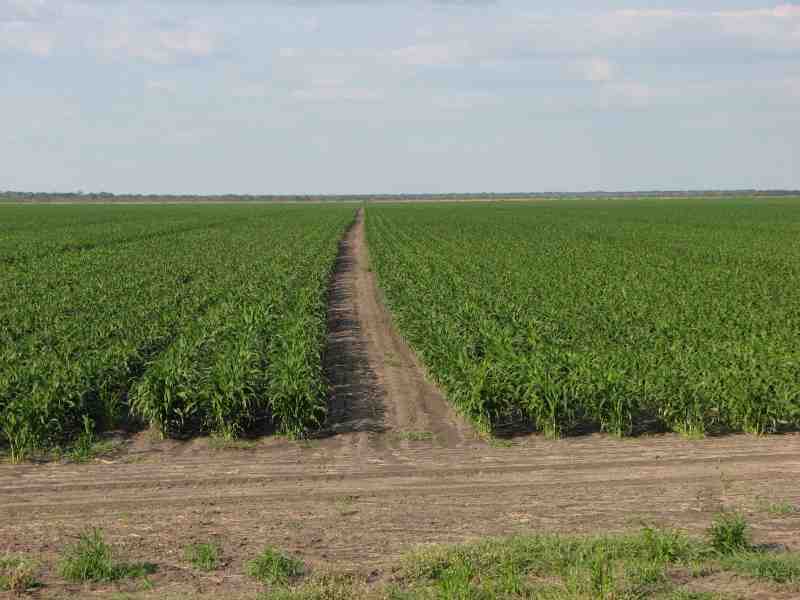
In Khartoum we had met Stephen and Rocco from Cape Town and they had written on our map that elephants would be along this stretch of road down to Nata. Every now and then we did see elephant droppings on the road so we knew they were around. With the arrow straight roads and the bush cleared twenty metres to either side it was easy to see a long distance ahead. A bull elephant appeared on the horizon. Wow. We approached slowly, not really knowing what to do but keeping the engines running in case we had to make a break for it. The elephant was at the edge of the clearing, twenty metres from the road, and patiently let us snap picture after picture of him. Again we were struck how different it was to see a wild animal from the motorcycle rather than from inside a nice, sturdy truck. It was so much more real. And probably dangerous too. On the ride to Nata we saw three more elephants and we stopped every time. One big bull elephant was very near the road and I stopped well back to take a picture of Audrey as she rode by it. This elephant looked a little less patient with pesky motorcyclists, watching Audrey intently with ears flared out, so she rode right on by, only stopping a few hundred metres down the road. After getting fuel and a Smarties ice cream cone in Nata we turned west, planning to stop at Planet Baobab Lodge. We got there at 1:45 PM so we kept heading west. The roads were very good and it was easy to make reasonable time. At one point a big, white Mercedes whipped past us, going about 150 kph. Botswanabahn! We had heard that the Botswana police were quite strict about speed limits and liked to target foreigners so we didn't exceed the limit. This proved to be frustrating at times. A thirty kilometre stretch of road, in perfect condition with excellent visibility and no people or animals on the road was signed at 80 kph. Twenty kilometres out of Maun the speed limit was reduced to 60 kph. That was a long twenty kilometres. Just as we entered the town itself a mommy and cub (puppy?) warthog ran in front of us! Good thing we were only going 60. After stocking up on groceries we went to the Sedia Hotel, a few kilometres east of Maun, and set up camp. Today's riding was probably the easiest riding we had had since Canada. The traffic cops at the police checkpoints and dipping stations even asked reasonable questions!
Our first sign that we should be watching for elephants
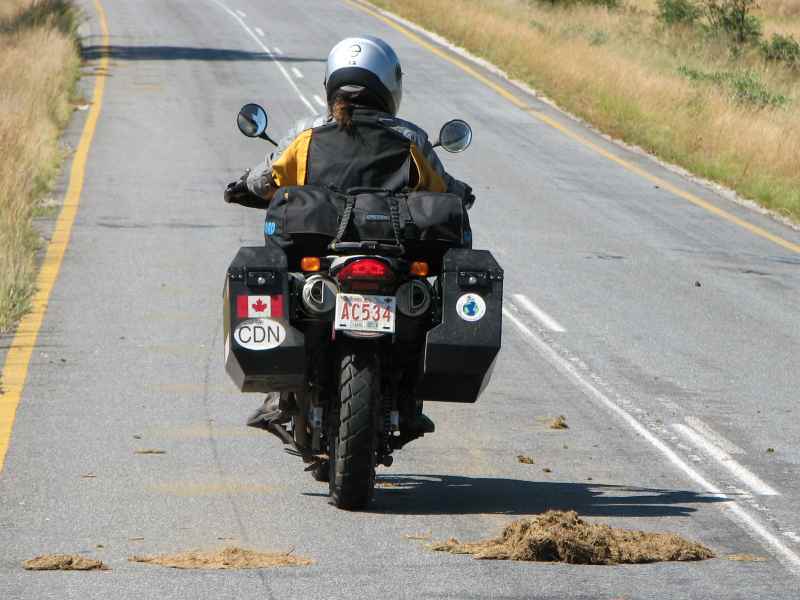
Keep moving...

This elephant had his eye on Audrey
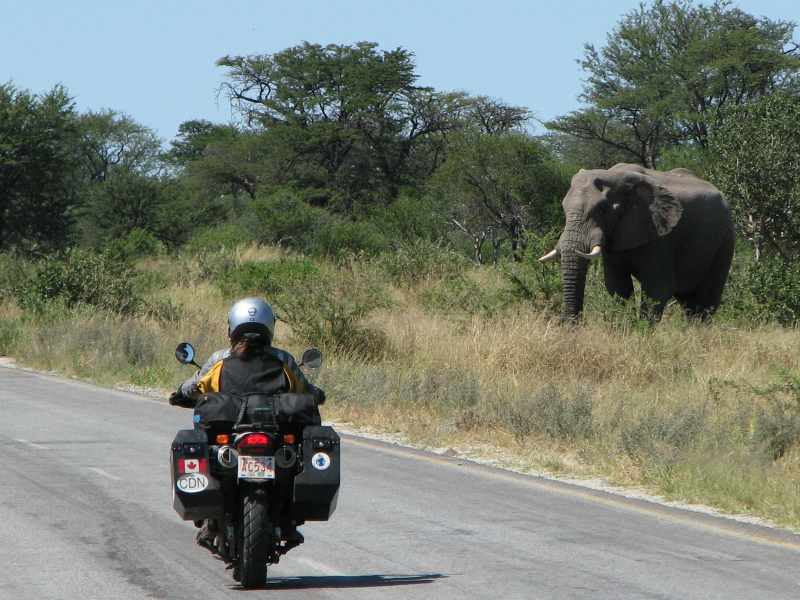
What a beautiful animal

Thursday was a time to do some chores such as washing laundry and uploading the website. We looked at getting a mokoro ride on the Okavanga Delta but $145 per person to sit in a dugout canoe and spend three hours in a truck to go there and back seemed like a lot of money. We decided to look for a mokoro ride further north when we rode up the west side of the Okavanga. The afternoon was spent sitting by the pool reading. I had found a South African motorcycle magazine with a test of the new BMW F800GS so was pretty much in heaven.
He looks like he is in heaven

When we left Maun we picked up another South African electrical plug adapter and then a new headlight bulb for Audrey's bike. At the auto parts store I reached for my wallet and found nothing. My wallet was missing! I raced back to the electrical shop and found it sitting on the counter. Whew. We were lucky to have stopped at the auto parts store or we would have been several hundred kilometres down the road by the time we found the wallet missing. As we left Maun the last speed limit sign we saw said 80 so we rode at that speed for a while. At one of the veterinary control points where we had to ride our bikes through a dipping pool and get sprayed Audrey asked the police officer what the speed limit was. 120. We made better time after that. Except for the vet control points that is. We even had to take the shoes out of the luggage to get sprayed. One control point was so close to the other that our shoes were still wet from the last spray. With all the cattle that we saw it seemed that beef was one of Botswana's main industries and they were taking no chances with foot and mouth disease. We arrived at Swamp Stop Camp at about four in the afternoon and enjoyed a cool beverage while sitting on their deck overlooking the Okavanga.
The "Foot and Mouth Jig"

The Easy Rider
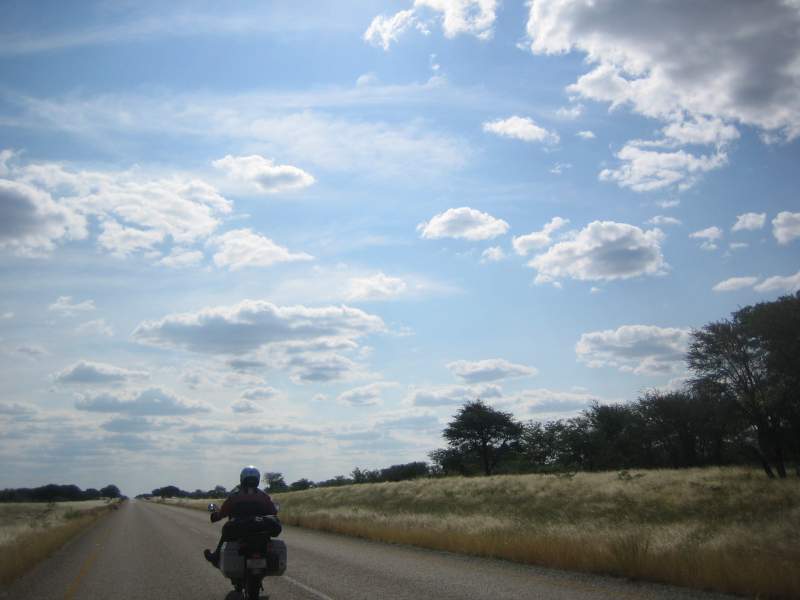
Arriving at Swamp Stop Camp
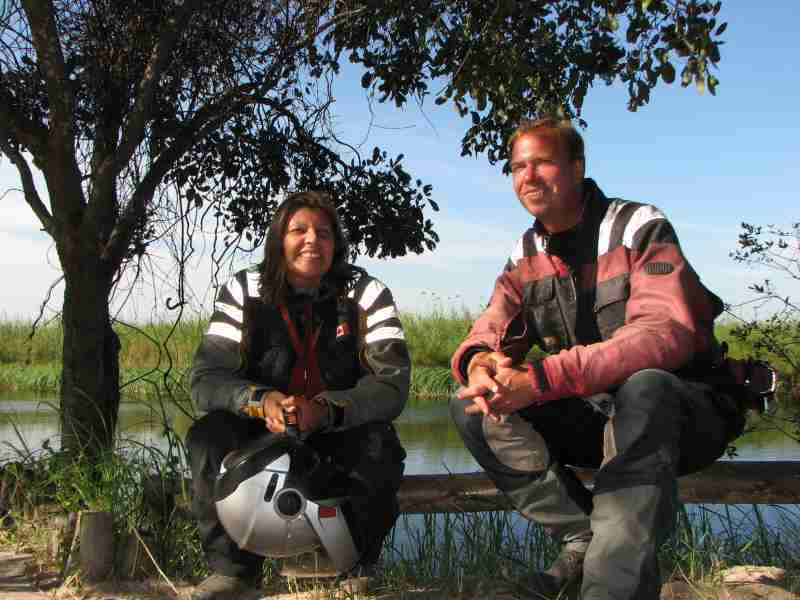
Enjoying the view of the swamp
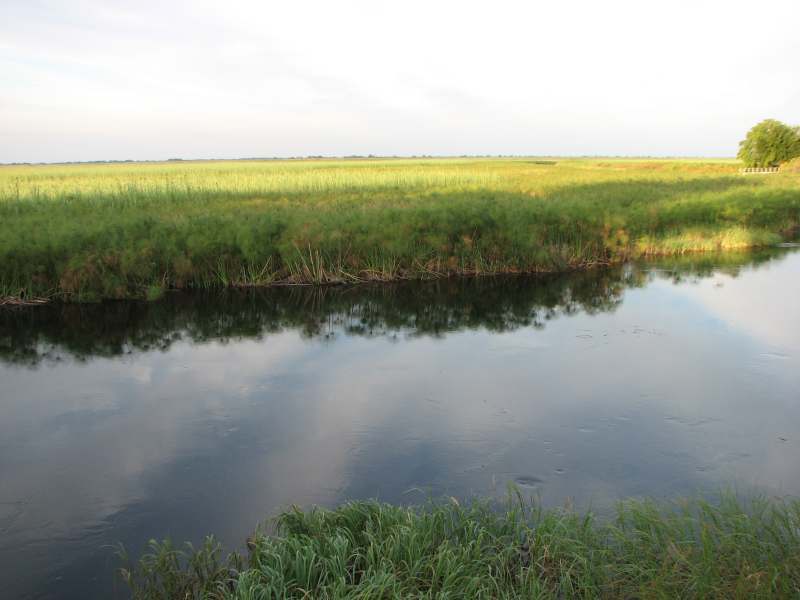
We had talked to a German professor who was leading a small group of university students on a trip through Botswana (how do I sign up for that class?) and he said that the Tsodilo hills were great to visit and the road was in good condition. We rode twenty kilometres north on the highway and then turned west for a forty kilometre stretch of gravel. The Male Hill, at 1395 metres, was the highest point in Botswana and we could see it from thirty kilometres away, rising out of the endlessly flat plain. When we pulled up to the entrance gate to the park we found the gate closed and no one in sight. After a few minutes a 4x4 came from the other direction. It was a couple we had met in Maun and they said we could just slide open the gate and ride to the museum. The rough road was no problem on the bikes. At the museum we hired a local guide, "KT", who took us around the Rhino Loop trail. He was very helpful in showing us the rock paintings and also explaining how the locals used various natural things. The paintings ranged in age from a few hundred years to 10,000 years old, with the rhinoceros being the most common theme along this trail. There were hundreds of paintings scattered throughout the hills. The baobab tree fruit was quite sweet and the Tsodilo hills even had their own peanuts in the form of the nuts from the moringola tree. The Rhino Trail took us up and over the Female Hill so we got a little exercise, the first time in a long while.
Audrey rides to the Tsodilo Hills

Students on a field trip coming back from the Rhino Trail
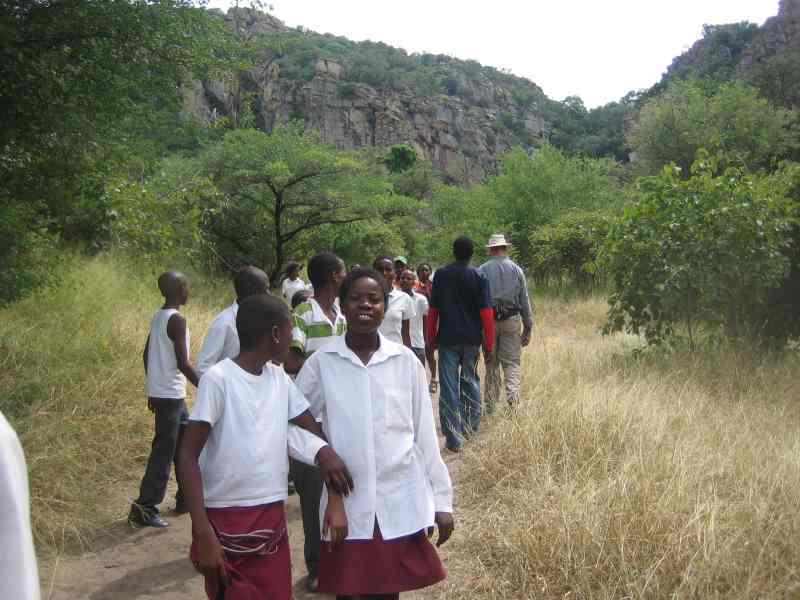
The older paintings are made using ochre
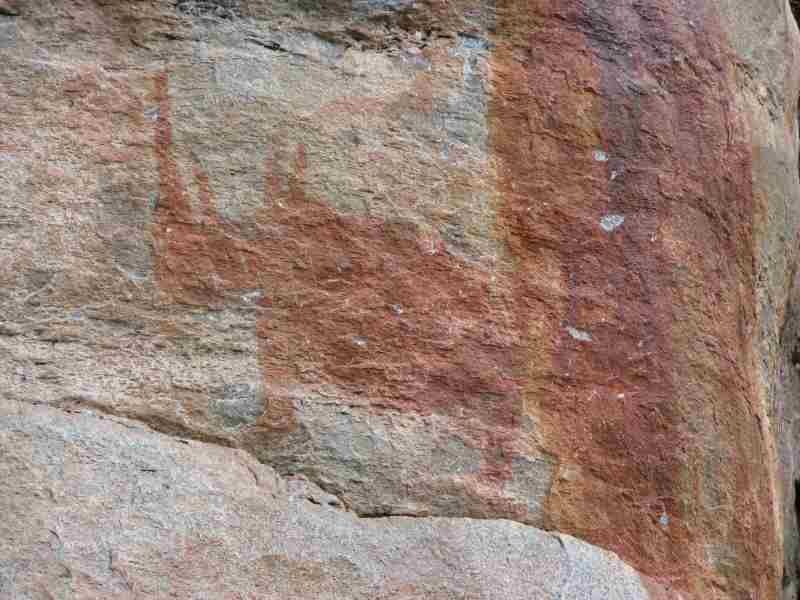
Ekke gets a little excercise while KT waits

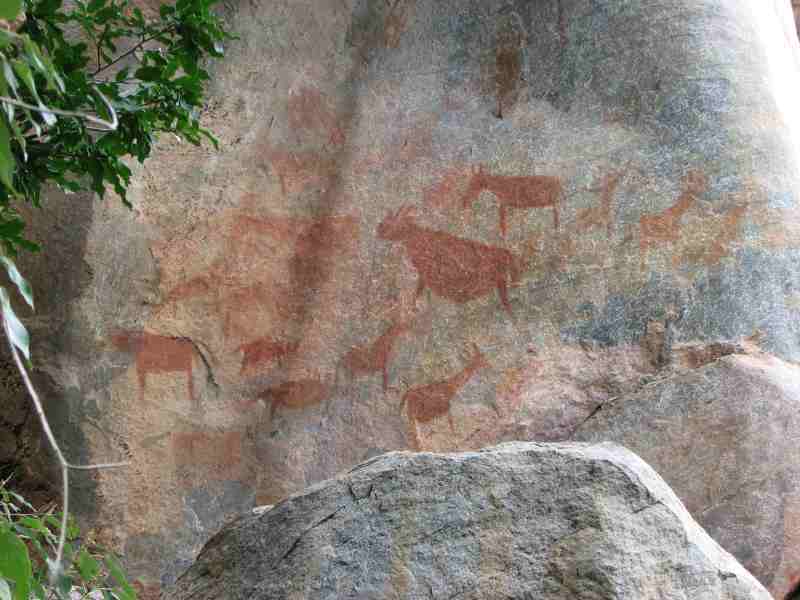
The Tsodilo Hills peanut equivalent
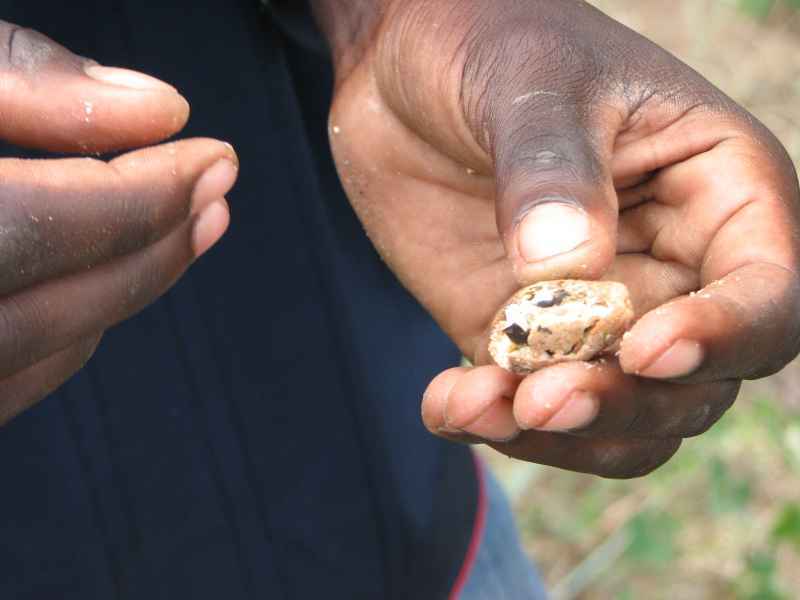
Does it look like Gary Larson came in and drew a Far Side cow behind the rhinos?
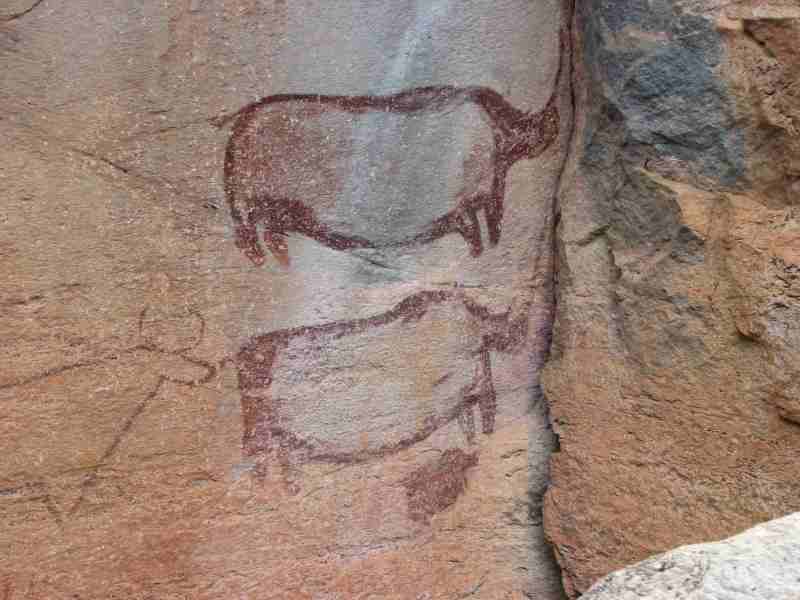
Sap from a tree is used by the Kalahari Bushmen as a glue
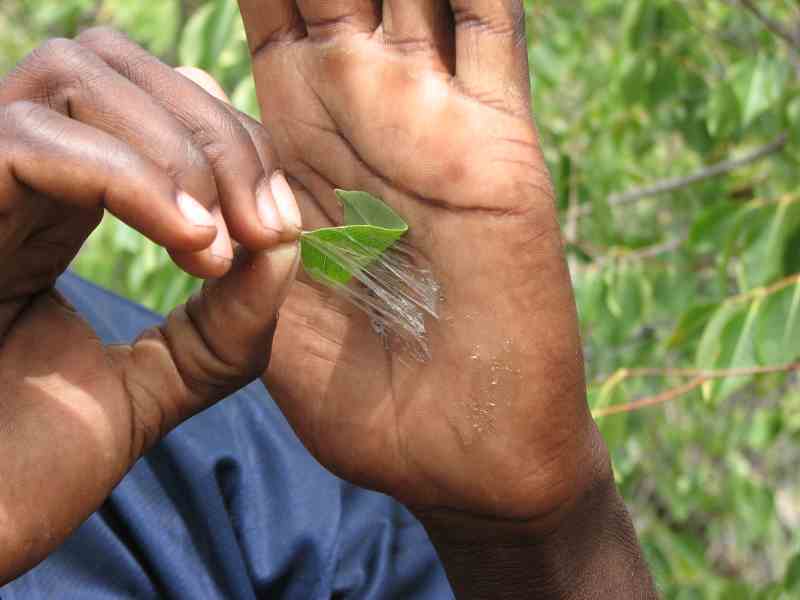
Apparently the bushmen travelled far enough to see penguins and whales
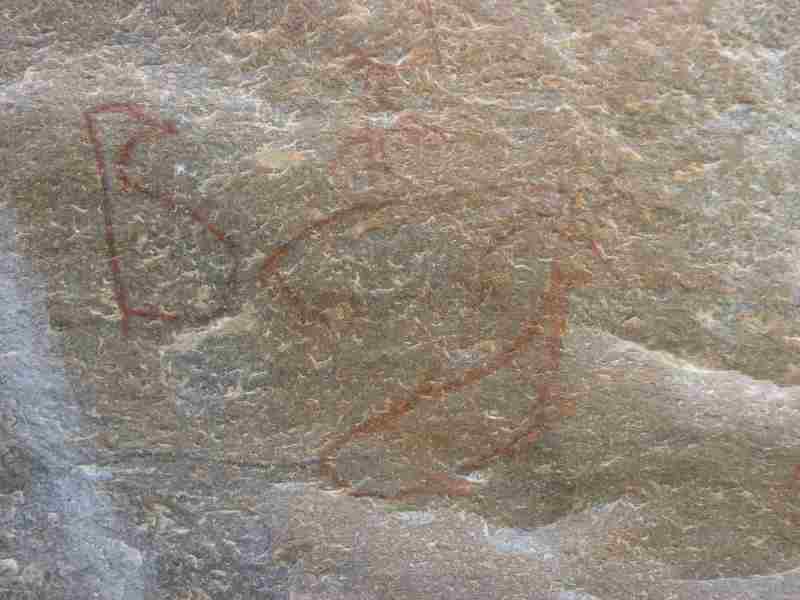
The fruit from the baobab tree is quite tasty
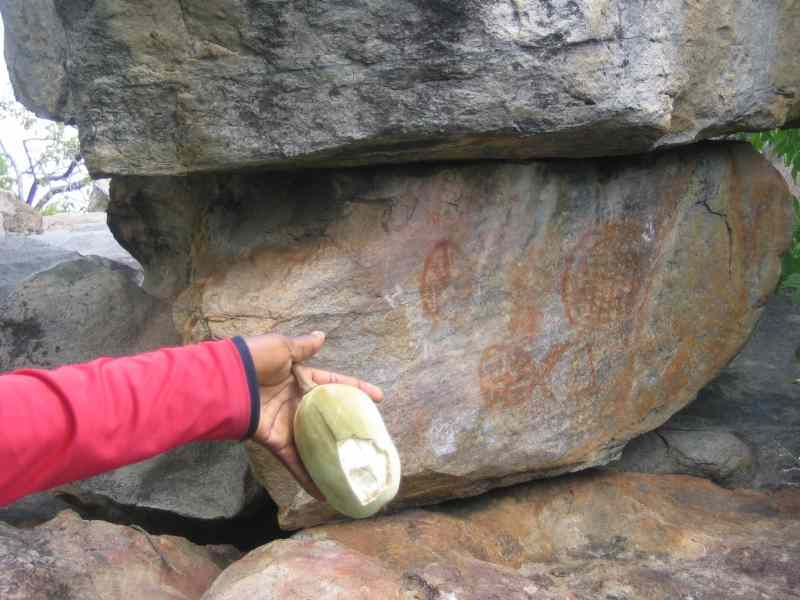
The handprints makes a good signature
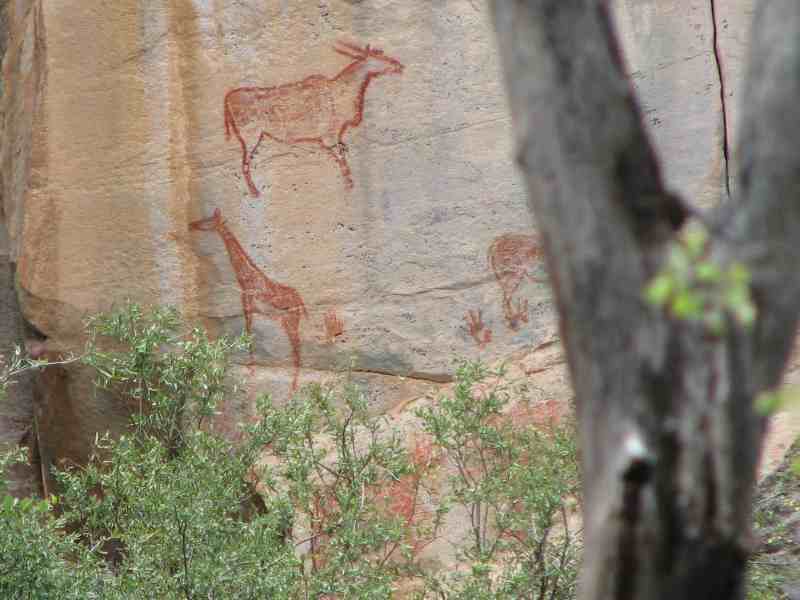
Audrey gets up close to some of the rock paintings
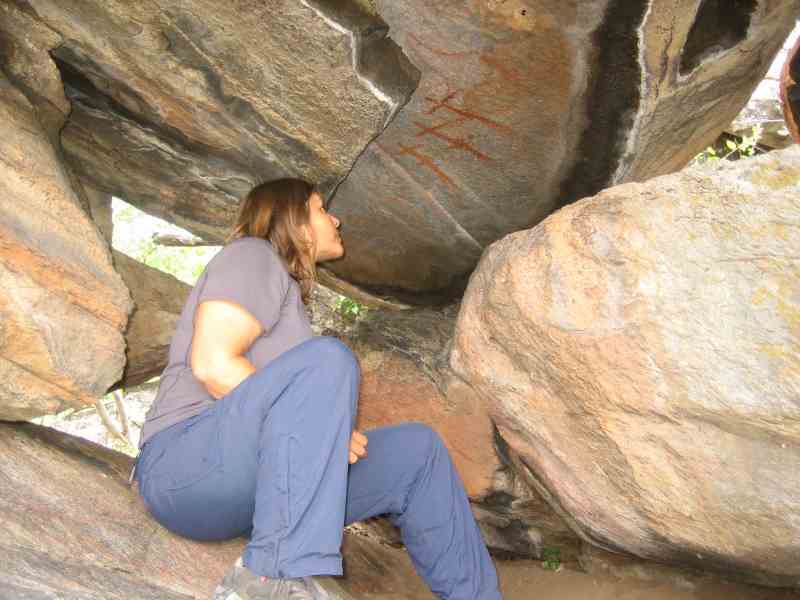
What is the French poodle doing there? Those bushmen really did travel.
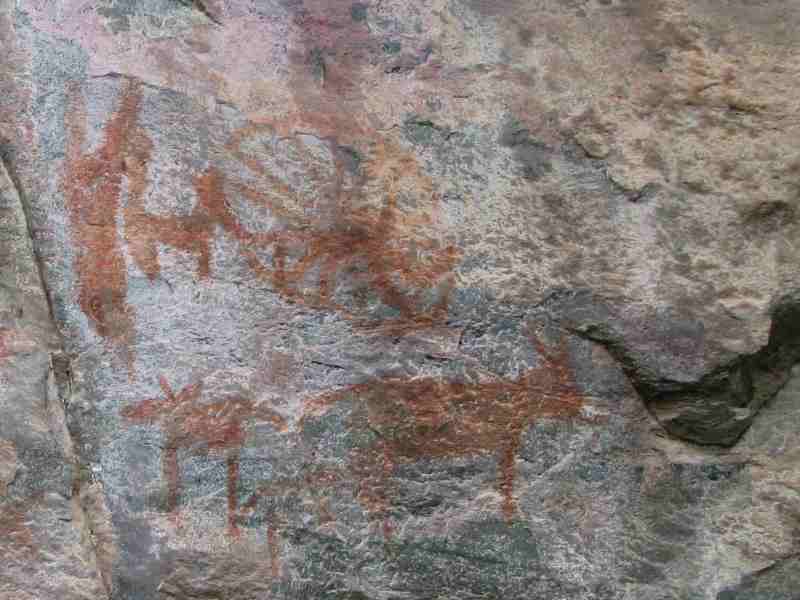

Ekke negotiates the road leaving the Tsodilo Hills Park
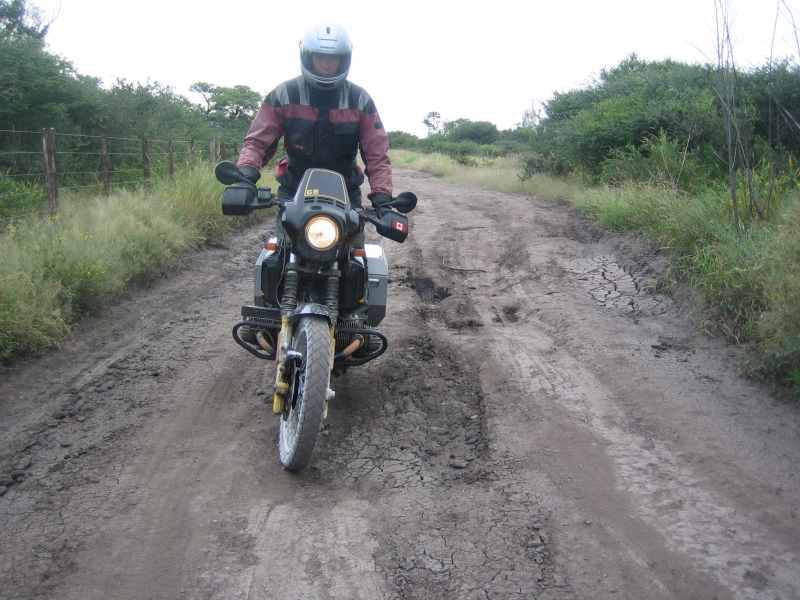
At Swamp Stop we asked about a mokoro ride and were told that there weren't any available on the west side of the Okavanga. They could provide a ferryboat ride to the other side but it would cost 1,000 pulas one-way and then we would still have to arrange a mokoro and accommodation for a night. This was again far too expensive just for a ride in a dugout canoe. From our reading, it wasn't even a real dugout canoe it would be a fibreglass replica. We signed up instead for a three hour tour on an ordinary boat. The professor had suggested that the three hour tour was better than a shorter ride because it was possible to see more. (Yes, we were humming the Gilligan's Island theme song in our heads as soon as the professor suggested a three hour tour!) Our boat left at 8:30 after a bit of confusion since the camp manager hadn't told the boat driver/guide that we wanted a tour. It was very relaxing cruising along the water amongst the papyrus reeds. The variety and colours of the birds that zipped around were simply amazing. To be honest though, after you've seen 100,000 papyrus reeds they start to look pretty similar. An hour would have been plenty. Until we saw a hippo breach the water fifty metres away. With a snort and a gasp it suddenly came out of the water with half its body showing and then it was gone. Nothing but ripples in the water. Since the hippo came sometime in the third hour I guess we wouldn't have seen it on a shorter tour. Back at Swamp Stop we had lunch at the restaurant and packed up to ride to Namibia. A quick check of the bikes showed that I had a flat rear tire though. I got out the BMW repair kit and followed the included instructions for fixing a tubeless tire. It was a little more difficult than I expected but then this was the first time I had ever done it. With practice I could probably get it down from 40 minutes to 20. Hopefully I don't get the practice. By 2:30 PM we were riding down the sandy track back to the highway. The instructions suggested a maximum speed of 60 kph and a maximum distance of 400 kilometres with the plugged tire so we rode pretty slowly for a while. The speed crept up as we headed north to Shakawe until we were going a reasonable 90. At Shakawe we fuelled up and bought some groceries at Choppies, using our pulas. Then we rode the 16 kilometres to the border where it only took 15 minutes to get stamped out of Botswana. The customs official said that even though we had our carnets stamped upon entering Botswana we wouldn't need to get them stamped out until we left South Africa. We'll see. Botswana had been the most "Western" country since we left Europe and had been a real treat to visit. It seemed as if we were transitioning from adventure riding to touring. This wasn't necessarily a bad thing but it did mean that if we wanted adventure from now on we would have to go looking for it rather than it finding us.
Ready for a three hour tour
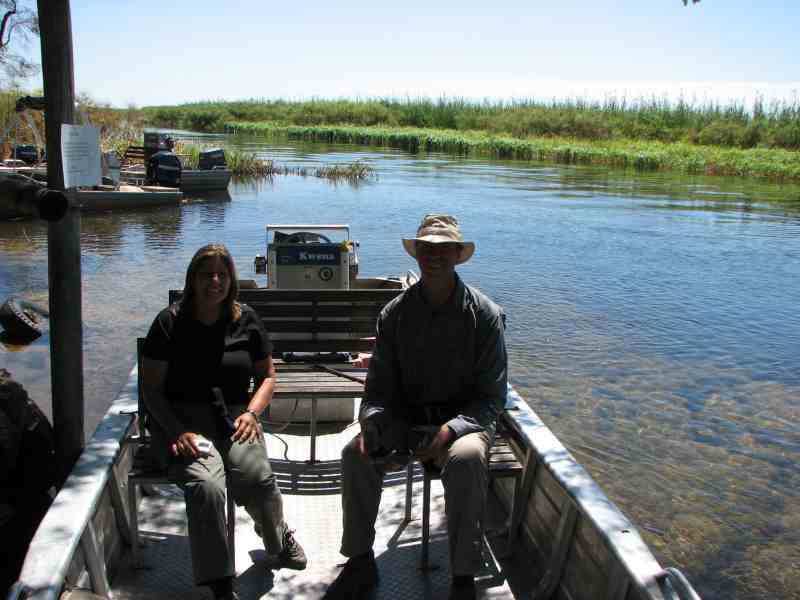
"Little bee eaters" according to our guide
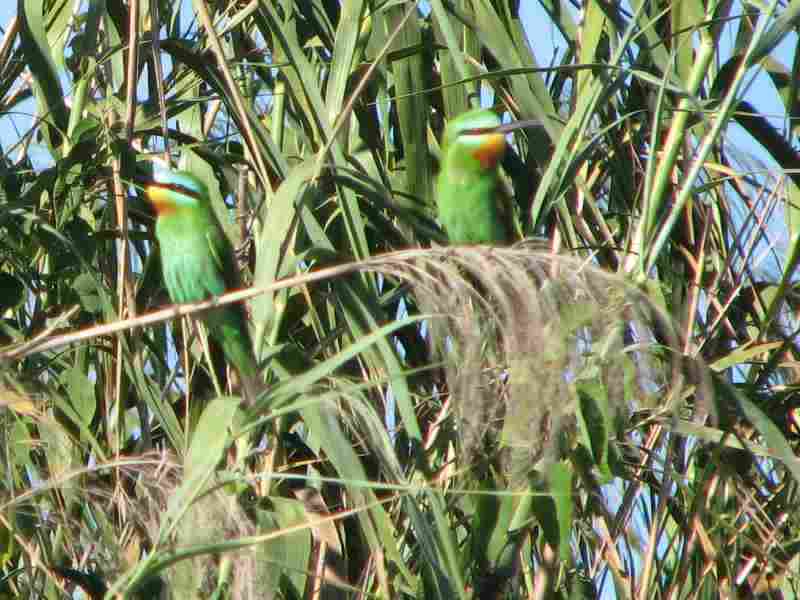
A baby crocodile poses for a photo
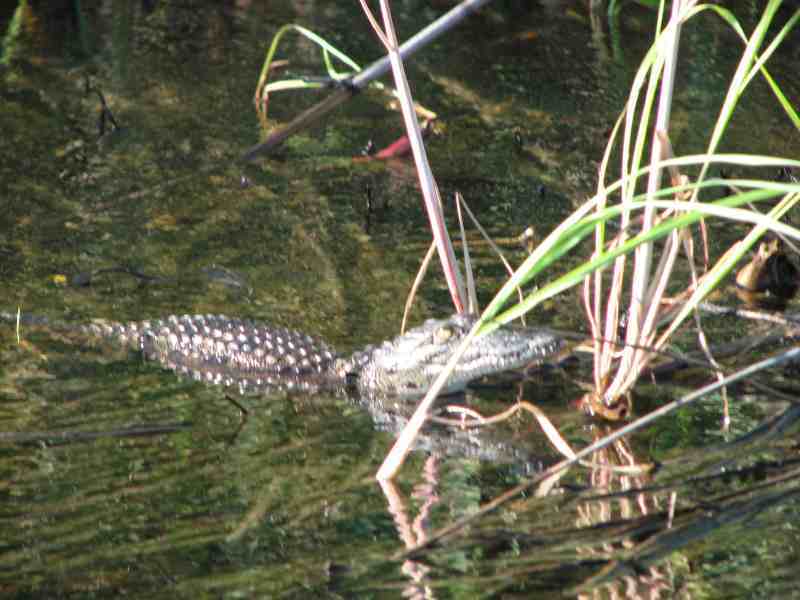
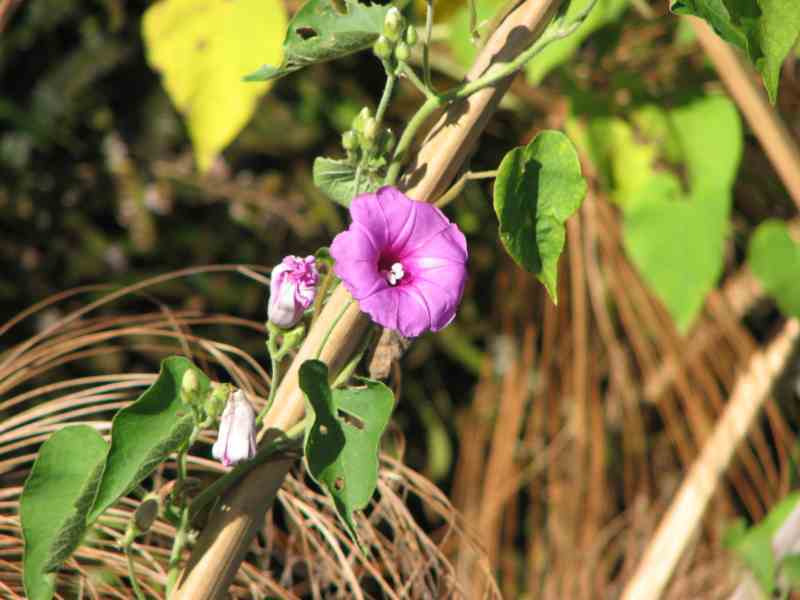
Our guide, "P", strips a papyrus to expose the innards

And then Ekke tries it. Tasty enough but not quite a Bavarian cake.

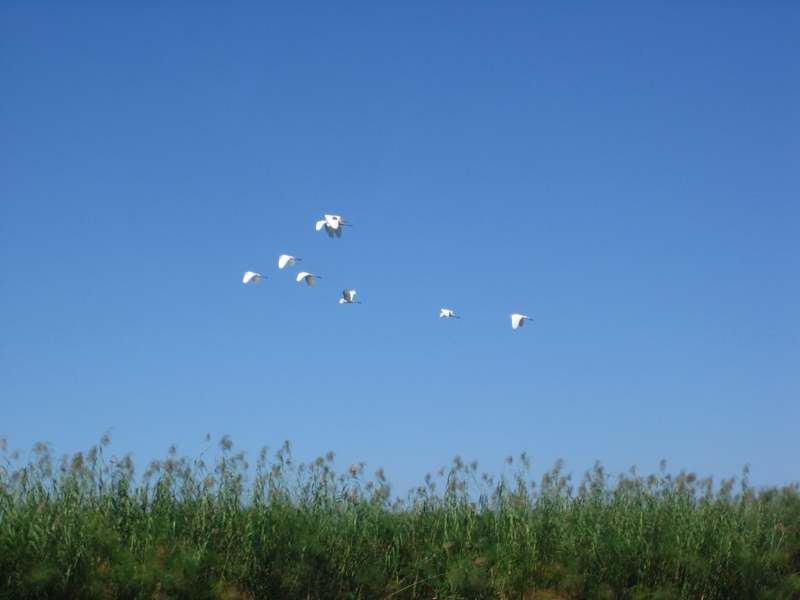

It would be easy to get lost here


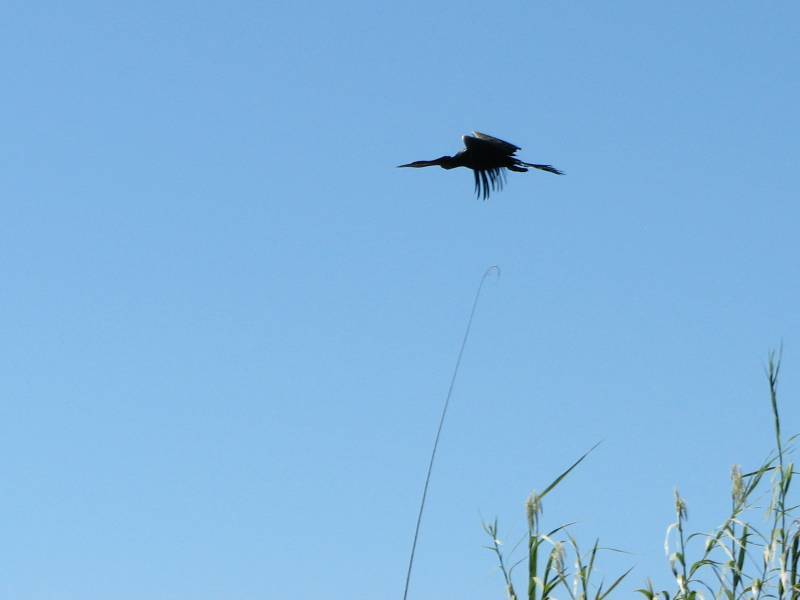
Back at the Swamp Stop

Plugging a tire before heading to Namibia

Map of our route through Botswana

Namibia is like Germany, but with better weather. You can get German sausages in Grootfontein, German beer in Windhoek, and German cakes in Swakopmund. The landscape, however, is quite unique and varied. The north has trees and rivers, further south are sprawling ranch lands, the west is famously rugged coast, the south is rocky hills and sand dunes and the Kalahari runs right through the centre. We rode in from Botswana on Sunday, April 6th, and thought we had gotten away with a pretty easy border crossing. But, it seems there's always that one last thing, in this case a road tax for vehicles. Of course we didn't have Namibian dollars. And of course we had used most of our Botswana pulas up so we wouldn't be stuck with them. So we convinced the lady to take 17 U.S. dollars and 100 Botswana pulas at par, both at a bad rate. The road from Botswana was tarmac, which turned to gravel in Namibia. But it was good gravel, the type that you don't really have to pay attention on, and it didn't last for long. As it was a game reserve, though, we still had to watch for animals. I don't know if the park had lions but I was glad that I wasn't wearing my antelope-coloured riding suit. I did look nervously over my shoulder every now and again, though. Our campground, Popa Falls Camp was combined with a lodge, and the facilities were excellent, but expensive (200 Namibian dollars or $33). The first ATM was in Rundu, 200 kilometres up the road, so we were quite relieved that we could pay with a credit card. Quite a change from most other African countries so far. In Rundu, we tried changing the remaining Botswana pulas into Namibian dollars. I stood in line in the bank, was told I needed my passport, went to get my passport, and stood in line again. Then, I waited as a trainee entered the information into the computer, under the careful guidance of his superior, printed it, and only then I learned that out of the N$34 the bank would take N$16 as commission. So I didn't go through with the exchange, and now we have some Botswana pulas for our souvenir collection.
The riding was very pleasant, and we passed village after village of stick, mud and thatch huts of various designs. The landscape was quite flat, with a lot of bushy trees and a few palms. We approached a gate, another police checkstop, we thought. This gate was a bit different, however. It marked the 'Red Line', a fence throughout the north that kept the cattle separated. South of the line, the industry was highly regulated. North of the line, not so much. This essentially marked the border between the undeveloped and developed Africa. For us, it was a psychological barrier - the adventure part of our trip was over. Immediately, there were no more huts, just big gates and fences marking the entrances to huge commercial ranches. North of the line there were lots of friendly people walking along the road, but once south of the line, not a soul was to be seen. Near Grootfontein we stayed at the Die Kraal Campground which was owned by a German couple. We opted to eat in their restaurant that night. There wasn't much choice about the menu: Zebra steaks it was! You, as did we, are probably wondering if zebras are striped on the inside, but alas, it looked just like a steak, perhaps a little more pink in colour, and very tasty.
North of the Red Line

Always check your boots in the morning!

Cruising past a village north of the Red Line

Grootfontein's claim to fame was a huge meteorite that had landed in a nearby field 80 000 years ago. It was a pleasant ride out to see it, along with its giftshop and garden. The Hoba Meteorite was really huge, made of over 50,000 kg of iron and nickel. As far as anyone knows, it's the largest one in the world. What a feeling to be touching something as old as the solar system. We rode back to Grootfontein to do some shopping, and as Ekke perused the motorcycle magazines, he spied something interesting. In Top Bike, a South African publication, there was an article about Stephen and Rocco, the two KTM riders that we had met in Khartoum, Sudan. In the article they talk about their ride from Cape Town to London, and also mention these two Canadians (us) who looked a little concerned when they started arguing with each other in Afrikaans. Small world! I remember thinking at the time that it must be their malaria pills affecting them.
Namibia could be a dangerous country

Hug a meteorite day
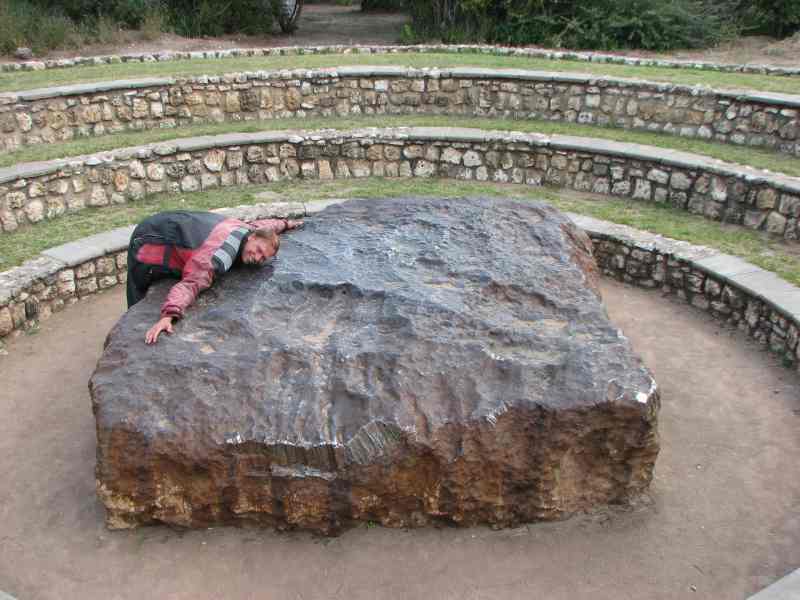
The next day was bright and sunny, and we had an easy ride to Windhoek, about 400 kilometres on a beautiful tarmac road. Triangular signs warned us of rogue warthogs leaping out onto the highway, but we didn't see any. Ekke saw a bunch of other creatures scrambling across the road however, and was quite sure they were meerkats. Windhoek was a very modern city, with palm lined streets with names like Nelson Mandela Avenue and Fidel Castro Street. A very helpful gentleman in a motorcycle shop told us that a new government had renamed a few of the major roads, and it was difficult to keep up with the changes. He couldn't remember what the names of some of the roads were but was able to help us find our way by saying, “Turn right at the second robot.” It took us a minute or two to figure out that a robot is a traffic light. We both laughed later, having visions of R2D2 standing on the corner, beeping as he held up his arm to stop traffic. There were even signs saying `Robot Ahead', which was quite funny. Down Robert Mugabe Street (hopefully that street name will be changed soon), an oasis awaited us: Danric BMW, the first dealership and service centre since Istanbul. What a relief to be in such familiar surroundings, BMW motorbikes and cars everywhere. Dieter, the mechanic, happily fit us into his busy schedule, and within a day, my front brake was finally fixed. It needed a new master cylinder, which had been wrecked in the crash in Northern Kenya. It was quite something to have a predictable front brake again. But Ekke's tires were another story. Dieter said that there were no Metezler Tourances anywhere in Southern Africa, and even getting Michelin Anakees was going to take a few days. So, we decided to head out to Swakopmund for a few days, in hopes that the tires would be there when we returned. While at the BMW dealership, we noticed a couple of motorbikes were covered by a big sheet. Maggie, one of the employees, told us that the new BMW 800 GS and F650 GS were to be unveiled that evening. What great timing for us. She offered us an official invitation. Later that evening we enjoyed some wine, cheese and interesting Namibian hors d'oeuvres, wondering what kind of animals we were eating this time. We stood in great anticipation of the unveiling and were not disappointed as the new bikes were revealed, a sunset-yellow 800 and flame-red 650. And, having just ridden down the African continent on BMW's, we were invited to sit on them, in front of the 100, or so, people as a BMW employee took photographs. So we felt pretty special.
Look out for pigs with handle-bar moustaches?
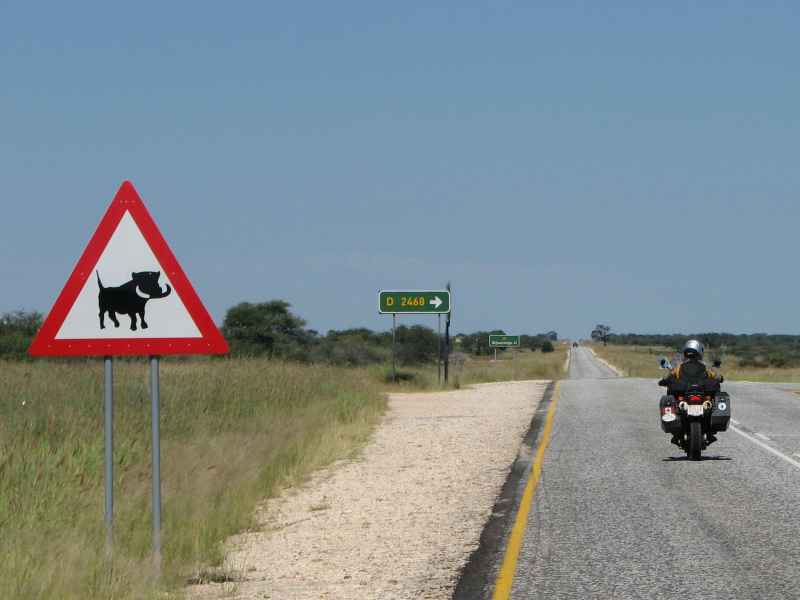
Dieter sets to work replacing the master cylinder

Audrey looking good on the new F650GS
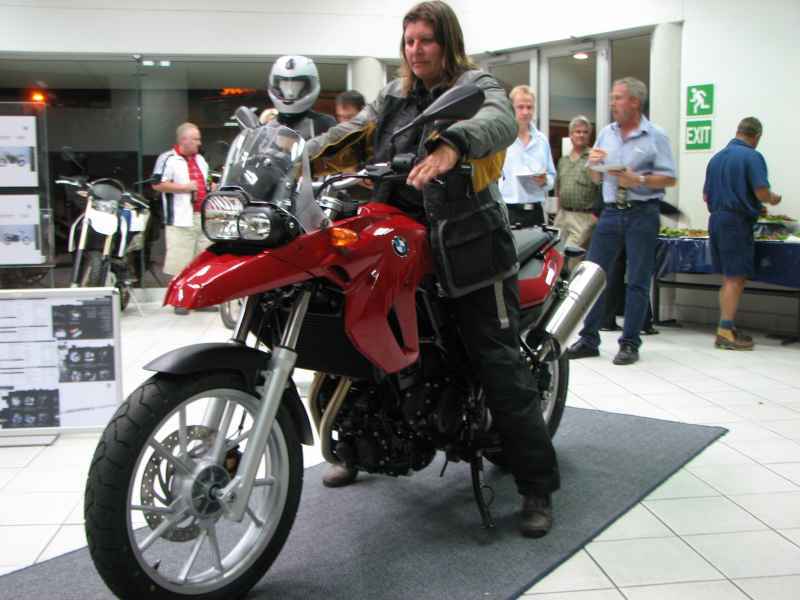
The tarmac road out to the coast went right through the Kalahari Desert. I had expected a whole lot of sand, but it was mostly bush, thus the name of the indigenous people, 'Kalahari Bushmen'. Nearer the coast rose the Naukluft Mountains, quite beautiful in the midday sun and bright blue sky. The temperature was in the low 30's, but just as we got within 20 kilometres of Swakopmund, a cool breeze hit us. We came over the last hill into town, expecting to see the Atlantic Ocean, but saw nothing but a heavy fog covering the seaside. It lifted intermittently, and we did finally get a glimpse of the ocean. Huge waves crashed against the rock and sand beaches. It looked like a dangerous spot. In fact, just up the coast were the remains of a 2004 shipwreck. The Skeleton Coast was famous for wrecking ships on the rocks and leaving the survivors to fend for themselves on an inhospitable desert coastline.
From the Indian Ocean at Dar es Salaam to the Atlantic at Swakopmund

2004 wreck of the Kolmanskop

Alte Brücke Campground was the best one yet, with our own private washroom, kitchen sink, and patio. It really made camping a pleasure, and we barely missed the days of hotels. It was also a block away from the National Marine Aquarium, where we viewed a variety of local sea life. The highlight was a walk-through tunnel where you could look up and see the underbellies of sharks. A walk up the beach took us to a palm lined park where we saw a lot of traditionally dressed Herero women in their long dresses reminiscent of Scarlet O'Hara. Then we took a wander through the local museum. I love local museums. This one was designed by people of German descent and was really well done. We learned a lot about some indigenous tribes, the Himba, Herero and San. There were displays set up showing how life was in Colonial times - the dentist's office looked suitably painful. Flotsam and jetsam that had washed up from various shipwrecks, like silverware, a wooden cask, and coins, were quite interesting. The display of rocks and minerals was fantastic, with a comprehensive display of huge geodes, petrified wood and colourful quartz crystals.
Now that is a fancy campground

National Marine Aquarium

Herero women having a chat
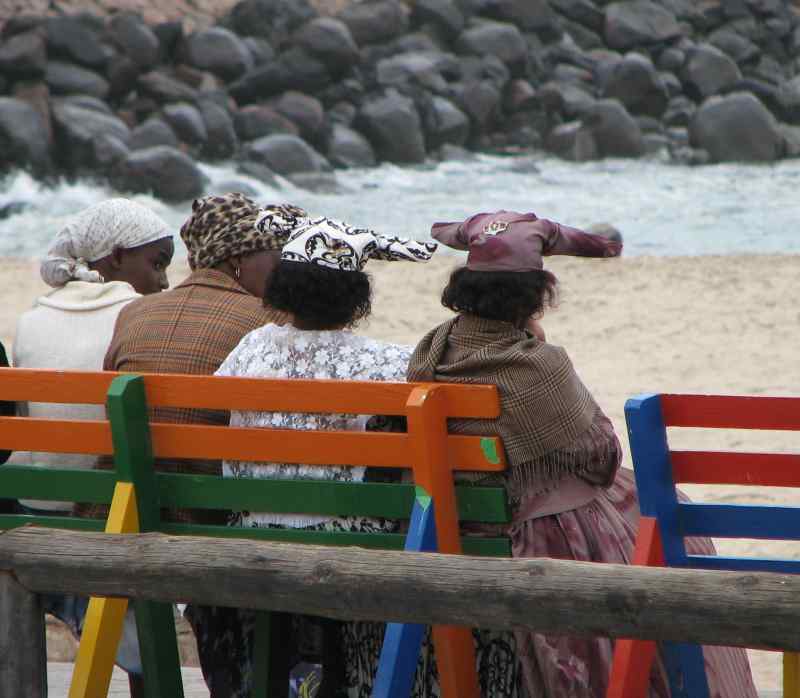
Swakopmund had a lot of German colonial buildings, and they were very well preserved. Many descendants of Germans and German expats lived in the area, and their influence was everywhere. The place was neat and tidy, with brauhauses and backerais, German kuchen and sausage. We stopped by Café Anton for some delectable cakes, but they didn't quite live up to the originals in Bavaria. Otherwise, we could have been in Germany. But then we would look at the end of the `German' streets and be somewhat taken aback to see the Namib Desert shimmering in the distance. Something else not seen in Germany were the Himba people. We saw a Himba couple in Swakopmund, dressed in nothing more than a piece of skin around their waist. They cover their skin and hair with red ochre for sun protection, giving them an orange hue.
We could be back in Erding, Germany instead of Swakopmund, Namibia

The next day we walked into town again, this time discovering the Mad Cow Cafe, enjoying some delicious meat pies, which seem to be a Namibian specialty. They also had the best warm brownie we've ever tasted, so if you're ever in the area, you know where to go. In the afternoon, we rode up the coast on a salt highway. It felt firm like tarmac, but I don't know what it would have been like if it was wet. It was too cold to go very far, and when I tried to turn on my heated handgrips, the switch was stuck. I hadn't used them since Turkey, so maybe it was time to give them a squirt of AB 80, an African version of WD 40, but obviously twice as good. The thing about the cold was that we knew it was blazing hot only a few kilometres out of town, and we were aching for that feeling of warmth again.
Riding the salt road north along a vacation community
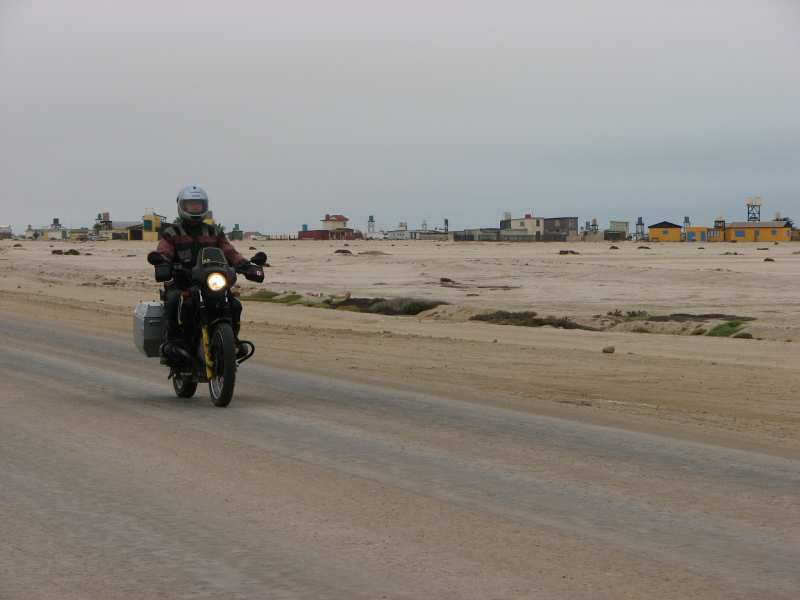
The ride down to Walvis Bay was also chilly. But after riding about ten minutes into the big salt desert we were dreaming of the cool air of the coast in Swakopmund. The area was quite desolate, and in a way, quite beautiful with such far reaching views in all directions. But, there was actually traffic on these roads, mostly 4x4's belonging to tourists from South Africa. This was real GS (on/off-road) country, with thousands of kilometres of gravel roads, from smooth and well-maintained, to rough and sandy. Ostriches and springboks dotted the landscape and made for some very picturesque riding. The ride through Namib-Naukluft Park was fun as the gravel road wound its way through hills and valleys. Views across to the mountains were spectacular with vibrant reds and greens in every direction. This flora was unusual in the desert, caused by heavier than usual rains in Namibia. We realized that we were going back in the direction of Windhoek, and decided that it would be a good idea to continue that way to get Ekke's tires. Our original plan had been to head to Sossusvlei right away and then come back up to Windhoek, but that was quite far south. As soon as we turned to go east, the road deteriorated, and it was really slow going, with a lot of loose dirt and rocks. At least four Mercedes test cars, one of them covered to hide its features, bounced past us. What kind of a road was this? My bike didn't seem to be handling very well, and I really wondered if I had learned anything this year about riding off-road. The odd bit of sand would really throw me off, and I felt that I had to be up on the footpegs the whole time to keep the bike stable. A grader had been by recently, not a real favourite surface for us to ride on. Sure, it smoothes out the road, but around here, it just puts a layer of soft dirt and loose gravel on the top, which the bikes just sink into unpredictably.
Ekke warming up along the cool ride to Walvis Bay
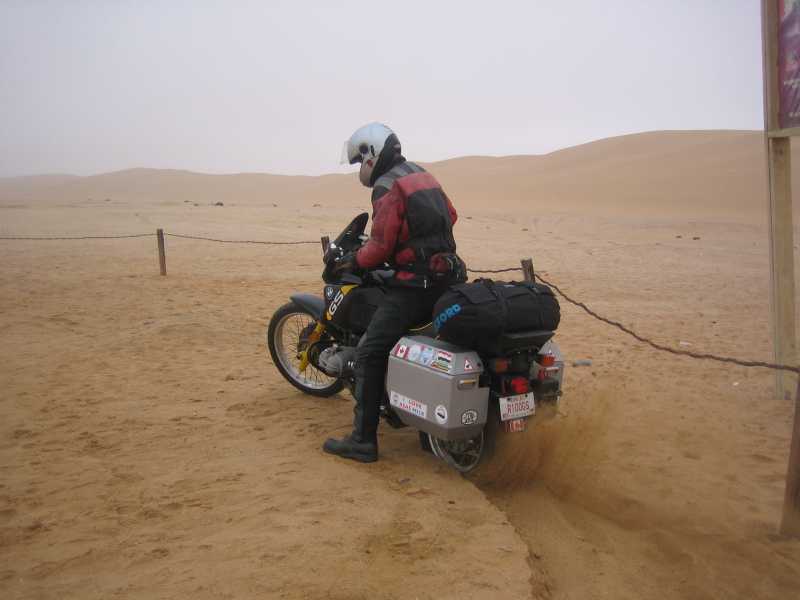
But then it gets warm out in the desert
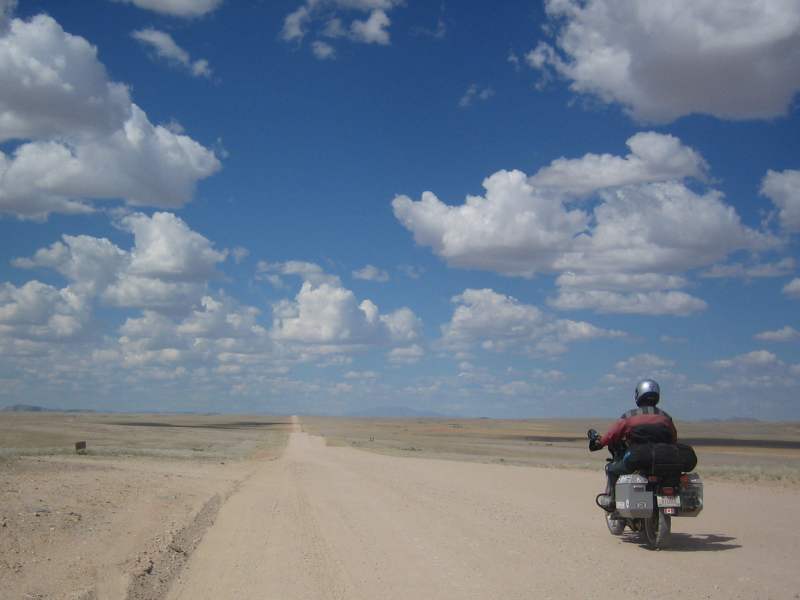
Lunch break under a shady tree
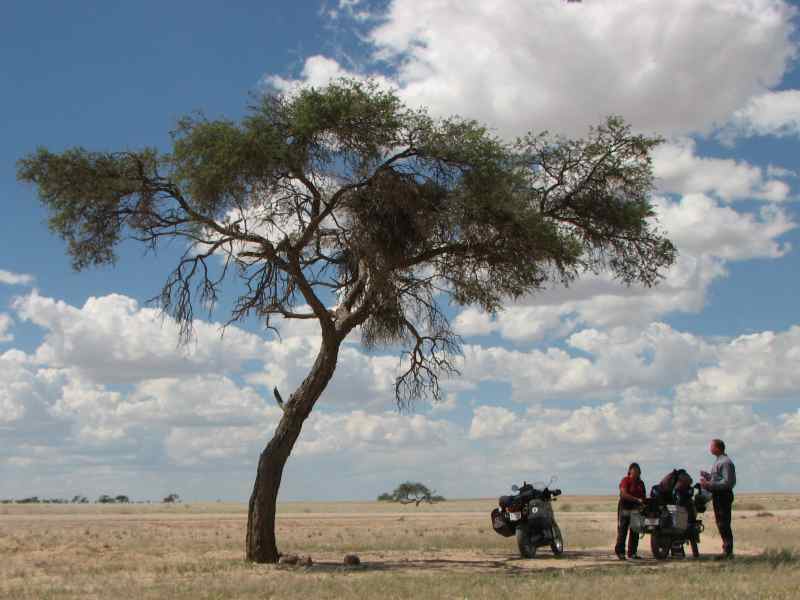
Wild ostriches

On the Kuiseb Pass
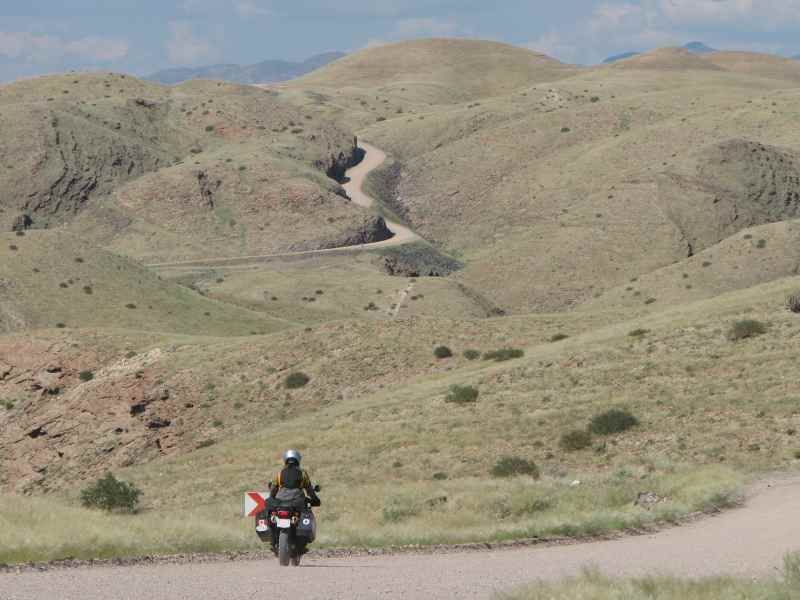
Looks like it is going to be tough slogging for a while
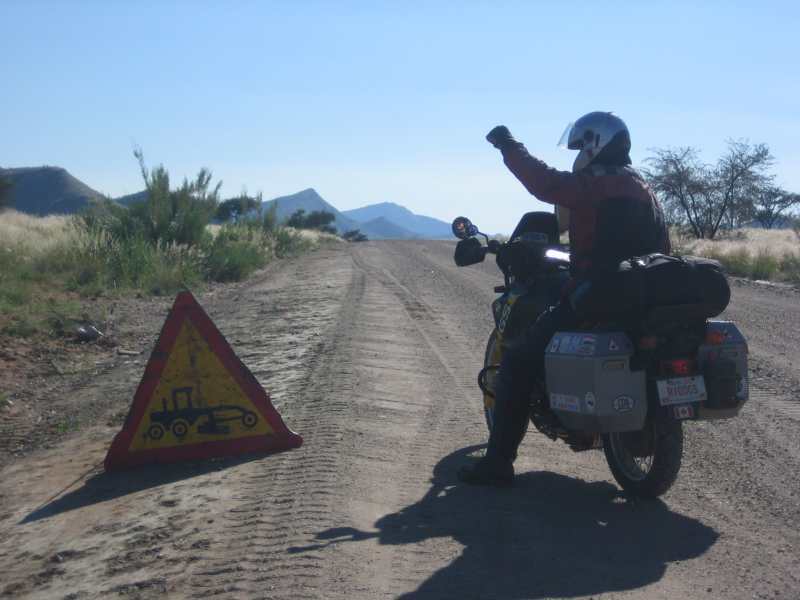
It would be dark by the time we made it to Windhoek, so Ekke checked the GPS for accommodation possibilities. No camping anywhere along this road, but there were a few big, expensive holiday ranches showing up. The sign for the Rooisand Desert Ranch and Holiday Club showed no camping, and it's always so hard to go ask how much a place is, knowing it would be too much for us. A Volkswagen Rabbit with a couple of German tourists had just approached from the other direction, and they were also on a budget trip. So, we drummed up the courage to go ask the price of a room. 1680 Namibian dollars ($200). Ekke just happened to ask if there was camping, and to our surprise, there was, for 70 Namibian dollars. So, we rode down the stone-covered, sandy road, which reminded us of the road in Northern Kenya, and found a beautiful camping spot beneath rocky hills. The manager said that a leopard lived in those hills, and sometimes you could hear it growling at night. Wondering if the fence around the campground kept leopards out, he seemed to anticipate our thoughts and said that it was very shy and rarely seen. There was, however, a cell-phone eating ostrich, so the gate had to be kept closed. Ekke and I set up camp, and walked up to the lodge for cold drinks. Sure enough, there was the ostrich walking across the field, so we kept our cell phones quite out of sight. Ekke was in his element as he saw an old Hercules motorbike parked near the lodge, so we stopped and had a look. On the way back, he decided to climb the hill to a small observatory where there were great views of the sunset. Too tired to cook supper, we just ate a few nuts and cookies, and called it a night. Cooking breakfast the next day, we were inundated with these huge insects trying to climb over the sink and get into our coffee. They were easy to spot as they were so big, and Ekke just threw water at them, which they happily lapped up. But as I was waiting for the porridge to cook, I caught a bit of movement on my right, looked over, and nearly jumped out of my pants as I saw one climbing on my shoulder. With a quick swipe I had that thing off so quickly, but the icky feeling lasted for ages afterwards. We saw so many of these insects on the road, perhaps so prolific because of the extensive rains. A vehicle would run over one, another would come out to investigate, and, eventually, eat it, and it would get hit as well. Soon enough there were dozens of these dead or squirming insects on the road, and that was a sight to see. Ekke looked in an insect book, and identified them as Armoured Ground Crickets.
Ekke and the ostrich keep an eye out for the leopard
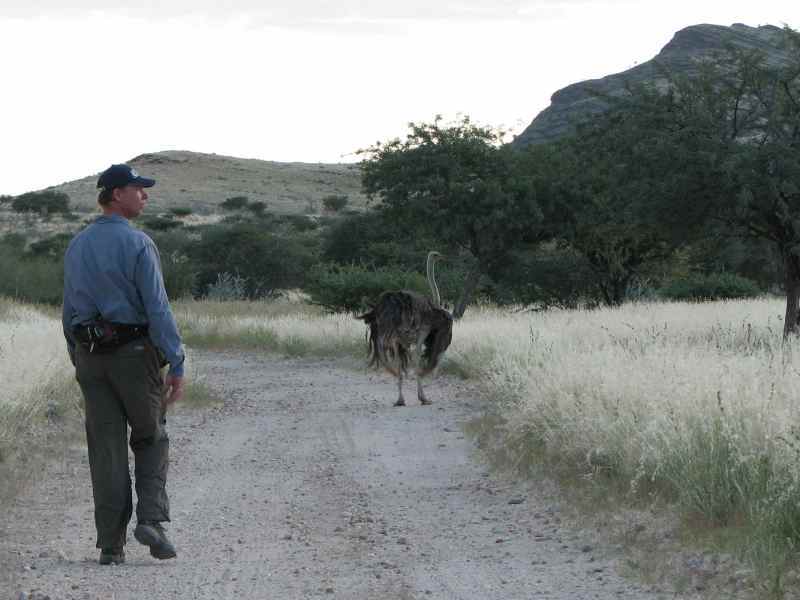
This Hercules bike has been in the family for three generations
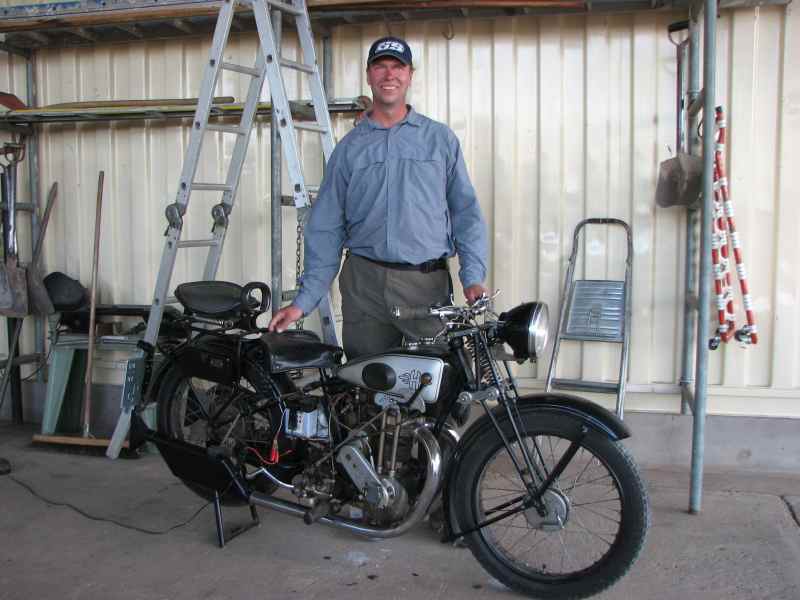
An armoured ground cricket investigates Ekke's towel

As we rode along, Ekke felt his tire getting softer and softer, and when he checked it, realized that it was flat. This was our third puncture of the trip. The tire didn't hold air when we pumped it up with the air compressor, so we rode to a shady spot by a bridge, and Ekke expertly fixed the hole in the tubeless tire. Unlike my bike, he didn't have to take the wheel off to do the job. It was an entertaining spot for us, with a family riding by in a donkey cart, and a couple of guys out walking their dogs and pet baboon. Soon we were on our way, and the tire seemed to hold the air. The road continued to be rough, and after I endured a few near wipe-outs in the sand, we made it to Windhoek once again. At the gas station, Ekke noticed that my whole foot was actually touching the ground, as opposed to the usual tippy-toes. My bike was definitely lower than usual, but I thought that it was because we had taken air out of the tires to have more stability on the gravel. At Danric BMW, we talked to Dieter about it, and after investigating, it was agreed that I had probably blown a shock. Thus the bad handling on the gravel. The bad news was that a new shock would cost 8300 Namibian dollars ($1100) and would take ten days to arrive. An aftermarket shock would take six weeks to arrive. Hedley, the BMW manager, remembered that a guy he knew had an F650 GS that didn't run anymore and that he was just selling off the parts. The bike had 8000 kilometres on it, far less than my 55 000. So, we paid him 4500 N$ ($600) for the shock, had it installed, and weren't really sure if it was any better. But, it was our only option. More bad news was Ekke's tires. The Michelins weren't there, and we're pretty sure a motorcycling touring company scooped them on us. Hedley got hold of some Pirelli Scorpions that a Suzuki dealership would send. But that wouldn't be until the next Tuesday. So we got to stay in Windhoek a while longer. Arebbusch Lodge with its campground had exactly what we needed, even a kitchen for us to use and wireless internet at their restaurant by the pool. We had time to go see a few Windhoek sights. The National Museum had some great life-sized dioramas of indigenous people in their villages, the Himba, San and Herero. There was also display on the leopards of Namibia, which are quite large in number. As we walked around the city, we saw many German colonial buildings and the train station had refurbished engines and train cars to look at. We found a favourite coffee shop, Mugg and Bean, in one of the malls downtown. For us Windhoek became `Mall City' because downtown was like one big mall. It was great! And just like in Germany, shops closed up tight on Saturday afternoon. In a pedestrian mall, there was a display of hundreds of meteorites that had been found nearby. Namibia looks like a dangerous place for things falling from the sky. We went on a mission to find a couple of little camping chairs to make our camp life more comfortable, so it was fun to find some real outdoor stores and check out all the stuff. Camping is big business here, with so many 4x4's with tents on the top. They put the tents up there because being up high keeps them safe from the animals. There were some cheap chairs at Game, a kind of Wal-Mart, but they lasted us a day until Ekke's plastic parts broke and mine cracked. Maybe we need to stay away from that Black Forest Cake. So, we're still on the hunt for `just right' chairs to carry on the motorcycles.
Gamsberg Pass
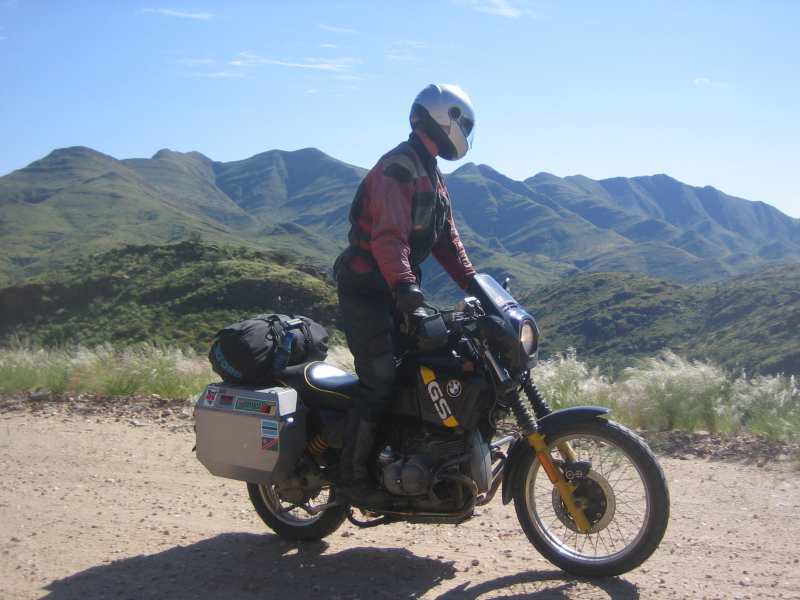
Riding back towards Windhoek

One tired motorcyclist
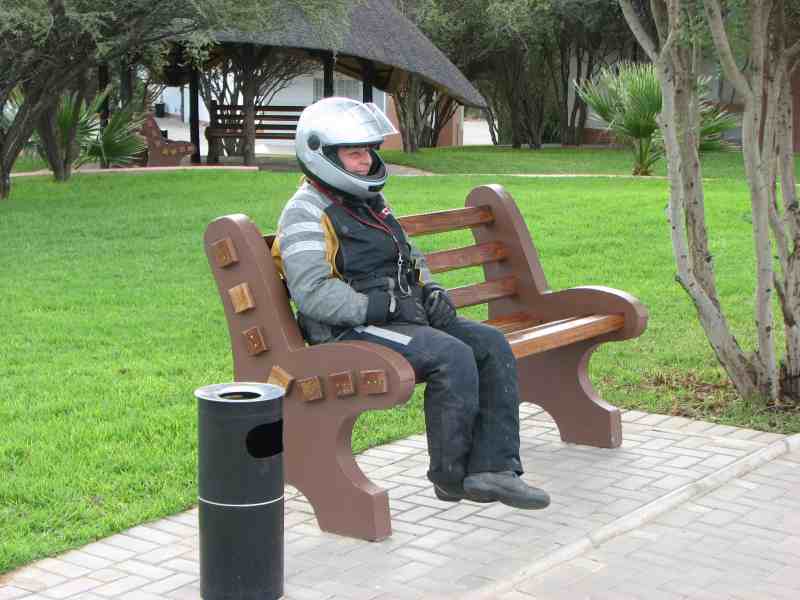
Downtown Mall City, er Windhoek
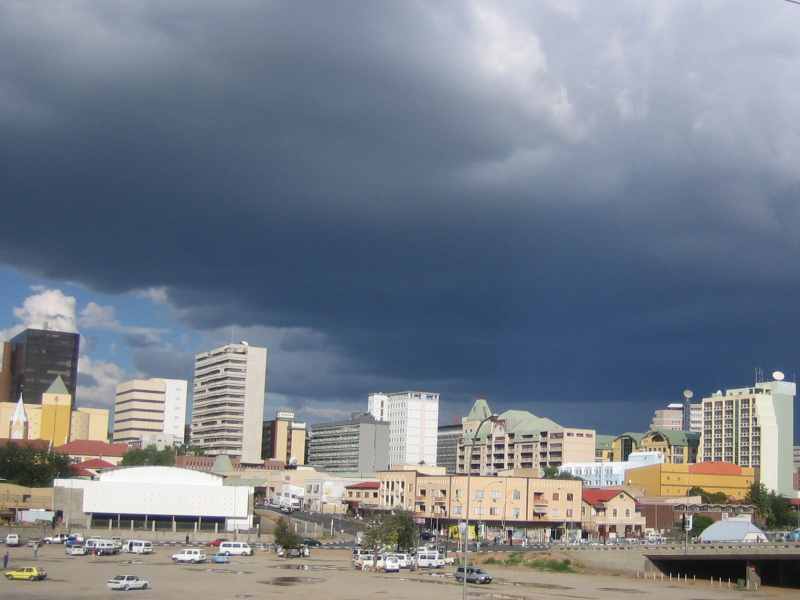
More meteorites
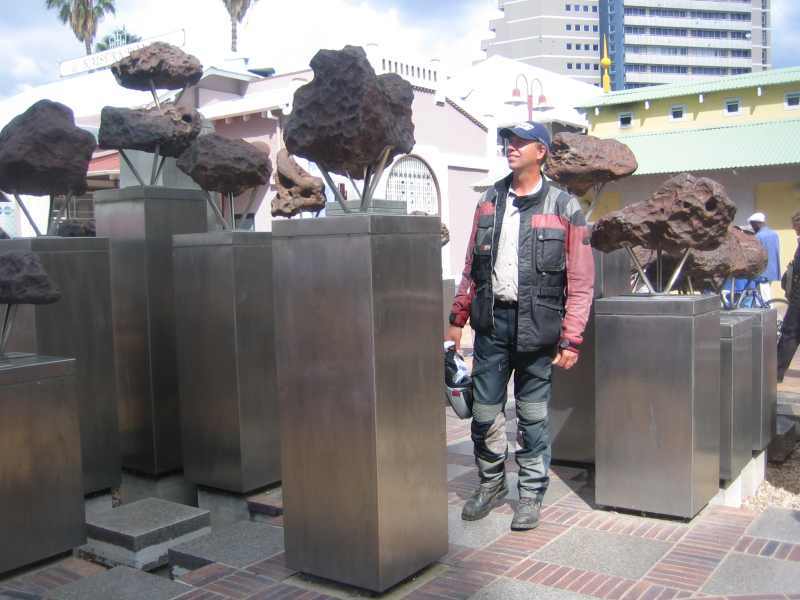
Grade 8 Home Economics comes in handy in Namibia
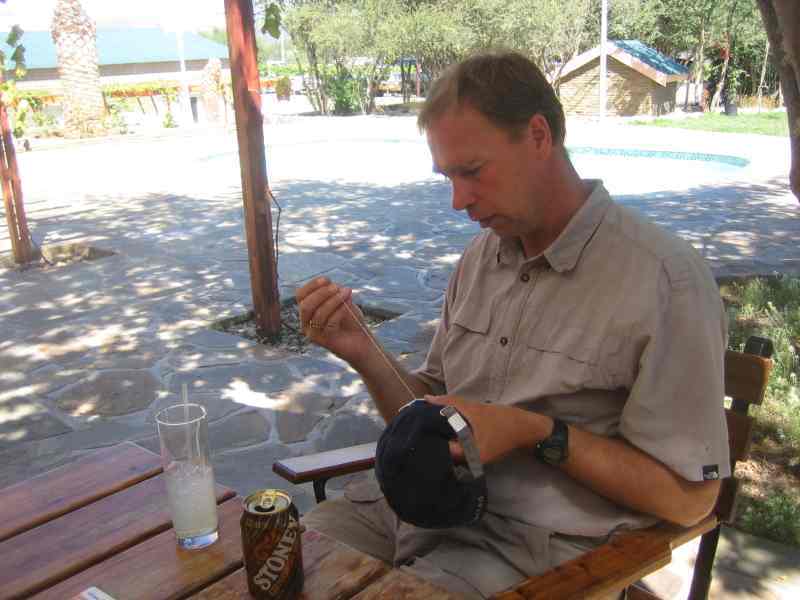
Christuskirche as seen from the Parliament gardens

A Himba diorama in the National Museum
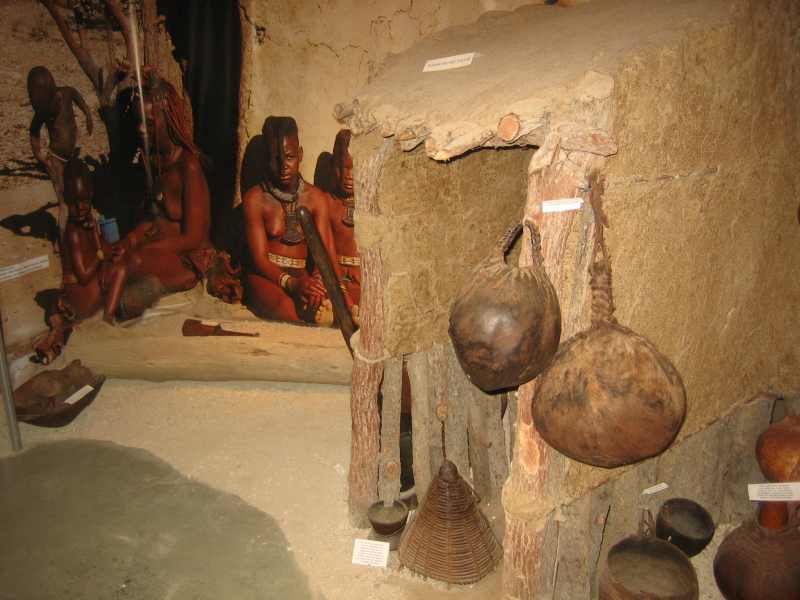
The Pirelli Scorpion tires arrived on Tuesday, as anticipated, a kind of miracle here in Africa for them to be on time. Dieter installed them, and we were finally able to continue our Namibian adventure. There was tarmac all the way to Maltahöhe, where we stayed at Pappot Camp. Our site had its own awning and wind screen, and the proprietors were extremely friendly. The gravel road out to Sossusvlei the next day was quite exciting, with some soft and sandy areas just where we least expected them. A steep hill with baseball-sized rocks made the ride interesting, and I nearly lost it going down. The scenery was pretty much scrubby desert until we got closer to Sesriem, where there, spread out in front of us were fields of soft green flanked by rocky hills and small mountains. The desert had plant life growing there after the record rainfalls. I went in to pay for camping at Sesriem, and there were a couple of guys in there, one of them very angry with the price of the campground, as well as the lack of water. We knew it was expensive, but what else could we do but pay the 600 N$ ($90) for the site. The advantage of camping in the park meant that we could go see the sand dunes at sunset and sunrise, unlike people staying outside the gates. Martin, the Dutch guy who had been angry at the price, and his friend Orie, from Israel, came to chat with us, having recognized us from Jungle Junction in Namibia. They had rented a car in Swakopmund and were touring the dunes, so we offered to let them stay on our site instead of paying the horrendous fee or endure wild camping. They made us a fantastic salad for supper. Martin also told us a story about how he was planning to walk across a game park further north in Namibia. A park ranger said he couldn't do that because of the lions, so he gave him a ride, and he indeed saw lions. This is the same park that we had ridden through, at the time wondering if there were lions or not.
Heading south

Our first view of the Namibrand Nature Reserve
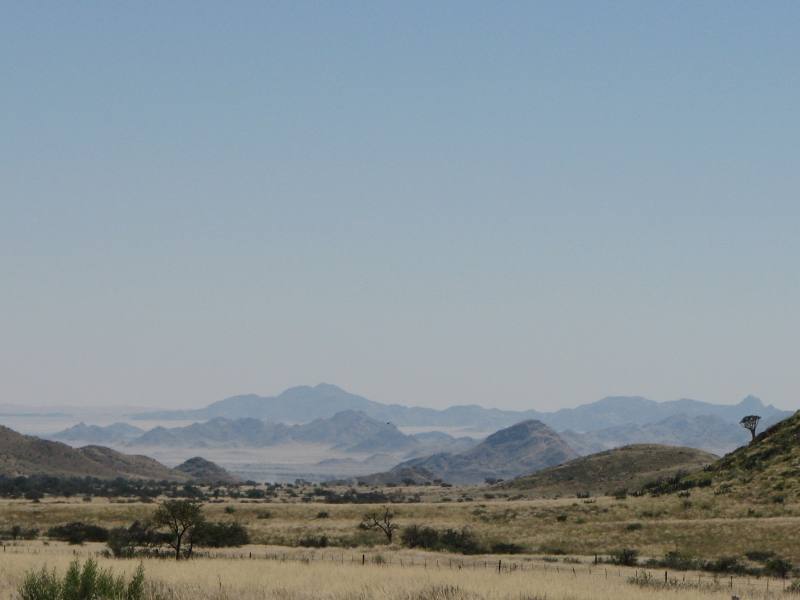
Ekke and I rode the paved road out to the dunes in the afternoon. They glowed bright red in the afternoon sun and were the biggest dunes we had ever seen. 150 metre high Dune 45, which was 45 km from the park gate and the 45th dune along the route, was very close to the road, so we took a little hike up, trudging through the thick sand. As we rode further up the tarmac, herds of springboks and gemsboks bounded away as we approached with the noisy bikes, and an ostrich trotted across the road in front of us. The ride was just stunning, and we watched as the sun dipped lower, making the colours on the dunes even more vibrant. The ride back to camp in the dark wasn't too bad, as the speeds were low and the tarmac, smooth.
Spectacular dunes

Ekke climbs Dune 45
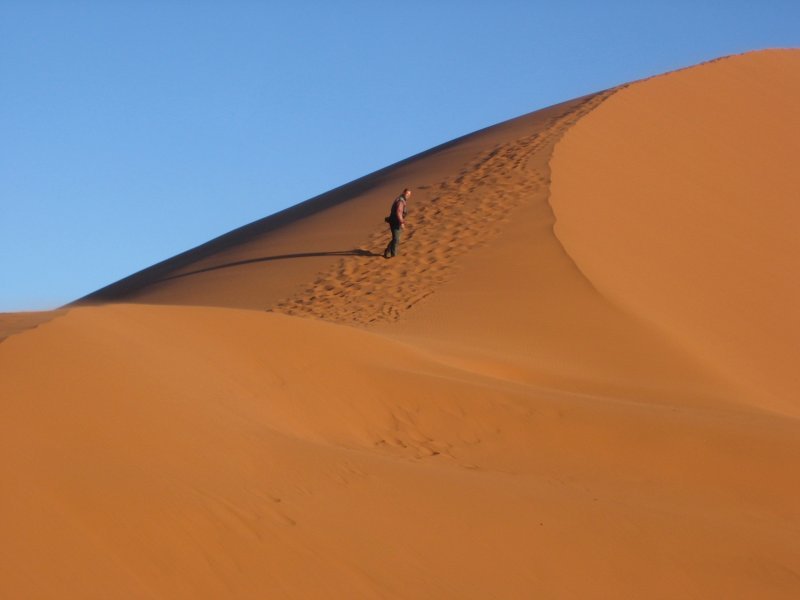
Riding into the setting sun
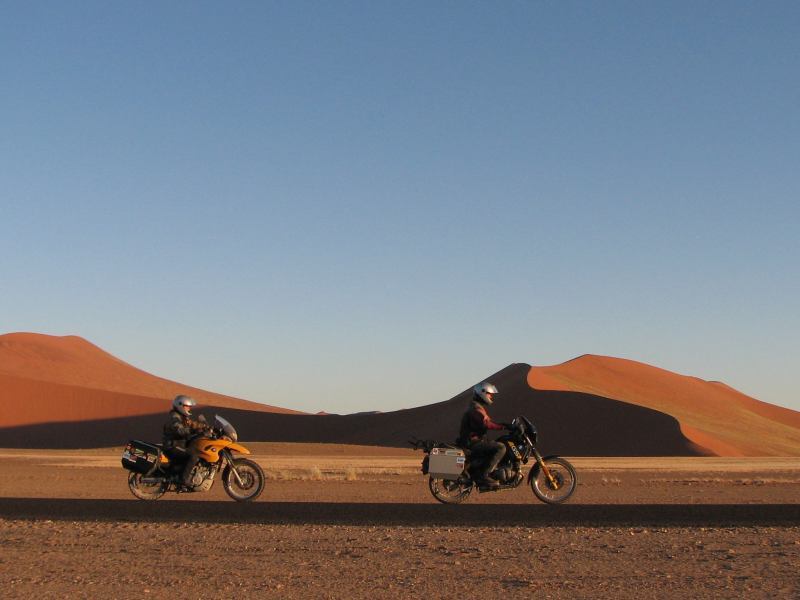
An oryx (gemsbok) in the Namib Naukluft National Park
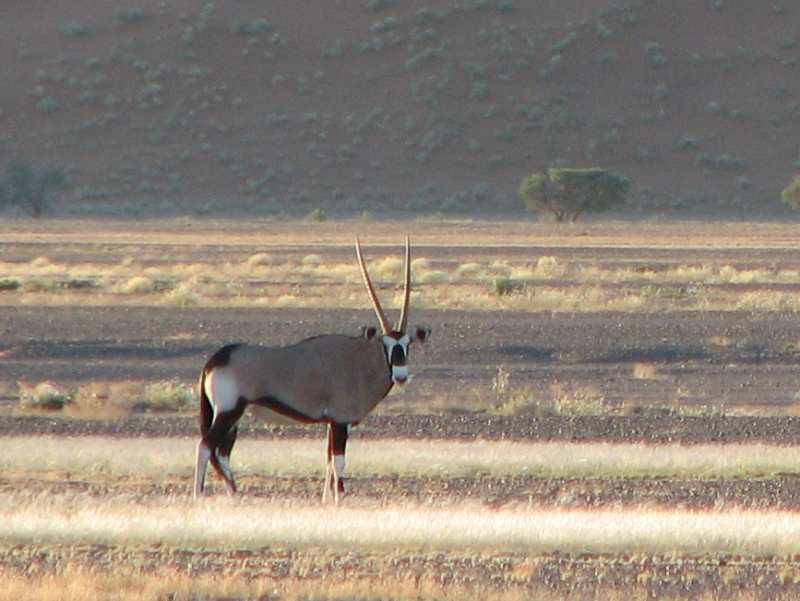
Huge dunes at Sossusvlei
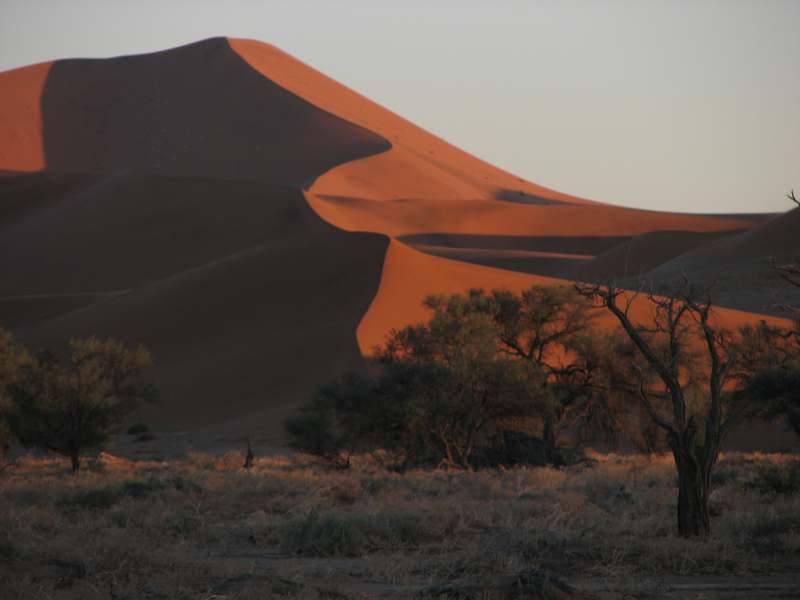
The next morning we rode out to the dunes again, and at the end of the road, had a bush breakfast picnic. A shuttle 4x4 took us the final few kilometres to the big dunes, for $10 each, and the ride through heavy sand was a lot of fun. Our driver pointed us in the right direction for the 800 metre walk towards Dead Vlei. It got quite hot very quickly, and we hiked in our motorcycle boots and pants, wondering who thought that this was a good idea. As we came over the last dune, Dead Vlei lay out before us. It was an area of hard, white clay, dotted with dead trees, with a background of red dunes. Beautiful. We had never seen anything like this stunning scenery. We could walk in amongst the trees and take in the surreal atmosphere. Ekke climbed a huge dune for better views, and I volunteered to stay low and take photos. After checking out the Sossusvlei dune, a picturesque and winding dune that everyone, except us, climbs, we enjoyed another fun ride back to the bikes, enjoying the deep sand with someone else doing the driving. Back at the park gates, we packed up, not wanting to pay another $90 per night for camping, and rode a slightly different route back to Maltahöhe. We thought a new route might be a bit shorter, but it turned out to be sandier, and therefore slower going. Sometimes the sand would be firm and predictable, but every now and again some deeper stuff would play havoc with the steering of the bikes. We had a few sharp intakes of breath as we were caught by surprise, nearly dropping the bikes.
Bush breakfast

Springboks scampering through the deep sand
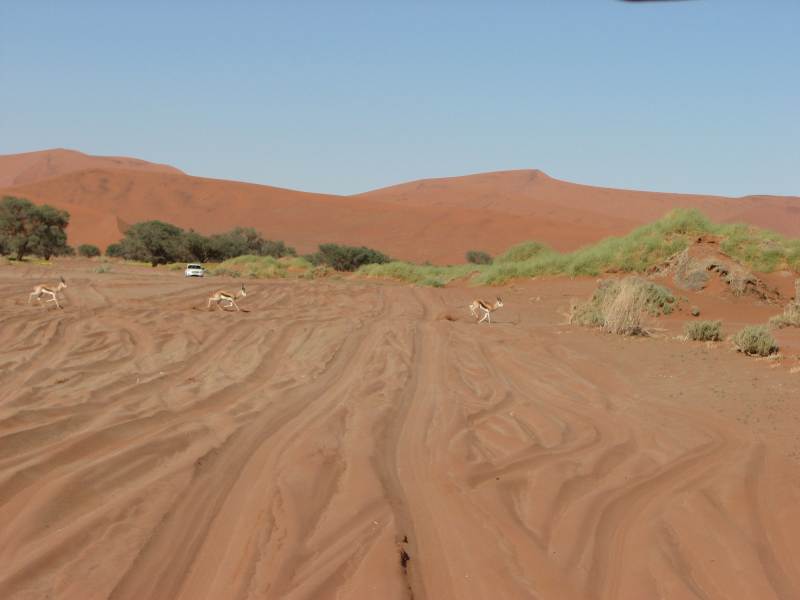
Deadvlei
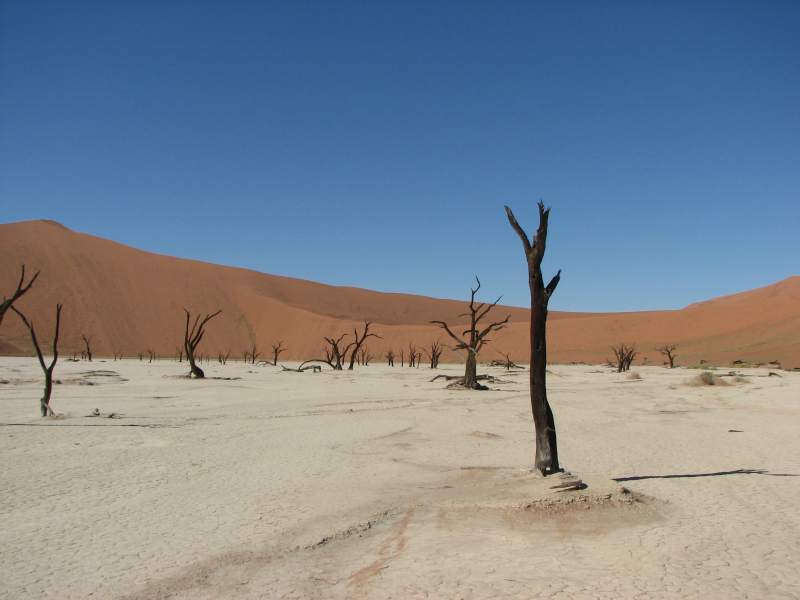
Footsteps up the dune above Deadvlei
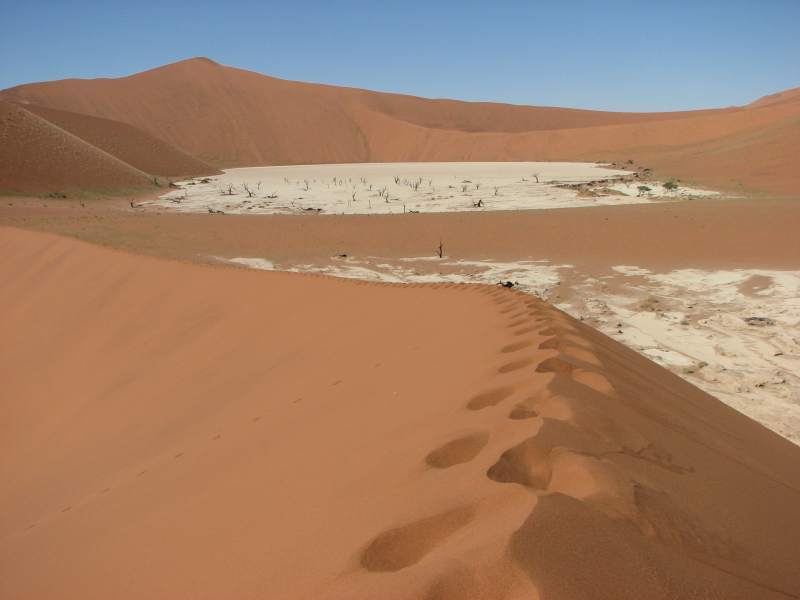
Unusual rain means beautiful flowers in the desert
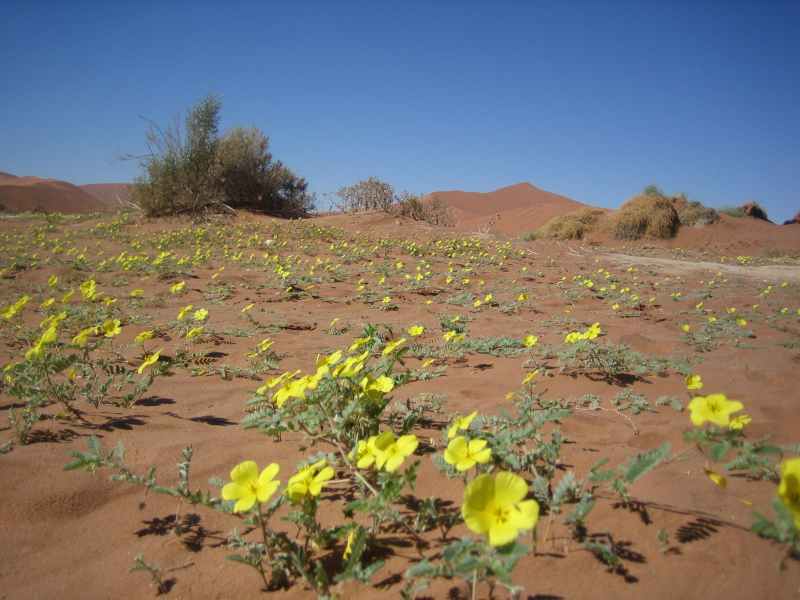
My shock wasn't feeling much better on the gravel road, and Ekke's steering head nut had come loose again, so we kept the off-pavement riding to a minimum. It was still 165 kilometres back to the tarmac, which took a lot of the day. But we knew a fantastic campground awaited us in Maltahöhe, and when we arrived, it was like we were some long-lost children coming home. This was where we had camped on the way out to Sossusvlei. The kind hosts offered us a braai, a Southern Africa barbeque, complete with sheep steaks and oryx, or gemsbok kabobs. Ekke was immediately hooked on the gemsbok, a sweeter meat, but I mostly enjoyed the `pap', a sort of corn flour mash that was a staple of the locals. Henriette wrapped up our leftovers so that we could have gemsbok sandwiches on the road the next day.
A water crossing in the desert
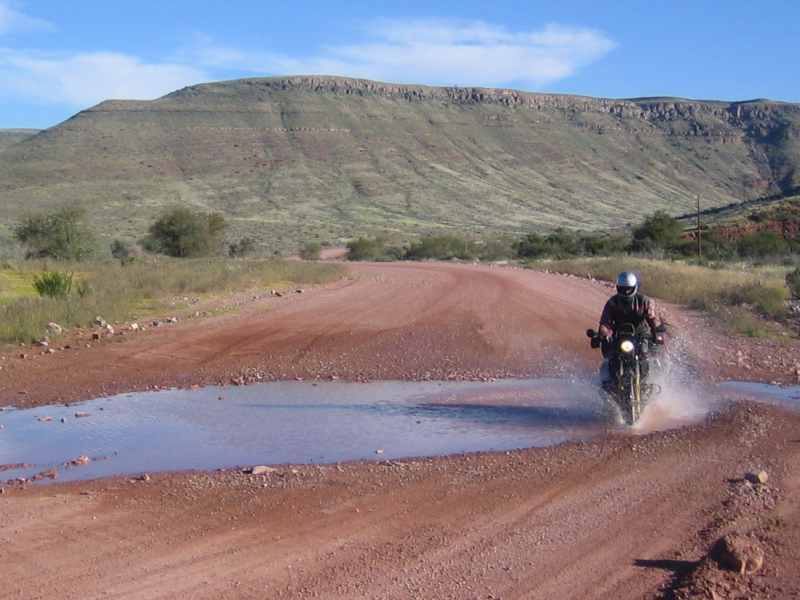
Tightening the steering head nut using an adjustable wrench, a lug wrench and an extension

A pleasant ride on tarmac took us past Mariental and Keetmanshoop, through wide open spaces, dotted with rocky hills and quiver trees. Known as `kokerboom', the quiver trees were used by the San people. They just hollowed out the branches to make quivers. It was getting close to dark as we approached our destination, Savannah Lodge, near Grünau. It was off the road about a kilometre, and we took it easy on the sandy road in the fading light. A springbok bounded in front of us, and we knew that at dusk the animals would be on the move so we were extra careful. Just as the sun dipped below the horizon, we made it. Usually we don't cut it so close to sunset, but it was a really early sunset, 5:15 pm. The sad part is that the campground was closed for renovations, and the lodge was full. So, we had to ride further in the dark. The sandy road out was more difficult in the dark, the highway more ominous. Luckily, the lodge owner had phoned ahead for us to see if there was a room at Florida Lodge, a place about ten kilometres up the road. We rode past dark silhouettes of mountains and trees and then tackled another kilometre of sandy road. This one had deeper sand and made for an interesting ride, the bikes slipping sideways, but we made it without incident. The place was a working farm, with a few bungalows for tourists. After eating our complimentary homemade biscotti, we tried to sit outside, but the bugs were huge in number. They weren't biting, but the dive-bombing and buzzing and swirling and crawling was too much for me, and I took refuge inside. We had been provided with a basket of goodies for breakfast such as eggs, jams, and huge amounts of bacon and sausage which we cooked for ourselves. Everyone around here were big meat eaters, probably because of all the game that was readily available.
A quiver tree
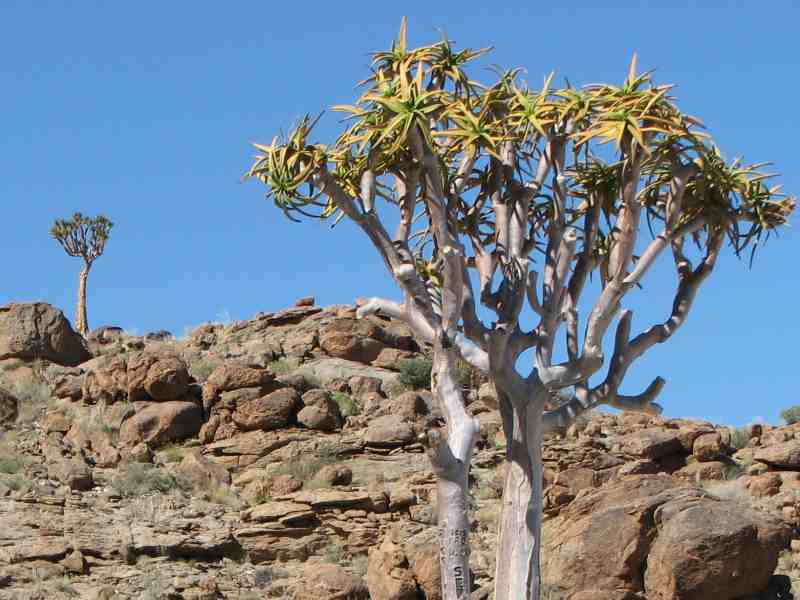
The ride out to Ai-Ais Hotsprings was mostly pleasant gravel, the last part twisting through rocky kopjes, or hills. But it wasn't until we got to the gate that we were informed, with a small, handwritten sign, that the springs were closed for renovations and there was no accommodation open. Couldn't someone have mentioned it before we rode all the way out here? Good thing it was still mid-afternoon, and I think I was almost getting used to sandy gravel. I still had to stop and paddle through the sandy dips, though. Ekke powered through them, with the bike occasionally fish-tailing. Neither of us wiped out with our chosen methods. A lady at the Shell in Grünau had recommended that we stay at the Cañon Roadhouse, where we could camp and use all the lodge facilities. The place was done up a la `Route 66', complete with a rusty truck with a cactus growing out of it as the central garden piece. An old Honda motorbike hung beside the outdoor café, so we felt right at home. Old gas pumps, signs and license plates completed the interesting décor. Just as we were downing our Coca-Colas, a couple on a BMW R1200GS rode up, and we had a great time chatting about our trips. Des and Gabbie were from Cape Town, and gave us some great info about places to visit and roads to ride. With one campsite available, we shared it, and later, Peter and Henry from Pretoria, two guys on BMW 1200 Adventures, rode in and Des invited them to join us at our spot. We sat by the pool which looked inviting in the heat, but it turned out to be too cold for everyone but Des. Some Johannesburgians chatted with us, and gave us a travel magazine to help with the planning. So many friendly people! Us six motorcyclists went for supper, Ekke finally getting to try Springbok steak. I just stuck with the tuna and avocado salad. Six shooters arrived at the end of the meal (drinks, not firearms), some Jaegermeister liqueur compliments of Des. Then we all tried the Amarula cheesecake, made from the local Marula tree fruit, and absolutely delicious. We were kept entertained with some fantastic motorcycle stories throughout this fun evening.
Look out for wild ostriches
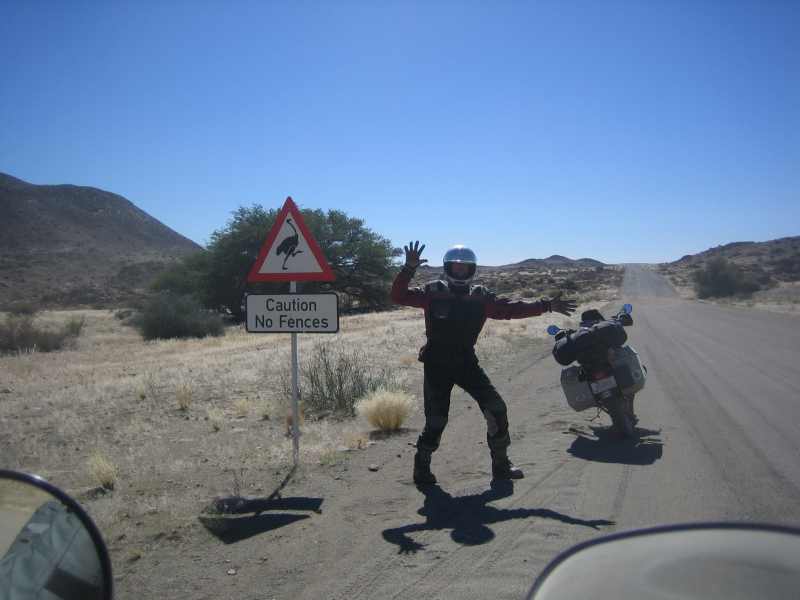
Cañon Roadhouse
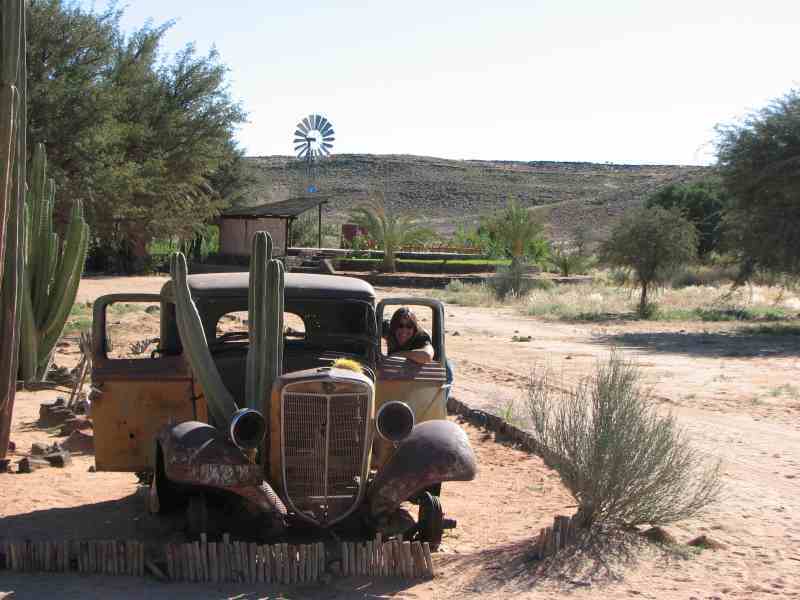
The other bikers packed up and continued on their Namibian adventures, while Ekke and I decided to stay another day and explore the Fish River Canyon area. Just as we walked into the café to get some cold drinks for our ride, a guy noticed our bikes, and within seconds had invited us to stay with him in Cape Town and go for a ride on his 36 foot yacht. Keith has the distinction of issuing the fastest invitation by anyone we've met. He and Jilly were just finishing their tour of Namibia in their Mitsubishi Pajero with rooftop tent, and were on their way home. They were also motorcycle enthusiasts, so we knew we'd have a lot to talk about later. That afternoon, Ekke and I rode the well-maintained gravel road to the canyon and were rewarded with fantastic views. The 500 metre deep canyon was quite spectacular, with sheer drop-offs and high plateaus. With no gear to load us down, the bikes handled really well on a ten kilometre off-road section that wound its way beside the canyon. I was really having a blast, bouncing the F650 GS over stones and ruts, knowing that this is what the bike was designed for. We rode out to little outcroppings, cliffs that seemed to hang out over the canyon, and took some pictures. It was a little scary being so close to the edge with the bikes, and I carefully backed it away from the cliff to avoid the `Long Way Down' to the Fish River. With no mishaps, we rode back to camp. Keith and Jilly invited us for dinner, and Jilly's mince curry was a big improvement over our pasta and sauce. The next day, Wednesday, April 30th, we had a lovely ride through endless scrubby desert which took us to the Orange River Valley, grapevines lining the hillsides. Over the river, we could see South Africa, the southernmost country in Africa, and our final big border crossing of the continent.
No fences at Fish River Canyon
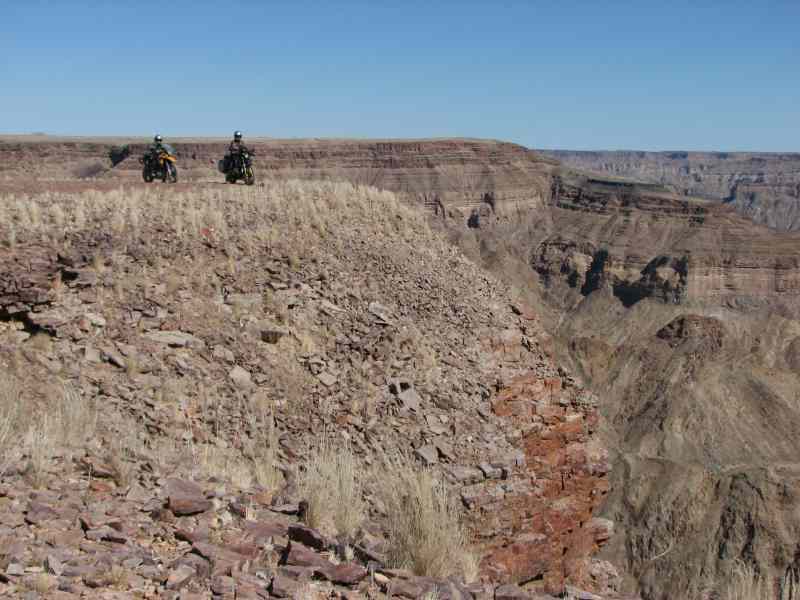
500 metres deep
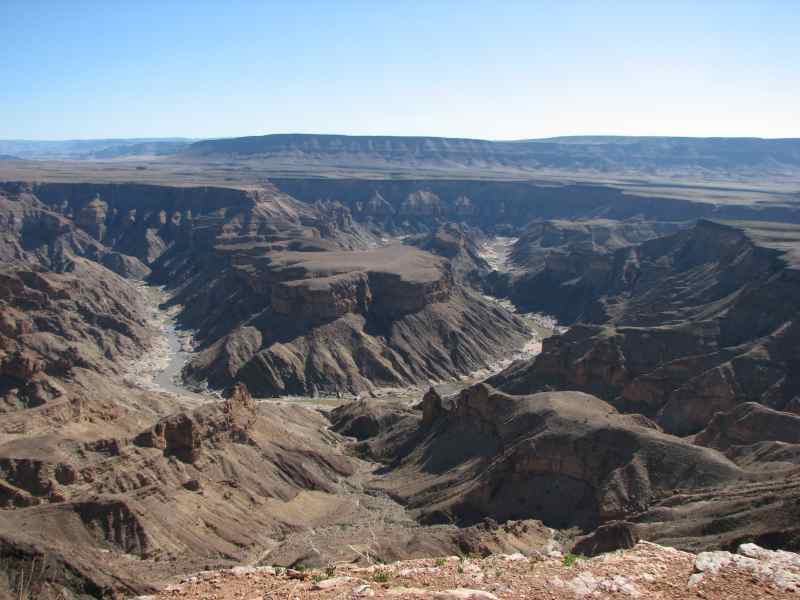
Maps of our route through Namibia

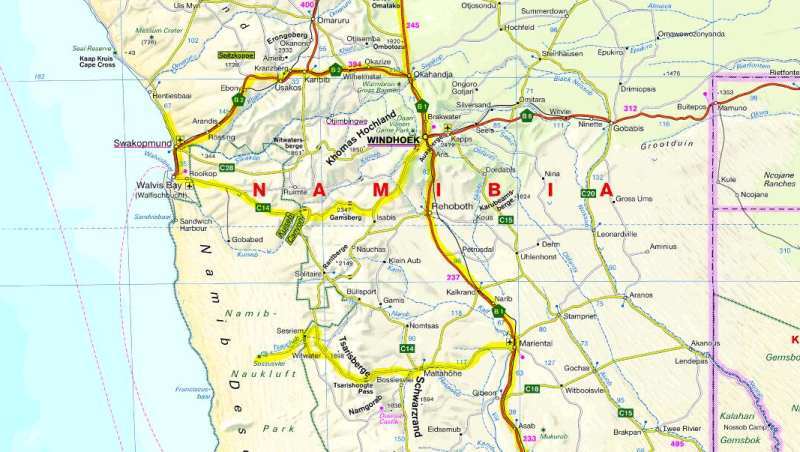
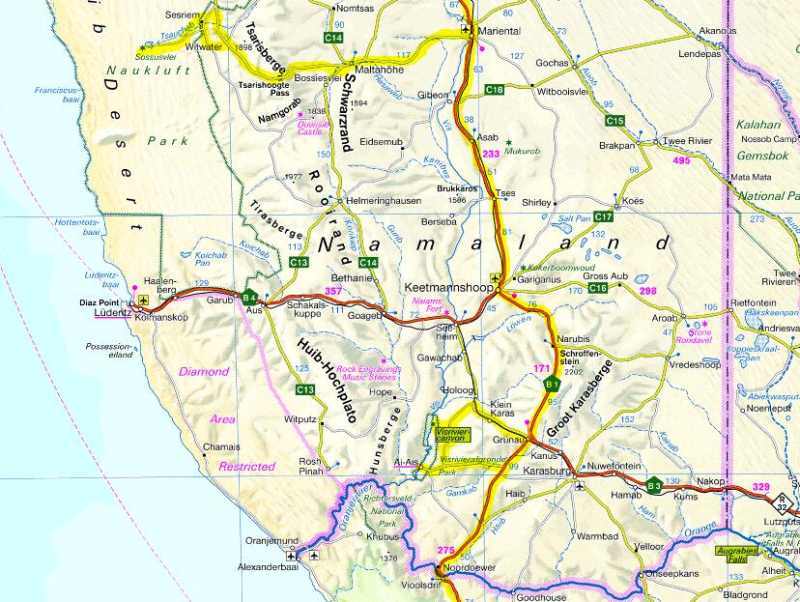
Back to top of page
We crossed the Gariep River, waving to a few kids below the bridge, and entered South Africa. A security guard showed us where to park and gave us a form for stamping at the various entry stations. We walked over to the four stations and were officially in the Republic of South Africa. As has been the case throughout Africa, the change in people as we crossed an imaginary line was quite dramatic. Right away there were a lot more mixed race people, something we hadn't noticed before anywhere else. It was easy riding for the 120 kilometres to Springbok where we stayed at the local caravan park. The Spar shopping centre in town was an absolute madhouse either because of the upcoming long weekend or the end of the month paycheques. When we arrived at the caravan park who should be there but Jilly and Keith. They hadn't had any luck getting a camping spot along the river because of the long weekend and so had come to Springbok. We offered to make them supper this time but for some odd reason they declined so we joined them in their campsite with our pasta and sauce.
Just after crossing the border into South Africa, not far to go now

A mongoose makes sure we have no snakes at the caravan park in Springbok

On Thursday, the first day of May, we left long after Keith and Jilly had packed up and departed. The ride down to Clanwilliam was pleasant enough except for a strong headwind. From there we took a corrugated dirt road to the Lebanon citrus orchard and campground where the Wild Dog adventure motorcyclists (www.wilddog.za.net) were having a get together. Keith had invited us along and they were already set up when we arrived. A group of about 20 people were putting up their tents and preparing their motorbikes for a weekend of off-pavement riding. They welcomed us warmly and seemed happy to see a couple of motorcyclists who had just about ridden the length of Africa. A delicious braai (BBQ) and telling stories into the night made for a great evening.
The sun sets behind the Cederberg mountains

In the morning, while everyone was putting fresh knobbly tires on, I retightened my steering head nut which had come loose on the corrugated road. While we had planned to go through the Cederberg Mountains to Sutherland to meet a friend of Keith and Jilly, that fell through as there was no accommodation to be had on the long weekend. Instead we followed Jilly and Keith to their home in Cape Town. The adventure wasn't quite over before reaching Cape Town though. The wind was just incredible and it was everything we could do just to hang on the handlebars. At one point a fierce sandstorm swept across the highway and it wasn't possible to see more than a few metres ahead. These challenges just made it so much more special when we crested a hill and found Table Mountain and the bay spread out in front of us. We had done it! We had ridden our motorcycles the length of Africa. 23,000 kilometres and 6 months. To celebrate this accomplishment Jilly made a wonderful dinner of roast chicken and potatoes and Keith broke out a bottle of champagne. Perhaps it is a maritime tradition to write on the champagne cork for a keepsake but Jilly wrote MUC - CPT and the date, May 2, 2008. How special we felt!
Keith points out Table Mountain in the distance
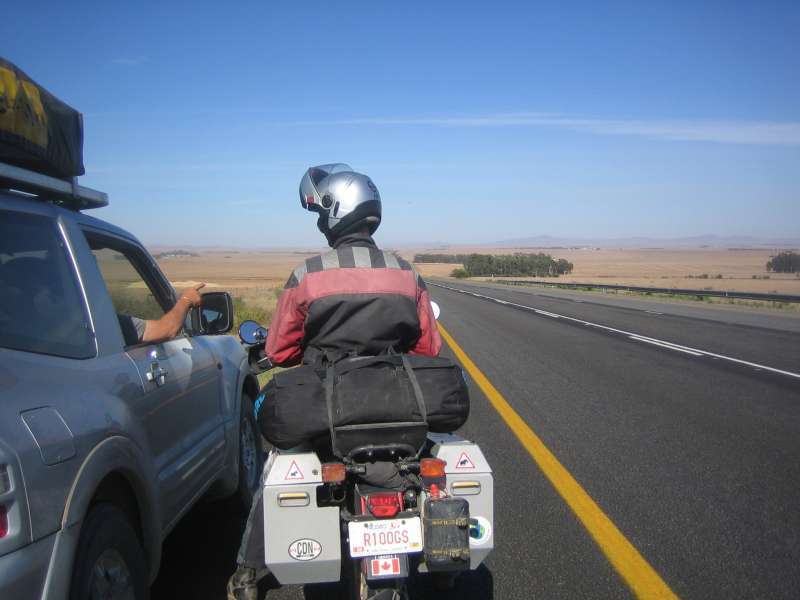
23,000 kilometres, 6 months from Munich to Cape Town
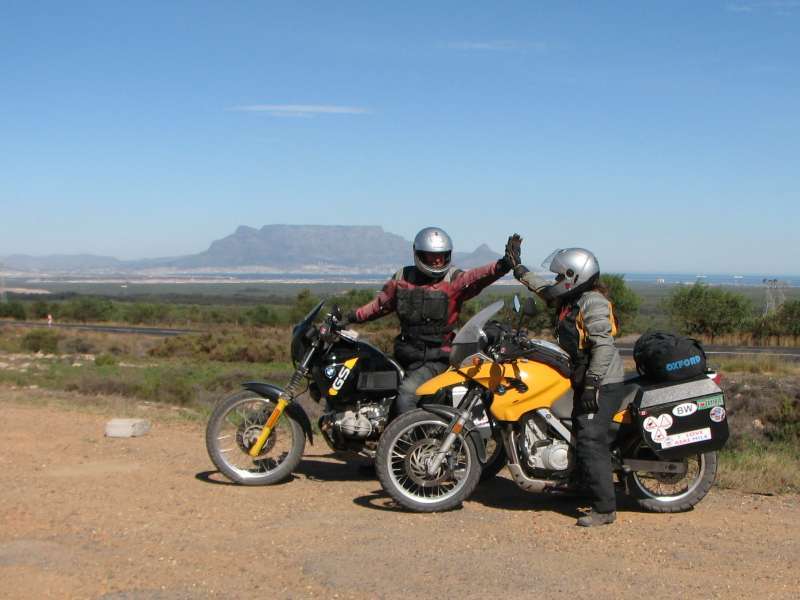
We spent the weekend relaxing at Keith and Jilly's house. On Saturday, after cleaning the bikes, they took us for a ride around the Cape. In Fish Hoek (I wonder if there is a town called Vis Corner somewhere?) we stopped off at The Galley for lunch, enjoying scrumptious seafood. Coming back home we rode along Chapman's Peak toll road. It was easily worth the 16 rand just for the spectacular curves and stupendous scenery. What I really enjoyed about the ride was that with Keith leading I didn't have to navigate. I could just enjoy the scenery and the riding. One thing we noticed was that the transformation from developing world to developed world that had started in Kenya with ice cream and T-bone steaks was now complete. Cape Town was like a North American city such as Seattle or Vancouver with fancy shopping malls and Porsche Turbos. They even called football soccer. Sunday started out great, watching MotoGP racing on TV. The weather wasn't terribly good so we decided to skip the yacht ride and did a bit of shopping in the afternoon instead. We were still on the lookout for some nice camping chairs. The caravan parks we had been staying in didn't have picnic tables like North American campgrounds so a place to sit for supper would be nice. We didn't find the exact chairs we were looking for at Outdoor Warehouse and decided to keep looking. In the evening we had been invited along with Keith and Jilly to Russell and Heidi's place for Russell's birthday braai.
A ride around the Cape with Keith leading on his Honda Transalp
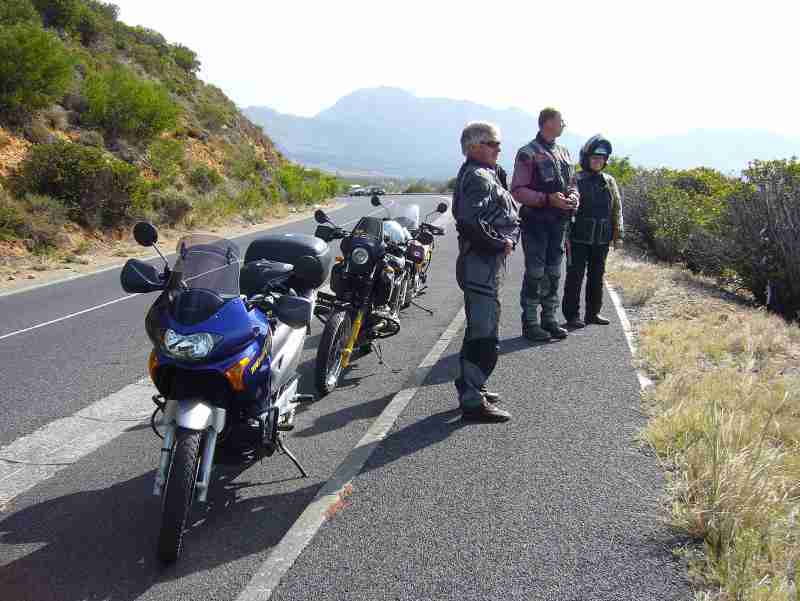
Lunch at The Galley
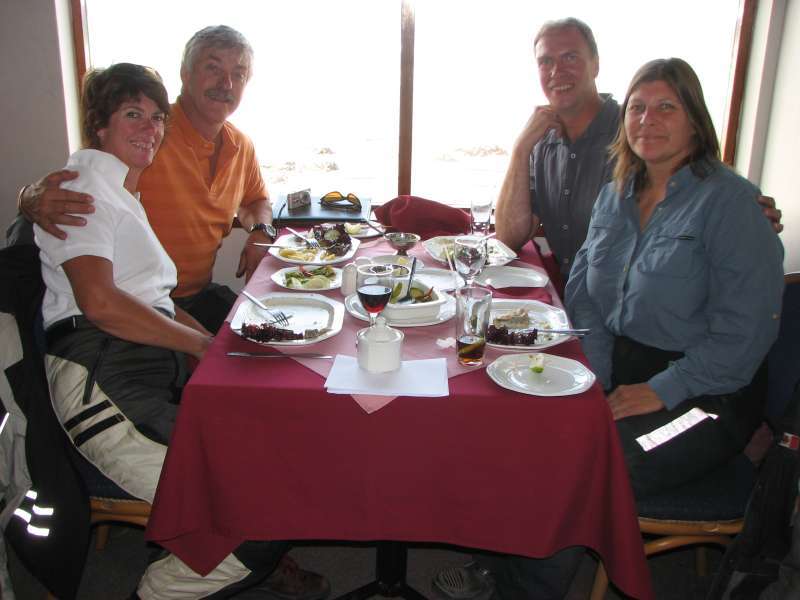
Chapman's Peak road
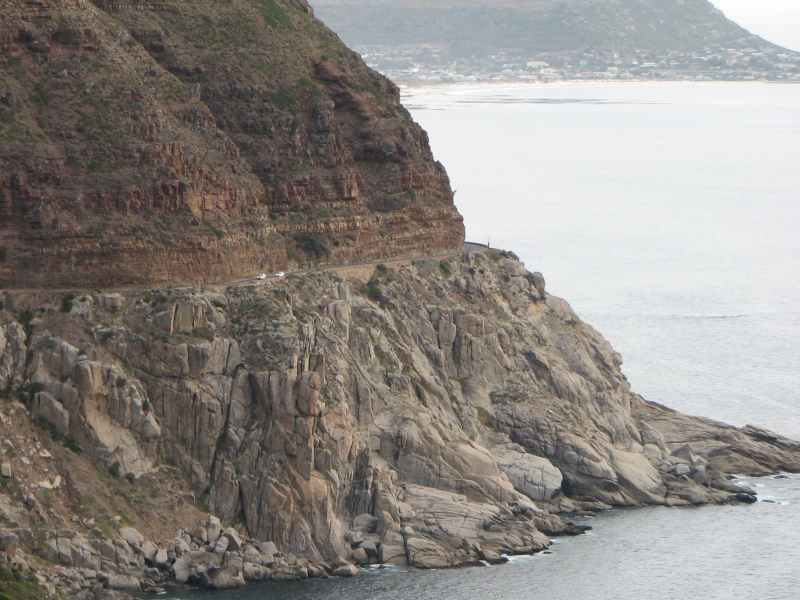
Monday morning Keith had to go to work and so did we. We moved to the Ashanti Guest House after going to Atlantic BMW and booking the bikes in for service. The F650 would get its 60,000 km service done on Thursday and the R100 would get the steering head bearings checked out and the driveshaft lubricated on Friday. Tuesday we went down to the Waterfront to do a little sightseeing. We had hoped to go to Robben Island in the afternoon but it was fully booked so we had to book for Wednesday instead. While walking to the Cape Town Castle, who should be walking the other direction but Herbie the Swiss KTM rider! We had last seen Herbie in Stone Town on Zanzibar. What a small continent. His girlfriend had flown down from Germany to join him in exploring Southern Africa. They hadn't seen Robben Island yet so we agreed to meet at the ferry station on Wednesday.
Audrey has fond memories of Munich

The table cloth on Table Mountain

Bumping into Herbie at the Waterfront
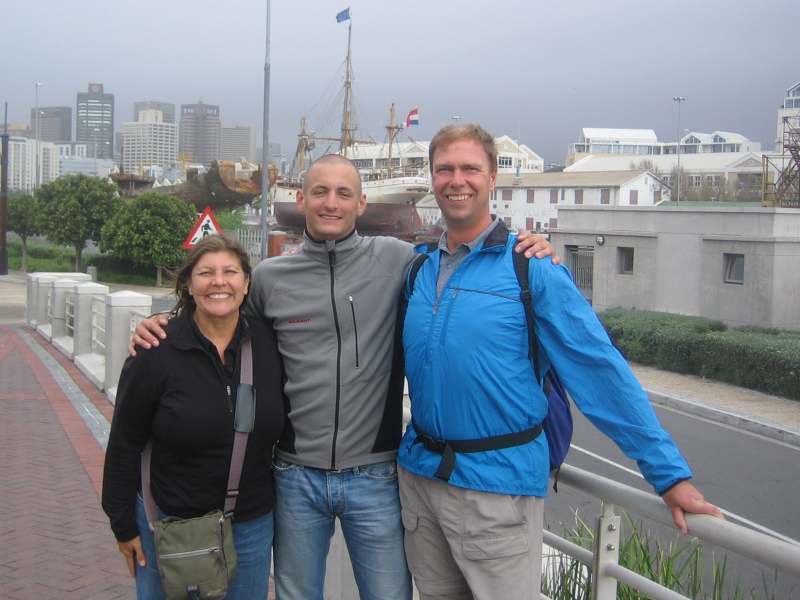
After dropping the F650 off at Atlantic BMW we walked down to the Waterfront and the Robben Island ferry terminal. Herbie was there and said that they had decided against going out to the island but had come to see us off anyway. When Audrey and I went in we were told that the weather was too rough to go out so we rescheduled for Thursday and went outside but Herbie and his girlfriend had left already. At the BMW shop we bought Long Way Down, the latest DVD from Charlie Boorman and Ewan McGregor. On their last adventure they had ridden around the world and now they had ridden from John O'Groates to Cape Town, following most of our route through Africa. We watched the first three episodes on the laptop back at the Ashanti, enjoying reliving the adventures we had going through Sudan and Ethiopia.
We finally managed to get on the Robben Island tour on Thursday afternoon. The beautiful catamaran ferry was pitching like a crazy roller coaster ride and we wondered what the seas were like when the ride was cancelled the day before. Within a few minutes Audrey was rather green around the gills. So she was actually pretty glad when we came ashore on a prison island and didn't seem to care that we had a return ticket. A 45 minute bus ride around the island was very informative and eye opening but for emotional impact the tour of the prison building with a former political prisoner was simply stunning. Our guide was roughly the same age as us so when we heard him tell of being imprisoned at the age of 17 it really hit home. While I was in line to see Star Wars and riding my first motorcycle (a Jawa 350) he was being sent to Robben Island and tortured for being a student activist. Wow.
A former political prisoner takes us on a tour of the prison at Robben Island
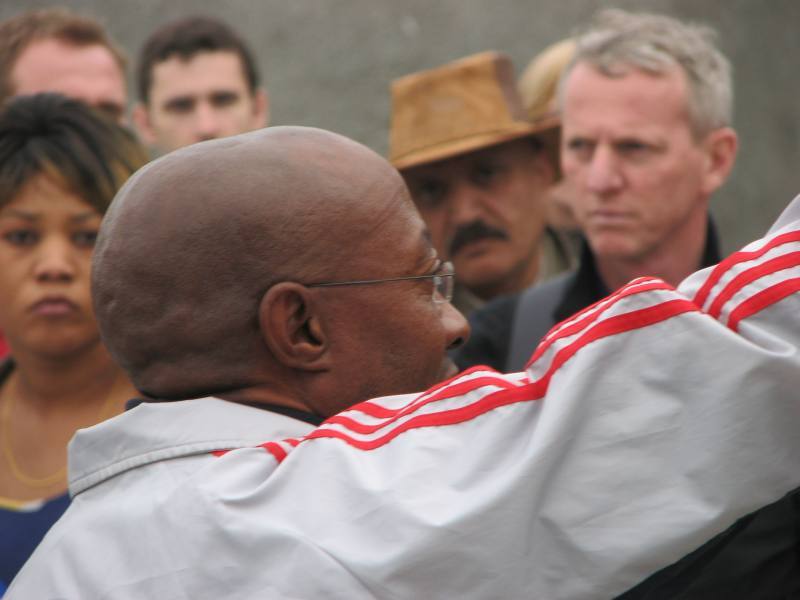
Nelson Mandela's cell

We had arranged the shipping of the motorbikes on Tuesday, visiting MMA Consolidators, so Friday we arranged our own transport. The bikes needed to be disassembled and put on pallets on June 12 (I wanted to be riding my motorcycle in Africa for my birthday, June 11) so we arranged to fly to New York, departing June 13. Since the flight on Emirates went via Dubai we thought it might be cool to have a longer lay-over than just two hours. For only $20 more we could stay over for two days. Done!
Our new non-business cards made in Cape Town (if you have the old one, hang on to the collector's item!)
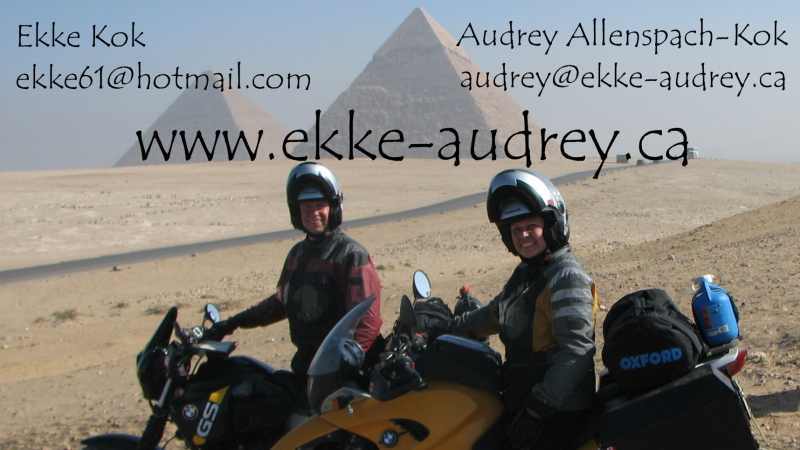
Saturday we moved from the Ashanti (which had no more space for us) to the Best Western, using our Air Miles to pay the much steeper price and then got ready for a Sunday morning departure. With the on and off rain we inserted our Gore-Tex liners and got off after a Mother's Day brunch at the Best Western. We left Cape Town via the major highways and turned on to the coastal road as soon as was practical. The lunch stop at Hermanus gave us an opportunity to warm up a little but we were a month or two early for whale watching. Too bad as Hermanus is supposed to have the best land based whale watching in the world. Unfortunately, the GPS locked up while I was checking accommodation possibilities and it didn't record our tracks from Hermanus to Cape Agulhas, the southernmost tip of Africa. Now we truly had ridden the length of Africa. After taking the obligatory photographs at the meeting point of the Indian and Atlantic Oceans we checked out the local campground (deserted) and Tip of Africa guesthouse. Derrick, the proprietor of the guesthouse was especially interested in our journey through Africa and we spent the better part of an hour chatting over a cup of tea. Unfortunately the guesthouse was a bit over our budget but Derrick phoned Hillary at the self-catering chalets and arranged for us to stay there. Perfect.
Cape Agulhas lighthouse
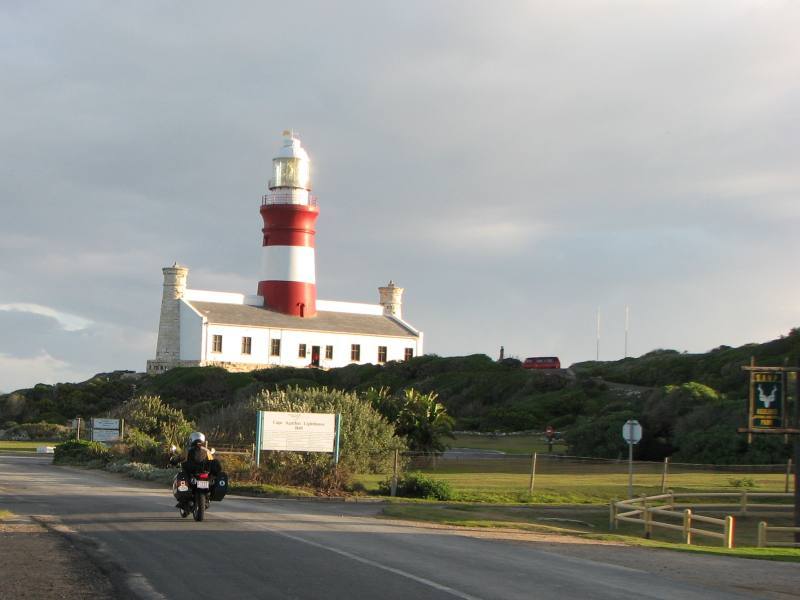
The southernmost point in Africa where the Indian and Atlantic Oceans meet
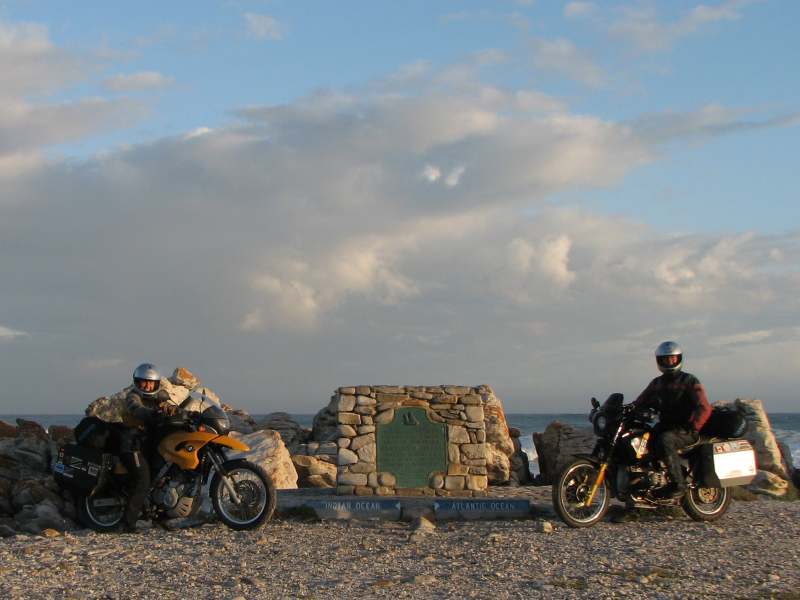
We probably weren't supposed to ride the bikes to the monument...
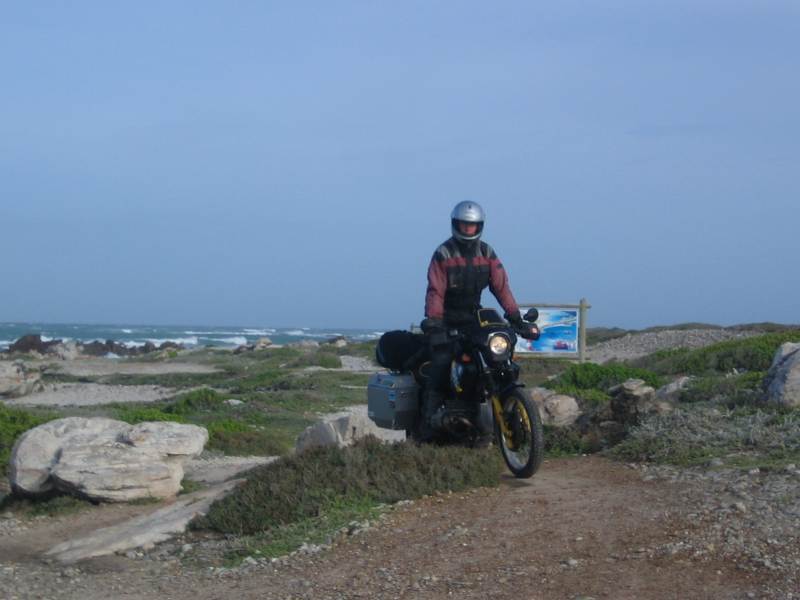
Sunset at Cape Agulhas

Monday morning, with a fully functional GPS, we rode back a few kilometres to the southernmost tip of Africa to record the moment for posterity and then continued a bit further around the cape to see the wreck of the Meisho Maru. Helge Pederson, has a picture of this wreck in his book, 10 Years on Two Wheels. Ten years ago we had met Helge at the BMW MOA National Rally and bought his book, inspiring us to do this very trip. After bouncing along a couple of rough, sandy lanes to a viewpoint overlooking the cape we turned around and went inland. The flat grasslands gave way to treed mountains as we rode to Swellendam (established 1745) for lunch. We paralleled a mountain range towards Ashton and turned right, passing through Bain's Rock Tunnel underneath an English Fort from 1899. After setting up camp in Montagu we headed over to the local hot springs for a nice soak. It would have been nicer if the water was even close to their claimed 43 degrees but a tepid bath was still OK. The waterslide was fun though.
The shipwrecked Meisho Maru

Goofing around on the beach at Struisbaai

How different from other parts of Africa, a nice cloth so that fuel isn't spilled on the bike

Bain's Rock Tunnel underneath the 1899 English Fort

Ekke enjoys a wild ride

After a Full English Breakfast at the Vic 1906 Hotel in Montagu we rode through the Klein Karoo to Oudtshoorn, stopping at Ronnies Sex Shop for lunch. When we talked to a sales clerk she explained that the café's strange name came about when her grandfather opened up a stall to sell fruits and vegetables. He had painted the sign "Ronnies Shop" and then headed into Cape Town for some supplies. While he was away some friends pulled a prank on him and painted "Sex" on the sign. Grandfather wasn't too impressed when he got back but was a bit of a procrastinator and didn't get around to painting it over for a while. Then he noticed that business had really picked up. Now the café is an institution and a "must do" for anyone passing by. Outside Oudsthoorn we stopped at the side of the road in a driveway for a farmer's field to take a photo just as a couple of guys in a "bakkie" (pickup truck to you and me) pulled in to go to the field. It turns out one of them had a BMW R1150GS and he was awfully interested to hear of our trip through Africa. When he heard which campground in Oudsthoorn we were planning to go to he immediately said that the Klein Plaas camp was much better. We never did go to the other camp but Klein Plaas was beautiful. We decided to stay for two nights and do a daytrip over the Swartberg pass the next day.
Audrey doesn't seem so sure about stopping here for lunch
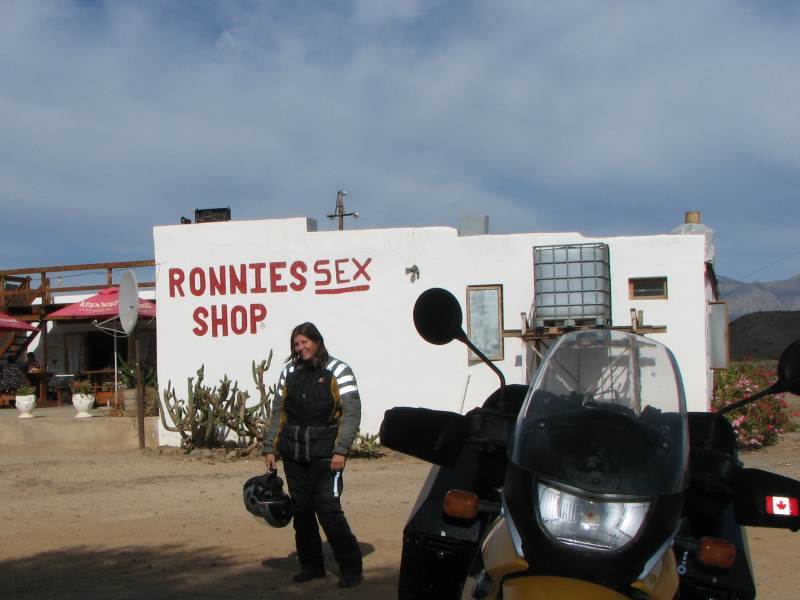
St. Jude's church in Oudsthoorn

My R100GS had been having a little difficulty with starting while hot so in the morning at camp I adjusted the valves and cleaned out the carburettor float bowls. The joys of riding a 19 year old motorcycle! After that we went to Cango Caves, just a few kilometres up the road. We had a great tour of the caves led by "Eric". Eric's real name had some interesting clicks in it and was generally unpronounceable by anyone who didn't speak the local language. I was happy that we didn't sign up for the "Adventure Tour" which went through various tight spaces with names like the "Letterbox" in the extensive caves. I didn't hit my head once on the "Scenic Tour"! Just past the caves the climb to Swartberg Pass on gravel roads started. The road twisted up the side of the mountains with stunning views over the valley below. Once we got to the top we decided to keep going and make a loop, using paved roads on the other side to return to Oudsthoorn. Except for a freshly graded section the gravel road down made for easy riding. We did get passed by two people on mountain bikes though. With only an hour till sunset when we hit the pavement we didn't go a couple of kilometres down the road to Prince Albert but rather sped off quickly on our loop. We returned to Oudsthoorn a half hour after dark, arriving bug splattered but safely.
The impressive Cango Caves

Taking a break from riding up Swartberg Pass

Ekke looking pretty happy

Don't miss the corner or it really is the long way down

Down the switchbacks towards Prince Albert (no, this doesn't look like Saskatchewan does it?)
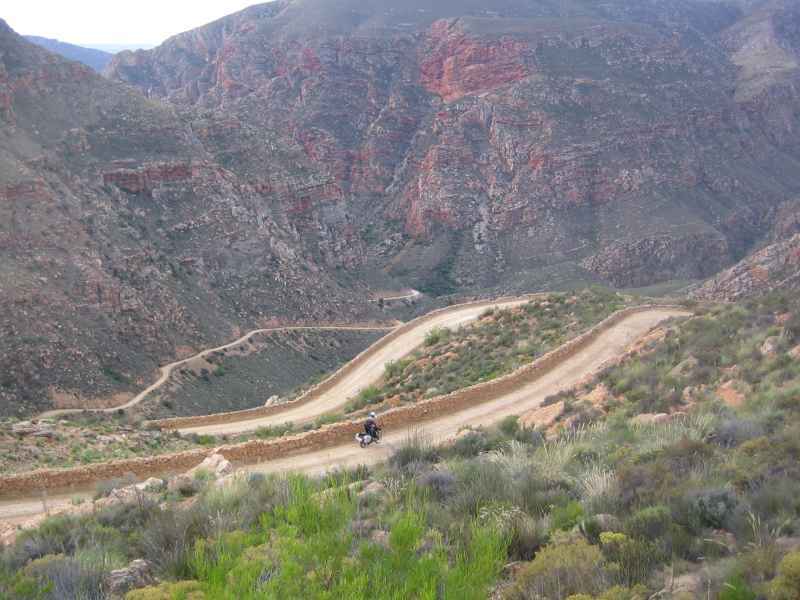
Maybe we aren't really welcome in Oudsthoorn
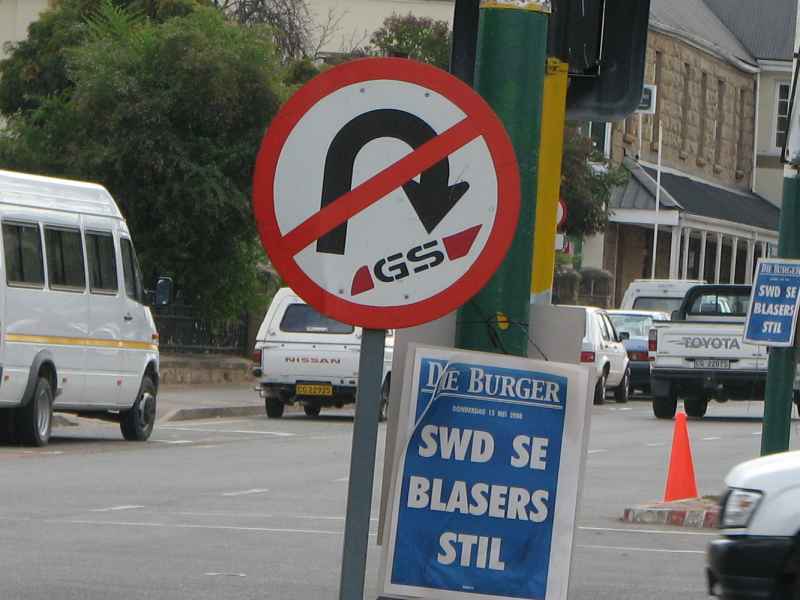
Thursday we only rode 88 kilometres (!) to Mossel Bay. We had plenty of time to do some laundry and then visit the Diaz museum. On display at the museum was a boat built in 1988 that was a replica of the boat that Diaz sailed to Mossel Bay in 1488. The boat wasn't an exact replica as below decks were crew quarters along with a kitchen to feed the 17 crewmembers. In 1488 Diaz had 33 crewmembers and everything happened on deck as below decks was cargo. Also on the museum grounds was a Milkwood tree that was thought to have been the spot that a message was left in a bottle in 1501 by one explorer and picked up by the next making it the oldest post in Africa. We mailed a couple of postcards from the same spot. Unfortunately my bike refused to start after our museum visit and Audrey had to give me a push start. Back at camp after going for a ride to charge the battery we decided to forego cooking and headed across the street to Delfino's restaurant. The place was really popular but we managed to get a table fairly quickly. When we ordered dinner we found out that today was half price day. Wow, a full dinner for two with wine and dessert for only R129. Less than $20.
Replica of Diaz's 1488 ship on display in the Mossel Bay museum

Audrey gets a little carried away with the interactive displays

I took the bike to a battery shop to test the battery and it came back that it was marginally OK and should not be the source of the starting problem. Hmmm. Again the joys of riding a 19 year old motorcycle! At Lynn Schroeder BMW in George I had the oil pressure switch replaced as it was leaking and they also couldn't figure out why the bike was tough to start. Donovan, the chief mechanic, suggested a back road to Wilderness that was fabulous; tight and twisty with picture-perfect overhanging trees. At Victoria Bay we found camping with our own ablution block, just like in Swakopmund, overlooking the bay where surfers were playing.
Saturday we went back up to the old George to Knynsa road for some fun on gravel. We stopped off at the Big Tree where a five minute walk led to the tree. It sure was big. When we got to Plettenberg Bay we found an enormous caravan park easily able to hold hundreds of campers. It was virtually deserted and there was no-one at the front office. We went for a ride around town and when we got back there still wasn't anyone in the office so we just went in and found a spot by the beach to pitch our tent.
A discussion about The Big Tree
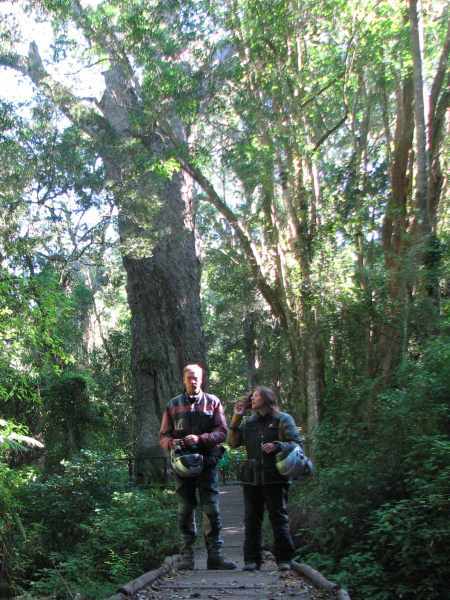
Sure enough, in the morning a security guard came over and told us to go over to the office to pay up. That done, we packed up a soggy tent (from the heavy mist) and rode to the Prince Alfred Pass road. Even though a sign at the beginning of the gravel portion of the road said the road was closed to Avontuur we thought we should ride as far as we could. We had no trouble on the nice gravel up into the hills. A challenging two kilometre side trip from the main road led to the Spitskop viewpoint where one could look over the wooded hills. For some reason it reminded me of the view from Moose Mountain at home. We came down to De Vlugt where we had a muffin break and asked if the road was indeed closed to Avontuur. They told us that the sign was still up from the recent heavy rains when the road had washed away and it was OK now. Suitably refreshed we pushed on to a single lane road through a narrow canyon, enjoying the great ride. We made it to Avontuur and turned onto the paved Route 62 (only 118 km from Oudtshoorn!) back to the coast. We pulled into Cape St. Francis and looked for the campground, passing a fancy resort and conference centre. When we asked a couple walking their dogs where the campground was they said it was at the fancy conference centre. We could camp on the grass beside the swimming pool but since there wasn't anyone staying in the backpacker's dormitory we could have that to ourselves for only a few rand more. Rob, a manager at the resort, was a keen motorcyclist and offered to show us a few nice roads on a map over breakfast in the morning.
Start of the Prince Alfred Pass looks nice enough
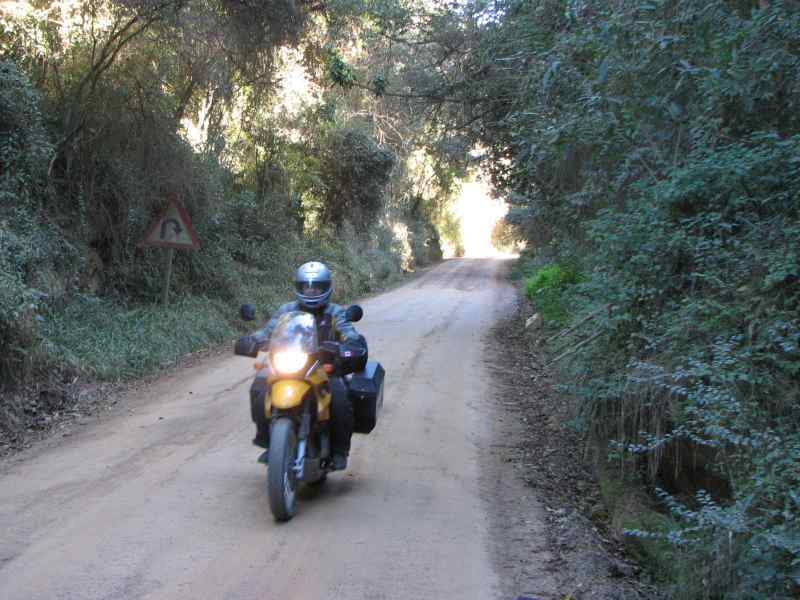
The view from Moose Mountain, er, Spitskop

The single lane Prince Alfred Pass road past De Vlugt
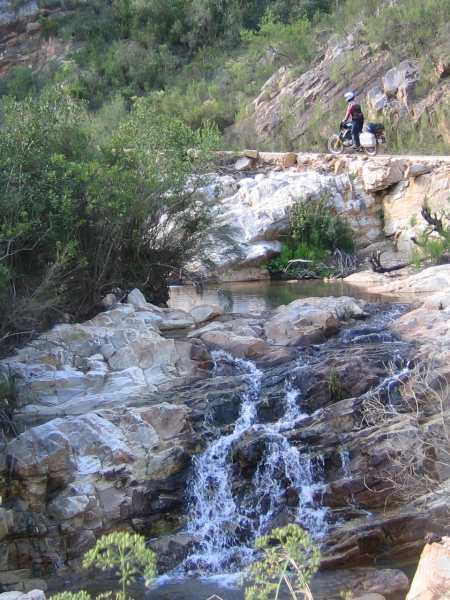
A nice "backpacker's" at Cape St. Francis Confrence Centre and Resort (tent drying out on the veranda)

With Rob's encouragement we rode towards the Baviaanskloof after stopping off at the Cape St. Francis penguin rehabilitation facility. Once at Patensie we had lunch and decided that riding the Baviaanskloof would lead us in the wrong direction, back towards Cape Town, so instead we turned around and went to Port Elizabeth. At the Pine Lodge Resort we phoned Charles and Rensche, a couple we had heard of from fellow travellers. They had ridden 250cc Hondas from England to Port Elizabeth following the same route as us. They were the ones trapped in Marsabit, Kenya, for six days when there was no fuel available during the election protests. The Pine Lodge Resort had a great seafood restaurant so they came over for dinner and to chat. We spent three and a half hours sharing experiences. What a pleasure it was to talk with someone who knew exactly what we were talking about, whether it was convoys in Egypt or sand riding in Sudan. They had some great stories to tell as well and we could relate to them so easily. If you're at the Pine Lodge restaurant I can certainly recommend the seafood bisque. It was delicious! (For Seinfeld fans I mentioned the bisque.)
Except for a colony on the Cape of Good Hope, African penguins live on islands off shore

At the camp an enormous four wheel drive truck with Dutch licence plates was parked a few spaces away. Hein and Bernadette had just picked up their truck from the port (explaining why it was so clean!) and were starting a one year voyage through southern Africa. They invited us over for afternoon tea so we went into town, continuing our search for camp chairs, so that we would have somewhere to sit. We found a couple of chairs at Midas, an auto parts store, and went back to camp. We were greeted with wine from real wine glasses. Apparently you can carry quite a bit in a giant camper truck. Our new chairs were bulky but the reward was supreme comfort. Sadly the 100 kg limit must have been true as by Wednesday morning, after breakfast, I noticed that my chair already had some cracks in the supports. Fortunately Midas cheerfully refunded my money and I promised not to sit in Audrey's chair. We found time to work on the website a bit, do some laundry and have a look at some niggling little problems with the bikes. I also managed to find a sturdier but less comfortable tripod stool.
Hein and Bernadette start their year long trip
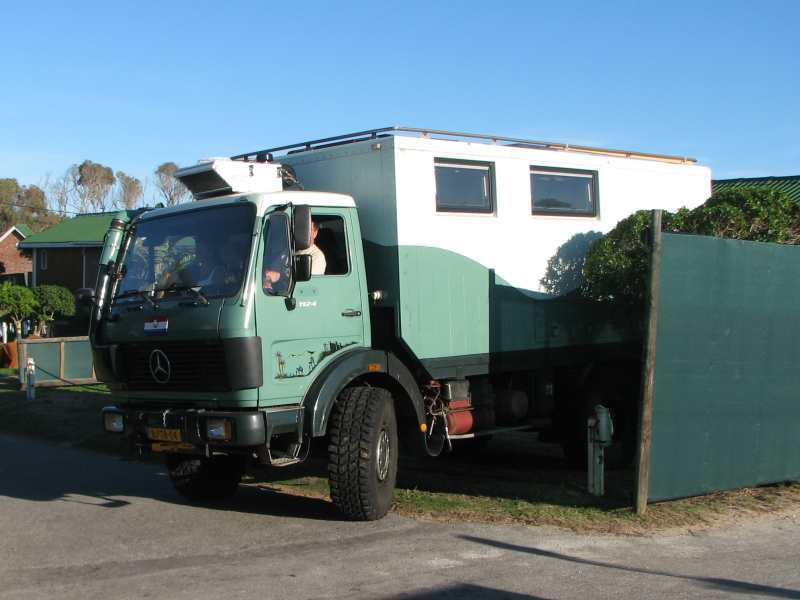
From Port Elizabeth we turned away from the coast and rode north, first to Grahamstown with its beautiful architecture and then on to Queenstown going over Ecca pass (would have made a nice photo if there was a sign). Since we wanted to get to Lesotho we decided to push on from Queenstown after a bite to eat, hoping to make it to Aliwal North before dark. We would have made it too except for a 20 minute construction delay. The campground was huge but completely deserted and a bit rundown. It wasn't as secure as other campgrounds either in that there were sports fields in the same area. The waitron (the gender neutral term for waiter or waitress in South Africa) in the restaurant near the campground was nice enough to turn on the heat lamp in the near freezing cold. We had climbed to 1,600 metres and as soon as the sun went down it got cold. Who would have guessed that our Mountain Equipment Co-op down-filled sleeping bags would be one of our favourite pieces of gear on a trip through Africa?
Robots and waitrons; what a cool country!

In the morning we had confirmation that it might indeed be the battery in the R100 that was causing the difficult starting because with the cold the bike didn't want to start at all. We went for breakfast at the restaurant and hoped that with the morning sun warming the bike it would fire up. No luck, so Audrey had to give me a push start again. We took the N6 north and then turned off onto secondary roads towards Lesotho. Beautiful vistas of wide open countryside made our ride even more enjoyable. Soon enough we were at the border, checking out of South Africa.
A township near Aliwal North

Riding to Lesotho

Map of our ride down to Cape Town from Namibia

Riding from Cape Town to Port Elizabeth
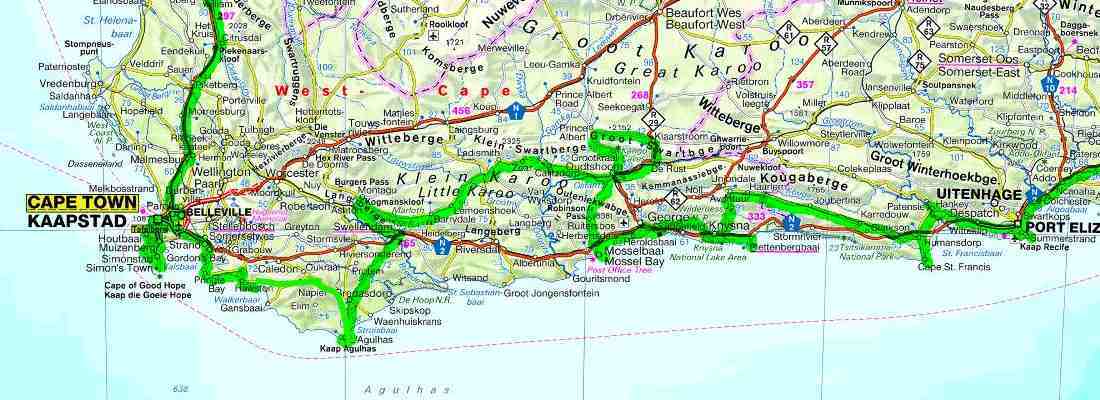
PE to Lesotho

As soon as we crossed the border into Lesotho, our 19th country, we felt like we were in a different world. We just looked at each other in amazement as we passed donkey carts, people carrying wood and water on their heads, cattle and goats being herded down the road, and traditional mud and thatch huts everywhere. Lesotho is a very poor country, and it shows. But the friendly people, especially in the rural areas, were always smiling and waving and excited to see visitors. It was easy getting stamped out of South Africa, and then into Lesotho after paying an eight loti ($1.10) road tax. We rode through small towns, past beautiful landscapes of rocky hills and plateaus in the pleasant sunshine. Morija was the site of the first mission in Lesotho, and as we passed by, Ekke saw a sign for a guest house. A white clay road that was in really poor condition, riddled with water damage, wound up, past mud and cinderblock huts. Perched on top of a hill, in front of a rocky mountainside, was a gorgeous lodge made of stone and thatch. Beautiful flowering plants surrounded the structure, and artsy statues were strategically placed. It was all very modern but in a rustic sort of way. We decided to stay in a red clay cottage with thatched roof for 300 loti ($40) with its own little kitchen and fireplace. What a fantastic location. I sat on the deck in the sunshine, overlooking an idyllic rural scene of horses, ponds and fences. It was probably not as idyllic for the women carrying buckets across the field, as it looked like quite heavy work. Locals here used the lodge's water well, their only drinking water. The lodge kindly provided it as a service to the town. There were about seven staff who attended to our every need, as we were the only guests there. Ekke had a look in the guestbook and noticed that a lot of people from the Netherlands had stayed there, as well as a couple from Lethbridge, Alberta, just a few days prior to us. Ekke took advantage of the beautiful afternoon to disassemble his bike, and clean the starter, hopefully solving the starting problem. I got out the maps and guidebooks to research the next part of our journey. A local woman brought us a supper of 'steak' (mystery meat), mashed potatoes and spinach, and all we had to do was heat it up. The night was chilly, so we were happy that the gardener made us a fire, stocking it with coal so that it warmed the cabin all night long.
Ekke in front of our lodge in Morija at sunset
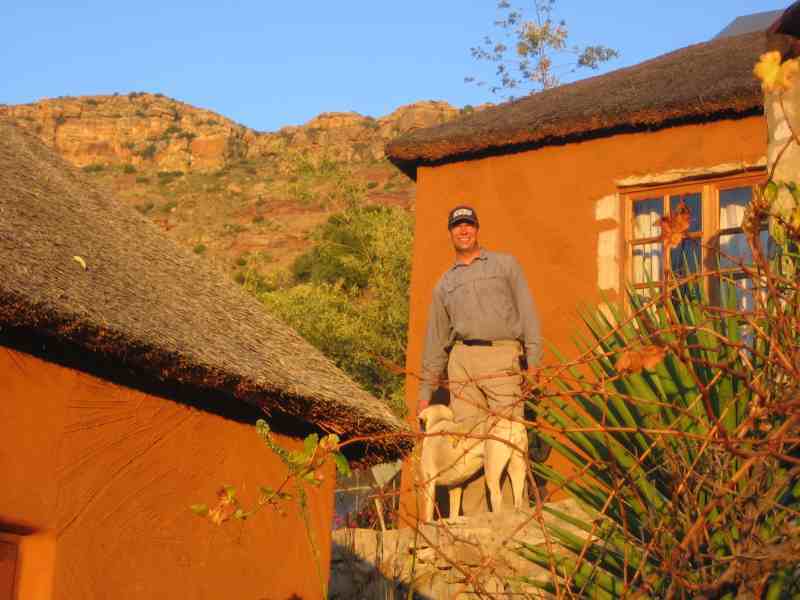
Audrey checks out our pre-prepared dinner

A couple of other local women served us a breakfast of muesli, toast and coffee in the main lodge. A hike up the side of the mountain, following red arrows painted on the rocks, took us to some dinosaur footprints. They were embedded in a huge slab of rock that was standing upright. The rock had hexagonal markings, a sign that this was a damp area in the Triassic period when the dinosaur had stepped in the mud. Later, we checked out the local museum and found out that the rock had fallen down from higher up, and cracked open to reveal the footprints. The dinosaur prints belonged to a Lesothosaurus, which looked like a velociraptor. The museum was fantastic with pottery, weapons and tools of the Basotho people of the past.
Enjoying the company of our rent-a-dog while looking for dino footprints

Lesothosaurus tracks
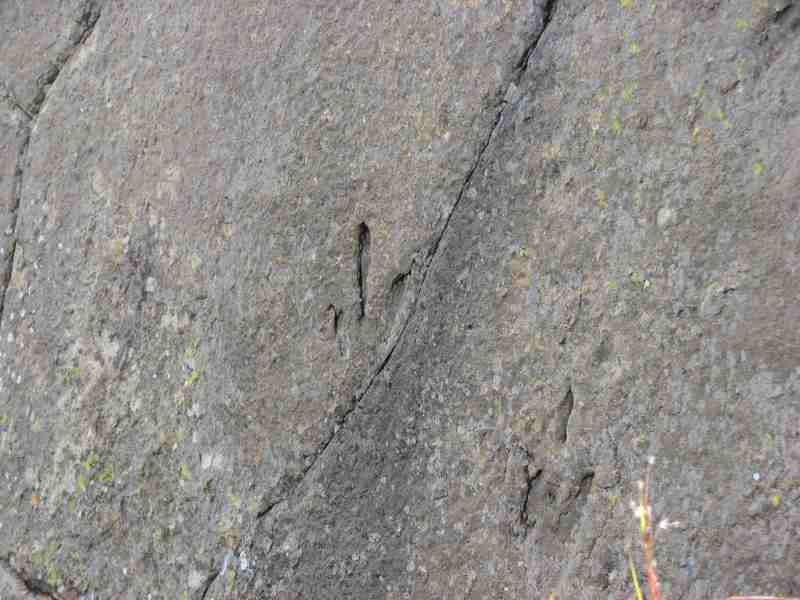
Those were big feet...
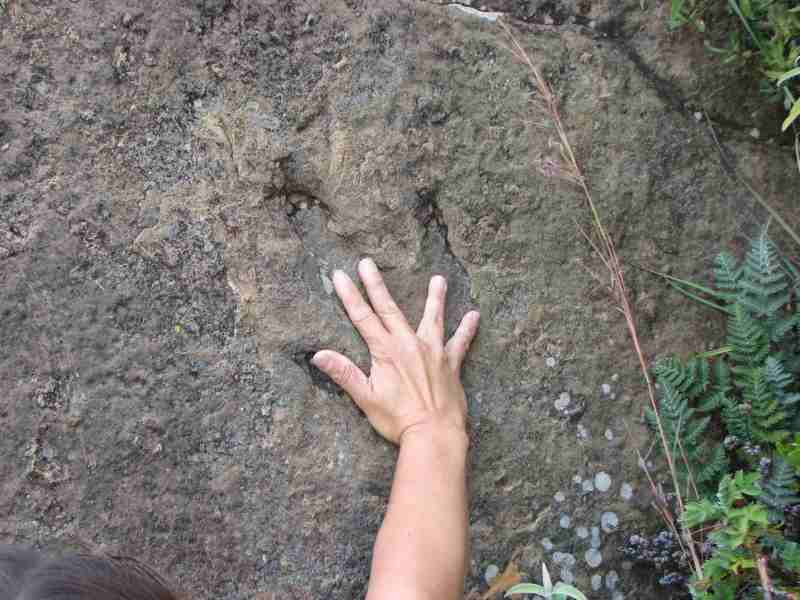
We could have stayed here for days, but in these final weeks of our Africa trip, we were trying to take in as many sights as possible, so off we went to see more of Lesotho. The road to Maseru wound its way through hills and agricultural areas. A lot of the land looked barren and heavily eroded, as if all the trees had been chopped down. Sink holes dotted the hillsides. Maseru, the capital, was a sprawling city, with a lot of apartments and run-down shacks. But, we knew we could find a grocery store in the city, as there weren't any in the rural areas. Ekke waited with the bikes as I did a bit of grocery shopping. A group of about ten young men came to 'chat' with him, eventually trying to sell him something illegal. He had to fend them off with his sense of humour and conversation skills while I waited forever in the grocery line-up. Then they tried to chat me up when I came to back with, "Hey Mama, how are you?" Later Ekke told me what they were up to. It was great to be able to just get on the bikes and ride away from the 'gang'. With people walking up and down the highway, it was difficult to find an isolated spot to eat our sandwiches, but eventually we stopped by some trees. Sure enough, within moments, people came walking by. This was exactly what it was like in the rest of Africa, people everywhere.
The grass-thatched roofs of the huts in Lesotho
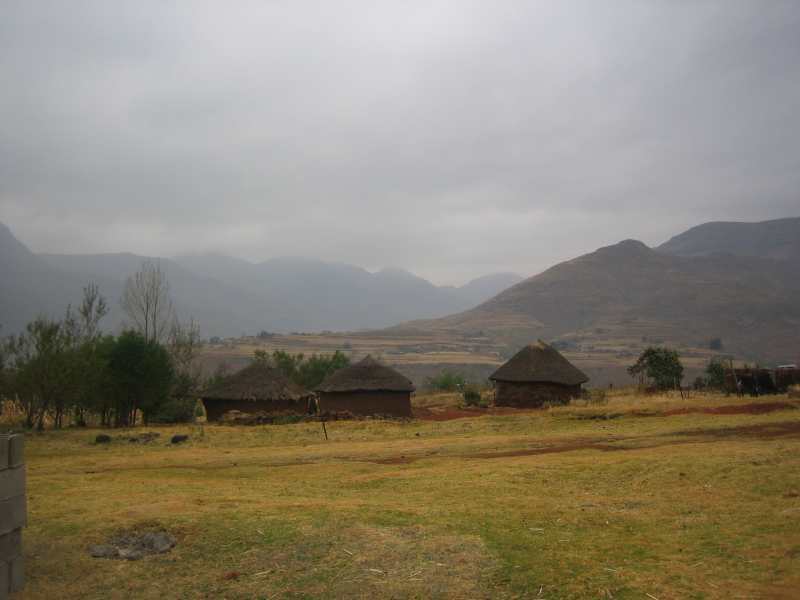
A hotel was a good option as the afternoon turned a bit chilly, and there were no campgrounds, so we rode to Leribe and found a hotel tucked in behind a big fence and gate staffed by security guards. As soon as it got dark, the power failed, and eventually someone came around with a candle for us. Supper in the hotel restaurant was very romantic, all candles and shadows, and eventually the lights came back on. We woke to a rainy morning, and at this altitude, it felt quite cool. Even though we were at the lowest part of Lesotho, we were still at 1600 metres. It would be colder yet higher up, but we had to go explore more of the country. Also, we really wanted to ride Sani Pass, a famously steep and winding 4x4 road between Lesotho and South Africa. So, we headed up, past red mud huts perched precariously on hilltops. Valleys started getting deeper and mountains higher. The rain was relentless and we just weren't getting any warmer. In Egypt we had mailed home a big box of stuff, including our electric vests. How we dreamed of those vests at 3000 metres. Our destination was Moteng Lodge, but as we wound our way through the hills and around a corner, we saw a jackknifed semi truck and trailer blocking the road. In the nearby valley there were some 4x4's creating their own detour through a steep, muddy field, but otherwise, the road seemed impassable. Except for motorcycles of course. We found a tiny passage between the truck and the guardrail and just squeezed by. The 'lodge' consisted of some dilapidated thatched huts and a wooden structure that was serving as a makeshift general store. We asked if we could use the washroom and one of the girls led us out back, to some obliging trees. After standing inside the store for a few moments, not really warming up, we decided that maybe going higher wasn't such a good idea. Back around the jackknifed truck. This time, they were trying to dismantle the guardrail as we rode by. That truck is probably still sitting there. Back down the winding road we passed by locals wrapped in traditional Basotho blankets, riding on ponies. Clearly this was a pony-rich country. The temperature increased a bit as we went down. There was nowhere else to go except back to South Africa. Just before we crossed the border, a man selling hats approached us. Our first instinct was to just say, "No", but I felt so sorry for this guy, out in the cold and rain, hat-selling probably his only income. So, after a little bargaining, we became the proud owners of a colourful woven Basotho hat. But, as you recall, we were on motorcycles and had very little room in our luggage. Our only option was to tie it to Ekke's bike, and off we went, looking quite stylish, waving back at the grinning hat seller. I'm sure he was laughing with us.
Ekke checks with a local about alternative routes around the jack-knifed truck
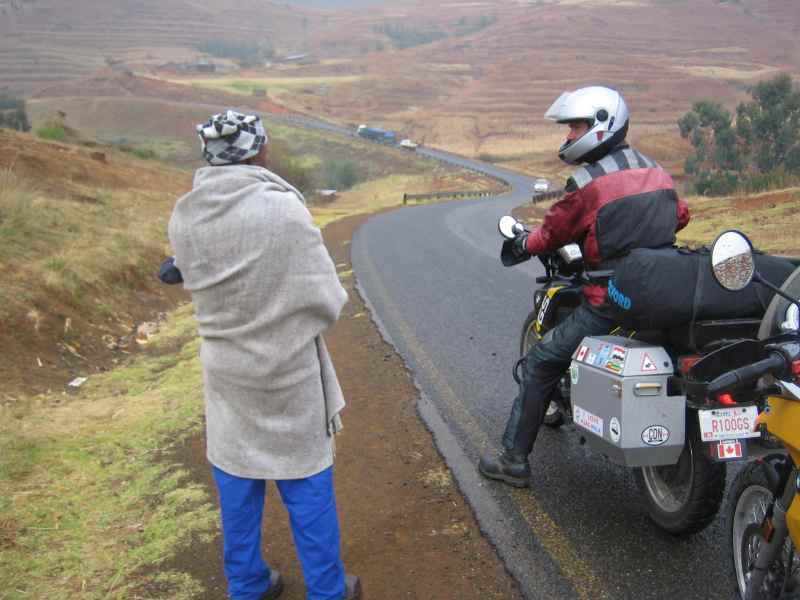
Motorcycles are handy, we don't need no stinkin' alternative routes!
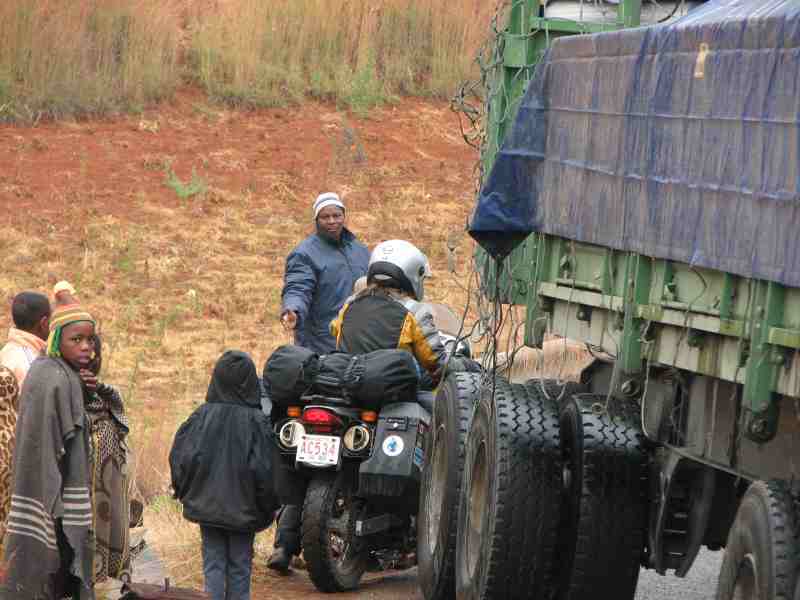
Ekke tries on his new hat

Now where do you keep a hat on a motorbike?

Getting back into South Africa was a bit of a relief. Anything we needed such as food or accommodation, was readily available and predictably of excellent quality and selection. We had only been in Lesotho for two days and had already missed all the consumer goods. Amazing how one gets so used to our Western lifestyle. Our first stop after crossing the border was Fouriesburg, and a quaint little coffee shop chock-a-block with jams and dried fruits and muffins. We wouldn't have seen this 20 kilometres back. A couple from Jo'burg chatted with us for a while and gave us their phone number in case we needed assistance in any way. He had ridden his R1100GS from Cape Town to Cairo in 1997, so we swapped a few motorcycle tales. Then we rode to Clarens, another place of abundance, with art galleries, restaurants and B&B's aplenty. One could almost imagine being in North America, except for that little issue of the townships. Just outside Clarens, for example, were row upon row of dilapidated shacks, garbage strewn about, a clear lack of running water and electricity. It's difficult to get one's head around the first and third worlds living side by side.
A very large township in South Africa
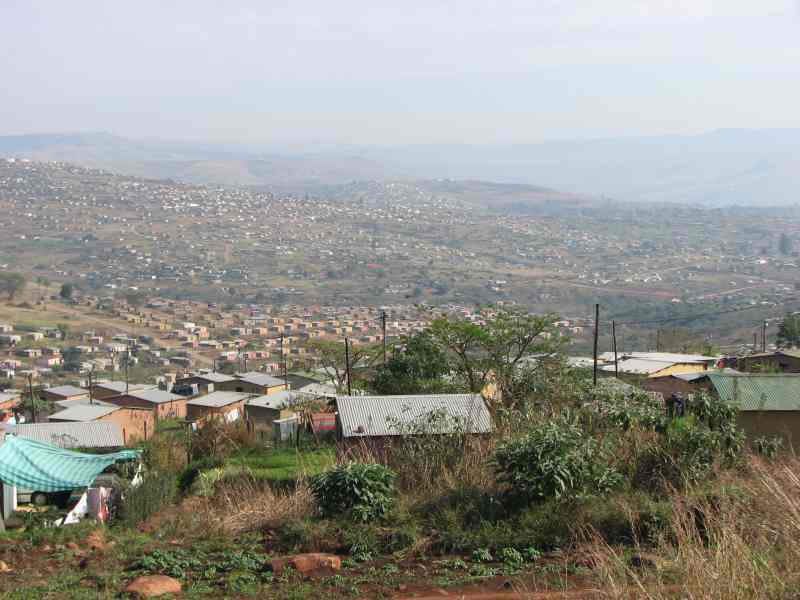
The '278 On Main' B&B in Clarens was a very welcoming place as we still hadn't warmed up. After a couple of hot chocolates, scones and cinnamon pancakes (which are really crepes) in the restaurant, we felt human again, and just enjoyed the lovely surroundings. It was kind of pricey at 500 rand ($67) per night, but we figured we deserved the splurge for our 18th wedding anniversary. It was very chilly the next day, but the mountain scenery was spectacular with the freshly fallen snow. We managed to find a box for the Lesotho hat and mailed it back home, problem solved. As we were leaving the B&B, Ekke pressed the starter button on his bike, but no go. I groaned, and decided I wasn't going to push start it again, especially as I was all bundled up for the chilly ride ahead. So Ekke enlisted the help of a couple of waitrons from the restaurant. They got it in one try, and were quite happy with a 20 rand tip. The rain started up again as we headed towards Johannesburg. Some sort of accident near Bethlehem blocked the road, and we had to detour 70 kilometres out of our way. We rode by the remains of a hailstorm in the form of big ice pellets and were glad we weren't there a few minutes earlier. Happily the sun appeared in the afternoon, so we weren't too chilly when we arrived in Jo'burg. But it was getting dark. I never thought I would be riding a motorcycle through Johannsesburg, South Africa, in the dark, but there we were. Oh, and my headlight was burnt out. Thank goodness that Ekke found a Formula 1 Hotel on the GPS, at the south end of the city. These are French versions of Motel 6, low on ambiance, but inexpensive at $30. But when we went to check in, the desk clerk said that they were full. He advised us to ride to another hotel and gave us instructions on how to get there. As we were leaving he told us that he was waiting for a guest that hadn't shown up, and could give us the room at 6:00 pm if the guest didn't arrive. So we stood in the parking lot at about ten minutes to six, watching every car that drove in, hoping they weren't the one booked in the room. At 6:00, the clerk came out and said that the room was ours. Phew.
Snow on the mountains confirms our decision to abandon the Sani Pass attempt
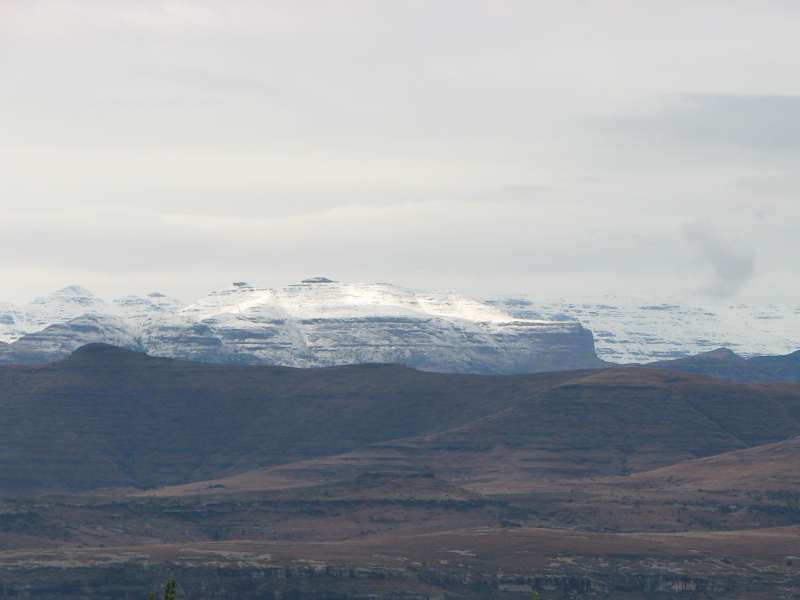
Job one for the next day was to head to Lindhurst BMW to get Ekke a new battery. Of course his bike fired up effortlessly. We made our way through heavy traffic, getting rain-spattered by fast-moving vehicles and eventually found the dealership. Mike in the motorrad department greeted us warmly. After a couple of BMW cappuccinos and some lively conversation, we went to the service department for Ekke's battery. No dry cells in stock, so we settled for an original BMW battery, for 650 rand ($87). They needed to charge it overnight. Jerome, a customer and R100GS rider we met in the shop, offered to show us where we could find A Taste of Africa, a tour company that could take us into Soweto. On the way, he invited us to his place for coffee. He and his wife Benedictine were both professional photographers with Associated Press, originally from France. They told us about some of their photographer adventures. It's a different world here. Jerome rode with us to the tour company and we said goodbye, hoping to meet again.
A BMW cappuccino
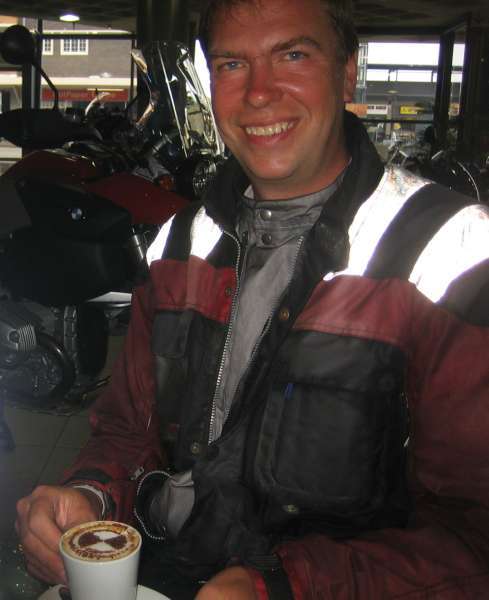
Jo'burg in the light of day resembled any North American city, with skyscrapers and interchanges and suburbs. But what we were really interested in seeing was Soweto. We had been advised not to take the bikes into the township, as currently there were some xenophobic attacks occurring every now and again, around the country. So, in the safety of a tour van, we crossed the city and seamlessly entered the famous township. It was a very lively and bustling place, with people going about their daily business. We drove past the red brick 'houses' that had been built for the original inhabitants when they were moved out of Johannesburg. They were little more than one or two room shacks. Our driver, Tony, took us to our guide's house. Eunice started the tour by inviting us into her place, a tin shack that was surprisingly cozy inside. A big double bed took up about half the space, and there was a counter with a gas stove-top. There was even a T.V. turned to one of those American 'judge' shows. Outside there was a tap with running water, and a small shack with a bathroom, shared with two other households. Eunice took us on a walk around the neighbourhood, showing us the many churches, a library and school. Some places looked quite middle class with lawns and fences, but most were single-room dwellings. Streets were paved throughout the township, which is estimated to have a population of four million people. A soccer stadium was under construction, and would be ready for the 2010 FIFA World Cup. We bought some fruit, and then some popcorn and ate it as we walked through the neighbourhoods. When the rain started, Eunice phoned Tony, and we got a ride in the van for the remainder of the tour. The drive took us past Winnie Mandela's house, then Archbishop Desmond Tutu's, and finally Nelson Mandela's former residence, which they were turning into a museum. The spot where Hector Pietersen, the 13 year old boy who was shot by police during a protest march, was marked with a memorial. It was very touching. The Hector Pietersen museum chronicled the student uprisings in Soweto through pictures and video. All in all it was an eye-opening experience, seeing how this community had contributed to the ending of apartheid. On the way back to the hotel, we had a look at the Nelson Mandela Bridge and a few downtown buildings. As it got dark, and we were still in the downtown area, we got a touch concerned. But, it looked like any other downtown, people leaving office buildings and catching buses and taxis to get home. Ekke finally found a way out and back to our hotel.
Eunice's home is the shack with the white walls

Eunice at home
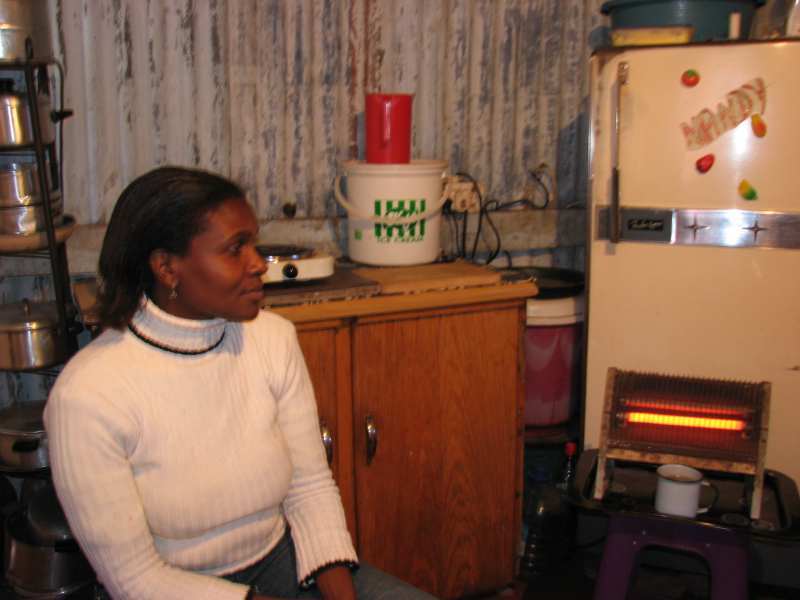
A church in Soweto
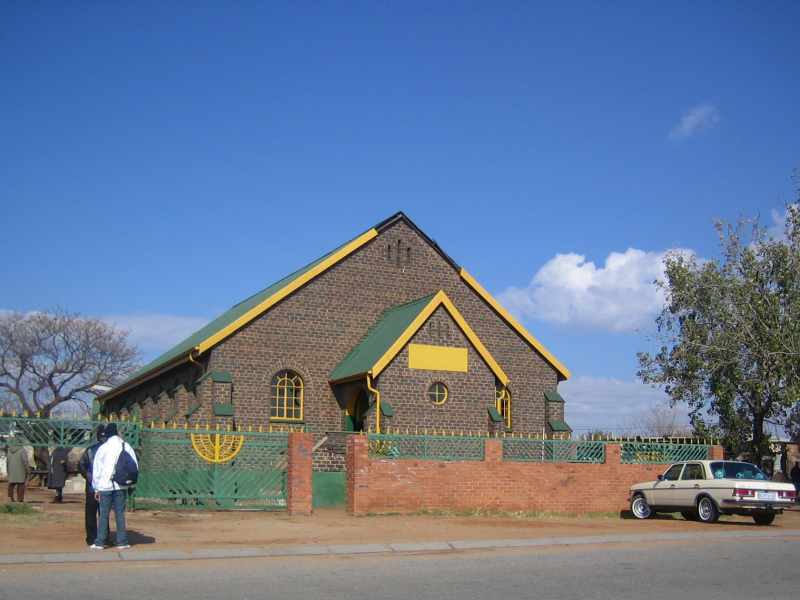
Power station didn't supply any power to Soweto, only Johannesburg
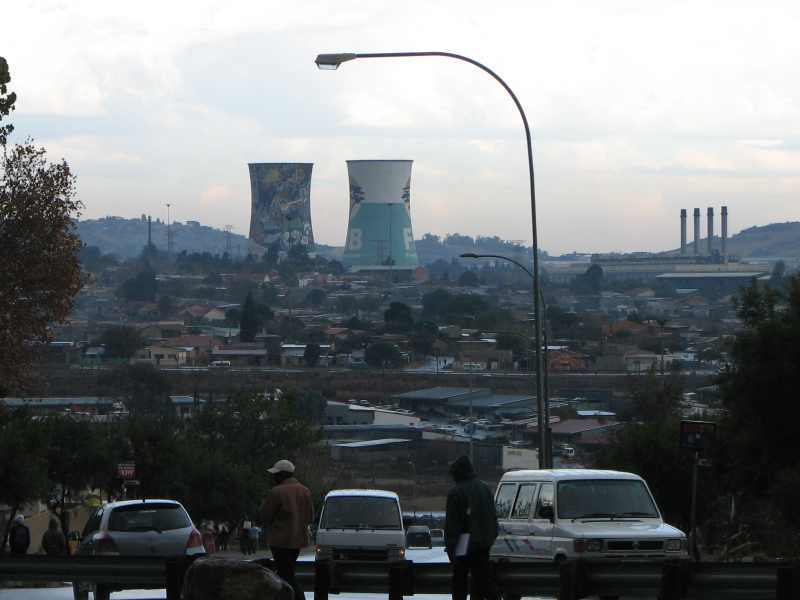
In front of the Hector Pietersen museum
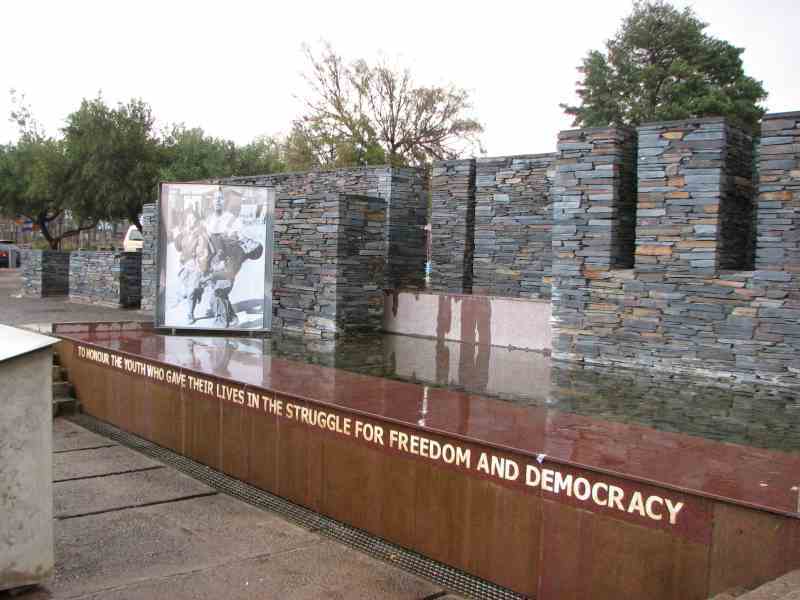
With our tight schedule, we headed in the direction of Nelspruit the next day. It was a divided toll highway most of the way, and in fairly good condition (36 rand or $5 per bike). Then, it was still a toll highway at 49 rand per bike, but with only two lanes, and in bad condition. We had read something in a South African 'Think Bike' motorcycle safety brochure at the hotel. The brochure recommended that we should 'own the lane', so we attempted to 'own' our lane. But that was quite impossible as maniac drivers would tail-gate us, hoping we would move out of the way. Honestly, they'd move to within a couple of metres from our rear wheel, and stay there, all of us travelling at 100 kph. I decided that I didn't need to own my own lane. But I wasn't always comfortable moving over to the shoulder either, especially when it was 4 centimetres wide or suddenly ended or was crowded with people or vehicles. But there was no choice. Life was a lot easier when we just got out of their way and let them own the lane.
Ekke gets a new bike!

Our hotel in Nelspruit, the Ilane, was fantastic, built with stone and wood, with a great English breakfast served the next day. Angela, our host, got us in touch with a car rental agency so that we could go to Kruger National Park. Apparently they didn't let motorcycles ride around this park with the lions and leopards. We requested the cheapest and plainest sedan, but they had to upgrade us to a BMW 320i for the same low price. Ekke was thrilled. A lovely drive past fields and palm trees took us to the Malenale Gate of Kruger. We checked the map at the entrance to see where some of the `Big 5' had been spotted recently, paid our 130 rand ($17 each) fee, and drove off into the beautiful sunny day. Kruger's huge. People spend days there, and still don't see the whole park. We knew we could see just one small corner, and that the animals were really spread out, so we didn't go in with high expectations of seeing large amounts of wildlife. But with the animals few and far between, it made spotting something, anything, into a fun game. We saw our first zebras and impalas, and Ekke spotted the first of the 'Big 5', some Cape Buffalo. At a watering hole, we saw about five giraffes, a young one spreading its legs to try and take a drink. We were pretty excited when we saw our first elephants of the park, the second of the 'Big 5', munching on some leaves. A gravel road took us up to a lookout point, and the BMW was the perfect off-road vehicle, or at least, Ekke made it into one. Warthogs were the next animals to appear, and plenty more impalas and elephants. Seeing a couple of vehicles stopped by the side of the road, we looked where they were looking, and off in the distance we could just make out two lions, the male lying on his back, feet in the air, as males tend to do. We visited the spot again, hours later, and he had maybe moved a couple of metres. What a couch potato. Cross our third 'Big 5' off the list.
A couple of impalas having fun
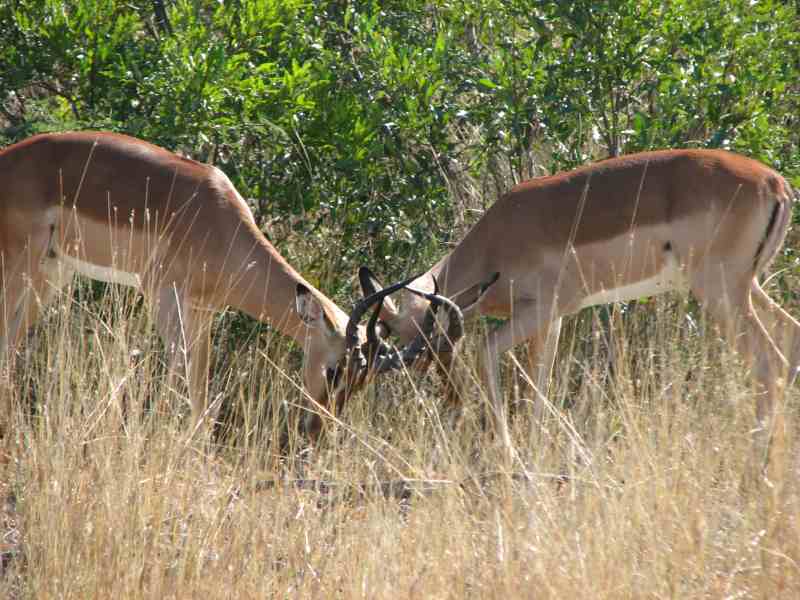
Bush made for tricky game spotting and photography

Tough to hide this guy though

Time for a drink

Audrey takes a break from our rather unlikely safari vehicle
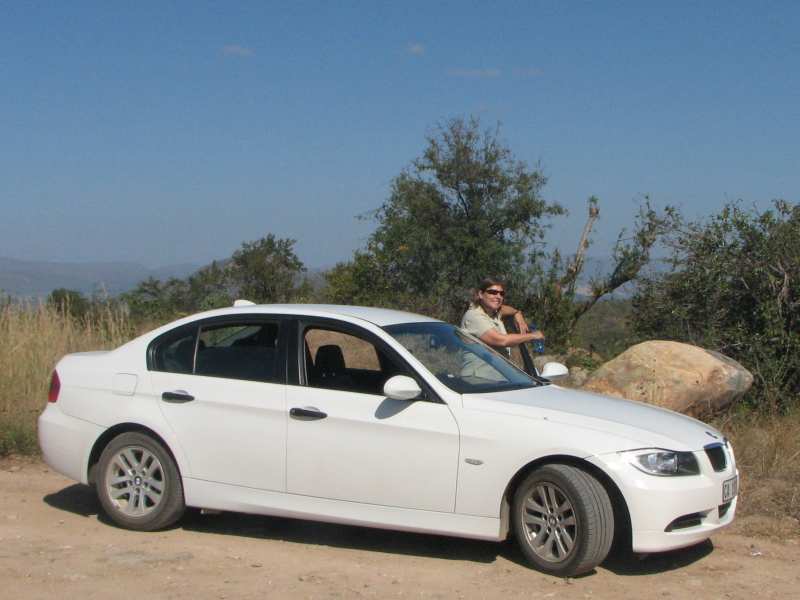
The bushveld of Kruger National Park
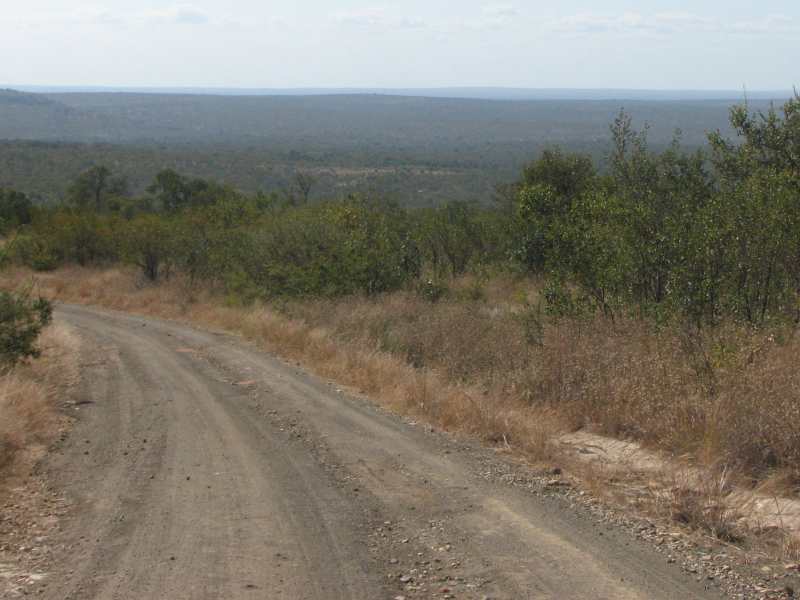
Warthogs having a snack

A couple of gnu in the shade
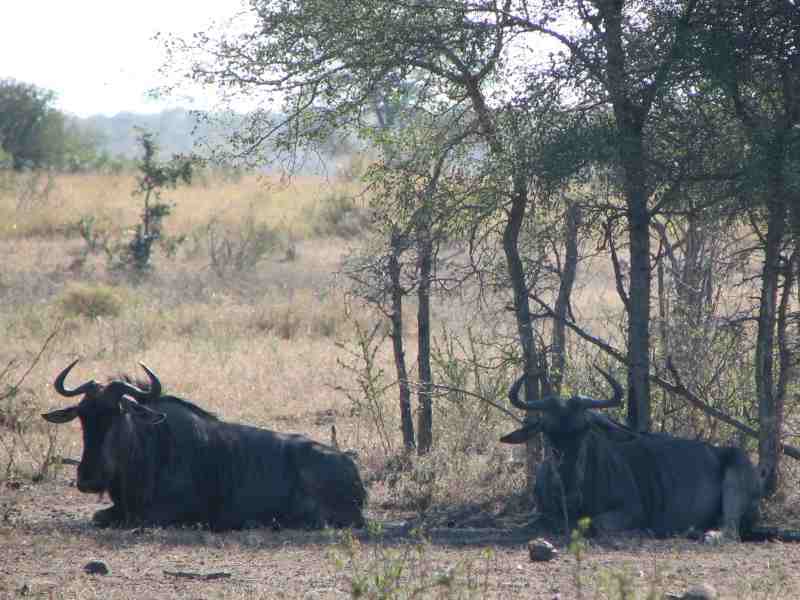
That is one lazy lion
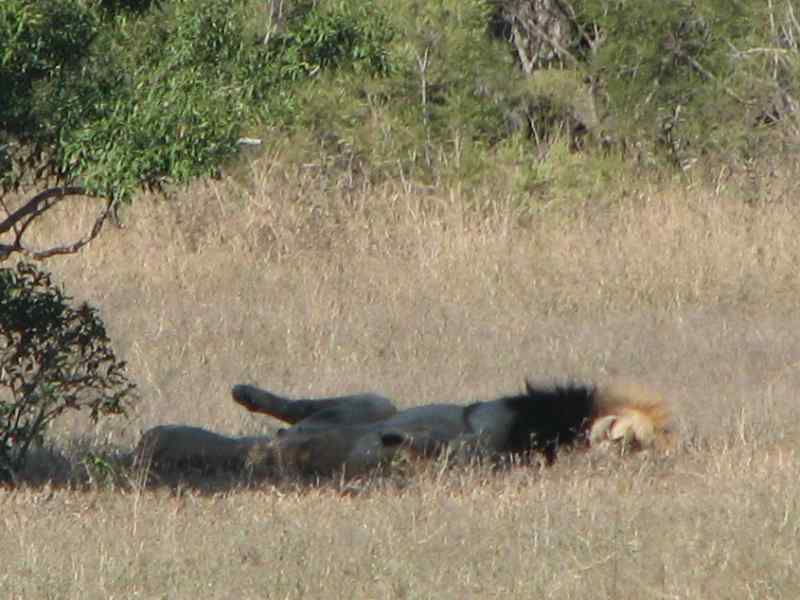
The animal spotting game was getting really fun, especially when we saw species we had never seen before, like bushbuck and kudu. A huge elephant came lumbering toward us at a watering hole, and looked bigger yet as it approached the car. I'm not sure what we would have done if it had sat on us or something, but it turned and went off in another direction. Another encounter was closer still. We had heard there were some lions a few kilometres up the road, so we went to investigate. Hoards of cars made the spot impossible to miss, and we joined the queue to see what all the excitement was. Just waking up from a nap were 5 lionesses, getting up one at a time, stretching, and sauntering to a new spot. Our car was right in their pathway, so it was perfect for watching and taking pictures. The windows were open to snap better photos, but it's a bit different seeing lions at face level from a car versus from above in a safari vehicle. I was taking the photos as one lioness was on my side of the car, counting on Ekke to close my window when the animal got closer. Ten metres away, then five, this was way too close for me. When the lioness was two metres away, the window was finally closed, and I'm really glad that the switch didn't fail at such a crucial time. Another of those heart-stopping moments.
Love the spiral horns on the kudu

Long, tall giraffe
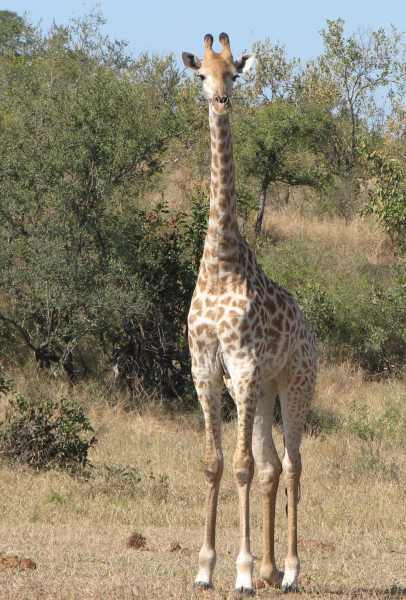
Maybe we should think about rolling up the window?

One metre from a lioness
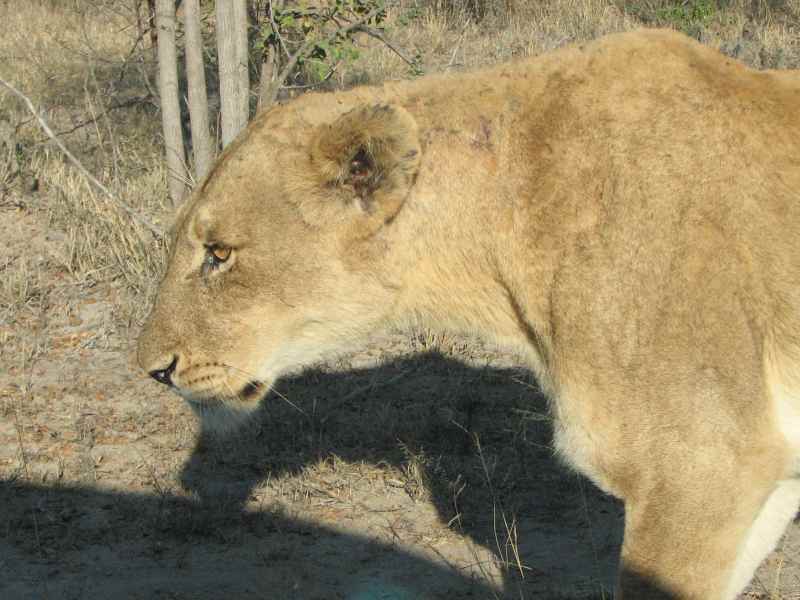
Sometimes we'd go ages without seeing an animal but we searched every minute of every hour. More zebras, lots more elephants, plenty of birds. What a surprise and delight to spot something. But the last of the 'Big 5', the rhino and the leopard, eluded us. According to the map, there had been some sightings of both that day, but no such luck for us. There had also been sightings of the wild dogs that the adventure riding group got its name from but, hard as we tried, we didn't see those either. So, we headed out of the park by the 5:30 pm deadline. The drive past acacia trees and savanna grasses was lovely in the setting sun. Another unforgettable day in Africa. After breakfast at the hotel the next morning, Angela came and told us that she hadn't heard us come in the previous evening and was a bit worried. Apparently people have gotten lost and stuck in Kruger National Park. She told us a story of some guests who had gone down a service road, got stuck, and spent the night in their vehicle, sitting in water. There were so many little roads in Kruger, I could see how that could have happened.
A roller
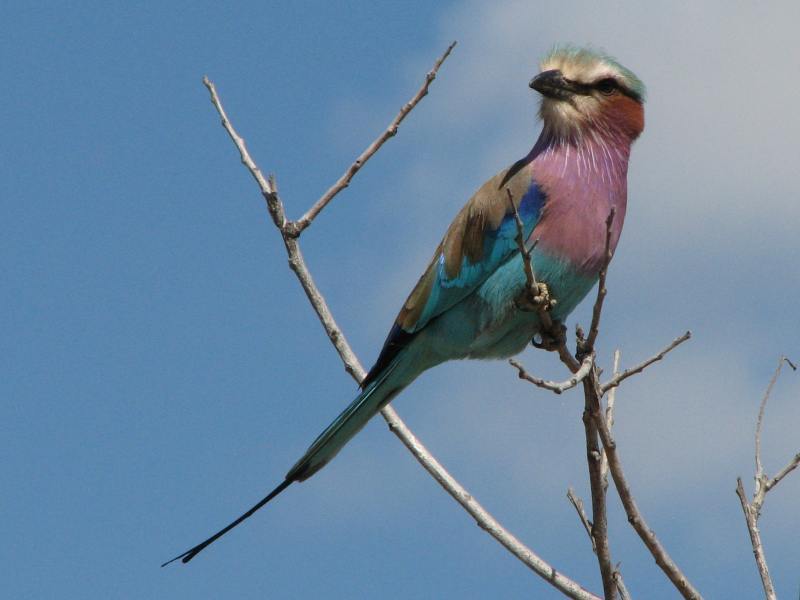
After taking a mud bath

That's quite the shnoz
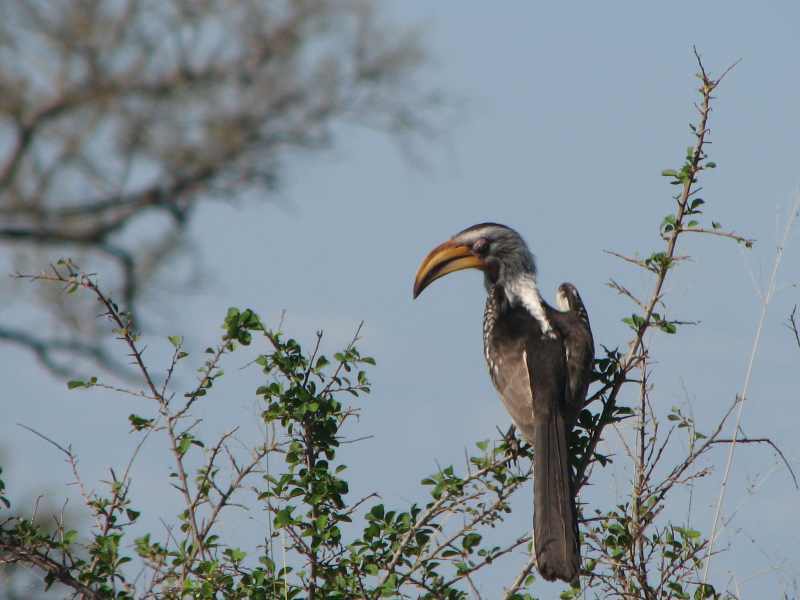
The rental car was picked up by staff later in the morning, and we rode southeast, in the direction of The Kingdom of Swaziland. Well, after sitting at a construction zone for ten minutes and realizing we were on the wrong highway we headed off. After an easy border crossing, we immediately felt that we were in another country. The buildings and huts were just a bit different, the people seemed a bit different. All super friendly and welcoming. It had been recommended to us to come in on the east side of the country and visit Royal Hlane National Park. This was formerly the king's hunting grounds, now turned into a reserve for endangered species. We were greeted by Xona (the X is pronounced as a click of the tongue), who happily checked us into the park, maybe not noticing that we were on motorcycles and that there were dangerous animals here? Maybe rules were a little slacker here in Swaziland. As we rode into the campground, I looked over between some trees and saw a life-sized rhino sculpture. But then, it moved! This was the real thing. The campground was situated right beside a watering hole, and as we got off our bikes and walked closer, we could see five white rhinos and a couple of hippos. Then we realized there was a fence - two strands of barbed wire attached to some very thin wooden poles separated us from these huge beasts. We sat and watched for ages, as a mother and baby rhino wandered along. The hippos snorted loudly and got in and out of the water with great splashes. A younger hippo thought he was a rhino and would try to play with the younger rhino, which caused quite a spectacle. The two would trot through the woods, bumping and nudging each other until the hippo jumped in the water, hoping the rhino would follow. He never did.
Ekke enjoys a Swazi red cake
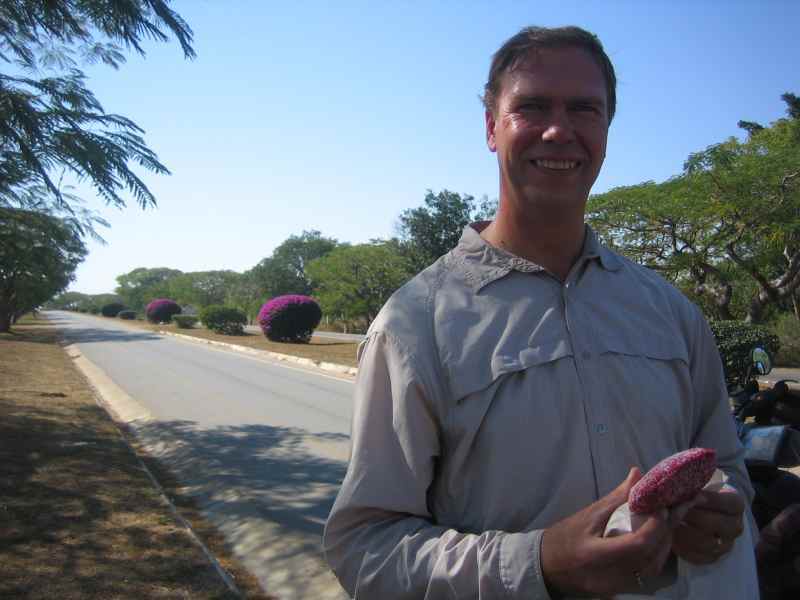
Motorcyclists get to use both cautions

Couldn't a rhino just walk through that fence?
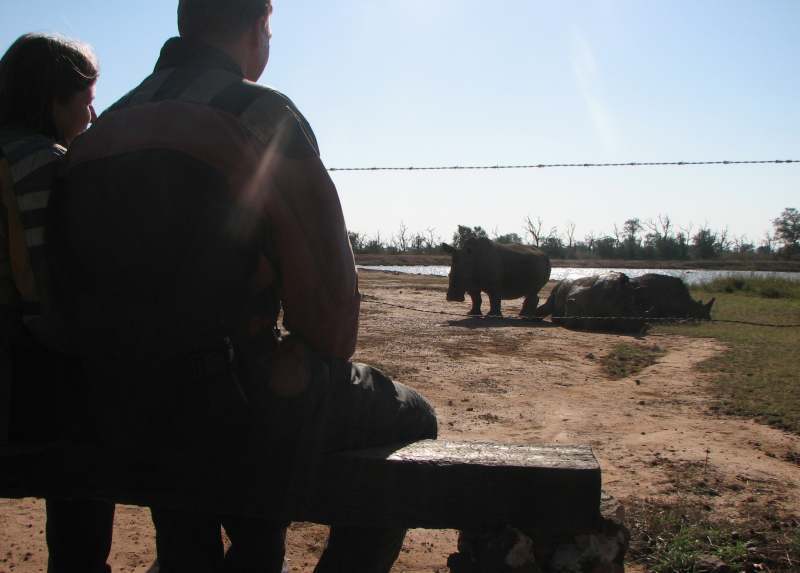
Take it easy big fella

A rhino pup
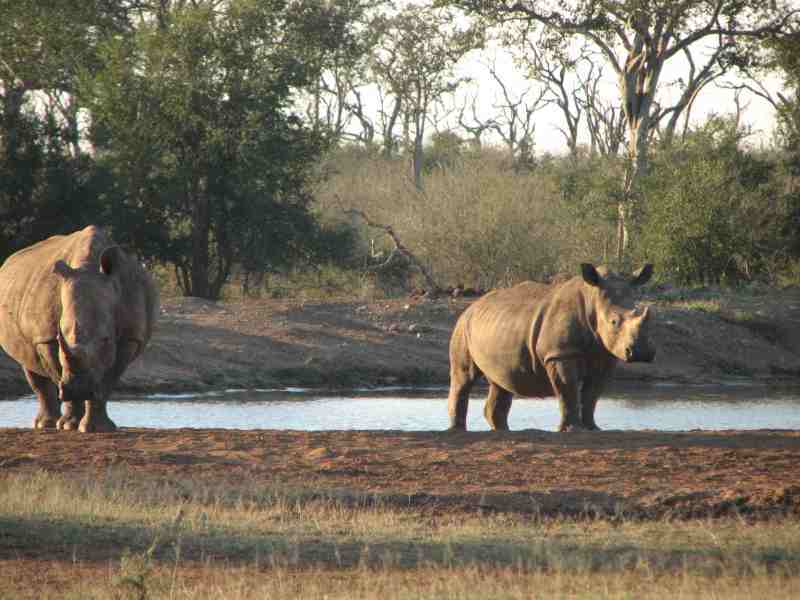
We signed up for the outdoor restaurant dinner, located beside the pond where hippos grunted and splashed. Gas lamps lit the area as there was no electricity, and it made for some real ambiance. It felt a bit strange eating local game, though, with the animals just wandering about only metres away. But the impala stew was delicious, and Ekke really enjoyed his venison, consisting of gnu, gemsbok and some other mystery deer that we hadn't encountered yet, nyala. Later, and very luckily for us, there was a dance presentation by the big campfire. A Swazi dance troupe was practising for a competition and the campers were in for a real treat. The costumes were magnificent, the men in animal skin leggings and the women in colourful cloth wraps. They danced separately, first the men, and then the women, accompanied by drums and singing. The rhythms were infectious and one could almost imagine being in a Swazi tribal encampment, watching the dance before the big hunt. The highlights were the swift high kicks and loud shrieks reminiscent of the Zulu type of dance.
High kicking style
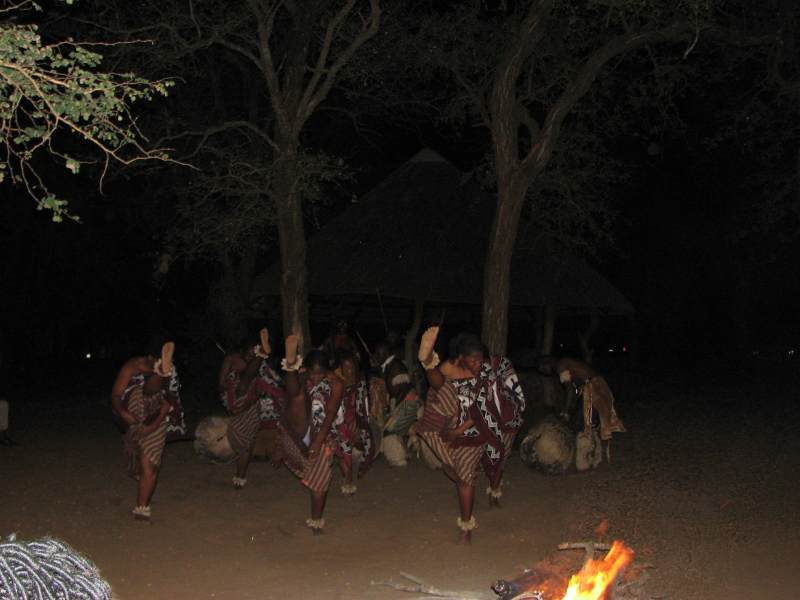
Very similar to the Zulu dancing

That looks like the king on the colourful outfits

The next morning we rented a couple of mountain bikes to take a bicycle safari through the park. Didn't they realize there were wild animals here? Our guide assured us that it was safe, that the leopards were very shy and that we probably wouldn't encounter any. We were taken to a lookout point, a 'bird hide' overlooking a huge watering hole. A crocodile was just hanging out in the middle of the pond, and a herd of wildebeest came tentatively to the edge to drink. We were wondering if we were about to witness a National Geographic wildebeest / crocodile moment, but it was not to be. Warthogs trotted across the field, and vervet monkeys tumbled with each other nearby. After a bit of a rough bicycle ride through the woods, trying to recall our mountain biking skills, we headed back to camp. Our guide stopped partway back, pointing out a trail in the sand. Python. And it was very recent because the trail was over our previous bicycle tracks. When we told the office staff, one lady said that there had been a small cobra in her office that morning. Should have bought that snake bite kit.
Breakfast while watching a hippo at the pool
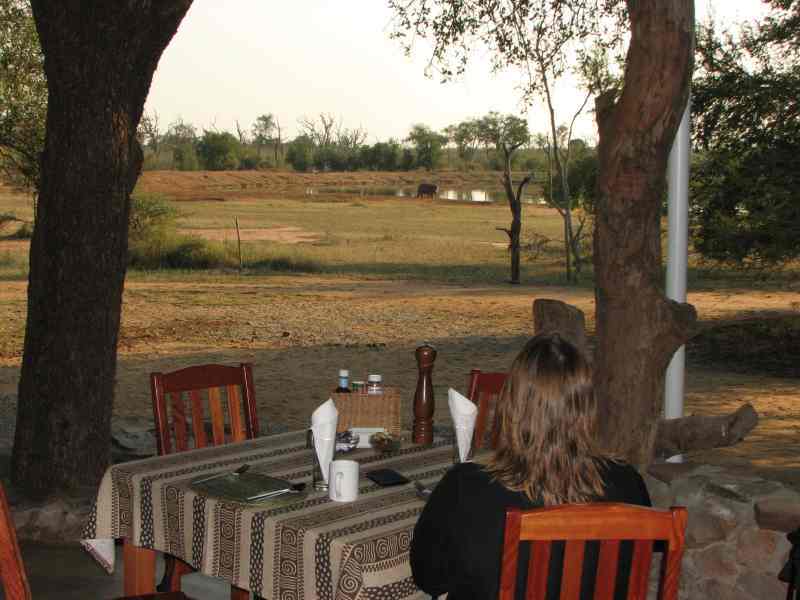
OK, how do you ride one of these things without a motor?
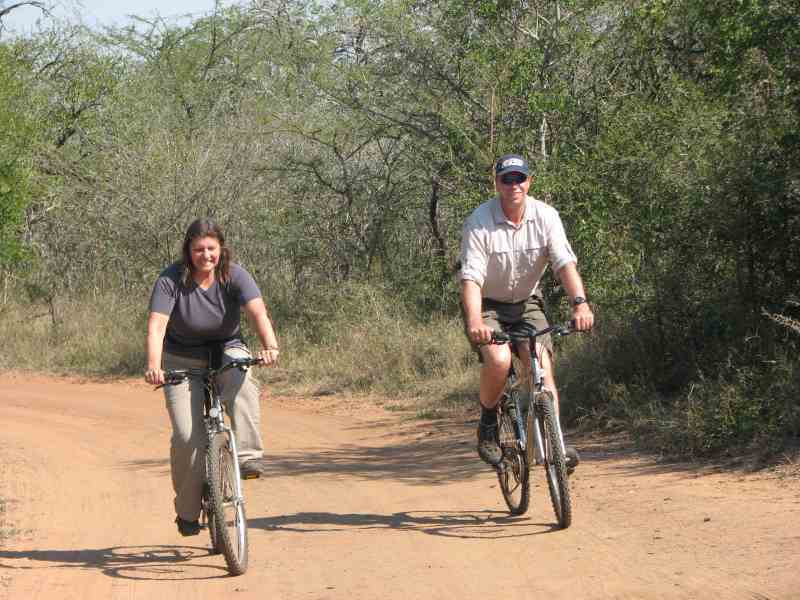
Lots of animals, like these gnu, came to drink at the pond

Warthogs trot by
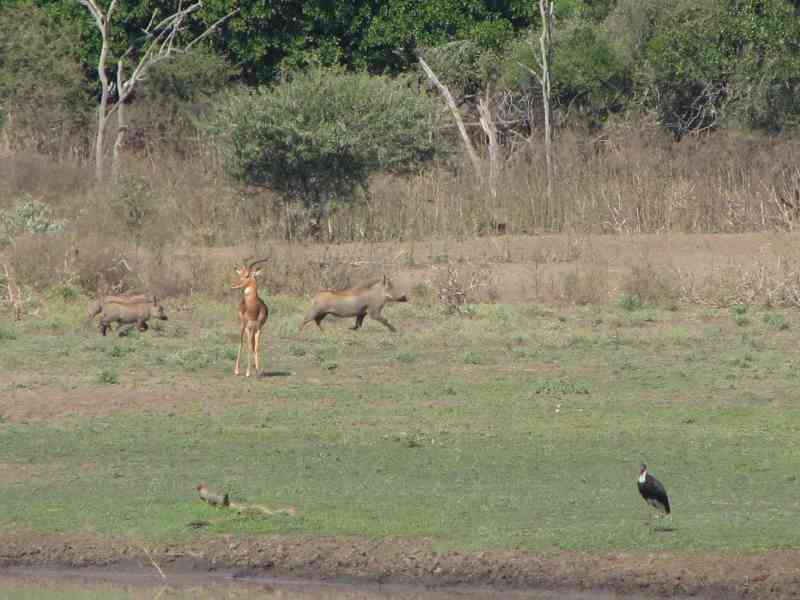
Fresh python tracks
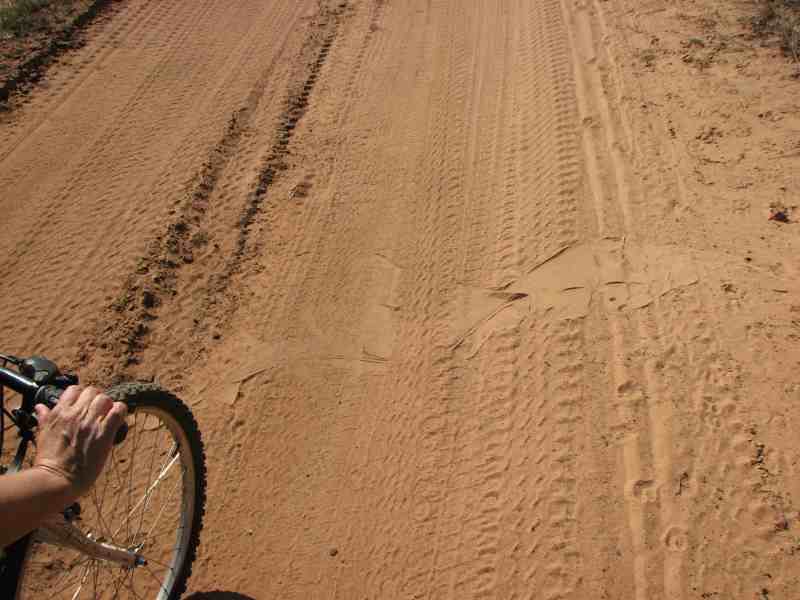
After packing up camp, we rode off in the direction of southern Swaziland. Fields of sugar cane lined the roadsides and square huts dotted the hillsides. This was a real agricultural part of the country. A handy souvenir stand gave us the opportunity to bargain for a couple of woodcarvings. Within two hours, we were at the South African border, and once again were encouraging the officials to stamp our passports on used pages. We only had one full page left, each, and still had exit stamps and a visa to put in. Not to mention getting into the States and Canada.
Endless sugarcane fields in the Kingdom of Swaziland

We say goodbye to the square huts of Swaziland
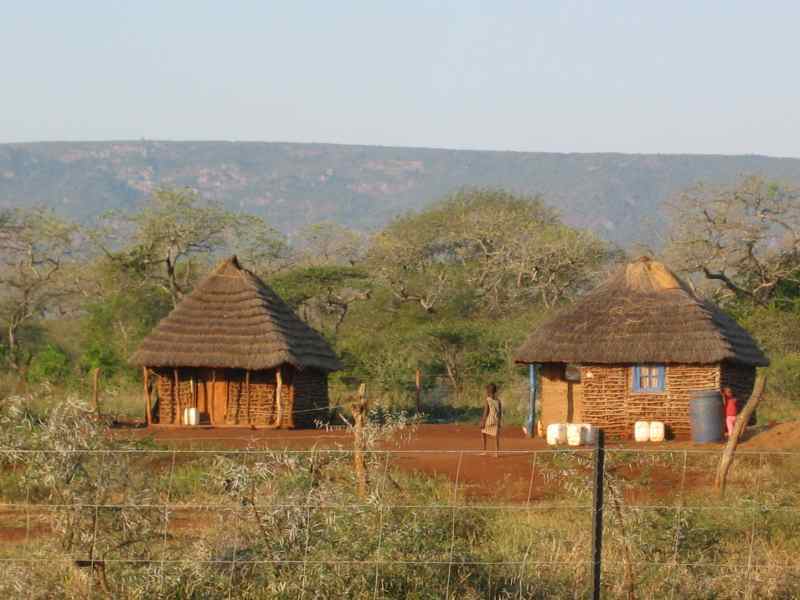
Map of our route from Lesotho to Swaziland

Just across the Swaziland - South Africa border, we knew there would be a campground. We pulled over near the access road and looked down it. It looked a touch isolated, so Ekke checked his GPS and noticed there was camping at a lodge further up the road. That sounded better. As we rode down the road, past cavorting warthogs and staring giraffes, we noticed a big terracotta gate with a hotel sign. The sign and Tracks 4 Africa had not indicated camping, so we just rode on, another ten minutes. There was another gated game lodge, this time with a camping symbol on the GPS. Great, as the daylight was starting to fade. We asked the security guard if there was camping, and there was, but they were full. He directed us back to the first game lodge, to ask where camping was. The guard at that gate said that they didn't have camping but that there was camping back at the place near the border. Since the sun was nearly down, we asked the cost of a room. He said it was 1200 rand ($166 or 'too much') for the room. Africa wasn't always as cheap as one would think. We rode back to the border, down the isolated road and found the park with the camping. They had sites available, but wouldn't let us in the park with the motorcycles. How different from Swaziland. We had seen a zebra carcass on the road beside the park, so it was probably a good idea not to let us in to camp with the wild animals. The guard there directed us to a private campground back the way we had come. There was nobody there, staff or other campers. Ekke found a phone number, and happily we got through to the manager. She told us to just set up camp and she'd come by later to collect the fee.
At the border crossing, Ekke had noticed that my chain had seemed a bit loose. On closer inspection, we realized that it was totally shot, and even tightening wouldn't fix it. It was also making a bit of noise as I rode, so we knew we'd better get it into the shop soon. Funny, it had just been checked, at our request by a BMW shop in Cape Town, and they said it was fine. Riding around the Kwazulu Natal part of South Africa the next day was a lot of fun, with its hilly terrain and twisty roads. There was more sugar cane and we could see some reforestation in progress. After gassing up in Enpangni, we tried a local pub for a bit of lunch. A girl stood at the door and would unlock a wrought-iron gate in front of the door as customers walked in and out. I asked her why she was doing this and she said that they had been robbed the week before. Riding further along, we came into Eshowe near the lands of the former Zulu King Shaka. The staff at the George Hotel allowed us to put up our tent out back, by the swimming pool. We then got a great tour of the Old English Fort, by a local grade 11 student. She showed us the original mission church, and then some displays of traditional Zulu huts, clothing, beadwork, medicines, weapons and tools. All very interesting, but our tour had to be cut short because Ekke really wanted to see the basket-weaving museum before it closed. It turned out to be quite interesting, actually, with some fairly elaborate designs and dyes. There was also a display of local pottery, quite different from anything we had seen before, and we even bought a pot for our collection (okay, the first pot in our collection), as well as a little Zulu shield made of animal hide. On the way back to the George, we stopped at the Dhlinza Aerial Boardwalk to see if they'd still let us in this late in the day. It was 4:30 and they closed at 5:00, and the ticket-seller said that it took 25-30 minutes. We told her we'd hurry, and off we went, following the signs for the trail. The forest was just getting dark as the sun was going down and we were the only ones there. The trees were quite interesting, with exposed roots and hanging, tangled vines, but there was no time to stop. We walked and walked, actually quite quickly, up and down hills, but the trail just went on and on. How could anyone walk this in 25 minutes? Finally, at about five minutes to 5:00 we got to the actual aerial boardwalk. After a quick walk to the viewpoint, overtop of the trees, we had to go. It turns out that the boardwalk was about 100 metres from the exit, and that we should have gone straight there instead of doing the entire two-kilometre nature trail. We're always the last to know.
Darn low doors don't seem to bother the mannequin

Zulu housing technology
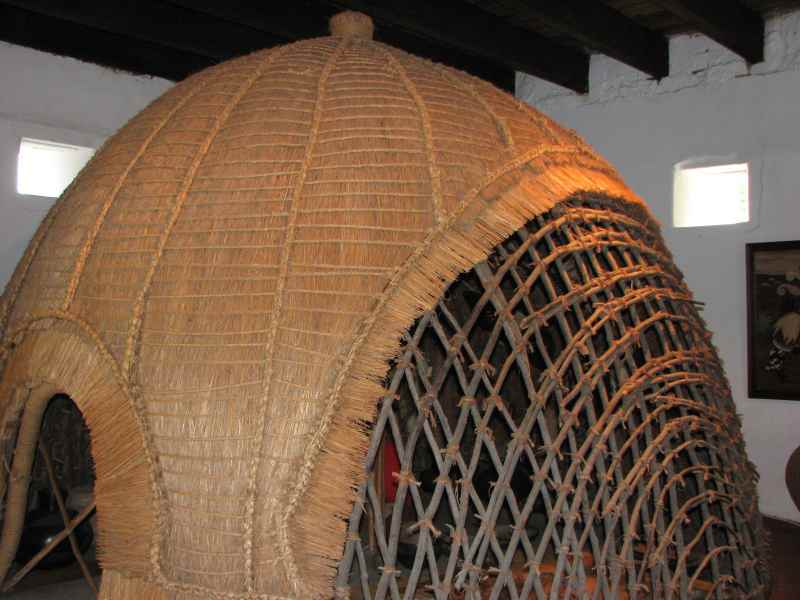
Ekke at tree-top level

It was time to get my chain and sprocket changed so Ekke found Ryder BMW on the GPS. When we arrived, they immediately helped us, checking to see if they had the parts in stock. My steering had been getting jerky at low speeds and I suspected the steering head bearings were shot. When Ekke took it for a test ride he realized that the problem was the flattening of the tread on the tires. My current tires, Metezeler Tourances, were bought in Istanbul, 23 000 kilometres ago. The guys checked their stock of tires, but of course there was nothing available but Bridgestone Trailwings. They had a pretty good tread, so I went for them, even though they wouldn't last as long as Tourances. Maybe I would attempt Sani Pass with these. It was getting dark by the time we left the BMW dealership so instead of going to the planned campground we found a lovely little B&B. Our host, Roma, had every detail just right, including a complimentary bottle of South African wine and some chocolates on the pillows.
Made to feel very welcome at the Hillcrest B&B by Roma
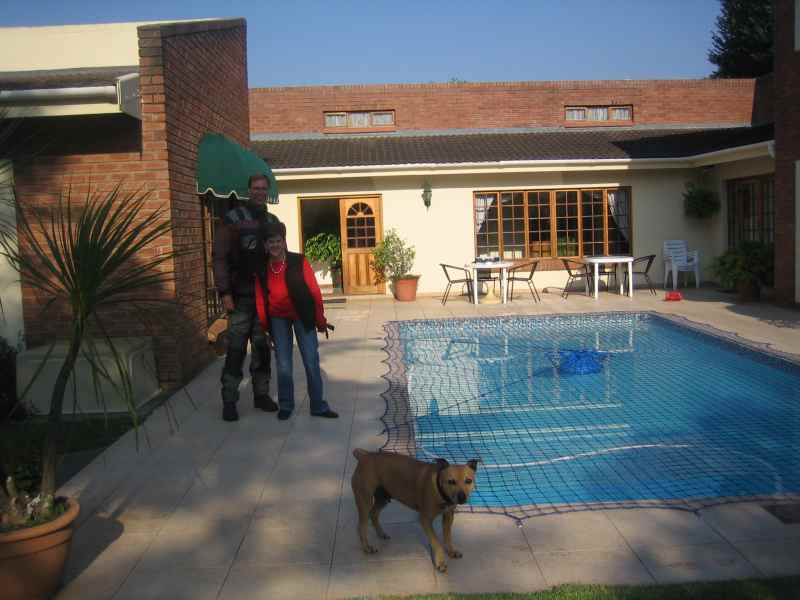
The next day we rode toward the Drakensberg Range, some beautiful mountains bordering Lesotho on the east and south sides. It got chillier as we rode to the higher elevation, and we stopped for hot chocolates just outside the foothills. It was still early in the afternoon, so we found a 'backpackers' (a hostel) that also had camping facilities, set up the tent, and discussed Sani Pass. I knew that it would be a challenge, even under the best of conditions. I had some apprehensions about attempting it, but my new tires had given me more confidence, and the afternoon was now bright and sunny. The roads were also quite dry, so I was feeling more confident about attempting it. The only drawback was that it was getting late. We decided to see what the road was like and how far we could get, and then decide if we would try it the next day. We lightened up our bikes considerably. I took off both panniers and my tank bag, and the bike felt like it could jump over rocks, it was so light. The temperature had climbed as well, so we could shed our heavy clothing. The switchbacks near the beginning of the pass were fairly tight with sand covering some bigger rocks. There were also big ruts where water had damaged the road, sometimes leaving only a very narrow riding patch. The rocks got bigger and sharper, and sometimes picking a pathway through them was tricky, but quite doable. The scenery was spectacular, and I wondered what it would look like from the top of the pass. The mountains were covered in green, even though we were here at the beginning of the South African winter. The road got a bit steeper, and standing up on the footpegs was the only way to keep the bike stable enough. We reached the South African border station at about 3:20. Since the border closed at 4:00 pm, there wouldn't be enough time to do the rest of the pass and make it down in time to cross back over the border. Another option would be to just continue up, stay in Lesotho overnight, and ride down the next day. Of course all our gear was down below, and we were also concerned that we'd never make it down if it snowed overnight. That seemed unlikely because it just felt so warm and sunny. So, we decided to attempt the pass the next day.
Spectacular scenery on the ascent to Sani Pass
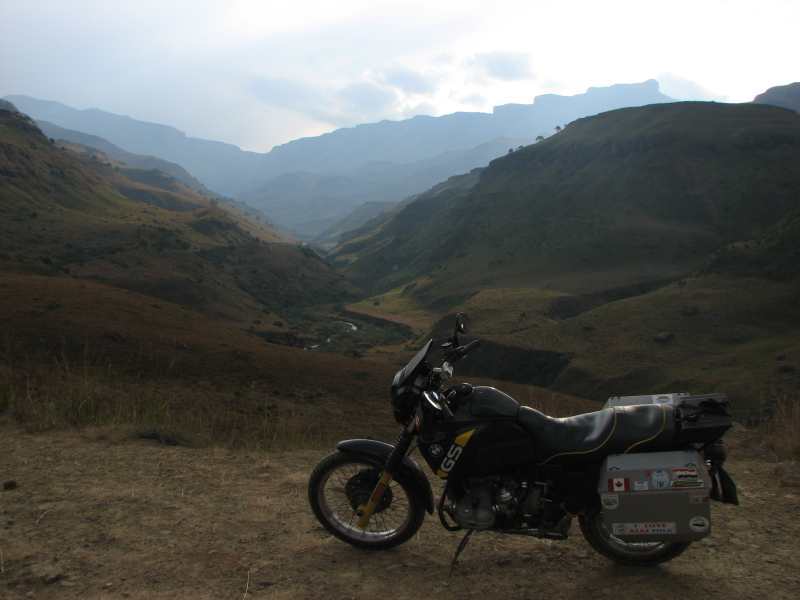
Pretty nice scenery coming down too

Our evening at the 'backpackers' passed quite pleasantly, as we could cook in the kitchen and then sit by the fire in the lodge. We met Ken, a traveller from Israel and a girl from the Netherlands who had worked near Stellenbosch, and enjoyed some pleasant conversation, sharing travel stories. After retiring to the tent, enjoying a very fitful sleep, we woke to a familiar pitter-patter sound at about 3:00 in the morning. Rain. It instantly occured to us that there would be no Sani Pass. The road would be a sloppy mess. Ekke looked out of the tent at first light, and indeed, there was a fresh dusting of snow on the peaks. I was crestfallen, as I had really gotten over the psychological part of the attempt. Usually in these situations we say, "Oh well, maybe another time." But South Africa's so far away from Canada, and worse yet, we had heard rumours that they were paving the pass road within a few years. Aarrggh.
Snow in the Drakensbergs again

So, we packed up a soggy tent and headed south. There was no more time to wait to see if the weather would improve to attempt the pass. The rain had made the 10 kilometre access road and construction zone into a slime-fest, so we still got some exciting off-road riding done. Ekke's bike was slipping and sliding. Sometimes the road was tilted, and I watched as his rear tire just slid down sideways on a muddy patch, almost in slow-motion. There was nothing for it except to let it slide, and try to keep the bike upright, which he did. My bike was actually doing quite well due to the new knobby tires, proof that they really do work.
Slip sliding away...
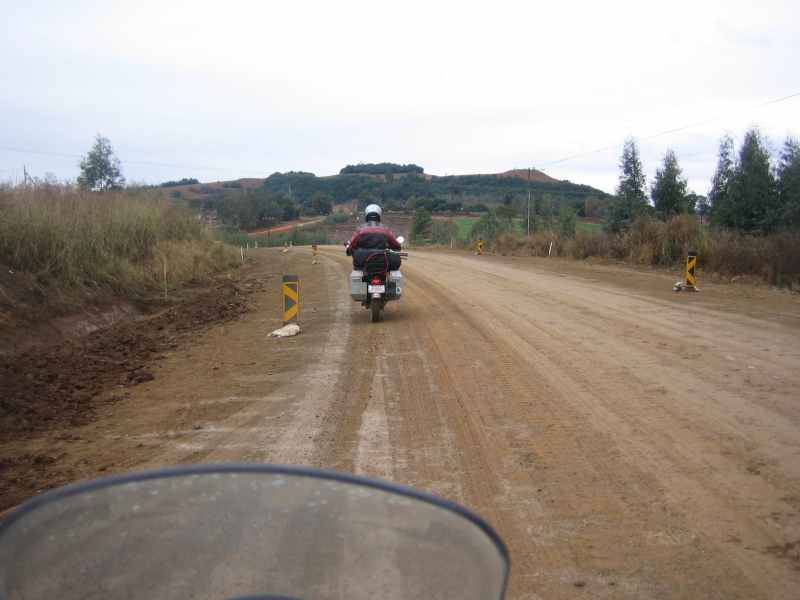
A chilly ride took us in the direction of Kokstad, a place that Ekke really wanted to see, since his last name is also 'Kok'. The town was named after one Adam Kok, a former chief. It had a monument to the chief, and some historical buildings. It was also a great opportunity to try some local cuisine, at the Ekahayne restaurant. Ekke went for the 'pap' which we had tried different versions of in every country since Tanzania. It looked like mashed potatoes but was made from white corn flower, and eaten with the hands with meat.
Wow, a town after Ekke's heart

Adam Kok turn right but which way should Ekke Kok turn?

A local citizen of Kokstad

The next part of the ride was a real eye-opener. We had seen shanty towns outside of cities as we had approached them, usually tin shacks with a mess of electrical wires and not much for water and heat. The 'Transkei' area was different. During apartheid, people had been relocated to places like this. It was quite a desolate area, really, and the land didn't look very fertile. As we rode through the 1000 Hills Valley, there were 'houses' on both sides, up the hills, and down the other side. They looked to be made of cinder blocks with tin roofs, many of them painted in bright purples, pinks, and blues. We would ride around a corner, and there were more houses, all lined up neatly in rows, generally identical. On the hillsides in the distance, were more groups of houses, sometimes with some open fields in between. School children dressed in uniforms walked up and down the highways. Women carried baskets or wood or water jugs on their heads. We were back in the third world. Our ride took us past thousands of the houses, all standing in their neat rows, dotting the hillsides. All very interesting.
Townships on the way down to Port St. John

As we got away from the mountains the temperature rose, and the highway turned into a motorcycle playground. The landscape was quite rugged, and the road wound its way through, twisting and turning the whole way. With my new tires, all I needed to do was think about turning, and the bike would respond. We passed small forests and rocky outcroppings, and finally rode into Port St. Johns on the Wild Coast. The coast here was quite rugged, with sheer cliffs and crashing waves. We looked at three cottage 'resorts' before settling on a 'backpackers', where we had our own room. The others were just too run down, and even the camping didn't look very appealing. The restaurant was located out of doors, so it was a touch chilly, a breeze wafting in from the nearby ocean. A group of locals came in for a 'Texas Hold 'Em tournament, and asked us to join them. We knew it would be a quick and sure loss of our 50 rand entry fee, so we declined.
A big push to Port Elizabeth was necessary the next day because we only had a few days to get back to Cape Town. It was great knowing where the campground and grocery store were, especially after riding 600 kilometres. At the store, a fellow customer asked if we were the 'Adventure Riders'. We said that those were our bikes out there, if that's what he meant. He introduced himself as a BMW rider, and a member of the Wild Dogs, an internet forum and club named after an endangered species here. Without skipping a beat, he invited us over for supper. After our long ride we just needed a quick bite and some sleep, so we couldn't take him up on it, but that's just one example of how friendly people are. To anyone who did invite us over, thanks again, and we're sorry we couldn't take everybody up on the offer. Our schedule just got too tight in the end.
Our ride the next day took us past Jeffrey's Bay, famous for huge surfing waves called Super Tubes. It was a slow day for waves, however, with one surfer out there trying to find some. The town was a typical surfing town, full of youngish and young-at-heart people looking as if they were living the surfer lifestyle. We continued up the coast, and Tsitsikamma National Park was right on our way, so we were able to stop by for one night of camping. The park was lovely, the ocean glistening in the bright sunshine. With rugged rock outcroppings, bubbling streams, deer and some sort of chubby marmots all around, it was an incredibly picturesque spot. Several pathways beckoned and we put on our walking shoes. We headed right for the waterfall trail, which was about six kilometres round trip, but a sign said that it would take about 3 1/2 hours, which would put us into darkness. So we opted for a shorter trek to the suspension bridge. But that was closed due to damage from some previous storms. The only hike available to us took us into the hills, but with great views of the ocean. In the cooking shelter that evening we met an Australian couple who had bought a van and were travelling around southern Africa. Those feelings of envy arose in us, because they were so excited, their whole trip ahead of them, and we could feel ours winding down.
No Super Tubes today at Jeffrey's Bay
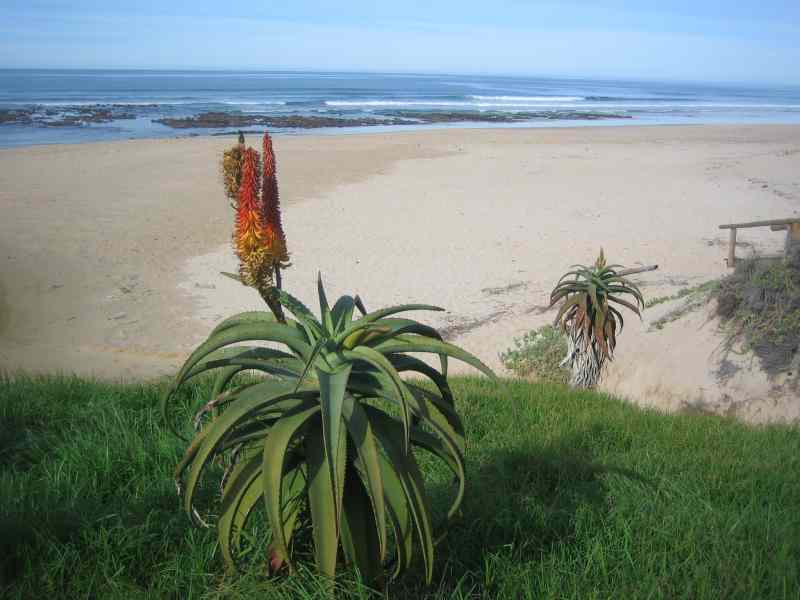
Part of our Tsitsikamma welcoming committee
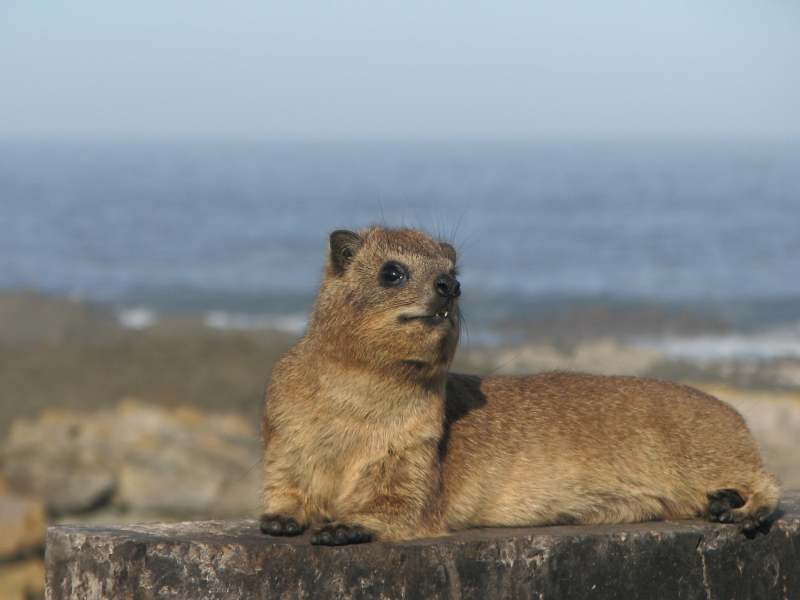
A beautiful waterfall before the trail to the suspension bridge ended

It threatened rain the next morning, but we decided to ignore the 9:00 am checkout time and attempt the waterfall trail. After a hearty 'Jungle Oats' (oatmeal) breakfast, we set off along the seaside, through some dense forest, over little streams, past crashing waves and over slippery rocks. The rocks got bigger and bigger, and soon we were climbing up and over them. The rain started coming down about halfway through our hike, but our umbrellas were fairly useless as we needed both hands to scramble over the rocks. Painted paw prints showed us the pathway, of which we were very thankful, because the big rocks were a bit tricky. The rain was really heavy as we crossed a couple of wooden bridges and finally arrived at the falls. After a couple of photos, it was time to head back, and everything was just too wet to attempt breaking out the snacks. There was a cave to duck into on the way back, however, so we had something to eat, and enjoyed the lovely smells of bat guano. The hot shower back at camp felt mighty fine. The rain didn't cease and we had to take the tent down as the sky dumped buckets. Being wet before we started our ride that day didn't feel great. We both had BMW motorcycle suits with goretex liners, but they really weren't keeping us dry anymore. We lasted until about Knysna, where an Ocean Basket restaurant looked quite inviting. Our bikes were quite safe too, with our own personal attendant, we'll call him 'Preacher', watching over them. He also said he was giving a sermon and invited us to a service the next day. Parked just up the street was a huge overland vehicle that we recognized. It was Hein and Bernadette, the Dutch couple we had met a few weeks ago in Port Elizabeth. Preacher told them where we were and we greeted each other like long lost friends. It was great to share travel stories and hear about future plans. Another couple who were at the beginning of their trip. They had also been invited to a church service the next day by Preacher, the parking attendant. Small world. They told us about some great cabins in a National Park just up the road in Wilderness, so we searched them out. It was nice to sleep in a real bed and have a place to dry out our gear. Usually we can dry stuff out under our camping tarp, but we were just feeling too chilly to attempt it. At the park office we asked if there was a heater in our cabin. There wasn't, so the staff sent over the office heater. I hope they didn't freeze that night.
Clambering on the boulder-strewn beach

Audrey follows the paw prints indicating the path
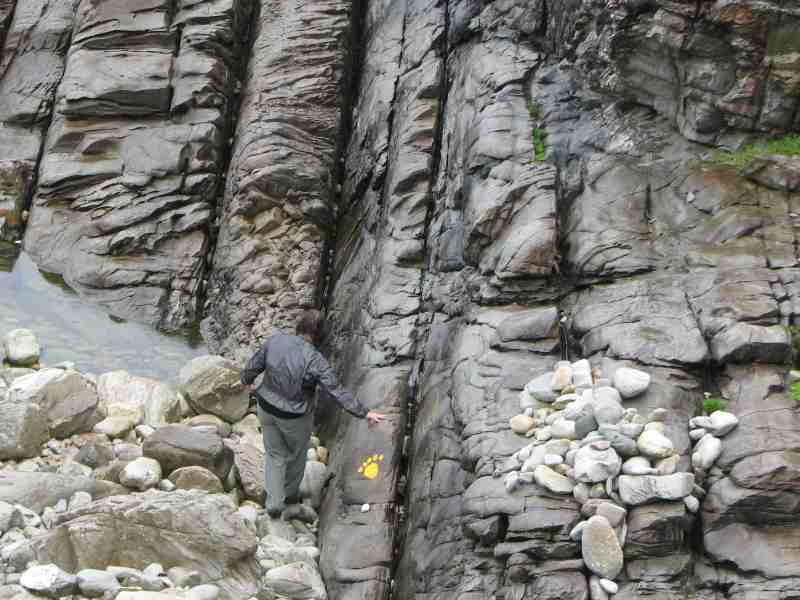
At our destination we might as well have been standing under the falls
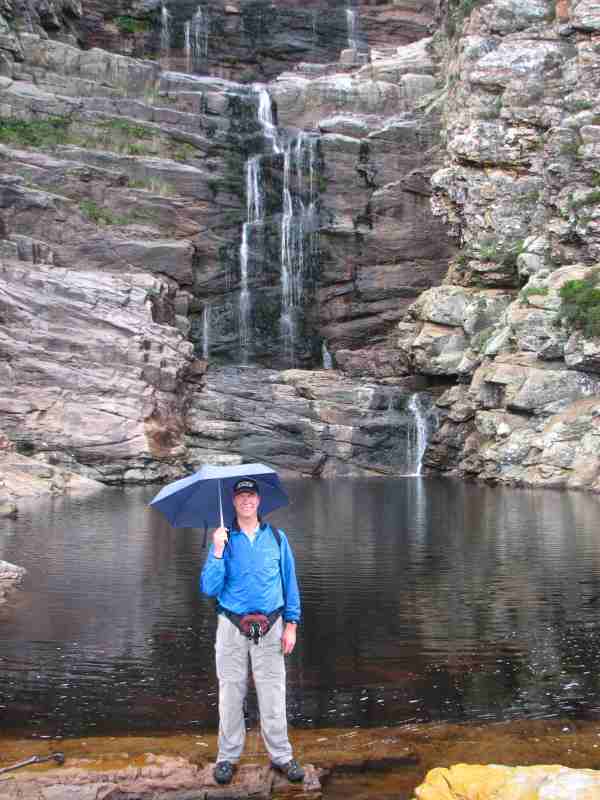
Rain means lots of green

Stilts at our Wilderness cabin because the GPS showed we were 2 metres below sea level

A 400 kilometre ride in the direction of Stellenbosch, a wine region just northeast of Cape Town, was fantastic. Many of the buildings in town were historic, white in colour and just beautiful. The ride into the hills towards Franschhoek to enjoy the sunset was quite magnificent, the setting sun reflecting on the cliffs. Our campground host had recommended La Romantica restaurant, where I tried some local wine. I rode on the back of Ekke's bike just for that purpose. It was also our lucky day. As we sat down to eat, we heard the familiar hum of sports cars racing around a track. On T.V. was the Formula 1 Grand Prix, and as we wondered where the race was taking place, we noticed that the scenery looked familiar. It was Montreal! So we proudly watched the race in our home country. And an exciting race it was, too as some of the top contenders had a crash as they came out of the pits. It doesn't get better than that.
Just a little late for the winery tour, it will have to be tomorrow
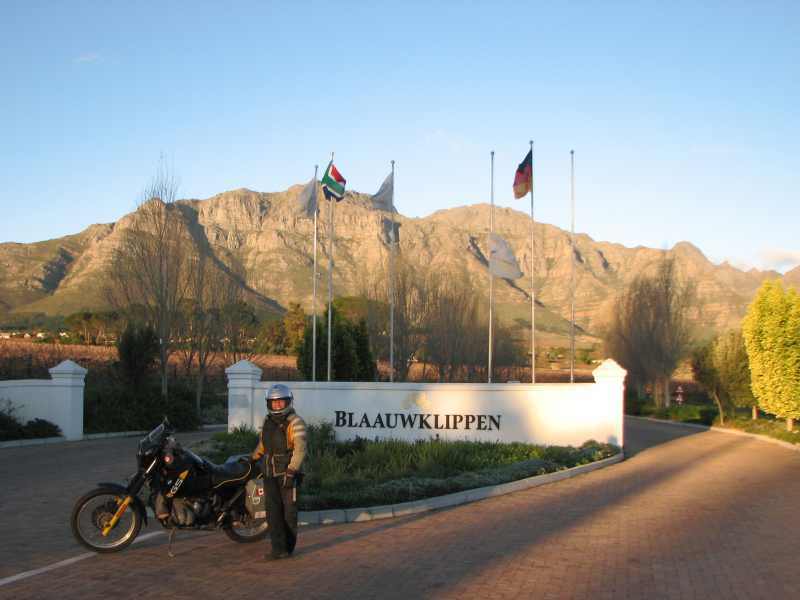
In the morning we had time to visit Blaauwklippen, the oldest winery in the area, and also the least easy to pronounce. We opted out of the tastings, though, as we were both riding. It was a quick trip to Cape Town, and we stopped at MMA Consolidators, the freight forwarders, to work out some details for shipping the bikes. Magnificent sunshine and blue skies greeted us as we headed into the city on the bay. A room was waiting for us at the Ashanti. Since the sky was blue, it was the perfect opportunity to go up to Table Mountain which we hadn't been able to do in our last swing-through of Cape Town due to bad weather. As we rode into the cable car parking lot, we saw a very familiar looking red Ducati with an Italian license plate. The bike was Matteo's, our friend who had ridden with us in the deserts of Sudan. Later we found that Robin, the South African on the Ducati, was also there, but we didn't hook up with them as they were climbing the mountain and we were going up the 'sensible' way. The cable car whisked us to the top in mere moments, and the views in all directions were spectacular. Sea, mountains, Robben Island, Cape Town, parks and historic buildings all looked great from up above. It was quite beautiful up top as well, with pathways winding through short and scrubby alpine vegetation.
Matteo's bike at the Table Mountain parking lot
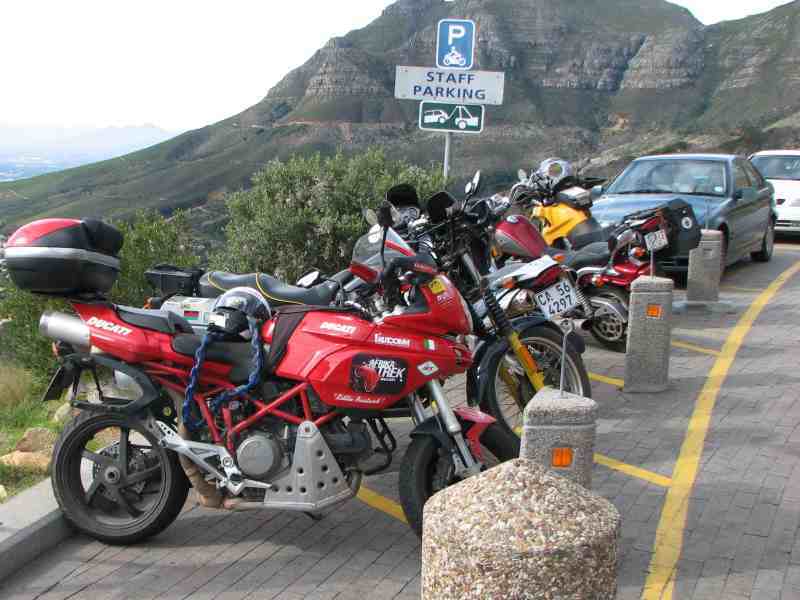
Up, up and away
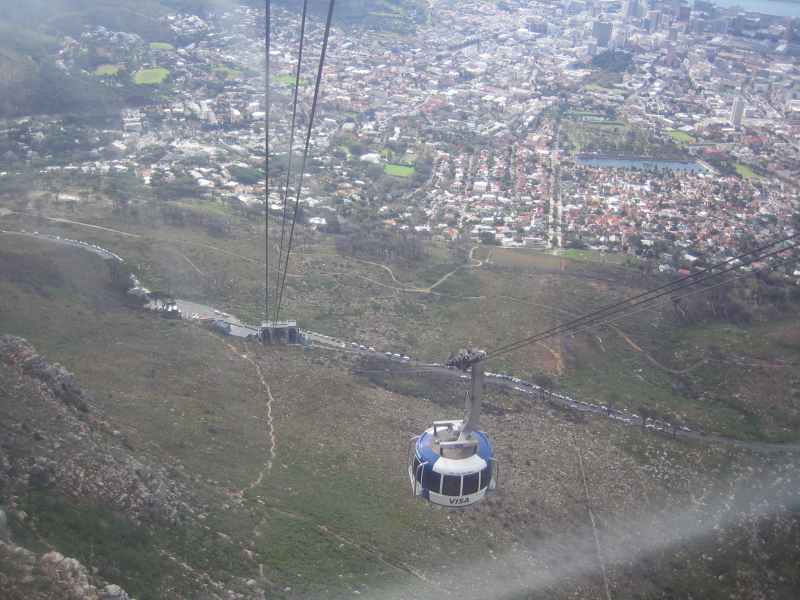
Spectacular view of Robben Island in Table Bay
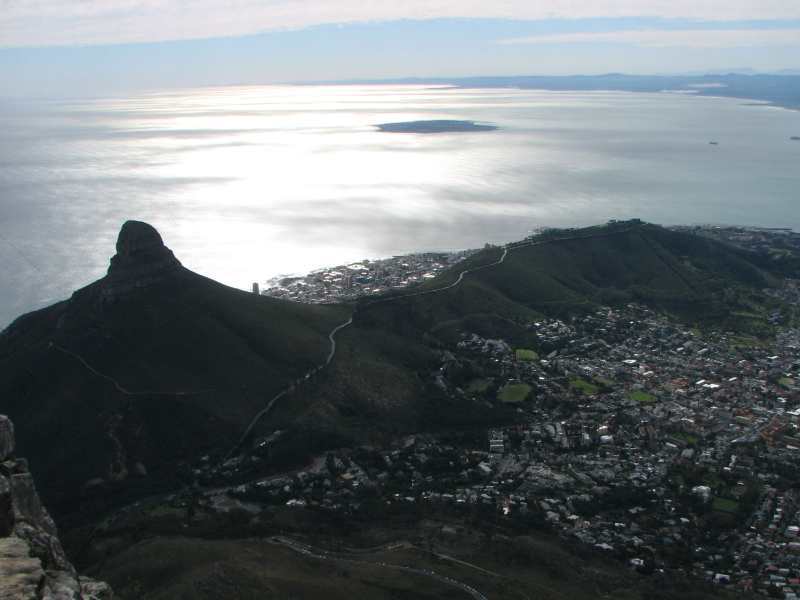
Ekke shows Audrey the Table Mountain jig
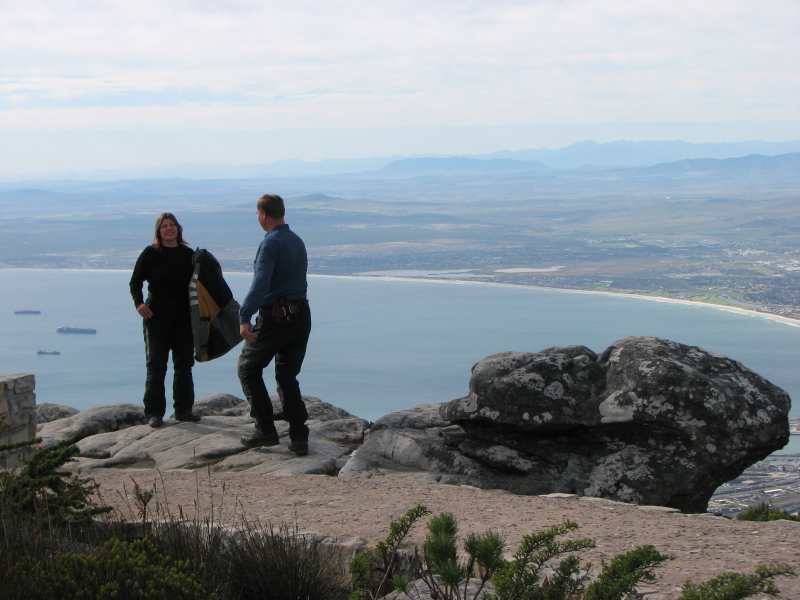
We had set aside a day to go shopping for the last souvenirs of Africa. A pleasant walk down to the waterfront took us about an hour, and we stopped in the slavery museum on the way. It was located in an old mission church and depicted a fascinating history of a different era. The Victoria and Alfred Waterfront was quite well done, combining a real working harbour with some fairly exclusive shops and restaurants. The craft stores were pricey, but all so conveniently located that we couldn't be bothered to go bargain hunting. Another big box mailed home.
Ekke shows off his Institute of Transportation Engineers bag in front of a huge transportation mistake

June 11, 2008 was a very special day for Ekke - his birthday! He had really wanted to be riding a motorcycle in Africa on the special day, so after a delicious breakfast, we headed in the direction of Cape Point. The winding road along the coast did not disappoint, and the sun came out intermittently the whole day long. On the way, we stopped to meet the penguins at Boulders, an adjunct to Table Mountain National Park. We had caught a glimpse of them before, but this was the first time we had seen them up close. They really are characters, with their short steps accompanied by the classic waddle. It was difficult to tear ourselves away from this thoroughly entertaining spectacle. On the road to Cape Point, the southwest corner of Africa, baboons appeared on the roadside, followed by a few ostriches. I love Africa. But what we always saw in droves were the groups of Asian travellers, in this case a group of business men from Beijing, all wanting their picture taken with us. What a lot of fun!
We've come a long way, from camels in Jordan to
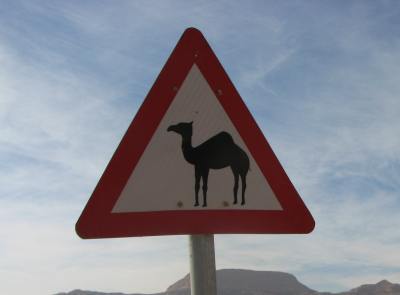
penguins in South Africa
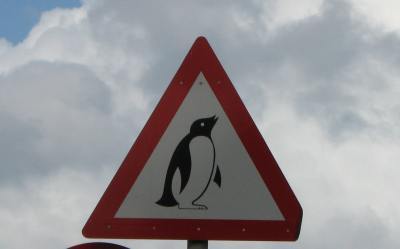
The penguin colony is quite large
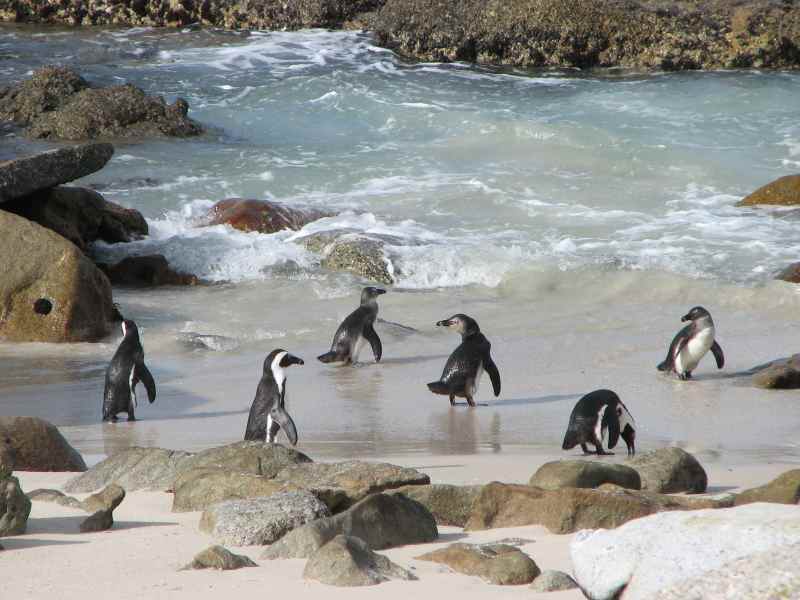
A few adolescents in the crowd
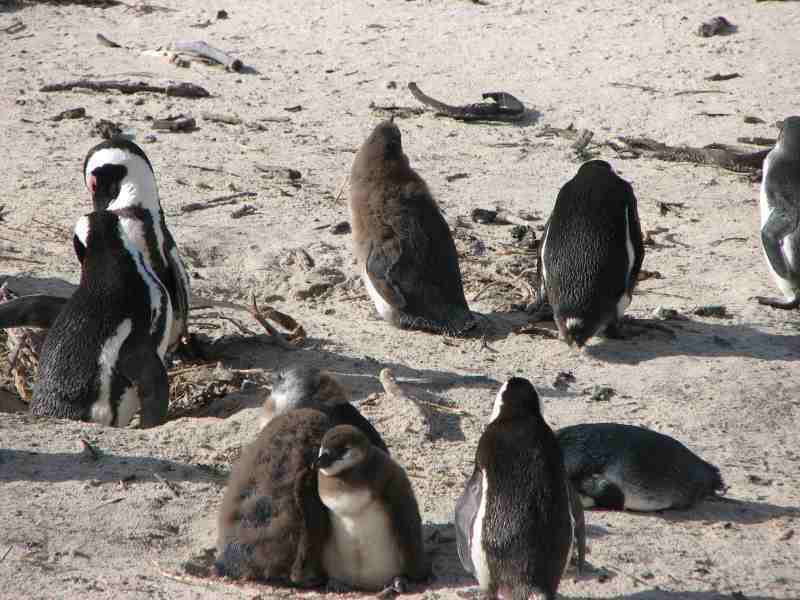
Homes have a nice view of the penguin colony
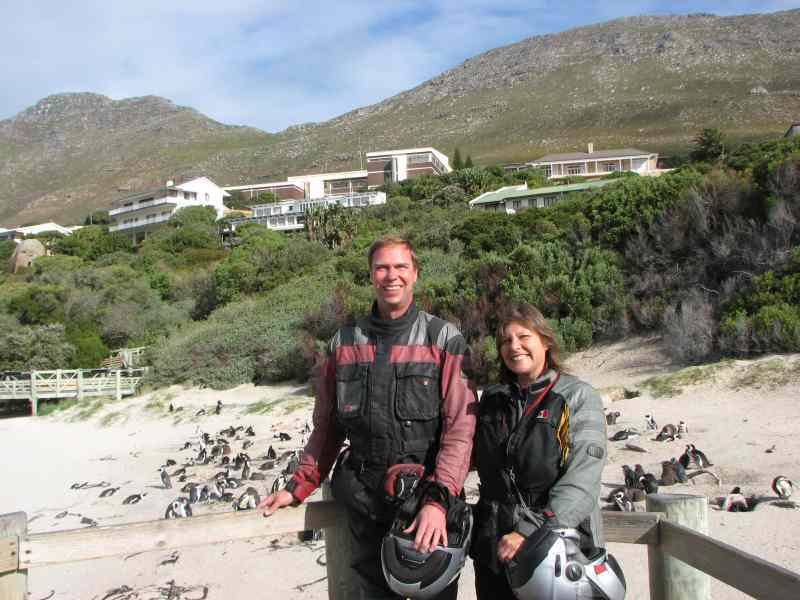
Walking home after a hard day at the office
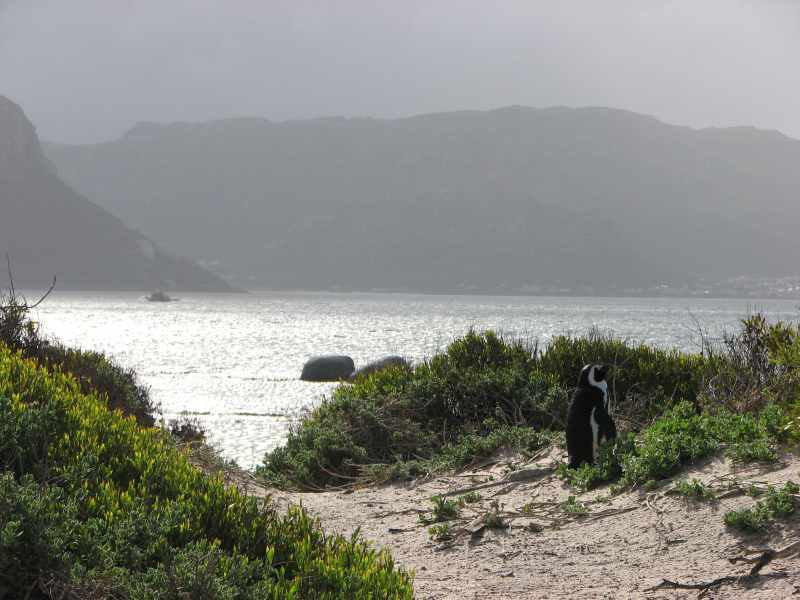
Riding to the Cape of Good Hope
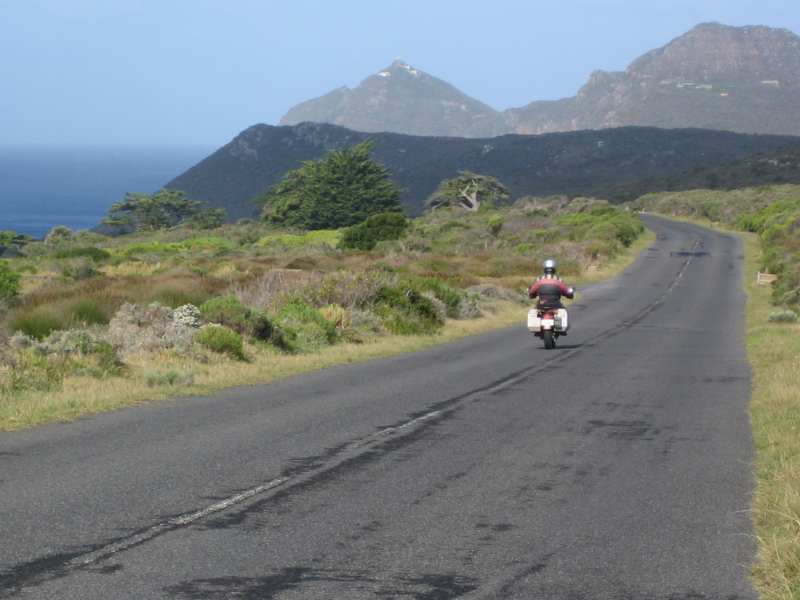
Baboons confirm we're still in Africa
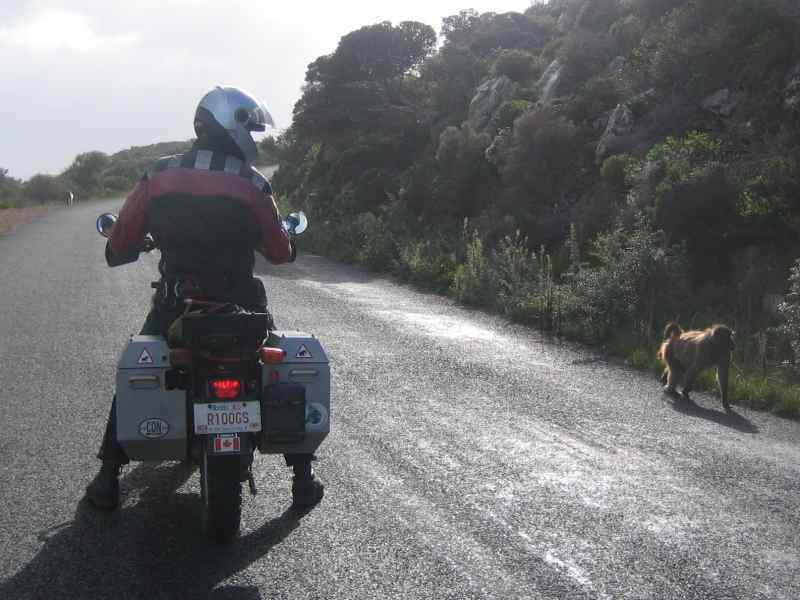
And so do ostriches
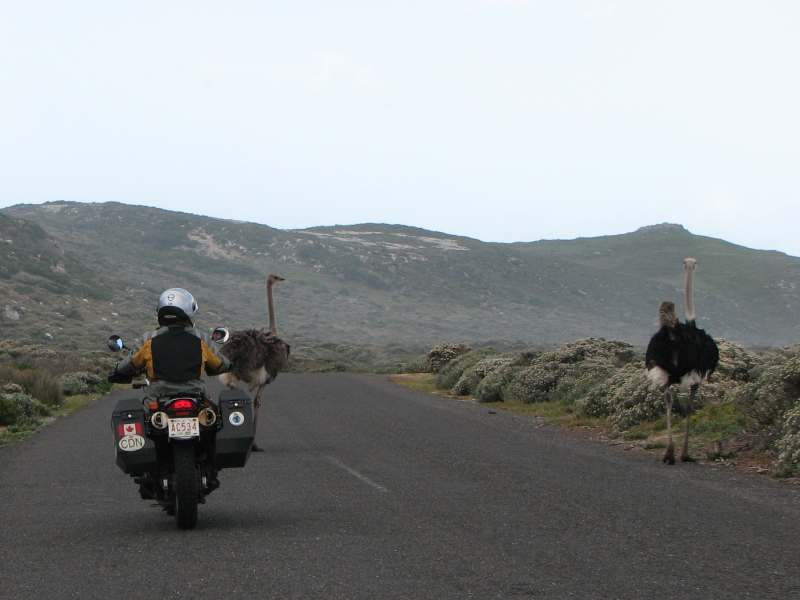
Celebrating with the Chinese

The plan for dinner was to meet at Five Flies restaurant with a few people we had met on our journey. Before everyone came, Jaco, the editor of Top Bike magazine, met with us for a short interview about our trip. I don't know if we get that magazine in Canada, but, barring ending up on the cutting room floor, we should make the August issue. Jaco asked us about equipment and things that we absolutely had to have and what we sent home. Actually we packed pretty carefully on this trip and really didn't send too much home except for the cold weather gear we had needed in Europe but that we thought we wouldn't need in Africa. How optimistic.
Later, Robin arrived, followed by Matteo. It was great to see these guys, who we had met up with on and off since Aswan, Egypt. The two Ducati riders' story can be found at http://www.muti-africatrek.blogspot.com, Keith and Jilly, whom we had met in Namibia, also came. Stephan and Rocco and their lovely wives, showed up a bit later. We had met Stephan and Rocco very briefly in Khartoum, Sudan, riding their KTM's from Cape Town to London. What I remember most about that evening at the Blue Nile Campground in Sudan were the hilarious stories they told about their journey so far. They also gave us some great tips on where to find potholes, campgrounds and elephants along the road. It was a fun birthday dinner, sharing tales of our trips, comparing routes and adventures. Later, a cake magically appeared for Ekke, adding to the fun. Thanks to all for making it such a special evening.
Robin and Matteo

Stephan and Rocco and two lucky ladies
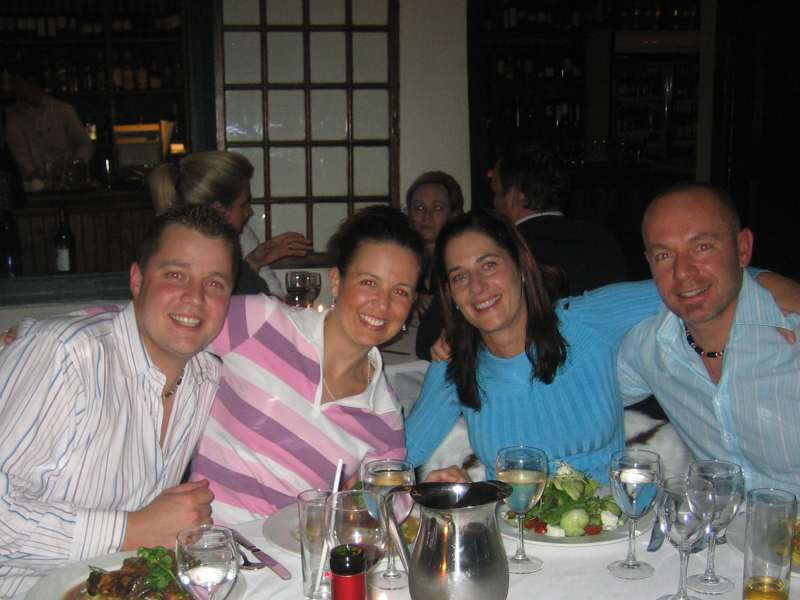
Jilly and Keith (sorry about the closed eyes Jilly!)
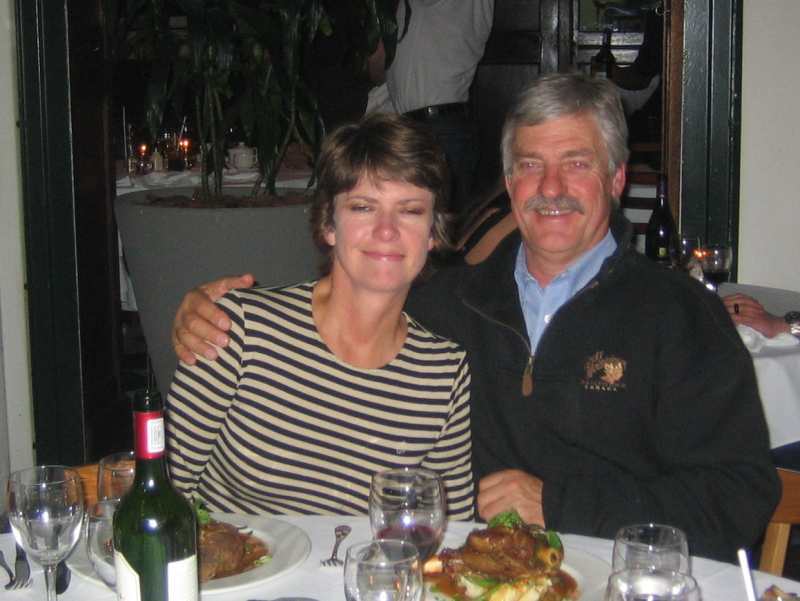
The birthday boy
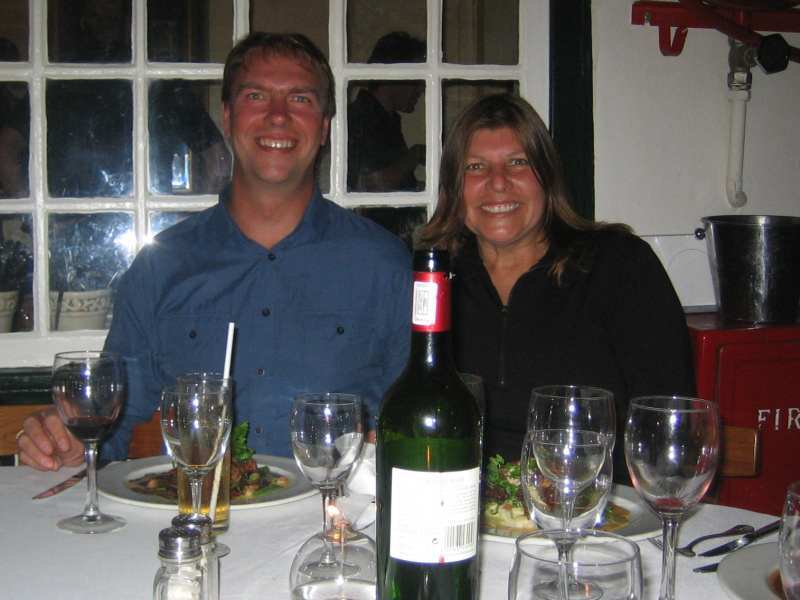
So, the next day, it was time for us to get to work. The bikes needed to be put on pallets in order to be shipped to New York via air cargo. This had to be done through a freight forwarding company. We used MMA Consolidators, found on www.horizonsunlimited.com the website for motorcycle world travellers. Vehsel had already shipped his bike with this cargo company to Turkey, and they had also taken care of Charlie and Ewan's bikes (of 'Long Way Down'). Bradley, the manager, also told us that Tom, the Canadian from Vancouver that we rode with in Sudan, had shipped his bike with them as well. But Bradley told us that he shipped Tom's BMW F800GS, not the Suzuki V-Strom that he had ridden down Africa on. It turns out that Tom had bought a new bike. We always knew that he had 'Beemer' envy. When we arrived at the freight forwarding warehouse, near the airport, it was a beehive of activity. As we couldn't be helped right away, we took the opportunity to wash some African grime off of the bikes so that they wouldn't be turned back by American customs. We needed to take a trip to the South African customs, a few kilometres up the road, and waited until they returned from lunch. The process of getting the carnets stamped was very straightforward, and after a bit of lunch at the airport, we returned to the warehouse. Bradley checked out different options for us in terms of prices for different sized pallets, and to get mine down by a few hundred rand, the front wheel, handlebars, windshield, and mudguard would need to come off. It didn't take us long to get the bike apart, and then the long wait began. The hubub of activity in the warehouse continued, and we wondered what was in such a rush that it would take precedence over our motorbikes. Ekke looked at the address on one of the 12 huge crates, the tops being hurriedly nailed on. Of the thousands of cities that these boxes could have been going to in the world, we were quite surprised to learn that they were going to...Airdrie, Canada! What an unbelievable coincidence, as Airdrie was also our 'home base' while we were away. Inside the boxes were some sort of cards, the size of playing cards but with strange symbols on them. What was really going on in Airdrie? Anyway, a hot-headed guy, who looked like the customer, was running around yelling at everyone to move the process along faster. As the boxes were nailed down, he jumped on the fork lift, and spun doughnuts in that warehouse trying to position himself to pick up the crates to load onto the truck. He really was a talented forklift driver, but we were still surprised no one got hurt with his enthusiastic driving. We could still hear him yelling as the last of the crates was loaded and he drove away towards the airport.
Draining the fuel tank from the R100GS

Finally it was our turn to get the bikes onto pallets. Bradley had found a couple of old aluminium Harley Davidson pallets and both had to be cut to fit our bikes. It took a while to get my bike on, strap it down with metal tie-downs, strap the panniers and extra pieces on, and then wrap it in 'Stretch and Seal'. Ekke was able to keep his front tire on, but needed to loosen and turn his handlebars to fit. It was 8:00 pm by the time we finished, and we wondered where the time had gone. Bradley gave us a ride back to our hotel, and after a fantastic steak dinner at the 'Nelson's Eye' restaurant, we got right to sleep after our long day. The next day would be our last in Africa, and we were both feeling a bit sad about that.
Audrey puts the finishing touches on her bike
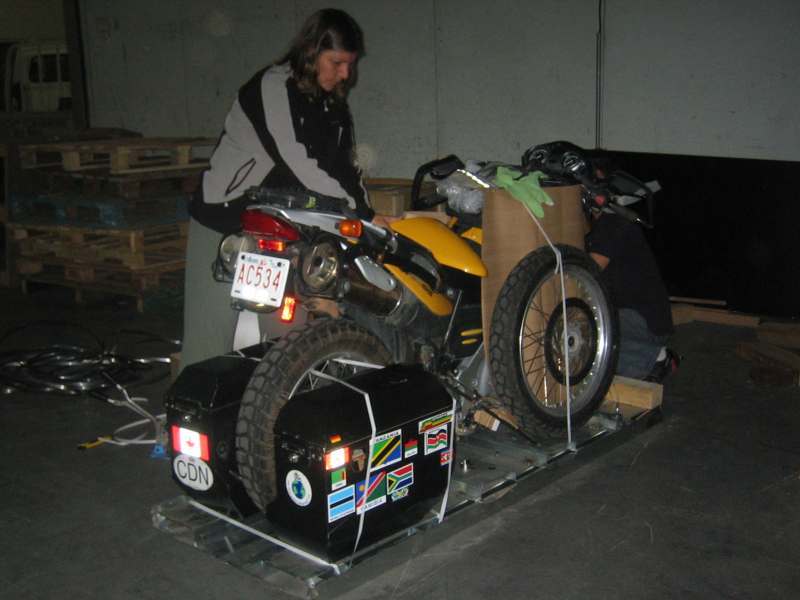
Wrapping the F650 in plastic
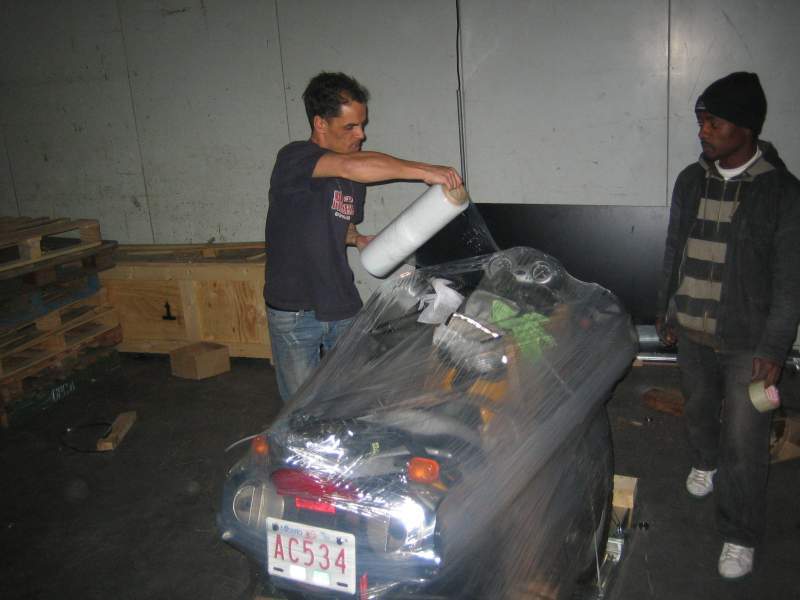
Checking to make sure the pallet is secure
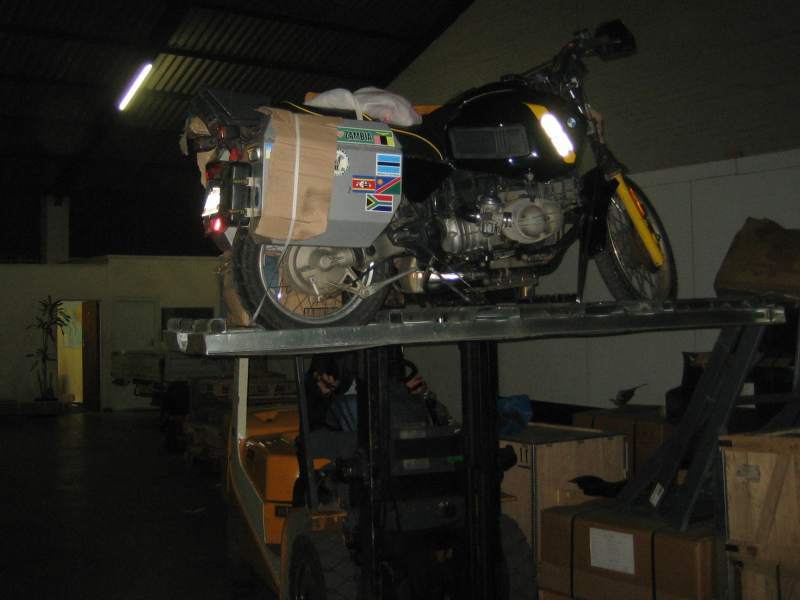
Jaco, the magazine editor, had invited us for breakfast at Arnold's so that he could look at a few of our photos. We met at the restaurant where he (the magazine) treated us to a lovely breakfast. Ekke tried the warthog ribs, which he claims were quite succulent. Jaco gave us a couple of Top Bike caps and the new issue of the magazine that was not out on the shelves yet. After the exchange of some photos via the laptops, we said goodbye to Jaco. Ekke wanted to select a seat with legroom for the flight so we found some internet, and then caught the hotel shuttle to the airport. We watched as Table Mountain, Cape Town and Africa faded off into the distance, a continent that had been our home for the last six months.
Our last exotic meat, succulent warthog ribs

Jaco on his personal bike an HP2
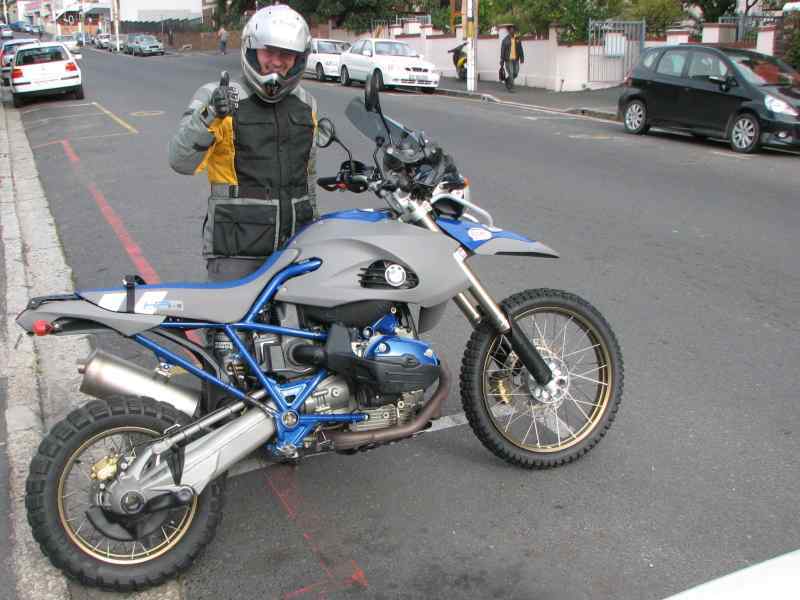
Ekke leaves the Ashanti and then Africa...
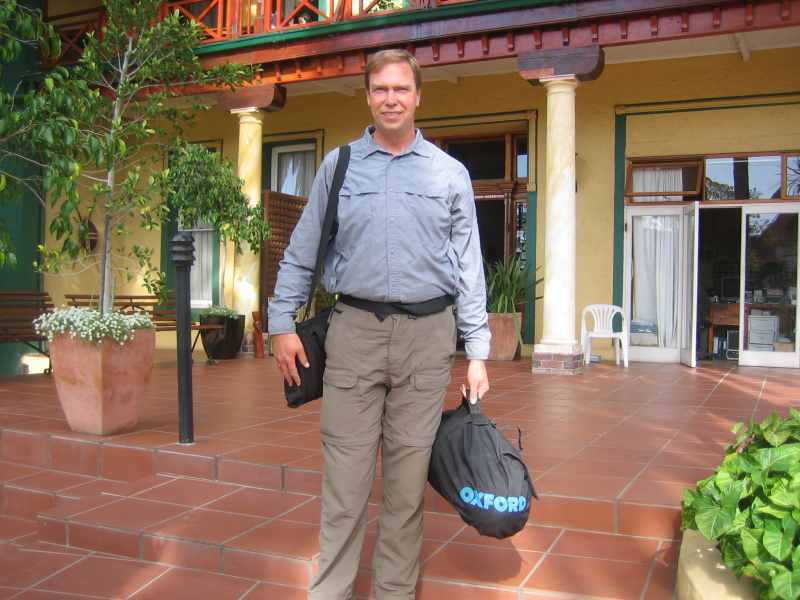
Our route from Swaziland to Durban
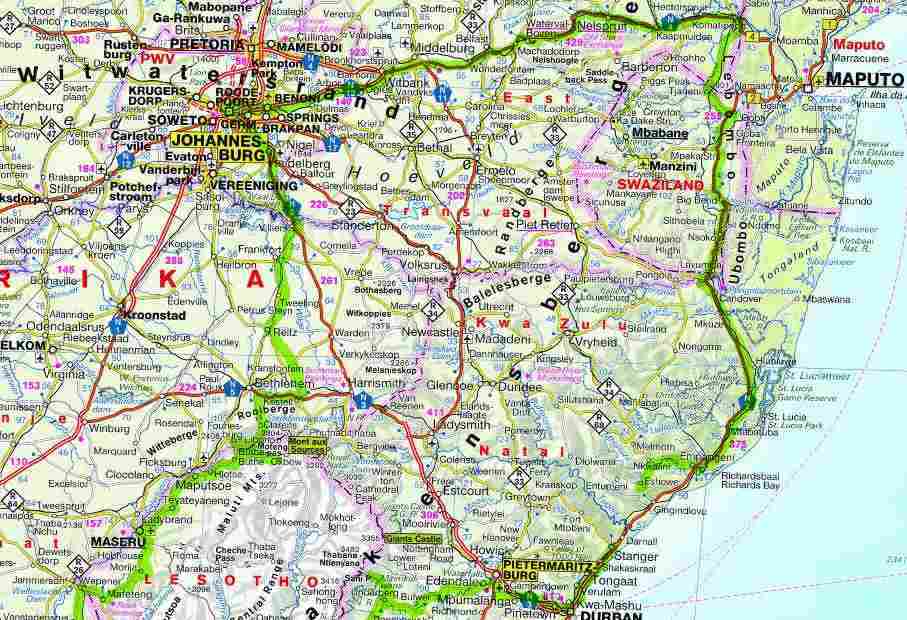
From Durban to Grahamstown
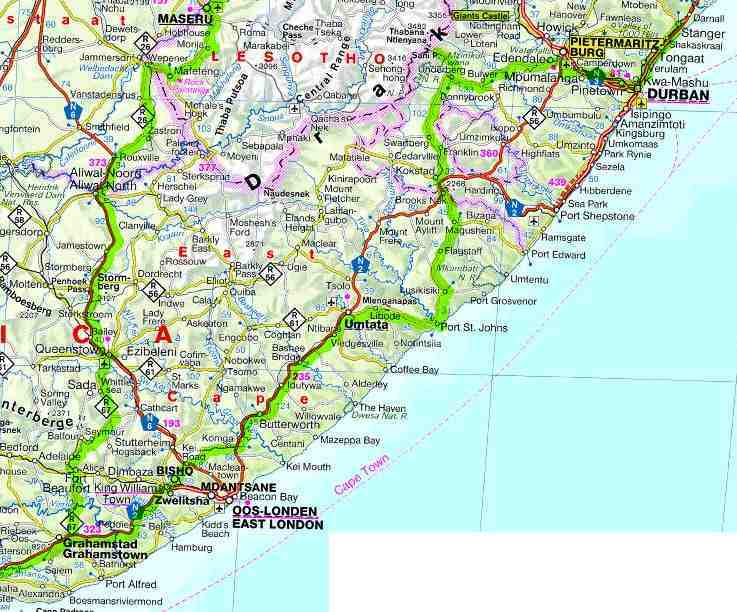
Grahamstown to Cape Town

Home / Africa | 2007-2008
Africa | 2007-2008
Route from Germany to Jordan


Route from Jordan to Ethiopia

Route from Ethiopia to Malawi


Route from Malawi through Southern Africa


Big changes as of January 2008!
As you can see from the title of this chapter our trip has changed a bit. As we travelled south through Syria, Jordan, Egypt and Sudan we felt that we were always under pressure to keep going. If we stopped we would be getting further and further behind and eventually it would not be possible to make it to the southern tip of South America before the snow started to fall. In Ethiopia we really did slow down; long enough to take a good hard look at what we wanted out of this trip. Since the accident in Germany our dream of riding around the world from North to South via Nordkapp was dashed so we really didn't "need" to go to Ushuaia anymore. We decided to focus on Africa this time and do South America another time.
The current plan is to fly from South Africa to the east coast of North America in June and then spend a month or two riding across Canada back home. Those of you from Western Canada know how difficult it is to try and visit Atlantic Canada on a summer vacation. (Those in Europe imagine riding from Munich to Aqaba in Jordan for a little diving in the Red Sea and back) The driving distances involved mean that the entire vacation is spent driving thousands of kilometres with almost no time left over for visiting. Flying from South Africa finally gives us the opportunity to visit a part of our own country; a part where we've never been.


How did we get the idea to do this trip?
After our last adventure, spending a year in Europe and North Africa, we decided that not only could we ride and camp for a year, we actually enjoyed it tremendously. We knew that we would have to take another year-long trip. This time we would take off in the summer of 2007 and return in 2008. But where to? The world is a big place and there are plenty of things to see and do. We decided to ride around the world, north to south, following the longitudes rather than the more common west to east latitudes. Hence the Longitudinal Way Round. See the map at the bottom of the page to get an idea of the planned route.
June 2007 UPDATE: In researching the trip we found that if we went south from Calgary to Ushuaia and then up Africa we would hit hurricane season in Central America and the Big Rains in Eastern Africa. So we decided to turn the trip around by continuing from Inuvik to Nordkapp (at least philosophically) then riding south through Eastern Europe through to South Africa and riding up South America through Central America back home to Calgary. We will fly from Calgary to Munich on July 5 and then ride north to Norway to pick up our Longitudinal Way Round at Nordkapp.
July 2007 UPDATE: See the Germany chapter for information on our arrival in Europe to kick off the round the world trip.
1989 BMW R100GS preparation for the Longitudinal Way Round
The 2003 BMW R1150GS Adventure was sold in the Fall of 2006 and the money used to buy a share of a 1998 BMW K1200RS and to rebuild the 1989 R100GS from the ground up. Here are a few of the things done to prepare the old bike for a trip around the world:
Rebuild engine as done by Anderwerks in Calgary:
• Renew heads with new valves and guides and a bead blasting
• New clutch
• New camshaft and lifters
• New timing chain and sprockets
• New piston rings
• Rebuilt carburettors (with new seals, needle jets, jet needles and floats)
• New oil pump impeller
• Rebuit Öhlins rear shock absorber
• New exhaust nuts made by Walter Price in Germany
• New Nippondenso starter (from Motorrad Elektrik)
• New Omega 400 Watt charging system (also from Motorrad Elektrik)
• Rebuilt transmission with addition of kickstart (from Siebenrock in Germany)
• Deep oil sump (also from Siebenrock)
• Spiegler cast iron front brake rotor and braided steel line, used 4 piston brake caliper from a 1993 K1100LT (machined to fit by Fusion Weldworks) and new master cylinder from Siebenrock
• Rebuilt driveshaft with greasable U-joints from Brunos in Ontario
• New rear brake shoes
• 35 litre gas tank from an R100GS Paris/Dakar model repainted by Cycle Mania in Okotoks (with new yellow stripes provided by Mr. Detail in Calgary)
• Corbin seat recovered by De Greeve's Upholstery in Calgary (see Europe's Gibraltar chapter to understand why!)
• New throttle cables
• New steering head bearings
• Service front forks
• Installed Centech fuse panel to power the GPS and a charge point in the right saddle bag.
• Installed silicone gaskets for valve covers and oil pan
• Installed Touratech handlebar risers (to make standing on the previously installed Q-Tech pegs easier)
And for Audrey's F650GS? Just a 40,000 km service (even though the bike only has 36,000 km on it) and it's ready to ride!
Approximate route for Longitudinal Way Round
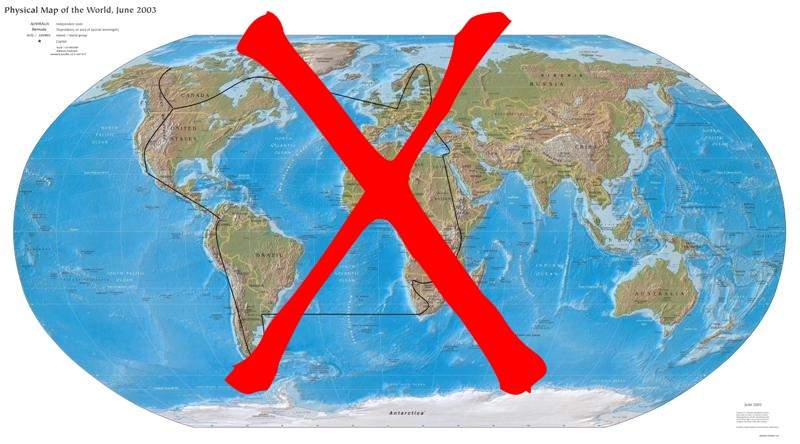

Chapter 1: Arrival in Germany
Ekke writes:June 30, 2007 It had been a hectic two weeks leading up to our departure: preparing the house for the renters, finishing off at work, finalising the motorcycle preparations and of course figuring out what to pack for a "round the world" trip. Little did we know that our hectic pace would catch up with us. The Lunatic Fringe BMW motorcycle rally had been pushed ahead to the July 1 long weekend so we could attend but we didn't make it for the Friday evening kick-off. We didn't make it for Saturday morning either. Or Saturday afternoon. We finally finished off cleaning and putting the final items in the basement about an hour before the renters arrived at 10:30 AM on Sunday morning. After dropping the Jetta off in Airdrie and then picking Audrey's bike up at a neighbour's house back in Redwood Meadows (strange seeing other people's cars in our driveway!) we finally managed to get to the rally in High River at about Noon. We missed putting on the “field events” but it was a lot of fun catching up with people and making new friends. We helped clean up on Monday and then rode up to Airdrie to stay with my parents for a couple of days.
Some final, final preparations were done on the bikes on Monday evening and Tuesday morning. As per the instructions from Motorcycle Express we gave the bikes a good cleaning, making sure to remove any dead bugs. The locking oil cap on Audrey's F650 wouldn't unlock so we spent quite a bit of time trying to open it so that it could be inspected if necessary. Then we noticed in the fine print of the shipping contract that we should bring along a spare set of keys for the bikes. We couldn't find the spare for the F650 (perhaps it was safely tucked away in our basement in Redwood Meadows) so we debated whether to pop by a BMW shop to get a blank and then have it cut. Since the oil filler cap had taken so much time we decided to forego the spare keys and head straight to the airport. Having rebuilt the R100GS starting last October it sure felt good to have the bike run so well on the way to the airport. It had never been smoother or more responsive! At the Aero Ground cargo facility we drained the excess fuel from the bikes and then disconnected the batteries. By the time we returned to Airdrie a lot of tension from the last couple of weeks seemed to drain from us and we relaxed a little. Wednesday we tried to whittle down our items to pack into something that would actually fit on the bikes and also clean up some of the paperwork. That evening we went to Carstairs to say goodbye to Audrey's parents over dinner and then came back to Airdrie for a small Bon Voyage party held in the back yard. Thursday the Jetta was put into storage and we made our final preparations for departure that evening. We arrived at the Air Transat check-in counter a few minutes after it opened and there was no line so we were hopeful that we could get seats with a bit of legroom. No luck; stuck in row 24 on top of the wing. After a tearful goodbye at the security gate we went to the departure gate to see if we could get a glimpse of the bikes being loaded aboard our plane. No luck there either. We really hoped that they were on board!
A good cleaning before taking the bikes to cargo

Off to the cargo terminal!

Disconnecting the batteries

While I was in a terribly awkward position with my knees jammed into the seat in front and my head too high for the headrest I at least had brought ear plugs (one of the advantages of motorcycle travel is that you usually have ear plugs along!), unfortunately Audrey had kept her ear plugs in her motorcycle jacket, safely stowed in the checked baggage. A few young people a couple of rows back kept up a loud conversation for the first 8.5 hours of the 9.5 hour flight so Audrey didn't get a wink of sleep until the final hour and even that was fitful as we hit some bad turbulence at about that time. We were pretty exhausted when we landed on Friday afternoon at 1:30 PM local time. Fortunately, Munich must have one of the most efficient airports in the world. It was a short walk to the baggage carousel with only a short line at the passport control to slow us down. While the luggage was coming down I went to the luggage tracing to ask where our motorcycles could be picked up. The first thing the nice young gentleman said was that we could pick them up at the large luggage pickup over by the skis and golf clubs! A little more explanation was obviously in order. We eventually got vague directions to the Swissport cargo facility on the other side of the airport and then went out to meet Audrey's sister, Helena, who had come to pick us up. Helena lives a few minutes drive from the airport so it was very handy to come over and give us a ride to the cargo facility. It was also nice that she spoke excellent German and even a bit of Bayerische (the local dialect). It took a while to find the Swissport offices but they said they would phone us back in an hour or two when we could come and pick up the bikes. When they didn't call Helena's house we called them and they told us the bikes were ready so off we went. After paying a nominal fee of 17.50 euro for each bike we were then able to take a form down to customs for them to stamp. With the stamped form we then walked to the Swissport cargo gate where a hundred fork lifts all seemed to be whizzing around at 100 km/h and all of them intent on running us over. We looked the bikes over and could find no damage but we also didn't find our keys. Back and forth upstairs to the office didn't turn up the keys but since I had my spare keys we decided it was best to take my bike out since storage charges would be applied if we didn't remove the bikes before Sunday. If the key didn't turn up we would have to call a locksmith to get a key made for the F650. As I rolled the bike to the ramp a woman from the Swissport office came back to say that they were tracing the keys. Since Audrey's keys were in a unique little pouch I thought it would be a good idea to show the woman what exactly they were looking for. Balancing my bike with one hand I reached for my keys, which were in a pouch matching Audrey's, with my right hand. At that moment the bike started to tip over towards me. I tried to catch it but the bike kept coming over and then the gas tank hit my left knee. I could only watch in horror as my knee bent over at a bizarre angle accompanied by a sharp, wrenching pain before I was pinned under the bike. I scooted free with my good leg but it was obvious from the bulbous protrusions that my left knee was ruined. I started swearing a blue streak; not from the pain but because I could see our trip vanishing, the trip around the world that we had planned and saved for for four years. Vanishing because of a stupid mistake made while fatigued by the long flight, which itself was the culmination of two and half hectic weeks.
That knee isn't supposed to look like that

A First Aider, two paramedics and a whole truckload of firefighters got the situation stabilised until an ambulance arrived. There wasn't too much pain after the initial wrench but having dislocated my shoulder a few times I knew that there would be a lot of pain when the knee was popped back into place. At the hospital in Freising an X-Ray was performed to ensure that there weren't any broken bones before straightening out the leg. I gritted my teeth as the doctor and paramedic slowly moved the patella back into position while simultaneously straightening my leg. They and I were both amazed that I had not a hint of pain. I guess no nerves were trapped. The patella was floating free because the ligament towards the lower portion of the leg had been completely severed so it was decided to put my left leg in a cast from hip to ankle until it could be operated on. The doctor said it would be 6 to 8 weeks after the surgery with a brace and then another month to build up the strength before I could ride a motorcycle again. In the meantime an MRI was scheduled for Monday to determine if there was any further tissue damage that needed to be repaired. When I awoke on Saturday morning I couldn't believe my eyes. A bulletin board at the foot of my bed had a Touratech poster advertising their latest trip from Canada to Mexico (Touratech is a company specialising in making equipment for motorcycle travellers and both of our bikes are graced by a few of their baubles) and a second poster of a perfect gravel road switchbacking up the side of mountain. These two posters certainly reinforced my will to continue with the trip and staring at them over the next week would prove to be quite motivational.
An army of firefighters, the paramedics and ambulance attendants on the scene

Nice cast!

The motorcycle posters gracing the foot of Ekke's bed

Now the real work began for Audrey. Despite suffering from the same fatigue that caused the accident she now needed to deal with all the issues arising from the mishap. The first order of business was to call our medical insurance provider and make sure that we were covered and to tell them about the accident. She then had to figure out how to get the bikes out of cargo. Swissport called to say that they had found the keys in the crate (right where Audrey had told them to check in the first place!) so at least Audrey could ride her bike. She only needed to have the battery reconnected. The German automobile club has a reciprocal relationship with the CAA so a call to ADAC confirmed that they could come and reconnect the battery as well as tow the R100GS to Helena's house. On Saturday the R100GS was put onto a flat bed truck and then Audrey rode behind them to the apartment in Erding. The tow truck driver untied the bike and then asked Audrey and Helena to hold it up while he tilted the bed down. Since this bike had just put me in the hospital when it came unbalanced, they were understandably a bit leery! Somehow they managed to do it and then the tow truck driver rolled it down into the parkade. Now Audrey had her own transportation and she could visit me in the hospital whenever she wanted to; the ride from Erding to Freising being about 35 minutes.
The results of the MRI were given on Tuesday and it was good news. Only the patellar ligament was ruptured, no other damage was evident so the surgery was scheduled for Wednesday. The anaesthetist recommended a local anaesthetic saying that if it didn't work then they would simply go to a light general, this way I wouldn't suffer from the side effects of a general anaesthetic unless necessary. Even though the operation was scheduled for Noon I got a call at 9:30 saying they were ready to go. The local anaesthetic was injected using a long metal tube so that the knee could get the maximum effect. After 15 minutes I was wheeled to the operating prep room and cleaned up and a short while later I was wheeled into the operating theatre itself. I was quite alert as the operation was started but I soon felt some pain in my patella and that was the last thing I remember. I assume I went under a general anaesthetic immediately after showing some signs of pain. I woke up a little while later to find my leg wrapped in a full cast again. The rest of the day is a bit of a blur but there were almost none of the debilitating side effects of a general anaesthetic. I didn't eat much of supper (especially considering I missed breakfast and lunch) so I asked the nurse to give me a double portion of breakfast the next day!
The pain in my knee was almost unbearable on Thursday morning and taking the pills didn't help. Eventually it was decided that the cast was putting undue pressure on my swelling knee so the cast was cut off. Fortunately I recovered from the light-headedness of the pain enough to eat my double portion of breakfast. Later that day the doctor came by and said I would be wearing a brace that had no mobility for four weeks followed by a week of 30 degrees of movement, a week of 60 degrees and two weeks of full movement (90 degrees). He also suggested that a bit of physiotherapy after the brace came off might not be a bad idea before getting back on the bike. Since we now knew that we would be confined for a minimum of two months we started looking at renting a small apartment. The insurance company said that they would fly us home on business class with an accompanying nurse. This sounded nice but if we could find an apartment (without too many steps!) for not too much money we would rather spend the time in Bavaria.
Audrey came to visit on Friday, riding her bike as she had done every day since Tuesday but to add insult to injury, when she got back to the bike in the hospital parking lot someone had stolen her licence plate! They were nice enough to return the bolts back to the holes so she knew for sure that it hadn't just fallen off somewhere. We could almost understand if this had occurred outside of a nightclub in the middle of the night but this was in broad daylight in a hospital parking lot. What unbelievable luck we were having! Not only was Audrey now without wheels again until a new licence plate could be obtained from Alberta but all of our other paperwork, most importantly the carnet de passages, would need to be done over. Fortunately, Audrey had left an authorisation form with my parents so that she could get her registration renewed while we were on the road (it expires in January of 2008) and the same form could be used to authorise my mother to get a replacement licence plate. Of course there was only one authorisation form so the new plate would have to wait until August which is the earliest a person with a last name starting with “A” can get a motorcycle plate that expires the next year. Automobiles can be registered for two years at a stretch in Alberta but not motorcycles and they can also be renewed on-line whereas motorcycles not. Not that we're bitter about a system that seems so blatantly discriminatory against motorcyclists but it sure makes our lives as travellers more difficult. In any case, at least Audrey didn't have to go back to Canada to get a new plate. When we get the new plate number we can contact the CAA to get them to issue another carnet de passages and courier it out to us in Germany.
With Helena's help Audrey found a nice gasthaus for us to stay in during my recuperation. It is located in Schwaig and has good bus access to both the Munich Airport train station as well as Erding. The brochure sure makes it look like a nice place to spend a relaxing month or two. The ground floor unit has no steps, comes with a kitchenette and a nice concrete patio to sit on, all for only 30 euros per day.
Gasthaus Huber brochure photo

July 30 Update, Ekke writes:
It was great to be out of the hospital on Tuesday, July 17 and we celebrated by going for a walk in to beautiful altstadt Erding on Wednesday. How wonderful to be sitting at an outdoor café in a small square of an old town in Bavaria! On the way back, I stumbled on some cobblestones and automatically used my bad left leg to catch myself. This was accompanied by a sharp pain and an audible (to me anyway) pop. Needless to say we were worried I had buggered up the surgery. There was no more pain after the initial jolt so we hobbled home. I took it easy the rest of the day but later that evening it looked like the normally swollen left knee was swollen to a more significant degree. I took a couple of Advil and used ice to reduce the swelling and in the morning it looked better.
Around lunchtime on Thursday I was hobbling back to the sofa from the washroom and my knee just felt really odd. When I put tension on my thigh muscles to lift the leg it felt like the patella was trying to come up too. I just froze on the spot. I couldn't move for fear of damaging my knee. I eventually forced myself to the sofa (two steps away) and plopped down. We both thought that I should go back to the hospital to get this checked out but I couldn't see myself getting down the stairs to catch a cab. So we called the emergency number (112). Audrey talked to the call centre operator at first but they didn't speak a word of English (doesn't that seem odd?). Audrey gave me the phone and I was able to let them know I needed an ambulance. They transferred me to another line where not a word of English was spoken either but it was apparently the ambulance dispatch. I told her of my predicament and she said she would send an ambulance. (When I told her my name she said, "we transported you last week!") Fortunately Andrew (Helena's son) and a couple of friends came home just before the ambulance arrived. The paramedics couldn't possibly have carried me down the stairs without assistance so they drafted the three strong boys. As it was, there was a person on each corner of a special wheel chair and a fifth person (one of the paramedics) holding up my leg. What a ride! All seven of us were rather amazed when we made it down without mishap.
Four flights of stairs. 108 kilograms. Five porters. One bad knee.

Ekke looks happy to be back at the hospital

On the ambulance ride back to Freising I sat upright watching the scenery and wishing I could be riding these nice German roads on my bike. Emergency was much busier this time and I had to wait an hour and a half before I could even get into an examining room. Audrey got to ride in the ambulance too so she spent the whole time in the waiting room. Eventually I got a room and a little while later a doctor came by. He read up on my case and was very impressed with the surgery. He said that they had made an especially strong repair using special dissolving thread (3 to 4 months) that was very unlikely to be broken. Nevertheless he thought an X-Ray and ultrasound would be a good check. He then took my brace off and played with the knee a little bit. All of a sudden there was another "popping" sound and he looked up at me expecting to see me in pain. I just gave him a beatific smile. I said that that sounded like the popping sound I had heard when I stumbled. So maybe my knee had dislocated a small amount when I stumbled and now he had popped it back in. The X-Ray showed no problem but it was quite a wait to get in to ultrasound. When I finally got in the technician was very thorough. He must have spent close to an hour with me and I got to see the cord used for the repair. He couldn't see a portion directly under the patella so he asked if it was OK to bend my knee. I said, "No!" since I was rather paranoid of hurting it. He went out and got a doctor (whom I had met a couple of times last week when he was doing rounds) and he again said it was OK to bend my knee up to 30 degrees. When they lifted my knee up my muscles were so tight that it didn't bend! I eventually relaxed them enough to bend the knee and the technician could see a bit more. He was still missing a small spot but overall he thought that no damage had been done. Back in the examining room the doctor consulted with his colleagues and a sports medicine doctor and they all determined that everything was OK and I could go home. When I hobbled out to the waiting room three and a half hours after entering the emergency room Audrey was very relieved and happy to see me coming out under my own power. Helena (who works three days a week at a place near Stuttgart) drove straight from her work to the hospital and she was there a little after 8:00, about half an hour after I got out. Amazingly I managed to fit in the tiny Opel Corsa so we headed back to Erding (via a Burger King drive-through at the airport!). So, long story short (too late!), I was OK and not in the hospital again.
Friday we moved to Gästehaus Huber in Schwaig, about seven kilometres from Erding. This would be our home for a while. A reporter for the Freising Tagblatt had seen the police report on the stolen licence plate and when one of Helena's friends contacted the paper to tell them our story the reporter wanted to interview us. The reporter and photographer came by the Gästehaus at about 5:00 PM on Monday, July 23. The photographer took a few shots of us with Audrey's bike, pointing at the missing licence plate and then took off. The reporter spent about a half hour getting the information from us about our trip, the accident and of course the missing licence plate. Afterwards he said the article would probably be published in a couple of days.
Audrey goes for long walks in the country around Schwaig

Maypole in Schwaig

Thursday I had a check-up at the hospital in Freising so we caught the direct bus there from Schwaig. Too bad that the bus didn't have a handicapped seating area where I could stretch out my leg so I was forced to stand for the 20 minute ride. Since we were early for the appointment we popped in to the hospital café to kill a little time. The Freising Tagblatt was for sale there and we decided to buy it but before we could do that the cashier asked Audrey if her licence plate had been recovered yet. Apparently she recognised us from the newspaper article! We saw a few of the nurses from my ward and every one of them asked how we were doing and if the licence plate had been recovered. Maybe this paper had a higher circulation than we thought. When we opened up the paper we were greeted by our own smiling faces on the front page of the regional news section with the headline: "Knie Kaputt bei km Null". (Click here to read the article) The check-up went well, with the doctors indicating that swelling and heat were perfectly normal at this stage and that the knee was healing just fine. We walked down to the train station via the old city centre after the appointment (down was a different challenge on the crutches) stopping off at a café for a break before catching the bus back to Schwaig, via the airport. On the way to the train station we got passed by an older couple. As they went by, she turned around and started speaking German very quickly. I went into my usual spiel that I didn't speak German very well when she interrupted and said (more slowly) that we were the Canadians from the paper. She seemed pretty excited to see us and asked if the licence plate had been returned. So this is what it's like to be a celebrity!
Hospital café and Thursday's paper

The original newspaper article

A Banana Split in Freising (for medicinal purposes of course!)

Hobbling around the old part of Freising

September 2nd update, Audrey writes:
Ekke's doing fine but still hobbling around on crutches. He went to the doctor on Tuesday, August 14, and the brace now has 60 degrees of movement, meaning a lot more range of motion in his leg. My new licence plate arrived from Canada, sent out by Ekke's parents (thanks, Ekke and Magda!) and it's nice to have wheels again. I use the bike to go to Erding for groceries or to the Munich airport for some English reading material at the international news shop. The airport's only a few minutes away and resembles a shopping mall with lots of stores and services, and of course, its own beer garden. Ekke gets physiotherapy every couple of days either at Therme Erding or the Gesundheitspark, while I do some shopping or go into the hot pools. Life here is very good and the leisure time is a gift that, hopefully, we're putting to good use with extensive reading, trip planning, sightseeing and mastering Sudoku puzzles from the London Sunday Times. Helena's invited us to movies, festivals and dinner at her friends Melanie and Steve's beautiful home in Niederding for some fantastic English fare complete with Royal Dalton china.
Audrey tries out her new licence plate

Ekke walks for fresh buns every morning

And then enjoying the fresh buns sitting on our patio

Maybe this is why Schwaig feels like home?

We are able to watch DVD's on our laptop, and are currently watching Ewan McGregor and Charlie Boorman's trip, Long Way Round, about their motorcycle adventure around the world. We're itching to go to begin our own motorcycle adventure, but know we have to be patient and just let the healing of Ekke's leg run its course. So, we're trying to see a few places around here, and visiting the BMW Museum in Munich was first on our list. We caught the S-Bahn, a regional train, at the airport and it took us to Marienplatz and then Olympiazentrum station which is near the museum. It was disappointing to find that the museum was closed for renovations, but then we discovered that a temporary museum was set up with most of the important exhibits from the original. One hour of looking at cars and motorcycles was just fine with me. The temporary museum did not have Helge Pederson's bike, however, so I knew I would have to come back to see that. Helge, a Norwegian who spent ten years on two wheels, inspired us to get planning our own motorcycle adventures. They did have Michael Martin's bike on display, and he is well known in Germany for travelling to interesting locations on his bike, taking beautiful photographs, and giving slideshows back home in and around Munich. We had heard of him from friends of ours from Bielefeld, and from Ekke's cousin, Paul-Jürgen, who had sent us a signed print of one of his photos, so it was great to see his somewhat battered BMW R1150 GS. After a lunch of Bavarian sausage and kartoffelsalad (watery potato salad with no mayo, but surprisingly tasty), we wandered around the site of the 1972 summer Olympics. We gave the Olympic tower a miss as it was an overcast day and we wouldn't be able to see the Alps. The stadium and other buildings were covered by various tent-like structures with plexiglass inserts, and looked very modern, considering they were 35 years old. It was all a very festive atmosphere as it was summer funfair time.
The new BMW delivery centre and museum should be open this Winter

Michael Martin's bike in the temporary BMW museum

Audrey in the early years...

Amazing plexiglass structures at the Olympia Zentrum

Helena invited us over for a fabulous home cooked Middle Eastern feast, and while there, we got a chance to use the internet and check if Michael Martin was giving a slideshow any time soon. Ekke discovered that he was currently doing a presentation in Tokyo, and wouldn't be giving a show here until sometime in February. Our hopes for meeting him were pretty much dashed.
Ekke's dad is a member of the Blue Knights, a motorcycle/police organization, and he had emailed the German chapter, telling them of our misadventures. We soon received a phone call from Tom and Andrea, two police officers from Munich, asking if they could come and visit us as part of their Sunday bicycle trip. So, we met here, walked over to the Schwaiger Hof Bier Garten, and had a nice chat about motorcycles and travelling. Andrea ordered a Kaiserschmarn and since Ekke's mom had mentioned that she loves them we each ordered one too. When a little bowl of what looked like applesauce arrived Ekke and I looked at each other and said, "It looks just like applesauce but what the heck, it must be special." When we dove into the sauce with the supplied spoons, Tom stopped us and said, "That is the applesauce that goes on the Kaiserschmarn!" Oops, almost a major faux pas! A moment or two later, a big plate with what appeared to be a cut up pancake, sprinkled with icing sugar and cinnamon came out. With the applesauce on top it was delicious. During the conversation, we happened to mention that we went to the BMW museum and saw Michael Martin's bike. Of course they knew who he was and were familiar with his photos. We said goodbye, with plans to attend a Blue Knights club meeting on Thursday. Later that night we received a phone call from Tom and he was very excited. Apparently they were putting their bicycles on the train near Neufahrn, and who should be sitting in their train car but the photographer, Michael Martin! He was coming home from his trip to Japan and was taking the train from the airport to Munich. They chatted with him for a while, and he mentioned that he was trying to get a show together in Herrsching, about 40 km south of Munich, and was only awaiting approval from the town. We were quite flabbergasted with the amazing coincidence and, of course, a chance to see his show.
Tom and Andrea after riding 50 kilometres from their house

Tom and Andrea picked us up for the Blue Knights meeting on Thursday, which was at an active military base in the north part of Munich. Tom advised us to carry our passports with us and then hope that the guard at the gate would know that Canada was part of NATO! As we passed through the gate, Tom flashed his and Andrea's police i.d. cards, and the guard just waved us through. Tom said, "He may know that Canada is in NATO but he apparently can't count to four!" I checked with Andrea to make sure I wouldn't get arrested before taking a picture of a German tank outside the barracks, and she said it should be okay. About 25 people showed up at the meeting, apparently a great turnout for the middle of summer holidays, and we enjoyed some local cuisine and Weissbier (wheat beer, a local specialty). Most of the proceedings were in Bayerische, but it was just so special to be invited, it didn't matter. Ekke gave a quick speech in English, which most people understood, explaining our trip plans and how quickly they changed. We were given club patches and a pin and were able to chat with a few people. On Sunday, Andrea and Tom picked us up and gave us a great driving tour of Munich. The Asan church was quite spectacular; we didn't realize that Munich had so many grand avenues with even grander arches and monuments. Nymphenburg Palace had pleasant grounds for walking and after that we drove to Lacky and Judith's house for a fantastic barbeque. Lacky greeted us in lederhosen, and showed us his garage with a rebuilt Yamaha SR500 and a BMW R1100 GS. The pork garlic sauce and Bavarian Schnapps made for a very special evening.
The Assamkirch set on an ordinary Munich street

The extraordinary interior of the Assamkirch

Swans in front of Nymphenburg Castle

Audrey enjoys Lacky's hospitality at the BBQ at their house

Lacky came out for a visit to Gastehaus Huber (and to see if the Hubers were the same ones he knew from years ago. They were; yet another coincidence.)

Everyone had been telling us to visit the Deutsches Museum (science and technology) in Munich, so off we went. The line up to get in was huge, but the 30 minute wait was definitely worth it. The museum covered at least 6 floors, and our strategy was to start at the top and work our way down. There were great views of the city from the rooftop lookout, along with a selection of 22 sundials on display outside. We took our time wandering through the astronomy exhibits, which were accompanied by plenty of English information, and really enjoyed the displays showing the development of the computer. The food technology area was quite interesting, complete with ploughs and milking machines throughout the ages. And what Bavarian museum would be complete without the beer making exhibit, which was quite well done. After spending hours wandering, viewing and reading, we realized we had only covered 3 floors, all of them quite a bit smaller than the 3 floors and basement below. So, with one hour remaining before the museum closed, I decided to just do a quick walk-through of the rest of the floors, leaving Ekke to meander through the aerospace technology and environmental exhibits. After a quick journey through cell structure, oil and gas, marine science, tunnel building and flight, I found a spiral staircase that led to my favourite part of the museum, a labyrinth of mines and mining history. A sign at the beginning warned that it would take at least an hour to go through but with a bit of a push, I completed the route in 15 minutes. There were no exit points at all as I elbowed my way past slow-moving tourists, through darkened tunnels, past dioramas of salt and coalminers, and eventually out. Ekke was having his own adventure as he walked through the environment exhibits. All of a sudden at about quarter to five a loud clang reverberated throughout the room which all of a sudden seemed to be devoid of human life. A moment later the lights were switched off and only a pale light came through the windows. He hobbled to the sound of the clang to find the doors locked and a man standing by the light switch. Ekke asked to be let out and then for the elevator down. Apparently the access to the regular lift was locked off now and the man with an air of exasperation opened a special cargo/handicapped elevator. There the man curtly pressed the ground floor button and stepped out whereupon he heaved the doors shut leaving Ekke to descend by himself in the pre-programmed lift.
Entrance to the museum

From the rooftop of the museum (yes it is more humid here than in Calgary!)

An early computer using vacuum tubes

Milling wheel

Early experiments in flight

Cross-section of a modern jet-liner shows where our motorcycles would have been stowed

Working in the salt mines

On Friday, the 24th of August, Ekke and I took the S-bahn into Munich after his physiotherapy appointment in Erding, walked around a bit and visited the Frauenkirch, a huge gothic church near Marienplatz. We then caught the S-Bahn to Herrsching, on the Ammersee (lake) in a beautiful forested area with rolling hills. After a dinner of what I'm sure is the local Bavarian specialty, Hawaiian pizza, we met Andrea, Tom, Judith and Lacky for the Michael Martin slideshow. As soon as we walked through the gate, Michael Martin came right up to us and said, "So you must the Kanadechen (Canadians). I read your website and the newspaper article about your accident". Apparently Tom had emailed him saying we were coming and had included our website address. Wow! Michael Martin knew about us? We chatted for a while, and he really wanted to stress to us the importance of getting a new carnet de passage. Since my licence plate had been stolen, I had to get a rectifie stamp and my new plate number written in on all 50 places on the carnet by an official at ADAC (the German CAA). Michael said that it would definitely be a problem, especially in Egypt, if every number on the carnet didn't match what was on my bike, this from somebody who had crossed over 300 African borders. We crossed his path twice more in the evening, and again he said that we should get a new carnet. I guess we'll get a new carnet! We bought one of his books of photos, which he kindly signed, and Tom took our picture with him. The slideshow itself was absolutely astonishing. He and a friend, Christine, had travelled the world's deserts for 900 days, 2-up and very fully overloaded with camera equipment. He gave the commentary in German, of course, and was an excellent speaker, judging by the reaction of the audience. But the pictures really spoke for themselves, about the people and landscapes they encountered, as well as the joys and hardships of motorcycle travel.
Poster in Herrsching

We get to meet Michael Martin

Tom and Andrea invited us to an IPA (International Police Association) barbeque in Halbergmoos, which is about 7 kilometres from Schwaig. As they got off their motorbikes here at the Gastehaus, we noticed Tom had his hand over his neck. He revealed a huge bump, apparently from a wasp sting while travelling on the highway. He is quite allergic to stings, but luckily carries cortisone in his keychain. After a drink of water, we were on our way, Tom, Andrea and I on bikes and Ekke with Christian, our landlady's son, in a big, black BMW. Ekke wasn't on a bike but at least he had air conditioning. After a very quick ride, we arrived at a farm where the courtyard had been converted to a bier garten and country bar. We felt quite at home, as the bar was decorated with North American memorabilia, including some Canadian licence plates. We thought it would have been hilarious if we had seen my plate nailed to the wall what with all the police officers around, but no such luck. The food was great with four types of meat and a selection of salads, bread and pretzels. The Erding organizer, Hubert, made a welcoming speech and mentioned us and our trip. Later on, a huge glass boot, filled to the top with two litres of beer, was passed around, apparently a local tradition. Sometimes an air bubble would form in the 'toe' and a drinker would get a big splash in the face, as Andrea found out. Lacky and Judith, who arrived later after picking up their daughter at circus camp, gave Ekke a ride home, and I followed behind on the bike. The cool night air was great to ride through and hitting the occasional warm pocket felt even better.
Andrea avoids the backsplash this time while Tom looks on

One of our day tours with Helena included a trip to Landshut, a gorgeous medieval town, with a castle on the hill. Of course, we headed straight to a café in search of kuchen (cake), as we're on a mission to determine which of these Bavarian specialties is #1. In the running so far was a chocolate and egg cream delight from a café near Ekke's physio clinic - how convenient, and an orange cream cake made by Frau Huber. Ekke ordered a layered egg cream cake in Landshut, and immediately declared it #1. It was a gorgeous day, and the castle afforded fantastic views of the step-gabled architecture of the town, church towers and surrounding countryside. We stopped by the airport on the way home for some convenient Sunday shopping and fish and chips from Nordsee.
Incredibly wide street in Landshut with the tallest brick church steeple in Germany

A hike up to the castle in Landshut with Helena (OK, she drove us to the top!)

After one of Ekke's physio sessions, we decided to go for kaffe and kuchen, and I believe I unseated his #1 cake with a banana chocolate cream concoction. Ekke did not agree, however, so we figure all we can do is try them all again. So many kuchen, so little time!
Ekke wanted to check out a a BMW motorcycle shop, Karl Maier BMW, in Neufinising, about 15 kilometres from Schwaig. It was a place we had visited in 2002 for tires and service, and he wanted to get some parts that would help improve the fuel economy of his bike. The trip took us most of the day, as we had to catch a bus from Schwaig to Erding, the S-Bahn from Erding to Markt Schwaben, and a bus to Neufinising. It ended up taking us about 2 hours to get to that BMW shop. Karl Maier is a world champion dirt track racer turned BMW shop owner. The store was great, with excellent clothing selection and beautiful new BMW bikes. Karl Maier saw Ekke's knee brace and crutches, and then, with some excitement said, "Hey you're the guy from the newspaper article, the Canadian!" Sheesh, that article was published a month ago and we're still being recognised! We couldn't stick around to chat because we had a 14:45 bus to catch so off we went. The bus didn't show up on time, which we thought was kind of odd considering their usual punctuality. Finally, looking at the schedule we noticed that the 14:45 only runs on school days and the next bus wouldn't arrive for another hour and a half. A bakery with a small seating area across the street from Karl Maier allowed us to while away the time with a pleasant view of the comings and goings at the dealership.
As you know, Ekke rebuilt his motorcycle last winter. During the rebuilding process, he found an eloquently machined part, available only in Germany, to replace the exhaust nut on his bike. These parts were made by Walter Price who lives about 140 kilometres northwest of Munich. Friday evening we received a phone call from Walter. He had read our website and found out we were staying near Munich and asked if we could meet up some time. We told him that we were going shopping with Helena on Saturday and were planning on going to a motorcycle accessory store in Munich so we decided to meet there at 13:00 on the first day of September (has it been almost two months already?). Helena picked us up and we drove to the Halbergmoos S-bahn station, where we took the train to Marienplatz in the centre of Munich on Saturday morning. She knew of a great café with a view over the Marienplatz from the second floor. We girls had a delicious breakfast while Ekke stayed true to café form and had a Schwartzwelderkirschtorte. (Apparently delicious but not unseating his #1 cake in Landshut). Back on the train we rode to Pasing and then walked a few blocks to Louis, the motorcycle accessory store. At some locations Louis has a wind tunnel set up so that you can try on a helmet or jacket before buying it but not at the Munich store, too bad, that would have been cool to try. Walter and his wife Monica met us at the shop and after buying a few accessories we went to a café for lunch and cake. Helena and I split a cheesecake while Ekke had tortellini with cheese sauce. Nope, the banana cake at the Gusendheits Park was still Number One in my books. After saying goodbye to Walter and Monica, we went downtown to a very elegant and flashy Bogner store where Helena's son Andrew works. He gave us the grand tour of the exclusive Bogner clothing, replete with fur, sequins and embroidery. We made a tough decision and did not buy the €7999.00 coat, instead saving our money to ride through Africa!
Chapter 2: Switzerland Vacation
Ekke writes:While looking at the physiotherapy sessions we realised that there was a gap of a few days between sessions on Thursday, September 20 and Monday afternoon. We decided that if I could push the Monday session back a day we could have a really nice long weekend to rent a car and go for a drive somewhere. The cheapest automatic transmission car (we weren't sure if my knee could do a clutch yet) was at Hertz. The weekend rate was reasonable but the extra day caused the price to double. Apparently we would be paying for an entire week to get the extra day. So let's go for an entire week!
After physio on Thursday we took the bus to the airport to pick up our little A-class Mercedes (or equivalent). At the Hertz counter I was asked if I could drive a manual transmission. I replied that I didn't think so and that I had reserved an automatic because of my bad knee. The clerk went into the back and after a few minutes came back with the keys to a Mercedes (judging by the key fob). Audrey had stepped away from the counter for a minute so she didn't see that the forms I was filling out now were for an SLK convertible sports car. As we walked out to the garage I clicked the remote to open the doors for a sleek black sports car. Audrey simply couldn't believe it when I climbed in! The touch of a button brought the hard top down into the trunk (taking up a fair bit of trunk space as we found out later) and we blasted off into the evening sunset.
That evening we packed our stuff up and the Hubers kindly let us use a storage room downstairs in the Gästehaus for anything that didn't fit in the car (which was quite a bit!). Friday morning we stopped off at the store where I've been buying fresh buns every morning for the last two months, showed off the car, picked up a coffee to go and then drove south towards Garmish-Partenkirchen. The small roads around Munich were fun to drive and then we were on the autobahn. Zoom up to 150 kph with the top down! Zing went my hat! Under the wheels of a BMW behind us. Drat. Hmmm, the wind is awfully brisk at 150. After my head had been beaten into submission by the wind I put on a second hat with a little string under my chin. Not so cool but at least my Tilley wasn't flying off. We stopped for lunch in Garmish-Partenkirchen, eating our sandwiches on a bench in the centre of town. After that it, was all small roads through green mountain meadows for the rest of the afternoon. Belatedly we realised that we couldn't possibly make it to Martha's house in Wettingen (near Zurich) by our appointed 4:00 PM so we gave her a phone call. After driving for a while more through Austria we realised that wouldn't be able to make our rearranged time either. So as soon as we crossed the border into Switzerland we stopped at a gas station and bought an autobahn vignette. The top went up and we cruised to Wettingen in comfort. Amazingly without the use of a map or GPS we found our way to Martha's house just from our memory of being here in 2002. She welcomed us with open arms and invited us in for dinner. Later she continued her tradition of incredible hospitality when she offered her own bedroom (with chocolates on the pillows!) for us to sleep in.
South of Garmisch-Partenkirchen

Saturday Martha helped me with my physiotherapy session by counting my repetitions before serving breakfast. Later one of Martha's sons, Stephan came over while the other son, Martin, couldn't make it because he was moving to a new flat. After lunch we piled into Stephan's Citroen C1 and drove a few kilometres to a nicely wooded area. There we went for a good walk and ended up at a restaurant over the autobahn. In fact it was a whole shopping centre located above the autobahn. We had a refreshing beverage and then walked back to the car through the woods. On the way home we stopped off at a couple of car dealerships where I found that I actually could have worked the clutch on an A-class Mercedes. Too late now! At the VW dealership they had a couple of camper vans set up. It's a shame we don't get these in North America anymore. With the diesel motor for fuel economy (and torque) and an all-wheel drive system they could very well be the ideal camping vehicle. And there is of course the fact that a camper van isn't likely to fall on one's knee! When we got back to Martha's house Stephan and I figured out how to work the navigation system built into the SLK and we programmed Susanne's house in Geneva into it.
Mövenpick restaurant and shopping centre over the autobahn

Sunday morning we packed up the Merc and before heading west gave Martha a ride around Wettingen with the top down. She had never ridden in a convertible before and was delighted with her short ride. The navigation system (which we gave a good German name: Porsche!) guided us out onto the autobahn and then we abandoned it. We turned off onto some nice small roads towards Lucern, shut Porsche down and then let Mercedes enjoy the ride. After seeing the Kapell Brucke in downtown Lucern we drove to Interlaken and up the Lauterbrunnen valley. We had crossed this valley in 2002 when we did a five day hike across the Alps (See Chapter 5 of the 2002 trip) so it was interesting to go all the way up the valley. The walls of the valley are sheer cliffs and the resulting waterfalls are spectacular. Paragliding is also popular here and the beautiful sunny day seemed to encourage them all out. As we were driving up the valley we suddenly heard a ripping sound and glanced up the cliff to our left. A body was plummeting to the ground! The unfurled parachute trailing behind was making the ripping sound. The 'chute opened up at the last moment and the base-jumper wafted down the rest of the way in safety. If that wasn't a shot of adrenalin for the jumper it sure was for us. On the return trip down the valley we stopped off at the Trümmelbach Falls where glacial meltwater has carved a corkscrew deep inside the mountain. A fair bit of stairs were a challenge but probably good physiotherapy. We turned Porsche back on and followed her directions to Geneva. The Sunday afternoon traffic (the last best weekend of the summer!) made for slow going towards Bern and once again closer to Geneva but we found Susanne's apartment without any trouble. We settled into the guest room and then headed off for supper. A local restaurant provided the Malakovs (cheese pillows) for Audrey and Susanne while I indulged in a cheese fondue.
Martha goes for a ride

Driving up the Lauterbrunnen valley

Oh happy day when the parachute opens!

A little stroll at the top of the Lauterbrunnen valley

A small portion of the Trümmelbach Falls

A lot of stairs and steep trails took us inside the cliff

The next morning we (and Porsche) set our sights on Zermatt. A fairly uneventful drive led us to Täsch from where a train departed for the remainder of the journey to the car-free town of Zermatt. There are a lot of parking lots and garages in Täsch and we were looking for an inexpensive one when we saw a sign for a campground right beside the train station. We drove in but registration was closed so we parked the car in what we hoped would be our camping spot and walked to the train. A short train ride brought us to a town that was at least one hundred times more touristy than Banff. Maybe more. It was jammed with people on a weekday in September. What must it be like in the peak of summer or during winter ski season? Hotels were everywhere, with more being built and gondolas, lifts and cable cars seemed to go up every visible mountain. We walked through the village hoping to catch our first glimpse of the Matterhorn. We found a place to see the mountain by the church in the centre of town but the peak, the actual horn, was shrouded in clouds. A trail led up the valley in the direction of the Matterhorn and we walked up for a ways until I got tired. It still caught me by surprise how easily my heart rate went up and it was real exertion for a simple stroll in the mountains. The views of the mountain improved and we saw a little more of the top but never the classic shot. Back in town we had a bite to eat at the cheapest place in town and then we took the shuttle train back down to camp in Täsch. There still wasn't anyone at registration and there wasn't a big honking parking ticket on the car so we just threw up the tent and planned to pay in the morning. This was the first time I had tried to get into a tent since the accident so I was a bit anxious. The original plan had been to have the A-class Mercedes as a back up so that we could fold down the rear seats and I could sleep there if the tent didn't work. The SLK meant that option was no longer open and I had to get into that tent. Fortunately I could do it without too much pain and only a little contortion. I could even get out!
OK, the little string doesn't look so cool, but at least Ekke still has his hat!

Goats along the road to Täsch

The SLK in the campground as we are whisked up to Zermatt on the shuttle train

Our first view of the Matterhorn

Enjoying a quiet moment in Zermatt

A chocolate bar shows us what the Matterhorn looks like without the clouds

Zermatt is growing every day

A last glimpse of the Matterhorn

The next morning the campground registration was open so we paid up and got on the road to Locarno in the Italian section of Switzerland. The drive over the Simplon Pass was foggy and damp but not enough for us to put the top up. The Mercedes has a neat feature for cool weather, top down driving that we really appreciated; an air vent situated just below the headrest in the seat blows warm air at your neck (or in my case between my shoulder blades). Along with the heated seats it was pretty cozy in there. On the descent we stopped at a building that must have been an old toll house. Inside was an exhibition about the pass and how Napoleon had used it. Across the road was a section of the old "road" as Napoleon would have known it so we walked in the footsteps of Napoleon, if only for a short distance. In Locarno we found Camping Delta on the edge of the lake. It must be the kind of place that is absolutely hopping during high season but it was fairly quiet now. After setting up the tent we walked in to town along the waterfront. It started to rain, at first a little and then harder. Naturally umbrellas and raincoats were left back at camp. Since my walking speed wasn't fast enough to sprint to shelter we huddled under some trees and waited for the rain to let up a little. Eventually the rain soaked through the trees and we were getting wet even in our haven. We walked/hobbled a few more blocks to downtown where covered shopping arcades provided some shelter. Again, since the budget was getting rather stretched, we opted for the cheapest place in town for dinner and hoped that the rain would ease off before it got too dark. When we spied a break we headed off for the four kilometres or so back to camp. We didn't get too wet but it was getting kind of dark, especially in the more desolate parts of the walk by the time we got back. It rained all night and was still raining in the morning.
Construction on this bridge on the Simplon Pass allowed us to take the twisty old road

Napoleon crossing the Simplon

Everyone's favourite past time is certainly packing up a wet tent (dry on the inside though!) in the rain. At least it must make for good video because one of our camping neighbours was sitting inside his nice dry trailer holding up a cell phone and shooting our well choreographed tent packing! Perhaps it was a bit unusual to see people camping out of an SLK. At least we didn't have to put on our motorcycle clothes and then ride in the rain. We drove to the shower changing rooms and changed into dry clothes and then headed south to Lugano with the top firmly in place. The last time we drove through small Italian villages, like those along Lake Como, we were on motorcycles. While an SLK is a fairly small car it is still a lot wider than a motorcycle. There were a few times when I found myself holding my breath, only breathing once we got past the obstruction in the road (usually a house). Lugano was filled with very expensive shops and fashionably dressed people. So naturally here is where we decided to have a little local cuisine at a cafe in the centre of town. The price really was quite reasonable and the food was delicious. In fact the Tiramisu was the best non-homemade Tiramisu I've ever had. We really needed to get back on the road if we wanted to make the Stelvio pass before nightfall. We thought we had plenty of time since it was still early afternoon and it didn't look all that far on the map. Unfortunately our rather vague map didn't show all of the small Italian towns along the way. By the time we got to the base of the pass it was getting on 5 P.M. As we approached the summit it started to snow and the snow on the sides of the road started creeping out onto the rather narrow travelled surface. Driving on snow on one of the highest passes in Europe, in the dark, in an expensive German sports car with all season tires certainly didn't sound like a lot of fun so we decided to press on over the summit and hope for a town below the snow line to appear before it became too dark. Down the far side of the pass is a famous section consisting of forty some odd switchbacks and I didn't relish the thought of driving them in the dark and snow so you can imagine our delight when the village of Trafoi appeared out of the gloom and a hotel endorsed by a couple of German motorcycle magazines was open and had vacancies.
A break from the mirror scraping driving in Italy

A little snow going up the Stelvio Pass

Getting dark...

Hotel Tannenheim in Trafio

The car had to be returned to Hertz before 6 P.M. Thursday so we got on the road right after a hearty breakfast in the hotel. Amazingly we had not finished all of the switchbacks coming down from the Stelvio the night before but once we polished those off we headed north towards Austria. Lunch was had across the street from the Fernstein Castle on the way up the Fern Pass. I'm really beginning to like Curry Wurst, having had it a number of times, though I suspect it is not original Bavarian or Austrian fare. After driving through Garmish-Partenkirchen we turned up the road a little ways to Oberammergau, site of the Passion Play, which is performed once every ten years, and buildings with beautiful murals, where we walked around for a few minutes. Back on the autobahn we put the top up and blasted north to Munich. The car did an easy 220 kph before encountering traffic but it was still surprising to be bopping along at 190 and have an Audi station wagon come up behind you flashing the lights indicating he wanted to pass. At one point we came up behind a police van and I instinctively slowed down (to 160!) before passing him. I love Germany! We got to southern Munich just in time for peak period traffic and Schwaig is on the north side so we had the opportunity to sit in traffic and enjoy the Mercedes a few extra minutes before returning it. We were sad to see the car go, especially since we now had to get back on the bus for the ride home. A check on Hertz's website the next day showed that the SLK cost twice as much for the week as the A-class. While we were glad we didn't have to pay that much, knowing how much fun it was we probably would have.
The last switchback coming down from Stelvio taken the next morning

Strolling around Oberammergau

Oberammergau

Oberammergau

The GPS says we're home

And the Bone Trail Town fort confirms it!

Audrey gives us a demonstration of putting the top down










Chapter 3: Our Time in Schwaig
Ekke writes:We had been in Schwaig long enough that we needed to register at the local government office as official residents. Official residents of Bavaria! It was a fairly straight-forward process in Oberding (thanks to Frau Huber for driving us there!) but the process for getting a visa to extend our stay in Germany was not so easy. A person is only allowed to stay in the Schengen countries (the EU basically) for 90 days and on October 6 our three months were up. Tom came to the rescue (again) and talked with the person in charge of the Foreign Affairs office in Erding. He pre-arranged everything and then took us there. This worked well since the clerk's English wasn't terribly good and my German/Bavarian wasn't much better. She went to talk with the Chief and he must have explained to her about our special situation (I had brought the physiotherapy schedule showing that I needed to be here past October 6) because our request for the visa was approved. We could pick them up next week. We realised something when we picked up our passports. Since the visa took up two whole pages of our passport, our passport would run out of pages before our trip was even half over. A call to the Canadian Consulate in Munich didn't help us: in order to get a new passport (preferably the 48 page version) the old passport must be close to expiring or close to full. Since ours were almost brand new and we still had 15 pages left they would not consider giving us a new one. There are 15 countries between Germany and South Africa so we should be able to make it to there as long as no one else uses two pages. The other condition with the visa was that it was only valid in Germany and that we had to transit through the other Schengen countries in five days. Of course, with no border controls between the various Schengen countries there would be no way to check how long it took to get from Germany to the first border control (Turkey or Hungary).
A stampede in Bone Trail Town while we are out for a walk

Our friends, Peter and Inge from Bielefeld (north-western Germany) hiked across Switzerland in September. This is the same couple that we tried to hike the Skyline Trail near Jasper with last year but we got snowed out (see here). Well, the bad luck with the weather must be theirs because their hike across Switzerland got snowed on too. After the hike they rode their motorcycles in the Alps for another week and then swung by Gästehaus Huber on their way home. We went to the Alte Post in Schwaig for a traditional Bavarian dinner and they stayed the night at the Gästehaus.
Peter and Inge stop by for a visit on the way home

Acquaintances Mike and Ruby from Calgary (www.2canadiansonbikes.com) dropped by in September as well. They had put their motorbikes in storage in Germany after their last trip from Dubai to Germany and had now picked them up for their next trip; a lap of Africa. Friends of theirs, Michelle and Randy picked up a rented motorcycle in Heidelberg and then they rode together on a very wet day to Schwaig. Just when Audrey's bike was looking especially lonesome sitting by itself in the rain it suddenly had the company of two other bikes with Alberta licence plates! As they had a big travel day they couldn't stay for long so we just served them some sandwiches and hot chocolate/coffee before they headed for Austria. Depending on how my leg recuperates we might be able to hook up again in Africa to do some of the more difficult sections.
Ruby and Mike stop by for a visit on the way to Africa

At the September Blue Knights meeting we gave a slideshow of our trip last year to Inuvik and it was mentioned that five tables had been booked at Oktoberfest. Would we like to come? Of course we would! We had gone to Oktoberfest in 2002 but we didn't have a table reserved so just wandered around the grounds and did a few of the rides at the fun fair. On Tuesday, October 2nd, Tom picked us up in Schwaig and took us to the Foreign Office in Erding to apply for the extended visa. He then drove us to his house (and a quick stop at the Touratech store) before we took the S-bahn to the Wiessen (the grounds for the Oktoberfest.) Lots and lots of people were heading to Oktoberfest and we just flowed with the crowd. At the Fischer Vroni tent Lacky, Judith and Pia were waiting outside along with Manfred. Manfred is a Blue Knight from near Hamburg who has been coming down to Oktoberfest for the last three years. Inside the tent we found a few more friendly faces at the reserved table. Great food (Audrey even trying a herring dish), some table dancing and Lacky playing the spoons made for a memorable evening! This was a lot more fun with friends than as a typical tourist.
Lacky waits for us at the beer tent

Tom dives into a Steckel Fish

Audrey's herring dinner

Ekke, Gerhard and Tom

Lacky on the spoons

The view while dancing on the table

President of the Blue Knights chapter, Werner

At the October 11th Blue Knights meeting (one of us is going to have to become a police officer so that we can join this great group formally!) it was mentioned that the Jail Riders were having a ride and barbeque on Saturday, October 13th. It sounded like it would be a lot of fun but I hadn't been on a motorcycle yet. I had no idea if I could even ride so we tentatively said we would come along. Friday the 12th I rode Helena's bicycle to Karl Maier BMW in Neufinsing (www.motorrad-Kmaier.de) to see if BMW had agreed to replace Audrey's pants which were no longer waterproof (they had) and then in the afternoon I took the bus in to Erding. At Helena's apartment garage I reconnected the battery on my bike (disconnected July 3 for the plane ride to Munich) and fired the bike up. Only a bit of blue smoke showed that the bike had been sitting for three months. I pulled on all my bike gear, rocked the bike off the centre stand and hopped on. I could actually operate the shift lever with my left foot! Riding home to Schwaig I was so happy that tears of joy were flowing down my cheeks and I was laughing inside my helmet. This ride was better than any first ride of spring I had ever had.
Ekke tries out Helena's bicycle (best physiotherapy possible!)

Does he look happy or what?

Saturday morning Tom came by on his bike to take us to the Jail Riders meeting point at a Yamaha shop east of Munich. When we pulled up the people there broke into applause as they saw that I was able to ride. There was still a bit of breakfast left over (weisswurst and brezen) which we tackled before jumping on the bikes for a short ride to a "biker mass" at St. Michael in Egmating. We had never been to anything like this before but apparently it is fairly common here to have a special mass at the beginning and end of the riding season. After the mass little schutzengels (guardian angels) were handed out and I mentioned that that would have been nice to have about three months ago! The 50 kilometre ride back to Motopoint Yamaha was done over some terrific, curvy back roads and when we got back a barbeque had been set up so we could have some bratwurst for lunch. Tom offered to take us on a nice ride south of Munich into Austria but my leg was a bit sore being cramped up on the footpeg so we declined. Instead we took a slightly circuitous route home, stopping off at a wild animal park that we might want to visit later. What a great first ride!
Tom picks us up for a ride

Talking with a few of the Blue Knights at the Jail Riders barbeque

Outside of St. Michael's prior to the biker mass

Our new guardian angel

Tom talks to the president of the Jail Riders chapter

Sunday, October 21 was quite the day. First thing in the morning the MotoGP race was on television out of Malaysia. During breakfast we noticed that it was snowing outside! Definitely time to get out of here. First a few more things had to be done though. One of them was to attend the grand opening of BMW Welt (BMW World), the new automobile delivery centre. We took the S-bahn in to Munich and got out at the stop near the new building. What a crowd of people on a cold, snowy day were lined up outside. A live stage show was going on and BMW people were handing out umbrellas to everyone standing out in the rain and snow. We thought that the "BMW Welt" umbrellas would make great souvenirs but were disappointed to find out that they wanted the umbrellas back upon entering the building. Early estimates were that 100,000 people would show up for this weekend and we thought that they were all there at the same time as us. The new building is an amazing piece of architecture and it was really interesting to see how the cars would be brought up on a lift onto a display floor for delivery to the customer. Too bad BMW has cut their European Delivery Program for motorcycles. I guess we'll have to buy one of their cars. The end of the tour brought us back outside so we headed back to the train station. We took the U-Bahn to the Residence Museum (described by Audrey below) and spent the afternoon there. At 5:00 PM we had arranged to meet Tom and Andrea at a train station so that we could take them out to dinner for being so incredibly helpful and friendly over the last few months. We let them choose the restaurant so when we hopped in their car and drove a ways we didn't think too much of it. Eventually we turned into a residential area and Tom said, "I hope you don't mind that this is a very small restaurant." We pulled up outside a house and Tom rang the bell. In the back yard of the house was a little holiday cottage and when we pulled in a number of Blue Knights came out. It was a surprise going away party! The cottage belonged to Gerhard and Suzi and was built in Suzi's parent's back yard. Their daughter, Karin, was there as well as Frans and Gerhard. Judith and Pia came along but Lacky was feeling under the weather and couldn't make it. Tom had spent the afternoon cooking up his secret recipe pasta with whisky cream sauce. Wow, simply delicious. There were a couple of Formula 1 fans there so we turned on the TV and watched the season finale out of Brazil. Afterwards we watched a video of a Blue Knights motorcycle gathering and plugged in a CD with pictures from our 2002/2003 trip to Europe. What a great evening! With the snow possibly hampering our journey south, both Frans and Gerhard offered to take our bikes over the Brenner Pass on a trailer or truck. How can these people be so incredibly welcoming and generous? As they left, Judith and Pia gave us each a little guardian angel; a cute little teddy bear in a leopard suit with wings. The card on the schutzengel said, "Don't drive faster than I can fly!" When Tom and Andrea dropped us off in Schwaig we knew it would be our final goodbye and we were all a bit speechless at first. How can you thank someone for so much kindness? All we can do is hope that they come to visit us in Canada sometime. I feel that they gave us the opportunity to really appreciate Bavaria and hopefully we can do the same for them in our part of Canada.
Snow!

Free umbrella!

Wild architecture of BMW Welt

The lift for delivering your new BMW

Gerhard, Gerhard and Frans at the vacation cottage

Tom and Andrea

We need all the guardian angels we can get

The final physiotherapy session on Monday had Nicole showing me some manoeuvres I could do myself while travelling. The final doctor's appointment on Wednesday gave me the go ahead to get on the road (and even climb Mt. Kilimanjaro if I was up to it!). So, with winter fast approaching we were almost ready to leave. We just needed to pack up for a world motorcycle trip and send unwanted stuff back home. Friday evening had another going away party, this time at the Alte Post in Schwaig with Helena, Melanie and Steve and Phillipa and Robert. A delicious Bavarian dinner gave us the last opportunity to speak English with these ex-pats from Britain. Next time will likely be the U.S. in July of next year.
I would be remiss if I didn't mention the hospitality and the absolutely perfect accommodation of Gästehaus Huber. We could not have stayed this long in Bavaria without having our own kitchenette to cook; it would have been far too expensive to eat out every day. Not only was the place kept spotlessly clean all the time but the whole family was always ready to help with anything. They invited us to dinner with them and even to Maximillian's birthday party. In short, if you are ever in need of accommodation near the Munich airport please look them up. www.gaestehaus-huber.com I think we have the bus 512 schedule memorised so just drop us a line if you need to know which bus to catch! A very special thanks to Helena, et al, for finding the place and for generous hospitality and company as well.
Gusendheits Park where Ekke went for physiotherapy (best cake in Erding in the cafe!)

The store where Ekke bought fresh buns every morning for three and a half months

Audrey writes:
I knew we would be in Schwaig for a while so I decided to take advantage of the time to see some Munich places of interest. First visit, the Alte Pinakotek art gallery. It housed works from several countries painted between the 14th and 18th centuries including Rubens, Durer, Leonardo, Raphael and Titian. It was breathtaking to see Ruben's Last Judgment, a floor to ceiling work that had a room built especially for it. This baroque masterpiece was chock-a-block with the good, the bad, and the in-between, either being led up to heaven by chubby angels, or down the other way by scary creatures. Durer's self portrait was very striking and so realistic. He supposedly painted himself to look like Jesus Christ. It was easy to spend hours there, especially because a free audio guide, in English, brought the paintings to life.
Rubens' Last Judgement

Durer, a German artist

Being a real Jane Austen fan, I was keen to see the newly released movie, 'Becoming Jane', so Helena picked us up and we drove to Munich for the Sunday 10:30 am show. English showings tended to be at strange times, but I was happy to be able to see the movie. It was a beautiful day, so Ekke and I decided to go to Nymphenburg, the Bavarian summer palace. The great hall was very grand with ceiling frescoes and guilded everything. One room had about 20 portraits of beautiful women of the time, and we saw the bedroom where King Ludwig II, of Neuschwanstein fame, was born. The gardens are the real draw of the palace, and we wandered to a gazebo, stone bridges, and hunting lodge. But the huge garden area was surrounded by a stone gate or sometimes a moat, so it took us about an hour to find our way out.
Portraits of lovely women

Ekke enjoys Nymphenburg

Friends of Helena's, Ule, Irmi, and Frederick, invited us to their beautiful house in Munich. We had met them in the late nineties in Vermont, where Ule worked for Bogner. After some very delicious cake and coffee, we had a great tour of the area. How marvellous it is to just wander around the neighbourhood and see a beer garden, brewery, and then a castle. I love Europe! We drove to a nearby Greek restaurant, but parking was a real challenge. So Helena just drove the car up onto the sidewalk and there we were. The food and company made for a terrific evening.
Bavaria is known for its decadent 'kuchen' (cake)

Helena and I took advantage of a very sunny, hot fall day and visited Schloss Schleissheim. The palace is about a 20 minute drive from Schwaig, and I was amazed at how huge and extravagant it was. The yellow and white main palace was built by Max Emanuel, with hopes that he would rule Bavaria some day. He never did, but still had a beautiful dwelling with extensive grounds, manicured gardens, pools and statues. The palace was an art gallery, with some works by Rubens being the highlight. We walked up to the hunting lodge where Max would entertain guests and hold balls. The money that these rulers had! The gardens still had lots of flowers even though it was late season, and locals were out in droves walking the park pathways. Of course, there's always a beer garden to be found nearby, with tasty leberkase (pork meatloaf) and semmeln (buns).
A beautiful fall day at Schloss Schleissheim

Manicured gardens

I took the S-Bahn in to Munich one day to see the Neue Pinakotek. This art gallery was a collection of King Ludwig I which included works from the 17th to 19th centuries. I had not seen so many German artists of that time period such as Schinkel and Hess, and there were some fantastic landscapes of the Alps and German countryside. The audio guide was quite well done, with music, and quotes from the artists. Highlights included some Rodin sculpture, Matisse, Monet and three Van Gogh works. This included one 'Sunflowers' painting, originally created to brighten up the guest room for his friend Gaugin, who was coming to visit. Amazing that the work is now worth millions! After a couple of hours in the gallery, I caught the tram back to Karlsplatz, located St. Michaels Cathedral, and paid two euros to see 'mad' King Ludwig II's tomb. I went down the stairs into the dimly lit tomb area and saw the fresh flowers that are still left at the site of his iron coffin. Many other coffins sat in the tomb from as far back as the seventh century, all very interesting, if slightly macabre. Later I walked up the pedestrian mall and noticed a headline on a newspaper box announcing a bank robbery. Tom, our police officer friend had told us about the incident the day before, where the robber ran into a U-Bahn station and was shot because he wouldn't stop running. He sustained non life-threatening injuries. It's great to get the inside scoop before the news hits the papers.
Van Gogh's 'Sunflowers' are always a big hit

The Alps

Ludwig IIs tomb

Bank robber headlines

On one of our last Sundays in Bavaria, Ekke and I rode to Halbergmoos where we met up with Helena, Robert and Philippa for a fall fair. The place was located at the same farm where the Police Association had met for a barbeque, but this time there were hundreds of people enjoying the sunshine, buying squash, tasting wines, watching folkdance, and looking at handicrafts. The performer in the Western bar was singing 'The Battle of New Orleans' so Helena and I sang along. I don't know if Philippa and Robert (British) were too impressed when we sang, "We fired our guns and the British kept a'comin", so that didn't last very long. Ekke discovered a new pastry, similar to the Dutch olie bolle, with raisins and icing sugar, so he was very happy.
Helena and Philippa admiring the cabbage

On Sunday October 21, Ekke and I took the underground to the Hofgarten which included the royal palace structures, the centre of power in Bavaria for 500 years. The Residence's hundreds of rooms took a while to wander through, but it was interesting to see the apartments of great Bavarian rulers, frescoed with characters from an ancient Bavarian tale. The rooms where the king granted an audience were sufficiently grand and the ancestral hall of portraits included rulers from centuries past. The Antiquarium hall was from Renaissance times and had replicas of Roman statues.
Antiquarian Hall

A room fit for a king

Our time in Schwaig had finally come to and end but we look back on it fondly as time well spent. We saw many parts of Bavaria that the average visitor would miss, met some fantastic people, and spent more time with my sister, Helena and nephew Andrew. We got very comfortable with our Bavarian lifestyle, fresh semmeln every day and long walks between towns, but the time for moving on was upon us.
Chapter 4: Schwaig to Istanbul
Audrey writes:Schwaig to Budapest
Our 'leave' day, October 27, had finally arrived and emotions ran the gamut from joyful excitement to a little trepidation. After three and a half months of the comfort and predictability of Gästehaus Huber, Ekke and I were finally beginning the 'real' adventure. But what a hectic rush to get ready on Saturday morning. It's amazing how three and a half months wasn't enough time to prepare for this moment. We gathered items like extra clothes, souvenirs and magazines that had accumulated over the past few months, packed them into boxes and took them to the post office. How much could it be to ship three boxes by boat? Ekke filled out the paperwork, and with great German efficiency the boxes were taped, weighed, stamped and sent to the back. This kind of made it too late to reconsider sending all that stuff when he found out the cost was 127 euros ($176!) for the three boxes. Nothing for it but to pay up and go.
Bundled up for a chilly departure

The same photographer who had taken our picture months earlier for the Münchener Merkur newspapers came by in the morning. We suited up, strapped the Oxford bags to the back, and did a 'mock' leave, so that he could get the photos of us leaving Gästehaus Huber. Helena and Andrew dropped by to see us off after they had searched everywhere in Erding for a Bayern sticker for our bikes, with no luck. The Hubers came out for the big send-off, and after some difficult goodbyes, we were off. Riding fully loaded bikes was a bit of a shock. Hadn't we just spent a bundle to send stuff home? We knew right away that we would have to pare it down even further in the near future. Riding through the German countryside is usually a pleasure, but it seemed especially slow on the small roads, in the direction of Dorfen. Eventually we hooked up with the A8 autobahn, which costs money in Austria but we had purchased a vignette for highway driving privileges at the ADAC (German CAA) office a few days earlier, so that part of the journey went quite quickly. It drizzled a bit and was cold, but our electric vests kept us so toasty that it was chilly whenever we stopped and had to unplug. When gassing up, Ekke noticed that he got some great fuel economy, 17.22 km/L due to the installation of new needle jets back in Schwaig. This was a relief because he had put a lot of time and effort into those improvements. After a leberkase semmel and hot chocolate, we endured more rain. Our first glimpse of the magnificent Danube River near Melk was quite exciting and up on the hill stood the Benedictine Monastery, which we got a really good look at while going 120 kph. It's always exciting on the autobahn in the best conditions, but the rain and cold made things a little more interesting, Every now and again we would come up behind some slow moving vehicle, forcing us into the fast lane where crazy Austrians were going hundreds of kilometres per hour in their Mercedes' and BMW's. Thankfully, we arrived in Vienna just as it was getting dark, at 5:50 pm. Just then it occurred to us that since we were travelling east, it would get darker sooner. Great! I was quite impressed with how easily Ekke found Vienna Camping West, using the GPS to point us in the right direction. What a disappointment to find that reception had closed at 2:00 pm, though. There was a sign in the window telling late arrivals to just set up their tent but we had a booked a cabin, and after I had a bit of a 'They could have told us that they closed at 2:00!!' rant, Ekke noticed a big sign on the window that said, "Mr. Kok Ekke, your camping cabin key is in cabin #5. Please register tomorrow". Ah ha! Upon opening the door to #5 the cigarette smell hit us immediately. Opening the windows was a must, and made things very chilly. But the cabin included a heater, bunkbeds, all the bedding, closets with a safe, table and chairs. What a great choice of accommodation as it looked like the rain was not going to let up anytime soon. It was fairly dark all around the campground, but Ekke spied a little light up the street which turned out to be a Chinese buffet. I thought things were going to be fairly pricey in Vienna, but our bill for the fantastic selection of foods was only 11 euros ($16).
Newspaper photo

Vienna is a beautiful city with grand avenues and architecture and we were really looking forward to it. We actually woke up early, mostly due to the fall time change, which meant it would get darker earlier and cut into our travelling time even more. We tried to register but no one was there at 8:00 am, so we waited for 15 minutes. A British woman complained that she'd been waiting one hour and fifteen minutes for them. She'd obviously forgotten about the time change. The office staff soon arrived, but we just handed them a quick note so that we could catch our bus and train downtown. We had a date with the Vienna Boys Choir who were singing at the Burgkapelle during Sunday morning mass at 9:15 am. We managed to stand at the door with hundreds of other tourists, and listen to the exquisite music. A T.V. was set up so that visitors could get a look at the choir, but nothing could be seen of them from inside. After a while, we walked back into the rain and although we usually try to avoid American restaurants when travelling, Starbucks was a welcome sight. It gave us a chance to have some breakfast and check out our guidebook to plan our visit. I really wanted to see the Sissi Museum in the Hofburg, the palace complex of the Habsburg Dynasty. The palace also housed the silver and porcelain collection. We spent an unusually long amount of time looking at and listening to information on our audio guides about dishware until it dawned on us that we weren't really interested in silver and porcelain. So we found the Sissi part of the museum, which told the story of the life and death of the young Empress Elizabeth (Sissi). Much more interesting stuff! She was originally from Munich, and married the emperor at age 16. It wasn't until after her assassination that she became popular as a tragic and beloved royal, kind of like the Princess Di story. The displays included her death mask, many personal items, newspaper clippings, portraits, and clothing. But the free audio guides made it so that the hundreds of tourists would linger for quite some time in each of the rooms. Sometimes it was elbow room only, especially when a tour group pushed through. The apartments were suitably grandiose and included one of the first in-room water closets (bathrooms). Sissi also had some exercise equipment from the 1900s, including a climbing area and cross bars. No Stairmaster, though, but I'm sure she got her exercise on the many grand staircases throughout the palace. After a walk around the palace area, taking photos of the ostentatious architecture, we found Café Central where we enjoyed a light, yet surprisingly expensive meal of pumpkin soup, ham and cheese sandwich, and mushroom goulash. The classy café was where Trotzky, Freud and Beethoven used to hang out, but presumably not all at the same time. It had lots of marble, portraits of royals, and palm trees, which we were really looking forward to seeing in their natural setting some day soon.
Vienna Boys Choir

Ekke learns fun and interesting facts about dishware

Famous Lunch Spot (That's Trotsky on the right, or is he on the left?)

A cold, rainy walk took us to tram #2 for a ride around the centre, but it was so warm and dry in the tram that we couldn't resist going around twice. We did get out once to look at Parliament and had just enough time to snap a photo before the next warm, dry tram came along. The route passed by the Rathaus, Karlskirche and the opera house, all stunning buildings I'm sure but we wouldn't really know as we didn't want to get off the tram. No visit to Vienna is complete (according to Lonely Planet) without a trip to the Sacher Hotel for the famous Sacher Torte. We didn't want to pay a zillion euros for another coffee stop so we took some of the chocolate cake to go. Still very expensive, but I think we found the smallest cake, a mere mouthful, at a cost of five euros. On a walk up the pedestrian mall we gawked at exclusive shops and well-dressed, fashionable folk who all looked like they had just bought their clothes that morning. St. Stephenskirche loomed up before us, but we were too cold to consider doing anything but taking the train and bus back to the cabin. Quite unfortunate to miss so many fantastic sights, but the rain and cold were getting to us. We would have to visit Vienna another time in nicer weather. Our Chinese restaurant was closed so we walked a few blocks to Mamma's Pizzeria for artichoke, ham, corn and pepper pizza. The fireplace was blazing which was fine with us, and we decided then and there that we needed to head south as soon as possible.
Austrian Parliament Buildings

Ostentatious architecture

The trip from Vienna to Budapest went quite quickly as we had again decided to travel on the autobahn to save time. Of course, it's a much better experience to take the small roads, but we really wanted to get to someplace warmer. At the Hungarian border, our passports were stamped on a new page as we had forgotten to ask to have them stamped on a used one in order to save pages for Africa. When we crossed the border, it was like we had entered another world. Gone were the slick German and Austrian Beemers and Mercs. Taking their place were Trabants, Ladas and Yugos , all quite old and well used. Many were being towed, and we saw at least two being push started.
It was still early afternoon when we rode into Budapest. We crossed the Danube on Margaret Bridge and there, laid out before us, were spectacular views of the many World Heritage sights. But those would have to wait as our first priority was finding accommodation. Ekke's GPS really helped in leading us through some fairly chaotic traffic to the coordinates of Biker Camp, located just outside of downtown. But, when we got to where the GPS took us, there was no camp in sight. After riding around a bit, we eventually took out the laptop and looked up the address. I went to the corner to check the names of the streets, which was quite a feat in itself because they were all written in Cyrillic and they turned out to be the ones that we needed. Half a block up we found the camp and the owners, a friendly couple, were out raking leaves. They opened a gate which took us into the yard which had a tent area and camping facilities. There were many biker club stickers from all over Europe and it looked like a great place to meet other riders but we were the only ones there. We stayed in their pension for 20 euros ($30) per night and it had wireless which made it nice for emailing and research. The temperature in Budapest was already warmer than in Vienna or Munich, so we walked around before going to Hotel Gloria for supper. The prices seemed quite good for such a posh place. The magnificent meal was called Szapary, a platter of breaded meats, fried cheese, rice and fries. Ekke's fruit dessert with ice cream and amaretto was fairly scrumptious. This area of town was kind of strange to us as it was mostly residential, with a few businesses tucked in between and not lit very well. Even open stores were not noticeably lit from the outside. It made walking around a little scary, but at least there were other people around.
Hungarian Parliament Buildings

Having heard so much about Budapest from Mel and Steve in Schwaig, and having taken so much time just getting there, we decided to stay a day and visit the sights. Okay, it felt warm here, so that helped. What an absolutely full day in a very historic and lively city. Ekke and I had seen many European cities, but Budapest stood out as very unique. The views across the wide Danube River from either side were quite astonishing, and the variety of bridges really added appeal. After a pension breakfast of buns, cheese and coldcuts we walked a few blocks to the metro to downtown. Castle Hill was beckoning, so we walked across Chain Bridge and took stairs, a lot of stairs, up the hill beside the funicular train. From there we could see views of Pest and the Parliament buildings, modelled after Westminster in London, over the Danube River. After walking past quaint buildings along cobble stoned streets, we came to Fisherman's Bastion with its fairytale spires and wall walks, an arcade which had been built over an ancient fish market area. Nearby was Matthias Church with its colourful tiled roof and the award winning Hilton Hotel which incorporated ancient ruins into its design. After lunch at a small cafe we then walked to the castle area which housed many museums. Then, after a long walk to Pest, we strolled up Andrassy Street and stopped by Perte Cafe for chocolate and marzipan cakes. Okay, the real story is that we needed to use the washroom, but you can't do that unless you're a customer. The underground train in this area was 130 years old and the wood and tile stations were indicative of the time period. I believe it was the first underground train track built in Europe. Heroes Square stood at the end of Andrassy, and had statues of Hungarian heroes since the 10th century. Walking back along Andrassy, we stared in awe at huge mansions on the wide boulevard, many of them crumbling and in need of a little TLC. The street design and all its buildings are a UNESCO World Heritage Site, and it was all quite striking. We made it back to the Danube, where the trams travelled right along the river and took one to Central Market, a bustling fruit, vegetable and handicraft market in an historic building. Ekke's knee was really aching at this point, but he was a trooper as I dragged him across Elizabeth Bridge to the St. Gellert hotel and spa baths. Budapest is known for natural hot springs and has many such baths, but I'm sure they were not all as spectacular as this one. Nearby, up a hill (poor Ekke) was a giant cave housing a grotto and cave cathedral. Back over the wide Danube, we wanted to take the tram up to the other end of the city and we got out at Margaret Bridge. It looked like a short walk over to the island, so Ekke agreed to walk, yes walk, some more. It was dark by then and views of the Danube embankment, with reflections of lights from Parliament, Chain Bridge and Castle Hill were nothing short of breathtaking. After a quick look at the Gresham Hotel, done in the Art Nouveau style, we had a bite to eat, took the metro back to the pension and finally called it a day - one big loooong day, in Budapest.
Fisherman's Bastion

130 year old underground station

Heroes Square

Central Market

Castle Hill

Walking up the hill from the St. Gellert spa

Parliament by night

Ekke writes:
Budapest to Istanbul
October 31 we packed up at Biker Camp after a good breakfast and got going about 9:45. First, to save others the same trouble we had when we arrived; I gave our hostess the correct GPS coordinates for their location. It was fairly easy to get out of town following the A5 autobahn. We gassed up in Hungary at a Tesco (a British supermarket chain) and spent our last Hungarian change on chocolate bars, oil and a second jerry can for extra fuel. We thought it would be a good idea to keep 10,000 Forints for exchange at the border with Serbia. When I fired up my bike the charge light did not come on like it should so we pulled over to a shopping cart garage out of the rain to repair it. I pulled off the headlight cowl to fiddle with the light bulb and that fixed it. It seems kind of a crazy system to have the charging system depend on the condition of your light bulb but those are the joys of riding a motorbike that's almost twenty years old! As we approached the border with Serbia, Audrey's bike had the ABS light come on and the speedometer started to flicker. Drat, that meant she couldn't use the electric vest in this cold rain! We got the border guards to use just one page to stamp out of Hungary and in to Serbia, saving precious pages for Africa. At the currency exchange just across the border they wouldn't take the Hungarian money! The exchange clerk said, "We don't change foreign currency, just euros, Swiss francs and American dollars." And those aren't foreign? At a gas station a kilometre down the road was another currency exchange so we tried again but no luck. They did have a bank machine though so we pulled out 5,000 Serbian dinar. (Fast forward to Istanbul where we are researching exchange rates and Audrey reminds me that the Hungarian currency is called a Forint. This sounds a lot like "foreign". As we realise that that is what the exchange clerk had said we just can't stop laughing at our own misunderstanding.) We headed south on a two-lane "autobahn" where people were driving just like in Greece; on the shoulder and then passing whenever they wanted to, oncoming traffic or not. There were a few poorly signed construction areas for some extra challenges too. All of a sudden we came to a pay station. They had the nerve to charge us for driving on this?!? They took Visa but I haven't got a clue how much the charge was since the receipts were wet by the time they hit my pocket. There was something about a "tourist charge" though. With sunset happening at 4:30 it looked like we would be entering Belgrade at dark. The rain continued. When we entered Belgrade (in the dark) we hit a massive traffic jam and sat parked for an hour. In the rain. There were no signs of the Best Western hotel we had looked up on the internet or any other hotel for that matter. We rode up and out the other side of Belgrade (in the rain) and stopped at a gas station to ask if they knew of a hotel or could we do a U-turn somewhere back to Belgrade. "Don't do a U-turn" they said, 5 km down the road past the toll station is a hotel. So, back out into the rain and darkness with the faceshields fogged up we ploughed on. Unlike the previous toll plazas this one only spit out tickets rather than paying so I got my wallet wet for nothing. Five kilometres down the road there was only a gas station. No hotel. We had passed a sign advertising a hotel 33 km down the road though so we thought that we might as well press on. Into the dark rain again. With almost zero visibility (either faceshield down covered with droplets on the inside and fogged up or faceshield up and eyes pelted by rain) 70 kph was about as fast as we dared travel. We sure hoped that our new little Guardian Angels were up to the task of keeping us safe. We passed a couple more signs for the hotel, both lit up and looking for all the world like official road signs when all of a sudden a small, unlit sign at an exit for a parking area said "Motel"! I overshot it and Audrey stopped at first and then decided to join me. We rode back the wrong way on the exit ramp for the parking lot (in the darkness and rain) and then through a dark maze of unsigned roads and enormous puddles to find a hotel. Amazingly it was open. The clerk (who with his black shirt, black suit and black hair seemed like he just stepped out of the Munsters TV show) looked rather stunned to see two sopping wet motorcyclists standing in his lobby. 30 euros seemed reasonable enough and what choice did we have? Dripping wet we took stuff off the bikes and dragged it upstairs. Everything in the "waterproof" Oxford bags was wet. All of our motorcycle gear was simply sopping. It didn't take us long to make a mess of the room by hanging up and spreading out as much of our stuff as possible. When we went down for supper we found that we were the only people here. The other guy (not the desk clerk guy) gave us three choices and we both chose the grilled chicken, which was a bit greasy but tasty. At 23 euros it was certainly way too expensive but we were a captive audience. Back at the room we spread out more stuff in the hopes that it would dry. This may have been one of the most miserable and dangerous rides we have ever done. We thanked our Guardian Angels for a job well done!
A minor electrical problem is solved

What a mess of wet stuff! The main thing was that our motorcycle gear had pretty much dried overnight with the help of the space heater. At least it was not raining this morning; just grey and misting. We skipped breakfast at the hotel and headed out onto the road. Instead, we had breakfast of a cheese pastry and hot chocolate/coffee at a nice gas station/café. The autobahn ended at Nis so we had to pay the toll: 13 euros each from Belgrade! We'll have to check the Visa statement to see how much the toll-way cost from Hungary to Belgrade but maybe since it was only a two-lane road it was cheaper. At Nis we turned east into the mountains where we climbed from 100 metres elevation to 700 metres at the Bulgarian border. We had to go through four stations to enter Bulgaria but the last one was my favourite. It was for purchasing autobahn vignettes. Motorbikes are free! I liked Bulgaria already. We arrived in Sofia at sunset, which according to the GPS happened at 16:22, and drove straight to the city centre. When we saw a nice looking hotel we pulled over and Audrey walked back to check it out while I stayed with the bikes. 50 euros for a double was OK so we rode around and parked on the sidewalk in front of the Renaissance Hotel. After spreading our wet clothes out and taking a shower we walked around for a little while before coming to a small eatery a block away from the hotel. Audrey had a doner and I had some kind of beef and fries in gravy along with a giant salad. Back at the hotel we found out that we had changed times zones! We had lost an hour coming from Serbia so sunset was really at 17:22.
Beautiful Serbia, east of Nis

Entering Bulgaria

After breakfast at the hotel we walked around downtown Sofia, saw the Aleksander Nevski church at the centre of the city and followed the yellow brick road around it. Stalls were set up along the road selling mostly old junk purported to be Soviet Era souvenirs. The St. Nikolai Russian church with its gold domes was spectacular. A neat "Milka" building was great but the Flirty Vodka posters are the best! I think I'll take up drinking vodka. Checked out of the hotel at about Noon and then rode out of town. Sort of. Got a little turned around (hey, the signs are in Cyrillic!) but at least we got a picture of Audrey in her yellow jacket on her yellow motorbike on the yellow brick road. Thinking that the airport would be out of town we followed signs there but that wasn't any help as the airport was in the city. We eventually found the autobahn heading toward Istanbul but it took a while. Got into Plovdiv at about 2:30 and spent an hour trying to find the hotel mentioned in Lonely Planet. What a job! But find it we did, right off a traffic circle near the train station. Hotel Trakia (well it looks a little different in the Cyrillic alphabet) was tucked in a bit. We got the bikes up onto the sidewalk then into the courtyard of the restaurant for the hotel. After unpacking we went for a walk to find the centre of the old town. Since I had broken a shoe lace on my motorcycle boots this morning I took the good lace along to see if we could find something to fit. We seem to have landed in the shoe store centre of the universe. Every second shop was a shoe store and only steps from our hotel. There must have been 100 shoe stores. Not a single one sold laces. Just shoes. Crazy. Found a big square and then walked down the pedestrian mall. Shoe stores aplenty! No luck. Lots of fashion stores though. We found a window selling pizzas by the slice (1.40 Bulgarian Leva or about 70 euro cents). Too bad it was lukewarm-cold. Sitting there we started looking at people's footwear. Sure enough, every pair of shoes was a fashion statement. Perhaps Bulgarians or Plovdovians just get a new pair of shoes when they break a lace? We never did find the Old Town.
I feel like having a chocolate bar...

Bikes parked outside the Renaissance Hotel in Sofia

The yellow brick road to Aleksander Nevski church (yellow bricks don't show up so well in the photo)

After Audrey tried to find Old Town Plovdiv in the morning (unsuccessful again) we got on the road at about 9:30. Not too much difficulty finding our way out (compared to coming in!) but a sign along the highway pointing to Istanbul led us down a minor road for a few kilometres before we decided to turn around back to the autobahn. After riding for a while and then fuelling the bikes, we passed another sign to Istanbul (on the divider at an exit ramp) pointing off the autobahn. A few kilometres later we passed a town on our right that, according to the map, should have been on our left. OK, that really was the Istanbul turn off! A U-turn? No possibility for 50 kilometres! Not even a break in the centre median of the brand new highway (the best in Bulgaria) to sneak a motorcycle through. Finally turned right on Highway 5 and rode 40 or 50 km south back to the main road. That detour did nothing for our travel time but we did get to see a bit more of the Bulgarian countryside and people. At one point we rode through a small village and in the square in front of the church a group of people were greasing up a pig. That looked interesting.
Gas station before the wrong turn (They were playing a Randy Bachman tune!)

At a Bulgarian customs booth a fellow came over to chat with us. He was a motorcycle traveller and had done a number of interesting trips from his home in Bulgaria. He had met another Canadian couple on a trip in Turkey last year but he couldn't remember their names. We said, "Is it Mike and Ruby?" whereupon he replied that it was! This is the same Mike and Ruby we know from Calgary and who visited us in Schwaig a couple of months ago. This world is just way too small. The border at Turkey took about 1.5 hours with lots of stamps in the passport, buying really expensive visas and inexpensive insurance. We had lunch at the gas station/café before getting back on the road. We should have gassed up too… But we didn't think of it. Gas stations aren't a dime a dozen on the Turkish toll highways. Finally a gas station showed up when we had about 250 km on the odometer so I thought we'll make it to the next one which according to the pattern should be 50 or 60 kilometres further. The next one was a bit late (328 km on the odo and Audrey had been on reserve for about 20 kilometres already) but despite the sign on the highway it was only a café, no gas! So we took the next available exit, paying 3.75 lira for the toll highway; way cheaper than in Serbia. A gas station was located just 600 metres down the road and the gas station attendant said there was a hotel 5 km further in the direction of Çorlu. 15 km later we entered a small town (in the dark with a light rain falling) but it looked like a real dive. Pulled over to the side of the road in the dark I saw a donkey cart coming from the other direction so I shouted back to Audrey to watch out for donkey carts as they didn't have headlights. Then just as we pulled out the cart veered right in front of Audrey and she had to swerve around it (expletive deleted). I guess she didn't hear me because she had her earplugs in. Further up we stopped some people and asked for a hotel and were directed to the Bormali Otel. 80 lira wasn't too bad and it was nice, including Wi-Fi and parking for the bikes right out front. The walk for supper revealed a lively, happening town! Quite the opposite of what we were expecting. At a small shoe store we asked for laces and the proprietor held up a whole bag of them! After we found what looked to be the right length we asked how much and he responded with 75 cents. When we handed over a 10 lira note he shook his head but we didn't have anything smaller and he ended up giving them to us for free. Dinner was only 17 Lira and served by the most attentive waiter ever, certainly deserving of the 3 lira tip. It's good to be back in Turkey. The people here are so friendly.
Donkey carts in Çorlu

Breakfast at the hotel consisted of a typical Turkish breakfast: bread and a selection of cheeses with olives, cucumber and tomatoes. Fortunately a bit of jam and honey was provided too. OK, maybe I don't like everything about Turkey! We got on the road to Istanbul by about 9:30 after taking a picture of Audrey riding alongside a donkey cart. We decided to take the free road along the coast rather than the inland, toll autobahn because we thought the traffic would be OK on a Sunday morning. It was worth it just to see the Sea of Marmara glinting in the sun and feel the temperature going up to 20 degrees. Closer to Istanbul the drivers got more aggressive, one even managed to slalom between us and considering that Audrey was pretty much tailgating me that was really amazing and a bit unnerving. The best thing to do seems to be to pretend you are a pylon and hope that they're good drivers. We turned off the highway and in the direction of the sea about 4 km out from the centre of Istanbul. Looks really familiar! This is the way we came in last time, five years ago, from Ankara. After taking a picture by the sea we rode towards Sultanahmet. When we turned left off Kennedy Cadassy there was the Mavi Onur Hotel that Audrey wanted to stay at. How's that for navigating? OK, pure dumb luck. 50 Lira wasn't a bad price but the room wasn't ready yet. We walked around the block to the Hotel Albatros where we had stayed last time, in 2002. It was 49 euros per night, almost twice as much as the Mavi Onur, so we gave it a miss. Checked another place (40 euros) and then went back to look at the room at the Mavi. It seemed clean enough so we took it. Lunch across the street at the Ottoman Kitchen was tasty (and recommended by the Korean tourist coming out and talking to Audrey).
Yummy breakfast!

Sun glinting off the Sea of Marmara

Istanbul police use the BMW R1200GS for riding two-up

November 5 we visited places in Istanbul we had not had an opportunity to visit last time. We started with Aya Sofia, which has been used as a church and a mosque but is now open to tourists. It is amazing to be inside a 1,700 year old building. When the building was converted to a mosque the Christian mosaics had been plastered and painted over. Now restoration work was in progress to reveal some of them. We also didn't get a chance to see the Basilica Cistern last time so we took the time to visit this engineering marvel built in 532 AD. There are over three hundred columns decorated in Doric, Ionic and Corinthian styles. There are also two columns which on the bottom had heads of Medusa carved in, apparently to ward off evil. That evening we did the true tourist thing and took in a dance show highlighting various dances of Turkey. Audrey liked the Whirling Dervish the best but my favourite had a man's face painted on one dancer's belly and a woman's face painted on another dancer's belly. They then did a rather comical love dance. Maybe you had to be there…
Aya Sofia Christian fresco

Christian fresco uncovered from the plaster and paint

The Sultan's guards stand ready

Basilica Cistern

Head of Medusa wards off evil

Audrey at the Blue Mosque

Whirling Dervish dance performance

Turkish belly dancing

Real Turkish belly dancing!

With Audrey's bike still misbehaving I contacted the Horizons Unlimited community to see if they could help. True to Turkish kindness and generosity David Maden took the afternoon off work and came by at 13:30 in his CRV to guide us to the BMW dealer. There he helped to explain to the service advisor what the problem with the ABS and speedometer was. They took the bike in and examined it right away. It took a couple of hours but the BMW dealership is gorgeous and has the Boxer Café so we sat and talked with David for a while. He is a part owner of a number of Domino's Pizza restaurants so he recommended one near our hotel. Eventually the diagnosis came in: no problem! There were no fault codes on the computer so the only thing could be that the sensor was wet and dirty and now that it was dry and reasonably clean it was working OK. I guess we'll try to keep that sensor clean and dry from now on by not riding in the rain on dirty roads. They had ordered Metzeler Tourance tires for another customer but gave them to us and ordered another set for the other customer. We left the F650 there to get them mounted and rode home two-up on my bike.
David Maden helps out

Riding home two-up

The next morning we went to our favourite restaurant in the mall where the dance show was held (never crowded, great food, local people, good prices and free wireless internet) and wrote for the website in the morning. After lunch we doubled up on my bike to the BMW dealer. The F650 was ready but it still took an hour and a cup of tea before things were settled with the paperwork. They had tried to contact us because the brake pads were worn and they wanted to know if they should replace them. They couldn't get a hold of us so they just replaced them anyway. Good idea! While we were there we picked up a spare clutch cable each since for some reason I had forgotten to buy some back home.
Audrey on the Pocket PC and fold-up keyboard, Ekke on the laptop

For our last day in Istanbul we did some general maintenance on the bikes and worked on Chapter 4 of the website. After lunch we headed to the Grand Bazaar for a little shopping. Carrying souvenirs on the bike can be tricky but a small painting can usually be accommodated. We found some nice foil on old book paper pictures and entered the negotiation process. While it was all very interesting with the shopkeeper trying to sell us more than we wanted and us trying to pay less than our "budget" it was also very wearying. Maybe if you had to haggle every day it would get easier but right now we weren't used to it. That evening we used the computer at the Mavi hotel to upload Chapter 4 of the website and prepared to depart for Ankara in the morning. While we hadn't spread our stuff out as much as in Schwaig it was nevertheless amazing how much we were carrying on our bikes. Maybe we should consider sending even more things home to get the bikes as light as possible for the difficult roads ahead in Africa.
A view of the bikes from Mavi Onur Hotel terrace

Route maps
Schwaig to Budapest

Budapest to Belgrade

Belgrade to Plovdiv

Plovdiv to Istanbul

Chapter 5: Turkey
Ekke writes:Friday, November 9, we got up nice and early at about 7:15 but it took a while to pack. And then we had to put it on the bikes. It was about 10:00 when we finally pulled out into Istanbul's traffic. We took Kennedy Cadassy back the way we had come in, then a major road north and when we saw some signs for Ankara we were on our way. Crossing the bridge over the Bosporus to Asia was fabulous and the views were great on this clear day. Too bad we couldn't do a photo. On the other side there were only two types of toll booths: one type for transponders and another for card holders. Of course we had neither. We pulled up, waited for a car to pull up behind us and then rode through with the car when the gate arm went up. We then pulled over and I walked back to a building. Everything was in Turkish and it was a take a number system with five or six people in line. As near as I could figure out, you could buy monthly passes here. So I walked back to where Audrey was waiting and we took off. Maybe we'll get a ticket in the mail as a souvenir! Autobahn cruising became easier the further we got from Istanbul with the traffic not being quite as dense or aggressive. We gassed up and then rode another 100 km where we gassed up again, had lunch and put on some warmer clothes. There was a point where we could see the old road twisting up a mountain but now there is a new tunnel underneath the mountain. We had taken the old road in 2002 and it was really interesting with the slow moving trucks.
Toll plaza after the Bosporus Bridge

Climbing into the hills it got colder and colder. We stopped again for a hot tea and so Audrey could put on her electric vest. It was about 9 degrees. Then we climbed higher to a pass at 1580 metres and there was snow along the road and evidence of salting. +1 was pretty chilly! Down to Ankara, we paid the 11.50 lira toll and then took the ring road around to the southwest. Not seeing any hotels along the highway but lots and lots of new apartment blocks we eventually turned in towards the centre. Yep, the same zoo, though the drivers weren't perhaps quite as crazed as in Istanbul. At one point the four lane divided highway funnelled off into a residential area (and of course it was getting dark) because of construction. No detour signing was in evidence so we just sort of followed the flow. Finally, close to the centre of the city according to the GPS, I saw a hotel sign on top of a building so we pulled onto the sidewalk. There were at least half a dozen hotels right there! I walked to a few of them and got the prices, which ranged from 90 to 45 lira. The Hotel Duman was 60 lira and we could park the bikes in the garage. I went back to get Audrey and she was talking to a Swedish missionary who said you could find a hotel for about 25 lira. We thanked him and said we wanted a safe place for the bikes and then rode up to the front of the Duman. The bell hop ran out to greet us and showed us the garage. It was a very small garage with a huge lip to negotiate under the garage door. The floor was kind of wobbly and made of metal. The bellhop then slammed the door shut and ran down a small set of stairs at the back of the room. All of a sudden the whole platform started going down! Two floors down. In the basement we were told to just leave the bikes on the freight elevator. We unpacked and jammed into a tiny lift up to the lobby.
+1 Celsius

Brand new apartment blocks ring Ankara

Small garage

We got up the next morning and packed up quickly. This would be a long day if we were going to make it to Antakya, so we tried to have a quick breakfast and get the bikes out of the underground garage as quickly as possible. By 8:30 the bikes were out front ready to be loaded up. When I started my bike though, the valves on the right side seemed awfully loud. So I wheeled the bike back into the garage and took the lift down where I did a valve adjustment. As soon as I took the valve cover off I realised what the problem was. The upper right head stud nut was completely loose! I also discovered that I didn't have a 15 millimetre wrench but the hotel had one that I could borrow so I tightened it up. Upon thinking a little I wasn't sure if the nut had loosened because I hadn't tightened it enough back in Airdrie (4 months but only 2,000 km ago) or had the head stud loosened up. Audrey and I discussed the best alternative and came to the conclusion that even though this could be fixed on the road it was probably best to have it done properly right away. So we called David Maden again who gave us Kaan's phone number who might be able to help us. When I got through to him he said his master technician was off for the weekend but he could send over a junior technician if we were in a real hurry. We decided that since we were heading off to Africa it would be best to wait for the master technician. So we had some time to visit Ankara!
A torn seam on Ekke's expensive motorcycle gloves

3 Lira and the glove is repaired

Audrey gets "mugged" by four girls demanding to have their picture taken

While I was preparing to check the valves on the bike a siren went off and the two hotel employees, who were down in the garage with me, stopped what they were doing and stood motionless so I did the same thing. After the siren stopped I asked what that was about and was told that this was the exact time that Atatürk, the father of modern Turkey, had passed away on November 10, so a minute of silence was observed all across Turkey. When we went out sightseeing there were huge banners of Atatürk everywhere, hawkers were selling flags and pins and there were wreaths laid at the Equestrian Monument, a statue of Atatürk riding a horse. We had seen the citadel on the hill from the Equestrian Monument so we started the hike up. There were lots of steps. At the top, past the fortified walls it was crowded with houses and narrow streets. A pack of rambunctious boys were lighting off firecrackers so we thought that before someone blows off a hand and we have to administer first aid we should get out of the neighbourhood. Walking down we came upon the Anatolian Museum and decided to pay a visit. They had a remarkable collection of artefacts gathered from around Turkey from the earliest stone implements and arrow heads to Hittite bowls to Roman statues. A circuitous route back to Hotel Duman got us home a bit after dark but the local streets are so busy that we weren't too concerned for our safety. It is difficult to avoid the dark when sunset happens at 16:40.
Giant poster on the building behind the Equestrian Monument

Houses built on the citadel

Fertility godess in the Anatolia Museum

Figurine plated with "electrum", an alloy of gold and silver

My knee was really hurting after Saturday's walk up to the citadel so we stayed around the hotel, working on the website and doing minor maintenance on the bikes. Monday morning we tried calling Kaan all morning but with no luck. Finally at about 11:30 a local motorcycle mechanic came by (he was contacted by Ismail of the hotel) and asked if I would like to bring the bike to his shop. With some hesitation I agreed. I rode the bike (sans helmet!) for 300 metres down the busy street following the mechanic and his English speaking friend. The people at the shop were not terribly confidence inspiring and I had some trouble explaining that I didn't need a valve adjustment but I just wanted them to check the torque on the loose head nut. After about an hour (maybe two) we located a torque wrench and tried it. The head mechanic came by at about the same time. He tested the torque wrench on the three good nuts and the wrench clicked properly but the bad nut just spun round. That meant that the cylinder head stud or case was stripped and the repair done by Anderwerks in the spring had failed. It would be a big job to repair. I thought about taking it to BMW for repair but the head mechanic seemed to inspire a little more confidence in me, so I told them to go for it. He had the whole cylinder off in moments. We confirmed that the case was indeed stripped. I spent the rest of the day at the shop while they got to work on crafting a threaded insert. I hoped the bike would be ready tomorrow morning.
Working on the computer and PocketPC at the Grand Duman Hotel

Hole in the wall shop is through the hole without the garage door

Bike apart

When I showed up at 10:30 Tuesday morning the bike was all buttoned up looking like it was ready to go. I took the valve cover off and found the punch marks on the valve train pointing in and I thought they should be pointing out. So my confidence was a bit shaken. The rest of the day was consumed with doing an oil change, getting a new battery and trying to explain to the mechanic that he has assembled the bike incorrectly. Turning over the motor with the valve cover off showed that oil was flowing through valve train so I was a little more confident. Finally at about 6:30 I told them that was going for supper and could they please let me know how much to take out of the bank machine? 790 lira seemed awfully high, almost Canadian rates. When I went to leave they said I should take their scooter since it wasn't safe to walk in this neighbourhood after dark. I rode the scooter to the hotel and parked the scooter in front of the door. Audrey and I then went down the block for supper. At supper Audrey suggested getting an itemised list of work done on the bike so that I could verify the 790 lira charge. When we got back to the hotel from supper the scooter was gone! How much will a new scooter cost? Seeing our concern, the bell hop came out and indicated that he had moved it into the garage for safe keeping. Whew. Back at the shop they had made up the list but there weren't any prices on it. I mentioned that even 750 lira seemed awfully high but it didn't get me anywhere. Feeling very ripped off and not at all confident that these butchers have done a decent job on the bike, I didn't get too much sleep that night, tossing and turning. Can I trust the bike to take me through Africa?
Ekke on the loaner scooter in front of the hotel

Early on Wednesday morning (OK, 10:30 is not really early but it was for them) I went to the shop and found the torque wrench they had used to over tighten the head studs (double the value mentioned in the owner's manual). I then pulled the valve cover and re-torqued the heads to a more correct value, put it back together and was out of there in 20 minutes, before the mechanics even knew I was there. After lunch I adjusted the valves and went over the bike in detail to make sure it was all OK. In the meantime Audrey used this opportunity to visit a little more of Ankara and was surprised by the pedestrian street and some interesting artwork.
Audrey found some art that seemed to express Ekke's feelings of frustration

Interesting artwork around Ankara

Ismail wished us well on our journey and we left the Grand Hotel Duman at 9:30 on Thursday morning. It was actually a lot easier getting out of Ankara than it was getting in. Riding south the bike was running great and the weather finally warmed up to a reasonable 20 degrees. Past the salt lake of Tuz Gölü we arrived at Aksaray and after a discussion over lunch we decided to turn left to go to Göreme rather than continue straight south to Adana. We had enjoyed our time there before and the scenery is so amazing that the small extra distance was well worth it. When we got into town Audrey walked around to a number of hotels (I had done the walking in Ankara) and she found the cheapest place at 20 lira. The Sarahan Hotel where we stayed in 2002 was 40 lira and we recall paying 25 million lira back then (Turkey has dropped the million as of this year) so prices have risen in Turkey. When we checked the exchange rate we found that the price of fuel is a bit over $2.40 CDN. Turkey is getting more expensive. When we went to the Backpacker's Cave Hostel I thought it would be worth the extra 10 lira to have a toilet and shower in the room, still a pretty reasonable price. There is a great coffee shop in Göreme that makes excellent hot chocolate (or at least they did five years ago) so we walked around town for a bit and then went there. Our memories hadn't failed us and the hot chocolates were terrific. We should have brought the hot chocolates to the room though. It was almost freezing cold at nine degrees Celsius. Audrey suggested getting our down filled sleeping bags from the bikes and I'm glad she did. Now we understood why some of the hotels Audrey checked out mentioned that they had heat! We also discovered that the shower was ice cold and that the toilet didn't flush so we had to use the one in the hall anyway. Maybe the extra 10 lira wasn't worth it after all.
Ismail sees us off

Except for the minaret we seem to have been transported back to southern Alberta

Turkish mosque

Arriving in Göreme

Another in the series of "Ekke and the short doors". This one in the 30 Lira hotel room

As the 30 lira room also didn't include breakfast we found a market that served Nescafé and tea along with a couple of buns and oranges. Once on the road and heading south the riding was gorgeous, with clear blue skies and snowy mountains. The bikes were running great and the old R100 even got over 18 km/L. It didn't last. Just past Tarsus I felt a vibration, the same vibration I had felt on the way to Ankara. After a toll plaza we pulled over and when I took my earplugs out the valves on the right seemed really loud. I thought that I should open up the valve cover after the bike cooled down a bit. While we were waiting for the bike to cool, a truck driver pulled up and started making himself a cup of coffee. From under his trailer! He offers us two Nescafés and he himself had a strong, boiled Arabic coffee. He then gave us his phone number in case we had any trouble in Antakya and a couple of chocolates. How incredibly nice. When I pulled the valve cover off it all looked OK but the upper right nut might have been a little loose so I tightened it as much as I dared but the cheap 15 mm wrench from the Grand Hotel Duman started to bend when I applied any real pressure. So I put it back together and we rode in the slow lane to Adana. Once there we pulled into a Ford dealership to ask where to buy a 15 mm socket and instead the service manager called the BMW shop! When we rode to Borusan BMW we discovered that they were taking appointments for next Monday. A mechanic suggested a friend of his who works on old BMWs and then called him up. We agreed to meet him near the Metro store and after we spotted his brown Fiat we followed him in to Old Adana to his shop. There were a number of old BMWs parked out front and my confidence and spirits soared, this was the antithesis of the butchers in Ankara. Inside they had a look at my bike and it seemed OK but they would like to look at it tomorrow. My confidence went even higher when I saw that Enver's shop was featured in the BMW Owners of America magazine. Enver then invited us over to his house for the night so we piled our stuff into the old Fiat to go for a ride to the suburbs. There we came to a beautiful, new house. After we got freshened up we had a tour of the house. There were lots of old BMWs and at least three BMW R80GS Kalahari models in the basement and Enver's brother says that they have another 16 of these rare bikes in storage elsewhere. Enver even has a 1945 Douglas which is basically a copy of the BMW design. Supper consisted of a couple of salads and the most delicious little fish. Even with Enver's English speaking daughter, Shegül, to help we couldn't figure out the name of them though. Apparently these fish are available only one month out of the year so we were lucky to be here at this time. A pleasant evening passed with Enver's brother and his wife and daughter over to visit. Enver's other daughter told Audrey's fortune (court and money figure in) and her credibility as a fortune teller was pretty good since she had predicted that two people with two bags would come today. They could tell we were tired and ushered us to bed at 10:00. Lying in bed we reflected on what incredibly good fortune we had today. We would never have met these wonderful people if I would have taken the newer, more reliable motorcycle.
Breakfast in Göreme

Leaving Göreme

The Fairy Chimneys of Göreme

At least this pass wasn't cold and snowy

Great Turkish highway

Zeki makes some coffee while we wait for the R100GS's engine to cool

Article that appeared in March of 2003 BMW ON

Wow, what a great sleep we had! After we had breakfast of scrambled eggs and sausage in addition to the usual Turkish breakfast ingredients we got in the Fiat for the ride back to Enver's Vintage Motorcycle shop. After Enver checked the valves and torqued the heads we fired the bike up and it was still too noisy. It was time to tear it apart and go much deeper. It turned out that the connecting rod bearings were scored so Enver replaced them. When the bike was reassembled (with much greater care and attention than was evident in Ankara) the engine sounded much better but we found that a muffler mount had broken. So that was removed and taken to a welding shop for repair. With the bike back together and another oil change performed, the total bill came to 1,000 lira, or about $800 CDN. Just before we left there was one additional item the bikes needed, their own guardian angels. Shegül added an Evil Eye to ward off bad mechanical gremlins to each bike. So now that we have our own guardian angels and the bikes are protected we should be covered for the rest of the trip. At about 3:00 PM the apprentice mechanic hopped on his motorcycle and guided us out of Adana to the highway. We knew we would have to ride in the dark for a short distance in order to get to Antakya but we thought that it wouldn't be too bad. And then the four-lane divided highway ended just as the road started curving up into the mountains. Playing tag in the dark with trucks going 20 kph uphill and 110 down was rather frightening. So we decided to try and find someplace to stay. We were almost ready to give up and put the tent up in a gas station parking lot when a roadside hotel showed up on the other side of the highway. We had to ride a few hundred metres in order to find a place to do a U-turn but it felt good to be off the road.
Beautiful new house in the suburbs of Adana

Lots of old BMWs like this one are scattered throughout the house

When in Adana, Turkey look up Enver's shop

Enver re-assembles the right side cylinder

Taking a backgammon break while the exhaust pipe is being welded

An Evil Eye for each bike will ward off any more mechanical ailments

In the morning we had to find another U-turn spot before turning in the direction of Antakya. We rode into the centre of town and put the bikes up on the sidewalk. Audrey then went to find a bank machine and currency exchange, if possible, while I stayed with the bikes. In a few minutes about ten young men surrounded me, all eager to see the giant astronaut who had magically landed in their town. They took photos, using their cell phones, of themselves standing with me or with the bike until Audrey's return and then we took off. Before heading to the Syrian border we stopped off at St. Peter's Grotto. This is the oldest church in the world, where St. Peter preached and Christianity got its name. What an amazing feeling to be in a place with so much history. From Antakya it was a short ride to the east and the border crossing. There were four stations to pass through for exiting Turkey but the one where a stamp was to be issued for taking the motorcycles out of Turkey was temporarily closed. We waited for half an hour before the customs official returned from his tea break. In the meantime five or six backpackers walked through the border. They were from Canada with some from Edmonton! What a small world. When we were finally free of Turkish customs we thought we would just ride a hundred metres to the Syrian side. It was more like three kilometres, with armed guards and watch towers flanking the road before we could even see the Syrian side.
St Peter's Grotto

Changing Turkish Lira to Syrian Pounds

We had spent two weeks in Turkey when we had originally planned to spend one. The effect of the additional week will be felt right through the trip as we'll arrive in South Africa a week later and as a result have to wait an additional week for new passports before we can fly to Buenos Aries. This may make the trip down to Ushuaia too cold and snowy with the approach of winter in the southern hemisphere. Maybe our luck will change for the better and we'll save a week in Africa somewhere!
Maps of our route through Turkey


Chapter 6: Syria
Audrey writes:It was really tough travelling in Syria, but the incredible sights made it worthwhile. The fun began with the border crossing where we needed to get visas. Most tourists would have gotten their visa in Canada, and that's what the official asked of Ekke. Of course, our visa would have expired by the time we reached Syria anyway so they seemed okay with that. Jeremy Kroeker (www.jeremykroeker.com) had tried to get into Syria at a smaller border crossing a couple weeks before, and could not get a visa, so he tried at a bigger border crossing, with success. Ekke brought us a couple of forms to fill out then stood at the counter while others pushed in around him and tried to shove their passports on the counter ahead of him. The officials behind the counter kept helping Ekke in spite of all the hubbub. He paid some US dollars ($56 each) and within an hour, we had our visas. I attempted the next part, the insurance. A 'fixer' guided me to the insurance place. I told him I could read the sign 'insurance' and didn't need his help. But, he kept showing me where to go, and spoke Arabic with the guy behind the counter. I thought things were going more smoothly than if I had attempted it myself, so I stopped trying to shake him off. We went back to the bike to get the carnets the 'passports' for the bikes to ensure we won't sell them and not pay duty. After several stamps and paying $80 US, I thought we were finished. Then, the insurance guy said $4 more, which I paid, but all I had was a 20 dollar bill. He gave me change, a few American dollars and a stack of Syrian pounds. Good thing I had learned the exchange rate, because this added up to about five bucks. It wasn't until I got somewhat agitated that they gave me the rest of the change. I gave the 'fixer' a couple of bucks, but I'm sure he was in on the scam too. After a few more checkpoints and more showing of passports and carnets, we were in Syria.

Aleppo was usually the first stop of most tourists, but it's a huge city and we wanted to head in the direction of the coast. By this time, it was 3:30 and it would be dark in an hour, so we headed to Idlib, the next closest dot on the map. No accommodations for Idlib were listed in our guidebook, so we rode into town not knowing what to expect. There was a lot of traffic, dust, stone buildings, and a few horses and carts. Ekke asked a traffic cop if he could point us in the direction of a hotel, and he waved us over to a side street. We didn't see any hotels, and just pulled over and asked another cop about hotels. Two off-duty officers jumped on a small motorbike, and got ready to lead us there. Meanwhile, some guy just walked up and handed me a white bag. Inside was about a metre of coiled honey-soaked pastry that was still warm. I was trying to ask him, "How much", and Ekke was saying "La, la" (no), but the guy was indicating that it was a gift. So, I just put the bag over my mirror, said "Shukran", and rode away. How friendly was that!. The mini-bike cops led us to a kind of divey-looking hotel, but it was full. Next came kind of a mid-range place, but after looking at a room we decided it was definitely not worth $35. So, after a few photos with our new friends (they wanted their pictures taken with us on their cellphones), another couple of guys who had just shown up on a bike took us to the Carlton Hotel, which looked a little too swanky for our budget. But, they didn't know of any other hotels, and they also tried to bargain the manager down from $95, but no luck. So, I went in with a sob story about us travelling around the world, how we had to watch the money, and gave him our card. He gave us the room for $88. It had a beautiful lobby with a solarium, and the rooms were nice enough. Supper in the hotel banquet hall was a bit strange as we were the only ones in there. But, we had a huge meal that we couldn't finish, and the bill came to 600 SP ($12) - unbelievable.
Free sweet treat

Off duty police help us find a hotel

Our first clue that we would be woken up at 4:40 am was the gigantic mosque just outside our window. Ekke heard the first "Allah Akbar" (god is great)), and it wasn't too loud. But it turned out to be a mosque further away, and soon he heard the sound of someone blowing into a microphone, as if they were just standing across the room. I was shaken out of my sleep by the loudest call to prayer I've ever heard. I'm sure the floor was rumbling, and I had to cover my ears. It was also the longest call to prayer, and we couldn't get back to sleep. The town started coming to life, too, so maybe others were shaken from their sleep, but I couldn't imagine going through this every day.
Mosque speakers at the same level as our room

4:40 AM Wakeup Call
The route to Tartus took us up some winding little hilly roads, which were quite quaint at first, but then became somewhat dangerous as we had to pass other vehicles and they had to pass us. I'm pretty sure they were expecting us to be riding on the side of the road, as they would honk and try to squeeze us gently to the side. It was our job to avoid head-on collisions as oncoming vehicles just passed as if we weren't even there. Then, the heavy rain and hail started, and the roads were running with water and mud. Ekke found us refuge under a tin roof, which, when the lightning started, was only slightly scarier than the roads. We just sat and watched the deluge, across the road from a pleasant orange orchard. Down the coast past Lattakia we had to ride on a bit of 'autobahn'. Sometimes there were six lanes, which occasionally turned into four, with no warning, as the road went under a bridge. The speed limit said 110kph, and many people were going much faster than that. The shoulder was a hive of activity: Buses stopped to pick people up, vendors had stands set up, kids were walking and playing, and the funnest one of all was the assortment of vehicles heading straight toward us, driving the wrong way! Ekke finally spied a gas station, a run down place with wires and insulation hanging out of the pumps. One of the attendants jumped up on Ekke's bike as it sat on the centre stand so that his friend could take his picture from a cell phone. The concept of personal space is slightly different here. Tartus was a welcome sight, and someone came over to help us as soon as we stopped. He pointed us in the direction of the hotels, and we found the Blue Beach right away (1100SP, $22). Views of the Mediterranean were incredible. The promenade, much nicer from a distance, had metre deep holes every now and again. Someone must have stolen the grates, so we were careful where we stepped. We walked up to the Crusader cathedral which now housed a museum, and behind it was a lovely park with statues and walkways. Amazing to see flowers growing in November. But garbage everywhere in the old town made for some unpleasant walking, and after having a full pizza meal for two for six dollars (290SP), we called it a night. Most places were closed in the morning, their metal doors pulled down, as we went in search of breakfast, so, we ended up on the 14th floor of the Shahin Hotel, a good buffet for only $4 each.
Just one type of "interesting" vehicle in Syria

Promonade in Tartus

Windmill on the corniche has been hit by lightning

Syria has a garbage problem

The ride to Crac Des Chevaliers took us along winding roads through small towns. Signs often had both English and Arabic, but occasionally just Arabic, getting us royally lost in Safi. After riding through pouring rain, we eventually made it out, ending up on the autobahn instead of the smaller roads. We got off the autobahn a stop too early and the road led us through a small town. A motorcyclist jumped on his bike and led us through some very small streets, pointing us in the right direction. The road climbed higher and higher, the fog rolled in, and we actually quite enjoyed the narrow, twisty road. Crac Des Chevaliers, a Crusader castle built in 1110, came into view as we rounded a corner, and it was spectacular. The huge stone structure was held by Crusaders for 161 years, and they used it to control the Homs Gap, the only route between this area and the sea. Unless we wanted to ride to the next city, the only accommodation was a hotel perched on a hill, up a steep road, under construction, that looked like it was flowing with sand in the rain. I walked up the hill to check it out, still in full motorcycle gear, leaving my helmet on because of the pouring rain. The room was not great, but it was dry, so we rode our bikes up after I discovered the road was just gravel. The last, steepest section was deep gravel with a bit of mud underneath. Ekke just gunned it and fish-tailed a bit going up. I gunned it as well, but ran out of courage partway up. I shook my head, no, that it wasn't going to happen and that I would need a rescue. But, it's amazing how one's courage rises when there's an audience (a few guys in the restaurant). I just hit the gas and swerved my way up through the gravel, all to the entertainment and applause of the onlookers.
Audrey buys a snack for on the road

The road up to the hotel alongside Crac des Chevaliers

We were greeted at the door of Crac Des Chevaliers by kids begging for money, postcard sellers, a one-legged man, and guides. After paying 150SP each ($3), we walked up the stone ramp, imagining knights in shining armour riding their noble steeds up the cobbled path. The moat had a lot of garbage in it, so it took away some of the romance, but the rest of the castle was great. The ramp switchbacked up past guardrooms and stables, and took us to the main courtyard. A seven-arched facade still had original designs intact, and it sat in front of the assembly rooms, where the knights would receive visiting Crusader kings. The cathedral, which was converted to a mosque in 1271, had a Muslim minbar (pulpit) in it. The guard towers overlooked the beautiful Syrian countryside, and we could see the Mediterranean and the mountains of Lebanon. Safety was definitely not a priority here as there were drop-offs everywhere, windows without any coverings, and rooftops with no railings. The castle had endured an earthquake, so we walked under those stone arches with a little unease. Our headlamps allowed us to explore dark corners and unlit rooms, and we spent a couple of hours doing so. A cafe was located in the Princess Tower, and a group of German tourists were enjoying lunch. We had some hummus and pita, but our main goal was to get out of the rain and drafts for awhile.
Facade in front of the Assembly Rooms

Vaulted ceiling

Audrey takes a break from the rain

The rain continued right into the next day as we left. Since my restaurant audience was not there, I let Ekke ride my bike down the steep part of the hill. The road took us down into the valley and eventually across the desert, where it was finally dry. The landscape had a lot of scrub, kind of like the area around the Okanagan. The sunny ride to Palmyra was an absolute joy, with very little traffic, and just the odd shepherd with his flock of sheep crossing the road. After about 160 kilometres, we rounded a corner, and there was our first glimpse of the archaeological site and oasis. A colonnaded street still stood, and we could see several structures fairly intact. Palmyra was a stopping place for caravans passing from the Persian Gulf to the Mediterranean. The Romans came in 129 A.D., but Queen Zenobia, the wife of an assassinated king, started rebelling and had a lot of control in the area. The Romans didn't like that she was minting coins with her own image on them, and came and shut her down. The Muslims conquered in the 7th century and built their castle. While I went to check out a hotel, Ekke stayed with the bikes and was immediately swarmed by ten or more local kids. I looked out the window and could see their hands on everything, one sitting on my bike playing with all the switches. It was quite comical to see Ekke in the midst of the swarm, trying to get the kids away from the bikes. He was having secret fantasies that a kid would touch the hot engine but it didn't happen. I came out and gave them my best teacher 'look', and the crowd soon dispersed. Our room in the Citadel Hotel had a view of the ruins, oasis and the Arab Castle on the hill (750SP, $15). While checking in, a guy approached us to buy postcards, and I said I'd look later if he was still there in an hour. Later, he found us at the ruins, and asked why I didn't buy postcards from him. I told him that I didn't see him so bought postcards from someone else. This started the worst hassling I've ever received from a tout as he followed us around, wouldn't leave, kept saying, "Madam, madam, you say you buy postcards". Eventually, we just ignored him, and then his friend started bugging us to buy necklaces. They jumped on their minibike and would turn up wherever we seemed to be. Later, we made an amazing discovery in town... a Pancake House! But when we went in, guess who was inside: Postcard Boy. I was ready to just leave, as he looked like he was friends with the owners, but he went out of sight and Ekke was dying for a pancake. They were savoury or sweet, with flavours like 'banana split' and 'lemon and sugar'. Fantastic.
Audrey rides down from Table Ronde hotel

Out of the rain and into the desert

Enjoying being dry (150 kilometres from Iraq!)

There was no entrance fee to the ruins, but it cost 150SP ($3) to get into the Temple of Bel (Zeus). Guides asked us if we wanted to be guided, but we were able to enjoy the visit by just using our guidebook and exploring on our own. So much detail was still visible on much of the marble, especially the pineapples and grapes on a couple of slabs outside the cella (shrine). The theatre also cost (75SP, $1.50) but had been renovated and was very complete. Postcard Boy came around a few more times, and ignoring him just didn't shake him. "Madam, where you from, Madam, you say you buy, Madam...." When he turned up as we were changing some US dollars to Syrian pounds, I'd had enough and told him that we knew he had friends at the Pancake House and would not go there any more if he kept bugging us. That seemed to do it, and later we enjoyed some fantastic savoury chicken pancakes, followed by peach and warm apple and cinnamon. We saw Postcard Boy one more time at the Arab Castle, but he was too winded from the climb to the top to bother us. The castle was apparently 'the' place to be at sunset, which was at 4:19 PM. The beautiful setting sun was perfectly lined up with a tall microwave tower on an adjacent hill, and you could just see the gorgeous colours peaking out from behind the metal latticework. So much for the beautiful sunset. The ruins were lit up, so we went down to take some pictures. Our motorcycles, just like all the touts' minibikes, were able to squeeze between a couple of big rocks and we soon found ourselves riding down an ancient Roman street between huge colonnades. How fantastic! Trying this anywhere else in the world would probably have landed us in jail, but the minibikes had set a precedent. Unfortunately, we got in big trouble with a British woman who was trying to take photos of the colonnades without a couple of motorcycles in the shot. Not wanting to miss our opportunity, we quickly took our pictures and rode out. We thought her pictures would be more interesting with a couple of Canadian bikes in them, but apparently she didn't agree. As the next morning was bright and sunny, we went to the ruins for a few more pictures, and this time a Japanese photographer actually wanted us in her shots!
Arab castle on the hill above Palmyra

Temple of Bel

Some of the incredible detail remains

The performance should be down on the stage not in the stands

Clambering in the ruins

Clambering can work up an appetite for pancakes

Riding near the colonnaded street

Arab castle at moonrise

Ruins of Palmyra from the castle

The perfect place for a radio tower

Monumental Arch is the entrance to the colonnaded street

Just goofing around!

Audrey rides amongst the ruins

Ekke Writes
We woke up to a fairly crisp morning and since the restaurant downstairs wasn't open we went down the street for pancakes instead. For some reason there were no apple-cinnamon pancakes available today so I had a lemon-sugar pancake and Audrey had her usual banana split pancake. While this wasn't what we were hoping for it was still delicious. After checking out of the Citadel we rode past the Great Colonnade and took a few photos before heading into the desert. Eighty kilometres down the road at a major intersection was the famous Bagdad Café so we had to stop in for a cup of tea and coffee. Just as we were leaving, the owner started feeding a hooded falcon. Just like in Tunisia, Audrey immediately got volunteered to have the bird sitting on her arm. As we rode south across the desert it really didn't warm up very much despite the bright sunshine.
Some fun at the Bagdad Cafe

Buying lunch

About 50 kilometres out of Damascus we turned west into the barren mountains, finding our way to Ma' Lula. This town is the home of the Convent of St. Takla and it is in these mountain villages that the Aramaic language is still spoken. Aramaic is the language that Jesus spoke and it is the language that the Lord's Prayer was originally authored in. We rode through town to the monastery, locked up the bikes and then walked up the St. Takla Gap, a narrow gorge in the mountainside. After the climb up to the top of the cliff it was getting on 3:00 PM and we knew that sunset would happen in the next hour and a half so we walked over to a hotel we had seen at the top of the cliff. It looked like an expensive hotel and it had a lovely view of Ma' Lula as well as the monastery. It was an expensive hotel with a rate of $111 U.S. per night. Cough. Even his best offer of $88 was still above our budget so we walked back to the bikes thinking that we would look for something else in town and if there wasn't anything we would just have to spend the big bucks. At the bikes we met some Damascenes out for a drive in their new Hyundai SUV. They suggested that it was possible to stay at the monastery for a small donation so they accompanied us up and asked if it was possible for us to stay. No problem! They then gave us their phone numbers and told us to call them when we got to Damascus and we could come by for a visit. What nice people. One of the nuns said we could park the bikes inside so we pulled them up over the sidewalk into the stairwell. We hoped there wouldn't be a need to use the fire exit... Since we only had pop and chips for lunch (I hope our moms aren't reading this) at a gas station in the desert we opted for an early dinner at a restaurant near the convent. Delicious skewered chicken with pita bread and a yoghurt dressing plus a tomato and onion salad made up for the decidedly unhealthy lunch.
Walking the St. Takla Gap

Secure motorcycle parking

Convent of St. Takla

What a restful sleep we had in the convent. Until 4:30 AM anyway. Even though Ma'Lula is predominantly a Christian town there are still enough mosques around to give a call to prayer first thing in the morning. After we took the bikes out of the stairwell and gave a donation of $10 to the convent we went across the square to the restaurant where we had supper the previous evening as we had asked the proprietor if he was open for breakfast. He said he was and would open his restaurant at 8:30 for us. When he didn't show up by 9:00 we grabbed a couple of fresh pitas from the bakery next door and then rode up the hill to the chapel of Mar Sarkis to enjoy them with Nutella on the panorama deck. A tour group from the Netherlands was there and I had the opportunity to speak a bit of Dutch.
Now that is fresh bread!

After "breakfast" we rode to the New Kaboun campground located at the edge of Damascus and set up camp. The first time since our Switzerland trip! It was good to see our home away from home but it is going to take a while to get used to organising ourselves for camping. After setting up we hailed a cab and for $4 got a ride to the old town. It was rather pleasant not driving into the middle of a big city and looking for a hotel amidst the usual chaos. The souq was fun to wander around and the Umayyad mosque was simply spectacular. To enter the mosque Audrey had to wear an elegant brown, hooded robe but she didn't appear to be too happy doing it. Still, it was worth it to see one of the most beautiful mosques in the world. After spending the afternoon simply wandering, absorbing the atmosphere, we called the family we had met the day before and Rasha and Housam came to pick us up. Back at Abdullah and Faten's home we enjoyed watching Faten and Eptisam preparing Kubeh for a party on Thursday. We even got to try some of this delicious treat. I think it was a bulgur dough stuffed with meat. After a pleasant evening chatting, Rasha and Housam gave us a ride back to our cold tent. Perhaps we were still a bit too far north for pleasant camping?
The covered souq in Damascus

Audrey does her best impression of a Jawa from Star Wars

Umayyad Mosque

When we awakened to a crisp morning we found that we had company. Last night a motorhome with French licence plates had arrived. Pascal and Sophie and their two young children were taking a year to travel around the Mediterranean. After we gave the bikes a wash we had a chat with them about their trip while we slowly packed up our tent. By about noon we were finally ready to leave. Since we spent a little while standing on a street corner watching the insane traffic in central Damascus last night we were not terribly keen on riding through the centre of the city even though that was the way south to Jordan. Instead we backtracked north and with the help of the GPS worked our way around Damascus on some small roads. It was very interesting to ride through the smaller towns and see people's reaction to us. Most were stunned by our presence and simply stared. Taking these small roads with the inevitable confusion in the towns probably took a lot longer than riding through Damascus and taking the big highway south. We ended up in Bosra, a distance of only 120 kilometres, at about sunset; 4:30. When we pulled up in front of the Roman ruins we were promptly accosted by a couple of hustlers asking if we were looking for a place to stay. The Bosra Cham Palace was the only real hotel in town and these touts were trying to sell a night in a Bedouin tent. It all sounded a bit fishy since this "Bedouin" tent was located in a restaurant courtyard. We had a look at the place and it seemed OK but there was some confusion as to whether it was possible for us to stay. According to the restaurant manager the Cham Palace had some kind of arrangement that forbade people sleeping in Bedouin tents so that they would have a corner on the marketplace. So the manager called the tourist police and asked them if we could put our tent up in the garden. In the meantime Audrey hopped on her bike and rode over to the Cham where she found that they were charging $145 U.S. per night for a double. Way above our budget. The police were still considering whether to let us stay (all this via the restaurant manager) so we got a copy of our passports for them. The manager explained to them that we couldn't possibly afford the Cham and it would be dangerous to ride in the dark to Da'ra for a less expensive hotel. That did the trick and we were allowed to stay. After a delicious grilled chicken supper (which at 750 Syrian Pounds or $15 Cdn was overpriced) we chatted with Zacharia the restaurant manager for a while. He was a trained archaeologist and normally led tours of the old city. The "Bedouin" tent was occupied by someone who had a small section partitioned off for himself and the main area was used as a smoking and tea room. We decided that our own nomadic tent was much nicer so we set it up in the garden rather than roll out our sleeping bags in the smoky tent with the dirty carpets for a bed. Camping two nights in a row!
Trying to find our way around Damascus was easier with the GPS than road signs

After packing up the tent and locking everything onto the motorcycles we walked across the plaza from our "Bedouin" tent/restaurant/campground to the citadel. What makes this particular citadel unique is that it used to be a theatre capable of holding 6,000 people. The Roman theatre was converted to a citadel by the Arabs by building a perimeter wall with a moat. Back at the restaurant we enjoyed an omelette for breakfast and then rode to the Jordanian border, about 40 kilometres away. The stamping out of Syria portion of the border crossing went quickly without too much fuss and on the Jordanian side there was only a little running around to get it all straightened out. The whole process took less than two hours, including a lunch break on the Jordanian side. The initial impression of Jordan was that the standard of living appeared to be a bit higher. As usual, we had to adapt to a new style of driving, this time for the better. It seemed that the Jordanian drivers were less aggressive and generally a bit more relaxed. We had found that riding in Syria you always had to pay 100% attention. You had to watch for the other drivers, coming from every possible direction and you had to watch the road as the conditions changed dramatically in the blink of an eye. The first 100 kilometres in Jordan were very relaxing indeed.
Theatre/Citadel in Bosra

Leaving Bosra with a last look at the citadel

Our route through Syria

Chapter 7: Jordan
Ekke writes:After crossing into Jordan we made it to the Roman ruins at Jerash in about an hour, at 3:00 PM, November 26, giving us an hour to see the site before they closed the park. Fortunately we had everything prepared to lock onto the bikes and put under a cover so we were inside in a few minutes. These ruins easily matched those in Palmyra for grandeur and scale. The colonnaded street was very impressive with its original paving blocks and the monumental arch commemorating the visit of Emperor Hadrian. The late afternoon sunlight gave everything a beautiful colour. Our guidebook suggested the Olive Branch hotel located 5 kilometres out of town could provide camping as well as fairly expensive rooms. One of the park police officers gave us directions to the hotel and we arrived just before dark. I don't think we would have seen the two small, rusty signs in the dark and we could have been riding around for hours. We decided to take a hotel room as it was 40 Dinar ($53 CDN) and camping was 16.50 Dinar. Too bad that supper at the restaurant was glacially slow and their internet service was down.
On to the next checkpoint after a break at the resthouse

Colonnaded street of Jerash

Audrey reads the book while walking amongst the ruins

Oval Plaza

The stress of travelling had worn us out a little so we slept in that morning even though we knew we had a fairly big day ahead of us. We descended from the Olive Branch in the mountains down to the Jordan River. At one point we had a beautiful view across the valley to Israel and the West Bank while the GPS indicated that we were at sea level. The ride south to the Dead Sea was done in perfect conditions with a temperature of about 20 degrees and a light tail wind. All the while we could just look to the right and see Israel a few hundred metres away. Just before the Dead Sea we passed the site where St. John the Baptist baptised Jesus in the Jordan River. We rode down the Dead Sea 15 or 20 kilometres and back trying to find a public beach to have a swim but we didn't have any luck so we pulled into a spa. We had to pay 10 Jordanian Dinars each to get in but at least we had change rooms and showers. The water of the sea was cool but not the ice cold that we are familiar with from the Rocky Mountains. Once in the water we had a great time floating and trying to avoid splashing. The salt water stung anything remotely sensitive such as eyes, inside of the nose and in my case my freshly shaven chin. We had a bit of lunch while sitting on the beach and watching the water dry up on our skins leaving us covered in white salt. In order to beat the sunset we left the Dead Sea at about 3:30 for the 40 kilometre ride to Madaba. The straight line distance according to the GPS was only 25 kilometres, indicating that the road was very twisty. Sure enough, the climb up from the Dead Sea switched back and forth up the side of the mountain and we gained a kilometre in elevation. The best part was that the road was brand new with fresh asphalt and no traffic. Still, despite our efforts at going quickly we arrived in Madaba after sunset. We had no luck finding a hotel right off the bat so we started asking directions to the Mariam Hotel which we remembered Mike and Ruby (www.2canadiansonbikes.com) had stayed at last year. At the third stop for directions someone in a parked car overheard our query and offered to show us the way. We followed his car for a few blocks and turns and there was the Mariam Hotel sign, lit up and enormous. How did we miss this? The price was only 27 Dinars ($36 CDN) so we had no qualms about taking a room. A good, hot shower helped to wash away some of the salt.
Only a kilometre from the site of Jesus' baptism

Dead Seaside

Old Salty

The lowest that we have ever been

Looking down to the Dead Sea on the way to Madaba

I woke up at quarter to four in the morning with a bit of a cold and vague misgivings about our trip. For some reason I wasn't looking forward to today's ride. I was almost dreading it. This should have been a dream come true; riding the King's Highway in Jordan in late November on a bright sunny day with 20 degree temperatures. Perhaps the stress of continual travelling for a month was catching up with me.
Breakfast at the hotel was a buffet and had on it crepes and "stroop", a Dutch syrup. Yummy! We walked to the Greek Orthodox Church in the centre of Madaba to view the remnants of an ancient map. The map was a tile mosaic on the floor of the church and showed the Jordan River, Dead Sea and Jerusalem. We were riding the King's Highway by about 10:00 AM. The highway, which is one of three major highways in Jordan, runs high up in the mountains between the Dead Sea to the west and the desert to the east. The highway has to cross a couple of really deep wadis, or valleys, and the views were simply spectacular. The twisty curvy road was a lot of fun on the bikes too. At Al Karak stands an enormous crusader castle. Since it was lunch time when we arrived, we parked the bikes in front of the King's Restaurant, had lunch, and then went to explore the castle ruins. If it wouldn't have been so hazy we should have been able to see the Dead Sea in the distance, as it was we had to contend ourselves with breath taking views down the sheer drop into the valley below. We left Karak at 2:00 PM, hoping to make it to Petra before nightfall. Another giant valley and numerous towns slowed our progress so that we didn't arrive until 5:00 PM. As Wadi Musa, outside of Petra, exists mostly for the tourist trade we had no trouble finding a hotel. The Petra Palace was within easy walking distance of the entrance to Petra, though judging by the tired, dusty people walking back from Petra it might not be so easy after a day of exploring. The hotel was a bit above our budget but we thought it would be nice to have a bit of a treat.
The sun beam points to Jerusalem on the 6th century map

The road down to Wadi Mugib

Riding back up the other side

Al Karak, Crusader Castle

The haze means we don't see the Dead Sea in the distance

Sun sets as we ride to Petra

If it wasn't for the towns along the route, today's ride would indeed have been a dream come true. It was warm and sunny, traffic was fairly light and the road was mostly in good condition. In the towns though children pelted us with rocks and even threw sticks at us. They were always jeering us with a sarcastic shout of "Hello!" and generally taunting us. Other drivers on the road frequently flashed their headlights at us, though I have no idea why, and honked their horns. We couldn't tell if these acts were done in anger or if they were simply happy to see us but it was irritating nevertheless. Combined with tricky navigating (it doesn't help when most of the directional road signs are plastered with posters) in the towns, I just started to wonder if I was really cut out for this riding around the world business. Maybe I should stick to the first world and leave third world travel to the more adventurous types. Jordan should have been one of the "easy" countries. What will Egypt be like? Hopefully this funk was the result of the cold and a month of continuous travel, because it certainly didn't seem like my usual upbeat self. I hope that by the time we get to the more difficult countries I'll be able to keep Audrey's spirits up as she has kept mine up.
Audrey writes:
It was with great anticipation that we approached the gates to Petra, a five minute walk from our hotel, the 'Petra Palace', a splurge at $80 per night. After brushing off touts trying to sell us horse/camel/donkey/carriage rides, we wandered into the Siq, a canyon with pinkish sheer cliff rock walls. We could just imagine Indiana Jones galloping his horse through here in "Last Crusade", but more importantly, the 1.2 km canyon hid the ancient city until sometime in the 19th century. If the Bedouins were unhappy about their secret being discovered, then it was certainly atoned for by them now collecting high entrance fees (20JD, ($26)) and a chance to sell souvenirs to tourists. A Nabatean aqueduct lined the wall of the Siq, and the water flowed all the way to the Nymphaeum fountain in the middle of the city. Apparently a dam had broken here in the 1960's, and there was no escape for 35 tourists. The pathway was fairly flat because the Romans had built a cobblestone road on it after they conquered the Nabateans.
Souvenir shops at the entrance to Petra

The Siq

Aqueduct carved into the side of the cliff

Having seen pictures of Petra before, we knew the Treasury would be the first thing we would see as we came around the end of the canyon. With every corner, we looked around tentatively, wondering if this would be the big moment. Finally, a mere sliver of the gorgeous pink structure appeared through the canyon. We just looked at each other, speechless and breathless, knowing it was one of those, "Ah, so this is what it's all about" moments. Enduring rock-throwing kids, dodgy food, questionable accommodations, suicidal, reckless drivers and pestering touts did not seem to matter so much at this moment. As the Treasury came into full view, we just stopped in our tracks and took it all in. The pink coloured stone was perfectly highlighted in the morning sun. This 'building' and all the details, from the thick pillars to the eagle statues on top, had been carved out of the side of the cliff. Nabateans used Syrian, Greek, Roman and Egyptian designs, and we recognized Corinthian and elephant head columns from other empires. Somehow the hubbub of crowds of tourists, camels, and jewellery sellers took nothing away from the feeling of awe at being in the vicinity of this wonder. Pictures cannot do it justice.
Our first glimpse

A little more

Finally, the Treasury

Unbelievable to be here

Unbelievably there is a lot more to Petra than just the amazing Treasury. Tombs line the high canyon walls, there's a Roman theatre and colonnaded street, Byzantine Church, temples, Crusader forts and tonnes of rubble. A person could spend days wandering and still not see it all. We made one very full day of it, and endured near cardiac-arrest while we climbed up hundreds of stairs to the high point of sacrifice. We're hoping it was just animals sacrificed here, but the blood-collecting basins were quite huge, so you never know. After enjoying a bottle of water in the company of some British tourists, we headed down, past the Lion monument, Garden and Soldiers' tombs, to the other side of the city. As we were walking down, we heard a cell phone ring, and a tourist riding a donkey answered it. Quite a funny sight, a cell phone and donkey, but then we heard him say, "Oh, nothing", and we both broke out laughing, wondering if the question asked of him had been, "What are you doing?" He was riding a donkey up the side of the cliff at Petra, for goodness sakes!
Climbing to the High Place of Sacrifice

At the top (safety guard rails seem to be missing in Jordan)

A lot of steep steps

"So what are you up to?" "Oh, nothing."

It was a beautiful sunny day, quite ideal really, and made for some pleasant exploring. After a buffet lunch, set up for tour groups but letting us join in for 6JD, we wandered through the museum, seeing a few artifacts of the Nabateans. We recognized a lot of statuary that we had seen in Calgary, when the Petra exhibit was at the Glenbow, so that was interesting.
Spectacular colours in some of the tombs

The Great Temple of Petra

We had to have a souvenir of Petra, so we honed our haggling skills and approached a trinket stand of a senior Bedouin citizen, hoping to make her happy by separating us from some of our money. In these situations, you cannot act too interested in the items and not look at any one item for too long. After picking out about four things, and doing our secret nods or head-shakes to each other, we got the initial price. After a little back and forth, she was standing firm at 23 JD for a teapot, bronze statue, stone carving, and oil lamp, so I just threw another statue onto the pile and offered 20 JD. She was very emphatic with her "La" (no). We knew the time had come for the pretend 'walk away', and we did so. She immediately called us back, gave us all the stuff and took our 20 JD. But you still always have that niggling feeling that you've paid too much. We tried our skills at other stands, buying a few Christmas presents for family at home, and always it came down to us giving a final offer, being rejected, walking away, and then being called back again to pay our final offer. What fun!
Royal tombs on the other side of the valley from the blue columns

Any civilization that puts ice cream sundaes into a mosiac is OK by me

Hours of wandering took its toll on us, but it was a happy fatigue. After watching the sun set on the Royal Tombs, we walked back through the Siq just as it was becoming dark. We were two very tired and dusty travellers, trudging up the hill to the Petra Palace hotel. Thankfully Ekke summoned up some energy to go get a take-out pizza. What an incredible day.
One tired donkey

We enjoyed the excellent buffet breakfast at the Petra Palace and, wondering what adventures awaited us, rode off toward Wadi Rum. After the rock and stick throwing episodes on the ride down, I was thinking that it would be great to have a picture of one of these kids launching something at Ekke's bike, so I had my camera at the ready, on a string around my neck. But, alas, it was Friday, the holy day, and there wasn't a single gang of school children in sight. After a very uneventful but pleasant ride in the desert, we came to Wadi Rum, an area famous for pink desert sands, sheer cliff structures, and plenty of climbers and off-roaders. They've really got this tourist thing down as we couldn't get near the townsite without paying a fee to get through the gates. Wadi Rum is just a dusty little town with small boys leading camels around for tourists to ride and other children just hanging out and asking for dinars (money). A 'Resthouse' offered little brown tents to sleep in for 3 JD per person, but after realizing the zipper didn't open or close from the inside, we happily set up our own tent. We dined on grilled chicken and salads at the restaurant with some French and German climbers, and then called it a night.
Caution ahead

Yep, wild camels (and they were exactly where the warning sign said they should be!)

Getting closer to Wadi Rum

The Seven Pillars of Wisdom mountain named after T.E. Lawrence's book

Good paved road

Road ends at Wadi Rum village

A hike to Lawrence's (of Arabia's) Spring was just what we needed after sitting on a motorcycle for so long the previous couple of weeks. As legend has it, Lawrence stopped here to refresh himself and have a nap. Sand walking was slow going and I could have used a bit of a nap myself, but we were surprised at how far we were able to get and what fantastic rock structures lay just around the next corner. A British hiker had gotten lost the previous day and had luckily been picked up by a Bedouin in a jeep, 20 km from where he thought he should be. An unprepared night in the desert would not have been fun as temperatures dropped to 12 C. Distances were so deceiving here, and you could walk toward a rock mountain for ages and it wouldn't get any closer. After a few hours of hiking, we packed up the tent and headed for Aqaba, the port where we would catch a ferry to Egypt. Ekke had some GPS points for the Bedouin Garden Resort, which offered camping, and he found it without any problems. It was easier just to take the hotel room (16 JD), then enjoy some time sitting by the pool, watching the boats on the Gulf of Aqaba.
A morning walk in the desert

Poolside at the hotel (10 km from Aqaba and only 7 km from Saudi Arabia)

Views of the Gulf were spectacular the next day, the sun glistening on the blue waters and golden sands. A pleasant ride took us to the ferry station where we wanted to check ticket prices and times for next day's ferry. Big mistake. The guards let us in throught the gates after checking our passports, and this should have been our first clue that we were essentially out of Jordan. We got very little information from anyone in an official capacity, but a British traveller said the boat was $60 and left around noonish. So, we then headed out a different gate, a little worried because we didn't know if our Jordan visas expired that day and whether they would let us back in or not. The officials checked our passports, visas, driving paperwork, and carnets. They didn't seem very nice about things as we tried to explain that we were just visiting the ferry station for 10 minutes and had not just come on a boat from Egypt. What a hassle, but they eventually let us ride away. The GPS led us to the Egyptian Consulate in Aqaba where we filled out a form, gave a photo and $15 each, waited an hour, and had our Egyptian visa - easy. We had heard stories from Mike and Ruby about inefficient Egyptian border crossings, so we were pleasantly surprised with the whole procedure. After dropping off our laundry at a dry-cleaner's (the first non-handwash since Istanbul), we wandered to the Intercontinental Hotel to do a bit of shopping and have a $5 cup of tea. Every now and again it's good to have some 'Western' culture for a bit of normalcy. Laundry wouldn't be ready until 7PM, so we wandered around Aqaba, visiting Ayla's Castle ruins, checking out some shops, and watching the sunset from a beachside cafe.
Sunset at a beachside cafe

A gingerbread house being built at the MövenpickHotel

A beautiful blue-sky day awaited us as we headed to the ferry station. We met a few Canadians on their way to Egypt, and a couple of Swiss cyclists who were on their way to Yemen. We were just about to drive onto the ferry, but a last check revealed that we didn't have all the correct paperwork. An official had lost one of my bike papers, redid it, then accidentally did Ekke's paper instead. So Ekke had to jump on his bike, ride back to the office, and get the new sheet, with a little bit of concern that the ferry would take off without us. Trevor, a backpacker from Calgary, also found he had to go back to get his passport exit stamp, so we were in good company. The ferry was packed and as we looked around for a seat, a waiter came over, and led us to some preferential seating at the front, with plenty of legroom for Ekke, and close to the other Westerners. Very strange. We realized that we were on the fast ferry, and it was all a very civilized experience, with a hot lunch served to us for less than 4 JD ($6). As we sailed out of Jordan, with Israel on the right, and Saudi Arabia on the left, we couldn't help wondering about the potentially difficult, frustrating, time consuming and expensive border crossing that awaited us in Egypt.
This could be a challenge at the Egyptian border

Map of our route through Jordan

Chapter 8: Egypt
Ekke writes:The third of December we took the high speed ferry from Aqaba in Jordan to Nuweiba in Egypt. We had expected to take the slow boat since we thought the high speed boat was for passengers only but cars were allowed on it. We arrived in our eleventh country at about 3:00 PM and then waited about half an hour at the docks before everyone could get off. Once off the boat the bikes were subject to an X-ray and then we rode towards customs. A Tourist Police officer flagged us down and much to our surprise he had some forms that we had filled out on board the boat. We had been dreading the Egyptian border crossing ever since Audrey's licence plate was stolen and we had to have the Carnet de Passage changed. Even Michael Martin had said we should get a new carnet before going to Egypt. In addition to that hurdle, everyone we had spoken to or had read about said that the Egyptian border crossing is one of the most difficult. Imagine our surprise then when the Tourist Police officer guided us along every step of the way. It may have been one of the easier border crossings on the trip. At other border crossings you were expected to know which person to see at every step but now the Tourist Police took us everywhere we needed to go and in the correct order to boot. After paying a total of 1,800 Egyptian Pounds (about $350 CDN) for customs fees, insurance, photocopying and licence plates we finally got out at about quarter after five. Since it was dark we looked for a place to stay fairly close to the docks. The first decent place was a Hilton Resort. We didn't even bother going in to check the price, it looked that expensive. Further up the coast we came to the Habiba, which had small huts and a sea food restaurant. $35 U.S. was fairly steep but we were a captive audience if we didn't want to ride in the dark.
Audrey at the photocopier

The next day we stopped at a bank machine before gassing up the bikes. We didn't fuel up in Jordan before we left and had over 400 kilometres on the tanks. Despite Audrey's bike being on reserve the total for fuelling up both bikes was 52 £E or about $10. At 22 cents per litre Egypt was in our good books for costs! The ride across the Sinai desert was terrific and we arrived at St. Katherine at about Noon. After setting up the tent at Fox Desert Camp we walked to the base of the hike for Mt. Sinai. Starting up at 2:30 gave us a couple of hours to gain almost a kilometre of elevation and catch the sunset atop the mountain. A camel driver joined us for the walk up and tried to convince us to take a camel. He was quite persistent so we asked for a ride down the mountain since it would be dark after sunset. He agreed to that and plodded along behind us. Eventually he convinced us that there was no way for us to make the summit prior to sunset and since he started work at 3:00 AM to ferry people to the top for sunrise he needed to get back down to catch some sleep. So for £100 he took both of us up the trail (at a clip that was much faster than we could have managed for any length of time) to the base of the final 750 steps. We had 40 minutes to climb to the top and we did it in 30, catching about 10 minutes of good light. Since it was cloudy, the sunset wasn't really all that spectacular except for a few minutes when the sun broke through. It was simply amazing enough to be on the same mountain that Moses is said to have received the 10 Commandments. The first half hour of the hike down the mountain wasn't too bad as there was still some light but after that it was pitch dark and we had to use our headlamps. After getting back to camp we were both exhausted and crawled into our sleeping bags very early. Because of the 1500 metre elevation it was cold at night; 10 degrees.
Riding across the Sinai Peninsula


Hiking up Mt. Sinai

But camels were faster

Chapel at the summit

Shadow of Mt. Sinai

A quick breakfast of pita with jam had us packed up and on the road by 9:00 AM. Again the ride across the desert was simply wonderful (except for a construction zone) and a lush oasis before reaching the Gulf of Suez only added to the fun. Along the Gulf the traffic picked up a bit and the riding wasn't quite as enjoyable. The tunnel under the Suez Canal didn't allow us to see the engineering marvel that connects the Mediterranean with the Red Sea. We had talked about stopping in the city of Suez rather than riding straight into Cairo but it was still early in the day so after a break we decided to forge on and miss seeing the famous canal. Forty kilometres from Cairo the aggressiveness quotient of the drivers seemed to increase. All of a sudden lane markings meant nothing and drivers started to use every available road space. This behaviour was especially unnerving at highway speeds where drivers would just bull their way through with a honk of the horn. Cairo itself was even more insane but had the advantage of low speeds. There weren't too many automobiles that didn't have any scratches or dents! Thanks to our guardian angels we arrived at the Sun Hotel without gaining any scratches or dents ourselves. £120 was fairly expensive but the Sun was only a few minutes walk from the Sudanese embassy, the Canadian embassy and the Egyptian Museum. Mr. Ali of the hotel hopped on the back of my bike and then guided us to a secure parking garage a few blocks away. December 5 being Sinterklaas Avond I phoned my folks back home and was immediately very homesick and on the verge of tears. I started to feel anxious and dreaded doing the trip. This all seemed so strange. I had never had such strong feelings of misgivings before. Except for the week before in Jordan. That's when we put two and two together and noticed that my weird moods were happening on Wednesdays, the same day I took the Mefloquin anti-malarial drug. We did a little research and sure enough some side effects of the Mefloquin were panic attacks and feeling anxious. Time to quit taking that stuff!
Spectacular scenery

We arrive in Cairo and then it gets dark...

Audrey writes:
The Sun Hotel, which I had nicknamed the 'bomb shelter' due to the presence of rubble in many places, was a ten minute walk to the Sudan embassy. Tahrir Square had Metro tunnels underneath, so we could avoid the `Frogger' (70's video game) type experience of crossing streets above ground. At 9:00 AM sharp, we walked into the embassy, hoping to find Dr.Yassir Muhammed Ali, who was supposed to have our visa information from the ambassador in Ottawa. It was 9:30 AM before anyone actually came into the public office area, and after asking if Dr.Y was in, were told to come back at 10:00. We were also told that we had better complete some new application forms, so we took them with us as we went in search of a coffee shop. There was no Tim Horton's right around the corner, but we did eventually discover the Semiramis Intercontinental Hotel. Security was very tight as we had to open our bags at the door and then go through a metal detector. We had no qualms about paying 60 E£ ($11) for coffee, tea and pastries and just looked at each other, smiling in contentment. The difference between the 'bomb shelter' and this struck us immediately. Here we were in beautiful surroundings, insulated from the sounds, sights and smells of the streets of Cairo. Maybe we needed something familiar every now and again to keep us sane. Anyway, back we went to the Sudan embassy, and still no Dr.Y. Eventually, they got him on the phone, and I explained that Assim Muhktar, Sudan ambassador in Canada, had given us his name and could he help us. He said he had no information about the situation, and we would just have to start the whole process from scratch. This was very disappointing, as we had started this process in Canada, in June when we sent the Sudan embassy $200 and our application forms. Now we would have to go to the Canadian embassy here and get a letter of introduction. We had been hoping to avoid this step, not only because of the cost (E£290, $50), but because it was time consuming. Lucky for us, the Canadian embassy was a two minute walk away. The standard government 'CANADA' sign and flag greeted us, and we just looked at it, a touch sentimentally. It felt a little less like Canada inside as we had to give up our cameras and cell phones at the door and go through the metal detector. As we sat and waited, someone came over and said, "You must be Audrey and Ekke!". It turned out to be Tom from Vancouver, the Suzuki V-Strom rider who had contacted Ekke via email in Turkey. He recognized us from our website, and had just gotten into Cairo the evening before. He also told us that he had just picked up his letter of introduction, because he had applied for it earlier that morning, and was on his way to apply for his Sudanese visa. But we weren't so lucky. The official in charge of introduction letters told us there was no chance of getting it until Sunday morning, as it was now too late in the day. We were crushed. Sunday was three days away, and we couldn't even apply for the Sudanese visa until we had our letter. Our best pouts did little to move the woman behind the counter, so we walked over to the Sudan embassy. Tom was handing in his application form with his friend George, a Yamaha TT600 rider from Sark Island in the UK. George had just applied that morning, and they told him to come back at 2 PM to pick up his visa. Not fair! After a pasta lunch with George, we agreed to meet up at 6:00 and go for supper. We got the laptop and took it to the Intercontinental, hoping to find some wireless internet. The minimum we could pay was $20 for twenty-four hours, so we went for it. It was great to have time to do banking, check www.HorizonsUnlimited.com, do some emails, and check other travellers' websites. Later, we met Tom and George and went to the Greek Club Restaurant where Tom discovered that Heinekens were only E£8 each ($1.60), so we had a fun evening. An Italian rider on a rebuilt R100GS, just like Ekke's, joined us later and had just spent four hours sitting in Cairo traffic. I understood his name to be Lava (as in 'lamp'), but Ekke found out later it was Lapo. He was also on his way to Sudan. It was reassuring to know we were in good company at this point, going off into the unknowns of Sudan.
Tom!

Friday, the holy day was the beginning of the weekend here, and many stores were closed. Internet was our first priority as we had a lot of hours left to use up, so off we went to the Intercontinental. In the afternoon, we visited the Egyptian Museum (E£50, $10) which really looked more like a warehouse full of dusty sarcophagi and statues. But how exciting to see the gold mask of Tutankhamen, something we've only seen in pictures up until now. It positively glowed, and was surrounded by hundreds of jewels, bracelets, pins, and statues. Apparently, the more stuff you had in your tomb, the greater the chance of having a smooth journey into the afterlife. King Tut must have had no problems because there were roomfuls of special beds, chariots, gold tomb boxes, sarcophagi, gold sandals, organ jars, and so on. It's a shame that these beautiful treasures were displayed so clumsily, often with just a small typewritten description on a crooked piece of paper. When I saw the "Whiteout" on one, I just about had a fit. I give this museum a D- for presentation. Sometimes it was just a padlock between a priceless treasure and the general public and the number of statues that were being touched was sad. We finally did see some appropriate displays, and realized that some German and Polish archaeological teams had set them up. The 'extra' fee to get in to see the mummies was E£100 or $20... each! Based on our guidebook, this price has way more than doubled in just a few years. We are held hostage to these prices because who could leave Egypt without having seen the mummies? Sure, you can buy a complete Koshary meal here for less than $2, but it's the entrance fees that will get you. Anyway, could they please take a fraction of my entrance fee and pay someone to dust the place?
No photos allowed inside the Egyptian Museum

On Saturday, we caught a bus to Giza, site of the great pyramids. Good thing we had finally learned our Arabic numbers so that we could flag down the proper bus, which would have just blown by us without stopping. The road leading to the pyramids was lined with beautiful palm trees, so the half-hour bus trip was not unpleasant. We saw our first pyramid through the bus window, and it was absolutely magnificent. Another dream come true! We brushed off about ten touts on our way to the ticket office, a bit of foreshadowing of our day to come. A guy who said he was 'control' took Ekke's tickets, but it turns out he wanted to 'guide' us through the pyramids, so we promptly took them back and gave them to the real ticket-takers. The Great Pyramid of Cheops stood right before us, and we stared in awe at the gigantic blocks used to build this 4600 year old structure. The pyramid of Cheops' son, Chephren, was smaller but built on a plateau, so it looked quite impressive. It also had a bit of the original limestone covering at the top. The smallest pyramid was that of the grandson, Mycerinus. He fell in love with his daughter, so she took her own life in her distress. Her only request was that she be buried inside a golden cow and be taken out into the sunshine once per year. Fair enough, I say.
The Great Pyramids of Giza

After trying to take a few pictures while brushing off camelride-sellers, we walked up to a desert plateau where things were fairly peaceful and got a great view of the pyramids. The city of Giza was right on the edge of the piece of desert that surrounded the pyramids. I'm sure someone was making sure that developments would not get any closer. We walked down toward the Sphinx, accosted by groups of school children saying, "Hello, hello" in mocking tones. Ignoring seemed the best strategy here. We bargained for postcards and papyrus bookmarks, always paying just a fraction of their initial offer. We checked out one of the tombs, and found we could crawl right into a small opening into the rocks to have a look. The sarcophagus casing was still there, and it sent a shiver down my spine just imagining a mummy lying in this place. The sunshine outside was a welcoming sight, and we had a close look at the pyramid blocks, realizing how huge they were. Someone who knows about these things estimated that it took 10 000 workers 11 years to build one pyramid. But, Pharaohs were considered gods, so they could get a lot accomplished with thousands of workers, in relatively little time, at very reasonable prices.
The shot no-one ever takes: Sphinx butt

A more classic photograph

Our front row seats on the bus home were very entertaining as we watched the driver juggling fares, change, crumpled bills, tickets, and his steering wheel, all while watching for riders trying to flag him down. Bus drivers usually stopped when a passenger wanted to get off, but occasionally people had to take their chances and leap off the moving bus. We didn't get to try it, however, as the bus was stationary when we got off.
Bus driver didn't hit anyone

After picking up our letter of introduction at the Canadian embassy, we submitted our application form at the Sudan embassy. Tom, the other Canadian had still not received his visa, and was there waiting. I decided to mention our contact, Dr. Y., but the official got a touch defensive, saying he could get us a visa right away. Asserting his power, I think. After paying, we were told to come back at 2:00, and sure enough, our visa was there. We also got word that the cheque we had sent the Sudanese embassy in Canada had been mailed back to our address in Canada. What a day! Have I mentioned that $750 was missing from my bank account? I had tried to take E£4000 out at a bank machine, which said insufficient funds and money didn't come out. But we were stunned to learn that the money had been debited from my account anyway. We thought that we would never see that money again. But, luckily I had a contact at the Bank of Montreal in Calgary, and Diane was able to look into it. What a relief to see that the money had been returned to the account.
Surf and Turf Cairo style (McDonald's had free Wi-Fi!)

Monday, December 10th was spent packing up cold-weather clothing, and mailing it back to Canada, along with a few souvenirs. We had attempted to do it the day before, but it's impossible to get tasks like this done in a short amount of time. Finding boxes, tape, the post office, and the parcel office took most of the day, which meant that we had to stay another day in Cairo.
The bikes had been left in a parking garage, and after having the usual arguments about the price (they were trying to charge us for an extra day), we rode off in the direction of Giza. It was worth paying the $10 entrance fee to the pyramids, just so we could take some pictures with the bikes. A guy was even selling sheik headware, so we bought a couple for $.50 each, and looked really silly and touristy while we posed for photos.
Looking very "sheik"




Ekke and the GPS led us easily out of town, and we were immediately in another world of donkey carts, fresh meat hanging from small shops, camels carrying huge loads of reeds, and women doing the wash in the Nile canal. It was slow-going, riding through every small town, so we went over to a bigger road and made better time. The Nile valley was so picturesque, lush with palm trees and emerald-green fields. But the garbage being thrown into the canal was sad to see, and we were wishing that some of the tourist dollars could support a better waste disposal system. The fast road continued through small town after small town. The Nile valley apparently accounts for 98% of Egypt's population, and I think everyone was out on the streets that day. We slalomed through pedestrians and vehicles of every type, wondering how the big tourist buses to Luxor got through there in good time. It was a `2-lane' road, but oncoming traffic passed other vehicles at any time, forcing us onto the shoulder constantly to avoid the head-on collision. Sometimes we got passed by one vehicle, which was then getting passed by another vehicle, and occasionally another vehicle would try to pass all of us. The mini-buses, vans carrying about 12 passengers, were notorious for forcing everyone to the side of the road, and we wondered that there weren't more accidents. But, alas, we finally did come upon a mini-bus, lying in a deep ditch on its side, belching steam and smoke, with passengers just scrambling out the front passenger door. It was the first of three accidents we would see between Cairo and Aswan.
Garbage pile along the canal

Doing the dishes has a different meaning here

Happy riding along the Nile valley in December

As it was getting dark, and we knew that headlights were optional with many vehicles at night, we decided to stop at El Minya and look for a hotel. It was just a small university town, so tour groups did not stop there. The only hotel available cost $4 per night for the room, and as all the clientele were men, it wasn't exactly a pleasant experience for me sharing a washroom with them. We took a long walk down to the Nile, along a beautifully landscaped walkway, and this was some compensation for our bad hotel situation. A couple of nursing students from the local university chatted with us for a while, just practicing their English and wanting our opinions of Egypt. These were the real Egyptian people, the ones who had little contact with tourists, and who were not trying to sell us anything. We felt so comfortable walking the streets of El Minya, with many people asking where we were from, and saying, “Welcome”. As we tried to leave the next day, the hotel staff told us that we needed a police escort, and a couple of officers just showed up on a Jawa 350, ready to roll. They rode us 70 km, and then handed us over to the next shift. How comical that must have looked, being escorted by a couple of Peugeot 406's, one in front, one behind, and four officers in each car. Talk about over-doing it. This went on for at least seven more shift changes, some escorts in small trucks with a gun-toting officer sitting in the back. Some went really fast, some very slowly. Ekke motioned that we needed gas, so they took us to a gas station. Ekke mentioned that we were hungry, so they took us to a restaurant. Ekke said that we needed a hotel when it was getting dark, so they found us a hotel in Qena. Occasionally an escort just left us, but there was always another one up ahead that knew we were coming. Overall, the escort had probably slowed us down, so we didn't make it to Luxor as planned. E£100 ($20) for the El Hamd Hotel was too much, but we were in no position to bargain. As they brought tea to our room they also provided us with a menu for their restaurant, Crepaway. The whole menu was crepes - crepe hotdogs, crepe chicken, crepe burger, and our favourite, crepe super crepaway. Hilarious. So, we went down for the crepes, had a couple of chocolate ones for dessert and were quite happy. We asked for the bill, and the waiter said E£50 ($10). This sounded a bit high, so we knew he was just picking a number from the air, and we asked to see the menu again. Instead, he brought us a hand-written itemized list of what we had ordered, with prices, and it all added up. We couldn't seem to get a menu from him and were too tired to pursue it. As we were downloading pictures later that night, we made an exciting discovery: Thinking that all the crepe stuff on the menu was so funny, Ekke had actually taken a picture of the menu! There it was, in English and Arabic writing, but prices only in Arabic. The guy had basically charged us double for everything. With renewed energy, we marched downstairs, showed him the real prices, and asked for our money back. He tried to explain that these were `Egyptian' numbers and that an Arabic `6' was really a `12'. He was somewhat disconcerted when he found out that we knew our Arabic numbers, and he eventually coughed up the money. After all the number crunching, combined with our state of fatigue, it seemed easy for him to take advantage of us. The next morning we realized that he had still double charged us for the drinks, so with a little more arguing, we got more money back. Unbelievable.
Practice your Arabic numbers before coming to Egypt!

Luxor was only 60 km away, and I think it was too early for the police to find us an escort, so we were able to ride the whole way by ourselves. There were a couple of checkstops, but we just showed our passports and Egyptian driver cards, and were quickly on our way. Ekke found Reizeiky Camp and we took a room in their hotel. It was within walking distance of Karnak, the impressive pharaonic temples. Along with hundreds of other tourists, we wandered among huge statues and the hypostyle, a grand hall with huge columns, all with intricate carvings.The Sacred Lake glistened in the sunshine, and I could just picture the holy men coming down for their daily cleansing, 4000 years ago.
Yummy breakfast for $0.40 for two

Temples of Karnak

Hypostyle

Obelisks

Polychromatic paintings preserved underneath the lintels


Blue Man group


A two kilometre walk took us to Luxor Temple, built by Pharaoh Amenophis III, and added onto by Kings Tut and Ramses II. There was also an ancient mosque in the courtyard, and we watched as Roman frescoes were being restored by some experts from Rome. The faces on many of the huge statues were extremely well-preserved, and the fading sunlight lit them perfectly. The temple was illuminated by floodlights after the sun went down, and it really added to the magic and mystery of the ancient temple.
Gratuitous Police Motorcycle photo

Temple of Luxor

Avenue of Sphinxes


Papyrus reed columns


As we wandered out to a poolside breakfast, we noticed that Tom's V-Strom was parked beside ours. He heard us talking from his hotel room and came out to join us. He had ridden from Cairo in one day arriving at Reizeky Camp at 2 AM, and he looked a little exhausted. But, amazingly he had enough energy to find some bicycles for us to rent for 25 pounds ($5) for the day. We rode to the ferry, crossed the Nile, and cycled up in the direction of the Valley of the Kings. Riding seven kilometres uphill with the one-gear bikes didn't appeal to any of us, so a taxi driver threw our bikes onto the top of his cab and drove us up for 25 pounds.
Cycling by the Collosi of Memnon

My priority was to see the tomb of King Tutankhamun, found in 1922 by Howard Carter. There was an extra 80 pound fee to see this famous tomb, which we happily forked out. We had seen a news program on CNN a month earlier that showed King Tut's mummified body, finally open to public viewing after all these decades. We weren't exactly sure where the body was, and some locals even thought that it had been taken to Cairo. As we descended the stairs of the tomb, we looked around the corner, and there it was: The mummy of the famous boy king! I had predicted there would be long line-ups and possibly no chance to see the tomb. But there we were, just the three of us, standing in King Tut's tomb with the guard upstairs doing who knows what. We had the entire tomb to ourselves for at least ten minutes, and it was awe-inspiring. Millions of people around the world have viewed King Tut's treasures, but here we were, just us three, staring at his tiny mummified body. Incredible. A gold sarcophagus still lay in its stone casing in the burial chamber and the walls of the tomb were colourfully painted and fully intact. It was a touching experience, but all I could think of was Steve Martin's 1970's song, 'King Tut' ("had a condo made of stona"), unable to get the song out of my head for days.
King Tut was brought out of his sarcophagus only the month before

Simple wall decorations for a boy-king, what would a real king's have been like?

No one had a guidebook with them, so we just winged it in the valley, our ticket allowing us to visit three more tombs. Tausert's tomb, later usurped by Setnakht, had very long rock-hewn corridors decorated with carvings and paintings. Tutmes III's was neat because we climbed stairs up a cliff, and then descended deep into the burial chamber. Ramses III's tomb was very colourfully decorated to resemble the underworld. After a bit of lunch with Tom at a French restaurant, we rode back to Luxor. A group of South Africans in a Land Rover had pulled into camp. They had been stuck at Port Said for two weeks and were trying to get the ferry to Wadi Halfa on Monday, just like us.
Tom found out that a convoy left at 7:00 AM, and as it was uncertain as to whether we could get a police escort from here, we decided to get up early and try to make it. We rode to the main street of Luxor, and there were buses rushing down the street - the convoy. These convoys are set up so that Westerners travel with police protection. A terrorist bomb would devastate the tourist industry as has happened in the past. The convoy sped through towns, sometimes at 120 kph, so we really made good time. After about an hour, it grinded to a halt, apparently for a break. I suspect that the drivers all needed a cigarette as everyone here seems to smoke. At one point, Tom just started passing the vans and buses, and we joined him. This didn't make the police officer in the front bus very happy, as we found out when they caught up with us at the next checkpoint. But we made the 220 km to Aswan in no time and headed straight to the ferry station office. There were plenty of overlanders there ahead of us, so I thought our chances of getting on the ferry to Sudan were slim to none. But since we had motorbikes, it was no problem getting us and the bikes on the boat. Usually this isn't the case, but as Tuesday was the beginning of Eid el Atah, a Muslim holiday, they weren't taking cars as there wouldn't be staff to unload. It was hard to contain our excitement, but we needed to do so as there were a lot of long-faced overlanders among us. They could possibly band together and rent a private barge for their cars, but the holiday lasted for a week, so it didn't look good. Lapo, the Italian we had met in Cairo, had been in Aswan for a week, having just missed last Monday's ferry. Apparently it had left a few hours early. He arranged for us to follow a taxi driver to the police offices for our paperwork to show that we had not "killed" anyone in Egypt. The driver, Michael, was able to jump queues and offer a little 'baksheesh', or tip money to various officials to speed up the process. We had just enough time to bring the paperwork back to the ferry office and get our tickets. Lapo also got us rooms at the hotel he was staying in, the Keylany, with the cleanest rooms this side of Bavaria ($20). After a walk along the corniche and a beer or two on a park bench, we had dinner at a floating restaurant on the Nile, which was very special. Beside us was a Swiss couple, travelling in a Land Rover, who were both pilots. She had flown a small plane around the world.
Ekke and Lapo outside the Keylany Hotel (note sheep in the background for Eid)

On Sunday, we had a full day to prepare for the ferry and Sudan. Lucky for us, Lapo had done the desert travel thing before, and could offer some suggestions. Michael, the cab driver from the day before, took us to a local lunch spot. We had falafel, pitas, fried aubergine, and tajina - fantastic. Michael paid the 'locals' price for the meal, and then we paid him a fraction of what we would have paid on our own. Tom had been getting his knobby tires put on his bike and had noticed a couple of Ducatis parked on the street. It turned out to be Matais and Robin, two Italians that he had met in Wadi Rum, Jordan. He showed them how they could get ferry tickets, and hopefully convinced the official that their bikes could fit on the ferry. If their paperwork comes through, then they could be joining us as we head off into the deserts of Sudan. Apparently communications such as email and phone service are very sparse. Mike and Ruby went to Sudan five weeks ago and we haven't heard from them. I'm trying to stock up on a few essentials such as crackers, tuna and milk powder, but Pringles are 20 pounds ($4), so we'll probably have a potato chip-free journey. We can't even find peanut butter. Christmas will probably be in Khartoum, about a week from now.
Last Dinner in Egypt with Tom, Lapo, Matais, Ekke, Audrey and Robin

Merry Christmas, everyone!
Map of Nuweiba to El-Minya

Map to Aswan

Back to top of page
Chapter 9: Sudan
Audrey writes:The only border crossing from Egypt to Sudan is on the ferry across Lake Nasser, the huge body of water created by the Aswan High Dam. After paperwork, a little 'baksheesh' (tipping), and passport stamps, we were heading to the ferry. Loading was slightly chaotic, as the regular barge was not making the trip because of Eid holiday. This is where each family buys a sheep and slaughters it on the first day of the festivities. Tom wanted our group to purchase one, but it would not have been practical, being on a ferry and all. With no barge being pulled behind the boat, cargo filled every bit of space, including the decks. It was unbelievable how much these guys were carrying onto the ferry. If I hadn't seen a guy with a refrigerator on his back, I wouldn't have believed it possible. Talk about the ultimate carry-on luggage. The bikes went on last so we had to wait a few hours until Captain Jihad gave us the go ahead. The boat was not quite flush with the ramp, and the bikes had to be lifted down. Each of the thirty people milling about tried to help and yell instructions, which added to the confusion. Eventually all six bikes were squeezed into the hallway and the ferry was off. We were very fortunate to have first class cabins, which gave us a place to sleep and leave our stuff. But, alas, our door had no lock, just a gaping hole where the door handle should be, so we locked our bags in our Packsafe (wire mesh cover), and stuffed tissue into the door hole. The sunset on Lake Nasser was really special, and stars came out almost immediately. Prayer carpets also appeared as if by magic and all the Muslims turned towards Mecca, 900 km straight east. Ekke and I stood on some deckspace reserved for cabin passengers and listened to the gentle chug chug of the ferry in the night. He found Abu Simbel and the Sudanese border on his GPS, both of which we would be passing by while we were sleeping. Supper of a boiled egg, salad and fuul (mashed fava beans) was included, and we knew this was what the cuisine would be like for a while. The ferry docked at 11 am the next morning. Unloading was just as chaotic as loading, with security trying to keep non-passengers from getting near the doorway of the boat. There was a lot of yelling, and a bit of pushing as a fight nearly broke out. When people started to lift their goods over Robin's bike, often hitting it in the process, we knew we'd better get the bikes off as quickly as possible. They had to be lifted up to the ramp and through crowds of people all pushing to get their refrigerators and chip boxes off first. Robin's bike sustained a bit of damage with a mirror being bent off. In the customs hall Matteo met some other Italian travellers just leaving Wadi Halfa. One guy had spent two days in a Sudanese jail, apparently for taking a picture of the Blue and White Niles meeting from a bridge in Khartoum. Mental note: no pictures from bridges. Carnets cost 56 Sudanese Pounds ($28) to get stamped, 16 SP for the carnets and the rest into the pocket of the official for doing the paperwork. He wouldn't give us our papers until we paid this fee. Customs cost us 20 SP. Wadi Halfa was just a dusty little town with mud brick houses, a few small shops and a market. After eating some fuul and felafel, we stocked up on water, fruit and aish (pita bread), and headed off into the desert. My first experience with sand was upon me, and it kind of took me by surprise. The sand seemed to have a mind of its own, putting the front wheel wherever it felt like. The tendency is to brake when the bike starts fishtailing, but this just makes it worse. It's a careful balance, trying to keep going straight while not overcorrecting or doing a quick manoeuvre. I had a lot to learn. So, I called upon my experiences in Canada, driving through a half metre of snow, and maybe that helped a bit. Tom found us a great spot by the Nile, and Matteo and Robin built us a fire. Lapo had elected to stay in Wadi Halfa in a 'hotel', but the sand floors and grungy beds did not appeal to the rest of us, and it was easy to choose camping.
The last supper before the real adventure: Tom, Lapo, Matteo, Ekke, Audrey and Robin

A fridge is carry on luggage?

That is quite a drop into the boat

Matteo is a bit apprehensive

Cruising on Lake Nasser into the sunset

The desert at the edge of the lake seems so incongruous

Dusty Wadi Halfa

Desert camping

It had been our first camping in a long time, so everyone was a bit disorganized and we got a late start. The first 130 km were very isolated, with no sign of civilization except for the odd roadcrew workcamp (all shut down for the holiday). The road, famous for being rough and challenging, was being paved. We travelled on a few kilometres of new tarmac, which would appear out of nowhere in the middle of the rocky desert. It wouldn't be long before the whole road was paved, so we considered ourselves fortunate to be some of the last to ride the legendary route. It was extremely rocky, with some roller-coaster corrugations thrown in for kilometres at a time. The bikes were shaken so hard that you could just feel the shocks being tested to the max. Stand-up riding was the order of the day, which stabilized the bikes in the rougher sections by lowering the centre of gravity. It also allowed us to steer with our feet, weighting the outside footpeg when turning. Very similar to alpine skiing. I was really getting used to this type of riding, which was often similar to our ride up the Dempster highway to Inuvik last summer. But unlike the Dempster, we were suddenly surprised by a large patch of sand that we couldn't avoid. I saw Tom fishtailing, then Ekke fishtailing, and then it was my turn. Everything I did was textbook 'wrong', as I hit the brakes and put my feet down to stop myself from falling over. No such luck as I felt the bike get away from me. I overcorrected one way, then the other, and next thing I knew I was tumbling into the sand. The bad thing about having hard saddle bags is that they really hurt when they land on your leg. By putting my foot down, it allowed it to get caught under the bag as I fell to the side, also twisting my ankle. I hit the kill switch on the bike, and Ekke and Tom rushed to see if I was okay. A huge bruise on my calf and ankle was the only injury, thank goodness. As I sat there, I wondered what the next step would be if I had needed medical attention in this isolated area. Being in a group at least increased our chances of someone being able to go for help if need be, but people have often ridden this isolated road by themselves.
Robin is enthusiastic about the ride

Ekke isn't so sure

But Robin is really enjoying it

Go on the adventure before the whole thing is paved!

Tom and Audrey making dusty tracks

Lapo had gone ahead by himself earlier that morning, and we thought he was long gone. But then we came upon him sitting behind his bike for shade. The regulator or electrical system on his BMW R80GS had overheated, and he had called for help on his satellite phone. A truck came from Wadi Halfa a couple of hours after his call. But the bike had cooled enough so that Lapo could keep riding with us, and just stop every now and again to cool it down, so the truck returned to Wadi. A new regulator would then just be sent to Khartoum. Lapo wasn't the only one to experience bike problems. With the corrugation and rocks shaking the life out of the bikes, could we really have been surprised at what happened later that day? Ekke was just riding along, minding his own business, and happened to look down at the space between his map case and handlebars. There, on his steering head, was a gaping hole. The steering head nut was missing! Now I don't know much about the mechanics of bikes but I was pretty sure that this nut held the handlebars on. Here we were in the middle of nowhere, and things were looking grim indeed. Perhaps we could have a part sent out, but Lapo insisted that a shop could machine something out of an existing nut, probably in Khartoum. I made a rather futile attempt at riding back a few kilometres to look for the nut, while the guys fashioned a covering for the hole using a bottle cap and duct tape. Red Green would have been very impressed (Red Green: Canadian comedian who does fabulous repair jobs with duct tape). There was nothing for it but to keep riding, hoping that the pinch bolts on the forks held the front end together. Ekke would also have to ride 30 kph or so, because the bike felt like it was shaking apart. This would be fortunate for me because I would no longer hit the sandy patches at high speeds.
Lapo's bike breaks down in the middle of nowhere

Riding the corrugations

That doesn't look right (missing the steering head nut!)

First view of the Nile in a long time

Tom found us a great campsite, again by the Nile, but this time near a small town. Almost immediately the family in a nearby mud brick house came out to greet us. They were so excited by our presence and insisted that we come for tea after we set up camp. Their house was basically a courtyard with sand that looked like it had been swept to a smooth, hard surface. It was surrounded by various rooms with open arched doors, each containing a couple of beds. We were invited to sit on plastic chairs, or on the beds, which had immaculately clean and pressed sheets on them. The concrete floor did not show a speck of sand and they insisted that we keep our boots on in a carpeted area. The walls were painted a deep blue, and a china cabinet stood at one end, full of beautiful dishes. The women served tea, and the men sat and drank it. The women did not join us in the same room and we didn't see much of them except when they offered us popcorn or cookies. Surely we were back in Victorian times where the men retired to their smoking room for a cigar and brandy and the women went to their own salon. Supper appeared as if by magic, a huge bowl of fetta (a puree of meat and bread), rice, and chunks of lamb. Fantastic! Matteo gave our hosts some Torino (Turin, Italy) stickers from his hometown, and we gave them some Canadian flag pins and stickers. The women were quite curious to speak with me, so they stuck their heads in the doorway, and we chatted, with one of the sons translating. The first question is always, "Where are your babies" and it's difficult for them to understand my answer (chose not to have any). I must have seemed like someone from outer space in my dusty motorcycle gear, quite a contradiction to their flowing topes (robes).
Camping in someone's back yard

The next morning we were invited to the Imam's (holy man) home for a quick tea and some delicious homemade cookies. After a few photos, we were once again on the road. What a pleasure to ride by the Nile, going from town to town, seeing an ancient temple perched on an island, avoiding the sand. Every person that we saw, young, old or in between had a huge smile on their face and gave an enthusiastic wave. The road continued to be very rough and corrugated, with big pointy rocks and sand thrown into the mix. Every moment required 100% concentration, and we were exhausted with the mental and physical challenges. I had to peel my hands off the grips when we took a break as I had been grasping so hard without realizing it. We also had to force a few snacks down every now and again to keep up our energy levels, even though eating was the last thing we wanted to do. Water intake was easy as we'd just take a few sips whenever we stopped. Matteo, Robin and Lapo had Camelbacks (waterbag backpacks with drinking hoses) but I think they had to stop to take a sip anyway in the rough riding conditions The temperature was about 25 C, perfect riding weather and we couldn't imagine doing this route in a warmer season. We easily drank a few litres of water each, per day. Water was available in small towns, in terracotta jugs, so we knew it came straight from the Nile. Eventually we resorted to using it, but it was dark in colour and we had to purify it with our Miox system (salt and water, with a zap of electricity makes a mixture of oxidants that kills viruses and bacteria).
The Imam between Matteo and Lapo and our genial host between Tom and Audrey

Gasoline was another challenge. We stopped at a small town to search for 'benzine', and found a woman who sold some black market gas from a barrel. I took four litres, thinking I could make it to the next known gas station without a problem (should have taken more). The woman was hilarious, talking non-stop from the moment we arrived, always in angry tones, demanding the money, reminding us of how much gas we had taken, asking for correct change, arguing with Tom about the price, yelling in his face. Meanwhile, her minions ran around as if they were about to get a good whipping, doing her bidding, hustling whenever she barked out an order. We nicknamed her the 'Gas Nazi' (for you Seinfeld aficionados), imagining her saying 'No gas for you, one year!" because she didn't like the look of us. Robin duly paid homage to her greatness, getting down on his knees to make his offering of payment, and this seemed to appease the prima donna.
Robin begging for gas

Lapo considers alternate transport after his bike breaks down

Just as we were leaving town, the winds suddenly picked up, and before we knew it, a full-blown sandstorm was upon us. There was a lot of conversation as to whether we should continue or stop. The general consensus was to stop, as the bike filters could never keep up with all that blowing sand. Apparently, sand in a bike's engine is a bad thing. There was a risk of the engine eventually seizing up, which could mean having to get a new engine. Robin found us some huts to take cover behind, building us a sand bridge to ride over a deep gully. There was talk of sandstorms sometimes lasting three days, so we settled in and waited it out. This one seemed to calm down within an hour, and after lunch we were on our way.
Sandstorm!

Ekke and I brought up the rear of the pack, which was a little unfortunate in one situation. Out in the middle of nowhere, Ekke's bike just died. It just stopped. That was that. We didn't quite go into panic mode, but started talking about the possibility of serious electrical problems, getting a truck to take the bike to Dongola, and how that would happen. I volunteered to ride ahead to get the others, who were probably waiting at the next town. I rode and rode, with no sign of them, stopping for a bit of a dust storm, not wanting to get stranded by myself out there. I was just sitting by the side of the road, taking a break, wishing I had some purified water with me, when I heard the happy sound of a BMW behind me. It was Ekke! Apparently the bike had overheated and restarted again 15 minutes later. Phew! We caught up to the others who were taking a yogurt break beside a small store. Such a luxury in the middle of the desert.
Tom once again found us a fabulous campsite by the Nile, in a grove of palm trees, surrounded by rocky hills. The ride in was through calf-deep sand, and I only needed to be pushed out once. Tom invited us to climb up the hill before the sun set, and we were rewarded with beautiful colours over the swaying palm trees beside the river, all laid out before us. The site was then nicknamed 'Amphitheatre of the Gods' because of our perfect seating area to view the sunset. Our pasta and tomato sauce with cheese tasted delectable that night, the first use of our Dragonfly campstove on the entire trip.
Audrey rides into the Amphitheatre

The perfect camp spot

Looking a little rough but happy

Riding through the deep sand first thing in the morning was a real wake-up call. Immediately the serious concentration began as another nine-hour riding day was underway. Ekke and I, with great relief, rode out of the sand patch without getting stuck. I was still searching for that fine balance of riding the sand: Too fast and I was fishtailing. Too slow and I was stuck. I think I now have sand figured out: Don't ride in it! Lapo left the campsite with us, but soon took off way ahead. The route took us through some remote rocky desert areas. The group was now split up as we had to maintain such a slow speed. Usually at such low speeds a bike gets great fuel economy, and we had been riding in first gear, occasionally in second, for most of the time. It turns out that this really eats up the fuel because the RPM's are so high for long periods of time. We were shocked to find that I had gone on reserve about a hundred kilometres away from the nearest known gas station. I would definitely be on empty way before that. With the Eid holiday, many little stores and markets in the towns were closed. Ekke finally just asked some guys in a town if there was benzine. They jumped into action, finding a small boy to run to someone's house, presumably to get a key. A man came walking over, opened the door to his shop, and siphoned some gas into old 4 litre oil containers. What helpful folk in this remote area. With no more worries about gas, we just carefully rode along, with the others ahead of us. The corrugation, rocks and sand continued. Ekke's bike died again, and not conveniently near any small town. We hoped once again that it was just overheating, and we waited it out together. It started ten minutes later, and we caught up with the group who were sitting behind a house to get out of the wind. As we rode up, we couldn't believe what we saw: bicycles! A couple from South Africa had been riding since February and were now heading up to Wadi Halfa. They had also encountered other Calgarians in Ethiopia, Mike and Ruby. This was the first we had heard of them since they had entered Sudan, so we were glad to hear they were having a successful journey. They also encountered Rene Cormier, a motorcycle traveller who had given a slideshow at one of our Horizons Unlimited meetings (group of motorcycle travellers). Small world.
Yummy oatmeal for breakfast

Blackmarket gasoline

Lapo had been waiting at this spot for a couple of hours and was anxious to be on his way. He said he had tried three different routes, and all were calf-deep in talcum-powder sand. We decided to stick together for this part, so that we could help each other out if necessary. What fantastic people we were riding with! The sand was very deep, and I thought I was doing okay until I came to a small hill. I lost courage just as I was going up, felt the bike slow, and eventually got stuck in the deep sand. As I couldn't paddle my way out, Ekke gave me a push. After getting stuck one more time, we were finally through the sand field, and the road got better after that. The cyclists, going the opposite direction than us, had given us a rough idea of their route, saying they veered off into trackless desert for 30 km. Tom, Ekke and I thought the Nile route would be more interesting, so we went that way. What fun we had riding curvy roads through towns, the rutted sand roads smooth from traffic. The sides were banked so that it felt like we were on a roller-coaster, slaloming our way between houses and rock formations. It was more fun than Disneyland. We found the cyclists' tracks in a small desert off-shoot, so we had taken the same route after all. We arrived in Kerma, a bigger town, just before sunset. It actually had a real gas station. The guys there told us that three bikes had passed through and were going ahead to Argo. Ekke and I wanted to stop riding at dark, and Tom wanted to go ahead, so we told him we might make the 14 km to Argo, but possibly not. As we were so exhausted and every little patch of sand was getting to us we pulled into an area of palm trees, near a water tower to set up camp. Immediately the farmer came out, waved us over, and offered us shelter for the night. It took a lot to convince him that we just wanted to set up our tent in his field. Hassan insisted that we set up in the yard, and he and his family helped set up the tent. We showed him our down sleeping bags and thermarests, and eventually he was convinced that we wouldn't freeze to death overnight. He invited us in for tea, which we accepted. Eight children made for a very lively household. On the bed lay a woman, who had given birth a few days earlier. The baby was not quite as cute as my niece, Maggie, but came a close second. We had our tea in the same room that mom was lying in. Her mother from Khartoum was there to help out. Two other women were also living in the house, and some of the children were theirs. I'm guessing that it was a polygamous relationship, but we weren't quite sure. One of the women, Sellawa, spoke some English, as did Hassan, so we were able to have a bit of conversation. The tea, popcorn, and peanut squares were very welcome after such a long day on the road. We promised to stop by for tea in the morning, and slept peacefully in the cold desert air.
Temple on the other side of the Nile

A typical home along the Nile

Tom on his V-Strom in the sand

Audrey at the Giant's Marbles

Riding across the desert


Ekke writes:
Our host of the previous evening had insisted that we must come for tea in the morning so after we packed up the tent and the bikes we went to the door of the home. There was no activity so we left a note apologising that we really had to get going. By 8:30 we were at the ferry dock at Agro. We found Tom's tire tracks so we asked some of the people gathered for the ferry if they had seen him. No-one could confirm that Tom had crossed that morning but they did say that three motorcyclists had crossed the previous evening. We let the 9:00 AM ferry go and checked around town for Tom to no avail so we caught the 10:15 boat across the Nile and hoped he was on the other side. No tracks were evident at the other side though so we rode to Dongola. About 10 kilometres out of town we hit pavement, which was pure heaven after the sand and corrugations of the last few days. At a tire shop we found Tom getting his rear knobby switched over to a street tire. He had missed the ferry last night so had ridden on the other side of the Nile where the road was really terrible to the ferry at Dongola, arriving at midnight. At lunch we found that our three Italian friends were still in town so we kept our eyes open and found Lapo wandering down a street. They had arrived the previous day and were staying at a real dive of a hotel. Audrey and I debated whether to stay with them, go camping or find a better hotel. In the end a better hotel won out and we found the Air Port (sic) Hotel on the edge of town.
And more sand

Finally, pavement!

Sunday, we left the hotel just after sunrise and rode south out of Dongola. A few kilometres later the pavement ended and we were back in our favourites, sand and corrugated gravel. After a few kilometres of that fun we decided that the paved road must be further out from the Nile so we rode in that direction until we found perfect tarmac. 300 kilometres went by very quickly and then we stopped in the filthy little town of Marawi for fuel and lunch supplies. From here it was another 300 kilometres of desert riding on brand new pavement to Atbara. Or almost to Atbara anyway. The fabulous new highway simply ended at the Nile with a bridge still under construction. A local told us that the ferry was just a little way down the Nile so we cut through a village on tiny little pathways until we found the boat docked at a dirt embankment. By the time the boat was loaded and had crossed the river it was getting on 5:30 PM. Meroe, the site of the ancient Cush pyramids, was our planned destination but with the sun setting at 6:15 it would be a bit of a push to make it before dark. We didn't make it. About ten minutes before sunset we pulled off the desert highway and set up camp in the wild. With the full moon it was incredibly bright and we hardly needed our headlamps to cook supper and set up the tent. At one point we noticed a set of car headlamps that looked like they were coming in our direction. Not wanting to attract any attention we tried to stay in the shadows of a thorn bush but the headlights didn't seem to be approaching any closer. It seemed very odd for them to just be sitting in the desert. After a while we decided that they weren't coming to investigate us so we continued with our usual business and in the meantime kept an eye on the headlights.
Marawi

Brand new highway

Leads to a dirt path

Making supper under the full moon

Monday morning dawned with the usual cloudless blue sky. With daytime highs of about 25 degrees and morning lows of about 10 degrees it was perfect riding and camping weather. Not bad for the 24th of December! When we looked over to where the headlights had been last night we were surprised to discover two minarets poking over the horizon. The lights must have been just at the level of the horizon and appeared to move with the air currents! Now that our UFO mystery had been solved we were ready to ride to the pyramids. They were only 40 kilometres south and it was an easy ride on the pavement before we turned off and rode half a kilometre or so of sand and gravel. These pyramids, much steeper than their Egyptian cousins, were built between 700 and 300 BC and were absolutely stunning in their desert setting. Since we wanted to get to Khartoum in the early afternoon we decided to enjoy the pyramids from outside the gate and save paying 20 Sudanese Pounds each for the entry fee. While the other drivers became a bit more aggressive when we got to within 30 kilometres of Khartoum (especially the minibus drivers) it was nothing compared to Egypt so we enjoyed riding around a little. I saw the back of a couple of Ducatis at one point so we followed them to the Blue Nile Yacht Club and Campground. It was Robin and Matteo. Tom was also set up there and Lapo had gone to the Acropole Hotel. It was nice to meet up with everyone again and we arranged to go for Christmas dinner that evening at the Acropole. In the meantime we decided to splurge for Christmas and went to the Khartoum Hilton using a bit of Christmas cash from my folks. Wow. It was like entering a different world. We were back in Western Civilisation, with hot and cold running water, a big comfortable bed and impeccable service. It was hard tearing ourselves away from it to go to the Acropole but Christmas Dinner was a great way to celebrate our accomplishment of riding to Khartoum from Wadi Halfa. Robin and Mateo even surprised us with unique Sudanese Christmas gifts.
Another beautiful morning in Sudan

Pyramids of Meroe


Just a little sand for Audrey's entertainment

Can you believe they let the rif raf stay here?

Tom and Matteo are touched by Bing Crosby singing White Christmas

Wearing our new Christmas hats

Christmas day was a holiday in Sudan (not necessarily to celebrate Christmas but for some other reason) so we could not obtain our Ethiopian or Kenyan visas. We looked for a steering head nut at a small motorcycle repair shop but they had nothing that even came close. A Yamaha motorcycle shop might have something but they were closed as was the BMW car dealership. All I really want for Christmas is a steering head nut! The others came over to the Hilton for a fabulous Christmas Brunch. At 70 Pounds (about $35) it was hideously expensive but the buffet was great and we didn't need to eat any other meals for the day. The afternoon was spent lounging by the pool working to update the website and then we had a rousing game of ping pong in the recreation room, reminding us of the last time we played ping pong at a Christmas party at Bonnie and Dana's house.
Christmas day brunch cake

Our guardian angels lounge by the pool for a well deserved rest

So far Sudan has been absolutely amazing with stunning scenery and the friendliest, most hospitable people we have ever met. Once we get the Ethiopian visa and the steering head nut sorted out we will ride to Ethiopia, hopefully meeting Tom to travel the tough roads of northern Kenya together. Robin and Matteo are on a different schedule, planning to take four weeks to explore Ethiopia while Lapo plans to blast down to South Africa as quickly as possible. If we allow a week per country it will take us six weeks to reach South Africa, giving us just enough time to get new passports and still reach the southern tip of South America before the risk of snow in March (Fall in the Southern Hemisphere).
Updated 16 January, 2008
Audrey writes:
Khartoum is a big city with some wide boulevards lined with palm trees and flowers, along the Nile. The Blue Nile, from Ethiopia, meets the White Nile, just across from the Hilton Hotel and it was a beautiful area. There were also different parts of the city where people live in cardboard shacks on dirt roads, quite a contradiction. Whenever you stay in a hotel you have to register with the tourist police. The Hilton offered the service of doing the registering for their guests so we tagged along with the fellow so that we could go to the Ethiopian embassy right afterwards. The registration took an hour and a half and our taxi to the Ethiopian embassy took a bit of a circuitous route, so we ended up missing the 11AM submission deadline. What a disappointment as this would put us behind another day. Maybe this is what is referred to as 'African Time', because it seemed to take so long to get things done. Back at the Hilton we asked for a late checkout (maximising our time there!) and Ekke went in search of the steering head nut for his bike while I was able to go on the internet. We packed up and said goodbye to the Hilton when Ekke returned at about 2 PM, and headed over to Blue Nile Marina, It was really a beautiful spot, with a decent lawn for camping and right on the Nile. What a surprise to see Lapo's tent sitting there. Apparently he had ridden towards Al-Qadarif with Tom, and his bike started having electrical problems again. He came back to the big city for a new battery and rotor. Lapo's bad luck was our good luck as he was able to direct Ekke to a motorcycle mechanic where he could get the steering head nut that he needed, and then have it sized on a lathe. Since there were no BMW parts available here, we had to go for the African solution.
Getting ready to make a new steering head nut

On Thursday the 27th Lapo and the Ducati boys, Robin and Matteo, left for Ethiopia. We had no trouble applying for our Ethiopian visa first thing in the morning and then Ekke went to Lapo's motorcycle mechanic. Using the GPS we wound our way through a maze of dirt streets and found it easily. People were always so friendly, offering us some mint tea and moving another bike out of the way to immediately work on Ekke's. I rode back to the marina and took advantage of the sunny 35 C day to get some handwash done. I heard the happy sound of a couple of motorcycles, and two KTM riders from South Africa rode in. Rocco and Steven were riding from Cape Town to London, supposedly in 50 days. And we thought we were on the fast track through Africa. They had lost a few days in Addis Ababa getting their Sudanese visas, and were on a mission to get to the Wednesday ferry to Egypt, which ran once per week. They told some hilarious stories about their adventures so far, such as when they followed the wrong 4x4 to a camping spot and no one knew who they were once they got there. We exchanged tips on interesting sights, roads and border crossings.
Ekke had not returned to the campground by the time we could pick up the Ethiopian visas so I decided to ride over on my own, and got royally lost on the way. At one point I was so excited to be on the correct road, but then it came to a bridge over the Nile. I didn't remember having to cross the river, and when I looked down, I saw the marina campground, with our orange tent sitting there. I was going exactly the wrong direction on the right road. Maybe it's time to ask for a GPS for my birthday. My next plan was to get in the general vicinity of the embassy and hire a taxi to follow to get me right there. After a 15 minute U-turn, who should pull up beside me but my hero, Ekke. He had gotten the bike fixed, picked up the visas, and then saw me riding down the street in the opposite direction. Thank goodness! He had to do a U-turn, ride a block on the sidewalk and then cross an intersection diagonally against the light to catch up to me.
On December 28th, we could finally leave Khartoum in the direction of Ethiopia. The road was paved, with a few potholes and plenty of buses and trucks. So, we got to use the power of the BMW's to constantly pass convoys of vehicles. At one point the temperature reached 39 C, but was a cool 36 C for most of the day. African mud huts were silhouetted by rocky hills as we rode further east, and it was still very desert-like. In a friendly restaurant in a small town, we decided to try the local cuisine. Usually before we order any food we like to know the price, but we couldn't seem to get it out of the server. This sets off the alarm bells, but finally, he just held up his fingers in the shape of an 'O", which meant five Sudanese pounds in Arabic numbers. But, it turns out that the cost of the meal really was zero. Another customer had paid for our food! This gentleman was so excited to see some Canadians trying the local cuisine that it was his pleasure paying for it. The dura, lamb and dumplings with spongy cornbread and fuul were delicious, and we were overwhelmed by the generosity. He was really excited to receive a Canadian flag pin in return.
One more example of Sudanese hospitality

Housing architecture changes as we move east but the ever-present mosque is still there

Al-Qadarif was our destination for the day and we made it easily before sunset. The KTM guys had told us that there were two hotels in town, one not recommended, and one very expensive at $90 US per night. They couldn't get the hotel manager to budge on the price. We tried the cheaper one, which didn't look like such a bad place until we saw the pile of dead cockroaches in a neat pile by the front door. Another one scurried out the door as Ekke checked out the room. A little bug spray probably would have done the trick, but we couldn't get the clerk to budge from $86 US per night. Hating to be held hostage by high prices, we rode east of town to free-camp. Ekke had downloaded some GPS waypoints from a Dutch couple in a 4x4 who had marked where they stayed, ate, or where the police station was. The waypoint was located down a little dirt road, in a field behind a small hill. Perfect. Not wanting to draw too much attention to ourselves, we waited until dark to even attempt to put the tent up. There were these little holes in the dirt that were kind of puzzling, and we wondered what kind of creature lived in there. We soon found out as we cooked a bit of supper. A swarm of yellow jackets descended upon us and it was a hilarious sight as we grabbed our plates of pasta and ran into the nearby field. Later as we were tidying up, we saw a herd of cattle in the distance. They kept getting closer and closer, and it eventually dawned on us that we were sitting right on their pathway. The herders parted the herd and took it around us, but it was a little disconcerting to be in the middle of a group of 100 cows, many of them with very pointy horns. The herders seemed to have a good sense of humour about it, and after a few photos and handshakes, they went on their way. Crazy Canadians!
A dinner interrupted

Smoke was rising up from behind a nearby hill, and we surmised that someone was burning garbage or cooking. But as it started getting dark, we noticed flames and smoke in another field, and then another. Not wanting to be caught in these wildfires, we went to investigate the smoke over the hill and see how close it was. On the way, we spotted another little wildfire burning, about a metre in diameter, and it was burning the surrounding dry grass. We honed our firefighting skills, and threw dirt on it, which seemed to work. Making sure we stamped out the bigger coals, we assessed the situation and decided to move our camp to the middle of a black field, one that had obviously succumbed to a previous fire, and had very little left for fuel. Feeling very safe in the complete darkness, not seen by anyone, we set up the tent without the fly, which is mostly mesh. Lying in the tent and staring at the millions of stars was just unforgettable. Especially when Ekke heard footsteps. We can't be sure what walked by our tent, but we think it was some sort of hoofed animal like a cow or donkey. Slightly scary, though. The wind picked up and the air cooled down, so we put the fly on the tent in the middle of the night and had a fairly restless night dreaming of wild animals.
The middle of a blackened field

We woke to the sound of a bunch of cows being herded into the fields, and packed up quickly, destination: Ethiopian border. The road was virtually new (apparently the Chinese are investing huge sums in Africa) and it was a breeze to ride the 160 kilometres. Depending on how long the border formalities took, we had high hopes of making it to Gonder in Ethiopia that night. Little did we know what was in store for us in Ethiopia…
Maps of our route through Sudan



Chapter 10: Ethiopia
Ekke writes:Leaving Sudan was relatively easy; only having to go to a couple of different offices. We spent a few pounds on sodas and snacks and then used the black market to change the remaining pounds to Ethiopian birr. At first the black marketer was only going to offer us half of what we knew to be the bank exchange rate but we eventually got him to a more reasonable number under the curious eyes of a customs official.
What a difference 50 metres makes! The Ethiopian passport control office across the bridge from the Sudanese border post was nothing but a mud and stick hut. Inside, the office was decorated with beer advertising posters and calendars. We entered Syria on November 18 and now, January 29, we exited our last Muslim country to come to Ethiopia. It was quite a shock to see advertising for alcoholic beverages with provocatively dressed women. It was also rather shocking to see the filth on the dirt streets of the town of Metema. Sudan had never been this dirty. To complete the entry into Ethiopia we needed to proceed another 30 kilometres down the road in order to get the Carnet de Passages stamped. What a rough road it was too. Not only was the road under construction, adding lots of detours, but the road was comprised of large rocks which really shook the bikes. It must have taken an hour to go the 30 kilometres. When we found the customs office we discovered that the officials were on a nice lunch break, lasting from 12:00 to 3:00. We eventually persuaded the young gentlemen to do the work for us as we still had to ride 130 kilometres on the rough road. Riding along we found that there were quite a few villages but they all appeared rather poor compared to the Sudanese villages. Almost all the houses were constructed of mud and sticks and while the people were friendly enough, they were simply dressed. A big departure from Sudan was how we would get instantly mobbed every time we stopped. Personal space was simply not valued to the same extent as in Canada or any other place we had been. Slowly the light started to fail as we climbed up a spectacular valley onto the high Ethiopian plateau. We knew that the rough, dusty road would not allow us to reach Gonder before dark. Saturday must have been a market day for a number of villages along our route. As we rode along we would pass a steady stream of people and animals for kilometres out of town. Being later in the afternoon we usually passed people walking home from the market town. Approaching the town from almost ten kilometres away we would encounter people walking towards us and then after passing through the market town we would come up on long lines of people walking down the road. With the road being confined by the valley and cliffs there were very few opportunities for camping out of public view. Eventually we found a flat spot a few dozen metres from the road. We pulled up and instantly a crowd formed asking us questions such as, "Where you go?" We said that we were just going to have a bite to eat and then move along so as not to attract their attention. After dark we pitched the tent and made ourselves as inconspicuous as possible. People kept streaming past on the road, sometimes with flashlights, but mostly not. They kept coming until about 8:00 PM and fortunately no-one noticed us.
Riding into Ethiopia

Rough construction zones

Better get used to riding with animals and people on the road

It is market day!

Riding through an Ethiopian village

The early morning light revealed the spectacular valley spread out around us as the road switchbacked up the mountainside. A young girl was watching us as she would have watched a couple of Martians loading up their spaceship; respectfully from a distance but with intense curiosity. After taking some photos of the sun rising over the valley we started back up the switchbacks on the dusty, rough road. Fuel had not been available in Sudan and not along the way in Ethiopia so we were getting a little concerned about running out of gas. At the next major town we asked about fuel and a college educated person with excellent English came over to help. He showed us a small mud hut where barrels of gasoline were stockpiled. We each filled up with ten litres at a cost of 9 birr per litre (about $1/L) and the crowd that we drew was very impressive. Most people were just incredibly curious but not saying anything. They would however, come closer and closer and no-one ever left the group with their curiosity sated so a crowd would only grow larger, never smaller. Where the road met up with the road from Addis Ababa it became perfect pavement for a short ride north to Gonder. Once in town a "guide" ran up to us and said the Italians were staying at the Belegez Hotel. He ran ahead to show us the way as the main road was closed for a bicycle race. At the Belegez we were informed that the Italians were not there and they didn't have any double rooms so our guide suggested we try the Queen Tetsyu Hotel. Opening the gate to the courtyard we were happily surprised to see two Ducatis and a Suzuki V-Strom parked inside! Re-united with Robin, Matteo and Tom we swapped stories of our adventures since we parted ways in Khartoum.
Morning cup of coffee

A watchful girl

Audrey attracts a crowd while fueling up

Walking with a stack of hay was not unusual

Re-united in Gonder

The rough road from the Sudanese border highlighted the fact that the newly manufactured steering head nut was too loose so I went on a search for a machine shop. Having found one I then spent the morning getting the nut made to the correct size. As a backup I asked Peter in Germany to order the proper part from BMW and have it delivered to Addis Ababa. Early in the afternoon all of us went to see Kate's Empress Mentewab School. Kate had set up a school for disadvantaged children from poor families as well as employing two blind women to make carpets and a diabetic young man to make fabric school bags. Not to mention the animal sanctuary where she nursed animals back to health. It was all very inspirational and we made a bit of a donation. Check out her website at www.kateferedayeshete.net. As the laundry service had lost Audrey's favourite shirt we went on a bit of a hunt to find it. We had no success and met a group of people (including James and Claire who were volunteering at Kate's school) to go for drinks at the Goha Hotel, perched on top of a hill overlooking Gonder. Later we had supper at a local restaurant in town and then we went to a bar to celebrate New Year's Eve. Our timing for this trip was absolutely perfect. We spent Christmas in a Muslim country where Christmas isn't celebrated and now we were spending New Year's in a country that doesn't use the same calendar so Ethiopians weren't celebrating anything. The bar was very quiet with only a few locals in attendance on this ordinary Monday evening. As we approached midnight the bar became emptier and emptier until by 11:30 it was only the four of us and the staff. At midnight, Shania Twain was singing "Man I Feel Like a Woman" and the four of us let out a big cheer to the amazement of the staff and the manager who brought over some heavy-duty sparklers. There probably aren't many safety regulations in Ethiopia concerning fireworks but I don't think these sparklers were meant to be used indoors and certainly not to be held in a bare hand. To the relief of the bar workers we trudged out at 12:15 so that they could clean up and go home.
Empress Mentewab School

Fasilidas Palace in Gonder

Robin, James, Claire, Tom, Matteo, Audrey and Ekke at the Goha Hotel

The first day of the New Year we enjoyed a beautiful ride from Gonder to Bahir Dar. The start of the ride was delayed a bit so that we could enjoy a delicious fruit smoothie while waiting for the power to the gas pumps to be turned back on. Perfect pavement was a welcome relief after the ride from Sudan. The Ghion Hotel in Bahir Dar was situated right on Lake Tana with a terrace restaurant overlooking the lake and a spectacular garden in the courtyard. It was a little too late to take the ride out to the Blue Nile Falls (the Blue Nile starts at Lake Tana) so we took the afternoon off.
Beautiful gardens in the courtyard of the Ghion Hotel

The next day decided to take a boat tour of Lake Tana to some of the monasteries on the islands. John and June in a Toyota Landcruiser from New Zealand and Tom (who had arrived the previous evening from Gonder) joined us on the three hour tour. For 100 birr each we got to visit 5 monasteries. When we got to the first monastery we were surprised to learn that they wanted an additional 30 birr fee to see the monastery. The five of us thought that the 100 birr price included the monasteries. After a bit of animated discussion we all trooped back down to the boat and told the boat driver that we had no intention of seeing 5 monasteries and paying 30 birr each, so he should just take us to the best one. He honoured our request and we cruised over to the Azwa Mariam Monastery on an island a short hop away. Our 30 birr fee got us in to a beautiful round building made of made of mud and sticks. Very colourful paintings on cotton decorated the entire outer circumference of the building. On the way back to the hotel we stopped off at the mouth of the Blue Nile in the hopes of seeing hippopotamus lazing in the sun but apparently it was too late in the day.
John, June, Ekke and Tom have breakfast before the boat tour

Audrey and June board the ship

An illuminated manuscript at the first monastery

Azwa Mariam Monastery

St. George was a fairly common theme throughout Ethiopia

Reed boat used to deliver wood to the mainland

Headwaters of the Blue Nile

Audrey writes:
We were really interested in seeing the rock-hewn churches of Lalibela, but we weren't interested in spending four days riding there and back again. Ethiopian Airlines offered a return flight for $147 each, so Ekke, Tom and I took advantage of the cheap flight and saved the wear and tear on the bikes and flew out on Thursday, January 3. From the air, we had some spectacular views of very dry land, and up till now Ethiopia had been fairly green. The rivers were running dry or low, and fields were a patchwork of brown and black. Flat plateaus suddenly dropped off to sheer cliffs all around. Perched on top were small towns, the houses made of mud and straw capped with tin roofs. The canyons were very rugged, and some were actually terraced for farming. Occasionally a piece of green would appear, a clump of trees with a huge round hut in the middle, a Christian Orthodox monastery. We saw the road winding up through the canyons, across plateaus, and down the other side again. Later, we talked with some Serbians who had taken the bus on this route and had plenty of scares. Their bus had actually done an unplanned 180 degree turn and in another incident almost went off a cliff. It was great to have some feedback on the road, knowing we'd made the right decision to keep the bikes in Bahir Dar. After about 45 minutes, we landed at the airport and buses were waiting to take us the 25 kilometres to Lalibela. The town was originally called Roha but was changed in honour of King Lalibela, the first king of the Zagwe dynasty and the one to build the rock-hewn churches. His seven kilogram gold cross was stolen a few years ago, bought by a Belgian collector, and finally returned to Ethiopia for a price. We did have an opportunity to see it, but when we went into the Bet Medhane Alem church, the priest wouldn't take it out for us.
Village perched on top of a plateau

Ekke arrives in Lalibela a lot less dusty than if he would have taken the bike

Rich and Michael from Calgary and Judith and Nina from the Netherlands joined us for a guided tour of the churches. It was great to have a guide, not only for the information, but to help keep the beggars away, which was a real problem in this town. Our Lonely Planet guidebook had advised us to put some flea powder on our socks before entering the churches, so it was quite hilarious to watch everyone sprinkling the white powder (with a picture of a dog on the label) into their shoes. We walked up a steep hill, paid the entrance fee, and went into our first church. Our shoes had to come off, and we walked on some fairly well-used carpets. I don't think anyone encountered any fleas, though.
Tom, Nina, Rich, Judith, Mike, Audrey and Ekke

I didn't realize how many pilgrims had come to Lalibela until we tried to get into the churches. It felt like there were hundreds of them pushing us out as we were pushing them back in. Many of these pilgrims had walked hundreds of kilometres, from all over Ethiopia, and just lived among the trees and churches during their stay. Their white robes distinguished them from the locals, and apparently thousands more were to come for the Orthodox Christmas, January 7th on the Ethiopian (Coptic) calendar. The town was already full to bursting with pilgrims and the view from the hilltop was a sea of white as they attended a prayer meeting or market.
Pilgrims crowding the small pathways around a rock-hewn church

Audrey leads a parade of pilgrims

One of the churches actually resembled a Texaco gas station. UNESCO had graciously donated covers for most of the churches, and they weren't as aesthetically pleasing as they could be. But, they served a purpose in protecting the tops of the churches from the elements. The 11 churches were hewn from the solid bedrock, so the roofs were actually at ground level, and the doorways far below, reached by either a tunnel system, ramp or stairs. They were usually arched inside, sometimes with carvings of the kings or saints. Saint George was always recognizable by the dragon he was slaying (but I'll always remember him for his namesake beer, an Ethiopian brew). A priest would occasionally make a big show of bringing out a cloth-wrapped gold cross or staff, and then put on sunglasses before the big unveiling. We were a bit puzzled as to why he put on the sunglasses, but after all the flash photography started, we soon knew the reason for it. In one church, us women weren't allowed to enter into one of the chapels so the guys got an extra special tour. Not fair!
There were times when we dreamed of seeing a Texaco gas station

Displaying the church's cross and prepared for flash photography

The whole morning was spent trying to elbow our way through pilgrims in small, confined spaces. The sensory experience made it a bit claustrophobic for me so I would often just have a quick look inside and then spend my time outside in the fresh air. I think my sense of smell had been heightened by having a dodgy stomach, so I could only take a few minutes in a church. The afternoon was a lot better, as the pilgrims were off at prayer meetings, and the churches only had tourists. St. George Church was not yet graced by a UNESCO cover, and it was just stunning seeing it from above. It was built as a cross shape and was hewn deep into the ground. It's probably the most recognizable of all the Lalibela churches.
St. George Church

A pilgrim

We were not only lucky to be in Lalibela when so many pilgrims were there, but we also caught a market day. Pushing into the churches with pilgrims was crowded enough, but this was worse. There was one narrow opening into the market area, and we were elbow to elbow with hundreds of others. Blankets were spread everywhere and were covered with grains and seeds, many of which we didn't recognize. One of them was tef, a grain used to make injera bread which had a remarkable resemblance to sour foam-rubber. I hadn't yet acquired a taste for it. Makeshift booths sold clothes, vegetables, or Lalibela crosses. Donkeys and cows wandered freely, trying to find their way to the animal market. A walk up the hill which was always swarming with pilgrims and locals, took us to the Seven Olives Hotel, a great refuge from all the excitement outside. It was also a great place to get Western food such as pasta or french fries, and enjoy a beautiful sunset from the patio.
Yes, the market was crowded

Need any grain?

Ethiopian Airlines had wanted us at the airport two hours ahead of time, but Tom, Ekke and I all agreed that it would be more pleasant to spend our time at the Seven Olives instead. When we finally did check in, a very surly clerk asked us in a nasty tone why we were late. As we just shuffled our feet like school children getting reprimanded for coming in late for recess, 'Mr. Surly' informed us that the plane was full and our seats had been given away to stand-by travellers. It was slightly disconcerting, wondering if we were going to get on the flight or not. Anyway, he went away, and a while later another guy came and cheerfully checked us in, no problem at all. Needless to say, we were all a little miffed at the first guy. Upon arrival in Bahir Dar, Tom went to collect his bag from the luggage carousel, and it wasn't there. Staff looked through all the bags on the plane, and still no luck. Apparently the bag had gone on another plane to Addis Ababa and he'd have to check back the next day. Could the mix-up have been due to 'Mr. Surly' at the check-in, I wondered.
Relaxing at the Ghion Hotel by Lake Tana seemed to be just what we needed after our little trip. Our room faced the garden courtyard, and it was quite pleasant to just roll out of bed, walk a few steps to the gazebo, and enjoy fresh papaya and pineapple juices with breakfast. The weather was perfect and we knew it would be difficult to leave this beautiful location. The situation in Kenya was also a concern. After the mid-December elections, rioting had broken out in many of the major centres, and there were some food, water and fuel shortages. We heard of some motorcyclists being stuck in Marsabit for six days because they couldn't get gas. So, we rationalized that if we had to be stuck in Ethiopia for a while, the Ghion Hotel would be a great place to spend more time, as opposed to Addis Ababa.
A day trip out to the Blue Nile Falls from the Ghion Hotel

A fun array of characters always appeared at the Ghion outdoor cafe. Jeremy, a history professor from Victoria B.C., had come out of retirement and was teaching at the Bahir Dar University. He regaled us with tales about his years in Portugal as a Macleans correspondent, his adventures in north Africa in his army days, and of his great grandfathers' time in the Manitoba Parliament. We also met Norman, a French Canadian teaching English in Addis, who was very helpful in showing us a great nightclub to spend Christmas Eve (January 6th). Josee-Anne, a Canadian teacher who had taught in Iqaluit was now working out of Cairo and went to see the Blue Nile Falls with us. Dominic, an American who taught in Addis, told us how he would visit the local hospital and play with the kids, at one point contracting ringworm from them. Jennifer, an American who taught law at the local college, looked like Jennifer Lopez. She said that she made it clear to any of her students that if they called her J-Lo, they would fail the course!
After a few days, we eventually decided it was time to go to Addis Ababa in hopes of getting more of a sense of the Kenya situation. Tom was the first to leave as he seemed to enjoy leaving at 4:00 PM and riding at night. His luggage had never turned up, by the way. Robin and Matteo had made it down from Gonder, and we decided to ride to Addis together. But, at the gas station, Ekke noticed that gas was leaking from a quick-disconnect hose. So, we stayed to get it fixed while Robin and Matteo went on ahead. Ekke easily found a short length of rubber tubing and a guy even installed it. But for 29 cents worth of hose, and three minutes of work, the guy wanted 350 birr, about $37! We eventually got the price down to 50 birr ($6) after threatening to just take the hose off and forgetting the whole thing. We had literally been 'hosed'!
The paved road was a joy to ride, and we would have made good time if it weren't for all the pedestrians walking up and down the road. People walking donkeys loaded up with sacks or sticks. People herding goats, cattle, or sheep. People carrying huge loads of hay on their heads. School children in uniforms walking to school. We didn't ride for five minutes without seeing a person. As I usually rode behind Ekke (he had the GPS on his bike) I was the one who was the target for rock-throwing kids. By the time Ekke passed by, it was too late for them to get him, but they always had time to get the second bike, me. I would just generally ignore it, or give a head-shake, because they would be long gone by the time I got off the bike. But I knew if there was any injury or damage we'd stop and deal with it. Sometimes a kid would just pretend to pick up a rock and throw it, and sometimes just leap out in front of the bikes and try to scare us. One time, we were about 500 metres from a group of younger boys in a field. They must have seen the headlights of the bikes from that distance, and recognized us as 'Westerners' (Africans don't drive with daytime lights). The ten or so boys sprinted from the middle of the field, waving sticks, came out to the centre of the road, raised the sticks high above their heads, and started banging them on the road. I can laugh at it now, but it was scary at the time. They reminded me of those apes in the first scene from 2001: A Space Odyssey, banging the bones when they see the monolith. Anyway, I just sped up so I was riding beside Ekke, and as we passed them, they raised their sticks up in a threatening way. I scrunched my head down in preparation for the attack. They must have been afraid of the fast-moving bikes, because they stepped back a bit and, thank goodness, didn't hit us. I'm still meaning to write the Ethiopian government about the behaviour of some of its younger citizens towards tourists.
Only in Ethiopia would they have a warning sign including donkey carts

We should have stopped for gas in Debre Marcos, but we didn't feel like stopping anywhere after our previous misadventures. Our destination was not too much further, so we thought we would just fill up there. But, at Dejen, all they had to offer was black market gas (from a barrel)) for 12 birr per litre. Usually gas was 7.80 birr per litre. We showed them how appalled we were, but they didn't lower the price much, so we didn't get any gas. We should have lived with 'appalled' and paid for the gas.
The perfect tarmac road wound its way through the Blue Nile Gorge, a beautiful canyon with depths of 1,500 metres. But the nice road was not to last. On the steepest switchbacks, there were several construction zones. The gravel was thick, heavy and uneven, with big rocks and sand, and it was some of our worst riding conditions yet. Riding uphill, one had to maintain a certain speed, which meant bouncing over soft piles of gravel, avoiding sharp rocks. Passing slow-moving vehicles was another adventure, as there was a concern that we would bounce the bikes right into the deeper gravel and dirt. I remember saying "Oh God, oh God," over and over as big rocks tried to tip my bike off-balance. The only thing for it was to go faster and hope I didn't hit anything bigger. What a relief to come to the pavement again after ten kilometres of sheer terror. I officially labelled it my 'worst riding experience ever'.
What is Ekke wondering about?

Entering the Blue Nile Gorge was this warning sign

A tanker truck creates a deep fogy making it really challenging to pass

We stopped in every town for the next 100 kilometres - no gas. There were plenty of Total gas stations, and they had plenty of diesel, kerosene, and gasoil, but none of them had gasoline. I was on reserve, so knew I would be running out soon, and every Total gas station owner just said, "Fifteen more kilometres up the road". Finally we found someone who said they'd have gas, but for 20 birr per litre. We were happily willing to pay, spent an eternity waiting for someone to bring us some gas, but then they couldn't find any. We rode quite slowly, trying to conserve fuel. I was riding on fumes when we saw it - the beautiful, yes, I could even say 'glowing' yellow sign of a Shell gas station. And yes, they had gasoline. At 7.80 birr per litre! What a relief.
Addis Ababa was a fairly modern looking city at first glance, with some taller office buildings and modern hotels. But the streets were in really rough shape, and a lot were lined with small shops, many with only makeshift coverings. There were sidewalks on some major streets, but more often pedestrians had to walk on rocky pathways. We joined Tom, Robin and Matteo at the Taitu Hotel, built early in the 20th century by Queen Taitu. It was a great building with hardwood floors and huge rooms. The furniture looked original (antique and falling apart). What a great surprise to see Michael and Werner's bikes parked in the lot. We had met them in Cairo, and they were on the Wadi Halfa ferry to Sudan a week after us. They were on their way to Djibouti to try to get a boat to Yemen (Werner realized later that he didn't have enough time to go to Yemen so rode back to join us). The Taitu had an outdoor cafe, so we spent a lot of time just chatting, catching up on everyone else's adventures. George (from the U.K., we had met him in Cairo) and Vesehl (from Turkey) rode up a couple of days later. Herbie and Jens (whom we had met in Gonder) on KTMs showed up as well. It made for a lot of motorcycles in the lot. Paula, from Edmonton, was on holiday from a job in Kenya, but her employer wouldn't let her go back there. She eventually just flew home. Norman, the teacher we had met in Bahir Dar, also joined us. Tom had some good news. He had gone over to Ethiopian Airlines Cargo, and asked where the lost luggage area was. They pointed to a room, staffed by one person, that held a small mountain of lost bags. Tom said he just started searching through all the mess, and eventually found his backpack. He said that no one checked his claim ticket, and that he could have walked away with anyone's bag. So if you need something when in Addis Ababa just head up to the airport!
The Queen Taitu with a line of bikes

Enjoying a great breakfast with fresh juice (with avocado!)

Our first order of business in Addis Ababa was to visit Andreas, a friend of a friend from Germany. His boss was to bring the part Ekke needed to hold his handlebars on properly, the steering-head nut. Andreas lived in a bungalow-style house, and the garden was gorgeous, complete with banana trees. He graciously offered to let us stay there, but we thought it would just be easier for us to stay at the Taitu. The part had not yet arrived at the dealership in Germany, so there was a bit of a concern that it wouldn't make it to Addis. But, the next day we found out that all was well, and Ekke finally had the part that had fallen off on the rough road in Sudan, fifteen-hundred kilometres ago.
CNN, Aljazeira and BBC World were available on TV in the lobby area of the hotel, so we got some news about Kenya. But, of course, all they showed was the 'sensational' stuff such as the rioting, looting, tribal raids and refugees. After talking to many other people who had just come overland through Kenya, we discovered that the tensions were fairly localized in the West and in the slums of Nairobi. We kind of went back and forth about whether to attempt riding through the country or not. A flight to Dar Es Salam, Tanzania would be possible, but Ethiopian Cargo told us that the bikes would have to fit into an 87 cm high crate to make it through the door of a 737. Another choice would be to fly to Johannesburg, which would be a lot more expensive, and put us well away from our route. We decided to go to the Canadian Embassy for information. Jean-Pierre, an ambassador at the embassy, was really helpful about giving us facts, but in the end, it was our decision.
Our wait in Addis Ababa was mostly quite pleasant. Ekke and I went to the Ethnological Museum housed in Haile Salassi's former palace at the University. It featured artefacts from many different Ethiopian tribes starting with childhood games, courtship rituals, adult ceremonies and dress, and death rituals. The National Museum housed the bones of 'Lucy', a 3.2 million year old Africanus Afarensis hominid found in eastern Ethiopia. Actually, the bones were on tour in Texas, so we just got to see the replica bones. The one metre high skeleton was once thought to be the 'missing link' between apes and humans but some older finds in Kenya and Chad had put Lucy in a different line from ours.
Ekke finds Lucy, the person all those low doors were made for!

The biggest celebration of the year, Timkat, was happening on January 19th. This was a celebration of the baptism of Christ and apparently people came from all over the world to see this. The signature event was where the priests would take out ceremonial tablets from the replica 'Ark of the Covenants' in their cathedrals and parade them around town. The tablets only made an appearance once per year, at Timkat. We tried to have a look at the procession of priests, but we couldn't get near them with the hoards of people. It was so crowded that Werner didn't notice his camera being stolen from his pocket, and Norman didn't realize that 300 birr had been taken from his pocket. The priests had big, decorated umbrellas held over their heads for sun protection, and they were the only part of the ceremony that we saw.
Timkat celebrations, carrying the tablets to a central park

Ekke and I spent a lot of time riding around Addis looking for bank machines. Our bank cards didn't work, not even at the Sheraton or Hilton. Our only option was to get a cash-advance on VISA. Another problem was that we were running out of our stash of American dollars. Having been in Ethiopia so long, our one-month tourist visa was running out. To renew it, the Ethiopian government wanted U.S. dollars and wouldn't accept Ethiopian birr. We were a little flabbergasted. When we tried to get U.S. dollars from a bank, they couldn't give us any without producing a passport and a flight ticket. Our passports were at the Ethiopian immigration office, and, as you recall, we were on motorcycles and didn't have a flight ticket. So, no U.S. dollars. Ekke had to convince the immigration office to accept some older $10 U.S. bills that the bank wouldn't even accept. Sheesh! What a crazy country.
Our decision to ride through Kenya came after we met some overlanders who had just come north from there. They said that most of the country was business-as-usual, and that they encountered no shortages of fuel, food or water. The route south didn't go near any tribal conflict areas. Tom, Robin, Matteo, George and Vesehl really wanted to do the Lake Turkana road. We were torn about whether to go with them, or go the more popular Moyale route by ourselves. We'd heard Turkana was mostly a track, and not a road. The track consisted of sand, huge rocks, thorn bushes to fall into, and dirt trails that would turn into a cement-like consistency if it rained. My mind was made up at the word 'sand'. They chose Turkana and we chose Moyale.
A few days of public protests were scheduled by the opposition party in Kenya, so, again, we wanted to wait awhile before heading down. We rode in the direction of Arba Minch in hopes of getting a 4x4 to take us in to see some remote Ethiopian tribes. Our overnight stay in Awasa at the Adenium campground was a real pleasure. The place was run, with great caring and attention to detail, by a German woman, Jana, who served up some excellent vegetarian meals. The fried pineapple and homemade muffins were fantastic and we looked forward to returning on the ride back up.
Audrey enjoys muffins and bananas at the Adenium

The ride to Arba Minch was on 'pavement', but was heavily potholed. Sometimes there were more potholes than road, so it was very slow going. But it was really pleasant riding past fields of banana trees and thatched mud huts. Several kids threatened to throw rocks but none of them followed through. It was almost a relief to ride through one very remote area and be able to stop for a drink of water without getting swarmed by hundreds of locals.
The balcony cafe of the Bekele Mola hotel in Arba Minch overlooked two lakes. In between, there was a sea of green, a small forest, and mountains could be seen in the distance. The price of the hotel (367 birr, $38) included breakfast and supper. We noticed our money was running a little low, but when we went to the bank in town, they couldn't give us any cash, not even an advance on VISA. Luckily, Greenland Tours, the 4x4 rental company, took U.S. dollars, and we had a few older bills that the banks had rejected. When Greenland took the bills to the bank, the bank rejected about $40 worth, saying they were too old. How fortunate that they accepted $380 worth, though, a real surprise. Perhaps because a local brought the bills in, and not us 'Ferengi' (foreigners). We covered the difference with some birr, but this would leave us very short of money to get us to the Kenyan border. Also, a three day tour of the Omo Valley was all we could afford.
As Ekke and I ate breakfast on the deck of the hotel, waiting for the 4x4 to pick us up, we saw some movement over by the fence. Up leapt a female baboon, her baby in her arms. Our first baboon sighting was very exciting. As we walked to our hotel complex, one baboon after another started climbing over the wall. There must have been thirty of them, from babies to grandparents, some getting very close to us and our open door. Quite a novelty for us, but I'm sure the locals were as tired of baboons here as we are of elk in Banff National Park in Canada.
Company at breakfast on the terrace

A troop of baboons moves through the hotel

The hotel let us keep our bikes in their lot, so we just locked them up and put the bike covers over top. Our driver, Tamisagen, finally arrived with the only vehicle that Greenland tours had available; its' backup 4x4, an old Toyota Landcruiser with bald tires. We drove the 4x4 over a really rough road to Konso, where we had an Ambo (mineral water) under the shade of a huge tree. The truck passed by small huts perched on hillsides that were terraced for farming. There was a lot of evidence of bridges being washed away by last years' rains. An engineer, Chris, whom we had met earlier in the day, said that he had looked at some of the new bridges that were a work in progress. He said that based on the jetsam and flotsam levels from the flooding, these new bridges would likely be swept away as well. So, we had a few little water crossings, but apparently the roads were impassable in the wet season. As we were riding to Jinka, we saw the headlight of a motorcycle coming toward us - it was Tom! He had just left Jinka and was riding to Turmi to join Robin, Matteo, Werner, Vesehl and George. They were then going to ride the Lake Turkana route to Kenya together (except for Werner). Tom told us about his visit to the Mursi tribe. As he was riding back to Jinka after his visit, he said that a tall man, dressed in traditional tribal clothing, started running beside his motorbike. Tom thought that he was just being friendly, but before he knew it, the guy reached out and tried to grab Tom's tankbag! Good thing the bag was securely strapped to the gas tank or it would have been gone. We had heard that some of the tribes just lived by this code - whatever you can take from someone else is yours.
Beehives

Our first view of the Omo Valley

Hey! It's Tom!

By the time we got to Jinka we were covered in dust, more so than if we had been on motorbikes. Dust poured in from the rear hatch and our luggage was covered as well. But before we went to a hotel to clean up, we stopped at the local market before it closed. The place was bustling with people from the surrounding tribes, buying and selling any kind of goods. Nina, whom we had met in Lalibela, described the local market very well: She said it reminded her of that scene in the first Star Wars movie, in the Mos Eisley Cantina, where different creatures from planets all over the universe came together, each staring at others' unique characteristics. It was the same with the tribes, with their unique hair styles, clothing and body decorations, all staring at each other. A woman stepped out in front of us, and we were shocked to see her lower lip hanging down about 10 centimetres. She was okay with us taking a picture of her for two birr (20 ¢) per picture, but it felt a bit uncomfortable for us. We didn't take photos of anyone without asking them first, and most people seemed okay with it. All expected a small tip.
Ekke wasn't feeling well again, having coughed almost non-stop all day, so we headed to the hotel. The water for the shower wouldn't be turned on until later that night. It turned out that there wasn't any water at all as the town was experiencing some water difficulties, so we stayed dusty for the next day as well. The ride out to the Mago National Park was sufficiently bumpy, enough to make us glad that we'd left the bikes in Arba Minch. On the other hand, being without the bikes was kind of like losing a bit of our identity, something that defined us on this trip. But we justified it by saying that we were saving the bikes for the rough roads in Kenya. We got to the park 'gate', a tree branch across the road, and thought it odd that we didn't have to pay anything. The scenery was beautiful, all hills and greenery, and we discovered a troop of Colobus monkeys just hanging out in a tree. They scrambled away when they heard the 4x4 so it was pretty tough to get a good picture. Besides a few birds and more baboons, it was the only wildlife we saw in the park. But the main purpose of the National Park was to protect the lands of the Mursi tribes.
A Colobus Monkey on the road before scattering into the trees

At another gate, we paid 100 birr to get to a Mursi village, and 60 birr for a 'scout', a guy with a gun that would escort us to the village ($17). As we drove nearer we could see that the Mursi village was very small, consisting of about 10 huts. Another 4x4 with Chris, and friends Jude and Amelie drove up just then. The Mursi people came out to greet us, standing side by side in one long line. We got out of the 4x4's, walked over to meet them and then took a tour of the straw huts. There were women working, grinding corn for flour, making fires or stirring the soup. Most had lip plates on their lower lip, apparently for decoration, and some had bumps all over their backs and sides where circles had been cut into the skin, also for decoration. After the tour, we asked if we could take a few photos. At first, they just happily posed for pictures, but after a while, it got a little competitive for our birr. They started doing things to get our attention, like tapping us on the back or pinching our arms. It was somewhat disconcerting to be surrounded by a group of thirty indigenous people, all in traditional dress, vying for our attention. One girl put her arm around my shoulder and wouldn't let go. She held on to me very tightly, and I tried to gently peel her arm from around me. I didn't know what would have happened if I had tried to firmly shake her off to get away. She really wanted her picture taken but we were out of birr notes by that time. A very long while later, I was rescued by our scout who came and got her away. We felt very privileged to have been able to visit the village, but were almost a little relieved to be back in the truck and heading out.
A Mursi village

I wouldn't want to meet him in a dark alley...

A Mursi girl with a lip plate

That woman has a grip of steel...

We were ready to leave the park, but Tamisagen took us to the park headquarters, about 20 kilometres out of our way. Our Amharic wasn't good enough to explain that we were finished for the day and didn't really want to go, and his English wasn't good enough to understand what we were trying to say. But when we got to the headquarters, we realized why he had to take us there. We had to pay the park fees. It was a little shocking to find out that we had to pay 200 birr ($22) more. So, we had to dig into the stash of birr that we were saving to get us to the border. Then, they said they needed 80 more birr for the vehicle! Ekke and I both turned a little ballistic, saying we refused to pay it, pretending we were out of birr. We knew this money went straight into the government coffers, and not back into the park or to the Mursi. But, they wouldn't let us leave unless we coughed up the money, so we eventually gave them $9 U.S. This gave us no end of satisfaction when we realized that we had given them the old U.S. bills that the bank would not likely accept!
Desert rose

Tamisagen found us a cheaper hotel to stay in, and this one had water - in a bucket! No running water, so the dust was really piling up. On the trip back to Arba Minch, after a stop for some lunch, I heard a noise in the back of the truck. Two chickens were flapping wildly! When I informed Tamisagen that there were chickens in the back, he said he had just bought them and was bringing them home to the family. Poor things were probably choking on the dust all the way back. After a couple of more market stops, we were finally back in our hotel in Arba Minch.
Interesting hair...

We bought some mangos and bananas at a roadside stop

This guy really liked the banana

There were two routes one could take to get to Moyale, at the Kenyan / Ethiopian border. Since we had really enjoyed the campground and cuisine in Awasa, we opted to go back there, and ride down a nice tarmac road the whole way. What a disappointment to find that Jana, the owner of the campground, had gone to Addis for three days and there would be no delicious food. Our own cooking had to do for that evening. As we were packing up the next day, Ekke noticed that Werner's bike and tent were there. He was on his way to Addis to get a flight back to Germany, and regaled us with tales about the bull jumping (a teenage ritual where boys run over the backs of bulls) and goat roast in Turmi with the other motorcyclists. There were times we wished we were travelling with them, but then the thought of riding sand in Lake Turkana quickly put away those thoughts.
The ride down to Moyale was quite lovely, through very lush valleys, carpeted with banana trees and dotted with red mud huts. As we approached Moyale, and the Kenyan border, a bit of apprehension about the whole Kenya situation set in. Tensions were rising again as there were more tribal raids and deaths from retaliations. There were more protests in Nairobi and other bigger centres. The Moyale / Marsabit route had a reputation for bandits. The road was rough, challenging and isolated, and we had heard that we had to cover 250 kilometres in one day so that we wouldn't get stuck out alone after dark. We wondered what we were getting ourselves into this time…
A camel herder carrying a spear seems perfectly normal to us now

An abandoned Italian fortress

The hut styles are changing as we head south

This termite mound is "Number One"

Maps of our route through Ethiopia (note that the GPS wasn't downloaded for the ride from Bahir Dar to Addis Ababa)



Chapter 11: Kenya
Audrey writes:The decision to travel through Kenya was a difficult one for us. In Addis Ababa, we had spent a lot of time humming and hawing, listening to the news (bad idea) and listening to other travellers (good idea). But, on Wednesday, January 30, we finally made it to the border. The guys at the hotel in Moyale, on the Ethiopian side of the border, let us put our tent up in their courtyard. Some cool-looking striped deer seemed very at home there, noshing on the plants in the garden. Someone's pet monkey climbed up and down the building and occasionally did some very entertaining rolling around in the parking lot. The next day breakfast took forever as the power seemed to go on and off, and we were late getting to the border to check out of Ethiopia. The process of getting our passports and carnets stamped took a while, making us later and later. We had some Ethiopian birr left over, but the only black market guy available to change it offered 60 shillings to 10 birr, much lower than the bank rate. But, it was our only option, and we finally had a bit of Kenyan money. As soon as we crossed the border into Kenya, we knew we were somewhere quite different from Ethiopia. The ease of the border crossing was the first clue. Signs in English and Swahili graced the top of each door, the doors were ordered logically and you just went from one to the other: Passport. Carnet. Customs. At other border crossings, fixers usually came up to us immediately to offer assistance, for a fee. This was illegal here, so we weren't bothered at all with anyone's 'help'. Except for waiting a few minutes for one official to return from coffee break, the process went very smoothly, without costing a cent. Flashback to the Egyptian border, where we had paid at least $300 in various 'fees', which now seemed quite ridiculous. The bank was easy to find, mostly because it had its very own crazy person standing outside, yelling at us and everyone else as we walked inside. Something had sent this guy over the edge, and we sat in the bank listening to his rants. The bank didn't have an ATM, but we could see that one was being installed. It seemed like an easy process to just get a VISA cash advance, until the power went out. Then there was about a 45 minute wait to get the money, and we had a late start, 10:30 a.m. This was not the early start we had wanted to ride one of the toughest roads of our journey so far. Buses and big trucks with passengers loaded on top were lined up, waiting to clear the police roadblock. It was the morning convoy and still hadn't left. I guess the idea of the convoy was 'safety in numbers', and some of the vehicles had armed guards with them. A tribal massacre of about 50 people a few years ago had really caused the security in the region to be heightened with police roadblocks and a military presence. The convoy was a great idea, but of course, the motorcycles could not keep up with the truck drivers who just ploughed full-speed ahead, oblivious to potholes and corrugations. The trucks travelled through the night and passengers just bounced up and down the whole way, with no chance of getting a wink of sleep.
The first country of the trip where we need to keep left

The road seemed promising at first, a red dirt track with a little bit of sand in the potholes to keep things interesting. It quickly deteriorated into deep ruts and gravel, but at first we could steer around most of the bigger stuff and keep up a speed of about 50 kph. Every now and again some sand would grab the front wheel causing the bike to shimmy, a real wake-up call. The hot sun beat down and really made us tired, but we passed by a lot of bush, which made for some welcome shade when we stopped for a water break. Our bottled water was warm by about noon, making it taste absolutely terrible, but it was all we had. It was about 250 kilometres to Marsabit, and we had figured that if we made Turbi, a small town at the midpoint, by 2:00 p.m. we would then be able to make it to Marsabit no problem.
Good gravel road

Or keep right if the road is better over there!

Hot water to drink

One time, Ekke stopped unexpectedly and looked towards the bush. A dik-dik, a very small deer, had just run across the road! The adult dik-diks never grew more than about 50 centimetres high, and they were quite cute. Back in Calgary some of my grade 4 students had studied dik-diks at Zoo School and one of the boys had discovered a really interesting fact: It took two dik-diks to make a pair of leather gloves. All I could think of as I looked at the small deer was that they'd have to be a pretty small set of gloves. Other wildlife that we spotted on the route was a troop of baboons, and we could see them climbing out of their tree and heading further inland as they heard the bikes approach. The family was quite large, at least 20 baboons. The little ones scrambled away quickly, but the older ones didn't seem too concerned about us as they ambled slowly away.
With the 36° C heat and rough road, I was exhausted when we arrived in Turbi at about 2:15 p.m. At the military roadblock, the officer looked at our passports, and then we asked him about the road ahead. He said that the route from Turbi to Marsabit was extremely rough, more so than the road we had just ridden. He also said that vehicles usually took four hours to get there from here. Ekke and I sat down at a small café, had a luke-warm pop, and assessed our situation. I suggested that since we were going slower than other vehicles, it would take us much longer than four hours to get to Marsabit. The road was rougher, and we were already exhausted, so why not just stay in Turbi for the night and have a fresh start in the morning. One concern with this plan was our overall schedule. With our passports running out of pages we had hoped to ride to Dar Es Salaam, Tanzania to apply for new ones before riding to Arusha to climb Mt. Kilimanjaro in mid February. Staying in Turbi, a small town of about 20 shacks, would put us one more day behind. As we sat in the shade of the café, really, really enjoying the escape from the heat, we realized that we weren't going to ride any further that day. An NGO worker from France, Greg, just happened to be in town, and he suggested that we could pitch our tent in the courtyard of a woman's camp. The thought of just lying in the tent for a while was quite appealing, so we headed down the road to the courtyard. The camp had a few hotel-type rooms where women in need could have a bit of an escape. The caretaker let us pitch our tent, for 200 Kenyan Shillings ($3) per person, which we readily agreed to. When Ekke went to pay, the lady said she wanted 1000 shillings per person ($14). Maybe she thought that we had agreed too quickly to the first price, and that there was really nowhere else to go for the night. Ekke very patiently explained that we had agreed to a price, but I could see that he was steaming inside and ready to take the tent down and camp in the desert with the bandits. The lady eventually relented.
The road becomes a bit more rutted

Because of the heat, Ekke and I hadn't felt like eating anything all day, and neither of us wished to have anything for supper. Those who know us must realize how totally out of character this is, and that it could only ever happen under very extreme conditions. But, we forced ourselves to go over to a café. What a relief to find that the fridge had been turned on, being powered by a generator. Cold Fantas revived us somewhat. A TV was also powered by the generator, and there were about forty men glued to the set, watching the Kenyan news. It was in English and Swahili, but I couldn't understand a word of either. There was a story on the devastation to tourism in Kenya, with pictures of empty hotels and staff being laid off. Later, for supper, Ekke tried some meat and rice and I just went for the rice. It tasted as if it had been sitting there for a few days, so I couldn't get down more than a few spoonfuls. Ekke said the same about his 'meat', and he just sucked the flavour off the chewy gristle, which was either mutton or goat. Greg ordered some chai, the local tea, so Ekke gave it a try. It was poured from a thermos, and already had sugar and milk in it. Apparently this stuff sat around for a few hours until it was 'just right'. But Ekke really liked the nutty taste, a unique flavour that could only be obtained by cooking it over a dung fire, I think.
The next morning, after a healing sleep, we headed off on a very rough road. This one even had the construction-zone switchbacks in Ethiopia beat for roughness. Corrugations, made by fast-moving, heavy vehicles, made it feel as if the bikes were going to shake apart. Avoiding them was impossible as they were in deep ruts that were straddled by 40 cm high piles of soft dirt mixed with rocks. When another vehicle approached or when we had to get to the side of the road, we had to stop the bikes, point them in the direction of the pile of dirt, put our feet down, and try to duck-walk out of the rut. Usually my feet dangled in the air as I tried to clear the pile, and I had to hit the throttle so that I wouldn't fall over, causing other problems. Fortunately, there were a grand total of four vehicles that day, a very isolated section of road, so our rut-jumping was kept to a minimum.
Only the fourth vehicle that day...

Kids had thrown rocks at us throughout the Middle East and Northern Africa, and it was mostly harmless 'fun' for them and annoying for us. But when adults threatened us with rocks, it was a totally different thing. As we were riding we saw a group of people off in the distance, and wondered if it was a roadblock or bandits. As we got closer, we were quite relieved to see that it was some nomads leading a group of camels. Some of the camels had special covered seats on top with people riding in them. We rode slowly by the group, and they were so colourful and interesting that I wanted to stop to take a picture. Just as we were stopped, I saw an older man running toward us from about 200 metres away. In his hand was a huge rock, and before we knew it, he winged it at us. It didn't hit anything, but Ekke and I just looked at each other in surprise when he picked up another one. I just stuffed my gloves in my tank bag instead of taking the time to put them on, and Ekke and I hit the gas and got out of there. A woman who was a lot closer than the guy also had a big rock in her hand, but I didn't look back to see if she had thrown it. We still had three groups of the nomads to pass by. One fellow waved us down and asked us for water, but we weren't going to make the mistake of stopping again. Others had rocks in their hands, and we just smiled and waved, hoping to show them that we weren't a threat. One final rock was launched toward us by a young boy, and we finally passed by the last group and got out of there. We were puzzled by this behaviour and will probably never know the reason behind their threatening manner. Loud motorcycles? Didn't want their picture taken? Hated Westerners? Who knows?
Unfriendly nomads

The next part of the road was less like riding than picking our way through obstacles at low speeds. Baseball-sized rocks were the order of the day, and weaving in and out and over them was physically and mentally exhausting. Sometimes we had to speed up so that the rocks didn't throw the bikes off-balance, and it was only a matter of time before this higher speed got me and the bike into trouble. I had seen Ekke riding through a particularly deep section of rocks, fighting to keep his bike upright. I should have slowed right down, but opted to try to plough through the rutted path that felt like riding in a dry river bed of sharp, volcanic rock. I gripped the handlebars tightly as I felt the front wheel getting away from me, first left, then right, then left, then right again. Before I knew it, there was that terrible realization that the bike was out of control and that I was going down. I didn't have time to put a foot down or take my hands off the handlebars. Suddenly I was on my side, sliding through the sharp rocks, listening to the sound of grinding metal, and I felt my helmeted head hit hard.
Loose volcanic rocks in a deep rut

I was able to sit up, hit the 'kill' switch on the bike to turn off the engine, and quickly assess the situation. I heard the crunch of boots as Ekke came running back through the deep gravel, saying, "Are you okay?" several times. I had a sharp pain in my right chest area, which would later turn into a bruise in technicolour, but other than that, most of the damage was to the bike. My saddlebag was sitting about two metres behind me, having been ripped right off the mount. The front and rear brake levers were both bent into weird angles. It took about an hour for us to get everything to a state where I could ride again, but with a mushy front brake. I could have used a lot more time than that to get mentally prepared to get back on that bike. When it was time to leave, I fought back tears as I lifted my leg over the bike. I looked ahead at the rocky pathway in front of me, took a few deep breaths, and reminded myself that I had signed up for this. I pulled away too slowly for the conditions, and my feet were down immediately. It took a few minutes of duck-walking before I was convinced that it would take a lot less effort to go faster, and slowly I got back into it. But I was super careful for the rest of the afternoon, and it was really slow going. The relief of getting to the town of Marsabit was unlike anything I've experienced. Going from the really low lows of crashing to the euphoria of finishing that road was stressful on so many levels.
Ekke writes:
When I heard the sickening sound of metal and plastic crashing into the gravel I looked in my mirror and saw the F650 on its side and Audrey sitting beside the bike. With a sense of horror I skidded to a stop and ran back to the crash. We had been riding on a really rough road for 20 or 30 kilometres consisting of baseball sized rocks and deep ruts. I had just ridden through an especially loose section where I had to put my foot down to keep my balance. I knew it was easy to lose control in the gravel. When I got to Audrey she was a bit shook up and had a few new bruises to add to her collection. The bike was a different story, with the right side saddlebag laying a few paces away and the brake levers bent out of shape.
The F650 gets up close and personal with the road

After ensuring that Audrey had no injuries we put the bike back up on its wheels. It took about an hour to mount the saddlebag back to the bike because a mounting bolt had sheared off and the mounting frame was bent. Bending the brake levers back was no problem but because the bike had been tipped over so far, air had entered into the brake line and the front brake was almost useless. Just as we were putting everything back together a car pulled up, an ordinary passenger car. The deep ruts and huge bumps were a real challenge for them and we had to move the bike out of the way so that they could pass by because they couldn't cross the ruts. If Audrey would have been seriously injured in this isolated area we would have been in real trouble.
Desolation

After the crash Audrey was especially careful whenever there was even a hint of deep gravel. We moved her duffle bag to my bike and emptied the spare fuel cans into the bikes so that the F650 was as light as possible but it was still slow going. The afternoon heat started to take its toll and I started to feel weaker and weaker. We fought the bikes every metre of the way. It required muscle to handle the bikes over the big rocks which threw them off balance and it required constant mental attention to pick a route through the veritable mine field. At one point I wanted to take a break but we had only gone a couple of kilometres since the last break. We had to ride farther than that! At the breaks we had to force down the awful tasting hot water and the dry crackers with nothing but delicious Nutella to make them bearable. Who ever had trouble getting down Nutella? We dragged ourselves into Marsabit in the late afternoon, hot and tired, and after fuelling up and getting some cash from an ATM we rode to Henry's camp, just out of town. We had been worried about the fuel situation in Marsabit since we knew of a couple of motorcyclists who had been stuck there for almost a week without fuel so we were very happy indeed. Henry's camp was like an oasis in the African desert. Where Marsabit town was nothing but dirt roads and shacks with garbage strewn about, Henry had brought a bit of Swiss orderliness with him. The bakery on site was just the icing on the cake. The campground felt almost European, only the African flora and fauna giving away that we were on a different continent.
Henry's Camp

We picked up some twine in Marsabit for the repair

Superb Starling

7 centimetres of African Fauna

That evening I was a bit nauseous and the next morning I didn't feel much better so we decided to spend a day at Henry's. Sunday morning I felt quite good but we thought that we would spend another day in Marsabit. A small hill a few hundred metres from Henry's had been tempting us for the last couple of days so we decided to climb it. Good practice for Kilimanjaro! The climb was not too difficult, the view was terrific and two hours of walking felt good. Unfortunately after the hike I started to feel tired and rundown again. Having seen Marsabit, I wasn't too keen on seeing a doctor there but it was time. Audrey got a taxi to take us in to town where a really nice doctor listened to my story of woe. I had caught a cold in Bahir Dar, the flu in Addis Ababa, a persistent cough since Arba Minch and now it felt like heat exhaustion after the ride from Turbi. She ordered a blood test done which confirmed that I did not have malaria (whew!) and then prescribed an antibiotic and cough medicine.
Top of the hill!

Would you want to go to a doctor here?

Monday morning dawned with me feeling well again so I did a bit of work on Audrey's bike, repairing the rear brake. By the afternoon I was once again feeling a bit tired though. Still, we decided that we really should get going on Tuesday. The neighbouring hilltops were obscured with fog and it was a bit breezy when we left but it was pretty good riding. The baseball sized rocks were hopefully a thing of the past. Just to confirm that we really were on a different continent we passed a couple of dung droppings that looked like they had been dropped from a wheelbarrow. Only elephants could have dropped something that big! Too bad we didn't see any. At Soro Adi we stopped to talk to a beautiful girl and then visited the local cultural centre. They weren't quite finished with the museum yet but they did have a traditional hut set up for us to look at. The road was quite rough but at least not technically challenging to ride. At Laisamis we stopped for a break and were promptly swarmed by people selling local handicrafts. It was almost like they were starved for tourists. With the post-election troubles in Kenya, tourism had really dropped off. We ended up buying a fair number of souvenirs including beadwork and a wooden Turkana headrest. The landscape had changed from the rock desert north of Marsabit to scrub thorn bushes. At one point out of the bush came an ostrich! Wow, we couldn't believe it. It ran from the bush on the left onto the road and then in the same direction as we were riding. It was really tall, easily taller than me. We just sat there grinning at each other thinking how incredibly lucky we were to be riding our motorbikes through Africa. The further we rode the rougher the road seemed to get. I was just thinking that it was a miracle that the bikes weren't getting pounded to pieces when I noticed oil on the right side of the bike. Pulling over immediately, I suspected that the oil cooler had been punctured and was almost relieved to find that it was the right side fork seal. I wiped up the mess as much as possible with a tissue and then we rode onward, albeit a little more slowly. The slow riding in the heat was hard work and we stopped for plenty of breaks. Our water bottles, which started out the day fairly cool, were warm enough in the afternoon to have a nice cup of tea if one were so inclined. On one of our stops I noticed that my right side saddlebag was loose. It turned out that the mounting frame had cracked in two places. This rough road was easier to ride than the baseball sized volcanic rocks but it was much harder on the bikes. We unloaded the saddlebag by strapping the tent to Audrey's bike and I slung the laptop case over my shoulder. It was a slow ride for the remaining ten kilometres to Archer's Post and the Samburu Women's Camp.
Leaving Marsabit, this good road won't last

A Samburu woman

Visiting the Samburu cultural centre

Audrey gets swarmed by tourist-starved sales personnel

Wow! Our first ostrich

A blown fork seal is better than a blown oil cooler

Three boys (some brandishing spears) welcome Audrey

Wednesday morning I tried using JB Weld to repair the saddlebag mount but it was not successful, breaking loose the moment I tightened the bolts. I resorted to using zip ties and twine (leftover from what was holding Audrey's saddlebag together) to try and stabilise the mount a little until we could get it properly repaired at Jungle Junction in Nairobi. We then conducted a little science experiment, punching a hole in bottom of a water bottle and seeing which direction the water turned as it drained. North of the equator should have been clockwise but due to experimental error ours turned counter-clockwise. We planned to try it again closer to the equator. From Archer's Post to Isiolo was, if anything, rougher than the previous part of the road. We were riding so slowly that there was very little cooling on the engine and just like on the road down from Wadi Halfa, Sudan, my bike quit. Sometimes I could coast towards a patch of shade but sometimes we were stuck out in the hot, equatorial sun waiting for the bike to cool down sufficiently to ride further. After 2 hours we finally completed the 40 kilometres and hit pavement. What a joy! At Isiolo we fuelled up and had lunch (fried fish actually contained fish whereas in Ethiopia it was mostly batter) then rode further south, planning to camp near the equator. The scenery changed dramatically south of Isiolo as we climbed higher up the slopes of Mt. Kenya. Wheat fields like in Canada! We checked out the Timau River Lodge and it looked like the African lodges we were expecting to see, so we treated ourselves to a little luxury and took the half-board option in a log cabin. That afternoon we walked into the town of Timau and saw a motorcycle riding down the highway. It was George! He stopped at the police checkpoint so we ran up to say hello. He had had a bit of an accident on the Turkana route, coming off the bike at about 80 kph when he hit a sheep and he looked like he was in pain. We invited him to stay in our log cabin so that he could rest up properly. That evening, over T-Bone steaks (!), George shared stories of the group's adventures on the Lake Turkana route. Near the border with Ethiopia they had been informed that about 150 armed cattle-rustlers were a few kilometres down the road. Robin and George decided to take an alternate route to avoid them but were forced to retreat after encountering an insurmountable hill full of rocks. The going was so tough that Robin was dropping his bike every few metres. At one point Matteo was so overcome with heat exhaustion that he told the group to just go on without him while he laid down for a while. George had become separated from the group when he had his 80 kph encounter with a sheep so was forced to put everything back together himself, all the while in tremendous pain. To be honest, those amazing stories reinforced our original decision to come down via Marsabit but kudos to them for making it through!
Breakfast at the Samburu Women's Camp

Ekke does the "Pavement Jig"

Southern Alberta? Middle Kenya?

Timau River Lodge, near Mt. Kenya

We rode with George to the equator, only 30 kilometres down the road, and this time we got a trained professional to do our water draining experiment. They had a bowl with a hole punched in the bottom and a jug of water already standing by so they must do the experiment several times a day. This time the water really did spin clockwise 30 metres north of the equator and counter-clockwise 30 metres south of the equator. Right on the equator it didn't spin at all and just drained straight down. After picking up a little souvenir of our equatorial visit from the rather desperate sales personnel we continued in the direction of Nairobi. The road was in great condition except for a few kilometres of potholes in a construction zone. After stopping for fresh pineapple at a roadside stand we were in Nairobi in short order. The GPS came in handy again to find Jungle Junction and lead us around the centre of the city where we had heard that a lot of the post-election protests had taken place. Once again we were re-united with our travelling companions, Tom, Matteo, Robin and Vesehl so we swapped adventure stories.
Ekke straddles the equator: one foot in winter and one in summer

At the equator with George

A professional water spinner guy does the experiment

Yummy, fresh pineapple

Jungle Junction

Friday, Chris the BMW mechanic/campground owner was busy so we couldn't do the necessary repairs on the bikes. We gave them a wash and I did a valve adjustment on my bike. The Ya-Ya Shopping Centre provided us with some real western style shopping opportunities and western style food too. Vehicle insurance is mandatory in Kenya and a few other countries further south so we bought four months worth to get us through to South Africa. Back at the campground Friday night was barbeque night where I had another T-Bone steak and Audrey enjoyed the chicken. We didn't realise how much we missed true western food.
Saturday we got started on the repair work on my bike; replacing the fork seals and welding the saddlebag mount. When disassembling the forks we found a couple of other problems so it took longer than expected and our plans for a Monday departure were dashed. In the meantime Audrey worked to finish the Ethiopia chapter of the website since we finally had access to reasonable internet.
Chris at work, repairing Ekke's saddlebag mount

Sunday the garage was closed so we took a bus downtown and walked around Nairobi for a bit. It was a lovely Sunday morning and lots of people were about. Uhuru and Central Parks were cordoned off and had a significant police and military presence. The parks were empty and everyone was strolling around the perimeter. Other than the military presence there was absolutely no indication that rioting and protests had happened here and could happen again.
Uhuru Park

Monday, when we started work on Audrey's bike I took my bike out for a test ride. Immediately I could feel that with the tightened up forks and steering head my steering head bearings were destroyed. Riding with the missing steering head nut had hammered the bearings and put a big notch in them. The bike was almost unrideable. Since Chris was busy on Tuesday it would have to wait until Wednesday to get repaired.
Audrey writes:
Our stay at Jungle Junction was a lot of fun. The place is well known among 4-wheel drive overlanders, and we met other motorcyclists as well. Steven from the Netherlands had cracked the rim of his KTM and was waiting for parts. He had ridden up from the south and told us that from here down to South Africa, stamps in the passports would take up very little room, so we might just be able to make it with our current passports. Herbie, from Switzerland was also waiting for KTM repairs. Get a BMW, I say. We discovered that other Canadians, Mike and Ruby from Calgary, and Rene Cormier from Edmonton, had passed through recently. Small world! The campsite was located in the suburbs of Nairobi and was a converted house and grounds. We had full use of the place, complete with kitchen, dining room and sitting room and we felt human again in such pleasant surroundings. The bedrooms were also available for rent, and there were plenty of people around to do our laundry or cook our meals for a small fee. Outside the gate, vendors sold little sausages, roasted maize (corn on the cob) and mangoes, so lunch was always just around the corner. Robin, the South African Ducati rider, had been invited to stay with some family friends and one evening us motorcycle travellers were invited over to their home for a barbeque. The house was located on the grounds of Karen Blixen's (author of Out of Africa) former estate, and was beautiful. The food was fantastic, but more importantly, we got a real local's perspective on the Kenya situation. Tribal tensions were localized to a very small area of the country between the towns of Kisumu and Eldoret, and yet the media had made it look like the whole of Kenya was in an uproar. Tourism had dropped off considerably, and the economy had lost billions of dollars. Most of the country was safe and 'business as usual', and from our perspective, we were definitely in agreement.
Ekke writes:
With Chris being busy on Tuesday, taking his niece to a boarding school in Thika, we couldn't get the steering head bearing replaced before my Mom arrived on Wednesday morning. We gave her a call and broke the bad news that we wouldn't be able to pick her up at the Kilimanjaro airport. Wednesday morning, Chris replaced the steering head bearings (noting that the frame itself had been damaged by the pounding!) and then bled Audrey's front brakes again as they were still too mushy. By about 2:00 PM we were about ready to depart when it was decided to have a large group photo of all the motorcycle travellers. By the time everyone had submitted their own camera it was getting on three o'clock. Chris had explained a route that would avoid the Nairobi traffic so we took that way through the Karen Blixen neighbourhood. An hour or so later, as we were getting close to the main road to the border, a serious rain storm loomed over the horizon. When we came over a rise we suddenly encountered huge drops of rain. Rather than inserting the Gore-Tex liners while standing in the rain we did a U-turn and went to a side road a kilometre back. As soon as we stopped I noticed that Audrey's rear tire was going flat. It had picked up a screw, our first puncture. Before the big trip I had thought I would take an old tire and pound a nail in it to practice with repairing a puncture. I had never done that so this was the first time, at the side of the road in Kenya with an approaching lightning storm. Just as we were about to take the wheel off Audrey said, "What are those white horses with black stripes over there?" Cool, our first zebras! We patched the tube with a bicycle patch kit we had picked up in Erding at a bicycle store and were on our way in an hour or so. The rain and lightning seemed to be confined to a valley a few kilometres away so we never did get soaked during the repair. A quick look at the GPS confirmed that the border was still a hundred kilometres away and it was going to get dark in 45 minutes or so. At the junction with the main road we asked the officers at a police check point for directions to the nearest hotel or campground and were told that the only thing in the neighbourhood was 7 to 10 kilometres back up the main road towards Nairobi. We were loath to go back but it seemed like the only option. At the 7 kilometre mark we started looking for the Maasai Ostrich Farm and Resort and started to get concerned when we still didn't see anything at 10 kilometres. Finally at 17 kilometres (ah ha, she meant 7 AND 10 kilometres) a sign pointed west saying it was a further 7 kilometres to the resort. After two kilometres the road turned to gravel and we ploughed on, knowing that we didn't have much in the way of choices. The resort turned out to be quite luxurious but also quite empty of tourists. Kenya was sure hit hard by the post-election riots. We took a huge room and had a quick look at the ostriches (you could get a ride for a few hundred schillings) before taking a seat in the empty dining room to enjoy ostrich steaks.
Robin, Audrey, Ekke, Chris, Matteo, Tom, George and seated, Steven and Vesehl

Pulling out a screw

A Kenyan watches as Ekke pulls out the tube

Audrey applies the patch

White "horses" on the horizon with an approaching rain storm

Luxury resort was our only choice

Sure enough, it had rained overnight and the gravel road had turned to mud for the first couple of kilometres, making for a slow slog back to the main road. It must have taken 45 minutes to get back to the police checkpoint. Fortunately, we didn't see a hotel until we were almost at the border so we had made the right decision last night. Checking out of Kenya was almost as straight-forward as entering and before we knew it we entered Tanzania. Overall Kenya had been a wonderful place to visit. It was too bad that so many factors contributed to making Kenya a "transit country" for us. We did not have the time to enjoy the game parks, mountains, Rift Valley lakes and lodges. Aside from the military presence in the parks in Nairobi we didn't see a single sign of anything untoward happening in Kenya. We will definitely have to come back.
Muddy ride out to the main road

A colourful departure from Kenya

Maps of our route through Kenya


Chapter 12: Kilimanjaro
Ekke writes:Our welcome to Tanzania was provided by a visiting Kenyan in a Toyota Land Cruiser. We had just cleared the Tanzanian customs (15 minutes to buy the visa) and were just leaving when the Toyota backed into Audrey's bike, with Audrey still on it. She managed to keep the bike upright but the idiot didn't even come over to apologise. At least he has a nice black stripe across his left rear quarter panel, matching the paint on Audrey's saddlebag.
Riding south from the border the land remained dry with low scrubby trees. Looking to our left we caught a glimpse of the cloud covered Mount Kilimanjaro but straight ahead was Mount Meru. We skirted around Mount Meru and rode into Arusha, situated at the base of the mountain. Seeing no sign for the Ilboru lodge we stopped at a gas station and phoned Stanley. My mom had climbed Kilimanjaro with Stanley as her guide in 2003. In the meantime Stanley had set up his own trekking company, Tanzanian Trekking Adventures (www.tanzaniatrekking.com). Mom had arrived on February 13th and we had originally planned to meet her at the airport but due to unforeseen circumstances we weren't able to meet that goal. Instead we arrived on the afternoon of the 14th. Stanley met us at the gas station and hopped on the back of my bike to show us the way. When we pulled into the lodge parking lot my mom ran out to greet us and we hugged the daylights out of each other. It had been a long time since we had seen each other and it had been quite an adventure for us, while quite a worrying session for them what with my injury and then riding through Sudan and Kenya. After getting caught up and settled into a room we met with Stanley to determine what we needed for our trek up the mountain. Apparently size 47 (13) hiking boots would be impossible to rent so I had to go with runners and my Viberg motorcycle boots. After our little chat we went for supper at the hotel restaurant. This turned out to be a bit of a disaster. Not because the food was bad but because the service was incredibly slow. Over two hours to have dinner on the evening we were supposed to be preparing for a trek up to Africa's highest point was just a bit stressful.
Stanley hops on the back of Ekke's bike to give directions to the Ilboru Lodge

On Friday, the 15th, Boniface pulled up in a minibus ready to transport us to the Marangu gate. Along with a few of the porters (two for each trekker) we piled into the van and took the two hour drive from Arusha through Moshi and then up the slopes of Kilimanjaro. At the registration area we met two more of our porters for a total team of six porters, a cook and of course our guide, Stanley. While Stanley was registering and getting the porters to weigh their packs we started walking up the mountain with one of the porters, Masheka, leading the way. Masheka set a nice slow pace. Pole pole (pronounced "polay polay") as they say in Swahili. At the trail head Stanley had given us each a box containing a lunch. When we stopped to have a bite to eat we discovered that the boxes were packed with all kinds of treats. A samosa, a sandwich, a crepe, a bag of chips, a doughnut and an apple juice were all crammed in there. After lunch, hiking through the rainforest, we stopped for a photograph when Audrey just couldn't stand still. She started jumping about saying that she was being bitten by something. Red ants! Without hesitation, she dropped her pants and we all jumped in to help pick them off. This scene of pandemonium is what Stanley saw as he caught up with us. I'm sure he must have had second thoughts about Masheka's potential as a guide but we could only be thankful for his prompt action. After Stanley caught up with us, Masheka was free to go at his much faster pace (carrying a large backpack as well as a heavy sack on top of his head) up ahead. We discovered the reason why everything was so lush in the rainforest when it started to pour down with rain. Audrey was well set up for the combination of rain and heat with her umbrella. Fortunately the downpour didn't last too long as further up the trail, Stanley came to a stop under a tree; there perched overhead was a small group of blue monkeys. They didn't sit still long enough to get a good photo though. At about 5:00 PM we arrived at the Mandara huts where we were lucky to get a cabin for four just for the three of us. As the crew was way ahead of us they had prepared a tea break (coffee, tea, hot chocolate) with popcorn and cookies. Supper, an hour later, consisted of an enormous plate of roasted potatoes, cooked fresh vegetables and battered fish. We couldn't finish it all despite our best attempts and Stanley gave us a real dressing down. We needed to eat as much as possible since we would need the energy to climb to the summit. Stuffed to the gills we turned in early.
Registering at Marangu gate

The porters get their backpacks weighed

Audrey's umbrella comes in handy

A blue monkey in the forest

Audrey enjoys popcorn for tea time (we always recognised our Christmas table cloth at the dining huts)

In the morning we had a knock on the door of our hut and discovered that three large basins of warm water had been placed on the steps for us to wash up. After a great hot breakfast of porridge, eggs, sausage, toast and fresh fruit (backpacking has never been like this!) we started the walk to Horombo huts. Almost immediately we ran into a troop of colobus monkeys. Their long, fluffy tails helped them to balance as they leapt from branch to branch, what a sight to see! The rainforest changed slowly (remember pole pole!) to heather as we climbed. We had gained about 1,000 metres the day before and we were scheduled to climb another 1,000 today. Then another 1,000 metres to Kibo huts and 1,300 metres to the summit at Uhuru peak. Maybe Stanley had a point about building up some energy. With the slow pace that Stanley kept us to we never ran out of breath or had our heart rates climb, he really was setting us up to make the summit, but could we deliver? The heather got shorter, giving way to moorland, as we climbed higher but the fog never really seemed to lift. We had occasional views of Mawenzi peak, a sister to the Kibo peak we hoped to summit, through the fog. At about four o'clock we arrived at the Horombo huts to find lots and lots of people. Not only did everyone going up the Marangu route stop here on the way up the mountain but a lot of the other routes came down this way. Trekkers on a six day hike, such as ourselves, had an acclimatisation day here as well so the end result was that we had to eat in shifts in the dining hut. We didn't get in until about 7:00 PM.
Ekke spies a colobus monkey in the trees

Colobus monkey

Emmanuel, Masheka and Thomas carry our gear up the mountain

A foggy day of hiking

Lunch time!

An easy climb

Arriving at Horombo huts

Masheka hands Stanley some of our luggage

Sunset above the clouds

The dining hut is full

It really cooled off during the night and it was nice to wake up again to the tubs of warm water. Letting those who had a significant hike (either up to Kibo or down to the gate) have breakfast first we had the dining hut almost to ourselves. We hiked up to Zebra Rock for an elevation gain of only a few hundred metres and came back down to Horombo for lunch. A free afternoon gave us a chance to catch up on the reading materials mom had brought from home.
Turning off to Zebra Rocks with Kibo Peak in the background

Climbing out of Horombo huts

Zebra Rocks

Taking a break before the next day's hike to Kibo huts

Audrey foregoes the break and takes up rock climbing

Reading "Long Way Down" during our free afternoon

Monday morning dawned clear and cold for our trek up to Kibo huts. We retraced a kilometre or two of yesterday's walk and then ascended to Mawenzi Ridge before descending onto the high alpine desert of the Saddle. The trail was wide and smooth, with just a gradual incline, which made for easy walking. Stanley always made sure to keep the pace slow enough that we weren't out of breath at these altitudes. By now we were over 4,000 metres up and the air was getting thinner. Fortunately none of us was suffering even a little bit from altitude sickness. Again we got extremely lucky when we arrived at Kibo huts and were assigned a room. The room could accommodate 12 trekkers but only we three were in the room. We knew that tonight was going to be an early wake up call (10:30 PM) so while other climbers were chatting and having fun we put in our earplugs and put on our eye shades to get an hour or two of shuteye before supper. A knock on the door was followed by Masheka coming in to set the table for supper at about five. What was especially surprising was that Masheka was going to accompany us to the summit and here he was still working like everyone else. Stanley came in for a final pep talk and to encourage us to eat everything put in front of us. Apparently at higher altitudes one's appetite wanes and food doesn't taste as good so that was why Stanley made sure we ate now.
Our porters packing up before the hike to Kibo huts

Secacia Kilimanjaris

Don't bother coming to Kilimanjaro for the peace and solitude

The last supper (with Masheka's trademark folded napkins)

Sunset on Mawenzi Peak

10:20 PM. A knock on the door. Insane. Who signed me up for this? Yet, with nervous energy we made sure our packs had everything we needed though we were already wearing most of our cold weather clothing. After refreshing tea and cookies we were on the trail a little after 11. We were first on the trail, there were no headlights rising up the mountain ahead of us. We knew that wouldn't last because Stanley, as always, made sure to set a pace that would not tire us out and at the same time hopefully get us to the top in time. If we arrived at Gilman's Point, on the crater rim, too late then we couldn't make the trek to Uhuru Peak and back before the snow became soft and slippery in the sunshine. Pole pole we went zigzagging up the scree slope in the darkness. With the moon being only a couple of days from full we had the option of using our headlamps or not. One foot in front of the other. Plodding. Onward. Finally my size 13 feet were useful for something. Even placing one foot in front of the other I could still make good progress. Every now and again we would hit a softer patch of scree that took extra energy to plough through. Looking back down the mountain we could see a string of headlamps in the darkness, the lights of those who had started after us.
Stanley gave us short breaks, making sure to get us moving again as quickly as possible, no rest. We started to feel mild effects from the altitude; a bit of a headache, slight nausea and even a bit of dizziness. It wasn't anything serious but it did make you want to stop and take a little nap or something. A trekker coming down had told us to listen to whatever your guide says because you become infantile up there. This was really brought into focus when at one break Stanley brought each of us a small chocolate bar, unwrapped it for us and then virtually put it into our mouths. At another break, out of Masheka's pack came a giant thermos of piping hot tea. Everyone was given a steaming hot mug of the delicious beverage and Audrey, who needed to change socks, had her cold feet rubbed.
After working our way up the scree the trail became yet steeper and simultaneously we were confronted with large boulders to climb over. This was undoubtedly the most difficult portion of the entire trek but finally at a little after five we made it to Gilman's Point. Only a very short break was allowed here as the common trap was to lollygag about and squander away the time needed to go to Uhuru and back. Onward in the darkness. We encountered our first snow fields and while they were hard they were still a bit slippery. Here we had thought we could go an entire year without hearing the crunch of boots on snow and now we had climbed to the top of Africa to hear it. Slowly, the dawn broke on a hazy morning with the sun cresting Mawenzi Peak at about 6:30. Another 45 minutes of bitter cold (-10 C but with a vicious wind) got us to Uhuru Peak at 5,895 metres. The feeling of reaching the summit was indescribable. Euphoric. Tired. Proud. Cold. We stayed there, snapping photos, for 10 or 15 minutes before Stanley started to usher us down. The day was still young and we had to descend more than 2,000 metres back to Horombo huts. Walking back along the rim of the caldera towards Gilman's Point we were floating on air we were so happy. The snow was still good and firm so the walking was fairly easy. With the sun shining on us it was warming up so that we could take a bit longer for a break at Gilman's before descending the steep, boulder-strewn slope. Then the fun of scree skiing down the slope had us back at Kibo huts at about noon. Just before sitting down to eat lunch I got bowled over with a flying tackle! Tom, Matteo and Vesehl had arrived! They had started two days after us and were on the five day tour. We quickly got caught up on adventures since Nairobi, gave them our excess Power Bars (Stanley was feeding us so well we didn't need them), polished off lunch and started our trek down to Horombo huts.
We made it to Gilman's Point!

Headlamps in the darkness below

Pre-dawn light on the way to Uhuru Peak

Way above the clouds

The sun rises over Mawenzi Peak

Yes, it is cold up there

Mount Meru below

WE DID IT!

Magda and Ekke looking mighty happy

Firm snow pack

Thank goodness the water hasn't frozen

Down the steepest part of the trail

Scree skiing

It was almost unbelievably easy walking. The wide, smooth trail at a gentle downward gradient had us flying down. Perhaps we were still on the air cushion of euphoria. When we registered at Horombo we went to our assigned hut and found a sleeping bag already set up on one of the four beds. This would be our first shared hut. Unfortunately (or perhaps fortunately) we couldn't make it work. I was the only person who could climb up onto the top bunk but because of the steep pitch of the A-frame hut the upper bed was too short for me. Audrey went to the registration office, told them our story and came back with the keys to another cabin. We had our privacy again.
An easy walk back to Mawenzi Ridge

Despite having ascended about 1,300 metres and descended about 2,300 metres yesterday we were looking forward to descending 2,000 metres in about 20 kilometres today, all the way back to the entrance gate. Just before Mandara huts we saw the same troop of colobus monkeys, took some pictures and then proceeded down for a nice hot lunch. As we finished our lunch, someone we had seen on the trail a few times came over and commented on how wonderful our lunch looked. It seemed that other trekking companies provided a very simple cold lunch, if anything, on the last day while we got a plate of spaghetti with cheese, vegetable sauce and french fries. As we were preparing for the final leg, a stretcher with a hiker on board came down from Horombo. Stanley told us that he had seen five people evacuated the same way during the afternoon at Kibo hut. Typically they suffer from acute altitude sickness and need to be transported down as quickly as possible. Then by the time they get down to Mandara huts they are feeling well enough to walk the rest of the way. It wasn't the same for us. Mom was having some trouble with her knees and downhill was really painful. As a result she was going quite slowly. Stanley suggested that she walk down a couple of kilometres to the start of the road and he would call for a car to bring her down the remaining five kilometres. This would save quite a bit of time and more importantly, mom's knees. Audrey and I took off, setting a quick pace as soon as we dropped mom off and we reached the gate in a bit less than an hour. We had done it. We had climbed Kilimanjaro!
Chili on the mountain

All the porters at Horombo getting ready

The regular troop of colobus monkeys near Mandara huts

This guy got off the stretcher and actually passed us later down the trail

As you can tell from our trek, the guide and trekking company really make the difference between a fun, successful trip and one where you don't meet your goals and don't have any fun doing it either. We were really lucky to have Stanley as our guide. He made sure that we would achieve our goal of going to the summit right from the very start of the hike. Stanley's company, Tanzanian Trekking Adventures, gave us the support we needed to be successful but also by giving us those warm bowls of washing water and great food made the trip fun and as comfortable as possible. We can't recommend Tanzanian Trekking Adventures enough.
The day after we returned to the Ilboru Lodge Audrey and mom recuperated from the hike by reading and writing while I repaired Audrey's flat tire. The tire had gone flat again so it needed a new tube. Stanley showed me to a couple of motorcycle parts shops and we eventually found a tube that would fit. On the 22nd of February we went for a ride. Mom had brought her motorcycle helmet all the way from Canada with the intention that she could go for a bike ride in Africa. So that's what we did! We rode north, back towards the Kenyan border to a Maasai village that we didn't have time to stop at on the way down. At Longido we had a traditional lunch of ugali (corn flour paste, which kind of looks and feels like instant mashed potatoes and is eaten with the hands) and barbequed meat at a local restaurant. A Maasai Jewellery Market at the edge of town looked like it was starved for tourists so we livened up their day. What a lot of fun it was bargaining for some cool souvenirs. All in all we really enjoyed this little day trip. Up until now our riding had been to get somewhere but today we rode just for the sheer pleasure of riding. What a nice change of pace.
Riding north to Longido

Happy to be riding in Africa

Maasai Jewellery Market was empty a few minutes earlier

Magda and Ekke point towards Kilimanjaro

Mount Meru

Map of our ride to Arusha

Chapter 13: Safari
Audrey writesStanley (www.tanzaniatrekking.com) gave us a couple of choices for a Safari. The first was to have a vehicle to ourselves and camp, staying in a tent in a fairly primitive campground. The second was to share the vehicle with two other people and stay in luxury accommodations. Hmm. Of course we went for the luxury option and it worked out really well. Our guide, Boniface (our shuttle bus driver for the Kilimanjaro trek), was fantastic and was very knowledgeable about plants, animals, and where to find animals eating other animals. Newlyweds Christine and Will from Boulder, Colorado were our travelling companions in the Land Rover. (Does this sound like an episode of 'Amazing Race' or what?). They were great at spotting wildlife, as they had already visited Kruger National Park in South Africa and knew the difference between an eland and a dik-dik. But alas, they had not yet seen the elusive leopard, the last of the 'Big 5' to check off their list. The 'Big 5' are, according to legend, the five most dangerous animals to hunt, and include elephants, buffaloes, lions, rhinos and leopards. We were really hoping to see any of these animals, let alone all of them. Magda joined us in the Land Rover for the first day, and then went back to Arusha for shopping and a cultural tour. She is now the proud owner of a two metre tall wooden giraffe. We'll have to see if that one makes it on the plane as carry-on. Lake Manyara was our first stop, a National Park known for birdlife. Hundreds of storks circled high above us, and we noticed that they spiralled counter-clockwise if you needed more proof of the coriolous effect south of the equator. We didn't notice too many more birds because something absolutely huge came stomping out of the bush, an African Elephant! Seeing our first elephant in Africa was a momentous occasion. We had seen the dung before, also a momentous occasion, but this was really something else. Elephants in zoos are amazing. Elephants in the wild are really amazing. The huge, lumbering beasts got quite close to the Land Rover, and could have reached right in and snatched any of us away with their trunks. Fortunately, that didn't happen, and we made a graceful escape in the direction of the zebras, buffaloes and giraffes. Herds of impalas dotted the landscape, recognizable for the big, black 'M' on their backsides. Nearby was always a bachelor group, the young males not yet strong enough to get a harem of their own. The hippo pool actually had hippos and they were fun to watch with all that yawning and lollygagging about in the shallow water. Apparently these roly-poly creatures are the most dangerous animal in Africa, and you wouldn't want to get between a hippo and its water source. So, nobody was getting out of the truck for a bush-bathroom break right then.
Our first African elephants up close! Number 1 on the Big 5 checklist

Vervet monkeys playing in the wild

A happy family of baboons

Manyara National Park was jam packed with elephants

Number 2 in our Big 5 sightings, the buffalo

This could have been a statue as it didn't move the whole time we were in the area

The Bougainvillea Lodge was a real treat after a dusty day in the truck. Flowers lined the pathways to our private bungalow, one of the nicest rooms we've stayed in on this trip. A few local students gave a great acrobatics presentation in the courtyard, but the fire-eating may have been a little over the top. Meals were delicious, just what we needed for the stressful job of 'safariing'. Breakfasts in Africa always included fresh fruits such as mango, papaya, pineapple, passion- fruit and watermelon. What a treat!
Karibu to luxury accommodations! (Karibu means "welcome" in Swahili)

Next stop: Ngorongoro Crater. The crater is really a volcanic caldera, the sixth largest in the world covering an area of 330 square kilometres. From up on the crater rim, it looked like a vast, round green and blue plain enclosed within the sheer, vertical hillside. We'd heard that it was a veritable sea of animals because they had everything they needed down there and didn't need to migrate to greener pastures. As we looked down into the crater, we were a little disappointed at not seeing any animals. Then we realized that the crater was so deep, 600 metres deep, that any animals would look like little ants to us. If you squinted, you could kind of see a herd of something down there, and we were anxious to have a closer look. Maasai villages of mud and thatch huts lined our route, quite a contrast to an exclusive hotel situated on the edge of the crater rim. The Maasai, all traditionally dressed in red shookas, were still allowed to pasture their cattle in the area. A steep, bumpy road took us down, down, down, and then, suddenly, it was like that scene in Jurassic Park where a plethora of dinosaurs of all shapes and sizes could be seen in every direction. Welcome to Jurassic Park. I mean, Ngorongoro Crater. Herds of buffalo grazed and wildebeests wandered with their new calves by their sides. Warthogs big and small trotted around the plain as young zebras cavorted about. Pairs of ostriches stepped carefully through the long grasses, and impalas leapt gracefully along. Pink flamingos strutted, brown-crested cranes strolled, and dik-diks skittered. And then we saw a rhino. Thank goodness he was just lying in the grass because I was running out of animal verbs. The truck got very close, about 20 metres away, and the black rhino just ignored us and got on with his napping. Off in the distance, a more rambunctious rhino wandered about but at that point, Will saw something else moving in the grass...a lion! It was a large male, with a huge mane, and we were sorry that we weren't closer so that we could see what he was up to.
Maasai huts

Ekke looks for herds of wild animals inside the caldera

A sea of wild animals: Welcome to Ngorongoro Crater!

Motorcycle travellers Ekke andAudrey join newlyweds Christine and Will on the Amazing Race

Not one of the Big 5 but awfully cute

Brown crested cranes; sporting the original mohawk hairdo

Pink flamingos, zebra, wildebeest, jackals, oh my

Hartebeest

Giraffes were everywhere

A hippopotamus on land during the day, don't get between it and the water!

A male ostrich strutting about

Zebra foals were feisty on the crater floor

Snoozing rhinoceros (Number 3 on our list of the Big 5)

Another truck drove up. Three faces peeked out from the pop-up roof: Tom, Matteo and Vesehl! We had actually met them at the Ngorongoro gate earlier in the day. They said that they had all successfully climbed Kili, and we were quite happy for them. Anyway, our truck was just pulling away and I pointed towards the grass and called out, "Lion!". Matteo pointed towards the plain and called out, "Cheetah!" so we took photos of each others' trucks and off we went. Further along, lying in the grass, looking for some lunch, was a cheetah! The binoculars were quite useful here, as it was a few hundred metres away, and not moving much. An unlucky gazelle looked to be a likely target, but the cheetah just bided his time, sitting patiently in the grass as we drove away. Later we saw a lion just lying in the grass, and then a pair of them, and then three of them. I think it was afternoon snooze time.
The real wildlife

I didn't know how I'd feel if I had the opportunity to see a 'kill', but I did know that I wouldn't want to actively search one out. However, we did just happen upon an unfortunate zebra who was the recent victim of a successful lion hunt. We knew the hunters were lions because we saw two of them lying in the trees nearby, exhausted. There were about fifteen safari vehicles surrounding the poor zebra. I won't get too graphic as this is a family website, but let's just say that we now know what the inside of a zebra looks like. As we stared in a sort of morbid fascination, we were quite stunned to see a lioness step out of the trees and walk tentatively over to the zebra. She sniffed around the zebra a bit. I don't think she appreciated her audience, us, so she actually grabbed the zebra by the neck, shook it a bit, and tried to drag the beast away. She managed to move it about half a metre but the weight of the zebra was too much for her, and she eventually wandered off possibly looking for reinforcements to help out. Vultures and spotted hyenas both circled the site, but we drove away at that point, having had enough drama for one day.
The vultures are circling

The tourists arrive

A hyena looking for a free lunch

The lioness tries to drag away her kill (The lion is number 4 of the Big 5)

But the drama just went on and on all day long. At our lunch spot on the rim, both Ekke and Christine had accidentally stepped into the long grass and came out with their legs burning. The sting of the stinging nettles didn't last very long but from their expressions, it looked quite painful. Later, we bounced along in the Land Rover on a very rough road in the direction of Serengeti National Park. Finally we reached the edge of the Serengeti. Boniface didn't take the main road, but a side one that led us to thousands of wildebeest migrating from the Serengeti to Masai Mara in Kenya. These beasts seemed to be in quite a hurry, running the whole time. Maybe the grass was greener over in Kenya. In season, it would be millions migrating and I'll bet that would be quite a sight. As it was, February was birthing time, and most females had a little tan-coloured baby wildebeest struggling to keep up with them during the migration.
Run baby, run!

Boniface spied something in the grass as we drove along the Serengeti plain, and next thing we knew we were face to face with a pair of young male lions, sitting beside a wildebeest carcass. They looked quite contented and barely moved, even as the truck got within a few metres of them. Just when we thought we'd seen everything, Boniface spotted something else in the grass... Cheetahs! Three of them, just sitting in the sun, their faces pink from whatever they were just eating. Again, we could get quite close, and they didn't seem to care that a truck was sitting just a few metres away. We could have just sat there and watched for ages but eventually, we had to move on. What an amazing day. The only thing missing was Christine's leopard. So, you have probably already guessed what happened next. We saw a leopard! And not just any leopard, but a leopard in a tree! So, that was that. We saw the 'Big 5', all in one day.
Serengeti means "endless spaces" in Swahili. Sounds like Saskatchewan doesn't it?

Agama basking on a kopje

Two brothers resting beside their wildebeest while vultures wait patiently

Cheetahs resting in the heat of the day


Our Big 5 list is completed in one day: a leopard resting in a tree

Park regulations required us to stop safariing by the time darkness fell, about 6:30 p.m. We still had a bit of a drive ahead of us to get to Ikoma Tented Lodge when Boniface turned around in his seat and said, "Do you still want to stop at the balloon place?" Being dusty, hot, tired and overwhelmed with wildlife, I just wanted to get to a warm shower, so I piped up, "No, let's not stop". But Ekke overruled me, saying "Yes, could we please stop." And I kind of clued in that someone was going to get a surprise balloon safari. Since the next day was my birthday, I not-so-quickly put two and two together, and realized what was going on. I was going on a balloon safari over the Serengeti!
We were woken by lodge staff at 3:53 a.m. This wasn't as bad as being woken at 3:52 a.m., as were Will and Christine when someone thought they were going on a balloon safari, which they weren't. Anyway, we had to be up quite early because apparently the sunrise looks nice from a balloon over the Serengeti. At 3:53 it didn't really seem to matter, but we got out of bed anyway. Boniface was ready to drive us to the launch site, but first we had to pay off a park warden so that we could drive through the park in the dark. The $20 was supposed to be paid so that the warden could ride with us and make sure that we didn't run over any wildlife in the dark. Since the park was short-staffed they let us drive without the warden, but we still had to pay him the 20 bucks. There was no receipt because it was not an official park fee. So, we paid up, the warden opened the gate for us, and we just shook our heads. Africa!
One of our favourite animal sightings happened on that drive. The headlights caught three shapes moving on the road in front of us. Bat-eared foxes! They were the cutest little foxes, but what we loved was their behaviour. They skittered across the road, their paths criss-crossing each other as if creating a diversion for predators. Every now and again one would stop, look back at us, and continue criss-crossing. This happened several times and they just wouldn't get off the road until Boniface turned the headlights off. Two of them leapt into the bushes, and it took a second or two before the last one realized he was on his own before he took off as well.
The balloon launch site was out on a beautiful grassy plain. The sun was just coming up, and a column of volcanic ash rose from the Oldolroingi Volcano off in the distance. Two balloons were to go that morning, and ours contained a film crew shooting a commercial for Celtel (a phone company). That left just six of us regular clients, a nice small group as usually the balloon basket could hold 22, one of the biggest in the world. Well, I was about to get a balloon ride over the Serengeti and I thought that would be about the best thing that would happen to me all day. But it turns out that meeting our pilot, Nigel, was definitely a highlight, with his stories, jokes, and travel adventures. His instructions for getting into the basket, all related in his distinct English accent, were as funny as a Monty Python sketch. Instructions were necessary because the huge basket lay on its side for loading and then tilted up as the balloon filled with hot air. There were eight little compartments, and on the signal, we had to climb in and lie flat on our backs on a sort of bench seat. If you've ever dreamed of being an astronaut, you should probably try this first before you commit. We lay there on our backs, listening to and watching the burners fire. I'm sure I heard a NASA style countdown, but maybe it was just my imagination as the balloon started to lift. I could feel the heat from the burner on the top of my head and wished I would have brought my teflon hat. A gust of wind suddenly came up and pulled the balloon in different directions. The basket was attached to a Land Rover by a rope to hold it stable while it was being filled, and the wind was so strong that it was pulling the Land Rover! I think it was at this point that Nigel decided to abort the mission, stop the 'burn', and wait for the wind to go down. Safety first. We like that.
Early morning launch

Inflating the balloon while Captain Nigel gives Audrey a pep talk

The other balloon had managed to take off just before the gusting, but soon the wind died down and Nigel gave it another try. The balloon filled easily with hot air, tugged at the basket and gently lifted it upright and off the ground. Soon, we were gliding a few metres above the Serengeti plain! It was magical. Nigel kept it low at first because the winds were much faster higher up. We climbed a bit higher, and Ekke said he felt none of the vertigo that he usually felt in tall buildings. The only sounds were the gentle breeze, the squeak of the ropes, the flap of the balloon fabric, and Nigel telling funny tales in between the hisses of the burner. Oh, and one of the cameramen kept spotting lions. We'd look through the binoculars to where he was pointing. Nope, that's a warthog. Then, he saw another lion, this one stalking a warthog. No, another warthog, following a warthog. He did spot an elephant that was really an elephant, though. Animals looked different from up there, and we could more or less sneak up on them and watch them, with only an occasional burner hiss to warn them. A mother giraffe and baby wandered through the tall grasses so gracefully that they looked like they were in slow motion. A small herd of gazelles just went on with their grazing, oblivious to the audience high above them. A jackal sniffed around, looking for breakfast. After about an hour of floating seamlessly above the earth, it was time to come down to get some breakfast of our own. Nigel had a bit of excitement planned for us on the descent. The basket skimmed the tops of a couple of tall thorn trees. Nigel explained, "That's the way we clean the bottom of the basket". He also said that when landing, the termite mounds had a nasty habit of jumping out in front of the basket at the last moment. Well for us it was a small tree. Just as the basket tilted on its side, the landing position, he said that a tree was on our left side, and that we were going to hit it. Three, two, one, and sure enough a tree jumped in front of our path. We heard the scraping on the basket, no harm done, as far as we know. Maybe landing safely called for champagne, because before we knew it, a glass full of the bubbly stuff was in our hands, all before 9:00 in the morning. Nigel kept saying that he loved coming to work each day, and I was beginning to believe him. The breakfast confirmed it. We drove to some nearby kopjes, small rocky hills, where tables were set with linen, china and silver. Nigel sat down with us to a lovely full English breakfast. He managed to convince us that he was envious of our motorcycle adventures, being a fellow motorcycle enthusiast himself. He related a few tales of his exciting life, and all the places he'd travelled to and ballooned in: Kathmandu, Australia, Calgary - no, really, Calgary! He then handed out our official balloon certificates, saying that we were now qualified to fly balloons anywhere in the world, except Tanzania. After a quick, and surprisingly embarrassing, round of "Happy Birthday" from the staff, we were driven back to the Serenera Hotel where Boniface was waiting to take us on a game drive. And then we saw a leopard. In a tree. Eating a gazelle. Will the fun just never end?!
Up, up and away!

Happy balloon-o-nauts

The first balloon preparing for a landing

Way up above the giraffes

Audrey waits for Nigel to pop the cork on the breakfast champagne

Fine dining on the savannah

We haven't eaten like this since the Cotswolds (See the England chapter)

The yellow footed Topi in the wild

A huge hippo pool (5 points for spotting the crocodile!)

What a cute little baby

A classic Serengeti scene

After our private game drive, we made it back to Ikoma Tented Lodge. The huge tents were like hotel rooms, with a private bathroom all done in concrete a la Flintstones. A young, local tribesman, armed with a bow and arrow, escorted us around the place - to the restaurant, to the reception building, and on our guided game hike with Will and Christine. The hike produced little in the way of game, but we did see some local flora, such as aloe vera, prickly pear cactus with fruit and flowers, and acacia trees. The hike up the hill provided views of the Ikoma tribal pastoral lands where they grazed cattle. Our tribal security guard shot an arrow for us, which easily flew 200 metres. He wouldn't let any of us try it, though. Supper was a buffet, and Stanley had arranged cake and champagne for my big day. How thoughtful! It wasn't the Black Forest cake of my younger days, but it wasn't half bad, out there on the Serengeti.
Civilised camping at the Ikoma Tented Lodge

Our third type of safari in one day, first ballooning then driving and now walking

Prickly pear cactus

Sunset over the Serengeti

Happy birthday!

Just one more stop on the way back to Arusha, at Olduvai Gorge. This is where the Leakey's found the oldest (at the time) skull fragments of hominids, and is what many still refer to as the 'cradle of humanity'. While eating our delicious boxed-lunch, we looked out over the gorge as a local guide gave a talk about the site. This was a good place to look for fossils because the lake attracted animals from far and wide and layers of volcanic deposits preserved them. One layer revealed Australopithecus Boisei, 1.8 million years old, known as 'Nutcracker Man' because of the large molars. The upper layers revealed Homo Sapiens, or modern humans, 100 000 years old. Hominid footprints that were 3.7 million years old were found further up the gorge. It was quite interesting to look down into that gorge, wondering what else the layers would reveal. A museum housed some of the hominid bones and a replica of the footprints. It made me think of the French anthropologist and team I had met in southern Ethiopia. They were heading to the Lake Turkana area for a few weeks to excavate Australopithecus Afarensis. Hominid bone fragments over four million years old had been found there! Maybe we'll see their finds in the next issue of National Geographic.
Flying warthogs!

Oldupai Gorge (misnamed Olduvai by a European explorer)

A flat tire on the way back was almost inevitable considering the rough roads with sharp, volcanic rock. Boniface changed it quickly, and we were on our way. More ash blew out of the volcano, now a hundred kiliometres in the distance, and gave the whole area a dusty appearance. Mt. Meru was beautiful in the late-day sun as we neared Arusha, and the end of our safari. Ekke gave Magda one last ride on the bike, to the airport the next day. She didn't have her wooden giraffe, however, thinking it more practical to mail it. I think it would have made a great picture, however, sitting on the back of a BMW.
Changing a flat tire while a volcano erupts. No pressure Boniface!

Mom gets a ride to the airport

Safari route

Chapter 14: Zanzibar and Beyond
Audrey writes:The motorcycles were calling once again. Hiking Kilimanjaro and safariing had taken a couple of weeks, and it was time to continue our ride down Africa. Ekke and I had just read 'Long Way Down' by Ewan McGregor and Charley Boorman. If you've not yet read it or seen the mini-series, it's a great story describing their ride on BMW motorcycles from John O'Groats, Scotland to Capetown. The fun part for us was that they often took a very similar route to ours so we had a lot to relate to as we read it. They took the same ferry down from Egypt into Sudan, and even described the cabin they stayed in - across from the washroom, the one with no lock on the door. Our cabin was across from the washroom, the one with no lock on the door! They broke shocks on roads in Sudan and Kenya, so we were quite lucky that Ekke lost his steering head nut, forcing us to go quite slowly and therefore breaking no shocks. They have some great descriptions of the landscape, people and cultures that we could just, in terms of our trip, say "ditto" to. And yes, even Ewan McGregor got rocks thrown at him in Ethiopia.
After a final night at the Ilboru Safari Lodge, we thought we'd just upload the Kenya chapter of the website in the morning and then be on our way. No such luck. The wireless internet at the hotel kept cutting in and out. It would show some promise for a while, just enough to keep us trying again and four hours later, the task was finally complete. Being all packed up, we didn't want to stay there another night, but we really wanted to see Kilimanjaro in the morning light, so we didn't want to leave right then either. So, after running a few errands in Arusha, we went to Maasai Camp, just out of town. Big mistake. Unless you like listening to the campground bar going until 4:00 a.m. It was mostly locals enjoying their Friday night, at the expense of a few campers trying to get some sleep. Never again!
Doing a morning ride past Mt. Kilimanjaro really paid off. Clouds did not yet cover the entire top, but as we got closer and into better photo-taking position, the clouds rolled in. But it was great to see Uhuru Peak one last time and relive the fond memories of the hike. The tarmac was good as we rode past small towns consisting mostly of mud-brick or wooden shacks, in the direction of Dar es Salaam. The straight roads soon turned into twisties as we approached the Usumburu Mountains further east. We could have been riding through Chilliwack in southern British Columbia, Canada, with the wide agricultural valley and mountains gently rising up beside it. It was quite hot, as well, and we decided to stop riding in the early afternoon. On the GPS 'Tracks for Africa' program, Ekke located a lodge that had the camping symbol. The place looked promising with its nicely landscaped grounds of palm trees and flowers. There was a face peeking out the door of the restaurant, so we went up and asked about the camping. A couple of girls in the restaurant just looked at us as if we had just walked off a spaceship (we get that a lot), and mouthed a single word..."No". We asked if there were rooms available in the lodge, and again, they just stared and said, "No". The restaurant, food?" No". I started making hand gestures in the shape of a tent, but in the end we just gave up and rode away, past the sign that said "Camping". By now it was getting really hot, especially in the full motorcycle gear. My BMW outfit is probably perfect in its home environment, Germany, but does not really cut it in the heat of Tanzania. Thank goodness we found camping, and you might wonder that we didn't notice there was a bar next door. Great.
One last look at the top of Kilimanjaro

Nice riding south

Ekke checking "Tracks for Africa" on the GPS

Interesting sculpture at the White Parrot lodge didn't make for a restful sleep

After some intermittent sleep due to the music and some people chatting near our tent, we rode off in the direction of Dar. In every small town, police officers were dressed in white from head to toe and all I could think of was how they'd keep those outfits white, wearing them every day. Later, we saw a few officers in some very fast-moving trucks waving at us. Thinking there was some danger or an accident up ahead, we slowed down a bit. A truck ahead of us had pulled over, so we really wondered what was going on. Further up an officer by the side of the road frantically waved us over. Uh oh. Soon afterwards a convoy of about ten black vehicles roared by, travelling right on the centre line at high speed. The officer looked like he was going to blow a gasket and immediately tore into us. Apparently we were supposed to have stopped when the officers waved at us. We needed to be more 'observant'. We should take a look around us. We should have more respect when the president is driving by. We could sense a big honking ticket was coming our way. And the guy just went on and on, obviously on some sort of power trip. This got both Ekke and I a little hot under the collar, and we explained that the people in trucks were waving at us as a warning or something, not signalling us to stop. Again we were told that we weren't observant and should know that they wanted us to pull over and stop. We said that the signal for 'stop' was to put a hand up in the air, like this. Luckily, at that moment a huge truck drove up, giving me the opportunity to step in front of it and demonstrate the 'stop' signal with my hand. Luckily, the truck stopped, and I had made my point. "See? That's the signal for stop". After a bit more back and forth, Ekke was required to show our carnets and had to unpack half his bike to get at our paperwork. We decided that enough was enough. I took down the officer's badge number and suggested that I was going to write a letter to someone. Suddenly it was as if a 'niceness' switch had been flicked on. Immediately his demeanour changed and he became 'Mister Congeniality'. He started asking Ekke how many cc's his bike had, where we were from, and generally trying to atone for his previous rudeness. As we left, he was all smiles, and, "Enjoy your trip". I'm sure he was worried about losing his job and nice white uniform because of the way he was treating us tourists.
Dar es Salaam was not so busy on a Sunday afternoon, so it was a fairly easy ride into the ferry port. Ever since Cairo, we were amazed at how easy every other city seemed to be to ride in. Wooden shacks with small shops lined the streets, but further along the city became more modern, with some taller buildings and more 'western' looking shops. Daladalas, or mini-buses, kept things interesting by stopping suddenly and pulling out without any warning. The heat in the city hit us like a brick wall. Dar will always be remembered for its intense heat and humidity. Lonely Planet said that a vehicle ferry left for Zanzibar at noon so we were hoping we could escape the city and just get over there right away. It was 12:15 when we rode into that furnace of a parking lot, helpers of all shapes and sizes running after us. They were there to lead us to a ticket booth and the competition for our attention was fierce as they crowded around the bikes. The booths lined the parking lot, so it was a bit of a shmoz, and someone told us the ferry left at 12:30. Elated, we knew had to move quickly if we were to make it. Ekke found a company that sold tickets for the boat, rode to the nearest ATM for some Tanzanian shillings, paid for a couple of motorcycle tickets, and we were on our way. Okay, it was a bit strange when they sent us through a passenger fence and up onto a sidewalk through a narrow passageway, accompanied by about eight porters. Strange, but we thought that maybe the vehicle ferry entrance had already closed or something. As we rode closer to the waiting ferry, we could see no vehicle ramp, no vehicles of any sort, no vehicle ferry. It was a passenger ferry. All we had to do to get on was ride up the steps, ride down the corrugated ramp, lift the bikes onto a gangplank, and fit them into a little hallway. The captain came out, saying, "Come on, hurry, the boat's leaving". The passengers on the poop deck were calling to us "Hurry, hurry!" Uh... no. Ekke's bike had already fallen over on the sidewalk when his sidestand failed to engage, and I just had visions of him wrecking his other knee and ending up in a Tanzanian hospital. So, we just said it was impossible to get the bikes on, therefore we wouldn't go, and could we please just get our money back. Someone said, "No, no money back". What? We had paid 240 000 shillings ($200) for the tickets, and we wouldn't get it back? To say I went a little ballistic was an understatement. We call this having a 'malarone moment' where we believe our malaria pills cause erratic emotional behaviour. Combined with the effects of the severe heat, those ticket guys just didn't stand a chance. I was going to call the police, sue them, call the tourist board, not come back, tell my friends not to come here, etc, etc. A little extreme, yes, but don't tell me I'm not getting my money back and expect me to walk away. We got the money back. Well, except for the $25 harbour fees, of course, but we had the receipt and would still be able to use it on the vehicle ferry. But, as it turns out, there was no vehicle ferry. So how do vehicles get over to Zanzibar? They attach them to a crane and then hoist them onto a cargo boat. With visions of one or more BMW's dropping into the Indian Ocean, we opted not to try this. So, no motorbikes on Zanzibar for us.
Um, I don't think so...

Feeling tired and defeated, we took a short ferry to the other side of the bay and essentially escaped the hubbub of Dar es Salaam at the Mikadi Beach campground. It was such a welcoming place with a fabulous white-sand beach and palm trees. The bandas, small thatch huts, were right on the beach, so we forked out $20 to stay in one. Our first swim in the Indian Ocean was a delight, the turquoise waters feeling surprisingly warm. The open-air restaurant served up fresh fish and jumbo prawns, and we were so content, we decided to stay an extra day. Young Maasai men, in traditional dress, acted as security guards for the campground. It was fun trying to speak Swahili to Paulo, one of the guards, as he tried out his few English words with us. He laughed at our attempts, especially when we used hand gestures to explain something like 'airplane', 'mountain' or 'Wankel rotary engine'. The first night, Ekke had heard some scratching sounds while we were laying in bed in the banda. The next night, as I went into bed, I noticed there was something lying on the bed. It looked like a crab, but no. It was worse. It was half a crab! Ewwwww! After tossing it out, Ekke and I conjectured as to why it was there, imagining that some small animal had dragged it in. We heard the scratching noises again that night, somewhere in the thatch, and tucked the mosquito net in firmly around the bed. I asked Joe, the owner about it the next day, and, without hesitation, she said, "Rats". I thought I would faint right then and there! Us Albertans don't have much experience with rats, and the word just conjures up images of medieval Europe and the black plague. We didn't actually see the rat so it helped to imagine that it was something else like a fluffy little groundhog. Punxatawney Phil maybe. Needless to say, we fumigated everything that had been near that banda bed.
On the ferry across the bay

Banda Number 2 at Mikadi Beach

Life is good

Luco and Joe let us store the bikes at the campground while we took a passenger ferry to Zanzibar. Our tickets turned out to be in the first class section, which I imagine we'd paid more for. The sofas and air conditioning were great for the four hour journey, though. Zanzibar was quite picturesque as we chugged towards the ferry port. Colonial structures lined the sandy coast and we could see the towers of St. Joseph's Cathedral somewhere in the middle of Stone Town. The guidebook had warned us that touts would be there to greet us, and there they were, trying to sell us everything from spice tours to diving trips to hotels. After quite a few, "Habana, asantes" (no thanks), we beelined for a taxi. As we ate lunch in a lovely little courtyard, Will and Christine, newlyweds from Boulder, Colorado, appeared. It was fun to see them again, and to hear about their visit to the Zanzibar beaches. Later, we found the Garden Lodge hotel, a little steep at $40, but nice, with Zanzibari beds. It was just outside of the maze of alleyways that was Stone Town, and close to restaurants and the ocean.
Zanzibari bed

A gorgeous sunny day greeted us, and after breakfast we checked out a couple of museums that were once palaces of the Sultans. Beit El Ajaib showcased artefacts from Zanzibari culture and history. The centrepiece was a life-sized mtepe ship, a Swahili sailing vessel, made only of wood and coconut fibers. My favourite display was called 'Behind the Veil' which documented the life of Princess Salme, daughter of a Sultan. In her book, 'Memoirs of an Arabian Princess', she tells of her life in the palace, and of how she eloped to Europe with a German merchant, where she lived out her life. It was very hot by 10 a.m., so we took a break at Mercury's, a restaurant on the beach named after Freddie Mercury, the singer of Queen. Mercury was born in Zanzibar, and the restaurant had a few photos of the famous singer as a tribute. They didn't play Bohemian Rhapsody, though, a little disappointing, but I was still able to conjure it up in my head and hum it all day long.
Princess Salme of Zanzibar

Beautiful colonial architecture, renovated by the Aga Kahn Foundation

The second museum was Beit El Sahel, and showed the palace as it would have looked when the last Sultan, lived there. I'm sure that at one time the place was properly opulent but was in bad need of repair, and I know I heard rats scurrying in the attics up above. Later we walked down the street towards the restaurants, brushing off nut sellers and necklace hawkers, when we saw two familiar faces: Matteo and Herbie! They were just heading to the ferry to Dar where they would catch a plane to Uganda to go see the mountain gorillas. We were so jealous! They gave us a quick update on the others. Vehsel was somewhere on the island, exploring the beaches, Tom was last seen trying to get his bike to Zanzibar, and Robin and George were riding to Dar from Uganda.
Dhows in the bay as seen from the Beit El Sahel palace

Matteo and Herbie

Our tour of Stone Town continued with a visit to the Anglican Cathedral. It was built on the site of the former slave market as a memorial to those who suffered so much. The altar was set up at the same spot as the old whipping post. In the nearby hostel, downstairs, glowing candles led us to caves where slaves had been kept before being sent away on ships.
A visit to the market took us through the winding streets and little alleyways that were Stone Town. People just went about their daily business, each shop specializing in sandals or carvings or spices. The place was made for wandering and taking in the sights and smells, some more pleasant than others. We were on the hunt for sharkies, small fruits that grew only on Zanzibar. Nicki, mother of Joe from Mikadi Beach, had asked us to bring some back for her. No luck, but it was fun hunting for them in the small corners of Stone Town. Saying, "Habana, asante" (no thanks) over and over again got a little old as people came by with baskets full of nuts or trinkets. The worst were the CD sellers. And this relates back to our Kilimanjaro hike. As we climbed the mountain, Stanley, our guide, taught us a song:
Jambo, Jambo Bwana
Habari Gani, Zuri Sana...
Kilimanjaro
Hakuna Matata
A bunch of Polish hikers who often spontaneously broke into song (I think they did the whole Polish version of '99 Bottles of Beer on the Wall'), learned the tune and sang it during supper one evening. We had heard them practising, over and over again, from out hut, and needless to say were a little tired of 'Jambo, Jambo Bwana'. So, back to the CD sellers in Zanzibar. A guy approached us, thrust a CD in our face, and started singing (you guessed it), 'Jambo Bwana'! He was hoping that we would recognize the tune and would immediately fork out lots of money to have it for ourselves. And then came another one, singing 'Jambo Bwana'. And then another. The first 20 or so CD sellers were somewhat annoying, but by number 83, we were ready to grab their CD and launch it into the Indian Ocean. Sheesh!
Hard work in 30 degree heat with almost 100% humidity

Another spectacular sunset

Zanzibar is famous for its beautiful, white-sand coral talcum powder beaches lined with palm trees, perfect for just hanging out and relaxing. So what do two motorcyclists who have just ridden 15 000 kilometres (ie, us) do? Rent motorbikes of course! Well, we couldn't just sit there doing nothing. So Ekke rented a Honda Baja 250 dirt bike, and I ended up with a 'Vespa Wannabe' scooter, made in India. I thought I looked pretty cool, cruising around Zanzibar on that thing, until I saw the pictures. Quite ridiculous, but I had a good time. The dirt bikes were too tall for me - I don't do well with both feet dangling, so a scooter was my only choice. Before I was let loose on my own in Stone Town, I had to show that I could shift and brake, so I practised in a football field. The shifter was located on the left grip, under the clutch, and I had to pull in the clutch and turn the grip to change gears. I found myself wishing that I had my own bike, that I should have shown a bit more effort in getting it up the stairs and onto the ferry in Dar. I did get used to it after a while, however, and we sent locals running for cover as we raced by at 50 kph, my top speed. The rain started soon after we left Stone Town. It's never just a few drops when you don't have any raingear, is it? This was a complete deluge, as if someone was pouring buckets of water right over our heads. I was soaked in three seconds flat, not having Ekke's foresight to bring a Gore-Tex liner. But, it was a warm rain, and after it stopped, we could ride standing up and dry out a bit. The road out to the east coast was paved, and we rode past small towns with red mud-brick houses and people selling mangoes and bananas out front. It was fun having the time to look at a few resorts, and then decide where we would stay. The Tamarind Beach Hotel was our first choice. Magda had recommended it, and it was lovely, with a gorgeous long crescent beach lined with palm trees. They even had Bob Marley's 'Redemption Song' playing in the bar, so I was sold. More reggae music entertained us at dinner, that is, until someone put in a different CD. "Jambo, Jambo Bwana…" Arghhhhhhh!
Audrey on the football pitch

Tamarind beach

A morning beach walk with the tide way out was an absolute delight. The sun beat down with intense heat, and it was only 7:30 a.m. After breakfast, we packed up and rode north. Again the deluge of rain. This time there was so much deluge that we missed our turnoff. The sign that said 'Zanzibar Town 20 km' was our first clue that we were heading south instead of north. But, it wasn't a huge island, thank goodness, so we just looped around and were soon on our way to Nungwi. We had a beachside lunch at one of the resorts there, but decided it was more of a party place, and searched for something quieter. Further down the beach we found the Sunset Hotel, a lovely spot on the west side, making for a beautiful sunset over the Indian Ocean. I even got to do a little scooter offroading on the terrible approach to the resort, riding over big rocks and avoiding big holes. Ekke and his dirt bike just bounced effortlessly over the rough terrain, as if he'd done this kind of thing before.
Breakfast time

Saddle up and ride!

At the appropriately named Sunset Hotel

After a beachside breakfast we rode to the south part of the island, past spice farms and lush banana trees. The route took us by Jozani Forest, famous for its rare red colobus monkeys. We did see something in a tree, a monkey, but not a red colobus. Off we rode, and then, unexpectedly, a red colobus just crossed the road right in front of us. Too late to get the camera, but it was a beautiful sight to see.
Riding under a canopy of trees

A wild monkey

The southeast corner of Zanzibar also had beautiful beaches, and we rode down a sandy pathway to Robinson's Place near Page. Ekke and I grabbed our books, found a wicker and rope bench by the ocean, and finally did some relaxing. Electricity was nonexistent here and when it got dark we were given an oil lantern for our room and to take to supper. The meal, fresh fish, was presented in an open air gazebo, with a huge cloth spread on the floor, everyone sitting around the outside. It was easy to chat with the staff and other guests in this environment, and we enjoyed a pleasant evening.
Woo hoo!

Everyday life on Zanzibar

The bikes had to be back in Stone Town by noon. The name Stone Town conjured up images of those old Spaghetti Westerns, where a gunfight was always scheduled at noon. So Ekke made a good joke of it, and in his deep, low Clint Eastwood voice, would say, "High noon... Stone Town. Riding a scooter into Stone Town, " making it sound really cool to be on a scooter. So, we went ridin' into Stone Town at high noon, finding our way through the maze of streets by instinct and gut feeling. We got thoroughly lost. But by keeping the ocean on our left, we knew that we'd eventually make it to the Garden Lodge.
Livingstone's, a beachfront restaurant was a former British Consulate building, and was a great place for hanging out for a few hours. The salty breezes from the ocean wafted in as we sipped fruit shakes and cold tangawizi, a type of ginger beer. They had wireless internet, so we had brought the laptop and what a treat to have unlimited access to the net. Will and Christine had told us about Skype, where we could phone from our computer using a microphone and headset. For mere pennies a minute, I was able to call Helena in Germany, and then Ekke called his folks in Canada. If wireless were more readily available, we could probably make good use of it. Eventually we decided to leave, and moved over to Amore Mio for a change of pace, brushing off 'Jambo Bwana' singing CD sellers on the way. Along with their delicious gelato, they had wireless, so we finished the Kilimanjaro part of the website and within minutes we had it uploaded to the net. Technology's amazing when it works!
Enjoying a fruit shake at the Livingstone Restaurant

Our time on the island came to an end or we were running out of money or something. In any case it was time to get on the road again. We downloaded the Safari chapter of the website the next day at Amore Mio, and had some lunch, consisting mostly of gelato. A fast ferry left at 4:00 p.m. and it was easy to find tickets. We sat outside on the packed ferry, lucky to get a seat. Zanzibar was lovely in the hot afternoon sun as we departed the dhow-filled bay, watching for our favourite places as the ferry chugged away from port. And beyond the whistle of the breeze and the gentle lapping of the waves I'm sure I heard a single voice singing, " Jambo, Jambo Bwana.. ."
Spaghetti ice cream, a tangawizi and motorcycle magazines. Heaven.

Goodbye to Stone Town

Ekke writes:
We arrived back in Dar es Salaam at 7:30, about an hour and a half late and well into darkness with the sun having set at 7:00. Since we didn't have supper we caught a cab to Steers, just a few blocks away. This burger joint provided some air conditioned relief from Dar's oppressive humidity and heat. The burgers weren't half bad either. Another taxi to the Kigamboni ferry across the bay and then our third cab finally took us to the Mikadi Beach Club. We set up the tent next to the bikes and then marvelled at the work the new owners of the club had done in the renovation process, piles of rubbish were everywhere. Technically they were closed but they allowed us to stay for a couple of nights at half the normal rate.
The front brake on Audrey's bike was still very mushy, which made braking an adventure. The repair that Chris had done at Jungle Junction had only lasted a few days before becoming soft again. I had popped onto the internet before going to Zanzibar so the day after we got back I tried a couple of the tips I got from the Adventure Rider (www.advrider.com) and Horizons Unlimited (www.horizonsunlimited.com) websites. The official BMW method was to use their proprietary computer to disengage the ABS, something neither I nor Chris in Nairobi had. The next best method seemed to be to apply the front brake hard enough to engage the ABS and then to bleed the brakes. That was pretty exciting, zooming up the sandy driveway and then slamming on the front brake as hard as possible. I bled the brakes and then did the full ABS braking again. After doing that four times it seemed that the front brake was quite a bit better. Audrey confirmed that it was indeed much better. We were ready to ride in the direction of Malawi.
Packing up on Thursday was a challenge, not only because of the disarray from our Zanzibar trip but also because of the amazing heat and humidity. We were sweating like crazy at 8:00 AM. When we finally rode away we only got to the far side of Dar es Salaam before needing to stop for a cold water break. In the afternoon we entered Mikumi National Park. This was an especially interesting park for us because, unlike other national parks, motorcycles are allowed to ride through. Yes, they have lions in the park! We didn't really know what to expect, but assumed that the game was fairly scarce since we were allowed to ride in the park. Imagine our delight when we saw a couple of elephants grazing in a meadow. Our safari was a wonderful trip to the Ngorongoro Crater and the Serengeti but in a 4X4 it seemed like a Disney ride, or as Audrey has described it, Jurassic Park. Coming across wild elephants while on our motorcycles was so much more special. They were part of our motorcycle trip now. We also saw giraffes, buffaloes, monkeys, yellow baboons and even a couple of warthogs, all made more real because we were riding our motorcycles as opposed to being confined in a car. We couldn't wipe the huge grins off our faces for hours afterwards. Just inside the park was a lodge, but as we were about to turn into the driveway a sign caught our eye: No motorcycles, bicycles or pedestrians allowed. Maybe it wasn't so safe being on the bikes after all. A few kilometres further down the road, and outside the park, was the TanSwiss hotel. They allowed motorcycles and we could camp on the grass in front of the motel block. We also liked the look of the fence and the dogs to protect us from the wildlife that didn't know we were outside the park.

Riding with the elephants

Wow

A forest of giraffes

Friday morning we chatted with a couple from the Czech Republic in a Land Rover Discovery. Bogdan and Katerina had come down through Ethiopia and Kenya and we had met them briefly in Marsabit at Henry's Camp (another Swiss operation, coincidence?) while I was sick. The day they left Henry's they rolled their truck. Luckily they were wearing their seatbelts or they might have suffered greater injuries than a cut little finger. After getting the Land Rover upright they kicked out the shattered windshield and drove to Nairobi. There the truck underwent major repairs for a month (the only panel that didn't need repair was the hood) while they went to Kilimanjaro, the Serengeti and Zanzibar. After the truck was fixed they drove west to Uganda since the post-election troubles in Kenya were over. There they saw the mountain gorillas. It sounded absolutely amazing. Audrey and I looked at each other and we could see the wheels turning in each other's heads; could we get up there somehow? Originally we would have liked to come down to Nairobi and then go to Uganda and Rwanda but the rioting in the west of Kenya had abolished that plan. Now we were trying to figure a way to get there. The round trip from Mikumi would have been about 4,000 kilometres, taken roughly two weeks and cost on the order of $2,000, including the $500 per person viewing fee. By now Audrey's front brake was mushy again and my tires were starting to wear down, so we decided that we would not do the ride but rather check the internet for cheap flights to Uganda from Cape Town or elsewhere further south.
The truck doesn't look too bad

Leaving the TanSwiss hotel we entered some curvy roads running beside the Ruaha River in the Udzungwa Mountains. Even while keeping an eye open for potholes and troops of baboons the road was great fun. Coming around a bend we could see that the sky was not just threatening rain but it looked like it was raining pretty hard up ahead. We hadn't used our rain gear in ages so it took a while to dig it out and put it all on. The disadvantage of the Gore-Tex liners was that the jacket and (perhaps more importantly) the pants must be removed to insert them. Audrey's pants had a permanent Gore-Tex liner built in, which was not so nice in the heat, but at least she didn't have to do a little dance at the side of the road to strip off the pants and zip in the liner while balancing on her boots in her underwear hoping no-one was walking, bicycling or driving by. Finally all suited up we found that the waterproof liners had done their job. The rain had moved off, leaving only a wet road. Just after lunch in Iringa we stopped at the Isimila Stone Age site. In our motorcycle gear we weren't too keen on exploring the valley so we just looked at some of the artefacts that had been unearthed. Good thing that Audrey and I weren't anthropologists as we wouldn't have recognised the rocks on display as being tools if they weren't labelled. From Isimila it was only a short distance to The Old Farm House, a lodge and campground famous for its restaurant. Naturally we set the tent up during a ten minute rainstorm so everything got a little wet. The afternoon showers seemed to be of short duration so we decided that in the future we would wait a little while before setting up the tent in the rain. At 7:00 PM we were called to dinner at a mud house with a thatched roof. No electricity meant that everything was lit up using oil lanterns so it was a very interesting atmosphere. Tomato soup started our meal and then the main course came out on large serving plates. The plates needed to be large as the T-Bone steaks were absolutely enormous. (I'm beginning to think that I've had more T-Bone steaks in the last couple of months than I would in an entire year at home). They were done to perfection and even though we didn't think we could finish a chunk of meat that large, we did. Perhaps even more astonishing were the vegetables; they were crisp and full of flavour and easily the best vegetables since Bavaria. Apple pie tarts and tea rounded off a spectacular meal. If the staff would have offered to wheel us back to the tent in a wheel barrow I think we would have taken them up on it. We were stuffed.
Taking a water break under a baobob tree

Get the rain gear on

Stone age tools

Daily life in Tanzania at the water pump as Audrey rides by

After a scrumptious breakfast on the veranda of the dining hut we rode to Mbeya. Again our raingear did its job; as soon as we struggled into it (skipping the pants liner this time) the rain passed by and we had a dry ride. While at the ATM we saw the Mbeya Hotel and wandered over for lunch. The camping looked pretty dismal and they wanted $55 for a room so after lunch we went in search of more reasonable accommodation. We found it at the Karibuni Centre where a double room, including breakfast was 15,000 Tsh, or about $13. In the corner was the frame of a Yamaha XT500 and nearby was a young man working on an engine. Robert was from South Africa, riding north. Somehow the threads in the sparkplug hole had become stripped and now he was disassembling the bike. He was planning to take the cylinder head with him on the bus and get it repaired in Dar es Salaam, then come back by train to Mbeya. That evening we walked with Robert to a nearby restaurant and had a great time exchanging travel stories and tips.
Elegant breakfast at the Old Farm House

On Sunday, the 16th, we doubled back about 10 kilometres from Mbeya to the intersection with the road south to Malawi and then started climbing on yet another fun, twisty road. Soon we were over 2,200 metres and riding amongst banana trees and tea plantations. Just when I pulled over to take a photo, a motorcyclist coming from the other direction pulled over too. Andrew was from Denmark and had shipped his BMW G650 to Cape Town. He was planning to do some work on his Master's thesis in Arusha and his girlfriend was flying there to meet him. As we were talking, Andrew's cell phone rang and it was his girlfriend. She was in the Amsterdam airport and would be in Arusha in a little while. Andrew was disappointed when we told him that the shortest road to Arusha, via Dodoma, was quite rough as that is where Steven, whom we had met in Nairobi, had cracked his front wheel. After exchanging e-mail addresses we let Andrew blast north while we trundled south to Malawi. Tanzania had been a spectacular country to visit on our ride through Africa. From the balloon over the endless spaces of the Serengeti, to trekking to the peak of Africa, to exploring the island of Zanzibar and riding everywhere in between, Tanzania had been a real highlight on our journey.
Meeting Andrew

Audrey ready to leap off and get a fresh banana

Maps of our route


Chapter 15: Malawi
Ekke writes:Riding into Malawi we were immediately struck by the number of people walking on the road and the number of animals. It really reminded us of Ethiopia, though perhaps not to the same degree. Even though the road had a good surface, the number of people on the road and the narrowness of the surface dictated a rather slow pace. We rarely exceeded 80 kph. When we got to Karonga we went straight to an ATM and were overjoyed to get cash dispensed. The machine only allowed a maximum withdrawal of 20,000 kwachas or about $140 so hopefully Malawi wouldn't be too expensive. A meal in town at a local restaurant consisting of rice and a nice, plump chicken along with a couple of sodas was 580 kwachas ($4). (OK, I like saying kwachas!). Karonga had an excellent museum so we paid a visit to learn of the cultural history of Malawi as well as about the malawisaurus. Further south we wanted to camp near Livingstonia but the steep road up on loose rock looked a little daunting on our fully loaded bikes so we decided to camp on the beach at Chitimba Beach Lodge. This had a challenging sand section (always one of Audrey's favourite surfaces) but it was surmountable.
Lunch time in Malawi

Malawisaurus reconstruction

St. Patrick's Day was spent getting caught up on chores and then in the afternoon I rode up to Livingstonia. With the F650's mushy front brake Audrey wasn't too keen on tackling the steep descent so she sat at the open-air bar reading a book. I had taken the luggage off the bike so that it was as light as possible going up the loose switchbacks. I was glad I did that as it made the ride a lot more fun. The famous Stone House built by Dr. Robert Laws in 1903 looked like any of the other houses and certainly wasn't anything special. I didn't take the opportunity to visit the museum, opting to go riding instead. Beautiful views of Lake Malawi were to be had from the top of the escarpment. On the way down I stopped off at Lukwe Camp, an eco lodge, for a cool beverage. We had thought of staying here but I was glad we hadn't tackled the road on the fully loaded bikes. The cook told me of a set of falls that were only a few minutes ride away so I backtracked up the road after finishing my Coke. I could see why I had missed the sign for the falls. It was a small, hand painted sign set at the side of the road. The short walk was worth it as Manchewe Falls cascaded over the escarpment into a deep valley.
Doing some laundry

Livingstonia Mission built in 1894

The Stone House

Beautiful views of Lake Malawi from Livingstonia

Small sign is easy to miss

Manchewe Falls

A good road in Malawi

Small village at the bottom of the cliff

Coming back down to the lake

During the night it really poured down with rain. It just seemed to go on and on. Eventually we got a bit of a break and went to the camp restaurant for breakfast. By now we were getting used to Africa Time but an hour to prepare poached eggs on toast seemed a bit extreme. We really could have used that hour later in the day. We fuelled the bikes in Mzuzu, 140 kilometres from Chitimba Beach, with Audrey going on reserve just before the town with 400 kilometres showing on the odometer. It was also a good spot to have lunch so we pulled into the Graceland restaurant, hoping to have fried banana and peanut butter sandwiches just like Elvis. No luck with that so we ordered a quarter chicken with nsima (like ugali in Tanzania, it was a maize paste that resembled instant mashed potatoes) and a Coke. The chicken and nsima came almost immediately but the Coke took 20 minutes. Africa. Next door to the restaurant was a "supermarket" and while Audrey popped in for some supplies I watched the bikes. Outside the store women were selling bananas. At one point a woman with a large tray of bananas balanced on her head came by with a baby in a sling (papoose?) on her back. The baby was kind of on the side/front of her where it was being breastfed. No-one seemed to notice or pay any attention so maybe this was all perfectly normal. Africa.
Wet season means lots of beautiful waterfalls

We rode into Nkhata Bay and found an internet café. This gave us an opportunity to investigate the Zambian visa situation. At Chitimba Beach an overland truck driver had told us that the visas had gone up to $150 each. Since our U.S. cash reserves were getting rather low it would present us with a bit of a problem. The internet indicated that up until January 28, 2008 it was possible to have the place where you were staying in Zambia apply for a visa waiver so that you didn't have to pay anything at all but that program had been scrapped by the government. Fortunately for us the visa costs for U.S. and U.K. citizens had risen dramatically to $150 but for Canadians it had only been increased from $30 to $50. Still, compared with "free" it was quite an increase and we determined to let the Zambian government know of our displeasure. Too bad we had to go to Zambia to see Victoria Falls because Zimbabwe was in such a shambles. It really seemed as if the Zambian government was taking advantage of Zimbabwe's woes.
Entertaining bridges were the order of the day

Now all the little things that took time during the day started to catch up with us; the hour for breakfast, the 20 minute wait for a Coke and the 45 minutes we had just spent on the internet. We had 45 minutes of daylight left and with the Malawian road conditions we certainly had no desire to ride in the dark. Sunset found us at the turn off to Nkhwazi Lodge, looking at about four kilometres of rough road. In the trees it got darker and darker. The road had a few steeper descents as we got closer to the lodge and the F650 was especially challenging for Audrey with the mushy front brake. Sometimes the lever would just come right back to the handlebar. Yikes! Eventually we heard a dog barking and soon enough three dogs came running out to greet us. We had arrived. Not only was today's ride here long but it had been a while since we started to come here. Back in Tanzania I had read the Long Way Down and near the beginning of Charley and Ewan's trip they had met Francine and Walther who had given them GPS coordinates for a good place to stay in Malawi. When I read that section, I was sitting in the tent and promptly reached for the GPS in the side pocket. I entered the coordinates and from then on we knew we were headed to Nkhwazi Lodge. It was difficult to tell how nice the place was in the gathering gloom but the owner seemed very nice and suggested that because of the likely rain we should set our tent up in the restaurant. While we were setting up the tent, the cook came out and asked us what we would like for supper. The pizzas sounded good and when we were fully set up we enjoyed some interesting flavours on the pizzas. Audrey had asked for pineapple to be added to the bacon pizza, hoping for a Hawaiian but the sauce had a few additional ingredients. Peas were not usually added to a Hawaiian pizza at home. My veggie pizza came with green beans which technically are classified as a vegetable I suppose.
Tent set up in the restaurant

We had gone to sleep in the open-air restaurant listening to an absolute deluge going on outside. It seemed to be of biblical proportions. The three dogs that had greeted us had also spent the night with us. Unfortunately they smelled like wet dogs (odd that) and they were constantly making noise while moving around, scratching and panting. We didn't sleep well. The rain continued into the morning so we decided to stay an additional day at the lodge rather than riding up that road in the rain. The rain lightened up in the afternoon so that we could at least go for a bit of a walk. We first walked up and down the very short beach and then as we walked up the road the three dogs accompanied us. This was all well and good and for the first little while we had fun with our "rent-a-dogs". Then we came upon a local person and the three dogs charged towards him, barking like crazy. He was obviously terrified and started swinging a stick at the dogs. We were completely stunned and started calling the dogs back. They came back, thank goodness, and we apologised profusely to the poor fellow. Obviously we couldn't continue our walk so we turned around back towards the lodge. A little while later the dogs spied another person and promptly gave chase. The guy turned tail and sprinted off. Fortunately the dogs gave up and came back to us. We returned to the lodge and sat in the restaurant with a sick feeling in our stomachs. We certainly hadn't come to Africa to terrorise people.
A walk along the small beach in front of the Nkhwazi Lodge

Our noisy "rent-a-dogs"

In the morning we talked with Daryl and Meg, from South Africa in a new Toyota Fortuner, and gave them some help with using their computer and GPS. As part of their homework I asked them to put a waypoint for their house on to our GPS so that we could invite ourselves over for a braai (barbeque). The rain eased off by 11 AM so we checked the road. The heavy rain had made the road even more challenging but it looked do-able. We packed up after lunch and jumped on the bikes, ready for the challenge. That's when Audrey discovered that her rear tire was flat. Hoping that it was just a slow leak we pumped it up and decided to get up out of the lodge while we still could. On the main road we stopped and checked the tire pressure every few kilometres but it seemed to be holding air. In Nkhotakota we searched for the Livingstone Tree. Under this tree David Livingstone put an end to slavery after making a treaty with Jumbe and other Chewa chiefs. Once again the GPS proved useful as there were no signs to the tree, rather signs to another tree where something else happened. The GPS (using the Tracks for Africa map) persistently pointed the other direction and said it was only 100 metres away. We rode into what seemed like a church or hospital compound and sure enough there was the tree with a big sign beside it. Back on the road south we stopped off in a major town to find an ATM. Our cards weren't accepted in one bank and the other bank's machine was temporarily out of order. "Please excuse the inconvenience." The inconvenience for us meant that after paying for camping at Sani Camp we had to bargain the price of dinner down from 950 kwachas to 700 kwachas. (Did I mention I like saying kwachas?)
Daryl and Meg's Toyota

Climbing the road out from Nkhwazi Lodge

The hard to find Livingstone Tree

The next morning, breakfast was a bit of a rip-off at 700 kwachas but we had almost enough money to pay for it. It looked like someone was going to be washing dishes in Malawi to cover the remainder until we found a couple of U.S. one dollar bills. Whew. We finally made it to Salima where we found an ATM that worked so that we could gas up again. The 20,000 kwacha limit really didn't get us very far so we needed to find a bank every couple of days which of course meant we were racking up those service charges. Lunch at a local restaurant wasn't terribly good and then the waiter tried to rip us off by saying that the cost of the meal was a nice round 1,000 kwachas. Our calculations said it should only be 580 kwachas. A bit of a discussion ensued and we eventually threw 700 kwachas on the table and left. Throughout Africa we've experienced the slight of hand tricks to take our money. This particular example was fairly common but the most common seemed to be the "hold back" ploy. Sometimes after we had paid for something the change wouldn't be forthcoming. We would have to wait and wait and sometimes even ask rather pointedly where our change was. We certainly expected to pay tourist prices but to have people try to rip us off even beyond that was a bit much. While we were filling up with fuel an Easter parade came by. Audrey got her camera out and waved at the people, asking if it was OK to take their photo. She got a thumbs up in response and promptly took the photo. You won't see the photo in our gallery though as a traffic cop on a power trip marched over right away and started tearing a strip off Audrey. Even though she had asked permission of the crowd she wasn't allowed to take a photo of the cop without her direct permission. After Audrey deleted the photo from her camera we were on our way to Senga Bay to camp at the Livingstonia Lodge. The 1,000 kwachas per person per day was almost twice as much as anywhere else in Malawi but it was a beautiful location with a spectacular beach.
Our host at Sani Camp shows us the torpinto fruit we had for breakfast

You don't see that kind of road kill in Canada

Ekke plays around with the camera and a flashlight

Saturday morning we went out of the lodge to a local restaurant, the Tophill, for their famous banana pancakes. The door wasn't open but one of the souvenir sellers went in and got them to open up. It took a while to get the pancakes but they were quite tasty. I think it must be some kind of tradition to have pancakes on the Saturday of Easter, isn't it? Like Shrove Tuesday there is Pancake Saturday. Anyway, back at the campground we watched people unloading huge speakers from the back of a truck and then at around noon they fired them up for an Easter Beach Party. Since the campground had nice clothes washing tubs we had a great time doing laundry to the dance rhythms pumping out of those speakers. Between laundry shifts, Lodie de Jager pulled into camp on his clean Kawasaki KLR650. He was from Naboom, South Africa and was heading to Germany on essentially the same route through Africa as we had just completed. (www.naboom2germany.co.za) He was very eager to pick our brains and we were looking for tips on touring Southern Africa. With the loud music it was difficult to hold much of a conversation so we decided to have a good discussion on Sunday.
Baboon on the beach

Easter Beach Party

The lively beach party continued well into the night so it was quite late by the time we got over to the Livingstonia Hotel for their Easter Sunday breakfast buffet. Afterwards I did a minor tune-up on the R100GS as it had been running a little rough. I adjusted the valves, cleaned the carburettor float bowls and then synchronised the carbs by feel. We had a lot of fun sitting in the pounding surf of Lake Malawi in the afternoon, getting tossed around by the waves. The scraping of the sand was painful but a bad sunburn for me was the only real casualty. Over supper at the concession stand, we gave Lodie some suggestions for his northbound trek, even giving him the GPS co-ordinates for Audrey's crash site in northern Kenya as well as some good camping spots. Lodie offered to let us stay at his house if we needed to even though he will still be on the road when we get to that part of South Africa. Wow, how nice!
Easter Sunday Breakfast

During breakfast on Easter Monday we had to keep the baboons at bay so that they wouldn't mess with our stuff. They went rampaging around the now deserted campground overturning garbage cans until the staff started using a slingshot to pelt them with rocks. We said goodbye to Lodie and wished him a safe journey, knowing that he would be in for a grand adventure. For us the travelling was much easier now, more touring than adventure riding. To prove the point the ride to Lilongwe was wonderful with a good road twisting up into the hills. First we decided to pick up a souvenir. Malawi is known for its wood carvers so we stopped off at a little market to select something of interest. A beautiful rhinoceros carved out of ebony really caught our eye. As was becoming usual in Malawi we were short of funds so when the sellers asked for 3,500 kwachas we said, in all honesty, we don't have that much. With some serious bargaining, even firing up the bikes and almost riding away, we (I should say Audrey) managed to get them down to 1,700 kwachas ($12). With the rhino carefully packed into Audrey's tankbag we rode to Lilongwe, arriving in time to have lunch at a Steers hamburger place. What was most surprising was that the restaurant was in a strip mall that looked for all the world like the Avenida Shopping Centre in Calgary. Yep, it's getting more Western as we go south. We found the Lilongwe Golf Club and as per the GPS they did indeed have a campground. Nicely tucked into the back we were the only ones there so it was very quiet. As we had climbed to 1,100 metres it was rather cool in the evening and we broke out the sleeping bags for the first time in a long while.
Having a cup of coffee with Lodie

Our big tip for Lodie: Pack lighter!

Rampaging baboons at breakfast

OK, what the heck does that mean?

Enjoying some fine riding in Malawi

A Malawian village along the road to Lilongwe

Time for a burger

Tuesday morning the golf course staff found us a box to put our rhino in and then we went to the post office to mail it. By noon we were ready to depart and headed off in the direction of Zambia. Lilongwe was a remarkably easy city to ride in, probably because its population was only about 250,000, so we were on the highway very quickly. A beautiful ride in perfect weather, sunny and about 25 degrees, had us arriving at the border in a couple of hours where it was easy to get stamped out of Malawi. We had really enjoyed our time in Malawi, happy that we could get some beach time in on the famous lake despite the rain in the north. The riding had been fun with nice paved roads and challenging dirt sections thrown in. Even the name of the currency was fun! Kwacha!
Maps of our route through Malawi


Chapter 16: Zambia
Audrey writes:The border crossing into Zambia was straightforward, and we only had to wait for one official to get back from a lunch break. The black market guys hovered around like vultures, with fistfuls of kwachas, trying to get us to trade our Malawi kwachas for Zambian kwachas at a bad rate. As you know Ekke loves to say 'kwachas' so he was delighted to discover that the currency in Zambia was also kwachas. Lucky for us we knew the exchange rate, as we would have gotten totally ripped off by the black market guys. The border officials wanted $50 US for a tourist visa, and wouldn't accept Zambian kwachas. The carbon tax was a bit of a surprise, 50 000 kwachas ($15) for each bike. Judging by the black smoke belching from a lot of vehicles, we could see that the money was being put to good use.
Entering Zambia

Not like the Safeway stores at home...

Mama Rulas Campground was quite a nice place, with great facilities. Ekke had another encounter with the 'hold-back' and had to ask for change after buying a couple of ginger-ales. Just as we were enjoying our own cooking, we heard the familiar roar of a truck - a group of overlanders was pulling in. These 15 seat vehicles usually carry a raucous group of youngish people across Africa, and this one was no exception. They pulled up right close to our tent, the only one in a four-acre field, and then they started putting their tents up all around ours. As we weren't that interested in partying with 19 year olds from the UK, we took our tent down and moved to escape the noise and music. Maybe us 40-somethings just appreciate a good night's sleep.
Roads in Zambia were fairly good in some parts and terrible in others. Sometimes a paved, narrow two-lane road had a speed limit of 80 kph, and at other times a paved, narrow two-lane road had a speed limit of 120 kph. Tarmac roads went from perfect blacktop to potholed messes. But, at least the weather here was perfect, with every day offering sunshine and blue skies. Riding was often effortless as we wound our way through small forests and past fields of maize and sugar cane. Roads were dotted with small towns with tiny wooden or brick shops, but occasionally a bigger place would have a Shop-Rite, a real grocery store. We could feel ourselves slowly getting into a more 'civilized', if you will, Africa. Still lots of thatched huts, though but some with a modern touch.
120 kph speed limit seems unrealistic (mowing roadside grass is done by guys with machettes)

They're probably watching 'Desperate Housewives'

Ekke and I approached the Luangwa Suspension Bridge, an impressive structure over the Luangwa River. A car ahead of us had his flashers on, but we didn't know why. About halfway across, we could just see the other side of the bridge, and standing there were two men with guns. When we got closer we could see that it was another military checkpoint. One of the soldiers told us in no uncertain terms that we should have come across the bridge one at a time. He was a bit angry. Ekke was asked where we were from, and if Canada was a beautiful country, and was it more beautiful than this. I think the guy was trying to get us going a bit but Ekke didn't fall for it. In these situations I just say I have earplugs in and can't hear them, and usually they stop talking to me. Ekke just maintained a positive attitude and they eventually let us go. Later, when talking to the campground owners up the road, they said there was no sign indicating that one must cross one at a time. They also said that if people got angry about it, then the soldiers asked them for money.
Bridge over the Luangwa River

Fine riding in Zambia

Ekke throws rocks at Mozambique (across the Luangwa River)

The capital of Zambia, Lusaka, was a pleasant place. We immediately sniffed out a shopping mall with a Super-Spar, a huge grocery store. Prices for food were similar to those in Canada but occasionally an item had a ridiculous price on it. A certain deodorant that I really wanted, and hadn't seen for months, was 43 000 kwachas, or $14.00! I actually considered buying it but then quickly came to my senses. We spent some time at a fast and reliable internet cafe, such a difference from the slow ones we'd been living with for so long. It still took a couple of hours just to take care of emails (sorry if we didn't reply to yours yet - we still love to get your feedback about the website). Super-Spar had a fabulous bakery, and we eyed a couple of Bavarians, a type of creampuff. We couldn't wait, and ate them out by the bikes. A woman came by and asked about our trip, saying she was really impressed. I'm sure she noticed us just quaffing the cream puffs, so I explained to her that we hadn't had them since Germany. "I can tell," she laughed. After cleaning cream off our faces, we rode to Eureka Lodge and Camping, just south of the city and surrounded by a game park. Many lodges here have excellent camping facilities, and always a convenient restaurant. Great for us as the days of $15 hotels are over.
A shopping centre by the side of the road

Another shopping centre by the side of the road

Beautiful main building for the Eureka Lodge

The ride in the direction of Livingstone was pleasant, with bushy trees, tall grasses and palm trees lining the paved road. There were a few police checkpoints, some with a gate, but most with a police officer just waving us on. At one such checkpoint, two officers came from under the shade of their tree and held up a hand to stop us. One guy started asking me questions but I gave him my earplug spiel and he went away. The other guy asked Ekke the usual questions, and then he said something strange. He said that he had read in the newspaper that white people don't drink Coca-Cola. Then he asked Ekke why white people don't drink Coca-Cola. Ekke gave his head a shake and said, "What? What kind of question is that?", and the guy repeated in a loud, annoyed voice, "Why don't white people drink Coca-Cola?" pointing to a can of Coke under the tree. Ekke said, "I drink Coca-Cola". The guy said, "Is that your wife?" Ekke said, "Yes. And she drinks Coca-Cola, too!" We just waved and tentatively rode away, hoping they wouldn't call us back, wondering what would have happened if we had said we drank Pepsi…
Lots of people use the road in Zambia

Good to know that charcoal is available when you need it

The first 300 kilometres of the road from Lusaka to Livingstone were on excellent tarmac with only a few pedestrians and cyclists to watch out for. We made such good time that we thought this ride would be a breeze. After that, a few potholes started appearing, but were easy and even fun to avoid on the motorbikes. It was almost like a game, swerving for one, swerving for another, slaloming down the road as if we were skiing the Grizzly Bowl at Lake Louise. Road conditions went quickly 'downhill' after that. Potholes increased in size and number until at one point there was more pothole than pavement. Big trucks had just chewed up the tarmac, and were also doing the slaloming thing, though a little less gracefully than us. More like snowplowing down the bunny hill. We knew that if we saw dust up ahead that we would be in for a new set of potholes. But at one point we saw a tower of dust in the distance and it just didn't get any closer, even as we rode toward it. Wait a minute. That wasn't dust. That was mist. Mist from Victoria Falls, still 30 kilometres away! We knew the falls were putting out a lot of water this time of year, but this was amazing.
A minefield of potholes, tough to avoid when they lurk in the shadows

Still ten kilometres from Victoria Falls (the smoke that thunders) in the town of Livingstone

Someone did something right when they labeled Victoria Falls one of the Seven Natural Wonders of the World. From a lookout point we could see the mist rising from the falls, locally known as Mosi-oa-Tunya, the 'Smoke That Thunders', in the Kololo language. Being here at the end of the wet season did have its advantages, such as watching the billowing towers of mist and listening to the thundering roar of the falling water. The problem with the huge volume of water was that we couldn't see the falls very well because of all the mist. This left us with a bit of a dilemma. Should we go over to the Zimbabwe side of the falls or not, pay for visas, and risk just seeing more mist? Also, it was Election Day in Zimbabwe, and apparently things could get volatile over there, since the country was crumbling, politically and economically. Our campground host at the Livingstone Safari Lodge told us that the best views of the falls would be from a helicopter. He also confirmed that with the current high levels of mist, you couldn't see much from the Zim side anyway. We rode the few kilometres to the Zambian side of the falls and started with a hike upriver. It was great seeing the waters of the wide Zambezi River, just flowing along, until suddenly, the cliff edge appears, the water falling 108 metres to the bottom. We walked around to the ridge across from the falls. The guy renting raincoats was our first clue that it was going to be wet. The drenched hikers coming up the path was the second clue. The stone pathway took us along a high ridge, right across from the 1.7 km wide falls. The noise was deafening as one million litres of water per second dropped over the edge. And then we felt the mist. But it wasn't so much mist as torrential sheets of water bombarding us from all sides. There was no escape as we got pelted from above, behind, beside, and even from underneath. What luck to have a beautiful, sunny day so that in the end, being wet didn't really matter that much. What worried us a little bit was all the Zambezi river water we ingested. It felt like getting dunked in the swimming pool just one too many times. All we carried were our cameras, Ekke's in a trusty Ziplock, and mine in a MEC waterproof sack. A change in the breeze meant that occasionally there was respite from the rush of water, and we could take a picture. When the mist cleared from the falls, it was an awesome sight. We fought our way through a deluge of water across a footbridge that was really high up. It took us over to another ridge with a sheer drop, called the Knife Edge. The rocky footpath was often covered in green slime and was a little slippery. Someone had thoughtfully put in a few short, rocky pillars and attached a knee-high length of chain to them along the edge. More reassuring than having nothing there I suppose, but I don't think it would stop anyone from going over the edge. It was all there was between us and the drop-off into the Zambezi. But over on the Victoria Falls Bridge to Zimbabwe we could see people voluntarily jumping off. The bungee jump is the third highest in the world. Not for me, but hey - I'm riding a motorcycle through Africa. How much more excitement do I need?
Just upstream from the falls

Big dropoff just a few metres away

A first glimpse of Victoria Falls

So much mist

Completely soaked within 3.62 seconds!

People wearing raincoats weren't having nearly as much fun

Where people bungee off the bridge to Zimbabwe

Don't slip on the slimey walkway

The mist lifts for a while

All kinds of creatures enjoy the falls

Footbridge to Knife Edge

The falls could only be seen a little at a time because of the mist

So we didn't go to the Zimbabwe side of the falls, but put the visa money toward a helicopter ride, which came out cheaper in the end. I had been in a few helicopters before, in my Alberta Forest Service summer job, but this was Ekke's first. Any apprehension that he had about riding in a helicopter was soon dispelled when he saw the beautiful looking machine. The professionalism of the pilot also did a lot to raise his confidence that all would be well. After she gave us some safety tips, we were on our way. The lift off was smooth, and before we knew it we were cruising over fields and hotels, heading toward the mist. The chopper flew along the Zambezi River and we followed it from our perch in the front seats, looking straight down. We approached the edge of the cliff, closer and closer. And then the river was gone, having dropped off the edge in a turmoil of water and spray. The chopper circled around and we got a complete view of the whole length of the cliff, all 1.7 kilometres of falling water. What a great perspective. The falls were gorgeous from all angles as we did more circling and figure eights. I could have stayed up there all day, but we had only paid for 15 minutes of chopper time ($100 each). On the way back, our pilot pointed out an elephant lumbering along beside the river. Does this qualify as another type of safari, the 'Helicopter Safari'?
Getting ready for a great chopper ride

Audrey sits in the training seat and is instructed not to touch any buttons or levers

Flying toward the falls

Approaching the edge

Bridge to Zimbabwe

A great perspective

Livingstone Island on the left is where David Livingstone first saw the falls

Sometimes the mist clears for better views


A long way down

Ekke enjoys the flight


A birds' eye view

Helicopter safari

One last look before landing

Just as we were packing up to leave for Botswana, Ekke noticed that my rear tire was really low again. We decided that we could try to get it fixed in Livingstone, and then see if we had enough time to ride. Not being able to find a tube in my tire size, we opted to just get a patch. Ekke took the wheel off the bike, and a guy at a gas station 'tyre' repair shop fixed it for us, for 12 000 kwachas ($4). We decided to stay another day, found Rhapsody's Cafe with its long, cool drinks, and worked on the website. What a life!
Breaking the bead

By staying another night we had the pleasure of meeting Andy and Suzanne from Germany. They were riding around Southern Africa on a Honda Africa Twin and a dirt bike. We were chatting about where we were from, when Andy said, "Do you know...?" We immediately thought of those times where as soon as we said we were from Canada, someone would say, "Oh, I have a cousin in Montreal," or "Do you know my aunt in Toronto?" This time, when Andy said, "Do you know Dave Anderson?" we were a little flabbergasted. We did know Dave Anderson. He's the owner of Anderwerks, a BMW shop in Calgary and had helped Ekke do some work on the bike before we left. Andy had met Dave at Intermot in Köln, through Wolfgang, a motorcyclist who shares his time between Canada and Germany. Small world. But I guess when it's the motorcycling community, the world is small. Andy and Suzanne were just off to the police station in Livingstone. They had been caught riding without helmets, and had to prove to the police that they actually had safety gear with them. Ekke and I left Livingstone Safari Camp the same morning in the direction of the Botswana border. We had saved up some kwachas because we didn't know what the exit fees would be. It turned out we only had to pay 10 000 kwachas ($3) to pay for using the roads in the county so we had a lot of kwachas left to change at a bank in Botswana. The ferry over the Zambezi River was just arriving. Loading was a bit exciting, riding through the river to get to the ferry ramp. We knew we were upstream from the falls, and really hoped that the ferry wouldn't run out of gas halfway across.
Andy and Suzanne head off to the police station

A little dip in the Zambezi on the way to Botswana

Maps of our route through Zambia

If you look closely you'll see the GPS track of the helicopter flight! (Get out the magnifying glass)

Chapter 17: Botswana
Ekke writes:We didn't know it at the time but our little dip in the Zambezi was a perfect introduction to Botswana. As the ferry crossed the river we came to a point midstream where four countries, Zambia, Botswana, Zimbabwe and Namibia, came together. This was the shortest border in the world; Zambia and Botswana only touched at this one point. The Botswana side of the river didn't have any black market guys approaching us to change money as they had on the Zambian side. We didn't think much of it though and continued a few hundred metres to the border post. Wow, this was our easiest entry ever. It took only a few minutes to get the passports and carnets stamped and we were out of the office. We got on the bikes and rode away. Just past the office was a dipping pool where it was necessary to drive your vehicle through to stop the spread of foot and mouth disease. As I was taking a picture of Audrey riding through the puddle a fellow approached me and asked if I had paid the road permit. Since there had been no sign and no one had told us to buy a road permit we hadn't. Calling Audrey back from the other side of the pool we went back into the customs office to an unmarked wicket where a man was sitting behind a plate glass window. He told us the road permit would cost 70 pulas each. The only other currency he would accept was South African rand so our U.S. dollars and Zambian kwachas were no good. We asked if there was a foreign currency exchange office at the border and he said, "No, the nearest exchange office and bank is 10 kilometres down the road in the town of Kasane." Uh oh. He agreed to let us ride to town to get some Botswana pulas and then we could come back to buy the permit. When we got to the bank in Kasane Audrey went inside with our Zambian kwachas (I knew I could get that word in a few more times!) and I lined up behind about ten other people for the ATM. After half an hour Audrey came back outside and said that the bank wouldn't exchange kwachas. She had even talked to the bank manager and he basically told her that she would have to go to the black market to exchange them. This wasn't terribly good news since the ATM was broken so we had no way of getting pulas to pay our way into Botswana. For a moment we thought of making a break for it but we didn't know if Botswana would have a lot of police checkpoints where they would ask for the road permit. Just about then the ATM started working! Whew.
The "Four Corners" in the middle of the Zambezi


Just before being called back for the road permit

With our wad of pulas (I kind of like saying that too) we went back to the border post to pay for the road permits. Then we went on a search for black market money changers back at the ferry terminal. We found a couple of guys but because our only alternative to them was to take the boat back to Zambia we had no bargaining power and got hosed with a terrible exchange rate. We rode back past the customs office for the last time and through the dipping pool to end what turned out to be one of our longest border crossings. All told it took three hours and twenty minutes from arriving at the Zambian side to departure from the Botswana side.
After fuelling the bikes (we had specifically tried to stretch the fuel to Botswana since it was much cheaper compared to Zambia) we rode 100 kilometres to Panda Rest Camp, near Pandamatenga. Greeting us there was Massey, the owner's father, who was really into motorcycling. At 60 years old (looking more like 35) he regularly made the ride to here from his own campground in Tanzania in three days on a KTM 640 Adventure. A distance of over 3,000 kilometres! It was a lot of fun talking with Massey and we decided to enjoy dinner in their restaurant. The burgers were absolutely delicious and as a bonus they had my favourite drink, Stoney ginger beer.
The first sign of mechanised farming since Europe

In Khartoum we had met Stephen and Rocco from Cape Town and they had written on our map that elephants would be along this stretch of road down to Nata. Every now and then we did see elephant droppings on the road so we knew they were around. With the arrow straight roads and the bush cleared twenty metres to either side it was easy to see a long distance ahead. A bull elephant appeared on the horizon. Wow. We approached slowly, not really knowing what to do but keeping the engines running in case we had to make a break for it. The elephant was at the edge of the clearing, twenty metres from the road, and patiently let us snap picture after picture of him. Again we were struck how different it was to see a wild animal from the motorcycle rather than from inside a nice, sturdy truck. It was so much more real. And probably dangerous too. On the ride to Nata we saw three more elephants and we stopped every time. One big bull elephant was very near the road and I stopped well back to take a picture of Audrey as she rode by it. This elephant looked a little less patient with pesky motorcyclists, watching Audrey intently with ears flared out, so she rode right on by, only stopping a few hundred metres down the road. After getting fuel and a Smarties ice cream cone in Nata we turned west, planning to stop at Planet Baobab Lodge. We got there at 1:45 PM so we kept heading west. The roads were very good and it was easy to make reasonable time. At one point a big, white Mercedes whipped past us, going about 150 kph. Botswanabahn! We had heard that the Botswana police were quite strict about speed limits and liked to target foreigners so we didn't exceed the limit. This proved to be frustrating at times. A thirty kilometre stretch of road, in perfect condition with excellent visibility and no people or animals on the road was signed at 80 kph. Twenty kilometres out of Maun the speed limit was reduced to 60 kph. That was a long twenty kilometres. Just as we entered the town itself a mommy and cub (puppy?) warthog ran in front of us! Good thing we were only going 60. After stocking up on groceries we went to the Sedia Hotel, a few kilometres east of Maun, and set up camp. Today's riding was probably the easiest riding we had had since Canada. The traffic cops at the police checkpoints and dipping stations even asked reasonable questions!
Our first sign that we should be watching for elephants

Keep moving...

This elephant had his eye on Audrey

What a beautiful animal

Thursday was a time to do some chores such as washing laundry and uploading the website. We looked at getting a mokoro ride on the Okavanga Delta but $145 per person to sit in a dugout canoe and spend three hours in a truck to go there and back seemed like a lot of money. We decided to look for a mokoro ride further north when we rode up the west side of the Okavanga. The afternoon was spent sitting by the pool reading. I had found a South African motorcycle magazine with a test of the new BMW F800GS so was pretty much in heaven.
He looks like he is in heaven

When we left Maun we picked up another South African electrical plug adapter and then a new headlight bulb for Audrey's bike. At the auto parts store I reached for my wallet and found nothing. My wallet was missing! I raced back to the electrical shop and found it sitting on the counter. Whew. We were lucky to have stopped at the auto parts store or we would have been several hundred kilometres down the road by the time we found the wallet missing. As we left Maun the last speed limit sign we saw said 80 so we rode at that speed for a while. At one of the veterinary control points where we had to ride our bikes through a dipping pool and get sprayed Audrey asked the police officer what the speed limit was. 120. We made better time after that. Except for the vet control points that is. We even had to take the shoes out of the luggage to get sprayed. One control point was so close to the other that our shoes were still wet from the last spray. With all the cattle that we saw it seemed that beef was one of Botswana's main industries and they were taking no chances with foot and mouth disease. We arrived at Swamp Stop Camp at about four in the afternoon and enjoyed a cool beverage while sitting on their deck overlooking the Okavanga.
The "Foot and Mouth Jig"

The Easy Rider

Arriving at Swamp Stop Camp

Enjoying the view of the swamp

We had talked to a German professor who was leading a small group of university students on a trip through Botswana (how do I sign up for that class?) and he said that the Tsodilo hills were great to visit and the road was in good condition. We rode twenty kilometres north on the highway and then turned west for a forty kilometre stretch of gravel. The Male Hill, at 1395 metres, was the highest point in Botswana and we could see it from thirty kilometres away, rising out of the endlessly flat plain. When we pulled up to the entrance gate to the park we found the gate closed and no one in sight. After a few minutes a 4x4 came from the other direction. It was a couple we had met in Maun and they said we could just slide open the gate and ride to the museum. The rough road was no problem on the bikes. At the museum we hired a local guide, "KT", who took us around the Rhino Loop trail. He was very helpful in showing us the rock paintings and also explaining how the locals used various natural things. The paintings ranged in age from a few hundred years to 10,000 years old, with the rhinoceros being the most common theme along this trail. There were hundreds of paintings scattered throughout the hills. The baobab tree fruit was quite sweet and the Tsodilo hills even had their own peanuts in the form of the nuts from the moringola tree. The Rhino Trail took us up and over the Female Hill so we got a little exercise, the first time in a long while.
Audrey rides to the Tsodilo Hills

Students on a field trip coming back from the Rhino Trail

The older paintings are made using ochre

Ekke gets a little excercise while KT waits


The Tsodilo Hills peanut equivalent

Does it look like Gary Larson came in and drew a Far Side cow behind the rhinos?

Sap from a tree is used by the Kalahari Bushmen as a glue

Apparently the bushmen travelled far enough to see penguins and whales

The fruit from the baobab tree is quite tasty

The handprints makes a good signature

Audrey gets up close to some of the rock paintings

What is the French poodle doing there? Those bushmen really did travel.


Ekke negotiates the road leaving the Tsodilo Hills Park

At Swamp Stop we asked about a mokoro ride and were told that there weren't any available on the west side of the Okavanga. They could provide a ferryboat ride to the other side but it would cost 1,000 pulas one-way and then we would still have to arrange a mokoro and accommodation for a night. This was again far too expensive just for a ride in a dugout canoe. From our reading, it wasn't even a real dugout canoe it would be a fibreglass replica. We signed up instead for a three hour tour on an ordinary boat. The professor had suggested that the three hour tour was better than a shorter ride because it was possible to see more. (Yes, we were humming the Gilligan's Island theme song in our heads as soon as the professor suggested a three hour tour!) Our boat left at 8:30 after a bit of confusion since the camp manager hadn't told the boat driver/guide that we wanted a tour. It was very relaxing cruising along the water amongst the papyrus reeds. The variety and colours of the birds that zipped around were simply amazing. To be honest though, after you've seen 100,000 papyrus reeds they start to look pretty similar. An hour would have been plenty. Until we saw a hippo breach the water fifty metres away. With a snort and a gasp it suddenly came out of the water with half its body showing and then it was gone. Nothing but ripples in the water. Since the hippo came sometime in the third hour I guess we wouldn't have seen it on a shorter tour. Back at Swamp Stop we had lunch at the restaurant and packed up to ride to Namibia. A quick check of the bikes showed that I had a flat rear tire though. I got out the BMW repair kit and followed the included instructions for fixing a tubeless tire. It was a little more difficult than I expected but then this was the first time I had ever done it. With practice I could probably get it down from 40 minutes to 20. Hopefully I don't get the practice. By 2:30 PM we were riding down the sandy track back to the highway. The instructions suggested a maximum speed of 60 kph and a maximum distance of 400 kilometres with the plugged tire so we rode pretty slowly for a while. The speed crept up as we headed north to Shakawe until we were going a reasonable 90. At Shakawe we fuelled up and bought some groceries at Choppies, using our pulas. Then we rode the 16 kilometres to the border where it only took 15 minutes to get stamped out of Botswana. The customs official said that even though we had our carnets stamped upon entering Botswana we wouldn't need to get them stamped out until we left South Africa. We'll see. Botswana had been the most "Western" country since we left Europe and had been a real treat to visit. It seemed as if we were transitioning from adventure riding to touring. This wasn't necessarily a bad thing but it did mean that if we wanted adventure from now on we would have to go looking for it rather than it finding us.
Ready for a three hour tour

"Little bee eaters" according to our guide

A baby crocodile poses for a photo


Our guide, "P", strips a papyrus to expose the innards

And then Ekke tries it. Tasty enough but not quite a Bavarian cake.



It would be easy to get lost here



Back at the Swamp Stop

Plugging a tire before heading to Namibia

Map of our route through Botswana

Chapter 18: Namibia
Audrey writes:Namibia is like Germany, but with better weather. You can get German sausages in Grootfontein, German beer in Windhoek, and German cakes in Swakopmund. The landscape, however, is quite unique and varied. The north has trees and rivers, further south are sprawling ranch lands, the west is famously rugged coast, the south is rocky hills and sand dunes and the Kalahari runs right through the centre. We rode in from Botswana on Sunday, April 6th, and thought we had gotten away with a pretty easy border crossing. But, it seems there's always that one last thing, in this case a road tax for vehicles. Of course we didn't have Namibian dollars. And of course we had used most of our Botswana pulas up so we wouldn't be stuck with them. So we convinced the lady to take 17 U.S. dollars and 100 Botswana pulas at par, both at a bad rate. The road from Botswana was tarmac, which turned to gravel in Namibia. But it was good gravel, the type that you don't really have to pay attention on, and it didn't last for long. As it was a game reserve, though, we still had to watch for animals. I don't know if the park had lions but I was glad that I wasn't wearing my antelope-coloured riding suit. I did look nervously over my shoulder every now and again, though. Our campground, Popa Falls Camp was combined with a lodge, and the facilities were excellent, but expensive (200 Namibian dollars or $33). The first ATM was in Rundu, 200 kilometres up the road, so we were quite relieved that we could pay with a credit card. Quite a change from most other African countries so far. In Rundu, we tried changing the remaining Botswana pulas into Namibian dollars. I stood in line in the bank, was told I needed my passport, went to get my passport, and stood in line again. Then, I waited as a trainee entered the information into the computer, under the careful guidance of his superior, printed it, and only then I learned that out of the N$34 the bank would take N$16 as commission. So I didn't go through with the exchange, and now we have some Botswana pulas for our souvenir collection.
The riding was very pleasant, and we passed village after village of stick, mud and thatch huts of various designs. The landscape was quite flat, with a lot of bushy trees and a few palms. We approached a gate, another police checkstop, we thought. This gate was a bit different, however. It marked the 'Red Line', a fence throughout the north that kept the cattle separated. South of the line, the industry was highly regulated. North of the line, not so much. This essentially marked the border between the undeveloped and developed Africa. For us, it was a psychological barrier - the adventure part of our trip was over. Immediately, there were no more huts, just big gates and fences marking the entrances to huge commercial ranches. North of the line there were lots of friendly people walking along the road, but once south of the line, not a soul was to be seen. Near Grootfontein we stayed at the Die Kraal Campground which was owned by a German couple. We opted to eat in their restaurant that night. There wasn't much choice about the menu: Zebra steaks it was! You, as did we, are probably wondering if zebras are striped on the inside, but alas, it looked just like a steak, perhaps a little more pink in colour, and very tasty.
North of the Red Line

Always check your boots in the morning!

Cruising past a village north of the Red Line

Grootfontein's claim to fame was a huge meteorite that had landed in a nearby field 80 000 years ago. It was a pleasant ride out to see it, along with its giftshop and garden. The Hoba Meteorite was really huge, made of over 50,000 kg of iron and nickel. As far as anyone knows, it's the largest one in the world. What a feeling to be touching something as old as the solar system. We rode back to Grootfontein to do some shopping, and as Ekke perused the motorcycle magazines, he spied something interesting. In Top Bike, a South African publication, there was an article about Stephen and Rocco, the two KTM riders that we had met in Khartoum, Sudan. In the article they talk about their ride from Cape Town to London, and also mention these two Canadians (us) who looked a little concerned when they started arguing with each other in Afrikaans. Small world! I remember thinking at the time that it must be their malaria pills affecting them.
Namibia could be a dangerous country

Hug a meteorite day

The next day was bright and sunny, and we had an easy ride to Windhoek, about 400 kilometres on a beautiful tarmac road. Triangular signs warned us of rogue warthogs leaping out onto the highway, but we didn't see any. Ekke saw a bunch of other creatures scrambling across the road however, and was quite sure they were meerkats. Windhoek was a very modern city, with palm lined streets with names like Nelson Mandela Avenue and Fidel Castro Street. A very helpful gentleman in a motorcycle shop told us that a new government had renamed a few of the major roads, and it was difficult to keep up with the changes. He couldn't remember what the names of some of the roads were but was able to help us find our way by saying, “Turn right at the second robot.” It took us a minute or two to figure out that a robot is a traffic light. We both laughed later, having visions of R2D2 standing on the corner, beeping as he held up his arm to stop traffic. There were even signs saying `Robot Ahead', which was quite funny. Down Robert Mugabe Street (hopefully that street name will be changed soon), an oasis awaited us: Danric BMW, the first dealership and service centre since Istanbul. What a relief to be in such familiar surroundings, BMW motorbikes and cars everywhere. Dieter, the mechanic, happily fit us into his busy schedule, and within a day, my front brake was finally fixed. It needed a new master cylinder, which had been wrecked in the crash in Northern Kenya. It was quite something to have a predictable front brake again. But Ekke's tires were another story. Dieter said that there were no Metezler Tourances anywhere in Southern Africa, and even getting Michelin Anakees was going to take a few days. So, we decided to head out to Swakopmund for a few days, in hopes that the tires would be there when we returned. While at the BMW dealership, we noticed a couple of motorbikes were covered by a big sheet. Maggie, one of the employees, told us that the new BMW 800 GS and F650 GS were to be unveiled that evening. What great timing for us. She offered us an official invitation. Later that evening we enjoyed some wine, cheese and interesting Namibian hors d'oeuvres, wondering what kind of animals we were eating this time. We stood in great anticipation of the unveiling and were not disappointed as the new bikes were revealed, a sunset-yellow 800 and flame-red 650. And, having just ridden down the African continent on BMW's, we were invited to sit on them, in front of the 100, or so, people as a BMW employee took photographs. So we felt pretty special.
Look out for pigs with handle-bar moustaches?

Dieter sets to work replacing the master cylinder

Audrey looking good on the new F650GS

The tarmac road out to the coast went right through the Kalahari Desert. I had expected a whole lot of sand, but it was mostly bush, thus the name of the indigenous people, 'Kalahari Bushmen'. Nearer the coast rose the Naukluft Mountains, quite beautiful in the midday sun and bright blue sky. The temperature was in the low 30's, but just as we got within 20 kilometres of Swakopmund, a cool breeze hit us. We came over the last hill into town, expecting to see the Atlantic Ocean, but saw nothing but a heavy fog covering the seaside. It lifted intermittently, and we did finally get a glimpse of the ocean. Huge waves crashed against the rock and sand beaches. It looked like a dangerous spot. In fact, just up the coast were the remains of a 2004 shipwreck. The Skeleton Coast was famous for wrecking ships on the rocks and leaving the survivors to fend for themselves on an inhospitable desert coastline.
From the Indian Ocean at Dar es Salaam to the Atlantic at Swakopmund

2004 wreck of the Kolmanskop

Alte Brücke Campground was the best one yet, with our own private washroom, kitchen sink, and patio. It really made camping a pleasure, and we barely missed the days of hotels. It was also a block away from the National Marine Aquarium, where we viewed a variety of local sea life. The highlight was a walk-through tunnel where you could look up and see the underbellies of sharks. A walk up the beach took us to a palm lined park where we saw a lot of traditionally dressed Herero women in their long dresses reminiscent of Scarlet O'Hara. Then we took a wander through the local museum. I love local museums. This one was designed by people of German descent and was really well done. We learned a lot about some indigenous tribes, the Himba, Herero and San. There were displays set up showing how life was in Colonial times - the dentist's office looked suitably painful. Flotsam and jetsam that had washed up from various shipwrecks, like silverware, a wooden cask, and coins, were quite interesting. The display of rocks and minerals was fantastic, with a comprehensive display of huge geodes, petrified wood and colourful quartz crystals.
Now that is a fancy campground

National Marine Aquarium

Herero women having a chat

Swakopmund had a lot of German colonial buildings, and they were very well preserved. Many descendants of Germans and German expats lived in the area, and their influence was everywhere. The place was neat and tidy, with brauhauses and backerais, German kuchen and sausage. We stopped by Café Anton for some delectable cakes, but they didn't quite live up to the originals in Bavaria. Otherwise, we could have been in Germany. But then we would look at the end of the `German' streets and be somewhat taken aback to see the Namib Desert shimmering in the distance. Something else not seen in Germany were the Himba people. We saw a Himba couple in Swakopmund, dressed in nothing more than a piece of skin around their waist. They cover their skin and hair with red ochre for sun protection, giving them an orange hue.
We could be back in Erding, Germany instead of Swakopmund, Namibia

The next day we walked into town again, this time discovering the Mad Cow Cafe, enjoying some delicious meat pies, which seem to be a Namibian specialty. They also had the best warm brownie we've ever tasted, so if you're ever in the area, you know where to go. In the afternoon, we rode up the coast on a salt highway. It felt firm like tarmac, but I don't know what it would have been like if it was wet. It was too cold to go very far, and when I tried to turn on my heated handgrips, the switch was stuck. I hadn't used them since Turkey, so maybe it was time to give them a squirt of AB 80, an African version of WD 40, but obviously twice as good. The thing about the cold was that we knew it was blazing hot only a few kilometres out of town, and we were aching for that feeling of warmth again.
Riding the salt road north along a vacation community

The ride down to Walvis Bay was also chilly. But after riding about ten minutes into the big salt desert we were dreaming of the cool air of the coast in Swakopmund. The area was quite desolate, and in a way, quite beautiful with such far reaching views in all directions. But, there was actually traffic on these roads, mostly 4x4's belonging to tourists from South Africa. This was real GS (on/off-road) country, with thousands of kilometres of gravel roads, from smooth and well-maintained, to rough and sandy. Ostriches and springboks dotted the landscape and made for some very picturesque riding. The ride through Namib-Naukluft Park was fun as the gravel road wound its way through hills and valleys. Views across to the mountains were spectacular with vibrant reds and greens in every direction. This flora was unusual in the desert, caused by heavier than usual rains in Namibia. We realized that we were going back in the direction of Windhoek, and decided that it would be a good idea to continue that way to get Ekke's tires. Our original plan had been to head to Sossusvlei right away and then come back up to Windhoek, but that was quite far south. As soon as we turned to go east, the road deteriorated, and it was really slow going, with a lot of loose dirt and rocks. At least four Mercedes test cars, one of them covered to hide its features, bounced past us. What kind of a road was this? My bike didn't seem to be handling very well, and I really wondered if I had learned anything this year about riding off-road. The odd bit of sand would really throw me off, and I felt that I had to be up on the footpegs the whole time to keep the bike stable. A grader had been by recently, not a real favourite surface for us to ride on. Sure, it smoothes out the road, but around here, it just puts a layer of soft dirt and loose gravel on the top, which the bikes just sink into unpredictably.
Ekke warming up along the cool ride to Walvis Bay

But then it gets warm out in the desert

Lunch break under a shady tree

Wild ostriches

On the Kuiseb Pass

Looks like it is going to be tough slogging for a while

It would be dark by the time we made it to Windhoek, so Ekke checked the GPS for accommodation possibilities. No camping anywhere along this road, but there were a few big, expensive holiday ranches showing up. The sign for the Rooisand Desert Ranch and Holiday Club showed no camping, and it's always so hard to go ask how much a place is, knowing it would be too much for us. A Volkswagen Rabbit with a couple of German tourists had just approached from the other direction, and they were also on a budget trip. So, we drummed up the courage to go ask the price of a room. 1680 Namibian dollars ($200). Ekke just happened to ask if there was camping, and to our surprise, there was, for 70 Namibian dollars. So, we rode down the stone-covered, sandy road, which reminded us of the road in Northern Kenya, and found a beautiful camping spot beneath rocky hills. The manager said that a leopard lived in those hills, and sometimes you could hear it growling at night. Wondering if the fence around the campground kept leopards out, he seemed to anticipate our thoughts and said that it was very shy and rarely seen. There was, however, a cell-phone eating ostrich, so the gate had to be kept closed. Ekke and I set up camp, and walked up to the lodge for cold drinks. Sure enough, there was the ostrich walking across the field, so we kept our cell phones quite out of sight. Ekke was in his element as he saw an old Hercules motorbike parked near the lodge, so we stopped and had a look. On the way back, he decided to climb the hill to a small observatory where there were great views of the sunset. Too tired to cook supper, we just ate a few nuts and cookies, and called it a night. Cooking breakfast the next day, we were inundated with these huge insects trying to climb over the sink and get into our coffee. They were easy to spot as they were so big, and Ekke just threw water at them, which they happily lapped up. But as I was waiting for the porridge to cook, I caught a bit of movement on my right, looked over, and nearly jumped out of my pants as I saw one climbing on my shoulder. With a quick swipe I had that thing off so quickly, but the icky feeling lasted for ages afterwards. We saw so many of these insects on the road, perhaps so prolific because of the extensive rains. A vehicle would run over one, another would come out to investigate, and, eventually, eat it, and it would get hit as well. Soon enough there were dozens of these dead or squirming insects on the road, and that was a sight to see. Ekke looked in an insect book, and identified them as Armoured Ground Crickets.
Ekke and the ostrich keep an eye out for the leopard

This Hercules bike has been in the family for three generations

An armoured ground cricket investigates Ekke's towel

As we rode along, Ekke felt his tire getting softer and softer, and when he checked it, realized that it was flat. This was our third puncture of the trip. The tire didn't hold air when we pumped it up with the air compressor, so we rode to a shady spot by a bridge, and Ekke expertly fixed the hole in the tubeless tire. Unlike my bike, he didn't have to take the wheel off to do the job. It was an entertaining spot for us, with a family riding by in a donkey cart, and a couple of guys out walking their dogs and pet baboon. Soon we were on our way, and the tire seemed to hold the air. The road continued to be rough, and after I endured a few near wipe-outs in the sand, we made it to Windhoek once again. At the gas station, Ekke noticed that my whole foot was actually touching the ground, as opposed to the usual tippy-toes. My bike was definitely lower than usual, but I thought that it was because we had taken air out of the tires to have more stability on the gravel. At Danric BMW, we talked to Dieter about it, and after investigating, it was agreed that I had probably blown a shock. Thus the bad handling on the gravel. The bad news was that a new shock would cost 8300 Namibian dollars ($1100) and would take ten days to arrive. An aftermarket shock would take six weeks to arrive. Hedley, the BMW manager, remembered that a guy he knew had an F650 GS that didn't run anymore and that he was just selling off the parts. The bike had 8000 kilometres on it, far less than my 55 000. So, we paid him 4500 N$ ($600) for the shock, had it installed, and weren't really sure if it was any better. But, it was our only option. More bad news was Ekke's tires. The Michelins weren't there, and we're pretty sure a motorcycling touring company scooped them on us. Hedley got hold of some Pirelli Scorpions that a Suzuki dealership would send. But that wouldn't be until the next Tuesday. So we got to stay in Windhoek a while longer. Arebbusch Lodge with its campground had exactly what we needed, even a kitchen for us to use and wireless internet at their restaurant by the pool. We had time to go see a few Windhoek sights. The National Museum had some great life-sized dioramas of indigenous people in their villages, the Himba, San and Herero. There was also display on the leopards of Namibia, which are quite large in number. As we walked around the city, we saw many German colonial buildings and the train station had refurbished engines and train cars to look at. We found a favourite coffee shop, Mugg and Bean, in one of the malls downtown. For us Windhoek became `Mall City' because downtown was like one big mall. It was great! And just like in Germany, shops closed up tight on Saturday afternoon. In a pedestrian mall, there was a display of hundreds of meteorites that had been found nearby. Namibia looks like a dangerous place for things falling from the sky. We went on a mission to find a couple of little camping chairs to make our camp life more comfortable, so it was fun to find some real outdoor stores and check out all the stuff. Camping is big business here, with so many 4x4's with tents on the top. They put the tents up there because being up high keeps them safe from the animals. There were some cheap chairs at Game, a kind of Wal-Mart, but they lasted us a day until Ekke's plastic parts broke and mine cracked. Maybe we need to stay away from that Black Forest Cake. So, we're still on the hunt for `just right' chairs to carry on the motorcycles.
Gamsberg Pass

Riding back towards Windhoek

One tired motorcyclist

Downtown Mall City, er Windhoek

More meteorites

Grade 8 Home Economics comes in handy in Namibia

Christuskirche as seen from the Parliament gardens

A Himba diorama in the National Museum

The Pirelli Scorpion tires arrived on Tuesday, as anticipated, a kind of miracle here in Africa for them to be on time. Dieter installed them, and we were finally able to continue our Namibian adventure. There was tarmac all the way to Maltahöhe, where we stayed at Pappot Camp. Our site had its own awning and wind screen, and the proprietors were extremely friendly. The gravel road out to Sossusvlei the next day was quite exciting, with some soft and sandy areas just where we least expected them. A steep hill with baseball-sized rocks made the ride interesting, and I nearly lost it going down. The scenery was pretty much scrubby desert until we got closer to Sesriem, where there, spread out in front of us were fields of soft green flanked by rocky hills and small mountains. The desert had plant life growing there after the record rainfalls. I went in to pay for camping at Sesriem, and there were a couple of guys in there, one of them very angry with the price of the campground, as well as the lack of water. We knew it was expensive, but what else could we do but pay the 600 N$ ($90) for the site. The advantage of camping in the park meant that we could go see the sand dunes at sunset and sunrise, unlike people staying outside the gates. Martin, the Dutch guy who had been angry at the price, and his friend Orie, from Israel, came to chat with us, having recognized us from Jungle Junction in Namibia. They had rented a car in Swakopmund and were touring the dunes, so we offered to let them stay on our site instead of paying the horrendous fee or endure wild camping. They made us a fantastic salad for supper. Martin also told us a story about how he was planning to walk across a game park further north in Namibia. A park ranger said he couldn't do that because of the lions, so he gave him a ride, and he indeed saw lions. This is the same park that we had ridden through, at the time wondering if there were lions or not.
Heading south

Our first view of the Namibrand Nature Reserve

Ekke and I rode the paved road out to the dunes in the afternoon. They glowed bright red in the afternoon sun and were the biggest dunes we had ever seen. 150 metre high Dune 45, which was 45 km from the park gate and the 45th dune along the route, was very close to the road, so we took a little hike up, trudging through the thick sand. As we rode further up the tarmac, herds of springboks and gemsboks bounded away as we approached with the noisy bikes, and an ostrich trotted across the road in front of us. The ride was just stunning, and we watched as the sun dipped lower, making the colours on the dunes even more vibrant. The ride back to camp in the dark wasn't too bad, as the speeds were low and the tarmac, smooth.
Spectacular dunes

Ekke climbs Dune 45

Riding into the setting sun

An oryx (gemsbok) in the Namib Naukluft National Park

Huge dunes at Sossusvlei

The next morning we rode out to the dunes again, and at the end of the road, had a bush breakfast picnic. A shuttle 4x4 took us the final few kilometres to the big dunes, for $10 each, and the ride through heavy sand was a lot of fun. Our driver pointed us in the right direction for the 800 metre walk towards Dead Vlei. It got quite hot very quickly, and we hiked in our motorcycle boots and pants, wondering who thought that this was a good idea. As we came over the last dune, Dead Vlei lay out before us. It was an area of hard, white clay, dotted with dead trees, with a background of red dunes. Beautiful. We had never seen anything like this stunning scenery. We could walk in amongst the trees and take in the surreal atmosphere. Ekke climbed a huge dune for better views, and I volunteered to stay low and take photos. After checking out the Sossusvlei dune, a picturesque and winding dune that everyone, except us, climbs, we enjoyed another fun ride back to the bikes, enjoying the deep sand with someone else doing the driving. Back at the park gates, we packed up, not wanting to pay another $90 per night for camping, and rode a slightly different route back to Maltahöhe. We thought a new route might be a bit shorter, but it turned out to be sandier, and therefore slower going. Sometimes the sand would be firm and predictable, but every now and again some deeper stuff would play havoc with the steering of the bikes. We had a few sharp intakes of breath as we were caught by surprise, nearly dropping the bikes.
Bush breakfast

Springboks scampering through the deep sand

Deadvlei

Footsteps up the dune above Deadvlei

Unusual rain means beautiful flowers in the desert

My shock wasn't feeling much better on the gravel road, and Ekke's steering head nut had come loose again, so we kept the off-pavement riding to a minimum. It was still 165 kilometres back to the tarmac, which took a lot of the day. But we knew a fantastic campground awaited us in Maltahöhe, and when we arrived, it was like we were some long-lost children coming home. This was where we had camped on the way out to Sossusvlei. The kind hosts offered us a braai, a Southern Africa barbeque, complete with sheep steaks and oryx, or gemsbok kabobs. Ekke was immediately hooked on the gemsbok, a sweeter meat, but I mostly enjoyed the `pap', a sort of corn flour mash that was a staple of the locals. Henriette wrapped up our leftovers so that we could have gemsbok sandwiches on the road the next day.
A water crossing in the desert

Tightening the steering head nut using an adjustable wrench, a lug wrench and an extension

A pleasant ride on tarmac took us past Mariental and Keetmanshoop, through wide open spaces, dotted with rocky hills and quiver trees. Known as `kokerboom', the quiver trees were used by the San people. They just hollowed out the branches to make quivers. It was getting close to dark as we approached our destination, Savannah Lodge, near Grünau. It was off the road about a kilometre, and we took it easy on the sandy road in the fading light. A springbok bounded in front of us, and we knew that at dusk the animals would be on the move so we were extra careful. Just as the sun dipped below the horizon, we made it. Usually we don't cut it so close to sunset, but it was a really early sunset, 5:15 pm. The sad part is that the campground was closed for renovations, and the lodge was full. So, we had to ride further in the dark. The sandy road out was more difficult in the dark, the highway more ominous. Luckily, the lodge owner had phoned ahead for us to see if there was a room at Florida Lodge, a place about ten kilometres up the road. We rode past dark silhouettes of mountains and trees and then tackled another kilometre of sandy road. This one had deeper sand and made for an interesting ride, the bikes slipping sideways, but we made it without incident. The place was a working farm, with a few bungalows for tourists. After eating our complimentary homemade biscotti, we tried to sit outside, but the bugs were huge in number. They weren't biting, but the dive-bombing and buzzing and swirling and crawling was too much for me, and I took refuge inside. We had been provided with a basket of goodies for breakfast such as eggs, jams, and huge amounts of bacon and sausage which we cooked for ourselves. Everyone around here were big meat eaters, probably because of all the game that was readily available.
A quiver tree

The ride out to Ai-Ais Hotsprings was mostly pleasant gravel, the last part twisting through rocky kopjes, or hills. But it wasn't until we got to the gate that we were informed, with a small, handwritten sign, that the springs were closed for renovations and there was no accommodation open. Couldn't someone have mentioned it before we rode all the way out here? Good thing it was still mid-afternoon, and I think I was almost getting used to sandy gravel. I still had to stop and paddle through the sandy dips, though. Ekke powered through them, with the bike occasionally fish-tailing. Neither of us wiped out with our chosen methods. A lady at the Shell in Grünau had recommended that we stay at the Cañon Roadhouse, where we could camp and use all the lodge facilities. The place was done up a la `Route 66', complete with a rusty truck with a cactus growing out of it as the central garden piece. An old Honda motorbike hung beside the outdoor café, so we felt right at home. Old gas pumps, signs and license plates completed the interesting décor. Just as we were downing our Coca-Colas, a couple on a BMW R1200GS rode up, and we had a great time chatting about our trips. Des and Gabbie were from Cape Town, and gave us some great info about places to visit and roads to ride. With one campsite available, we shared it, and later, Peter and Henry from Pretoria, two guys on BMW 1200 Adventures, rode in and Des invited them to join us at our spot. We sat by the pool which looked inviting in the heat, but it turned out to be too cold for everyone but Des. Some Johannesburgians chatted with us, and gave us a travel magazine to help with the planning. So many friendly people! Us six motorcyclists went for supper, Ekke finally getting to try Springbok steak. I just stuck with the tuna and avocado salad. Six shooters arrived at the end of the meal (drinks, not firearms), some Jaegermeister liqueur compliments of Des. Then we all tried the Amarula cheesecake, made from the local Marula tree fruit, and absolutely delicious. We were kept entertained with some fantastic motorcycle stories throughout this fun evening.
Look out for wild ostriches

Cañon Roadhouse

The other bikers packed up and continued on their Namibian adventures, while Ekke and I decided to stay another day and explore the Fish River Canyon area. Just as we walked into the café to get some cold drinks for our ride, a guy noticed our bikes, and within seconds had invited us to stay with him in Cape Town and go for a ride on his 36 foot yacht. Keith has the distinction of issuing the fastest invitation by anyone we've met. He and Jilly were just finishing their tour of Namibia in their Mitsubishi Pajero with rooftop tent, and were on their way home. They were also motorcycle enthusiasts, so we knew we'd have a lot to talk about later. That afternoon, Ekke and I rode the well-maintained gravel road to the canyon and were rewarded with fantastic views. The 500 metre deep canyon was quite spectacular, with sheer drop-offs and high plateaus. With no gear to load us down, the bikes handled really well on a ten kilometre off-road section that wound its way beside the canyon. I was really having a blast, bouncing the F650 GS over stones and ruts, knowing that this is what the bike was designed for. We rode out to little outcroppings, cliffs that seemed to hang out over the canyon, and took some pictures. It was a little scary being so close to the edge with the bikes, and I carefully backed it away from the cliff to avoid the `Long Way Down' to the Fish River. With no mishaps, we rode back to camp. Keith and Jilly invited us for dinner, and Jilly's mince curry was a big improvement over our pasta and sauce. The next day, Wednesday, April 30th, we had a lovely ride through endless scrubby desert which took us to the Orange River Valley, grapevines lining the hillsides. Over the river, we could see South Africa, the southernmost country in Africa, and our final big border crossing of the continent.
No fences at Fish River Canyon

500 metres deep

Maps of our route through Namibia



Back to top of page
Chapter 19: South Africa - We Did It!
Ekke writes:We crossed the Gariep River, waving to a few kids below the bridge, and entered South Africa. A security guard showed us where to park and gave us a form for stamping at the various entry stations. We walked over to the four stations and were officially in the Republic of South Africa. As has been the case throughout Africa, the change in people as we crossed an imaginary line was quite dramatic. Right away there were a lot more mixed race people, something we hadn't noticed before anywhere else. It was easy riding for the 120 kilometres to Springbok where we stayed at the local caravan park. The Spar shopping centre in town was an absolute madhouse either because of the upcoming long weekend or the end of the month paycheques. When we arrived at the caravan park who should be there but Jilly and Keith. They hadn't had any luck getting a camping spot along the river because of the long weekend and so had come to Springbok. We offered to make them supper this time but for some odd reason they declined so we joined them in their campsite with our pasta and sauce.
Just after crossing the border into South Africa, not far to go now

A mongoose makes sure we have no snakes at the caravan park in Springbok

On Thursday, the first day of May, we left long after Keith and Jilly had packed up and departed. The ride down to Clanwilliam was pleasant enough except for a strong headwind. From there we took a corrugated dirt road to the Lebanon citrus orchard and campground where the Wild Dog adventure motorcyclists (www.wilddog.za.net) were having a get together. Keith had invited us along and they were already set up when we arrived. A group of about 20 people were putting up their tents and preparing their motorbikes for a weekend of off-pavement riding. They welcomed us warmly and seemed happy to see a couple of motorcyclists who had just about ridden the length of Africa. A delicious braai (BBQ) and telling stories into the night made for a great evening.
The sun sets behind the Cederberg mountains

In the morning, while everyone was putting fresh knobbly tires on, I retightened my steering head nut which had come loose on the corrugated road. While we had planned to go through the Cederberg Mountains to Sutherland to meet a friend of Keith and Jilly, that fell through as there was no accommodation to be had on the long weekend. Instead we followed Jilly and Keith to their home in Cape Town. The adventure wasn't quite over before reaching Cape Town though. The wind was just incredible and it was everything we could do just to hang on the handlebars. At one point a fierce sandstorm swept across the highway and it wasn't possible to see more than a few metres ahead. These challenges just made it so much more special when we crested a hill and found Table Mountain and the bay spread out in front of us. We had done it! We had ridden our motorcycles the length of Africa. 23,000 kilometres and 6 months. To celebrate this accomplishment Jilly made a wonderful dinner of roast chicken and potatoes and Keith broke out a bottle of champagne. Perhaps it is a maritime tradition to write on the champagne cork for a keepsake but Jilly wrote MUC - CPT and the date, May 2, 2008. How special we felt!
Keith points out Table Mountain in the distance

23,000 kilometres, 6 months from Munich to Cape Town

We spent the weekend relaxing at Keith and Jilly's house. On Saturday, after cleaning the bikes, they took us for a ride around the Cape. In Fish Hoek (I wonder if there is a town called Vis Corner somewhere?) we stopped off at The Galley for lunch, enjoying scrumptious seafood. Coming back home we rode along Chapman's Peak toll road. It was easily worth the 16 rand just for the spectacular curves and stupendous scenery. What I really enjoyed about the ride was that with Keith leading I didn't have to navigate. I could just enjoy the scenery and the riding. One thing we noticed was that the transformation from developing world to developed world that had started in Kenya with ice cream and T-bone steaks was now complete. Cape Town was like a North American city such as Seattle or Vancouver with fancy shopping malls and Porsche Turbos. They even called football soccer. Sunday started out great, watching MotoGP racing on TV. The weather wasn't terribly good so we decided to skip the yacht ride and did a bit of shopping in the afternoon instead. We were still on the lookout for some nice camping chairs. The caravan parks we had been staying in didn't have picnic tables like North American campgrounds so a place to sit for supper would be nice. We didn't find the exact chairs we were looking for at Outdoor Warehouse and decided to keep looking. In the evening we had been invited along with Keith and Jilly to Russell and Heidi's place for Russell's birthday braai.
A ride around the Cape with Keith leading on his Honda Transalp

Lunch at The Galley

Chapman's Peak road

Monday morning Keith had to go to work and so did we. We moved to the Ashanti Guest House after going to Atlantic BMW and booking the bikes in for service. The F650 would get its 60,000 km service done on Thursday and the R100 would get the steering head bearings checked out and the driveshaft lubricated on Friday. Tuesday we went down to the Waterfront to do a little sightseeing. We had hoped to go to Robben Island in the afternoon but it was fully booked so we had to book for Wednesday instead. While walking to the Cape Town Castle, who should be walking the other direction but Herbie the Swiss KTM rider! We had last seen Herbie in Stone Town on Zanzibar. What a small continent. His girlfriend had flown down from Germany to join him in exploring Southern Africa. They hadn't seen Robben Island yet so we agreed to meet at the ferry station on Wednesday.
Audrey has fond memories of Munich

The table cloth on Table Mountain

Bumping into Herbie at the Waterfront

After dropping the F650 off at Atlantic BMW we walked down to the Waterfront and the Robben Island ferry terminal. Herbie was there and said that they had decided against going out to the island but had come to see us off anyway. When Audrey and I went in we were told that the weather was too rough to go out so we rescheduled for Thursday and went outside but Herbie and his girlfriend had left already. At the BMW shop we bought Long Way Down, the latest DVD from Charlie Boorman and Ewan McGregor. On their last adventure they had ridden around the world and now they had ridden from John O'Groates to Cape Town, following most of our route through Africa. We watched the first three episodes on the laptop back at the Ashanti, enjoying reliving the adventures we had going through Sudan and Ethiopia.
We finally managed to get on the Robben Island tour on Thursday afternoon. The beautiful catamaran ferry was pitching like a crazy roller coaster ride and we wondered what the seas were like when the ride was cancelled the day before. Within a few minutes Audrey was rather green around the gills. So she was actually pretty glad when we came ashore on a prison island and didn't seem to care that we had a return ticket. A 45 minute bus ride around the island was very informative and eye opening but for emotional impact the tour of the prison building with a former political prisoner was simply stunning. Our guide was roughly the same age as us so when we heard him tell of being imprisoned at the age of 17 it really hit home. While I was in line to see Star Wars and riding my first motorcycle (a Jawa 350) he was being sent to Robben Island and tortured for being a student activist. Wow.
A former political prisoner takes us on a tour of the prison at Robben Island

Nelson Mandela's cell

We had arranged the shipping of the motorbikes on Tuesday, visiting MMA Consolidators, so Friday we arranged our own transport. The bikes needed to be disassembled and put on pallets on June 12 (I wanted to be riding my motorcycle in Africa for my birthday, June 11) so we arranged to fly to New York, departing June 13. Since the flight on Emirates went via Dubai we thought it might be cool to have a longer lay-over than just two hours. For only $20 more we could stay over for two days. Done!
Our new non-business cards made in Cape Town (if you have the old one, hang on to the collector's item!)

Saturday we moved from the Ashanti (which had no more space for us) to the Best Western, using our Air Miles to pay the much steeper price and then got ready for a Sunday morning departure. With the on and off rain we inserted our Gore-Tex liners and got off after a Mother's Day brunch at the Best Western. We left Cape Town via the major highways and turned on to the coastal road as soon as was practical. The lunch stop at Hermanus gave us an opportunity to warm up a little but we were a month or two early for whale watching. Too bad as Hermanus is supposed to have the best land based whale watching in the world. Unfortunately, the GPS locked up while I was checking accommodation possibilities and it didn't record our tracks from Hermanus to Cape Agulhas, the southernmost tip of Africa. Now we truly had ridden the length of Africa. After taking the obligatory photographs at the meeting point of the Indian and Atlantic Oceans we checked out the local campground (deserted) and Tip of Africa guesthouse. Derrick, the proprietor of the guesthouse was especially interested in our journey through Africa and we spent the better part of an hour chatting over a cup of tea. Unfortunately the guesthouse was a bit over our budget but Derrick phoned Hillary at the self-catering chalets and arranged for us to stay there. Perfect.
Cape Agulhas lighthouse

The southernmost point in Africa where the Indian and Atlantic Oceans meet

We probably weren't supposed to ride the bikes to the monument...

Sunset at Cape Agulhas

Monday morning, with a fully functional GPS, we rode back a few kilometres to the southernmost tip of Africa to record the moment for posterity and then continued a bit further around the cape to see the wreck of the Meisho Maru. Helge Pederson, has a picture of this wreck in his book, 10 Years on Two Wheels. Ten years ago we had met Helge at the BMW MOA National Rally and bought his book, inspiring us to do this very trip. After bouncing along a couple of rough, sandy lanes to a viewpoint overlooking the cape we turned around and went inland. The flat grasslands gave way to treed mountains as we rode to Swellendam (established 1745) for lunch. We paralleled a mountain range towards Ashton and turned right, passing through Bain's Rock Tunnel underneath an English Fort from 1899. After setting up camp in Montagu we headed over to the local hot springs for a nice soak. It would have been nicer if the water was even close to their claimed 43 degrees but a tepid bath was still OK. The waterslide was fun though.
The shipwrecked Meisho Maru

Goofing around on the beach at Struisbaai

How different from other parts of Africa, a nice cloth so that fuel isn't spilled on the bike

Bain's Rock Tunnel underneath the 1899 English Fort

Ekke enjoys a wild ride

After a Full English Breakfast at the Vic 1906 Hotel in Montagu we rode through the Klein Karoo to Oudtshoorn, stopping at Ronnies Sex Shop for lunch. When we talked to a sales clerk she explained that the café's strange name came about when her grandfather opened up a stall to sell fruits and vegetables. He had painted the sign "Ronnies Shop" and then headed into Cape Town for some supplies. While he was away some friends pulled a prank on him and painted "Sex" on the sign. Grandfather wasn't too impressed when he got back but was a bit of a procrastinator and didn't get around to painting it over for a while. Then he noticed that business had really picked up. Now the café is an institution and a "must do" for anyone passing by. Outside Oudsthoorn we stopped at the side of the road in a driveway for a farmer's field to take a photo just as a couple of guys in a "bakkie" (pickup truck to you and me) pulled in to go to the field. It turns out one of them had a BMW R1150GS and he was awfully interested to hear of our trip through Africa. When he heard which campground in Oudsthoorn we were planning to go to he immediately said that the Klein Plaas camp was much better. We never did go to the other camp but Klein Plaas was beautiful. We decided to stay for two nights and do a daytrip over the Swartberg pass the next day.
Audrey doesn't seem so sure about stopping here for lunch

St. Jude's church in Oudsthoorn

My R100GS had been having a little difficulty with starting while hot so in the morning at camp I adjusted the valves and cleaned out the carburettor float bowls. The joys of riding a 19 year old motorcycle! After that we went to Cango Caves, just a few kilometres up the road. We had a great tour of the caves led by "Eric". Eric's real name had some interesting clicks in it and was generally unpronounceable by anyone who didn't speak the local language. I was happy that we didn't sign up for the "Adventure Tour" which went through various tight spaces with names like the "Letterbox" in the extensive caves. I didn't hit my head once on the "Scenic Tour"! Just past the caves the climb to Swartberg Pass on gravel roads started. The road twisted up the side of the mountains with stunning views over the valley below. Once we got to the top we decided to keep going and make a loop, using paved roads on the other side to return to Oudsthoorn. Except for a freshly graded section the gravel road down made for easy riding. We did get passed by two people on mountain bikes though. With only an hour till sunset when we hit the pavement we didn't go a couple of kilometres down the road to Prince Albert but rather sped off quickly on our loop. We returned to Oudsthoorn a half hour after dark, arriving bug splattered but safely.
The impressive Cango Caves

Taking a break from riding up Swartberg Pass

Ekke looking pretty happy

Don't miss the corner or it really is the long way down

Down the switchbacks towards Prince Albert (no, this doesn't look like Saskatchewan does it?)

Maybe we aren't really welcome in Oudsthoorn

Thursday we only rode 88 kilometres (!) to Mossel Bay. We had plenty of time to do some laundry and then visit the Diaz museum. On display at the museum was a boat built in 1988 that was a replica of the boat that Diaz sailed to Mossel Bay in 1488. The boat wasn't an exact replica as below decks were crew quarters along with a kitchen to feed the 17 crewmembers. In 1488 Diaz had 33 crewmembers and everything happened on deck as below decks was cargo. Also on the museum grounds was a Milkwood tree that was thought to have been the spot that a message was left in a bottle in 1501 by one explorer and picked up by the next making it the oldest post in Africa. We mailed a couple of postcards from the same spot. Unfortunately my bike refused to start after our museum visit and Audrey had to give me a push start. Back at camp after going for a ride to charge the battery we decided to forego cooking and headed across the street to Delfino's restaurant. The place was really popular but we managed to get a table fairly quickly. When we ordered dinner we found out that today was half price day. Wow, a full dinner for two with wine and dessert for only R129. Less than $20.
Replica of Diaz's 1488 ship on display in the Mossel Bay museum

Audrey gets a little carried away with the interactive displays

I took the bike to a battery shop to test the battery and it came back that it was marginally OK and should not be the source of the starting problem. Hmmm. Again the joys of riding a 19 year old motorcycle! At Lynn Schroeder BMW in George I had the oil pressure switch replaced as it was leaking and they also couldn't figure out why the bike was tough to start. Donovan, the chief mechanic, suggested a back road to Wilderness that was fabulous; tight and twisty with picture-perfect overhanging trees. At Victoria Bay we found camping with our own ablution block, just like in Swakopmund, overlooking the bay where surfers were playing.
Saturday we went back up to the old George to Knynsa road for some fun on gravel. We stopped off at the Big Tree where a five minute walk led to the tree. It sure was big. When we got to Plettenberg Bay we found an enormous caravan park easily able to hold hundreds of campers. It was virtually deserted and there was no-one at the front office. We went for a ride around town and when we got back there still wasn't anyone in the office so we just went in and found a spot by the beach to pitch our tent.
A discussion about The Big Tree

Sure enough, in the morning a security guard came over and told us to go over to the office to pay up. That done, we packed up a soggy tent (from the heavy mist) and rode to the Prince Alfred Pass road. Even though a sign at the beginning of the gravel portion of the road said the road was closed to Avontuur we thought we should ride as far as we could. We had no trouble on the nice gravel up into the hills. A challenging two kilometre side trip from the main road led to the Spitskop viewpoint where one could look over the wooded hills. For some reason it reminded me of the view from Moose Mountain at home. We came down to De Vlugt where we had a muffin break and asked if the road was indeed closed to Avontuur. They told us that the sign was still up from the recent heavy rains when the road had washed away and it was OK now. Suitably refreshed we pushed on to a single lane road through a narrow canyon, enjoying the great ride. We made it to Avontuur and turned onto the paved Route 62 (only 118 km from Oudtshoorn!) back to the coast. We pulled into Cape St. Francis and looked for the campground, passing a fancy resort and conference centre. When we asked a couple walking their dogs where the campground was they said it was at the fancy conference centre. We could camp on the grass beside the swimming pool but since there wasn't anyone staying in the backpacker's dormitory we could have that to ourselves for only a few rand more. Rob, a manager at the resort, was a keen motorcyclist and offered to show us a few nice roads on a map over breakfast in the morning.
Start of the Prince Alfred Pass looks nice enough

The view from Moose Mountain, er, Spitskop

The single lane Prince Alfred Pass road past De Vlugt

A nice "backpacker's" at Cape St. Francis Confrence Centre and Resort (tent drying out on the veranda)

With Rob's encouragement we rode towards the Baviaanskloof after stopping off at the Cape St. Francis penguin rehabilitation facility. Once at Patensie we had lunch and decided that riding the Baviaanskloof would lead us in the wrong direction, back towards Cape Town, so instead we turned around and went to Port Elizabeth. At the Pine Lodge Resort we phoned Charles and Rensche, a couple we had heard of from fellow travellers. They had ridden 250cc Hondas from England to Port Elizabeth following the same route as us. They were the ones trapped in Marsabit, Kenya, for six days when there was no fuel available during the election protests. The Pine Lodge Resort had a great seafood restaurant so they came over for dinner and to chat. We spent three and a half hours sharing experiences. What a pleasure it was to talk with someone who knew exactly what we were talking about, whether it was convoys in Egypt or sand riding in Sudan. They had some great stories to tell as well and we could relate to them so easily. If you're at the Pine Lodge restaurant I can certainly recommend the seafood bisque. It was delicious! (For Seinfeld fans I mentioned the bisque.)
Except for a colony on the Cape of Good Hope, African penguins live on islands off shore

At the camp an enormous four wheel drive truck with Dutch licence plates was parked a few spaces away. Hein and Bernadette had just picked up their truck from the port (explaining why it was so clean!) and were starting a one year voyage through southern Africa. They invited us over for afternoon tea so we went into town, continuing our search for camp chairs, so that we would have somewhere to sit. We found a couple of chairs at Midas, an auto parts store, and went back to camp. We were greeted with wine from real wine glasses. Apparently you can carry quite a bit in a giant camper truck. Our new chairs were bulky but the reward was supreme comfort. Sadly the 100 kg limit must have been true as by Wednesday morning, after breakfast, I noticed that my chair already had some cracks in the supports. Fortunately Midas cheerfully refunded my money and I promised not to sit in Audrey's chair. We found time to work on the website a bit, do some laundry and have a look at some niggling little problems with the bikes. I also managed to find a sturdier but less comfortable tripod stool.
Hein and Bernadette start their year long trip

From Port Elizabeth we turned away from the coast and rode north, first to Grahamstown with its beautiful architecture and then on to Queenstown going over Ecca pass (would have made a nice photo if there was a sign). Since we wanted to get to Lesotho we decided to push on from Queenstown after a bite to eat, hoping to make it to Aliwal North before dark. We would have made it too except for a 20 minute construction delay. The campground was huge but completely deserted and a bit rundown. It wasn't as secure as other campgrounds either in that there were sports fields in the same area. The waitron (the gender neutral term for waiter or waitress in South Africa) in the restaurant near the campground was nice enough to turn on the heat lamp in the near freezing cold. We had climbed to 1,600 metres and as soon as the sun went down it got cold. Who would have guessed that our Mountain Equipment Co-op down-filled sleeping bags would be one of our favourite pieces of gear on a trip through Africa?
Robots and waitrons; what a cool country!

In the morning we had confirmation that it might indeed be the battery in the R100 that was causing the difficult starting because with the cold the bike didn't want to start at all. We went for breakfast at the restaurant and hoped that with the morning sun warming the bike it would fire up. No luck, so Audrey had to give me a push start again. We took the N6 north and then turned off onto secondary roads towards Lesotho. Beautiful vistas of wide open countryside made our ride even more enjoyable. Soon enough we were at the border, checking out of South Africa.
A township near Aliwal North

Riding to Lesotho

Map of our ride down to Cape Town from Namibia

Riding from Cape Town to Port Elizabeth

PE to Lesotho

Chapter 20: Lesotho and Swaziland
Audrey writes:As soon as we crossed the border into Lesotho, our 19th country, we felt like we were in a different world. We just looked at each other in amazement as we passed donkey carts, people carrying wood and water on their heads, cattle and goats being herded down the road, and traditional mud and thatch huts everywhere. Lesotho is a very poor country, and it shows. But the friendly people, especially in the rural areas, were always smiling and waving and excited to see visitors. It was easy getting stamped out of South Africa, and then into Lesotho after paying an eight loti ($1.10) road tax. We rode through small towns, past beautiful landscapes of rocky hills and plateaus in the pleasant sunshine. Morija was the site of the first mission in Lesotho, and as we passed by, Ekke saw a sign for a guest house. A white clay road that was in really poor condition, riddled with water damage, wound up, past mud and cinderblock huts. Perched on top of a hill, in front of a rocky mountainside, was a gorgeous lodge made of stone and thatch. Beautiful flowering plants surrounded the structure, and artsy statues were strategically placed. It was all very modern but in a rustic sort of way. We decided to stay in a red clay cottage with thatched roof for 300 loti ($40) with its own little kitchen and fireplace. What a fantastic location. I sat on the deck in the sunshine, overlooking an idyllic rural scene of horses, ponds and fences. It was probably not as idyllic for the women carrying buckets across the field, as it looked like quite heavy work. Locals here used the lodge's water well, their only drinking water. The lodge kindly provided it as a service to the town. There were about seven staff who attended to our every need, as we were the only guests there. Ekke had a look in the guestbook and noticed that a lot of people from the Netherlands had stayed there, as well as a couple from Lethbridge, Alberta, just a few days prior to us. Ekke took advantage of the beautiful afternoon to disassemble his bike, and clean the starter, hopefully solving the starting problem. I got out the maps and guidebooks to research the next part of our journey. A local woman brought us a supper of 'steak' (mystery meat), mashed potatoes and spinach, and all we had to do was heat it up. The night was chilly, so we were happy that the gardener made us a fire, stocking it with coal so that it warmed the cabin all night long.
Ekke in front of our lodge in Morija at sunset

Audrey checks out our pre-prepared dinner

A couple of other local women served us a breakfast of muesli, toast and coffee in the main lodge. A hike up the side of the mountain, following red arrows painted on the rocks, took us to some dinosaur footprints. They were embedded in a huge slab of rock that was standing upright. The rock had hexagonal markings, a sign that this was a damp area in the Triassic period when the dinosaur had stepped in the mud. Later, we checked out the local museum and found out that the rock had fallen down from higher up, and cracked open to reveal the footprints. The dinosaur prints belonged to a Lesothosaurus, which looked like a velociraptor. The museum was fantastic with pottery, weapons and tools of the Basotho people of the past.
Enjoying the company of our rent-a-dog while looking for dino footprints

Lesothosaurus tracks

Those were big feet...

We could have stayed here for days, but in these final weeks of our Africa trip, we were trying to take in as many sights as possible, so off we went to see more of Lesotho. The road to Maseru wound its way through hills and agricultural areas. A lot of the land looked barren and heavily eroded, as if all the trees had been chopped down. Sink holes dotted the hillsides. Maseru, the capital, was a sprawling city, with a lot of apartments and run-down shacks. But, we knew we could find a grocery store in the city, as there weren't any in the rural areas. Ekke waited with the bikes as I did a bit of grocery shopping. A group of about ten young men came to 'chat' with him, eventually trying to sell him something illegal. He had to fend them off with his sense of humour and conversation skills while I waited forever in the grocery line-up. Then they tried to chat me up when I came to back with, "Hey Mama, how are you?" Later Ekke told me what they were up to. It was great to be able to just get on the bikes and ride away from the 'gang'. With people walking up and down the highway, it was difficult to find an isolated spot to eat our sandwiches, but eventually we stopped by some trees. Sure enough, within moments, people came walking by. This was exactly what it was like in the rest of Africa, people everywhere.
The grass-thatched roofs of the huts in Lesotho

A hotel was a good option as the afternoon turned a bit chilly, and there were no campgrounds, so we rode to Leribe and found a hotel tucked in behind a big fence and gate staffed by security guards. As soon as it got dark, the power failed, and eventually someone came around with a candle for us. Supper in the hotel restaurant was very romantic, all candles and shadows, and eventually the lights came back on. We woke to a rainy morning, and at this altitude, it felt quite cool. Even though we were at the lowest part of Lesotho, we were still at 1600 metres. It would be colder yet higher up, but we had to go explore more of the country. Also, we really wanted to ride Sani Pass, a famously steep and winding 4x4 road between Lesotho and South Africa. So, we headed up, past red mud huts perched precariously on hilltops. Valleys started getting deeper and mountains higher. The rain was relentless and we just weren't getting any warmer. In Egypt we had mailed home a big box of stuff, including our electric vests. How we dreamed of those vests at 3000 metres. Our destination was Moteng Lodge, but as we wound our way through the hills and around a corner, we saw a jackknifed semi truck and trailer blocking the road. In the nearby valley there were some 4x4's creating their own detour through a steep, muddy field, but otherwise, the road seemed impassable. Except for motorcycles of course. We found a tiny passage between the truck and the guardrail and just squeezed by. The 'lodge' consisted of some dilapidated thatched huts and a wooden structure that was serving as a makeshift general store. We asked if we could use the washroom and one of the girls led us out back, to some obliging trees. After standing inside the store for a few moments, not really warming up, we decided that maybe going higher wasn't such a good idea. Back around the jackknifed truck. This time, they were trying to dismantle the guardrail as we rode by. That truck is probably still sitting there. Back down the winding road we passed by locals wrapped in traditional Basotho blankets, riding on ponies. Clearly this was a pony-rich country. The temperature increased a bit as we went down. There was nowhere else to go except back to South Africa. Just before we crossed the border, a man selling hats approached us. Our first instinct was to just say, "No", but I felt so sorry for this guy, out in the cold and rain, hat-selling probably his only income. So, after a little bargaining, we became the proud owners of a colourful woven Basotho hat. But, as you recall, we were on motorcycles and had very little room in our luggage. Our only option was to tie it to Ekke's bike, and off we went, looking quite stylish, waving back at the grinning hat seller. I'm sure he was laughing with us.
Ekke checks with a local about alternative routes around the jack-knifed truck

Motorcycles are handy, we don't need no stinkin' alternative routes!

Ekke tries on his new hat

Now where do you keep a hat on a motorbike?

Getting back into South Africa was a bit of a relief. Anything we needed such as food or accommodation, was readily available and predictably of excellent quality and selection. We had only been in Lesotho for two days and had already missed all the consumer goods. Amazing how one gets so used to our Western lifestyle. Our first stop after crossing the border was Fouriesburg, and a quaint little coffee shop chock-a-block with jams and dried fruits and muffins. We wouldn't have seen this 20 kilometres back. A couple from Jo'burg chatted with us for a while and gave us their phone number in case we needed assistance in any way. He had ridden his R1100GS from Cape Town to Cairo in 1997, so we swapped a few motorcycle tales. Then we rode to Clarens, another place of abundance, with art galleries, restaurants and B&B's aplenty. One could almost imagine being in North America, except for that little issue of the townships. Just outside Clarens, for example, were row upon row of dilapidated shacks, garbage strewn about, a clear lack of running water and electricity. It's difficult to get one's head around the first and third worlds living side by side.
A very large township in South Africa

The '278 On Main' B&B in Clarens was a very welcoming place as we still hadn't warmed up. After a couple of hot chocolates, scones and cinnamon pancakes (which are really crepes) in the restaurant, we felt human again, and just enjoyed the lovely surroundings. It was kind of pricey at 500 rand ($67) per night, but we figured we deserved the splurge for our 18th wedding anniversary. It was very chilly the next day, but the mountain scenery was spectacular with the freshly fallen snow. We managed to find a box for the Lesotho hat and mailed it back home, problem solved. As we were leaving the B&B, Ekke pressed the starter button on his bike, but no go. I groaned, and decided I wasn't going to push start it again, especially as I was all bundled up for the chilly ride ahead. So Ekke enlisted the help of a couple of waitrons from the restaurant. They got it in one try, and were quite happy with a 20 rand tip. The rain started up again as we headed towards Johannesburg. Some sort of accident near Bethlehem blocked the road, and we had to detour 70 kilometres out of our way. We rode by the remains of a hailstorm in the form of big ice pellets and were glad we weren't there a few minutes earlier. Happily the sun appeared in the afternoon, so we weren't too chilly when we arrived in Jo'burg. But it was getting dark. I never thought I would be riding a motorcycle through Johannsesburg, South Africa, in the dark, but there we were. Oh, and my headlight was burnt out. Thank goodness that Ekke found a Formula 1 Hotel on the GPS, at the south end of the city. These are French versions of Motel 6, low on ambiance, but inexpensive at $30. But when we went to check in, the desk clerk said that they were full. He advised us to ride to another hotel and gave us instructions on how to get there. As we were leaving he told us that he was waiting for a guest that hadn't shown up, and could give us the room at 6:00 pm if the guest didn't arrive. So we stood in the parking lot at about ten minutes to six, watching every car that drove in, hoping they weren't the one booked in the room. At 6:00, the clerk came out and said that the room was ours. Phew.
Snow on the mountains confirms our decision to abandon the Sani Pass attempt

Job one for the next day was to head to Lindhurst BMW to get Ekke a new battery. Of course his bike fired up effortlessly. We made our way through heavy traffic, getting rain-spattered by fast-moving vehicles and eventually found the dealership. Mike in the motorrad department greeted us warmly. After a couple of BMW cappuccinos and some lively conversation, we went to the service department for Ekke's battery. No dry cells in stock, so we settled for an original BMW battery, for 650 rand ($87). They needed to charge it overnight. Jerome, a customer and R100GS rider we met in the shop, offered to show us where we could find A Taste of Africa, a tour company that could take us into Soweto. On the way, he invited us to his place for coffee. He and his wife Benedictine were both professional photographers with Associated Press, originally from France. They told us about some of their photographer adventures. It's a different world here. Jerome rode with us to the tour company and we said goodbye, hoping to meet again.
A BMW cappuccino

Jo'burg in the light of day resembled any North American city, with skyscrapers and interchanges and suburbs. But what we were really interested in seeing was Soweto. We had been advised not to take the bikes into the township, as currently there were some xenophobic attacks occurring every now and again, around the country. So, in the safety of a tour van, we crossed the city and seamlessly entered the famous township. It was a very lively and bustling place, with people going about their daily business. We drove past the red brick 'houses' that had been built for the original inhabitants when they were moved out of Johannesburg. They were little more than one or two room shacks. Our driver, Tony, took us to our guide's house. Eunice started the tour by inviting us into her place, a tin shack that was surprisingly cozy inside. A big double bed took up about half the space, and there was a counter with a gas stove-top. There was even a T.V. turned to one of those American 'judge' shows. Outside there was a tap with running water, and a small shack with a bathroom, shared with two other households. Eunice took us on a walk around the neighbourhood, showing us the many churches, a library and school. Some places looked quite middle class with lawns and fences, but most were single-room dwellings. Streets were paved throughout the township, which is estimated to have a population of four million people. A soccer stadium was under construction, and would be ready for the 2010 FIFA World Cup. We bought some fruit, and then some popcorn and ate it as we walked through the neighbourhoods. When the rain started, Eunice phoned Tony, and we got a ride in the van for the remainder of the tour. The drive took us past Winnie Mandela's house, then Archbishop Desmond Tutu's, and finally Nelson Mandela's former residence, which they were turning into a museum. The spot where Hector Pietersen, the 13 year old boy who was shot by police during a protest march, was marked with a memorial. It was very touching. The Hector Pietersen museum chronicled the student uprisings in Soweto through pictures and video. All in all it was an eye-opening experience, seeing how this community had contributed to the ending of apartheid. On the way back to the hotel, we had a look at the Nelson Mandela Bridge and a few downtown buildings. As it got dark, and we were still in the downtown area, we got a touch concerned. But, it looked like any other downtown, people leaving office buildings and catching buses and taxis to get home. Ekke finally found a way out and back to our hotel.
Eunice's home is the shack with the white walls

Eunice at home

A church in Soweto

Power station didn't supply any power to Soweto, only Johannesburg

In front of the Hector Pietersen museum

With our tight schedule, we headed in the direction of Nelspruit the next day. It was a divided toll highway most of the way, and in fairly good condition (36 rand or $5 per bike). Then, it was still a toll highway at 49 rand per bike, but with only two lanes, and in bad condition. We had read something in a South African 'Think Bike' motorcycle safety brochure at the hotel. The brochure recommended that we should 'own the lane', so we attempted to 'own' our lane. But that was quite impossible as maniac drivers would tail-gate us, hoping we would move out of the way. Honestly, they'd move to within a couple of metres from our rear wheel, and stay there, all of us travelling at 100 kph. I decided that I didn't need to own my own lane. But I wasn't always comfortable moving over to the shoulder either, especially when it was 4 centimetres wide or suddenly ended or was crowded with people or vehicles. But there was no choice. Life was a lot easier when we just got out of their way and let them own the lane.
Ekke gets a new bike!

Our hotel in Nelspruit, the Ilane, was fantastic, built with stone and wood, with a great English breakfast served the next day. Angela, our host, got us in touch with a car rental agency so that we could go to Kruger National Park. Apparently they didn't let motorcycles ride around this park with the lions and leopards. We requested the cheapest and plainest sedan, but they had to upgrade us to a BMW 320i for the same low price. Ekke was thrilled. A lovely drive past fields and palm trees took us to the Malenale Gate of Kruger. We checked the map at the entrance to see where some of the `Big 5' had been spotted recently, paid our 130 rand ($17 each) fee, and drove off into the beautiful sunny day. Kruger's huge. People spend days there, and still don't see the whole park. We knew we could see just one small corner, and that the animals were really spread out, so we didn't go in with high expectations of seeing large amounts of wildlife. But with the animals few and far between, it made spotting something, anything, into a fun game. We saw our first zebras and impalas, and Ekke spotted the first of the 'Big 5', some Cape Buffalo. At a watering hole, we saw about five giraffes, a young one spreading its legs to try and take a drink. We were pretty excited when we saw our first elephants of the park, the second of the 'Big 5', munching on some leaves. A gravel road took us up to a lookout point, and the BMW was the perfect off-road vehicle, or at least, Ekke made it into one. Warthogs were the next animals to appear, and plenty more impalas and elephants. Seeing a couple of vehicles stopped by the side of the road, we looked where they were looking, and off in the distance we could just make out two lions, the male lying on his back, feet in the air, as males tend to do. We visited the spot again, hours later, and he had maybe moved a couple of metres. What a couch potato. Cross our third 'Big 5' off the list.
A couple of impalas having fun

Bush made for tricky game spotting and photography

Tough to hide this guy though

Time for a drink

Audrey takes a break from our rather unlikely safari vehicle

The bushveld of Kruger National Park

Warthogs having a snack

A couple of gnu in the shade

That is one lazy lion

The animal spotting game was getting really fun, especially when we saw species we had never seen before, like bushbuck and kudu. A huge elephant came lumbering toward us at a watering hole, and looked bigger yet as it approached the car. I'm not sure what we would have done if it had sat on us or something, but it turned and went off in another direction. Another encounter was closer still. We had heard there were some lions a few kilometres up the road, so we went to investigate. Hoards of cars made the spot impossible to miss, and we joined the queue to see what all the excitement was. Just waking up from a nap were 5 lionesses, getting up one at a time, stretching, and sauntering to a new spot. Our car was right in their pathway, so it was perfect for watching and taking pictures. The windows were open to snap better photos, but it's a bit different seeing lions at face level from a car versus from above in a safari vehicle. I was taking the photos as one lioness was on my side of the car, counting on Ekke to close my window when the animal got closer. Ten metres away, then five, this was way too close for me. When the lioness was two metres away, the window was finally closed, and I'm really glad that the switch didn't fail at such a crucial time. Another of those heart-stopping moments.
Love the spiral horns on the kudu

Long, tall giraffe

Maybe we should think about rolling up the window?

One metre from a lioness

Sometimes we'd go ages without seeing an animal but we searched every minute of every hour. More zebras, lots more elephants, plenty of birds. What a surprise and delight to spot something. But the last of the 'Big 5', the rhino and the leopard, eluded us. According to the map, there had been some sightings of both that day, but no such luck for us. There had also been sightings of the wild dogs that the adventure riding group got its name from but, hard as we tried, we didn't see those either. So, we headed out of the park by the 5:30 pm deadline. The drive past acacia trees and savanna grasses was lovely in the setting sun. Another unforgettable day in Africa. After breakfast at the hotel the next morning, Angela came and told us that she hadn't heard us come in the previous evening and was a bit worried. Apparently people have gotten lost and stuck in Kruger National Park. She told us a story of some guests who had gone down a service road, got stuck, and spent the night in their vehicle, sitting in water. There were so many little roads in Kruger, I could see how that could have happened.
A roller

After taking a mud bath

That's quite the shnoz

The rental car was picked up by staff later in the morning, and we rode southeast, in the direction of The Kingdom of Swaziland. Well, after sitting at a construction zone for ten minutes and realizing we were on the wrong highway we headed off. After an easy border crossing, we immediately felt that we were in another country. The buildings and huts were just a bit different, the people seemed a bit different. All super friendly and welcoming. It had been recommended to us to come in on the east side of the country and visit Royal Hlane National Park. This was formerly the king's hunting grounds, now turned into a reserve for endangered species. We were greeted by Xona (the X is pronounced as a click of the tongue), who happily checked us into the park, maybe not noticing that we were on motorcycles and that there were dangerous animals here? Maybe rules were a little slacker here in Swaziland. As we rode into the campground, I looked over between some trees and saw a life-sized rhino sculpture. But then, it moved! This was the real thing. The campground was situated right beside a watering hole, and as we got off our bikes and walked closer, we could see five white rhinos and a couple of hippos. Then we realized there was a fence - two strands of barbed wire attached to some very thin wooden poles separated us from these huge beasts. We sat and watched for ages, as a mother and baby rhino wandered along. The hippos snorted loudly and got in and out of the water with great splashes. A younger hippo thought he was a rhino and would try to play with the younger rhino, which caused quite a spectacle. The two would trot through the woods, bumping and nudging each other until the hippo jumped in the water, hoping the rhino would follow. He never did.
Ekke enjoys a Swazi red cake

Motorcyclists get to use both cautions

Couldn't a rhino just walk through that fence?

Take it easy big fella

A rhino pup

We signed up for the outdoor restaurant dinner, located beside the pond where hippos grunted and splashed. Gas lamps lit the area as there was no electricity, and it made for some real ambiance. It felt a bit strange eating local game, though, with the animals just wandering about only metres away. But the impala stew was delicious, and Ekke really enjoyed his venison, consisting of gnu, gemsbok and some other mystery deer that we hadn't encountered yet, nyala. Later, and very luckily for us, there was a dance presentation by the big campfire. A Swazi dance troupe was practising for a competition and the campers were in for a real treat. The costumes were magnificent, the men in animal skin leggings and the women in colourful cloth wraps. They danced separately, first the men, and then the women, accompanied by drums and singing. The rhythms were infectious and one could almost imagine being in a Swazi tribal encampment, watching the dance before the big hunt. The highlights were the swift high kicks and loud shrieks reminiscent of the Zulu type of dance.
High kicking style

Very similar to the Zulu dancing

That looks like the king on the colourful outfits

The next morning we rented a couple of mountain bikes to take a bicycle safari through the park. Didn't they realize there were wild animals here? Our guide assured us that it was safe, that the leopards were very shy and that we probably wouldn't encounter any. We were taken to a lookout point, a 'bird hide' overlooking a huge watering hole. A crocodile was just hanging out in the middle of the pond, and a herd of wildebeest came tentatively to the edge to drink. We were wondering if we were about to witness a National Geographic wildebeest / crocodile moment, but it was not to be. Warthogs trotted across the field, and vervet monkeys tumbled with each other nearby. After a bit of a rough bicycle ride through the woods, trying to recall our mountain biking skills, we headed back to camp. Our guide stopped partway back, pointing out a trail in the sand. Python. And it was very recent because the trail was over our previous bicycle tracks. When we told the office staff, one lady said that there had been a small cobra in her office that morning. Should have bought that snake bite kit.
Breakfast while watching a hippo at the pool

OK, how do you ride one of these things without a motor?

Lots of animals, like these gnu, came to drink at the pond

Warthogs trot by

Fresh python tracks

After packing up camp, we rode off in the direction of southern Swaziland. Fields of sugar cane lined the roadsides and square huts dotted the hillsides. This was a real agricultural part of the country. A handy souvenir stand gave us the opportunity to bargain for a couple of woodcarvings. Within two hours, we were at the South African border, and once again were encouraging the officials to stamp our passports on used pages. We only had one full page left, each, and still had exit stamps and a visa to put in. Not to mention getting into the States and Canada.
Endless sugarcane fields in the Kingdom of Swaziland

We say goodbye to the square huts of Swaziland

Map of our route from Lesotho to Swaziland

Chapter 21: South Africa - To the end of an amazing continent
Audrey writes:Just across the Swaziland - South Africa border, we knew there would be a campground. We pulled over near the access road and looked down it. It looked a touch isolated, so Ekke checked his GPS and noticed there was camping at a lodge further up the road. That sounded better. As we rode down the road, past cavorting warthogs and staring giraffes, we noticed a big terracotta gate with a hotel sign. The sign and Tracks 4 Africa had not indicated camping, so we just rode on, another ten minutes. There was another gated game lodge, this time with a camping symbol on the GPS. Great, as the daylight was starting to fade. We asked the security guard if there was camping, and there was, but they were full. He directed us back to the first game lodge, to ask where camping was. The guard at that gate said that they didn't have camping but that there was camping back at the place near the border. Since the sun was nearly down, we asked the cost of a room. He said it was 1200 rand ($166 or 'too much') for the room. Africa wasn't always as cheap as one would think. We rode back to the border, down the isolated road and found the park with the camping. They had sites available, but wouldn't let us in the park with the motorcycles. How different from Swaziland. We had seen a zebra carcass on the road beside the park, so it was probably a good idea not to let us in to camp with the wild animals. The guard there directed us to a private campground back the way we had come. There was nobody there, staff or other campers. Ekke found a phone number, and happily we got through to the manager. She told us to just set up camp and she'd come by later to collect the fee.
At the border crossing, Ekke had noticed that my chain had seemed a bit loose. On closer inspection, we realized that it was totally shot, and even tightening wouldn't fix it. It was also making a bit of noise as I rode, so we knew we'd better get it into the shop soon. Funny, it had just been checked, at our request by a BMW shop in Cape Town, and they said it was fine. Riding around the Kwazulu Natal part of South Africa the next day was a lot of fun, with its hilly terrain and twisty roads. There was more sugar cane and we could see some reforestation in progress. After gassing up in Enpangni, we tried a local pub for a bit of lunch. A girl stood at the door and would unlock a wrought-iron gate in front of the door as customers walked in and out. I asked her why she was doing this and she said that they had been robbed the week before. Riding further along, we came into Eshowe near the lands of the former Zulu King Shaka. The staff at the George Hotel allowed us to put up our tent out back, by the swimming pool. We then got a great tour of the Old English Fort, by a local grade 11 student. She showed us the original mission church, and then some displays of traditional Zulu huts, clothing, beadwork, medicines, weapons and tools. All very interesting, but our tour had to be cut short because Ekke really wanted to see the basket-weaving museum before it closed. It turned out to be quite interesting, actually, with some fairly elaborate designs and dyes. There was also a display of local pottery, quite different from anything we had seen before, and we even bought a pot for our collection (okay, the first pot in our collection), as well as a little Zulu shield made of animal hide. On the way back to the George, we stopped at the Dhlinza Aerial Boardwalk to see if they'd still let us in this late in the day. It was 4:30 and they closed at 5:00, and the ticket-seller said that it took 25-30 minutes. We told her we'd hurry, and off we went, following the signs for the trail. The forest was just getting dark as the sun was going down and we were the only ones there. The trees were quite interesting, with exposed roots and hanging, tangled vines, but there was no time to stop. We walked and walked, actually quite quickly, up and down hills, but the trail just went on and on. How could anyone walk this in 25 minutes? Finally, at about five minutes to 5:00 we got to the actual aerial boardwalk. After a quick walk to the viewpoint, overtop of the trees, we had to go. It turns out that the boardwalk was about 100 metres from the exit, and that we should have gone straight there instead of doing the entire two-kilometre nature trail. We're always the last to know.
Darn low doors don't seem to bother the mannequin

Zulu housing technology

Ekke at tree-top level

It was time to get my chain and sprocket changed so Ekke found Ryder BMW on the GPS. When we arrived, they immediately helped us, checking to see if they had the parts in stock. My steering had been getting jerky at low speeds and I suspected the steering head bearings were shot. When Ekke took it for a test ride he realized that the problem was the flattening of the tread on the tires. My current tires, Metezeler Tourances, were bought in Istanbul, 23 000 kilometres ago. The guys checked their stock of tires, but of course there was nothing available but Bridgestone Trailwings. They had a pretty good tread, so I went for them, even though they wouldn't last as long as Tourances. Maybe I would attempt Sani Pass with these. It was getting dark by the time we left the BMW dealership so instead of going to the planned campground we found a lovely little B&B. Our host, Roma, had every detail just right, including a complimentary bottle of South African wine and some chocolates on the pillows.
Made to feel very welcome at the Hillcrest B&B by Roma

The next day we rode toward the Drakensberg Range, some beautiful mountains bordering Lesotho on the east and south sides. It got chillier as we rode to the higher elevation, and we stopped for hot chocolates just outside the foothills. It was still early in the afternoon, so we found a 'backpackers' (a hostel) that also had camping facilities, set up the tent, and discussed Sani Pass. I knew that it would be a challenge, even under the best of conditions. I had some apprehensions about attempting it, but my new tires had given me more confidence, and the afternoon was now bright and sunny. The roads were also quite dry, so I was feeling more confident about attempting it. The only drawback was that it was getting late. We decided to see what the road was like and how far we could get, and then decide if we would try it the next day. We lightened up our bikes considerably. I took off both panniers and my tank bag, and the bike felt like it could jump over rocks, it was so light. The temperature had climbed as well, so we could shed our heavy clothing. The switchbacks near the beginning of the pass were fairly tight with sand covering some bigger rocks. There were also big ruts where water had damaged the road, sometimes leaving only a very narrow riding patch. The rocks got bigger and sharper, and sometimes picking a pathway through them was tricky, but quite doable. The scenery was spectacular, and I wondered what it would look like from the top of the pass. The mountains were covered in green, even though we were here at the beginning of the South African winter. The road got a bit steeper, and standing up on the footpegs was the only way to keep the bike stable enough. We reached the South African border station at about 3:20. Since the border closed at 4:00 pm, there wouldn't be enough time to do the rest of the pass and make it down in time to cross back over the border. Another option would be to just continue up, stay in Lesotho overnight, and ride down the next day. Of course all our gear was down below, and we were also concerned that we'd never make it down if it snowed overnight. That seemed unlikely because it just felt so warm and sunny. So, we decided to attempt the pass the next day.
Spectacular scenery on the ascent to Sani Pass

Pretty nice scenery coming down too

Our evening at the 'backpackers' passed quite pleasantly, as we could cook in the kitchen and then sit by the fire in the lodge. We met Ken, a traveller from Israel and a girl from the Netherlands who had worked near Stellenbosch, and enjoyed some pleasant conversation, sharing travel stories. After retiring to the tent, enjoying a very fitful sleep, we woke to a familiar pitter-patter sound at about 3:00 in the morning. Rain. It instantly occured to us that there would be no Sani Pass. The road would be a sloppy mess. Ekke looked out of the tent at first light, and indeed, there was a fresh dusting of snow on the peaks. I was crestfallen, as I had really gotten over the psychological part of the attempt. Usually in these situations we say, "Oh well, maybe another time." But South Africa's so far away from Canada, and worse yet, we had heard rumours that they were paving the pass road within a few years. Aarrggh.
Snow in the Drakensbergs again

So, we packed up a soggy tent and headed south. There was no more time to wait to see if the weather would improve to attempt the pass. The rain had made the 10 kilometre access road and construction zone into a slime-fest, so we still got some exciting off-road riding done. Ekke's bike was slipping and sliding. Sometimes the road was tilted, and I watched as his rear tire just slid down sideways on a muddy patch, almost in slow-motion. There was nothing for it except to let it slide, and try to keep the bike upright, which he did. My bike was actually doing quite well due to the new knobby tires, proof that they really do work.
Slip sliding away...

A chilly ride took us in the direction of Kokstad, a place that Ekke really wanted to see, since his last name is also 'Kok'. The town was named after one Adam Kok, a former chief. It had a monument to the chief, and some historical buildings. It was also a great opportunity to try some local cuisine, at the Ekahayne restaurant. Ekke went for the 'pap' which we had tried different versions of in every country since Tanzania. It looked like mashed potatoes but was made from white corn flower, and eaten with the hands with meat.
Wow, a town after Ekke's heart

Adam Kok turn right but which way should Ekke Kok turn?

A local citizen of Kokstad

The next part of the ride was a real eye-opener. We had seen shanty towns outside of cities as we had approached them, usually tin shacks with a mess of electrical wires and not much for water and heat. The 'Transkei' area was different. During apartheid, people had been relocated to places like this. It was quite a desolate area, really, and the land didn't look very fertile. As we rode through the 1000 Hills Valley, there were 'houses' on both sides, up the hills, and down the other side. They looked to be made of cinder blocks with tin roofs, many of them painted in bright purples, pinks, and blues. We would ride around a corner, and there were more houses, all lined up neatly in rows, generally identical. On the hillsides in the distance, were more groups of houses, sometimes with some open fields in between. School children dressed in uniforms walked up and down the highways. Women carried baskets or wood or water jugs on their heads. We were back in the third world. Our ride took us past thousands of the houses, all standing in their neat rows, dotting the hillsides. All very interesting.
Townships on the way down to Port St. John

As we got away from the mountains the temperature rose, and the highway turned into a motorcycle playground. The landscape was quite rugged, and the road wound its way through, twisting and turning the whole way. With my new tires, all I needed to do was think about turning, and the bike would respond. We passed small forests and rocky outcroppings, and finally rode into Port St. Johns on the Wild Coast. The coast here was quite rugged, with sheer cliffs and crashing waves. We looked at three cottage 'resorts' before settling on a 'backpackers', where we had our own room. The others were just too run down, and even the camping didn't look very appealing. The restaurant was located out of doors, so it was a touch chilly, a breeze wafting in from the nearby ocean. A group of locals came in for a 'Texas Hold 'Em tournament, and asked us to join them. We knew it would be a quick and sure loss of our 50 rand entry fee, so we declined.
A big push to Port Elizabeth was necessary the next day because we only had a few days to get back to Cape Town. It was great knowing where the campground and grocery store were, especially after riding 600 kilometres. At the store, a fellow customer asked if we were the 'Adventure Riders'. We said that those were our bikes out there, if that's what he meant. He introduced himself as a BMW rider, and a member of the Wild Dogs, an internet forum and club named after an endangered species here. Without skipping a beat, he invited us over for supper. After our long ride we just needed a quick bite and some sleep, so we couldn't take him up on it, but that's just one example of how friendly people are. To anyone who did invite us over, thanks again, and we're sorry we couldn't take everybody up on the offer. Our schedule just got too tight in the end.
Our ride the next day took us past Jeffrey's Bay, famous for huge surfing waves called Super Tubes. It was a slow day for waves, however, with one surfer out there trying to find some. The town was a typical surfing town, full of youngish and young-at-heart people looking as if they were living the surfer lifestyle. We continued up the coast, and Tsitsikamma National Park was right on our way, so we were able to stop by for one night of camping. The park was lovely, the ocean glistening in the bright sunshine. With rugged rock outcroppings, bubbling streams, deer and some sort of chubby marmots all around, it was an incredibly picturesque spot. Several pathways beckoned and we put on our walking shoes. We headed right for the waterfall trail, which was about six kilometres round trip, but a sign said that it would take about 3 1/2 hours, which would put us into darkness. So we opted for a shorter trek to the suspension bridge. But that was closed due to damage from some previous storms. The only hike available to us took us into the hills, but with great views of the ocean. In the cooking shelter that evening we met an Australian couple who had bought a van and were travelling around southern Africa. Those feelings of envy arose in us, because they were so excited, their whole trip ahead of them, and we could feel ours winding down.
No Super Tubes today at Jeffrey's Bay

Part of our Tsitsikamma welcoming committee

A beautiful waterfall before the trail to the suspension bridge ended

It threatened rain the next morning, but we decided to ignore the 9:00 am checkout time and attempt the waterfall trail. After a hearty 'Jungle Oats' (oatmeal) breakfast, we set off along the seaside, through some dense forest, over little streams, past crashing waves and over slippery rocks. The rocks got bigger and bigger, and soon we were climbing up and over them. The rain started coming down about halfway through our hike, but our umbrellas were fairly useless as we needed both hands to scramble over the rocks. Painted paw prints showed us the pathway, of which we were very thankful, because the big rocks were a bit tricky. The rain was really heavy as we crossed a couple of wooden bridges and finally arrived at the falls. After a couple of photos, it was time to head back, and everything was just too wet to attempt breaking out the snacks. There was a cave to duck into on the way back, however, so we had something to eat, and enjoyed the lovely smells of bat guano. The hot shower back at camp felt mighty fine. The rain didn't cease and we had to take the tent down as the sky dumped buckets. Being wet before we started our ride that day didn't feel great. We both had BMW motorcycle suits with goretex liners, but they really weren't keeping us dry anymore. We lasted until about Knysna, where an Ocean Basket restaurant looked quite inviting. Our bikes were quite safe too, with our own personal attendant, we'll call him 'Preacher', watching over them. He also said he was giving a sermon and invited us to a service the next day. Parked just up the street was a huge overland vehicle that we recognized. It was Hein and Bernadette, the Dutch couple we had met a few weeks ago in Port Elizabeth. Preacher told them where we were and we greeted each other like long lost friends. It was great to share travel stories and hear about future plans. Another couple who were at the beginning of their trip. They had also been invited to a church service the next day by Preacher, the parking attendant. Small world. They told us about some great cabins in a National Park just up the road in Wilderness, so we searched them out. It was nice to sleep in a real bed and have a place to dry out our gear. Usually we can dry stuff out under our camping tarp, but we were just feeling too chilly to attempt it. At the park office we asked if there was a heater in our cabin. There wasn't, so the staff sent over the office heater. I hope they didn't freeze that night.
Clambering on the boulder-strewn beach

Audrey follows the paw prints indicating the path

At our destination we might as well have been standing under the falls

Rain means lots of green

Stilts at our Wilderness cabin because the GPS showed we were 2 metres below sea level

A 400 kilometre ride in the direction of Stellenbosch, a wine region just northeast of Cape Town, was fantastic. Many of the buildings in town were historic, white in colour and just beautiful. The ride into the hills towards Franschhoek to enjoy the sunset was quite magnificent, the setting sun reflecting on the cliffs. Our campground host had recommended La Romantica restaurant, where I tried some local wine. I rode on the back of Ekke's bike just for that purpose. It was also our lucky day. As we sat down to eat, we heard the familiar hum of sports cars racing around a track. On T.V. was the Formula 1 Grand Prix, and as we wondered where the race was taking place, we noticed that the scenery looked familiar. It was Montreal! So we proudly watched the race in our home country. And an exciting race it was, too as some of the top contenders had a crash as they came out of the pits. It doesn't get better than that.
Just a little late for the winery tour, it will have to be tomorrow

In the morning we had time to visit Blaauwklippen, the oldest winery in the area, and also the least easy to pronounce. We opted out of the tastings, though, as we were both riding. It was a quick trip to Cape Town, and we stopped at MMA Consolidators, the freight forwarders, to work out some details for shipping the bikes. Magnificent sunshine and blue skies greeted us as we headed into the city on the bay. A room was waiting for us at the Ashanti. Since the sky was blue, it was the perfect opportunity to go up to Table Mountain which we hadn't been able to do in our last swing-through of Cape Town due to bad weather. As we rode into the cable car parking lot, we saw a very familiar looking red Ducati with an Italian license plate. The bike was Matteo's, our friend who had ridden with us in the deserts of Sudan. Later we found that Robin, the South African on the Ducati, was also there, but we didn't hook up with them as they were climbing the mountain and we were going up the 'sensible' way. The cable car whisked us to the top in mere moments, and the views in all directions were spectacular. Sea, mountains, Robben Island, Cape Town, parks and historic buildings all looked great from up above. It was quite beautiful up top as well, with pathways winding through short and scrubby alpine vegetation.
Matteo's bike at the Table Mountain parking lot

Up, up and away

Spectacular view of Robben Island in Table Bay

Ekke shows Audrey the Table Mountain jig

We had set aside a day to go shopping for the last souvenirs of Africa. A pleasant walk down to the waterfront took us about an hour, and we stopped in the slavery museum on the way. It was located in an old mission church and depicted a fascinating history of a different era. The Victoria and Alfred Waterfront was quite well done, combining a real working harbour with some fairly exclusive shops and restaurants. The craft stores were pricey, but all so conveniently located that we couldn't be bothered to go bargain hunting. Another big box mailed home.
Ekke shows off his Institute of Transportation Engineers bag in front of a huge transportation mistake

June 11, 2008 was a very special day for Ekke - his birthday! He had really wanted to be riding a motorcycle in Africa on the special day, so after a delicious breakfast, we headed in the direction of Cape Point. The winding road along the coast did not disappoint, and the sun came out intermittently the whole day long. On the way, we stopped to meet the penguins at Boulders, an adjunct to Table Mountain National Park. We had caught a glimpse of them before, but this was the first time we had seen them up close. They really are characters, with their short steps accompanied by the classic waddle. It was difficult to tear ourselves away from this thoroughly entertaining spectacle. On the road to Cape Point, the southwest corner of Africa, baboons appeared on the roadside, followed by a few ostriches. I love Africa. But what we always saw in droves were the groups of Asian travellers, in this case a group of business men from Beijing, all wanting their picture taken with us. What a lot of fun!
We've come a long way, from camels in Jordan to

penguins in South Africa

The penguin colony is quite large

A few adolescents in the crowd

Homes have a nice view of the penguin colony

Walking home after a hard day at the office

Riding to the Cape of Good Hope

Baboons confirm we're still in Africa

And so do ostriches

Celebrating with the Chinese

The plan for dinner was to meet at Five Flies restaurant with a few people we had met on our journey. Before everyone came, Jaco, the editor of Top Bike magazine, met with us for a short interview about our trip. I don't know if we get that magazine in Canada, but, barring ending up on the cutting room floor, we should make the August issue. Jaco asked us about equipment and things that we absolutely had to have and what we sent home. Actually we packed pretty carefully on this trip and really didn't send too much home except for the cold weather gear we had needed in Europe but that we thought we wouldn't need in Africa. How optimistic.
Later, Robin arrived, followed by Matteo. It was great to see these guys, who we had met up with on and off since Aswan, Egypt. The two Ducati riders' story can be found at http://www.muti-africatrek.blogspot.com, Keith and Jilly, whom we had met in Namibia, also came. Stephan and Rocco and their lovely wives, showed up a bit later. We had met Stephan and Rocco very briefly in Khartoum, Sudan, riding their KTM's from Cape Town to London. What I remember most about that evening at the Blue Nile Campground in Sudan were the hilarious stories they told about their journey so far. They also gave us some great tips on where to find potholes, campgrounds and elephants along the road. It was a fun birthday dinner, sharing tales of our trips, comparing routes and adventures. Later, a cake magically appeared for Ekke, adding to the fun. Thanks to all for making it such a special evening.
Robin and Matteo

Stephan and Rocco and two lucky ladies

Jilly and Keith (sorry about the closed eyes Jilly!)

The birthday boy

So, the next day, it was time for us to get to work. The bikes needed to be put on pallets in order to be shipped to New York via air cargo. This had to be done through a freight forwarding company. We used MMA Consolidators, found on www.horizonsunlimited.com the website for motorcycle world travellers. Vehsel had already shipped his bike with this cargo company to Turkey, and they had also taken care of Charlie and Ewan's bikes (of 'Long Way Down'). Bradley, the manager, also told us that Tom, the Canadian from Vancouver that we rode with in Sudan, had shipped his bike with them as well. But Bradley told us that he shipped Tom's BMW F800GS, not the Suzuki V-Strom that he had ridden down Africa on. It turns out that Tom had bought a new bike. We always knew that he had 'Beemer' envy. When we arrived at the freight forwarding warehouse, near the airport, it was a beehive of activity. As we couldn't be helped right away, we took the opportunity to wash some African grime off of the bikes so that they wouldn't be turned back by American customs. We needed to take a trip to the South African customs, a few kilometres up the road, and waited until they returned from lunch. The process of getting the carnets stamped was very straightforward, and after a bit of lunch at the airport, we returned to the warehouse. Bradley checked out different options for us in terms of prices for different sized pallets, and to get mine down by a few hundred rand, the front wheel, handlebars, windshield, and mudguard would need to come off. It didn't take us long to get the bike apart, and then the long wait began. The hubub of activity in the warehouse continued, and we wondered what was in such a rush that it would take precedence over our motorbikes. Ekke looked at the address on one of the 12 huge crates, the tops being hurriedly nailed on. Of the thousands of cities that these boxes could have been going to in the world, we were quite surprised to learn that they were going to...Airdrie, Canada! What an unbelievable coincidence, as Airdrie was also our 'home base' while we were away. Inside the boxes were some sort of cards, the size of playing cards but with strange symbols on them. What was really going on in Airdrie? Anyway, a hot-headed guy, who looked like the customer, was running around yelling at everyone to move the process along faster. As the boxes were nailed down, he jumped on the fork lift, and spun doughnuts in that warehouse trying to position himself to pick up the crates to load onto the truck. He really was a talented forklift driver, but we were still surprised no one got hurt with his enthusiastic driving. We could still hear him yelling as the last of the crates was loaded and he drove away towards the airport.
Draining the fuel tank from the R100GS

Finally it was our turn to get the bikes onto pallets. Bradley had found a couple of old aluminium Harley Davidson pallets and both had to be cut to fit our bikes. It took a while to get my bike on, strap it down with metal tie-downs, strap the panniers and extra pieces on, and then wrap it in 'Stretch and Seal'. Ekke was able to keep his front tire on, but needed to loosen and turn his handlebars to fit. It was 8:00 pm by the time we finished, and we wondered where the time had gone. Bradley gave us a ride back to our hotel, and after a fantastic steak dinner at the 'Nelson's Eye' restaurant, we got right to sleep after our long day. The next day would be our last in Africa, and we were both feeling a bit sad about that.
Audrey puts the finishing touches on her bike

Wrapping the F650 in plastic

Checking to make sure the pallet is secure

Jaco, the magazine editor, had invited us for breakfast at Arnold's so that he could look at a few of our photos. We met at the restaurant where he (the magazine) treated us to a lovely breakfast. Ekke tried the warthog ribs, which he claims were quite succulent. Jaco gave us a couple of Top Bike caps and the new issue of the magazine that was not out on the shelves yet. After the exchange of some photos via the laptops, we said goodbye to Jaco. Ekke wanted to select a seat with legroom for the flight so we found some internet, and then caught the hotel shuttle to the airport. We watched as Table Mountain, Cape Town and Africa faded off into the distance, a continent that had been our home for the last six months.
Our last exotic meat, succulent warthog ribs

Jaco on his personal bike an HP2

Ekke leaves the Ashanti and then Africa...

Our route from Swaziland to Durban

From Durban to Grahamstown

Grahamstown to Cape Town

